By completing this guide, you will be able to go from downloaded maintenance manuals to an interactive application that can help your organization optimize the downtime experienced on your manufacturing equipment.
Here is a summary of what you will be able to learn in each step by following this quickstart:
- Setup Environment: Use stages and tables to ingest and organize raw data from repair manuals into Snowflake
- Data Engineering: Leverage Snowpark for Python PDF reader to perform data transformations such as reading, splitting/overlap and chunking to prep the data for our custom application
- LLM's: Process data, chat prompts and run highly tuned LLM's in Snowflake using Retrival Augmented Generation, to enhance a maintenance technicians repair actions. Giving them the info needed for faster repair times, and lower your machine downtime.
- Streamlit: Build an interactive Streamlit application using Python (no web development experience required) to gain knowledge from both the repair manuals and the repair logs of previous technicians.
In case you are new to some of the technologies mentioned above, here's a quick summary with links to documentation.
What is Snowpark?
Snowpark is the set of libraries and runtimes that securely enable developers to deploy and process Python code in Snowflake.
Client Side Libraries - Snowpark libraries can be installed and downloaded from any client-side notebook or IDE and are used for code development and deployment. Libraries include the Snowpark API for data pipelines and apps and the Snowpark ML API for end to end machine learning.
Elastic Compute Runtimes - Snowpark provides elastic compute runtimes for secure execution of your code in Snowflake. Runtimes include Python, Java, and Scala in virtual warehouses with CPU compute or Snowpark Container Services (public preview) to execute any language of choice with CPU or GPU compute.
Learn more about Snowpark.
What is Snowflake CORTEX ?
Snowflake Cortex Snowflake Cortex is an intelligent, fully managed service that offers machine learning and AI solutions to Snowflake users. Snowflake Cortex capabilities include:
LLM Functions: SQL and Python functions that leverage large language models (LLMs) for understanding, querying, translating, summarizing, and generating free-form text.
ML Functions: SQL functions that perform predictive analysis using machine learning to help you gain insights into your structured data and accelerate everyday analytics.
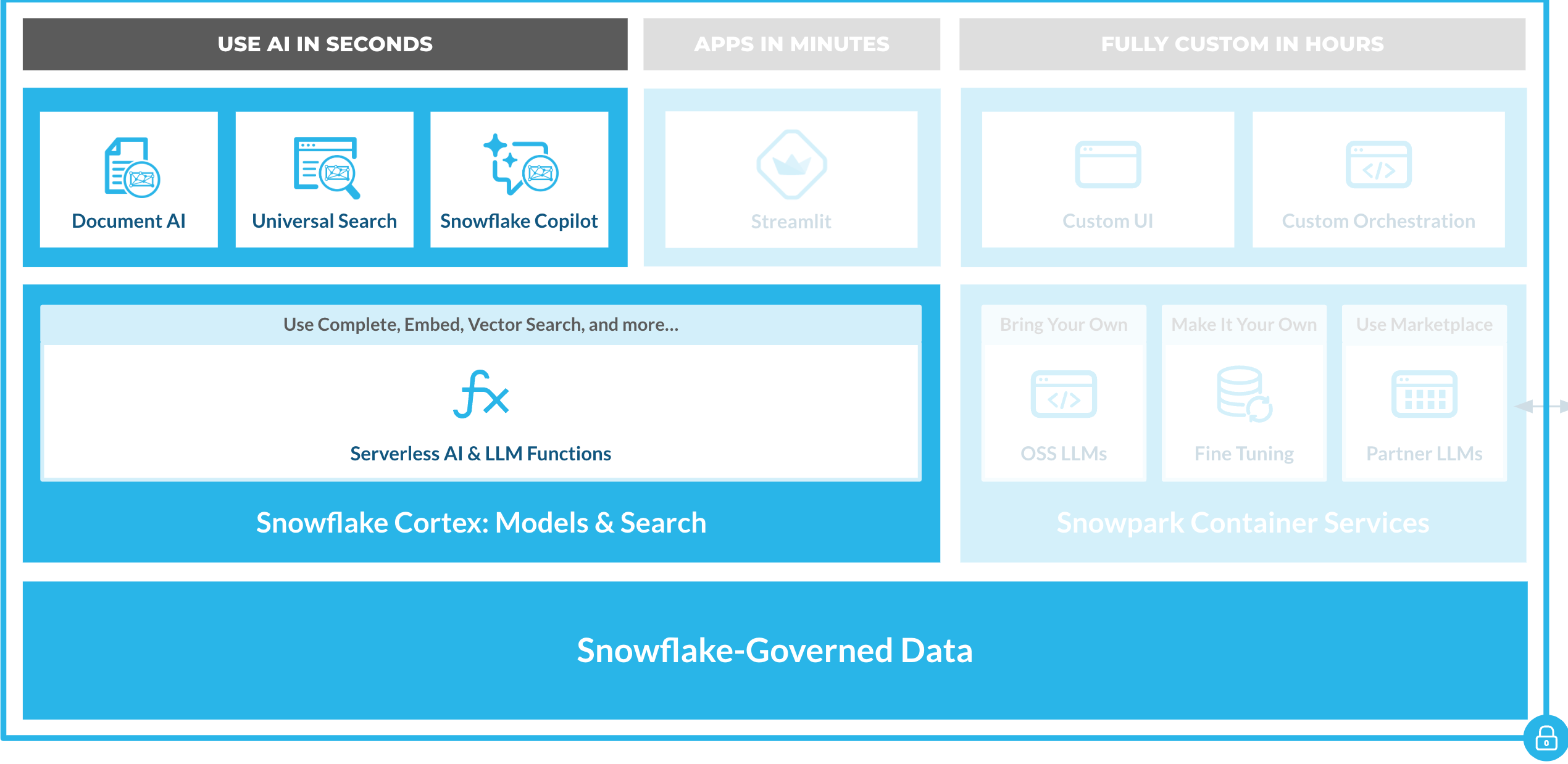
This quickstart will focus on
- Snowpark Python Functions, which enables the use of popular Python frameworks, such as PyPDF2 , for splitting, chunking and reading PDF's without the need to move data out of Snowflake.
Vectors and Text Embedding - Using the new Vector datatype and Text embedding model native to snowflake you will convert the uploaded PDF's to vectorized data for use with LLM's in Snowflake.
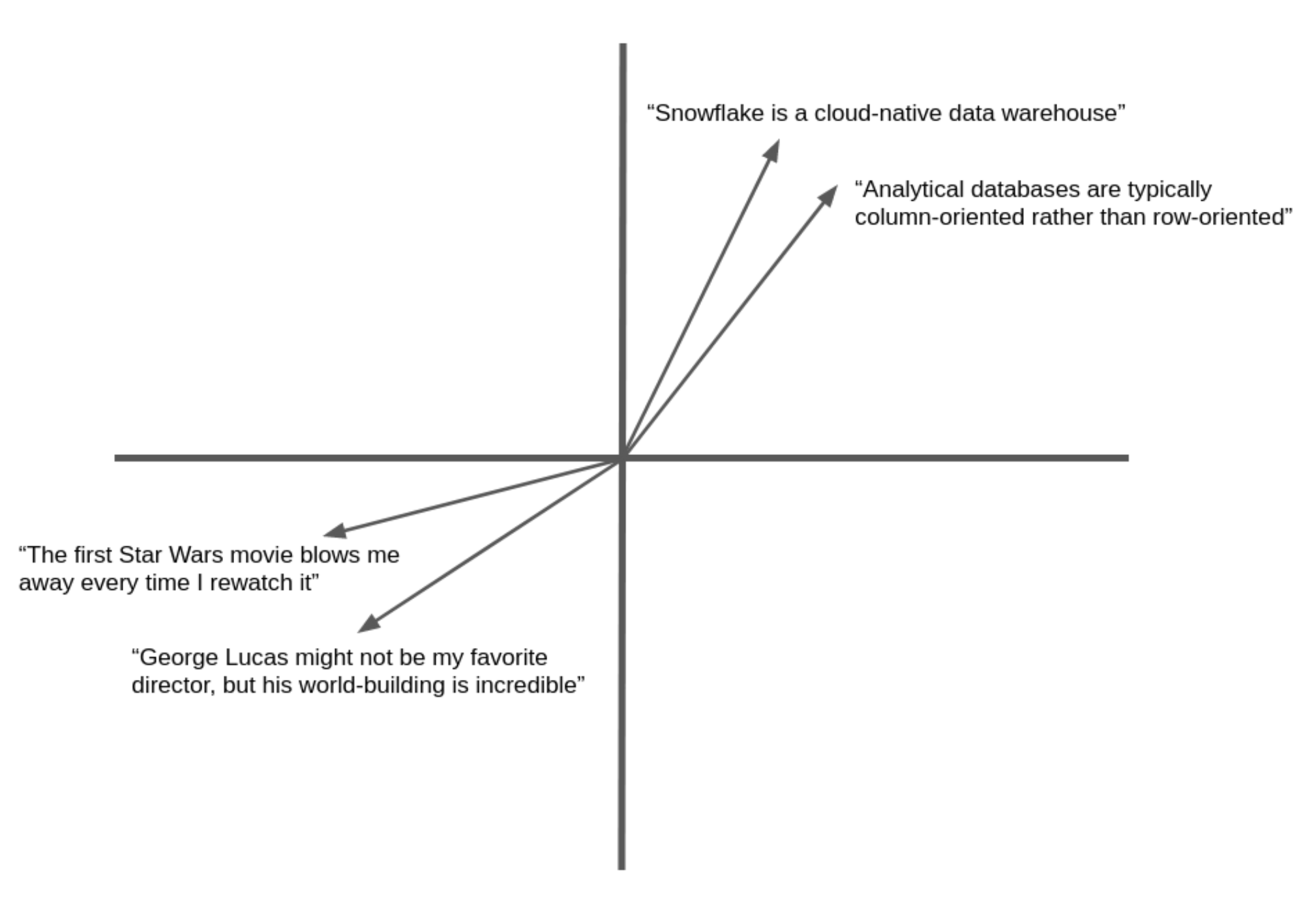
Large Language Models - Manage LLM's created both within and outside Snowflake. Models range from Small to Medium and on to Large. Smaller models are faster and cheaper but less accurate. Larger models are slower, but more accurate. Snowflake has both open source and privately licensed models running inside our snowflake security boundary. And provides native access to them via Snowflake Cortex.
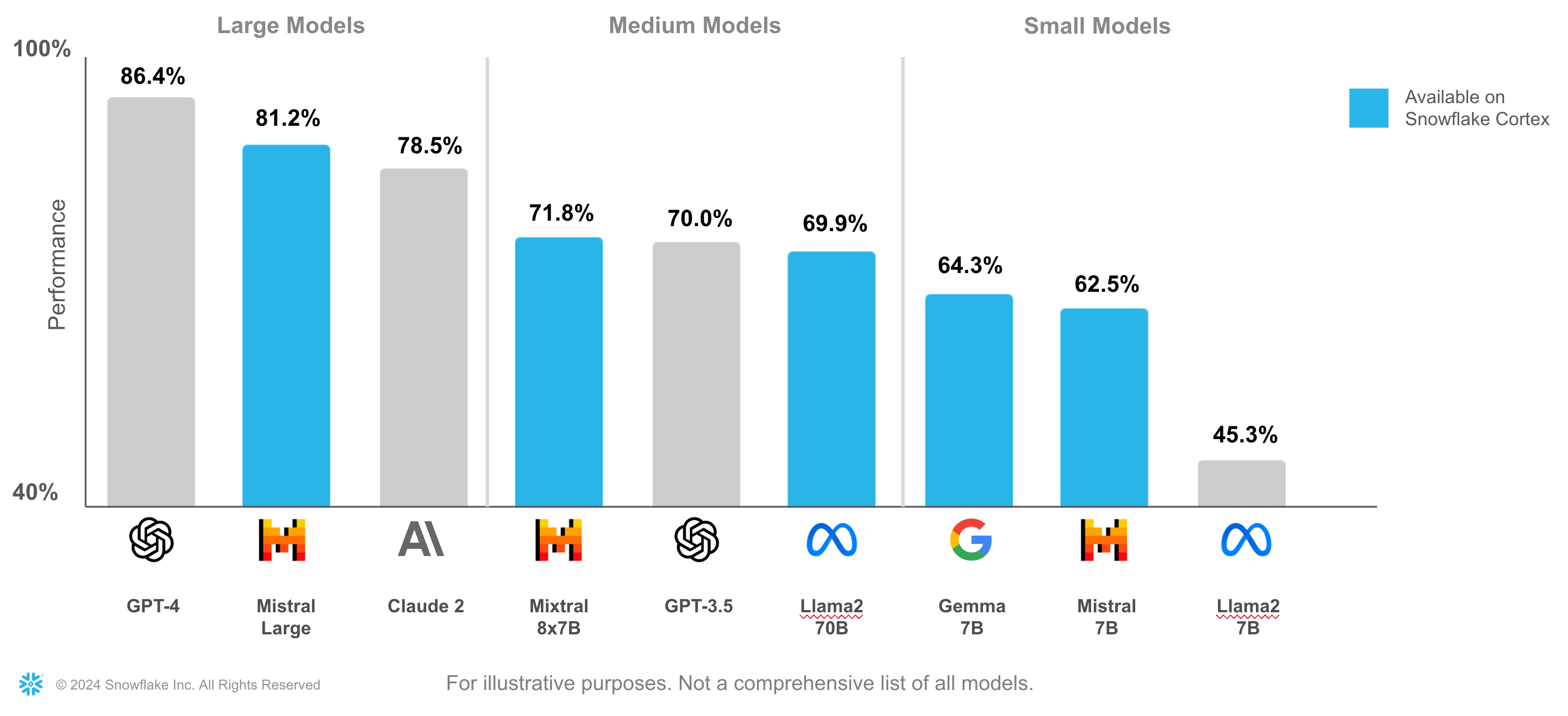
What is Streamlit?
Streamlit enables data engineers and Python developers to combine Streamlit's component-rich, open-source Python library with the scale, performance, and security of the Snowflake platform.
Learn more about Streamlit.
What You Will Learn
- How to analyze data and perform data engineering tasks using Snowpark and native Snowflake SQL
- How to use the new vector datatype in Snowflake
- How to use the ‘E5-base-v2' text embedding model to vectorize your data for use in Retrieval Augmented Generation
- How to use Snowflake Cortex COMPLETE to invoke an LLM to answer natural language questions, using Retrieval Augmented Generation
- How to create Streamlit application that uses the vectorized repair manuals and repair logs for inference based on user input
Prerequisites
- Access to Git for source code
- A Snowflake account, if you do not have a Snowflake account, you can register for a free trial account.
- A Snowflake account login with ACCOUNTADMIN role. If you have this role in your environment, you may choose to use it. If not, you will need to 1) Register for a free trial, 2) Use a different role that has the ability to create database, schema, tables, stages, tasks, user-defined functions, and stored procedures OR 3) Use an existing database and schema in which you are able to create the mentioned objects.
Vocabulary
- LLM: Large Language Model
- RAG: Retrieval-Augmented Generation
- Vector: Used to represent text or data in a numerical form that the model can understand and process
- UDF: User defined function
- UDTF: User defined table function
Create Tables, Load Data and Setup Stages
Log into Snowsight using your credentials to create tables, setup Snowflake internal stages, and load repair manuals.
Run the following SQL commands to create the warehouse, database and schema.
USE ROLE ACCOUNTADMIN;
CREATE OR REPLACE WAREHOUSE Medium WAREHOUSE_SIZE='Medium' AUTO_SUSPEND = 300;
CREATE OR REPLACE DATABASE LLM;
CREATE OR REPLACE SCHEMA RAG;
USE LLM.RAG;
Create the internal stage for loading repair manuals into.
CREATE STAGE REPAIR_MANUALS;
Grant the appropriate CORTEX role to your user, so you can invoke the LLM's
USE ROLE ACCOUNTADMIN;
CREATE ROLE cortex_user_role;
GRANT DATABASE ROLE SNOWFLAKE.CORTEX_USER TO ROLE cortex_user_role;
GRANT ROLE cortex_user_role TO USER your_user;
Your snowflake environment is now ready to start loading files, creating tables, and turning your input data into vectorized data.
This section covers cloning of the GitHub repository and downloading the needed repair manuals.
Clone GitHub Repository -optional
If you have GIT installed and want to clone the repo. The very first step is to clone the GitHub repository. This repository contains all the code and files you will need to successfully complete this QuickStart Guide.
Using HTTPS:
git clone https://github.com/Snowflake-Labs/sfguide-build-rag-based-equipment-maintenance-app-using-snowflake-cortex.git
OR, using SSH:
git clone git@github.com:Snowflake-Labs/sfguide-build-rag-based-equipment-maintenance-app-using-snowflake-cortex.git
If you do not have GIT installed you can download the four repair manuals needed below
At this point you should have four repair manuals and the needed data structures to begin data engineering work on the solution.
In the following section you will use Snowpark and Snowflake native text embedding functions to read in, split and vectorize the PDF's you just downloaded.
- Upload PDF's to internal stage created in step 2.
- Create python UDF to read the pdf's into chunks for the text embedding function.
- Create tables for storing the repair manuals and the repair logs. As well as tables for the vectorized text.
- Read in the repair manuals with the newly created Python UDF.
- Vectorize the PDF text chunks for later use in RAG based streamlit app.
- Create UDF's to parameterize the vectorized datasets (repair logs and manuals) and user prompts.
Upload Repair Manuals to Snowflake
- From your snowsight UI, click **Data -> Databases. Then click LLM and then RAG.
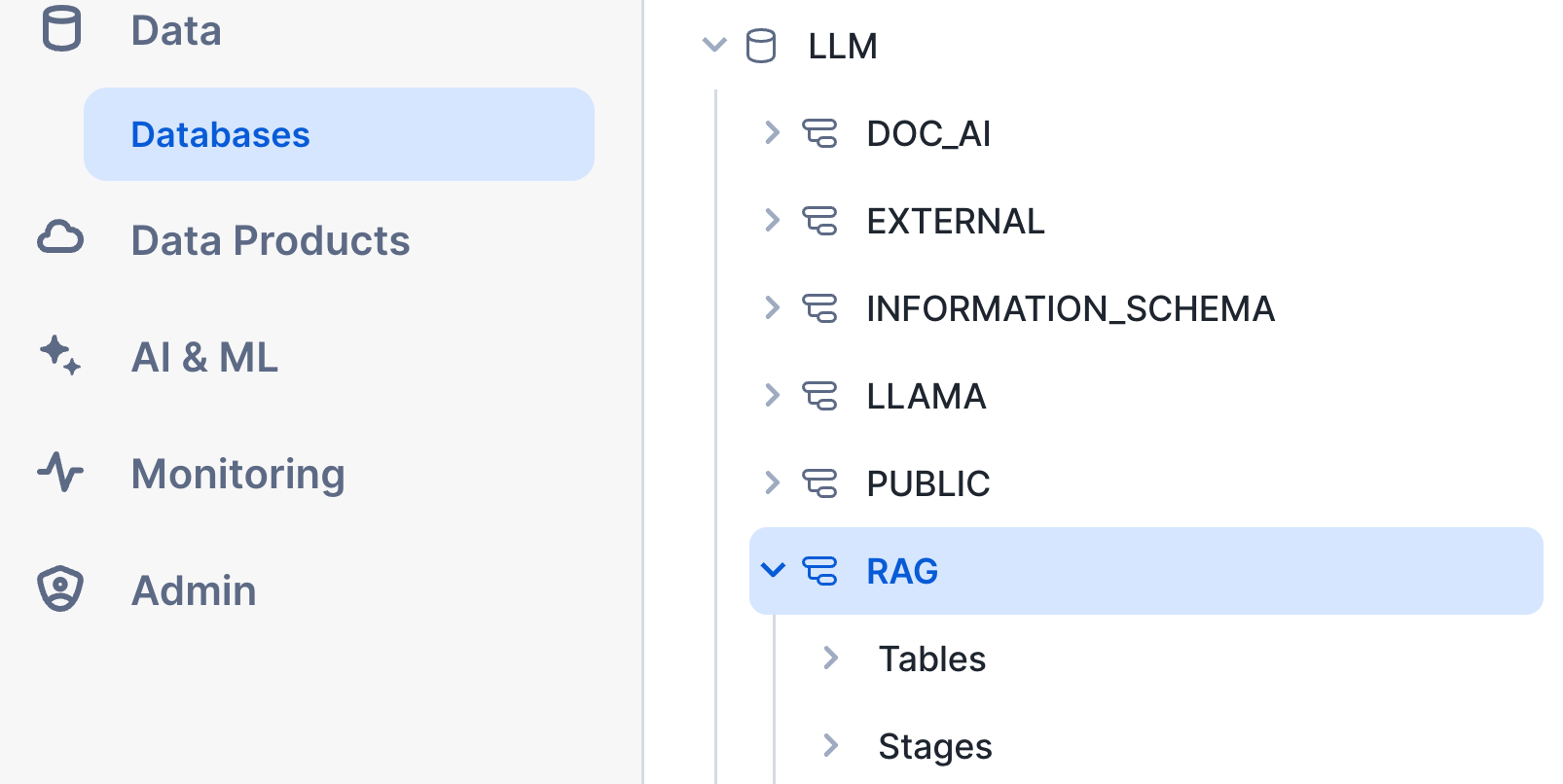 2) Click on Stages and then Repair Manuals. You will see a screen to add files to your stage
2) Click on Stages and then Repair Manuals. You will see a screen to add files to your stage
 3) Click the blue + Files button in the top right and browse to where you downloaded the repair manuals. Once uploaded it should look like this.
3) Click the blue + Files button in the top right and browse to where you downloaded the repair manuals. Once uploaded it should look like this.
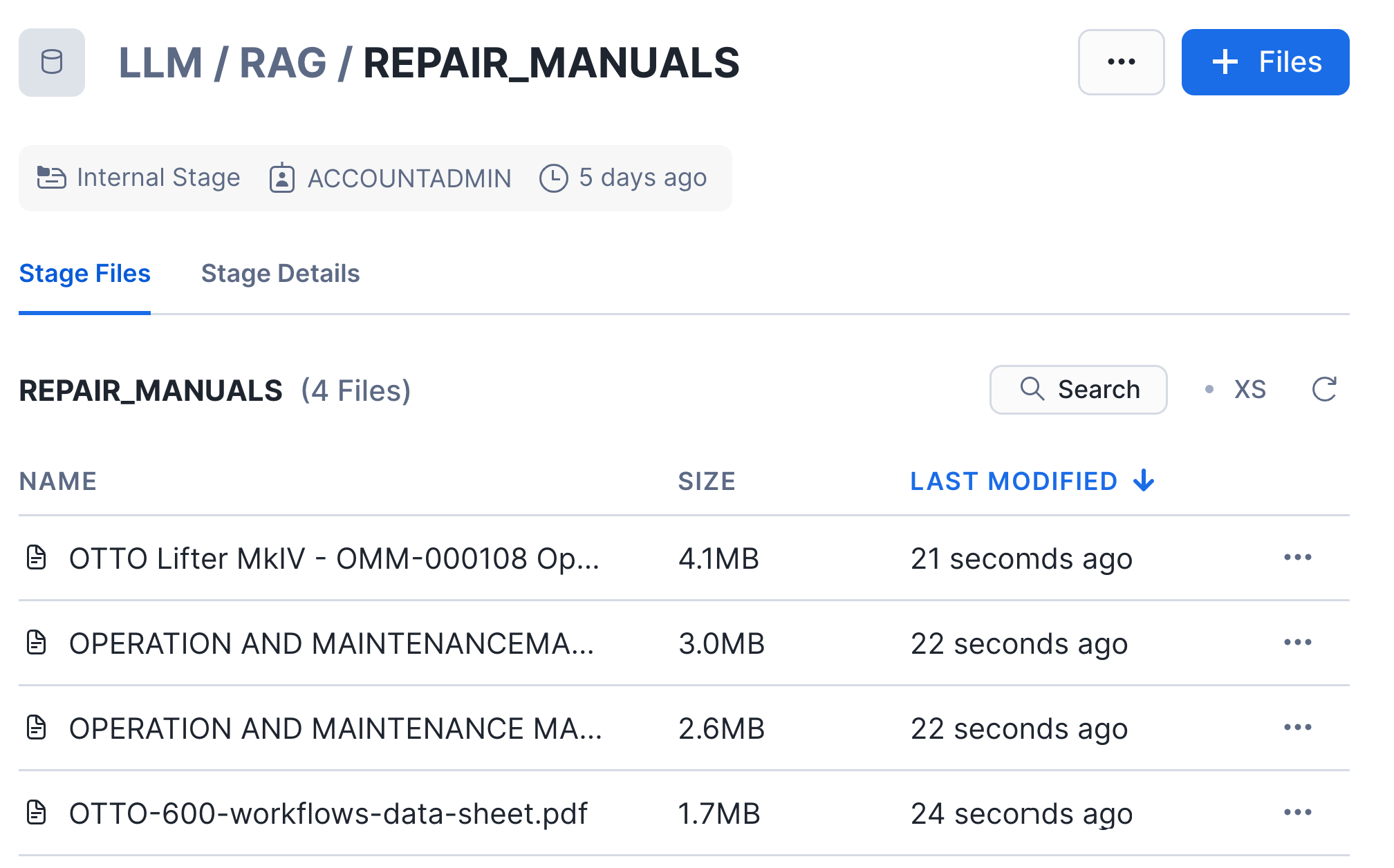
Now we will create the Python UDF to read in those PDF's we just uploaded to our internal stage. This Python UDF will use Snowpark and PyPDF2 to read in the repair manuals we just uploaded. The UDF in addition to a SQL UDF will break up the repair manuals into vectorized chunks.
Create Python UDF
----------------------------------------------------------------------
-- Create a python function to parse PDF files
----------------------------------------------------------------------
CREATE OR REPLACE FUNCTION py_read_pdf(file string)
returns string
language python
runtime_version = 3.8
packages = ('snowflake-snowpark-python','pypdf2')
handler = 'read_file'
as
$$
from PyPDF2 import PdfFileReader
from snowflake.snowpark.files import SnowflakeFile
from io import BytesIO
def read_file(file_path):
whole_text = ""
with SnowflakeFile.open(file_path, 'rb') as file:
f = BytesIO(file.readall())
pdf_reader = PdfFileReader(f)
whole_text = ""
for page in pdf_reader.pages:
whole_text += page.extract_text()
return whole_text
$$;
The above python UDF will read in PDF's from the internal stage you created.
Create Snowflake tables for storing repair manuals and vectorized text
Run the following SQL commands to create the needed tables
USE ROLE ACCOUNTADMIN;
USE DATABASE LLM;
USE SCHEMA RAG;
----------------------------------------------------------------------
-- Create a table for storing the text parsed from each PDF
----------------------------------------------------------------------
CREATE OR REPLACE TABLE repair_manuals AS
WITH filenames AS (SELECT DISTINCT METADATA$FILENAME AS file_name FROM @repair_manuals)
SELECT
file_name,
py_read_pdf(build_scoped_file_url(@repair_manuals, file_name)) AS contents
FROM filenames;
--Validate
SELECT * FROM repair_manuals;
Next we will create the table to load the chucked repair manuals into.
----------------------------------------------------------------------
-- Chunk the file contents into 3000 character chunks, overlap each
-- chunk by 1000 characters.
----------------------------------------------------------------------
SET chunk_size = 3000;
SET overlap = 1000;
CREATE OR REPLACE TABLE repair_manuals_chunked AS
WITH RECURSIVE split_contents AS (
SELECT
file_name,
SUBSTRING(contents, 1, $chunk_size) AS chunk_text,
SUBSTRING(contents, $chunk_size-$overlap) AS remaining_contents,
1 AS chunk_number
FROM
repair_manuals
UNION ALL
SELECT
file_name,
SUBSTRING(remaining_contents, 1, $chunk_size),
SUBSTRING(remaining_contents, $chunk_size+1),
chunk_number + 1
FROM
split_contents
WHERE
LENGTH(remaining_contents) > 0
)
SELECT
file_name,
chunk_number,
chunk_text,
CONCAT(
'Sampled contents from repair manual [',
file_name,
']: ',
chunk_text
) AS combined_chunk_text
FROM
split_contents
ORDER BY
file_name,
chunk_number;
--Validate
SELECT * FROM repair_manuals_chunked;
Now lets use our first CORTEX function and vectorize the repair manuals. To embed (vectorize) the text we will use the e5-base-v2 embedding model supplied in Snowflake.
----------------------------------------------------------------------
-- "Vectorize" the chunked text into a language encoded representation
----------------------------------------------------------------------
CREATE OR REPLACE TABLE repair_manuals_chunked_vectors AS
SELECT
file_name,
chunk_number,
chunk_text,
combined_chunk_text,
snowflake.cortex.embed_text_768('e5-base-v2', combined_chunk_text) as combined_chunk_vector
FROM
repair_manuals_chunked;
--Validate
SELECT * FROM repair_manuals_chunked_vectors;
Lets use our first LLM, and create a User Defined Function (UDF) to invoke the LLM using Retrieval-Augmented Generation (RAG). For this quickstart we are using the llama3.1-8b model. This model is supplied in your snowflake system without need for additional configuration. You can natively use it in Snowflake CORTEX.
----------------------------------------------------------------------
-- Invoke an LLM, sending our question as part of the prompt along with
-- additional "context" from the best matching chunk (based on cosine similarity)
----------------------------------------------------------------------
SET prompt = 'OTTO 1500 agv is not driving straight. How do I troubleshoot and resolve this issue?';
CREATE OR REPLACE FUNCTION REPAIR_MANUALS_LLM(prompt string)
RETURNS TABLE (response string, file_name string, chunk_text string, chunk_number int, score float)
AS
$$
WITH best_match_chunk AS (
SELECT
v.file_name,
v.chunk_number,
v.chunk_text,
VECTOR_COSINE_SIMILARITY(v.combined_chunk_vector, snowflake.cortex.embed_text_768('e5-base-v2', prompt)) AS score
FROM
repair_manuals_chunked_vectors v
ORDER BY
score DESC
LIMIT 10
)
SELECT
SNOWFLAKE.cortex.COMPLETE('llama3.1-8b',
CONCAT('Answer this question: ', prompt, '\n\nUsing this repair manual text: ', chunk_text)
) AS response,
file_name,
chunk_text,
chunk_number,
score
FROM
best_match_chunk
$$;
Now we need to validate the work we have done to this point. Lets call the LLM using the objects we have created so far.
SELECT * FROM TABLE(REPAIR_MANUALS_LLM($prompt));
Once you run the above SQL command, your should see results like this
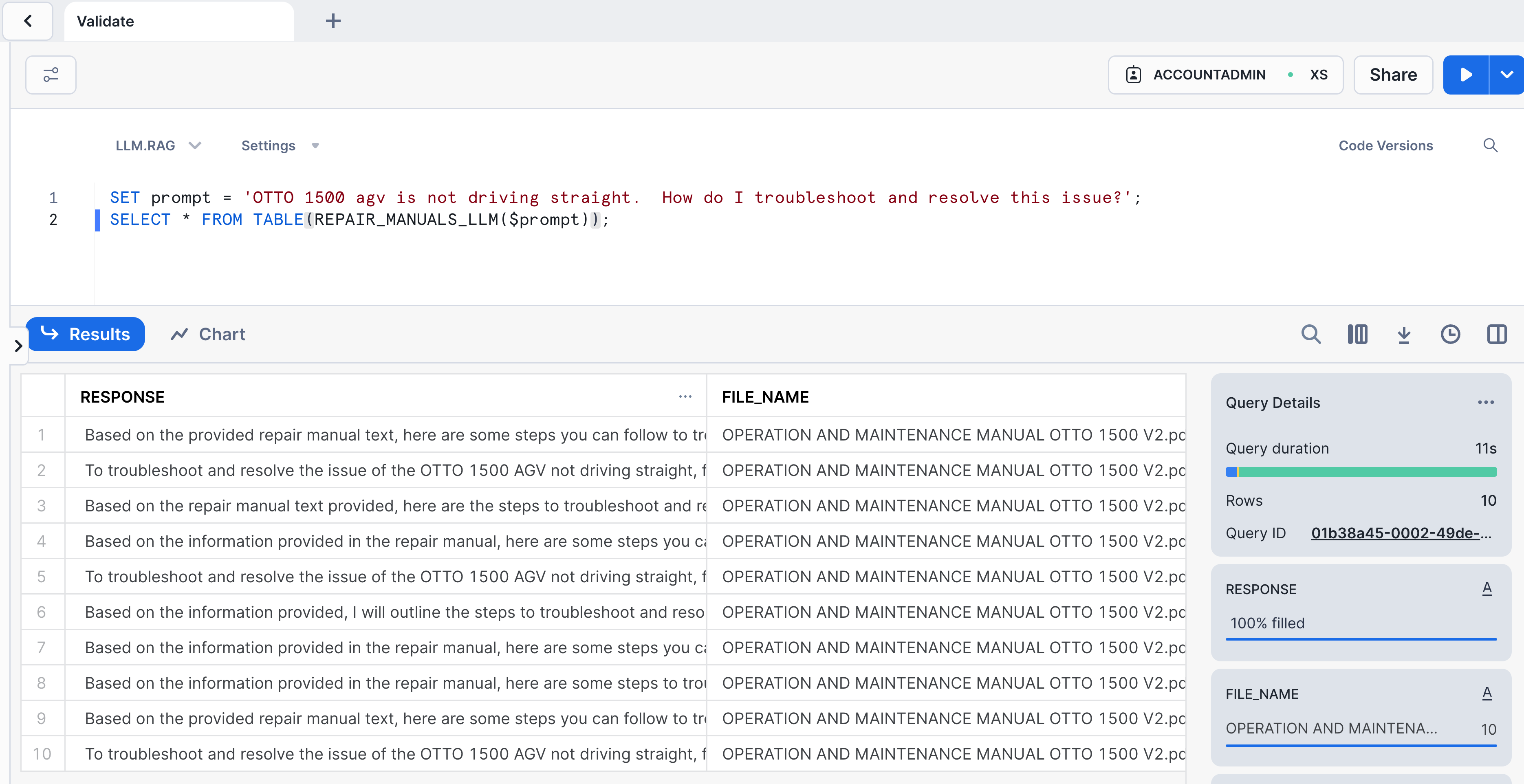
Since we do not have genuine repair logs for our little robot, we used Snowflake Cortex to create them. We will use native snowflake tables and UDF's to store and get inference from our LLM on the repair logs.
Create Table for Repair Logs
Run the following SQl commands to create a table for the repair logs.
----------------------------------------------------------------------
-- Create a table to represent equipment repair logs
----------------------------------------------------------------------
CREATE OR REPLACE TABLE repair_logs (
date_reported datetime,
equipment_model string,
equipment_id string,
problem_reported string,
resolution_notes string
);
With the table created, we now have a place to store our AI generated repair logs. Run the below SQL command to load the AI generated repair logs.
----------------------------------------------------------------------
-- Load (simulated) repair logs.
----------------------------------------------------------------------
INSERT INTO repair_logs (date_reported, equipment_model, equipment_id, problem_reported, resolution_notes) VALUES
('2023-03-23 08:42:48', 'Otto Forklift', 'AGV-010', 'Vision System Calibration Error', 'Recalibrated the vision system and replaced damaged image sensors. Tested object recognition accuracy.'),
('2023-09-30 04:42:47', 'Otto 100', 'AGV-011', 'Wireless Receiver Malfunction', 'Replaced faulty wireless receiver and updated communication protocols. Ensured robust signal reception.'),
('2023-09-27 05:01:16', 'Otto Forklift', 'AGV-006', 'Inadequate Lifting Force', 'Adjusted the hydraulic pressure settings and replaced weak hydraulic pistons. Tested lifting capacity with maximum load.'),
('2023-02-16 09:42:31', 'Otto 1500', 'AGV-001', 'Hydraulic System Overpressure', 'Adjusted hydraulic system and replaced faulty pressure valves. Ensured safe and stable operation.'),
('2023-10-29 23:44:57', 'Otto 600', 'AGV-003', 'Erratic Forklift Movement', 'Repaired damaged forklift steering components and recalibrated steering controls. Ensured smooth and accurate movement.'),('2023-11-21 18:35:09', 'Otto 600', 'AGV-002', 'Motor Torque Fluctuations', 'Replaced worn motor brushes and serviced motor components. Calibrated motor for consistent torque output.'),
('2023-07-04 14:22:33', 'Otto Forklift', 'AGV-005', 'Control Software Hangs', 'Diagnosed software hanging issue, optimized system resources, and applied software updates. Conducted stress tests for reliability.'),
('2023-12-13 21:16:49', 'Otto 1500', 'AGV-004', 'Path Deviation in Navigation', 'Updated navigation algorithms and recalibrated wheel encoders. Performed path accuracy tests in different layouts.'),
('2023-08-10 10:55:43', 'Otto 100', 'AGV-012', 'Steering Response Delay', 'Diagnosed and fixed the delay in steering response. Calibrated the steering system for immediate and accurate response.'),
('2023-05-15 16:11:28', 'Otto Forklift', 'AGV-009', 'Unresponsive Touch Panel', 'Replaced the touch panel and updated the interface software. Tested for user interaction and responsiveness.'),
('2023-08-31 02:54:20', 'Otto 100', 'AGV-003', 'Charging System Inefficiency', 'Upgraded the charging system components and optimized charging algorithms for faster and more efficient charging.'),
('2023-10-05 20:24:19', 'Otto Forklift', 'AGV-008', 'Payload Sensor Inaccuracy', 'Calibrated payload sensors and replaced defective units. Ensured accurate load measurement and handling.'),
('2023-02-19 22:29:24', 'Otto 1500', 'AGV-009', 'Cooling Fan Malfunction', 'Replaced malfunctioning cooling fans and cleaned air vents. Tested under load to ensure effective heat dissipation.'),
('2023-05-29 15:09:15', 'Otto 100', 'AGV-011', 'Drive Motor Overheating', 'Serviced drive motors and replaced worn components. Improved motor cooling and monitored temperature during operation.'),
('2023-04-30 01:03:03', 'Otto 600', 'AGV-002', 'Laser Scanner Inaccuracy', 'Calibrated laser scanners and updated scanning software. Ensured precise environmental mapping and obstacle detection.'),
('2023-03-14 13:15:52', 'Otto Forklift', 'AGV-006', 'Conveyor Belt Misalignment', 'Realigned the conveyor belt and adjusted tension settings. Conducted operational tests for smooth and consistent movement.'),
('2023-11-14 08:11:58', 'Otto 1500', 'AGV-012', 'Forklift Sensor Misalignment', 'Realigned forklift sensors and calibrated for precise object positioning and handling.'),
('2023-12-24 22:35:13', 'Otto 600', 'AGV-008', 'Erratic Forklift Movement', 'Repaired damaged forklift steering components and recalibrated steering controls. Ensured smooth and accurate movement.'),
('2023-09-20 08:08:16', 'Otto 100', 'AGV-007', 'Hydraulic System Overpressure', 'Adjusted hydraulic system pressure settings and replaced faulty pressure valves. Ensured safe and stable operation.'),
('2023-10-20 00:37:29', 'Otto 600', 'AGV-003', 'Forklift Sensor Misalignment', 'Performed alignment on forklift sensors and calibrated for precise object positioning and handling.'),('2023-08-20 12:49:44', 'Otto 1500', 'AGV-008', 'Control Software Hangs', 'Diagnosed software hanging issue, optimized system resources, and applied software updates. Conducted stress tests for reliability.'),
('2023-07-08 03:37:26', 'Otto 1500', 'AGV-002', 'Wireless Receiver Malfunction', 'Replaced faulty wireless receiver and updated communication protocols. Ensured robust signal reception.'),
('2023-10-12 09:05:07', 'Otto 1500', 'AGV-001', 'Laser Scanner Inaccuracy', 'Calibrated laser scanners and updated scanning software. Ensured precise environmental mapping and obstacle detection.'),
('2023-03-12 19:28:34', 'Otto 1500', 'AGV-008', 'Hydraulic System Overpressure', 'Adjusted hydraulic system pressure settings and replaced faulty pressure valves. Ensured safe and stable operation.'),
('2023-01-19 23:10:03', 'Otto 600', 'AGV-006', 'Inconsistent Conveyor Speed', 'Repaired gearbox in conveyor attachment and adjusted speed control settings. Verified consistent conveyor operation.'),
('2023-06-29 20:02:38', 'Otto 600', 'AGV-002', 'Battery Overheating', 'Replaced faulty battery cells and improved battery ventilation system. Monitored temperature during charging and operation.'),
('2023-05-09 23:19:03', 'Otto 600', 'AGV-011', 'Inconsistent Conveyor Speed', 'Repaired gearbox in conveyor attachment and adjusted speed control settings. Verified consistent conveyor operation.'),
('2023-06-09 17:56:51', 'Otto Forklift', 'AGV-002', 'Motor Torque Fluctuations', 'Replaced worn motor brushes and serviced motor components. Calibrated motor for consistent torque output.'),
('2023-03-02 09:21:22', 'Otto 1500', 'AGV-004', 'Payload Sensor Inaccuracy', 'Calibrated payload sensors and replaced defective units. Ensured accurate load measurement and handling.'),
('2023-07-16 00:00:54', 'Otto 1500', 'AGV-003', 'Drive Motor Overheating', 'Serviced drive motors and replaced worn components. Improved motor cooling and monitored temperature during operation.'),
('2023-02-28 12:48:29', 'Otto 600', 'AGV-001', 'Inadequate Lifting Force', 'Adjusted the hydraulic pressure settings and replaced weak hydraulic pistons. Tested lifting capacity with maximum load.'),
('2023-10-10 23:04:35', 'Otto Forklift', 'AGV-010', 'Unresponsive Touch Panel', 'Replaced the touch panel and updated the interface software. Tested for user interaction and responsiveness.'),
('2023-08-01 13:37:16', 'Otto 600', 'AGV-004', 'Cooling Fan Malfunction', 'Replaced malfunctioning cooling fans and cleaned air vents. Tested under load to ensure effective heat dissipation.'),
('2023-05-10 17:48:27', 'Otto Forklift', 'AGV-005', 'Battery Overheating', 'Replaced faulty battery cells and improved battery ventilation system. Monitored temperature during charging and operation.'),
('2023-02-05 12:37:50', 'Otto Forklift', 'AGV-010', 'Charging System Inefficiency', 'Upgraded the charging system components and optimized charging algorithms for faster and more efficient charging.'),('2023-08-24 15:29:05', 'Otto 600', 'AGV-012', 'Inconsistent Conveyor Speed', 'Repaired gearbox in conveyor attachment and adjusted speed control settings. Verified consistent conveyor operation.'),
('2023-03-28 02:59:06', 'Otto Forklift', 'AGV-011', 'Inadequate Lifting Force', 'Adjusted the hydraulic pressure settings and replaced weak hydraulic pistons. Tested lifting capacity with maximum load.'),
('2023-08-07 20:55:21', 'Otto 600', 'AGV-007', 'Cooling Fan Malfunction', 'Replaced malfunctioning cooling fans and cleaned air vents. Tested under load to ensure effective heat dissipation.'),
('2023-05-24 15:45:35', 'Otto 600', 'AGV-008', 'Charging System Inefficiency', 'Upgraded the charging system components and optimized charging algorithms for faster and more efficient charging.'),
('2023-08-06 21:27:28', 'Otto Forklift', 'AGV-008', 'Path Deviation in Navigation', 'Updated navigation algorithms and recalibrated wheel encoders. Performed path accuracy tests in different layouts.'),
('2023-02-18 15:41:59', 'Otto 1500', 'AGV-002', 'Battery Overheating', 'Replaced faulty battery cells and improved battery ventilation system. Monitored temperature during charging and operation.'),
('2023-08-11 11:55:51', 'Otto Forklift', 'AGV-003', 'Charging System Inefficiency', 'Upgraded the charging system components and optimized charging algorithms for faster and more efficient charging.'),
('2023-11-11 14:43:55', 'Otto 100', 'AGV-001', 'Charging System Inefficiency', 'Upgraded the charging system components and optimized charging algorithms for faster and more efficient charging.'),
('2023-02-17 09:23:34', 'Otto 600', 'AGV-001', 'Control Software Hangs', 'Diagnosed software hanging issue, optimized system resources, and applied software updates. Conducted stress tests for reliability.'),
('2023-03-13 18:19:47', 'Otto 100', 'AGV-011', 'Path Deviation in Navigation', 'Updated navigation algorithms and recalibrated wheel encoders. Performed path accuracy tests in different layouts.'),
('2023-12-02 02:13:06', 'Otto 1500', 'AGV-001', 'Drive Motor Overheating', 'Serviced drive motors and replaced worn components. Improved motor cooling and monitored temperature during operation.');
--Validate
SELECT * FROM repair_logs;
You have loaded the AI generated repair logs. But we need to format them for efficient RAG. Run the below SQL command to format the repair logs into a format that will optimize our use of the LLM.
----------------------------------------------------------------------
-- Format the logs in a way that will be helpful context for the LLM
----------------------------------------------------------------------
CREATE OR REPLACE TABLE repair_logs_formatted AS
SELECT
*,
CONCAT(
'The following Problem was Reported for a ',
equipment_model,
' AGV.\n\nProblem:\n',
problem_reported,
'\n\nResolution:\n',
resolution_notes) AS combined_text
FROM
repair_logs;
--Validate
SELECT * FROM repair_logs_formatted;
Now that we have formatted the repair logs for optimized Retrieval-Augmented Generation. We need to embed the text so we can use it in with our LLM. We will be using the same text embedding model as before.
----------------------------------------------------------------------
-- "Vectorize" the formatted contents
----------------------------------------------------------------------
CREATE OR REPLACE TABLE repair_logs_vectors AS
SELECT
date_reported,
equipment_model,
equipment_id,
problem_reported,
resolution_notes,
snowflake.cortex.embed_text_768('e5-base-v2', combined_text) as combined_vector
FROM repair_logs_formatted;
--Validate
SELECT * FROM repair_logs_vectors;
With our AI generated repair logs loaded and vectorized we are ready to wrap them up in a User Defined Table Function (UDTF). This makes our code re-useable and will greatly simplify our streamlit app.
Create UDTF for Repair Logs
----------------------------------------------------------------------
-- Create a table valued function that looks for the best repair logs
-- (based upon cosine similarity) and pass those as context to the LLM.
----------------------------------------------------------------------
CREATE OR REPLACE FUNCTION REPAIR_LOGS_LLM(prompt string)
RETURNS TABLE (response string, relevant_repair_logs string)
AS
$$
WITH best_match_repair_logs AS (
SELECT
*,
VECTOR_COSINE_SIMILARITY(
combined_vector,
snowflake.cortex.embed_text_768('e5-base-v2', prompt)
) AS score
FROM
repair_logs_vectors
ORDER BY
score DESC
LIMIT 10
),
combined_notes AS (
SELECT
SNOWFLAKE.CORTEX.COMPLETE('llama3.1-8b',
CONCAT('An equipment technician is dealing with this problem on an AGV: ',
prompt,
'\n\nUsing these previous similar resolution notes, what is the recommended course of action to troubleshoot and repair the AGV?\n\n',
LISTAGG(resolution_notes, '\n\nResolution Note:\n')
)
) AS response,
LISTAGG(resolution_notes, '\n\nResolution Note:\n') AS relevant_repair_logs
FROM best_match_repair_logs
)
SELECT * FROM combined_notes
$$;
You can see we are using the llama3.1-8b model again for this function. This is important, if you change which models are used for each call, the results will be different in that the quality will be different. So the higher quality model will always be chosen, which in come cases could supply a less appropriate answer. Lets validate the work done so far.
----------------------------------------------------------------------
-- Test the LLM
----------------------------------------------------------------------
SET prompt = 'OTTO 1500 agv is not driving straight. How do I troubleshoot and resolve this issue?';
SELECT * FROM TABLE(REPAIR_LOGS_LLM($prompt));
If you have made it this far you should see something similar to this.
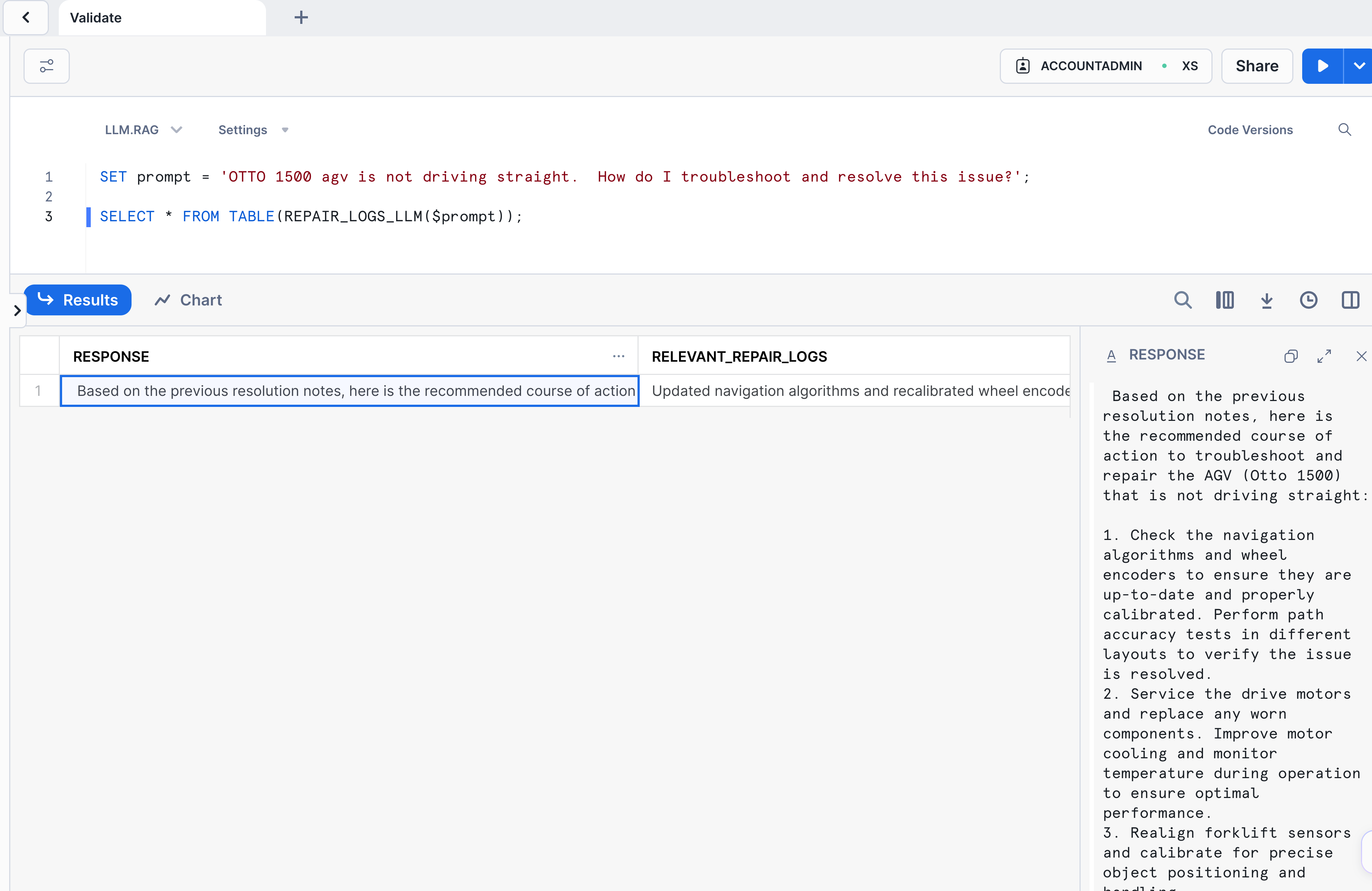
Up to this point we have loaded both repair manuals and repair logs. Now we need to combine them so we can feed them to the LLM and get the best answer of the two combined texts. This will generate the most accurate answer for our questions around how to repair our little robot.
Run the below SQL command to create our last UDF to be used with our LLM
----------------------------------------------------------------------
-- Run both LLMs, combine the contents, and ask Snowflake Cortex to summarize
----------------------------------------------------------------------
CREATE OR REPLACE FUNCTION COMBINED_REPAIR_LLM(prompt string)
RETURNS TABLE (response string)
AS
$$
WITH stacked_results AS
(
SELECT TOP 1 response FROM TABLE(REPAIR_MANUALS_LLM(prompt))
UNION
SELECT response FROM TABLE(REPAIR_LOGS_LLM(prompt))
),
collapsed_results AS (
SELECT
LISTAGG(response) AS collapsed_text
FROM
stacked_results
)
SELECT
SNOWFLAKE.CORTEX.SUMMARIZE(collapsed_text) AS response
FROM
collapsed_results
$$;
Validate the UDF is crated and returns the results we are expecting
----------------------------------------------------------------------
-- Test the combined function
----------------------------------------------------------------------
SET prompt = 'OTTO 1500 agv is not driving straight. How do I troubleshoot and resolve this issue?';
SELECT * FROM TABLE(COMBINED_REPAIR_LLM($prompt));
Your output from the above cmd should look like this
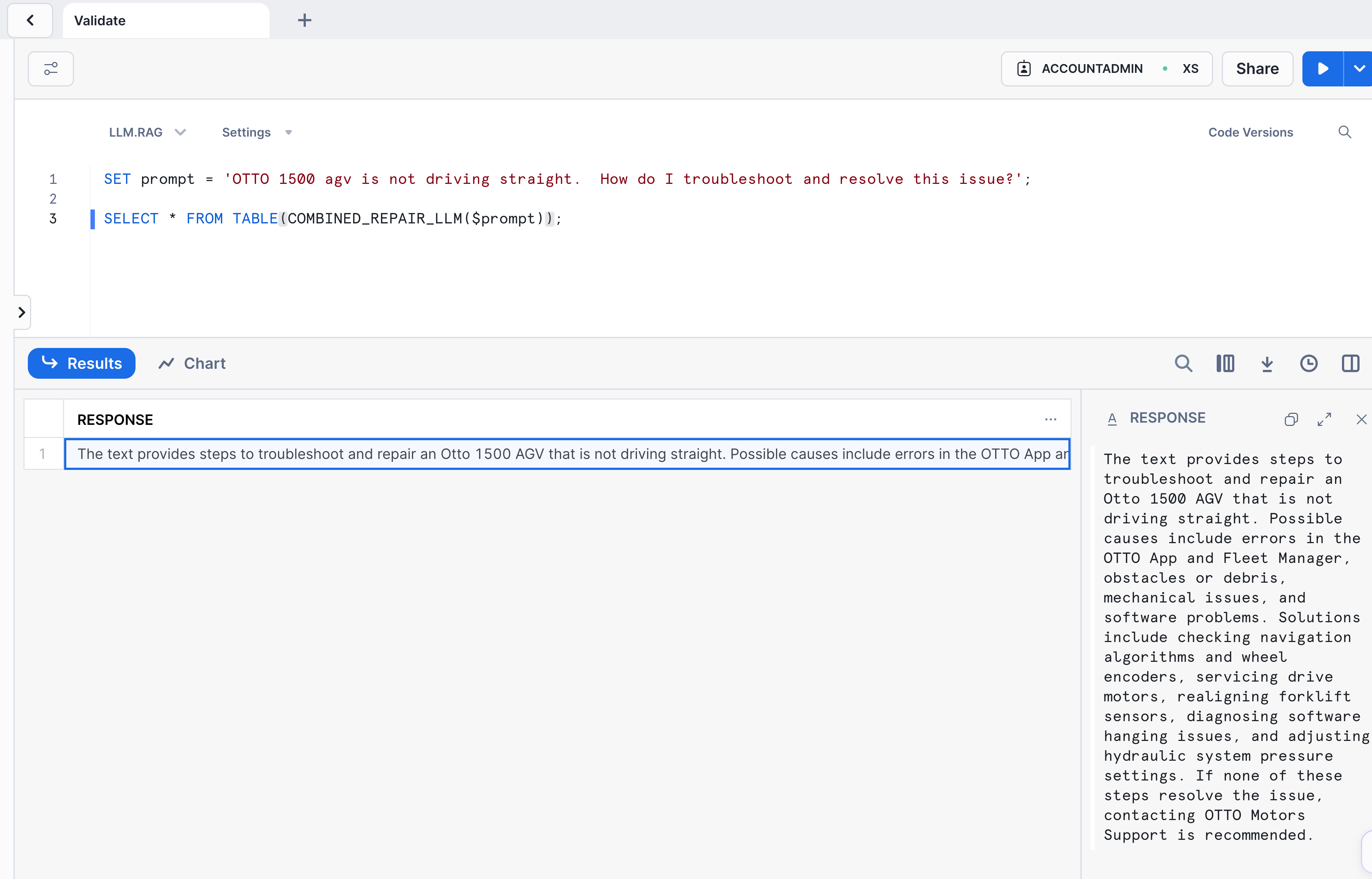
Your almost there, if you have made it this far you have used the following in Snowflake.
- Snowflake Cortex to access cutting edge LLM's
- Python and Snowpark to create a UDF to read in repair logs. The Python UDF you created can be re-used to read in many other PDF's for different apps, use cases.
- User defined table functions. This is similar to the above UDF, but it returns a table instead of a single value.
- Snowflake's Vector embedding engine to vectorize text so it can be used in prompt engineering.
- Snowflake's native Vector data type. No need to use an external DB or system for your vectors. Snowflake can handle that for you.
- General Snowflake tables and compute. These objects are the workhorse behind the scenes that make it all possible.
Streamlit
To bring together all the above technology and database objects. We need a user facing application for our end customers. Streamlit in Snowflake gives us the ability to wrap up all the work we just did and provide a dynamic, interactive application for them.
From your Snowsight UI:
- Click Projects then Streamlit you will be presented with a screen to create a streamlit app.
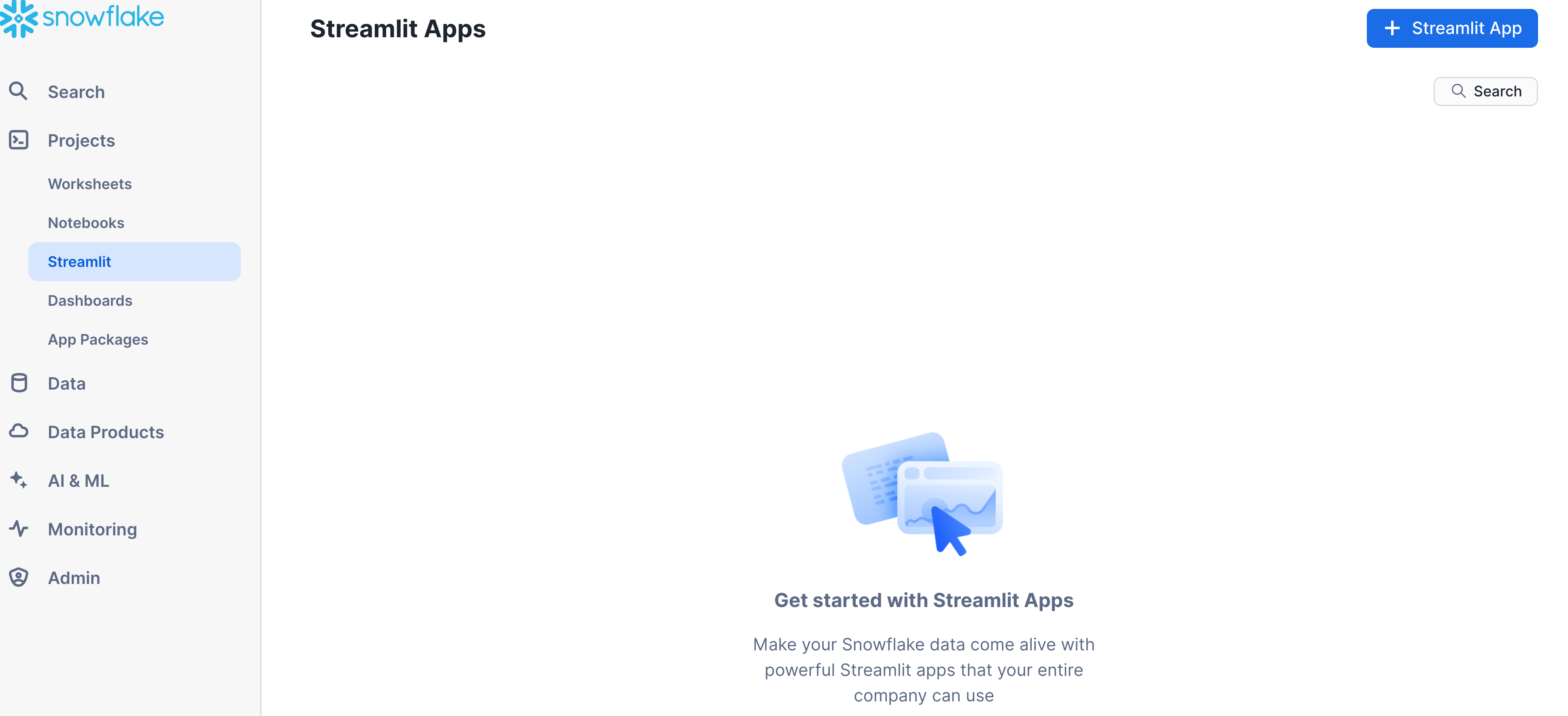 2) Click the blue + Streamlit App in the top right corner. Fill out the info as per the image below, and click create.
2) Click the blue + Streamlit App in the top right corner. Fill out the info as per the image below, and click create.
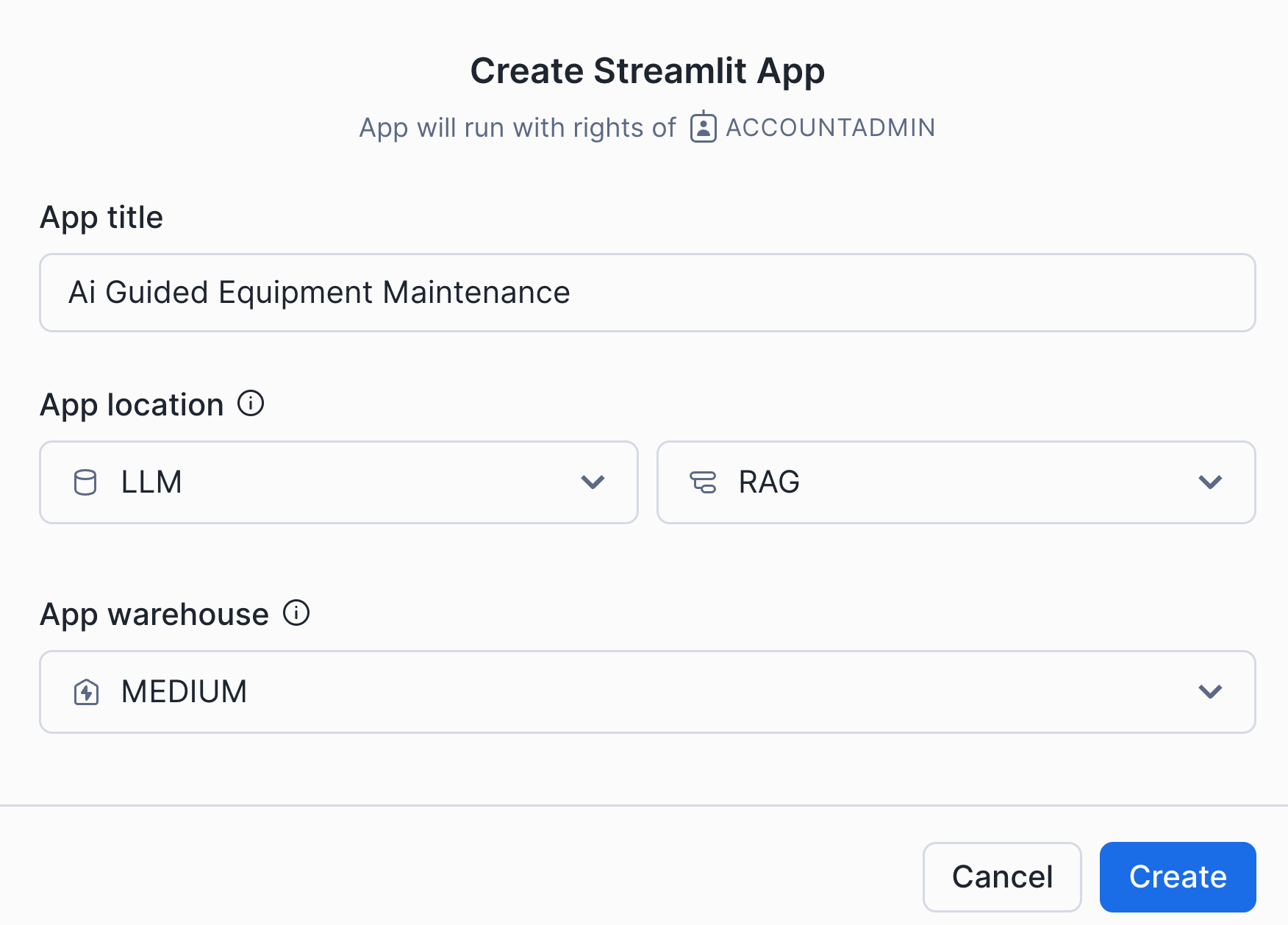 3) This creates a default Streamlit app with content already inside of it. You need to click into the app, type CTRL A, and then delete.
3) This creates a default Streamlit app with content already inside of it. You need to click into the app, type CTRL A, and then delete.
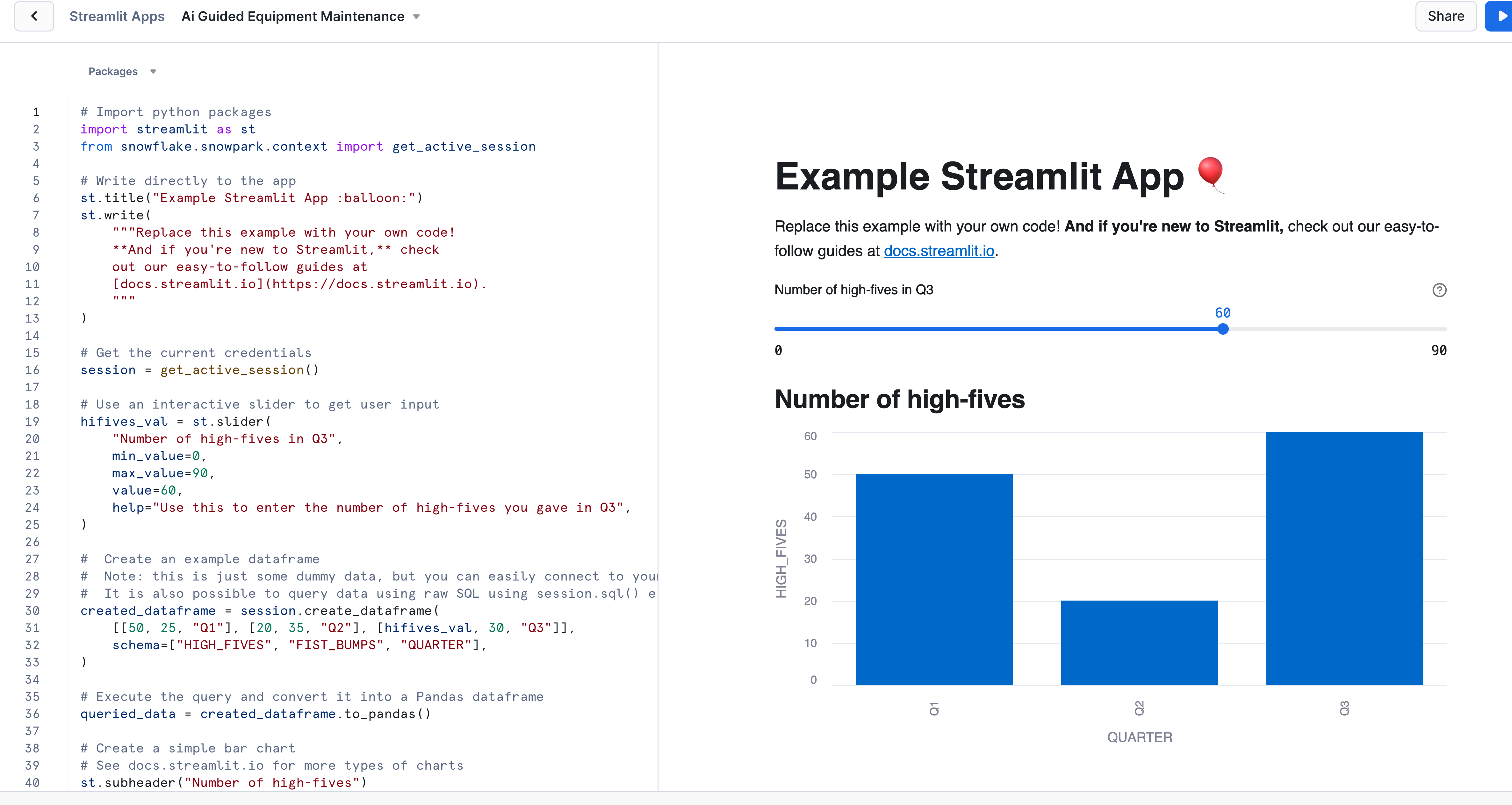 4) Paste the below code to create your AI Guided Equipment Maintenance Streamlit App
4) Paste the below code to create your AI Guided Equipment Maintenance Streamlit App
# _____ _ _ _ _ _
# / ____| | | (_) | /\ | |
# | (___ | |_ _ __ ___ __ _ _ __ ___ | |_| |_ / \ _ __ _ __ | |
# \___ \| __| '__/ _ \/ _` | '_ ` _ \| | | __| / /\ \ | '_ \| '_ \| |
# ____) | |_| | | __/ (_| | | | | | | | | |_ / ____ \| |_) | |_) |_|
# |_____/ \__|_| \___|\__,_|_| |_| |_|_|_|\__| /_/ \_\ .__/| .__/(_)
# | | | |
#
# Import python packages
import streamlit as st
from snowflake.snowpark.context import get_active_session
# Get the current credentials
session = get_active_session()
image_string = f'data:image/png;base64,iVBORw0KGgoAAAANSUhEUgAABGIAAAKyCAYAAACe3XiKAAAAAXNSR0IArs4c6QAAAHhlWElmTU0AKgAAAAgABAEaAAUAAAABAAAAPgEbAAUAAAABAAAARgEoAAMAAAABAAIAAIdpAAQAAAABAAAATgAAAAAAAACQAAAAAQAAAJAAAAABAAOgAQADAAAAAQABAACgAgAEAAAAAQAABGKgAwAEAAAAAQAAArIAAAAAGtctHAAAAAlwSFlzAAAWJQAAFiUBSVIk8AAAQABJREFUeAHsvWubHEeOrFkiKbW6e86e/f+/cL/szJydZ1qtC6m11wC4wz0i8lIsUtTMBJnhcMBguLhHVGYoi/ru//nPj7+/3Dm+++67l+/AMEr4XR6fPn0aXuhkHPMrYQS6gP4OcYIKAvd3371zUEw91u+/f3IuFY88UZjCBMVSiNtj5z4ixZu5LTbyQxHOmX/k8N2Cr0mNweKcF8Lbk1sVrcxHHvf3qL7UUC+9nzlmD7LHS7+q75ds14bRv8/guGZnS9zrzC3vZtvyW+pvMDbBMeTau4Cf4RaidbLFX42vn0X/lfUnFpw1/+7lw/sPL+8/vPd1/vHjx5ePH3/LALUDYwzf0iXkDfN8s7V7fXsuPVl/76xXbK++P67cf8+2lv0d90F0UtCXT7r/RQKh3lYB0Mv3ugn95f27l7//+P3Lh798//KzXP7xyy8v//mPf2ptYcaL+yv39N99vb+8/05T/ZEvcd4J8p657vk/vPvw8n/9/e8vP36vnwXvxfXzy8tPP//z5Z/i/MiPBOUoFgkjNctzXtWkWvz84cCLyNw3f//0UXvw/cuPP/7l5W8//vjylx9eXn799eXl559/fvnHTz+9/Kbm/P5O+xMvccQAT/jDx2FmIJ5VXuFDXdb4Zxl+ZP674n738r/+/reXH9WvD+rdLx8V95ffXn76588vv/72m7n8Mwk0sTXWPXKthqARszJwGj5FRuE7ta5FEd5pc71X/R++Jwe6r15T928fq1y5Rh2OgXx6VBxqE6bDZBrTFAbaAqf0afyudQBPg3oNsax9WZ2ojz7Sw7jHfPScPGtPdPbi6jrLol3wyhXO2Lu5Nl4nEtLLcuTyXnvoe/WY1zut+08//fzyC3tZ97zvtEHivQcuXG/qIX2AnxWpcoJ0TUuYbOmqz9ktWzmYgXD68065kCsysX/97VflqPc/+lM48uOIPs0IaH1vTxt2rNQUqMKKTXX//ccPL//33//68pfvtTaK+49//vbyn//8Rdf6z7onfKdr7p1ewhIPjnfvfH940c+Id5p/kM/f//bXl3/R6wdxEIR7A5cZtwj9aBkHketVStPWRONoc9MhguNQSj64HXIw12VrXm5x4HyrszHsdtFpcKRNbiMe9PZNXiDL0eOLy5wCwKFb4wtlqhWumfjORbq83Xru3MtRpiaCHPMMZV2d0IEvH+ZVD3E56m169QgdMubirBEbR/HFbD2DpR3EKZ7RnqbDXvuL/UY+8P6sm+n/+T//n2t//+HDy0cB3ReTsWgA6SD+kYnPWRi7/+qo3RyIvFLkhw8c7Ikffvj+5V/++r2L/6h7+S/a079qc3pPO27EBJAhHc5acmvHma6ZXy1GmIhVMWp8lpTe+zptjnF/QFE10jH1KIIkUuuihan3/0svBATr9w9y5T752sMxxeE1UxDGnkel1OPvsWY9myX5SnuJK8CGL/Xnjr4OVAjxo5+ql1jqb/1MuZvbZyYxVohe56TGu9ReHOV/F3gOsHt3foAvekWfslcId4/Yzw4Vm+imx6O4K5KlrpZeL/XKd9d/oLt2bEQLqFi9icKCynXiY3v8YF/8tgmLXlQ3QyXIg4AwI3vT2HHGittrnEkocD5HYibZErkxjbwmX4d6H1zx9UU3RrngkHgPKiBuM8kqZZp7mEXutGVYH+6UVv2RCF/UMPVTOrecxYAp9v25z+R8TOp13mSkJwm4iXss7EC5RhF+Nmfmt/M8XN/I6FsXKPQ8R3pZ90RDLnDn3o9oH12oB3GfkeTN0pKX63zfD49U+TkYIt6KWvlwx+FgzXx3rIKY+8V1LosmIL/TxYfeh0buhNalwqZ5Kpj9mYQJR0upMGyeKrnUAPU1T+zIUhaBIunpt0lEGB4Zzgm4EIwRKHCkMrphJvQRLzrpuU5TX/bURcOi1qwheiUPpwu/BPeTEMHkYOOUjp5jj4M8DMdcfRC534w0TOQLpvwcLhFzMJ+nJjQnTtZXWKdyzMc1pS2snMtJUqbaVK7/wGRcZiK57hkGz1QlxZ4zr2vOaN5DtTYz/uLaJkSqa8JoFyKAx/R3bxWRqU8Ri6lfKqLkoja0Jm1cemk9yMeOQmZ30qmyXzkKay1NXBRtiqndi7I8ucmhL86gh2gaaFPcCxrnwAbNnE4/+gsTL2R/4HbPxacPGl53wT/pw+5HPRXwh24eUdhBg2x+TXJL9iOnTV9T3LEVznNN6irnUze5+OGPTsT2hx192K43+cUFD/7uAUIecDtfTqfHBGfJ5iAxYttLH/7No6cVn1L3HbL4eDhVfiRgtrNQNswEdggc3v1l0PidHipC6P6kq8sAE6ZB2DEoR04D0YTkhIvnFrzwNwe65I4PmlT5ezxAJB8dPpODD2YxWSWMsa8G1Br018fkmBivOdO9yAkJSYnzZ8bTjI1ZCic+nTzddNN6W7rplsQDQ1677jb9tLomTSFQ/ZQC1eBGokYfoY1YwJmHjb4gFzLwdW7aJpb15uiQOs1QC7zMl4AF/QYTUlENz5ZxK/Jag2eX8NvWc7enchW4Yjzll05cQuV/ns2D2of5AHJP16HTfgmH9cGYXwDmy6p4neTan3FpFebGmP9tQixJdANr0wjOhdqDW74mweLFl2DUshPqIg//OMsBoV6Kx22ybhQkMy4aYewjo2+leRPxwtkA+rEj4JyXBJe4t5nCz3l2ClF21ri5XTNFnZFNoTxLntIxEqbehK0egXJ3BTrYijBgy3nm34sAkkSjuWmHa79SijGK8SxgG+cMNpI8xRXfa0YRjv3yGv/KHh564BJyFXt96sFWXUQ7VcZ+PTWd5eimnBk+UwcvR46tnFCX3TPBKo8dmPZlo5fuifGxfkQS97C+GW75P5JKlPYKx0fIhakWAu/ycJey9IxxVLUxhr10E+XNiZrrkUK6SWrv2lzEMCdGk9zRYw/H3GTmig8zzJO0D+WvkaugwoLmYO5bs2dxKoyzwr+oi6thizA+bi2BYY7rW35xH5rMRYFm0pddY/q4NgGYLn1LaAzKkSQzP1/tdpCKBBPrmJY5CU/gxWhEnMrN0MSDRk8cvWIpQ676HHY0lAD4co78Yp56uHp81dBv1/YM93xQEfjJauqVw3zE0l+A7Ugq21A7J9tjbxS0cmLEx2f4JDt2ngpXfstYwaoX9CzzMWfZYe/E5nbQkWcuVOayRLEOTVGs1piNUGfGpjOug5VLnxrqIqRNQ6SbhQlALWMNwaQphkAPZXSzZQBtEHvfJ59J3aQFauQIkUJ6F4sePujhh+LgHpC5xz7qm1y/6ds2vynhd3oC8bu+RcODGj0WCe5Z1ghcy7mb8Ihrgv9qn99cwivjOjZxiKGvyfDNIb5JFoHyG75KEhxHdaquNRdgA/lXDZVFedlVpzZPTnrgXPQ05jsVwUOL35Qno++K6hMyD4d8LP2WwRkZmXLA6gyCAIxE9/1oaLQGfhr2XmM+SHIN9IpvkIeXq8dZ0+CTnMfsDIpWHzNxg4fH/XIMSFRL6eTib8xL5/w+qCP0wlQ60SeTQBTRqJY/kYuBMrboqMJo/XIqXpSJqVhmRJeUk3mobDS9T5DUIUV3SHVxF+qZ0XRBcOq22yO8OhOGU58rZXHRg+hvNsJk0Sgw9QDWPFZI0gLF9YBsi9cs2xsKzuYqp6l+lSSauG/HnsiiTXUVIVM7D9ecbuKGt1D85XoZutcLtWZRU+fJbOjxQb1ouvVU9tpmsvc827Kfct1S3uN+xLf39B5f2Rn5FiYLwn3Oty/pbJe+14/W13s530oK26O4Mx75epduHJ5WoZvtjKZ08z9NlOZkpA8HztdsVpMUU2abQ2kJ78ugiumRvZOUS4JZIDceDH/1iptKLJhhg+eksF1lDnvtlhvzHc88glae09lLN6e9tqZ9VnRE9+LckxtBvak5II5JGkIF/i8e8CYmfojT4+h1dy0dC9H1EW/qJu6QyUFRcQ+GVFQ+V/aDXo3ijdF+xGrFedg07Rp7lSscyDUfTqFjlTGxj6mX0+Cin3NmhzMaGcYxfKUp7NSVFDGH0zNCLli8oeMHcDhXf1mHeFPbYvFmrx2uc8yVS7tplrp4a346urcV5xTRlA/WvKba/G+JDzqpqHU9J+fak6lHutWL6HvE97lSqRF/k3DSoXbVm3Gmdb3XGyl3qfmCmQdrBZ+q4ILX4Y8H5oTX3trC/JfNfJMvjGvLZYo4+oAjZdvp5uJE6FrRYEslxjzAsMdMrDfwn5wUuUV3hz96Dga9hj511G5DCEx8rLjIIqqVWUbicETYjCG9/5vuaEjY/bsFxotHmOJ2Tmbpp7QaP5ADkJHGHA50kU7UX0Z+XYkPux/5gGMc9ozfqKsW+wVRkBYRo64z+2rNiOejp5p+5W77MpHGmyBcnXfLAa1XDt0saMZCDV8GR/avAuGoI26xI7PAobxxLOlBPRRKgnn61kgDBoa9m3M+yH7i6wscrjFwAwsveGgHGeDoKVIci1GqrUEFkz54Eq9heoaEncvDFgVmL3C96uN1YnHKHY2L7AwREX5sYPgbtsCQM0gdFMQ1ztyq0GP3iw/T9QdI+lnHB3Eo9Cq68A4d94WPehjx66/61T4BnDV7ELyctsvV6198jPtRMeYaUCO/vqVfk9K3YWovYeeBB79SyK8BkB8vjohuYc6VEPchrjNziJM/4WmYCczhEw83pDK3BdUinX7t5t337/1tEOLyIOgX1c6vwdAgrjr8NFg2sxUm1ZTRKJv6KS6D4OAcROH3veJ+/8MPqkG/timVH34RV7/K5m8oicgVUZfzcBixwJNRXHNFdIJpEkA2Dn5NVU3yNH5ekastPvNgBv4P9EG5CJzPariHvfc9bP6cc0bCwODHWCEzdU5wa6JN4hFrBJMUR0WPGe9XCqnKyFW9jXUNR/z5lbqdZ5+T0xaqQmTkGi5wZe7jKSGA5Fjsy2SwHPMcpiaID3euM42je6a0QcbE4CXV1AqvHuKIznuF5Qfng3WE0xCddX+ZxoA8cfb7FzY2HCc8xD9RR4QbhsW0TG4ldyPWLbfdNuJJ8F9O1W+M2n/qoLe4fcu2E13P65tLsNVa7WjbFiULSS6L0pMT1QThMpOd+huS4Ul64EZBKif+rLcNjBUTbAdbnms1YiFstpMQoXoUtxHUVi21s6jcNN7qU5QT5/L/UL6l2Meww5y1FQCDuMKOckoFWcYz85rLgCf1mJeA/kizarxu5CV10F8EKdI20syVrRnfTPwyEW6yqhm7vXely1Um+F2/XAQFZBR45y/Frh/rciDvhI/Jx6oe8FNCcfOa2CXHzCsutJ5kQzVxspSURga76zTkDcP0Jlfg480WdAIn3oPeXNQbEN+4iv7JMXyr1ozBncRvfOiXxGXxiZ6JZKzjgxetDhC/uSz46pOu6yCIUYpZGa2ANnuArqG/oHieSK+/12K0jP4hnIZi8FQTr/nS80w/nDUJR18D5VwV2l8cgphitwuHijX18jiXdMJH3JWHgRFq+FSYZTTh1PSQuDPnmuLwUIDiVg7+cJkIcvOe04jDkg++pQBXe0xA4L4qFGxAzKlZJeAcgnf0WWb2MNQEjBBiGj7o4A9EwkwZfY54zWrIejq3Tq0zHi4ufRod230RoudCfP49nzrs0vwoZloD5T5JudRjXrDUWWw57nPUXWeuzWebAh/xDgklODlHOT1Gynbd/XssbMI6lvZGQI8O7q/9sKlq+4TfyBOqHtf4OKU621Azh8arhOnhvXTMowIMBruOmf2ZzZxiH3q/5v50jpUoHnAw59N4GK2b10Cscd9HZFbzGCHSYS59bBBPYBIXpoQIRKiaIcREAl46Kxe+KcEjm0/OmygYBB3XGQodMoRXTNdzrKl9RwzyA6V1lBC3BPINOX4tSvFFau8iV02DQgKzd+/40K4Xf3iA5Qus8oEAD+4NweWRhy/sNb2+0wOn7/Uh/9Pv8VCBUH4YwzeCftW/8cR6iDdSiJ5G5mi61tljWo6OcO4kYD9qf/fyQVPqVAnOh4cxfgAGTEf9ux+xn6IOikkzCOPmqKlj2Nly/NsWcAGdnpbN9SkeiukhzEgPd/7Qczt6Zi0fSql2iakZKlCQeNRa7Ki0CIglDseQ6NjEk4y5QVLGUvlP/2Ap/FFf9hqN6ORleGIM9wdjuaIHyZNyZa6axSFD2Aoom/b4Xg5z97NiS5EeTmTH382OMAMkpk429Km27QLQsAfxFS5XeRy4H1VUDif98t5VU2cfHiXdcIpBmHjlpEMyQLxPYG1PMOlvt6uECPDEcRd+BSA9bC0P3zfPYieH76Tat9yerZqnM6+hi32bJEN7Wyj0GEsot31eeo3x42QF6BsxrdIGniIOYDTyt/mXHDfV6XEtxQ9F7L6EB1f+MBiO8yZADMe5l+bwBR9xvDCxJM16LVY914gzS/bmzPSGutGqN+KEr1ra5U6Pfo0bs/jQnbIdJGt31YeWbul8JcfazzWPvodXYR4aX+EyeXfnnLuOqnvHTG+6Fz+Uum6V7a0TfVn31vQ91j5tk00k8XeqiB9XkXURy+eGuSfGDijfeNMSrKwRf7hx+01NUoOZtcx4q77FFaT69NR9wtU1nj+xeH2H2PcFRQo9fpLkPlTDzUHj46+7ESuF5fwA7v+odWqWkR6bD3kezHwPddTQsxcIHshbFdm5eWYNQZPnyrlGeMWsZKjU10vQRDxMwx8pFaW3MXwJHPuM7sQR2QKOPg6qJtCHEUVyZWZIEUGhP7bZIfNNe3Bsvj1GkxeRnFMx4pbC+tDCP17SF8TbZTiGAZtVCSqs6fLkfLsfeimNTYeDGetGNvAJ3szOw//1GwOvnZS4V8cgS2H4cv/Lw8KYZQ3DUSDZ4u+aum5M/lM3KCHnPQo+ccTfuCSTAzKzc3ITNeZhfTmVssbhVAroReqeE68OrUEQlcJ5Lbnh41f6mSPgfhggZq+keKhxzcsW63ocyz2NjD5SkVCevJn0QVxk/5xAo7kdhpd1BcfuY5jjAezQh/X+ua2ZF1d8xKBSTCHHGGR73AzRG0Bu8EgXb/r55o7m8fRGnBDDA3scfviCKBUPJ2zKATKQzsncyUtMvWI94RNGwEIznzIM6xEZpL8d+caH5kTyg6PJ6ZWnnoyPxd8EgZI8xs0jfGakdV5ZEMW5850mi+ImB8fmHMd3eghlrM+Nyz7Y7CEOJHHEUN625mQO+NoTVUVKc/Ic9NN7eDbVqWiqC/Qt2ynZiXJexyfGN1Z5aQ6c1Tv2i5qqKRre19Ph1x7nsV7LFn7OJpr+eURf2Tv66jvGE5GF94XwhIugh/2US9hX0rRedl1BGMpYIyFtT1PXY+OQ/dmKwvH5M9e5t2bmRL5sz7vxwY3iHoxLjLN6H3R/Clb1bE7+x3prAbCd7flrXWTv8wOF7PXiEhcvTWcTbtl5Gm0d+1NOFcp5DZ/EJcVZzmfsq66YV+39Wa9sJHRwey37gegLKM5yq0p2G+tUuurzme5Wmh0Prnhu+Xy+jTcNM/fiqzpjHnuxXxPoVwyaB3Bqkv9LX9xBcMrDhilLqn7yhsk/EI8By3n6ldPUbJh705nH7D/xlU++9jdqgRNmZFzBKxklvuQOUWAKEfMxk3H3kWokdGLLkH+KYdRxlu1aG/c497W3Jt1Qlbray3zIPU4pz/pafHKONwvBWtz03fda7Vns7EW2L/YIsa89OHYtL0AZYAybAjKD+JEKP8AMYB8UzBn1Igfr5wlT/Rd0PjCZEp/BN7EHCVjigpczLxsyH2lGfPAxdybELpv0jm87KFi2fCe17UwPR1PSR46pirpu++AwPUoeGoSg7UKoEjSy7jwZtFSDovQ59mHE7ErJcJQ/sfo3eArq/ZaV+w2XfNxrOZYvZtbb10opN25jiKlX4CIec9fJD4EEOSbJVZFYJDuuGayYXJqSTOUPp7lyWOa2capEUxGgZC+PrhyrMRhGTpm7fy1ALpFnpO8oWZrrcU3akW5C8otxSkFfpZt6REyhpVV+zm7oJfBXMZwj/BCaNEBRfeqsqvoYUdQrYs5uGZyJbIMveiEnOGgGl9bcNq4oXjpGoeKNmwbKqdcsrt/Ih+/EAIv/u1y9P20BJXqfwo1aPfBdLeu3ChuHdH64YxvfsuEVcdKsobhHxqkrvZGcdODLIJt7H5jaD+VBD2BzPONZp/g1Enpf+RfenMUdk1SJYwFl/lCbRUbnInimRn2RTykaYdrqgdfAtZ5MtCqwnhhFL24VV/ffwrLV6Ucd9nPe6Ka+7IxQ7zyLvSZ2P+coSI2XqAvDhbrovspIm1hL56LT2f1g9nPbDm+Y4dKLnCy6V8byNniF79Oxy0Fjv828IvRdlwoFMOR+3tzJR6rqg+WaDP/Np09VTLA3km6/JQ/HC1DLAwTXpF3Kz/YNdEH1rLpCPOu3ZMPkgshq2Tt+h+Y/1huQuNmt6fj+R4zdU4pdtXrus3M8HBldMXRj7dkWhUC1oR2zAoPNxDwkrvjK/euMZ4nPyJXy1DwvvQVHj1p8V5mzH+KVXjswe4+1uLrUY+0y+KKLnTEZduxbzkm54hYve2vVCbSkcwCk646TetnAYTf/wif6RmlT9tJvangjseEr1z4+AOnwTa6KWeMw1RjBUeqVyZctvt2TtsYYFFy/+DRDsKwKdMYkkF5c+ZzYDmTfuGIrbWa71bbglsl0QcJUqzcs7LtapMQYdMLj+7yx6WNCnZKYgdc45WYdemx5GIcsocKTW/izm+cR2DjPbVLouAsYD5cE+AI9OYbCxvAB2HH+VSXs4ij2wWBgojU4Q6YNGP2RTnrUPsAQB14MGv3NAzDDN2soJ6Cgc7RcNlv2E9mU0+o3M9kJhI+/RNoJhy2ur0p05wi3yH7GLzJrGnX8F/CyahRdMzdDF9saCewP7vIqbUgY0mdLsdS2LpPAF0/4a9aoTJo5sn5BrY/ZkpnHmkZoeIauNqnjYaHUTMwDQUI/sjA2ZvNcyvTFLRIdkEKgECVnTsfDxvhgGv+WS3EK73sALpLjr+Uqw5SxESZ7XWhJs8ddsyBr/YkEt9zSRkR6AkYvh0tu7+3hG3YA1mdelVi4rNHXgNhAjcQth0acyRfXU8WK6ioUfGRNnj6GQQ8Z9BAGK+vtb71kGK9/Dxme0x0OHnS4EGRlaHpOzPXy1xSJrF/HQYXeRxGT9ZTTOAaseMQoHP8eS+EVe/XGQhD55Iv8qmS7OUHiVR4jVLGmIu2C+uG7+ciDCHx3iDjKJVOnvlnb5Iw8gEde+NUDGXOYJ/BRF3GjWiRezPEvi1U6WWOATvlzq3CF6aP3aXhlDt2asUazVtvNWeVwExTGgPr8APoLQtTS8/1YMTPH7Ef8m3Ble8PxrHevWYMlJYpbFA9NIuxr10Z+j7iCeUVuvYAIc3a1BWpJIydx3XaWx+Vnl+NeeVd8Pe/YmzdyzPvY8hHsBnyYCHIvwQFOQT7dze467XX0/G/FyAcxR4IZlxBBR5AKVDdbcKFbQk73O9JkVy/USG7w/aiYQ3sSxhg5MRbf04uR/lVrz+Gt5K20t6L9bJ6Tlg5ObGWPNWCNWKvSp7V0nqZusHQhWOLHashY8Zizjr8l+23RLcBmiyRjb+w5Zl4nSYCk5jrC/wR4ikOpv4IvHuiKsElD9ZUE15W51JtXdL3eSCVA5MxrT7l6ul+/4Xt2NksYgnoBBZ9UJ7YF+Gec1F5Qk8cb6NLdqMdvGtWYZR/teBlbZ9NKnNDWujILPvDZZIjDENe4InkvjPtycCwhjU+OzAxV5Div8vDU2UIFmmPkpUzyQplvzCNa8C2RTRX/JTN4xr8VAxkbqMINNwfXjJHcOPIsH6TIw4bDKZDDJVnCB9vIcQBXikfu/3bVaawX4VLJ6FelkMmG2ec1YOFyHPklKj6ElAv+R47gLsz5ePQ6x6GlrrGDe8iUq27/SmR2we+vkjJigZLU/XvI2A7+9z2I5Qdm7OFIID4osj3UP171QKbzjd5kjyuHZInYpQzmsU5OJdObaWVSpXAyommLkiohpjTgmas3WXKD4uVrBR25Dr6oDX8wAawJilBRT3Awh6QshviEarwqj+yLAe6lPoh/4oO3J9M5JV9t9nEAEQaj9SNnpY+ckOI+kMk+1gej/Vnp4AzV/AhPLPAVBlT9rItYGdA54R2UgScYD1Y0G8l1JpnKHYG/ejBiXerNhwx/e0VPsGaupg3uqAW5kQDVEYjQGwFnKGWNWgs3sC0ulMHf3ToH3rJFiJB1jmmc3QpbmDsLA2I32RAOGTfyTD05Ig5bMsdQoBzBJr99OJF9xC2JYNUzbFBHAlVp6MIP2zyM1Sl8pr5Lg64rb8rHYh7lOMNVv89yPODVLjrGMfBNN/VrjoGduuUaM5t4i9gk0eE0veEQOYzcc7W95K+NwmbuN9sHeejB7Eg49Rac0rjXE2WGnSQdqbE+997CncZBqTBF7bEm2LrMPA/UbscVoIB3xsfaOX7a32ELc6XMaLkU1c4aS99rQBeFXccq/w0x6Db92XSlmLPjTknvhIz9vFxEgYkHMQMh5SEjKdAd9BnEw01jBx7k2Iih7vIOPLNF2lSZOSJJpE7bZo92usv56yu5pJyGmebUIb0iz5XgYvYFiln6q77HGrSeN91ZVrUHg4cEX1+8PZ9y7+Au90xP9O7jbGb1oHudybM6SbprceOa7JPvzPdr6iKTyDHiHnPzOlf+tejtpsDboKjt6Hu/lqMPH8hjrxxt9/m+cUTuheq1+9Y2R7V37hXuZ9kHjfWNj/hGRuhHl0qQMz8YcLNr6QmaSuvrehWeePjwd/7bQNq3+OoHXKeAJg5Hsc/+YQd7cA5oagxPJZhkzjgEpEbHPQlab47iIQw05OCCg9Pi0XHUZ5R8DAEswUMiWuCdJSNFHPvho0NyW8LQveI81hlK/J1LyMyJbwzxAgAqsJbaCUDdcMEYP1UxTaXdsheNAjEqJHIeKXg4dymkR3D+9zMkOHcIuQbyD6CSK8f4VZeyMMbRa0bT+5UQ5UtS2KRh34ZgMyLhnYIm2OL/ngJ4Hp4BHuohNB149GnTMFCWa+Zok9xS6AhxdlyoIwCuFZf8TZAfV5lEcYaUdSZmsDFAXSIn7ZPhFoR2cShcMtGBTxoPwhPHttJrgm+9Sh08FYAHHJlujlb0U8btqvBITVJ5pmCOh65eiJK9zpKxc1pol4nM4MFxDAFZE/pk3TS4x5qWJno+6zdPcRmHbTo4J9nNS27D4SgENhDOs5yTrkpxqnbHwNqQFX7hO5hrCo/koht2CaWLvjQHgtgHXd6vk8f+skevGhvQ8ZIQf610HGx5z4K+jhIZo44IFHrihJaAla9tOtWdxusXDkWbuUhp/+k7ASkV2cHwmGK67wms/le4mdnqH/hV557Sw0lm+cBhe3WLPKRA11VrepvZBBvibabB3M6fGwr/G3XdzHqPfY+nxbLr7q9g8/0tcuZ2gruVV3FPNxLL6yCV0zaZ4jqe81dLIj/j73y+z2kv3sPhcxNDLJVX95PApgdDrknUlnpIt7WqXynG9NrD4fL6apFEF3eaM97COZ2aAJSC9f/gNyl546MTuYyTK3XddxrfRiKRSEGFNBl2/wAZuvN43sjNNHLdDQ3zLYoj789Ibtt3n8EUrr2Fc20+m9YE5rt9+b1NoAPLdZd6vavb6nOFq33MlRQHfsh68VeAlSlhf/ZBDamK11JU70nB0b/0OO2J+HTnPfNd+f/YmSsYm+GxfN0pHLNui+reoNlLyjb5Xo0NoHxTvaCHDkF9p4f7ymAyzgFrxr0XpOb+q7dt/OSrOTJ2+ywhl0nFquwcB4SFJ/Z+Og7/JcrtiX1OHCu3TEYkc2NGWdQXOuaj1hOuygDM4Vd1yvjEWCEYR1zkaLszJf/4A/GUmB0O5QWX37hwEVUA6cyfpZc6p6YpHZN6Y1N2R41mObfOa2edur91cuZ/s8wxbZFfzRnd80SEbJflFF6pyhoXAJPMb4gkn4Eqnuea9F6D57B7wy9XkPSmU2PcW/DDKXd9i29TBV9uZhmg/AE+e4gCFkdFdp8nCb2qN57uW+FzP6CrWm2nMv2FEz0jR9hC9kyGur7DrrM508P2tGROgceemBoVaNHUBK18Jx45j/SxuXRM8totFVTev7PI4BwxCnkcJ7fA9gcj7TQMJ4ceVUgN3jESnBSoKpWCF53vjOohmNKZYkRBPzW195p5iLWnnYZcYsQ3/GOpFIVfUZK24pkAY+kC7nkopRi6kP1tLDNor5GhCwyXypEx1iFyMQc8UIyGzDARg2oBccRIhDqWOIl0f+A0iDN4sVgHG7qwGhLWoXGOY1aI+2OUvPLe8zK69eoe3kVsoJscyd37tLlrGv0pfdXhe8ZsdZljFCj6uKq/1CxqnOzPtGx6hRRb+6qwHV3zWNe8LFL5CEe/FqLPlXu9X2A+cpJc9or8yBjZCakQmekgGrZHiL4g5vYe3AJnaw+9sH7dea5vnHz3cQ+SIoixNwUMbWrM5/UJtszLRDt7LkeqK50RUwLe+kaMhkEQct90wyHKujhHMhfGh9T+0AVSVIdFeIABH17OHfnYjwdY/gBIW6C3iO718mnZf59FXevR98WRkKCPNP1R3DHCrum17rarORnmZXMFudDP2m71oT7IQeJY+W5keCvp/Q3zGpDsBno13Zg973GDrJmqx7dqbvAT8aoeMwf+sifcj1TZlyruJNunVa0MfLfpoDuUkArwiDUOh0d048K8ilvMnTVl3ywJUhlr1CL7h6ZEVg0LZn87JecnTFaB5cC/v4UO7VzCES7QWfzqEVysPcEhLZYY0fsfINXU/yV0bM7IGfxwUQvi8U/aBmHrTSYV113GnQxbcLgHe6wd+WQuKJJu+qFjNt2Gzaqy0zm4UgkrcrLbB9Psi2aUEScMxvQTmrwFdfWA2i7L9FwLIDYhnMMEBVfOr37WFtwfcDIJ54537rWau25hqtb4rgSBiyVCLuex7lPrME44/dwf2XPEHvshfOpNMTM8nIdiVl5ZeVpBxcGHldqD5BjRdEYPJBQjbuhSqbyjp0l2GIQr/7TVtEbscWskV0Bap1CEL0ryyrpHPZobXyOYImPM/82aKVtezOFIuvSZgGABBSK8kfp60JnojtkGV8InWUlBU7MxOkrZZrge2tgRWzPXz35x8YPqQhA5/GA9Bgz34Jx9AOD+CZIrj6Nr817Dnxw5IXNKzsP2dW6AYcyRvZJ+pYXFh/WSDkRpzyEy7DljkFb+kbMTjDx7f4p/0CWHMN7BGgMOMDmMrblwG8dAWZ8zywGMCCWPwCmEfo01Md1aeZlPYVj/eE18LITmOGK30O2PyhV54o+aabN0FzDxQEffUm135zxxB+lgz6AeYNyZw+5ziI2yFOronkyiCtGc7ooXVPbreXT5LukpQDv9NQmy053kMdOrPszw+NQ1EjI28ijf/nmhbIwPH5nWXts+73yvakMneEJ+OtaJg1Wcjkswr1k3NSCdwi5dIZpt+kQ1E7pyxNquuom11Iwl9lHfiBEss43FY+PU5tvILqZsqthQRX0BvKnmNujbe6KSq1N2+YJr1CNsvQm5gL6tunJzLx+jrovxMXSgYo3ue8TWCNwTKa3EF46UGmuOEC5Rfjbhwg9k4bzSwnmebsH0zPl5x9fGc0lV683rY+bEWoVL7m1PpOSvGph0x4IfXeTmeZOv4SojVI+FmfUsNM9M7gaKnoyfTgt32hbdtzq5zvWwPkD1LpU9MPbJ2Q1BOA5/kAjxVeekGb6e17r43bIyyXnYYjpwFzdT7M5Nvrgbn+cIpn0+9H33ZSrY3AR8yaG8IE5MG4bKwbiuwOVYVxt8dQDY57Y1Q4U1z4Nv2IjPUWuGL3EiIZvGSbpEr7kYXsELDTKIYs3Dc6x/ElXFEFcKMKS5yFpvpspSCzt84EqY+Ydh8+3Tcug6ybtrtav09asENSee/0gxP9AeeRyuFbyH73PXoFziYUtYlm1cPDVe5d0+TY69LKHUriELcUzJOZ2CwpdufXi4NY5p9y+z92ZOkPWqHloLeSWX9TieTtWTmgeOhNzxTCy6ZY30l0eRaFxRzPCufwg2rD7rVPcI84bpMsR9AxVBongMrcBO3U2GJ44s66cvch1DR18g9l8QgcGOHA/hykvjuPArEcZ6TRwszten8Iu9Lmy5RgSMRLJDRPdMOkF1Cl2MkeEgEOJ4OOQaxtxx8zDrJJV7ahaiSFsW0gIBiJePIcieuagvUa8AzWzZmFDGGdKoETrzMyYVunngcWpwnPDVGedsFj9/61hSUcyacz292WGqz+cLGuWo/KuCobsT47YZK4xGbWWf6YCEvjy7ky1Xbh24y1XUpj/wvYZ74YTgqt4FuE3U94scvSJnNoWauwq6PXkAcrTvtI2f8VsGZ9PpNfdF4Nj3Zx6v1J3V9xqqyukJPuooOP08VLoXSoxyyBwr7GtSvu2TwSqHjLuuezD0fRLwmVVJ/jdijhvgucXcyW8XcMt6jEuiVeve5NtMt6xfyLZtgntRRl0C1oLc83nUDl+l0+VH/c9wzlGk8H5uvm+RU+/fWb5vpXMfq5kmPe7TfrHNuA3nNwRJoiHeRC+k0+2OdPqDQQ19bE0e7XzkfowVUY73jHtJz/0I0iw9YVrhBW09oU93aP9o86GOltDSO9U23maqqPJjpMaaN3fr+YdEqwfu+UIqX80nh1kGxTIjZhERr3i1L2m7WcY/MkmuGVc2/MDz5+qwFWz+ARc/OKdP/wBhHvGCcV3AnIiDOZJjEte8YWZSuTDy/wupY9SX+IoxIZEdWTpuGvwGPPvoXKZDUV+OgYdRB4nqoM0hEW87pLAOUDsGDnvyNLPFyo0xIFnHjl/mlc0aEMghO+tm1PA4oFyfUQKMvKfbQQfGXAjp4LVyElPhtHWKdVzzLXpzGZgawzo2+I5ZF8Mc3cecRj4xgWGugWam5EScmiPlPNwmLOcMIw+79zzLyeTNo8Ktes+ybnJlzsuM1Q8r5vWEertdzDgy+g8+ZmIQG/cD5sU5PSxhI6bd0LQgSz/hxwYwkvScf4/H08lwI0kCBBqpH45veksyCae/lUP9h8GyYgxb5T8tURN3wNRpMLZ6gDq5fd9Qj/zto+GBQ5TqHA9NJ7Ys3mTUw3x85yvWKP2BwRTj5MQr8pw6I+0nPq8bX2gCpT9JwDAqLlKKMYoBZczjnujspFvjWBHMFgvrnFyX8NBkbHeTXPwK7zRrYqmN2CvhkeSEYX74wF+vRmOROnddcroFLc8llFKtbBd9RFk4V3sLthoenjmvQi/p1/pGDJ8vwsFx2I7F+dpRnBfhnmZcajzxdpw3CsZefPaI3l3tgGfZLvBKi+vo0WNBqqa8/Oz+ihKvw7512a/go7ZH3dwXTjgsTbou8bUW51SJaYy+nwf12trUHLYV/zBch5CF3MmQwNCGW3ceysc7eCfWq8w051WOzzlVa7vX14jb413JlcdYp1JcOZS+FYVLuY0betpLX27PjCMnObVwz1B8NWzVeStPMHzQHMeYpFLDuKlYrrcyw+NhgTdWx1x68FtU1XmNwyWEMR3u/MBXLAdLjIZbN53hugu45wYy0zwFEl7ZeQM3jqEbmm9P2OtoGR7XKX/cZoneD9QoH6+KTm51clSfY5zKdJ+R5ATG+o2AHNCXj2UTVi7S4C8MroVDKE7Dk/fWmxl8wz5YBufC7VgRtJB+wy59T8TxdSqMzcytU2U5oq9jYJ1vxujXIoBQj1iozGlnO7r2zuksilyjRcWvA39/+CgFMZxfKXLssRcTcakt4ts06QdyhgQrtWvL6ybxHsJozm1lB7VrGsyrAG3SrQa0lWIDDLHqa17OLgEesgjiRw6xR4s2AgtpxdDSULMmVZaFfWhS1NwqTuKWH7ceVgj92uLKIV0y7/CUzoI9HYepj6ZfdDLGPCoDa6iFRDqZ4TXwKYA86pSIPSKhSKx0gzt70e6zaPbDFEMp3kpLESxrPrMbwCGAMa8EcPUfFTJD62rvF3cqnbd9BhvCrWgTWCjHydiZiRjCynnEHMVLSDlsQpVNYvk6kvTO3fzBaT24w0UhzwXSJg4Q+9qplQkevQ5U5J2xI4+6m0Si5IhEbv2wDxXAa8MQssT0X9wS40Qc1MHjG5qKGy5E66FCHvGLIyGRnCYZT9KAJmQd7DBVFdQhdaocDiQ9v+leUrnXvI+1ziOyuIPeXoLW2LzIq3Jpaou3gu3YJ+eRSc9nyt1meZqejPI/8Ec6cNiCcoqfJ2p87Vt0SfbIcoDxj26Nj+CT+oC17wVB/hgo12U8q2kBtMkFfUNci9WTjniEDwwv/GvsHFeyuX26QrydftSWQe+H5X1IeNV/KKhs8v+atG0GMd5axOhM/WiAqtolnp7NPZ7K4tbY+Q44xZXdMXcc89Gpg+N/T8Wb92OuezS0PrTP9u5vHMri5dLp5j4r8NX4ZD0B52PBPPzD+YG90n2md5fqx3zqqsAGgSN+rkuS3ZBmvxYTqWY5D2341fd+dkfuyRDXLDeJQMUb0fJQLEEDU+sVukI8NMI9Q6bLljdxikwmV9t1Zfui48jgoShGt+YsFUl/zpZvJqu2BJ21iB4Ui68lYrEPtpFkTZNcnoswfDBOA5Kn+U5gvCGwQfQTGv61MSDNq8e5dpwt7ItQRi0py99S4qFLUV6S4m/mFCqU40+z4+f9qdFHFKLrKkCD2xdafoDGKQ+Lbd71pY6xZuWY2TiebBpBUGccmmftVgKxoc6JjGnaAKCIbq1j2RhvHcFboUGOPBbuEw6FjipObDdUESsL2XDn2gDl3SsmAOs1mzjYMHkfli37PQAI9p/fLChVxRk9EcfsSfLiDiBzGFhI9sPJxOpgYuoD95FfKRkLUWO3ySr1ckkNlw3vaegi17SLAAld1KoZf30NZELMwWUgy8SxuZJGgStscSDXHG0gVzxI5xMuEUMQ6ipvj54HCK56wYYch5D8uzQPHDsq5rt2JaI/9ScsiR+DBP/VyYnFvQoz9USuzCRrsf2wgjH/tELck7j/xD+Ca2d4ANGf9odZ7W/icHgkoGWUEYd5z6PmjGvPhU+uZX9ZlwwChC2yITWzK5mqL3RJhHkcqatBY+SMwN+M4RqyWifoDgwWBENafW4GHN7DptNJfgFsvga5BknJE2b3U2LkEbqSwXI4E3EWlg4HSyEMayd5XJka6pZo9yJR8w8lbc4BvR80eDfnbbrsg832R08P+bMuf3RSW/y4z61rwQpOTUjWjeQ1c+Nv7R3vxC3a/SkhZuzbO/dWN0mv38PvR/5MxOjNZ/JU/XU9PUnn3vUGyv9zr5HaAevKnCU2mxDbY97f49+IOfjMG/o0zU11Vsxc9LXK5b/wTbInpLqVykXUsLscb6Q2yRs4tspgli3lI0fyPwI9xVTgU+MbKZ8uqvXsiRRcCqdW0/neXxM6Ylb7noLxjiFci7XjPmueKUCPyC0wt8ukzdhnKdjHDkmEVxMnSZci2rxlp4PfxHXcHbneMQgW/+Wx8OIbOVTyQ1GgkzHyWg11bQdPrGHo5k1q2rAf13ll3GdkFgy75Xwe+Hset+q953sed/b0wr6rexjJxzeOuwNz9bZ9fhw/xJemoq2eZTdGLAR7sZMHqsyjK1bE7JNwhETFxwRkdGENTz/cMSJwvCnGEtbcI178obQRPr5qHyWFB7DKDM3ISXISIo3DMQqkMcIQP4i4DGIvEkuvcV0IXH5G58T2YYg4TCFm8Dlc+Tp/HOoR3GNeWo3ypcb208i40jhPw8UF3UlozDOSwcupbKBIAc74E3Su27ayQxheDBESD/RFjbAlk6YBKWgbr70aqImDawjTaC72UuWapsxUMyFc8Opsv/SZbF1q+HmjmqU3Xe9B8xKZrgHh4kqIHP1rI9t9unKv6M6NvkqYdZSVckBMS4/JavS5vYS/rZM1/sZq8vDik366sM/1l1N9kIaffcnhX23MayU0aFPSMHQpe48Npey5dVAREiruE9w7fGgoGyN4l07v+R9lxf8syxiunXjhGb0OcL+qsHEEf8UPXZyJU0uLPA4n0DQG6kRv9YqfxfQZOfgl8jcOBYN3zKVFHu9hZXO7s58FhC9k4iByQrZU5GaLvaU7JcSBdCaeGhl5kR+6kec2S4LwDaC94yRfEtER6xlyVhw22Qe3DRQX3nFmMvMPU+UUfODqPlyaWEnNfK/EP3ZiUXvd3BvpycF5go9o0f8Z1+ZIqKXX7HLcliPR8CkqG8jBOVWWElFbn7pIocUYNE8LLcr0jWCen9on8lIafvQPVCqG/tLzwtCbewZxf84Mb6e7l/uV/Sukdlmku7/fmHxjKBchbGcMXY2F+KyxFX/VH/jrHnC6qYdjI9uTGhiz7daH5gtFT+RGWDZ2+dG3uCconCZ+wPUZzSTsWLoMUjEeKihBI4VK1PqbRYUn+ILZNyb+1SSLBsSt2fYRafqP7uAQoDDePBt4E3HP2O5hhjrVjM/NNtLRaCHiNfEe/Wp/Mt0n4WusZ2cU9crj6Tzl0H2W7eCd+8pEztx6oDP7Z+miadU635wu4lldwBYTfajD0ecQG+oo/u53CJ2wy0f8UaMgI868ORVusk2pbLfHQWpYrC2ximf+AHF8qQdGHuMGfzvIYvWWKfrFcj6JeOe20u73hdK/Jj8a/bk3eTjmelU2xzHeIE49b2b9IWqqJIlrLzDXgTbWClZLl/WRX+kZ5wOX8MOX3RT3zmTbUi/+gdXeiIcUOJNvXBNh10MYvfH2Z67UCzVyzM0jjWLpLz51tqgTWZTdovMLJG1wKwziw0Dbn+HYWkUCVX/4B3UAS8MIin+xYuw1+bF33ukTp3HEDaApsPFBin3iHED5b3SSif2s1P+wOXMjEn9HnCjwcA7WAEas4Dcpav6Qm5JynDRDZPyBsRSRVc0eHW97KaEnDvJbDua7SgCzerEDHZVexZI+/pajOQctPKzZEjih1sU+4X+t/fvv7/1w1H3MHvt+IJxzTx4o7QU1zP67R4Bc1r1mx5x+OV2G4rTSm284JZ8C63Ce4h8Q8mCSHwCMyRzwqFpCz5kjcozsHVk94FoOGvSO5vWIa4O4fHg2Xxhh8cdtvn2Dj/kctAhCx1USrwARCwv3Dfto9CFf3MePo1QzLLiud05hd1qZiNQv332qOsPb5TTfLpIfLJUrtuiM9LiH2QM2H6ZNboMqXjyaHiDdO7gbB19EmjZJ4q4dGXqC1THl6HLOVUz87Ch7jkrHtbOYajDasW/fz4cjsS9k1d+ooOLFCIePpEV25sYTZD70K6iJsKtefi6Unr5zT7T+nQTWn/zR6Y/rQu0goXFsnaQOHpEh+2Jl1FH8MSssKL1EXvYY42wOIzS3KvTF8dox+rVxUWMSRqjN/kCwzhsczel5uuZ8QxTvoK4CbsADQr/TazjfcOqmHq/rv0l5LW5cJyPXaT/aBuh1QlLPCG2d7jDi43UazkO445nmB/bBGVFEabGaeIZnC9E33xsYAel09TN1ctxPcCAa37NrBMej3+ScueU6ndQev5o0bhMJtOdId15YnbH5LOovNIncdUZwajO/VMg2jK/MIqK80vnruPHupJf+RaPe6sfbJ3Er2ueUyY/BvjPmj+bnWXuOXd6Zojuf2yP8b0XZo37L89f1om6Q3JD3wx8KuBgONhTP9q1InvN1lGdDjULmG7ShkmBtpTMM53nN+C0Jif1DjH94YeYlmhKDWm+bpHB/3eyYGyd9/7hw0uiRHZxxTKk0jGjndXcozvZAhddkGW/rwjCYJmJ2JnTj82h6eHACEZcyzZqbqphGVkOQZ5fDa1Vl5v5EnEQOZWzdeRTPtoWsZ1cNMnBWnITlNtYn9WKwJH2MK+W3Mqu35l7/fGdVFTB6vTyqDtnjv5LP2mh4teCspl774E2eaSsLZMga6Vv2lAaGGLp6w+e4GGzMnOwdVYU6uXMAFeJQDH/nT25XBWUc4xbZGicAq0vArgvd0STGfYOZdLLZPeMw7yEjs8wTbNIHCN+hMQ9zf7uGOHoNq0iBMveLuf7Mj9/NVpiMRUbkBL7npqnKIocE7oNjeDclBmDMUUTuzRkRsmiaEyImR4xED3/nI1OvP2y2GIfEYd+gCUVyOsDgl8kOxA+vAMtb8+Lqe3Kg0ljdiWlmrnqYR3hJSx4R4XgWKJua1AmBM9ai+yTUqrBHbMdNqtIQfqQAIF/sc8T9oNuBhwir5gNYts1rBAj9gC+w0saIC3Vsrp6DqPxNcYJbqGsix4qCytwjQAg1NU6TmhfFn2EcOauIIV8kTp3+NUgDPbvrc0F1U+1+3kT89zFGlx+v97iGz3ZTDEeS2wmMEEO4jR/WZwMNRwn3Y837+31sZx7y56Q3SKaQD2JScULuG9WuZ/7K/GfoZyUF3fMYaadBOV1Ang32beIp7qv3/dtsxXNZ/Vdo3HHhT6t65gLYKM9crdPp8MFhB29cx/WRw3yndTSfaCJEBuq+LRZWv78+8X9WxRu2qLMFuEfS363ew272ESVLtLmUXYdB+grlmgfXDsQgnUF6u2szp3jL6enwTVi6+N5SgBqDKD2GsjE8LuIda9V4XG8VLYBBxdlwTXRR2Q88vTW63criiJFvp7kXDWcRJQJ8q8v5DDj8jxzi7pzrrAgi2fqw1fGFgKRitnSDu2Jg+EYPMosq68Mezc5uUBt5h2rbgmV8tLDZYTjNi6uFnEUiQeieyYdcTvpnXeaVDtq/uqbYxEnX/YIiDeEwzkMrkL+FMBQDsqQZ2ko2HhJEz2Kn4O5X5u3KG2fVNBmSI2+WVW7Pn5ilh9xQc9IfGf1VmZQdPdmHEww6wOpV6sGDQi/MmQboPNCG6xDovSfbqS4G1PD5pr35NxdHlHkgSDuPyFEW67hfBgpzyWh4OOiRs+JNzsAXZcxarIxzGMqBOBjLsdYnL4i52p0htc5VucgHDRSVc0ebPPOfetAkkYFtb0lNYEjNn/ZXP0hhvDdok7HmPcaMxrIdj0ppWKbC1EMfwhnFhGRPHIgeydIdSmYUJvoWfZ0cF5J8Ys+lfSvG1MXvltbkgu8bU78621c7fmMN+IrpHFomxY2rcG7hBjpw7PknwJeATzvgkfndKOckcrNny/cc2LXnsdBe0dQlOO5Fne5PIK8PYraE/cPmoEsFlW9dqbdZm8vbTxXab4aUgG/4mQcLNX4QvWZFTPD26b4FI6lFvyl+ZexfO14tX3HmtPhBpsXY9sVXzIINkPFbEu5X6b9qNp8drG4wRRRr7YK8D0LKeYEeHfXuJC6TeCNyfcnADybxmu73Bj6g3Fv33efRNMF13zVWtzzDeI7d+32O6tq2z7r6Afk0c/fxZD1TVdt7ILLtkXdqtZBkVfdCbAN/kZdzMUiSxtgLUVtxm0enmF8Q3VEf8iBWZoet7mXk0+N0P2Rq84cB/QDwz4AWF999VeyTGHiZO64KBc879ZQa0xTtg5OxEZ8Ez7e9u+/8UyKYjqoUuY7KhBxKdzIOM4IzNsguzEM4cfzjVdGDunfEzA1xTU4811K2mCrpWWMWd7eQ4Yp3n3RPDF6LAPnX0E7Avna4CHj44DUPQmeFWBzmzgkbkQ3hYwWhNYMEhytYoW30KTU1BHCkKAg5+IFQyoeckquuf3Li/ZKZkigiyTOECqa6MsHUh4/MAqKqaw2/ul5GHFik99wPbWKO2odt0TrXgNIJBHf1lDg+hmDa0FVCafPg3OKe5zyZN18cHWEoMZoo9AYwDyfyr1f1wx6CRBeLPOKEZ9OZlYilI0AdQtuhvIQZeXUR78DMXJGCk/yw8s2jiSOG5uRf4XJkbt+MlSzAi958Pklne4AmEwFliW2uCVyJ8bYJhkHIitR+GSSNc8mceqpcMK6hFJEiasdOMqcziEOYlcfuHA/p5OzQvj4teQ7evLgbE7aNdptG7c4XN7uc+4WtuXablhUAAEAASURBVMvpLO+GcD5J2tUpz57MrpzA3lDlGu4lvcRTT8/bsaD+u08OLUrFQb81yvZ7oOYzoLl1am3qXtKgz4s39sWIK1buSU8dZ3DpUNd1V3zPUpfftzR+uHvzaQ1pYtTQFVqQeRMM89ktZ8e8uhleEZ+8OuP9D3lI/ZpNBhuvb/rIkpccDztRTdgvkANmYThMlj70iWR67R+wFQNddo7x8MP3wL4qoC+q1fLKmQkna0mv3RdksbRPycJ567DdTroKsrjOcaa7xVe24IAw37g4kwgQN7sMVg43xviWgPBVTDYqYmglNe95Fr7gndq6zVC+hev1l+7euHOAP4uF3pVn+W8VC96bh5LZyr4Jv2cc39w4AzrQtr7Et+okC5qHmmboLzBDhxBB6k29jUnj/ulC9j86t1zsZ4klT/GfNX8EPvd3WKdZCUzOc4/U4mPuiSLdQ08ara6cuJ4NlJ9tqtV1Mk9wUY4pd7fsYbqN1shgWPoWzrpBWbMixofkid2KCKIJKkl6TAuL4hEyMivgtze6OhKXUO3tb85c0zyNAgpjE+69TwM1hcKNtSxTGaLd0fXUEaPn5Dmx0NNtG4sgCAPPvX2+06i1DERbTxSOC0foK15ga03Lh5hliZFpV5FXbV8QkWdgHQo0+Y8f1uW/soRHO2dicMAfY3C5D7jzkmHUwNxHCL4mClc2jzqVE7npT+SKM7bGgmE7ioLg/dZmmIJCbfo4Te/Uj60DEXgNvHzS/Oz9KoTsB6/zAOM0j8YkZcySeYKwwBUR82z4xDjv6MjojAt14KVXhcqCff/o+9ikvYeOXaHE51gahPF6aSSKH/ABi5DlEGPqwgeOMuf9tKbo3WwLpZ14YucCdkSmJBzak0Pqjt8R5RUjnaaoGK0rwJXjLGhHbPOM4EZgWonX2XT1cmC0MPVIi09Oum5xIW4dljuyDK8bO1OX1wRPuEdK6vfieIL9DBXUhPqSMT4jPbu6FU5yW1esKsA1jH7lvAe90b9l6bvPI/LGu00fYThi7pG0Oo/O15pbtNiK9rAP7Jje44afcRJ8yn0gus4NS8/hNvIx6/qP9d7w6fWNLnT8SXXxX2GqZSQv0Amu09yTuzvMns8Qw/3Jvg6/b1pQsfnza0mz9wSD3xqOHxJSqBk7ZiG4NZFj90XmB7fXNu8KO3vH36LG5qWD7x7wWbsI+VCbEcxf22RqnyXNPDPZHE5JHGsJWJOED+chnPIclTs+eOd+3+1HhtLgc9hPdm8/TJkvqaMwqGhyPOrGN2jwsPmI2UiO076Ph/WcBy1vpl8XS0WaYCl2RLwS9r1/hVv15/mDmeu4esQsPoAcLKbb854fKyLajLkgU82beB8akdYPHovHaXh7yXHwbKh2KW6WaDtBnUHlUZvOnNPFmDkNaVEqE6XreBvOOXrDp0Puraw47mvE635MRvlDMGapNXnLF+QoJfnydtnZLdtngCMG06HqHoArCCI4FNY1Q/f5g+WRVe+REo+Uh1U18N/3r/ctZVDvXIWtMBkG2xACU730/cGLA1Z/yGPHZqBFvUwMyERqvQ6ALTlNqV/Hsm+sWU9+eDIrCaPo8QsGSPw3csjQte8ZqSnqij4PP7Olwxo2Zv36QNOhllPB4DjBb6h0qB3XCZz4S28G2yX1CzWTDDuM62G9MZL8lwl8JCLRQ+XDuyB7jHNCYm7/4Lfec6RgRPJMJ//bOJrH8jkBYAZ4JgzYsjguCl6Xh1DRKOEKCEMxwaJ52mxJWKBiL/A+LOIVR40zsFutKQ8W4S+EI2jCQ2CWoXjxHCkx0bE8AJVx7EST4Yx3HFOCx4DRGxBo/B414JGRcPYbp/BLyOnQERWTcFGhNO4Nlo60evJRi+tfMRNwS3KwBWCWK6pKcvHIyZlP08WPqlsEZ6Sv17XQD5HEMh+9Qv8QxUOg42o+5PYq0Gu7TRf2PPfO7HMSHLrXBt6qvEcz4m1+bzolyL1ETgIOl/RnH1nHSTLqs2Nc+zL6R0sRcZ2fOaC7ZTvxMeWNHE5c7qpu/mpSeZ8V0HVVa+H7eKP8Drsr93hdvrkqd1n/fADXng241XfvwtYob8pXlAvFwVeBY5NHAOQKdTOnV8T/LBcnlZk5sfjxz3uG0x8QXyj5kzRGv3p9Zzll2h025DP8MD4o1BslcynYaQsoQIs8PiBonl11lPYebItaPqi7xwa7MfX94+oTrPz2/iz13OA9mpSfN8bR8vYasn5dP9Zc3oonWOnduv481Jp5Ins91iTiYhIMZNwrpo+h6mvYNv3gCbtjtTVooY30XBTOoxItSs1LRbD+jYj50T59xRbcAPkLSb481DwSZGZcgxge5uQITPDEeYlrgnJgjGwjdtQfVkfL/MSjafWh5JG7HKYt/IKjnWNBmmITb1xbG/LzpvVDwnshGnnYS6id71jJpc0kgOWi0mGwXcCB3R1Us1U6xf7uAHn1KUF9DLZSaFQF+fBoLESzdtHrtKwFfPtBQqHrV2JEPk2qEUTeXk4Fqz8GQIu7IBW1s5UObK0JqaK3DbBfYUVnf508cua6Xdj9yGtwePmVxDv9n3Ly/2gt5/DurqERlY7KJWZ5FoDe2ObkdLIOh/CAtvMw8xy7Ehn5O0bwBsKEmVb62JxsNLc7D1vYOcc1P0HBGBnA6P0mYG2FmkO13gWCww8JHOfilKnNGmftMER8gbI3ZompROWj5vsBzbguDc1glT069U1Tj3TTMjBl7Rx8sh+SPUulcdfh4w5rrChgDGy5lp9tyVuysbuulLDHxSCprnd56q/32yAhZp9o/srjHg32+lbxVYjJQVdaXnXPao6BbZhm+x/x8ztQna39+QzjXMe5isVnHiavIc4kFq6TxD6D+oTtM1VK9jX5jBYNQXkU1xkhuB7JP3Rm7nXPReN7zzSN+3FTfVXx7oMY1+ZTy2ub18+nhghxwx3sTyp2Oua1HrvtSeo/D7wXWsWfZd9xZ/YHdYTYqUbYZjCO+TA+GOALwlp6vtDGmzAZTtPsDj2vU3AHXMjig7K7+1oZcYaQBPscf94opbkT7SELs+tvzZOv/0CPt6nTqWidQyay3sREUqByW/JsxiYW9OY4eK4dl/4kWaCvfc5jxhvK/mb4HPdG2sO7wdfyjiYlgeqm9JNlWSIYVqvNioYca1tvruXhNupUm9DzhckQ3qD7fS8zNpTTio8l9Ub3xDUSjSDLPgou4kAUWeGP5DEmEQaY5vPhCxOU8j7rQ9r8ISjoXR/qNDXBNEPva8W9GEjbztszMbAss5x4KOesJq5H4ReHOV/16sfADSGSHkFP9EZU8RP+5aS6sma+kfeaGzsmVvg8k1u2xaPelJi+YlBvHlKV1nnUpOzLWDllv6ptw+exrGqdlm8XnMZZlCNPtIScVUjyhZI9rfRQJ3ZWGT9HRsq2++4Z/Cb1abgw4/oJbdTIVq0c0Pgaqljprql97J8yOjaq7xOeMNX/utr83G8QIruIlGlU09LHg6BG6kSM8GKEJ+Y1gsce17ozRqUjsCEHpsefnBkDxSieqBwZLCZLLhE0fAtquBKL3YQv/Qia9T6FEnYKlSyjB2vPT/Ywl064JMx6uBwIffUguhzfkuldDM+AlzcpkAPcU0cIdM4996HDosBGIu2onKyukBqNg8dYMtRBqLEfsh50jQ+x0djmFCXVNVZ1gy1fx3HcVEZgIK8+ivseAfnFN7WPyHhw1PU3EnPAR6N2zi8vU+OXOr4g9SHl6j4xcyseMKeKcpSx8vVYk3SqPvn6OSU6V24056Cm3XP3pdrs36rY2jgbSbIYTpuweFxgstpT/7T9AYMfxJDTVsKaSha+5959dhsE3c78DIP+3nHFk2kd3e8WdHT5fM2e5eczHhm2Dm5T46/SOMMeA6yaK64Vtc5eE2dleHxW+V3FLLsYgYz3UTl/OJCdj/v5nn+65b7njYYSkjJuhFj3g4SP+qGRkO9x7NjfZARTK3inPpsvfJHb4aI98zOostrfbslBBfY8TSH4CfKUfSjJj1g3y3qaddAfBbhuBju6vFJDlHqz+CiF32TqVH7H9Q8m/2DPn/LHN3exw6Jr8bbcW47ldOm84Sa3WC/UPiyMWWmbTaLMGdYydA//0McXNk52DNk69ONwkmM27erLnKQ91rPe+NILNORoaMaJnNlpk8DSnJov+i0lPNgQNdR6ZNAxYDs/thoG0GzpAiYTRJMY4sZ/VW3KMqI6HIP8YPn6CnofNVUvo/ctE5mNuJP24f7SKEKcsZjvcYjRj0xLqrBEnwOxpDIc0Y5JkzrrlOH3vWyqLiQ4l4iBcyidlNiw1oYfioAu05rgeog4d3z9A+jUXTj3uCZk5dih4OwXp+QevtIhL0fpNMYvoGGNNXrn2jwNLrAji4UlJraXqEnrvnNMe+UAFyiOyLFmaCK4NakGk/+DKPuhjv2W/Uoc3mQ6jhQZmjYmIo3ciJf3qgIWOEyyS4i/IJ3zMCUz83FUoVIU1bRJR2wpyN72BgpRZ23QiIFmYTcVHKWFxWg7U1e4WFu6QmPU3/I1GXmgtmPaAhaTkg0OT8dElO3smOpwZo4PB6Oz17TnYdlADNNSedn5xmnsiazjBnQxXcNJJtZ7L9T9zhTDH+y3d1zX9u3lei+jqoW2P9XtWMax1+yr0xUHcdhLV/Z7eXb73MWhrR8RHfOnly8blYZ2LZ/WWgvbjZecHfTl5PGNGL6ieHooaed4shv95uXUKW54p7WdKleSAWkplc49LD1Ky6XQPPP1BmzqNcLFrIJcmL819Vm6p3ULeIa9VU+0TuerTWtANXgGeDbOrRzu2eomcxVz9qLlKVLwpekxrnjAwGW7HG/hig9M+ASaH6T1X3hWglts8eaoJ3u2HBHzrKLK5taIX+VQHF0X5vgKM8jC3uIU6tbN4ZbrZnO0R0Jufs9OeZN6viueZXoAn22+XssrDuXov9WQWi/wpUPWvpGp+I3qZmS9Yi0R8oWfeSpBuHSATzTS2QHEsDTCwLyu0dUKKGMECkU6MI7Mjm4GBrv5PY9TxK8scjRXj5VYmYslPkAoppL1wxpcq3nAPW9+SYfaIlg1nPnit/9MNcAge8Z0KK2zNYgQfVQqHmWLObliVvZVXsC/yTOpRpqxtiTp9Ee2OdMQ70ViXpi9RN9fduXgmrGOcUIDL5nE6EnK6FjLFrkWYJAtVrR3j0q1WAf9wTMQAye7f45I0XV2G4oU+DDdA1kdtYzrUHarh28mUH55VaClbNRA+wvbO3RSuluKa3tyDyxCHiGCLqU/GoefVTpVMPnUA7vyZyzPIVXOMpQNfueWGvTkyb/z8sm2iFu84Vfe0uZ1zIdx/w+z0t94xas7JPNId2pOf+SJmjUhBydWC6E5OusTQ8qeCzP+0VwHll5/qlyr4MRBWs5+yTl0MV/wthU67OluuuJiUrIfSCj5zkN+Y49BQGAAOdbUijSjWw4peHht/W7U3PGzmZgrfoee6Ygxd1VEHD5ubOhGvjnFZ+JSqcG6YZj6K6mHGJhKdChSuOQ9N6y5JEbDGdor5jWp3bAHP5m3PM84TzwOqrP6z3Q4jj10UcOB/A9QtJbcjd57Vn5D90CNV326G7gBKm5T3RHPPEbWd3yfNb9drHsZ+ha7hGOSXl6LMnbds/W8LT4fxFRiR/LlxnYNOzieNkvKhykasLhqdE9lZ37VdGOHwyG9N1a0ZN+YeaUjzu2i3q7uqukYs2L80TfT253ITgk08uw/gXfnKndt+JgNeApjPhCrUF0zrcB8yPN/dVxht2dyJs66x+9EvmNeAtIY451lmIY/tpykeZgWkqvJc+grlkzw2vxGFu5zrQtvxHpFo97wRtMLe4U56mM58MWmfJt//Fc8dCwbAPg1IBqfg2TenvmPbSjyJagPkdTS4zseIMp4/taOQBEMv7jemAe1TZ5tJ2ErzWkhQnFFntOGlLxICnaez+rhYsLN/oR1JY4vAzxKOtqJMhCRhcGpQUZbZMUklRu2ZhNv7wsbvkbYLXwHFWYdY+0wG5JZJJyBPGOaZw3Rcxi+0cNrFfvzbobuZdY45N13NOGUztezWucOmaOvg1xw94sViXWLOSb+pHNdY5nHs9fsSI5EREkWQeXMhvkgVDzwabSqJpVXOWKsEscTAUcTgXZi2VxX1FuuY4TbuAF2bNA8yPAoSP0bL8B5WFF7jzlp+IWcLw3m9VzUwd4//PZ8QB0PR8c0U3OA+EAvg93yIQzTUsklHhph42HM5LALVYVgbtrqWvFPfZkdw/mTBBlpT+YILUdYpKXhImBuP/PJR8nQr+Ium0eDAz9i4m9jnEevk9t9SYR9HMdO40QsbM61QNJYh01xHbrlFfchiBNXgQfrtRCxiAk5M+Q8LBCImC0g5oohW/jKbujwFih6mrRJGvmnxQhz2yom8w1oSwadAnD0ENbtTgHrZ3gjZdZ7IZiwE5qMODEPSUf+RdMmXs+TuFdh7Nr9r4DP6O/Ev2rXMyG+Krb15xB3W1Cgm+rgcqWY9+mJ2G/103ItOf6tnC8zxPOm43XQS8tVN75MLGefJTiyw8SdeklRzY6726L9Qyb6vyZVk2rc8yDVK9uOvZ4/ytC3QJeDuWsaI2qmw9xs1yn9SS1fs7Zq6kXM3u+6sxp6gf+jOu790WqpXFs+oxTputwgrxOLTKMfxhyupdmruimMNxH4tjcn8SGg6ujpJMfZXbzDTmSnR25UrVgj9tKFmaPVbXpC+d9MVav2RNluOh8PnjvWbWuSIPD6cQuMezVbZmIrv3qbKhfw9ikhCWCTb/zjjcDqB9X1gjuO3M2Jv474r9kh23MkI2DfzwYLD8gpcCKB8D07Zyjjz+zWESaN45LAkaMMMfMZU9VcasMaT+nHiNMNzsC1YMbqVD6DaBfkYwy9l8gnt/KxQlNoJYdaq4RLYTrd3XdwkLQcu+9bygpRUSJP7UnyPeRcqPPgpzXu0BGLGJMvrozo07zHyRkIbYhBY/j5gxVc1ewRpxwi+UMJA3ci3AGXucbBIAW1k9s4SnQ6OcnB+0GFBR6ADmwWY19Z105hDixyUnmMeTzk4EFG2cmJu1hGsAEbushXAkcB8toHw8G0vnVihQ0FZoLsFZnmckbD/uZv6irmGMFgM8yndu3AW7EA6gArFf6uwUpO4NS3SCemmkeHYywoFJcHRr0Y4tLMSTkQQMHJy60CaDQOBUIjhF0ltZ4Ct8uEDmk+KDhUPTFIVePQ3hI2MI0bqpbwRjEsTnY4uPZe53RrGClxm/0J1Kx7sE/3TSrf4SNhyAObMU9tAYKHkuvocukYDam0Gr5jzuRc2qNpz2kJEAHbre/of6F5IrULhioS8+ezXQT5+uo7pXQzcuyc7MXVpnimiiB82OP+j30ROr3McTD3SobyM4WKUWPRfcVYI9RZDruu8vu64/jVpGPYkf3R9Bmah1jVm46jVTGf0iEFAaYP0tdq8Ix6yOmbUzzeE3dw3ETOapxcZQ0fWl+aRxswuR71WHEZbw9r2uLm7Uvdf87fjMK5U6xxnpypfyOmyePNXGV0ZMOyZ9AYhuma4ch5Q5N8keXEjTCpwv70t3km3Z9Gik7v1d9OP9DP+cBoj4fcrkHj8swU/QZezHwArX9HxG+7AdanCEQoc286E81jRwWu3sTt+8JJp/8aO5VjW4and7NM45Aibg0DGCbcB0hCny+GBFlHnd1pyo5bU7hauHlrQqlXchRV9CadF6KCRlwqLJ9GH44YznzLIekZQlUM+whgI0qnTkXO65v2tHYQfqfHQ6BTz4eVCuG9meWdr1sYY+9mXwysnjwYzbGEtVvW1gZ/eBorN/cQoepF9PkQJ50zPLShSUmTWxnWLql/RwhfPrqfHkqgok0psMzdjuGYHHKoazz2AD/bJn99AI+4ci48wsChlI/+Rg/4Bsx8yMJDiXcy4jEeUDjXyJJofhxR/hApGefDkxsA/ld5+fn3yUxxTYIjtuyHAycMMQZkAsMCH3aQkYvzb4QuSxCvp2L5GzzGh8+4cFpz4Q4emKPm+BZQxaqsalxXdGQpAQ97DaUUJddozL5uEWtGEEgHeWFhXSndsi2Zg5TVi1RnAoSVswmSmykc5AEZow4gZ8dQx+IZbldlwWh7KMLduMiQMy+OUYPkrrMx7ZbLWIamLI7FpEnl7lwwDqEjIe5XSbd1OXrZNV3uORDmNFQ5NCPiaWmFrdE+R2Ts9AIxHjEjmWZqKXTn/5HvdCC2e2vkHfwwq+Gxy251/j5v32eD+4bgfBXyPvNOgge5Put5q749Rs2/RKzKfeYzpYr7bY7nD2LqbvbWOdf63upOYTK2pzqNn9elSHu1fqRaucdPl6H+IkLF+iLkX4D00Z5kXbeWiQv20n5puKpJDvmG6gpxqd/WoKamcx7KUxOXLhJUrw11mcOlQZtVCTkN9jA4TbhRWt78Ii9Z7DCNx05vALGd8U2GByVyqz+Zd+etqI9uowejfiOwqK5q/EaSUhqswCNZaQ+MxdIqygUvvzhxDTBLzHwjL318yhAoIy0XkdXD5v1RxMNBfqbGcOuIN+wZRcBIptKeb40z/8qj00pXHy4dqdnq+iHHuiKQ+7HOyKSQyk2f0uDmVxOqXx1vm/73u7+7Yd1SEVSJ1TrxtwrDnPAc7GB5nALskgtUY9Hvo+xHyFGzu/0x88qLOnnF3PW2hMYDRJnnfp6AHT8tJWWcCmd1LcRUspbzVb4xEoPYjOGRO3OmbT07J3a0Rtne+esd+vWXT3FBwQ8JHH4QI1D8X2qsCZ1sIw8hwyVGZ6ObLXx4+CGCOJg7P+uw0FEygV8TkRCPffqO/7229qxM0qOL2PaAxDEZI39+fefDe10DcuGhC89P/PBF43euK/rG/4aaXKH4FCehNYm/1v3+6SPsUDs8ZL/zIjd0nGzWKWBAbcAUBwzF4mytJvY8go8+sgZcx7//rv9N9qfwI159ODFX+WauJAJfrUPVUNcvvfhOS8qq1nuJYA4ir7aLAZCWTJCWYff6A9er6ubLbhzhygOqWONo1uyAEPbzwHqKGytVx70IFh0iQu8wnAySLnse+xMAxjjYDsb7LN00FUS0EM2D+BwMAw6GSSYQfZbCOQUq09EavTen52aaJ9+DmSZPizBBZ1ImEt0XQPNUBVqLiY1rKNY51PHrrdE3a4i7HCORRVuTEa8UFyO5HKgvsKWO/JcqyhTjiWnPpy73E+jK9Raztq++Sry3yPkGBzW0nXEDGaaq2X41wdTlneWRTSFMtfYRuEOkz8P4Pa+n5kS5VeRTZHfALdZpSJRfp+o7iT5lng9iaqXT/bTGp6hX8ML3bJ+6s2Wd2g+Hbh5RUT4bZzh3QUSnAQJzw9RJ/nDZrXCyOrXerYnJlgXlsJofmL3GL3J7hWfWcebZdf5hm1hibVv9gaqeh1T8cSOXgjd2tQ5DvqAu/1qPCRuWqQJ0uaYNtonOpXTOL7kZ8rXmGUqjfCrn/yrj1ykq+s55WYFjE/0uqqkrvSs37Jut9jrqbo43bNKW4SQMqjWkZqlgKFsIYxZMmqJZ0tkghWCP2bQ7KHnyP7hFBBlWC9O4DOJNd8HOCfLDmUGVZb6NLdrqDSM5Sh8fTuODUPBLCX65/iL+vnwDL6FC9A65nGGo4OEVZ3T9qHn0aVhKPRR/rFDpzPWJXsa3TkbBTtI9QJI6LOVdNaz40h5HcLtvxC1yYo14C8GJX7M7g3FiL0AknySbH5Qdyaf6FTPc6mdCfaAt6tALkeEdQkYepsDPB2qM6LcdqLk0MtgHWBbnD9/hIFcw4pHdH871lICHOrw+6qEJo04v+pj88kGfWN/pQQ6qX3797eWXX359+fmXXzTXgyAIxM/48eNHvz7JH2I/GGDkj/0ZeWGOEb+aw+MHJ0rZBwYd64f/vC5dpc0+UaIfCJGrevT+vV4fPrx8/+H9y4fvP+iB0gfbaQq0796/90OA9x7fhY+essBhnfzjwRU9F2fi3hNID6ecv5MTH/1OmXtC2dBhwSUqiXH86iP7BLxPgWMfkLuTxCLfkDUi68QDMkjxU/c8Mnf97lnwZlYZAE8wctI69v0WaOwDGhNHq5NGH9H/uJ85IWOp0TOR1b0O3XLk3PEyKJg+7/jhjgBI49A1YJqGJqk9jxyKAFVa6xrthJJtrVO3VeRcsxFMAh3JVbC6IIt7dxjyHYTNvZrheFNYWGvSa2qUZb4mvI84+MrlFV4Hmm9N4Z1fi/tocup1XIfVlLhn7+5eEpqW6xSxdtQ6rx7X9datZSsdtLuubGG4tA7Yw4JrOEMTQ8bDjeEM+6AuC3vD7B8M/OVgH7wg2cRvsbA1p3V21pZC5M/zM8hzOhEW53OO3xa6ari8Xkj3D6q1cnumY67j7OK+WeDXW8vIb6uI/spQtiEXLBvR3zCV6d6I6/nt/toz4isb8tKf018/qpyctLjslMpr6v+x3OhArNUNQJkGMJrvH9Sy+YdwrUdhYwVjbw3dtTAuHfMUmSLIEGGlW5aZDw2VwQmvsLuV/WiKhWfzJbTtiV4uimFsTpGr85fffp9HXzpHhztczNHExgkyLJydTrNalDJSWwkHdgjpCP6caSY4YtBbJpmHJtSACn2vabicCiYJx1P7H6Mkq1oTMohaLXE6HtRM9Wp4/wepj8BVU/fNiHW+0o80B39/yDKFMqm2SkgxAjOXgucjWPiv7Ry/S0D3O08x0tnfqpAdyCcuYHzSFg8oqDVe5tAJOw8G/EFa+I+//fbyXtzvpdDUeB6e+LqU3tnBob7xAZ2XD3KxBz4hf9RDkt8//fbyqx6w/PLzzy8/89KDlt/0+v3jb/oGCA9W9IDm4yfZfnn55z9/fvnHP356+fW3jy+/KY/f9ADm199+tT8junjwogc68vntIzrZ9RDno3w+0gvHJqN4iOPcM0/qKQC5kuc4PInm1u2BWNTHA5fvefjy/fd+/fDDDy8//viXl7/+9ceXv/z4o2zfC0fjv5P9h5cf/vKXlw/S/SC8sZoz4v9BPOaE74cPL38B++57PSSJdaa/pEU6LkdjpcbdCzlekSv1sMT+v7GFZ5YUQLDf6WEPz2DIkb1Or9gHdcDk9RURfz5qY5Udnw84q998Y6dw5Q6LvnwiG/lnfkkM74giB/74H2V36j4pmg6dYgwBbvv5FDoepKEEVy/Mrl2arktK6xwzJfQZKURmEDjOUA0Bzjq4nGrukVwssF7nBOfaYowxKValZqX3XiTWAfE5ikcyW/nd4dMkgquburyytJkKi1Vrui8lKqGHcvpS8R/iJcPH12W8P7tTW9U98IoS+/Y6qcqifK+Q4G5yCXCP44r7qL9TqCNV5kfv5zT3Yj3H9q2g4xsxT9f2tMPn1cvdP3eVIsclUbusfupUBO/Amjw5FueTbn86+FN1vtUFdNUlVvT5Y+yD513/WA8uHbXUXU15SQjdonhsEt/6eQxbKN6wx5tE3qhJmz8RasWtKnDPajUMxP8Ij3fg4Tc6J5vBqtR7rWrBtEbz37Ygl1go1rYu+RrZgZ1n33XzTbDI8XdpI9CYHTWBjOhY4wOAHabJ035a+pHxzuGBjLiqgYJaEhExPYugRrLRHh8fALgQqcwfRKrGyAqLrZx0QDHeMGkSlHClbCNIHbPJMW9n+9me/bct2JZC0Jc6RSpPV9uWnpnn2z3VMu05761af5xTby7AE6XtnLguvOpra+1huUaP5QcusFvmGcS8SrG+5QEK0+SXkb2hv3p2oA/w8eDEAJcW+8D7WI5JGx+2cZUTH/r5lRg+7/qbGgLhyos4+DLyAZ1vtvz6669+aMPDkX/+/E8/SPlVD1h42PLPn356+emnf+rBSh9/0hzdP/Vg5RfF+vTyQZw89IGb+P4mjAS+JfL+nR5YaHTOyiJq51drKqvIm6b7wZEellCYv22iB0vg4eNhDg8T4LKv3OkPdcxRFs3r12tUJuSqV2D04viZOlUX38qphxR8w8S/kgWzOH/Twwo/mCK+YtMvMD/+5Uc/tOFBzHt9g0Zp6mGNHuZI/y//8i8vf//732T/az6s0QObH/TARw9y/DBHD3B+EI4HPjzMea9v4lRPWCe+SZNLr566Bfq2keLq6YhaGnWp1ypBOZKRlV7n4GEOjp5Qcawz3FJLp35RFwIHIy9RqUzzyPXlN5noZxx8+wYAOsGlhDUZElORZEtD2ekPhzMJmpEXtnz0J4Q4pIiXw6XfKmt1im0arDHc6xHS4+fKEQ/SrdwHQ9aApfZLYIchoG0aYlMYQX1L2ifBRtRRS1Q89au0x1itx5nYapGORtdvxmdpj107YX9S1RcmXZ9O68mQbwM/7KD7tIdaVWkv1pTBG+rYS1fEr8gg9mKPWeSvIivnrzQe+pdxv0TuV7G+UqmE0f816eq4trChblivCF+lX7dqUFTs+2tSyMdDP+/xOPe3gHyuPnX4OYfnS/SbiNcFeZ0XJZ173t9Pj5fHtQ0fkVbe6Ck/O60/S+VMdye0+Z70G/8FDL/y9QfKeKNayWOyeuQQNUynYfhzC16Qr1RC9fvhcF6FREvOXLs2jJPYb93bD5mBHZB4s3xIoYAa6z2edwT6VBB+0BwIVqvprsDS+3rUfaBDSLvPHQKdX5uFaVu72KsTM1ogDLa4/omnSX5wGe6oWj1Dhk6TyEudTYO5kbHrMGvKoTmew6xzkRTEBk5rL2xGrVdd587d+HK2W5t8eyI5+1t31ccl/5gcH7wsoFcWpchqXLXbjH1TuLFJHUYvZy6xDYcscs2HXuTBr7XjIQBeihF26bTxPulTMR+I38nOH28oYAHVSJ6a6GAH8CF1PoTg34mJXyH6TbHh+ahvrvCNEx64IPOtk9/0EObnX/TAhQcrejjxj5/+oZGHMXyj5R8v//jP//T4k2z18MUPaIT/Jb8RQ2R+NemDHhj4gYvzIrF3+UDiL/52yYcP8bADC+vqD7Wa8MBILnHQFH+rh2/oiC8fhHz8yIMYffNGBdOPUavw1BYvaS3PBzMCGgu5ffWtGGqnB85/fDsn8uHhDLZf9SIp0uFBFfz0+kd96+XHH3nQom/O6IEQ/Mg8XPlfehDDw5i//e1vrpuHLXxLJl4/vvyoBzR/+/vf9bDmX/ywBr1/xUi8f9HDHD+00UMovvXCQyFf1a6XhzRaf8mjTiVG3+mdH17QQP0lIX+7Snb+8CtuYED7AZjq4DDUUsjm0fxjGXgiIxTfXrG/9NQ/j2ViddcssiZqU2CGIXjHVPu99nPpGC3r5H9rx1WUNQnBpMpDBZrmg3RkaBCRxY8siNRh5jhoauqbzo2HzDtWzjWt0ehl0v1DdhbCOPbR/AoNAY9sTiNzifpfQf2WLpXLW3J+Na5M/sF4p2gpu97vUXyNJGk3PhjnFuwmHcbjlrlF9wa2mxmd8u8ej6X8GGoPuMfa7V96Hv8JgJ9O/ag7Ydf9QbL3jE6PNArMwA3hD0r8Tx922xNftB5ifckFm7VUlBqrLG6Mu27YSnhyhO/AKwVvqAg24mlqnfC8eTm/Sw70ZRb3EZtrOvTL3flyygNpXZ1pK8x/mfGrl/ZcwLmLtxVpNPut/Oba4Ccq3vjHEaPP6EYYf4QIyEzC5nSMfTtcgqft8IKdjGD5gJFj7v9iaEmsvsJPjFDhHnl0ZAdJnm9Kw4G49Cxgo2BlJNkXg8gCWkNgwyEipX169wSmvLuMTxwTIlWwxCXYPUiDDxK9htBFgiJZ4Y31bcWn9liG9vIiV0+3lMIea4Gp8D1WYTbXbaqVo4WHgw9g3SAZwuwZQ00rzph3rqKAK2vhgy3O9V/XkzJ/3SSuHbj0GEIfynlQQS76kMyvlNiVD7HS1bMZKc3JeisGH9Z/+1Xf/NC3W37xN1ziocp//Md/vPzbv/3by7/+67++/Pu///vyIIJvvPCghQ/uxHJulKx4PPjg30/5Qb+C89f//b/9TRE/8FHj/A0cHuzogQYflonNwx4ecvz8s37dSA8xftGvKsU3ZPj3YXgIxK8e6YGHZH8rRTHiWxztAYp0EZ16pOdBDA9H3ABs+RPQ/eU09wLWcdgeM+rgWyx6xqEawcfDBr75wrdT4t+CUW9l59eXwPJvyPCNFB6YYEfPryR98LdZYgEi+svLz/6G0M8v//av/6/XilrJnYOHNvj//+y9ab/ctpLmmbas1dZmLV7vNjU9v6qX3d//a3TXi6oZ3+vdlmVrt6zFnuf/RAQIMslM5tE5WmxTIgEEYgfIQ0QCoPek0ZInZtQQiCFYw4yay5cvbq5cvbK5fuO60vc3Fy9dMu474J4RnlP2sZFMsXSfLdtkB+3B/U7jsRStgjFuTHwjHaBxu9J3UEqpZxhhhg5onitqRxty1Ea4BMGCtakib4z5i3XLKomwbIrkg0NkWhm9WiEIwQNkuSFe2aCuxJgJCqpjvKY+jT0Z6bHraPqB1AiDwkVdJuBd7FwHPmIPpdvJ2I7dNqY97o5V2A5NWkeRwBmZ0Wt7+nm8HuP3kp+6w2UueS8s2elWTTdtt/A81VTWFKt4TuFvRLk3rvW3N0LznUrm0qTeusDfhuzkc6KVI10oZI/kxq7OOeAAGUonqtjvlnl5dfD1yZt6Uu2WtlS/UTrXOwrWWd5MrroGWJExnxlZYSUcB0kDLBjvlTeQrtBkHcpIpv6C8xLisYbIS1vjVGEd2z+xFjzgJhw5fQGxA3sGk/uNCJPWfLr+4HeyohnBB2HOwUKDPPADLeobPUBw4MWAU1iBEfhZTa2QQBRE/6dBHWA5Xk05QVLX4tlo9cc1XoCRMH80HUtB5IKqC1TkF6lTYCSBOeBnpXkoPxSD56RcCH4fSHTLT7z+PcGgjr4U7UHFr3wpNaxJXZtNSRR+SpRWCfbJHuOAxhpZYyuhqDastHxV5eqYY1nbfGiYHkrgYkzT61eY4SxKzYeJFrDUT2iuFzC6N4DiQR18oswSHGyIAbT6sPBABYMK6DlYFcJg2YcT9nOBVjNcnjx3wIMZG88U/CDwwjKihw8fbO7du7u5d/euggM/e0+XJ0+1bwt1jx6q/qHxTrNBbQYW2E8m9qghuBJBDwIfBFIInNTgPDREfuCh668EVxSIIU+wyPvIOBCjPWS0hwnLYYATfEEOM3Gea78ZeP76m+rNa7zESCAdYTfxEpcFY5aQJIY/uqufI0VjsmlLiVsGVCL4EAEnzxghEKMgSQRqaAcYsCQngjERRBEOM3TkewIdBG8CD6HRdg60ZMCl+DrIkwEYlifh7yenfjE96kfA5Llmylzwsqb3Lmq2jGbUnPWsG82oUXrp0mUHZi5evKjgTSxrIhDEvjXM0HmndE+98SfLjzIGhBjrGu6pmSj4x5BoUmOBR1BPdfQ5pcYoRsATb1cCDw7/GYjs1hWUOsnQ31u5wwbGgWRrU8ydVm3gHOmK7Alh6T2F92jbdQnpKrqshVS50p7fUh7/H4K/xKfBVzBbgdLYHTXjflVtmUwW5a7FO6oyryld74/WD3qg9LYfF/SfoC5g7QcfF5/9kl4Qo1dUjpkUBRDEDtvltf06xFOx576f5rgxdixNOm5RxW/i0QLvS/G1fOU/HfhMf5jipWdK6MrAm1adWPnFOsKJqfUGMB55rt5Wj1nv7C7qPCNps1LAnR4jqjmEKYHK0Qv7CkHEaCDX7e+30R6W+COBxQPgQF3Q40gbV2U8ZbgT5TrgvXQVUvXjEP+H5IE/Z5t5lzcg6vuAGJiP4UnYMa3B4OS9x4jxCp7IQuhZmKexOmaUKfaIxpkDdUjKml+mSTJOOr41GGrP+Z0Ck9ACgmX9bQa08xBp4Og+RDeVHdYnD5OoNAuyfplvNOO2s3+hLzITwGenBr2IAbEMaJKHqj43+AdoKbZHYM/gRfISt/4Ip6RLQtVUc94/Az4OIrCy65jW2n2LNJ3iTTiwKRcggiW48hEIDW2KEwEUBuf6r0AEBJwRtIxcvKeAh8haWmJMz1yA9i0HO1hKdPeOAi737m2Y7XL7hx8239+6tfnm668333wTJ4EU/m6cUdAlZl+c3VzQEpl3tYTm/auXN++///7mypUrVpIgCTNZCNg8ePBAs2d+3NzWUiX4MovmrgI7BHG8Ca8COwRZPKsEXbEkDFCwZQi+YF/co1EZARyQRaPZHdxDDq7wB6L9kQCXw1x1rSCI8CWLIM78IXzYzFeiiZU0d18Ck6v1EiXgWAWkQEvih2qBS5AC/5s85TC7Bd+yJOldLT26pNksly9f2ly6fEVLld7VeVHLkrS3jIIqLE8iYEOw5OHDR/bpT3fubx4+uL/5WsEsAmUsCXuojY7ZKJjgy4cffby5+cEHm5s3bmq2zFXxVmBG7XdV7Xb92vub9ySTfWm8x4z41kwcBxkdMFLHkcLe6sVlBVuEh0UMKhyAS7g3GpZ9crP6pzAw3k4Jm8MLafhMYr/oQsptBT4s+sM4PaDyE7wCG1+XwevJYcLI5BOYFShGM+kUHcW5b8M7Y4LoxwELVbeoG4Fr+uoF2xrBy8pYj2VlepVPUqXVcnS/rcY9SYVfMm9s9vO05M402QyosA9K9/l3kKPcLmQj7kJYq1ZKXGLVFOoQlK1Sq+7EtToyI4R45neoK7L0yRGTnTQjzFJkJ8X+yrfu8RekP8alvuYY8mL+gopDbt9bT12m+pp/YR2DyitZHNKQK1keG9rURYcwtjsPITgQt96Z3QtPUFgf9Dj0T0Hz34voZyYDg8Zzcvsd6L7jQe/+QthP0omXlHpRQdfBf+rpTfnjEf9H4zLpCqvNn3X7CMjrpvpYwuhtpxRh4IVd2zm4PfntWT9maxmBXvCF6C+4dO2PMq2X5uDRDa5fu90n9FLvX5tjLLBhlrt+GPdLfqky96ew7nP4bx0iRKbVcOdKDgL6F2jJkthUg1/jNTAMCg0OQtu6p0OHgJU+W/KQVUAj4Tdl3O/RI6f4K4U9uKAxwx/1PMgzPLgYljhmWzTmbUhcgHewoO7qySYwBu45SEx+HkdZBzExbH6AMeF47MXy9VEYu3mTMJvOpfBrVTQ3HEWE2yj8MyWv4Vg0AnaEDvJz+VhOZsAazzsao3CC1zgwBB/6KjhdW8iY6kMow3IdlvfUZrIseWGvlp/u/LR5cP9B7N2iATt5AiQPFIRhDxfPOlFff6I9X5ihQr+PwIGCN9zUOjwLRXBmpQDhdQ48fwVJckj5KhKzbGKDXjbp1b4xqnsMXF9N4utGYTNPBx3i4f4XJQ/ivVlu2cr+NnYceCZQjTIC08EDFsRGIxKiavsUESr7n4IF8o5lGSFIumvYCG0dLds/UIwW7YAegcO1Yae+SiQ5lujUG5twrHA+c0RVs14IyNRZ+8Kc1ReZWFrETJiqO8dmvQqynD591rNwsJlZLaf00OVZia/wb7xqa+8d8fUSKWa+yAec4F/UXjPXFIi5osDMpUsXFQzSfjQKCCGPWTQEgphdc1ow9px5WzN8+FQ38gjaeINiCvpvyyPrZ/SzZ5qtpAc/cJalubN0HjK+211AYbmsXPRtTAh/AacJcZnYVzdQLp7RwKCnX5KP2T3RNaCzH/L+in6CkuYUDE2ty4scsEz6sItC3JN2D/00Dz/LhdR0qQqlxaOBOsDe53gjetGMLXhRJq+G3u26Lbpz43bl7xCCvc1mMtmk05adlo/qiiZrBwPf4fsQrdA+pB1CWpUY7WMzlSV8SJpPWqYxdaYH1xOdH5MPOqzbPgXHHJuEw8jGTLrSaEZMY94hvBbZVGzbX4IckyNexM543rwGiiwZcWjHTD4vwy68tuqhsGTbSjgvEsNdvZLoQLS5+6f1ChsKRkBchH/LHCjsJNDnDJiTw1tI/yI8h/MnbNkD0QWqKyzjTWrs9gls9Pxzm6ht6gWIZoq7S9cQShPHybUbZKq6PSayT3LPNKrMF2SqhhFhmRSjejFJliNwFUpdl7cQsSC0cEIWXSRr1AUbSmTCupKQKTQFAq0ruJg8CoV0BmSg/ZA80B/fZbGRj+wqaDLsX+SrijSrR7mqd50uqF3yl37tLZrjTkvuwXybr5NyMLRjVUizlR3enuwiORUlY5sHNe0ecEvIWvPKFASVCwdf+O8KPBW0JEjCwI5AyG9aokPwgtkM7KnyQMuLCMCwpIhAy13t6fL9999rb5efNAPmfsya0KyVO9rzpWaoMCvDS1U06OdzzGwKG3ud8OUf9m554oANs1rMU8uXmOVSM11+1kwMPj39q2bG2BybvGC/dPf9bvt0z0l3Dpu/RRJ3ZIC5xll+yQ5qYi+JMSP5xjyFK0SFBYgaCWegB204ytHWoIEphRzoQjIAwxE8ILi+GRDoemaonbRbD+0KKip4FpCZBf1zBS0IThHAMtjtG7KY0ZSdwv4i0MLsFWYkXblytS05Oqd9Ys5fOLe5pBkwzJohqMLnwesz4ATBqj8QpPtNwbrzCugQhLmi2TfMuvFSJbX7hQvvbW7c1AwazaJ5V3CCQgRh2FD4Ap/plixO+oq/3KQlV7ZPwZraFwZbOUgFdmbUXgKFFwmXUEiHuX3o14K5f7t2uBRaa/SoqkGR3+14UMd/JfyrZ3oSQ1IKFudpueCZLj0/J2hRLF6klW+IpQMVNtI1RtvC3SafQWmc/8xs++uP5pPZfpSdhj5cvW+UUi/AUfrWOpqStqc1rAe467ju4ba7ekZW07JltlmMNYtnSz2ft7FfX8hb97sZMYv2LlYcapgYjT23n0EnG1L+wNRRfyuqXOmRB90d73aHFNNdaU+3C++V1XVObDpMlV6D04iPNeM/1uI4p8ExCzK7qeX7ZDS99hA2vAnDEdkEqRVbRtgjggmzXcWlG2IXDXV5U/kXS+uhVzLBYpAR7eI6o0o54TR19/H+s37RA6NAwiJWVzHj9C3QCKC9BdRSMSMm2pPXbGbEPOXXUeHGjJLtPsdLAi/M7hpCZBDF3hteWqElCLzM003bjBhwkN0/oKeqz/XrTt+oRinJgVYXzwCQAcxYoNOx7IGZAsjCf4E59NXQKgR3rBugYGFXYBtm5ZVLmdTH7IOQC46n9ysTzysh6D86cVgfUgpZRXbpmB1IdHTI4LWCcZ9na6guBo2SQSMmruWlDkuyjh0u2Uc6pGfTt7MVXvaf20CmUZf9KEHrxKVepsm8k5F/ugJyzLmfEYMuMXvB/k89SgF4V5CCJS2a3BD9Qn2SmQ0sB2I5yn0tLyIgQqDlh1s/bL7++istCbrtcvAKPZhV4RkV2m+EPU1YBkSwhiBABVd+uv2jeD7y/i7WTUEYlhz59JIi9nThy0CxmS5fCIJPBITiXikzSONZnvcryqBKOGJIAZV/qM+T+x+/cMAn/rk0GxhtfAMl+cCBZwh80IMOHf4ALQ7VCTRAQ2bVNhxjDFjx/OlsS7L6e0ZK+/GPg/bkOce9HuXwlwu6AOZLT+DXq3I+nah1PcEY9p9hI97a+Jc9g9j3xW3LDBo6Cs4QL3DYG4Z9ZPgqEyeBNgIpZ4Vnv0ixR5oVRRCPz3yfUv/g9LNPnMhfvnJZS5mubT799BMtc7ruZU/vKfBDUAi5/qw2wRnpx3MEW31IDXUh8Qr7EmqPVN+gUD4Kz1DmoY+3khfmJPHgQwhF6TZlRkzM+OFvEK2M3NhLaOBhLun/xrCUWkhL7kK1wWFuWYHq0V7udsIIO/JviQru16XHhHHJq3RS/fKLrTFPQPSCD44i6bXx11GUbzTRk1rxgAz219+yLTKxrd5ZEqbvhLPvCVuMAnCIry1vLUEpt/bm3NJPDI4iC5ome4vpLCCeTrNVxwpsaq21a4/02Kw3keZ4WuARHLJH7kHV23oVpLmj8WvPkEJpNfszJuEittMbYj/164yx7Yzmp1R7POX65drCH0D8va3lej3iBWI9/kli0isXbZlUUPTfVMOjcoKyStW4T49AufUHffueKgXgzvmibVX8/qjpsof3eGSmeflDPeJXOB2QP/ZRzJfoToz/0CdNkRQLWps81FvPi+JRRCoXTgcqrOUbIgQMeJOceXEZlEqMHlgSEymLjfUWbbDYAsuAgpEre9IJE80mxSZsRtUJ6mxRDTFIn8UY1JCs0tOYWRjB5lm8MLQ8fXRG4tAUVabl4VzcG1D1BVsrseeZNLArNm7UKlCfspIs2jxaou8DPCbjzAG5CgQ7Hv/8dPPzowfaE+ShZlE885Ij9mD5gfP2D56xwjIkZsDEfiyPNEjm6zoaWGuA/JtGw88VTLmvQA70BGFYLsRslwjm3MnlSg88myKWIikQkwGYWu40GIhJ456UFoalNj3sL/joXadcQ2UitD8RKvMEKTq8V8eIR49Q/AqR1PV6qjRd5nkazzg9w55R5akvQZkCmvjB2BYqnGYUpCqnTrDpuZmtH7LSEbJg4islSJ/pQtuxDCyOsIcBP2389tv6shOpgjWUmR3DLBkCMOwZ8/Ci9oRhvxn1CWY8sekyeLQ1QSMCQE+faNbMRsvKHscyM5ai3fru3Oab9y5svtX+QSxlIvBDEOayljCxV9Bl7TlzQXva8HluZtH4M91KvTTKekknAmtSNGb6KOjkKIUUx7DeXgyXA/qWssvS4t5uHDj3PgZ+0NA/xRC8nl5l6qewHiXJDApeo9pWsLoq9bzAj/u7obWMefnSU1Cd95Lq+mrnG/XLzUw1PF7pg70H8T1ZpQ5S5XiRZdghjZ1+GJMAHEOs4/BAcXH0DC0jZsiqqjr3LpSG+yKZEsAzYc6OF+E9pW2yVJG+nKL8Hsv6fPVug5tf9uCtds4JOrdeolbrMkWUjTYz02n1bFn2nKBJsyIPBWLT3P1jeDEbFQR8mXYd4u/SN1QcO/+EGgLXmPUe/vQ/UHpXOr+Pzjb1VAYcdDkK9aDWVOtt0eafbzFHkbXN8Y8JKU9X+qJeWORDI1HpYxg+NdC0p6qi+i8kEbIZWJScgT44J/tukNLBu+xInQ5+eLZ6X6WlWXEaG9LbVBhFOZTTKl40XKlLIpH4/aOQSS3Slx66+JI/QlIhWbd08LLqVNnUgHBbzMDOykUxb82h7oRyk3fHE5LSsa0m6UCL2eYEnBYHw4pwU8K6xoxfKnPQLKw2BhUpdkIILQdD0Oc1JYoBsvj8rJkvP9z6fvPdt99uvv/uW812ubu5peVGn3/+uZYdfefNcS9pqcllNnvVHh8sO/n4ow+9ASyDbTbn/UkBGmi++vIrbcj7jYIutzXYfqz9PGLjXA9oJQu1PZPDZlBOezodQ9PU2b6AKKHwCEMKrRlXNroaJACkmr1AYlHKBFiBAVDEPwYOGshToXN+ZovqfMRsiujg4PKECWEEAchxbP96DPPUwTkK/m99aukT/rBPsuHgU7yijqkY5qRoQyzdMTvTsWEwBkITvMPoyLOvCVqUjjZWZWumi3uYCFu9MvQlIM+17Ejzk4zNvi4WsLmvVDNFwOn0PKtADBsEX1MQ5fr1azpvaANmLXdSv2EGzSnNlmEZE1/SuqflbffZgFmzpeh7j9QX+ZQ5s22YFfPXv/5NmwJ/5E9oE+wBduPmTfG+rr1mLikAxHlRgRcCRPEpbgeLrBO6K0MbyRb7jyL5St0IIOOY8A9Z/Mdh+vRIgqKCOgHgNT2m95zrZ/CmdHNlZEIasjsmMsDys65waq+xKS/TB5OoSsbFsa+a0p5UOVU4GfYw13moXfSLbO6T0etN4Zp+qH6F2n2+N6P6UMGmLnQbTJEK+Y1JZYANOVThJa/t4lN/UXbhvJ51b933U/ZA5eSj/LN+IOGA7rZpDVSZ6HX9Q7pqBsr9ueB9OGXQ7efPnRWa7u5jhbOC40tDqT+UewXuUH6uCt/NwffKKYTDm8svCEV+UHqoogfo1rNeT7Yec5edveyG199MAm7hUJ+dolCtjWCkDb/Da7wPzIz4HUh7HOhLXm42HoeQlTzK1yvRGxq67rRjwpiX/TjjBZTxBmdNcQ/GwdF+SOYlo9W4Ui9PVnXHAABAAElEQVTc6hcswUAJuk2NTWOwA7duQBLMRwqbTcGN3RVUOVDzch86szEpNmAacvg12HlIQ8E+M8kHUpMLYfZtencEFmAMXtTZX7IR+0ouVeG7GvCFbqVA0yfEcZ0/EDGqseAJLBA8kBQyenA0GUESsFAcT7m862KyHm1Ll13U4zr//Ych+sWlIdBGPrJ+y2JXR1/CNlSChF/+i5Zf6oNH4EVB1w7fuKLxcjmh0z4EA2IAHrzgPfjGWgtJ/SfhsVFqBhMEoz+X+iwL8Wa3WgbEBrf3tZkuM11u3fpBcH1aWjNd7t+/p4DKIy8hEbk3RI3PTv+spSWPYhmGgiq1Wa/3dmFZkWa0sLSIfVz4ohF84M8mvcyuqKUd1t8dQDn7DSXTjgGAaPvRaXUYQ+NSfm0gGOdR9lbZaTiutU0TpcrwpxCsEmmdVEbeAZJsQ8+2EHLMvuCLSZohovurTj4fDS/4VmCiUviFvEG70DdbUHRhW81Uwk3hKF/xVZ6xJCaCaHxZiNlEBLw886QaXrhV9teHEMY5OSQ2dR0qwKo+yVInXAEt/RKtbCSGtpIRXKaeQAgzYi5cOK/zXX/+mv1nCMKwYS+b9BJo4bPdcPPmu9L7zNnT1oUNmWPGzRkHXs6LD5/Yxpfge1aM+MGb8/z5C54dw7Koqwr+XFXQhzM2JtYmwQr8+BPdDtREm1XAgiaTC+2a8j8AZtQQcMKHHJSjncN69JDLVY9f4j50y9tf0CZPU48v0HLYg1VIADD7m7LqopqeMCBWnxrjFUb+5TFtY5DCQojl6mJZISYCtlQffAx6bZNa0ja4hyR5JLt49URr8tlvV6gw4tZUaJlR9RtdONgXvQ/Sn80BMBvq49EylFsn7kBFajWWdJnBL7q51OhLvOYICnYUOZ29xWZ/Kr/tR3q1GMeo4FsP/FfqMHvcFjN/nA7iIiPsaqdBGXzppsod2OBT2Tx0j3KsIpuoZ0lz+qpiDnwUvY6TZq2NljlnwMSunt+Ldov1dqqXpG4h/5D2Hmj3yTuc9z6OJ1PfmqlzQ7wgjeXNwRoGP2vI4I5F9N9ydEM8Qib5Ws/j4HeoChO7evKXr1N4uLVZr8zOfE/Rt1IRRX25Fwz6L/sVFDYY1PMiXI/+nqs5FXLS8zNoC5DgR5/xQhqD3+RlRsLs6M1v52XQzU/LVMYsdPGARi/nDoiID+Ol+Dwu2PzjOEigKRqVGaB/gPEX9jF4II9chNhnTiMIZJEgpOzSxHwNhyaZBut2hcrHfLXlUj/9GwZ6IxHvljez9Rff5iZumuwhHiSZQva570gHTI3+MPCqPTgwv+oGDuFLBJo2U3BjLByYpkutQmYUyEPnQaAu0PG1GI0VFcCAt74s5M6igbYY0rtKRziU3qTUEQRgSUd9oYh9VWpwzqekmWVAoIT9Xsh//sXnmy8+/8JfHXqqQAq4pyW8PnfMwPmcBs60DgPjO5rxwpeQ2CcGHvf1WeOfVGY2g5cV2QYZIZvCTl8HJ9leYNLWriFPf0UCNoS/BAx60kBxTe194iAXSDrMTUhQ2u8zPBoz40PBodTMI3X/ZOTM80Xp2xkkYK+bWI7DPaR6nfiaAEIEG+KrQf6ykAf58WUh+NVSGacqhwyoh8MWo3geVe7b1t7BRz6FqPQ5gRedbKDMsjICXr8q74AM7eDADHtQqT5xqo1ahA65nDrQyc8HpcjzfwcX2HNGPjCci4IOnY+Dsq6qzyO4xnVay1eWCMQwYyYCKRccoGGZ25WrV/z569OaURPPrbg/aXPuATZsJsAXwcDfxIclUArqsB+N/A/Pjz7+aPPhhzo1Yytk6NPdBIO01Ok9bRLtgJD2ncEuNgQmSBP2Sl8coQRfVXDN/hfYbSon4Sd3HcHkeuESCNPDXEAsBq9wcW8Er6jQyQHS6EgAfEGK/x0ebQ+BLlWHDEClSDLlLuIA3SeEZPrDPIIR2LAwf+FRPuwoifuo9nMOfeEzVXgf74X69M1+yXP0a+2aoz1ZmL0THeIwQTii9Zd1pDxz6qi+STl8ytVPi0ARapWqPtKoHl1VkT14BKbQy9yqnAFYw0VBMwRHBIUrBn8cwsbP/kMIwD2aqEOlVGMeTrdAcaRAzPFYqy610BFepPHGdi4IGCONSks6jZB88wTEEnY1vhB2VY/4vqTCWht3KX7YYOskDOu9utzOU1uHZ+RAP8CyTbfY1R/wk7DjxXmWJbaj03324dwZW3RoMDzgOwYT1YwP/dSpE7ylIpx7mcbr9JmlO6IsvyVNaG1Zmdcp0mVnVTgp4Kw/dgmTr9C1TJiijuxIv9bLLTQlj6ohEFNUqk3G7jfOB8xZoQWI53Y8uynDC/yYzYCQfmg41XC+7L5nZtTDsGRpoONBXgx4BM5ADC/ZOq3QPM8laNwT0dsbObwgUBq2qV4DdAYPnCVX1SHXCiZ11VOZx74XiBhQF/Z8au74OauLu3UJbecJd0CLR6AE5zW6GL9DxL4KtlgVsWKAVsraxxKGV6Ntl/uE3YbfJaT6VZnQbI8f19UXurZgECcZFTArGvVswQnQxAnPGjyCE3qHqqrSBrixt8ejnJlCsIQAzN27dzZffvHF5gudP/10xzNjCNiwlIOUpUYXNUi9oFkFbJTLQJdAjYMumjXjoIuWjzDrhYDNsLkun4uOgX7MvKAvp4HSr/pO9NPSkyG9jmxA+6Wck8D6ZOe4jWkXIep/9d2OjbLRLtDALvyfMOkUZQVRfC8QXOGTzART2MNEp4IDnG85mKLNaj1jIzaVZZDPbApmaBCAsQT6CDnxi31J6B3oVylYaDI+fHdKyUpbLaSF38gaxGimUY7qoq++4WcI/SSDMBGcif15nimIFqfaTnu/sMTIwRnB+ZS4Zy25D+K98joSsi9beuhSOhg0cynVB0553ySueRLY0cMI38ensZmhwpKitxWQiZkyoCMR39I3L2mPmOvXr3svGvakQU3fD+IBT4KPBAT5lLn7He2gE9tIL2lJ3QcffLj5y1/+uvlQX2y6Jl7vvqvZNDrfVfCGPW4I2tDGcWqJmWS474q+mob7lucoBwGWp08jSAoyfUHCXIdMTnSDD3+jgkfAE824yAh8FUXOfY09GAk37nnjq2DuvkDK86D6uP5u0faAOz0Cy6j2mesBdkdjVyp2dfuyIX0fFvVNyiJy6VapEXEeRzpsP5dAf7Fr+P3FeJwk9chDqwQNFPLgIU4s/yOlb4PMW7hwGv8OXz19VreBdL6+/l7MEs8Am+x5djMURwR1th3MYTD6YNI3jWC0We965V+89Xb5GO6v+2292lfq8djaOv5qwtcbsXrAq7OrNFj201wfc1tY6YGer8FsPy+GekuYFJelvvwaVGv6dw3Sq9zquwf93AtBT4MlHTtTcl9OcWYtniIlox4czdBDZjmtk9eR9nzNfU5EB2vZ3tiO30lmm+wVQpgWXgMuo086eIyV8w+8OzpYKyQkHzB73wV10E9EURWHqvmEsvuS8oe6cNSbmgKwHnpaaJDyKkGusQqwLrW8pDUFCttXypDWSSUCpseM0PD7FHkGsXhl1ZSiqp2WwxOpcUPNEeLhBZucZHt5bSFki6VCAy/l6AfG1wWndJGynk2ZFs8knr1qawGB+5RujHHbkQ8vS4YtQQJVMuDUGNDPvl/1+S4P7qmBl1MCAMGfgMszzXJgI1wGnuzPQvDkoZcFab8NBU34jDRfOQL2izZFJahy+/Ztz4hBRwadLNtgFg2Dcy3r9tIieEF/6/tb/iQ1+8PcvXvPn6yuF2T08Z2ZDnNZ9FXf2wpKHYnuoumdC2/6alsFVBoBBixWETzBnocn3BTcURzBn7xO4fSngy4ETmQjsyVOKe8vAdUyFQVeWpCFQAyBFp0OCniT2Qi+OAijenjE0iTaKX2AEqFK2J8KJ4ja0FFwbMZH1rmlpfJAQf9ph/JdSWCV6Y8jOBwtwGktVfLXphRoIbhG4IVgDIE0B1/Uh54+0Wa5GVzjE9fg1Awqz/AgsIOeBBGU+sgkrQpYd/Wz0xoHYrRTIxImbcuMHk4F9p4KRHXa7Hsn/QRb/E2Q5LL6JJ/IvqiACgEUf9mJ9nO7RSDnqWbLPFVf5stMBGD44hY02HJXNA90T9xXcPLzf34WARjNjnnvYmwyzIbAVxTsYTYYmw0jg/w7mnHjVH2mD9I41iH9IiijFpL+zJ4itc/wW/kMPCGWF2hPt6kuhdJgqqOWctW5QHubqLgYMRgJRB2+s8wkNBfgidoS4cMl+DXoNt5Q9VJzpa8t7ZQs+Ekr87LkHN2OwzUsCvvUl7XSi1L4oovmEGzEg55Gf4dn4HdUOwSNmCRe9PPW93dQb1XNsdtCehHAOqtmJZy4brNSTxzY3Z5N1hFnxDT6I2XmFJljdKSONcfoANgq3dRBqo+4m1VhlxwhrkHbxeK46tbauErhN82udOK4b01bZnh4ODcUj6sJjp3P2J5gn6+vg6ypmaopnHgBmTG0o+myA8+5nNhMOZl2NYM5pkeEpSJTfabcXoV+6HSIS0LHpMibuLdrVJ8GtgGuyiWPvjKaESNeW3wM0CX+W9HASZgSXqjhpbGHX2Zj7KzXi0Ccunhd2QwZmEs0eulEDmXsQ1Yss7C1B/mvV6CpGGwwIKqbTMnml1xkplyrppJf3MHLOhMmQ3DRmaMfVBiQF9cKMUn6qgFDlclmJKd0ONjwFJZWSk62+QCY0aMHBWL1p2gmnh7Ag1fZXVTN/vRVwSst0eUH2ysgfdODWnMGW/xV6YGZ6gk48Flcj+FUyw/hT58q5GCc6JeePaAyA0y+QMQGp3y9iIDJt999t/nm6683X375pZcM3dNAk09O//wo9nU5q/04bujXf2YEMLhk1g0DSgawfMmIAM2tW7e8ye4tbdYLX/aSYQlIDM5jNo5/0Xd/wQYGlugc+2fEDDI8UF4wyuzFs42MifGgBE3YmzMK1CD+dV9p1g4dyFy7DuUydHRwZrgw2yJmvjB75bSCTWc1sOZzzCxBYY+S2DckvrhDkMUBFmjcaLRJaMW9TyAAOP8IKtAPqAeDJPQL9aIuAmtWqy7Jl2JZ5KoktlzJan0sEI0yvQQJz5SaDSGI/RQ19D+f1pk6yoFTdV7SRKBCgRjPblJ7PyGvvYJqHyGWorn9n2nGB+tvPEMjFbODQl7Tz06ZwBDYwUuvXJfWSCMT9x33A0f5POp01YPTgbJsp9NqNwdNNDuGLyuxL0y079kMMp7TfjNnIogk+wnKEZwhcEl/ZzNqZkDVF5+u6dPZBGNYtkRA5qY2A75x44Zn4fDFpvqMNjJDzhnfs45RoSR+5gGrQ3FU91/ve6Myfej06djEWbdw6z9ud9WHzfVcgAP0wPFntHXrQoKVl4HR1znsaqXow75jhggYXgUDTnlNBvYxhHUU4yqvSN23VuCFhrsR14jv1d3N7UVq12jyIvzfYNpJnypL3Ct7txmvaqcprSiKHj9R4p6Iirn6Kac/y6/QAws341sPeCN4BUd7SC7IfjVa6dG34KipmujXo/b5KS5PcztZSK/E2ROFVtk4sa/ZMOFF8YUGXjP8XhS0z75D+9Y+fi+q73HQ77dp/iFest1/h0uB3WGnfXZaNvLkBthiJaJZukHSkFuNOJDszKVuExUbSRPXMq3qxDK9LmvFTvF6Hig6qs8OwUsl/ddn4lDlQIwoisa8sqMHFKIw34kQC6d4kVpM46dy8gjKddfSAeyY8ROQeOldCsSs4z3FKtvSNNs0Gsyhg2xgII8pvLJbG13sN12Mr8ryBzICRk5H74PeuKgNlC4/yha+mMPGMoRQYPt7RHBYofgUlfkDLEFVsSO1eaIxLys0KAqbJoO68kXmXa88/gLPvi5DBfAyEXBNKh9r0GTfFr1w4dFOZeDDhf1dGAw/+YXZLo8844U9WpjVwheJyLPfS82GYTkS3M5p7wtvgipejxSMYRYE/Jkx8+jho81jDbbhzQCOMsEc9np5oJTZMwR6GLBWIAR14uVYaqF3HtWfbXsHr/qlNJYXDf2t5zmmkdYorku6MKsNRKkoM/rVgPr0aX1GW0EW7D/jT2proEyQRfuHnFIQRpluRkMsP/E+L/JDzJwZAjEwjgBpigxF3C7RPtHeAFy2Lg7TiECQ3h+pJpy23i3Snc2/wc0sjF9lCpMjAkQCIo5/DmC4YG3dPqrmnq8uaVWkG7i0r2e/sH+M+gP7y9DutZ8MM66A/6YAzBM+M/3LU/dnz7J5XrNs2KMmNgjOyIGUwagyjKwjCg0W/UZF65x4FHWgH/2BFPviQF8sBBbDfsr0X/o5gRE+Zc2yOs+S0Uwmgo8scSLgFv1LQRwtQztr3HOtbQnO+fPXqjtNXilLgpDDl8DYT4YADAGds+pXBGnYAJgvQV1ReklfaiKQA1/2vCEPLnrwzE2LnJZX7J6sCYPtiXCbbYRKtJDrCPzyU6TubmAZJxEDPWi4TsAlF0cWt4ZCpoDmsP4SPPYRN0k7GY+4TEhipuZO8mOsHGlyjHzfbFZukuEyMUY+i//R9Rbxkkwdcs7L3HtxRG3rtxNpfxZfvQeWnj+vLBCDS1r/mfjnVXWkfffBRE0X1z7sbFPeL3UzUaz8HO8lWN12S/V74fsYSKktFMEWdRXyYt1eZY4foeneMp2MXXZ0aNPsUl+d4r2q8ku5Z9J3s20tX2+5u4OZZpZw7LG1eGOqFaVOlyn2icmcCurKva9WuKWj3J8Ne4JrvaB6VolIgdJX4uQPe+DNPownSrqoG4F7wSeqJK8I7FAhkBGp3H2ANu63oUs8U5W3rOVADDqk9jsFlTrGTQJoR8S9IqrsAzEwH3wWA07sLN+6vmdm5kDnD+uDeTPVpWOxqBTUXsUZ0r0g8+6FLuiwl9E+BClqWcKzOBnR/4Idy0CGX/H51Z6DASC/iGMog8Y4CRpyxpKPgGnJjWYcsHwEuFtCMrzU6KGWF/0US4r4whHLhL7++pvNZ5/9f9ok9ycHVQg8sJTinAadDBI/0md+L2q5xRkNRpndwl4vzAD45z//ufmXTsrMCuDwYFtLVNohA7ExBq8N6ky9IM/VjTF3l2I/FYIettQCvdcN/tJZRy0DcnhDcFeZSAN0pzAQHw/Gz2oQrA1ZvdTkomZEvKuyAlIOwPBVnre0247wxR793TakKQzbOGmP3k4wLFd40PgeKQUzjedDcRIQB84cgdHhFQ6ylXdNCaty4XSp2WO/jtIn9Iy+1vMBqwIxDoCJv/tYzTqBh5CC25CiTfkJ1J8VsGN5G320ljIxg8b7BSnQV0ufhs2ApYX9BR93eEkKWAkjpIIM8KZH6bMFl7Jgm04purOMjMPLp5wDFrO+CNJEu20cKOHz2dwf7A9DIIXZUgTj8AlBT5Yxsc8MAc6HunfoCwRw2BgYWWeE/6H2mfnk0088Y+b9969pNk58OptPajOThs9oE7CpmTPoArH7Nvwkj3ug34eq9LfPZaHlQpdH/dBgH4oHbVn91LTlQumoqnKxqavKeLr07u7zRj7wgiyOTKKw4rpX7gLDBfCyRBnf27+MOFdzdMo5bscNC98f5pG6bw7V5Siy9svg/t/G6vv1du0cZJ7PHOZxwI7ii6P6/Tj0PUkeS754pYGYEzUY5jOddqdM3aOH3aY7uc1WWiUuKWuk4j7hHfI+1FnhAnYsllAM3+IvwrW0xeAQfMs7hGCn9qrcMmAgOE4xA9c3MxcPhgXd5aiRr6os347gSd5c3jJDMxi/J+pwmvTi3wCZmfvrM8XZUw5xc0Ih1B+mPfTHW13DgYHrccpvvJSxxbrsDMRkJwC30aKa4M1j1QbABPQJjgio8hnFvYEY8+wElfebLPjqcFmCrLsKkHiMImHk0aFjA8nWMeK5DxkjxBSaGPzGoAymzUahpHQrCC5sywZwrZgz8xfrhKj5akNdN4eAMB2ZRGHltdHANwtzInayKzoIdRY9/uGIF6gmSfWBgX/I89JoX4nAAy1QzSc5CU4uXi5d4UEU/GvZD4NXBoAPHyhoolkudxQoIVjCjBe+SMRyIfZ6uXfvrgMM9Ss//YVBnveyUMCBwSOfjyaAc1e4LFFitgswlpswY4blSnxqmlkM+IwBqAfmGOsjBoFVIu1fIitQAazOwu1foHuaqicFJ3xGKXpZeCqv9mfJBKbTVQxmdbKkSsuL+PzxGQWgWHI0nJoJc4blKGe91Ahd8X7MaqOd4JHsLB05oQdXDouKbAaFsFPwrCj93fbCCwsihRW4Zum6BFS+YQvQH+iUAub8VnXIHBSUPbSdBFqn4lcG2LBBGcA8d3yozsER4yRMCR7iCLRCFgA2CihGsIxZNJwxW4YADP2YIAYzqZ4rpeyvN6mPOUDDLBvBAh5fegpHReAoPIZsyURsqKG0MoCjDlsX+53QHWwSLu2CSwl2OAid9Gd0nzhIolkr72gG1dsKshDAI4jCV5X49LX9KToCqu++p818FVR5oKAM9xX3kZf1qQ/abtv/zLNxLl+5vLl546aWSF310ij2tYHv5cuX87yifWkuePbOGe07U5s/E+h55xSGh8mxBJB7e4DhCmyK/hG+cDAmurRp64LXynX2IJcgGVJwejwVqo8LPDrMA0ioM6qDyRx4jLRdCv2K88CBnKEDaES8AB7hjAolYgQ8oLD2l+kDWB4v6qEeOapDDpWzxsrQpfpqUdTzjrKl7lH5N9oInJNQsZTaSg8VtseILf5vEmDbF0fcrPcNMPoI7bjtnmU7tx7CE3mTYmNkGZ2gKi/hN0IyQn7R5xzypjfySEZf6PTswavyMggfrbHLYtYgjgTPEXQKz1WLnj/OPoza4Y9494We0Rr8nvYNz2PuxPwCLXoiKxbrcckMjsUI3vfvJnons4mPk2iepHGcEHXFecIO4QWzVoHLWNC4FDJWaDurDLx62jneU0Lj6IYdbQY8RTqucq+cNO31qwGEH1JbD9kjKjCSFzx6mUBGKLvkQgiy0ikP+BzHAd8l3qXnvvo5PYqG53/l5/DmYIVv+WbgljIfuwME/2FJDTPxJqmqCnoB9R/31mA4BksB86Awfc8g9tkzNibVIFUDaAZ097Q/i5cFaQPRR9rT5cH9+Kx0wcFhSVItGeIXes3X2JwST2aLoAXLSJitwD+CNj8SxFH6g2bA/KglTNCz3MSH6MpuyjapbGx1PUaQLV3rhXkueDBH0/BdyaCSTP0FS0dKQ4PxGxlS2coSI2a3MMunBWA0gD7HhsMKxhCYoZ6v8OAbdGKvjAqOVTDGOsAT1lyEZ3ko4zwlQyw6sRqs6iDlMCtokyZy2BAyjGTEwChrA556OCm7G0XLwBO9U6vUS/zSDsvKfBAFZlzDAvKcTSsFGqyLkQZM6lsvGZC1tOu0dTD/8pWiyA4GKeASM6uYGRMnS5688S+BCoIzXu6WS97UZ2NJVCyHis9wxz5EKFnL+TzDxb611Ca6aZh+iwqgeEJA/YeWT11rO2DlY5aTZ71oY2JmiXHgP076zyV9NewSM1veuxjLnRSoIWDjYIdw2RQ7gkrwi+DlzwqeEpx5/FibWzsQquV9upcvfHtBQRQtgxIPZqtdvHjJvC8pIENwhsDpefVdNst+V4EZYMyiYQZNLCnUPa5+zNKoWn5GDFLKWl/6NX7CzkrtCopVp7wPyhyJb7xEbvmZuiBacYVJyViBPqBsE5U+qZ5Rt7EGDqtyPbNVBFOkF2YwZfiKy6+TPaEL922185Z2VbHDa3xcYe2s5R1sTrhqy7ITlvdq2f8uZ8S4CVd0yKnrR3+bp5VdeRWe5B+kgpTeh39UuzrVnZ38rZ5Wt3J/K+zTrRFNM2vsOhLzJCpaK9trPFUkysMjTOU1DVnOWsl/XurrC13jAjpmuRlL+vzUsiV+puEiP+5qpYaXjIeX36mk3eVdMpYod9m1RHNUeHt538PgqDqFH/WirQahTfAHJ3C6dJx4VwXjdB5rfX4eZn6qcm3jlbzh35GpODqKBmD/QhFlgNvEczNiwEcB7Fk6GidMXEJKuPlgd/qibOR9nmPwGTITL6qsg2FZjsFr0CSoJU2PHTqBU26otJqk0sZwkrEdE9iLFnudsZ7Bevxy3nFOwQzoW7t2ytgn0GpQFn2SOwBMjliKlD9yC4fNd59qxsp9f32I4AvLjPiU9L/+9a/N5zoJsjDY49d2Bm/8cn5dm4fya/p5lRkEsgEvs174HPX333/vTXaZKcNgkPOhZrywVASdPGjUgNcK2WC1qEZw06BJmRRL1wjzRPACHvsO7GbWCbj2UzUuHpg0bPWh6LlIlSThG2+ECxzJpJrNkJvrMmvhnGYsMMPg/Pl349PSGvyy9wvBF750ZH4mrnYwI7sg7Iwy3OtAfugqjNSjxLOEBHbGkY0M7MOhBquq+AX36CmxBIp8HcXPWIrMm66AiYTrQo+iIkW3vjzORx/UHY0NWRX2RHsMug6aGtYx7ZrMHOKHA5RLm8onagtzMZjLYOHgbcHxkWgIgDPrxkGVDMrEF5lyDxrdD17W5A2C2Rhay5wcxIkgTexZE0EPOT6ty0TqtXvOjkOdaEfP2FIRWeUVApf8G9ovyg7EQEo/Uz9mA14CIewRQ5lACvu+MIuGGSzMtGI2Ghv4fqDPX3s/GMEjWOIG9SyZx1rCde/+Pc9wYxaa70fNeoPvaeET4GHjbDYG/vBDLXP65JPNp59+6mVNBGuYgROf1FY/VzCGz3u/rYdJtQruECsp7i4vXZWnCJxdglXBZ8B9qBjuU5vgK5iEqtwu5gHFzkN4O3F2Vi5xLqJUZgGtsKra2FNgVR5XululY5CyZMCJCz4G3U+CxdQf4YeD2lrIUy4noemfPNd5QIGYX/Xe/Dvr0Ophfmiu88HBWKt4S4eDO/quZjiY2bJZ/AE6qcMmdHasEdWhH6TW9ovYMqfSC9t54YjyMn4pUjLW4hfdy07X+HlOp1V9WYTTPjMnr3w8JwcYPKbyoJnymsraxliS0MGnTLuqndn9XWIn+erKXdGKKZPUKfyyzrDCgtQv4aTJFz68bHoQgvfVKDFI6RDI9o1VjWLc4OVq84m2VXarLZPjbMKABJo6rB/8BSg4MnwmjHGLf7WHqAwiv3Qko54nqCa1ASrINqNhI/I5wdHFZ6C4/4YbwKZSiY6idWqaqHA5UAo1SlmR5IkxTpDLUSn5aoJ6JgE7+rFLenHtBo+pMwny8VEsa0hc19dzFaTAs67ge/QjP6cRSCfPV42e6GtDzEQhuMIsF4InDMgInnz33bcuP2TTXP2S/kTBF5Y4MNhjkMcgrN/Qly/aeFPeHNj9LBo22L3HxroP2cfikb96w7IQgj1t7xrrFXa5/dM9gD1Atn3ZH2R7Fm08dpg8XVFJ83DXiPAO/JCVDEb8aPQgCQ72mQEqkzqPYqKWYO/5omUjDEbjZLPU2O/Fm6DmrJe3NWgmCKNL+Ey9UtQpO/haP7NFvy1LqElbwwMNRTXQxhHtrKv1S2C7Bww3ENkMgOtMzGKDLP0rnYrPVIcGLzrEVr4qBQv9VGHVfXFttF2WZxoyWA34ELlNlG6JKTT5grpWzByworHnkaeH2pCnLKsdoInADPUsx/OsmVzaQ9/1rBqV+ZLTs7wvnrF3kmfQKLioe6v2oLG+8JX84C+/qmxdpCsBILS1fqU7uhkKXDXAdR+DSbCkAiqRf8tBmQpQMjuFzXzZiLeWHNUeMARPff9qg2iCLNzHwByAkc7Y9ots4r5l9g9yCJS8o75LcOec6TQ7RjNkCDQSoGHvGb7ixKe1mUHDZsTwPi8caCxb/Z+vPnnPGRtq19tC+ob+jw+Vw19jcDhtAuuK1ffCe12FsojArVNRY6yUOwWuLJfcktHPMl7J4uhoJfToHGYoy6Jp1YkIGwlZkjxCekmFvdYuKDvt14VW6UtS/08xOzzw1oPnv8NAjAyedr4dPji4ahVv9fLXtaPn39eD7d5H4AfF3qfFPi4H1B/g4163qf3T9nS7va6Nt+QeGXgUlbF9rsmmvKY+W1IDZov8YDqpB7eX5XwPWBR0YIUM2Mc2+sGc9gfKOiH0evmHfbNlTl1VRn28QPOS6d/7Epe25L0bfvaK6mOQkopXY4dDAjiBUeUl+ciqs8gz3ZV44CGE0DMwrR66FGFmkEUW3FEgpvD2pMXPsrgkv/6PRA1UgBmfVJlhnwiE6z+nNSkmBrvC/GFfCgfJYE8hhAq6Lhw1C2Cm2iyqLWbqG8hGtNJ2xoy2kQbIoKxhQ9H9pvrLgB9tBBzz7SdF+2ogCBy/1WCLwSIberLXC4GXW9/fUtDlu813337rmSvAvvr6K39iml//mYHDr+L+df3DD/R56Rv+RZzB1iMFcVhe9M0333rGzP/53//bQRy+aFRH6dvfQ9lyQskBaSKDG/tJhC1sDBy/kqs/6EZCFz53G32hJNDu5GVntk/JNBT7E15p1Ve5cRIuexRxmCTp7GEGksxmab3qNw06Y7kGG6pevnJVA9+L2svjtGlZDvJUg3VbKL3F2INpUhQGHl0BWwOGP9Cp7Ck9rdDkEjgoiq60cHSUBu/wscgY2GObWAKjoJBOebXDDLzENtxczT/QLAseYgpfy+uEhhYjlrBL4mhXClPbWltYFt4BN9oC/LLReMWPCh0jPAMGkR0H62v7kZEBF8q1LLTsiR17wjbPr2lM4j7iXiI48wsBSn3Zy8EZZs70pwKT9WUn71VDv1VwIzq0DMCHyA6tpDX5OOgZrk7HYZ8DeaomgFrW4Qvq6D/2DzZxGD9h/MEpmG4iNolmo96PPv7Is1zYK+Y97S/Dp9IJIBGIYSbcY312nj2amMEWAdVcnqg6ZuEQcLl584PNTc24YdbN+9pv5oruAZYu8Qnt96/pa01KWUrF0ib410weZvN4RpAMJlgRGwLLDt173Ap1+N7HTQmwf9JJBStcp6qbhVNZFZWOCLvChEfXBc1jH3lxeqlBmBJ67GlaW8ZUpKv11GMXODCctMNQ8XJz7m5rG71TzXS+dEBlYXUEdmMmf5aOzQNHCsQsNe6xafWaMxo9FPfoyh+y1+04Tp1eaV+Qb6fuXdM22L8Gz+02I+N1a0/ro4aY+mKfnrTdLj/0/Po+s9XmB/hoSutyKmp5E15T/H02bdU3fpGxDOwGsRduQl4mnVl96f2ymuiIiH75T9qyY9sG9YNSSkh+eZZRmIVt0FHNycwS41LfG1709kU6pGDIFy7jRJMkL6oZZB16BAXXQYeUCMgHcsiCZTl6Mw6KqF97tawkNOvOZvvBNoawGFjsDsRAbp1QYOKf0n2kpwqWu1PhAWnUJknT2nYnjxWVKDbRZqybEQIjshNs6FWRdZQIXsQv4uGOXzXtnyU/LKFgNguzXAiOMNOFkw12vTmuBln3tf8Ls2H4lZ+B0mUNnDgo03v5ZZzZLixHYmBGni8ZsWEvQRvOmP3yUJvu3nMdA1IGWujFoBXfoW7oCCw24HU72g6WXIUXwCx/uM9Zm/CY8VWuJi8XBOkQcEkSJ7RliChs8SpZxagIgHODpU6RqqzR4VvyDf7hq0/88n/x0sXN1Svv++tPDDbPaznSO3z5Bp9pPYb35GAZi4JeTzjVHgwsfe8LBxGlUaTch4giSNIUalhTVQujpdBWoWXkzRJSdU6F8BsjXp0MruJ/hxFE0WroWTmhNH7KFB3skrrSKKpkNCGUdoBKKdNTl9VGD5oGIyNQkZcgQHEMlYahCyxVKK39TDEywJnTyAQ1QgzksWQpYH7mpgLo7j1d1Id/U+AiAp7KC+469XcCMCxnihky4MXMGgIdz9UXvHmu+gZ70nAwK8Z1BO64N/JAf3SxVlLO/UIX7/0iedWPAyOUtx5QZD8OHwQXPMLGu/40tjb7ZWnhOQVI+Nw1s10IkDCTi1kwBB2ZwcISJWbEoEgFc6mDz7D/E37QfS65p9R/mY3DcijuEz6p/e4FbQbMhsAKVBKwYSaNgzQK2qDDWclADjNo/Gnu01rilCrD082DTeR1cRMGGMj4oH4MiRLA2YoZ5I6HfT6DUjrNVVnPtbLmGLx02C5l+zpbJu0qPUFFuzY4QSk7Wc+1o2FpPv1w7uhxpvWQLJBNUf8svwQPvJNtaVF9HkDfUK2uZV6Cdi9ZhE070L4D0UcW9f4dVZxw4UV0nlNtyu+l2SXBFSS3XlNF5pQVbCVaUKeMl2bTgs57wVJw8Y/1XuJ5hPITD/rKN8yJQ7bqG+J2ZgkXOGyX6rc57YaM+alkwKA4A7w6jlNu8TzJtGwbPaRTYKvrFBgsHYDG0yXqeNlmYCZPbCGPYVvVZjn4dZCwPwevkAzuciuMuItodN/vF7Mbo5hPbqCRnaFo9qHQNcjSayPkwY4e3OfnFYrhCnUhbpAQEoOKQTSqWnK+hfWDocCSN7s3tK16Cxg8D82WfhZfOhTX4a4p9tABZRD07Kk2ItXA7rEGeN6HRQESgiw/6ZPSbKrL8qMfbv+wuf3Dbe/hUoNAAiwETjgIhjB45OAXf3RnQAmfu/qyUZ3+SpKCOch5Inn1ALSGUjv0MpvoWsoWbGyrKOhQHjlTQz5IlLSjaGy3CrRBq2+Zhj5khDhUJ5ee1loN6ARcHEDSYJJBKMsp2FiXDXYZWDILKDYsveQ9cdjclDKDV45nDLgZnOM7/TstuEJkzlNmNo8DMeggxTxwh1AF9GQvELSs9lWO2riC75IuQgrMyId3VY9jBqwuN0DB8AwcpSD4ydMYA9QBUiZR1aRl3UDgHJekMWFdEs0yE9ZThp2CdA1qNmnH4AcRlwwQ1F+cNGAwNy1Z4eLRoYyMwGlXy6BUnBAQReTSL7NV1GaSZ3pdDFeqSAGfkz5lJXkuECSXN1UmmEIwhn7gpUeGZTBGcDYE5r6pfZJ+zU/C85lt7ksvyVPUzkGeUMn8kYEe9CMCNxyWZ4XROf+OYEozJ2hA4YQ/J8sFC4d+zhIiTpYrERyp5UzMZnGwRMEVL7fLe4P7BIYEbCtQywww93/rE0um4AM9m/6yXInZdXxGm4Avn66HP8scubf4TDd1LPNDDwKfBGZYbkUwiK82ndIeNGnaVpOGP6JFyXMUrjPSq3yIikNt+ghQd8Rz3A1vv3dVFkJN8CFtkhJNPDMXNVUf8DnYiP9CobgMuoNYkhaIZjDm+SzTH1YzcB/o9usYuEmrhLZ6pcecGSsVmtO82M3VrWT7h0fzM7kceYA3lvrSWw+1NKluIDdM3zqqKVnVFyvdut8PUObloZb26yQuOWkXde+uXXjTOmsmJx6o4ZTNyZYnyjVbW2Ze/IRsHulNg8qo351dakc35Vx77jB2tmoW2DVyyepAzvayJzyqWOmUlPKS/oZ3hM4Ol6IcWIqgQx/gJ5Sr5yjs1z5Lt1+y5pVrTxUZxDONF/NyMzb67J49ZXePU5x7WOXrOUk5dJdEMSk+Rbs6LcbmMOhajbvlq9L9QIFG5yJ5TWSnpKtSGAlnN0M9bBUS/i27683YvJMXvD2m73iTtcwecVJP0bzBNbIvbj/08N4MEszAiEFsDLiAymeptwqZBw89Q2BMwe98KzzqIqAFfeoHAw7sVL1xKKNK6g6X4FsDPwIHG814+dlfLCLocuvWD15q9MXnn3uT3a+1zIivr/ArNwMiBjnXvLcD+zu87wEOv/ATXOEk2PLPf/5z89lnn3ljUpYncbJMiNkx8ct9pJ4ZgC3+h94oPBylOim/0Ft3bEuD8B11GFl2uahLsYr6ggrTzKgPml4m/MwbYjsW/4pAZQ+ITTzwajnji0SDPQZ/MXA872UWly5f0QDx/c1lDRKvKM/AERwO9gVhEHpXM4HYC+e+vkTDABx23ldDARxmG3jQqn4D3AajpxQnKBMzhoC/tXmmfvNUA2z2MQ1/FHrSQg8DtTn9sPoefALTphqLsuWpzmlBJQc6+vXbVKjtTT7CSmSqyXaNIFLB9A++ebZ6Ko3eEWQZeXUEHaXQLa5DXyi7ygeNDtnNmKkMYVHf/Ss60gEbvbNGKXAXGxBYISReR1+47mm6H9yv9IRAe89CAdd+0fNBKXiuazxUznqCFuwxw+y1X3+N5YK/aANdAjVe5qQZbfQPeJxWsAQ+3IPPclaNlz6pHjmlcc1M4RnFgQ/tT3wDkmUXtlFcj+4EH+t5ZVpdmMXGl5WY6VJ1zFwhcMLnr6/q3riqe4MlT9w3yPfSR5ZsEXTSPQJvZomxP5Rn5+l59Iv2p+J5yga/fI6bAMzf//53bQb8Fy13uhkzZgRjD5orV6/4K1Hce+fPn7WtZUGlYclwta0qtnrb/WvayOwenYlkG/FPkuM5wlz1eW7K2EDaH1WGDtziZ3zfn4ktBLeQ0moLhBVMQP6vOsoua4tg0+0n3uJv+YiESR19vmBKYe+qklNphzPKNuapH5X7aIpB3J+h71qaon05KVoteGqVlUu0B2kvJfZ5x3KORdhBmp0w8vCsO0QQ911rt84nCsTELbV1g8C9ENPTTvZ5/RCtThy3DDhE0GEGFnalaySFVkdpSP0pPIpJa5TqcJotM7JaXYdf2Tb42IVUyH0qOTOieozZvMW8JFmzCswBO1tG+nXwKdkIb1p5XOUZ+UeWO8Nrn5qzz5d9RKqXqJ19Y46v7YJwcuy9d0Q4QzbhcnxF9DxE3nRAsFsTcdZ/Hvz1Mgw+8njy4AvyPuywKuxPQa/XwdAp+AGNZ8AhDJsW4hp5vySmGn2+NEOm27InrcodaY++qKH85Tpd6FvkXVYa/Sd9F4VEKIwdwpeqUik4kBV3+zDsDmjzter8Ui7ZDEYiEDNYVW3RZhrAr/RUfuRLwQnCwBv4nAW1ZwWOgE98WYiZFnxO+rEHM3f0RSICLI9VZsbKPQVQWHLEEiSWCrFkiDxLk5DBIMlT/xnQJd8YNGnJkYIJzJrhJBBzS5+U5mtJ/tVeg6n69b3oxK7ZN9gmKbZ52yIgQcvyhfBbYPW45U9ggVU49Af3PfjorAsU5WdTBQEYeQigAVF/2OMCswzDv/pricVpDSwv8JneWkqhL0ExOKTszXdZcqQbzPuKiBky6Q8s0XqgJVo//Tgs9aJv9DMHmG3gAaz6DT54K5d9IP8dBXRiOQib+OpT1tqz5Vfh6Vs4Vjnk5NIuGcuQnv9lt/usANEG0s9UkRYsndVcwKwZwjpvKwDzlk4kiaWP4pvFlhgeUlMWVdFGIVM8zGTg5K4Ajf4Dxe+tNirNf+AdtYFVmIOcyIXtJoRbCRfA9uYsFrVOoCxcO/GNh63p+C2QNjBeZuYLfaI8DzP00JhdfsWGutdpOU50jvbEX9znnjXjtoj7nDJ0BFm41wleMGPG3CSPZwHOZnlQzVohSMM9+kQzXfxMUL8k79kvBPZ0eqaKog8jE10YIOFDdOS//qWjkI1M6snTZ09rhgzBF2aEsfyI58tZBR5jaV3gnube8rKjM3BwYIZnCs8bDp4/6MjeT/BkuRKb/sIH/thHsJhAjz+prfuRWTXwJMAZs9Mutk9qO1iV95mf0+R1v+FrGz6YavlcXJclmytc2o8eRLCG+oZjvwQyLO0MJaZLn0VtwIIOzEGwfWjiwIG252X6Ts5Am0RCaPqUMNIRTV8R+Vmahlb6VdoqukzJr7SrqmzTYczHvWYHWSM3WdHSh6rmBdKmU/Awy6Py7Xgt8hHOLvZYx8mxyCOqX821s/HVKLBb6gv7bGLfW492BGLy+TfqiMfSKXfb+EbW7ur0cwbVTTBXN4WNcEeFKebxlg+1ydIPIBqZMiqstEOyDhBnphZzFFkrVap7ZtYXkjsn+qXdUxP59t2hDkw/jOxc4Zuj2oi/Zn2GzBndDZojgM8CHFZ1tGBiAV6jtF5ISyW/sFbBKS+tI4BdtBWIERJoE9RZf465RQkfx6swPg1OIVc1Bze06JfaUbxmqkJ3bNg9zplTfS8s1M+XL8yxrUkmVbHXFofBqXtqOafskkSY5FFkBhWr9KNlSSJyGTBw0J78OlxD+9Kn9myoIE31D+uM3ujs/5F6sA4vDUCKR4rFUMuiBaBjqdDPmvHCoJ+ZKQRLftCsl880Y4UvG0UQQPu8ZOCFX3cvKIjA/gzvKaDA5pnvKX/hwnktI3juIM5XX37pzXj5LDWzYO6LFt5eYuCBEXZqY1yW2mRjozODLPRrdlnT6kblzSpHJdYMNdGG1ARsqAns4Vp0MXDBF7GspzDsJXRKTi6n7waB8A+9GbgGr/gSDEsl8A2f32aJkfet8K/7zHrRgE+/+BMo4Rf9h1qC9b02Nf5eASr8zHIueHmvHH1h5s5Pd7RM65Hui99iaUdufMoAmAE1h2Wrbeg/fOoX/rQRv/Kf1f4cfFnpnTPa0FS0zMwBn35XPBjGc5DSJrQNsyMwmb06CALiA/sBXHwj2DBzhlBA1JpIMzC4kflkcuzdI3oxc3snGmzMUxcvl1G9ZwaIJkSETiEL7aLPtv4hfPIt2FN8jRo8yCKkqiJNvq4cLtS5vpBRoo5kF0GYhlC1W6nUyiN0ptBAVdXzb7DI1KwWhuxogW95DuBLfMoMNODG4/khXxtP+V/Zfwm/C+CZJuSFW2U+R027P1a/I9D6VPcmNA6mCM4yOe7p62wSzWek1YcchNFeUD+ojxKQ5TnhfYr03KiUoAftwVFt5FkctJOh2xd0drt2GIa5D2SfUr/PDuGlROe1/wxBEpYaEUQhuHKGII0IvUeNAp/ce9jOksmfpTf3ErOASK17ltmLyc8w7S/DM4xNgt/V5sJsCPzxRx9tPtYntT/++GPL8z1LkEj3LUEcB54VtEFO3AdqLZ5pagOeBzUTBvW5n3xIR5595Q/ahAMcXIffsIMjXem2THcYTnP7b4bwEtXw9gxwSfTJw7KSWZ8HzWWl5iMhpObTMbb7wS1k5adH6TyFR1mEHb9ZHPPehyRK4fVqmGIFmWUmbdGsJZvVN4HWZaLQEt8ebZFnh7TLp1syRMc77qiNVN7CWxT8cipG+r0ckYdJwWdH8Bt2uem69kPwzkBMr5kbqhM84dOj/uHy9s2BVh/qP/CPIudAtQb0QxUsygOULBEHkJSUF0tL8ItxadRb7AqQhlWxERyYMZsVTlr18JIypc9avgeqe+zopW/PuNwxVwde1Teazu4Gex0yUnTJhm31pphTK6O+7wdgVCCmqP3y2zEvuEFTlh1eZUFpA08LY6BDrWq23gpG3IvFOO1lJrr/yCWvmWrLqynYY2brSz1fGoFhgF8uYSHZ1DdzUq/Bd4NdDErb0WUbbJoZSHvK6AdJPwxJAsA1yMLXlDkJohQTZkfUC3q8JAtDRMAiEzxcFuyUaBmsjaa7i4TBAF8rYVDP4OS+NtG9o0HVN998s/lWXzVio10vWdAvyr/opH+xlwKfkyWlcfjqCZ+Kvq/PSDNThpO9J9CRPSkY2DH4qbOCL/7VnEGiTreAeDf9sRl9ExZ9rnOmfRL1yoaxzpDt8YYSPiwHWp5KgdlfA0diMc0YzkvDASt87X5DZR5uDw2o8AszWy5qIMcA7tLFy/qiyzUHXtg4lCAGvnmkQS/LQmopln+1Fz9mtLBHzGP5zl+PkT9pA5YeMSOA/S0eqq0eaGkSmxUz6KuZCgz0CM7gU04PiOV/eHt2jfgz6HtHe1+w0e8p7YdxyrMIYo8OAjYxY4bZO5olwKBScrEdfqxuJ3CC/vyuF4EzYGBke9gn+CXKBNPiuaSZF+JRXldGh/D4D43/x0Abdm45ZQa/g17tYOLxRfQcsQQvUkDQB5dEoFT8JdSqmzB7hdEGOa0eHB2hT+RBDUw9GagoEVE9wh34dDKFF/xECK0LEybJCwGnPEqP9vXsGPkT3wGGypQZgHGgRRcHbR2IURBGuCzNoQ64v8CkvkHQhT7CzDaCCufVhy8rcHH1ivqu+ixfLrtx84YCMTc27+dsEZqMoB/PDPZ/YbkiQdYf9VUzvorGs4MgDZt0O2hbARAFebj3417fcpmtqP6A6ehZ95qfB3ISfdyU0iH2con9XNCdk4BmfLo69o2xTQqEvqNgFTozk4UZLldk33u6p8Dn2cjhoIgai+edn32692KzYNHIL9wfEThRe+jeuKTAzfUbNxSc+URfdbqh5VPve3NicLkvCdbEEicFWkU72C15+k+Z4KuXY7GTp0xzNygTA+R+arvleHyf6uqeROv4e0ZKPysZYU/ch0P/szupMi40cQTfLGwlPX3ovYWyCJC6tnUboWRv1ywQDIjYOZRGOfyz5uhtmiOZg+3i2/RpGWEnk57Xzh8B066GX7xm+OzSxXXJq+E1pgGZFBsamRI7Ap5U4QjCjkByZO13+WkX06mO8PHubmao2n0dtRfc53cJ/bNu3gNr/DdtsOK0hrZwj5r6odA/kUaMdj+cR6gzhbJrase0PEN6PKBjFISLttgJUDYej8LLXEo28rzhpFETKuCWHqri5XALvizildeUjXOKUDfXTd8Y+6Qoz93d+va1+7xBf4whxpa/YDNDbh9uIR8HAOMO4JNmQmIyyJOepFff+aw7QMIItQZnBqaAGEDp+dZjoofKyByOAaNyrrdiA9ZSrmj6+oI1Pqos+8GLgWu0LgMR+v1v2mCjtAXX+Uzh55fvvEEoe9CiMoNmDaE9WObXWQZcLEFgQMJAnaVB7PXCZ6GZqXJXgylmwNxmo93bP3rwwACC08uNNGgpWf4VnQGYgjdeXqSB161b3zsYQ4CmNuaN2Q1YxrHdZw2Z3tzlnEqDONpLDoh/2VYYXIfxx1KqGjmeC5DOrudjkpgDeVQxDcGvdgBk1oFqNAryTBP55Iz8wYCLwRyDL36ZZ1kDv6ATjGH2i2cRaCYM/mMmAb/C//yzgjBqi7va5+XevbtecsSMEzYLfVd07ygIwq/qBEo87pR42oClEv6Vnlk0+rWe/kFbM7hkgNj6hvQmuEaQjX0yGGRzPn5MUEYzaTRAZGNgPlN8+oyCNZJT7Uz6NJd+YJe/VmOfE1SJvoV/cE/0r87f4o2XOdxGUj4G1urHcrgDQvQB3Ol2ADdmc0ApMITm4F90RZ/Q5Er7FCRwQ1IQusnMBJ1CL2RFKcowCpD4WIes7/LYYJzCBaU7qAODfW+woA73DxVMm9eqa6kJxlQhq2CVNgrL+i2Ns0f4FLgCC0iK/qF+IEORr24gpeL5QVozyzwpXoN+9kp5rn5IIIYvKvG8YYbUewRfFGi5ef3a5iN9IvpDfyr65uYDfTb6+o3r3rOI2SLnNVPEzxcJZvNcniWcPEsIxHz/HV9LUzBG6W0tObwtGOlPzIZTYIb+/0R7tvhrTtp/hoAt9P7qE20bznU7o39/1D1bUPqTNyN+8tvmofJ2BpXYLX85wKHgE8EYz1RRFTNd+KKSbh77i89pnyYwKTwBpId04LlLEAie6ojM7mHZJYFrgsrYwCbG3O/Xb8hfH33sT2izKXA9K6lj5huf1gbOl6IQwPOCZwXPA/QjyOmvQr2Vz1YMlh60i01RkXvh1/JF+ifQ4v7ivow+S+8YDujDoUPq2ToUodGl2IJqfDJ5wCvEFd/QyYidoC5bpEOaTKe8t6UNJJVb5Ctm/d/1wtuWUZy2U9tdhFk9pe99s81hgNBnG23LDPXk4IW4qp6IDmRV9naBXPiBEHwq73SGkUEztD2d+U6ZC2FkS09wUvkZHXaJeun67VJmR92cWW/9XEuTIJzD6BjSYUCZad8O68/scXpgztd7muk4xZ8Yr6ldb6xNacjUHhw3BzuyQ/Pe20U/J88vL3NEhfzGOn4was7Go5hVLhk4v6SclN0tO15C44//GsuCW/1higF8/CHlAT4asKSJTf4K9qDka5d5oX20gWpGbyjiuotfEzr2s/mbbvwy2GNBOmdHj1P5XSpQF7r3ypTcTC0suPHa2WOWDNIG3yUwkeZRqFQN/+XHwmFmAbYaJjjjKX7w5HO01iZ5+gVdb94xkBWCjpoCDy/gDMp5wfdG34+LzAAAQABJREFUmxroMHBghgXLi7766mv/ek0Ahr1ZgPErtn851lIVvjTi6fma4n9JgQQ+D8sAhF+2Y6mSls3oF+9vvv7aZYI7bJTJQIrBy6/K+4smymNP57HBdyidR9hfXigoVGlwwwuby+5Y1jLFGugrV/jR/rjdXnJ1T91LC5oczJqQwSqf0VXAQwM8AhQERBho3bx5c3NDv4pf08wXljYwI4alSOAReLl9+7aXGeHjBxrE8Uv7e+8q2KIZKLBmIAqMpVz0AQbODIoZyDFQw7/+5LcGrXiFX/EZxBF8IdhF2z5WwMWDatHGJ681A0D12AH8wYP7sSxMA2E+M46OzAo4q/amrZ6IDwE6UnThQA/sZHYMuCy9AJ9gEDN3GPhF55WfZAf+86kCZfofv+ITYGLGwdv+Ak16HETp1o5JnprGCyRECSfarmQVLzADBl3DEhiM/vlRfSFkm6lpEWbcKJlLyAcQ/KvKJUiVcSCGNjMFF3JxjPhpwFtcIg28oAR/qCe/fZQdBA9ikM4MKBzN7BiWEQFn1gwBh7elHDNd1AiCCkf1z9XuvzgIomWHCioQRGQ5IQGXDz/8YPPBhx9u/v63v23+9pe/bD5S+bKeA2fYH4V2Vx94W4GfWMIUyxbpR3yO2oFI9QcCPPRh/EKbE2y5q72lCOrWDDsCNT9qj6M7dzjveKkjzyBm0hEwJIDLPeO+437UeSt92z8j8dPQvsIFXXg8/zxzBRCdEbCrqIt67K89lYyvQAzLmnjmsX+MT23ce0WBVZZnsYE49yKz/HzPaUbbE75IJRgnAZraHBifMDvmA20EfFOBLDYsvyh/sozqfS1JJLBFgAsZZ/Uc8T410sd9nH6ODfI3uqbZjjE58Kk2jSCT6vRHwnbJNqwMS5XRAbwO18kP+BVb231QCJmWrygu4hRupk56wT2cvBTpdZlWH7U8EtkVyl9r+JosaXsdW75lBm4F6kTa8aPygO6caXTZhVMkxknEkkVdy7dMUcykSd/zMlbSrmExwzX0T95z9S8LtmXXyxL8InLkdAdi1nZQ8Gio18DfL2L2G0U79fVRb5TXzejfjV0yZGpL+XoJXvWHpKN2HxUGLovydug4UL/huc7GBfesM/CFiNeJoMPMttVE9oDDy7aeva6fIC2KTBrV+yWuZIp8eEEdiJusFexBYVDDES9oIcuA/o/JEq8mzBSTSw1B6kWz0kTDjuTr9+glGR3XHiXfvcOX1gOG/t9RDL62OeAZFxTZ2hcB5dFQeoFVWWkizaM0DtFmQsLPNfhwO0ohUrehBrPwCSr9Cu9fegfO2MpgnoEPg2kGCcx2IWjCQIgBDxvpMsCuX60ZuDGo4mTWBIMID0aSt381lXwGdehFEOa+BvN8qQd+HkRpJgxyCMCgqwNE6C1NGTD4kHLxL4rUCkVHWFTtFLV5VVXABz9VvX1jWo0x+bW6O+DNUX6KKuTBkP/UFFYNfAM20AWVlyMoUMIMFQZVBCHYJPSiToIsDMzOAVNAg4AJZQIf+IrBKMsNGCXRfnyxhVkvPyggQ5s81gCOQArBEIIq+J2D2QUOiqidvERJ/AjEuB/In+4L4hd+ZrBdthCIoy0VDJNc9CCo5vZkYK4BHb6irWlHBpL2o9s6dKz7uz5VzJdo6C/Q2EOJy+wYfOHZAzmgq75C4KZ9htu6x4APejcN+B5YMnqU/x2kYalTBKBA47C92ZYtwVbaEUA0p/tItGn1F1clnlAl2H3PnSno4FA8IuUeMzBwIxs4pm8A+6F6EVB4RSCGPEzQkRqLbvIDE2hglTwziEvyDhyuc4efD8LED3Jj2Kl2ddsp9f47KKC8g6EKajx/FkuPWJZD4OGCZmWw38slBfqu8JUgBRo+VADmpgKJ1zUThn1gWI7E8kP6V8wEiQ27eXYw+40ZLuTZqJegHEtvuA8I3sKXgAMyCOCw8S/L7x55+WPsPUWw4oGWM8Xz6Y5ny/AlsAj08tl6Pbd0v9SyJoIcDlYqYIg+9EvfCxMnZTMaGv27GqPu/PAZtPjSdw/uUtk+lY8IrtaMGT53zcwZ7nnub56FyCDY7KApPNQQcZ+9bb14BmMrAVUCpX5O6F43f9FzbzLriKAtKcsNz/J8UaCLgDfPktqjxns6KVDGvXyG55D86aVlugern9F9Wj79YR2zkyG3DvssbZ3CC2ea9nhV1/vZMAG2YIWstFQYNOkqd2R38ezJ0tQGKnkNsCPT0071c3kKnPDq6SdVy8UDeE5R1+hkwX2b9I7sGHbZZV0nNT2rnY0+oTvu4kiP42Z+HPzUMaY64m8FYn4dZmHuFBR/TCCaMtpJ9mflnx74HXsgHrhLd0Q80pZqj+oWcw3WWyyWZB3pD8MW99cYIMOxfeqWXb6as2bJf3O4LwRLfXfykPL79Cn7tttXD3wRU2+c8gw8VTHl28qBvE8tcQtEeKGlE4N02ccjhc2hBT+xSF59ahmp2Rp9e/7kTVOyBej5NRuSfy/XhE2gMBvjtPsAncrxjUXSRiIh6U/K+Ljp7XJg1ZWXYZ8C4DcCMejtGTQazDKQffSQLxfdz1+Yb22+1eyLr776asNGuV9rBgyDGl7oPXAQPZ9o5ZfZa5o2/64CCwwC2LPkrgIFX4vO+8SIx927d7wXCYEaltLwFRXL94CaQawGfRqsMwhn4IYu2F7BBWxg0AMQ11YQIV7w8WsEbai1F9JhuCco4LD/gG9749+iVZ1hoISv4egmUGqI7KkyjcHMDwZkHlx6qdFVD1K9T4Z+3WbAxF4r9Ss5/mXpxbdajvFDt6zrvJYQ3bxx0/utENTAv8xuwZcMwphNc06/ktM2BG+ePP1FS4g0+0gDVZYWEdA6r4Ecn+3lS0vgsTkq8thcldkvDH7ZiwI7CKoxcGUmFHv14EOCPhc16OaX/RoUM+hlVgQD3Fom8a4GfQwICbKwjIkZVCxXY8DtPW00oGYQTL/D125zt7vaXoPY2hgVvzlYJbnoy7IXeoBMib1pGEiKDn+wJIUZEPQrVUdrdG1BP3Jfcb8Y2jhw3ax5gRQk6ZW47j9CjH5UcGTEEeHN6AeNn2lVP9z8sLRu0T8K02DP/mAGSJEV72nay6q6gROQ3RzAxQ5S31tSJpb8xZeoHAAjKCDjn/zy8+aJ+hDtG/vAPN5c0vIb7vV/aMbL//M//u/Nf/z7v2smjGZyXWMD3kvu68x+wXf0Ofqeg6/qZ99pv6ivNfvtn5/905tuf/vtN57hRVCGvkM/JnjzySefbv6i2TTMrmGG2HV9Cpr7pAI1pLEcJwKP9EX6MPtLcU+w1wwbVH+rPar+9fnnfn4x6457hv7OM4iAMmnMwItZQNngODGeJ3om2VEq03c8c0h2KecyzyP6Xn/4uSBc9+32IAgMgicEY7nHSOnT3CPYzowWZrd8+MGHtpWZY/D2sk8Fk9g7Bz8y6/CegtjcPyyFYskizw/uAw6++IRvPmJDYG0GzKbAnmUnH+I3nkPMsLE/pUf1SQKnHHqk2zbscMDO/SMCTGWbEfMCrP4G9/BpHry5Y9R3VRiVOwJTz7PosA7IWtaSNLsFR6xjiI+EuYy9/czoGUc3Wdalxx3ng+8s5QvqVHJCtyzNCZLRy3YXl+XULOf4LpP8oWriOdKZnM7WZr0KxKjbLd1YHUnc0AL86efeK7/vPP3kz/aeb+P9f7DyLjtuB9bNm2r174azogSchc+b9cZDeQGuI11VxcW0fNiRLuKeWMVcO8mAo+nEC3n8UQ0fDJ2Gfjvl2corHAaKXhnshrgHQlaABN/HI/Wa82PdU/HOFIz6fHkj9N0tq9SodF5eQdOGLJZMpwhDZzEKuZVGqV5uXNolDN7JYA4NGIMoUk+Tl8Dez2432k5nvUQbppduliAxEGFgwi/K3iBXeab+f/O1Bkjam4EX/6KN2TPaRFa/hF/SPgU1w4VZM/Dhl20+RU3KoJiBOYNufrVmAB5LVTSw1+DCeyZIZweA0E35+EU4X/5rUCB42Q8SMyYMsgPlGHwDcVysKz21+UD5dJ/tB7MO7OqPYONrsow8OPZZopt3NLbJI5glXMHsIw22+BWfX/P5pZpA1dUrV73XCwMh9lKpwAGDQPxHG+AjBl0MRj0rRoM0D8L0qz4bmYLLMiN+3easwANBjlqCwQCMARwDvlManNEnvORBA1V4EVTh4Nd6Ahz8Os5BWzGY5Vd4aBjMEbThl/PTms3D7KUHjxRA0wwYNt5lBg6zIpDDIBD6x2rn588VXMnlbwzyPRsIHNlMgIWZKyxDwWb6hgfCGZDBpX0fZRDYlslJJ/OSvuxHc0pBHjYiJujnpU6eCSBbsl1MK1nVv6LP0xf0T+1IU1ba+g/yKZiHcsnLuPYSuexZWQen4uNUF/4uVD81WQiwTJdVHzTwi+MtEcW+LE1CVW2lpftWxUoA9ASy+DXVMzMIgCroKbUcfGHGC0sYWYbGUiWtAlNfOLu5pn78gQIFf/vrp5tPNbi/qfw1BU2YDUMQ75zagr7DkiWeJ8zcItBHIPZLBWS/UECEL3ixxwsbRNMH6MOx39DjNgOK/sbXv7iHKvBCfyf4531nFIxktg33FUGFmmXi/qq+iU20Ev2egDDPsDh5zjEL76fNd1oOyV5UnOjIMwuch/qkO4HLuBc0C0h90M8q+Yoxj52EA3EWEPzIxSUBDVcBeLZ49SPjiA/PCO5N+jNBr7hPcomi7jd/QYl7S/cMz0QHbvTcYKkT97fvY/kNvjxX8AOC+Vw4+j/WfcxsH2bC+QtYksd9xDPHgS4F0f6mIBqzlwjQ1DODewk/sySSgC7BIQJFyInnX9iJHXVQ19tX8PJJlUnn8FyfbBv3lumpYQCPCeyIxTn95lgt6pzIa/kU7yV+h/IpfqRTnofymtL3vMe85Py5tunapMv2bGbzI1ajwiz67wJ4JDP5mzKxHj97s94JfGdxymQn8p+Vb7QH6kas9M+2P2Jz7nNg1Rf7fY6mXjSZdBmDi4vqhZG8ePV4U480YVH9LcsEMGyOcAt5ke2qiqOym1PNLydZ0eqV4YWllVdpdRj2KpYvCcm2NvUrg5cr3ysCbNwC41KPO58fy+txJpyyOIb6dV7tozttTr2eXeXFoA8UNjBwFTyIk6180Wgsi1+kY28XBr/MuOBl3fsnaIDCL6p8QvrHH297M12CKAxGGJx8rxks7MEAThsM6ddXptfztR0G4eYtvsx0YTPNL774wr9480u0X+BkHy95PFPA5bC+gtVsGo1yhKtTdad+41fmCLQELthQ8w874Rcn9SLT7AgFXajU4RfKIHEZcFa5zKVeOusFc1RGL/StFx+llAsnuLHXQgQYWFrDYIpgRi07ql+82WCXQSP7vsTyAO0XoeAVQYwnCobg2zta6uUlWhqUEmhhFhJfjYKOWSvXrl9zwITADaEl2oalSLJC/tPSB820efddNgZVoET0DoBpwPWL9mZxgEIDq3PnqNdSEuVr+VUEQdgH5pl1YlnUKQ284td37e3ylNkl2vSTwSDSNFg8xa/3auunLHmSjPsa8LXZLwRH2N9DejGD5ledpM8J+vz21IG7c+dObS5IB39lRj49e0F7ggjn7AVsis//MuClpd0GyrOkiU1NsQddaReCOQ7AeLYNmwPHr/8ErggsMYinTdz21S+k1zDLSYE+pKiOgMnQP+g48quu1HFUH5FCA1BwiiYkTZr2q6Vo3R9bNzYSiMG7aMEztL8IIjhtXZVTHKtWCvakzptyAjXFBBZ2coW/2aFPiVXeS7zk87NnT2sGzHue8fLXTz/Rvi9/1b4vn3rfl4t6HpxWQIEb8YkG/w/u3dGz5aH3MWImCpttf6fAC7Pp/vWvf/mz9SxDfKS+g5UE1JjR4Zkcksksrudqb55Tz59/5wAIfcEBOAUVCLhcUeDhJrNvFIjhHuHLS75fFBAiz1kzPQgwELy4qkAFPFiaV19e4xlHQIglfuy7xPkjKc/CH7TsL2fWMCuMwAaBRvogS/4qOBhtns8mPJz+w+MBBVhNaU/LJu1ztIk9sFwn+2I5XjyrW58zpZ6J0pvg6zXZ6+CTniscLCuKWWMKROrehAcBKHxnHmpUlhc+/pnnPUtLecbc9z17+fIV7+PFErKrmiXDxr/cP8xi47nFbCcCrZR59ldAhucB9y/Pmwjw6L6SzDi7JU6pOwm+4MD6OirvukQovEZQyKRF0MN+Z3k/8xbv62Vjh79NyzjHU7PQCAvg1TJbw6+mWEY8qi7HqcOydkPXPlQez4gZvl6axC021wnqQdLX9fkZfn9MkBpjzrn1K/ub6hRsKrvc33RxWsA31bAT0LvulTHr4aaz36hsmQ5T/iyXtuqW6fD6bBH0sAnzbRazRCMOr2Nh246xllOrXJ4jSsQpPtxAr3PMfXeJF94jHRI2p2LjNa2XnJ34jVAZvQQULuqFiqkofLr6Iiv81hGrYiYNnsEv+n0MhoJW8KiaoUyQhPUozicg3l+aNvl3aSgHhwiAOD9pgJ5vKVAw0ikncKYygfnOTcIKDgDvj+KFt82jExQ8e+zIFwolZPTqW44GQqT+JVspy3vgT/CDDVi9j4IG8T9o4EHA5HMNisj7F2BmYWgmA78A80JNkMV7EWhgHYOXkA4PlpaAB533dcn9XRikMPBmMMbMDGQSaOGoZxylsL3eG9J+GQ2cd4SyE1r+eWDu+qCM+sIydy7GxSnwcD+FJtFKvvESx0S9XMErUOQ6XYrOeqmeg8EOwRd+JWa5EQO+OC/6a0Ysz+IXZfa6YPCCZuUvNtYleIWezGy5dUttoV/lGdQww4ivITHQIxDDTBHks+SAX6dJ0Y8gDANHZpGwHOm6AjUMTFkCxCDWe2doI2Q2KSW4pebUYJclCwzoNMsglyNhy4P7+uVfA2KJ8ewX9vHw0h8NVhlo0o7oTnAGXbCJzUEZ3BLUY3D3UINubOEX+wjKnDcPBoQMWJkZQb9xUEZlgiEM5owr/5DSx5h5QR8Ej3zNsmHQxzIjdIGPAzbCQT86DUFC72Uj33gmkttGs28YMOpkNs8ZAkTWj+Vh2hhY9tGbWsjCbav21X/PnmGgLJvxN5/YjjX4BG84RAkxByRyrN9to3tEVaIUGu3N0couqWxAD6Xv8oxKZknlUvJoArIuWSnp+fQcenhiC4RNCmlZFjY4ECp74VMavMUzRRBmvXz6yceb//Fv/5dnv7AvjKlVeUZBL/K//foslh9+87WDLw5w6Plyn71Z1MfoqwQKf/rpjturbKc92N+EGSC0lwMdCr7FTJbYn4rABf2P9kAf3398lUuyoanNpNkUlw2BL+sz0pe5b7z8hkCo9lBRsMFfHFK+7k3PmlE/pf2QS19nZgzBmFgOqCCN7lFmB9YntOOLZA88awybOAkWMvsEHfG2+0PmVfRBv3dLCO56QcGvo82oA25/+upq8LlHfE/IXlL6FPqTx3fTk/uKk43SPbtG/mLD49irafiiFDYzu4ZZcARpuV/4ihUBGOihhQdfamJJJJ8dp73wNXX4P/TKz3FLT6yybYN5YaYaz094pwFyj+vx+nygNNoqyvQTOfr26AVUe/WwaX6Odg3dlM+0fBx853gg51D9Wnft2yjb4qhNYlY9v6kDDi13fWstaRPfMmspD8drIlpmBY8dPm6BGNhMG7Rv+KqrdIXYPwzK0os6DqiXyDfNGfSZ/qZsNy82YUxfSfkPfvT3SrjCf6rCT3mz7rpne3fuwtvt5jWUKWkN6m5hJ15b984+Vct3lVqxIhoBl7ststzHJ/gnZqT0KxXXyCjcSnfR9H0Rc8IkrvGCCe2UTysLjRek/n4Hvz/glL07X0LFFwZUcHFKfuEQbo8y/puSvFLDpZe1NkSZIPR8Szqwgjc7q1LpnK3FtujKYS7rUjTwG161EdQo0jchqLexMCoFg7zLDFYYPGpAwYs1gx5+meZX0B9+uKVTv/bql16m6bOPAjMneAmHP/Tow0aYFYxgMOxBLr9MawDEQI0p7/f0iyqDYQbg5PmFlaAMfce6iJ9to9zxFvs4ygFWetpmBpoXASE0Q64u5cbiMkqDStjOeFgIiR3T92mIalZED7eeIi7bwSsYg4wakNRgPn451swgDUYcdCG4oYGOlwGJTyy/0kwCDViBw4uZLwzyGPChKJ+3JahCQIWABTMCYjYH+0W8Yx8TlGBwRFDh3FkGR+86zxen/GlwDXJrUOqvFikYAy7tRiCG5R5PnrD044lnxTBwInjEcgV8W4Oyp0/iF34G5HxtBb35pZ2gBG2NnuwPw4wf6hg8Y9Nz6UY9g9HnCoww2wDeBIXwGzMqPLBWX3IPEz8ChPgZ3uCwj8gFLWlhaRM41NP3PLBl4K02ZcDJLBhkwI+g33NO2UnHIFiHD72PjWA16wffIINPdqMvfsUGBrUVUMPOCNpopo50YeZR9D2zdj96RmAG3ZXC2/pzT7ij0M2kJIrWkf2QGsO7KtMUntK+H6p3KthDn4eukKYUwAMWKMpLtzgKPi6P8QuTIIxOB2FgCU3ew07JR/nyJc1CUZCQz1AT6H2uGXVPHaB7ujmtMnQEYviaEfu8/PwzgV193lwzSdyWtJtO+hH9ln7IzBYCJR9oL5R//OMfHugT0KTPE7zjGeZNvBW4cRmYAnHsd0SZZxcnfZ32ImBHkJEAAhtWR19nNpi+yqUTeHz6ncDmJQcX2peMNAPEsz50T8bm0hGoQAeW/KHHXU49MwnEsPkvy67Yw+n27R/9HIyZanxGOwLR1k/2Yj886X8+5GfylKLZqs0EKbjrIuwXRNXSw3PQfRR8nfRxTp5Tttf3eQRi8Cm+4NkF/5AZs1gIoqAIfdCBTeUrsMKzLO4jzbLUPXFWM9nq+YEcL2HS0jGCNDF774oCyVeMw71cswONq/sKvhHUz8AlNqYPQqcoh73jq633pfo1phgwRjyG0vh+DIZrZfW0a2nWqHwcfHseJfMoOlZbFQ/So7ZEa82WGbgCOhJfER2FbkaFQZnjzh1F2IJRo0AMpvf3xbjRo86PngVmx23nG8NPDTLnErfTXMUbYBhq96rblux4NUB+A8z4famY/t8ySg0VD9YlhKLIFt2F1jd6kb2idJeacyqhOqfpiliANSa97D4994dwzqYyg7rKVzqHb7yOefmkPAPtEr3h6S/n5xCz3n8H4CVZfq0E1472BTV2Hj2WXyQANHnimArES0araDxjaEGx46RsVzIu5R62zUkItsHo7YLcok1VGh/+RgJDx+GVOmAwqBej/u9nwUqXSktgk/Vc+25oEMO+C8x0YU8Gzi+++Hzzn//5n1oW8LmXDPnX4WvaW0EDK37ZZHNXBkQMRJh5wACDX4D/67/+a/Pf//3fnrFBsAA9mCXAwAIbGMjyYs0gmF9aOQLGr+tMsWcWhcEOfpB1UCVAlJyDb28vwB42tddEOy8MH5cPAh7wrCUFYBomPSoQQ5mADUEFZokwVf+6fMaMFQYbV2rZkPzHgAN9GSDySzpLMD777DOlX3umDIMUNt6knoEcgSsGUSwx4KtJBC1or5+0ZwV+ZukSg1MCFMw0YT8Nli4xKATOfg4MIAn23Nbnwr/66ksF2O74V2xm49zUp4MZ9OADlovdvcveF3eks2YKSHdmKhHMIKjh2TYKJsGLvWmYrcBsEfZb4RdvUnnHwRYCb8xIIXjDTAQGePiDYAf9gpk1DzXw/llBIgZu2Ig/mY3D8qlLfIZbA0IGzthJUMqBJuEwSGaD4KuayUCfou+wbIu+zAaxDACRRx9l2RF97ql+wX+m/g5Pgl3cT+hH4BFdCTgyACZA81TLrBww0iAZ26vvYp+/aqMAF/xZ/oEMBrO0KwNK+gL+YUZO9P8ILpGn3/s5pg5Vz7W42VWiD+lEli6jPhl/M7b7Pc+m2HmR4EYdXW+WHHDYR2Z8YH0Pi3zcOz1cVK2YQRhkKsBkziKg3zORLTQWXIGnZwReFIgjgPtQffG++hP3MqEcfAR+zFx7bpsJsjBwpy1Z8kaQgCAM7cOsMPo+G8j+4+9/3/z7f/zH5n/9z/+pTXk/9T3GsiH64j0FO9jE9xvdR555p/7yk/q7gyKS7z1dFAjhfqrZKMw2Y4kgwUap5PZihhhyCYxwoBNtfUV9rTay/fTTT/1ZaO4tNrC9rvuamWbMnIk9b9jHhfY81foYM2Q+//JLPSP/X29kzj0cSw21GbmeoexBw2e1kU1whmcER1wjHT/3pm1YuGpv00YLFw12cHAfR031QFougz2io/9B3wI3sgP7efZ/8sknWl6mL1xpmRdBLPo99zbPRp497JPDPYg9PLvwvZ9VageeRwR/2WPm3/7t3zb/+Mc/xOsj71UDr0vezJtnpfbwUbAGmQR5CXpGMFx9hu6FEZn23br8hMP6POgchrWKgA1Xcx2KLRcE09pFNo1unPn/2bvzLkuOI0vsWRt2YicIgmx2i92jP6SeM/r+H0Fzjo400uiMmmQTJHYCBLGvVSjd37XweC+zMmsBCiDIzqh6GRG+mJubm3u43TD3OC/90DxLeeU7L8eKO30+TnkRNTnuN91p6ve+e2h078Z82Gj0BWlW8DEv9+Z8S5FMp/KdurmAyirwgujTBC9KdCb8XjTPJP82t4rYgJhDdp19DRKH0CQ0GAi4H4EcZ/yPcn22wf4O5HS2Ch1gzwb+R2nfH0s9j/Ts6PLBuFsZ/0bacrF7t0reUZWV6Sji6PJOUolcWe6M/B5CVmHrvIo4h4+VpGd/zkmzss95y5FThu1m4LV3PEXcUpzOtu7kafoVcPo8NCdsJl2LWgtLxDqvfCt+7s/G3pE8yRbd47IWtUWlE9vyeaDfsNMJS16ZfrVVXOdmlSH5er559tW438I62ZRAOTEIHYyzOSLRVXTpSZRfiCsrF9t/d5NQOd1bIAYgwIVhYfmKN7X2eGGYfJzJsjfRPgfryyTeaOKL0cRbgJfEbGb5aI2UebPvC0nz+Vcb9Xqzy3jwuVfGkAm3ZSg4owf4XLyPzHJ/JJzy2TTD91Ybp60mveyf1UZr3jD0iGGbS1QkKVmxU/oh86mrkZsSyyNu0ZBmMbvSW/K0FcxIYaAALhje3t4yIAAajDAGxZxn7xH05K1XSQGD2zVOGCgMfAcQgvx8sUUbLcOvRk4AA15KQALpgTCW+uABwAFwsbxIGTVc4n1iaQzPluV1xIMDENO33OFXu3+QdlcmOk8E1OgGvH27D4AY45kxDNyhWNqdPtR7JfUGRjAy60kTwMh+GFHW1mXeaNv/hqfNLN8ApLSuoak8QAtAhp58/nnqBqTgoZI6LvANHUa5tKlg43ni2K8IuKdJ+lY/fJfP3KPBiJUG8OGtvh86dIIHl3rQc3Un6wJDKZchid8FnsxZWDy9Eoc3cqAe5N2lcDmjwRtA29SwT3n24mh4ZCQOn80jH8b7Az5u3jKb/hsPqoORedM45wCmNLy3K27CecUMIEN1t9wtR7ywQzhaq/yVVtjpY/UIoVP+4qXLoNBrTKmvqsy5HS91alvyUrL80GbOARaS51r6Eg+ZiH6OkMBP9+gRmERdLlakJnxUL24VAPE1JECA3z/8cr7oY2+XGTdDKLIE1CmLDn+VPkMPXAOE9DneN0BGYAxvPR44xr9PMp7xGjPeFYBLXtdASO1PIsoZD7fx8gKYWroEgNG/ChwaA+L1YblTvWeeea5AnaVu9Omr6NBnvHPI5cuAmSkfcGE85oUIRLXnFiDD15mMp/jVf/CKF+A3/XdegDa5keOM3QOqLAFvLZgEI/SlD9OGdGc70Ggr5b76s91t7aMP8bADPBqDgJlANXr+eMJ9FU3dd2+akMHjAmQ9F/A34wrQcjYfX33gyXgl8ZYBYjsDfY2l6Dn/JPuMiQPmPvWULz7Nvk7tZ1t/u54donfdSvl73XJNpQQcwlypY86Ju6M/VHBie5G0R0fpnI5pvzpK4vKYpvid0pY/CVp2syXesVIlZs9/lja6Z8Oa+W/9j0pfcDTqnPjjoF2+F9A4NMAm9pVhEVn3F+Vf4Ul/YZbzaGzpG3WX+EX+bufzst8t/dm4K5/z11zHppQNoIyOpagpiU4q8JChKS7/XErgUgI/pAS2Djj99DsUvPXnUtCxzzmOH1rnRN8R9LAfRGsYuqOgswEXDUpH9Tq6PJt7ewLcGfy9hBzzenydwvbbMLuune+Qw1H83XhU51Xv0pAvF4v23fKeF3cq3yIs4RaxJix35j2V81R0Y45pnYo9/0by6loytzar/G3itCq9yDZ98vRpl7STbDLJjxYfi76X3B6Jfd75IxmZbY0wOp7wRRwvTTJpJjiSSF4GLHfxTtYz6UeHVwWDw+dZLT1i7HtD+c7b78Qg/6DGujwMehtPegNpvf8z8UawFKb084cRwXipYRDA5d0YDDbVZNRz+6+VuzO5Ccgps1+GVeuz1Smhp44Jlrg1OxV3XHHiWcexfEZGqmtiPP+kW2lWnnXeuJs2lW5FJO/hOiWnwMNSFUtUZgkNGc0mr4/3DS+DzBv7MdLsKZLNSL3FjUVA5gw9RhBDHtDCe8imn9qJ8W5TUKALg8Iyhr6JT9lrKQbZMxIZaNqUAcIjCcDia0Q8BtbyDUYL3ugZo5RBhx4gqEsCst8FUAFQo/0Zm+S0AAvgEokA7uqxkGvaCrgoSBJ8UL2UDygBTDES1RNdMlNWDbYYZ1pDPYePACgx0Bly9SIJnw7xaC+ww72f9vYFGGnRxKMD2KJMnhAM7W7kWyPxiXk7H68TQCEAS13Iq0u4clYXskTfoQ5k5q0+PcUHYAsvwMICkzHwAUZdAhNZkqfrxfc3t8eTiweENsTPYwV/AgJFD2yKah+N3XBMfDctTXr6Rv7+AWEK9JSzVD780H9pGrcpZ7U8wmmebyadsBlKJIrU0+9mTCABZcw5l20z5yEnf0O3+0k7sYe4LVFkIu2eJVeobKAxEGZKyymjW9qhm/f2+pvNQwRwFSAm/Gtf+rHTxmTyk7vRsRvLph7k+tN44f0sP0Y4T6inohM12rMEinwBA8KeCsgHDJUH4LP2oyFX+mAsNAbah2Z9qU0/sAyTDn8W3ejSupwBB/qVPknf+nWyL2bPIf2OVxZ+eMW4JnP6qq15wxkTfvpivtSU+Bdy3w3Lw/uT+T0GjNTnA9QBVXxdDFBkPP00fAC4gUbG6nezJ5RwHiYDHPE0mx+Qia7WmzCyW/rbvlvvqyXdaZkIOAGeFfN80h/aEJV8Yw8JqxfCkrhtg5Y2cliktrVhZP2TeM69aC8YX6aK5wzvSeAJ/Sd7fbb9OnUFhJIxIPiDgEzkaqni8jTTHx8N0KvPjwea8STedAFhXnrpZwG/Zo8r4zBZk6Mxgieiz9bTB2NUvwZIf6IH/cpUHIL2Kk0lWo+5PNSr902otvPbk285RO/Pl8hGX/NbR+OP0+Ra2J6GSMly03mR5SA0wnnJuN/LOMp7XlgzXPSnhI8iD2weBf5ILs/yesRWo87En7k9p32PCLhM3ffqb9en6O6RZ/KdvU2mVfYdWe4I2Jq5OabPnCVXVRC4iN6RYAvYaJ9TxEU57ggPELP1ZlHHlFbhq5Cc6bTbFbXV4Q6ilwGXEriUwPcoga0D9rR3xm9R3tafm1PHPuc4fsCcE31H0P5QuyPm2wWsZ+K3y51cW70uqN6B7D0THJJ+56u0WYvL+bzmW2FruVTvz0m74u/Gj3JW1chy8mS6sQq5W+Zz4vZsi+hKs0XMJH4FHp/3nMeBc32W1p0pzgnZSkpFFuU+n/LnVJ2TU3z1OBfe/qq7iahJobR9gylRbkwO6bBbCfsvRoj8jBCHvA7p+uZXwcng5BijJfehb4mHt6sm9M7uucO//vprXf7yYfYcWZ8C5oFgKQmDmoGAKANzGQNAlvcz+Wes1DMgE2mGCQPUFza85WbEj3FumVEY2njC11apXk5EmG5Ft6Cj0+rHlQWB5SAD9yuuwfnj3+njUGgn38nTZRPNcIgrnY0e4/qUXNMO9URgyW6Clb5GOuMuLvK+omIJUL9KFEPDEiEGA0OgQEkMC5+2Zeh5kws0AFJ0P4gYVQ5gAMNNFWwsag+Y5QVTozJxDEhGP28W7YH2M940xzChL5/FiARqkCkj56kAZngFHtSoyVtznirezj8fPuXnTWMZU8GHpMU7w4XLP2DEPhqWCTGOgAXefDNolEfa2p2xqEPb58FSDvt39M186DvInizUeQCKGOFJA8xbIA9dVZ56SdN+AbgIH8A/INB4xcxSHmVa4iP9tMdjfSv+xJMHAIdByjiVpnRikD+ZL+rob3RoNpQO8BJj9dEbQJeAOjHg1KtgzqbTlkLMxsOPtExGYuWVlAw9y2bGw2eWHPG6oEfaa4FU2p6Hw5ehaSmQzzeLd+DFNY8ie+bQLfJy7r5Aqbv2WEubfHHKiEElLSX5OnImO95Os++MzYEt8Ysup10YjPIMwJGCq8fOLpexvY014cewQudnSd0Wn7TKw2v+JNWik9tWwp+E+Rv6vQr4AgC+XTCq0HLC9d0tZRPJPf15ATAlUqISopV/e6boE3klKjb0jHu5V19tbU8gX10qIFp9vJ6x7KnsR/Nil828/PLPTp5LX9JvfKGJPj8azy5eU/VYipzxo2/4QpclZMZKoLXlUJ8ECAF62ODaJuWWO+nHH3yQvV0CygC1PwlwjR7A0TId8gKuAkwGFB2vL0Cr8dWYYOx4JkDos9nE9kXAUpYE2szWmNA+Er54mdCJ69EV3jg8eQAVlvwYK5RvXx1fp/vTn94+8aU5fRs/+qkfr8eCG6nPzXiQOSpqFxU3nS3LkXnglJQFcNZfyfbU0faTbctQSkNNVKPTblej19fT1+fLZDnT89R99o6aPk5e+t9P0lY2S57xYgNKkt64on/YeBy4bExaGxvTVWMMcIZXlnvpjWNdypnlTr/85S8C1gFqsrlyxua1SbjyAGUAmms8ZrY6qcVaYue5Ms/oLTL3+lTTtH+tus55r3tojDTIc10dyliyFCO++arvK0b+6UPGQ+m0xQJjpFp5DzkOZbUf6jd3OxZbK809kq9kf7XzWX43Rhp8t7iku2fVkmBPs18kI7rH91uZdz2dx8uD0jgqoOpzHs2jNIvH71BMlibFI2aVM4T8pYZzrLCOx24mYIu9PF1K4FICP7gEts7Z0+mOOqyssHsxlr7c7nyXPn14kN2L2MR34nZ/Se8r1X0NhBdR2up1l+odct5XokPy73SV9mlxOZ/XVHtYEvX6KN0eFwYyF7nn0ST+bBnnZJJxz6znJtiznS17i5jgCyLPpZjAJj+b56LEKzwFthLL+JjzefMfydaEy8TOUbBkuzbRbXyiGMwMk3kqjqEirXiTzsnLyOlV76W9nQkzEIQnyhjQ8+lWRgBj4L381rIUngE+qeqNq30RLAvx1r5tpAKhzZBk8DLEAS8m9r78wSWeAcAA8sbVso2+eR2Gwk8yh8ZBmmU04cchCWv6SXdeH2/qY2GqY6kk5ij8OO9MQIf0Cu9EOoYFGTqUuOLKJ1r5dcKbMgrcRM4dRxgj+T35pD0/vI0dN3xAVY30p+JyvxkPjCsGcMupwe+N7+2CXgw4BgKvFJ4xXXIUg4KBpL375jbGG4OCNweDw5tvxhBjjNHAGOtb8oAxjK++8U/ZTyUf8KMGV7xs1AOAASiQ98MANNoLgIC+LycxhoB06w30JwEu1lt74A9wgU4x5OgMoI3cAC6WBKFLhoxWdGfZyOzxMl4sEwZE8Naal45wwAijVktaesUwUhbdE7c8SpbxscCJHYgID/VMSZnqq3xKgR9t81iXZ00a3gm8Y8iGDqDF+Gb44QXoxQtGvfAizrmgUHhkgOOLkc5QpAcMNHnkLU3ySB2ko6/410b4Am7qx8AefRI4hBfLauh+l0ulHksXl2eMctayJfUiH8BVzzVKI6/oTBpwdJRup+y2R9peu+FzwBniwZnxo397FjR9RV7x4hxjZLZXbvTXGC+/RJNuO6d+TbvlnQRa17+gOsnUc+OPSpgih4e0jS6o7Mm/XaO98TDP9BiyobZ+UlenMuYBSYDA6XwBang6DC1ACw+yLgkKsAGA0V+e4CmTs371QpYR8T6TpkY6oKB6MjJXNtkCQOgEwLPLmbJsiMcgLxVj418CyPwlm5hrZ33Y0k06CrDxRTP7vhgzOz6ER54eT2YsAOTyhLkeXp8IP4BwPM2ypixvzJfM7MPCmwY40yWh0Qn60mdJeKOPlix9kH2c7CmDv34yO2H1MMFfxpN975ksbfoiY4X6FGhK3/uyXzsa2Wvr6kf0uqBE9GqO1frbbdpjtblzmzEhS4voDlpt4Gnk8q1P4Z/HGe8kfcjGyMZB41bjEk/nATMdb5S09DpEjbXdpyr9Sft8kaWM6mIs6lLJ9BkgKgCWtxRwTLs+lXtjoD1pfLbcvXFI/z8eN7ssLsDePA9WzaYu64tk7btb/dJtW/+jlCOdxG9VL5+Va8isAw0k/GlcCKDRPpS4mQeYF3j2T29remkS75DPUVoJGzrHnDT6/D+L2H0mP5/IDxi6+N2K7O2ZsMXNCr5n1bYEp9KdulkU7/O8Cl7JvwOtNvFZeovuOp/H/4q7z/OVzyxNWgWFIFVrwKmwUIuy0beWuRV8n2VcJruUwKUEHqYEtr7Z05l+eirsXmXqz/fRl9cD517kxK+H0v2kvZ809zUQnkdoq9d9VG9y33fC8wp7wLA0UovLeTXfMYU9bOOJDPawJFzXa5J+nPe867bxKRoZ4ReR8zLcJWzPdlZeW8TZ4LuQOkQl00xxDkH3ugJUmBh2orY9m5pHPVO5Vb/R73l2iXePx2M+TSpJdQyPXtaYo8vLCyahMykrYcCB/TPys79F3opz7TbR5rXy+utv7MDLW2++efLa66/3nqH4bNzFvR2sK3ffEMetP0aIgzH8m9/+9uR3v/3dyauvvloAB4gw/W8J2Ju908/oLn9Sh02ONRBUNLwey2mWRsSUSlrGNmGQw+rf61xmLvxzLLnTiepNVIM5k/NOK4ZnpWgn8iQ+5ZjgrjbfJyCJN+mXlgHi6zeM8F/+w68ycf9ZZfd0ZEZeJvCABsYAL5Z380b6zcjaW3KGkbfd3oovgMQbaV40r/z8Fy1D272dpWDyMpa47fNW8SaXbNqWMeAAKT/NZ3+9OVcuQ4+hBRAjx+fSngwNxoQ8DEVgBwMErQUG+DKVcoAv3QAzLv32svB2GVDH00mcTTGfi/HnzNC1hIpO2bwWuLH2ZGC8kh/+pGHIMXSAR8CIGpyJZwCRITABaGP5E1p0kcEFmAJsFQhMcypzvqT1UfVbOJkzqgBJ69CO+AUU8WJBe9qFV9Is6aKX3fcjMutmvQGotAGDTxtbauXT2Txk6MQj8Y5h7ALHACXaUhmAymdiMNukWHkAKv3CAfyZT/D6FHf2+ggvH36UTY9rXMYIDD1eLwMyBagJn7d49eTMK0k4fdF/XZNx0yaNtmNUAuEWiEeW85v9hiz1KBAUA7R9LTwZR742LtzM0rHoGb5a7up3GA/t/lynnVxfvTJ7e+gb5KH31KgL/9K41y9WfxkAbuISnLhZdkTuQ1K/aw9Pzokfb535+k/7ZIGYzYqVKUf7ZerQsrdz+QtPGfnqWUT31RuN8ZiaOs7YwuPLl4fmy0g8lfyilB2TVN0yS4CHzX1tNAvseC59AgBijxlxltPwqrGZLIAg3T35y+L8yfXNm/Z3Ctj93njJ/OEPr568/tpr0Y8sG0o/1Vd9Zc5+L/p6gcjkQ4/u6zNfR9feDw0ArGVF5CrcmPByNq795S9+efKr7IXzyivx7qjHzE+7B02X+4Rf3mBAi6vchbZ20wYDpAOD3j55K58DNz69mU2L33wz4FC8enjO2H/m3Sx1ei+6rs31X4BRlEnjz29rl73ySbcLoAJxr23mcJ6Q7WJFiA7N5RGmPehsEydNX0KkfHyoB4JkpF//PJsy2xT55Z+/0jFIfzCGehGgv7QfZ4wF1JIhuRvXgGDGYOODgxejce9f/uVfTn71q3/otedhPWjINj+6AKRTBkB19DBaqY+0Lyyd33hvtUbXK7Lcq/86ljzwi8Ze/ySonPRLss/9KmsXZi6EOxbNymeChqfturSkQwsj93vI+ADJ75fs95ZuCSIF9PLo/luXmfrvItgvviW1s/x8B3q6wd7wF7Gz0f8OxZwMELMVMIT8XUP9Ek7C/J/TCryIrcvwSwlcSuD7lMA20PS0Bp2tb67bvfg7AvaYvU8fhZx7efzgOTfBUeADPYCO8l10eV8D4dnMkYVjO83Nvf4+UOJ7EbtHfNqkxeV8tnnO3qMk7Dh8XT8IEFM57mxlfF9E9rD7u9iznZXXFnE2+H6ozpzlwXOezdHtEASGl2Fn5/bAhqCkYWTtzzNZIhA/4SKWzrvv279MJBmFfl/mrTzjmCHPHZ2RzRgxKTXh7P4soent6TJWGbgmgo6bAQ9MXruMhJGWn41VGaQMa0YmI8Ibxn5JJHkWf/J3sugiR/ksy3jOxPToWHVw3vNsdVthR8mbZt0f511hm9b2doy1g5wEtgz0j4zFSTcUhofN2yjtAEhh8JhwA114ijyTr6B4S20i/sgjjK8YODGGazSGjHt5HAxcIACDhwzZLpYQCWPQrLe7ymUMcPMXzvPCT9tqMyBN5Rw5MeDRBwjJgxagrcaZ5SsJ5yEy5cZTJXl420g/n2xmnPhc9eie5QCMeeXymJLPAQQBgABI1M3SiS7xiFHA8Gfgq+sAJFk+FD7pSGmnHmTmzfZsajsGUQFBAEB0sPUMoKHsAmSpKyAujVSdYezRx6pMgvsWnFxSN7M/y/UAg+TqYNAz1OZt+WyKTK5AqwVe6HTCGE/dMFS9Q7ueW9ro1ix9WvIiZ3qmH1jugSc6Id6SqKE7Hi7K5fW05KGfaWt1FaY9edsoT38FRmlv9SEnZZWXVFgbLMOwlQsP9QKiQDkGWJg+Sj/ISd2nbL2ADpGFpTWz3I28jSv4aLslTnzlT9es50k8GSlFvVv38Mpzq+VXZ8h0AFS8yLOWqjiXQ38abgzrRWhN/y/dKaH1LY3cIx3oesptvHz5H76Hxhi3kz4RjpQ3R2jnQunXUp47gEv7pHpXfgNMUzF9xVikXbWh8zd+1TdjVEBW7RLZPbb1Kf2k92knQJ29ZYA19pcBJjLe/RjsvGeAn/q3Nq9+pc99kb1iPrFEiQdadPfTz2ysO18447Vjv5kCh/GG+zRjLc9En662fJBXzRf5RDy9EA7gBcLzFAEO8oix78zsPfNkeeXhAzj6+c9fPvnFLwPWBFh4OuMX0NKhTfUfHnR4AhJ+FB4++tBS1Q8DEP3l5M18Ee9//I//7+R//6//tUCu/XC6J1QEqT+gUX1IfxxwNS2h02rQ6ouWOfq5PHvQkR4i6YybXDftZKgONA2yE+ZWv9N3CqBuXjPGLLrNi69LdkKQ3s/YsJY8WR6a9s9zztilHh1/puTSNEYoi2eOMixV0vbGvrXBOu8ZQJC21w6uAaFAYTqDF3qjbF1sHatqzqv6q17n1rUJV+7T5+P0x5I8TnUcrpzjPMfpzr2+S9nnpv9rB1a4Byb22/3iEHffVxHgkuHh4r5zn054lo+d8Olk93O3d7G7Jd7of4diTq4v+iWyNFZnXRHb+ez9mejL20sJXErgRyCB4356djz6vtl7oIfPgzBzXKn7zLcPZfeZ/m8xGbH84G28ylTwmXY5c3v/Ir0brb2C+0Xp0jVt3ND8WZMs67WE44VxIoU0rhKwpeud20Ycgy9r4tu35JvxMJ9i/awT5bqdZ3L/Vt5qvp5PDvN48dbfYTJpI0OGn4mkPQWUZKLo87xoMwI/+iweHAFyPoyL+tqcUjhvhXnjNwauOjL4+tGTmFG3dv7DuErmmEkfQ5kXSUyklKFax5NBdNwLn0rLnvwVQMJyvf6NoCQcGnPlL7muMt3O9cQfwvd2WITQzg9/jFITZgalt5Im3PZq4P0BAPHj9bAm3CbZDEVGlLfVgKqvb3Ln9+WUrwpUMazUi/HC+8Hbc/nWUptloJOjt7Zkrh0YET5x231Qkh7wpR15reDDxF9bMqoZa92QM2CBN7oAFKAAmTE0u8QgcQv4uXb98YI4eFPftn/4AjDcfmI+z6wcYJylQz7BSz/IhB7UIyMGIX1Ck/Eh3U/CN08cXjf4uXkzepY31urGILrypTaNMLZ21UQF+25nSU6CFy/4uPLIlXqFfBVPGrLi2XXrer4AdTtGDU+klMtQwgswUTqAhDYk60cfzf4ukYHlUtevzR4v9Fd6MtHe8i9ACbiEZ/X+/KY35zYRTt8orUfbJm2z8AJAoUdkj2d7hUjP62cBZQw2RnP8aVLmeLbcvm0j0RjykeXnn2cvmq/zZZ5PA5yGBmAM2KfM2/lzpW/aZ+lb+3/igS2zkSywcDZjVnflkw+98cb/1i2bJs9YUlETbujSVfwyUnnq2NyUntjLxhIPMtFOwIwykjPb8Vo6eERb+tNvLQHKfYiP8c37rwU0n+zGudWnCwJt/U1UyedMD/pvO9PXyToWq7g5VkxzjwpJ2WjlzGVvAXJIg2WMtcEEOi7EmwfYRIe7tCvX+Hvkq4ASOYdKgRigSenlTJ8+yZKW9z+0dG9k2rEiFbhxPUBq5PZ4+ib5vRAg5KUAIS8H9HDuUiGAzDMx1NMfn3jisXwlKNcZP+gdoKdAQHQSME63LGuzbHQ2Arbh7rsnb7z5Rr1p6skGiIn+8uT4IJsFA2Lx2D25on/683vvvVeRzfKnxwsM/fM///rkX//zpx17tPMTjz8ZoeQ/4PKRqydP33guy3GeKbjpE+xffpG9qDIO+Srei/GQuXX76sm//+G1ky95UN3+qPtF0aOvAmDQ+/G4BGQCY+jC6GIuItsNlOlSNKxppa3B3GrSMpNTGzCtviWZ4LRhFSrRifDbcvQMRPEDTp1ceTc6usUnDzDEGKWfAlEAZsYr46NNkYU9++zTKWb03jioLvoU8Nt4blwH0OJt6Tu9NM5I/2yAN2MxTySeMs/GW9BeWzwDgUMAe8tULW0yLrWP6Wf0UF+LHo6nT7jY6qliWzVbx/aKUf3eV3xkkX+VTeWS6jdNBTpiLR2pciRyJ3FUzhC8x98heY9EP95o7I8M1sWPl9eHytnZdjt7/wCFHb6atCnShXlTyF7OfnFh6suISwlcSuD7ksA8C2fw2651zrPdslEr/jxe5Dmb6Zx06+F8HLUe3sdh39v13epwXqH3Uafzst0r7Dw5XJTnrvJJfcpizqtq63wePXHH8cfXTR9id4QdEdLGxxMPqU/fHyV+kMtz5CzoQWgv/btS0OT8wqeY0zXs3RY0NEy0Rp9X3OJD/CqnJSTBAC6ZxEYWy2NAPm7VDHIu5O//5f0axjxU/pwJ+G9++5sCMCbmDEITThNBYMJacsGApScm8fYFeP2110/++Mc/huYsITER9baVwVoPitzz6MCPw1l+vJvadTlRwvE2IIsr9dmkkoS96n3imjH5cm8yuo5Fd+Vt/pYz9I4VaMOvaEmzd4oZelPmlFuPD2UpfY+b0o77idQm1U9FVgAF3i5Aqi43idFkiY1lP4xk/FpmY+mMTTnx3DeuQIbQYYh088oYA96ESy+sRlYm91cDrjAKvGX3JpZxxUgH/JjE17iJrG2QzBBgRODFRrno87AAtDG8tY0vgnjjrRwG2gJA0NbODH5vvwEMeOY1onw0ya5v11MfZ0YBnbFkiXGHZ/TUkQHRz0eHJl2kI7OvyYA1gCX6xRuAYVbvqfDPoJGO4c8oIl/GC2+Wvv0PgOUefXxpF/JSvrYUV6+N8DYgSEAUe32Ed0Y1XhlWDp4hTZO6qw8a6qRcS5HIEk1ABZmTofQJSlz2iwCQhQeyLLiRfsYQw0Pfgkc22omxrO90eVcMOY1J8t8AAEAASURBVJ4/vJBmycPQVA+yxJu2XmCJdsDD2hDUm/YBhubzx1cZ6NEbYJ108i0ZxgqsDuAPTYada/omTZeLpNwanpF38wdEGO+aeM2kXRDAJz0acGR0tv02ebWj/GtpE/4Z7toHeLHGoRCvzNEqABWZk/csoZw4bdSw8Hcl7cALRb5Zfng4I0QXV0+eYTawSMi096aOVwKijLcN2iCTOYdYwqe85k8d3NHztbyjY9WWK6ccKUu6JJycDUqw8BnjyuuWDlgiXDkrPf26HRlG+tm4d76INYDUAHf6nvZ/PmPHiy++kKVDr5z8LEsXX8oSwmezGfAz+WqTJU2WL/KoaRXSvssLjNwGgJzPan8ZAOaLLz8P0J4NdwPCANnfiqeKr9gZj6rr7ZcBZdJnjR36HSD35WxE++tf//rkf/nX//Xkv/xv/6Wf8X4+G/+muiODVIrstKO8H3/8WXTms5Pfv/rH/Cw/fe/k1Zz/n//+3+MVl32MwpvnCc+wm+nHBWIAjinTywHjxXyGnIfR6F2XpCVfQa7E52J+mmOXKi7ailvYuhac69VeWzDQgg7T3S5fSoK2T8IlcW1cX22pr4wOZzlveKfb4xmVsTo6rs8BVIxRngW8moQZf+gsndHn1bPegZGvsUg48IccPCeNLfqm8fClfBEKQGNpGwB/LWcy1liuaGPogvMZows+t05nJKIyW53bhXLrIBLPuFnatz2Xw4d/6tV+gZ60+eVyv25+f/5ej01eZ6u3B+8XZ1Pc5X6TX1MQ6nc5zpb/HejRg6Ufp1jaaUowN3Tg2x7jO4rURUSOK3VRmm9b+mW+SwlcSuChSeC4q15I9Fv0YQ8dD8S/2vEteD7m9X5Zv3AMDLEHrb/0axJ7zMt5199Zsgh8Rxmdx9fdwkZW5xd6pV/tuFvuiVs0uqTonOSL+jpPkk1au9ASm2vTw5oJe/hxGQfinVjGeOlkPAYOI+uTT7LpI6+LnE2SAS9/fO2P2Vfg/XpRfPPNrIP3ZYyvMxG0keDjffM+BqhJqz0wPs9eGAxd+yHw4gDevPVW9gfIhpG+mKQsx+jj6MfSkTmrSyqQ/2iqSo24Cip3iV6yGNmV3OjmkZJLQ/+Odfb4urm29JNWCPltRy8yydwL2UpN+Cm8THwmpQxIb6HnDWTO29tMG8vWqA0wYeL8ZAErxv0Y0TVqI0sTfeAG4t4C27/DpJzhgRXG+gAKliTFOIlHAu+ILpVJ/muZzF+7PuAG45/BijXeCDN5z6do0x6MA0YvLw1GBoPPxJ8uiGNAMJIVynODseWLKDYEBgiZ4DtM0BkH+LyRH1HSCWHKbvhGC/9XPh+jX14GCy8S5SmHFwnwocsrIgMbiJIfQ3PaMODgBgxpjzF+rjS/+xpqMVJu3RpQowZReOWVVWMo5TEm0CoYF/7oVAWUsER1CcbtyEUrS3frmwCDaRNv/ZUBwKKPNWaSyrU6okdG6AEiyLv1Cy2HTxU3HTAjdVDfATKun9xOWnmUpw2Ug/4CjOQf+gFzcg0ooAPCtBuvGwQZcfQA+MKgB4Ksfsa7Z/GvDvEnSHwApeSnqwAM8ryectvPQhs/U7cB+24E3ON1BAhQdpeayZt/1wJgiBeu3aUhMwbkhEUn06Y3vw5f0bFb4ngz4D+gESMUMFSgLOdZ6uETz2vJxwCp3Na1IQ+7SCK/ivLkdsJuXaNh233qn/+tQ/tpZCo5GeinuWhCOXgFTeQhf+8nA8n23x7WZPlTEik3BZBV/pes9sGjeu/7jkwJLb/Fncy3ilt2AoRdu2bjl9BI3vLp5np062Z0L3oo7TXjQvfzybLDzz4++Uu8SaR9J6DJTwKa/OH11wvAAF8sZ+KF8YJ9uIC88ZJ7MnsTFTRN/y3ol/4MDHj22W3Z3lVjX7xzPs6m6PGEsTeR/Z7ez5kXnfHccwGQwovFuEQ68/nun8VLJ/vI/PKX2eMmXnQZ8xzEZckZUBR4ALCzlPXNPA/eePPtk9/97vcnr/7hD/EI8bwJSJ8vKV3PHkmPPp5lOhmfukQvVACBgNlHMi4BrSpfAEx++r4+ZM8jY1jjc15LwJx5ci0Pmo7wbbNwp+EwOX/mvm1CLxqxeWJq8tEV7dU7NKQKbf8GqPE8QyYxORsHlGFMBEACVD+KN9+8vAgQE4Ab4NRxPWOBNMjz+uTFyNvOmIuXqFRkSOaAUfW8FXl+Eo+meBdGru/k+bqWRgF9B7S2lC17bcWDZjZ6t5RpQF/AO28dzyf9H6iIX8AtOopVF/6seHL0ys2IZgubdCOMo6iVqan+4/zZxXOv+h/J8IeQDpVcx+jwuvuu50XY+V6VvntZVz6P5mPuPDItZpUlzXmJ7k7/MvZSApcSeNgS2Prkqf6pjLP9c/Xd4/L143W/X6yAu5/7kN2S7JOmu2f5UcQe8303hi6q0/3mP4/2uTRXuxy343mZtzDJVhZBx9dbkjbqueFJYNw+fhihcPp+p3JfF/McuJfyHLg5Lqu59qymN0mX/3vQGQ4avkgdITZrcjiTS/VTJwlNCOeN1S57+cRnUrgMV2dfuvhzPC/+7Te/yQa52ST3339Xo9Ck+91sMsgYR9ObN5vFvhiXeBtJ2sSRMchd24T9vQA03Nm9QX3nT+8UhAEI1LhruTGQcJZrPB141TZj6NaYzaTbUaMmRqx0Jp0NE57J4si+Qf1jYi6dY2Q79Btwlz/SHqaZleJR6sQoaAhu/B5Fu2z8uH8zJE2oGf4AhE6EM9F+4cUX66Ju0s3oNNldbYNnk2mb1L4d44Q8xdnIFj1eQ1/G4CkYEEMbbRsd8xJg1FiiI49Jdd+qhtcuIUqbkdNMxp/tp6u9YfWFKjzaJFmcCfj7aXv7Q4hDh8u7PSHUGzjAc8ZyBOCBN7nan1x4x/B2snEv43/e0D+x6dZ4OzH4LLHS8MCWd999r6CF9nquBgJD5KnyB6jjhaU+NqXlhcP7RVkMkDez0SddVC/y5anyfLyIgAlkMZ80/6h8MnjUQV0ZFZbVefvPo8XBWC4IwTDv/WE5DUBDfeyvwtj87PPspZJ28PlbMvBrGyYf4AHgMR4hwKjxUuENZLlXyw89n46Wpsu0wg8QiqeCePXjKbY23mXE8o5a5fCK0kcd5KkNlAMosZSMLlh6UKMudbZZauWRfPo3496yFUvMtPcXMYg/T79UNzrjiz7e4jO4ltHKsOVZY88aXldPZpkJ+oYQ7aNf25dGuzIWtQcAiVz01eURwzhdxvLsZTP7R2lPcgM08mwibwpXb4IagT4BHc+Z8AyUK3DAMGcw5reOAlDakD6Gn24InPK1s/uOC5hMvPa2z5LrhMRwVqT+nZqH76tX7WHE6M2YE14OII0BYH4dYyL7ZRwDGJaXynhCDC2CaVrlREf8ulwpPAjP/x7answaZveapNsiWiJvmCtZHmbZlvzKAip049/I8GbaUFtVV6PjPBm/iL76UtNT2TyXd8xzWfL3k4AvL744niv/+I//mM26X5lNgHlmRGdmbxp6yQCfcY8M8T39L2DtZ1+cvPH6691U17igbfTtl+INwytGGwFOwiYR9iDjL78cXerGte+9e/L737968v/+v//j5P/4P/9bNnB/s8ucyIMnn/5Al/TfggMJA24Tl9F5xk6kgTPj/TI6O0uXBpAZgGZ5xgCvPKPo6w7ipN3oqbyjCCkBE9HD6kLaBXjSME2/NdiUH91I3LQZzuaQTN3ppHJWGzc2kX3OhC550jvpOwYlk2bnDQgwmX1gskzVV+c2WeijAHyysbzR+AWE/WIbV+zt41ltfDUmh+GMH8aRbKK+7TWm7wjTn2y+bD8fm0QD0tA33njmeMZ4ccCDJ8NKj9Yyf7DuIBqH2xWmvruHaOu4pdjyuLv/YyugJdx/rh885WLzAQtutvPyRlYV17eS2RkmztA/3M5V9fBMlotuq8sHAodk5fN0xIPQPRCaq3sDMdIpj6D8tlvBl8elBC4l8FeQwNb/ezo9FtzJTAeMQ3Bvj8I8VO93AJF2HfebZ6X/a56P+b4bHxfV6X7zn0f7IpodU5PhSKTnZW8YqR8kf/r6jkxHbbvHJex0OYcJ8Z7mAS5mAnJeQec9H8L5EfPNtWYwKXNRqYlwNt25PB0SqdPIF5VD+JK5SaMJ+jIEeaV4q+krFq+/9lqM8NnIcQwjk/l8tSZGl7d2JqtjWM1eFt5KMtylUVqNskx0GdDoM5QBC655YZiQYgkvfkuH1vV+H2oml+pSo6zpARaTh0HgyG1S9k9piXcU7OnV6bJ2+qU3aZs+BYlbIc4kN/db6Ea76RuDuUlXQ9/EOMYHA4SXiC8UrUkvj5LhffbTUDcTfNXgLTReFgvAmU8Z81bxGVobaJoUM+a9sV4bxnpjTP72SelGjTFaZs+YLBGIce1gKDDyuY3XIyFlqSd+eRjYxwWogI43od3/JRN0gALjmuHNSGYQiQOuMPh5fPBqQIvRVmMpcXSj3g/JS1y8RBwm5EAAXkIMed40DFVlA2QK7kUvGSI2onTWxgw8XiNrKRVjnHwZBcLILqSrd4xPMp2v+cQTRLnbm3NpGK7z+eRvKk/1X3wVREh68mJ8LAMLgDC6xtgecIZBN/UcA8/SDvyOYeONdayVlNf+E+PoVva40Pa8g8gRfUAJw46s9AuyYWCKt4+KQxhQS7z8jCZyVhf9CH00iJh+AFEUPO0T+UfHbKyq3Wq0x4jXlguQ0DK8XxjL1/Krt0iIq6/6+fS8cgEyaNmAGX3xxpDmj16hjW/1d2hTxq685MLTSxyd184AH9cYR+OwNGYACv1dvYA2zvSdLBaAW0A2ZQI/SmFIhebIr7oaeai3uuGjnG+0Wp46+JeIm7m23EW4WhUUDS0gTH8FdmpRl9aESWcsQju51CeH/rB+4oXPMhWSI7sUWH4P6RvvFpONdJ70NfAnon3pagCYq5HL1WxC03xbed2rJ20GeCgQkf1FgDLA0Ztf08GAgvFgvEGH86N/9pp5MmMK8OSZjCvdlyrXxnpfZ3rhhecK1jz//CyV7NKxtKW+h086Aqz9NH109DdLASNz41R17no804JrANc+DUAAdAS+vPXOPGfeyvPGpu5/zua8777354D18axMX0FbH6lepo0XAEOe3W8nukTG9DBBRyKLACuPtGPjgWJ01f38iLJAVeRSOSUuCTqOGAPU41YAJ/3LNRkuves4kPbrv+Rr+Sne0aZLmQ589gjdaWvhEye8+pFz9SMJClY0ooEi3HUcI2t9vv07uswzzo98jdfi9S190P4/M8bMHlL0wzhuvDKerTGKDqqbOYDxTR9Cx/hibOaFY0zvUqaANr6yZzPmFwLW85jByzzn4lFlLO6YdgBDy3z+EMcCYqZ/TL0qiU1EK+3dzwfZTboHynx30t9X7FmW76Oci7K0tg+jying/DLuDN11+AK+q+p3Zqu+ny3lXrQuKKLBu1Yp66wM3JeHo4jzeLpbAZdxlxK4lMBfVwJ7990vTvPjgfldBpHT1H5cd+r2H+o4W90L2vx7k4nyTvGQgPl/CN/izcMkd/S83fR0isakmb+TqJO8TL4YpJ34m5yf+THEvDn3tszmuJYKefv+h+zZ8m//9m9xlY6Bn4n7Al9MyFy/nHXnJl0MFm/HfR717Uyqf//732fvmDfqDs0gUB6DzyRwlhKF6VW31AhfDn2r/J6ri5vRMpXb5JGcSbuS7/Nd9Pxv3FbQlu9uJ+Uf87CJuVlQmXvTVDeTtucYaCa+NRByZhDyDvAmuBvqxpjxthIQYz2+8+zZ8WU9VmyGWcAkhrS6aA+ACP5Nqu0TwHi19MNSI276vJFMoB9PW/DoiJ1S4/GTT7LJa/bkeOaZW31zapLMQECfke944bEXu+8A4MMyM/u2MNoff2w+31wPpuz7w+B/JHy8GI8db0R5OL0b3WDw8+DAX/eA2ZY0LLANiAfIIUtvT2dZyY0a3IwbusivQDzdsKyBUfDkDV4V2Rvn63iLpL48WAAvyrH5L08Pb2sBLn+OoQbM+yCGPCMCKLjeuKP7UT1Isl9N9Brt56+Oh89jP8kXugIKAQeUzfggawAFXX4k55sxSsFW6uAoSBaajhpjjNjwVCMlYIo6irUnxmefZclYwBY81CAKrcdvzBIzRhGDBpDG++bzyAK4xZACnmkrSwbst+HT2NLYAFRZ3obzDNJXbt7K8sCAcnQBP+Ty6KMD7AE2/LR5RBh5zWejGY9kiba+yIAiM2Ur5+PoAV4sebAnxRPhg84xTnnb9BPWSUfP1Wu+sBQwLjIr0BZwjGGtdzDcxhgb7y7G/yf5Ms/NbMDK4H/6J/GO2oxJMgYUkYt2sjnwDQBKygeMCdOvyEAdeLRof2AcfvsL/S++SHsmzhijXR3yjkzni2P6IjkO8BXaj1gulc1qk4e8ek45V6AFBpAa2blM47b1xSVdAaoAIFe6A++4BNDpgaiSL4mTdPLJGF1wC0QJ9pWlUv6IyP2WEKCAB7+4twTsmvFamiZJakdiJ5vzIpGLb0KvwJiCcn8lsgNEWY6IpmU3fkHT+vvM14k+sZk1Pcsmz8bn6HVllwKvxWinG89krOKB8UqWFb3yystZWvTzeEn8Ir9f9TPNP33xpy2n3mCPabcXTp4PB6qBb+ww7r9If/v60yx9tAlwvOssa/rTe+/2U9WvZu+X3/z2t9lz5s16Xt7cALBUIjr/TMHmAsUFFtGOnIAaBFDZRnb+VZxKnHnaYHvAem2TsMhjOMr15JZ9grR1wZmJA7wYh/3qKRPdqq5lvCCjgjYJq2xT0epe8tDRgmsqj/bRQYcJxb8CmQoX5mj6jasVVuYmjn7RfX3t0/TVw5E8SVdASn/R5tF7YxaPOs8OS4/s/WXjZmNIN15P23oWA0aMF/ru7dTr1tfZ6D11BqgBxIUbH9V5NhV+Lvv7vNJlZj/jKRP9sKSJB6U9f3gg2oPGWFz9i163D+vH+VXg+KWvm3x6Iprt/lC38642eUWGBwEfX5+X528kbNV/q+K6PcX9uYGnUtz3TYvZymqmh0j7vpl4wIS7R8zKd8zzcV3ELwVbaS/PlxK4lMBfQQJbx7xjwDmPlXTovU/vF4eEfYjm1gT77+1YdVOv4+vjeh7X+/j6OM1FeY/TXHR9EU3pOy85O8ieQ0iS42TH1+ckPx2kWfNbc6CJPD0JPp3h3nejKnfqS0NWcJgcPmcCuCow0fm7pXNav1XyFrVuzz33bV8mcMowweoyl7xx9FUL4IvPQJts8WLhuvynd2apESPNm/jud5FJnUk5g087Mdy8xWYM2agXrT8lL1doP5O4vp03YWUERKjODvnd+51t8+O4lbaZ5MuveVzlf2W2Gis0SwvdLd3K57yXs8Xv9yKPwlb4zp/4KXm7mrJT2oAJmVgyOoEDs5dCvmSUN4aW73DFt0THW2NAySw98fWLT+bNdXg2wWe8AzBMdE1cGT1oAkG0yyzrmf1fvKGWzhtlnjH1JAgP2srPRL1xocfzw+QdeAIo4CnSz8KmbRgBQARgGkkWWAmwA1CzaSMjmiw+CBCCB21vAi+9N6k8EgABJuoADfTX5J6xKZzhzuNmGcOMAnnJljHBOGO0qA8wwbX4tWTHWdnk9em2Oad4xvRTAQocDAg8AhboV9++xwDQFi0nhiU+1Y/BDyBbddEu6tk9LQLaAAzxujx5GPD6Cy8f4IWj+WMM1mgO3xP/ZUGJgk2Jo4HqxGgrkKLc8K0f6U/eWjMIxalfeQuf9o2pHANQ4AP/5KiPAYvoBBn7MbaAMAVWoj/NB6gLyMAIVLZ+7jzyt9wgcd70R9YALG0IVAGqdt+Y1K97NiXuC/JMR3omyxYAbd6kjyfSGKE6GUMPUHLjRjxcUqfuh5N89SJI/RcwyRuJgWscKhgbOau/dhg9iwam7SwNI0/8rTjx+KeLfuQIBIpoIuMBqOjb8pBZ+dHQBtq0y51ybnptmLKBXeTtpyxt5+2/Nn8kSy70G6MxWZJD/rdM1/pIPWZCkxGLl44bNfaHTwbl0JDXkqEYxjFIEdKuqe6WJwmlkD75pUWvQ878yV+eN83avPJLIkS72GcsAkySCR0CydLb1CJnYwHvlwFhpA2gFXl/lY13b6aPfp2Nfu3p5VPWXdKUM9nJS7fojv771FMB7/L7h1/98uRf/vmfT/71X//zyX/6T//zyc9feSVx2ccky5bwqn5fZ7+fL+ho+h5PvT+//+eT1157o94v7wR4fjueL38K6M8jBjBpHNFW6jegi02tY7hHds5AY21HB7St/r70IhepUeTSsJEfyU48Uc0ziB6SmzLoa/73THTSA1caF92unDUGefvRhegcHSNrYca4gjTVtQNos5bYVQeTh/zRUXZKmcbZ7wULz4Gh7aA/6qsdGr/xK1rZe56Vni4kT+usNknTr2Klf+pHfnQd4AzYtFzQeAGo6V4waWPhA7LaY2q8ZICkfl7EeIbgp/XK+LE8iLQF75iCPTaCzvKpbjIcmp5LL7wYkAZQE0BIP9Pf9Ov+0q4j/bB8qP5Wq/NOm6wqS/Er0zqfl+dHELbYvoiVY/bvlvY43UW07jP8WAWbZad9JwMd4y6im+R7jv0iiS+gd1daF5Wxhe8eMXu6VchxwXvk5cWlBC4l8GOQwF275+rDx4yeF3Yc/3d23Yf6Q6qTAfbb0HvQgflsm64mW+cVv+7vVb2mz5/Jt3LfPdf90M5Ubyey5LLXdU2+kuKQaksurpOymQCafM7t8IZG85xh1QSJEcLgWT/G3nyF4uMafowwhv8KY2DJY1LpugZaJkfeXDMgTMzQZTj6VKm30YAWAA6vGXu/2D/GBr0mwpVimTuu/S6Gc/WjMkmdyWjJ6ZBjrlZVnZe8el3BnE5znHeXdwIXjRSyyfcoTLzwo3NvUti17A3BoPSWvoZbrhnEvBhMNOtBkEnn2lx3uXUrcIzCGD6ZzJIvGTLuyRQtRSp32i7eBzFKHsskmJFr8mziC8QBOtiTgUGuTR7PJPrK51e3t5n2YJnlKPIwrmvAx6AC9IibyfijiZs9S3haMLrwwAAd74rxMCBf6YUv3rS7/Wa4oPOCUH+Azqe3x6jvZrQpyOSf8c4QZ6yrKyCBpHmEqBfNcO2owZc2rMcFQz66uLxpGF/qIj0ZAEToMwMAYMKoABAx9ugnGVZOobHaSvswJuVXR3wyAJYW4df+KGgrm/fG9K9IoW2/lh8xZr3t9iUl9mH6x+30j1uWTOkfiUv5y8AgO30IMIYuGZClHxBI/SvD0Poyn9NmJJJxUlS+2oXXiTIZQYAEX0/CG28qe3wkU388OYA2C6jQPrduzXIm4wBjsfu9RPZ0B2/KEg44ZVguvSJvFWREW06UAaF5lMV465FrxhfD9MsvGIrRF/ymXPTbhtoxujsG8+jCDV4u8dzCtvDPvvis/apjTfIluD+AFx7cLw8X9VY/4IdrbU3WNx6NcZmwG6F3bdMfcejj40b5mGUlgMoBbmZJlnjGa72hIhNy0XeXQYsHIAB+gKnOV/O56EBxJ99Eb/BHSfCjTtqWAetfgQH3+fFUuXJrebyM7Ga5E+N58te7ptSGJrrJFtpK0QPoTuRW0EVQwuLdEvXJIW5+7vuLYd5DOH6cAQLR1QihfOKBx4z0gAl91jjHG02J5EIm+jOdeuzxGPS5vhFj+vojOffa0rs8I8Lbl1/Rw2zcHfCT59x77+XZEADm/Yx59jGyIbtNfC119VlqXlj0M0KI7qQdH0mf1i/SP65HUQKXlE86EAmmDmE0P9d+atpzwxKeOlQuKp5L9e5/Fn7lMDIVDY4iWvmHUsLCR/MI0S7I5M9cIZG+EPml1RITnXtsvLAKSETn9NECkUCLjK8LGARC6sfydxljQDFn+bRLbsofHteh7pa5tSIqkWPx2puy0ApscbkOvUWBPtzKRs4Z4jf+U7NFP5XSzjxZvFzxW16aC5DUt0ZHFTRc9HPykUuqMf1S31Lv9PPlBckTkc6g78wzxj5eAH57i7lfz0uf0/aiwNhjPOz4kfOMY7OcSq1bg2GjvPizhbZOvU78gdOJXen0ee24UjScLLY8+u862o/2lFuC3As/m06e4zD361iy3uNDqkUeimpSslx8rLw9n0l3Ku5h3pxbzrmB91fqHVm1xeHY5XEIeqCr3SNmL2e/eCA6l4kvJXApgR9IAuu5sz+dzpZ71IePxuKzqf5u79fD4kEreK/B9EHo3osW3tqOR+P50eXO+mrK47cq56XbMxxdSIfn8l1CmXpt58RM+UfpV1nOLWMVlIBO2no+ZMD/TPBmwut6ZCTjmvApM5NNby/zdDYRkoZRURf9TIC8jVWmNf3rWDyYbPRzvTHWTHZ9ycimrD4x+vrrr5/8++//PcuO3u3kz4SHIasMXgTPxdOhS2gyMVKWyT7vCenfTH7r9teGoIAcPxMwE0nHMnpGGksYw6E6rTbeZTxRDcc/w0ccOutYedyPrFbMnFe886K7wo7TCztOI7cyE3hXupIkQdMxTLzxNaFk+Pv5HOj61fiMLLz57fKcgB/O7r1lHHn7mkc8SSK7TzYPD5v0dulI0vBw+TAAFyDBJJZHTcGGxJnkAr38TGJnidjTkdftAmG8RgAMQAcTamdGgHb6KHwwiHmRjLfH4wUFeGIABxg+PHpMfvGHbwaq+2db3ydDaz5JzfNJXdbk2vXK03wFisK7L3B0CciNLnOzOSQ+yEneLhHJuXILn+MVwqg/LG8BpLSefdNuuU70OsuRyEB6dAAoaDEY6qWzgY42FvZWnXeS/QzUG58fZFNhb+CBD5oW/9rUD8gFKLNMS33poqVgI7PH6m0kXtn0S/k8K7zd5X1iOZc4cns0QMlPwjcACKgkH/kwOvVTuiQ/4A4t8i5QlPzAIkbJGDH5bG2u8aI/amf1sIxMvfFmmQ35AqjqndR6++StpUpXI68PqlO8Y9BU5vKOsZyQjgBl6vmQPD+JzIwzvGLIQp0YmEBH8sa3OtZ7JmV2LEgbAo7IkUwBFvQPqDWgYwzPjClT5xjwSUtes2modoh3VjaYbl1TtvoaA/FPNjyrxpDN+JmyxQOWgAPrC1TClOmsLN4i0gLM9Ce6Jqx58RV50IN+7Sf38jiMFcY27aIejwRwoEvaTL9XB2ANuaOrf8tDZjW8AZzhGehDJxna2qyeiTkPf1PO8DdAT+vVIce+SEOzRvqMVh2H8Ce/A4Dj6BMk5eNfOepYb6Tw7slSIC9y6aa95FNQL54naVNfucsgHiLqG5mFmrz2iQHIdQPY9AEGOzDG5tfPPfdMPGBe7tKk/+mf/ikbuVqeeiP1BRh/kS/fvX3y6qt/OPm//tv/ffLb3/4uXzz6YwEXccMr8AkAZNlZfgG0Fsi1qprahR8/9Us9ZXTMwJ3bRmz3h+gmkabppNl+IkpkEdqzzkWCm2Uob9fN1D8Tt9FAIghO8bEtyeyVlJvIsIAXHYw+jDcqb5LoQn7AFzrnZ1xovLYRn7ZrW2R8QKfslv7Gc5nIH2f1cpxKN0Eyavfj5IeYNe9AJv+iN/SonlU5u6eHXsDox8aLeakwICWdAKYYl4E3xkfpzCMsJ7NpvGeb59VHGafbH9QrPKmfe/1HXl/Q+tWvftVPmgNpPLOey95DnlNo6ms8dfTD8hW9nqOtX5rqQO89B9uX9jRbUqmSv/OmrW5iUKiXUoS0173hiQstNCsb8smvNNKmU4YyR44dI4wx0iCco82Ts36608i9eM2m27ZtpMkPb+VB4IrI5Q954Gs4dD6fiVTx4iP5S2KXwumk5PCwjtNAzMOj+7D4u6RzKYFLCZyRQAeYGSHOxGy37ceT4GEOFucX9uML9SD5Nse9ZPUgdO9Fq/yFzZ3T4+sj5teQ/G2AGGTw3IlvHhqeG4svIhLnJ0w5/pq47mENXw/jxenQWXmba6e76E0FTCTQNgnuRDtleejL28l1rsWbVBOEBz/jzt4N9m9h5DHSfEb03ffe7TIhnheMO/nR5HGAMxOhmVjHCMy/rt+PQW4C5css0psgMuoYd+igXU+DGCx1VY6x2PqHHj4d5W1rBHHraFD4XYc6HR9Lzsdh+/WWtmk2Ggd5HtpoT79drDIuKnuFr7LXpEldGIkM3L4pzOTwqQAbjDD3AKsCZCmnhl3Sy2uCaSkR487mryavDFhAzCcBEABW8tdIzSR37QejPJNdb4DxQvYmsWjRMW3Fa0JZyvBVI/JXP5NgeRmDdEFbMSCXl8hMkK83nLFpso8Og9uPtwoj+uu8NaV/DC1vJvHAyOZJU8NdGTG0tKlwYJ+3vuqIDl3CDyCjy6WiI+pVPYthrwmln+UH4/Fi8t89abJUxxnPDDM6hCcbAtNXYIy2AGrwXDFJJh/Ljbj/y7eAEvVl4FniQu7qERHuBgVeyVhdLffiMTTGPPnP10eu5xPBjGdtJ17/IDNeQG3vGPU8b7SzcpRvuZE4tLWRvACOejSFf1+cUTd6UsAmbaEeeFX3xyJHcq4M00bqrq2kR7fLZniilPdbbWt9E2+WBOGN4aRe9KBGXeoAPEQXDWH4qn5GLgCktm1416Y1DrVb5AWY5Y0AhGAk0EWA3eojjDFpHgnvPHWAS/jhtcCortDDm36iLwGltAUwhbwTVWBDezJAVn2lxaufN+wMVfI0FqHtMD7SO/pFhoAbYW2Pyp23U/pwdEH9pFP38QqK/sfwL6idNOonb8TacV850qGlXPm0iXbi8TFjxYzp8up305d8+WrbIDXpalSFvnz0z2iHjh8ZjocP0MT1eDBoS4k9f/oskDeHNBhUD8tUCr5M0obLFw63a+WQER5TfvLrTwxOvGfbmfAcvsP79aSxXwwvnMfTPk9ED57M77HHArJuQB2wDkBr2Vo3gY1MH3/isX6t7Ymcl/efT08DPt/Kl/Bez75gr73+xskbb7xZAN9+MIC4ek1oQ3ylLiNT8h8QqvwmvPVJHUZeauBY57k7/ksU6+h1kja1P4RRuUZCaG7X0mvz+z6S95C8pSTrdm4ZW/x23bhGp8RN/vtnsTOG6gsAMM9de/J0yU/0bXQ9YRtAU2+Z5C+NtBXvs71Oq25bOdg5zWO1InweQld9p+4rPBnnf06TR1vQN/23nmo965fAmRmrZswNSBOd0J98aeyJgpRPtk/ow3S1dY3+0XvjNZBZ/ZRpXJO//Vl/Sl9+NvuDAXkAujYDtueMMZaXDhAQSOO5p995Nih7VXGBGXszqH3q4qBPEq52dyuMFNqnmmbAk1w2Xft7MnROKEOuhaFoNBqaghPu/igslz1WnHh5yKNhGy2Z0J+wyVNCq3m2oO/7tOoy5WyFq9A6tqC7sTXJjzOtzCOjw913u7pzadJ3o3eZ+1IClxL4ISRwt9Hjhyj/soyHIgHN2GE+F8dvo84S39Ml4oGafnugDr0tZwvMn3lyHx6ieMmTdQwqBW0P+SZtpiGDA7f5JUn5LuXcMHoaGNqM3N4mCMji4TwTsEzcYhB82UmbyRvDxGQtb/fzFtznoHm8vBfwBWDyTjxXrL232W6XcGQC5G2T9duAAG/RTXQYKSZaDA+GLQDn3//9d90w0RINb7Jr7IQPZTnwt8IW0GIKssNPSaCOkzKhZJajf7frBpz5s9KtCcqKFj4U0CWvEj81CdrzyrTFz7RoKzdZVtGi0XGYtHVpiUkkwyBhvsjhDTsj04a6vF1++tOXsu59Njgcb5OfdDIJ+Prwo3hXcLmPrBnAa9mDiaW9YbzlZSR/vIFYyllv+cifQUb2QBLGn/Zh3DC+vvlmlo6ZnJvAaj950eZFwLOD8csofikbJhbISHuKw4s2A15w/TZpdvjE9PrikYlywbjE3f4sG/l+9nGNUjoBGCBrXhLS+/yp/SEAKz4nzSPlow/z5jOgnU0+6XE9R7IJLmNB2XSPbvnRuXoShFfh3pRaksAQQVMdxD8W+duwlUH+SfgQ3+VKmbwXyAogRkbkaBkMPtAHatVQD8+VYQ3Kx1LWfApavU22td/ihVFhEs9Lx5IeIJHJ/9PdeHIDXUIPGKUMejPu9OvTsFdDPx4uaTf11acYCdJxzee9A1ACXpL104/4BHA2VQ7vdK/71oT2N7fCe2QLFNP2jBHebnQCmKMtlX/7ifHAeTygDoM81MfTKeAXwMD+C9qT7OjmZx/OnhsMFnsO0QFxjCCgSpdApWNo1xvhCzDDmC5YExBLH3gsGzfLp0/gqXTJOuU9Eb28GlkBI+x9c/PR8Vohr/mkccCe0FAmkLHeJqmjeICMvurz67xgPgptewCN5wxjfQw4dIB+jDht3n6aMx0FYLl3neSbsT9eMo9ciXEXGUsjjvzIk+4Bjxh11bvUy5mM6MMCq8hd39Lv8KB98aAt2y6Rn7FZOwC7yGjozIbM+vaN/ABQ9ZZJ3zPWSJ/KdWxHU3lf30xdQwt9Yz4o4ps83G7HQwUgkz+6bu7H/GMGdgxLlOdPj9TRkpwa0DkbzVJKdGv9btWAfiL82ET1qdT5icftv5KlNZHf8/FweSH92peQnk58vWDSZl2OpC5pQ31Fudez34h2BUKS57t5brzzzrsnr9ps93d5fvzmNydvBpD5S8ZFHjLGv2fiHdc9hELDiK5aHZM1jpE3/1sV4SqUP9I4ZiyX7uyxJdiC9zsXkue8LgXMk2SeVHN3Hs2zZWz3SYrfPUcvJlA42sfzEXJStbYEXb0mEW4cSZt+0Gd8dGD0IGAM4K99eTsHsKQfa/NkZ3psfO1zkV5EAfr822jzymk9y9R23RJbcP9Ud8LZnAU1x9DpXZMlNOB5+Fug/4Se/3fqe/XkZy/HQ/Tll+vpYlNgfdtYV2GEIn1UJy91jI325vrTu+/2mWVMIovlFQOEeanP3hc6fnpGPG+z4RdnHxrjPJAQkFP9zLi562nk239phHpcpQ3Ie7XfagljrsPf6mRkql+rz/TVaTZh6rBoyC+PdIvWAlMSXFmOTE6X2XbTRvlNGfp00hzxJv/OaG9+mD94cFSfzityq6iXnJPyvEQ/TNjBI+avzckPU9/LUi4l8LcvgQwga7C8W2W2cehuSf5u4y4cfC+o8Rq0L4jeg++H7v3SOm7EvT33i73IudjG54uiz6Q+dStPf9sDszfr4bMpyRr+O/nKTeuZTOriuhPqXPfN30rc+CFu0i3t1byiXNEmIQmsocagXxMzhphJCwMbuPJmviphTxaflxbHaDAhNonz9opR5E3Tmjib5DPmGTmMfUs/+unQ0KwhGYOjXg4JR4eBDOjpxGKTjDrhM+zlPNPY1batwVaJFSbxfr3RcGoyckEox56GrBuijI3Ydn/RaeU9Tn9HGNf2/FtSdl3jLQYRI4kB5dfJX4wFGwoyxsfQm4ndTJRHHiZnjCwGGRBAm5gcM8KEmxT6EogJpklhN+8NPXJdP1Jg+PnSkfQHI/Hj5mEkAlDoDhACSCAN+sAObuEms/ZhsE+PiTJ+vb0WL85bRzy6JhOTVvVkqAFWeNVoY94Lz2UzVmfGNSNcWdoCIIJPS3SE8ZhgTKqrupmU0ikGPY8JdZHeTx3HK2SW8WhD/PuKFIMXeGl/ocWjJlcHRm1pJK17B90HDPKkUGa9EDZZ80qg92RErxkO6omG9sWH9ivYxbiOrOxxwoNFWbwpHPqRZTL6CqCEodn2TF+Sf97kzqeXgSrqSo/EqSfjHL+WZwBDpNFZ9FEAj3YY4CtGf3gH+DFKgAzqR/Zkvjxj0Hfghw7ot9qATpC9JUf6uT66xgdtKwyg1fKTn3zxRwfQ1Hb4BqKuT2ADZhjLvCLUAdD7eTyB5ANCrHZdHlv45mUnzkFOfuiqM8DFdfU3fPctf+qRpmjfVsa17LECoOANcjO6Uz2NTgBOjGH6NBCuYEfSA6csA2KEKhdI3GU/kZs64Z9ukIe4NQ7gT5jxNoFuq3vo028hlooof43J/RJUZEHP2saJ6/Ki1Ft7k1d5YDhrt9BWHvLO6NBv9dXOdNT11Dv1CF16p65AVbLjvSO+b+/D2zoAMXSg3iQdkzfABi8JL8+Ve7zykq2jdM7jGZCxDx+OnPQJAIz+bhPVpwPAafMn49liA9VnA4o9/ZMnA4oCaSxD4uWT9siY1z4QudJVoCdgmdflO9nUvRvu5syg/jheap9Fb+hBuOj5WjzMrofO+rw3lrQJ3nC3cbjlmbo3rH+2Z8UhQG2Ojj33gU6vQqekJr5PAQ3UY52PyGwyr94MC4fILfnZ4JXgEJ6E6rWVI3zFKd8x93Pdv00/+tIXG+7JJX0I8Fwvmujb2kvGOOF38KDxlavERzfqWVXdy7MqefXD1f67pKfoTdZlaf4MM0cBkuAWL4vvlW3Vau6nulNCx83oGV3jOUN/1vjguWYs0b/ou2vgL1AKv8rTB9DQl433y/vSOOYAZHumAmUK2JfGo32+eW7/4he/6EsJYDv66C2vLc+F9rHWquT29nFHLxcIQ3/VUh/zw6PxDF/utXHHuNw73O9h7hs6cquuJ37kORHreiRsDJocyLXkIbtR+WFPo78bA6sixyzcF2+nM676HpP5LtfXV4caEX8XUpd5LyVwKYEfSgKnxo5TNz8UBz/uch72QLlq+73RTQEd6s9rSxHbc+C86MXbHeckXo8P+fA+z8d5yK6H8yRKyvzvwznzzcwjcjsP2z7IzE6SHx0vXdw2aCu09KXfgAJGMUAFQMLgsnzBpJbngE0NP4zBz5jkBfF+Nj40IZaub89jUJiQ1x0/kxwP875Zi6GAF5P4+SpMli6FprfaDET0XAN89gl90ps4OPBYYqqyXQpqxZvGtD//mlD95Ju8G4mmXjrQ+JW4MXf5g8Bd0k5Zh/xYmJInTHaTJp/BZZR0AhiDxyTQXg8MDRM6b37dm9gBYxh1JpFkYsLluJllOyaCn8bYrkEdGtoLAMEo8eacHowRaV+PLPVImLZUBwanCaD9NbjwM3C1B+rqYaLKANMG4gA23uKtLwfVayfGEC8C7WWyiEd1oFQABHxMGwVEyATYUgL19/nj2bckQEF45NGhPPVQDnDFviMzcZ7JMUEy/NeE34Tz0WyGOq70+dpO8lkq5W054MAyCBNpBjC54a/u65kIezOvXPJDU17yNgEHHJlMF+RJXvmXXt8KoATQIIOT7BsLVOynnCNTtGoQp5yCQozFtnOW6kV+AyAEXMxE3iRc2wMngE0Deoy3DhoFfiKraYN4a4R2PSECRgKgTN5rODPaUx5QAfAxfW+Wr0lDx7S3OLKtfqVM5QJOFmCm35GrPPh6IjLkkQBImr4/m/oqW/yNLA8iZ/rjALqpH+N+6TVvFfooXPkO9LXpqtfiSxqb/AJqgFGU5rN8Tlh99CBloS1/9ekkoEYGwYIl18JT2lt52psC84qYj6GPoV9DZ41pSTPABSMxiUOQQRPGkzcz6cjBfhJANjpHz/SXLGhqf5Cn49I2Fly9BrzWzyyz4qEHIAnwEjo26BWX7KUBMDXuzBIII0OAl/DNMAQkkZc4beWn/ngtCBT+Usv2TQZxxxo85PqGTXqvjwykJwfxdMM9/UALf3i3UerNr2cMVn91NB7wXiPnAc3DV+Rq/NDX6bo6iifP/lLu7fx6pDy0lVEwLPU0lvjkuN8Yfvju8NAsnjO38JY+qL/X6yay/yLLkL74PJs258tJH37w/tYvZzy0PAloykgEctIh4PP72V/J/mP2C/Npec8nzyrgHUmPbvkaWWSYNhHmOYoH7UBePrONZ5HiyWb+9KLXbUvBIgWvtA3zR84tYg87hE70xHtSOTyjJ09v9z99DidJeemfPWq/OC+4VMNoSyFwnkylspV0lGk42MglvCkqk+hqmlbrqvOeLvoW4Ude+QUsXEANnTOGGCO0qWu63PCc17g94QAZ8t4AvDTEaZ3eq3fHxc76oSHOSdOapy7TrsYw4LIvMa5jLWXqeJSxp88nY3vGfz/PAjrT5ZfxZAuD8+Uk5xBRgmcInde3eAHb46vzlqQRZ7zyDH/xxRf7IqXelRnL9KsX4g3II/C5fFJbOv3MmGx8xZNrYVrEmLG8ZPCv7Pl1piOoR/t8ypZ+JDDhru92rLmQNMdpT4n4OOJuxL63uCMGXO6KsBV49n7xkbTNefizYh76+coXG3R1LNCHXsolwUsJXErg4Ung7MDRgeLhkb+k9FeSwJl2PXP7rZjqpCUP/E6CNz0xiQRmOATtY38nAZlQZwZ182YmS/ln/X2yd1IufSfe8XpJ0kyQGBJo5N9G26TIBIMBaTPcd/L553feeTv7u+RtYzY8/MMf/5DzO/2sdNdJZ+LQ9dPbGuqXf/5yXXUHGJhP2b76+99ng8Tfnvzxj3+sxwZDg4u4c40HFQpDymWUdIJ3VK81/Vm8Vq4qkF9yzcM26YWvN6+5TPRM+HrtTw6ykkbOmbwIlXMTgNve9yLpue9HXiaMzZPwyiynCJrs1kQSvS1X5dm7FRY6JmgmWIxRMjMZ8zNZ4/bcZSjbMhey4dXw3nv21nm3IJUwRitQRAGzDGY8PxaII8zSFga8SZ03cYx/vP0lnwcHkDB+X8oSJ+WZcALA3sqXQ+rJEn35eTYstBzGenfhNkdWTxNLnwKtUZy6WHJmEgpMeOGFF+sGbiJrQopn4TxUbJJbt+0AP9y9gXcAHG0PbEIPWMSwAviZ1JqUelMun2sgjeU1H2fplTzqy4iVh4wcJrAmud5gai/LtCwBwgMDk6wtiQO4FEysrD5qm+D7qSyBAIQwNMlPfkBNvWtCWxoy8MMTw0Id7YekXgxRbVtvpsiWrjGEyU998aEMm/VajqEdxdu4tsu64vmhT60NWIFLBYsCbHWTycRTzZ/EA8nEHj/2hiEXfGhjk3veBWhYikGW9lhiwMpnOZl9DcgNTQaseuCVTG18+3T4Gy+Uz+vpxqgFkPFA0R7PxL2fMcPYok/0Td30IJ4glVHOwD3tZm8c44525uFlfxq6XNlF9xiLADC06aNxgE4CuvAFANNfpFF/y7t4zwBMgBn0G2CjqxW4Cm2yQO9a2g3vXRIW3WIIkRvdN7YCnLrHUUBFXiHrLbP8dAgv9XgK7661lzqJBwBph7WptHhgGwN06jeeR+ounZ8KGLuBfMYCOuwAttERB/0raJtxR146QS7qIZ1+swxdcdIDlPBJL9UPIKk9LCnEs3LV1x43jFNywite1AW/dM1vQDCD3HgEGEfGQylga9quAHH6AFASeKZvLV1HG62v1DFl+ekX3XsmvJBRx9LItmNrilHH1hfDjH0/sEjOxlZ9xbJMclZXshuQLwBy9MCeLzYUH3Dtanl6NJsZX0t76mPa1Jlxrr42cJW24FjiUn1q1V8qnStVn/r3PCH9K9GkmFuZ5V25J3RCSngCKst12bSt6zxTDuHHV03QgI3aUeQpDo7C5/J07DEv6zrpVBrn5X/CV4m8alXf4bTo5Uk3+dpGEgV0gNgkQTcGriBJOfVCN+k8C+gTwE27VeeiH/Wg0Ra93uYBuS9f2Nn5w4WyMKIg//On9Dd+JDk+pEUjf8brCX5EpxqYcxLoW6HX+UKvx+tNVF8gpb8ZD4znxgq/5zO2ek4bwwDb+q86Gsf0XeOIZ7b6rjAevvraegZZdvnrX//65B//6Z9O/uGX/9BxjdeoMZUXmCW9xjoeqB0Hwhue8r+HGvjpyyQtujVTv9RHuoPOTr7mafqSaL3voFf5TF8sja2cJbHJ+Vf+G2bKz/0ylYq0nquy3yP7AWJobJpk9ZzvsbBL0pcSuJTAQ5DA2YHkBxgoHgLXlyS+hQSMzt/lMKHx9sj4buI6E5yZ5Kyw0vegza/QQJ7OAxz02bwX32dE+OnbKECIiVAmSia1NjRltL3/F8tY5gsD9hmx5IgBX1f4PKxNaBgaXJP79j6TdEYC2t7CdmPM6LM8aJqEoMMYtWzGfSfjfWqZILnYnl+VVf60rlun2Oq1z0RSm727JG6OdXZHTodgMevX2I32kuOWcj816yKA/kXpk7DyTHloTRa5Xc9yDYajt83LeGcgrR9QwIRreUiQIcOADIEp2oSceJ3shlOuGTQMwEcCXEjj7TtDhqGBhsmbttGGAARGm/KVY4LZ5UMxrKWt0RZjinzW5NHbQ4CGPIwfb7gZZ223lI0+o4yhZ3I54MmnzcPQphPeJJoSKov3C/mQg7oDBMQx7i0nmeVrM+EtwBNBmrwyHuVjhANWgFhkIY6+eFPPQJz6zptJk3vtULArgJWJdkRYHk346QaDHf88t8jS3gDqLF690VR3MtUW3T8kxqW3vXQVfUtSvDVt+Wkzbb4+Qa1NJFoGsYk82ZITMEBa7VwX+YAZ4vVHcgb6kKk06szQVT9TbnJCG3BA7xi/ABXLNMSjz0h3/Xj2UWEsk7P259mGrr5ez6G0E/7Uj3GPrnj6RgbaSbyy8d5yY2AwXpU9y5XGu4XHg2VSDBDtQ0bip63nM+h4Q4eM1Zfc/JQnnCeXtjN2VLYpG99rY1zyADjgrWBMJPRV5KFeAF/tuvZmcE13gIr6ofbykn8t3SlgETp0wKEMS7XwII6e8lIrSBBadHCAj3z5R1uHVo3HlO/MIFNXXlVLX2Z8GxBnjQ36G70k03rh6HQ9RnfIYcCZ6QvyqTd5a2P5eIFIp3+PsWhJUegljb7OKGRY0hv6WTA8eqv/kp02xUd1AnAYGeNZX/K8IDd9QXp1297xDpspg2cM+aC1xptumpu2nD46XlKEro42S73Spa58K1qblgNsJ6MBZ8abArDkp28zLSPm1pP3n76Cd0CTY40NZATkuRlawJU+ShIP1O3SqpSvwZAcafLSmeuGIya+57mey5Tuf+qxDjTWnfO6nnZaqZwP1I7jjkgdJdZbV5ZDvj1BCjknNGGr9D3luRd3ppqc5atCSfnOOZqW98zGkLFj5T99TgLzkTOczReahr66yuOnnevx1fadecO0ddotOjY/S+pGD+pF0zzAu0m/+hP99gvROwVTxvG2KpOzYzG/1XO/F9ewYba1zaV+kC5UXVcP/QwArY97LgAFja1rHKvHnmfFRo7OeGmGd88MXlnGWH1KcfqasUq/odOd06VMX4UzH/hpXso8k82BATF9nm7ji7IBucB0XqSOKylnnvleFk0fa8T2Z6qMs6Q9XwEbt9I5H5IR3OhDww4RzfPX+jO8bqVP1S5mZZr2oAMXp/zOMZdAzHcW4SWBSwn8wBI4O4AY8y6Pv1sJrAfdt62g/CYgg7mP8vSBn4evB/k8MPPQ7Ex04teD2YSghwdpCHn7zTBa+zww2G2I+XY8H9544/WT1157rW/nP4o3gDe/0gICfDkAeGCzWG/cTRJ81cLE3PIiAM6fsi7fMiXACzpAHBOQNZFakwH1wR/eV9ySja5QT5M++KdODFV1PByZNq2HbINXnNzJsyV05yns3m9NtoQKWOl6nz9NX7qTcyjNhNSE9Wz65pM+9WBEmhQx/hlcjGQyYpTyeLGpH0+IFe7avhqMHYbuLM36uF4Mb775RsOAJyaAJm2MFssugFsmcDUktX2Yohc8Mkz6ns+bO0Yhw5ZHhLZg9Jo8etvm4KkwG+jycsiXmOL9YvJX74W0O0CO8Wf/FPTwwENh/RhiyuhGr5kMMnIBNXSFgWbCqCz6CDigB3gjn77dTt0Z/vj4c5YTmIzTBxshmmiauOPlL9EphzeT9I8xql50U3nkoCxvEhmQvGnUS7k8T3xNymezW1ZAEJ9NN9Gnsz8Lfya0jNG1wTEDDx88Kex7w0NE/+F1gh8//QW/eOGxY/NHXkf0Aw/1fomsgFDC8c07BU+AFgAUGsrCf99+phztMG9V82Y1aSgjOZP98jzQZ3mfqCdgxp4zYxxEZjFO9FOyphMAMW9xyQdvvGLee/e9giY8vPRlb2fpBt3pOBD5kBUdpi9kJ16/RXvJQP3pODk9Gr4BbwsslKZtlnjlP/lIFgKtAABAAElEQVRkvEBSF4Ac/aHrDrJRZ4AYQM5GwvSHEcNjiX4/kjjjB8CF5wMwjoGtTuQPeKIHyu6XmhhM+Wkz9RAHPCJnBpB+ineyMn6wuAAG2gIgQ3C8KACd9L9jVJjHs7YBEqGlXQAi6oqPpYfoeitOXnQdGKI+xt3ZP+ZW62ufFqBCdWujs3RvDDxL9cYI1Zbq3friM/xrT7TJybijXO1XACVptNmN9EP3BVbCP1kbbwZkBNzMAi51LGiRs3EEGER2+MFf9Try1TbGKkY00GfFq7vytLNxqiBIZHgDf/YNylIjcvPlL7IwmqaY0lIXetw9ndQthquDfvoBnBixliCqY4EbBnv40ga8m8jlWtslY2To6s/a2TNEIy+wR908RbQ5QK3GcuqjfskmYvubc5Wjt/0jzTqkOpi8CZ//W/QhXQN22neQPJ3+FA1RR3S4p/Q4hj6G18XzSrElTO4F1cyza567W6rWJdf+u173K3MjVolbIJHsl5N3eAQ2bjQ2OtIRnzLH4yQ8VJ7OiJA5ryheSQO+VA/owgbGjF7Q9flp7/lZ5kRPFmCXtkh7qq+lUq1L64SJ7Xe2ftGrHk0X3ntsPCaKTPCpz80Lp2pNKyVcXRofvTPWzDMgwEmf5/GWzNhkfNIn9I1hZMBcz0keQes5YN5liSiAvkBPAJoCLRtQM19FzOezM47yZHzxpy+e/Pzln5+8kHPHnei/Pgco8iyod0/5O6pP2gfPAKWt5lp4E1Wu1GmLqRyX/EYwTasvttJb2F/1tDXZarkyeBFDrVsiV8UvSvcQwi+BmIcgxEsSlxL4QSWwjyJbqT/AQPGD1u+ysF0Cx5O4PfABLmYSs71ZyuTFfQ2EnE1mTDAb5gHcJ06UK/+FKZsBYA2+DW8toWBkvxfvFBvsvpHPeq7lKp7Mi3YNvEwGfI3Gm3cPaJMSE3DLIP4S4/lP7/4pE6KZkDNUGD0ME5P/Gk+591baYRLttw7l9PHfOkxnMHnGvpiZCwifuMkXLjYeey9Rjuk683elX7kqkcohPDT14c+e71RWNd14OCQ9dVW5NmRSAglMohiljGouxiZnwBdGD/kxGhhM+GeQAgQYGN5Y15iIYYDaTMo+afvWLToeEwweP4aUtiZjcjcBfjSTMG7NJn/aGAhhEgtoeDaGLpkzoPxMZKU1SWRgK6tLfWJg0ifhylh7nzDs/PomLvXwxtvEmj4xSi0NYYzzCPAVJGXRj7VBLWOnxl8miQwqdQDGeEtowk1mjE7pGIXdoybpFi+WvthAdXlVoWFy+/Qz2Rg4tAq8RBYMbca8sizbUn88SkPeJqwmtIxBBxBjPFMG4FE/hig+utwlsqLPDGk0TXLRHT7HM4jHEpmiLQ3QQrox0GezW6ADmaz68FJh4Gtz/cPGwNz10+k6oWe0ys+AlI8x3P1OAgIBCyznIS96YUkOYIIu4LNtlPZj3OML/0AbuicP3kymGT4AP32VpjPmgTEMBnWp4Z68gBkGrEMc4xqwg1fjgPzSWl5YADJpWn/LbKLIeKA79ksBaNAtdPAO1BKPBtmQbYGDxGk7vKsbowJt8tW++h2+vvzqi15rz371hiGmX0Um9QhKmXRnaNpHKHGbRxAdXBtzklt1Mv0QbbIHVCjTQU54YZDRc+XV0IkcZ/yacY3uouOgi2RMln5hK2nHWAS+8Aard0DS6APaRDpyUIfxaplxeHnNVI9DV3zbKXzrh8Dp3ThNm+xlhdZ6EuAJr12aIzy80K1lAItTNlm4VoY2QHeF2z/D2ARIXGnUVzo/9MhY/5TfT5hlK9343fga2vYW0i70xDik/9NPZQNFlOeHDlCMEW6M1CeBP6scclM+XpbsrgR0uhKghz8oXvXVyi+SCGvDlyeF+quLX9yklIc3R2rXcyPn6ty/4JCatAR+r8TKLpX8neLPyYPipFpJe97DdgoJXkRyTvDO89xOtv6ddPk7tdrItxxt1MwrcKMi8Up/9rzJqAlWvXtuCGqzNGmKzV2Za+SQ3f7uZaQV8AGQyZkuO2us6tCmT3SBLq5zgRm6lx8duBVgQ/zNW6OP/ZS2cQstPCsvtHtfLjFatraw7Tpp6ZND+a7cml+Vr8ZM2HbZeLprTDfu6t+eu9e3MRc4bUyRZn6WJM+YtV7GiMeefrRASn3T2G18bD8qL2EGU6mWuVmfS+k/fTGWL0K98srP+4JMnzo847NkMs+M6VcDiiX7Lhr1KIi2yWWvvw5zJA/lyvejOY6Y6eXR/R08bmLb2/yOBA8vgO/d5XEpgUsJ/C1JwKB6eVxK4BwJrAfiOVGdLHiwSrM9l2eikIfRrTzRTUoYBjWolkEWg4nXgf08eEcw1r2RAcAI7wM/eXlFzFvw2XuDN4Y3rmYADBJGHxDHvjFvvf3WyZtvvBmDagyyNSl3XhOXTmjCZye751UmYSb3nqOtzd4nTEwPE6AG73EHQpNvJgmi/dbE9Jzku7wOFLZMRwGHZ7qJ2RaxTUoYPyb+Jlz2TmHgLiPXEp6uIc9bq3pSxPBkJDI8GaJ9K5128ObXMoga4gHFfB7Xm3qGLmO6SzvSFo89OnteoG8PDsteOlkLLcDHFzE+0WS4Xb36ZY0bNJ7NXiza9IsAHp8xVAEXeVPHiGTU0A1GMIPIRFF7o4sf4Iq2uvFUvqwU/ulYdSmTQmni81HjiRcMw6gT4ZyBBdc/n2UXjFw0vkz56Nm48XYmxpbD4IX8Pv44XjIxmj/fBEzvus9F8skDvMMjOo89HnCoOmjvj3iiKC+0GcuM0lsBouim9A48K4vc8E7WDHQg3xPbp5bptQkooAAwBHDgPUMWJrGMOGEm/XRePb/+2lKfARPUwTxfuvFCGpBLOhNhk2vGJl6UgT+gzFdfft2NmBmfJtL6x+eZpPOc0TbKU1dxXeaxGac82IAyZONtP/nTKy7x6ggYUX8yPAlWQjfJ7uqV8RgBcKmPN6f4w7w6WOJlwm/MsPxrAR5Xr84SNnLDu7b3c5Bry056ehvm215fRg/JGF3trO56JPlV5z8dI7+GS2gs3SKzaZ8ZJwBiRgTh6nbzy/nqmre5j+XTxoGOQpbnUcCi/BgqeKohFJ3o+JelLLP0Yb6uBMwjD/Umq1tpt2vJpz+TmU9HK7PjB8PrFl5mfE2ujlHAGP1OedqD1whwgw7Khz6AkV4konQBmtqN7LT14ymP0QbMyZ6+2TslcXmJD5hp3wj/0o2+zcbIvMtKO3TQupq0V66GVxvlBkgA/FiiRS86PkWf5Kn0Ux45+xW4ic7XmyVjibPR0thEbU6ujIcQPZnys1dRaI1nSWS09Wu8GLOlIQv8MpK96TeGqKs2UMFbMY6/yv03NZLHSwWgBdD7rHoeADR9ocuO0obacXSH5liKFjmRbyqzDHblAWKMe8rVj4XxhNEuNuKVW/gA+8mMQH9qjFiS9E8uGtVWFtjg7lW7p5ngybOTmYQrcEty7gn98IdcHVtyf94x2jYxLXpyJGD0cs4bYLMxKEZIKzGZerlTabqpqWLJKX9Kc0K35GSTY2j1klgaqYSzLPskuWLnjF7uJXLaaEnQotIOwRlySDcnSdNjkpzORfYJyMhREtpp4qWdtp22D9gX3aRTgGz6C4xZgIy+RyeNoeL189Y35QJn6ApQJX9Kt4XsvJah8rvKnrwT3jq1MniaMH8Fff1V+Miv9/6EgHEBqFKPuujwgDSWO864D+ztnmmZMwDX28+SJznSF41V6dfXBwhFsmOO517GauNp+1fK8QLHc8vLn+cz76iHY54NPA15376QH29WzxJ9y1i1QGjgt76oLEx3jNAUZKIN8hN1VN1T1/i6PE5L4NIj5rQ8Lu8uJfA3IQFD4L2O44HwXmkv4+9PAj+03I8f6vfisA/CM4nkXzTErzQNz+RiJqP2esiDOksaGOLL48UyCUbgW/F+ee2117t8yITVg9ta5J/GxdVbE94cHtyW0Zhsv51NeW3S69PUbyTvH//wh3pPFLTJpMBkwO8w8R6my18u6e2aqAtb/J+umpZYE69tktkQqcTNBPYwHZjecFz/1ZYMjVLKeY5tIhgamQtux/FUc0ow6TCj2pNsKcmg5SSawc3AZIACVxjsNut76aWfzZKjeA2RHznyajAh5HHxZryNGOLk8JcPsklu2oZHi/w/zRIcIJYlKLwrTJIsy1FtxhDZMuQYxwXBGPQxtvFh4oUmIOa99/5co8QSGpsIatM3sqzJEhQgBPBAWUAeed56663ypN147OBbXQFsPKSACNavP//C850gMoaBd5YCiQPQ0BN58Agc8FM3y3w6CcyGhtob8AdoQgNAxEvIUifGv81p3w8QKA4PZIL2Wt5iqZBJuvo/nQmriSOwgqzw456s5cUHeiap6mUT4rV0Dm825RVHP5TjB3ABXvBK0V8WKEW2jEE05bGBrjZUH/wrD58OvFsGBOgANjCAx8PEp0wHUEFD//P5cEaDyfhayqRu9A4fH2QJmTorR/lAvXoMpD8CoD6K9xIdkgFY8UyWTVkaRn3lx2N1JsazOjwZAAswh67yjQ0m488+l2VSG5DjKyLkqVwTcjoIRGy5uaZ3QBJ9nk47xljOkjReNKkL/t+3/C31wwzjYDYKHgBNP+BZYrNehzLWkiR1HRlnuVgMJcAOL64uSQpISKd4xjCyACYAtieesnfNjS6l5N2n/+BDe5IroIOhTseAl8sYcj4GGfQz8gcKMFSAUvYKIkveN/qLuupv6k7fgZcAmAJr8Qp0oMHbyoa1dI9OANbwAbClG+SHLpr0p+B2ZCWcd5yle8dvz9HQD2YvH2+4n2iZ2govxvuCwSmDLJQrHICJT/2UDjG6eIaNV8nnNUQZtcYBelMQCo3IT7tQLmVrM/pkTCUD/YVXjLf92qzAYPhjNBbQjbyMleSOLiM0CVMeANPmwrzgwl+ASKARQ3k2ancOeJL60Btg4JMZr+gnjwEGq3rwANAODFx0VzvitfsyOX8dcCZ0s/d85YNPPBm7rwKzwivgIsHdL2gApozxoSmd9HTZH9e93MPmPlWjNv2JP/00EXI49tVECZrcE0c+xyELZtlie1rlS6eMK8CD/UhIafRPU4g6pqO8VR/l9bl4VKemnuytu/yVQfSCfmxRDev1MC3ZLpu5RmnC+vRNOnR2AolsfNq3/9z0wK1ypn5SkdcUg8ZKN6SGB8ToFN3NC5GMV+oIcKH/u6dMgJhZ6gaYCdDZnzCAaADI6EiXMIWGcqbe6G7Ltw9FtxpNk7C2CRby77xjeAw9OipTDiKXb2iMbArShHf6XN1Mev0QKML72LzMEiS6r28ZK9ZzYF4M5KUM4J7O55nzcfqpZ7dlp8ZqfZ536kvdUPjFblz/rOWzeSYYH1/IM9+czzPcCxrjFy8948bwNP1hapC+1HqoM2Gp1Y/gOGqCXh7d38HdYvsH4P0SiLlD+pcBlxL48UvgfsaGu40xP/4a/jg5fFhyn4fsvan1IX4fougk5oJ0aJhAM7YYVSb2JvJdXhJDinfLBzHUTNY9kMUztBgN3uaa7HJ5NSFWzlrmYNLOwDeZcc1YtDnp+zGs7M/BgHL+c/Z94fbPBXjVBx08Hd+frYO4PV7d9kkKzc7kZHu6H+t5aci3y8KVCc1pWaMrZNGY6NNp5EvVJw1+k2cdTZmwnb9ceztFDjU4Nw8Cy34WUABsYTAAZKTh/m4S4y03oIZBYyLIi+XtgB7Wg6On3bqfRWRrrwT0GAfkxxhl3DBgGGs8Nrzx1SbeAsqPL2CIN8/KqKGV8hlMn8UrQbuaVPniTSdpMZQYsWQmPfAAHTrDMDd585nsfiUHmJGy7D1CX/BqAtglU+GpRhRPnpTFhdxkDz0TRGnlGUN7lnc8FaMYv+IYSwww9WTIdVKZ/OrOKwaYROd2AzIyB2iMgcVwW5uMxrhMfdH87PMBdxjvDGCbt8qvbnhxrc4Mesak9hWuHpofb2NA2kh29nXRTmiTPTAFDWmVga56OEyY0aYDzvLojwfAYr6Eo55ADXSk0cZffG7D36+7d4fygRl0SBr8KQd4Rh4m7HSBnMmN3PVp6ZSnDvhUjsMb4qmjvVsCGD5i/yaeS+PZI4+6OGrcto6Wmdmoe+iqIxBi0WUoOOiiOLw76BS+1V89viYDaRLft9HVkVnOhBe9T/lkrA+Y8A//8W7JUYMp+qcOaIujq9Lp4MKrg3QhwIPf7VhuyhqPnnnLDVR55AbvmOheLHJy5CnyDXeJHNpu+uICkr/Zy6Kf61PoyuVVZMwkM/UyxvDC0s+1hTFTu4bh6oz0DuWNHKeseYuvDWZPIXqPFr2Tv+NnxqjSZlyWxqTH75Q5ni/qa3NOQkFv5Scv+rKWd6A5Rp5yBhAnQ7SNeYxYOjfPhf+fvfvQtuQ4zkR94JugJxre0Y8kct7hzoPdtfR0l9JaV7pDrZHoIAIkQMI16EACIOz9vz8q9tndbDqA5IjDU911aldWmnCZGREZlTVzClzRHnzNmILqkV/e80M62nLOkFHtbx+btvUdEUcZuwKuqwNPRh69SpI6chrP0KzRCgdcxtEdS/Ga0wkMcGS04o9zDdk7Evn1Qc738aa0HWc2WDittG7c1472RRGhhLF7JAN0xxEadF7Y+1ybkkTpp2ep7zalW+rcCXNWze1/pj21nsOBZ3OkDXQ8nBYz23UmPJ5vuVwL2N4nzzI7OacFz5LYBx7enKHF8wwf59k0MdXmr2eTlGtTe9fffZC0TS5OR1Ny5fl5rSBZRwz32Dw9p8JWNC2pTsqkXqYVl8BVuW9fmsUh/aJ940j7IDrL++kvImNmHJnXmsiwNH1Dfyru8NfgQYdd4CHPS4OBA2K3HAWyf/pAfUNPVV6WknZ+7zd5NpbTL4z5E00resz+L3EYm8si/xxP4NMX7tBXc8AfXnDgYOQgNXYMvKIfD53GvHXMKafFj9xbHOH4d9JLzLPmfmO8Ux/sa1NnOLTh/11/iMxx9OfZ/aafriF7KX9J/tOjP/WPK0fMn5qiV/VdUeAvQIE/ZGz4XWPMXwDEv8omfhfNzml+/luZW+9/J/IpMKrJmeKmgt/SePP+lmdtJ2XPampSJ/IojTuhW3Vn8FmFt4r/2ms3EnXwSg1+n4X2ypAIgHMjx0Ru9UOUgM1JO6lmsqaobHTBc88+d4qUYKDbbHcndgp62w9iVk5M9MKDKbiOnZt7dwt+E/Y6SvDSltJBx7lURtxfFvS8ebR7EzFHeZnyKtA6pWxrvpn0UuWVLxSc38lbk+Boz/Mq+MfV73NlyOa1Qnyv57SS5LPIlCRKiddj7Lkj0oHDi+OF0bb1WR22SuWesWJPFgYFhxkeWt3iDLPqzcDCNzwVXkwhYqBYTRfpgX8PJEIFv6xWM8htAPvAA9dTp1eOft3opRqHkRerX5Q3POY84XhhNHXfn8BiL5lXE1WC7gzT3cuG0kW2duWdHKGHCAbG+SuJkPJam+gBES7Xr+czyMHBsY4IMDA+1QVudbjXHhwZR1bmrMox5K2Iq3f343gwMgp/DhEOQTSBA0UYnCJ84HbjxnyBy6tKnCKeMeZEEryavYs4csj6rAR+unyQZnNEDiBK62ez8gg3q+8iTm6kP+EFoaG87mem0ZGTg6Nz97hRzl5A6ieC5EH0GfrgB7pyconw4Mgja5wG9rvBQ3ngQTbUBVayrLxTP0QfddiIWNSF6AcOHZFEomTwr/AfkQNgky5KRF2cJJ/8hE21r5VH9sbB3+H73eUfBd8rIOiC76K0AmwNAG3iLxlGA/Cjg1eC1CFi61rK1ykXHDnVBr6fdB8Yecioz4UzLJQVfcN5bHxpuTjtRA/VmIizBxwcGcrqC1750z7YXw3Pa2zEgCYjZJPB8Yaom9BFnV7Hku51AOU2Mkad6M3QwAv1KOPq8IyDqnvRpH7/yCvnGGdVAEo5EVo24FwH0nxtLln7jAHkYOwzrMiAfiC/vm/81nfxX/83joDVySlg/OBETVOtr86D4KQMx4TX3ciSuvEYfE4yBH5OG+MO/nAG62vKocXIl3rt1TIr4H7rC8YDvKnzL7AMX/IJ+tCGnGof/dSJpsrpa9qU171+rA8vPSsfdycCLby9P5v19nW58EbeFJ0j9ASjMqKIRAaBw0o/p506nOtgSuHQMg7W8IlBCe9xjNu/Kk640PrOOLnhoR+rlxMNbM46FHOPRjN/WZw45tdAhL81vNMOOJOiyab3rmlAH7g6ubglAGfH3F2mdarq88u0U/ajnc2D95dH3EpJqNPCgxbnxthjf+816anv9Dz5yfHxv+B2Tk1d/XfW2EJ2Kp1KmldT/X38GCDaxtTt75TWbnnWp/K7B9Ll84VFO1LvOPdancEzVahRnqJw5E+d1UnGMQI4POvDAmC2P/InPd0qR1IOR4oxgkybU97MWPl2+so7kTcOYg6ZOjqaf8q06vypo/CAr1WeN6nBHPLKctxOYtNbonB6RubRxIlejv3ttosHSfNsxpFxuK8D3XhRh00c/cZBuom+YM7UunlOX7xRHXHmT8528m8xDv3My/qSuh599NGLp556KueTjfI1x4qWMbcYgzlt2n8z7uj/HQOOMRLsp2PQPN3+3h9LqPNym7aFz58l7SST+1zaqcxKYjNOjpTfKuZ6ytzn68CczB/t7x2/Xm5+tHquSl9R4IoCVxT4q6bADrMG3VE2ZmJbpFap66aLJsM8oPAaQjvBtJzBfVYEV/Gc+raWuZrQdtbldDhNxJJTfibb5D0KJ6npLS1zj4U4cESBd+cRRZLyy8j/GeMsRqAoFcYep8tL2aOFE+By9XreRab4Myy9XkKxN+lTMGqQJ7qFQcy4p4w06iCKiNdHKNtVXNOmZxSPRo8E6IVw8WEUw2UP8HrmWAeN3ycUPUr+4ubBHsngH1o5HeWIgke7R9E8OejZXL3dX7lO25cJZ8B5lvoGi9TOkEhGuFFsGIGcCgw+zpIa7jGuOUlEWzDIGWI2GIUjGvVzxzFK8cceB2BtJEPykQnGLcMH7RnoDD6vPzAgvC6CRqsYoTNlyLE88JzTi8HAAKVggdOhTvBoh2xyFF2LgSadw4UR73cdIVGiwMy4k87ooth5rYchg89woIRStBipyjnImfzoJp3BhQfyM04Zmw7KHAdBV+8bQfFBnRpCwSl70hnspR2HBjmLPIKfk4ExJx/cG/ETWOD1aYZ28ALXLzigQgdKtPwcEw68mNduZq8QdITbyjHHBFqojzKJ3377Oo9oITgwkDkcwEAwKKuMQXSXALf9chAZ7WtC6UcMOxEFnAxepeBQU86rJl53GodN4E2b4BIujlbqBDNc5WG8+0yp53iM5zbwReMxSo/XcoI32WTcO3yZByx4KAIEXbyqJGJAv1aewe+VHO16JQmODA3t27yW08HqJ9i7iWx4Ai4OMKvFHAhkDx8Y+Zwx6OnET/RjNOdmnAqhA/iMO7/8pdfufGZ8X6XK15Ui+8tr/HaSdTSY11AmOojzBIxkj7yKHHLVfuU1sGl/jZTuuZK8+hrcyQmaMMzL8xjYynUvnvDIq134QqZFVRjPOD29wgM39NL3p96RM3jih75OhtBFG3CXZl4hd3smqYfxpg6ZtCeSjPNFf9woIHV1g8/UBQ6OxHEOTN9CL7iCS907viqnHxmXtO25ctI5XvC0m+wGkP7LtbCFNvAgB+gH1242GtjI9zgujsgm9YV2+vBsfAvdjKHO/IPDRrTBV13GPVcHI1j0zd05taUc+S8uad8c57UhsodG44wSKXNELEWO/Ab3zFc+/zvzsjrUZd4FX/GIfBl79Tf9QRr+ouG+VgVOY7+266AJPYZnK9uhVp47yff+Bvs6adJs012LU/Gaua+0QZ/QLX8G39Z35E0h/AC7Y/LlxwGX9vZAvwyUPZVqmRabsvJJvSwhJc/yv9UceQ/wjowHfuelwKtoC2WeBe/eSs/R50fd7m+qX0KOSzjmV//KeMChUNNyf0o6SvX+stLzykrGPm8jU3cBaD3j0BkAjmdNTxvlw8jbVDh4lgMZd0TAccK8lbHyjTdELGYj8Jxv51U6X2b6ILLnwIfR9dSfs/XnT34XZJmO44Bgb09XuUceUuooBD6/z59NgabkJ51nnIPkVx8y5+x4Ye4yRpuzexrTorcY14yZxr9uMJ4yZECz+5qi8dVCkQUkuBmD9Rf1uXLAPPzIwxePP/74xSPZDNhCh/nHfGdhShRN++yBg3FnPlMP6tsfi5Wn26/8Xj6VLCmsvLy6kEN6o9jitEszPXDykKbcN/dxzeUAYNu7+Yrek2F/da+j1vrR/lxt1vvR6HdV+ooCVxT4P4ACx/hbTPweB8sM9Iue9E6Ex+h8Xmbz7NUEscet+ebJTAYmik4imzlX982TP+YOnvdJO6aBPK/yHCWTgcG4ZvhaFWSIMFJsqCsi4CfORKmYPDlRXn01zhRRGHnuvWKvglyr0TTv098X54C2a3zEWOOEsV+HvV7sFWNV3LM6WsB8AL8KgqTbHTN5/uYTtCmurvsjv6U7TklJOKUlsZTow0MZOeU0xU6tw4ND4QmcJs3zRbSz2qexo0UTtbJVXqLoC+mnwDBQurIUelHYOa2sKtkw1jMrQfvuNAXFV4XeiCPAV45q/IRfDExGH6OFEU8J6h4UCcF/O3si3BnjCFwUobvuDn9TD6P73YTmW7FlGNwbo8FGf/ZMYPxTauxzUeM7xvUaAYxXVCMPDBZGB8NfGQadSBREV5Zx+evgVPhibDGSGCQUM/XiuatVcjRgGDJcf/rOT5uOvxQwZaywORYez3bVDb7276DE9fWPdyZygxOA4QMX79yPgTPh0mDmJGGYKferN+fzzIx2ThIORVdRGYyuX4bud8ErBjEHRX7WSWCPDqt98OVEeB+cgQ3OylFUKZL44dCnODY4X4gannPukC/PvJLF6YLOnGVVLpNPOtw5VsgQIwzNvP5CLrY9TiJ5SSvDnNOG8nzXnROxgE/vvz9One57gU+hL+OZcoknnCqzMjevDXGS3Rta6bd3HLJmLCB/XidrNEDwANO8+pLXpwJnlfbUrX4AzX4mefUrEWz3XcvePwcP3nk3e+AwQiK/nC5WSSnuaDDOiTuHt8HLGIP3pWno4NDOKM/67Tgn38n+C3fdY7V0XgG6liiI99//WOWesaMe4x2Hy3155hUY7XI84Bv+Apqc4I++COc3wgMOCpEo4BNZc0/6EKfK22/FQZpzDRFGhH63hvUHH0xk0t33et1qHHRvBRfOT/xHTwYIm37aJ0oM8Bj/oY2+hvf6i3TOC3XnZ3+/3/Jj6KuAXISr4UvokHrRyBjRr4hlfH/v4A0HWB2tnBGH0+GtbErc+SBpeKc+JAEjmcTLX+cZmdQO+pB1/Qb9vObjNYt+PSgWwb2RxfviFMHjd7J/iggcOAD+g9TzfhwREcJ4SvJaX9ryqWtUkd/m2hNRw0ALP++ZcRQsHEH+ofN7qUvkHhmHq89V35l27wq8lY/kQjP7t7wf/OY45ky0CuHvSd2cVXenPKf3nYH9njvCx9zju7kRjeq4C+6dK9EUzrm+3Y1Sf10c0LSORXQ2zkdWOtaRm6ShF0fY3WkkYF7cm+t7d0Ve3ouTL/QobsHJvDj9ahxc4BzaYY3nSc85x1iGKVJ61qjTP5Ksn6DTcFKGOdy358BRkj/9kSftBxLzY/5j2WY48p0uzePpHufFFWvESctPjuFeEvq/OfJgM8w83LtNarGj1gDn15TK31PGeV5s+nMK9+cxWY/MTHrbPhCVcqQOvscN+dlD0mXLk9rnyTLPkoZIRxFFm+4+N15Zm/vIGBnIeW/kIJf0g3zq/WNv5uuD2YcputIbmQtef/3nGVfiJJYhfCaHqaX9bpqZhtTp3ONofm9vujbfMPKUXpnK3fmzwfuy1vaB3L73tkjN8+MSBohb7DBGz2KSaNkHZoEpkbPmyu6zFKGvPvDxvH6Uuax60H0iNLMXV+Ya+6HNWPVu+s9EwnLAXH8g0cDXExnsd87HHn98vtCUsbqvaXehyGLEONqNfWjcMSD0XzzxoiwJGicMTz8mEYlOScePueRvZel0l3xHhmrYak6bWvDzeOSn3657nj9czVO2j3pcRcR8VApelb+iwBUF/uopYOzdwdmAvGGYnRRiAPrX58lI+XRQsvq8ZZvUAXt+pb7kNRlSznZiaU0prgb6WL31+S3dCl3hOCZdZTIvtR56r9UVB6WPEWLlutEqWYn2mpENU194IZvqxlnCyGPw22SOYsggFZ1gZcIq9Rjm0ShTJ+dMHTaJfGCoMhRffmVeVQI/BZvy6ro4DyRDg5OyuYl/7PWgx5B1bhgMJQOcEeWWo3mbNZQ7bkzaYHFIw5ub0m6qQ8WOvc5dDaGU4/BggFEqPhbaicB46KEHs8LzaFd6RDuMsjxOK68aebWB4aNdr6s8++yzJ+fA4489VqeNZxwgaMwwkN8me1bNvTYi2oW8cCyAwcGAYrDAxWq6sF8GPJ5wauClV10oSozDbu5KSUxehojXGtQBn4fzmhnYOXhsvsvJwyFkFZ8yNq8wzWfEGdb7ihDee30NfdX7yYQ2q4/8wUW5KmopwzmF/uTTazLyyMtQtiq2jkKGPHpzMqAF46gGUPDGFZFCW1bdnAHyWX3kkOGI4MAREaJNuJL5vkKT8gxwdKHwidzBIzRuVE/4qj+QLREeFEpwoU2dJmmP4Vwapy30Fg2hH4kYC4Jt3944HFL6mI0N0QxP4Y4mYGS8c9R4pk0KK7x+kv4GH3wGP0VYWYbsRKXYcDb7vqRtvLHxsLByijG4vKbjFUOweP65bHSMRis36PHzY8NgxjjnHh6QZREPxjj9HY+s8CtHWVaXzgd+0T94LvIBn/CRDIMfvcgr54evAhlbVr7VSS4YyNriRIFH5Tj1WW0Fh08Ux4wNvvg5EU3l9f2fGF5nnAOH6AZ1+2JIX9eKhKA7OLzuJsIC7nvip0goq7jKGfPwjUPm128dUT95zunGIUFO0N5rLV63QXeOFLDDu5FZBuDQhYNEu/hkTsBXTjbt6Cf6Gv5wFHLw6J+M+Dq/0u/wXz68rxM3tENHjgnjLRkx7nCywYPccjjgC9w5BMkA2SInHL3qa3raa6Rd5N94YegEJ/rIk6QTDwl/x+7k0Q9ruAUmdDC2TeRd9mlKObTTjxijKlVO+06/6xBZJ21kpF+ECb85hXVm4wEH2MDAOTevXqkLlPIxwji89X35/XsndIQjuKVxRKEDOcQfaXDrfJ1M0uvEPjPo9AO0bmTOATveaBM8IvA4/Hp1H7jh5NCW8UBbu7EzZyZac7aRC3wn59PvGI+X86K5WhtOY7xFE7IMyWRLO8ODWdhAKEYoZ8zsZcPYa33+oAj6B2fHOtz9BkMdeCp2NH9Ld/xZPaQykapahT85eznKnV63OKpRj5b3Oo5It02dZ3msawSyOfJonuJgDm0cj1xWLv0+T5+bKbk17PWm9lIfp5Wcm7t19eamGlPl3N+cKncyS2yZ/Dlu58fQBNzEQBb0HVs+rw7iNzakr4IiLsbKDmfMKy+/FCd9nOd59m72pXrXvB1ZI08ci3uQWwe8KuvwQeuDrpvvw163/t9WXjOVs7Tb/ZIic47KcvqghRbjel8xzfhnTP5sFlq8Yt0xKOOpeZQMGutEzf4k+wGKvPaKqIU/46C+pI8YQ+ktXh/2YQA6z2OPP3bx+aefvnjyyScvHnn0kc4RnKDa0peMl/SU0iiwkf3qwNh10GrxhI8vweEpfpWfbp141VTu4rxe1X+yyElCMo7k9LtHK5g7Kfg+T6Y/tWQqLvc18Cc4rhwxfwIiXlVxRYErCvx5KHCMiafK/zTD3qm6m35sW9qgGHUCuGWg9awTZ66bXyW3TqA7QeSB/50QZjjPTe9T0/ycmjZtEcy9ydtEtkaZic3pnrH5Spwv+8UXyjIDtYZbfoOH8swIKGyAyGnTQROnOlY5MIEynCj90kUAjIGZcPoDt6UFvEzW5+mrtDbxQ/45kTn4mxpvped5tZf0TGoKDsluVmSkmbgH7TNl51CwhxeKz6oxZZtyvUY4g47TgIFMOaDcC+dlpFDId9Uafxicr77yaqukuNuPAU0YweiJ3hQLRt2sRmdzyADGiUIxp3hsFMbbFHWGQJ5TRGpsBA9K3G5qK3qFQa4tRiMjQz4GHGPJqxLq4JShgA+MvyhMcAQffDiLGtWQFd1GEgQO+IGdIqWcQ73aWsPLFcyMHngxLMEGF/LBiVSjUBsxosnSwJOv18RgpQBpw0oy5lHUaqCkPQpgjZvUw0lZAyowRHqLy0QMzKsm6kRbuDOmOYjIe1faky6qB9zg5JTh3JNWwy0KJGOQ0Qpnq/7SOaYYaY3O6fOzL8tEqUbT8jJ1Mr7ACAY06Io5PueZPkKG1yiHh3J4x6GDtwxTz+sACgycNejWkPA8b0RE6tYvKbwblYWGs6dHxobwegxmjjebMzrzOhAjNTQ75xlnEdovTTi93HOAkQPGIsfWPscjRiP8GLPwAT844VfHV+Dn7DCuTOTSRAaNozgReimr3L5aoxzjM0k9+nnofk550uTdMYZjUzZOMPXjt/L6Chq6Mq7RHp6Mcc9FF9XxkWcMRziQiRrL4Rneaof8KaMR8u+1HHRFJ2U813/UWd6mLLqKaIAX5x6YyI9TWfLpYHRzgHQemAFq6k95yNcwTx1ord2Vf/WRHyfegLNzUeoszKEDLrYfaC+wNaoq+cDoyM++dgSHmhlJb7/OA/QY438cEWDGc7Qh9+ioTuMi/sNfu2R3ZOpAJmntw+BRp7pzisYiV+T18jkcpi9Lcxib1TeHunAaxoOnurQE/tJwMhYOsDgnnRNnIl8qv8czOIho0ccHjnk1q/inbose43xKi4FN2xu11Ks6wwvwaGfhXhnSF8lfnUe59lWPbPZcfpKF0HNpVnoGDzR674OB1YbRua0ckM3zzYDfywbRbTc4yNP+UvxDi/ImlAlM8syfgRFOe49+buTyuzUmaX63skbSlZupC45+1xEjXx9MPnWeys/N3LcFPJpjDFY5J6U1HvUeWXo5h2HLnp43AexHm8ev3sOpz4MV/Cdbc+yfwSJ3p2dw26fH1X1porqjLVUf+Vzn9z5VR/q1/pDznswB/fKS8Sblw5I8i5M549DLL/44829eq8yzdzneMqa2rdyTU3IE/5Xp/gZWGvT7T3Vs/b+tPk2hVfMV2bQPNqA4gxS5NQ7RFYzf9j2zWMARaaznkDHn0Gv0Nf0JjpzU9vPy1T16JUc6R7+2jEPqtHgigtZ+bxw8vrRokcgrTV5n6qtMyVOnNL1k+/utJCof0TOcOPhnKIGf7oA32FP5jRMmjMnpwFvjUn5lnplcRwV9Pn/qfGvugy4l3Mg4UBrFdpb/w/68csR8WMpdlbuiwBUF/qwUMNDdevzmUHlrjo92f2v9HWwN9h2ADcYUOH8N7sfpmd+bL7+bJ5ODyWDzyjNGyNRnomsUTIq3LAMl/9ROcaUU/zLGsj03RC9wvtRpkgnuR/m88bPPPtuJTj6RC5wGVh1MXiayx7PiwGhjMNy4MXV873vfu3j2+9+/+EH2imF8wqBGTBTny2MUBRPnKgeu7p3gplCscnpZ7sP9SpU9DjL296Rpz+1cPS+FOnsedB3St8zt/0zljHuwL8xwUANlmVMD7azUoJ/T/inubVRMyWBwo6HIoxejbE3ZMfo5LXyyW50MaQqGFXbKirB/jq3nn3++BrXVc6v62vPKmM8je82F84Iioi1Ky40bN2rswQkvGefaeD3OGwbeY489enE98MGnjrM4Qrwi0qiK4CTdxpscB/DmsON48SqNcGPvaVOo7CtCvhgfVu+ffPKJRipwLvWVtMgZetg4Fk3Iyk8jhwwHtCN3DCqGqagqThftVf4ee7wGJmdU95mJsc/QXKcXo8VBWa2SWuNtDGN1oKUIFJESoh5effVGFTJKHBnXLtrbmwRu9n8RFQJOTkmfUOfEQAsKn/180FkUiaghcFnVe/D6g41qYJSiMVhF3Mjr9T37sOiPFEv1eQWQk7OROKEj2cCD10IXdYILzdAGXpwtiz9cvSf/mfBfFAkHCPo3wiK04QDUnugXCm55F/xmX5e8SnbIrIgkUR4cUJxg9oLCAzKINmsEojHZd+B9VyrlO3hEDj6dV+pEBYmwAUseFQ7P+spa5EhUBhzUi39w07Zx4ZVEzxmb4Ar+h7LqSZb0V4o42uB7FfjIPxzIvD2nOFKufSyfxk5b6sUruPq8NOOWU+mzeYYOZA989q/RH0ST4I8oCW3rT+RWxNn167NJNRniqHolsvPmr8hfHEahj/0QPOMwActuNNz0yBxY1uk9jrBEVORfHZCRGYYJnDYyEV/JD/zREzye44mINNE7eEHejAHmAXSp7Ccfore+5FcWvnhMjowXhjmwvpQVdxEwIr88J+v6pugM0UtwwUtXdXM6MZh8FpxskFXO2zqS8pxRxKnFGeMZGsu3DjmGE55zUOpTnTMCjDw10o4+zGkoAolBJH9X2ZMHHkuLeV2LZTT77qDvzCteSTNmWSgYBxinEMepSCqyUQIQ4hzK7Dzgyvlq/OJkde3z5OGEMX6QKbSAMxq7h9c6Ta5Fjjmw7w6twMu5og759wQrHtpXB8/dq2fgzzyS+ho9dcgV2SIrrsZbV31CBJixJCZg8VU/mqOfcU4bviJmfMVzEQGNfMlv8hcAS/sayoFzHX+LM5pdEivUcavY/MnN0k8uDx0zv8Ld74Gvxfr0dn+2pGdKaX8am5SF1bNbj8J6JN7ueSs8QTctDazbakoF1uL2G5XfWuPgJtupdLIU3lPKJTBKH2QIGJHfAjN/65QMz726F9JnHs5rxOFlnTGx2N/L/UscMRkr7RHjnrzVP5ZyfusL278L022ROOD5E1+Gv1PpNHsrrfASvZLuEZb6V8Id1MuzXaQwNtN1jPdPP/V0I4WvZ57loLSoYZyyQPXccz+oPmPuGX3njfZ3X27SlHHHXPLFL37p4stf/crF3/3df7t44oknen7h81+oHmbMLEgBhsybN+jOq0/Tc2QAJXdL2GKYOcW54J3XL/GiZTlu8k93oXEnca6Ddv7OoU3HOBk1MXTwd8r18Uf+c+WI+cgkvKrgigJXFPhzUGCGvBlcd0DUzvnvP2W7MzmnfrPD2eFuYWlyJoMOxJlAdoWKUmbG2ntlrKx2uE59FFSTAMWq+ZJmYqaAURIpY1aWvTrhyy2MHhEVjIAbMSJejoFo1dQkRAE3GVqxE6LOaKD0UcL26xEUdYq5L60wIBmIFHCGMmOFUbbKCMXAAe8qSfCYhKb7c06bzXeeTjHfsqdCf+APZR2lYa7qXx5su55vu+dpTQ+0Jlf//F8F2TN0ouQzAijfaLWOKvu5cFwwvhgVzRejrkp67q1gMqImMsF+HOiWd8EPY1v+88OKEqUCP61yM/wb/ZBMlJAaiYlg0D6FxYo7A5CDgSLBQASP1fk1ArWFt2PYjnEg4gWMYGbMO+wNNHSJckEWQ4iJ3jhC3IMLpR8cjByh7xPt8/HSVTtkbY0HBiVcX7vxWh06aO/z1vZL0LZXWhg+aGBvBenwFt1hBQwvGFFwRXPyrT40ACdnBeXKFVz6Qh7UwaEtRipeeq4N/WeNLREQ5H72/biv8HHEqIfccqD009Qx1uEEN4qhiBk4D9/s1TKvYGnbJ7e9DkIWwYrX9tHRJocLOsMbzoxceYwCeAA/V+3rd9rzTDvoKEKAfCpnpZAThOFmzxbX4hu64bm+CGdGHRzXWcWhp03tt+3QSr0MdTijPQeZOoxBHCjLK4qxTPCUz9VJTsC4OMjH2FcHWDkNPCOPGy2Bf57DuU6HT3+yMK9sqRed0Lqv6wQXaWiy48y1+7xCN4a/MQ1v9DUOFXV6lts6huCqDzFkPeNU1hZnCyWcjO9rdSFDns0G137jpQghV7h6XYaTk5KuLfxudFueGyvJleiE7VucohwS6OmZNkXQkG1Gfl9NiROgEQ2plxMB7Hjm9QXlIgYtY6xGN3k5Dsizo685pAwY9Qt1NDoiY8MabDaxFYWk3kZVHKvr6u+rQqlHGXTRHkcCvMDSMexwHohgImvq8qqZ+sYBwMGQ8QM8KaMv4Luy5jBw4B+HlvlnYVYerdSJj+gDfnhYZfYM35TRH/DS+EgW0aH3qVt58iS/9nPbY8az/T1Xz8BDjh3LY3WQM3R2FeVVx5j2Tbw54MOJTcZnbr6o81pf6ZjAWAt86OCqHvCASzva8DlzbRsbOKU49sBTOsHNkQqUl3/g49ibT9tXpsJ/ew+pV7s94yw16wbE8lJ/R6t3c6q/7aQt9UqHyxyMyVDXffqDceau0Hujo5ov6HduHNCaV36YLo3BWirlujVPwtHKtpeHeHnrsZEDk76tDd1vzbtt3pp+uk+xaWHb0eL+lmvrP/KdPzoH2u8TCOe/lTt4dWu9sinT7KFF9bXpp2VOZMT4bRB5L699o9bdca6RcK+3vRJHDJ2LE8azVtXsI09kBz/RAM33+L002Yx/kiv6pe02/5swXKacNXbAOlEnwdc4cDZ37OIBp7EvRnJG0yXMb6PneB07X6+LI93eheZBY4q+iBf0NPrAxxN14/q5zNMWmry29PSTvsr0VL/c6StP5veZV7NQMcNoAX0/gOPqclacixM+jYTL2CS78UC/dMzLZbkGv+HWyNSK1NLCtb/zoPUpvA/9/ojHXf/3P/7jP37EOq6KX1HgigJXFPizUuB2Y97t0j40EBSNjr4zBG/dO1m6b5psyTtn0jKAz8Q8E2sVtgOITq7Jb9Jj0FHsGKomIAaiT+++8PzzFz/4wQ8ufpjzRy/86OL73//+xTPfe+biP//zP/uFIxOXUySMsgyBMcxHkTYhrbLLqLcybRVCxMz3vvu9i+9859sX3/3ud3P/QlaFX6mSwKjoimOUicWleByTU+GG75mi8LvoWtokryvqLa1ud71dPdvOebu3TbupcNorfNPuOLpMsBNmz3izYuP1ogfyPvL1RD08/PAjF49mrxYbxj2WaA2fXrTny0MPPxRj+9MNwU0NNdbeivHCaWHV/qc/TZhtIkpsSGdlWLtjMOTrI+Gpg+HS/Q3yTB5GEYWZAiB/V53jnJE+EhYFjqEXRaU8SB1WROVtfsp/jIAqEJTvyM+54i4PJXHzU4wcFHbGMsNK/aULgy117UnUwW0TYkYAwysZm8Y4qvGbdAbXGOHHal7gGMMiG8bmt5Ni6SodfDXgcr+yrg7pJ8PwKLf4DB6jOjEsGcjSyDm6jMEx9GZw9xlF9qCi/OtsYxihoX0+UsXwpErXvOYDJic+MSJFiqiHMrjGL5p57lr8Ul9hCW3xCg09Q3s4MMjQE/7z2gLV79IwRn9lODVci28K1GBMeccatOikMvXCQftogEcce6414JM2Cv04r9SrDmXJlrGmByLkkKYebcu7cGgHPfAbwZaHyjQyAR8Z7/lX51Ha166ogLez/4FVRnWJTmFIO9JMeQB2vFvcwE0hr4ynPuXQhKNDu4vP8pLjEWzvZZNqcC5saFQ6ta0Y1snT/pO2ODhKq+QpDQtnjP+U197QURTWjN9W/uHl9Si08U9e/RZ/IKMcmfY8j28q6xZcFPtZkR06SV+YlFAWXrt622eBQT6ypG+ATVtkD37ulzci29BSPejJkYLe2gavfOjnqlL1LN3l4STAL3kd64TRDjx7BmdjiFcApCvXOlvv1A1u/Q2M6Oa+9Eq9lVU4pQ5lHegCD1ewg8+5ci3NCV7tosU6t8Zxnj5YeYrTI3KorWTHluNQvqLbOtXrUKdxc4zFcUbhKf42fykvZ/BJu6rruMdhlXHTGO0kq3Dh8MWje/PqUWXI3BLHijEdrZxwgLu2wVEHY8pzvqlbfeZ9eyH9KnuIvPlmPvud+fydtLm8Q5sZa9Bx8ChtMk6R7fKm4wBZzhmHG7nzmkxabhmblOPN8geP5ri8purKSdu4lSZ5qK7jv0vOy7JH0Vw2Lc/zE97adG29rtOMIjcfk0Gh255nNR/lzuucej3YFqYdd/vsaFn1WwN4TmcLX8IJDmWPYor43drQL/+LW34MXSNnmZ+6oJG8aC7a4u0shtgonn6lT1X+IxfnR/v+iSfaWQjPc/35f7fVtD3/tLdUn3GmhDuHze/536yjl8yrjOSafiQisVGJ0ZtE5XGGqt/4adGAnsox7mrxRv/RR/UxJDF/c9bceOVG9a6XX3r54sUfv5go1ZcbUfPTLFLSyejO+pX8osXuqHcoUpq63o8wBgOg1uniCjNf83KMjJJwYxSESLdcc9u0ubv9X1n3vH2OD5V6FRHzoch2VeiKAlcU+HNT4HJqmJaO4fLU7K33pwcf9kcbzJ/87wR5NFBlRvItE6jVpz0uf8k3eWfQnxw+8+wVgm5oFmeJTc1++PwPL5579tm+DmFvF6vuFGyKH+VOuLTQT84Wk5mQfKuSFFKT0o9//KNGLIhAoOyZnDhrRomMgpeJymRI0VvYKQczkwTI47h8NquyFMlVEFw93zxb5tbrOf63Prvd/WXrt3t60F+7eQyGhWdhWaV37+FUpTRKK3p5n3leN3qoDpgHraTEKYOujOeJlJjwfYakw6TulSDRSGgmryiVGj1RqERJ4Kkojxq++X0jTrJ+cjj84yDzGgAlxUqzqA7Ks/R5leO+RiUJz/XlKq9+eK0AXKJF7PnDKUD59lrUGreca2QH3xvVkVUn0RJo4tUPPGYgiOyhoP/wB3ntLHm9jqMOaWRDfkoQ3LwSIzoKzspNBMk9jULg0GO4wBMN0ZhMaYuRzyGhHvQhd+tYlFeEhnTybsNnxgVFy7PFB67kFJ4McUaXvqQdsox+VsUG9sB0OJYWfvzd/ZA80zd8Qlx92qMMgld92u3rWjHy9DGrcSFEjVEbBooaobb9LJ941zZHFucTvpx4HJkAs/q8DoNvHCOMQ+3DX3vgmk1NQ+P0PVElVUgDU2XpE9l3KKt5+hd+6MMcLksfOINffWCRjq/wQ6PS66CVuskwxZR84ZW6yaf0eZVpZLLlw5PtQwwIx+W+IMdniQPXKsrw6JeHIguiUPAHPciSvmYcogjDpXiTocgkGR15mLGKvJIVr/+pB9/hzrHAqIezvkruPQM7OovO0ZfWIYO+ynGeUeCNlehhhFgeKIcWXmXh9OHAILNklMKPRupEV5sX46nIDHWQW3Ci98JRGYongDwUhzxv2fCoEWGBRz/H23EkcDgyzO9t3fqYCAxjrjTtg8+hblGJ2sOHIF2awEF9ojn06zoWA2tHwvCWcxYM+IGGxTk0NvZNlMk4Eew/hAacG2hshRrfhj/zKhY+aYt8gI0jFF3AXWMyvETj8wgafDEGgH95CRb47UabeIZXdXAGfzICTgeYOaSMIV5HKO5JxyP1co55HlBLG+XAjI5owAEy8pToqNBnI6BcRfx4XU+EiwNc4Of8gCv551DxupJ2cxs8h17w1mZpmwdjyiXqLPwiu2Azphof8Jpci+TSX6EGTo7J7afah7f8ns3vif6qU4yjGZ5pCV6erxNSpJZ2fR3PGHhf2hrH2rxCJl/5nzLKwRstwMKxY0zR10TTaMI+FuZn+Cs38hMZQoA+AUEOOLjm6C9l5/Z031vFzo5T3SeqJWXLbp25tq2WvaWCo67LtiTs3dlvHp/8n9LTxlE0l8s6TyUvk/J48J58pfjRgt9T71nlrVbxOgoY+uEt+oR8OZjuynDu5Xeub2Ys+WW+mOT1XF9Nkn6Pvpp+6RUm8uMgy3uSC7xY+WiGv+ifcwJNw2TCWFKJyW9O3B1n2mGa7aDw4XiUV791NFou/cO4Qnb1x0/kS0ufzSvDdKBGs3Rcv6f6x4svvRg99sW81vta+7s6yLQDXYwL7bcZ843R1zNnP5HXp23yJbxbgAAAQABJREFU+8Uvfuni6aef6uvU1/Mhhfszj8QrliiXccUMb8LxgMtZll6Tfyr2JwcWYm0yaLG/J/nIcjN99m6vqjj/7f7DHlcRMR+WclflrihwRYH/LRQ4H/zOf39UYNQ19WUgz8Cd/x2st41Na3r+MHpMFhQqV4qQd7wZR6/FeHvpxZe6N8iz33/24j/+4z8uvvnNb178f//yrxf//u//3kgYHn9GvHJC3RmMn8prR05KKoWLsscoY6Q/n31dfphT5MxE0fywX0qylwcFwDu52mZgUITXUAIbmOc8MGwaHHOf33vI62iuPOvzfSj9SNvr2aOPPCmdt9X6o6RQVBwnuNK+NIr0GjfCWO3G78tET2eC/tKXv9RJ+oknnowz4qFO/pRaSqhXExhu9vNgpHmlpZ+zjeLKAJgNVBl9CfPPwQi5P4q4Xf/BIA8eW2+h5FNSKNuMF86hWckdhZnyRUmmTFBKKNNWkx3K7ZXS4oAzJQSMZMIpDb4Mlw2nR2j1OWu8BKYaXTHeyAwnCthSNMfIJhgogHCgaO2rThSoVXbG4LeCfWeNLPnBA76FUXtotAoXGMBI3hzya9tzRiZY1A8Xz6QxVrXFeHBKV4dyhbFQ5w/cc3rmXGUWWozGOhVLRxEi8xpBV4rTRlhRZ8jwbNpFe0a1NPm15bA6x8DV/sJZPJJf9IBynq1Syih0KMNpCtcDjPK1kT0pw5jCDwc8ycLSBx0c8OJ4cmq7tEu96A1OMEqjGTIE4a5Oz1vH0XWtwMpXegWeUKzyrj086Kaieb48kWb1PRA0bWnctNQZsIJX2gn+5EE9DG8woXtlOX3QPbgZ5g5l9BntbDnOPu2g0zqFPFOOMwttGEPwwr/yugQlT6NUp3jr0x45QAs006f92309wFmZSptLA3TZOvEALNoHo/KI2zoDj/qleAZehOAQ0R7nGro5lk/q2T7OmNefPAP+ylTrSp/jFCmPGDr4nnqU17660XBWki/lhONgIi8OGUzFS+/Kb+ppvaEdnqkTzSpryUse6rxJh8CHRlwkHZ7ycirUKRE6kCG0w4cx/Ccypul5JsqufRm/Uh4um4/Ml5/qaD0T0QXPdbaOzEw+sMg/h3F1HDBg59Aon9OGevcrSGRreTVOkMhA/pEZsBh/XR3q3vHSeEfu0NJvbaiHfMiHjtovPujN2Rm4jRFeRTK2drzgVCGPaQff0Ao9OIHwzu+VK/KIwD717hjYBj5ONkb6RACJLhpjHN6cpHikLg5xr8zVIZo53avFHEqc0HhReas8H30yvOTcvJY+a1zuJqrRK+gWxgt8rkwH77bV9rQ5408BDc11CbSZA63c+5PfxzOydj42e75lmnfL9Dp9qukKtpJc93dS2sDxaH4fz+Vpuj+K9KZJes60uX8n6+Tr3+bQTv+1LLYED2hNlcezqbv1t82ps/0nOXz5aMHo41YQuU2/xQv7wryRxYc69ErDmbu0RQ8jN2RD/c7SXL6ktS/m91/+OAjQhqf9Qd3YlH8l06Zv3tvAWQfZpMOF/Oqf+sRbb/hC4LwWTy+t/EZXWP3nnrvv7RjMwd6+m2pmLOBgnH7AWaqcxR06m4WyVxNN/uNEfb+YvRO9tm8PvF+9lQUk/+4036F/+ulxlv9AXPBzXYz6q8ytZNzEhsk+ObfoZmiRvfmI1ytHzEck4FXxKwr8LVLg1kHpz0mDHfD2et7WDJHnKR/y9w7MEPO7E+YM1juJ7yRa3DPhuFJSq4BGKWOo+EqMDT85Sr7zrW9f/Nu//dvFv/7rv1z88z//88U3vvGNi2/8P9+4+Pa3vhVnwC/ahhX7J554/OKLX/hCvfs2bLWRJwXAxCVq5t//1/+6+MY/fePiX/7l/7345v/8n33d6AfPPddXmzgVKIKMQ8r3GD2F8IwQM+HfOunDR1oAOSkDpbH7o7SJdQ/5HVUo/Dju/XR8FF4sbbcmbVC8GTGOmbjHWKfQOymbdth/Mu8Qf+GLX7z46lf/28XXvva1i3/4+tcvvvyVr1w8lGcUcHz5afbJsdHuq6/GQRb+vBgnmcgUm7IKR4cmg4cycHeUccoAA0aa1WKRMfJQKqzg4Lm8Qm4Z6pwzQ5/sd0DpV1cUbgYWPo4xNitFDAurupwXnlFYlLVahKYMv91MFt422rSihMLapZirw+o6Bw2B7Z4ZMW7wy4ovhxDZsMeN1VFKDWNCxAG4rZKrg4HQKITgC0b7lqArmjk5ASnx6OhEF/kZpg4wM+akw8czv9HN1xAcFFUOQniqyx5H9ucREXCOv/aLU67SKXPqssmrSI0qZqnDs1OUQp5J51hjXKD5RN/YLPaD5v1F+poDzR+OTDg42ih0+IYOojrgogwjCLx+c/ZNVM1sMksh9NlpkRAMG5sDiwRg9IzxxEjKZ7WDp8gM+MC5ETyRHZE3lZvQGA+U08PwypjAWLQiLsJneJY9UlJeJrBKK48TsWIzaLThRCgdAze+4JPoFG2LChFVoU17jZBXdYgKI8sODiPRd754I7zeeOJrTOq2CilaitzZvwoMjMX95DnZ17YIL4apduC9G5Rqm1x4XU+fwHsRWKVJ2uEIFaVkjCV39hfgJAySVbzBwfGjT+mH0pc/7TeBH1/R0pipLX18+6d0q7LgYtiiMzkBy2eyobbIMs/w26k83oFTveAU2QHHRtdE/jBDFI/naMxQIPc2q2W0GzfQWfQNucIP4xmY1NX5JDh1bAtf8QwuZKswhC5oSRbQXhvkXX7jgX6hvzukzbgzhpMxmLNBOoenK5jAxlmsXs5FdYINHRyMfP0dvz4THlxPBKFIEEO8SEwbYovgQgd4kCX8MC7hG5ra06x7kIWOxhpGUOEXxZIxST5jOtnTFprtnKUdfJ7zcFS1/9lwNzQMnHCZaMaRmcKRcY6MyrPjkGge9aMTecGr6w9cL7+MoWQAHYwtntfYDlz4hC6cqxx0b7650UWHkzF8JRv461CHuYOBKNpOBGTnsZTlBFqeakc6WuuX93s9I/Qgm8ZbsDcCJs/JIh4r66t6aGpsM1bZA8rV/hoissiz6BcOSQ4W9av7k1k06L5W+nT6krHzWq7og77GD324Dsbwsg7u0qLTT2W1rtzwhDyhEf74vec6KJp+ekay5+g1sk2TaBl5mljpHzrJyojvdS77s2VyM9ep9/Q3FfX3AnVZtGNpb7XnX69HhuABF+fR6uk5fMq7ZB0Hz7Td3/Knj8Kl6pLqkva+/py+bz7+1cEPr4nhhXbr7Eo5CzUpXPnFX+3sOO43fjj/kkdxRZvTmR/HsfCAfw/5g1Hx3rTen6clj36ztETlzjVkOY6qGxnnvWZ/44YN16MnpH5jiD7nNXL9aSMjT68dqS/0VKf+bgyzMT0nzHe/+92LZ/5zXuO/kQ34f5X+cO99ognTF+Lg6aLYnZH5gTwOInrknH2bSfrBbNTfNHgtNVznJE1znF/39/HoQ1+uXk360KS7KnhFgb9NCvxlp4zQ+C/QoAE1Y37bMhEZ+I28Oz+6pVyZLBjvXZ3KpCDyheJvg11GK+OGIrhGaZXFKG+UUIoeIwc+DADKFsW2G8JGAZa3q2BR7ExIJnmb73pvliLccOPkQY6Clz8bjZOkTvAmLYqf02/HTPI3E3Em1j48kfdcKdjntyoIm96KT3VP26eK9uHvuN4MzWRs3XlgAveb4k0pRjvG1EQLeZXHV3Pmyznz+sJsCMc4ZqRZjeRgwD+GI2Ourw+FL2jCgFY33ChJlGjHtuU5Rb4RRcnDQK/DIXxkLL2SCCQHI40iwVhH7xpjUTis7oho+kQUYvJilRvv4MRob/h8lA9tOD0fY3P2IlD3OFHG8GbwMWwp7mTEM/JFyakBEjiCamGo7JKByGpXsKOoK0NJrxIoH6FOAXUypNVFFsGqrTUcySbDcKIc8mWbGK4cHdol68qtXKsfXOhDsWdYMMi1KT8HBFzBh5bo5rc2pbtS/IT8q8sqt/oZnHglTVvqxmN1OtAe7Rzyq0ffoIQxXm2eO86I+WrN8GtW+tWtj5EbOC8u6iI3aIJ2SxNGmDTwek7e6/AIzGSn0R2MzMBR4yZw1IiO0UqNw2cbOaI9uuAdY5lhh9Ze90ETuHKMkGEyQ7YYyF5HUljEAvkCsxOMlfOsnpNnhnhxCb3Q6Z04aDmH9Cvyr371KrN7bwyck85AM4YRE/nh6GqssUKPzlPPjGtgbjsM3xz6BT6CTR34xVjdMYkRKuqAIm4c5SQw3nLe6RvgW7kEtwgLxo16awgnLwenPqVu6XtqH04c0+hC1uGK3tp3gtchfeqMMyP/5IebPHiEJp47tENW1I3vddIm+sDzjjVJXPz0f44+cDN+GcP4oX7l0RG9/NYu+SXHDmloy4mhPnWYCxyNDglt9AdjXOeolCeTTjDKI9IC7UWiwF+77V9ptzinDjhwAMkDWWOdfOBCf234vdEjHPyM940yAXPhjCx2XAktyRfaKqM+x0Tezeq2drQfwJsHfqV1yp3XZYxxzxyCkzGlTiURRUkfWZuN68m69qf89Bf7QTT6J7REz44flZGM08GJvAWKluPgAZd29DF0WvzBr6/h9cCavhQacXw4Ok+lrPZ7n3ahpz7toIVz6xvaTJRko3hC41TSepLNzx5+F8D8qZwcfBkeaFu90zeHD2P8gwOu+lajbSJTd0f29JntH0sr+JSOrXv4Xrkkc6EB+NNThp8FaGAb9IaPeFl+9lGfBOJchwiDxFnZE3435Zl699lWNcVuSp2MU+tky+Pb5zhlPTOuk/cMFjmAuedU6O9UireI3CCg/CRT5idn59XocV3k4DRN/3RalLNxL0pw3NSRkXIro/pax5Gjv6I/+uHFrbAVnv8SfwYfhDrBWFYjHgD7J9fbcGKT4uHwz+2Mm+NcnY8T+DJcvjAZZylZ5vTlrKFLmWeNSUufjp+5byRk6tPnzYPm589df+DikccfuXj6i5+/+PyXv3DxpS9+OYubX8pegE9Eb8mr3Bk7kv3k9wP5CWSo5CzPmwhSd4ub654KXmK9OSb19/890fCWrFcRMbcQ5Or2igJXFPjtFNix9bfn+NM+MXf+zsHuTwTQTsjTlr9R5mLUMEgY8pwh9up4OZ8Pffb7z2Yz3Wcuvvud7yQ65bvxzH/n4tvf/nY32vX5QiunylDqHZTirn7F+LQCLnzYIV/fkY13X+TLD3/wXDfpfeaZ73WzXa8cjXPnl538TexVfAKeic3E1Qkjim+njSBBcZTm9Bxetx6SKOyOGuXuk3HPPrjlT9u9Je38tmVPnGoLefyHXRkyVZat2MeAsz8FetmLwya7NtZ9Kp9HfPrpz188+dST2WT38UbCXM9rR1ZDGcEma4a117NELOCV1Vlpb8coG0OFou11nzFU7+kq4WzsySixuulrQgyBu8Ij+eSnAFiJpeBySqAxpbVhyMGR0nuKpjiMW7ThjJjw8zHg1TGrY5xMh7Jcg4ehFCMwigelmbxQ3rXftg8jixNBOgWE4c7x4XDfaJ5claEQogejZQ95GIiiPzxjKMrbsmlTGhppj7JAucETz6VRzhl/YIOre/nXcJW+8lOHYQwgiuZEeGQlPEqoeuWX7mTgD54MjnmFi8xol5PCb+k1DAKf/ENPn/gew1GfkMa4FxINVo4QB5g2PwVYPZQ79TOMG3mRfBwccHGKZNjNUBmd3bwT3wLvGjSeO+CAjsYo+OEBfNFBW+N8sBqaiI6sSjOGOBg8o8Qr79kYSWPUwxcOTuPE0pW8gUdbjCTOI+XL19RJIdWXJyw8hpSMOZRX/9IGjuQADeCDJ2gjd0Ap/mQTPnUEx3nEAJSf/MlEES7fQ3t1c1iIntHd0Un0C9gC8rSfssABM0dzldHUg1ZkSp8yXpFBRjy59Ey6c+VZnePYGDrDDy3bVsqCsfAc/Cmdgpt6x9Ez+5JYtVVmZRcNOUg57lonp1fkhKPIoc6uruYKXvBzjoyzh4xn3DocxmN0i4DaqIx5NQVs6LPjqLrNL6UFmQ+vB/7wsnMEnnHAxVkfR0TxjEww6sCz4wC6VV4qUxxh9tcZ54QxHu4OOCq78O+rUPg5MhRah+eAVB/nJfqoz/i6jj90MK/gk2gM8lT6hk/656W8XTq9jG3GPjSHr3aMsfCdOWpgKHyBc2mET+q3CCGN86L0La0W3ksZwOOpe8YtuJ2cXoHBuK2enZXMmWAw5mP1u+9w8o7D3Fefhh/j8CS/4MeH0lQlqQk9yQ2ewEmbQbJ5hreXPIfLlI8BHtw42/Q99B6HV/IevLvvXhFzvrg2Y+RGNzHm8QsW+uGMmxmHI6+NzDjmBREzjYBK/RZ/tCOCozpE8EZ3dfVE1/BV32rUTFDwvLQsnGAdXWJpV7MaURCu11Azt2gyf4/8uUUS5x5+Nu3I67J5Jl2GI3czH/dH2j5qnluf33J/fqvGuT9M7NyMM/NoPwh0U9fFK/R9P320dDsiiOiD86pYIpLSL93TA0Y3U9/Ir5m3NA5N8XEczPPJ+/aZoy+A6a/jKHMH1DCpdIxstD+5cYwA+HF5+pnnzZ9y0x+NBxYWoldn4Up/0vdLo/Ql/Y4DlcOrY/sxDpvD6iDsmDbOW2nmKQtG9pl5+fji6Ou/SNRux1d8MPZmTEiUTGEJc7ofTIAyRzVtccjtwl+Y5/HA32eTcbPvtY8+wp+riJiPQLyrolcU+FujwNlw/JdBfRvc65+p1ctBdxqiuFitFe3ia0P2aPGVI6+12KeFA8XXiYTSe3XB5pEMVK8q2OiTt98krx6TxI9+/OPsF/PD7hnDAWPiNoGPcT6GVycdk/9xUuRmopsJz/0qd8hAIXM03YwSJOQ/HfJPBg/6bOuQ77wu2VryLF8yTLk+vMx/azmPlb5s+fLXPPvNv0Nl1Y/hzZhj6PnCkQ2KRb1YyUBb4e9oiz5WR4Vq2/SYk0p5dLDSAl7Gi4glBgyYGPQ2w2VAULJfDg8Zzw7OHgY8w4fx7vUlcFH2wUARpTQJB+f48IoQx4+NLydaJJ9gjMONESWUHyyUajBW2QqP74mSO06SiQyx0oP3jAKvn9h7RvvecfaFAAo9ow6+8IKzFSLtoY90MFQ+0w7Z0iblBa289kG+KN84wqHC6YBW5IpSiBYO4bwcDWjvZETJB3b1aUedYOb00ZZ8NhJGa0ZFI41iBHC++CQ3+OCvzObXJtjh7TUhIfeMPLBt2+qSxgB24BvjnnGnHnSWR351cWgw0ME1xs37bRvvwA8GNFOPMui6m/WSTjyxWa/NP/FtNkT+eXkuUkg0DzqRdQqelTp0tnKHLsp5Bpdx5LydtuYTy6K0vBbh1aulp5V35T73wAPBxWa6r/cZ/qI1mpJ5OFmx9xoC/sNHfXdHmWQoniJ1Um4dBfAz/qyTrQZZ8EdP4xAnA/wprCJaRl7y6tRnRTjFSRK5wEcyw9mIZmQdL/pefmQTjaR7XYWDCN76GBjwUQSPSDL4aFc5skX2PNfXyCxaMfIZnnU0BT+0wRN9F34cFOplhOJT+0HSGP7oo4/WKcqxcIyBLRv8RG2AdV/1AA/ZHCfrGPP9THkMJs6UOswDjz5XWQwe6AMHOJItBnY3iQ1/5WFsoQ0ectCTaw4jdNb/0LxOrIMOK5/GGq+iWAHGc7Dhx/avjVrSD8vT0NsYBB7zBMNEXe6dcMdX7aEhGqCbfk7+jWnyoyP6c7w5wDb1zP5DonE2AmsNIGMlI8cc1nKRdUfpnTT8Os1THhwDOoOKM8HcxoEnYw38wLc4G59FzOg/+hoZ4WRRH6cNZx1DTVtMZrOY1/BEkaI14xj+nHXGXm2DtXITmg7PZ78WdAQPPMhM60xe/JuxhmNI1BIYxgEJLrJqbKmshW74wHmiMX2STJNjtFynnHaNdTumoAE+SIebK1z1O/u2oKKxTdQrWh0kjPzG4R1cO2aWJqKLknudI4EFPCFGaeiLPfjpPEVBho7drDf9jHNU+/DCH/zWl8mE83yMRE90cijXOtPvOFFFylVukl6cjnrr9K0DghNi+I/e+qFzD/gFhBOeeTiPclncN6/r7dLOn5cbzXT7nOh7fmxzTQPI0cLkyn3S9J/KmCvai8gL3u9FXs0rHF6cARxQxIF0KqfuSmrS1VdnaDJwoNEl7g1djSnmcif64Qc6Ffr8LkS5/rHHTTT+EOV/W3vn9Z7nAfclaYd6S8sTTxeO0/s+IwubjHh1WqVv0n/M9b5e6fR6vq9+vpC9EPVR/Yj8Gv+Nkfp+EtqvFy5jyz15LelaxuD7P5lx9lOfvfhCImK+/NW/u/iHr/337Bn45SziPZ10m7JnUepyjaqvLrmFSVzM+YuH53yYJxn9krr4npFggfgDrqXdbfJdRcTchihXSVcUuKLA7SmwQ5Knh5l/DE2XA9SWPM8r7fxe2Skx0+VlacrF1HDrRNDkPKxClALuW+dl4ctEz5JuspTp/LeClFZKPSWdMuy90xfjLPlholKeeeaZfPp5oly+/e3/6Ea7//7v/yv7irxY48nErD6D/yOZNB7NvhMUMAo02ChD3uO2Ge8L+Wy0/WK+//3vXzyXfV1eeOGFTMSvVAHzZRMTjQm+k/0xOQ/2v/nXIO68lS5yQrMECW79nb/NLz0HeJ2TyfX2h7q3/tL37H5LXOZR4Z7zdLi5ObU5K2uUuyqwefXA/gscVg+FdjbYfeLJJy+efuqpRrz47bPSdcZk0vRp5TXw1rh3rfFyGLoUZooNflDswQB3Sv3gIJIjEQmMleR7j3Ia3oONQ4RSrY2JKBi54NihtDNuU1XPVpa6tUO5d1WG8kZR1SbD1qnu4Suj6b22QQlXJ6WC0esgLwylwhIl1uG5gzI37Q8AwuJXgVtjQB7takvde88wBF8NlbCIfFXJDO7NF8MHDdoPQhNpjLpZIR3jvAZM0j1zrowyPtDrZCSnvNduGAdOsLnCA7yMGoZWw5IjB+CV3vZzLa7KZTWMcuY5pdV1267hETykWc2Xr2kpvPW1otC9/Ml1D3DIC5+pBw+mL5EPeGunjpcwmVG0siP/wOA1D0p6+BOYpe2qOd55pp01evCVgrkr/u8ceEpXtlFxB4z4mspa3nOHK6Omdea5lUR4ka3yVCZikX9r9AycwTF51Ac3tFHHyjoabzqj28FYcABHlIe2HCtD6ijdI0PaQJOFBYygIOMrm55NDWO449XyFRwicgqjsSNtKVfDBa1b39EHtBvYW1eygqf9MnlEApBdcEkbuY+84UHH5x2JUjBtwu2UMjcjJ/iR+vCPMQ93MJKJ8opjIffSyV3rAMshFxvFgV7KO0Y2Rg5Lp+TVZEDtSu/ISaIgOCpSozqkTfphtOfeAb/jR/HA6/I5dXK+GB/gDm/OP3WCEU59/aW0IbvoPOMHYBodF/lc/rXtyNmOi8Pf6TPnz8AysnQpB3DgAOsYGDgqL8kHL2OBupRBgMUTDtKNNzBsFF1kb2Aceb0rPOCw4Iy1J406OmeHv52Dwzu458GBc9rIoX19FI92zPWKibIcQBuJNDBwsgx8SA2+li89R971N/KqLxs3oOKYeoaH0sBnDJGPMY+WzsV1+00jKsETmhm3HTM/iaqZ6MQZn7wSZ9+M8BVwPaZufQYYpWt+aEP9jTQKPit3TcuzGSOmBrxCC3qKiA6RCRadOK7rmOSkinNooz3Q0mhyd/ofHcd4cV9OtPWFKtemG/eN88G/cGkucKNF+/FeDxrnYXEYqOZ3Sdsyx/0Buzx9RlpKCiOfH0OXpcPUNX+XPmA3SpUGuU7US/gGnuAGP84szpb3auznNb/QBf5eF/11zrczX3PK+AISnKbugQnv9TX9sQtycdZbwOgXEaPrkGHOBE55uso4AA9IV5j2eiT/MZdzWv8x5X5f3lO9vyvjMOUsx28kHESS5eDXkaV3kQV9xNilT+vndL+OYZGjOp/DlxUUZOr4csjIqc5DDvD4vYwjb73FeSg6Ns7Q8O2X4eWvIu9vZTEjI0MYln3IuqHvJegjSXh7yEuhOJqeh5cpgeM2mF5W9kf+uoqI+SMJdpX9igJ/6xQwABmXKK9+GLB30DZIOprWX5O3aWf3ylZ9Uvam9FG+L+vcp2nPqlHqN+kp9F6+aDCKKQUqlXRw1va0Xx1N8lG/mqJHtdyGVZtsRTzY9+PZ7/9nvkz0g2wElteLsgq8K6IUFJPoU3kt5vOf//zFU/kyjxVjCpV9SyibP44Th6NGxMyeIhxsCFul8YBpFCzAfviD0uXYCQlet9K/GY4/8EcTx8Ge/m5SHizPmnj2p/WetbWPtL9tn9eXVi7r7e8JQ7cCNwq1cOtPNtpANMJD+dLRA9evd5WYM4Qyp14TM0eL14qsZFtdd78KTFc5o+QzPtCdE0C9VlI4cTgKrFbbnJcSizY2abWBIYNx+CmSZDYXBQMYGeD4VcdOlFWr1w899HCVfTDZVNSKDCVXxATeU6SFzouW8sqKiJBPZYWaQi8/uEUOPP74YxefTRk0Ev1yI3sLyaPdz33OJ5azOWhWb6XboFG98OSwYhByZmhjafD444+XfnhBNl94/vnKOVkEmxV+ko+GVpjRQP9Rr9cMbI5H6WE8ib4gIOgvMsNVnVZzOUQoRmAhxyJHXoqco6d0TiQr3F6j8xxtwGZVmOEKZvvDiAZAF7DJp2514Y8V84l8mk9lo78VMTChiWijfrUqnVcZdaKX04ou3uCpcmhauMILRsjygNNI3s/k09/altdrbAzWjfzhxBNN5NSO1+TwU6QPA8uGg6KmfpFPiaOR9n2SE20ZTMrIAx74PPLIw6UHJZMs+owuej+UT21S0sEn+uW1G68Vfl9Y+WzgI1cib7zeMtExNvi9O9FiocP9Puk8GzHrG/DdQ9/haPGJbX0enUXzkBl8gaeNwN17bc/KLCPqgQc+V0ehvkz+3orMMPS8FmicI0foJb9XMcjWZyOzZE0+z8g5Y0MfQH+GPkOJ3Oozxltp6CbCB92HD/nKW8p+Mviiv+eMNnTyXHkHOK3c93kA/Vn4wEjixBKFQj7BJr/6hi7jUPEKGro02iP1coKiB/7BASw/jYzCgbxLx4c6rdKWKB7zAbkQhWGsEtUAJvXAD6yew1mdIofgox+Y6+RBW3nIh3L6BFoZl9BRHfod/sCDXMmnPo4hMoz3nNrSnfLgsTFD+cp56ITPu8G1qAsbLeOB8UIfmPH2Wl9fYYjrP8ZGB5kX3UUeyC54yBonXdsPLKJkGORkeF49mmgB8HBaSOeI1G8ZU+rHK8+NGRxIaNkNu9M+B4BxDn971vkyXzNTBhxkgoyN02aMtoEhTmH0yQlovJdPOXWhrTLw4IBwwH/kiQyTb/PNjHf4qi60Kp6cl6l3xxmwoNW8rjV7V3HyMuiNA57XSRM4lNuIE3AYf3954Kr+iEvlyGu4HD4cLhaFjNt1mKgjJzg4reAEDs5GDir8kEYn2ogfjhD1attVnY3y4ExMub7uFn70td3QSX1gI08jZ/N6LDqIHtO30Mtik3m2cIeGnMn6Dp2q+1DVAN4vSO2eQ6n7wAE4A0ucIumru9gRBAorPABMRzJPdiEgOGsPLao75Xn/wSn/qkMGX2X9a9kUV1VcqIFv6KDm1p9n6xjifIH7OGLGGdMxgoyFh2jVdkvHtKXOwNK6QBqY0JjhPuNTNllP3/lMIhtFu5rX1P1SP9H843zt8oXyn3wuDf0G1+A48pKq/3qOEAPd8cL/04FIZ4dbZOyBkJGbHuV1fh35H47+9rWvfb1Rg9K+9a1vdR/GcUSmleQXlaQfbV9u2VROfo275up0mIv78vvaJz998cmMdw8++tjFo/mow1f/7u8vvvJV+8d8vvPep+KPybJFHXXguTNj9d1OIBamtFmZ8TR4JvGQugPmA3CP/4CjffI2+a4cMbchylXSFQWuKPD7KdBJKAPT+VBkrD0fbGZyPY2zx0QcBwolJIeyBtmdkDqhzgjY5zu4SzJm72qtUdIkO2kzmXUqPgOmZWKnUDzm6wOvjXEThZvR1GiV537QQf3dd6OkpkA/R5iJeBQPhttnig9F0kAPbgpbnTcxCMELXwo0RV4+Cp/TvQljJ15l5XVK+zDH0lNZ9RTdwNAr+hwEc1/Yjnw3Mem4Ka3zfJSjs7rUl9OxcKapHkfy3Bz17DP4UcAZz0JNGTRe4/H6lt+j+Np4l2KXr72kIIXSu+wUIi12RTFKGsWcMcI5QunlNPGFFQqjVwC650YUfdFMQvDlpQx9Mopi9/AIvH2l5Zi0pVEoawTGgQYvBiQ+kSUGDOeEevDMSSkdo8QXOe45FOS8IhNY4MKwh69VMoYtpx5FzkbClGRcARtDh6LMMGKAUxYZkYwyhh9DSzucLoxEhh/ZoWhQRsmiPBRDcCmD1hRhOO8qLJqhZQSjhg6aywdXX/Py2oc+s4fVV84YdVdeY4wwwPBOJJK6yLlDHoY8mYMPvCiZ8qITeQEXAwg95cdnK+4cDGhtBVg6Q0wZtN5+Ak+KKz51hT91lw/JY6WxRkHrm/090Ac91IevTq+coZ96waO/eq5udZEdUq5tz9wro8/uhqr2JyLqnFf6OQOawYwH5IOBpS608RtflWXwMS7wDGzkWW9EM7Chm/r6Baf8ZnThOTgYBh03IhNoiifgADujymtRfZ3k7XeraJI9fNWGOhlqRtKgPIHVobMvfzEUHeih74DPKw8MZEYv3MfgOAzsyAN5hheDkvxa4fYlFmXhwDlU+qb80tdVXrCQf8YZ/BjacFkYGOxoLn2iAhIFkvsanL2OIQIGda5ckaka4Qe/peuPxjo0IAfqXZ57Bo46CMKrgF0+dfwJ/l4pmfEmUAePHbfMLXBTlz6jPvjjA/qCk7xqz8GxBE+895vB2YiOg37r2EA7z9UHZvRVv9/HsNp2GvETvoKHzOIrOL36stFJcMcHcCqrTic6ksvtR2jYdMg7IxuiteDm2vpSVyNoUr7ymzYd7Xepi5MUL8mMvslwdhiz7QOEHqo2DrVPlS+Xc2RhTAbO5pHFoWH7IvzzzHC09DeOqUvf0nbp0/HKeMLxM/u1oJ1+6VFA7x+4TsSDNmYTaPUbN/Cv8pJ7sBun5HGQM+3nUdJmXkYL9cmHp36TY/nwY0+yYazSR9WH336jPQcRPossWb5uXRNNGJlJeW2ozxEQyicXecaRJtJp5JtsyatNZRtJmfbIpHaNk/jlMA7NuDD0bXpohSZgJeulf9LgbWwmC569l/GInDjh4nToK+RYW+SMkxGtyvte51UxsHdMKHP00ZW76ZP6JRnUR9GE7C5t0NqZBnpVl/6zRw1yeOQfmOHgMM+0nPv8T5aeZWzSRm8M7trSfuZwe7/U0SItZ6NiXIO/cvvPvXbQE33w0yvHZOsTmRss2PQVr+gl8Dam2qOHU968Z+71W9SRdobuIDyOtjW82aT/qlc0XprfFsaideDWy8GP/N6yQTfHkaeVhL9u8+D+6CwW6P7+7/+hC2vf/Oa/1ZGFpm03edDQnEDu8SOMaS135fXdj2WR4Np9eU02snlHft/FGR597NNZVPjcw49cXM8C0qOPPpwvbT6RMwurTz528UAWPj51X+ac1ELSLSHEhXaCsKN2YNaKEYusQaFonHIl4Q84fhvttH11XFHgigJXFPijKdCJ75ZSHV5vM1jPoGWs/c3hS5pz6zsforectMz/9Uh30s4wSDGq4pAJtWWTmVFDAazhksmW8cmo+lGiXH6Q144YPE4TpL1ennnmmZZlND6aFWwTqwmWA8ZqpdV4h/wMLIapV42ey2tGTkol5WgVeHkXj+IKL2nH6bnD/eLWhD/gjzKOpWFvKC3Sck4bW/PcbSun55t/G3d/8CSAF3bwLw6t+8i76a2ZMpYJieJx911WSMfopZhZFbLCJ+plIx366lboSiFaxduK3OtRitAVffEK7dXRsGiGG8UniiBFEt5dXY5iyolw1z3ZOyCOF6urIhX6hZwYl77uYyWPk8BGjA4KL+Xeaq0yHDJkh1OFE+2ut0Yht/L48XtmbwYTPlkRYn9X3iumjN/3nk1RZ8WVssW4o4h+LivQNgl+Iw6+X935y9LUnh+UdUYMZez1d16vEcww//SnRIYwTGdfDMY2Q0TIN6PfoW20WV6gjbbQg5PJ547VRVYfzMbFaMRghQ98tWu1XR51hcARkvSZtEmJtYdAFfgoP3AlQPZRoeyCoY6R0FZkGPlWD3ydL+Xz3z+XN3XYowIMDB7t6iPykxMr89c+JhIpzpgoo+pyMM7wB84U9Tpk3sqqfODgBLKyJc8dgVtd7777q4op54U9NpSRziCkrMvPiYQ+9g8iS1bxHwjNODXInMidX6X9bZccaJ8DwRhh5R4OcL/vPtFL48TAG/QZgzJfwAkdGCJ4U4dMnqHjp+/PXkTBieHAyeaTztplwHAQ+o0o+KNNfQctZ3+VMfjxVOSButHVuETJvzObh771FhmfPXSkKQ9ftMUHq3Xvhf/9jOe9nAX6x+QbJ1VW4+OQucieu3BES3hXXkLHd+5+J2nZ/PoaR1XoEnq9+eY4tfDEPh2MEPIoCk27+vO9nxpnGFnHf7z0TD70NDaozzOnfkg2yPFEeHws9WVPmcDgGSNTWfIGP3R7LzK55fHi2mcmGgXeaKUcAcGXa6GLa52AkRORGIUnfKiRnasICfLDyDWu4M+9H4uhH6eDCDyyypAeYzvOqGNeqBylPTjWGZC60IBzmIPr/fcTIXPHyF7HsLQ9r+hMBBUHcsed8FiEin5pDqkjOLJKNuuoDN0Yfp6Vt4HRWBiA23fRqn02dMRjeJGHPZRTPxw8A39lJbQje8qmyuKuXJ0VaRNfOOHQBvzGw4/dYdNxzi/OphitwYkBW7nLWHiXL8XcIWpnnG9ohFfgVs8Y5uOsTdGmc4gY+yofqReMff0n41PcoG0Dz9teYL34wHjEUZN68o/TxaRXY1m+5NGWZ9IbGZGausiQqz44n7SNozFwkft5xZLTb5zRjThJ/Rwa65SpwY5Qqbb0zXUifi7no3feHkMeTpyy0y85RWavIbDtiY76F8cUupBNMjjRbdMOWtx3L5rMV88C/owjUAss6r+W8mgxzpnZYJiDpnNFqpGODilS54N0fNHn6rA5frtvmeRDPyd49Cc8JINvB8bRc2aj4pIjFYMPrObfnW8/lrG249md2ew98gBHTovSMwXJzOJch0zm33HK4HEAxsHwynXuIvPpX+toKdv72HN9L1mbM3cpry9WP0ph10a/HA4muODnu8Gt8hdYpIlsIaucNPIjmvEcbYypcUU1jWxpn5NNH9XvRC+KdEWHuzPuo9MvfvFmojZfPiLgflqngXbQeWkNakcX/3L1/P+EA43wbQ/3+DMs69/QcvhUonoyD8tG4yrd4ktf+nLnRuMDuW2mykd0h8i/Rshq+Su9/OaADD/j+zdfinT7IGOZOu/MeB5BvXiDvvf6zy9+kjn45xnHfe3q1489evH+9c9dfDxtXUvV6RFxuvhbCSsqtrq549jvZnDS5Dmmi/GHu15FxHw4ul2VuqLA3ywFOtEF+51UZsKbQWkGzRlbl0Bdxdib41pF6vi9w5nx2G9Ki3pafxJO43R+V7HKwKv8XZks384qsVVwCqdJ0L4rXp14Ia82vJqIFUaGdK+wcKCom9JgTxLGiDbGwLx/Xh3JREw5Vm6M3dc7odo/htFlUN+zikon+1llMpnvsbDP/WB4Sa8PP4ijRYD+Ddpv+iqobSHN7mQxENzMM/CU5nBota1lQO6TlDfJHc8ogJQTZ1eDcy/M3Wa6Xt/ggKGceK0CTa2gUqAcoigYwox09OMM8FoHw889Ywq9KTQcDvjEeMRPjp5VXGFEkbNqRzIYGGSFccGZI79XFRphEkcQHPH/1RvZ8DZ5RDXsKxoMCmm+hEUZ9IzjAA6Usr6+ERmCt9U/dTI2KJPaEoHC+FcfXLzWZP8fsGgXbpRSK7lkEY7ShS3Lj46U3p+8FudNyljl8ZoIxQ79wE0Ox0n16zHaAyNjjsFOTimtjGR8cCjzYhQZsomWXtfiTFz6cggxFsh+VyTRMnJLseRgqFGbOsDGSQBnDgW8A6tyHJT4oy2RZY7Nq018VA86KG9PIPLyRlaHf5LXtTiy3K8BiX9W/RlGnCFkjgLmuXrRQH3kgUOPc08ZMEy6TUnfDQ2yp1Dyh8g1pL3yox60BIf8u7kwIxDfyBpjwesscMRbZURybTQHma2DKnQS7aQcPCnPHEtgJ0vGFfUpb0wqbAzm5ANDI8TCew4ObeErRZIzwjNl0Vg5jpygEXm7t/KAZ/rMz/IKijbJHVw5FPEBrfHT+Mggq/MhNNGuejkY0M/KLBwZkyLVPGOI4gvnA4OJrHNMwGmNMiMDwwqccIefNsGibu2QDXzpayDh9RjjvrojmiobAx+RaF4J80xfYNR4PnuF2OtoXpVg6OvfnBhoUIdNruCHr4iajkMx8uQLIU8GnuecIuTZWOAQBUOuhqbjONavO2ZwTpXW8wUoxhy8RTO4KodOvuqxq+MGTO0Yuzg/yQL6aFdUl6/QkCtl8YLRAN5d3ecoQiu8MG/MWDl4FOAAio8Oz8GCZtpVjoyp27OOy8FlIiVmjAYXme1rWsmnbfwxHnnljoPJ2KxvyQdn9W5dfm+EBBnl8CTnbGQOgJEpjuE4nmLscNpoEx4MJfgZ98jFOE1Fq41TCSxkSB36JNoYy9C68kdm78/Kdq5oR87Ah3fwLk3SF4yD6G32QpvXw0d8UL8oBY4CTj34TVRinO3BGT5klBP+3nviAEr+NeDNdmiQTHVGwMM9voNVH3Ov7e5fccgHPpgzloZ1yuWew9JvNGue8iy4cGiGmPQWMoEWhNBYgU7FI+3UMRL6GENFyKgf/IUlbYv2RXf9RxQmmZCnzryUh9svvLYWOPzuOJS+DXbtoDkaNdqPQyJ01Rf0r6UDuOUzR2qbA5Is4Cv5RUfMgZM26mwKnzgX4Q1u7RqvGl2VdHWTlfIj/MN3uOpL6lQ3HDmEVi6q80XeYmr3X9vUbuAFozGdIxoO6FeeSk99PcM7V3yaLyEF19CrroPU4XfP1N4DHUIb/ZrcGfstuOhHaL1jlvrMgz/J5vfmnBmjzEnBJaeqjXXOgdPYNv24spd24arto+U+/2v6A0eMIH+nI4nF3aCRo2NMxx2v1w0NyEyLhP89Irvk4n/8X//j4utf//rFN/7pn/ra9cjARBMZ5zjUdsz4IBG38Zhl/Mv4e3fG6WuJJk3/fzf53o+cZSC4+Fjm7E9Eb7mW+cuc+Yn0J3rMw9cfuPhSbIHPP/HYxWN5ZfjBzM+f/XjGBOAEMLKRHlfeDYDDS0/I4WC4T37/9Sb6nGW/2qz3jBhXP68ocEWBP5wCNzlTzgdgVZgdzw4DkHMnJI/cr5Om6Uf+Hay2Bu4CY7lJ2eDLUGEc3sik99yzz15859vfzrukzm9dPPO97+aT0t/p56Xt1cIopNSb6Cj1JlBGzK7gW/mgzDCOGLevZB+Elw6nzXOJeHk29Wvjh88/X4cMo0z7q1SaWBfeM3RnAgoNZg6CQfDNOfif5/zjfiv/244+y/PJMhN/Gz4rcF6ewkbRPKbAwmbyMclQEBhAXQnP5MUwtX/II3mHV0hnz0xgT+Z8/PHsV5Ld7n2dCH0p2SZTSiaD87UbN2LkeSd9Xp0RCcMgZgxQ2sD4blYy5rO3UZzCL20zFqtMBaJ3o1xRhhoinrqroEcBrXIY/LSpjPrM6e9nNYSCWTxSLmgVzypHUcYofGMsxGACRwwnEyvaUTbRRgmyU94ljVLZVd8o1hQ6K86UMBmsCqItBZNCKJ1CqUJp6lAnOSQvaMNQA696AbgKuNXMKp15jp5VTAOvsuoQJaFOxqm60IBh7PfiDJ+Vyy037TP6xghUB/rog1PfrIjDQxnXGoO5UpjBoU4nXqD53lPO1aWNvRbX9A+8quGXZ543UoGCnDb0nwn1nk057wzOeou2tC+vNlzRhKz29afkUVdpm2fqQncKXlfWDziSfXDJvbJgUy+mUf7VLa0rt+FDaZ22yYkD3F0BD63IhRM+qijc+VIDuLQtfJoxQWbJFmNIb4KjesmTMgprc2gnamCMfe2RhaVfQCvsFbA8K665loYGltQDF/XgKfzQjoHXf8ez9ujQCC8ZR+BgqFRO4V/aDI1TWesj39ovjcOTOhCOZ/BJ1W27sKBl8AdHr6lfuggG/Uda8acsH3CeykWJNq4zdCGgneVHAC1O8u4p79DS02LSdsF6AJXLpUNhxpfQKDDLDfaVO7RTl7Q2pMIcpSf4M57o7yOHYyRz+Hmu7w2cZP4YL4Mv2sMXn8kUuFNg6NC2wZFjCFj5wvOR4+l3xhVjAaO/xgv5TH3oiT47ZlceVaW+tmHszBmc4AVn7at7ohPI/uBXOuQ5Ixrt1G/MJjed12XMMWDqK4cRpK7CcDm31TkVAirRtpKnpdtnRa3O/AtS/YkMkjnjDtlnVKGpssYVtDUOgF06AOF8l/qONDwcOAvmKZ/newLeP8YwvqUiVZ0OY9ryt+NH6IEu2nRFQ/Q2luIrpOA68jCveqnOmIt2HSu1kvI2tnU1zsNr+7sxB95kprgEpsKb8uPsAYO0iZBDR+nNW1IY73d8ukSGU6DzZerO/8JdHqR+Y5I5BdzaxVORdZxXcJTOGWpcrV4T+ZVPmmfo5p6DDX/0YfAY30TXSO+4lpyVvdAbzc1JHGC/Tlt+O+lv9Czps9dHXnUk62QgNO84n7qnLQsgWTTIfHd/HFUcOiKBHCOPaBXZCo215xXhRrsYI457EQ/0O7h5ZkPeOmEiPykc1NJm6gt6aXOcWZ+Ks98+L5/LPlD286LbWGjyWjF4lHk7Tu1fvRGHefTB125EZ8zixytZ0OmeZHGwa49MhRutv0Aff0Z+tKp/zfhNVi65eWT8L365FY8K3q0wB019kAzBb+RJptxVtuanFMd94bWFo0cfebT6xfPPP18dXllyjU6K4Tu57tg9NWd8MDYluu2uyG367Af6YPrFB8aM8Pb9yO37fiufet6J3HBizvgw0V4gvdtnrgNz+2UaG/iT1HYWBzkde527D/v3KiLmw1LuqtwVBf5GKVClNgPUXcdAapA0IBrcHB2ajmdzb7IZJZFSQoGStwoxhSqD457yTy1Tj7o64Ofq1Q9G/c+zWeZP8/qB1YfvfTeOl5yiYBj6ExrMiXDPOA7yTihHgVVsqzJdKYwyINrhBqdLnDXPv5AvGSViwb4dlAIDPCWlRlXgNPh3Flh8c7+TUJ8B+jj2HtxwMohLm/QoNJkYYMbZsHm37O+7bpsz+fz23Oi7eZc325Z0h/tVECmp6uwjBfIDHa1g2bfEKriTMsIZ4x1eK+ZWVuHx9q+ziu8LRnGO2fSyspD6OAis4L+cMF31iGQoD0LbG1FerMJ5pcQKE4XcprHoDjYOHyvQDOu+5hHHjdXtWdG9NtEnWcXXvvJ4DF4Kr41etYv+IiF8MhjW9jV5Mfy2YqW9Rx99pK/02CiUE8hmpL/IM0a4lS+wcTbYZJXiiJdWQkW6gJNDjqMvAPcVIM49K7HSwExerfijHfmjLNurw+a+Vm/30+cUD9EgaHIj8q0tkR9o/cTjT/QLXOrjBCTXu7kv/ikj3Ve6bNIqOslKD2Ve/7DJKJl/LF+nQh+4efXCCqkomu5DEF6RdSfHGxkFg3LwtDGrKAm/60zLM7BxvJE1+L4UJVSUi5Vd7YON0YynZMOeQOjgdS24ctDBieIuguCzUXq9UhZSpt03Sgf5yJIyXoshk1bw8YkBpc4HQzvGkhXuH2cM0BY+iGwibzZGtrkuXDjLKNN11qXebuYcBxJYr2dljKzAxWtuFGq0FpXzSOQEXuqwMaqNT8nFp4OPiCOGt1X3n+QZ+jBK8BZfwY9ueARG6ujIySdbP9naDXX1S30LHL5GwlnZaKCMVQwUfW7HsUYyhIYMJzB6jQlvrVQX1xhINtXFZ3RkcKPvA8FzI2PImnGYcfVA+sj0w3zdI32Hk1v/wzP8ZIgynLz2pX4w6jf65DrHRW0YvNGGzFhBFpEhUuy1RH2pD/zg1TfVgz9wYejhj/bgDiZGYs/D8KQw6+/GT20Yy9CXE9AVj0RRkFWOVvLsNS9AGRfw00DAEGS8cerWeRv+Gx+MV3BULxkR4acMOQarPoHPjr6OkPY8l79jbnAQIQTXGsaRA3gmQ+kMRvxX98IOj3GOjdONM48MkRnjDRjRra+pdZyczYitwKtPXzXGOOCsP5lXwaVuPNUeJwHYLTi4gkMeY7jXqnZvJLTc9tWvbxizO5cFP3Q0RxpvyJux2riiHafniIynIgblAYc68IcjBu137MRfbZA/ciGfceEXkRv8I3dkAQ6Mc2MMWbaPVp0iaWujpdABzIxgOgJjTX3w5BRz77nTMfNkDLPcmw/WiSgvmRGddVfGGfDbuBkN9K+OleETXDlpxjkQHofu48hIu6Er2vT1rsAtL56aXskcWuA7p5u20cmVc9Qc57VJEX7S7YP2esYCUV0zexOpRFx+ej5bvvtnwAc96wAITrkdHCGbAzwcdT7/rQx8V0ZEser39rAid9L1cXWpE+6DLzqOs4rccA462kcyzoCVDGkLnSYSDb1HZ+LERiN9naNHO2gxc4CNykUbpv97FvoY4z03TunLb6YsHeNnv0hUXX6XF2kH7eFT/ub3B/m9+qU+IX3iy8KB1NUvJwWqaGfBLXId/NDd+PNAxrvOR5lHPiU69eM23I7+mTmBY4CuKfJVP9p5sjKVeuGp/l7DAM6+y2ccntF1Iwvo4/TM9a/tIH9Ox+LyO3FIVvmNO46bImFaTzLk0YPR1+0PYyxgM3zn298pv82paKUPk0VON3N9bZGj4bvvSF+8RzTitYs7OHMjN3dEht5PH84gkYkp/S78vT996+O53pc+6lXwz+T3g9EVnsoHFb6YvWO+mI9yPJT56zOfyma/EW8jWkBpWzDgeHXMKNKff/Cf38brK0fMH0zCq4xXFLiiQCnQsdSfGYhvpcoMzDNMGXxNRg7pXVnKbwqHkdek3wE9VTEerdxwDFDgKcyUMuHjJjxOE68YvZzrr6LkdVIziOekLFDgH4whY6BWz7Qxq3QUP4YSI4shblKncK5CSIFYJdaAr76u0KSu82MnnWLeCeTy6Q6yO0HBbY6ZdP2mLMGaEvnHHre2Cc+FZ9tWp3wLg/s+S7tNP/CBI8WK0mmS42BgJDHmhUFTBL1OwJit0mhVUB1RWrRLAWKc/DqfB6TcUZIplf0yTJ5p0/vilC5G6IbtU9blZ7ypgw6inYbLBx68sScH5ZsSDQ7tMHCaP9Sb6JPgnn+MD4fVud1U9fXk9YoSuQFXQ1EzsVP4pXECMEgofxwPDH1wMFq1Q3nU9oYiwwFeFFWGIAPXayiUyIbkHw4KzgJGNjkkyxwuDHuy+mCcWAwWymFlLoYCZZORxaFhcidvvgaDBhRwtKIUojl6goOSyxiwKgkfyixeohElFyJoxmmBT2t44fUYXkLqw7vA3NXepDNywKVNPJYX/aVZTYQL+NBDn2XIe5as5RtFlnHFucmZiS6cWORJH8Nrr/UZB/CI8aLv7souvLoCHDjQXftg0efxRPuMLLQFn2foSh4YPPjnGeMP3xk8jByOAjjjrbFEOxx7nE/os3WhBVrK2/0h0BpPA7M2KIW+/sIoWFmwRweekIWNAht6hbYxEsmmflVjBQzBoWWDj3wMSoYWpZyDQVueo+++0lHjLzRjHL35hlD3OMpCV3KE/ztOGonRTD/Fc4YquDl+yI5/YJ3V/XnNzm90Ep2GR9qCC5mTl3OVIUq24Ic2+nAd1YG3CnF4gW5O7axsMijRETw2DV7ZNebq+3hPBk4RXYEXDPBDD7hVBhuRMu0amxlexnUjHPlkBGobPVeWGqLeOrvUndEAAEAASURBVCaiwjN9lqGmTqeBcMd4MPmNv+gOVvK1fUH98GiZzFn6rmfooS70dm7dns1rOl6XndfcyKI+pt+Ch6GJ/qe2kg9e6jAO6j/axR91kQv32gSHvmaMWtjlFw2RCivTokf8hpf2dNTCKD2/l4YLg7Q6H1JmoqQYPCmfsvqItuUxf9jfgVHsmYQjtb/9kZcTivypq9IX2ei8l3L5P3m738Isxqi28oWfkTH9hwzXYM0zstb5OIXJaKPrUjNDrXDWSkq1gbHOlZThVNP2Rrxow3P931ipTgcHFLpzVuKHPE7zs7kFPuaJ0jL0JGfqNE7pO3hq3G7kZsqPbEdmwhN8MvaZg+CCJsZAr+eol3NVfQ79oXKcMug7snCtcNk/CWzGYO36jYdohgYc142cCp3BCf7uIdP+EdwiP40IOedn6lCP/PoRJwQHPdqYX7UFPjKMlo2CyX1IWro24i94kCs0hRtnTIavjgVkAD76dMBpmrxoug4peJs7AkbpXYdbYAF/6R44zI+cq/qmsekTcQ510afz6uzVZFwoD+DDAQPmnNJUrl2y636dLuYTc6e5+pPp+/Z6MV/MJukDgzGcM/xnmcct7OwCCp52vg1u2kHDbQtO50fbRZQcqwfvc/R3wtfh93/1Y2EFp9+LwzncHRPyrFgNaoSmB9nGE44YicU4f+4M383hTzzx5MVXvvLV6v2+jmixgE5hLiVP+i3ZMGeaF+3v4zD+3ZfXDO+/L87gRMa8F56LgIngZs+Y8JM+ZB6LPN0XObrm64ORq2tJ/1Tm90Z8x/nyePaJfDJ7xrg+Gp3ts5GLj2fjGL6cOwNnhr/Kcxtd3Hrzh/35bTxO9VfHFQWuKHBFgT+cAp03okhRAjrCZkCiAO1RF4sBa5524OpTA3fSqtSYwFLecL2GAwXMBGfgtep844aQzxdPq+pWAW+8eiNRDS9WCbW6/Uh2Qn84oaOUZQa9T8YasBnbVs5/mnoYts8//0JeM/p+V7qtZFAUFpadxAdiqXOYaPa8dcKR6xLj35xEd5JqTccEK38nomNibgWXzU2jv+Nv21TXGVyn+pf+eS7fDvj/P3v32mTXkZ2JuYDCHeANF5IgyJYsyQ7HzDgcdjhm5E/+4giHI+xf7vkBckc0KTVBsptAk2wSJK6F8vu8a+epAwhoQi15ukeqDZw6++yduXLdcuVaK3Pnxl+4TIAzwXgdk1zj+AgKJpidR49u3LjRGXDBvBl4M0TKC2Ya6CZRIVlhRlTSQJJBWyuZINB6nEDMtStXZwXJu8fvTlARp1XAxumXyHiSIIi8z5332tWsVkjSB20cO4EZR/7SpZnRvZzgk8PV4CTwbUL7dja85QhZ8kzeEhHqGqgF/LPHw7MG7WiwEabAuAFp5C+YMZjDmVNGJwTpytJRzisHE/8aBIWvnFo4uEbnOMZkOm9GyB4wKXMxr7zm2MJDeasLJIAcAgl8h5823LeSyG/8NgvJCffKZ+3QYYkxwbd7nMAHP3obAxwOuiKDgwoP8rHiRvLSNatjzKQLBPUdCZRoQukTvOG99vu4V2iGvN9khF7XBUZWlDx6lLdBJQ8jgWFG16ykQISTznn1zDVHXOJEIowOmmXFI/ykE+iRPIDb7HFyrX31+HhWrIzM501M6JGcQSQnWFIB3+ijVwv7LfDHVzha7SFhwiHjvEkYfBt9kEi0tN3qK7oBN/bh8uXn1TdBB1zH7oSnsSldCh95HIZuK4okadkqPOO4S0yYce/jjLEt7CDcyGgFdpKJdBLtDXQCDz/xWBKJbl74KYFA9ESgB2/BQRPPjyeZpC+i9+pzs4OzOaGgS1+kCwJCQZ1EEt6SmSAVLiuZgP+u01dBo0SCoO9anqPHY+ceC8AvPG3fIc+rszqIvoGtn8VtLWzwyQo8bUtmgoU/DjKe/bQeFU+BlFeXg4X/DwW4sQFokACmD+wFHnOwn2TzU7/BzDqLypf9EhzaGPY4Yw96aktc8zlKQivy7VgSGAJhetoOGd7p4/opuPBxNDl2lOSm8s+SbLkwek8f6LVE4LSzPYYRmAL/JlS0lXr6cG1r5KzfNoCOruGBoJD8K9vwbAKJBG35B66y7IuPexFT7zVBTP9yH3y8fJrPJAzTRvoFnWLbm3BIGx1/wYwekaFECbqeRM/ggVd0U4LsTGydINs1NlX7bN2MTbNigy4epR0ywbs1RoaLxUviTjuCS/ygPxJ3rtEPdpB+0j00SBqxLehk/407kk76Dvjkzo4/ejTJGYG+uuT15OkKrj2OlL1nznhkLPQfC+Zy7+k8+gRHPIMDO8vOB0D1Ag7zOBnpupZAPfcgSkauLZkU+ejYYXCjW+A00Zd+IhDU54wl7N3Rw+gB3gU+eehvcHDgneu+zx6H321LsijjS2RyfDxBvCSdxAndMoZZnVmY4ZW+p8/rC/hqfALzyZNJukh0sINwx2/3moyqLsx4b4KkGx8HHt7gHZqVBb/8zz0IwsVYiDH0gm1oQi2rDY7P4HO8O3SEhvIvfGvCNvX9NtZcSBtscjA6eH7JpsX6Ko7QVxNmSVKlbbpADtU/egiXXKO39AeubAo98WEPP8oNunYUnXuW76f5+E7jGqje0/3n0TftSozRZfj47Zwe4CM73z3eMnbZt81vbdJTr1U3sfD32Vfw7t272XzXiml7NI3OlAk9jzzpT/AaFOABewd7M2fk0yu5MHxLKXzZrq/vdW9q/Xn9XTgurIrrInBd9B1S9QX6VFaU9I0RZQ8bPpMH7JWP8fnDD/MGo7zdiN02dn4dX5+NjbbpnQO4th+/6V8u5XcEO3od3TvHtqX82Pr0vaWvkdHx0/ixZ6JnqXMcdfc4/PNL+ov+KtHjsT8rC9O/ns15ihw8z8qzt66m36TZDD+BneI5Nozmxz/z7+mKmH8mA0+rn3Lg3xQHYoQ4T5MZ3gaSWCRGkSPEADLYyxmotcKgzXhxSjj8ZjXMwHDO7ctilcvnn3+eZfrZuDT3OruaAfFhgiAOuNl1A7HMNcdCW3UClYmTKjDw7SPQEZQKagRL49zMPYbdTBW8Xh704O3a/vVXDj6bwPfv7dd5lT4sfgx87AhDWHLHxpv58fq/2ntdm+vewn/hsxzTCSLjeMj+bysIbt64NUvCEyTVgTRYpfk6enHuBDaQ5IxxTiTHGkBmwAPPJoR43QA/uHVWPQ4OGXCmzARq30fiRtKG02JW3+MOggDBPMcTPPLVtrbA1T7nk9Mu8KijnnvaE3R7MxPHkSMnacdBw9f3ApujjAeuwUeAJvhQjzMGD/ohMFWHoyuRJ4ECX6t4VhDaADvw4EB/JG98C+TU4+Q1qEtbHGiJLTPsdFbSSmJgPbYhsBZ8CxRcs7JC8sKMn3uCUrrSgDztwGEtmTZjBDfON/zgLijoqp4EteVd2pcgQ7sVLA12w1uP7UjShNTi5dEZ7fZxhfQxdChvppVzjD7OL5ycWxnDEcU38tAnOc1WmAEK7wZHwV2wDUeBhZlGST0HWa9HKgTi+CMQ148lO9AKJjiD9wQ1Ht3xhip2w6NfEkxppv3adfg6yEkQ6yba2AAyJ2/JLLyjUw8eZOVOZIVmQTndQyP68JTzLrHo+ujJt52ZFriikw7BUXBJT83A4itdlWzpvS3AWLhJYE0iYZalo0UyC72cf7yAj77AZsEDrCbugocgCy7aw1+/9Vl9SeNsGhrYV3TChU5J2rjXmXede7N7yqAF3uqBi2dk5vWfdAEMdkUgSDaSXitxQue0xe7WxgYGHsNJcscKg66cSvuT4JyNfMeeCECNExMEC3Sdr9/L3pSe2AO44qkAyodM8WkSCN6gxsZIQFihMjP56uKxMoJ6sjRm4Ec6R5Mn+LP4QZa9FxZ1c9W0YwxqG7EdDQojQzyBz/S12WB62WTjItqrN4hxpK1FXPt7dAxuHnkx2w9uYYdvbNTYvUkSkLe9RtwfPAMuNFSMgb/sKxzpLjtHn2rP0ncXrgu/QUewP7YQXOM1OaJHXbrSFTzaTEPrOj3GH0knqwrgAz8ftmaVwxt9e62mYTMXj8lj9HPBHh0gz2VPmsAKPsuXYFvplDawElJwoVvO278jq8o/bSvnoC9wYl/xm2zYMuUq01xj69gybU2/D08jXzKEs3roLay0tRJGYj/JMHhow2qRJSABaEUfNNgFbUneti+STfBQlo1XEM/xkKzAX5MJrqEbDsa9WVUzvNZudWiTBZqbUIgNWfuvoA0MuJenkR1erb6k3elnT9q2x/CMXVaz4evwe5JiA39WDg0+knfR4dDtnmvGPCtCyR3sp8+y+iftk6sy2qKf+jpajY9wM9bDTx004olyruMdfMls+DHjUfU9PNFnJSLJINzsoS0yYMMllNhP/fHaW1fH14ntxquLtSPxbTJOjQ3LBFPGBTaOr0If2Ly1UrH6r6185lgt5pfTTTe3m8UhhM/l7aJ+CD8Hevz2gb/Pn/ux8EXDomPhjOf+b+QN/bmprziietW/YdaUk3wxzr6fiavrN27WZ6MLJjn4TMbvtrMBrU0In+gd/4Kswr7aRzKmV/aI6RiQMjg6n+hpdOhM9OtM9n85Gzt+yIfJOHehvhqfzMRE9o6Mb3wjkzcffnCrm/feyfftWze6qe9bV7JybExDaSpdu7M3O3mZb6tWNP/0OOXAKQdOOfDmHFhGd9XYbC1L2+dwl8Feg3ZnT7eB1Tln02NGgrIGALlm0BNccigZK0GCIO5qghOGl1PCcWVsDZICMCsa7LUBhmsdRGO8nWunAXgchjUc7vAM4gLndcC3Fn1dyHev7f1+nQHdK/KGp9pK2yfNv2G9F4vBZx+nha9vg5KPwBQfPVIheOSI9pNzKyXwVIDI2XEIUjkEnPHO+IeHHEOBMsehM+9xbD2O5BW4AjbBOgePrOHDMWrwF0dQwoyzZaZJO4IvchEI4LfAk5PFqSYryQd4c4QFmBPMzZtCziS+7uNAwfnwnBUKs2yYI0188z2PrRjMBVGCRjQKxLrCJAFl+RS+cBrdh6u2zchaidXHTKJjZo7NiHPk6Q3H+XycVc7dtedXq2PqSVDQT/wV2NhBwgzx8x8mgBS8v5v9T878PisSBKfRWbzEF7gJWsqz8Jke46HZfPfqtJNz/mlLHXtyzCNCHJDZd4DTiq/tM5GrWSCzlJxH97SH13SODPGnb6NKfbJxCK7IUIA/+sBpnGXv2iU/9+fzwy4ZYWZRG/ovHpADR/fhwyRXklCd5M28lYNs4Y5ndExgKjCDN4dZcCMhA28JLLxALz0mAytztGWfEtfYAgmb2pTYg+Pg8DT6J9kIjzSVe1nRkfbO/jTL+svXMMIsHIdekoH+lLcJDgQM+GOvkCDQ5CK86Y22XVemj3+FL5a101+6I5Fx9rFE4+AmaYTf2pEQfJYZOYFl9f5yAszAog94MXoWHct9QYqABVy00dEzZ+YtSRKMEBY06Zvu44N6dK0BQ+D5Jnf6dXghyYmnE/SBRT/0c20q45BExWQBFrmPHCTFZsZSv1jJHH1L/5AAQQtY+FPbEf7DBzz9Du2uTz8ZWO5Pu2bIbdZqn5CTx3zc6yqT1EMrvLT9/PEkUhqYhT9kxowKjrTzNDTOjD4bwbUN/NDL1gv0HMau2rRc68qSwMBrPKHbgl7yuPQcjHlk89zT2ZeEfMGhD8PzrBpJWXrqk17U+/pqZ+FjV/Fg8QUegoTDc/mOzVSndOXb21ncZ0Nc107rBd/cqRzVbaAbvqxExZmc45+yaNZeAOzkCivyzKUJ/mEZOOSFteBoV+DKxlUuKYyfaEvz5RObQCap0T4Lv44L4R146oG5vuFT2IElETcJDYmfgMjxLKtYmhBCX2iPZgz+4UvpjtzIY/Fi+Av3aQe+CPBtvOjvwDUBIAEy9AWf4BfIwSVwg4uNWq1kqW0lg9TxYf/AHvi5ELr7WfSGnpFJ+mJxSB205yOB4B77jodLr8qzlh29QBewfd13zsoKgol8YNF7qR9UA2d9gpdr4YfkimSNctqUqM2tjnXVh9yfRzXm0ab2ycCff6nkLL/HngTP2Iazh5PE7hi0yuabLhmH6LLH4/D1kN0IruDS067wS1kH/uNpZZc+zT6VfnSUt/ibHymPFvcHZ3qUMtEBm+WO/sYHCLwLsT2YpAk6/jj973lodE439WUwq18p75tN4JPYY814xBbPtXl0Ga5g8BXZbGOU5JUVrX2U2ORH/MeOk5JSwS2t7HCHT4/4cPjgGBbsbsy1/J27/TnXUrDXtnouLr0Ga52f1PjzO0Pr0HtC3eLDYDt88Nd1ukv/5uDzbasn49+Y+LqZFTDkNRNqEtHzllKJ9lXHN94MFGOGvpCJ2NrSmXQwrnrc6XnQOj6Te4NA+Z2e337x/GlgxADNpwUVDp7pv1mxFpOUNtLXIu9u8hsYbIY+5/tpJq+O346vkmSMlTEnHNhQ/Wd8na6I+Wcw77TqKQf+rXGA8akBYuhqkWPI+ESvYITZ8vvZ4MyO8ja/FAxb/fLF3bsHf/d3f5dNXOeVvh9kXxdZcRs8epTARqm/+MVf9JEjMxYC1Pv37zXpcj+vCPzP/89/PvgsbzSygR0HqM5FjfOcQ6WGG375PwPFnJ+Y88HYbw4lAhjb0pTBQ501wCxYvt/kKGQD0Fa+sFTMNfC5XUWs32/4R9Nw2iu+4K9LC2crS2z6+Umet7Xj/9rA1YoKAyGniRNss1IJMTMPBj5OlMDcwOgVs4I817rJ542bcVxmxYCEmZnp2VhvglQrDCQgfMDmRHOYBCwcIskgCZuvvvqy3zdvzp4prtlc16Mc6DE4a0+ShGNrSbDrZirt/yMR8mNWVnhk5969+wn4MtsVp8tmwBx6+iCJBAftCrzV+TobBs8MSx6ZyXV7r5yUn9fpwtfKBPdxWiIGrRxXDrrrkoFWocBtEjEJSoMDnhORIFU7gnaOqEQBmK5bbmvDPwcYH2ZjOvD6HHr6SvkaR9IKGPhxLgQVfTwmdcmXDO9k4116K2jEB0kQzomNa+FBma0+AY8c1MNvDqnVFPe+vt9kxp2PP+rjOZxqONtDCXzOKyedg2rjUdfwWMCjL/72t78NTbPaRll68pvf/LbwJWboBf0m09kzaBIX+OcDJ3UkYjlUEhb2eQELfLjYj8fKIfqgbQ6dpKvNf+mmOvCyWa4gwXV8FGRbKdVP+M7u2Nib400XbDJc+caB//KLL6NLk5y7efNG4ZllJSd1zOBLbuhLEhFkOvC+LYy2f+v96hwZ4J/kCX2wETIZwke/6eNdqU+eEnNwYHfAXKsD6Rn8JEslku5HtnhEtnTY7KF76JC0tKLGo5ezSiivXU/SSqCEf/CB/6289cMjKQJ+KxAl4MASLOoj+jfFhY/VROyLlWt9HCy8oMN4QzaSK+hHC52ip1ZWSURKZEiQkW03Iw3++j5dRCP+a0+/ItOhIyuAHuVRtuAkyBSgNeAMToI0fKSbDgkzCXb0gXsrDjxbJsCvvoRm4wEd1d8k/PBJP6BrNo5FtwQJHNGNBn2sqw3CD3jiKzngz/W8Sl7/Ndvvur7GvrS/hydoacIi19goQXltZPoYfdXfrByqXUibbAibgz9mitkbfGkCL+3hsY24yUFZfQDuksRomWTqJG/YE3ovoDVuoQFPBTTahhd64EN/BMlsDThNkgV3PKD/+MEeCb61u1aqSpRa0YKXTR7mPnmBTZ+UlejDQ+dBozwVehlPVkIEv3ymTAKaJ7MPHPqDanVMoteYgmcTaM0qCW1J4kkso4GOzx4mk3wRuAuszJALnumIOvwI/DRuQAytkozopS/oYqvQJYDnZ+DbSjYdpa3Bb2RmZYSJBfosUerxSLyl0/px+39spYSydm3mDC45udfEbmpbiaE/ooUuNcGRcpLR9NEjRBIfgj+8hfOjx7PSCR30B3z9VT9AtzFSvxneJakZPdQHBKrsDz0ApzJLG8rpO+RmNRs8yAa9+nHH7DxWakz9Xfyte1/f6z390D2fWYlpTDfWRCfwIu2wH/ooWOi/kLfK0bm14oks8Y2foF246OPaB8vh2/jjusmbWU0z/ok3Z9EznUqSmBzBIGc6hm791iPrNty1So9ctWcc/TL+x93PP4/PcXdWqja5agWaCSiJrvQVSPQPXJKESX18ecHfCqrjN+YkCLm38yVTvfYFnNTdr4c2tLq/rrvmUxglTsU/x2Pks4/Zwr3XwrP60PnhurGjdOFM6OL3diuB+D0fRD58fomYLzIO3737RWMD9rplA8sYQEdOeBU4uUbnXSez6mLkrp0IpJ+kTVqOfY5WNUET6zwJFkmW6MxhJhEPL+Tx5/TXc3n8/fByxrfoqb7FjrLDt67ncf3r8TFy/uHN9w4+yp4xH968fnDzvaygSTLGkcjhn3Qsmb9c6TQR8zJHTn+fcuCUA6/lgMUcRqnOIHLIMnhx5DgbgiiBA0dH0OTb4Lc2yDVgc2o5AJwlsxocjhUEMdwcLgFgZ8jjUAhcBTjgCnzB+CqPWYDNwWCk948aug6Kc7UDQgdvg8FJ2Q4QjH3+Mdj+q1vyUrWGfQ/wlAdjldi7+XL5PTir1D68k1bW3Tf/5lyZjV4ODCfH4CEoFDQ451xy7DhrEiB+W+1SpzY8QyxnnBMmMDf7Pc95z/JtAxGHlkw51NrgjHc/jfCbnPHeYMj5MRjWqYt8vv39t8PDjU8CA/WtIOBYWnJKXzhZcOSAj7M9y6It4fa4SB9nCasFKgJVQYFr9lKhG3Woo2PkgRdWQQiWnXuEyjJj+mV1hsDXTDKcvcHFOXwF+HBzwIFuGeQ5f5aTe0RBcLB4oS04S3aQJ92X7PA9PAcvwaXgLw4e/g3vBNZ5Lj7t0mNJHA6f5Ai+cug4+j9sOq0dq8EaMKcPwKu6XrxnQ1t4LefWPWXQLoAX6K2gB10Ccg4851YfsxICfnhAD+CIBg4yHOmHtvUtsoIPvUM7h78BSK47rFxqIB6eSQyBs3QTDuoLAiRcyF9yhfMswdHZ1uCuDBwEivRiJQ0EPuwMp59ecOzh3kcXUwd8Om/mlp6RU/fTCA7eiICHjsKLLBoYpg46yIMeCKToPksAHhzghmfVu8hFwmF0a/ZG0Y4DnVZWdXVIaFsBI57TD/TSZf2DjaHDVvo48B7ueMEegIkfOg+49ImsHAJMgQS4+ndXxUQmgjh1vAVFRf1i9UVl0QUG+fgmT/KF25Ltsp/oxucGb6H9p2wOXJ1LHbSvfq5/WDFEfwUoo1ezkoCegC+ZxSFH89JFdOC1e9qgi+iM6iO58DrjH9ntUtWBQRcljrv6IHKhe/TJgVb9Laa7wR96wTemlBeRMf7SPboJX2XxBt3k7MAP9Lnf1VApawVTbrQNezcpT75kIfBXHu36rnuCT9fBlMRZKzTodnUhtJY3SWAIjh2CfvcghV/0u3DzrW38h2uTLaFBO3DUR5Rr3cBposW98Gl3pJygRX336bo+JmAtP1NWEkOy2QoR/K2uBLaDLPVlGSNw8bCrl5qAMX6MrVVHXxl9y6bC0Wv9gVBLd+BpGyy8pevn83jAshHGpUnCzdgMJ/RJJmhXPbq/dLF7MOU+XuNneRIc8AXPlK/8Q6tDPcgIqOki2y6pB2+/9Y3jwHmUBNNhZOeag36XL8HByg8w1aWbElYdtwLbdfSyU3QTbeSI9y2f764ISfv9jrBpHdWj3fjmQhNGOdECnizerdV2lc0mo9EZuOLDPFZlLGDXVtJm+tYkLcqnyBM/2wd85+MwbsCHPpXG8AIf0cR/YJd8+rhedHjGnLEjcMJ28vU6Z4mY87mmX5Bhkxvhozo+Tf7GfliJ0v4SnHBDnxkdG3mSlbL6R3EPbyGpjP58MTKCz9XYLDjaLw7tbOa5yIptwev2V+NqfAGrXbzF8Pd52xL/hY+JdkkeuFQaBOLAEMeYn6yukCTJT3/2jtX/1iW/V5n1vUCVUVvBVW6VcXldW7D+PL9Rs6OoKMJ7hzse5d/0rXlEk0ysvrZfHF+Bn9YEeuSrf7AJ9tCzJYG+OmNLoOhr4ffuA3LkpL93HN/amX7BXqbtfJ5nNczzBClNwASGeGV6HF1VLu2ejW6mn57J5r7HF7LyMYmYsxIx0Serri/HZ5TAu563Jr2fRIzPBzckYm4c3E4C/oMbmSx8KytUk4059yI7flZs+zLfLzxWd//K6fkpB0458C/GgRdN98+D1a9Xnf3zVXP1+1XG9XWtZdaNdXH9XgD2v18u85rfy+kxKPYT55LTIdkys7neSPRNVyh8lbcafZ1X+zGuBsI6gnXCZvbuF7/4RV+l+/GdO3VyIS8I4DgYGC0R/fWv/6EBiyD8yy+/SDImr8CNMzCJlDH8Q8YYagyrYwF/xrumdwgvSRtdJ+OoC/mw0v0/32C605pbYeecjTHm8+METn7vDjUd0/4GZS65+qpKAK+jDW0/ikDOcx9dHBLOM2eGA2JmnOPRID9BglnpD/qcbWb1cw8RTZRFTprlmHz73fd9RbdECKe/r/GNszQD6TjhRzYv2wgWQOLjszhBHLQHSda8Gxl1BUoGVs69FQhWwsADTqoeFQDUB3fIGFx9BGCFm4ICSDAuXZrVEgLntQTavd1gfjnLozMjaFbYKgUBlZUxAnpJBI5qnfzoGuedA3nxQjbcC232F+JvXgoMQS+ecbzMwEtCcbw5zd3bQmCVwvfCH4+9WcJ+4b0Lnb1Hizbo4AoEzaY2sAlPBICzSiCPAIUO98hfkCOg+z78M0NLxwXSpI5G9znGAr0rqQP/33cT3MzgB/ejLPGWZMALwXDpDB/xYRI/HjuL87nJkSNj/xqz45wds4MSKvCTuDx+nmRWZOftEO+8m81YU1ZwLBYQWHiLj8SSYLNtR654I3ngmf8nTyYJaMWSFQJDw491sOjTDw/yaFFWXZgFpn91juPkXLzwvAk19gD/JRKsFLCSg7zgxk5w6K2W6KNs4RWHeVZm2MdgXj1tNhrtkrNWrnidPTrXShIJGavwfvzpQdp6Ur0kD32HfWGzBH5Pn8zm0PRIYswqG/aGc1i8gx+nT1Ak+SPAv/bWzCZLnjXpVFl8F/o5btGvOJqXsgnwOPpZvfPjd7MyJ/fwXcBBhpKfHkmC69UrHruct0zp68P/eWRJoo7eSpDoa/RvkgqTkKH/eAVvdD17+qD96/ql6NpVSYp5Q5dHCQWT9OJCYEmmTfCeoO9gbLrfh1mbfSGPMVlVcvny9N/OPoYPKxAWaOO/QFWfJDf9gw6S6/nYlofH4VdlLfCObkWH9ZVzR1mNcs4Mv9nzJHqezuohOq6/BMoEioEHpjbxixGTdBF0CcSs2KnORM/YLNev5i0Y17I5uP6J/+TF5p6/lkRw+CRxyYGXGNGf8No3OgSzDnRL7HQsiq3SPxbdaOakR4i9JqmGZv2rBjd/9SUBLR0Fm/48iW6Lui9GB8F6Et1jM9HHFuIL2pRtkBE5SGw4T6EGFIJSfYp9hLc68NEnSkNgSsqhHb+MkyuhQ+5ns5GxvqUsgeABW7yCdeMDXtH9KEbhT2Ig9jz9WPkn4Tn8HYehWb+d9pMsCa/5BQNXgG82fBIqyqknqaH/p5nYuSSEQwe6z561elISdx45QbfrIeDgYvAt/oElOEebsRCu+jC7pl2ylahFj3O8VZ6eGQPg06RzcXZ/NkKWMGCnngSujeOb/DkcvhvHwHZob2ys8W3k9DiJG3Q7zqTdrs44zMq98BUNP3wvqT+PSLF1XeUUnDwWY0ww7kh+STwZj8HFmwk2J2kCb7Qs/NFnvNDn0Db8G/9AH6Nj9PnoKHRvugLvgC2/1QdLG3QeffSCTjX5oa0804Gux8dWt0xC2j5FTUYn0assO8r+PcnHbzKW+Kg/ZUxlI2JX6cMzY2C+K6foTXsa3TtMnVRhdxCOzuPsoEoHzwYHK5JsqIr3+DT+TvpgdB8/JcCtjjJpNOPcrJ6TvJ8Vfd925aYXO3RlYcZMdgF/5sAVx/qeXyF5Dpe3D5x7GX8IaTvgto6V1O2Vvev9nXoLrPLq7ddd1xasP+57v4Wfg8DWvvqAL2x3lKG5x9zZOLFdw6IpS4/pwowdNkGex7+Ni1a6WyFqlSr+S6Tzl4zTX2dVNnnRaeOhVo6ez8osbBz951NLVusjVjLy99mGSZoyWw5J0sqXYuXj8uh64MQsNTkD3yjW0bPYsvYD9jK2MePg8zOxQQeZmDlOYvp5JjGeZYzOhtpncx80fcRjSzFX+cTGBd9LMakhO/cdNEWrfs2n13OpE9j9AdLQo4zkUWs8flkjAuL0OOXAf/UcoPwvEUHhe7x8Y13/Y79f1ZYOxuAGZh2DDbbfr+xyKc9QOFqnZ3M+5ccQLNSVWYdru+vbqMEWTVsxD7FULbMZ1cLPhdZRLnW0cdaDj7nZ8gEAhuNRHHnL4AVf3vAiWLC57t/n8SBvNbJkW8BiMF4zVs5v3PCoxPUGoQZ8gQRHiYE1KN5LwuarL7/qwM6xNXBbQt5HDOq4zSaEM6M+jjV8XhrWXDqhPwT0PlI05B4rnOszS9sLLiowZXKKVB/HVq2/h1cTlEhIgbGOk7N1BYT9q/vnq8z61uhQ0lKBW2fE7bYxDg1nQxDntdKW3ArObt++3eCd86UOZ9nqC0ETHDmseMlZ48QLkPCCM98VKQkYyImzxLHpzGiCTUGtc7PJHhURuNW557DRobRlsOXAkhN90IbrAmgBo8FUYMhZq6OXdrXd12KHDgEE/OiCwdc9zlRpCcfB9HFwHA3oBl0DKr0orAzunC8rZKzskCiw8goeDYRCG2cQD1bCQxDVxEloMqCve3DURp3a6Ak9XAkhjzFoYxzYWZ1jNg/+6OAcmkEVFKCZNDm+y0Hm5EtUCrwF28oLrOHJSTcrJwkgQDJb5HGftTGqQJPT3RVAqStYwi+HNugZXvgnOEUfB7/JzATl+l+dn/AJrvooHOGOdxJDz+NgmG3GVzRKiNJvTjYZwJMurCBiZBpHKK1beQPvtYxe2SZU4xzBo8FXvvHcR1n4jwxn/xx8V8djaB5jqqMcO6IsXgWBBs9026qWzoKmDkccLvjKLuGTxJPlxN6uJSCWOMTDkYfHvWwWO3pE9+h1ac51iRV8kXBZG+iCV32JHmkf7nRFHfL1IXfPtJODWXIrcNRhAuCnHTrgUJ5u+gjUwJOIszpi6XRpDiy6gYcYvXRDn2NjrejCp/I7uN/M6ixBLZjw7GqrTafZjQAvP9YrgeGD7/gCB0lJTvHSZ30RnWNPZi8niTt4qwO+YEcgqa/jh/6kDv7RRwF6A+jwmz63Dza5On0DLzjsYAjOZ9+dBK2hQ2JJO+gGk03DS/0VjfjLVrBNIa1l8E8gBK6+oC4eqqM+uaOviZjohuvsGN3GV/12yVgb4EhyWVFHPsqDDy4+ONAkmHUdbPDKM3qS6/RBn3XfvaV7hIq+eaxh4EgozKqBedSCXHzoJGVSly1CG/x82EP42QPHmCpBoe9KsrHV4OkXXV0RKA2UBBIpQ7foD/nVnqcufrrXfpD7xgqwl21BuzoStIuvfg9tk9QqXaGVPNgP5bqyMHzGT/jAvas8wj99kDzZRjwHT10JVnXZGMkq/KUDeE4eTeIE99W+dsmiia6N/5UJnuQ63OEpIYDXPpKzVovir7Y8EoFn8MBb9fRvSQC8YX/oIz9G0oVNDMNSXyA2yTlJaDLH14uZaW/gFh5KbJCDunC2Fwoa6EbxC3x2cILUSSQ4Xxv8Sl5rI1UrI7advNmtlWCGm/tNnOYcDWip3uc3uY4fJfFoPI6tCg8ePZzkOJ0BozSGdglGYxWeklP72GaPptzIwbjD7rJlHqXDMzTqJ/qb+voDPuvvbBpY/BLneALXdahLnvQOH+kHX4XvY8yS8KdT+oP9cMBnZ/k19+5lg9e+FGDsIN+A3uhL+ELO2j459s9zNfi8+ti78UL9vdIt4k9gvgS2pXJrvL2p8yIee3Byigcv33dtHS/fG8SXLzmN99dWRfnd796e3/spATDY7mIZXVPHLzJw1BaVdoTsAPee35eiv914N4/WeuTII8MmcfhHVi93siD+h+T2jC1jV5tgrq2LbAZa/+oX9HTQzfcLfI/+p012cYdLSqZG/kWfkvVAb5MfG9CUTlEZk9CWVTHHoXFWx6QvRlcPM2ady7dVMZeib5ei1/xmfcxqc4/3e9T4xvUbeTQpr9m+dePgL25nk+Gr7IjYLeCSxjEWWnkTi1g6cCpuVvesadIlF2A5q3fwfNTldEVM2XX6518bBzZT8QJZ7RSu7Pf4F0psP15V+VXl/lDxl9pYHa6N7+APRjV6GYsMzOtWjUoq1eb14nTahcbUnF+rKddaNBfWNSc1SlvFsWcxVAFcGLk/TkcMSAzGOCUeq5hBjBMgSDLQWZ3yZVa8MKQe/bB6hYHlgHAGBdse2+CkgN9HP+JMORfACvTr6OUcPHtNfJlEjhUIHikwKEsqjDPJ2QwdO0IQUOpK25yta0yb46Tw4mSNnuvbLQZwju3C7ve6Pt/43lstpv5AcncGxb2K+0gy9ruyygyv59rAXnRwxuvIpjGOVR28DAjjnCbQz0y7/TYE1J53luww2EmSqMux4pg+fmwD5B/qlMANOpMcmA1PHyZ44pAJmjhOZ+O81KGNg3j+fJyuOD0TfMwbj75/8n1l2KAzsnweR+xR2jCr6RAw4qMlnE/jeHF0PN7k2jUzk6HBAwNkTZ84S+qezzfH+lzK+OagcfIM1BzVBvwc3ziQHCj3OfBvXZtgnnPKGbdaxIzrck7pno39ONg22uOkNfGhrfB1EgN5xjy4GljdM6MmkPnhUZYph3ccc0kX1wWD9pkRJNrXSHAqeDXzzgmWiIQ3Ob7zzgTl+CtIFVRyQOtApg75WznQfpV+w7nWlld4PswGsg9Dk3bQcjkrd+iAFRaT8LHiIMu9c62BEAc88vV7+mzqhmaOsfoOvEOfa2DgDV5Vt+JokIlEyw8PBN8CUbNYnoH32tS8oSz4CRLMcoIhALnAucg1vMQzfOYoC1DoyHFk6xG2LidPuQkYJ/HXWeGDx9VlQQO4bAr88UoPgaPZaCsjfniSvUTCL9enH8ws7ApO6QV+ctYlEuk5fCQE2RBvoxFg8IzMdAmwJAP0C7O6KzDRPt6mSmmQ5NHf6KKgYtXB9+k7ZvbpUOqlPfx2T7IDvvj6U3jwlB6HRsmI69c9/pcNn6MrfaQlHRO/BOmXUl9gaHNh/ECfPtjVQPnGK8kTfQdf9Y32KwFb2lBegCcZBT+8u3Y1j/9FLvZKUY9+ag8zyY8zyrbCZQIdG3LmsbSrCThjT2b1w8zyg7P6VwD1aMCb1U0Oya4oR+Fz1gWgXZ0WnJ5nRQw52A/j6Hn21vHoSq6fDa2s6G6Vg8R/jl2gEMcb3vors6s9cmuyMytfrCSBV9jTawo9yexlZ0EFklnR07EudeiqvkI/BOkr+UBm6gn+BGdnzkgeT8IEHmSpj7vWR+KOs2l3+OU6muHkQ1YSUh4bavleF/izNwnawQ6vJRPIEt76E/1pYKqN8IxwJgFipj7JnjjxaGigClVjST6ukREfAf5WEtC5J8GJbC+ELnwNZ0pvZZl7dK+Ji+gjmrrHRnjl0IZ+8DTJlTI81+DXAEiRDpZklNbbdi51gdIkKtSfsTDX8T84tXTKTqAk+JkATzsrOXUhY44Vh+wkcugkWZCND1uAj00ahe8hMPRG77Y+Ry8lSIY3gVW+8h22jVz9jnzQPXjA37iIlykfu1Dbhne5rh3kYotPeR3a2k4QNEF1bLVo4MP1OBt7pvUEfotXqa/N3KN3Npol84ANXRy7SeKliR7H2tRibilD4spouUd/pt3Aqezd6y10KNE/PS//52LalxCefjurUGbCgf7jP17g4VHoB3dkvdHQ+6Er4wE62Hb6+SwrlqCq/0BWXw+I8rZth5/kiK8RU/Q+8HKOo20j2JIVnF3F2yIeIPABY+lK/Y3YMYkWPoaPcbcJ+3xPUi/jR/qcR4wexM7No+/ZezD75KzJBjq/+hlc1oHXJWZdePm79/cuLl4Pu6fqOt8rdnK6AXhlmRcvoht/XneUt9vNP1QOXxdPtfAiyJfaTElJCv3anbk7f1/AJD8G5iCwu0fw6RfsHz/DuGO8Wi+D4J/y/2eSLPuVRafY7N/Hv7Ji3qNhMwmSQbf6MfC70sUVerPJS5twXbQXh6AabanO0CE65r+rLT9XWqf3UJgbQy3di45ikJ187YidgOdM+rJdeo+P+SQZS5JMeZbHm5ylJ4yOhuYMaNnAN7p3Nj5UNvc9l/OL5+M/ZXfgwzzilK2QWt4r3gefScS0/a1J5pR98Q2bnDIB/T7dIyaMOD3+9XGg2dBXkEX5/+CRTvJPPV7VVtvZg+U3h5GB7eDDSGyHZZgcJ4M3d9lhNoqjxejV4ck1ndYg6behzdFrcQIa1HdQS8dOY0dHQ2nbUjhgXTdYM26cndYPAE5QB+441jLWXydB8qtffXrw2Wef1nBKtgj0f/Xprw4++/TTDpA2gfzrv/qrZokFt5IuNrD78PaHDRIYXqtmDJA2ePzss88Ofvn//l3b1D7HljPkszO2MdzFOvcbOGRkn6z40AL/MVslp7Be/DPlGF50g1uDnHPHameP9f+o+pKKMQeM4dcqNnc5SLwO7bSNQaxIudaBZRtQNI2Wlgt9Adp6IApe6nxkUOOwC8A9YvHhh7e7Qajsu2dr8bcz1akvADMj/nU20JMUk4wRUEqcCVzfj1y6b0LalewSiBoQzdZLNDgkM8iH0ytoB1ugQCauSzRYeWNGzIBLJ8hQoOUg69l7xqah3lIlCRRHOrqqbY9KuW9QFThbmYCP9BtMQSre2uvDwLxmI+HB+YKLx28kZwTPa2CXAAQLLmgSoKFXHX2FnrrPQQALDfRLGyt5sh7Z8frs+/fvBda8Lh3vZiNXszjnNj5YnTMbs3IyzIyAZwNDciBTPMVDDngTlAmMBQYSXrcjR4GT4JKTKElE/nDrZo8J7BukRx50Cg7vvJPVQeE5GYHn47oZRu3hmw+74FAOfLJrsiiwBeV+m5VWh5y7qWrsBnj4JJlllvHqNStFznYWWh/nfGuLjJtciP4MDAmia3XIf5/H3OBAd8kGT+gkXXT95o2bxQ+P6niFTg5bA9vQBh7Ya9Zce/QCfHDgKKklMeJ19ZIdHGsbLtNPZT7Ihn82k5R0oWM2re0rU6NjNyJ3j4eQi/2kyFibEmkcRThqf+mEjku25CLJYRWTxyEFzGi0Ag1vBXoeudSv8NRKEXiADQcyJg/yonseF5TUserku/QpdoHOkg8Zg6ENwXyDh5yb8dWHqk+RkUSORAAbQq+rb6G5K4ii6/hRvQn/bIQo2LZqUR+xNxce0Hn8YHnQrY6+CXcz8fCgE5JpDvCUl2CQ7AHLyhEbkLoXcg9+kzFCIgIdfbQvOHvc7/vAIVfXJJAlUtHHCaendIUcJKsccGJJPSZIf6xIWvInD0lnM+HwXvvr0Fd9VHIA78kIrrWFwcmjPWSjD7qPt5Kt7AQekgM5mcGne64LFumYhJ62ENnNyMM/tmvNroOn70kCSiRa4XUkQRMcyBwvJR8FIJJsyqLXPlUmLPCZrupn6KKLYFpZ5tvYzk52ZUXqwoXd0J/hR77qVncC/1mW8ZMNPqNX8gEc/a72MLJQXt+i43TBGJoiPeiCPTQcyrHNHl+TMKZzkhT8Fn3ZOLM2tdWelWlWJ2mrn9g+Y5i+DD/jAfr1AfpKRtWX8GPpv0kYKwPpjYRxdTV9TUL4UcYUyU19i5xGl7P6KDwT/Hdvs/CN76M9fca4gH52AYl0Lkze8EkwlXtooXnwoUOSWvqYGXbJQzhXBqE/xVJH8tnjiZNAhqdkPxulvUvhmTZmvJp9z8Czz5JxGd/pElnrC5K8SwDq02f80Dd8qgehRV/TLvrpO7zQaVKDntJlv2eFWmQXmXRlU2D+PitEu1oxNqv4Bkc44B36Z5XOTKLggUS0yRF08Qf1B4kPiWmyVQf+Heuib3BWbvDn80jszONpiyZl4IcO33TZPZ99Huu/7MEav9hAj7MYo+nDsoVW7hmPv/g8m+3e/TwTeb/pWNC+EZj4hn/gl7/Bd/Uv+r1/KPtGR2D08NUqb1jvBeCs3KuPl/FQrhOycM+/JgnhuvCFT84XFuhrkrR48leXP721meurDWV7pH6uFr623NeOY/4OzCjLVtfVXIsOXpB0iDxNDN658/HBxx9/3K0G+Ht0SBsdP2NX/uEffn3wVWIAfZxNhPXgi4SxK8bb0YnBG/7G2Smn/aK1sG0/Q9nQMvQoA57UaClIIgV1+bMq7+qxFam8+xzn95no+pno59n4nV5pfT46dz7j2cXsG3MpkxvXTIC+e/3gnffy6P/1mwfX058/jJ92O2PTf/PRBwd3br938FYeMb5wbktIJlETaxqeJjmThI99ZJr7ydW+1QmmweEo1zeMD04TMZusTr/+FXJgdcQ3JS0d448+Xm7rJVhunxjE/VaWsWMbmBj2YwyjJITBbIyOOrnzcju5WsPkexrpFYCKwvbtFoeys/aZKeecGmAFrt5kJIjglHH6DLquczIdnKB34lxxagzMHBhOgKCmDlEc8BVIGKg5XfZw+C6BwARWEwgLYIpTYNZwbsTsjK7BNPeUWXQ3EZLfPWps53TB2e7k64Qxc89fnMzB8OZY/O+Pfwxgh5tKY6tPBgI4xn8fiIw3IK6dNKuFgvZn11YKgsXJ43xwyjnFnFgJFk6rQFPCgfMr+FSGQw4aeY0zk9cMBw5nbzm+nDx84nyYGeKwCIw5064LaAQQHhng6HUlRgYZuLlHzgZBDpB7HCJyFzQpb3AVwMNhlvzOIwLwGcd4HCww1qwxpxb+ghswOF8SLVZncJjqdNWpnpUO6tIR9/BnAuK3W55OSf7gPUcUns7h7iNwlGDCT/wDA08EDA54wFNih0Mr+KKbnGy0kQv5jfNrSJQcm1lZ/MMfvHbf7+tJjFmyTQblrVVA6VMDbx59AVA9BwcUD9DMmVZHcDTynFk/NCuvb/kIIAUz6vgtQNF+UN1omQSMxCneCrzAW3pAttoF12GViEBIGcHiONqTvONsz4qYWeYPd04+miTgwPCZlQ6ZGc2xZqTqWKU8+lb7+C+h3LbwMXXhw7lCC1nDszLJffzQHgdeQAdv/US5VZ5tE2DiR/Us9KjnoO8nwSda7UeQhOD5WUFCJ8hKYM5u6Z9WgqxHW+axEwHm0KbtBg3BUbAuubh0Vvs+a1+USaqHltg79NJL+to+FR4IiiQ56Bie0H9OJ4vkW3kJmT56EbrJST+DI3jaYgMcgnpwydyqGDq4HlugV4I7MpskZwK68FugZQUHPgZk6VKPDsATDtpxk40lE7JBsyQNB91v/Md3h2udaY68rJRCw8yQzxilHBz1M21x2NkwPEOfNgR3mIIeK3cEjjbdtE8SfZR4at+KLNeqHd/wlLQCA+1wJxttVY/zG7/ghMfoh49VInRwt+9KIJEZxASz6oClTOkJPrNCKf1ro1HyzOxsx6KUE8zqF+DjMf3GJ3pl9QG9QqMPmOBLoOC5ezY2leQg/8VPwUcqtD/npOelJe2NfQrC/kc25KLfLVqNmnDxQTtbsfr/0qk1/ghElAODjk2fZd88Cjary6zOhLNv8hOkTdIClfyIzBqH96tcdSR4oW/Jgm2CH3nRTX28AWYg4DW7xW5qn72m46UrOOFbCgdWeBZc9c9l59DlNp5LhLV/CqA2nLU7eqIfzERA8Q88fU2CS98u3wODHRs78LTy49eQrzaCaHGSyJBsK+zwyG9BJ7ybHAtOjvbr6mCSYfmX5ktr+3LaxQdCBJ8MyNX30hHw0YM/6DQm6ydrPyI04pH+7cO+4Lc+vnjqNz1lb/QEcOikNmY8nkcI17ik7AS/s8E1mbAp8Kq9C73wcp1OkIN+AS+4osfYDK9hmX404yidInMJPvfxXd/V/+g+Xku28oXIhu+or+G7NtlyqwLZg3kkM5M+Sah+b8Pd+CkPksDbjRNptP0hdR3OfRxoefnArzc6Nhi7sm9ab1chJ3DZ/713vo+HpqbcnDh3/6TJ0ctFV+8V1gY/ABY8V+jgqlu4+7SE/JOf0x5QyheGS5F3/dXIiJz4Pzdu5g16Ox929sJSnhz0Yb4mH4dPZ6LjhyRnyfJEBsWqOqfvuD6S8HfsWP2dIHdCZ4nc+Oh6kik9SlXxbSIp+lUGCoTm/xTrCiAEZUxDtPr9nmt9TIn+Rk/nEaX4T5kYPZ+kjETMlbfyFr4kY955N6t9PKKUBPqtTGDduHb54C8+uHXwyUfXD26/n8flr5k01/fjw5gqP47+azu4dCRPczSx9jrtS8r4jfKxIIPu6d9TDvzr4kAU/ZUHzX/5eF3Zl8u97vcfqK85t3eGJecGRwd70IHftX5iqDI4GrgyjvVw3SDGuB6mQjcySxnXldtWeI9BygCtHQ6mAIBRYwh9nAu0GUhJEatVfD7//PN+zB4bXDvDGUNUZzrfkjC3P7rd2WmDpWC3y/RDg1UZ6nt97dpMtTNxaaczSGlzqIet02HUGjDmYv4aAXKvSwdd3IrP/f0f++dz9+W/U+Lnyi2B7ZVzKT/XFTh2tgHnY7yPz0Zm+e96y8C5kn0RA04rB4ijyjEiX066VQFeheuVfdeTxLLiRTLLIOc+Z3Xg2o9kBrKv8upvTg8nSGBDroIPB6eFM4OlBkKyk5wQfC7HSRCTFETrgENfJGoEnIKIR5m1Wwd4HDQwBd8cMokhdMwKl3nTDQdUcoWDDP9ZFTKz9L8P3nAwwEqc4IOAmO7Br4FjHbiDJo3ggZ+cLQEi3OkvnnAEXbNSw+zbx3kdtw1l4QcumO6TAafVSgKOvxl8CZcnT77ZHIh5Da1VR9qZRFZWhGTWTeJKPY6reu47OB0SPPAzw++6VSRkK8mEPvpN1x8/nr7ZpFqclDolwUs78OHMFOfwEQ86k57+YRZwJay0CT7ZkqfZcm1rh1NDdmTT/h44yoEjEXE5Qa+9hOqs6nfp61Y02FQXb5WT0FHXqgY4wefBjz/kngDI5q95hXT6Ob6B/TB93DPSHneh8z9FLlZ2cKQ7s9pNNifQh1d1ON/axpOnIWLNbgu2vXZ+5GvWaDbEbWCUe66jD9/66vLYGDC7giBtuq4snuhDZkzZLfyVOLBqjBz1NckYM/wCfzKzasbjfHSY7tl/4kJkgLd4QMfOHc7eNQ8f/tANhG0waDWH5fhg2MiXrtFjOv1u8KCP9NyqCjDI0T37GaiDJjOB2kELfdWH2WTBMXolC1zzSGdSNrETZ9vv3UdLE5oJtgTxP/6Y18SSS9okR/1Om2ho0jx4sL+SjgKdvtL68ntJquZtc+mr+rq29HGrjARf6uGhvmwlo2SIAO/Rw9iRB7Ex0UO0SY4ak9Dl7SN4LkFbnc79SSIFr9o6iTZ6epIokZwhc3S+l1lu+kWm5CExyEa5P490TZ8QfOKPcuSJN/iorHbxQJ32w+ic31apCJCVM6nQ/hdegEsO9HL1L7/tkyEQpbPkBX8wum9M9PfHb2JDImftsb3gtnNqN+Nx+ZlEj2EDHGXZBIF9H0mK3NhzfR4uyvtYrVFfIHAEteo4XAuY4iOoBxNO3hIjMYpG/Cjdqcvpdy0FD54+t7/avIoYjmQmwPWZZGT6V3RO0k6yXJ/Up5YNklCjJ+w+3TTC0SX9RjB93kx45Koe3cfLlgse9P5KNuUWkNe+BcfeC154g2/sM1zJlDxTLf2OjzMJ4mupW4XLX3pms9xr0Zfpp6EhPPIB1wgdEvORTJoVZvgKqH5a3yrwte2v5BWfia4cZmqaLh13ijq+VPRdAqojemFKkoCRK6mDJp8oRaGBTbclma3paoKJ3LoCWcJ1xj7jOR2Av/4yExFfylb8AABAAElEQVR5FDj1yIQMHXhC7pV9YNNFeGrbGN4EXcpq52m+0a0OOPBCd3UOb1K3ehW4/ASPfEp8Vua51zE4/OO78ePaj8ILekE/hw+xTxnfyUmi0nhXnU35GXMlW8dWK08/L5yRNB5dlKRSnt3Yp21wzqvQu1JuVtbRG/tu8DHat8ISsE3gGXO/iG9p1YtJQnZWMv1ZcCLYoDVyLhfnT3mKr2HSBNwniQn3Fm/2qrzRaZrqMRJ7oyovFFr1X7j4ih/8+y190jF3IoSTguBMmZwtoKGr9iAa3EeONl1C6yT+Vn015ygd7udn+RJmks9OXts5m3P7zp3u92K18O2PPso4cbs+hz5kLLof2Vj1cv/e/Y41Vh52PCCnNACPwk3r+prH++Y75xvuysynCBXPoXXwG6xzBcK+NhnnpOd+91oKgKOcIrt6Oelv5dxP38/fHs5aV3+3kib95PhMkutJoPjYT+ZM3rIkgXuYx5N8ewz0wlFWiOVx/TzYm4dBHx28dTH26nz8+Ng5iRa8D4umjdiG5+Vxfm5C1b4EDXQcpytihg+nf/+tcWDXUTfCV8/8/4EPBlbHzuDkfDW/36wZnDEoM9hO0iUlY0DMoLXzpu4Rg5IPY+jius6LM9jOQH7cwFLCRYA5K1N+bOLk7t27B3c/vxuH50EdIUFcA+7AsxT8oxjcCVAnCOV0cZo57pbYGxgFx2YO19LVBhd5C4b2rZIZhyIOzYanb5/FA+fo2vFhs0gdaEoTqmK3WmYrtV++d9/wzwa7bW5V4FGo8JimToC5sYeDHyshoxCsd/TIfAdWQbRO9lCJYyEwvZnBi0O8Xt1ntYNNvwQknGA4CMw8SsDxkCBr0iP3ODKcdMvYOXec51tJ4AhulcXfBg5JIoAj0OVIq8PBIVPBuFmHyi8BKufKkl/BNIfZdcE1Z0t5G6yhjTPu3gQUE9isx4nolmCGs2ylhaBUwMiRgqdVVBw55SbgnwCVc8uJlsTjwMFZAoczuJZf0ynOpWuW+YMp8PCIhcRUA9M4sRIn+I8GK6/ARTOeK8NBoK9oAE+SAe8FFnTePR8OgjYaxDdwHIeU4yzobgAWZ5oTrXwDhMjBYNz7waOz5ymPJ9oHC23kgz/wx0dBs1lAziyek7WDnNXhOHs9rHbwp8FN6sBB3+UooxkcS7bxGj76JMd3Pb6BF9WN0Cbgq0Ocfq1s9Si4lFdxiPU/STUy40gLGuhlVGC3EoeNwVNwJoC2giSBeJI8cBMEmAlzT1BdZz2yJxuwvUUKXF1KPeXYCDyS+HHPeZMJoUV919zT7wSRVunR/5XUso8PPuEJ3PU9gY++ZiWKpdHfJ9jDN4kRK848CoZ/6khKSU5pZyVQ6Cy9sZzf4R6YgqEGqHEsraqgL3iEdjoObzoAVwEWPrWPRGfouvNJxHqUY/YZWgHl2tyW/NxDnwB/8YkcMY68zE42yBUoh7cCMbiog352ROJIGW2yQfq0/swe69No9zgHfdMeXusP+pfzBm6xL/ABlKwEgGZAJTgkKFZSsgmR0CuwwjsrWX6XvghnvJPIYn8kscrTyFgCyPgyY8QEwF69vVZVotWG1erjo9UKYEvI4bGxAB5NCMSGsX8O/WzZSDqIXw488RiIfm/lnH64+odyViQ6wEaXft/ER3iqr0Yx2yb8ZhyKnqWeINxBL60UxG+z/hJ47hurBZSuo4Pug0Fnm0jJFTQaB+gGp336i2RJxtDwRB20qt/APzJhpyW/wfDBa/oy48tsvr7sYoPv8I/d1YfJ1z19bQVc6MM7fBZ0GSu070CjfkO/yJ0u4DF4dK+rMYIPvri3dK+Jldxf7aDPuAMfeuU+OirHBPeSOvpDE1J0IbYPPmdiD/HzXBJAyuuDqx2dAj0SlPitLx4Hd/xl8yUWunF3dJks6DLanzwe3gkUpx+bbMoKrRzdpB0u4S8/zD4vtcGBLWmBT+VB7AA6JDj0ux4RluCyCa+N58YIPJUUjYjKN3SRGV0gE3Dwl4zRM6s2TUZILFpNNG/TwhuyoRMSHfSKHIxBYNBbfEMj/4DuVmbB2cqRxa8Z5zxSJDGKJ/kE1uoXZGYcWolIySA2T/+gD3BSprL1nd+ujT6VzR1H0INuPPaR4F2PGEq0w6M2ILZFP+kbdO7fz+OOW9IlOHe8Yo/penRy8Ig9DN3oSfNtC//xA+0IqrxzDY6u9bpCrzl+7j44+8fPld8v25ov1d+/v87BVFZR30hx+CqM/lp/Xrri5wu0bnLJNYlcsHY0zI9cmCR2GwA2uk6P6Ls3G9l2gD8h2f/JL/6itpysycJEx708nivRTW7GfrKRtFs2QD8gEzKmX5VFzo3h9JZelbKN2KF3ZIrgReHGhh0/4O3uCT14NDQOzNzdKo+c6MCCNzf48el8G4zcz7nHkyZBk6QLPc+rrT2mdDa2p6+0zjh65ZqV61bGhC/h0fWshnk3r69+51IeSX3n0sG/+5tPDv7qk/ezrcAHgR/fPY8knUniJoDT32cFIlMUkQzOoSO3mpfxPSMKYZwepxz4E3JgdbqfQ2HrZz9X7M3v/4sDfLFp4Gs4NoPQ367ls2hmNHq+LuyBaLlYF9/r4LgZeJ9kcPZtYOckmcXmiHAYGE1JmPv389hR9hMRnBiA3bcRqc3OtPtWgjWzm95u5OhMXhwvzoDBUH2rXezPcO9ekjqBuWYbm9k2CLIuuyPnQdamgCXKrT3k8WJ+5u/+9a1+L7XOxpMdl3YN/OzJDv5Wstj1z0mD/en+stwtu11dOOZ7BoncrEUfA96ltnGIOMgcQUmKOkBxPjhPHGOrBuzBIaDkKHK4OCVdyh/ecJ7w32Bllv67BI2/y+CGP8qbxS/s1OMYPotMDWR1osITDrjNKeEgWJScMPg9fcBxmkcHkMSBMptrwHx2lKWjCciGlHmsQFt0ZT1SwHmEp5UWZxJM0it4chTpBqfLYYBte9EpeuLcYI32sz/l1aGpJ+iBX4PazM5x0JSrQ53BW5CEfvhr81oCN3xZDrUEiut4qH3w3ONgzIzetolvYAiiKRRctSfxQgHxQkLgxx8lGmYWECyO8lqBwgmZ4G+eU9emA274PYmX2YdG+4+Ctzdf9FXV4bugVFl9Rv9q8AJmeEt2eM9JkewgC078kzg9AmO8WE6QpAD+cMjJxHUOrToO5fEAv8mV7NRffVV5PPYNTmUXXs3s7LztBf7Kqzd4Rq7RX3TOXj2RU+jnzNvkWRCtXOUfPOiOoIrNsVyfPpjZ1rPwAM+VzcW0M4930Vs8VRaftQ0G/Oj76MeshEDfkvPwN69kTf2lTwIicMiE4yi44QRKrDwMnnSwfSH9QwAoGJckEDjijbbwtsFfaHA++iAZkv0zQqD2yzvEBubCPS2M/gYHHlXxCC7H0XE4Fm5gus7K4aHrdFLg5Rvv3Qdz1SET9/HCozTwVNaeKGhDk0eS0Ax/NoRcysfIrW+2it0R9JJ9eZh+9N3T75qY2tcLbaqnLYkaspZAhDteXriQRGNkR6efZ2Ne+HK0BYLVreBOf7FmdDVJV/SlXfihmz4FfPlfnY/dkBBFB/mBqYDVGFZAHj2bGX9w3BN4KitIp2fsg4BPezZaFQwcJ6FUeQa24Asdx+Qa+thTspRYevzYoxwzPg4fYkdS7lHKVU7BA1yHNoynz55Fd6PD6KDbR6Gt/IleSEzRl8rI2JT/Eie+MaU6EXyfPBla8AGvHeg4fh6+Rje7aS7a0bR98MTYIhhWZyW/lWHrwVcWOHqCR+TZ64FJ/nhhpnUSCrFJkanEyaJVHf+gqx5+sY/5Ud0xfimDV/btcT1I9+MtNZNEUH8LgNIP4AQPsM5s59oMkAY5VmMJuDOyFL9GINrPQa/UKx1wCO0H57UrgBG4Sf5MokqwBS/0S5it/kSe9YnStpuzOmN4uAv6EAxs6RH0Da/JxFF6j5LkCFxl8AD80hU8hMrVHwFaeAyMVTvgK+c3vlbGHkkIfDxi59xvIi/fRSEtgA+O+kM7LMic/Z4xFi3DZ/jST7Y2uhk4eMZmj+6O3hWP1OCXHadPgbv0BXSHQBQdKyk0sqP/I0+6eT4rALyy2iMW+BrsR7dKYcRD/zc71celgq/x0HX4s1GS92ycSR8JWStqPXKr7+jXbJ6x0v5d3p752/iY86rp7GuX/i1B22MxjPyCyR86pghejezww8fvP/oANNVBCKh+/9GwXlNxH7tF4fpula2A9hcP6Nrcy9kefcqU7t5PGf/xQ83crJ7T4egAf86qV/LiS0iQmcywatF1/siVyJH98YiRSUGTur/d9mqTINde++LWF+hTE0C0Jnqof8N0zvN7EAxOg/6GmNL5pE+4rH/lUGTJD/6tkj+7qs5lMWLw1KSpc9NvOpCfCqu8f+R3L+3uTYHaiuAbi9T7oDwLn57EJp+1KmZbGXMpun4xm/ueP8oK4B/53AcHb2cD8nfOPT+4EV/1/KX0MbYzvEjPbF/3GNI6Rhpw2KSY5k9XxCzunH7/yTgw3eDNmt/T5zer8LpSGv0XA/bqRoDfb4Jh6JGLrvtpsFyJjM5E5I6BlGPOMVzHXtXO+KxnMQ1azr/KG43u3r178PeffbatWJl9NzjlAjcDoMHRxpMej2F4GVrfMzA/3R4xmlkJs8lmeyVzDJgGfU5yB/fgDPk6EjlhLP1mCNHiLQNgjiM1Tu6iw6DQz3ZhM0Wty3IOj1C7MSlnfvVwfzs94cx2Ye+rDmn451C+A1NOTmr3VpoYXJa1llxwNGveBmZAHyBTxwC2eId/bydLblXIx3fuHLz/wftdrWAZdgOtwOOEcuIFdpIFVkKYSRBUSzSYeSAbMresU3n4GhRnj4l5HIg8OF/uCQIEBOBqR+BpZppDSl4GTs6oGU2OPbmZ9TZ7OzPZGXSTKDKjiLZ5pGwCUjhxnOifINDAix/r0Z8mHTh6kTOn7dskj8wwwgnON27dLF5WA9hYj6zBlBixjPxBViqsPWPg5b7Zc0kYAf/SO/rGQfAYl3vgewyOLtINQTiYBn2JizWjbTC9c+fj8hVx8KDHytBJuo9n+Ghll3sOPFz7zXAm9RnOIlzX6hj6rq/tVrNEbitJBF+4+9APs4BWH+l/ZO2+NpdzKjC1msM9ugHOB9EfbQgG0cOpwRN8FWhKgoIPN7NVNgAlP7/JSbv6uI9+CoYkEF0BQ9v0iwOFtqHL2ym8HjaPLwU2B1ugPcH5PIIAD4kfj3KQl8BcWUGGWWvlJQesENAenCUR1bEPiMDYDDd54ougTDIA7Q6yRL9vcF2HY1eyZAUZXTZr27cBpU3Onc0C9T+6IMlspZ4knv1h2LiL6YN4I7mpHj2hwxKcggcOIV1aSaG+jSz06d/oGptn345ZpSGZhQ+SI3Cku/QJn/QjdowcJqjNG8WCG1rJOUwrzyQelRFg07H2+wQc+hmaAqI80u/RZuWU/iJ5CsYEOFmlkOScpfr4BH9lPYrkW38ne/pglRwcZ7Xb+9G/7IsSXcMv+Et06VtWptEH99bYgyaJCEy0IXfvB88lJ7AaUOn70avKO205l4DSr6w8qo5tQRg7ga+7FU4p26Au9Txypi6zKylshWXfxBae0wMw2YClN/axQpBk5830BXrotxWadMEqHv1Bv5O0gj+Z0E2P8OCpew7jrgBEGw36w5vapmCDD9pga/EbDXDEB/2JjsNJgsJv+mP8oQfeaKTvOfRr+g3W9CHBaFbaxT6BjTYr2KxUmhUJsQOB6R4bxn5NomwS1h6dFPSz9fo5vIxvdJuNXgkGfZWeoTsiK0z40idtsk9wrF1KEmZXLtfwHx8oprLgOFxTD//0iZGNfXuy8i58puPGB7/pLHr9kxyTKMJ/B3g22AYDf8DxaJhVP96y5duGveRHlu7RE0kM/cUm8vhH7vCn/2SjDbDokUfz9HV8MVlCXtprwivni44mikI/W+Y+e6NdeOtD6KDjaAnA9hN00lP4gKevK2vzTwc+WZ1jXJZchOPlBL/wAFc7bAK56mfsAv7vkkzBX5+kAyYRrPYrz8qX2eBde2QDLeMLevBNoll7+je/xj0H2yA5R0/VdcDD9RO/KT5cxnx66ACbTpXvKcsvVVfSTjCPZ2+/ncdD0ye0p28sv0a7/Ba89OjsvTxSauUL+2Uc7SOm4SObi1/wWLi28Q1v/KGHDq6dVLfEoKsvlG+J+VNZ7d1fv/eKvLbuKlPNnWaLwj/yIVfB13xrczj/mgIuh8YT6l4st0KA0tmy5BGE8ilavv3OgQ+Sg+BVaCnhntsu0QPj4uXa47cObmVz97/8y7/sym2PiJGb/lG/L+MmX5Jt+WZLwNDDJskBBFub03Db1ieXDGfli1IbPlBq+dCK3vhp8w2AI2mJEAt0k8k5WfDhPrXnu833rt8OJdGIj5If2pxrPW39FknJKE8b0VCw62ejI3bDpApfxVuSZvNeK2PzyaOXl6/wjaPb8SHey5s8370Sm5c3LV3Oo0y/uPXOwf/43/7lwX/8T//x4K13s2l7+nh6SvaBoayx00UwTQZHPJm/2p+2TxMxI5/Tv39CDqx+sr5fhcrWrXpr//xVZd/omsb+RQD9gdbSRg3R1pD+P0YldWo0fA3VYxsg5MNQzT0Dk8GYQbSMnFNmuen9ONoSL3bH52R2uXsMZVcZGCwDcJxmr9w9mXkxa2kgNWBzmgQp2uBUcd450AKAtRR4F1wUz+BW9CaXazAeYzo04IRBnfHXpvNFn3uONWgsSufq/B1W1Iymma2t3NpBT4F1rv7rDnVXO8oYm9axdzqXyvjt7iCQH6m/cza2xxcyeHH2LSe3gkgA1kdr4oRczKZeHCjOL3ASFFZiSJJZVmuA4kAZ5PBTMCcI59xwHjmZeDlO9+xhItjisHkMw1F5pa5ASRIFfWTGqcZnjo9vQWL1IY5f927JIGJpvvr0yIdsBOucS3jBSR2w4CPgFniCb/WTARzuympXOw0cUn/VhbtZFAkCTJBMWK+AVh6Nkh0CUAedG502sz0Oo2RBA6EE6oIeZfDVIwRm0xZt8IKLe4IbiSIBq/sCPTh4dEYdKyI8WuQeHpiZm6SSR47GydWOD5kJHMFVVjucZNe0I3BFl0Rag3hJmrQxtA0vXKebVrEI7uDpWEEzR2UC6nm9IwdUokLS0pitz8JvtS+YEFSAA0f81kfJCU70EH+165t86JLP0hGw1CV3tPl2uK7MCpb0VXJUlnx9OOOCOc40mwLu+diQhZ869J5DPqsJ5tECwQS800D0J4+7Ba7gCuwGfQkS6NUKVlyDGzpP8Bj7IUARsHPQ2DnBDQMJF7zXhqDVYzB0WN+hawJbBkMbkg/waGAdXNEGlwb9CXLxRD/R39DsniBPH2ZP6D/8wBP8age98IWb75NHCGaGei3z9w2+tugivJcMmnAPr+jarOCZTXQrp1wnHzq8ZsBtYCqoRLN7ZELugml2Blx1XUM3i+mamWmKibfa0R4ZuocXgipjA9vlusBJ0oBcFg9bPjgJOiXe3IBXdSFJB/jQA0kh/KHX7lXHAgvvtVe+57pVTF77q78I0t3XD+Don3P2zu+hdVa+CPDXPbDwHk50Dj8BdB392tfP4cN2T7BxsiF0g9aUwwN8hZ8xonYoddPw9I/cg2cxix7hb/EMburAz6FNyU59onyl5ylD9i2feoJ8kM5m/wF61b4a6BIG8K4sUw5M4xCaCj9N6IvgqDN1Z48Pdoo+uk7WAnerERvgBqa+BmcHfIszWl1vUDT38Xv0U0AyOqYOHuIlHVnyJwOPregPqIcP3NEAPjjtF5u+SaK47jEg9LhXtoUetLsm6Vp9JgSyLGQ4x46kTMdT7aVs2wiN9EE/UBaedJvNBoLctSPJR75gs0XoIJ8Gj8HXY6H0B87shH/4boz2IVcfdkZ/lhTRj8CDx+iFGX96AfWNd8Frgs5t5Yt7aMo3/OBE78kM3zoRk/bB1Pf0L2+qUsU15ZWRdCZj+Paxvchtks18iSTEksh2oHFkv+lW8IVP+0z5P3gufsKtNAVvZdZh9dpaBWNcNe74GINmzIz9ztheHQ98MCRaTHZYTcF3JQuPH/NZnfsYz8rH1CnjNFhZDp/wtYyaP0WnksZCjN47Xv6NX+iCi3vO94+Xy+/fW+f4sV+r+KybP/M99SL/fQCvqFPctuuKQhNpqGtVv9f9dcHvFhj8nPazCra8cWs23GX3+ES3MlHmzT+SMReTXDBW0pule0+iV/rnSqhKxpIRfVIGrouvmsDb8lef2c7XtWJUQsQLGy3FK3c2eZDJkoskSiS1u6dPl5z+KeFTW52erWvrO/jk3+4oQ7S1riiXD7it4ntrI7/X40kSJz5n0u/PxffoJ6+qxi/JmHfz+Oz1t+LfXY0/8DT+xrNHBx++ffngf/jrTw7+9j/97cHtPM517WYeUYp9P4oOHsWOHKWdWjN00/XgEU4WW+id9LSF6+n3KQf+DDlAWdt38r1//kejuoD90QB+vmIH4BionbHZDAj8GSsHo7YOAz3HwGGw5SRyiA1ov/71r7Nx2W+bpRYc2yDrV7/6Ve9xaG/mMRh7R1xPQC6g9UzunTvZaCuvUBWsCLQtKbQE1IzEV9mYF8zPPv1sBv8YCIbWUUNbQzEOZ7yLXmdJOCfo2j/QsuhAKyO7YC0jS2gzqA4sfzeo+6BeOGduXzfwqftqEY5hXYObIWDaYfBTJz927frtoiPfBq01yHAqBZJWawjs12ul7aMiwOaECOodHD9JBXLyLRm2Zn854JwliRLPrQsQLXPkZAooPf4hA8/pOozhh69rZkt/vJiZyxzktx4vOo4PPzPQ8/x4nZnIlsPFuawjGf57Hv7R4bwVRCALX8kXumOGDs7qSIII6jHFih06SO8Ocw8vtOVaQNYR76Adp89aBLSACb6ZR06jgBe+nDizYxnDmwShD+BYkYJv8HRNm3TTOfytcrlyJZurpm3JC06cexNkzOMoaIY/BwEOV67M648XPNdHJycwhKPy2rfXjGTD229nJjfJEriALblBfgJlAfma9UOHgIYucnAPD2fzXTiYRT36YQInvBQA0yd9VvvKjKN6pe2voNC3z7qHx+Ti8b9xdObxNDxSzsoCAuBMaYO80OO63+igk3WewjO0SKTdujn77MCN7UC/JB5dtIJK4pWeSbrikWtmLZvUSrKJLG6+devg6fmZmZXs6bL/LQlEacyWjd7kld1JfMBngjaBQRKEwUuC7vdxwB+nLDpttot2bUqseGubpAe5wdlqBvpqFRccL1wIryIneIf48sR1SWltSDh6tl1ASAf0wcPDH3p9knJJXCYwqkOZNvAOz8DU7wQ0aEM3GcPNPX2CHTZ7q52u7AqP3rk2q4v6OFT6uplZ98E5d5lLNQGhR9/0G3IUvAjgJByWfRRMCW6uJJEruH181t5ME7DAR8J3yfxx+iS6fkr/0s/wwmo8MuIkW31mI10BrZlpq/Sa2NwSkeQ6qxTM7s/qEkGtjVM53+yb8uczEygw8hY0/FSHbtEhQSYe0kl80k8u59tKO7pOv4xfeKrfoBVP3TsXvbRCzAbl9N2KkXuRw6N8BLfGFH1H212VFRvCjpAn22LlgSTBzehH9Tf6ob1Jamf1TRKteIhfNxNs4BUeVhdDX/t/+rnxhCzgrj7bU92LrB6mLdfhL/h+HF42yM231TSSdPoeHtPjrgALXnSV3kvESYgIXiSjLlzZXu8evMloJYrx1uoKq7DeuZrXs6esemynDZ7hDLfp67FveUOHhC+80LVWE7CR+rmEI3hH7FOuCdZX8k8g8DzyAnMlWeCrHPlKPhgTnzyZPa0kz5qsTP+AXx9VilzwUtv4cjX9TR85To7u6dOs7ItuSfgYM6c/BZ/gym7SdTKlMwIrKzHoiD7BlziXFWwONrnjUuguDRmXLl6aFRdwcB9/4ECW8DCe0n8rt+hQk92RZxPbkSU9H/u4Jddjr59s8qbPcIMHXRY0kTXb7bpEoxVtku+SEN9+k4mwyFCfl2x8p/XQO/XVffhIUtKb45KICszyIrJZq5OsBNIXbJCuXyljzxQr4PDT2CRhUfq2cZlcnyVRg/4+3hEeCnh5LWjAq66WCn/Jd21+i9faepIk8/hRk5xUj96479yHvoAFHzJhy8B1zaFfzljpjY4z2aIfshd+448xFB6SLN9+830TML/69NODX/7yl7HjWTUbvo/vyKecgH7B5nvBI2o4R/g/fhlvKEf+5NLunlMyUmZ9/F7HOncPrX6vay+XWb9f/w1uscj3SRuvL39yZ0rnr6h/gTi53bPBa/zcoDtHcC7B0REwFmkRTeCg5+TaCyjhR+pWp9MX0U//+axigU8++aTfNxMT2Hj2QWTydbYtEA/8JvGE1UkmYdkefAMHDDj47dwP4wAdoeeTeJ3kHp3usfEb9n35xkZAEx1ImFIdk9nsws21ozx2KjEPtvF6g7bR79fU3LiV37mG5g2e30uTdqXhvDvmvFxtJkYpn/U3vE3b6/eZ+NrPQ7ckSmkLHeh5GJP1U1bBXEyBo8dWND84OP/43MHXlw8Pvrr7efyo9IsbtzCtuDU5G/vyqmNhd7oi5lXcOb32X5QD0xVWZ3h900tp90u86tr+/T/peTsu8xEs9xB1WhOQ+4yZQdag6fl5KyXMIlgWKNjgAPn+4osv6vAImjySwJky0BuoDZgT3NhocfZl4DBz9MHlvIABLofMgNlAP2WUW4MUA+h8Z7uC5BitjYslw58xdzXSKa/eMtTO17GuoXGzpr2148eCvyrsfQ+7YgDnZO6kraUrq+jJ7XUW6DnVBofZMX9d3z6bPDiOdWYy4JgZMGMg6BAA9TuOhr1ezORJNuC3wcmMJmfJhxPP8eNAc8QlEzpDFEe2S88jUzwWmEimcGjwheNtdohz3qAwjhjHpsFBynNcBCcNCuPseLxAooCziaLCC06cYDKGmyBBIEKf6njH4UUfGL7JFowJpp6mrM1ls8FpnD6OJN0TlHHQObkCJsGGZBK5ggF38mySMYytUx+ecMDMNHKIzRYux009uMAbv15ckWLTSTOtnFezixMkwRd9nHe6uxwDy/E5137rFz7o5myQD76sDTrhKJBrgmEL2jyOAE/8cR+vBNfzKFI2oUv/WElGcgYbDN8cBkkDQfCasUYbmuADnrbApGeuw08deugePN1bj13gO165DgY5Clw5qoJNPBQQWAHnnnL4Ajc04I9DOXJwSBx4llv7dFpCwX24qMOhWLIJsSlvxd2s0hDQVE/CR+2hj7y1y66ACYaPIFsSzzV4CKzBXTTCQ9Ai8BqcPX5HFyYJSBclULSnHfSD5Rx9dLl9OL8lLFfwprx26Y2Alj3ktAkGPMLiviQo/H3ITqCK/2bwJa8EW+QluNWOYMtybOXpPysDjgBJnyUvs4T6pEAdnZbjk+VKxuAJ2nsvOkNPtGNFDbpmFt392esF/RK2vtkhPPLBb7DIyz16V7o62+zNWrNyTTm6IVmMdnVr8/E3vHRNkhId6FkznfriBLoeQZt9pZYegbGSFGjTZ5V3tC9klYEyQauPhbgvOK6Nap+NfUg9+g53Bfsv3+RK/v0Ob8ZpR1/0Ix99SmITffoF2QiEBRb6LP2AU//lG/2Owo9OL7grAMZv5TnBs3Ijq5cS9EsO0FXlwWjfLu+89n70TNveFoZ3hopZyRSbGh1hZ4pv6ruOr1YO4Td4ZI1n0Evz5cOaKW7/DczhheTyjLd4sfiUk9oEeClnlZ4kB7774MPYoG1VSPrl3Bs/wCiIZo9Q0iPltdsEUuyKupV3ZAJfPIef9vQ7fUkZ9riJmpTxyI3+8iz71Bi3TByASdYO5R2jG6EEbxs1Di72q2EP9B116Ib6bKuVKPA0fqoPT3w3jgrcrKJjn/BFclziCf/pwdA3qyPdhyPafIMtoVc92dokF7ZEYqj9NG2xa/CBR4PK4I7vju4JEfqtXCIrNqh9MnjCke3Bv+E/OzfBFh76sOO1g8GfrnQPFW+fig41KRGkyQe/pnx4F1zA49fp2/qDfsZurEeT0MhW4QN9d6jngy5iYQvofdAormDO/jATYCtrvIWj6/NY1egY2vg8xhQftpNvwjZUTwKLHNkv/gEf5ps8BulRyN/lYyUsmfUxzsi1ez1tOrIhW1zzZ+dL9npgVqMQEN4MTe6k3N7X+l3ZugvOdlS/ck6GtReBNXD4tYXekvt1Vt1XfauxoTP1XlXoZ68FyknTL5TeQz3Xx/cmj4XzFA5fUr+JjEVqLrBl4CqLF8ZF/oyXRHg8ly/is3wJsOjOT7EN3yfh/7v4giZBumouurJWm4FVG0VmG/G1UWmHrtJZfUyZhee6j4Ye+Rp7HZpy4VXk937aWhV2MlF40bm7m5PgMnD2oeW8P/1RaX1UzLUVQOS7IPNnSoSW3N+7Xf7i8dq819uSzoWnXmvdPWJyfuGCt8i+dfCuR5PyefTgu4Mz+Xxw9cLBf/fR+wf//t//h4P/+W//14P//n/6XxjyPur0KHw7Cow83KfF7qNlbxsrYrQPn9MVMeR1evxXwYF2pGDafvfnjnGQ1e3YMfgayBlBjpqgl4NlIBNIS5J45p3DLxDzu3t65J6yghezJWaMdFtOHyeVkbWKQxaZEwX2jw8EmwPTWyx+lx3OBZgCcAPmmJ8TDu5+Q7SjAmO7x1xFNwOoLGPZ2gwWw+y3ujl2hrRV0D7Xe3P7s66s7+HOSHbJd7/8z52/WAfHHYxpzuCXc/84IhwMjhz+cSiuJMHB0RBscQA5Gx4/sjJA4sM1wWyARHZxuuPAPY1jJMFClgYkTpKgyTf6Pcd+NjK5kCBHW5MYGAfQ8+4pEicxzmaM9OH5zL4FW46sgDh+UfDaArXgLMhTR8B1+XKEgucpbwWCYIqc0CWgEnxpi4MHhsGcfhks6QVZqINuv6uLoQksA7pHHgSenDcBriQe3lEFgVWDO7zLBw4NMsOLwgY3s4S9rmz4dHwsuDdjOI9f4RWdnyTQJBEqg/D4woVJQuBj/MfyUSKMU0k+rsNzAhyO5AQf5Kn95RgICAX3HHYymiBygjZBKedcEIZP6g0fbF4M89mrhGPq/sIXnzgZz/K6ZufLwdO2D75y4M3sl6f5xqMVCHL8yVE5Dg4cwTh8nIAwTrzknYPjTf8EQFZSLFqX3qrToDJtgeW6YyUcXGu7sQPaEDR6jGF4QK8mmcQphi8HGk848+fzlgDtgoUVnHL4wK82JxfNkmujM+3RLbJM2meHSxNY6XJmZeFG1yQY8LMrrLKR3SQpr1SWTaSkPTJYvIQjWQuwVjBFB+jf42zaSXfYOXQqS56VYcr/ED6jp/tshP6o7twLDXBSR1KjjywIVKPj5c+ZeSyJbPYTEwJZ5bWjLtrRLBhjp/UzfIL78fE8AkWP4O4bvOIa5y2hXHGQpHz0cIJQ9/o4QnAjW/qmXvHc+jRY+p2gRpk+wpDEneCrqweiy2a8q/cSips+nk3fFWRZmbHw6ONToUe7eHsmtISktsfGdbY/sOCAr5IRDmXxmJ6ypu51VUPKCdTZCx1/9XXtPiHX4A1nweTSHfx+/Cw0bf2oOhx8qs+bfuGv3+oKDPDZOTrIgywXTmSMHh/3HPBki1dS0TVBriAWDHrKBrBR6k1CmT55NMmeJaPT+snhuciwGzRKUCRgCJ1wt/LEigyyV4f9XEGtb/hPwiFyDe/g67ryrnsDFl7inXs++N56aUcZuC4+6PfwQVtIbh+sTuYXOPQSXr0X2KtuALTvgO2m62cNGq2lZq47tvbIFa+K3XH6eNp7muSL7/I54xo+BLvKpQ0GNriTaNzGlshenX2a9C3lHOh1sA1NbkS+YNEH+oUOY0+P4DuJirQZ/Izdy/axt5IqHfeKw4xv6pXXxdVji0MDPapdir5LmpD9UV87Pa3Z2864eZSm2Xz4TVIpOhmajTvuN4mysQ7i4D5PpefGUZmPHGif/jH9gKS0rV2fM0nugP0kG+jT6WjxyEdwnUPbfL/h1QS8AQpy9YPddk/bdLf7WuTesu9sPHbTz/Z9urfxqHqvkcKb/X/YTbz3kby/tvlG3bQ119hBNBkj+JFW91gVthIw9+/f6x5ma3Uc/sHVf/o1QvVj/dz0LzD5arjWj7KpVJ3NPb/W0aC5OK8r892y61JlfnJ93dOX/qnHCzUGrX8qiK18mfCP6w47cn0BH/9OwfqvrTFYLH/WJXuX8PH2E2NktlaSXr9xs6tgyEw/IH9juT0Iv83KyW+y0tRjvN8mYUaW9EE5vFp91Jhbu6TBnLtHX+mb670XGQ9/fSs4R8WdP7V1oa2/c4sMCkcxFUq276GRFiwb2HKrzLrf7ylLRwbAgAJyHSd3UnarU1C5sXSIZg2k4J4yu3OVszJHPafPs4G3VTDHZ8YWeKzoycPsFXiYR5ezKuZBJgmef3f/4NKjvGH23JmDr9+9e/BDeJvd1VN5ksmLvsHrRZ22GtFxuiJm+HD690/IgU0Xq/gvo7G63cvX1++fu7/K/Zf+1sHgxg74Fkja2FSCxSw/Z9HjQb/85S8PPv3s0654YQw5kAbDztjk26vkrmfDSgFpZ01qBCeQkFy5e/fuwWepzymZ4NgGchP4r8BwBao74xZ8anBjYBjWMRBj2vb5xCiWv9v3bqYTXfm0Xu4xuC/ccy0D4mrPd+HsAy+MMbwxcwXW760MZ6fGkBFsS9Pg7vwFWAv6Bg9iWx0OFFw4FDM74BEujwnd6Oa6H374YR9r6IxhjKzA2SyUoM83R2/20kmAmHscHHIy82DlDP4JzCyf56TgAyeZDH1zwMFyT0Cj3W5wmvvgmj3CH4MhHARTHDbJNI8NWCUFls1J63AHRgP7OHx0xcoEdZWHy8yIjTzUNWByYM1wmbklK3g8yDLrFfDag0U9fBIIG5ythgGX4NAnsKeH3ookgJSskRxUhmOM1nFUz6T+vH4yZBV3r6SlgxKKdB9OnIR3wz+zbfDBH20rB49bt96PvGZWmp57u4JkgbbUgYNyeCtgw0OJjBs3biQ4tf9RHMXUEVgpZym1esPDeTRIHYGA2UrOrOQmegQRVqSBzYnvTGbwJQeyB2/njAQGOPlT/dDn8BI/BA3Dp9nsmlytQBLkuo/P2kAz2eMH+tB5PwlUjvjQO6vflKWTEmxopdMrIUae2rVU3wyYA6+1IemALx6XMCst6JbwdQ4PThzdLi8jZ/0enEWnxFATcdE3eOIjPAS0DrJ0XTuSBvRKkkJSDD/1CZvm0s8rV2ZlENjwkzATdHitu8cqwWAbOYrgVtb5JgeP10gQguMRN/qhm8Ob/oPZVSIJKtgOsrWSZa1ykWhcfZac6Jtv8mNffchXn+/KmfBCu/jscQTBDz7RVYGI9q6nX1YvIjd6alUZ3uibErqzcmgShmDaSBa8Jk/CR7ymo1bHqecAr0m58EXfaEIm3wI7j/ewY8YTdFtJAAYdhbtklCTy4iNeuo+/9EMQuJKa4FZngqfZa2U9GiHYdh19kgwTtI5jLhCVWKHD2vObPQKLrpK1pAAe+ZCVhDR68IK+wc09+AscOfhkL4mtPHtDbspJ3rhmwkGfZ3/g5tAHyaojRNqlC5M8mKQo2boPX/wWuGhf/1IXXPqHx+/H3litRxe+i3NNN52bEaWDs1/O9rrl6ASczUCDRycXv/VlAb5Z02tpD970D2/ZGW2Rt37RDZ1DjySFQEnyz5jQZE/gSxp6I5YkEtrgC36YHnkP74tvcMVPfOi4FHtL18ndhrbggi9JQEYj2+kfTb7ExuMHXrDdEnM++t9cT1/X78KPt9+295ZVdkmChr9sura15Tp5jtzs4xTbEP5YPbbGngUPHc67EiM8CtPanrJ45VE8dJuwgIdxFA3255LQxD86D38N8RdcAxOfHPihnt/4RFaSw/iwdNA9CRgrTtTwW2Inp+GVZFtwyGMcZCyhDG/tNNEXvJzzCdhCML2hS2KFTZPIw8eld/pIdTuPJj3PK23pifpX8+iZR/borlU2Ehza8SgcWeER2+Cac/3S4Td8wcB/h3YhT85NmofWNSmANw70L92FW9/wGLsCB2/MWZMgysHZI6DGwy+zKvvTzz5rwkUfeayPRrf01Uk4Dj7ocuA5Pr7o/L3oCyoD94X/qte6+YHWdc819K5j8eEPXVt1F9xV902+i1cJ2Epv5LxJ3f0yWIAJm4j6C2vmWL6rX7mo0CZffeKFY/t5Nf6aR08/zKoXj6LxKe7cuXNwIz4OnSVncvvyqy/7xlO2TJ/iNxRkmngWHdef14G3o090d3wafKVPxlHnbN6Sl3pzP/dyH9pNUhozNnnONz0YnSMvutEkZy6i3Fizyi+Z7zMqXEtlsNsALhZlfXv7P9+lBd6xzW4M9JNvxfsZ2pRRKtgMvICd37mmnGaSLDXB4Bs8k5XGPH7UtcvxeS4eHnz3uzzy/c3XB7evXjr4m/evH/z1X//Nwf/+f/3fB//b//F/xvhl3zy2KzLJlEL+xc8PEocaagOuTLtJ2bSN/Dk9Tjnwp+YAZaTy09n8HUXN301P170p5+/JsevIubRvgFeJdd+9fYPi/v69Vb49d8NlEBi47fMpxDY41DV4rwGBM2JA/TYrWxhBToyAyMqU2eflXozeiZPNibiVt8MIfiYgmMcbGL4GvXF0OP4CB86+4M7APKtn8vq/7C3BuTMY1vncBugaz4Vs8CxP8rs89b2dlwZ/9o6NtJYtHzZie327OdncgbdXtaeFvbWhXVW0OzxtkfzulfzIXf/zc11JVYW337m5w1XiJwasl/YG8ZQ3EHC07FXBqS4vEwxyTjnwAu21v0AdnBhJhpWz/81jb12J05HBas0OC8IEdo4LcageR66caYKfgGyCVsacM8QpPMp9AxrHjREH30DJ8SEzjrhvv9WBR58db9AwbzrgeK7l3gbFCZLtN3KlDrD7ZsTJmsOlDexSR7A35Thwb9d55ChbcXM2dJqhtheNREudyw1f9Tm+l57lDSF1sOeRBAG2AMmMGTmuNru559l36+hLAriOlivbzBpZGPj1BXoLR8kOQeTMSM/rkumoewLd8iL9Zh6ds5pnlpgrM/sEzOCvbx2+NYkryZ+ffjrX/mWVB03jcHOUJYAEF/AQaJKne17NeZhAgrw59XUw6mSYwc4nfNTvbIQzM4vj5HMkyAz/1SVLTo/rcJ+gZpx8/IgCtrzNj8nFNYEORx0v1SE/+gAPDrgNRS2phye6Bc1dghz5CNAd4JCdTqOcoGgFCfYYEdh1lVeCMYHoUZx+j9A5dy9dJ7BmrxX8URcegiBB9zhydEsQbkXT1eq0dgUbQT0fK0JONoEmZ3xBE/1n8759mrfXJJggW4nAvgkl5dCu7sh9nEYyN5uqz8wKsDy2EDh0B91mADmd7KaAzKuzJV+0iSDJDXo+uh46U2fano2XwZacQwOdFiBVF4Nn3zwXuvCHzWiiIfXRKXAia7JQD0/QQmd2q4hyDo8l0zWW4FV19/9j786f7Liu/MBXoYDCRlIkAJHiJlHd4bbH4Z5ut9v2zPwyETMRjpgYhz1//jh6IZuAuAikSIALltr8/XxP3qoHiNRiuZtyGAm8ei8z73L2e865N2/mHhoIrMxQC7i0y+50X4bIFD7ie21EcDNegKMrDYK7Nh9nDJCwQQO0Q2uBmXbQu4EgPY886sd4IkmJJhLF4G6yIdYCrB0z8rp7SVbOMdm+fftO+zoKjOVT5MJMq3twQXMJFJa5s7DB6axB7LbPR+iLPxxsj1Q5tEO+wUG3ujIg8NPdR4+sEnoUXKy0yzga+OlHfpZ/l16aFTH6XteVqRCnbbLCFuJRV9BEt7VFnpcssgn61IbkpgM9ybkPOZOwQFd6gxfGCeV1hJ7s8NiKQJnr5MheXmFIyyzeo9N67TOYzp4kwIlcNfmSdi7FxppQUb4ylD71v/SJnSNXZIRPwS5LupATAQ/5MP6DS1l2Dp5sNx5K1tlDBl5kAJzw0F8bS020cQIuj5O2/1wBYw9jbdoCnyCp9iQynNOeq3d8sFb6oKGVOvb38QheJj2iJ2exMw7n2ucHoZ+D7NJPfEIj48HAMAlFNuDqVTSazbndZwPxTHtnoQXYrBSykkR5PHIsvlavmkS0gmeuk72nmw3gJ6CbZIMCxhownK+uKR8nSGwDoZcuwAxX/ZvocKxEpaTbPhrlXbUxuYF/xqvqY+4dHY0sedVzBuHeVx98cBw+xTanj5MTSSZyx08kq5IcaK30JJ5Oe214ZDw3vsJhJXj0i+/kAM/ZCjb+PBEc3WXv6KnkLXujjn2oPv/sfscsb+ozKWCfl3m83QTFPLJYepVm4euWfBlawWodkWBCPGD3It+tp+GnA892j93z7/v9XfW+79pu27/372dBO0fvuctpdtPp53Apkxeeu50jgDr517b6B2FyJXLrUK37ZUWXjFXeZsmXXfsW2vuFrXLQFfu19U178QG+io32SKfxcz0OXB1rv0m8nvNrZJltYXP4O+QQ3X387nnsAYCAuTUx/eZvJ+Bcj+zQTzLEbuwe5LB2L692z7I8/9uQ6/z52qdWSLnW1T+80GS+L8pMy+4TrvkGXmBXJ1fB4pd7QSHfU+4cr573RsvlT44tOdRvrbg/tGD/y6kkV6OVe8dP8wKVbzNp9NWDvf2MX0+TXZGYfBT78jj+ppWqfHx0kBrS9nzy9R3HZbd1+eJ4QYEfmgJLoTbduwCnMrxJKqW8uHP+W3aXkj2vrIqu8lrYPb6rvGuUp2XzZ7/ZBgp90f/K6oKzDlqMFye4g2nKCeR/lSTM3/zN3+x98Pd/3yCQIyLQsgrG7AInwCz9e++911cfGxDNRPgWQDCgykm8+P4km23ezea6H3zwQfsSBNbYpL/OQASWhefCcWBeZzEDxWHOGdd1LJrt3l/31jXfbT9ITz/pV6H8QXtt+Ci3Pm6v6ws2dc7bWr85pn77u8E45S5w2npvuRXw1hGLg8HJ0MKa4bdpsRUVb731VpdoovPNzMSvvSI4ggIhszrrsbDOHMYp5OTipQGFU84h51j29aiB0YDFKeTUSUBwwvDB4DmzEQz3zDByhvHZihMDJjitgDk+9ljIBO5g0ZZVB2jZGUQz+jDSbpwxzrVg0WBMPiRTBJZkxKEN3BCoCLgnqJsVHPCUPMJvTjkYxjHk6M2Ar3080Q64lBNsgWslsFxfSUXlzLhy3gS3gmgrIQz0BmVlfRySIODkQJBrK3s43+RaHfclqqwGMWtu5kY/AlG/JwifxAS6z4zrzOTDQzDouj7oHfxv37ndhIaNEAUx+MBptnrEigiwC5wFDuSm+p6BFq3qjIQeVibBofIbPNAHfg40HKfGG21mllEA5jraCDgFl2RIEOuDlsrav4TNcFilYrZdndqH2Az3XBO4+y0RI1lCpmyoqh+OFRllAyaBZVPTvFo5q1xmVvurvZdTHu3IHkeHnFuaTJbRmRzNa4nHqZa0kgy+eTkrlMJ/z/trk0wrC392aHiWfar66NgkOfAQzm90lUpWP6X+g8D3IH2eJGj70WuCsyQhAi88OXvHx7O8Gj4xG5UJbZBxwaXkFaeSHJBdtL2d9gUnklAfffSLrpqhC9q2QgM9JBEFW8rBU8KFzgrSyZxVUuh+60pkJH3hycHDg9pmsOE/fNGpepIgxiqXFWSyCRPo4wNHbB6lMjs/ya9ZxdA9ZaJDcMJffZJ/M5keFxXYwE8fAiMrH913jk8eVbUiwjVJs4hp96JCD7KuPZvy+pDth2dWsiWJGdlArzWWWGEBhr5mPrR6+eW83Sz0GrnOI3zh3ZOs0iQrdOPNt95sfauPBM5sRFeERB7RFM6SMbUZkU988WFb2c5JiOS15qEh2CRK0A4N2ZT86T14ruAa38ysLz6RCTYMDvSbrg09k5yNY7xWwOlXuXUNXeisfiUm3EeLykVsjnFSworACWrZOdfQQoKLXrFFa1UZnVPXHmBWhClfxzptkkG0ZW/IChoZd9BRwPtFHguWdJUkAh87g5fs+9W0BSeyhp5kELzsPfjHPgjaZzxk22d1gxVZ8+ix+tqz+baNqiVLHPT802y6CW5yV/kOPdk7OIOfvtFt4wJ5AoP7i57GNEfbkIgNToL0s0TQQ6dJMBqv8CwIdmYZn618qX5Ebxz6txpOQE8+6InVR5KSxmUblHdFVe6xC8YP+n94MI85obE+8Xl9rpxKAONn2g9OkhDlS+qzs2hzmE3V9QUvssZHeRD9plvGTryyr14TX2njwcMkisJXNFLP6jeEYvckXXzjAV7DGc26sW5kYvhqUsfsOTpNkvZ0Wx1zkVjbEvDRlSvBz0oc8kHPvL2S3PuQJf2hv4/k4ZLT+qO5R6YkJJdt1DfYlEVzMg3vJnIjWzcazM9EFLpbTWhiSnAvYCQTEnh4ZePWjz/6aO8XPvfu1feE72ngbMEUVh6M+TOfcnv3dy9c/Mmt80Ox85P50baeu+bU9d907/kqz5d9/nyVR5/d4/ly6+6Cc52HAKm2rl78Gr1KgjB8cbfl0UnpVeWi2hRYCYhcp+OIaj8SyRe2AP/4DlYLvvPOO/VlrQRlo+bzo+rUZ5ngvXv37t6H+dy7+4v6tfwGOou39IZOe3ycbExSj784k1BsQRMwuTdxVHCITqNJ6YLH2wEjsgfcseHgdHX8qN1rrZ+C7hU332t1y1xtq5OYnmSMhBJaTt0dOm78WnwrXKm9vjV0lscpT5IEDdnyscZk2il+xWfKtw6d9lgi1BLjPduucyC7P8mdU8n/4HnpLEnxWLuj2J+vvvx878m3eQw2SZnjoySNc+3JEys5jcOxddEv7drMv3j70w5B++yx/ziU33B89s6LsxcU+CemgNQAJTmXR0pCcPOfQC9l2QVrKeK6x+Y5VF33aiS3a+45VvDpd43HeaeubEdhWS3G34jyUmoz75wzs1MccQP7hx/eTXDwUZzkWQrMKXGfYywg46AZ+Btcp3kzMnXeYyTXknWBpxkqRtFvzisnen04sj6MaWer0i48OQ8Xhyu/37FLWzRbdHu+lSmXq5th3r4KwyqrzPP1F29WGd+LDn7v9skQ+7SNoNJv9huu+JF/gisOa5d2x6EwKEm8vJY3HEkcCLQFBlY16McMHr5x2sbIz+yfVRKCCnwldFa9GIg4P5IL6lgNUscwgyM+CfbNnIKHkydI4niiBUddQkUw0tnVOEBWK3CQBLToIBhUrgmXXIeHABpfJ2iz4VquC8TTqOCQHHHYOFCCDM6afiT2yJWATR/6NStiYDQACzT1uWZEOG5m7TjtHptQHj4r2BXMcsYdHFZ0Qc+VABLokEsrUvBAEABGsMHLjKq+BfXoYsDnEKgzMM3GwWhHhuHMwQMjOlgirQ64vgpv8EE9ji7nFL052YU39SUYJugygxidqS5mJUFw0J462tYO2LUrcG97CRTVwQvL3ddssDrqugd/9fWL5tpQnhyuoMBvui7IqB0Jbvg1sNsTYPR8lsQP3nBWBl31N6tFPC6WxxfSvn7BIJDSr8SIAEP75H85e8rpGw/Ide/nm7xHc1J3Nl/VFloLGgXeeGN5rcAanmARXNAVMElCCfjIo3sDy0VgNYFB+kx5egYeAS5aHfikX84aOLRDj+zHxBGED/zxAl05i2Zs0cvKHPRUZvZKyiqztAd2gXDtZXBBezJAdrUjAWIlkfZYvwmcZ3a/9A8+6qwASh22gBywFVbQdSYx9Gd7HZIE8FZPwGzVCVzQ3NHgNDodgBtI2XME78KezjrrFz1dgxtaBJXi1h/qpa1F59oRNgsOcRpdJ+voQcfR9CyOIbuC/trUGV4JGvGCfguuOYF4u+Sn9jR9LRuoL3gJ0rR/LgOhiaQQ2MG4AtMUSfsbX0Mf5Vuvbc7qnD5SmXrwFVRWdwKT62BTHj7qNqgPjuSLAuoi2gAAQABJREFUvhthX0+SkQ2zmsaYSUYkgfSrLrknX8UzcJJLzNYW+7xWLvZi2pPMMC7qr3KZttwDVwP/0BcNJaUkjcjbLg3RGP3QbvgUPkYG0IYuG9PL7PwlK+CcPieY11cgR8bCoC5E4dHETG7gaWHKX3IHBzRAD3CipY/kIn6xXaWruoGBXXCPHVTXmIGm7JTyo1/or8UZn5buoovfxiePUOp0VtRIhgw+eDPylsRGylhJKQEFTzgf0t1NB9pB/jQRGv1yLH75jYfVxcCtLbyjgxLr7lnNQX7pJnuGbk3iRWaMX3SJvDZIDbDgV187xiKwkxl18QZPyQ8aOcCiH/LFbkhcSMI4Z1vZsE7UZMKAnUB3Ey1kgIxM0mPsLDgqKylHxvCkNiL01IcEy82MyR5Ncs/qA7Cy1fYcQnOPO+ELGWygFhhbNm1CSjvOHWAXSOszN+Za/i77gK74XZ32OFToK4A3tng81CPFJjrYLDYUr8mjlXB8IG9c8+ivJJ4EscSXTbgleOmZMRy9V98V0EIxf4a2gTV4gv2P9QDn7oHGjl7NPfcHl90EBI0dHsBt6mztpHyulCzT9o6t2uyWHtqmjtCmXfaqO71anzeyamWSpKrHwzzCfitvQq0/G/kjq+rSxybXwxd6YRLE5EvH9+0aO781PF0Ez8oTmdr0hryfeozHeT5knrwt30L9zkH7Rpd8kz8fbbm2ztd9pVyTWKnN0W+uOU/t1GljC+vCNpfcU8ekzCR2UnI7Ul+hrdb66s3S0q/5EewCG132iT7lc/EdWEIWethxDc6F76LujHejr+yJ+9rQtw272a0m0vN98jSbUT/II4T5vnH8dO/tvM76T3782t5Pf/be3n/4T//f3v/9//6nvMI6E0fh3dMgcOwxJzRIm5cA1excaLlBP96Vvl4cLyjwA1Ng09MqD+Uir6OD/fud0FHgdbR+Tqo7+XZew5kyrvU8345Vy/1VxvXWzR+JDgbKzAvnQ7BpoPfxiJGPQJjTY7Bar39jELXCia+THycBjIJlM4517tJ728pAqLzHlTzPqU1BoQGSQ2WW0AA/A/IYQ4DXEObH4Dl/wb5BPz//O/xdtC19Vntbd3jzuxyls7IbwcvT0KPYFJfBp+1t16ff4JeRoDM6SSoIRsYQ2o9i2+8lzzUbuKx8MHAJrMaJHCcZ3ThUHIkZvOL4xxCXfulrOa0c2StX86hEBjv88cH7o+PwO3UZZQdYODsnJwKICeKVPc0MHYfUYDnOfxyzOJCCxwhPcN/PDODsCQAPBl7frnMIBQH6EMw5DLaXbiSIidMEJw6zx5cEEN0nIUGtlR4cuhkYrdLwCNUkNLR9dDRvHzFDqQ3Jk29PkhiMLKuT/fQbwJzeOO0MigCdrDUxEPpKcjmHJ0cVzIs2Xzw1ezgBmMCdI/xYkNpEwuiIPpTnYKMZHNAEP6obaX+EYt6+QIfwRXCiruCY8yk451hwWNXzQStJCzThWHLSey+4SmTqQ3tEDh6CG7JArrRjVQonvfLUwXUeBxBEDAwToHJaBLbrmvoSAx7zcg2cnGDf2oSfMmTQx2/X8GNmiiewV9c1OIDHwXm2goP+4wX70OuhnXb2AxsZhoc+wY6+yulDMsNrvMkgXgtonsZJIF9oI/jm6JBk/WuLXEjY3bzpEZFJ+JrNQTdtN0hI2SYuIgv4qG8f5fTLTpYukjqRXy5gl8lnA+C9LIo6/jKbD6ft7GwXds8qFTiQn36HlmSZg6NPcLTd9CuIII9k7zh2ViL0cu4LKOAicQhY/UtcCNLQ5ebZ9STGbNg8CUy8kBCQML1+Pa9at4T7q1nNAv7Dw9Az983Skx0fAWKa7aHNS3lUArxoIaB6Ep6zYWirfYWNFXSXzLiGp+STDD88ntemc/Yqd+GTumSX3ksEnmUj3wabgcVKELyFF529fDl0Ks+TBEjb+gELPkhECNIF4mhgVQG7JeBEI/1cCe70SEKIk1z5TTm8VJ5Tjl7Go+otfqSt/czwc/i1B6/u97Hh7JwOGhvRhHxoV5tLNtpf2gdzZYd+53zxmD4NDBNoKuc+550tXY8KCq6bdLk8qyVOrro3K0vQk60Y2zyrU/FvEnvRl/SpvuRF/hdGdG8yoXWH/645TjP+whdfClvreZQkui1YSLn5Da/Rf3hXNsJHfYNHgmwCC3Ztsynhv6CHzdjP5o4NwqKVTahGn9gcbZO1dZDRBlC5B57yJzx/ElgkRZokSJvksfIvyZo2Ssc0EtD8LUxRwdK+yaDAwHbTJ+00SfN0/CHyBX9wTP2q2sAdvSgdNKblFPAJ4Oe/p95cG92LPxQ7TB+0bQl/E/ThtftsAPjpXoxK+2ybaT/N5tIEUFTSKlFlB4b5Prb6ZKMd+qlLfozBaIH+XW2zH7t0U3gI7r3hc3hmnKqMBb6jUzCspIsEUOT1TDJV0mTbyyY0q96cRtciL6lQvWKr2nbOy5vQr/Ykm3fyMw6vDL6CwvI8MDvIy4J5eD/jCxzxEY3oLRwdcCzMkT92ho5LJJnEsdLFmzUlp1cyhu1T1yqeL7tZ6xddJWeVo9cWf5qVSVbrmhSSVCdv33/AMAcCYk5wnb+9+kf9B90cS7b6O39cXfcWLsEu1xeOg+VcS4mpoHrpMNe3U/dynFMlfbbN80KxeRl36Wr5Fj9uVkW+sXfLZFv8gE5+xbcans8KLPoi3vBWRHuomURke/F18Bk5r72LHJMj9+hAfbj8do1exMr1e863a5HtBSJarKRIv3POZpFFh2t0SjlyreaQZMp1lUsLjq009qdoyvijpK/5Vn/scdrP79rG3Fv3p3Br9Of6M9DOGT5F42onjGV0L6jWdyCmcx4Ybb7LlmjfDbUkpVK+/QFPeddiU+v7gyl6m5O909iAR7FRx0/jW/DRYnfShJ7nk/rNscBN8zlgCe/+0/h23Vc/+nyxIgapXhw/JAUqlwYwyrEBsslqz/xe1xecu+d+n5fPjzEKU6LKum7uFFyGwq0aoyidozBkwDNjINv88cef7H2Sx4kkSyzvNhP7fh4P+jCPCblmkL6VZeIeYenmo3HmJQfsZ9ANCDNg389AZ5Neg6D2vIr6F7+410cDOD91xKPgDeLjpNRoxlgwDmvAKFwbfRiJjoEFuGD3fIcKc/EP+Lv60wQYFhyryVJ3o+ci77q3vp9tY9qpSVIvuFy0qYVcLH692XsMMkcCbS3J9Eys77l2q5vtCuDUtSJDIuvjjz7uLBdJauAYB8ZvKxYaZGSAkviQEOEgNZEWPgtSrH4RuLvnUSUrCBzOX8kqD0kQMEvArYBRW5wcfXHK4bxmKThlBiuPj1ju7vGc1SdYDWqcU4klh6Xsgi/yYOk0PMmXlVFkSFlO1u3MlEw/M/upTRthopcAR0AliLbqZS1dhycHzKNEDoEep55+oJ3AQ5uShZ5BloQxI2bA5yx4TEAAoH3OGzrAmdNgWf3TBGsSCFbqjBOXvQWaTBGoCBwnEUPXtKeeNsCuf/TkNKC1BAHcHWbn8E2QQ7/WKhJBpqXm6jgmGJugSFtDR6/ofqUrieCmDU6ne45Zov1Kf6tj9ZF24AVXsNH3lg+sb2RjZ7CRUMkF1/GE4wM/15oASl8C41eCI9i7Wij8IAuLjjoFi9V1kiF4auNockh+vFYSrcGDVtojB/iozUUHQRpew620k0QL3dX16BH6wJ18SAZx3iUiPCpAdwRhHrsz+00GJKPYEXiC1294ogX7JKEDB/LBCbShtL4tr19vGxNskSuBssSYj3YHl3kblrbRG93JBH776IvDyV6a1ZZgVVb/ZmwrJ7GRr7/xelcYCq6HxnnkKfBJSLIX+MdOVuZDLw4t2OmxQEM7+kGfrhILHfAS3mF1kxhrP5Q6xYEFPOCgQ5bxL7jxxuw9erAzZIAuum6WU6DEGdYnWLVB9jnf6xEawbRkDNgkHEb3s19PcEIn9dCwdEqb+Ii+5FNA55iZb8vWf1QnnY1BezKCHquutsCCbwI8Ng889FZyRbLI+euxt5LcfrN5xi2/JYTuZMyjJ2yc16ujlVVFlfH0j470HE06kRHYyWXfRpdg0fj6yaefBK9ZBYZGaIYGbKqAko0iu3CUkEIjuJkl1jb49bseKRTMs6nacY1eoKXz6kBgWhugUmL10VYASg7gY1Wlg/6gnaPJ7Jeyeip0evokbyYM/wVDZFU91+melVn6CpEa0LKfeOOapBb5E3CzXfgqyO7KzeDrXFmygY7atmqNzFkpCH7jAtuLd+iMxpWT/GbL0Y0dAreVHvSZvYArG/PqazZHH7uPNmucgIMASF10Q2v3l3xbrYTnGrJKJOiVl+hnI1cbUK+y9EsCVaHqSmQNLQU0aAR/bTe5lDLsjt/41oRiaIhnjqUv9HQFhQI6uNPzjtUp3w2RI09WRJJHffu3gkWyYvUOudc3+y0BZTy3GsTeb/SpvMs99JBE81gnmYI3XQKHvmeMyv5L4REcKztJ8LITbM7gPTwkz3RPf2h//VrscPikre5bFr6zl3iJFpKHbK5xn73ku8CF/XJYsQDOBQd5phN0n93zIgL2GSzKGE+MP+Tm3r27fYTlblZvd+VLfBwrhtCEfaLbPmw5fpG57zrm8qzsQus5nv/+rpo//LWFEzyfP9Y9OO3eHSps9E8luhLipJjwO0fKTxJ382m1jUgpt9psi6Gp696axsd6PY+jvvXW2+PXvvGTvXfefTe2LfvaRb/ZW/7BR4k9+H5NukROm8RN/SYvCkNajv7Qv2dwSlfGaElP+rcmPvC1e6l4LKkJi61eEQGeRMokN8kgGSJv1Q2wB90psyabBsfzvlNglVduPqFX2rg41w76zLfy4rEmHbe+eg2de2zA5ffFr+3W+ZVJqNg7TlokjUcXxXbxQ6IDdJQuzKoXv7dP6ED2yfzEVaFl+Op+EzFpw2oY9pU9YV+Okng9O8rYkOTqQTa7eSUbvLz5yvW9n79+a++9n//p3n/4j/957//6f/7j3vVX47vE5h+l3klWwgXLSf6Qj/yOVhd6Z8nJvzheUOCHpQAZJIwO3+dKnd9VXjdy7F6nxOuoXOekQ1YacKt3fSc9yQhql9r3dyqYvZ1ZnwliDKoeMeKUWVrdR48ycBvABAAM43KqjjNYSrSYHeRc2bvBIxKcKrNhHNpf5Rlx+8QY6CRs1OcUaWu1x9FYOPmGq4NRdcz5okwvubgR6wKnVW7RYSv5W79K27Sn7wXH85W+93oKjjHNj9/Q8fP1V58MWp2rOGAcjvnMGxYkJjhznBMriThEnAxOKae3g0rqfx5nGBToJQkgaF8BMkPKYaqDnEQIJ76rK/LNQHMsrYoQDHFwj08mAXI1xlpCpY8G5bdln5xiAwOnl0PLKBugxlkdg26wmxlWK2Q41rPqQdv7lwRvEg0czhnA9KsOp23NZE/gYfBJcBr4yduV4CtYltyzEbBHphpAoVlgMbCCz2EFliXJnAKydfR0ViOQUXzgEPqAWzCxAgjBx6NrCUyzTBk8ZsUEltoR6LrmVejwbzAdWGbGeVZpGPDhcPNSgvfUWcGVAEy/h4dxshPk+IAV3hyLoeVBHUnJKo5yeRla6cd9wZu+4C1wcCx5B78ZeQGqNiUbbkRGOLYCu7VBLt0jS/jGacU7uoiOPvDSpjac60d518ABJvJUhzV9SWDAq3RM/5x2dDLzqrzDOVqMzORNRSmHn9rSP9jLt7Qj+LbaCU3QiPyRWzwcfszKGfU43vDAR3rnt49+JcM42EdHE6gv+lj90iAvdJSYU5Y8SVywLmwUuRRw+p6AwMqpmd3Sr2BGeQf5WCsB9IHegjc0gdNRVwOMjqCjdtlT8sD20WN0gSsaCxzRHo2cwwf+aC6I8FvC4HaCf/RY8k7X4aJfK4HwjiNG/lyvHOR6mmwdK1bYdrQjV2IbPJT45oiRJTwkd2uWWbKD7ajspR86YbNnSZYlD3R16bW23VtWuzC5n3bRES6+O0uZPuHLqVYP3uigXfLpGudU0HnOG7YuunvlShJawUFbYDN+4YEE8nK67f+gfcGgZCFn1+CBLscJTNFD2eH/ONvoRp8aBCfori0M78EGhqGxJEX20drkAo8dM1s6CXD4oqkxwua1OW1iQAJGkuCcFqEnODi/SzfA1wA4lcAvWaVt8gDeFVCzfdqpzpzMJtMNINNfaRc5ZCPZbqOl9iUSrPDRnrY9KsJusmFwRCPy5Bsfxykf2SR7uVX+4Ld+jWPaUv80fNCv6+Q1DkJ0IUnJ4KavVk79JocyM+uAk2SVftCKHVX2er4lb8iGfh0CA7TZD7z6AaNkC7hPsmIKfsrSC3RRhr1rciL4j1zlMdHAC0eyRvfw33kDhdDKo6vgWHJjk+1pY2yksk+y4sw3PVkJiDUeSUCRf3rRduGex3Ua7Gw2hH28GhjRDQ0Ek77tBbSXtkkqOpBbsPTIRbw0znqDicTRN99IpKLxyEIaOYe1K2DCC3YY7eAJZ0kX/amvDzRddgQMHXvTHpsJZn4ieW4SLzxVp+NfgjE0qnyFf/X9Ksez6owcsEtW2k6ixxuWPK4ZbNK+1YqXIgeSU9okU1euoJxEzAR/cPD7ilV7oTWZlIAy1klISmyCqxsqJ9mDcvSD3ZTwYw8+/eTTBvV8WWOhjbvZuq7kCRz6K8MiT/AEm6/xlkv5Z/+o0vtT7eKmG3+8Bxr3KM7zs/hu18mQ43ksvvM8ZUOl1chWR0mfuU4u6TD9nMfBsw45+rj2d5Ew88FXj/09jP/1WXza+9lDrJskZ6w0DpiskeCn33CwseuBV++IbcARmZtkTH6nDF1V1jhu7Gpifbs+OLI1oGf/aD2Qh/ejXyNzbIj7rs3YMehNUjTXc78JodrMDXMylPJtN7bLeKl8vytf2kvPrqXPlO691e98a0MCaPHrWZ6g8Bx44AwNfIJ7cF6PJvHBvahg3ziU9vYP4nuVNpOcOss4dPI0uh0YQ9C+yQzdfMBvnAehw7hynEeQ2I8YkiZh8qflbL6Nx8apG3kD2pXo6OC9wT8tbH/PpebiaorFqvf8xZ8XFPhBKVAjWWViREa5GIdRaGZjDgpHZPNVxVvXXaM058Z2yXW/86dtU9RtwI+zIkBZ+72YTfkgK13Wp7O1nNt8ODcGcUs9rcr42c9+mtnrN+twcULNBBvAtfX++3+/9/EnH9eQfpTVGZ9m4zNtcZY5QmMIB5dlfMaIjDGZO+ziBS67ddb93W9lf1uZ3fK7v8HA8Dh221gw7ZYdUk5ffu/2e073rcKz9Vu6d2q8GWfGLsZrOXJm5QVnXrNq1YuZAgkujhjH1WCFfgIEs1Of/yorlDJrLqBxcEgMHAw4I2jD0AZYkSXnuVH8BBnr8YAuy94CYg7Vwp+DtL8/r//Un8BvnOE4Y1moYVDS18KZvEqyqO86WF3Dc0GH6xIyzgWu7lvdwRkSGAguru6bMZPoEcAG1tTn2F0/m8dZvCbXJp8SQ1evft12OHrqdgl+aCBYlsACg8NM8slXM+Nfxy5tKwMeiRiBnDY40vAUZMGVcy5Y5shLhNmv5WFnPc/CnzwGFh5xDCQaOd10w2NS2ubU1gGIPtCJ9aYIga++aKnZwAcPPk/bHjGbDQTJ4BdfXI6ueCvL7ClDt9BL8Ir+4CMDPlYGSVCtczBrn0x1pjT14CkZ88skQq2ssNrHSiP0XzrNadWPunDWB5zGOZ/XNbsnIG8QGpxeSrsGZE7PzNZabWG2d+jbgTw8IH/alrRde5A02RAaaFMC7ErkWwJmzXab/bYyiyzgo3ucMbIjESGBciuyjP4SOGSbDplNtkfVZ/czYx4Z6aq8lEef09R/kPoCtIBePNkxdB5+Z7POwAMHq7vILJt19HgCQHSRzIuZqcxKpqxggOxwgPRpdQzHv45n2sKjJh5CF3pvHwKzfOiIRpxQMnMQHsCPPcZTSVJyJrEKDrxCq5+8+ZPqHJjx1KoEji7cyQlbJmFnhYb+yBzYyfDDh/OokhlwqzzWK+QFXdq32ggv0YtcqrdWD9BTtJLEgbfAB1/JgDrgYVPUqQ7mm2y4ZvwgTxKbYJXMQGv9oJdgiJygI3tkdl4ARQ/YAnIiaQsX7dlEl81AVxMBL9+eV5vDGRzkC41ndnxWzpFdNovTjPbkCpz0s5/YEOOoR2XIkn7YM7InuYP2bJ0NlL8pjemIVxZPEt3jT+iBn01cpd2VMCYLBAdv7DsFPuWNpR6fEFCyYeg0NjhJ8tRhexoEBzK/8RgM5GutRqLH2lq8t6+F8R3v1ZFwWKtkWjf8e5C3XNAbZdaqG68ERwD2wj/ygLfaFdR0VVzqGmvww8qTqwKs3Lcag/1jf/BT4M1+k2G/ybn2RkZC5wxXklvpvvcE+4/zCKx+Kq+xh69efrX88kgt2bGqC/xNioXvEhPgwB+BNX6iM3kBh0kJ8mQCg0yir2vK06dln8hj7WeSY2iNxuwOmkokLRtDxhtwBQZwGpskVelq+Z5JEoYFnmyVPsCL5/jQT3CuLQo9JGzwznWPEVQG0z8akREyGhM5QWrKXM4G4nDAHzToeB55pQcSN3isPTRxgJEMwccbiCRSyOPq/1LGWvytHYqs4hd8tX8cuE14CGDJ6lqlgo6vvjybnLNVkhruEZx5rOg0uD+s/CybDKZJIs5jR8ZYNPV0ApjpMF446GekorCkkdBOEirJvuDAJkuq4mn1uitfboW38+pzdEZ7skL3rbq+d+9uvmcl9/1f3i/v4Yeuyrff2G3n50dgaTowNHCZLsz/fPfYLXxxZd3dCv1RfoGcTI6Ob7DDM7Rw3QdN2O2Fz5Tf0Mn9HkiCjg7Xtrq9VnryNV23fxr9CI/y/eMf30nc8N7euz/96d5bb7+da7Ed4a9EpKTLJ5+Gb0mY4Z0P2SOvbJRxQQIOPOsAq3Ha+DVwh1tNRMy4Y9KEXvXeBu+CWzRl/yJysMYFv5t0CUy++7v3U07SJDhpRhvgUH6SJcG3cKEhtHN9a2PaX/1MO2zyqteETtueMp342TnfxXfhveR1yaYE9qK979LAY4pJwHiE/OhS/DRtSsLEbuEc2uxfsvIzNmvPSmX+/iTTF46udezIdbZA8l5MEUVLCyVEQbqc+2zvQWzvlYzRN2O/D7M6LkhuchC6pLjPwD48FMV6hMll1/efLO602Rd/XlDgB6BApbF/ts4jvH4R0O0KBTHAsgaMwlLSKl8Uyvl8tgo7X2aNBGSf500gnDgOSXeGz0D1i3u/6GDOoFHG1WEdjGSvrTDgOJi1WobNwM3h/OX9WTLISWc0LevlhHyTnbT9NmCvAHfVXWBdwDsDAIP5/KHMrnquOr0WOiyKPV/u+XaeP1d+93j+3L3SFb13juHJBUy7/aLdaueZuiqlGRl/jolNdQXDDXTiSPjmXJgpcB8DOEldpRIaL7pon9NrUBin8mHf7KI8h3I26/TojDcgPKzzbACcZ6bn8RM8smKAA2YgxGNBFQeQQ8fYcqDBZAZLMoWjax8G/FvL4uFJHjiCy7njtHfjwzjfBhoDxJdfPCj/tVPHvANqkhUx2gYdDi4nX93CEmdLAAQe91YwYMBGwxX0YQncBJPKgIWsSUKAHXwca7NigjyOHAdbHQOV9vWLdgYRfdcpSDIKDSSrnK9Hqqb8V6UB51mQTDQET1Y66KvJg42eEkiLLmht+TreCjQ4JhzYeRzAzOGl8t/A1yA6cMETvwWLNv4Fo/7giBcCKTQTGAoc4Th8SkAcWNBFgIfmYBccEEOwu+dYsHNg1ys9PQog2AIzGOqoRy9d51TpH17ku8FF2nMIxCQROPMN1FOenAoM9YsveEKWwT4yzWkYu6UeGdG2CspyZurI5Dc4wKkeWgwfJf/iIMS2kScrXZSbvVtm5Yrr6MqpYjsFfcqgC5nQvv60Q28EO/iknn7gJXnDESGvaE4OOYDorJ4LK+DtTH/wdh+8cBWI0Av6BgY0dI/ckrFFR7i5hl8OOFoJAsbHj2blBphWeY7qagvMS74FL9qX4NBWHdkErmi62gf38GBWPahbvkf2G3yFDpwwdNKnsUFb7IoZ1KEfPbYqaaOfNvPBU/o/CaIE4jkHz7Q7jxWASRvgwXP6tvDyjS7wFlgJ3JQhQ+rRT2PKjFfR35TnpAvOBYTwIhPawA88gLvgesbBJBTIWQ58WfyW/AGneofRO/xCpyXrrmuHo61vtBhZk5zI/hSBAezGSgFxZS1JHP2TB7jCSWJdYIGO+msACl8OemRnHUY399Ufe7QlfQIXnpBjiRswOteu8UEipv1l7BDkgF8SGp76BR85R4PClj60wdaAG9/IlcdS+9hQrpUfgY9NogvgwgMw0i8JF/0757nA06olMkNP0AyM2h++hn+Bi6x2zAhslf/ACy5lwKxf8KOd5JgyXfET2qnbhFnutd/oJ/orv+Q7otlDPTjrS8AAJjYTrcjMshGul66BQdvP3Mt5Gq9cwEU/cBC4gtk5uAtn2p6+8zf/rfQ0zsJDOfX9brIuMqKNJixS3wEGMLNR6Fl+JVmkH8FVLhVmNrJ0TbJCf+7DQV20A7/76KE/csu20ffh4dgici3RoT6+qjuJEqsxZ0yke2Sk/EsZSRf2SXsrsWpyg4zoU9nanE0GS4/tjzHBZr3ktfKR/vFOPToriWRMAqfH29fjRuOLLh5nlVbGKInZz5Jo8ZY7YyA9NnZJGq/VvHCiE/qdI3xbsERuHHigAHr/xqP1ytbzYmqQwWevnt/+o/mBH88fu9fIpsO36z5k3EGHUadltmslWG+m3Vy7FB563HlWb7+SiYM3M3H7k/pk/AcrLT12LBbxeLAxgaziD155LNSkGtkUX7BfKwkycI6+dayOPJNrusEm9AgM2lsfvh54VxtkVzsrySeO6Tnbm3v8BPLLNsPXPRRr3+rl3sRe2z1l8mm7/R6bxZazX66fJ162Pmqno1/GyOlj6rfs1n77SX86b99g6MmGJlkLXv49jys5RrfGD7EVaOVjrHDNOM8WoPX4qcaYJFn6mJEYwxhlHJkxwhhsnPAERToThKZvNiirAVP25rWsOryeN8H96Pren7339t5f/Ou/2vt3/8f/ufeX/+5/T1LmVvaWu55X2UeOsvJy4QILI0Uuw6SfF5v1Dm9f/P0joMBSNsr/6wfRzVHjEKOwFZC+OI4xIs2MDsVkyJaT7jeDZwbD658NVvaWEKRaWSH7LEPKUbMCgxG1qsCKBc9xmnUwKHfQ2+oZ7L7IzOo//MM/NKHz2efZzyGKTcEpOmNA6Wq0A5/vc9gZmBxLKcG7e783a2TyS72tfK/3EtXN4XruO1Y/Pfktf55vb9V3fd373vaeg0VddZRvNnszxowsZ4bj22AmTionUDDw9vZMrBl7CQABl+CV0wUnQZckwcOH8+puiQmHNgWsdTZzzuFjYNW5lGXpKGH54UFmdfXtOmfTsmpOiEBF/4JyM42cQMmWuInlPaNulo9x5shYqdFHFOI8SxyUtwbKlOmblFyP3Jx85fGiGRSVSbd1uBtwRKbGuUtgRCY8ExpaDc8nYb6WSXsd3tMnnDHO+dUO2E+f2KfFYwgT3JBRPPeYE7nWdgOIOG1PM9C4xjEzky/gaLCXxIXEVVcVNUlksJkVRhwACSgDNifPR50DAWBohBYGRUEZ+tvDRp8SUF2FETjJ++PApC0DWIPMOpU2PB6nmIxoy8G5hIdy9BLNrbhxrTITPqERXOglp5zDe/Pm7C9AzrqPQa5/m/76eGDqShIoKzFkUB9YbEY7Di6+u38p99EMrmCHj9Uq5AkMgiUOMRlwz4eMgk2w6YCrdn3UOcpHsIj5eLsOjhI8yMVqlyNzmtkaj2OwBG0jgQqnhCxopzYkdQ7Sn771oR16oS14qAcm8qZPcOoDPaxiQFcyXr0RKAYnj4UsnMmusjapvpoNUPNQUV7FmJn5wHx6OnTYT3vo8s1xgvTokddPr5lmbwLQL1jqUAUbQSy4HAJW9wX/9JQMc0bBiLY+AlV44Z39NdxbNB98bPDpsZdZbg//xQc8Vn7RW3l8JdvXo0OIS+Y4tpJca6WC1TFkW9/n+no8j94cZENtdb59FL2LXnDo9FG5iKxfP8reO6FD99J4kg4ip1dj1yRDDvPb42X6A0tuVncEmHDD15PQyj1lBJFoBQ+2i8MPHn2t/krf1GsQlXtoz1kmE8Y3sOK1axKPYHXQN3CyVfBwjjd1RtM3e+CY/ieBAg79gaH4KH80ySs8Qk/O9ayWmP1ZOLDlb/rqqji6e12yaRsTzh1rI/s8trdWPJEPenRyFIc38IGdjXKMjYxFDk30i85dyZo6YyO22eHk7OBJBo8yw0mO2HF617qqhvcncZw7BoQPaKuMgKP6EH6gUfELT8Dh3mpngvexIXQJLekOPU4hPTRwEdQ48FES3thD19jAhNfVEbKJhvuX7C8gWTFjFXrzGUr/4JNOgmfsUe8L7PMYkrEm+D/N8vjOdh+Pjev40Z43euU3eUADslYYUhc9biQJbsxFE4FI7WHwABNZyD69Ke+RlZl0ImdXEmwYE9JY6+GRsY1unGbcm+BRss+4h74epxsbXhqQnRxIhabr2LWN6qIrGVxy4j5ZBPfiJTtzlk1zV+BZWELTym5oTlTIh48AMIWrH5WH0BfcPvpS1kciRX3BZ3kQf6OJzc0ejV7wD9nbTMDhqQ06W5ePw1Z6/DFj4OMJKpXz5iRwKs/+6Kz6lv0mbBJqnNf3Wb6buAmt0dtjcsbvtT+QiQiTTNcyy04u2fQHD77salSPvH+S1dcmE+0p5nF4r9m9oB26jlwW3/zZpScchhLDGWUcPQPydgG9sK7cc60/WnT+oGfvP39jp8wfwc9zOVqIBabn6fEsmIsirvqdj//kNB9xQVeSSnAadzK2vPPOu3t3tq0K7tz5cVb9vVb9JQf8Jo8d3bt3r6uV+CQoZowlK+RgkqIjw7U10TN6jyfLRtDrlXBUj/+GWYUWH7QXGYMmW9DECL2Ink9iJD5gz0deK//FKTpIXopm2muDPclv+qn+pj+xG2SrdSPvhRv8xeGiL31KblQn08fgOL6LutpAy/72DQ/X+o3kg1dlMKeO0iI4w50tHp/lIgFlnDs4GJ99EjHxy5+KEWI7swyFOnq8Kx0XbnjRafGFx2gJswQMGhv7Ttiw8AAs/aT8YfT72mF8wtiFq1fjT8c/OLwRfyXx4uX4VIEuK14QcODPVjLFSbf9uLV+5/vFipiS48WfH5ICI64XEMSG1JC4soznKCglHUF2Tz0zJBw6jiCl4WRaivn+++9nud+nXQXDWbTp6MdZus+ICdIszbeU2tJPDlxnH7JEWdDJabOyRfLG6hlL4D1i5Nwywg50MZB1ANPeDLbj7Cx4GY71e32DeR27hsW158+/q5x2VuCx7v8u39/bdi3uwKnt2g0Non8b5iqGyv2fcv71hrLjwLkGJgZ2JQwksqweMSPQ/XPy2zJpNPZtwNKuWWtBuL15DFITuE8fgnR8PcjMkSQKBxLdGV6OoUDTviUNEgKrzU53Z927SimGlIx4PteMl5m5PjudtsFsls7qHGUESvjb56bb3u3Ci8eCRnJgsOB0SdatoIeceITCOUfLR0Bo+XrrBr9fJemHNtfTv/sHMeIZRWL4Q7PgMgmJ2WMDjdBO0Om6gJGDJimIRwYW1xwGPQkFg5zHRTxCwTG2DFYbZln6SEVm7wRiHExOv8FWW3Slb2IKrJ439+iLwU37VowJWPsMeu6hfx8tSGIIzW/ezGxdaDfJEq+AfhAZOOgqFdKDvmYg/EY3tKAnaCOw4KzqB4+Hz5e79JouCpbMHK17knjrMRF9m02yosUAbMYQbAZTvDOAEmR0Rku0wxtJVzwEgz7wkMOC7zbhFrCQYcu/1emseNoqfVJfHStwOA3gZkfgiM76qu1JefVchzNc4d1rgVXwTQbXDLrkrv7RoonK9CGQ40iog0fa7mMrgWHphP4brIdO7uvPNU7PWpXjGhlCR7CBn60Dg7J4336zSskjWxKeaIdGyqMZ+H0a0AVf3/QWn9EcDOzuWn0iGY32ggg05KSu/bbquO4kFNGHLuIxWPvKzvDEOTzNGsJH//qKGDXJ2Bmq9EP28Fc78OHUsg/OyQrc0A8NFi0lfF+LzadzdJ7N8YiNwBN9JDPACQ+z2+pJmuBxZSmw0C8waldywGNDeEe3Vt0mewMTepHPlyJTAjltaRd+5PBcPtOuwNZ9bS++owubiB/ro47ADH3JCp1XLpWCEWd57HKTAdE/+0FIyEgGSUKpZzwkY3gJb6volAfvwDZOpzd7oOda3aKeFWWS1PTf0ZVlkePCzcNNOwLPymdowtY76BH+AFOCnq456IBHegQMxhRwsGeCHEkf/CcHQ5+LlXatn7a0qW9j9nL2wdxHF1Nf4L3wQkN0N2Zx9lfCQhtWJxgn6JpzCS6H8uSDHuO9MYMc0Q/9gZn80TN8d03yEHzaxxX88ZG8ZvvomnbXR/BMwNnztht8HeBWTx/4ir/qICKaCMDIgGQAuukfLPCsvmfclKwAt+s2AqVLZIHtU87YhAdrTHCdjCijD/islRvoEmACl8dg8ua54AdPes6mScSUBylTGoZmHvn227iiP7QfHIff+rL/CTzpG70a3k5yP01VX2uXs9EtudWe4BVew9NZwUY3yB2biGbdEyr9S5zSKX4fvpNReLARbHppFNjWRAyYtAM/iQ8rv/RvggTvwGlFDFzVVZbMk5F6TIFZ//rIn7YjgG3/uWLcsjpUUhIt8MQmx/zRPpqdQN4EoPbZOzaUb2IMu59V2B454svyS2qj0i9ZIRvtN7iyTWTPgbeTOORb5R78cxS64Ej20N+3o2A7Ww30qvIbTrm+brWNVMBXbV/c2Sr9EX6hUekE2sA8cMMbNhdHceyfDe8t+cCXIiN8MlsU/DRbFZAPttG4xNcjow++fBgf9VdbHPJ5xtaHtVPuDU+SeIgM0mF6h2cmafARPxZP3J9kw0xuKNvyC/Z8L5wWP5wbp8lcdTL9kOf2C3+/t09/bzQZGgx9ztsM3urxHUx2qteVMepv7fMr2bb6dulXn7Uf2wqTnuda7SLbGH1oYidtpLH8nj4GLv3PteGGc7/8wa+hDfoYF1ZSim9MD+azTZ5mTGUnOjEVHZccbuILTUvjSbJeDn2MtV9Hr7/44vP6s4+jez3Cl9wkLGaEaweuX0kSNpO+N5KEeSkrYn782s29P/vTd/f+6q//7d6/+su/3vvn//Iv9l5+9c7e5UNv7CQ/Ge+CIy2rpuXS+e9ce7EiZkj94u8fAQXI+TrGIHRYq9F3i4HqcvkoCOfLwCcQ7huN4lBwRBzuGbg4lcoY6F6NM301xsJAGn1oIMaB1uZyJgWzjLJ6Vs4Y+AyCnAMBCqfC4Mcq1CTEIIBrjITvMWBgWMbd7+86du8Prheldu9dXL1oU9/nnebnLt12y7dYL7TG87fSxrOXtLPanle75ewCuXQ0pxwujoTExwrWOPPdYDdBECcdzV3jtC4jzIBzmE++nuWCy/GSJENX9ztzHidwaOnVrgKGOHwZ3NDFx7OeyoKDYcVjq0RAb9adY3RymqX14SMj3VnBGGm8wnNOIee/gU/qcToNEAZXgx7ni1z4cOrgqI/OsAceTq3+zXa7zwmVIDrbXv3p3mT1ZzYRnPAxeEoo+ng+FWkNlAbM48xwmt2V2DBAcNDgCgYDt6Xu2hHQqfcojyjAwcC1ntXHu+MktawY+eYgy6Rzz6ybwRHy2uoA5xWabcdrsAUqCTaiM/aggQ9+CSZ8g0c9sAiqOA4NQgMjOggu6vymPQEbPREEaJ9zClaDLr2Dx/B59u9Qb3Baj2nYS2ECaLxER23oBxwT4HjjwI+iiwdtS8DOGfdomxUe+m5glmvsAdgd+uKoC1zNMLmHr66T07UfAjrAdeF1FDnWvmD2q/2vW4ec4Ce42AROCH5pC+8kpcglK8Fp45wJdrQjYON0CPoE8Rx57ZAtuAtStVUnI7D7HvwnuaNvCZU6IPpA4MDLURJwsI9wXkEdmnNQVvB3GJpK1uxnY2WOh+tW+OkHfOBtIESW0g5buHQAXK5ZSUAftK3/JTPoXicoZfZzn76RNzzW/uI/m9CVTMGFjA19nzSZiOeuSeaAbcHluv4d+6EXONgPNMcvMKBr8YmudOVOyqsDRuXRCd9dWzCjfxSmOt+VYeEJvV4BFpy0iz/gokjqmrkWFHKerQwBpz4d5MH2oujI9tjcuDYg7aiLh+DhEFbu8ltQeC7zoSs6VmkDO7tK/skBGPR79m14nt/lScqioXEMLcCvnI+kzfGNeSwIDfVbPCI2+Gg1CL4ItjnGdMLkBsdVIgF92RfO7JXLIydoSLZLx9xXB/70/yyv8718ZZxq7bJFKZr7bDcWxL7m2vFlM5BjO5oICn7K++CXcmCld2S5gUf6QG9l9MeuoPVLgd115V0XaEqk+A1nbaF1Gi6O+Mw2qtukXK4HxNLT+DS0zEqjtAsWfFR+dHOSDfgDX/eXTBhbnOtT3/qll1WE2l9BQGAJnLnVsuQhHQzegQIeymu2eAZXJ8PP0Y00Xhz1XxkMPuQHP/RpfMPLwpa2wGAMgBf98Ar4gXtWadiXqmNS7rEf6AqGzjanL9eKTy7C7Zz3gR0NUQDcbGcDs5RxwLNyDoe0R5aMdeVn4NQmPnXT6JQJ5PUbwDvJglTKobxr4CGzJxv/tOdj3AyRZuwOrHiDXh43QEMwO1cWHFafwn8l4sC4VlKaQEErdktd93zgRgcHf4nG+JJk1v3otf7d65G2h/fpI23hMTljA65FN701aVZcv5rxKsnRyA3ekTdwosm3n35TW/V5fFCPwHtzjj22HmY1DJ/Xqhh4g1FfRSxfDZDLkQHF31JRma3cyAVquybRJ74EsyItPXVUzr3RDic5tvswnuPi13efr3Lre9pfZ/9U33BeMl8cgwdIFr6/Bgc8U+cwPOMf+vAfJFvsbeVRYL4m2yVRz77xoz7JPi9NfCZpLfHCt7Xfl8eUTWw5yEltChgyBpek+UOW1oomukFX8QeM85nfU4FebziFBWS5cu47sksOJgkz1527rpxkiv1Jlo+qns+ike85z/XYlbm/EjCuWRkz53STvSDf5Ny46dz19h+ZXnCQbQn2qbPay/cG70rM7MJSaSmBhlfoULsUuvGx+DzLxlzKfjAOxc+6kXFkOmNRgE2fmVi6QdYnOV5bEjvB17fBf3UuPOK7PXiQ1dN4lXEwyJdeKwGFfjbnzdfWETqGXrm2n4+IcCVYfDvoj39weV5bil+uv0jEoNSL4welwBiZgECD6A3hL0QRXj9yWUbYYOixIhuSWYrptYkf5lV8/+W//P99nbTki1kFxlFAJiFgaeef/smf9NWwDCnHTjDGqZVs+SCPF3lk6e7duw06BIqCD/cFG+sAU4/CNwZwDCUjOTAvAwIfxmEZ/tWG7+IVxVXm/MjvnbNn7j1TblVYBnidp/Zuc1X9IeB5ifWDQdiIW7q2563zuQc3pcdw9JcqvciYZ8Y7zn1fz51VKJ6Jterlza5+eb2z6xwZTQqUvInHrNuDL39VZ0cf7nEgDFwMoGBHsIhn16/PG2UAcXKSwCmrTZ5mZ3MDHafP5zizBtowE2c2nkEWkCsjyONMuY+HNdIGtY1AnvtHU4/w2P9CP69lgBAcedXs9DsODodOQglcnHeyQSb0idecyhVYCU6eZnBwMPb5exFoRO4EZEAwAF/OLMEaYAXDArj9DPhP83alcQ6tHBEszhuL0MfqARvOcgDRQJLJJo7a5ESRe+3Aifxa8cBBwDftrMBgyZPBkmMK777KMnSmV4I+iQOO4tnZK9URdTnLo1ezwaC9KjyqZCZI8gwdBFgPMqMA9mvX7O0yM7r6RKunT71RySxDBtPg7flpfRlMJXckPp88yT4coS0H1aGeoNCspEPQYOWOZIR2bRjcgDyygE9wRivBcXkcGcRHsKMRZwAf1fN4nBlR39eUj20RrJCnZUPAwq6wFV999lXl4e233y7tlDXj5aAHAlI2RvtHkT3O1xsvvdHVd5JcVt7og+Nhxl6y4fTsRtrOCp/0L2DnyNxIO+QEDgJ1iZKvzr4qTFYoWd0FR7bQXhbKwh2PrPI4zioISaufZNWfR8AEaXRN8ub0iX0eyHqSUpERH7jRE/S0UbYEkb7xZOTuVvGGG1ksLYIjHW5buc45vXptVgSZLed0ak+d0R+v/J5VA/piz8mO+/T0fmhsptc1K3TwGH3hg7/kGM0ELNpDR7alK71CL9fwSsIEfEfRJedWjL0WORe0wgcvOZFWsJAH8LOB6EiHydvVaz/ae+1lb5WaWW40kEAjg1euTHLHDDb8v3qYR6xCK2/MwQcOKTkAD4dTfwIosEhksp2Shg6rVdgtvEeH7kMRuCZAFTQL/IJ3VqBIDDqnc5Kd8zjf1b0388pz/VyK/ZREmGTuvCL+8Lq3Y2XFVuwxmn+Z4M3qTgkFMijYffRNbMuTL0buAvOPs5z+8OoErleiYxJmeFJ7Gt5bKSe4MI7CEdycdXR8GhzhKUm17DqakwO2Bn3oH/uZVeJ7p9fySGTk055TaIDfXfEQXOBKLhbvtWuGVV/agCuZOLwyqx3ZH2XJ3pIzvzncZGZWEWVseCnJ0gQ48FF/BQv4wQ6pgyd8hK6ijC7AcT1WpwwbZr85OmU8ZHP4GsqB2/UZK/Iq8g1n8LMr7tMh18mz8QVvq+vRmQt8M05G/tDOJ38yogz9TtPnUeg1+3nNeGTcm1Wh1/e+OZxXTKtnxV0QbX9sCfsKDjRElzdef6OrxJzTWXvoSfovOOiAANHBjuCzMZSMo7kE1exHQj/WuJixxRgVOuMp3Nnr0TdJu1ntwt6RD/WMCcYCKwzQWJ8nsXN0oZ+0BSY6amy9lscA+uh4aAhP4x69QFvJGrgJPiVPjEdkkiw7Hj2S2JsEBj6r6/FUMoKPaAGeJrpiNySivgpMl1NPW+4bh588maTgSd58NEFtIAuuDfbCMokVY6MgHt3qN2WF3J07t6u3b7C1JjdShzzTTXbww/ikXhX/4Yd59D2PzkvC4MlxeN6DfxaergB2X7xORPwLbR1+o1N/N5jvr1QTZKNLK6SecJFOTfKwNaeJ1p2u+IT5lU5MVCmz2m6hnfI9/41/tPh7VfiNrf0+N9F56dPgMbVLpQ2/YuZ36WT8uNlVSrdu38kmu2/tvZtXTL/z03fj/94O/217YLX0w717v7iXz0f1oayQZs+QSp/8VDZaW+VTaN8VfrV58ZFCDx6jMTEErk1hm9kKn14jVymzYAUiOWwyJtc79qQP49eSC3zGt1WPXCpn/Bt/OPfY1LTdT+6T33Wu/fOkSfzFtpU2V6LFPe3x970ZjD1wLvk41wceMJEv7fV62lqJHLA2aaxf+EiapGyP0A+fhmdjB9AD7diIS9FNsBbm2qiR65iMyHfFtfh5WNrKen6zMQ0e9M1enmzXL3/5aV9y8EVW2D8KPxNohnGhWmBDceOOzdnpMv/8NH2fnYZvXv+dVTFnp1YKpWyqiAGMOY1bNzmv7mipwtViTdY4dfTyi816hxgv/v6AFNiUjURSOspm0DVIc6olXPz2KMr9T+9nkLrXoI2AczLXUmfOgUeOGhzmujYsBafs40DlGc37Wd6ZR5ckdWywaWA3W+23AbczXZwARpA2bwdjRmHAR+ccfu8e4GEYFg7OlxK6tsrvXudkrGO37CrTOuqmEBjS4Cp+/n0BxsW91dZ5IVV7kr+r2Nbud8G1jKaAVPafk7Rel8i55wRxoM0CMsDoxbihOUfbIDW0iIMbx7ROVOjMIR+DPckaAQKnlTPGSDdwSoCE9k/y1hYb3lq5wkh3Jj0OlQEGRTiUjKm24cD58kYUA58yDRgzKAqULCn3OIrgIYUbYBoswW058M04RAw8x8ybOcCuPa8a1JbMuev6Ik+CKo4lxggeyCc40Z1MrpU9lzMAODh7nHxtdlYsy8nN2JG5wps2tcNxNaNChtGKc+yDPpw2Mm7g42Cjm5VC2uTQC0LNvihLrgT6AlWHxIdrHbjCf/Qa53FWC6iLHmbtXorDgL8OS6HBRGi0p78VNHB66Z5HxziapVGcYTBaJUSGBCUCWPC5jt/q0Ts4VlfTJpgFN+4pI6jRJhqACw1cN0jjYR+zyoDO+cYTuOlDUAQ3MAvUDYpwbjAVOpErfaEd+LTvnjLk1CojMLiHrmBwCAzMmi45I8PqlF/pC2xro1IBALnSj/bbRhws19CZnLAzg+MkXdDJ6gTt0XUJF7RVH35gQke8xweHgFJ7QbfwSrjhqQBHECRYgAfnpuWDe/U0CRsyRoYnSWfPCKt+nrS/hffCwTdHw8oIODuHLxzARebVcc/R+8FHIKN/MigxhC7ww091lZe40C7+rfb8Xk7donFnf3N9JRDrEOWcXoEFX9gqgZJz9r60rJzP/iRgm3ujC+2D8xgY9ekDXrjCCe0lN8EFZnxg18AiMKfjygl+aq9SRhvleWSUnOoPHGQBjZ1L+NIFdOonMkq/ONXsnD45jQJnMoHHTHYTtilDQPCPi73oBAeCwHEFQzfqDG3wmH4qt5Ij6klouMbJDBK1Q+rh1XKkG6yl35GhoQkasKeOwhta4b3+q6OBVT10AbSVLGSR/bGC0uNGeAXv3ZUWbL/26Cu5Rs8+sx8nXkOVqfBUu2TCB1wePWIL0Wjgnb7dd1j9Blcwaiddl35wXbKgT8ECfcEXugg28upYQRu5ACcYwOObHMLHWNQVITlnz6evjFKhRUfv9Os6OpEnfYMBfdT329HAKm30G5/0kTruowmd8k0GwGdsgqvf4CFnfJklF2CGsz7oWoOR8B3O5FLbfYQgciAQZJuWfuqETWNXlUnznVAgR7VFaYes6x8e8EIXfVnlgabwRzN2Zo1j9ABvq0O5px9yrg+ruST5JJXh6h6dMEEAfpMMJjXIFtgEg7OHRuQ0cJAF9djJ8i8BraD2PEEROOGJz96oVDlMe9rsmB0e4Rd7bzwjVw36Ik7gkyhHc7RGW7iTL3bX0dUtsQ0mg9BtEq9ZQZFxyWqKm7kn8SYRpG1JXh9J2c/im0rcGht9jF8eTWJjzdqj8cVBkEc+XZsVzHPXnTlo+kUZeOEh+CVgnteXymGuX9RY7fjeroa30yofbA7f6/d26Xu+Vqn1/T3F/jEuB3G6tHQBHRADHwf4eTRQss6+LjPReCf7veTlErfv9Bp+05lOjiRgv3//s461TYjGJj7ZxnX2rjYjaMIUXfvPud/51CZGBshfy+c7DL7IIOzQYPGjSQt2OzLf1VNkL/Dnq3JIPuecXG52ofgVCghH38lrdI68Kq+Nfud39GwSI5OYc06P6FjvuZ/yxgi64h57QifoZseTlKXvvXf+m51eiRiJFgllOrP1B6bA4Hr7yW8J1KHj6GttX3RybPb4yGwEO73GVePycfatMn6g/2rPt5WIJnu/jR9Jt36Vx4/EB/ZV+vpr2wDk5RixnVG0ivpVK/5jC64EZ7pVPuk/fUjEXN6PDUkS5uXs3fTKK1eTpLu99/P33tr7Z//8X+z95b/53/b+/C/+eu/my6/FRok3MoZlpehpMjFn4YtE+kmYSpt9cOfFipgQ4X+WgwFw1Pj8LkineI3AsgQ5Z1DaxjLMOXGtBl+5ud0y/bN7bfutvMGTcHMwDOCCAAatjkQGWwGWAcoM3Ho7kedyDU6SKZaQCXCsxrh953afxZcg8KpNTpfB9tsE6Q8ze6cdjx0Z5D7JrKu9Ywz2Al8kYavQZBnJRZ/1DafiXdw4TVPnAsncT0OLvufX4evj8E3rcpReOkW1rd/eeO5P+2/fSup8hkBAF542Ok2rWvBaakpOGXemzNy/KMWoLie7TkYMJ8cK/XzMfEle3GsTqPoAAEAASURBVMlAZKZc0CyrX4c6QQb6w1lQYKbWCgRLM+35wmE3u2QmiuHmvNehMPCkzrX0zWD3MYBsUnspTglniPOjbJ231Luc58e7Ee1RgsQTgY/5g9Au/+21wnk+yXXO88Ays5BXshTRYGHAOv46jxNVvvIoDeOa63A4jsH2iA/njaNYemyDCMd6Dazgl4DwuXQwwVRfjRcZ7qCT6xJSGdk6UGt3P4aa4TcISG7A7fH+OHbgvnk5/XOGUybVs+N+BqvIwjxylCRBBjmDJYfOoEJW4ZjnKOKUSj7mDQ4ZJDjOHE90c5zzJDh1eXfYDX7SdpQsPiGpBCRlb7BDszrjgZ9jG8BnIAv+HXQDf9zU8phTeHg4ONvf5ugoQUX0iDy+HLm4FJg4sLMyI5saRz4aQKQtfTg3WJvNJwscfgksDiunkOytAAXt1C0PU1d9NoF9YC8OIpdmlAtj2rTaZCUFBMD47FDexz3tLdmmW665p421fw4YOFtdVRR8/V6rY9BNMs1AzpHXjw8ZYGMen3gbyryW2TXtwtHKFeVHp15pEkiw5GPmxOqjawLO+EaFd8l/aAxvddFY8IO233w7b/tBy/1Lsz8BPuIz+PG1K8XCCzYg/kIDVg6YoEHQQz/p3sA1gRIbwKlhh9cS/Zs3L2/BzySPOFicpsOrnLKRP/yQEBFcjQM2ZeA//BdE5lnsy/ZJGpuhDlzxGx4cYLSEx6L9skWTZEjyIX3wVTmL1yTPgksdM23FwTLrPsG0TX8nYYT+XQm08V7yq+MNvYlOGYOm3gSa5E6AJOHSAC9wcRrJIdmng5xCbYCjSdTw7kqEA650EQ70QPuDw6wGkeT9OveVOQpt4C0ow2P2iaypx5nGGw73cXj2TeSNA6i8RBN4b96wweu8aat1ouHuCRbQpPoVWSmswZXukUk6w7axB8t5dr0ObfpnC8/yjmUwDe/m0U9Brv7x4kZsBX7CY+mP++hkdcBxbPUaTy4HD+2QR/cbLKTsycEkXJ4+ldx60rFG+wLabu4YGsCfDBXYwItXuVwbBT73yDed6JixXaPb1YXwDJxGTeMAnqKx+3XsQ1N8JB9XTqYvM8SHhwKDSbCw2x5lqV2K8NFhPEWz9aEvcL4YtyYoIZ9kSF2wC44kJ4pD4H78eGTE/SYsAv/l8JBcgRHdwuKYBX9m7Icv+dI2mvumh67RXWOxviSoHNpik/D8Ot5FDsiJceMs19DkcWDUn4/DhpX7sSXapE+S6mQSLJ2NTr1H2VT/IG3QB7qLFuSy9NzwSfXwfMZ4vGU3rezQdwS4dp9ckouxJYElG4ZL9JBHyTsgCQTZNPQD+4FxJ7qFl6exIciD39euZj+GwAYvgR/apHboHDsf+0AWhpQSmFkVszfJ4+po2iVoaKVfsl2+BInKWgDR/xxolckYY2bkYckB22dVjQkrk0aSR8YOk0v8IP1IpjwJPGbff5kJwbt3P9z7OBvuSsJ00jFjHNzP4kPMEeTyf+kAeqBrr82fFpsivES/Lg7ni68qtmr+tBR0tt/u4HcPnWw3euXizwZGym6kWFWm4m/5uzU7yGx9bVXAeN7/b7j2W3pYNYvzgL31w99ZXYZ3fCcyiX/GOrwxNuGf1a13ss/enTuvT/IsfORvmYj7NCtbP8r+PI1LslLJSkm+i7Z8JCbIy+UkGXRHh+kEG62cBBhd59MVX+eR11OyjpjbdUnEZStrA9PW2NhJGJO5JlvgEjuAZctuoGXv9fqi6yB/SfIj8I0voI2VGJnxfOxJ2kz7a8ULX7SJn1xjv4wb6FWct++O/fDPfToPvt5XJ+do0uv91n/62GAHwyQ1Bwa4071+Qpv1m20OwH3bkNUl+6EtehErtNrPm4ku7Wdczrk26aN28cAqxkeJB61OFQeaYJT8NMkfBqRG2rDvS+ySBC2bBqcmTKOP+NyYIDb2NBOoe9l99yy4BYXamsPgJWlTixP6F55NW2wR00/6qAoE+LHmaSbXcObFZr0hwv9IxzJW58Z1B/gyeTvfLee6g/NRJWX0cv58mVHVFp1lVPlJwVd9dmKcoYtBW2ntLGOgTNuhIKmsvmuO9ZtiNOOfWWkBgaX5kit385iRJX6//PSXHTxV4+gZdDllt7Jc/d133qkzRLENagwORTeTPa+mzuapGcwEbR4/MLgZsA1uFJqj6TNGcQOs0K0/ri2M17ULWm3YXdz4Db/2E3AbsKOyQ+vzkSA9MJLtJ/dqoJ+FBT3rRMV5OOfTeV/Pw7fxc7vfrHjog85opC9MaWCuTKvPLDZnYQWUnIY7ofGbb701SZcEyCt41iZeCLiOYhzR1AyXbwEH4ywTLQkjkFLW4wVWlAj2nOMJ+XFo1+DGsfVYwNockwETLAnOtTmvY5wNLl0zm8w5xP8QaGBKcKx9h4TIcpZl1AUkguQGEOoHX06bRBwZtFy/r9dMIsFjKiFY8VKP3GnPGwvg0OA5uAlkGXrL6tfz3YR8+vqy5DXoCO4bfEvEZDDu3i1xROnBPJ4wM6lg60CVQcyjGB67ACPnzSMfYP0ijyEJEJWTfEQbtISb5ADamG228mAttwbTDMpJCIQ+HFyDo9UWr2VjajO4Hp9Z+useh9Wgs2hIt+qc0p3AoT1yAn/O8YLLjJ+ZEbr+Zd4oJriSuMNng7ZDXfCjBb1HL045fnKGONmEE154wyEGE5zsSbTqqGegFFQ2SZFaS+a0vRIn+oV3HzVIf/QBTEu+0I5Mapd9IVscCEhY/QIHMi1Rop6jPA5/0ExZK8VKt/TjnjqFK/DCFVyWv3K8JLqsIuMIwZGu0J+1T4DE5+y/QrcmcVR94NjnHvjhJ/CsHoXWcOyMVWirjmAQLmDzmZVYM0NOllcigr5oj7BW9gITm9PXaKZ9fGRb3VtOl/aWHuO/YAZ/HeASkOJZV2CEpxMMJimRfsAmEOJMki00QysfwSMHDn3cc5D5mZHGz8hRYGfHtMMmcAy1T+YkKRa9DFzgtJqIXYMje29MgB/89QF+fG9AGp2H56IZ3sKnSZfg4+DUNQhMn+S4dQMj3MBR5zQ4gbHjDHnIR19klH7iO3tMtgSHxiBwkld0VZ5Oqh/yV+bggNfGL7LsN/hcR0OwsBnkDH6ukZWlR2yVOnCzgs+SeuMRW2TcJX/tKzCwOfDCR3yRQJ6VbRPUawc91UcvPLL6qvQOnh0rOL+BCT4SA67VhpQP4XXqsCeuCXwWbnDigINfvxJRkrTg6Thf/sTm5wADuMn5PIq6JT6CP7qyn20vso3PZIRskRGfuTcTASOLs8/QrMSZxJP26QvbhK5wyp/CUoc8+FU3grdv9yUB8F95eJH3/g4/l5wZ6+f6BFR0Bf0qD7E1yk/SIwnJ+EeLXuSWXUEjcmMs6NgYvuObJAg5Awf8fMCrPbjAu0FizvEbDcFIt40/irvGps/eb6OH5IAtNlFG1q81oQDnedxVG+SV/vZRy9Tv3kPpjw6Bg30j/5I4zvk1vvXVGeZN/0obdKvOjW5wXCojW1veUsYugXW1b0yfsees9pwu6A/PQ4KO2/RqeD2+Qy7X9s33xeqB8jmwNWDOt/toXp8qtJvgdGwFvcUX44YA3hg4k1WxMca8dA52j67wMzxK/HkCQG86Yo9MLD7MPY/S4RE6VvfD3wAAwu3Y/b2u/T7fsNBGPkV41d1td5VZ97bv3SLbpWeayDVFeg2xd8rv/KxctlAvbvK52ku9Z+RWe7lGr0YmJynl2i6UZOi8X3CUZimDXwnKu+onOoUPPQpodDlJAL4VH4wv9Vbe5Pl24gpjObnRDrm376DHMB9E/gXyEjHOyR0ZLTztK/Icnqm3Pvpjt5aedZVG5N2187KIlTorQQPMCznbxrfYBnRoYiV6M/aFPLJJ7NvYG7D4Ld7Qhpu+evT3kuFJdqCPMa1Jluiy8VSio8ny9DkrXTKGG8djk+lXv3OPvZGkmG9JmZkAcn7uywYWK8OtCNdPv+GRTxPIhdvvsZ2AHdqNCNEDdH4SO0c3TMayu52sjX/i+sRxMx6hzz7bkfHFPnj6dp/t+jTx5Ed5xE8CzTYJxhUTA6fpI4zMpE5Wrr0yr4q3mb9xkg/Mb/NYIF1twi1l2awY+r1rGYpe9urqm1f3Xsurq99568d7f/rzt7si5n/91/9+71/++b9Ju3kUPo/ORlIyBz9jF4HFl9GNidvw6MWKmBHV/2H+UrhdZQf4MlD9nT+1N7i9czx/7fvaUM49jVShJR3XtfxyTX/pNWc75WqERvnb8wanYJgyGBxnaeo4Q7PS5X6fi7XKxX0OqqCc88ixeO217HERpXLoy1stLGc1uH0bB1CixSw9gysJY6+LBxnspr9ps/cNbI4BDNT99Np3/tnKP3Pvu649U+DXTkpjD/Cu3hZL8g0fLcrs7rZcXm68g9e6GRPb9kPhtjd11tnQ3bVm2pXYeKg9hpyDy+niwKOhmQDOg+QWh8IAxFExQHEuDGb65nwdhcaCBM67oIkl8f0ghoqDx2ByQNS3uVk3e0yA3eWA4RUe6u96+mDcGMjzjHvgMggIZOJ113mXHJisfZxlTnReB/fosVlMDu3j4BKjZsYhBtHsqUSJ4HQcmSSF0iZmr0CSw25AFBzoR9tXAs/VwH34aB5X6Qx4NvPqrEPKG9TQc2DNqoTrnLAMKODMIC0ZZZljn7E1kKW832bOOysX+oPHwIhLTQTFIZW0MpgYXLSFLpz046xWuRa4BCH2LJkAVbm0kXa7p0foQ/YF23igLwENWA1SBnu8RrMrx3AOBoFjDe5N7KWMNkDVx/oCAx7ileTGBE5mjzPYhd+Xro38HKQvQYGAUKKnvE5dz87iw7p2PckgjrH7hTVtlAbEKbDgA5kU5Pi+dGlWrLhuQDdow0eQrz7aKLMOMqweXA2oyghAyCzc+5hb+EImyTq6c5C1KckEr/I4111TF58qH7kvGaIPOgEHgaDAwl5FKyg1UI8zNo8fgUHf2vItABVstf/Ikj1X9EvjJUbon7KvhCaCa07BSWZrJP4EQXSRlludQQk5fWQXvEG98o2WYHgcub+SviQ1xwGNtKWcBsDQ8qVrhvpc01eqtgwVn6BuzdhPQhBvyAyZIqdJi5Tep1c4lmbJE6SlEXzV6PDLuATm6GWuThLj4hGjzkA/ncdBlHegFXlbPNDfPr0IzQTiYFfWbKKkDLjIrDoCUbPWDmU8eoi+cGabwI2n2oJLHWwlAuQKxu1BNTI4snZ8bCXeJC3YEHWNX2ReW2TxavZP4YSSEbivfvB39adeZSHfroGTHNUGazd4w6NyFx4LqPHmMNeuvGyl2eALbzKLdvT8LDp4vL89NmsVQ/6hYVfVbPyS5GDLwCfJY+ZxyTf9NQuobzziOONnE3tolYvlbVuOjqUt/a/ZS/KFfuxIHe7oChtL/jXYRMal0QXlXFe/9ih9GtPBRZ/cb0DCRkE+B34cn9CTYBa4yTEbRy+6KjB0gVPte6qQP9fx2ziFTugNXjbYPTPN8HAd/DduShyOrLrWFS9p19GkTXjGBqVqabvKgrdI5m/prhy7H/o3gRC5A8OlS2OD0Xzpn37sJ3BgLMh4danLCYJA2gyEhU/dBnedp5h75e322mI4ew330aMJSBrQxXlgo4Ym9GVmf7Uzs88zKw1eK3MchSV9gRk+bKGEBUjwhSw8ymTBkRWo4ZXyVpechraXUgdMB1sQ16AkrXTVT2hopeP4hyNH5/UzvqNHg5+0V/6lezxyHfevZu+lUKLnYAsq1WswNoGTMgraXw0M4OIf9fEFfsETY6WVB0nqBl4bakoO0e+ujgmezn1qU4yDoUnhZQjTD3ujE6dNNIfHYPXRp2+2Z5Iv8/YyK4TXWFg6hqffRp8/f5xHHuL3SvTbR8yKTYn3BwkEv4wOPk6gJ+HJjsEBbu3e3+C1e8Bh5G/36u/ze5PdduD3dx3fd/3Xy35fyfMXPGxVBh+UdeTvd1SE2zr83j2vjajehTZbuV9rYqsz9Jm2ulFrOqsdie+E3/xSfLsZ30TizCTha0lKW/HNX5HQZS++ePB1fQgJZvsGPYxMfxV/xyScMZgMg0Wbl+OH1iaGZ/R7ZJGtmYC9MhpZrj9IXsNnUNF76PDBtNVXJlenZvzVdvUssipRUfuba5N8SUX/4e1fhHV0buylMupPIV9gHXi1Sa6X/l7JClX2tckY+u1eZP7AeEPu+Q2xAZOMybWcs7H04CIRYyxk27cVMnRsg5/ffeXAo4vRn/3x69oH277g35iPr+jnQ9+NS6VnxgS+6VH2hXwaWyEh0/1tYnuvZlUoWjCnaH2MR0/ySJ/EZsbjL7KtgRjx06w889g7PeQ7K2tl4Et3biduebmTY77pMbjcx2v6yp8UjzbuoZfhXekpBAmZa6fSP5txkLpsfPkahPYDWGHLHxt656wrYKCc4j3Ef44XiZihwx/8Fz0Xcf/gxn5DA/rQF2FxEJwqYs/m3oJj43HLu63c8wcD1qvbPb8ZpFbKtWaV05f+DPQeSVB0YJjWCOZpFSYzIw0M5/pxrnFQJV3u3bvXx1YohFUqf/s3f5uNcj/oZmQcLkmBt99+u5u+vvXWm3nm7u299372sz3P6unts65umRUuH7z/wd7f/d3fdpNey/45vmZWlmMOPg7GZKSHCsURWpX8ng2Q/5h/dR0aPHNQ3tARbJS6d7ciNU4BfjkaHFmQLoO7jBeHF01cXwcaVtUzCOBp62or1/HEbNXtLLn8STZ3fD376Aj272RjxrWnjhlnvLKyCH8sm/Wq7hol1+NUML430o66zWyX15Ow6AqQBIMCHvALUASSDJpreCRY6ua7aU9bR3F4D7KhawfKGHJ0EQwJROoAxcBzbhhI5xxbA+E83hDDHCem5RK8Cmamz3GqDRgcMzQ2WJGPxwlEJGIkO1aw22A2MPr2OQvsdXJROAPA0+MEhmkLi2aAnFUfqzyY8YUBRncBJIeWLHLy0Y9j/HJWoXDiXH8UHOBoYIObYEVZg6Ig3Uag9+9/1uBtze6ZrREgNGGZwcEgdesWJzwrJTJAaE/AAi7yQRY4oGBzHAY2h+QKPkt6opHgCG/BeXaWVUEZkNCczuoLTTnU+KctjjP5kGSQ4OjglXYNcvgj6eD12WjxD9l0UBtmE1ZSQkAq2Lt1a1Zbaf/jjz+qU3p4aE+VmRXGVyA3MEjyQvBsRYIAF+/MJFpWCl9JE3IMRjy7/9n9rhISoLxuxiu2BJzw9Ijir8JvK7A4YJwz+IHRoEtWyC/c2D7OhBl2g7KVRFYo2eCS7ClvE154eytbl6MHto9DO30JpLvnUZw9CWFJGNclHODHGeS02ZTR9S+Ovoj9e6uPV7rvQHP09nHA36tNa/PSvllzvzlQcHS/ib7wGJ9dgws5RetZLSCg2ZIFwXfpDYexryeOLRZg4J1lvHSLPSGbaG/ptjoXOjArGdzDNA6sGWhJTKvMJBE9pnh4OI984aW28U0CV2JLUg2OrqN/HzENf+giGNBHG/pY5cmSD736UdpBfyYRj7/I5uBmwux3NBs836pMChaNQVaRdPZ6axMvJRNtODs0nuQ02RBM6V8ZSQ79oeuNOIJ0csGhDL7RVW2zd1ZdeWSTLYUXPUBH37UFkUVl4EX37M1En7X1qyyj5kgqux5hkgARtLOrEiulVWTyldh1MvYwMFqRhg5sXXkSuRH0maj4/IPPe81KRY+bWpGBJisgRkP4n750Wtkm9xxj/ZNljj6vkV5IIuOTx00EKnSCzLGT2iMfXz/NY5Zx8MFBbgQ+YF+bXDYQDT7GKHohCY+eN594+56ZylfS5mxiqx+JFHJw/VQyLomD0ODLwFi+BG7Bg7EIXdg08Eh+syNwRmP3jQ34SuasWGDzyMlsVu0RlwkIJimWNgIbXVWOTLAdaGAcJLv0UF/Vq/osRmi233hcduxdf2k9zjurtOBpNWOTSdEV+sdas53oPPI5e2uZCDGJQRfo1ZJR9Je8VQc+7Jo26RZZJKcCuZW0UE4n9MoY0oCKrck19krS8cvoAf6xM+hvvGeHVDUx4NFbNG1bgVf7j/OoEr3SpwkzPgb5d+A3vs5GwFZbDg2NAxIjxqCboQ2bgk/aLf0DAw8JLGiuHrzBgrfkTB32BP/VXXSho8uGGn+1RybUdQiK/LwIZHMx+PVPblgZIClvtSz9o0uCN/JrrOFH4Q/66pc98Xi2R7M/yqatH+aRo1/k2+oXNk3CXfv65C+bvICDA0Tx4nvPudF70Ra8ZEGSal1T5nc/itQU33j/O9fdqfq71JniE08Yb9aBh98H+8hV+L3xE08RYuRzkocItPimXH8jZI4F4vqePif50Umy6CjbYvXLe+/9fO+dbLYrznj3pz+Nnb5d/f0sY/jdu3f3/vbv/q7f7DG5Qi7+laQEmMjqS5cl/NNvbDRY2HB+bn3GnMOTztMPdjx/qte9n3ugxv/KYnD1PRNDWSm6JZnJJBzRov7ldu5a/23npGaOKdvyqVMbHfq3ndVH+qmf4Dv0sGntYZKf1cHgR1dmtdckYZqIybUmXyL77jehrmz98qnT1TCu9ZN20Tt08t06WRFjL5hsjlLaLLzBjX6SoWjmY+8UdD06yqrEjCX8ZLQ0rkgM13fNbzaXLeBrwll661Em8L88ik8Ye/7JvXtZ/fJxV8DwBZ7kXpgwpIq+smnvvPPO3k8jA++997OO19oTS97LJtnvv/9+4tW7fVyQ7cC7ACZT1O+D4GoCeOQyX+HHJMOGb5XP6a1/Ky+kxn+yXAlKWTe248WjSYsSf8D3Dj3bylKPP6DJ762q7c70RDiqmBQ2H0cTKP0VZm/Xdg3gurYVmS8Cth3n99el3Fu4UBoiZIDamo5cjtEhrJwQAaXle5ybTzMgWY4p8LbHCwfCYwyMDmfPwMogcaY4Nx4/8KgHx9bASgF17nefzUxwYwUGp4zjw+kQiBkEq4wZaKswgRI9XKM8g38Qmv9VAeguFP3+Rz0QMHi2w0Vr8O3wp5fzp4b0mesD5eIBOBlijcn6n5+nTg1pAmuOOsdM8MNh4PxKwnCiObAtFyPJeDDIDC5jaODhxHW2Mg1zfgwynDXJDzvB4xfnm2PGMVFHcMIJ8VgMx1mwapl1l3DmPpwETgy++gyjR0XwxaM74OLMkD2OJud0JW86g5E2Zcc5cmtpPicTHA6GnUBypkduTos/WDjcaAUnfZIbA/LLLwnatrf/RG7hcBJcuyIkA6+An7M7DmSW/EfmtSeAsnpHoFknOrLJOVvPf5Ntx9MEPWizeEx3Xqp8z8oIAfnXoTVHz3JzTjZ5X8ExJ1LADC58mDeL3Cp+AlwZeqsDBHzEBf8EbqRlPd7DqecArnbhhvdwUnDtQcFfWv3oX9+cWdesTlOes+46nYVL+wr/0J6Tisf6Yn/Qh5y5xzFFJ7TAS2VJsMGW82LANkPCBnBc4LrsjOXsElPkQhuCML/JkWBK0CDgACdZ4hR3mX90AMxkwQcu5A9u+lV+grMElxl8JeXgpl/91O6UjrMyRj39uAdONDSQw0+/7BD8ulIjMOsPHvpQR3l4rwBa/8u2TSIrj09V1jxeF1sWHM1YaUff+tGePgSvdIgcao9c4iXYBYpOOGELn8X/3Cj90Vof2tIm2FYf2gCXD7z0u8YD/HUNTq6pB182RFvosmijPeULU/oYes5eE+THZ+Gz2gOv5AJ7I0BWVxtXt6B32mBGg2/6hyebUJjTR4PkwE2f2CX3l/6CG8wLLu2ux6/QYxIq5FI1s2/jYC8aoINDf+sxCvfabmS5Cem0KREOH4EseDiiy67RS/IKdjbCefGLDYMbedUe0z7t0YvZy0ebEhldMs5eB561nFvilY52RWF4Ak808QgiXXS+aG6MxSuPQVT30hb543wDSD/rA2dBQSmdexKNEpz+gbf8CS/IwUo8Lzlwz4EXZNh4pQ6Y8E/bHHrXyQEcfIOPPBtvAIRGrvuWBOK1CqZTrbSSwNGeoGAFQujgAIN+ln+BtuipPUkl4x7eu6bsSWZb0cs5OODLpuIFGrinHP9CGR836AAawL2fwhQeh6a1bYUh/E49MK7xgHzwmeC6kjnqk78GMoXPG8BCm5Rlt/QFv9IkRCFH6Oq8+kgn6Vbq1I6AMceUoZ82Sx4bTi70xz6iDVpJWAr60JXukFft1sakHb+9eaRJ3iRjRi7RfzY7xzMrQPTnMLajU5MgwR/99Im2+jcJYFxRPiBUrsGinI/2ys/yGz/xjL/o8Sb3Z78Y/mJhjvzCm7yz66u8NsFKL91jB/TvOr6wYfDXF94LLNGJP2rM6lv1oicd/yPPyqoLD4lP9pyvI2HKx5VsMu5JbrLXHTfI8UYXtGkgpv9Kd84Dj08P13tvTnt1g3eu/D5/ac/u8fz57r0/7Dc4i8MG+/ip4aIbO/isXhbOcF33W3/RQbX8q84s/LVzjkIaLnFacP5Efvl1/F9j7u3b9nn5cVa+eAukt6l6k+PYSXLM7+LXelxFzMKvwS+6qncdVNc3XRq+DH+WnNZWhLfrnEyRaZ+1gTK8aKO26C1Zq++9ffdabN/YDImUUC/lhh5bvOWaf+f3ZsxpmQ3O2rTN5pz/zjmZXzbCb/ap5/yfw/FzyH6TL5tNmwTttsolOrHqs0PnCRk2R8yxtQd+uC18xgZnfAnMVNbYiqroKEnF/g39hmZrzO6TE4k56C37xn/vuJrftS+VgxkPrFzig4krPkuc+cvs//lNYlC2zeoX49bELHnhSCa++MxkgV7TcavpJdE7EZQ2TOJ9lg//2/UmnNkjsuY7hxzM9aB18/Bg79U8mnTr1Rt773o06b139v7Zn/0ve3/+l/9271/8q7/au3YzL/OIf/k0Sahj/AzyMTeRBXF1/p3HcJ3baNsv/vw3UuDcLvw31v99q63+qpCUMh/HEnBCvq71+oXlajn3lKmyq7edE1jCZmDammyj049bM8NU5yAKwSnlXAlSGDDJErPUVq58+uknzSx7JtZAJXDkbBoovU6a8/baa693doEzZYDlBAgeGUI7WVMIz7AzkH1bUp7VE4RumBaX9adL1XbwXLRAmdIiF7oSxo0c29ec/BP8jQqWthy66RyPxplb54gO3hqpTeFL+8LXOxuP560cBhTGlhH0u/tMZPARcHOwZfvfefedztyY1UFzBhi/vmGk8mHoPPta/sV5MCgxkJ0FkniIEbmUpebgvnFjnD7Gk3FktJeTf3CQFR0xlo/z3aAz97TxVcpytOvwBQ+OueDkemTHypvuZ5GycOBsS9DpSzDGAWWYJRzcl+ww2B0X7jitoRdnz2Hw48Aep62jI/uOzEwxWMBoEJkVDGRsHEIyx1nT75PUlYiR6LGKBC0NRPq7lMCliZyTme020HPKBGZk2rcBxjEDD8d7Bmtc6wC90UF5hwGZrGsXD+psZMBE14F9dALeklr0Zsk+uh8EVnKiPThevRq+ppy2JMXqBAeP6mrKgkHCqPtsRO44rnWKG5TM41QEVF8GOnAQNoGINkqHwKwvtHRf0lV/5WloKDkGHgkmsK2BG7+VU4cTjba+Hz+etxYpp93j4yt1YAeukfFreRDXfhfskdlodACPMh7j4CiTLTaDrZF8NMjiD74Xl5Q3wyXQqOylPbxXR1sBNTiYGSKHL/d66R1aIII62kN37bh3fPLFOd7gp6eLd3gLrl289UV+OSnoZfUNuPNi3yZVurePPiKP+Pfk8exng//aUwcdhj8za70f/NwX8NIVSUzOJYTgrp774PJBi8p77IADj2prIpvkVlm4rNlbbRb38EbipzKaOpboVo6zUFGdthH50sfIukfFZjb6v7J37112HFXa4EsqVUmWZGx8tyXu0NDMrJl31pr+/t+hp3utpsEYX8CAZLttSdatpHqf37MzTh3JMgi6YfjDKZ3KzMi47Ni32HtHZKT69B394Uh+OACbAw7Q0nPP6DFl6BiG1/3T2b/E5rCMP/VbAbH2OmIEknuBTXCD+fjibExrll19rSd1wat+crL0i9wXX4EDH1RPJK1tJD/YFtyrP2CszGbcczaO1GANfAIXDFBccy/jobICPvSF9hiDHYs8j5xoEzwLL+7V+eBhAitJh3PPGMgcT3xahx7dDucT5OTibn5mCsGrD2B05kzQveCoPAYXldXAiSaeV45SCVw8yma1a0VLQCweugcW2qdf6Atu+hMv3c8MpfLSPQdz6R9YBQPOn5v9s9CNraCMYCp4OErwNX1Lf6Ivy6/hfxvlqgd8dN5JrkvnPNM3MFh2DtYGQiK3ZLczx4GbYQ9Goyn8rd8qq+9gFdAtL5ggiJ7BC4Iv+gNvrgUZGvBM/9TDVjJIGyMfJ3hTHbk9089a2oFBXm3gP+3q++PH2WMldetXX7UJHQvbhjuyr0Jl0EP5ykZoq69WmVw5FswOvGBJ+VmFZLJkgh8cC/bUCibWRguu2p/kwRd4qbZHW5vVJsqfPBKo97qFgMsErcFH3uHsYlYqBlXlQ3CWJyGjMI/+CFSDx4wreMBrVIvPyTU5gEL4gxdpxlxtGJPgAC0zkmqhfXQubVOOXjARhz/YPvS2OtQJVjzkJ7/xwkQhuUE0+SrjoRM55ejCo75qk7wVx9HDXl2h89lSxqYZY9P5tGN1ICft5s0bsXP/0M8V97WHrKq4mRVB9JPXo5pZ04F/d53yAEK7Sd89yb2kBe/cNmlLP0v5a66KhL+m4POXQYPkDrX6F93a6tc0Ldc6VpZ9vLS2EhY9Uy+bSoGpvmcbznL+8SxdQKfU0c7KN5MlVre98eZbXQmH9/APf8Sk3cehHfrduGF1pMkZez7NxAdewV94qrIUeoKN/l1B2eqA3Hs+8j2B2tr4y/5L+dqZ4bUG0MEavi/vO2/t4cfxgcZRHx9seFRH23/nzU/qSh88bONd55bPdXRG+5B25jxBlwkwziQIXHmlyqoOr/zPWBi7PLoBDptXQLLXcw8f1bXbeWQ38Kur/Ul9Oc/YHgIBGKmc81/4hcxG7IsrOvohHVFdaJwau5cNa8ykb+g+uoMeOeEPGGt6zhgZnXYv+QR+rUi20XUn+rMSlP3p1Sq6/aWXvt1JO6vYXg8vvPX2W/E5Zx8gnGoVHVtMIO73WUHzyac3G5AxTqGpIPS5fN4I3+kRvJ8TTclraBXhrY/6efZrYv4831FMpcpvVsQ8H76+NleVQ54uYq2MRfC6+Z86UwZbXSX8di2tiiLPd+mbMDTAIl8ACrts54G33NQKU++qOFkNUOqJ3DfjesSIEmwRJLG5rqXTll6+/8EHXQZ2M0qNQcII5iAYyAxwZv0ZdZb5UTqpvLMJVinYDEldhIkDrg2rHzjpBHGMF04c53xbJvYVbOtgoMx/cPcsqceCvslPpWxZ/sanhffVOCoOnTZ6bPiuskLjEgMNNsBywTBDSwPA64nyG3AMNl7pshrApmPSOIHwbqYfvuBToMXZQGQWwI9BayCQn2JkzH8WRYYGlKs60Y3TbHChZA1YVoPMprBjoIheW77OEWAEgoFyN7AY8ChVMAsEWI0CF2D5Y+jOQKT4++pCjEhtmGWyszlc6LNXQTixjHFBI7NMYBRYeiVK1UCkfsul9UkwCfr0wWe3OUBm5cwcg73P0m/GFR71nBOn3QcZjC+Fd70aBPmUMWN3BRJfC44pdfgQeLSptEEKvil+TtmOTinLyFz94BBytOCbgv9ye2ZwZUArBy/y4w1GJoOy+At9XNs0Fl0NHgsX3cg0/TCoyGuGQFBEIGw5JeoUhFEnBwOeBMJIRPGU/uI5swoLXv2BW3Q1GHJuLDWHL3nAylGy+mWthtL+jRij6lKvZ9pYe0PBZ1czcX5St8EWbTiIFJP7OlpxdB3S4ZsBrf+fZ4WdNjhL+sNwdq0cnKhTXji2mgbc46R7fYfRMa9q4E3l1KUfyjG88W77FfzoN76yyRxcKM8A72sI4Rf9A5+gpzbVp6yz1wXwlkN+ARw4YfALFJVHUrd0ZSyxZUT2fe30U3BP+575kUWBGNccjB3uQgc4wIN0BZ7QJ22RpbURqPyMHnTzTDvkSVBJfgYN3aydqWtWKuqLMvhx9RcNh0Zne7Dov+AfnQ3G5XyRec7stD8BHPKL1gxovDy0mBlEsJFLTjIckUmOj7zgkl8Ak+MGNnChDTUpCAM26Z47yNnoIiu2rHaa1xbpE/g2TnByF09pX35tgbk6OvSgszxjdDPGXXtWOQjvgSlJ6SvDlaGbIO4GJx0ANgEj/CLY7BWo0jdl1Ye3vQbimbrlB5f+gBF+jcnaQytl16rAwpm+JtvkTz585gtvVtGYoUcv8OIJBrUxWpvV7ZFr41E/l77JNnzQb9pHBzwL/jrCkU3OJjxrmx42Bgk40W/GCHJSmgVuuFMHvOILQTT5lBWUhVP3+kZfaVN/S9fAmOIbnq14yArElPEcnsiJgICzg7NT/AU2fVIXeORBUzhusGKTB3jx/Ms7s5EtncIJh6uhy9AdPdATjPoC9rYXnMDlOA1nOCEr+g34BY88YPBM+ZXuWnu1bzLWwitc4yW00p4xwthvPEd7sowf5GFrLX4FH9zbBwh/oCm7C50bYI1swon8eEHdaxWhccFqKQHdNWNubJYfnsgSvUE+vdYA7kVPz+3FI80rjXQSHumYl/7ocwOm4St8HdBLQzxBX+gzWNrv9Lm8kPo4aCf5Qsnitc7yBxfyLjzCHRgd67r3ZDTwgInN2fpDqwZO03/8pS9+9J7N69kL8AYudYGNvmLHsFHZLF7ZhWMb7ZITPIm25YGc14H65cr8wYsh+PYocK1MSVupu/x5pu05WriXK9/24DlOq8Q6P0eR/0aWBfGqYr/VPkuf8PzZEQmZB0kix3kmYZcmeS9tk/E6JaqJU4x2xuy+bi/osjnb9JGghPGNfHtV2OtHdCE6Vb9G50wAkO5RIZ0+sugaD/qBa/jRPR2QvNKiU1YQBr81AAOs9GHxO37Few0WRd4mGDPBHnwpL5sZvcPWGwwTvDkLtoy/VNSkDBj1zWa7+FvApbIgqKMN+r06np6fiQ02Gz2Br+mr/vI10qPobuN2n0WnNhCTsr5uuAvE5H4/CFOdFHnWpp+gR4Mw0Q/6ZJEHfMExfX6S/ZsaCM65+Mozct3VL5Evvgjble1At7HjBGO6kg5eo5d8mfN+0ky2fSbwEjn8LD7Crchlx9eMK2hwGH14NTbym/nYyPVr1/oa2htvvD52aBAInk5EJ9DiTQ1+Jvm+netb+YR1x1YyfX9WU6ubbmtgNWV7pJ7DBGMuH507uJoJ0G9fvXTw6stXDr5zbVbE/Piffnbwf/7fWRHz8//n4GI26z0Xm+VPrYgR13EIw39z/A0wsOH3TOk+Txur0LPybgoq6qwKq7fJp8hScCPQ68k8O1Pq8sXo849Ut5w8MzBIY2wQFo8fZfAWJS7DxmkjLBx6kcff5j06ARgDMSeLsruTPI8jbJdfeLHOyThDo3QY/QbTexnADF6zAiPv8+We82dZJ6eksyjJR6jAQeEBpv2KpgL1oOisj+1I/8h3pscXTjxq7u2ZKv9eB4iL6zTarrThpq6O7EAZOrodQ4OxxOBk6JpBZCAsA8orR75+wXDnVDAqGnxJfkoRIswweZWLI+hXYyYKXBCDcrF0tgZc0qqI4yRwdBjbDD1nnFE6pD7KnSHmPCsa5hO3lC9jbhnnlKk0gyT48Uhn7tKuGTpOlgGB44sXDIz3783s5uW8fzvteIVmHDr1itYrw8F48DD7eVDeee6VKQOJzcYeZbNbOF4DKAQbAAxOmMagxDHkmHdFyMMxdjmCjLPHaeMkODPAghkeGcDtQ+pR7xiegWcbvCaAMG0KGD5Kv9Ebv5XuG3UnJWDgg/wzkKKZwUj/8Ts4OE4cgAY+GOKZudAGesGVMmgGR3CMlqL3ynCkPUdnh8FOWc+WwTiBr9kPQB7tLkNDferVlg2R3Zf/ghdOwIMHs9RTutfJPBPIgy9lDMoO/MjZYrCAhexbjQIfE0hg3FjxMsbuycnMtoMDDgQc0Bkf6R8jeDlQ8I4vHz8ep1o76F/HM3TWnj6BB73AOGXGwYFreRkmcCOPdsGlPXKyjHz8Ir+6HGvvGvVpR1l0GtoNvzO6VpDToC8vfDVIkXrKP2lLOjo6a780SzP22WqwK0aSNPUrrxz8lVfTJ2naRWO6tE5G+uU5XJOdxa/oAg+npyNPZzPK8zqO5/SI+vVXXfJzihiq8IK31SevfJWX3IMLnNJWO87KSCdrl/NMPwd+xtp8MYqOSXLL0Svant8YxpxABzyp6/Hj7Z398I2xpfsqpX16YFS6v5W8wgreg8xmjQM2e0vAmb7UAM+5jntKMWYZxGrw2k9IUj4bOSavMYaT1tUgoau64Sedar9SrHJAvzn01TP1P8zPZza1rd3z+CnP4JghjcalNbiCA/irMZ9yXaERh/Tcw8Evgx7vjqyMM69e+EUTvIcmDFmf2uaog4UOBLO8ytYQT/2u7wVm9NI/z8GFv8h2EZH+gK/9J7ehi/FCmvx+lbc8g0NlyVhnlEMPQWw41SY8grMOeuC8d3/Da8qiU/EMgYEFLsGtvv44LHmEBnjHtYNuZbSD43HqcBizyAJ49EeF8Bo3qXDrNz2iDFqvNuj7HkmUZ/2aFjzC5fqhISDkmdUXwxfyrgkTdbfGXIAFTvVfe3VU0j4AOHHl18C58KAdOsQofN7+Chv91AhP83raTEKkmeSaQI2r6evQk24DY520rHoqPxhnkmZsVQ8g8RoYOHrtk/E/uzej25WMy55JVx/YteG+LYd+2u9YC47wxuyRkeBzyuNzOj+9LD4Wvp07ni3apzpj1OItdQIOTvy0aTyBSxXhEXnbdvpRfs9qGvKjn/KjP13fSUHnBPIEiugQNpUxc+lj5dgGtxNksYLOxJTJRitdTDKyVdmpxly2R/mHg1Y8BFRAaRtW+kdajvXcWXoPfXPMed0pnSrmicRdPSvHPPtL/u6a/EsKJe9f0uICtU1sOHCNR/ps4aDPnoSoHsiu0ynkWr6QuToFv4f+Viaim30K2Y/oZ5+1t95+u7Zd9WDobZJrJkASlMyK+j8miLZW55M1deJJPLJHkPIou6Vyt+kHtCPP1S+RAfaODumV6xWYsZIajPi5gYvwHv5uEDB6rDwcHh3ZXXYiWi96zzW9NcGW6L3U1+BQ04z/yqXO1N0xK/W5Nn46L343+SEN7wu2TBBmVqNX3gRh8qOn4Yx9Ta+bdDKuddP42ILtx5bmmn2ojQaCAtvYyOAceqGzvY9I5IOc2Sfd28Xqyey1WHtBgDVyyw4xTpkgoVOMIX7GIhMV0rzibzLG5tc+6PKF1/7yu5VXkYz/dCJZtv2CYOpLr75y8JrtGN58IxPT88YF+UY7NrCvYN02IRubyU8QZgLUZDm6CX5DRzxRHZj6eyw+Qfv0beiw8XBZ6IyOW2r5o2UhpQcc7W5W4u481vPu9puL/w4GoHkR4i+uJ4X/ZNmt8pB8VzW2WAMk5dLdt7enFI685aGkKY7ZqoQiOO4dKw+FcJLltoRFblFC79v95r1fZ1Pd96vQBGFuZBNXgRiDk4DAO4k+fuf6dw6+l42PzAJ3s7sIB6PS5kdWN1i6+YdEpX/zm/c7o6CeKmhKrnAGjrRPsCg40WB9sbS0ijBpj32I3ZH8OuVO2XWMQtPfEaJdei76bEtoC3vlVr6/xbmDSOCp8k4fHBH19A+MsEyZwwGo2qMaRpSofV2sIHklysWyumuJ8JqZNBBJM7MncFajJ4qNkfD70IuCQUO4oWTqSAYGComyMhBQpAweCopCE0ixcokDx8gVOBn4xqhVF+XJuDZr2A0BHzH2x6EUKFIWfzlT2NJmMDAb5zUQync22qLUbYyojaWIGXwGWgONcvKCpcqbsZXMBjODi+t7CRZYnXU+EfCrAkhR4JYsTt+Dz+ShzAU3wKkcQ0vkfRw+DnGM9OSrg5NB6f79cT48Z7539/htgKOk1WeQ4Fgz7ODTjFgNwuDyfOCskk6/xqitdHVgN3C+cHmbRWCQXxwDmCOmPbzPycIm6AJfrg2cDu34jB5Hcr22oG/oB+8vZt8Uxgk64wF0FwzDX+1zYHe8khUmHbBT74M8Y3TAtXasmGFAa8sgycgwowrvgAEX2bMKhEzdvXy3m5AKxOoDh/6l0GPxHXwxLKyMMeCjjQFRveijvdPT476CqF000gd5BWD0w2uKjGP49FygQZ1mK7TD0NfPeXXHDGa+vBZD2Y+84EV08t4+3mRgX07bR5Ej7eiHuhkAAsPKNOgZupMv7ejf+fN5zSS4JX9+XdWQZ/oEL3DC4D9O/2xcbH8sONUfs63qMNtjVY92pavH2TvOcAUGzjvZgfNuFBg40I/RoJ8cEYYW/IGb3MO95cbvZKNfK+MEQBgu6kVrcAssnU8+bSyY4VOQix4H31q5o179oSfg4F7aome8M41H1ccII282ol0GFN0Pf9pY721rq+0nv/boraEPOGYmHE31V5+6mXfKgJsOhCPtwgE5o6te+farB3cvzd5hZqnhzrFewaQ/wKttm4gKcKEp2ZTOMCdLpUPqt9Hy4HpWpeFR+KO3lVGv/jqWvD5KX8BYwzW4dQiEMBzhUl9XcBwfoBF4nAXb6PYG6AK7mVoBC3gj2/ioQfHov7WChKxcfiGv3b2aoJl+pC7tmcXTFvgFIOBiNuvNaqCkW6EAh3SJ1QhWn+D56oDgkiyCF+9zXqxuK+xofJhyGZbw91qhYxUinuk4EVnjrLIF1GvvJnDT4+qojkif9OHo3hj5rTCVqhOeZ8Y4MpzVl+iBPsUF/XN3gn90G/lOt8sH+h1mGTjpuPSbjjhJwKrDaGgBBu//W225DGd4/n1kEx30nzxZYUM/wE+qLF7BBg4HGRjnP2N2ANAnB7kwbmtbXmX88DCtL934Dw/Gu+Nj+7/MChd0ou/VoT7tuiYDZN9Y6EATPKGumSyJ7AVe/AR+um54LXtX5Z5eHF0Y+yv4IJf0J3nAB0sO1W1FpPqVV19X5AU+co9H18o7PKxOY4Rx3z5/JhC0BRaTG3CoffVwsOg4/KA/ZFugTJ2QzAGUDqe+gHR0wSs/wWmQUL0VuNDHuNUge8bo4+N5Pdk4jZZwVXlKnfpZ+hLBUzCsMXZWYYEdffXLht72t/OJWquJySE80vH0iFfqrXhh3/rUrVdX7EO49rSDNzYE2KwAKuGGHdqHoeWMbfipzxXaeKbdzAM8cnacXeObxb+758k7Oc7y7Z49x8UC7zmyfiXLKvu8LcsHP/r7BC6SvuqoRUSQtzRy0COyssNXEtiBaOOHr/Cuse273/tuVjp89+Dt+B30jRXBZFyg7Le/++3BL9999+CD9z84eO8370Wf5bPrJmuiC9ShTjZsbeCcwUi2luzOmUwLSqJTYNtsFfnqn2y02/UnfcGXdBcdTHeDWT/JiDbwJ7ys4M8OR/IkPZm2fMPf8pGRBjxyzV8Y2Af+wUvG88pRdEH6pn/knBwXlsBjrO7EZ9POAjG1ISInnZSKfhKEESBmewgWN+iyBWDcz1eWco5+kAcs6VSCFtFdGx1PBGAil4IvZJLO70Tjw0zs5QMcd/O6dVedR2alm0BpcCTjrDFLUBit1ipY47Pg2c1+8eiTbML7WRcH4BH9/FbGtNfy0YTvf+/7Bz/84Q/LF2/60EHeFjifvpBRq8PpOB8eoZPIcQP5gkGBszQG/0bMTh6kb2hNp9NDOBeN+hEP/mju0eZQ8GnjaiQcwe2FmzlWxStfuWJxzso0529eTXoSH3/x3ULrOq8K9kmyf72eP3FO4T+bJwWmjVHMS9GpR1n3qw70pzRGCWzCksQaCZRRMt7dBMFAPJHBL8Ow3nm1N8sneQcvs84xBG/FgWEIM0QpGY4D48Ag75qCJPicJkxPmREs9TLs/ORnNBAuTr6yDvAsw6UKKT1sH4ezm0cfSArBWmWcm96UqefpNGWU2MeNe9VsrWyl/zantpuwSwMvgUKbq91SausjYx9uKU1ODGfmu9nZ3WswL/e1jJld5DAz4OChih0RU29n40InkWJ0ojwYfxyPGmpx4OCfErVBFUM5yOtMD+OKUrG8k2PA2UFHwTO0ZsBTevKAGcjat/SZEzUGsq9sDP21x9llNDN8BB8oNI6B/AYmA+dy7vGIJaP6YHABhwFFGXxDURs0GFP2FgIHHPgUJGMcBuDspbwKMrP34zRT6PhQXzl+YHG/XpGx0oJ8GDgZYwZmvK5NRp4BTpue67OBQ8DI0nAwmIUBLz5XRj8MZG0vfQ+hy9fyuOYkmFXxT98MtPCL9pxLsGuHLKEtHu0gkAsrogwYDE9lHWYBwGzAgCNOEWMT7hT2qhg67MPpNSJ1aBes+iEwYOAzkA+9r7SuCcRkp/kcdWADHPwoT+7gBo/pX3VB6rbLvf6Dw8womDj2aCuvvmkTf+mHa04H3aHe+c1eIfoBD+oAy+itWUUwM0FZvRGDXxAKf6iDLmKwgHMFNtQjOGyVjjbRizOBl+FVujzSq6OCi7X6Sp3aBdcKCuqvvpR2wT0a0WVoqz516Vf7Etkya8pBYRzBG1yQMbyITgzItboADwhsXLAsuDNV82oTuNFYnfoKt8t5Vaf28bt8YAA3B5CccIYccKmcfrftpuIxK7FmNY8+MKDUg68YYODmiIUdi1f8ol7twoUzHMAfOOBG+34OMJOn6q2Ugx+8AwblPIdjun8Zk+77PM/0A9zOgGDoFRiVR14YhMV32oejJLQ/8KAebagL/IUtAVnBV7gWyJB/GV2eg69HytJzystXnQvG6NC1akI5P+044AJd1KnNPstzOkTd8AW38KRe+kdAzSF9xj/BkrMgAbwNPYLD8LVr/W3wJ2W1jGfUb/xokCjlGcFwxeikY9CS0wxGdC7ucEPwp29gVb+8eESf/LPEHy1L3/Ay45k8SVOXf47qgDzvPbrkn3zgQhfBYzq1OlAbwdMqDx9+HHYOE6cmD0tnS8fhaskVnddJjMBLtgY3VtOMc298EZS24kb7xq4ZC8bZg3P9dQhiq3dWOaWOOmhkK8HHwAgn+K5wGmtTDE70zTMTGeXbwNsa4bF1yxi56BgzekE9cIp25K34Dn0EKMBY3si1dHU5+6GhNuDRsZ4NzxlL8EV4IjDTDQIXzVP+mxWhluKzHRyCmNVT4WO4g/fWle7hEXAUJ/oPj8E9naVb4IaLR3m2yuD30iTl9dG1cUdgwxgD7qUrBdonoD544ORWNouXWTWp3uoMeMi19tbhEu21ObyTJ4HLNZjJGV1lHKBj/KzcNH4J6LqXF360uwKmxop+TSyTg7PJbjb/jC217I8GQoOHFkzZqSO1QMpK7BmAK8mzveOJ2/1ye3m2y/Z4r9/F9VezPVdK63qunH860xPg/+msQ5sN/mfB3gnH1b9WvNVe/pm9m9CMXWeT3bfe8sGJ18tH6CtQrYQ9RtAID+NvdOS4G9+X71H+DR9bKdWVXwiUtv0D204OU766snK3jVd0Z/hEXuJf/sbv6xdZJs/GJ3KzVovQKw324NMUxC/VI7le55VGX41cyWvswNsCMDOu1dZpfdOudqSRKzyvTeexPYwBkbfIuHG7dl7yNRgTvTCrYryaNAFxn3enM8ipcwMu6U/1wKYLrJA5H3iqG6Nj4A6Twz+Nat/Nh8HRLvgS+4FtTWbuRQdPMCYrWu7GB7kf3yD2mi0C/PgKJrOsduG3+Jn8kGb/l0505UyXo4G+vpy9f14NT5g4ejN+El+JbW8LBf065xfYH2aM428Yl4w/2mK74BXpVum4ZlvKcz9n9nHt4drEM5EnbXhoC7qm51BwHNzZrNfvlRezIufbVw++e+2Ngx9+/9rBj37y04P/4//6fw9++vP/1c16z13MK7uh60nwCHsZCYpBfbJZ71okM6ET0WYMAABAAElEQVT3ZPjm+OswALmbKvnrKkgpdTzfEVMgTDbLHrUaQqYwwV51GB9mhcXUKBfmM/AagJwZbIImZm6tellLLs0G+JkdSEOdKVxGPweLgrx+7VoNDgLCUKxzE0Y3e+BztasuDhchwPDrKJyBlfJ5QklTivm1D3l+FkSinJTOn8AD0fo7B6HI8xyrrnWe5+vvKF14+Hse05v0K7CPkQ2Oqq/yS783HyV7FFwwGMzUXL9+7eAHP/jhwc9+9rM40Vn1EqMCfg0sZnHvJsLLgLDXCQWx9l8gzGaZLeWDAwqbscygRHOrGxjsd6JoGX4cYHWjnxUCxzXQvOITQ4zRFyRzGNGk+7CkHJ6ZAWccMIMfo8tAEBOv9R4fz4oHjisFxyii5MGC7/CDQYQztIw0QRn9008/bXDaKXR9ZKyuZwZh7XkuOFHFuvGzAcTs3OB4nAN9Z0ie8dtE00lLnZWUNftqlY88BlaDr+CIsvjwfJQuWA2u3gtnKGrXQAeWOl/BAAcArAb3OcZARHs8y2iGA31CI7KgvEFTgGc5WrN6J4Zy8hnkzgcWgyk8/VcMRG1z1l64kL2X4sjTB93HJrh9qL7glryoX3uctgab0r+Vpq/jEA9u16zi+cMEydLWrIyZFUwMlOP0VX7BKIMT3YEG9tKBB3h7mLRZTXOv6XAGX3fuDF3lwXfwGGyEpmYyxzEBM5iqmwIz3M9qEasvfMFpBkbp6tWfc4GTIBlMpeMbsOCRZcw7q3cZJ3iRM4C3u/dIYCp/hgZr9goMnLflqHFgwd5gDL7Ic/TD03CgbfzLadQ+uMFYnGQ5Ltxy2jia0tFgGQjy6IO6wFm+DGzwCDf6hH9GxiZA8ej+tA8u7eELgRv7O9DJXeGWdHKuXvzCEFGX++WQgPtBPi18L68FlsahgefF6UleXbzrK1xWREWGU/ZxZvTxN9zhYXxudmz1SX14g4wzjrRjzGjazqAZOuk3AzCIHFpEP9VxTjsjw9Fn5+zZxKm7X/1ols6Ksy5RjgEOJ9qwLBkMdNXSB55ZYtwzOQBb8FDDOrLYAGzo5J7soB+Zh0ewKbdoQpbp3JPUj0b95GeeN5hTXl26Irol/LDwIXiLFvCJhuqDR8OXfpn9P8xZgEKbl9IX+vfhFgyGz6Ujsi4uq5JiOAZOB12XRWaFc+nrNR4z6MkZnUKHMmjpnuWAn88qBH2dFZETDKL/osKrS/Cr2UmBBLoTwOAYR0QAdFYU6hNdhQZopw9wTH7wBhwG7MreowtjfzwITJ4rAx4GfnXfHXp473XC8K+A6IV70SvBI5k9OBfno8vpJwCFpuDEb50wSBlBnDoCCdLQpwfZ7FkggqMA7+DkzE3wgLyFtuF1eoK8GIv1w7+lo53RwjmkTBkOHMct9YfHElbYdEfKJoNcdPJJKm9AJ/qTwwIn6sBDrSvXDSQG5q6ASX5y5bdw2FWiGZvhq/2NXhp8TIBRXeNgtmGEKlx4k7zAIdrVAQqe9G36Pq/7wBtYwKaPDtfVRZnxFexS1liJf+kbemeCahOMAqtea+fw1Ctw6rHyZRw899PvGZO4cMZo/TSue45XLl0a51IwCWGUWWOiNlL9znGpfKZvhSc0nfMEX+gcKyUmIDMThXQ83doPSmQMNZHEzv04G3R+/PHv+rq9SUJ8Bg8L//BR3tejDSZwrcMzR9Ok7z0rwLuMzbTunjg/UYdsnu7Xk1t59tuV5R/5WLAuTMG9//0jsf1L6iZv6EmPmTTrJ+TzaskbWe1gf4/vZFLSayZQTbYFWtjCv8/qpQ+yN6XV9bej46r7I8fGOXrU+HnRquNpFYcWh2TzUTZbxVvGM7qx8kw+88w4Av7+kjaBv7NgC14SDCGbDb44B/7KDDqlDGArawIrKxiTvupv7cHK7RbUIZOexVE/bX4yOu3ph3qMswI+ZLq8Hxkxzsz1jNvuyTsdx95hwzVP5NB5fjawt+Jl+uDcfqg/v76JsF2PbZa09CXaP89MhPjR73A4OsMEHDnuJCd9kev+os/pjbt3sx/Lrf8KfbJqOvraKnZBM/u7sMHqz2TMk25/KvqGjeWg29h6AnJvZtPla/E9r1+/fvBOzm+EJ0xUO4xZXySI47WjL2/ltabwCZ1unOv4QqeFZva2wn7SdmzYGmj1CdAuXU83o0slEr+mv3CBfvhX0sbUgyO03WhdVj977OrPHt8EYv4sir4mQwgB4Q2KfE2WP5u81fFn820ZiITlYI6l7HCQ66VAKjgYJkxhUH2QTw0yNL0mJFhi46qPs+zSRqOWYn788cdVZJjfjtKW0QsEvBED95133q7QqofwiFp+8OGH/SLShzlLI0gc+uVcGMSWQYGpwbPgBaf7Krkyc7m5z/1ZsK++zKC+PYarVMWQmP7q93J6J8+qe78uaeBX5u9/BGDt79oega9qi2K9mkjua1ld4etG38lyy7WrNyXalUmf/aIrCBhElMKa+VuBCc4Mx8UKiTu3fYaNwxp6BO8cQ8rEAGcAsOHVwyi7OvpR5MoZhGYVi2X+s5GoWUmrY9Czg9SGYwOKfliSa+A53gIPFB4DhuNK2VP06AYOAxUDzq9OwQYbHgGj/lghM3WMYWZwWQMHA8tqLfxkoO0zz1Mf2BqJT7+8xgJmA4tBiML39RJHjeK0BxdmBThAgkhogC/gskZb+m3QhQ/752gPjGBofzOg6RuHnBx4Bu9exzFwqgenS+/MR26kgVn9gmGWbbvHidpWgANw6WJWkZ2bgAWnGF8vfjXIGCzhxBLwxc91ugOvvsjLkbmYM7qaTWIQGAg5XHgAbgRq8JI6wNy9QdrnOKKhqxUs8MchRTt9Yfion5Mj8AAWr0MoD6ecBM/RyAwVfQIW6QZ3cOMlNIY/RvLjx1bVeUfY7NWt4gePCCzBr0CIMtpXD3nAU2hSXkneyzE4BIYFfuk3Bpm80uCYk2H5Pd4049l6UsbyZvV4dUjftNNgQ/qsffQX1PDKBVy85AsM4dGXXrLxaVZpeZYAtkAmI0E7+kUXghcsXaofGMCif/iJfMC7tgQC8BUZEbCGv9V/efDKjRib8AfnltQf55UvefEQWglQ6Ae80N3wj56Cuhhs38glb8qiD0dFoATcGBAdlnNHx8wXnC7v8O8de+mcf84V+PEuXvk8uNMPdTGS4JIhhWddp2PlE2XIBtp55RV9lLOpsQedCQsuvPZw6wt6a3RNTmmbcxfHNrjVD46g1yxMLuBxNKai5LPq7zT8zhAEK6f75bTBiF17nf0hkwz0JhqQFXCRYzJO/vGuIMph4JeGtuDXPuPdbH/hSFnlY5KVxgxJ/aZj6CJ000eycvOTbBgb/tRvMKGTHzwKbMAVWpNfxrT+0h3StYV38YeZwEVr6eAZh4DjkT2jUoYTLgBARwpiCnKOg5G2Ah9eAxf5xqt+YMcXaH81X+Z5cGQFINmcX4OVkYUXv/V69P840fgaz3stiZwIKMOzfugXvBkzOnUaQtap6JgxK+sGjjj3gfNcNmTHs3QVfiMrVtcZ6xs8CS7pH3xBP9Br+urwnC5SARyg5zhX9q2aPbaubnSkV8HmeTR121HnmgVejk4eNh+ZgjOyhv72P2jAZtPH7W/arJ5NXvUb0xpESv8bvEr9HTeLk+XwBMr0FyzweedBVgtHNo1JfZUs/KYveJGMG+fqwMFj+kq26/ABNAfdri08Q6eYcaZ78I1Vf/qnPnRXXp/wjzobHA+e2Q7Vh9E9aIev4INsv3xhXiMWUNJHK+k4sfiTrlaveshJg9Opm6VD3vVL28YU/O9MT9LpgtP4IFZFcJEgb76y1PukUQxoY4xRRrAQj43uoP+tkn2pQX8w0sX6Sz+QQeMi25SNaw9C+vSjjz7quXYrOQ9dwf8QPwXW2pvT9OaAo93wDHoFpMLkGh7Alj+50VsZ9g59wIz60VP/5goOJcyhv193TP8HD3jlT+X9ujr+nungfVZ3ZuIYJPoaPARvnGw62CroNxJ4eeutt7vXi/1e6Dl2A0fauPWfv/xlXxfzhRz7Hpo8mwkBk8GR5VRL7k4T+J3ACT2Q1Vt5NrqA7E7b0ujN4nPDKX70W0EU/N+gBh0E1sgHWahc5Nl+QIXuqW4Kj5cfAgw8GI8mXxz0lO919GFtw+QFp7KFN9e5yX97vWQc0hb522SGfOP7i7mn1+lM44Fx7FL0O/kjI3D2QmSkz3JNb/uBW3k/ugCu/HqtP+ljdTXS9BpfB61B2Qn+z+80sREyAu8dCyP/xmD2iLcr6AJ2y0y8RAfl2gqTO7etVPoksjivr3vF6LP8unopOsdEmglkuvY0uhC8VyPb165db9Dl7fCDwMv1BORspH6c/gm0WHHzm99+FFgyDoaOJkLBm1EgfYHL6LzcC6UM6fO815uvXD4c/eJyjuHf6uXwibNHRLwIyd8lg/ir/0JTtF26ynkr0DK93Urvmsn908c3gZinMfI896Ho00h1j9DPfTyjjucp23Y0pLyb/pllqpwOAyxjhZNjBp3B7MdhuZnBiMPiujPuYWjMxjgkrCLQHBWDnPerDepmfhgD3plV1mz4eofWIFsHtDAMkw5DYug9bOxdr3Rnv+lDutHsZ2XaNd1M0lnqYGiybkPf9rDtzuOv5N+S05ZaB86V9nc5p13GyCjyMUYYSpZcXr9+rQPPqwl8ycMwhvfPgucbN29kIMrrMqERB9aMAaUPKRPRF1DIUrk48z7BrLy8aHL6xUEVFyecgq4BW8Mjg1cGIuldiVDDbL52wbmUzpjCR5QjxUs51/FmVQffFD0JAKc82luOh0FhXgFKYCD5wLuMp7t37d0wrwgJCI2BPxH9ccAn4LLKcWgp6q60SBvz3v/MCIPzQtL0BX+CvQ5W6gULuNaSSc+Xs8DJMhgeXAiPBleMZDAZXIqrDC4XLuS9/Nx7q70OWnE+MxIGaA6DQUlf9Y1xC1+VqZxtdgZf6kSgo0fzSgM6oI9BH2xgBwMn5Shns9BjFEyaAVw74IMfil9b8K09sLu3KsLAh7/V21nfwDWO3AS8PEPv+9mrwcDK6O4AbbB/MMYxh1i/z5+/WkOZAULG9dfgp16OiL5JYyQJ+HYDT4ZBfl8aWAOzsvoLR8ROv8EDXu1Kp6/QafKbwZrXGchkB/g49ZXrVICmdAEHgDO8HBNGCpoIsKlHG8M/VgIJ7Jil4dAIzeVVgeDFbDzjnbM5ZbyGFcc6PMRBoFk40BwWxgS5AhunD+5uB8fVsxsPTF9GDqQLBDrAzDkYPTev8ay+eiYv3iRH6D6vZlgRZtPsMQTkZ2jAA1k6OZlZZwYInMI/nLaNtNlyMUo6oxU+x9OeLzmFJzyLNn6e3bs3r81oSzvS/BzqqyyFTtpc5eDcM+12dUDyeuaocZRnHEn1kDfPzOzps3LogU4Diw3A7TmzHMToysAI7wxEcqSvhKmGaHhHYAVt0KizXcl/5ShBotAHf5A75bq6qZuUCnoyXOerXxx59S9jdMEJRoxmWNEv+hW/HyfvSX4LH/D0KEZjyyUdbzzKHmvKqbv6KeUqY+FRARJl6R9tqJMzAib01SbZVS+44Mwzx9IZnRlNuRp+qYf8g6/w5hosSsABXaG9hcPTvN/eoHRoCEhw4UG6nXwsvj13ceiPb6WPfHp1coMnDQ6P6PvIwYJXe54V7uSjz8g4Hhnjn4wbOxwTbAKrw1iAl4cHk1CDADbzS3nBqWjs1idw6Cj/RH/pq/8cAzh0wIVgU8+5JvecMHked2N3tgceC7ypo3RPOfRBd7yjP/Sz/h0GhtylDIgY8+mreI7rWvqDF/XJb8hIyeqp0ikF4cDzrp7kEKb+WdEyY5q666i1pyN76AILg2P9TD35naYeQZzhjZzzj9zBFdqCUVlH9UT0Mf0BhtI6q/XuBxfJPvlzAVccuo73obf86pJeHRCdr795NH3M89N4v/JJt+S/hBhjrmno6JOvwzP43kSagNXUX1xm/z9jvLz0uj0pSrfQrK9URN69Vk1n07VLrwr8sBHq6KY1/Rd0p0eskhAw/8PvZ8X3J7Fdu+dL7Cp6KYQtrOACexERHPhX+4AHl6NdgSRHTpM/1y0nbZ6d3W55d/ld/PljV2+ykpf94+n7/Wf/eNdgh9Mc9BjZiZ4TWEDLTmBkAtLrJPbpMfHrFWr2b+270Je9c/t2NkqO3+Krqn/IpLEJnhVAKz7SBB7qOJcz/GmLLJ4mqLf0X8eiyMHo2NGNZLp1BNRVDt8V1vA6/cU+pV/A3l/S8aSfMqWXc+V9+Nr1kp0JvEz/6frK74aP6v69+jzzSs3hUQKladcX7zrOxk4hjxcLz9jrYHohP2eBGTbdC/mBee6thAn8wXfHi6yArKyl/iXLh+fpPbpogkpIRRroYiPYrHaZVyMfBHdWZsMfX8C4vcYEY6uJFz+rpa2+dGY78VuM0be++OzgVia1vryTfQtje9zJihWBYmN07YbQ4EqCrFfy8RFfLfNlUJMn17PvqMkdbwq8lED9t3KOYM6YnnpuBw62TG2DQo/iwfO52UQ8Gic9WT990y96u2JMlHstvTyTc8hZ/VPaQkpznYm6lKlRW5NOV4zOR/vtl6fzb0r462iZufzK328CMV9ByZ9PgND9wz3CPp0uz7PSpP91xxnTaJBAYx6tiOZbhktZif57TeiXv/zlwS9+8YsGUOwbYeC/EMXCEfnB975/8KMf/ahLu71DKzpNyXAmrZr5IOXfey8bXqU+dVrKyXFxGMgJ4xognIGBEVca5eJ6DOgW6x9pzb8x7VynbISsz5ZRY7APkyufIlvZCI/IZ+5Wmgc7AdB+8nuoLkfrzLU8C6b1rBn+hn8KZ+oX9T6K4mTcrk14fXLvWjYc+242OQYbh+w/f/mfnYXsiob0ksHJeKZQ6whW+QpuMD69PxknNkaHM0fdq0IMWcrpbpQmg8VMkvN6jgfQD73Vw7HmvDJQOYRXgnNKndJ2oLkyVu8YrBgqjCG80teh0p7rK3F6DQCMJfV7pk/qf/HFRPEp2yuz14rZVDDNQMrJFTzJstO0FRDavnoEngSmGGmcG0Y9+lN8cAJGG3EybPHtowxieDsf0MQUnV3dd/7Vee94lj7qB97yM7hY6aMPjEqDIMcJn+BrebTNmMdDljgbRMACV/qP5xgQyszsiWXyVqRNsEEgSPuCVCfZ6BiO8PzhfUZK8K2e9AcvpLLS27VBQt8EQLWv/gbaAhO6vPbaq4E7qyyO8x5u8I2GyqGFYIlZpdKvQQav0mRfmeDZ5nZmX60CYSSde2AG1hevJuhhFcilSxPUWzgaZ2mMHgPu3bvZSyptdjY99DRDyamhG5SBF7RlLIPfyhCwg7ezmTHEPFeXMugM99oxyKMdZ3uWm88eOAJO3uXXT/nIk6CmttShDINCMJkc3c+mzjXgkv4gQSVwmfnXPloLPuExhkZXSURGySkcwhO40QxvWB0DPobZLLudwBIeQFv8CB9ojr8EVMDuE9yC38PfkbGt/87asQoADAxVBilDRHv6KBC2ZEBe/OdwBj/DFs26bBu8WVWSSssr8nVmPH0ls/AADrOKwzuv57lPY8/79vqqTXXLX9qFrgyeLiGOgUVu9Qf+GNKCcWTFmKMMHOB/+IELfE5vMLYvh04MVTCYHEBLZdBQMO/8t+bVEnnwDCOJXsIL6VTxqf7SOrwyDlUc8kvBRQxNuMbLYOp75+mLr57gB3hg/Nt7a+GUfn10mNd2Qj/4MIXm1TYH+carjM8axaH71cCqT15n4uSpF/xm9vWPrNGzViOeD87M4KMxuPAm3PY1u+gatLQSR2Dp5bSJb9cqD2nKgZmOoW88Bzc+8xOAhB/4NeaBH9/SIcYdMOAb7cANuaTMGoxJGfqGkXs11/CINxnP9+/POEU3WF1g1YBXOdgP5dHABh94Q9/xOXkgV1aZMUD7umXqhT/lwYBvlFNm8at+dYxLHTYRt2eSgJY6/Icv+CRP+oD21cvpn7q6OipyArfowlbxnFxYIQGOGv0pHyDKh9qGA/Cenh8dVWcuPI/XrAxZgSntgRsd9AGOBRE4d/oFxgbyNj3nyyl1svKawUmmkGMBbTaacRMIY6eNjrBaMfushSfR2obQbDiBILKDrmTaGGGso/e1X/lPPerTB/nuZzNMYwa5MM7SU8V98G/FGHwaax+FZulSeUEAc61IxDNW3ennRXyccUzAW5vq//LLrB5JXRP0nP1/TAzRb/KAgx1C1jig9LKZeiuG1Kvf4Aaf4zSwKCNIDp8Oz+hRPzjXD/qQHhSE8RoCJ829lWj4CP7BR5dYmSXQwk51XhOQldPSbcbnrnppi/6Ee9u+4E9wmr6UN5ImyAb3EB3w82wKyd/+lJbKjwPnqXSHNMfcNaH0WmnyrTxNy/0q695RWMCzGp7kv/vfrdvP1e6AunqN5kPT0ZH5yERWv1y7dv3ge9/73sG169c7EclO0Qa7xGr79/7jPxp4MZ7cvJlNwCPP+JGuFaCjG8nwwqH0+gRp3J4bzb/x7sIhHiE7fsrhRWMS+vIx8Bw46DR6pXya5wBbwVwypOyUn8BK+aNpeEWQBo8nwBFeHgfdRMLoBMFC9a4f3bJ+5O8we8MdHkU+w/NeobmYV/U6eRg5ApeAy6zSoXfzK6xb8CWwGw/0wThK/uhAeMLXDTLt2ma/se0ji/qY/xHF0SW5EHSpfgveOxFF7qOH6KoZD2PfVK8LwLAL5tcvG2W8EXyxwTVd8Fn2Gv0iNsV9K2Oi6628DEMXB+wzq3eNZV4/++53v3fw4x//6MAKGLLO9jeZ4QtYxtuPE5BrIMiYHTitsqquDe3Op078wxd4HL17mq8lsptXkOUkz/pcuXLy0JYO0q/hjyAh+Bg6CVKNnTuMj+6u+ANbeuk+1yv4Vr6UTd7mdzPHU7creXf+JhCzQ8UoP7cEuAI32G+OJdSTfQRyHiBPyFtMGyBzvd1WcKeApJ1SJRg7Qp0VxaPNU2Mh1xhlBD/5PUsd7hmJFA7DzI+BLWL8YRSZsz1epK2B2wBm0ysGNCPZYMRBJ7BmEHyKmiHG0OIs2WHaAGZJZ4VvM9S0iUEXLpz/kgPsDudVRxPat62DzZA/uW18dmtiQ2+z72XZ3a/6FkyrrXX/rDK7wv8DF6u9VRXUUBSi25wlRjLlA/dWI3jF4UGcCXkogu7zEYevRlgGEkr3QsowQutkhS6MvhqyYR6KhhK0+uJhjJP1jLJ68DAGbOrnQF4MnRk1ly9zUhlU3qfM6wFR9tpmBDJAGfoMX4PCrLyZAINn58+f0d294IoBSr5GxcMfjCoD0Rjo41jUQItR+eiR11Q4dwJCo9idDRZr8NMvsCE8PsO7NYSTbjl+HRVGasoZlDgSBs0H962oGKdvGXJ49NjAFDjBsAZhg7Y2fWGG4YinlNGen7zahJPTyAKj3hFp7xm+1j4CaLZWhKxXDQy+2nKgjwCc/lj5Am7PBFUcHCOGikGF6wRm8iiPwBq44JiTeC95zCCAXZ999cEgiS/8Dg/t55NBJvn0Q1sgtlz8UT5jK8AB3nPBn8H64DTpyatNfUYDsCijff2KkNYBYDioE+/gcTT3Hjc8OQxchTltqHPJwcxq3Smt0Bb/6w9YtIme2le/uhj+9A/cr/zqGmds+9pRHENOL/1pF34GAfmAE31YsHLubqNDpjPJESfZLI2AAieodAg+yKjBnsOGRow/vKU+eD8OnvUJj+n/wcHnk548jDB4BrNjjDkbAL9Q+SIPnIHVl76CkXxwS27xNIfDKiNOqOApnYdOgh5d9YAGwQ38w8/IVl59iXPTlT7pC2cKnjgtHCP5BQTww5LJVhzqooG+wz/+1F88qy3lOE3UrTzwqn/0pz7ACYODkSZwhE7gEUwgJzXINprCBccSjiq3kTUOMb4uXlOXVzKrs9MenYJ2xiabA+LtT7N82XOwgRufzXLnBL8CK9rZTBb90G70Az01Y4v6yMnt1AkPHCx4BIN6ySZJddb3BjXSb/0n7/CXDk++0OR+yhh35TWOorNAJ9yiGSNTEIgQyaMdYzM8wpO0Bj+yr5KAOTkY3sp14AIHfoBL94IK1QHBpUAVGhij9QvvOINTufvJj1b0Oh0FX57PK4rjzLFLqhejE53JiKADgN0roz7wVp7RKrgt7Bl3ylPhG30EZ7K2j4K3YEM7+evIBk/aN95JL76juxosiUGuLboZfUqT0NuhD9peegExQoLeaw9N2kbOgkfygmutkuKM4AN7qM3ql9C6NaesetEgem7GhdwHRnhgjNNNaGTfqysnxsRthVvqpzuWXgMHZ3zGitFdY4BPoKSyFS/+UV7fCbq6koZeJt/FJXom4GRMxDf4R7DZuO0ozQPXYXhG59W39CpZABdeRXcyQa88uiAgY7IikzCBF7/jNXWhwwTkZ7+grhZLO+lGAnH5Mlrl3x3dk8CPc2RcPdrSb/Vo6zgrOz0zaeFVd+mrDeOKlZRgPPt65zhdlXM4o5JTn8DS+eMzx7SBm/AQvqA3nK1mpOfcL/2DL/DnzZv5CkpkS+CY0+c1UvKC/8kceuG19auy0DFKYwRcd+fofWDj2Xneo1b85M09+NexLpu23Ti1eply43p3bHmelbby7Ncv7el7aTv+e8bz9Uy5/WtQGSunvnZUVbtj6+V2/wSETdv1ete5JO9nWxlWWnllVpu+Ev1uxfdrnVjIiobQkj4gq+TMiqUbedUIvcg9WfAFPl86MuZXvglQ6iSn57L/0NLtvqbaf5ts0Iczpk1gkl5wv49HfH4Yu696OO2Ti8pQeGql0W14Ew8vm+8wG9bOSjbpSQ08fnhRPjC5bjA3MqLe2lJJaxvRnQKS+tBgctpYcrPOdM9hZKl7NUYO6In+YpewX+aeXeJ+9GzPm/zRe+xrciT/wDBE87fwBWa0A7O9aLDlwwQojB3wtfQln8T42812QxfX6EOvOnuNCH2+jI4lZ7dDP/u9mAD63KvFuWYTec4m8NqfVWWXAve3r11vkNieLzbaxR+vvvZqX+W92sBuxq304cvI+N3QlCTRzQND9DQ4U9epvpQRc8aDfhvFMsx3VU84p31coRc5Wkb5dJ4OVY5NE6T0aZPyZ8kFHtBUUzxUQzoz6fOsvJBMnm5Zyh9LDpu4PW8F6lgXe+dvAjF7yHC5hHfOg+xJP3tWPtjQuZCKEL3OxRByPVF6jlV3qZskOUrAnMdlm3zrL2WCoKcZJCosERKDI+ObQf/bj37bT7bZdMzn2t59993u/WKmifD5tPRPfvKTGmSvvWrPl3dqzBAaCtDXbG7cuNnAjZkEEWiDG6XIcGn7ZcyBaGABMYac/q0+7fo/WQePizO3tFVuv571SNbWuKHN/Sq+JZ1hPA8GilU657009T+zjb3s/53LgXMNcGc1LZxIMa5fiPLhpH8rBg/DgsNnR36zVJcy6LwcGniVA67NhFkSCAtwytmgVO2pcPdhjMsEYjhbnI8q1uS7l5mq40TS7f9C+ZrNvRgDZAIusyGk9s30Ox+lDob+4yjJK5mJExgxw2TGawJBeW0hbXbG1aCUAWINkmBqlNkAl98EbGaz0rt2RY+jKr/BRcTe4MEZF1xh4E26fTEm8MGgkmZwMRBa8XN0NK8h4XHOGeMOjCsQI93qlbWUHD6+zGeFtbM2DlYP1oQP5Tmw8AsGP+na1S/0EtxQ78hXHJz0nyHoufTyVfq+eMqZc0FGOMyc3+VQM3oMUuSGM2VgP4xjyVFcAxqD1kB9HDjgdBkNhSv1KosXjuIIGSTg+TBwM8aTPfAnGPeteWXr4cPMACdvgGzeMQziYBq8Iv9eWVLm7pdxQpOmLTPd+IRTAy/Kc6ovXx6jfRmy2savaKPPs0JleIIjwQCBA8/Uey90XnI6PCzYwqkTyFsBOs7krH7hVKOP+hkQnBs0POMhGygHd6WdT6D7JDB+yAqEtK/PJ4EdjcCgT3CoLUFOzog++jQxIxAi6Az6TRnOCV7RvqA0/he8ZoiZlX81+hIfqPO/PrNJsqW2KZP21accWnGO1dc9DPBOcOke/8wns8dh5EzjkzoHkZUvwsfqphcsyV2vTcCBH/lx0AENroYf4By/CUYxvJT54tbnUFGe1J8XXpi9Ijhc6sGP5EPb2rOKhfMJvn6KNnQjD2YrX4rRzGDEE+sH/2BRHr9wchuoK3RZcZN+4bv2OW0+CE5K09BKueqq8NKskJvXoupkxeHltON1q0TwKXrj93PBH7yimDqOjn2B7bD0ATveNHt/KW0LDFq5RD/afJiBJbhFh12trszKvbuR98BGFzGmzaBWrpJXf9X9OLysfw583LEvfMWhJcszJq5PqE9gxCo5wUCrT76480XlSKCgAdXUd3Iv/Qj/y/NC4AQXPQxf9+/bNHcCqdoil2jtQBuOCJm9FBxdztJsfAcueKbDLySdLsH7+JqjvwKo6lifs4djsKvT/nKcATRVP8cHfer4RqYEKKxqkR/flHY18GfyBm7loX/pNPVYGTIybFZ2VhaZfaTf4K64jRyCXTBO8EcaPJEV+gFt2q/Qh1yC0XMHGOR3wFMDMZnNfRz44IFezfas1Q2Xw9voyREQSChPBT/FUW6MWz5BTY7MCqv7QdIbnAuetMtZLJ6DA5tH0iWW3qdAAwzLGQOP8lbB4NMGoCbS0OAGHEhTV/EUvq3DFH72ZTQ0k976owvZbOC0QuYoutg4DN/wgi/rzKU9ZfxSSXl4cKy2bFYdOI1xQWfl4+iF1JPXrwBRXguuzmVIw3940Yy0wKjS+krmtdexPm24R1v68MiS/7z4NpMe8xXM6ih6JXXhCeM+hxcsytJPbkP+4iLNDu0vJm/wQJcv3UJeyTTdSpfiSXqRbtIB4z4Zv3Hjj3k1/neddPS6vI9N4HurmOAFj8A7GM6OXPd2S9t/JBPeyO/JMpKfzjg1fl36E01O1mf+fVatX1vnVgPecMi3+Nm966efSXcoMc/07yyfZ3i2OXI6gyd5PPTnLFHKpG0XBWVrd2Rg9DYe6L6HWXXos8LXr2dj1fgcVngaP/CD/fxuZoL3w/guNttFQ7pm+j9BDTYOmTfhRwbI7aPQdAKaoW/pHFqHscgZe2dH++SvbZMyeoPXjen0PfkjV3TIpCU9z/XBb8n2wqlxpq/wgCe6Td7iM/hx7ngV+Z9VMDln/Fr2XfESu0YfOtak7eq1rmyZlduFJfzNT5CPnI1MkIsJwMhjXCAn4CavJhLbF9f6lh+dNnpVQHRksHJA95ZgIWnxGHyFjifB593sH8ruWTqlNqpJzYwV5K2vpsbuEGy/E9mzAsaPrrgVP8Zql88TCBWA+SwrYL7I+U5kke4NEQ6ONj1usubN19/sPi9vZd9Rnx73ey17A1kBzOsREPoifpGfIN0D40vgjULZmK+cGRqZgNgOPIo/chbsqbZ1btoEWzyTvoI3vd/0UR41UDk0Hb+L6tjJYhua1ip3moXL8v5cK7vwq6U8LHwrTcrzHN8EYvawBHkTQR5iEOh+YmpDNqdqqA75ewU35EsZAjzxcHRaOGAEBI/muszBuLDcNdVuQk6get/8M+vaWZ445PYM+TDKq78PP+gSTMGTs9Uvh3nd6IcHryfSSKBfjgHn2nOrXH6f1TK/yy7xv/71r2uYmUFZDiIHgbFmIB6AZ9AEzGJs/dsx6VPX+8/288DHut8/r+vicePWnp7BubukLcPuXqPPeWivg/Rz5v9T2QaMGRD382mjPBRaUoo1LDIIMTg55ejuax6MRQbvhx99tHP6OJeMkKxx2gU1BBo4V4wajolgByV3KZ9Eu3I5UeMYcGhos6wGWqrME3jJ/eEde4TE4QvfvB5eMBNhKffj27McjyFO+Xe1Tgxkyu8scGLG1cqQ7BMQJYwn1IOnBE4Y/QZV/LyUfmfhDDYJbMyAYD+YKcvpvnJlLU+fjXvxvXoZjga0MeZnZYR09XFoDDwG8YsGjChnjjycCNAYoDimjEP14eHjY5sEU2sjy9Si+gRNGHX65LUHOB3Zm41o8QajWP4XEuiAe+X80M0g6Jpkmw3XTzSZ2Xj74ZiJGCfnXl6HwQte3xA8MBCf3E9/YzBcuehLUtsrRoHXYJfMrV8++ATLmhHSP23jJbxFRg2cnCWGgTOY8E+N17QpaAEXDJy+35x67wVWZRn0g79LDRRwWtSHtnSPfhn8VcqoFqQBL17heM4KDHpuZpLg8cGjGPh5tUlfGQzzDB8Ed6EL3rl8WWDNqhXOhIDVbDQrbQXu0NkKH/nraAcmzxjaAkRWcIDFM7DieU6uvuJHBrwgBVpI8wpcAy/BUfsQPDAKOP8ck8ePwxMxsNRj+bs8ynF8xjjMaqFjeJnVXPoKh3QuXOsr/ChjJZt9nUaurFy7GPkjA1ZLfN72ml+54FdQAO/Av4AXPlen+8/Tfzy86MnA1bZ2fO6d08aRkUcgtYG3PF9ypy7PDw+H5vhU2aHjBL/ALbAqWINX8QBHB/0Zr6tf8LDw3lcEsorBM2OSevWvq3oSyJG2Zs60ZyylX7zGQJYnYJJXmWrczYbOabr8T/b0nY7i7FuijN8Zx/QlmuAPbdEXdIrf5cuz15GVDII0+qE/dBmnX3+6eiXPOPmP78wXhGrwhg6MPcalcpgeTpUn68sITsOVyQZekm41QEbFwgfn8uuvAy0ETaw2sAkl/HlGz91J24xc/ER2MyiklujABCPgUkCgAZQ4pYzmBuCSf7dhcmCje9XnOVgFIPG0gOO90GDpK+MCXtVPeEQnMJ+cpzcmGD0ByhnnjSv0TrKU19ADLZX3Q3P1sBfIIj3pno7TH/XTw+hJX+Fv9IFz7aGd9l4KndAPvu3/AHdoPHwHzowr0S1NCx/7Eo86yWsnK1IOH1vtQ+a1w5mAZzDqv596wXUU2NHI0aX0GRO7uix6B+yXszdBA2ORA/guTEEC3hUUNvEBFvXBuT6zC9ETrvAcXSm9dE1bdEosqfDsvLoKH3iC8wTHVnC0L8GZvtBXrx17JQgO0S30zb9dYFDd/c1eS2DRp44T6XdxGCAEM6R18iEw6u9yakun6F5jRR2c1IFe+FVH4FKftI9WnEKvcNJRdP70jV1j5Racjv7XN9eIBN7Tc3GU/WM7p7HyWr52pZ90orrpaONwV784h26Cs57RkYDEj143MnFl1YvX5e33cvPmrIYhLyu4Cm/4CV3SdPvj7xxNWDfPOP+5588o8v9DEho7htbDb3huHbvnZHgvvTKdbPL6yde8W5oJwzqxqX7laTv9oy4X/mh/9DGeYs/O69ZXGmh5PSscbLJrhYOPfpAbfEaH/Ordd7s61Er9z0xEZjyf1bz8D68STvCAXpg+LRkLXVPH8PSce50ydGY6kmebXZ9rUAqEHHUVy1r9wnaZMQ8P0zP0pmt2ClS135HxFZShDzwHj9UjMdp3Zabc4JIM+gmwrIC++ifwQscKWls9Dl+BI/2c1Xtj13fcD79XB2SMN/YZt483eWn5lCNjdLAzHTLBnsAX2MgeOJ3BTUeh7wTp+ZfsX/Ix+p0+vh+Zvpux5l5+D/LMuLb0Jt2DZvQ/uTdmr5+gSwMuZNIbE7GD7pLD6NQ0dHBO8CUI5Xd+O69HvpMx/O03386+o/kCVn6vZzwU/L2UfgbZ3bPlD3+80deP7kUXnaB1+Ow8fgg1yXUJVMqW3NsfnOg4+5suD4tufNrHu3J56Pm6n4e9V273k77d77L0Yui9VfL0o+GfTb6MFeUnbWGu7XC1fitt//xNIGYPGztEbfij14tPeVZaLyizLXFLX1ma7GY7RvHNTWj0xDG3CDfJM2sx7zszLBimjH6GMGPs9wmi/Oa99w4+zllaBS7Cx7HyBQqD7fXr12LwxCiLA222yqtKdo6fr/B8emD1zIcJ4lBgVcjhvMK8A9zFDPxPALvdKFNwMV7SdsWeyjx1p6bVub3yLlcdTc5IMPicTBs65mbv79e1JcsTz/Yr2y//Nel7Wf5bl8VN+luFz/CIYcGYOYqhpU+UHWVJORuIPs+A9FFmdzJ8VHlXSadMl/RFCTG6m/bwhfBCFF7KCLrM607ZJyCzCwYqwYkLlHU2+6rzwLFLm8pbceMdSQOG4IXP1VK+2uAEc5SUYSRxypbDd6b8OZScrux7UF4b5xKijo9nAJCu3OGhgMusIjBwcAT267t6dVapcMpG8c8AcPHiDJAGJPk9gx9G7iWDTwY0PE4mwH3vhay+yeAHRk4bg0C5ZcjiOYOf+o6OM+MaJW8AEowx0Eln2FL8DP81mGpXHQy6lWY2YAViMCnDZQY+QaeZASZr+jSBjPmyUge3tMlg0R5DkfGwZE79BkuMC7YFM7gZ5mZ6loHJ8IFPhrM0IgXnKxDRwFjqhyfBkLt3OToMF19xmWDb4HWc/9OjzCynDTAwbNSrPm3oU9sPXjhd6pbGeL51i4NqA9szB015vzMJxOmjW2qg59oXMRp42GDULmMeTtTXgBtevGwWfF6pwzsOfIn2V65MQIcTymBC+xrtoQljrgGFTaetgNA4wBNgaEALfkJ/RtPD/DqjHr7RdzKgj2aYyrdpH67vH9vcmXOVWbHkg0evOKEXWjKuDq+MoYZ/yIlVGp6D4/EjxuXMfnOOk5j2xjHVjjLFX2yTy4EPrrWFVzz32sIyfC9k01kyYVyYwMQYZ6fhL04UfKINvFN18Dr8NkaNZ+qklwQ0BHrQ/MRrFOF5+KKo8OByipQvPtKuIFONwbQHZn0Evzz0L8MQTVYZji2jtMYjHKd/gmXrOXhHDqIXUteqs/IXnHsmcKgeY2MNz24+mKBO+kJuwMygvZS8AlaHj+1zNu99g41xq319dX/yaPCkT2gNFvLt7NAnuqErEHKW7ms5DaLnHhx3N3ld9dIp9iRRgz617rQJt/oAn6fZIFa/Hqe8QFkN9/QtVZb/lKFH8EwKFjZ86VedlLrBAj71OYq7PJeu3cKtT+EdjrU0ukc+5eQTHHBwQuiGsQOswpsVgmRX/XSqQ9vVl2mHk1EdFjl7GDyyABYM8hZHUqkAcp/+gsmhHvX60XvFaxBW3i/q6Qm6hJ4cvlr9H9hT18kEqdWFr9SRP3U+AlLHNX3WtzpD0Zv0ux94ZNcXIKnT2HkO3uiN5MBfC7crT9sIyhZsdbSCi2RsHSNr4/z0laUMEKVz8Z/+5LUh9S58gKF9Tov6h886SUPfBxbwr9+aKGgfT7kmoHzyB3L1zdgjsBeeCf4EUAp7bKs1LnESBg8zGUO/7+NYvvXc1eAq9Iza8kxf9T93u3LS0Njzjovpk+tzeDh56YulawRcrKYUkBMcpSvwj5+DLJs09Oq2V/3sY2Y/Ka8pWvnCFh4n3t55IUraRScHvM6fnFdiceXpdsizO564SerT97uM/xAXpWUgwbeOde5NO7+l5VreeZ68Cz8ypot6OT3NAxcLV82Hw6bASMRcs1mNm+ho5Z5VLyZDnI2ZJgN8KU6QVcCBHvgsdEQrX8j5JHuFoCP6VW9nvFl6Y9GfPgw1QRn+F0yciSsysO7pLnrtMd4mu4EdT6+68PLSMU+f5dGPBltyjWeLozTpvOSgZzydvOeyJ03xYyyit5K2/1MnOxSfr/bIjDGcTNc+Dd7YFh03c6ZX2TSdSMwZXpU5ziqXy9IvzngJj6vOtXmv8ZwtMLAFPrTTD/+omNw+iv6xKe2jkxkT6Eo2C1unweyMM/aP5EesVdIdexJMaRAmNrK9wtgYt3MWfHFvNWMDMaGnwMy95GugN+3bTFjgzUSN15u9Cm4BwBtZGfXKK6/XH33xxezv1Am06PBwmcALGO5kHGdX+Ay2SepzcJr6dGb05vBEuhSa420cMgdufYKXk+we/ze/85Z3znPvb+/7vCW2XMpvJbaTByCY24Fll7nPho9G/40uXHy1n+/PXX8TiNnD0A73uRjm3hCf0xkxDHwhV4yM5iIIBqEKhEF2BsYdMVIX4ra+1pJSybsOS1vXYSdoARcKy/LLX//63W64++6770aRzeZH9h1QmqH8k3/6ycFP/+mfDn76059mRiwbSYaB7TTuq0b/9m//XwI3v+/yY0LFCMegBHOcT0qFwzaR5ekhSKan+tG7PVibsP9n63OTNqZffVsDx9mgMAKy6iwGtrp3eMfu838wdYamrdWnEtKmY7W1ZVLF7gBPhWs/cff0+S+e7td+ybaxwSKdoqRc/Shwh2AIZShvl5knDwPqRmiNDgYvM5vddyUOm0FHMEKgwbL2o6NbNRxvRyGa/bycwe/ylRerDM1kX0rZoyhy7c1mX7Mfi2g4RUzhd1bueBQfBUjhGUwpfE69WTqOsdkmgwxHAp9x8sxuGkyuXJnZ4cEHI28i/5x5zrAB1EDE6BI4oeQ94wQ5tAUvVuvEdO7zCSDMwCV/V/6kTf23JFUbnB2BFM/V20HKIFg485582sUHcDo8N06hNjmvjFwDx730R54OUMEzmjAqOHFw7pkAJp7hMMiHdQzilK0bfSE3cDTOnT19skIh/UK/Mf5ndnHhQn0M9M6ExpjQJnyqvzRKnejTwTvp8G3gVH+dpgROHj4IL5fPZk8Q9PF6AXr5addqn8KcthgwgiqcULDDmf5xQLoSJMvw8cY4P/OaEUdQG/91d/u6RPo+7+kLiHhdZnCs72Zg8QHjQLprdTGowY3O+q/cBJatgjit8WbWzCo9s+tg1+alS+HrwKq/VrMIauA/7XinGPyMO6u3uL2XLmWPkODRzKjlzjZoVY+8DETl8CQHt/hMUE4avJFRM632FVh7nryer8aRNw7KjRs3u4qI3iZrZmy91oMmeIk+1ScGB1ra58VMt7q0Bz/6zdl11kevDnhdiRHGITGG3Ls3rzdxcBmjCz50NSP1u9990dUVjBw/ePVqozNaMn6P0x9ffbJS44u0j77a5fCoDyy+oAd3fmToUeTeXidgMSsOp56hHdwogxbqGNrdrjFN3nxGEiz6bTxCQ0vM4R0eLmYiwIzap+EtZcmfmXF4f+XatRrjysA/fWUmFZwCw5Y9owlYyEP1SHBNvvHTQV61OJdNVukDsBh7BaXwi/rxIj5cOsvZLBy4HHBqpl3bd9M/tCG3RhY6mIEPJgEjZQXCOA8O+lka/KHdacoKPMMRQ/RW+NVYC3b0thKqOjf1a6cOemQSzGD0M2brFzzS48Z+7Q/vmB21IjB7i6U9soqu4KDPwUx/cV67SiX1rbJ18FMPWjJoBV7h0A/fpKN5Ng4wPXEiSJgK9dvqIrRHOzyLJzqGpO06A3lmpRkaSycb8nNKAkIkk56f107BISgAHw0gRj90M8b06ZV8MYXxD79WtgmsKdwZ3JM7hRke0FXdeLJ6O236Co5Df+lceTR+8jAzrRfzJcgEesmTve4E8hxvZBn866+/1lWk0owHJjHQE5+ZwHrn2jvFF1huZLYWXrVZnMFP6uVI0Z++LKldsvggqyDVdZrrk3xNStDVXhbo5lCHvuBxugncqz/aX3KJpnBoqDkJP3aVSc7o+DgP4BsN6UK8wzmWBj46ZB3Gs9I+5ehEY3Cd2OST1zgvOM6JxH/6z0nFk2TASs3atUkrbdPehQRBPaPj6cUSK3WDlyzWxgiPGMPobeXUq78NwHDWyEpWyMkPLrJOFv9440Z0SF61/+ijA6tffKoY/4ERfv06rqX9Mpg/GG0dvfYHZPsPJsNXU54ouG7+oc9LZzg70BEOHYvWeCOJTUc/etd4gG5sEEf/ttxGQzhDdw/g1zFNlBl9lc7rRW+9/VZfL7l+7VpfORJ8oW/RSeDM+PfhB/958Ic/zuti7Dc8ueRn7Jhszv4tq41nFVOd7bTFyZ7g8dhmyhhn9ZEvwt6iR5xR2F5Pi3cFOgQ+qnPCy2QLPoovXam+zT18hO/ohRWIkWfhrmVSbs5pJW34mlE34iWvnimbM7w2AJPndBy7YdluZI9MVYdHPukI44AgTCcNtjTyoozx5zhf8bwY+bp4ZEyYvugPG5SennanbddjjxqzEnzZEwnCSO8IrLN96Ba6jByxWfzodDaOcR9foB/byb4ubDK6ta8d5fpmdKDVL57X/k6dKVS42R6CLT484hW069dnI+bXomctCqCX7nk9925sdn5F6gGLABDaYrf18+qX14fwM1gbNEsArM/TyfK5m/bVhbI7Jj2rqEyc28ky6c09aeqZujZpSD55d+lb3medprXV5pYjt8NDG23Kd+G1HWzPqumrad8EYvZxshGJwghP9EAkiqBCvUM6hhlUozcl8rgzDxNUGcKoQAGOi6pQu/9zHwUT6akRFYOGEfZJmPS3v/2o774KpNj53TL0mzezGiZBGHltgvZ6mPza9Wt5B/N7ZX4MT2n96le/yqqXfKovZW5kULPnCyOC4BnEKGjKB7w4r+8PZhmpBD0BcxnU88ItW3P3WZP3/2zPVtLknDs9379feXZn7UPwVsfkfbKEux0z79o6y3N2NbU+3SbY9Wn3dMW7FNzVtz1+jlPrS779dp5s48lKis9gwSDYz6aVCdKjwOF1NwZZDf/AwxiRj+HivUq0cq+18y9SyjG+4zhRnJbbL6XPiUJb5RtYibFts6sq9ij72QF99nW4HB7twGAwuDhKmQHsZ0DhCFHalCAFfulSZpNjTHE0OB0GTmfK1eBrJowBz8FnmA6PzSy+wW4GJa9PzGtDy4ExiHmmvEFWe9pi4Bu85tkYaepkqDN653Ua/TV4JKAoSHNpdsHvgJV6DS4GFbiftBl4Xa+DYYv+ZrDB8igOnAOvrWCM18YEVmpsB4/oxNmvQxA4DSZKgNdABk7tcnbqOMRYp+bxh7ydRVYi7Z08Gnww1LUPx5kLLC7Us/Bz4XBen5ngFl6YwNDF89lfIPUayFpvrvGkVQCH2VT50aP56glHFUx4SXDA7D0njsMtHS3hiTNtxmNmS6x4GOdyGeuMlzqQaQefnJ7Oai71qmc5aQGhfLHoqO7hD69QjGEOX3QpHho+WitDBP/WJ5zn/egHDy6W9tpQF3xzPuCLQYYen6Qehr16bfwp79J39qyp03plnNqBdQKFHFnBBLR6IfQhV3DfV6hSv8CgIIWZHyvRug9I5JRBxCFcwQ19N3uLDhwicLz22quFQf/Ua0iWPjNnVktZaTNBRvxEhvULn1u67Z6BxlkhC7dvz5cGlGNgSnslQawv787rRsYO5b1KAE8cH/zhIFsu0RSd4Y5DDDbBok8/Fcya1TGe+cHf6IHBFTx3tVDqxRP4BO9+eTivCNJZ5F0fySUHfRmrXh/Bz6hnRg0N1MGgRQM8vfiMAYjGeEY9YMaz+oSX5dMr8gYGAUf4MPY1+BE5Rgd7fAhc6Bdc6AsD8g8p09n7tM2BRX/IwcfkcgVhOOjngx98P8HLMbjhlFF88TBwxdDGg8bxfqWqsi4okOBb6HPBazOp1293BAkNVBzNfjp4R1vSrNrRFwEQh3EaDpWXR/gTDsFg9lCfi/OUwSvwc7jahJ88d9gQlaMzsjivgqK9etJC6rD5boLH0fHycYQEJ259kc+qx1inI9BDGfgXlIK3Bmsid+BGC9DRd+jJdtInjgA+0Ra8oyc46Gi66vYjr0QOnEkuTvE2HK/xxepH/Ch/CpdeDWykKXw1ulKwc4LEyt05ndfx8AJnCR4FksEAL2bmyXq61vJWh/mRIQf5UM6BnmRC3xa9yb7xTl/0DU+viQb4O8IDfT7j46p3HMUJVOmTvCleXtROx35jS/s6qyQbPNl4SF8FL/plpqACby6drR6V+Qf3o28mSKnP67ecXn2Txw9a9YVOUo97K3iNmfNcP2eskKHPA+elfNUFD2qveix4IpPkT1/wiTHWtWBiV/2Eh+idz+OwCzzRFQKP6ytqAjLGXs9Gj08ArLIfnVAAAZ8DzAF1xxfbjZSvHvAT3Jwd63qdz578o1/hOXh4GnLpfbZ1gBwGOdVrk7mEN6DRdAAAQABJREFULprgjr7bx6dbskKG2DH43FfVTPoJnNpDzCsn1enJZ1XFH3/1bl+jFXAmN14RnOsE38NP2sUv9GuD5mDKdSeqwtdssfwt3GhM33lG1tg3oz/1lC4WTA5856y0Co/3N6v9Ot7QG5FbsrT0R3kEn/ilfHXGpl/IT+8DU3VOysqzH7RZgZjzqdNeMR0/iiN8nzFvg4EOrd1HF2dMHzt7dFIDMBmbnXfp0XN0nXGVjHVcP8xYnCBMuph6wZpgUmCtL1q4At8gs+REa2q+q1+io71m5NVWE5dWvLMb70Rfm9QU+GALkCn3DyKDD4w/noduJnDsF/pFXwPMhH9kskGX5L+fH/vnUep8OTzx7Xeu19byCtrbCcy9nkCMLxF6pdbqeuMRJvssckyXPTjh55r8GwlcwbUGXcqrxg4kzt9e5No5PlIryl+Hx5MlOqjPJn2XJ2kjAym66tmyDKuPflyS0yy7jPNs2l31zhnK96tzv3/QQstWKD+VzzaeS8b9slNOBV9N/SYQs4fV0iV/IqNVWNCFuJQE4yjSMc/gcqOIMl5xgFvknEcR8vUcoZJOQB5nOS8FRUgYPBzo9z94/+D93/zm4NfvvXfw63d/3f1bPvzow74bu2ZTKBiG+auvvnnwwx9+/+Dn//zPBz/76c86uJlB/I//+MXBv//7vx38+7/9ewcxRt46lnImxPvkb4QcjOnAUliu5edwlDVboD1qv1pni6yerlbOzlUWcrN0vnKoq6ja/mwZmjzPzhqSRRogtmdb9qdPG6onN4JsByiVbTedczdpK8dfcU5l5+DpGUWfhlKwjbFE6XiGrwTw3HBYHfKgF4OOg0BZ1yh76DUdnxn12lActhg68gi4HOenTp/EPpeNKO1wfidGq/srh2bbUk/2tqB8DWy34kxGW9SoZEQ+eDCbpnJS1MmZNato1YDBjwG4jEAOps4yip2tFrl61aA0rwCgN5jVw2BWJ8OYsW41BsdkjKrwfQYBA9AKcjDwa8RmAJHGqBNkMsCROQYz3JzPBqTaYBTXiA7+BSYZmDUGk1+QINW1LQMxnK0NGeE6YKZOjtfMsDA0JC5ZIQ/wfy+Bkm4omU/pFu/pB+eBQ1pHgTERPOg3g6DGQ4x+9ZCdKZOZ+eiKtREamOUHqwPcHBW41a/l7MhXgyVpjAsK/mFmFDoDmfL6v774xIl5mH1ZAGPANuiBxU/f9AWXCi7cuvVJjSobq4IRjaxS+NZL8+lUDpYB2o8BfjH72DAA0Ea/2sfANvCPs6wPHGBnz9Wb/6WDQAbcMM7qWOeBfsLfCgTgF3QZmuKbeTf52zH2BJfxqX5bJRD3qPwgL/xqz8oSgWaGjPwNyMTgByPeWfTSLnkqztPv2/eyaiZ8ILCnr5y0R4yF4MOnF9HpRXVmdhwOH0Z+8DxaMswEEMBh0JVXf4q/tAP2fqkm/YVfhhHnBy7GGbV3RlZTpH1ngQI84NknN+09cvPgQfZ+ssmsWSV9PcwGq+SHQ15eDw1fzAxzmq68mYWE+KsPZ1UCB0h92m6A9+7wxCuvvnbwreBfmz5H/OknWRFy15dP7nS2U+AJHuEKXX0x705o/2Ua8pUDrxK8lD6DpX3GF8Gz/oJTua7qSFmHdvRB38mW8U4whoEnKARO/ECO8cLdL63USVCW0RrdBc+WKjsEPsgcGi4DnRGrXTKz9AueJfvqR99z59LXLKXm8DVgFX6zkgdvWQFYnaXOOqH4N7/ckxv4VT8Y/TyTpj9ojwfpM3X7kgRcwCGDVDn8VJ5JIfyIV5TDr2DWb3imJ4zz+suQNfZqx8EhrX5K2x2Tkw9fC56rUwDGTDWcWfWjXs/uRy6MMRceB/fbP/nJIidnDjaJVzBH55ITwYu2mX61/vRDf103oBzcwCvdLghz5fyV8p5xo3qieBt+t1oGn9Bz8PFG+0Zm6GErA618nFexrDKBF3p/BRu1S+7u38nvXHg/eOFkweOMnxPcxAd1kEJ7dZA3uD3d5AUf6ptnXXKfoLMxl46CM4EDgRP0hD86gD5ddMbXlac88xyduroouPDa6vDQ6GjyCZ/GMiM+fA89h6BsQu1UX4SObAOr7PDr5ct5RfDkqPXJ45n2XOvz0RG6zd4wNfiTZhN/4zJHUB6B34PjvC5pvBvRSR1WlIyONh7rF14GK5ycno7zSx9N/QLXJhQmsItXBGJSJG0I9JhkmZU46EoXwvH6uYczq2A8197g9sHBZ+FLgRevx1v98rtMOHplnhMIJ2S7DaXN0jk4TLPAWn9clP7pbi+cNpNKwla8BXrftF49mbZ7+D90ofah8vNW+Bfm3rKjw+qJJHiS5lhnaYO/sXkKWxiiaSnU55FBNuQEX8K3cfxLz9Luap3r69evHbyZ1Q4mf+mm8k7aMWFgs91f/fJX2XPy447DS6/gxQYociavZGnJAD1nrL1/Mnap8d2xdNPYErNiy5ghWARWE9DLNmZP1kZUf3iRvE/352+DMtGpbTtnz1cQxngyMnoG11rl0rrSTgNY8OJa/ZHnOZPtCcDAg0k68gMu48OslDOZMTJBDugdP3gViJFPGT94Uo9f6z0vEJNgU0zEfnUsMAxHlWDtA1zxiSZQFfsvupyO4X/euuVLrOz34FfQJbrTpJsxiD7suEFPR7f7oqpXi24nWGLPF2P9p3l9zKtHAml8SviHmxfah+D8ytWD7+Yz0z/60Y+7EOBaeOOdd641OHclq3vRio3yaWTZa2m+atajAaXomejvHePGpikPbsGTMi4hliHn9nzI2eCLeuo3bc+NaU3r3/ljmgYME2Dc9z3lnR+91ypy7li/yq8sW76VPGf436p48kHv2o/KFj7feD1n6fnzRIkn7554lC+nfnPsMDBIDcMEY6WNPzn2kbolbUovd/lPkETr3DjtI5zRbVA1k8UAtlLlww8/PHj//fcPPnj/gyzD/Hj2gCEEYV7GmUGR8jgK85rdY+D/y7/8y8FPfvSjvoPHmP3Xf/3X1vWH1Pf77AHD4Pw8zgkjA0NQbmM8DjTtAwgxo3N+jTKWiSRMOjEoHnKOqdaMq1c9J9vkVMscFZ2t061mry7MeMaPW+Hk3ZXJwwpF8LTL+AQCtfFki0/3ZWF8tbPgHOhytxWf05N1TZ7n/Nu+LOPgGfVsAMB9aR7FaLMvM0wGp0a3t6Z00QBFoeseY0fQpEZkFOa5c1kanH/2haHI5VMvvrCoz7Ll8l0Gu4w63fDqnE0+Y2AyHO0Zw9gcI0zdMcaCY68tXb16WiNZGgOIY8K4YsCpszORgeF2Xofi1FPInq+o+hhYVpkIWo7yEUQRNa/xfDzG96wosfdMnLY844wZjBh6y9FewZgH9zOgRekbmAy2ysCh4I5PMC8nxsAmUHL/dJZdrpUI5ASdORMMP/Xqi98YlbNfTR3h4NpgCJ+ec5oNbuszsfhLvzgfSKr/J7ln6Kp3yZAZHc8Y3l6zAqNjDa5eQ4Jjg9rFDMz6rm4zDGhex2iTV2XVTU/gLEa7vroxuOAPhrm2d8aNtpNHH/RLvzlSeOtRDAK6oLK8waUzjH5wmJnEf2D1epp8Vn/ghwW/NHTAh+rmhHjW2dgYVPZ+YXSrh9MFn/oA39LA5f7TT+82DQ9J1xftP348hgmYGDDLMdYHQZIV8NA39avPSod5pSbBv8BL1uXnkHESBGRqfKSM1xI4qfNaEWfncgM4lkxbcTgByMuZ1Unb4U0zQ4IFPldtJRj5efONN/ulILgBn/6YYSLP5EBfOJTzCsMEDrUjeHF0Ias0khcO9UV+Z33RFv7GvwIgZhwZa149xB8cfPLIYDvUZvJKA+fduza3vJIlwW/GQE6ANmXgyI9+wMe+vAJf4NYePbAMQbh99dWsqomM648gxeoD+NDY1wyk6XPHpBh2db7TLnp5pj2z2fLrG12hvHT8wumCC467PtIHVmepDw7xE7q9nI1tySM4q09iqHF2yZ/+wod+oSMaM9/V7YA/bf/gBz8orHD9u+yhtmbq9fmV9FV95BVPk6fzZDJpuW1f0IncgJMxz3CVpkxXyiV/4Q4d9E2/OAToZnUevY1envmRZ7jAm/DhHiyXsopPHzmq9MakxwFPP+Ul32RaoApwYEGjjpF5pl1t0hEzzswqSXKA3tVJnJ+0oQzDm77Q1uVvD0/3daA7w7NojyZgQ0cHOis/sj46RlBYMITsC9AqA3f07qI/OPUHLX39R7qxxOoPfaM/V/CO7HHMfN5UfWC6d3cMaXWgHzqBpTpvSwOfvtJtysOtia3z52+lD7M/kWCbtsG8ZANuBOu9EklnF3+pAx/7CcZolwOnbuMYhsAT/uAFvy++GP1Ldmujpa/GMlCNfp6VQ3S/eugQ8C/cVIdFJ+FHYxvatO/3TBIM7+DRxRePs+cROrf+yINVRuDpaw7hE/2Eb23oh4PcwLly5KFtJq+VT3jWGDkrVCe/9shC+1884YPNCe79cig5leHN8CAdsPtF7vGs8svpu5lV2V6vpB86255XV3xdzCdvvcbitdOhzfaaRPo+9mhGG4yVTrbfCOUuaehZgiSN3gXjPJbQbOs0N0/9VevZsRXYEp68O8v1l1yp48k2vlp62vlzuZ5R7hkANmmXvjl/WemGF/oDzfYcpnb5g2h6RSD3lWxWbXXDa6/OyoYZh0LnjOFkwkTOe/FVjG9WrQo++vKRH57GsyYJkUOb+FEwlYw5yLBJAbT0WzzO3nKvTJ9FVkCIzsZWK6iMF+oqj+fc9JzZ0fv6qfxSlJrsyrP0Dc/X3g7P4EtyJkh6ZjsNn5HhVab55G1adF3a0n7PqY+c+TUYFH1Jp7rG+w3ACFBHtulEq8NW/rNxd+zr0UUbnqJvaoclEJOFMOnXjlLBzej4sf+iH+CKbjLeBPfscSt/6UBpdA691bRcG/uNWSZkBJid2RC3ovO/zL1AjFeQjHUCtsYO4+vbWeFiIsqro9evX48N9EYn8vCG1VENIgUPQdzBp+GLG5FzOqcb/9It6gkuwCtw9Dj49Nnpxwn6OryIUZphyP2fh+u+125yrLQVrEmdfbKxd3koKcNBC385az8Z17lVNU2ieieP9LJPK3X39LF00n6GpCWbfrDVG7gLX9JRZ/z4dD1ff/9NIGYPN8FnkYt4pdSGd4j1TFqfJX2RpMTIk3keBomzy9g4uc/JjTObJdP2d/HZvQ8/+qifbPuNIExWwnyUqLKlmMvAV4m2KB4CzTFtFPLHPz7455///OCVGIkMeJ998yqSGYUbMUi9v0fBYThlywiFaWMKQPsNkH0u7/QiPWhn5ElSj7NrSQbI9Hw9CY4WovaKFHOyTL5d0EGfWjJ/tN+b1rpSPZj03fP1qA1Pub0kmVUzLW0XSWiXmk99u6dbye3+6eTt6fOe4HZw92SJfXgMLByfMEB4Icbk47zjH8XVwUGxCOxhliJGj/XoANANwfQhCkVHUg6ootqMG84GnOo1RasOQZe42l0JA7cUoGCOgYhRepEyjOLuZ+gCD35kSHH4GPTuKfE1oOIdgwZlwqjEl5wog5Ezw5FTxAh9hM/yrw53FC0j92HOnskjuEGpG6wMynCirYm0T7oB2sDh/OAo+9hwBpQJ3+szGBi/5W1BpOAQHIxL9UmHK4MpJ/9hZhThiJGmHFzCrX65d3QlSVbN6rN+cuQ4gO1TcCVv28/zRzaVM1CWXl4VyAgSmAzmiMPYxQ/o6qc9gyEHDKz6I01fyLI8nqkPfvKwzyuzgU2fiAAYLyT/BZ8MVT74MVAqpz8MEgC0DymABurtiqQ4NQxtz1RWg+Zk+zpM8LaMA86PPuMBDqTyBvZ5dShOdx2sWaHFaBoDaoK86hh6joM4g5BgjZUtsxGfYIyffNoojwd2/JcuBb7QPfykPUYLnDvALUBw+bLX92YFh3T0A5968K4VGvDQIAF+S18YhJx7NJVP4A9/waFgE7it/DrN6wvKaQeO+vWO9Bc/MzTRhtHJabY/DNjI8cmJrz34asznLQNnfmjGsSF7ZAbcfpxIjjB+xfsOsDPe8PHqq2CENIEG+BBIgrOTk6EL2ccjnHU08yURMoW2+oMvyAFDSp8rQ8Hz6AA6YfgBjvQFbGjDMAUXPKATOUBn+EP/6dt8qWvVAa9gPU0evL+CE3hbvXAsHfzqU6/NFdGL4S9IRE8VVvog//o6VsqWpzZcoVk1YM7LuHGP148CA96Bc7NwL5Cr4Jo8qntwN/IOruH56IDQiW7AE/+bvXt91uM4zgR/cICDC+8ywYtIijJJaz3eiJ2N/bC7MTv7/+84Ysdha0YkLVkkxbsIQrwAxO0AOPv8nux6zwsQokTLljmxbqBPv11dl8yszKzMrOrqbLdUZxjvH56ZjXw59mhqDGdYohc5e+JwPtce9mh5fK5tdOawuOqf6tnqkgS94thqF70ePuDW/gq86r+flSuCFIJTaKcP6ET5wJ9KgtvoO8xG3wWUwokmdbqjm+hWY0ZXZYTWgpBw9RwuQ8d5RWetstOedqofU6k+56xrt32XOj2L5imO8kdo0o6WAgt41hl9Kh3tlFEePQ/vj3MoP6PVv/5XRY6pa/udPrDHgT7AT+tTz+Ctvodn/qGr+vuKZ2A94zPNKs0z6etAZ83ID68L+XQyecEnVj/2VamN7mSD83f3TGDPcnp9oK8dpXHqVU/msptG77V/ctfZ/tRZ8gSO0Znys8vgpJ5Z0WOsDEQBN7DlGXCVm7LjjLbu5Jl0K2Im4IKu+ktfGh/wnbx0j2PV47rgA6Mxq323awfMs8IFPIKzxjq8LHgk+Ih/jd/0jz1eGnhJAJEOwyf0gBUBxlw6U7BtAnvZnDWBus8/v9LVE33dKI5fbY3Iq7zkX/v6a47BOxhs93CZ3/Bdx74tusrO49M8K++/xfUPQ7HwW9fvB+WuVH7skWWvkkrXUHUBEzqyCQVW9J2VYMYar0K++MKLCVQ/m0kJ+w7m1ZL0t8Cgvrp+9Zvs9/JZJnp/WweerqdbjcP0iXGrOj+vHjuGL+m78GOY2lhGFtku1QebjpI+R675r5/Lx4Fx+C+8t/GfgCz+9dyYR/9Xg+yVqU7JPb24Ai3KVE9GNsgs/NVhVQz5x2ZLHzZwE95XZp3yCjh4LYls0GMNvESvGzsvsaNzNab1NGYmjayss3W0ntS14QFX8Gin7Qa+JAWmEjD2fPRbOra0C73I9dKnxx13ZoVu36pIH7EvbuSkG9kTVr+vyRdBNMFQQXM2A/kUULshiJZXqu9lbLgffcL+evopX0NMkD+BlhfztSPXHyUQ8+KLP56Jr+TBG2hyJ2XuGHvDAz47bUW+e5/ELk3pmuBbnamjg6DJYyc04eutgq5+0f/9B3/pCuSoCnejxPw9/TUJ4jKlVW5lp+lH29Oryq4zP/1um3NdOT15IFsTHvyjXTXtH9L05emJN/fvYfXgoY6H01aOfw/ELErsXQ2O+gxhx3AwaOnHUS5lpAiz53rIoKJDGgVOQYoH49vA8N333j148xdvHrz19lt9/YhiIwwUHWWGWR0Ek7NGiP12NWv0v/+f/8fBf/7P/3d2kL9y8Mtf/fLgb/+f/3LwSQIwIpuUW42TKLthPDCuAW0QAlcHvMC5mGee5G/ywunhQ9Q12XfM5/c61EeS1FWmV4eHuTrKmBtDNiF/FmwUkMM9BT3p6pPqOgpy6kp9rXJamja3vH007bW+/pn7tp9sA85pHln+NY6FW9tNAws3X8foBr0x5uDKCIQ/RWUwoaQ7qISWFD2jh/HuN1yHKFFgKWtQuyn4kqOziOmfm1F+BgIYXsrAejZlvJ++USHP5osYytQxDzxWTYlqz+Z5T5ZGnMoaSIFT25yiixcTQMoAwMjFY4IcHFz5bHbpCn48ek6fajufDDw+NwY4Z1Eezxm38k4bM4AbuMY5GqdNGwYRdCJDynBe76ResuU5HNRj137Gs/wO9OaAMAbXjC0iqMtghg9KziRKK/+iSQYO7ZjFJ4d9dzZ1cgAM5oIa2uzAnnvGN5rcjYH+xEW0SyDkhj1dKN8xmOU/vpbXDSK/6uZ8ykfe9T34nYeXOD9CaPrZHh6hQ/ve4DVDCvqot07r/dnA2GB+IcgwMOAvAMt4xgf2SNEGZ9Dg7aweyTMEYEDZ8+TJvPZiBshhc1GfQvYKCcMardBCWXTSf059bhUSvUba9R+9w9FmnHH80FbASBqnwaCNtn7Liw4EmoOv/Vu3jlLWpqZWf40DKD9ajbE3M1WPPZaVARudBEcYiXBnNHitYPrEa1LXCoPgjHqeTh/Ma1lfd48tDulaPo9O8DBLRI+SiWdjjL766qvd+JQz4RQQYeTUeI2Rqr/Qy74g2lXPk095JWiW4wviaIfBU95KGbwJ3mUE0emCES9nU1CbrKIf3a4PGcbKMdB8CpvM6AerV/C91QWMKpsh6gub9pq1Uubp5EM7gVtwoI3Zf3Lrt/aHrhOYwlvwYoCD0UosQaR1PvPM7FmFNmRRujoaVAqvcMq8lsQREyCSro/rPAd+/Iv/8Bw+fTr5bWhrUz/BSjPiX4SOrupSDq/Jqx1fUeisXHB/5uIz5QEwOASS16s4+sksO1rRn11lEx6gN3AcefCazApSkDj9in7atdrUZsECIYI6+BddvcZCFoZvE0ALv+m3k/Qpfq4+256fi+6jJ5TFo2RcX87KrUyohBaYHG8a471up6/YCPq6+CeP+ju7HDqiJwTICgeJcOo/p8kYYzoa42kOsfrxGTzJnJU92jcLark5OoGZjsJTAg6CjE9nk3+yT6eS4eUwLF0CDjLimT7yWW6rXfCO/qV/rNClPxuMiFzoJ3zNSeDAz2a6XjVMwCftg9PqCDOxggAXst+IAG3HPrIe3OBH3hpwCN3QFs30iaNBy+hQvGTPJPjSLRwPjmNxDH3witVjxjw4rFWNgl5doZO+JMtelYIPOTs6mdcGliyEXDkGnqeCj9VK4DZGlL+2MZFO5+zSfejSI2V9dY18S2NPGs/QFU5Lt4BdeWnrkA//lQdCbzjjLQGiOjyhj+fqQlO0qWMcvMkSfKR3/ExdN2/RnxOQgRO+ZCco076MHoeXoLV+o0fxHpmyX8iPQmMyj7+M8cYE9oNNjT/88MODX+fjEmxenwAnX3gKrOiON2pX5gpmDtfQFXFJaoncvPrdQ+P5OFtTZjnwwn1b9vbzKr9kddFv/zq176f8j/W78Icm+1dWemkpNTS9nwDmBB/Sx0Fv7B9p8Sci4/bzePWnr/b1kh/H2e7m6tHvKdpXSWyY/P4H7x/8+te/zleq4qdEd5BXbeAPYwablTzjP50w/aO7Aht7JXzmJF/1LVK33+wt/a8xednD5J080GP0IjvI7wmUqH/yup8gjPYniMHmKM8GntpoyfPgq0d7gRh6Kiddq3xlxzVtK9sVPJErecgXGHqSi8iDIEzHp8jwTFJkAibytewjX/Y0BpMlV3KlfOFL/XTqru3SqewdWOaKE/VByJSxZWxWr3ChI9le55InerxnbI0+i57VT36zD+wtSiatRuuZe+OZCRfjw5mcZ9Pgk5Hr55+/fPDaa68dvJ7Tprsvv5L9R//ytY6lIVBkeCZkv4zuvZs66gcHXhuHs1Tdd+VLdFz+5+CzBIe0ITDjn3T6XJo60T3F/OyBq5uWPJXxPDyJgkCTdfipvWRtWVeH9Mm2ZV4JCm9JK+N+fVP5ZB4otafMpLXMd/1J+2Duyafbfk+8YCEm03dVcvrs3wMxaBHao9dijLnTIadU1En6aBGfA9Z+C3OZnTMTyaj0zqtPRr9v1UuU2vsffNBByruUhMTgTsAMTNqlBCr0EWKCTZAJMEX5H//X/xjl+Xzr+sUvfnHwy398u5+vvh6hMMA6wOOgYNZRhsrNgn7ywCenS44d829pmHHSJovfjvJlf+WPJAy33W9Vzd3GiBuRileV3h58dUI3BUgotdlKk0frqwPQhhLnFKtv4aMMo6kGVAJYC2cD/bcOQD4A4Jbj96V/q4JHJyxYHngKxr2E5gE/nALvrRjnx+fmVRkwO+3jgh4GI8pnjBUrmqxomSAN5W1wM8BY/aI6dYs2w/hWDJ22S+HJm89WVtkmT/lKACX7JHDmb8c5w3cTuJtXlI7yCpH68JJXRRjkjCyz9Qx+g6eVC2uAdMWb6lEGrzqQ1GB1lBUpnmnPc4MX3nNdZQwgy/BbAx4YGJHOw+T1XN3u1zPl0G3NmCyjWp7FV+DjJDCqDUrqJ6cGbbN85/PVHPnRwCs4WFNbMyN4+grAxcMEmIKPQVr7DnjX6We078FiADRbq/5z50LL9Alctc94UL/ZHQFXsm9viqW0T2KYmB1cMMKvgbe0cZiNd8EN364i2XjcwKhvpXMy1AW28kbgJJ3qRH8zVnDgAN7Z4CcUjClw3LseOgQXfb/6CW30OfqgMRq6rj49p/3UBVZ9pBz4L1702sOsxpOGzotfGPT4iZ4U1FFOvWgz7Q2ugoAcEljgPTR0aItuXDwkHc+xAtQjuNH+ab9aij+rmjg5+m9eAZvA0dBjyhCe5TSqDtwO8DnRcNrk+DBmswpkG3Tlq/N2Y+ggP2ODcwZXQUx0BxenRt2CSBzUykt50utXE+DUDmeWk8doBic8lRGYQE91oNmPsi+Itjmygklogw6cJtcG40ILr6qSZc/RwjO8Cy9OresEXqc8hwu9pHMItWlcgxuHX9vg1Gdg85uO8nzJqXQ4a+tyglsCPOBUhjGofc/hwjlWh3YY2/gVDurEg2bfONpj1I+OwLt4ozRqn8wKOZsmgxuM5CWUat0rkGvMoCe8Itg20v6sbMkGrjFUjTdkTx1kpM504MD7iw5kDV7a0Mf663pk1aqYtSQdLcAIR4Ezsop/BSlL1+gAV/SCPxzpXXwjXf00Dno5wKUtdXCy4M1p8VwaHlOmNE3+0it1CfKhtdlUebt3zXH21Akc2iYjnAnl9AEnST46rrpV+2FUbXi1q86QvNF36lauDkr0Hl4BowON0UP+rhaKTjA6opX6lvVANyovyCCvdopjaIzeZt05+8ZG6erAx0vX0ynS6F1yR67gjoYCL/oBP5WOrRN9w/uhCRzVqY+d6EE/0923rs6rmMUlOPYLP8FprcjRN3SjMnOMPqXj2SfwAhf+JsMO9gwaS+eUgbnpyY9X6MV792waPzYl2pYWSWmfpG9q++jz0KqOXnAbvZyNwo1XgRF+eARsbS/tBozS2H5pYFL34mF8LHiJVvpKcFsQBs6uAszy4GF1ou+HH37QYKmNdb0eyOnz2yeKP7/yeXUOOzgFWmbo5DeMh2aLBybxlI6ABeMcgnFj1y1a133bPd9yTcVtayuIzf4Zx+8rteD7Z1T5JxR5GJqhCwoEng1n1eOTykfkBA+b/KFP9OlTCbJa7ULfNeicoIsNd40fxnOrlgQtvWZ0JUGYLzNefPVlvn6ULRTYkXgoDNf686d9k7u5hg+Xc60uvDh2rJVrdEnKIl36qzKYn/gOn7Jd2L10l3t2w7yGhO8zNkAML+SCX8nUTibSbveLkh5ZImPKuDZP00dXRhhmvE7aCoQ0T4Ir6wqO2q4Ltlzpja72apDy9H6tfNm/Nh85Uq4n/JybPtvBXlK269JVpY1PTONxY9RxAjBWl9zJKmwTuH3dNfJm7GSfzbg9q8mMyYLfJjnYBgLtfeUv/ed17HUuvUyPmqj9iycf6+bLf5H+NzY/9+zlflzAqpd+lTLwX8qrzif5gtONY687zdjLRnQPLn3OFkJbewzBpXygtxKVG9ToMd5P6J/riQBhnuTtq1w36ZcxaX2iaO5aT36zsZSv3DffPPdznUo78Igz2ftHO1uRJEib53Mz5U8zrJwtvLLMFRyteS852fZrJ5M95QPEyu82z+aY62pJDevJlqGXfw/EhEL7hPG79yXykKrdpKdzjnM86Z1dicFAIGxg5dN7b7/9ds+33nqrryIZrJZBVKYIk1Egq6MYjV4hYeSPIM/rAK+88srBf/pP/1dfQ/ovf/u3B3/3d3938EmCOtF2hWMg8HMMFfVRyBRiGViGjRngU0bY/ZF3mKVoeZr/ZaqWGQE5LdeCKuz/qcZfhXLJn1GCYwT4XecgSk5EWb3SKC2DOkXaI2U7iERgp7YRI0YP5VRc4BNpl8aIREvKaYx3Ajv4wsOxrnO3/g7cvXt0hpXxO687uiYXnNa9prvUbi9NRYfaCvxmyc+c8anIMcoZS4f5Kg6D7MLFGGfJY7Cqkx3eOFuFHsc+V6cvKdnzBa16aCf/ullXNWFogIJpz0yUPulgksG4ryEZUAsK55qRxhCd6L9AD1oypA3eYORUdEaLsxdHUKR/nz8La5S0q36tUW1AzcmM1W/qZPDWWA/sDGRt6D/G3XLstCnNoC+P9vGO9DHIGc6nTsoM3BPwsSrobJ6Bg1x21dETkYGvfZLP16DGKXziiQnu1NlKXrg5Dd6MFjio90ZWZzi0DUaHWV2DJdlMJ5bf8J97ecBooOPoggHtwcvBL47JxxnmOFs50P5MW/jHSqcaO/l9dDRyDEb14S1pZIazDEaOHRrpDwbE46lHvhQvrS3+LO0FMdJvHMtlaBcf/JjMBjr3+tYaA/0CHs4NHmNISQPbchLJn36ySglvMTYEETjFeIjRfv/+zGoP7wg8xlEMj6PN6kurAcBoBls/g5/zrox0aQI4ZuGlO8GFlmBBYIaJ/sVfZv2fioFh2XD3IIhDZmkuHLShrKMbQm4BJ0apkx7Sj2YCORLwM+MLXu3RXfNaWPojdaxydDYjRx8zhPSXcmNg+vJJ9FRWMV28MbPxfX0obV2/ftiN8a4FZ3S2AoLzox+WfDwW57yzg+FBdcPfLP+ZnHDhiFvB9OVX8+URDqhAhWeMcDDabA9810NrNHI8ntl0fM1htKLnxo2vW/eFC7cayCrd8/yx8pOA7nwRC1+YSX0mNFE3eARxPNd30kZnzN4w2sWraO998kuhqfGxmwAGnzt3rhbWrgxKgIou8mltvGZsmNVFp69ULp2Bl7WDbktf0G36ggNSOmR8KM8mHQzgm/F6nAH1k6c6J6HV1XzG2kqRK19dKf8vPTArEKwQG728YPAcPfCMuvW7AIOAqjJecUNjeay60X94CR/hbytuBOjckz8OL/lQLwcIbcl19Xzqbxvpu+ME8pUBu+CJ4AGc1xiJLk4O0cw+W/0Q+fjdfOYYL+MZhmUDxXH8yRqDGg43bkxgqGOI9ujqwLKcc/sdwcthkgnNHOhAJukaeNEraGCs8KqY4A5ZgBe+gNcK3uBxv+FoE1hXMDlWGeUaOIr0qddqHHnIrRVKDrRA56++Uv/Qdck9+NbKshvhL3ob72gLbk88QYfP3iZLlukddOAYWi2Fdg2kK78Fcq5fHz1MT8GfI2kTdXofDTrzH9joReMBHlcWDyc+uI2lxoC1gmBohD50autLf8/sqnF0gkf6yrHo3vs7goZsRq/+TlCN7sNv9+6F3htv1FENfZTFk6Pj0lZ4iuzTReTVysD24SZDDVCFH2zoWRv3gw8OPslGu/hgvuyZDcYFzYJ7CFv4GBtkIP+Lg2Sy5Gh6ruu1giYmvyPZ+1z/OIw561BOBpepb7W1csxVHd//+K5Snj26re/fzh9XotBAdP9Y97HfQONckzD0gnuywcGm3+jlV2yu+lc/S0Dm6a4gJMN3Q1M2zbvvvtt9Kj/OxslWWF658nkdYTxIJuini+FFfIP2DRiwNUP8tpX+1B7ers4Jb/rdTmy2Ux5Q/mxWDXa7BXWHB5fNqB2fol79W5RTHhxOcjg8LEgTWPzLlQ6g2+nO5l2/yY18OcsskTG6c6UZA8aujr2atp1g6Gr0wEXW+woSvyz0usj2zbWrXZJPGjuzMqecMjmN/R0/Cs/4YnpQtxWUIhY7LbjR22zWmQiYCchbWWl9I69137zDD4i927HCq0cmdejXscX9/ibj+vVMalwTeLHq5fMrXVX7u4xnX2eri5sJhCo3QdtsXh/Z9qqRcfwnr7x88JOf/DSrot44eD4rQfGJfkYTXzq6nnHrSgJxvrh0g70U4FfARb+TWxNv+is9vO39otvzwEN5+ic0gHw2hDkJz0W7V25TNMfwk3zK+eKwo2tYFaFDubkS+2zP15qsnuSY9vydXynj+aY/TnP45cjD8m8zTdK08ojfSVqVbk/XZeknNBi+3Yfg9xZbxR95/f93ICb9sU9r/bffRfsUw3wYDW8ZdLyjJ/L4SZZivv3W2we/+uU/HvzqV7/KBrqU2pWJUtaYzXKwVFpFsHWcOhgNBNfAa3aa8WIA1b6NEs2MGvjefPOtg//3v/7XrqYpPJQMhZiciyFc1ylP08twzTZ/UqRMsz03Llr+tU+BqU9drT3PN+psl2kzRRwy5bB6gxIzmHM4GS6cAt+Y50AuA07bFGIVaHBADwqWQeZTbdpS4zJ+0ZiTx5Fg4IzRmz13ooTMuFjCLgrMgPL5X4ptGXKFbQczKIuQH3/ygUaLjq5Ds7ZQmjyQVholfwkaVcRYCd5O+DE4G3ygyBngVeYCMQaLBCUY6aHR0fkYVVFmlCWecU4wJ78Tve6gZsChIPMPHa+FPpbkU8YMGnDpD8YgJ8HgwxC0xN/A0FmNwIkvKWYGK0NYVJwD8USeKWN2hVE9MpCwS+rVlz0DF3owRNXJ6CdgnfkInwAMzk7lDGD4QwBqreLQhgOunmln1TkrpNZmuIx4xgcDPiEI+QL7qtegj5fQF87k1yB7eDMA5T9eDAjlMU6UgZVMq9TsNAMATqL0cEFXBrKBV1/g4w686R98h/8mwJHAUgNYCb4Fj/afMqWxgFNmJ8CSvu0seGgLTif5AT9TR5s2OVNnGky5mcX13Awq3MmPA/4N8uSeY5q3+Qs/3EszsOcZOjLCOJbFIzRjxKmPQ4k/9An5HZ6ZfuXwwuPaGSszMuscmA8vzqtLZmGP7+CDgcfqouNjjq+vwlj9Ikg1KzU4LQIbeE2/Wq6vbk46HrOPFn1Il1RvBEc8DA+05jwxkr4JLPQB4xA+8PJcWUFu+I1eIGp09nxxCq04bXjbKRjAaGWMSRfAUI+Do6I+MkCW6Bt8i6/GkUlwLP3TcluddB/DBt8Ivk6AZVaAwB1e2sOr2u9rQ2mHgWSVwWcJ2n+UfcOOzl/pzKX8L730413gQ/vg02dWfulDAYjl6AoG+dwo+BjTXjFEC7PWX311LbBfqvPvdSOvJFl1AA6BFWdpnDa1izb6aPDIp0ozpuENtAY/56vBxeiS1hu8n04ZNNAn+uyjvELrIAdgxveCiXgL3Ppl2hRYmOAfZxnPCxzRBTNjOUE3eTnv0uiwmwnggEm+5194vjJmvFA3AaFPtcuQvpkrfPQXelV2BADyb41ROz1G5vL/KJ+qphvQg4zTBeTsXupA42cy44wf8bRVEl5bO/5ddEdgIu/6C73wOL7gEElHO/QBC9l1wKmv2yXAQNfcyRfRquNDI1cBidHpAsxWkoxzoSzZgS9d7SC/xmQ6rAGAtNkAGf0Y3MCljH7iRNE1aKDvBDbVLV1QQpvoufQxfiLjYJIPXTju+A69yaVX7QLORrvRKegFd3qudDYuZfNGbd/Lpt9WyiE6OPSZV+7oJfUZHxz4dXSlz3jHScg/ige9yargcJfoBy997fCqnj7Qh+DVX/SGwQheJye+8oUHEpjp6zizSkt5Ok879jjB8/jWuAH/i3k9Vbv6Td/jKauPqtsD/3A9hyPyEhzdg4PuM5ut37vqK23AedESftqW9zj40rfGCQFKOAxexodT+wH88sMLDc7n0yvqM16pu3oz4wJ43euL8mPk1cbGbABBXGVwI7p8un1Egi3r9DocHUVH3shzOK/VbmN3pSRBn14BEbAK16T2dne/y/lIG3TK0Q8PH/B0PuooPxSDRz397jQtTa37bT66ne+u6V/i6T4MU98OZ/pgg5W8GVutnqfT6f/XXs8rJnGwfZSBbNCrVr38Lj6Kj4XQm3SPVTB0Alvtbl6DYdehtzrpDf2In+yvSmcsG6cynDq9fjKr7UYvFr6Qi71ZmyU14De6WTCnfInPozfAj9fKo+F/ZRzK1S+KnuqkhjzJD6bRGXThyF/TUk56933Z6qMbPZOvQaT8JqMTjMnvyETlNnDRkXNO0KVBGPISOaOzuw9MAzPBI/YaeZrAEPjUk7Foa7dwghUNtxiQZevUu9eNaqNG9tHeWTsqOv04K03c30xA9eadjIFZJaM/2MPGwhvxdVbQ5VrkT6Dli0wafZkAzJfpT898gvqWFaEJ0sTgO3gssv7ic5f7oQGfmP7pT17tp6ZfiJ2hP/AGv4vP9XmC6vfjx9JTdP69lKetbke/uPZIviCWfgut6e0g1fGwwZJJF5Txr0fFJnebvzyvGSWRrKvL0Ty56votjfdb0Q5/9ShbJH/yyj5iv92cttas0/ZW95Q+/bvaWtfTJ3u/8nCa2kt7xM+tjmLb5iSsM7+CC1q0sgcqrEbcUN2D088U/zMHYjYsdvjtAbRLmx8P53zo8SNv92tbunr1+65AKvZMuvy7MluDLmtsWFdllTHI374xXwwwG2DT3F/nE24//4d/yKfcftUIM4OiDp0y/qXcmo2YXpA2m6RxfBqEyZWyuHc/hkbKPZGNk85mA6z3P/z44Nfv/ebgt7nOsUEbwNR7Cv2kN20e9Fnhb40jJvh6mEThnK0jP3NsNezS9h5NhmaaXBQfhWQAtwyY0ezdau8w+xwjh5KSXQMpoYVzZ4i22igDBgHjdDl6q015KSpG3918wnmcP6/P3Eo72aMkTs6tGAIMA4qI4cBAMCN+itOq7RT802d7af+Mn4PL1hePKO+Jvu/fjGQLktKB5omCUoe+uBfjzaacXWbZQWeMbIbvBF4EYrIMOfSoEt3SDTjo2QEpv637OzkxCGZmLvS2edYMCgYrA5pBaHMQ8tx7okaM8zFgGXxgszwyizDKi0cxTM9fGMM+Y3Xf9/QZv/PpW5sFM45vR3Gfi+OTMaqwnEtAzcDUFUyCMVlmmZdRyyucRjxBidf4xw+5t9KHUd+BIAPVcc5AV3rgkXP5go0vLnn/2XuzrmcPMwuRV7jghI6MU3WYWTWYT/DDp3EHTo6HQbODZYxozlWK1UCeFT+bkRpYDIIGxjEgGAAxQoIGA+R8ZFI/nWTQ9A8u6jS4C7CARTn9j56cnQx35fO799JfZlRTt+eXQl9lyQjn8fjMbMisr+gCOHVgTLtgZXDkwfRTBnA0bpq2QmsOtWALmijgGXjA4V76+bBJJKdOBTdFfvDSWZa+oxO+4giZ5VaWE9DZnzgC5NDsBgPsCD6BHS3vhUacCnWojzNyP+1xOtBNOX3PYR+dMF9jwrvyS9cWp89zZ9uMQaEtzhoH/nzowojilNxKQI0+6F4TaZseWvWhsXY5PNLAKPBFXtBVvwk8MT4vpT/tXZJuSp3z+pR9PvTzMiRduzleyoAFfGjHqenqgcBOV2lL3jp9wd9eI3SVmS/4c1g5QPLSWRxncDEG6UD1Tfq8DqgfHn/8qeJSfgq++ln7+ol8XLpEt2bfkzt5PSQ0YtTSq+DweoFnx5FD5dShHPgEamh9fMThRa/yYXgL7gxNecENJjCvdsGlfjKwZu5uS8tJzvGBAJpA+ZRJ34fflTnIQgZOLR3VQHHqlwec1aj57QAr2SMj2rt7VqB9+BpMlbHAfLs4hY9Cx5O8Gnh8OAYseXQ0kHKU4FInOiYAKBDCwQariuBJXtQLELqI0+0f2NaqFXV1I8S73yRd/vBAaNlASeU/tO514Fw00v9gt1z9KCsnlt7Oj+oDcqc/0K9l0v6Zu6MTyfARuEIL9Ea3MHH7C8yrj+qMZAVEshenPote6sqZ4DJ8k0eVgejUwMTQmUClVyJnxQf40QHN0R4dBIHOhFfBqXvKr+WfCayHWqU13d8gXfLhJXXTZfZNIePqpk9K2+q30Zn64Iw9BlQe+I2LjP7qsugsz0YfTv7kmnEv9a+xDazgxscj4zXrG8iRTl7vh/7o4rlWkOqe8TlEuxBa6F9563jGISnuwUXQweF5y4ExZfDo9O1m3zQX3kXXuSELgivKBdzgNePVgtPYwUn0/G6dsLzul3zO6Z/AFJ5By9TcU7uloT4MHMgG7rNnI39xHOlU5wq6CLBx2PUB3elKB5AJcgMvAS/BFkEne7ywb9eqF4EYr/7dboArfZDxptRDwPyaY/T23JdAk+f06S7vrgTAH3GgrWPleyDL9uyBtHWjukcWWhl+31UhPOd4VAWPhvPh3GXfFn+ojoeKa+lhNJYObJ17+aWTWVd2jT4VdLQijJ0t+GK/MfuBef1QUF9/G1u+SKDaSpeP82VVX1cVTKfH8WT1SOBQH945f94G9+RpZKQBGvZbdKCFDu7xeifsyn+xDSJr8Kicb7bfyE/qCLwztqX+wL0C6EMjsoZfnWNHwJu8S9sFO3JfeDb8yfphvqhHXqad0GaDVxtW3Yw80efJI61t06ueGzNjQwiuBO+e0U2zt8uSmZlUrnwkT4Mvkb8ZD6ddMFXfLPgqmzCYI+QpXRpkpo9CO+ORgD09zCZgozg7aZf7m7Fzb2U1jFPAeV49yl5iWfnqs9JffjGBl/nEdALk8X2+iX0hIIvWJoievpyVUPHJnksQxutGL7+cT0znnM137Q35RGFgN4HFpII9+tjyYKwN7dPSwe/+fUyYvtH5/Ir2wfBh9X2Q7CSfDmV3L+T92m5IQYv3KnHlSg39Ofcp3qPXPcEgJ+RRkmetb8u7E6DtfnJOPdqUuflTB+jU0eu637tOqYElyQ8cU5W/p88XXCbYQ6nWVLcutDsJ7Xr60EY2Zx/KTImB6LSBBaeq/4yBmKHYAmPuHsB5d/Ndz3aZvuNHia6SNKa9/TY960AZBgrNds+lO6oothJ+Ozwy+DHQDU5eO/r7v//7XN88+PU//dPBp1kVY7NIRrm6Z+BVMh2gnZxT7xq882WKGMtLmdovxGsmdzmZUTIM7FsxWH7z0TsHn165mmrGQCwkGdQLa/HTwfAIoLnvoN+UdH8bNFxiBf9yJM+g5K8n7v3tj6lj7ra/CiTvZE9a7tMW49OM6c9+9rN+S96mioScY2NgF3X3ae7fZsMvy5g7Cx7jZ2jPmc6Gp3FIns2n815+5ZWDp3+UjfZCj8h6FSgjAj2uX5/ofVdLRDnBz1cUHn82m4Cee6FGl4ixNt59550qFv00BBpMCzNsNjQ3xP7kyzIWHq5oP/2UDyZXQUCESqC0UD/w3o3yvZdXl9wzAgVT1iDFMBdAuXPzmxpXBjdpTQ/fNNKfAeYwafiIM1jnM3WoR7CDYk3iBD6S1wEW8Nlv5uz5tBk4LIn0ChUD7SgD85NPj4Fm53jvrjq6t034s0N0KqHAGZV9fSqD3sUL9jsYY00jOM9GvhwNs464rku1kwdePg3oJIzMzH6dJnUaSOucZGWQWZlZbs2pt4ojEf3WN8Y9J9kgG+YoXpW5GJf3b4fXgqNXWWJq1xg3m2kgNiDe6Xuv4AD3vC5145vZkwN9DbidHQoenBC8deYMOQ1A6UddWXlNYIiz6hPWIy7jqBt8lVGXIC6D1yzHvdS16CWAMK/ZRD6CN8fqXGTB7LqB+tYtwZJx7jkQdSKPJ0jCcatBH5p0YI+MCP4YIPUth1Lb5A0/MSYey14ujHiGxDjklgYHLkZBDO0Ts0ThseMYBg1kpZw9Tpo3dR2HfrdvWa3mzGeeA6uZI/hPoAa+4dHHZw8D/QY2xr/+90yQR9CFASBoQHcIyIWczSswdP78rDa4n0CD1S0ME7KiPfnRSh8KxqIxOoAR/ZZxyei8E3or5914RqtACEOELr9100qCvCqQcozb55/zqWobCM+mq4wbK0c8x182plQneLxW0hU1mYlkTP0uX8bzTDDHqxF0GDgxyfXr48SCUZ2cVdqpQZfgIB+D0eyVDRLVAbBZbZSgYOiOT5RTxp4m3c+hM/gzo/1EgjBfxYky+8lAtwnr888/V5r7baPutYcZ45L81FmLnNuslt7Sp1ZB2PMBLtpg1MvnGbrhG/dwF/QprdJfytWIDqzav4CHIrvk5vatCaaho/52cMq/CEwTjJpVWPrGfiT600bLgmV+tz/TruA7/j93JGCY/aCetJprnH5OJLjIGBrfzKeQ0Up5/IeHn3xiVgt9laD92q+GbNAXpUUMb3jiq8KdtshK4Uo/28wQXWwy7LUmr3jREePgZlIhr848ftfrVhPMIrfqIpNeUWbMkkcOE/pdvvxcbQZw0on6ALyFOXgJAICD3IDPRtvKg1cZMk536V88BDZ6A2x4obokfKXPlmyBR1364nIM9xWYsbfdF4z9L/PJ9+hw/a6M/jr35LZXTmiz6//wOD3/u/DK2m9IGQEcqyzgbNym947uZ9ImgYALJ143vVO6kaGR2UzIpJzXjuAGB8+ufX21uMN18UwN/8BE71lZRi7ouO6JgP8yZhAsOhgP4BE0Jbv6kD6jf+9mtR5eRU/9N7ImOGdly2xoTGcsWjcoHN7wWhgZEMT76qvZt2doaVIp+zqlLn03Qa4AEQKqp5tZho8OD+lWMLPhBLE32zAZlUEb/S2QLahy8aIvos1qhADZoDPnDk4zxlmZk4CLsTA0GZnmZM7roPoDX8yZFWtZpew3eSJ/XhnEl1Zef/jhh/3sO/uW/NNDgqzy6ScnXPQBm5H+evCA7IMp+3djbe6nJHvw+O5Cef7thh6sZO9u6ttL+CN+rup3dnDLTOo+OuwYBzz6G5NBuP+3/oh8R3qD1+T0Vz8tHKas262uyTh9SUZTDj/vH52sCh/jRXLiFcNXX/3pwV++9lpfIyP7VjORa7L/mw8+3H3p6OrVOPAZH7vSPvWChSycz4wM+6q2ZmABl76FzEx4jb5eAfPV/yuoC+dUVhmqXREdc7E8aHKJ/TnBHM+W/dmASe7JSJ/nt+cNriiT9AY7Ap90embO+T351BuZySpwARm+SNOT3+pxNGJfLDuY/LMxyWiD3IHTShDyQT846UFfUrsQXd1xMflHlsjTFtgJLGhTGFOHa7tfR23dhXxd+RI6oxs5FnRmr3bSkn0V3aKfnE1PmrGJzrsZW+Tmrfla47WsVrLqxatGn38eH4o+z+qXG9ezGi0yeyb6Q68JfD+ZCfBnojv/6o03whOvH/z45ZcPXsg49dzzL2TSOqv2MnbcTLs3oreufnKlelmbYbRtrNH70ZupCyr0EkNcmr4c9MKx9VnSaq6hevVSPoc3vL7RIA/8Txl/HWkjf4ezhs92BULAySubHLpTBTlTH1le+n5y5pF0pdbzJStNV4M2+ngXAAqEW5pnA//4X/O7VbRdxUG0ta19lW0wwX+9IUKOmhPc0eswLF/HNsbvYdDkTeAfXUMrcjYj8NSfxMLkDlnh9WcMxCCTlmGXo0gX07nf/m5Pe7f/+4FMD90s9Ha1QW7VtyW67+lZCNPn+w3kd7OutFzDqx2Yzbp++ttPu/nuL3/5ywZi3nrrzQZlrn6eKHOEgwGngvab+ttZbaU4G6CxRAeLPKvDEOXl1R4MQpDrgCfQcCufvj57Pisa4sAe5l7Hllnb6RCYsxHE4FWSgjvpNkTKj/xrwuDZFOl9uEuTsjvm0e62mYJHrxrIz8PAy8gSbX3ppZe7wZNZV7hyyBkxn8chYaAa3BnSFOS5zEjuFG2VYyLTwUvwxf444oqCNedjVFDYIrUM++7cHqXEMGP0MzwpOc4Yw9ry5WdjzDJoDRZmWBnkVjnANSD3WCw3uGyJ/0YXPDB9M720dclOLCqZYQaG2Uk2bL2fYIHPQt8JnxioOGwc5Ub2DTyh55lcz2aA6Vn6zqB09n4GuHsGXANYfkdJGNxmIMGjuY8hf5hVKwDAVrkZCAX/cgaSBkJuZ2USmppJuZu8XtaxB86oUIqNE5UAAEAASURBVHyivlHQh9EuiSmWF9N6NgqLAxLYvSJQAz196OoLQORAIAaMAhw+jWdVjPyFL0GOcFeN/juhBxp4lQ31DLQGOQOLARh+a0bk/Ak5mleBOMpdlRZFuYyAFK+it8LDrAL5rMwWD/I4AxVdIS+H4jCz1PjQgM9BI/Pa0wfaH2N6Vj9MHk5VZjluW02QfTo4oWgWWeGk+NoKIwH8ZpBdL4QOZpzhxoBS/iRf8WhAKICAi+ENJmVUrE9JfJ2ABMzAfDY0uhg4HTcSdFg8Y/DWf4yBddQ4y1Io7YPt/tltT5z0Nxw5XE6GSbAonTgEgs+Me4bN3bt5JSuGhDrqcAYmfRXKxehY6RzeLP09k2BE8UrgRd2hrTIcWnLcJbmReXiaycY3Ai82sPvmfvaCSF7qisHE6VdG3zEm0YDj5p5B51XGazevBVavKEzQhWOrvRqvcfjpLf1AH8njGYerQaQ44/rjUmCI0jm4FZp6xkmha7zOAE/BFwFoQZRF22U8kz26azmfjEnO+HL66Ds0rFOXdkK68IfZs1t9zQMvCDBwZhlH+hp+Zs7O57VFjhWni4M3eOU1luDttzrRgcFJ1hiINXKCJ/18S58lzXM8YuZcG3hZ36PtCmypB1yCThw6ZcKG7SOrlbTP+Lx9Zl5VUx8DF031cQ/9lHwYmGPRFSVJ028c+osXM+6Vny1tn9lS/SV/ssQxHFkFC8MNTngTz+BtZcA111mxhNfQ3kH+PeOYO/QlPBnDZDKgtl60JtOVzfAeeh4c/Lb00L9kRjscp1ndk1eWQiu0BdtMqHSpYHW21a8zSWNPpDHEBdfoc3xfOQgcAlPGCHgJFJTAAA1g6tYeR12/ghsPGCvxXh2AOM6eDSzpj9x7xREv4iG44z/969UoNIQz54ws16DEY3RI+AcuyuKbvuaUNuuch6YjY4cNSqpEH2sXPVJt6aecNHwDJ7oKP5EZ+KhLUJT+B/esOJtNidFGvcqpECyjp2MjCKQGxvJy4PdlsPKCvkyghMyRW/2InmAgN8bNII2igdf4aqydwDr+5eBdiG2CVvCjDy3TR8d0W3EExxNxgFy1CYbR1YO3dPiAXf/R4XdCE+PMvYzH6s6fPJ69hfDKY2cTvAxs+A2NFJa/xj9iTlWFH59zMPWlVZpwhyeZbPA0eswK5Ql+z55FYPR65dUEXlxt5G0Ca3+jXa+uCGybuOgKx5SZhtN+fqtjIJnk7/or31b6u7J9/2cPA/AnNrJ1UeFYMJMImJ425dfcrb94Y8izcg4vLqTpXt2mpvW3fkdWFyjXGpNBPTIOH8emSt8av+hG9oJ9e+zRtD4vLaBAR9P3N8KQX137qH1lfBOIaSA9+kCwmQNuNSRYyAM+o7fqLIIqcNgzBo93H48k0M21h6T5Hb4Fm8OGr8rXlgqc9MLwYeyYBA5NuDUQE/6VhwxUDvDz9ht+JvbICLuv19SpHL5Wvz1jaqcG7v6WLk2ZyGd83JTNNb+lWQlDV5vA7pnfxky06oRd9DSdA146hh3TvV+s1IvP0UBrZOno3KwwZHv6Aik5LR7tI9209RdihCRos+zE46ykFkwnv3diK49uFoRPACbjBb0+Y/rc37gx+2bRwcYW+750H7X4O/Z+ue5Mf379dfZ8iZ11N69/nw98LzyTry4++fjBX2RS6cUXX2hA2uukz/f3cwcX81YCn+ow+JvM/+b4RsaGBHoCxy1vFwj4MxvLg/QM/oNQUSpTLP6UvnX9BAxkSsGVNsGZ4XAk6tGrtOFpXq/VL/UTsJHnbVvu0NPFsdJU7vdc+nv+JKe0nFv21rnu1VRICsiSJ0WkO7Q056RNy56dPt8ql/2hQxmNV17zW2lWKC1+GGDxYph0WxGT1PhOnk4rWh46LRhUrzXPBWNYyn+2ow3veuzRzRaw7dFC4tE5v5268ruuZiIr03lJ7Pibq2dgEWjpj40i06lDMNE4hsXVDE72gfn5f/tvBz//+T8c/ENeQ3rvvff6mb6TDuBpoHVO56uco0BBeECJMUwouza2PWeIGMRTdJRdAOlsfRSCmUsOnk9gGvDzIBqTISv6hgnmn/qqwDGIJ6kbbr0JTvM7MHAqRxS28qdoQ/3ho2lTYTLmbkt4LArN+6d//T/99cEbb7xR48xs/pdRHnOcKV1svgguhuSzz16uwcqYXg7D449ndiqKiQFE0dVQThDFhnf300lm8z7LBmIfffRxAzq+DMLYMECgjQHKpnIU6LNmKgOT2UO7vTPIG4hJ+4v1C1vwgZI/UPo3OzZytm8eBURhS38FyA6QGQwXuDOgxpiO8cWgrHOdweUwv0W+z6V/zmUwQud7uXbgygBWnuyAxXDM4LkNgP0dPjyTQa2dnDa7uioten+/MyC0dgCw7wd66rMGAAjPhgT49HdhzjWqPtyWE6230+B7PgPfLatQ6jjNXgMGxPOB7Sh80GXrXnHJeXCegjMQu8ZYziqQ41zvBJ1zUXrqOzIYhz6Mxtt3BKmSPzzEecdXRzEoGdCCfGZJzl+gSDOYJ0jhWroGByvRDFAAJkPoA2m4oiFp0xfuBSn6mkPy374dZzc58aFZKSs9DLZ1eNIeZ0cZn/nEs3WWc7+Wph5eiPORIKX2DOp18PKbAc1omCDMyLh+YZzA7UxmX/WBwV6+BuJCU30A1jqkMTgY5+pknN27uL0qEL1CADgyy0niUOIF99oE9xgu5zrzrh0OqxkkM7oxr7pyRJADXmaKBUTMpnHurarKn+LFsUtzO4eXwaRuThaZ1TdeqWE0SQcvp5hheffC3QY4BGI4jPDgUDMQJ4ib5bipH43XbAo6MrZaJs+qZ768Wydf3d6lR1+OuHv1cUys0NM/HBjlGUgCSJxPPHB0yZeWfCL3UmlidQwDSntWNwjEyAe20jFXOlx+hrXVH5b3W0FCr1sNeCZ77mh/gj5evZkVUfZ00I8c1C+ufxH9OSsUCnv6Hq2UA1vpER4UILdnibw+XamsZ2iqfcbaCj6gCb0Nb/1ldYU9Phj8ggP2GfKq5+JJ5csj0RVWW3yWvXz0nVdS4cdIRruuoNKf6T9jmWft69BFG8Nbw7elW+hgHESvcSC+Srnr6bv5PHUDceE3PE5xM+rtS6H+pW/IxL3wBh4gz/iNjOBV5TiWAjzorr+1pb/ghK+VQw/PFv3h4nPbC3+wg88rGnCle9FSPuXttdJXN1KHfhOcoxcKS2Aw9sFJoFlfe/Vj9bt6LCeHm/zqoefpGK/6oh+crRIbGg5fcYAc+NTrJPQOnUcP6Wu6Gv8K+sBDnWSPo6MfFs3VgU54G3+BlR4W2OmMZBDhQKItHaic4Am64gk8pz3w4ju0Bi99IBBiNZjVbIG++cGH9sYu9X5ur4MrszE3uqqT3rIH0uof8COo8YBNBldBBLR3WO0miFS52PheOt7Cg+DVv/QyZxRc6jDBVtkLH8infbpMPWjS4EuDlfNK4NSR17YiH+Cr/Ra49AGeFMjBe2bd8eWyx4x3gsTwGZ6Y/WqSpXKijEAsRSmwJr+8aA3vOqnRJQ1sVtdG30YPkA+66onHnqj8+xoOOgjywgOPoB34rBr6Tb7k+Zv3c+Zqooy91FcLw/9kd1ZOsFMdxso03p/pfUr8exzfL/f3qHg/679wI4+ubqPB1q48Usg5GZv7/A59duVDN/08RyzvPhh7Rsnh55H3ZV/wEcivwIEVis9nRcNzzz/fDXd/8upP+soR+RVguZpA+JUE1H6TVecfZ+Nk9/QJPaaOBj8Cg/xWek7zYxsMNnwS4zy7ig6c4HaYtLAJ6BrHhn9H74JznQKA5APvkRntBOPwyOANdyed45XJXqWRP/WE3zspGFlkd/R39OrUL1CcfFsdq82xWfMsNh7b7/DINfZegjDGWbLRoEtkb61oqd5tsGVexZNO1oxNbLYGYJJ2vvgICk27+7KL7dmw/Gx01JchTelERkdOyapVyfOp59ocCczQCSZZTM54Jq8x23hBf1ql6ktjNhT3ytHV/BYYteqlAfS8LqovOPo+kX05X9D9aT4/bmXmqz/5ycHf/M3fzGR4xpAQuR9/YJPYcPeLK1czqRk9Hx3pM9Ll2OhD1/RI+3Zj3o1vITYcvXAuTysqR6vYuGef11OX/z1ETxx7ZUiJV3hkcc6j3a+9xHk4OZOL7skF7afQ9nu7lQ+09Y62fK17L7+fzkcdO9wUUt7F1Z9HHNraq7o5Kh8Zw/C3sWnJS1sF/zrUm1tVT7I25vn6pWf+TMegoeHTYw/Y08Q/+dfih1J332HcmgODZON76BjFlYTt2f1QzGDI+Wd42fvlrTffzKa5bx780z/9UxXfVwINAisq2jhl4TVKh/M7DsioZ501HTEMMAZNB/bUY1UM50kdDATCSFldzvueDORLGVhvRsBiCQXg/OczBngg63xMQHG2bmmpSHrb3nqf4zlHUvPcuXPxN9z7fDhlsm60o0wpQp89e/211zPoP3HwdWjwbgJSlIlBhJKh2BlSgiR25F6GJAPSUtePP/m4g4XIsfwOhiYjgFHEAWDEUMQze5PXsoIlp8pgcRwlRjHBHb5mz9ZSXYoLPQ0wDsp9DSwTXIDz4N4MP9A/eABu8G4nza/dX8ZxZySDuxlctAqzdJbD60kCMmsAMkAyxjrQJQ+eYpwa3MyQGBhn0Nui/+l7g5o+4dgyDs3SMZgnWJB+y4CDV80E1PkNZJy5G+kTfdFBXNAv5Y/TZz6xfWgpbNrSvzdvj4F7N+n2vcn8z8GltHESQ/7m/ax80q8J1nSDL3IR9AJS2iSr6GJ5vFduwvPB784dG1LaQ8BrOQlWJN2ADF6z7YJDDNrhUYGVGBF5fpSZojv5so0B9Jvs+3Qvn/7mAOC/zuwHlwYfYvAyODhvnADP9AGaMOjRlqwxzgWvGETZiAX6NSbSiTueJ2YMj3vZ78IrFuM82ihyeJ7eWQMBg+Fe9mFB24Qx2mfl+7RdQ651jdEy9W4zs5Gt4aHMvCcwpI06y4FT3Yx6sJo9hQN6KK9OfXercunVmzjJgZXB5RmjwsEIwz+cgHsXQ7vINsNDQAbN0V5+8nh46IsxcTDSguAqZ1h/cGB9/Qfd5LsS4xKNOYIc1rPP2ItjXnVShvyj0eLL8mxhYGj6us3sVcJ5lB88YKFj8Kh3pKc+Gwh7pcOng2fJPvzghk6cE/Vpx6sS9AknxkyjV1nMTpIJtKneDS3xTwMe4TXl/iLv6nNG8Y7gC6cTvhwnMsAoQx/BYrPX6htDWpDmeh18sD377OW0c5y6fGlIoPF2v24BXjrWKzzwMEYZLzi70sk8x1iQBB0c6AWXOtGRBe2naBw2s2tP9Z48my1/OjNt5FRgibHoS4BkAm7wcP40S+PVjb7oLeghoPDYGRuy3o2D92XqZOiPPNBn5fU0SvcvZ750C/5oBGdXcOAX9F0rqarLk2o1jLFOsKg8XlnI3k3hHXTR5+j+WYJkyutLaYL4aLPgdXWvPeeCEx/AS8BBH6KvUz3wRjd5ldeOgGpXJQQH/Svd8xK3vD28gUf0AdnAy53dTrv0MdlDQ7qqdAgd6Xe08SUv9cFB2060u39zxgeOAzz0TR2r0NZYZ3UNvZPsfa5tJ/wqT+lfNIMXmKcvZ2UK+mtD4KeOWtpHD+PCWmUBHsFlPOm0usJqVKexXCDhXvrj8Ax5mM1/jRloBgavwzg4TwIjP/7xS73qM2MIoizepXO1BU72jP7X1/gz2QNr7Igwg015z3UFgBV5wztoSF87OF/quJnViWDAn8ZAtLsgcBFacMDgTlbsb6Tv1YV/0LXwpZx+8AqjvuP0SldeQvsoPHSrfJB26cvkoR8bBArs8hqHp4+mX9cm1spb/YgfxjEcB1V/SVOW3iC3Xo98Old2lsCXdtCfffqbL9lmcdijH658nq/ChebzSl5evYwOLP+m7/BX7SjMEkLCpQQtdkGp95NSvs7TP3SQzd93rPoeeE7OHkh4xM0fzPCIMt8jSfUwn2PPXi9kp088B23tgPweaqV0fqTUhodAB15NGv5Qgg5MWmsKD9d5i0zYZ1Ew0wc6jH9s5x+/9NI21niVb15H/fDDj9qfxgq2NH6flXUzAYM/VgDGmNdgR3kzbadv2Sx0xKwanUkm8r3sZ32rb8C3eJZtUJsx8r4CIq5kad3TzWMDsYOCV9rEh6NzJt/SP1PfFozZyqmnK2Mii2vFTu3SzTala9iwPcGR32fS/pnIlYBp5SL6V6BCoGVd+5tejq5jU7Bjrdqkh8hV60097pcdjG6lgX5DiJzEuBOM6Uy/jUnoRpcYw038stHoPLrDBIg0v9l48tQuiQ6jU9hBgvr6sa9UZqwUeJlgTXRnx1UrVLOxfvjhx/209HPlDcGX1/7yL7taSoDNOH0rk19ff3Z1YEw/d0V5eKavuuYeGkflA30jCIgXnUumh59llN6DP9wj9LD3pIcqmj/lcfw0+VOmKnbL0ypa2ZTbSsVa32rMZWtGQquVtKX1yqf2oJ0w2VcRVxDN9fTZpE16srQfV3n3Dx77tU0d87yNPpC1dNqyL7DmFozDLx0bQtvFP2us+FZFSSh+xWurxSX3f8ZADLAg+oePPy7Xd9fTOoJ1VeOGrN5DzPBQeae/ZdwatA+GAcpsy6fZ3Ordd945ePMXbx7895//vL+9P8souB8hawUI6jTYtx6MGyWRc5ggjDG7EqWRjUnAkt/LANIBRzoiCqECnygog9wME0fbu8d2Rf/s8LcHN75MOzHS2pRqclgeBgQAiA/OsQaEtJT2dmDmYRkLyFvOhXtvp6J5IkPpNxHUswnkmGV5No4GhUZ5fBlHw2cN16DCQOLMcgTsG0NhG+gZaxwaNHW1TG8UXuqOkqDczLDCWRBhnNCZqWTga1cU2aoJv80g+kKHfIxhM4xXAwdFx7Fb+KLJtEOzhP6Q/8Ef4DwFEvz7Bxwa8Mi6k4wFOdLXRVhAJgPL0awu4DyNczIOigGsg4/lo+mXBmIo6JzSx8EeI9cGwsux4bhbCp9sPaw6OTzMcudEBA24+tegczcyQJ4OM0BG25fW0m4nQHKYL4DoZ8EVSsrZV4LSzkkM7aPcXwwMd5PHCpeT8IPgn3YNBPfS5vnzW7DxXhylEzIwOBzlCxHe8cVTHNbzCcwUz6xfZejPctEMTGQ7+5489pjnZnI4VXHgM3NhWenhYb5MEbrDz+B+J/yNl/w+e2GCFye3tqBOcNYvg78BOU5FBn3t6grOaMbgGgDwnteO4rRkvxe9KR+a6UvPGCMOaQxxxrSKGC7yLF2hPazBUdPvNeZTIfkTNDE44o1QrQIusCIfZ618k7oYhGCSVsMs94JU6mXszOzx7FUATo4K+TVzyoBRcVcFJC95JZf3cqI1nuKUdxY+xoo+GT4agyyFa6TUmEt5NIRDcQzuZJlxwdlAC/f0sQHuMHqhbSBwcKrDkzyXUo/naKSeFSBQtzwc6GeiQ/CpQz51ggFuAgDKM2w5380XYti/S9+DX53gKSyhnTSGkmMFfqwg6SodxmDg17bVDcqqZ3hjYAqYNd5WoAvvaBf/asepTxmaaFFcTmbvDE42meWUgYOhDC54qePSpS3QFXoxAFcABm3Us+igfjwABrByWq2S0iZ6HHUfgex5kHLqkAcOnNKnn8my+NDLqhpGJ4PzTr6Ope/Uh084uspoz9UBBvzjHq8e59UQMF28GJ5KfzhlkW8FBOCrXTzrwKOCGQ3mR85OjlOAXkk9VpwwfMHlHqfoi8pvgiDaQiv4aGP1Czo4psQEAeSTH0zojFdKv8hrJw4yMVI5TCOFKXUU3+25vO6Hb/JqZOBXf3kqToE6Abj4MZU3z6XQv8GDoAVOcEzboSnHKXW6siZqvqUa9Dmf/UfUleTKpwAG2p+xjl9DSVdWnvvZswV8hSHPpKH7wDIbVpvBBTNZ11d+awcsysFLffi7/b/JiEAJvYBunuMFqx6Vo3u6XxedEzp5/sSRgGhed0z98IKvZ3QXBw8O5SF6K3UPD1mFGMczOIDb88JxsgW3k4g/Ds6Eb1PnTCQMPNpcvFn8Ah982F89UlaZ0i604aQtx9O4dXw3/Rr93A3uAxMeM9YaX1fAkKbRDuD00cj58LB2nOiifXjS0miz06vhJYEVNGsQlB6IHShQRx90s1bX3FuljK/oDsHYq1vwha3ly0efxmYV0PO6eCcSAlf5HOChHT7StkNSadq7b/8Z+Uih7zi+66m6H3lI15E/lONbYAa2wCh5gdmrhB3suWmGDYlkuJ9npH4cMwEM8iOYFic65wqoCcBYBSP4L0jL5pWXDNrjhd/xYb5A51V9wfG+ch2e340f4Q/58d/IR/RWbDx6hA1Tfg9Pr4DbyED6PXItv34Zu2xsOnXNGbkgG7lni5AFPLqu5EpZslu/J3lSUfLkxOPJW17P1f0+77tXj7LNq43dmWdsVLIXXQmG2le5nqXHBXCDsw9H0C1eLxKAuZi8PZPvQuxQvwVgPDsPpw220Wsjf9pfx3Dg0ETQzH4ofMKqkuie0eUz1vLN6LIZN2MrRh+ykToubmMjXUYm2QYrAONLR7P6MxNTCYgaP/ESW5dvcykfasEfJn0uZ9Pd115/4+DlbANhguS5bMFg7xc8ZysIKw+/yd6RX1+LTxq5bl8u9stVvTMpjzWjw/V1eAJukyLVMTj3Fx6WO9ek+jl5eh07sTzmXgO7Q91JdCR9ns09yemvZD8tsbUtoQ9zvz1su5O4tT95PZ8vMLlOXYpM/ly38kBwqHadTdj/81DePcD2czX5gawbrDvw8H94Y8kB3urvpJccCuuEHOBL8gDelPmDVkbpH/DxAAm+B5whTpGOgtkIoib813PrHUSRHn8sA+y9DmJ2i7d0UxDmV7/81cF777578EHuBR1sqLRm7AAzHWDQVUsTqlg4JDqjg3Fm8RmzwyRpcOsIUVXRbq9M6IgaQ6miNaUsgf4gX2V6PKtP/uf/8B+iWI4OPkm+r7I03EBP6VahpsQu0p7KtVsmLUwbS2s89xuUIM3hbhGiCZM2gPZZ8cv9SRzV+2c4s844gSnqejnRe0asgcGs1k8SseXUeSfx448+bOSeo8LQMaiYVQZz32OOgwRW7yULAjz+uBmBzDhH0UpzqJ+jxAEziyXwIgDT2dMYIuql4N586xf5gtVvMvvzWQ0oZQ0yqb7GTu8D8w41Cf/Gx8Ayg+DvA6UC3Yf6aY7TPlz9CbE8h2xo24h6Bgn7Fs1AmYHOIBQ+6wxCaIlua9AzyC7ngHFoULx1c2ZAxmDkiMSAyGA2A/AYE+eP5j1/bYDJYM947YDEUA0MDL9bVqpcm5U7NWSTzyCrlE/l1Skqb05/kQUBAribmfH76CSDah38OFExOM9lAIyZE3gEPjKAPXbx4E6cOnnNmp8Lby4ZhI86Gep4s8u5A/uFbFJ6EsFnsI9BnkBQ4D8bWhanGjGzlNQ9/DubxOgXKEq7cL59Q2Dofmcs0I+xPM5p9sBJmdTW9jm50i1pN+N5EoOMwQ9/MsRoASs94JWfSRsnYOmHCwkOaNeqDnJELi5kvxVf1dBHBBPNx/ALS9TwSL2ht5V2HEeyylCqEwCXONGWFzP6BVDVw9gDB/3ESXLoT/3LGDnJnkL0KmeBc7QcITP+VmLQK4IAVoTgtX5RLXLsGeOF88EI4STbQNcKE7SZ1Sp57SjpZByd1koafLXvBNIHgrqMVs4KGBzyTN9EFlKGMYSeeNzJcIKb/V18sU1bghqdecynbMGgzJN3nmwfVP+knH5yMra0p3+0rc/otY8//qQz1DYR9fqF5/KBAazuyZrAUHGNfOoPs3WC1r7cpH760qudZtnIm0NwmyOmP8FvRQF+VpeTXlTOigRtVZ7DG3QgXJRBFzCsFSD0MSORgQ3/GsnpK8EofaPf5X/jjTeKg6Bajc4Te/QInlgpdmGWUqdN5bySIxCHN1cfcGITKgh9rc6Z4CL4jC3DpwwXGxd7Tevm5oDO6yHJ3rrwL1is9qlDUJ1DnqMn8ptTjK/xJiWPp2bpefaJCmxoo7y+wmvgwwPG+hU4EBBUV5qsfIBffn1G/tRdXRnD3+SI3+iB3vpNnirCVLDkS3/h/7YReqmzchS40QKMfWUldX+RfjIB1ABb0pUjX9qZlSkZeyPb+rE8nvL0UMfXyIk0eft6T3jKClOrLMBH1vE5HYOfHVbfdW+W4jnBZ/jKjzZgtepE/pVOZuC86AdGz+XHj8qQdXqEHHFA5AeXVUz6Rj/8KP1jzDCpZejCh+7JMD5DE0yxxh+8iC7kSsCUDFaPJJ9+8bokmnNMwKKdk4wZ4DTBwz7DhxcveaUIfM80H54TNDeBAwZAuAcj22PpXTgUv40/8Ag92RUF6Us61P5Vxiu4to/C4w44oItzGGR0qVC6Q37wX4guMV7U4QwvSifbdIx+wLdWwICN7JAnG55/kmDLRx98OAGXbOLtlRX6gY4xVtK18naVFB51bKDMXcbd/GNN9N/KMznzV66BHwoZ6ppv93jvx1b7Xsrpz8H/9P7hX32u3x5+4P6RiY/K+M9LGwxXWcRxnuKJQg3slgCBsfw1dGveyd70FvRHWvIJfggmcLK9+vnCCy/mSzavxFaeV0yqH8K7eNV4ZhXTW2+/3YlFn5jG72RyBU2MCWSOfTN+BbtJICW2Qk6+QOUzY7ePEdzJ3iICbTv9VNC2/kxddBO7hf4beRsdYkyZ4MsEeLSx2uF7VMflii5pvLaYfUlmAm0LwOR56wysriuguYKQ9COdS7+wR/uaU2hl30Jn5WmTCTJ1FN3r1fuj87H9oxvthSIIcynpdOnFlBFwudDX0/P6Ueq174uvzmm/fahvcqBXqJZfY7/igeri0I8OYQ/YX8dXNJ1eu7bCmF9Gluhxn4s2vhpjKm+5sgWsSLNKlT73+t/nV+bz7/SNiQL6SxtoaGy32a6VtC+8kFfRXnn54PWMuQIx9t98ylgWfe5DGvZzez/bNfBVq3sCs76ePh+WQ8uQdGO/BNijn/Q/fzg5y5M49yR9MriPcHWT3mQi/g3Mpo7SpEGEkcvFb2GE1q98/1Uv7hptHV7zP+W5kRX1Jdc8z9VB//szUGhz/d7q2/IUriTNdatb2e1oW7taklg81tOHr6vu0wpW+3Jqo9e5FGhpxRq/+7/JQ/Hfvy9tHqy39Z0mrVp3bXj0Aw3E7JPlAbj/qJt2JYKoJli6rHO3b0XSzAPczMa432Sw7qszYfL1Du1v3n0vQZj3Dj7LzMIXUYg2XYqMpgPCwOX0zBBiZlTM2Vms/LT/RL8sE4VASMxUWEFzchIDQScmM2XFqGI4U0bSzvpucJRiOzhpDAxL1xyiofZBoWg+jeKxkVONlwhzJLL1lqFTDzzLSWDszVzUOxy2EnMPnO1WsQd+59bjTVLqtNpQ6v333h+jLvjBh4HVVTBRJlaqUFIcTAYD4TB7WYc6aX1vP/fyoRdnoMZF0pYTqAxDiUJZ72EDg6IDHwOIU3klyo0RyjjsFyy+/KLpgB609hFL0UqDmn5gB7jKF4+AK89mp+4NlwdRerCAeuznsnfIrrwZvLuh5/HtrCBKv40zczoTMe/5mtHLgGwwi2HIQODouy/Nj/M7dSjLubx9Lo5i+L8BnQx8Bmfv7B4J0ByY/WQQbMGZ8Pr9Dh4xSsLb95zh3dtJux9jkjGAN4/hayBM/545m5nR8HAducBlYD65E0cmOPo095m7GWRTj3aPskLn8DB7nmS1DOf26K6gk0DNOEIcPzyDLxlGXiu08dwMxuGWtGm/J/DOBrrz/rDBkgyDDY3ILGcB/urmiErzmW74nDljBiZOe3i1s8TZSBUdyQBDvnvgpD7tMiw4kByPDspxFDianDqGP6OBAYfe6tYmpd9+SRvq44h2kA0K+iKA5n5bLZAy7c/Qx+svWExe8JIP8ikwpR6rWuBpGW8NuvAI/eOwykF+jgHa3bkX4z6vVi1nEx4GaPpo6DWbu9JrDEtyzlgRAAD7nbxGNivg7CMSTgkurneDZ6opPNqlU/SbGURGDyerqy2yAgpP3t6cCzpAAE09hT34VgfBJ23SI+3D1Ok354bhtFbAgA1ckLS3QvsptGP8OjhCHGIy0Q0Qk+69b/UwiMcxstLEaJL9IuJ83ttwBRPa6VPtNKAQfNb+NgwysMIHPcFBT+MxG47WOE4a+pIbtO7qpdzjG7/xln62uaOyY0Aab8oNLbOjQRLRQlt4okuqU4/DrKPXYNHSLGqduPw+f3dwAFN5LjLLoXcsXmFY304/qxsMaIMXxqmfoOoEUeiP9E/aNC4qT37hKV1whz6BLx5RF/5zoJ9AjXzopKzf6Isvz6Y9+kkC/IwV5eHUoR6BUHRCQ8EvgYnhxwkaL56mt5yL/9WpvCvnxLPK7E4+OMagyOREZAvhT5LvnDI5wZnFe6EvPoxuq4E/q+GUUtargufzDN761EowNFrjsTxoLgBKByRbZCFynVd/GmQIbHjLSrTOlqcNfSF43QMvpJA0+fWX+qp3AwQY0cJJxuBeOciV80AHSSvvbHQAk3Gh+jmNNCgdJ4OecmpPHrxEl6kbPgIdeAOfCSTRW2eOwvOBi55zknsr0maD8vQ95yX0UNfAkbozNshLlhGk+in4NVgeXkwvFE96Z2yzwX94aFZ44WlttF+DQ/WsT0gHRvyHmeSBB91p/ICXf8U//Xz2XORvs9vwXrJOHwUWR52/0Fd6n2y00CaZQxeTA+DsqpfwJd6kI8hRdU/GAXXD3Wy6QLlgi1XANs6+GluI0+d1egE4OhGc6KLccuLbAYXOL8/B1F+9unv4aBV10GRmX7bQw9l+T+pkK+rfKvGIBETS4P7x0O3+o3+p3+DTn/CbKzCm4dX8/v2kbbb2PhCM8PAlHabvBM/oVPv2sOGfTXBP8P+xxzO5mIkgesQeSYKWxnyBta6eyBhijzRpJoq0jb/pu6UzO96HNycYOLoX/Eu22Ab3TE4Z7wMWvJbOrOyTf2d0wbn6LNEhudfG0se16domvYo20dfhZXlq97nibWmRI2d/937gnfpWmamfrho86P+0v8mCIKTThOEKyqw042yfZTUzm+BCgjFzHVvN5rrrPBc7lL7mAq2VPsIujmqGdKDJ98o0nRy5nhWWczWZJ/Dhy5H3YjfS2VbpCaIY04xFbLwV5PcGw9eRS7L5RfpT8IU8rtUxgjPy0yXGH4FoX7u6fDmvoSUwZzWUT04LONs/ji9kkrHjQcqwfazMuRl7wQbM9jT0zGjAZzy1/aTP+BChj06G4+CdH8ndEuMTlBZ5LrUMjSDJ2xtXXZ6n6ktetfCn/W4+13XQDzJ4XrgmX/Mm0Zg1Kastd0nL/8mz3TeX9ORTpPfzB7aT14OW3pX1Y8uen6c1ntaupkccChEORy5Knp592Ed92HwrbSvTp0rAkHzMqa6HjwXVw+nr/gcYiBmQB5c/BP5CY+/aIshS8k23JE3yfm2GyXw1+ODLOAtXIjy/zest9jx559e/ziaxHx18kqCMGbOvBWE4cSlAMVFG4fYwpaWyaUVDJD6Kr4Zo8vhSUB2UpHleAyjCXSavsovjEcE+zo7W6gNXzMMqNzuaUxoc12/uzGagmugnyS5nM71L57tPzZ1Pf3twN8Y61TLMlFyEaAkS2Lb7YZBkXc9zLS2aV5k8e+jQptOB7Rk4X3/59cE/vv12ZxzNOvo8GmfELBjDgjNGQVCCz2Z1y9mzz40DG9wZmI6+E5uyn8V4oKDAJhr8Ul6/smv4MiIYKJboLaN9zeCavZqNfD9q/1CMBgOG4EDaZoJqcCx+c/9D/XvaD7pxUXzDweUP4LAUgEHltBuTiicVlxraCzTczSaq44Z7kuehW4i3DawGV5uYZYlnBr0agzHkOVB3Y3Dbn2dmMqxCwaEpG3h9dthMxcXMEjMeGZMcAPxvUNYHDMhbcaI4Q1bscKzvp9/0rc/qrV3y4YpP6qzkejt9aj8i7YapKme46DjpZ3NSXjUWgqtrvh7dtu6e54gkeJJyHGgBQHTi+DJcGNyV5ZDGRmLkM3MHdegOg0udNYGK0KwynfqlobG029cDc4Iu4yTOUm8GkP7DtygPNw44Q6R7DOTZzbSz+pOTLiBUxykOhkJor5zACOPkYsrA/X72r+Gw60vpZuS1xWFbPG7X9nP5whS8uuRVfyWvOp1gIiPHWcGT9Syjn4IPmpA5TtGsZpjXRDh1cII3eUbHG4GBk3U2gZgaUulfvKIdRon8cLbyBR+ATbCZ4cLBUyZgN12g6vb57LGRshw9tOXU4ZW2a+YrbVo9dy00V4cgm6BFDbeUU590PANOtIb/cfBxWPJdOrXfB2Z7NUizYofjwlClw2zWywCiTxjA8LmdfOSAk6SvGc6ecYTAGaC7jxd85eEYMcLA5J5RhfZ4SFAKPQQ3GegMdTNl0q3Y4dQK7IGN8Qin+/k8pI5r8CyvRLTvA4++EEjSz3iZ3AmIo59Pcnf1U4xHfQ43dISrPsZfnDtBtzs+UZ4ZU4GMp0O/MQA59DezHP7jwobf4YK2cL6Xz7evPlQveqM9HOEqzRftrLiwGqF0CiRm9csryY8+NhWEJ/1SnRE+evJJeyKYabSSKSvKUq8xQFAKj1p1M/yfzXRTHzxOUp8jpK3eAZt8yoAJncF+9drV0n+lGb8c6uXUwtMprzEMnRza8yWzOs3BT/9znMgN/sM3Djw7Z3RGyutHZV11BPjG8GfsT1BYeTj6CgraOUwIgenG9QSOtJs64CkQTadXnwa2oV32SrkwnxEHu/3a8G03kw1cgoiCTpwyTsLtGDz649y58FDaJXtgVZZ8rgAVnWQlmg2p+5pX4MCfAgZrpdQa66GH707uWyFyujKmsEeujRRwMPkiSFinJf2jf8FlVRyni9EfCvWf8cOKFDSh925+mhVXkTm0R6+OL+cfz+btCXI2oIcudKvRYfQ5WsLv4pPzxS18hS/YHGiAflbZCPhakQZ2fKkPPTdGdbY+9hr472cGb/UxPYpPzgUWk0XgVF/LbTKmnzr2bl/OMP7Ig84mn/AlucL/ytO9+AB9fxR7yGQU3YNvyJF9Xrxm9M477xy88+47nST8PKujfeq2PJaMxryQpPw2waHo/B0cHniUCmXCj/70WNft9qELGBzyt/653f397tK7bD/cH2Hi2jSQy2+Bq41SO5jbnwiB4RcBFzX4BEnWD/iCzrKdwKs//enBG6+/nj3KXjx4Pvs9evWIE21z1vff//Dgvd+8l5X379aepVPoJnDgb3yiPnKqTvLkvkG1QCCv/u7E1aa7yDE7uQHh9FWKpOzwXfk1fFx+C8+1ztS7gjK9agcuMEzhCdRoe4LRYKDvjffgIxcLNveCmlNusymbd8ZktuU612tH7o0XK+hCb/UMzoIuJgtm9anguX2tEnRJIOZSJvsuWtWc353EiI3ka0qjL8FN6wynLh5nHfdMH6KbLrbSRdDldsYb45UVMO57ja5iq95jB7EfohOMCbWX8sqxIIs+o5foVrLp/Cxf1zWB7otHDrCQHDaU8e+5y5e76uVnf/WzfnL69TfeOHgpm+/a862v1eZVIxM+PoDiFKA+SZ/067kWAeif4BtsM27r4/zOdgNn8uYFH80qc1fnplKHEsEXV4/PmrJJrcck0enItXoKL6+0ebL93WiaZ+hKHNB0/iUtj6W1KF71I+d4uMr2Sa5bPbmulNEsSVfH1prr/NbWlFkpsiz8mpbG/BsAXLdWpoKtxt93WXU/fFXNgnGeTXXSwLRX3yoKruBeWd17/Id+nrlNw/ygjk3Z/wlgYSad1HfWQiB9aCUMxsvXCvspwWtxDL+K0fNxVrx8lPOTTz49+ODDDw4++ODD7jnyuyzzFOUUybwfIY1EsIhzNaM+J3HwzhrmdxqgzepRpIwn3WVwvsUZiTAbyCnQ/R6kiBpNjqCa1aTEGeEUXgf4GDOMIJt5XXoiew+kzr4XGGGtYZErg/w4CiNaZOpGO726T0OMknuXEkSG/ectMMy7lPE+a6BpI+ZRvhTiRK3H8KYMOQMMCwYrx4pCHiUruj2z1QYIzykkv2s4hGktHZTXCgHOVtstCsE1Cq+GaZx4RiYDrpHmGGWz9HZWBQSZ4lY087t0lpb69499nPbTfzi/F7wovo78Or2ZxPSdLnasnK6Tupd5w3/lnRJTqnV67oyRSKl3J3oDbfqkA+7WN52ZMBDGGD+XTxV2INbXzvTvuezT0lefMpgebQNpecFgncHDia+85ma5JPm0F43VL2tPgBoS4QEzoA7vzV7MCrAjK27yW4CCg8WJx2MNAsYJZlAbFDnXZvkZBHiMLOErbK4sp8L9hRgiHIDOqEa+GfgMcUvXBTkYyZXb8Jp9PvA9A3kM7mwkLaAU2B34bM1KMRy8472+cDIOjsBJNheNfiD/YOEggO1+aIGHyQJjxyywQIClrWhf5zy0ZBxIh6/l+egq4CEoqb8ZQxwKcogHyAtZwfscF+Uc6GxjTYyz0sgb2knkuJFt5egWhkedGbRMv6ITunQWK/RniNFTuA1ujEDyifZoBba+ApFyeAs+XfUQQ4Icog96yDtGnU16zQTOl2MEqwQYOEjaRuvimjRXdSw44elU16nDNIGz9sPGx/rdIY864bjoRH+hHz1uFgqNPccP3Yw4dHffQIzgfPpU+tJ94BZYYVDBt45waIHn2iepsyu2wp9gBQOHDxwCNPLrB/ykHeNAiUs+cwiYwA88aCHP9F32tAkc6kQXMoDfjTny6ms0GJ6ePUc4efqLLMmHN/CoQDkewN/qR4PWLUgUGQSDegJm6YY/apznWVfphJfJgWOtzoEneNFB0H6NL9K7t0XowsnHNxwRsO7on7Y4ysZU/a2MQC1cbbpNT4HfGLjwn9U806ZxmKGvfYe+xmvgJmPawl9wVT9a4QEBRHhqT7oyQ7Ohid/6WDkHuqt7wdh2Ntg4S11ZlvyeO+f5vA6pffpUHXnQ54IUeMPKkZGNcZJmpnuCRl3hlz7DE059Mvp/8FSfgFXuupcbuoBFP6iTHINDfzTIk2f6gz5CF8/yP/AUxf4RMNAW2sC9AZUtv/Ec7whMso3QXPBdJeQEL1lN5lgrRdBRIE4e9dF9KVoYV3+WfwTQQxOwrll08DmUcwpAKgtvJzxno108JVC2nNSRf/DIQ/Y4hehHPsFNFiYQs+dUps7Vf+hjAqh0zBUk0tAfbm1/05FtIzTjZMLXa4iClV49QE/jlyBYg+4hNl1PX6CFmXUrfgViBAy/zMpfOs9rXYtvhwr6afhq0QVt+izwIJXnRdLf/J57udaz+f1df1dbK88ea6ykb10XDN968IiEfZge8fhfJWn4fDAridrKdr9rMZgW2aTr7/AhvqUb2e2C2M/5uEZXO8wrffqarMxKigRw06ecaxu1XstvskHP0Gc6qrinjdpNW/BDOw685cSb5L6B+shb75MGWja3sQuclZF8uMDqkFQ1tnv5cS+AEsd+BU7YHw3GpA7McphnlSN6MuXsAaPO5mua556NXUcO9lfS7Mo2AJN8seGs8KWLu9I36a70Yle6RA4vxNYjIw26RL93g10BGbKTs/ZQVu9ccNoDMO1Xh2Xswd/+eNvAT9o+FAvNQqvIsoDG3dDJ57oFw6Q3EJNPOt+u3ULXG9tmNUwDWtHLdyOLxwmO3Iq8WW1mfDfZ4hWyq/ER154vxh/jv0BNOrK2GDn/0Y+eblD5cvw3/LFOenlW/WYyQx/HIBYspqPZv/YtFEQN2MEl40by3IsjG7DbF0F02DHPNuTbbn3T4AsG3gBaROnvzuqB9GUszlBn8xfwtfy5lowpl60ZJfrTZ+s3WZG6AryFMSnSGohx7dmW9+pMYo8pr6VCmGwblLvr4DO51RzQkskfx3adxAAyurr6bCcPKaO/05/sGjq9tk7GiK5kig9x69ZsFXA7m7f7fTN9fDvpt9PfvaYP9KWPgJC30iewkscLCfo9ma+6PnPp8ODly08dvPjScwc/ff3Vg7/M+dPX/vrgZ3/9v+X3/5J+m5WMJyFmenODfCg8uMxfKX/2FTGLnBp/8FhPHkz9g3eVwF33TPZwBKbQRpkjP0LKBmF8S/1aiP15BrjPMrC9/8GHBx/k89Q2xPo0q0zms3751GgET+fh4XE21KZSdc9JRSKvaF0jdlFijDvftXc1ICurjKVmhIzBcC/nHJlFiaHnE2NRIVXw8naQp2S0E4Pn5s2y48ETxxnA8x35x2IscigM5Nci7N5HpAhuRrFzLjFfKskZ4ClmB/LmxPSpNgICn0cfayDf8X4Lqy5KLLNqt4JHj1ahsnGmGE4c9QZpoliXM8lRobQJhLprpEQJew4Wn9DjEMyBniNEjD1OygrEMBKLG8DUY0BMIcrAtX/8mMdbggf/4x07fPZAb1rudeWDR3t1aJAHxH6OlECb0Aqd5cJJ/vfPqkj2sMn9MPT9zLzn/+4wUJvxZFB0hiJLau0PM68txYHWj0797cxvgRjGZU88kZkLhub5BGvseB9VlvJRPWlff3Y5O74NzxoUL0QJjtFh5UqAMbgauE8CS/j2ZnjQctLzGVCPcj0bpXsOTBfsucLYHkduDAWrObIqIXD5UpPluscR6gvZjPRc6n0swZe7WRVwM/Uw1I+Ps0le+E7gx4alBzcyQEYZx24aQyD4M37IpIBMg1fJeyd6RRmGEFpxRizr72AQJ4ChQj7w861bXoGKfGdAZKRzNDgKFL5BWfnKWtIbxEzn6QO6Q9c8hcahH4ONMa48J/Zs9kVoL7e/A0vlyIzPBFQUnhm0CezsDKDAVUcleHOkwGnZL6dbm+TVpnjkdR0j2xOY0FccSXymDAdHGqNKWXWSZadADJzhbuUFR47TY03ghQuCXYJMWdUT2uILeMGTUcsQsqrjbF6xawAkacsZoSOWkylYxVDlxIADDFgdXwhQMAbxI3j1CxzR0Cw/nuWka0/ZtZLFDJNl5frGihbp2mRca0sbzhUkYVR5rg3tqY8Q3v4yQYPbgk0JvqQuh/KcX7gth5xjeJLXJDzTdg2ewGM8oR+VBTv8h7Z4YJZrc4gbzAn94CWP/OCjD6QZ2/CuvnZcv5uAd2BSNweDgyg/WhQm8pffYMGj+g7PN4AZmj2WT+jS77fzqq/6h9+zEmszkgWMwIkeaKFd9bs3AwlmMOENxo4rPhKMoLPUJ839zZPwfGhxLzBIAwPeJpeL/9UNP3J0Jgqt8gH/HOplkNXhSZq6wbx4ZWZ2BX6zOip16qu1tFwep35Wv7q0VVoFFvT13KHPMB744WceEh/CuXqDXgt84IZDkgtT9UJMM32xXqvxe2xuupwWGHzxDL5XsX6bPtJeLZPW4aEy9KB2q0SSH851AiLWZ6L8R3YFf0LPlMEDZtD9Xjzjug4wgVu/Kbt4snYL2AOD/oE/mqi3QfjAAB5OHNnXp9UtKQM1OOFZ5/Afm4qupH+2sSx5pVkdpo7SPMYxfBp4iy7Fq9o8tJplwwl96NLjY2fGg+BzG5zZwLj9GH5Ff8RWFzjBxNbQvjxgUK59EjjyIxgy307HSjxOx3Ag9Qt+4Xhx3N3jR04o51cbaIXPuuI3K+VstssmZY+uAAydg/6jLweu4YQ0XghAMUdh8xP8pZmcgXPL0nIQk7oSe7f9WRWfVrn/tL+/49G38v5RCbsKB9Y/qswflWkh8+jM++jvQGjWVS58lfGavtCn7bv0rxWXXjkSvLX/i1Uvxn39qj/pBnrP6m/7F9q/x6o1G/DiLzpeINkYTx9Wz6ccm0uf4TN6g2zRrWwl9Ta4sOmYhRH46K1YKeHDjGvhVRNYXomkg/Fm+TvtNbAS3pZG17r2eXgR7899rslLXsim32cTAOnV76alTvlb5+jAtkHG2CeB5xw7y+/QzsrpTujlym4c2ZjALjluwEXghf0RmrARpTurB8CT9rzyGaz6G5lWn62rUSBxjNCM7UbvjL3YQEvkx9XHG/hegmBWYLI7u5I0V3rnxo3on2+u9bx57at59ahfPBIYFYi52qvVrFas0XPg7qto4QmBF6+iCbz43DTeePbyswnAzmpYdKc7K/ORewE59/q6Aef0Jxqn5/Iv+gZyZdSFZa78zowpYYn2G47h1tUXzVUbLRb9x/bHc0R+AjvSJu9or9wo01Q/PM0d2yy/l4xYudjfveb3di93i+4uTdlqm9/qm0zTiltP5un2rPoqiesIQlvupqS5ufqb371FhwCFRn2+5Zmc3+9v6QcUR6/5s+7XDzBK7tXv9NLe770CuzrkcTwAGng1k2enlnWz/ev+2QfC7x1+e11xSt0/ApYgcFrnKaKI6a5EzZVZRDBv3Do++CqK8fMow0/y2pHVMB94DSkBmKUkr2UHapsiiZZGg+XMgJ5GKMn8ieJB9FE+fa0BmIy9QkIBMnhZNmH6KDiKlpK0xO58FHMFjxKNodCKLdXRTOpl+HndgDKjuBgPDCFnZ0BiOHwd5XDxiVmK/pRNnrKkzTJIn5O2JE6+m4nM9j3z1HUvSiUNTVtgdZRoiDTqHhxDx+0vw84zgrw9o5wdHM2WCrwzgBPxtSyXM2pzwKl76phBALPJL4INPy2t8jMA5ZlyKBlaezaGLINuDEFpnTXyPGk1slOvPmn+pKvBHzDBSjrYtW8Q++EfYzQHcP8HmQd659EYoJ1/g+N+f5YifbZRZAvTTB8beCnbZcy3UdqsbaeekOw4r8bcTRDs5o30XXiiQZgMyni8g2uMkqMYHwIwNmy7EEPTe9D3H4/hkEHvTr5ecTt7vtxMQKarY9LmbJqbATmyce6cwTh1Z+AJoO33zmKE/+/lK2L37P3CiTsbfo7sXYzMGLAS+UlQMAPp3evhgQpRHOl8kjV5GcqM1hrMZDAI4RPv/d7O1zXOx0BhLNvs7fi2wEcGwSA7zuS8GrR4Z4yfqQ//o/UYK5yJ1J22Dw/Hmfe5YQOygVm6wA+DjCwJZAm2mHW5kXtGHaeBnDCyzITSAww9syL4Hgw1qmKYGPDrRCawQq8IOIBNAGlk1cyPM3RPOfjrfU5KmuiBM9SpTB2LtD/BjzgCqV/7DRIlP5kRpEDr++kLeMEXDA4wCFpxpM6kj+k9r+PAT5uujDROCFhqAKXdGzfmNaRFX6+pCFpw6DhJAgpooW2rT7oiI04h3NBlgi6jI9CYsdhVgYGFE8dAXn2AlsrjH/UxsvTxOvQT2JbRjCc6y5kyAi4LX6sujvPqUQ3G1KmcvOivbs4Sg9zKKXL7TfS0TXer7zPmmDHVXwSrq1UCx8Lf7BidV/g22mrXuQtqo3XgdwowwQuO2lQPXiE84LEqywnXtacEWJdRPfh+XRlUj40Bn9k2MEXHOsyprm2kHqvC2h+BTZqZPjjD7auvbtRhh5e+0I6AOd7BD+DH5/QMGoPJjD44zR6j8cv5XGtfFYujiWfIRD+tnWf4SDl97vc40j7rPl/30aYZ1K78CB3w/klodJKgLUd6/8tV+tWqI/hbcXM2OKiP0U9nWNED7spuynrW/cy2vlEOrR1wl9c9edEXfuNRuLXepPndcqHPzLzOTJta1oqpp6xEi24gw+jQWfK0BV91aocMgjE35Ytn/+LZyio64Cc0slqw9Egf6QergdgBdeJCF3jpP30nPxzApwxY0If8qvPrOB2eyes52VWG/lPPwk870rUjP/0moImWnBwr2qyywqdwIL9kWiDvOPZYXxUKrp3ASb2cU/oC76/2reJDB2mCPU7jB334u9/lVazQGY+dv/Bk+7z6L7AoM7BPMJKe4uzo7zqnoaWyaC+vMdAYMCtdRq9LF7CZ8/RrgvTUklF8tuwa9dmYFd5w1recdfLf1VlxLvXrWgnmNesrcdQ/yWbfgi9eh8frZtf1j0A1mcdDYAfPHPgi7WbFw7KfpPc5XLZcSTiGlr64AABAAElEQVR1lnZltxpyj7e2wX6VwGI9mz2/94vt6t3l/pf+AR7Ht+Ga9O/7d9X33eWKY8a+kektb5H1J2NyVrAaV37yyit51ejHB89nX4+XXnq5/ao/yZ7VnB83ePbbrpiozR5dOH0Xe2WjpRWyghTkSH9pU0CDIxkO7CvLDcCEh02ikK86eqXJaR/Tr8ODo38EgOChPjbD2a6IiX0Xe04aWZhzgn/lny1t1UOXscMaIFz5I3famoDLPCf/E2yZ+65MiW1fvKK/6X12haugS+U28JEPK1+ks4estEWHo9TfsTW/V+DFZrtsjJ6hz/herFw4Bqdc9Q4aotfQj2tFZiNj1emz0mVsD3IXOyA0Nc7QT+2bXOm5O5E1q5SsRPsqXxn78ovPs+fLZ/GrPss4mq8dZdz1WplVfaNXM1Z1jHj84OXwBd74cXji1VdfPXjttde7Ugq+aMse05fXE+D54msrkAf6ZadZpRMumAnHPL2X/HcSSJrIAps4iXKEDmGG3q9xOsSoPtOfPJzxf614mQNdsjtv86DVnBvtQsHSL+mOag6g9Ze7039gpWv6OH/T7HbmxxTfKpXvNCFgbXgoOcGgvadtK3+mst6FFpBwbHA1wJJbqX73qUo2N1q27bYwuQff7zumWiW+fZCVDck+nGpWZdsdmgcxeeec3wp8V7vJvZFq6Lda/7MFYh6N8gJjEfYP5TrNj1CnuRdyp2meOfFyZC+z6DHqYwD+f+zdaZsex3Em6m7sIBZu4CZSIk2P/eF8Of//j5wz1zWXbVkiKZEECWIHGujuee4nKt9+GwRlakaiZM9Ud71VlZVLZGREZETkUpwwf8wow1d/4Ij5QxwyPNVZ2x/mI0ifxglTQyIEJwOIg1lTw8r8uZ/xkgi25I/wY47GQFQgoykGWIRK30qXYIJNeEcWCbUwk46YB7YjNYlURTrGoDxsrKrTZUS+yH4Xly/H0IpQPMxI8cXnMXSzG3oVnShHlKcKgyjzmN7IXadfRTnz1YTn6cxrmEbQLAPVDBRKzjg8AmCPjcACsT//rfv2u0+4ZXTUlkD1c0xeEYi43zt1l2gSyqxhi3Br/L/6vpHkth3eb8SOsVskRva6xcs//+MjyvsGTrnuRduuhaUh/wl+Wq38tKbr+qfgTjsEV0Nt4k/KVfdB0oS7J8gm17nXRqvNmxje19GIeQu1UTg8noZ+XpKuwe1RZidQqvv5ztD4YWj9chRRiguF4+rVGIDhB8uBfKnoqrW9UaKPrmTmS64U8AtJ084/tOPeibnMLLtkjmQAZgC8EXq/HZ6gmMyIZJwOm4Jq893OKAlvcT1SjpwUaB04ajDV1ewX/H2UKYmXMtvGZw5t8mb05WmMBLNfDrP5QPdcCdyMQrihxJvRVj4WXn42o4tyMwr9Km+MBSMkZs/MfhMUF4oJQ8OIlrw6ypow71pGeFRas93wJ6cCRYECRMlSb/DV8RElpopQ3lEiKO/yVyZ8n2SzYh2nfEyNjirZ+N5zGsGVkaJLkTMz0jxwyosBALYaR5c4XcapQ75Q5BYPk0lLmWQsBJTCz+iWDxl1IeVztEl7ORuSM54oRScnRrhHQVM3uCMTL1wYJwfDUB7FQ/IpfQfPcEWRgj+HPBg+x4kvD/HgTDxGojD1Ee5efhQwilT3mghcDD/5LH5RlyqkUSzBLS0jEv7lLR4ZvoxQU1jV1YFOyXnOpJs30eAoeYxb+XCqown5SEMOdpZQ4H0jZSkDjAvX7jmByFcwLuNPesco9bMRLCWTU4vCp/7OGq3Jd9XNs3zkS6bWKZU24VxFBxTqk6P52ox2l4ej7Z72XvjV5+h7POsXOTwsA5E/fpg6ps95Ng44eSgXjcqLI1BdHGSKcma5oBHB0Gz6sekzx3AtvClrHeKrU+EJjs0+k78DDh0LX4UpceEMLaADMCx6SSaVZQN7YCMfQl/Sg2GFg8FRoyjp8ZCwcd7OnjHyXG0DxtUvSqe+2tUhHfjLJ4H36ssss0p89JPgno2YH+ED7zh1Vj2Kx9Td+5ErHKbjPCkuUi1OCU7ejqbj+dQNzhzay32fE4TuwY9myRwwnpxMO3E82HQUzIP3qYP46K08EzhqNC14L5vBtX3hZ9szQf3QhwEVDnatD5919ibcLERl4SEHXDx5op0H97vyk847cfvZ1zj/yWKww8/SLwJe6yfeaWROfpJSmbN/GGNQmzDajn1QgZ6h3PzVGM0DWTgzk9KHJK4TTdRgDH3Mcgp93iyHNVsPb7wRGaD/kB6efA3SYJu9d+5liZGNdi1x+D4O3tlf6t4sewws6tA22+q92qxI2eBzj4fnnTaFE9D3tj9CW5/Ud9fW3p87EmMpBVv4UIgct0OU3O6x4HrzF7vuypqSkm9L/N/IX3rHus7Ta38TBU3gI1sFmBl5M4NJHMWck29lc1XONM4Y/YX3Dp8GZztwjhsI1Z6Mdf0xfRutVUcIvS9nxtX0z3hXODqdZTJDtyM7lvwcZ6xG0NeiR/zVtHglcC6nib4aXZYWUpfKjDjp6DF0KXQhHRmkfx4+Wo6ZCfdOv4f38H/T5Cq85ZAzeV97Bq87Q/+WHa0vHaH3wpI+vYPP4S9OFwN2wztz1Q/U8ZJry0wZ/cpR8r8c+Jw2qL+UepIPeorViuVgeAsx6ivqZKk+49lMP7rTOF2ed9YmuceRTa6Pw6V9dnSAznqM3fckAxBmoz2050tsxHvlza/Tn2Zw+3G+mJvlK2ScWaBm+N/JHpg23EUPZr/86uNx0L31VsJzGtxguwx8yo0zOGV35k3oIsgt/bjqK22yK4h1A/f2D4wkzsBlap4XnmFAm0z86YeM45cn8xNpXTnT5+BOfIr7MQNJ3sEpOQumysHij7wPbiKXrcx4aeATTnPtrFPXvJu+YPo7gMu9chzPtK3SZtoO/QT+te8j+lMv5TvsZTOp+7jJl+2l99tJFkxo0qsQHkhYa7XdN3HqN3Jt8AB/xVQT52cyScpXD5x5dqSUs4f9u10+YstvOz3lfvHRBM/zfvLz91PG68r6xRwx5wGap61qr3v102Ft1bZL4qQRtpj7V/dOqqoNeR/HuWJH8m/vfn/wxzheeK3/8MdvukHv3TDcD9mE9pGZME9i4GHcMK29LPRNkFaBGYNQ0SXA3Mw1z2EUG+xiCAzSNZMhzLzQpxcSzEQR0HkTRhj5SZi/Ix9dThTGxBxtp/xEYCwP7mGYH2NWGEboXc7XaxgiTx/EaXTfZ0ZvdjTQyN1bd94PU6TcuECtc6P8G53yKWP7qnh25anv6FA5NkAWTrA6CsTc5sXUf4gbxwshGBfuh0eEJiThmML9KC9jwExmEabteISNMSObYYeW0rTiUt4czbuKBqU1YYHzJIKBQNGpUOqqcAV17WQSRvEUb8EBGO3iUJ6SzrNgX/1d/ZzBB27YHPgLvcf9Y3t1kq8JrVheV0CEFkQnRCus9tK1CfNMCP/ksZWlNYr/MATFjzBPl1e6t1TtOM6NFi7TdM7pnduZX+Z4Cb1fizPmjWv5CkQU/5s3slFhHDQvrmRkOMqDfR5m87bwUdr1YhTxmVkTnolh6NPUDPXOwqkiQJmOIZvOjFFvhN1nBMGkc33yeAyu0nfqreOFi057TT51biQu4xZfUajQm1Gbk/AMJyVCATelzAgy/OEjZeFD00sZOvh54c+eL4xLU5GhwXv7zXgPTp04BUUauDKl9Sid1rXkTSEB48PnDw+uHM7GjfJ6ET7ZGThb3V8kXpdOBQ55GdlVdyPLVf4Dhw2H1UlbMSjrWEl8eLT57dHRzCBRBn+GfTvUaxSN1OHFo8qUOjhiEHBmoR/EBM4qYJSwpLkUZwejXHs48OG1a+MwsJTIjpqcXFeNcqd94VG52hD8ytA22gPu4BosFBxKqU94cvQx9Mm6ZXSSj8cvnxROa/SdDHB1lY6BK77ZF0aaOU2UR3Y9TaWNer0dZQrufSLSoa3NCAHL4xOOrcjr4ExbakeOEzhSR8q4EW6OQGY/uJXlNB3ZHhBwDR71IuulpczDF+XUUgM0RUFUX+/EA7u2VA/pKfhGXN9/7/3WQ9lmTagvRwznjnaxBxKDQFuga3mqgyuFk3wwe0TZFGqwgs2sGfjh/FJPgwPKBa9De+AHuEdrylb3t2N4onEwqwselY+4HGU2CJ7ZD8/GoGHUdJZLFL2U4aD02aAWDVhqi1eUDTaww8Pw0uBjHK/HpRvtYHq5uHDUpWNpq7XHEJpdy2vUS30YwbOE6+rgPunhGdziylP5Bm04piZ8HEzSw0WN+uTNAaFdtKE2MysDj8A/etAm4HO4Vx9tBxbvOWnoJYy3ysm0GTpmYMG19hVXOjiQxpI9+IZX9ePMNpvp7Sj/+kV9vGUQnWYfZ/fwbGDKzLzOnEkd0ADeuBM61U+DER1oQ3KT3OOgYCBOHzt755hqDwZ1hSNwON1rF8ZqZ0OmzeAJfPJ0yh9uF04ZbBxYZBL6Jacd4AkKc9jYmhyx/GtmB8IJPLg6Fj4XjYBjyYBG2H6mzMyYSXtqGzpDncjJZ5ZnWpoW50fgVa736umeUarMNF9PZS0aH+N3lirOLLTbwessQVIv7YHvzJb7ysxremc2wZ6r+z/0PXyOnpUyUv/SRmFp85V2FA6fxU3uwTNwgtmxriODJw8wR19Lns4kqJGy4m9FbHlN6O432TXHLVvlykvoSreL+x/cyKJw/4l4f26efyKr7dV/VOJeDsVncBR64FiwvMiejGY2fP4Pn+dzwp9XNusfyAC8dzeDt//22/+RrQ1+f/DFF19W7tqIGq2gZ/yMN/UfxX3KGJqa9sDX2l0Y+dNZGqFB4eWd9t1mYE1e+lr9BufGlDF8IC7aWXRa/TdVK4/QAYIGxjAYxCX3yS9OJ7RGr8Nj3u3Hab5bGnnN7JfN8SNu8phwYfSo6DbOyA3yxccbZpbahOlz8Cs5Lw7eVp9xLI1tMMY7+yJyIHWgd1b3zBUN9cyPvVJeBj/d76XOlfT3HCyx245jt3Wz3dhxZIpBt9PYQ5yaMwCXPjxylR7yOHLJnku+OvZtBue/z15MnKL6Es6YH+5/l/bIIEgsyeqi6SPM7vv0s88OPv/8Hw/+2z/9U2jk08yC+VVnd15PX0xHeJx++EFmvczsxpmBi747QF+cs0E2+kz4SBr0Ed5KcO2f8pr7mTH9sk5raVL3yOXEbD/ORuUwiUSrvseZoqw6L9hMCRe7NlvypLm3742dRGZXB4x+B25y1rYT+m5y1JW+TP+rUybx9dcDPZoK3YUW0KO2phPQ7W8ETzMoExrNXj7obAgx8Ktgj4WDqRM4dyfaDJxjvYicCr3mII/M9jp7LY+kEw4HxeHK99UMEi7pylq0vUPweiXY/bmckrf84bXlbNdc+rzi7uchn586frHNen8KoKn/RpY7rOyDO4J/VbbE6vXUuBH383bPtDzKTfwvURrzyb9Ms/0ujGXap9PGvJYiGYWgkBtFpLzpNI3EcRScUhR12DrkXBNY4iYkem4gRMolIIRWz+U0wmqcuVJkN8+zxtqal/KNwI3MEu4InuDAGEa1WqamX/XMtYIyyoQOXp5V3qI8Iv4qjOko6n0OYxC2FbyBjcJHoVJOnTERQpQW9+orXKegQ3Ca+ZAEQ32FoWjefoJY9chJEWh1zrXbtAZBT1gs5aFEG8R5Bs/uGAIof042w0je72cLcxO2/37Kknf+cyT/5D2hjd6fXdrdm1djnMX9+7zbkPSTwG38s/d+8DEBre3/RpXltfLTJiurjnynCG3ag+APbc6pk986/nT+l9OhMDCu1RkR5wpFJfRqKZHREg6ZKhlbh26vGR03p6XrUiDWTAW81XJbNjocBxFFmzExM85Mj59lSkOrM9JeBSg0zhjQeeCl9IExwHWa6aDCK1W2AxOywyOMCY4EsCxHjPLNOlsOGoaLcqUdA3n28Pj227sbv069KV8P7j8sP686wu/DOEjxOCMIwillpsEaPWI4KYfxR0bg/WU4418zAqACXpdhAm4dbI2rtAHlh8LEQcOYBofyxIcD+ZgKTy7pSClKa4SZXGDQVPlKuLpLTznFf+TJzHSJ0RZjkkIrjJEnrnpKqx3UgbxdSqa6cC4xksm2qVs2/AxsFAKbz8KrcDINXsjIJUfkCw5xGXzgUR6jH8584h5tjRKYPYFS1toPBd1KT5mQBg7kg0aEM5y9kyca8F59wCI+WHqmnpa7KG8Za2/EiSgvxmodf8nDlzPQsDxWWriVf0fCtjZB94nU8uBRuftwir/aAM7w1jLiyHVto73lKa6yxCdJqlTlWX5ko+eRm4xftDezI8AlnXgtO2XoRyi96IxCrT2Wkb8Mi452BjcMVcb2zMLQTUbhT78Ensrk9Afe7TbRTn6FNbCrr7IdC9fqg07Uz1FeSRlw/DD03/okb/QrH7C5ijfvOJ7HyJ7+cIx/79pXJr6rd2hOuHPhQZnnwyYvaYSDGQ6cZACeBSuFV7/skJf38K1ecC8OmvHcqerRPcRZbSZcG1fwwt1WJ8YFeqsjOW2DvvW5wsShJKP7yjc4Dd+Rcehg4Y4j1wF+h7TqLw45pG5gLu0kT/dLblTeBdfqor/nfHSVx4JdvtJOmxBr+oXQY8pgEK1Bko6yhy/URRx9izqLCx7yBB7kCzdw5j2HB1zjRcd6t+QknuDcccpTfoNIZL45lfFJwvsur7uxPNwlTzhVxpo54ytZ2nVt0s2RLJ5yyFl1B9s9hlyMPPqlWROWHy2HlPcdEIsM7KyX4A8s/nsEX6uP9XwG8YQ2WuCF1znWFX4nk7N3EyZc2H54897K3GXVwB9lWyAKx1lRW6Q/7wIO7bsPy67uyVv2E2fy1V+I27AE4Y8ereeWYCFuq3tzmYwStVCvJt+eqShjQOojLGt8K1+q6ka7kc+cagYnyC8HmuNw1devr9X1GrlMdpHteBxspbPkXXmS5dt4D/xmVM3g6gyyoun2Yd6l/Z3wsFsanDzU2X585cPQOtmpL6oORL9PGD4eGp8yVRctcyoZIE6Enmi/MCW817yT1jkwbzZKnvFsZ8AkDgdEHcP6/p7jmFyOFTqU+Fey3AifjCNmGzwL/vAGmEd32JwvC4bCH1jBW7h3rVW875ggbXkcZwo5Q7vXBzzPWbncARl90jhjOGIMDlYHjAH4PF8RpAfZP9OMFwNgvmhkk12b7s5mu9kAOzbisgHJKvsH0ktv3cpX1UIT733wXj4znU9Nb184evPNLDWM3IEHsgk9pcGqP5r9YuZL2zu0gxRLjtpCAyWeZ0ffoWn/uaIBMnQd2lYceTVakpd3xENbuXbmc152JktldYoIQvsuuh6ZqG/iWNGvPbcxbfS/F5kVLpwcpl/pR+ccfasrNpIfHbCDrynDX0BoNVwWDWnncUzHCReZaHZgr3HI4SWOObq+fq4zgEMb5LfcZlbfZFrZH7sBDuBieGT0+9JJQ5OqyCjSShdwwpFuQ2Zag9err2BXq1/7v9CCgb35gI4Pf3g2yJozOLF57/5mvfjavmb6KfVun5Mlf29GNLx9/eLBJ+/dPvjo4/ezSW826v381we/+eyfD/7xn/7ffDHt/4lNm/44Tdl9dAxiN4epp991yPdvOiNmAfKzrm39VCqR23jxrIWeewhbBxM/M6sP8pXWgwdxwjwI4929m415v/k2TpjMgslMmG++ye7z7Shn9/mnj9MgMUBeZv+IkyiGGtkatbVODUGkBZJzFBilp2BlT/kJQTR5r5EGwlzAJt7GEBXGCTJjhSDkwUao16/PqPcZE4wRgIiWgCaAwmURQgmL1xeR2lD1ZYTMUWB/dnVGb6s4xDOJCRgQNQhK+POJWaRAeB1FOdapMMYoBd2zIATZ+xAq5uzIUYRagCij5CfQnx2Dc0jYwhrgR8B0PO7mLAb1onlerbVdg+c6ST3inl5WnDzA4YRuKVOLLZ5gb1tiw9Rw/5iU+yH/Oe/P1+p1dXg1xh6KzkX/Uxj5yXcy3y8gET3qFPeDSyPIROEh0HQBEY5R3sM1Fsf4ozzo5IdWddwZ4aHMhm6vhm47qpLrTGXNKHWcjN7VqIiROFNade7LKYCXCO7kng4RTykfjRCohK6OWGeEpvHppa1zgZiXoetAFaUlHW86k3TzB8fPjRZkZsCFGQlZShujiWPjcngFXytLvodHaxRzHBtjDNjAbWbOgFUYWNSbU4nCoqPDc3Aw+EhYYGPQW6ZRhShw6QQYFjopSg0lQ10oDJ4pQEYzyBCjchQ3+5GcRkmiyHIsc97Yr8bUf/IHTGM4cloxOih8DJ2MKOmcc5I74HKQReoAr+Aln8TREYPTSbZwGsj/jYRTVC4mDueIDTGPUya5hGs5vXVy5lyoQzvZpKGgqgf4wOMdmNRjGYFgOrzEQJuZStpKPMQIHs9g4+QGb2ki9EFhUQ4HoLYGF3hdlUURp5Qug0/+8pm2mf0+1A09UUzgQ72VPX3CODyEV4kO/sVXfpVG9JN2PM0SLekWbsVXZ6N0aM07bSAPBzyCSbx1FGeBtbhlYB8+60iustQZ3GjpMGVW2U6+DnSjLMpsjX/tHv4RBl/gBZd8hM2AAcdBRuAC18qr/B/8MDQYBmBc9YA3NA5GcJcXAyOY9DX437twbeu42jZkUfwnsPxeeFMH6R3Tx47BsGgBrsBwNtNkRpThjlzoMuPQ/xgiY0xQyNCvo/VJvBTSNmpZgWPki/bjoDQzZWZios+XWe88ziu6QAyZ4MwprXyXnFPHOiWCjwsJh0OOKW2rRmhw4Bx8qIt2Qe/qp9pIoMZ6ZuR6rhEW3sDzyjK6Ce9OMDKaONMYfl1Ok0SrzdQ3PXP5hkw5yhJnV3Bz6mp39TvKKBZ5oT2kdZI1aJcyTzm24exybhjp1d7igYksAo+8zQqDywsXxkmkEnXOppw65ZKXeJxsdCK0sNq5Fd7gJ/+1JwfOoge1ER9dCQO/diD/4CUonH4h9fBeW7WvCJwJahuogzbmWKxR1XLSHoFlljyZ9UWXGiNi9Kq12fTUGX3gQzNffOHI11S+zAwYM/E4gc3q42ReNLv4+qweAQZAOc6FTZBabneNMU+pz+uO16ZP3NeFN7fXZfMTYa8Lfh0MPycMj5zPLwhoo5zp1wE6caal4KxneEk6fDGbkuZpBTRwK12ypC2upc3fmjWCTsxgvRnH4Ycxrt97/73stXinPKB99YXwxYH+XWZHfJMZZnczaNuPYiSssjV2AlldWUaXj/zDvz0KUgEsbZMV2t6JLxa9LgSsvk96MsMVrODkiOHsKA9Hdyr9KhcN52QLMMjLp+6FeQ4/1hGTuKdJV/m36V54Ce+h+8qulcY1J8dC4Qjf4l3ld/aK8NyT6fQ0fUR5JnmNo9LsnXFemg0kj8rRwNIylV9YlIM3B12v/kYcMHcqByvHEkC2Vd7lng72zEcZ0s/bg9Cync4oiuPlJYdM+rFnsW+ePoqjzMqDzMz0Bdwf0pb343DhdPnuu2/jLP0uztH70bcMdFh2nnoE52/dvp6NdrP5cpwu72bW4J333+8+nB9kb6APsjfQktv0tKfKyvXIwLo2Dn2OTE3l0GPaRDuhQ2SKJl2x7zwL2hDBFkqgJVdD77EtmWAJs3SJ/lI+br7Rq/PCn8MsGXSm72i89FFkJZg4Cw3UmeXZlRHZv+5JnFHPn2RWNlkdfO5OukFwMV8z5YQAwPQZylmgphpn8LNpQ7NdnrbRMP0dfVwLP9nvjQPbbCJLt8xcdd9l9Nk30kx4srl1VkZynj2A8G8CGIj+8+BPwVPr+RUu+ELi1UpPMCkxsfPCAbcufdiueWg77F5scbc4vSRo0owsgv8FpzctY8EeOPCZY5XTe+W8JutG3H7+/h0xkL81gMrVsbHV8lxl886zpUicMPcfPzv4LsuN7FL+zdecMNkULc4Y63ItRbIpb/dQiTPDZ5MtSbIcyZYUWqfOmNy2hZszODzNVYuXAPKM2eYcbPfXTxP0ZtcwGn4ZBITeCLIR5DX+KBCYmsCO8kPAUIir2EToILYyRjIihMAtTgVqBGKFX4QJYdnpgrnySFIkGCCMKB5JBu67zWpzzqQsyoSRxe4EHg8yYVZv6VZ+uPw8hRU/G462+tZTCScqmkNwjzwOKU8YEt5ltsXdYp6/5N3kdD4Y7jFF/36UfldqSsGAr8vhfH7/ZZ5W1f/MKq9k8LB//zq8FN2JtEP7KktCgXqPSp6Vk+f+h3QjIq1DfWl9br4qE8FFYXBWOdDpU0B41KMsvfGGTSTz2ebQ65r2rbOkLIwiYUQnigalIvxEEOIBin0dHKH3A19wDUxjWPOMb52nDih8ho50WIxEHVKnbgZ0NFbFJvnW+RDngfiMd+8oSviM4tRd+DdjpdM5o7B5X0Mt73XWZmFQ8tbXMyx/MUpKQdNpWZohrbjKXWWQC4wb6ZQHxx1RDqzqKx5FRT7tOINsuAFX5UY7UoanuPZ+ORvpHgfPOIfhV1k2+66ymHQMvpjHlS9gUAZllWIFz5y5DEyK6DrUicy68+67TQfvTof8pTUSuWCrkhjF08jkKLn2vKEcZXlRlGXK58uXWUrz8F7rJ14VPfXLSUFzdjQudEOOyZvRCwdml3Q0OnA9jDLiWfmMr9XGrhwslIbbaQtGWBWttLn2Bn/z2urZ/FMGuVvlNeWQr+jIO9QuDVz5osb1TGeXD/ypo9OzgwNIPGedH4kjXnkjbaYM9KHd0Kq0lfcJl9beZqbKG+0SR7uQe5xFqWDTCAenY6dIpm5GesV3qB/cOdZXqSb/bOAbePAcI59yPY6o6TPUEzycMeqg7hRC+2CAwzuGhXid/RIeR4vKQzd4As+pl2VSnCf6Lo4i7SS9tGvGFFyABz0yftVLGNygA/zDYCjtho/RnDbBW2hVfHW+dm2cU8RXHbnBlWO1DV5TJ04H8gsMylUGw8Q9upr8wlPJt/yZPIweiy8vdCWNdzZvNXIJVvVi7O3LgDGCGGIDG3jgCb4o+GjGUqyOjidcW3K6VgYkX1Xw7srFae86Ksg7CndwAA5OF/iSRn7Kn72bQreBSx7q9CA0qx3pDtpJW6AP+F20uOpomaBlfeSudmtbxBDwHk13BkDyBo8wDiVwowsDWHChn6b7MOZmqWeMiMgXM5cZXZXxiafOZt80TfJc0+qFC2tbBmOVjZGP8CdPravOnPkd5U84XIEFPaiTE+2b9aK+zjdv32rbaVPptbt26+a6+dDDV1lu9McsM/o6yxssW4EHOpm2r8MczeREZ6UweMj9/gHnAl8N34/zH709H/fv5wnO/KGJ/JfGEJl2an0FbjgRdxcvb92/eiRKZCMjVbq8LVJTQvNbYQJFnPbXrm9n1su7797JrIYP+iWbj2Jof/jhR6U1sp6zxYc7/pCvqPpcuI33yQw8M3kNX+g/bjC+Sms1BBTTOOLiGVc0O9eR5+4Lc4AuzWcPF7SHPkt/oUE07HnOzSmTOMUXWs59aVzZwYF+Xl7uh943PSh8FYbJlgmBb+lHSSOtk3zp2fLnvvxVXhnnDzm/eGI5ZPSx5Bj57Apee+w1Lh5KmsZN+S0LXIGhs8x6r91bnTab5gu6gqexizzTFPTddBPLs4u3hHEOP0uYWS+d+ZIrG0hftBwvT9MXPkq7/cDOs8TINct172f2y/30R3jTp4o5JvQfSiMDrt+4evDZZ5/2/M2nvzn45JOPM9Phk8j+mxkUzPL0QAuOh2yizHLjMJ9ZKoE4jQ9msJeU80zPKlHkfl2RyI6ctyU1lQTRlf3Ngf4nnv1U3MvbBsRTRuJ5nz92pL6EPO1MkMBXB3Rggz8ynZwik6wK0bca7KkDJk6YF3FAvYyMOk7czuhKeoN2cJpMC0R5V8WUmPIKb5+E5QB26nj6Mk74DEj6orA0Gpmj0sws+0fSn82I4YihD70T3fCdbDj/ds7bt+k/5Lk+M7p4JhtwwIVyihdfTk1uKRtIKt/aeypqhZt9T55c9C4EtfazrIiQJHEK7CQvXiesL85+ardsj6tJzt5O3Tz3XX78u1/Xvbh/zu3fvyMmNYSw/XOQsJC7EWripK+LsZMvI2Wvl++zRu+be/e7BOlrn6X++o/dgOl+mPJhRihszlRHQzyax1H4T0t8Gc1CgBo4DborGaJ7wHZuFtK1AIG8BbRBGmGi/biFhpmGKoYM6glkNDF2Irwup1yCZUZ0ZmRXp65D7941mIUgYsy6z94grk77MRBeFy7NtGpeSsKWIkmhND1sFEvToCkdI3Ap1xQzDhpfxHj2dqZrRalfS7UoXk4GLGUOLIQihaQe6eIMghZphxlyC1VC1lWMOYTMsWHh3NN691PXMvpPvdwLbyk/Lnwvxn+h2zOUTqX2n1ez5M1qj1Xz/WgrbC/6Ctpd+04i548ibrzgJWZABM5EPOtoQrOkIzZL+E7uNc/E4lCJAG8Hnw7w/mUzZTgSZ+39jOLv0W4UgTNlIfxTZSazRhJ+pnQYucQLEefhsUvJ90ryQ8szYh5+i8KlTF+HQtcEPjrTIYC9ClM6Ckad94wLhq/ydCDtlFMjxvMYJ5QGy2nMTssXQ3Sk0JE4OlA8d8lGuCnDKPOlbHpsfwgKlTCwKZ9CpvwakU0dJS4dkyVUOlqdD4XIEivxFq8+vJA9LihDyQ9+HOCS7xoJm1G3mUmiXmSI8jk5GDfKp+SBQZrn2QvIaLh4wihlypOnMuCBIU5uwBFlRR6cGqO4zF4U4oIZjoVzJJBT5A88Ny0jJkoBg3roYUbi2mbJuzOrko+8lvxDQuoENnUFm/Yh8xxIUXmXcnJYUeYZ1KeBT3ztwngCc98lLVi800acX5RKsMNTnXZ571htZVmWMqRZcGk2dCCM0euapuqBHpShPG2lrvISh9KOP5jkCx44W/ih8KsrWBiOyhtFRfxRhFrppBe+YFJGlaSkEy794hVlNyxxXJXlvXImD3SSOOAL8OKPM7DVyTNjZduQOn2rZ3QBfpVW7uAZ7Xs3RoS8i8PgXKJVnvYe452Clna/aNbZwKhE7waOKX/CoqAG7v22pJgt2kUTyuqRq76+bZIA5TrJArA5tAOYp876tomvXHEHf6vt4HR0CM4HxXSEuvVnYGwO0yQGh7RkmrIGl8F1jBnhZIz6O+psZtAk/KI9Hzb4+zlo+gM42iZRytFfeKe6RcoHj3QnzsTRdx8djYMM8rxz7cy54MkzGndofw01+JxZLuCED3qKcLDYpN3ztAf9ZJxWw2dxfnCEgDnp4ECatkPK0hJwtOhLnS/mC3kO8Th34MOJB2ssqFP+0LkywSm9PJVFbsAJvC6DsgZhyrlGbqR+owNFFkXeLYebtuAgIos4aqctDmvQmL34wLKGGDQ+X2tgzwDf3RjtPmnLQUbmFGcY2xGY5lDLuQ8FbWFnl12017ybWD9Oc5b6P8Gdts+xtnTwhB60mcOv5xW2w1GTjewQhybhSMw+uevZvEbWcGbqh8jEWxncMBrPATqj8fbxiWMtjgT6rz2azHrhyJ7PTPvUNCfMg8jxvRmfyfNSlxqRV+Rn6FaZKZ0cPnO6TD+6ZieMTE6kHHSQfskITYY221dxXGx9FpmD1tEsmTnXkY8prPQvTF85g0/zbsmXxSPgo/ubCeM040Acea7ZMMqvwyTlo3H33sEdB7Z+FQ9NX62fjW5Vm2H4a95zwoxucCUwXQZ3eLRwK1MfFJmFhysjpul2LRcRkT5+9BL60fPgm2wgW/CQftRZfkpa8t+szZPuS5h7y442O4WTvttMuMbG+y4Oeg4Ys184lC074njRZpfiALv59s2D92+8133izM4wWP3Z55/ly0e/zt5Zd7pB840bt6KmmoW3lR25+SxfepstJOgFaf3ApZ49UtfT3M9Tfvs/1x09N2LSNalrzkScVOjc8wT72lFlYp7d00QdivVV0aExtmLsxODpRXSUNQvcMhvOJjN+yCs4cH9EPmX5zQldjk6TOulDUpkpFDzJex0cKwnJMb8Tvn8fmKKknHbX4A0+cfPfXJI+GDp4SgcIrTxOm/wQ/vo+A0iWA45D5k7vy5fRk9jBddBvX4SbmW8bHC1uw2bylnuoa5kTecCXAsHoZjuAtMmaFdT3jbxXuybZS3cWeZdRs0/eS16t65S32jLR/1Q2r+T79+2ISUWqABWn0xA7w22rSEho9oSJvvL02fHB/SxF+i6b2HLC/DFLkoxSfJ0pot9mWZIdsU3JMl3NGrkjBkMU75MQMUWtTpgQ5FZScl73pbXiVbstAazFpxHCQNP6SbN1FeLl6ayRzhq7Snbiyz1yq3EqqAguCgeBeDAjODXgAluVyAgiyxk4jo7y9RSKGgOB4sJo4UwKe8bayH8BLQAH9+6PMkLQ64AYbbPDfzZobEc1oz82VH0r62MpzRQo+XICGU3r5lbxrvIomzHj86w+9dZR8sAlvkNTrZ/ee049Nzbqq+JlsJN3UaTFENgw1zl+zDiDq/X+/15/Jgbg9qwxdm3Q1MX7+fdnua6XZyHuSv8abAns5C2MB5sSoLUdVcxb2hSOxjtdvm0+fCJMO1dGihYyygqag5N0Fs8ePUjqGEMXIpijNHFeUAAoUBRnjot2oq5xrBip4lCkhJSHolzUuUmJylnl3DWbB1+7MaObyq1yTwnI7ACdFJo3kmC2AL4j9ikylBW8S1ng8Dw9fVQjikJfHmQM5E8dKWDiXMmGxaZiMhB0LsVL8pDfgsm+LAwXUzvb8ebe9FA4NSILpytP+YIBjDpXihCjaWaJxCkRGB6HPzmajf7BB6WUckReMBTMnjHiTLm6cOHWznjA4xQ8eFW2QzrxDg99UnvSj6GUabxwfXE2lwWTzU5v374WuPIFquCO4WITN/XngHCSHWB6904+v6vtk84GeYwm037L89okMFoCYsQePPJ+51I2nQ388oi7pLCpu7IbFviSaeWb/CwLqIFKpuYk+5ZxTnlJU1XWgQdevTPiD06zBrQZ3HFKecfxtnC98hXfO3DLh9IPHrj2zswez1Vkk9/QepYmRTFRhmfpxYdr5cnHc5X4pJW+Rm9g3FSQwBg5nPwZjPL5MKO7cAPn8oRbG+VJC8eLbtQFLnwti5y/GjytughHbw7ly8toGl6DCwox55P8OpqatLvZD8kPHT/Lsr71NR5l98jIHkcfnnzDZtHJGy0ZhQanE17V2wwcz9Kqj/K9g5sEj4Ie3sA75Ay6EB/sDHJXTkP11Y7yJDPwW3WJ8miaHt7Tv5E/6l8DIGncj5FmKc3IMHhYzgP5K4+RRuIx9qRZZTLIjOgdH3N6zDIp8IMB/szIsu+T+sE13Nrc2bOTI7pO38gCtK+NyY3uVRJecmWswT8axrPwwIgyGg3OJ+mbxzEcmtzwCk58y3nLeDFFXZuqT42y1KE4Sbuov1kwtzMThP7h89FwwDhFM9KAFY+iXTNI4Fn+w0fkhCnukX+Rjd6TT8oJqK0XXDBgpHHicYc2l7eNvskOMhtNGLVGAx3VDSzqfRxcwC1JhTYMTl08GUUcXcDbGIpjIGqDq6mzNE46EKcLnrNRNhidygkySqNoyLJ2n5f+8ssvDv79d//eZUdm6dCFwFuHaWgPvaANMpRxXj4Enf+EJ8ucG0+obFP0pu+2u7n8l/rVQhsO3JBP/mI0RfE+wwI8hbbGMJTAmfaUJOcuIjyyRhuY8KTpEbq5FB0BX3388a8Ofv3r7NvwaTZT/ehX5TH9FfpEx19lBtO//Nu/HdgwmX3wxzjU0KGDYwTdjmEYZ0PyXEDU+E7BauB+ZqaOnky2yl/bezeymnwZhwa+5fSrAxAPO5fDJbxBjuBjchKP9VT/3NexnuvImuGFvt+PK03kRx0xaDjlHjKAQ4/Vh1rGDKzgC/Dol3peBc+EVV5tTpfyCcdMnzlnAmPS0YXwCblHhl4Gm/K3NkHvTu/4KdqUwa3XTrb/iwwowxm+AJ/BX7OGzeYo/vLCew4YuCQzbB9xnCUPR1nx8Cg2nn2YbFB/N8vHzGLymWl7v/hCmWXa9v5go+BOdbBB/533381XjvKZ6cyA+ad//uc6A25khh2nAB2S3kb/+yZ9z6NHGYR+zql91ibuDyOPQqmBffS9VKmHtlrHav8+Fy/5Udmk4/yfoP4mDJ0PT9TJ3XzlXZU419BbkIjuzH6BO8uhOiAeOUw+P0l9H8XZYg+cXh/8kP7mfvSx7H+Td0fBRbz0c0ZWplNO5hztjhS0Gsl1dyz4EtD35142ME080AdGdNqKxRFS/mCgM9rDW2DvZvORnXf/EB0+uH4j9ie838mHZj7Mpsfvv//BwTt33ju4Evq8nAGHI453vLTRUwpodgVPwZ7zgO+gVvHgLP3loTImAeJ479wiiDT3rZjwORq8Hl533SsDfbes5FF6X8S+n1fLfF1GZ2F/U0eM+vzpY4uRi7rsd2HSaeMXeRG+iXKTT3dG6f3+3oODb7//4eAPvpCUk6f7+3wT3pcZKDZLQahDI4y9pmEd6iBD4JTMNls9akpFBC65D9KFOCC9DaoR3e+eEzytfT48+S1CEBXbEaTykKd1gdyek6+k07DeV5AmxcV41DlRdEKUIAKrntDNk1xBlXAK2txz4GC2jELFeWNHbcqRJVkEOsXk+6vfV4nqSBDGyEn4ctpQ1AgWe3Qwfm1SKt/Z4GicM3DadYcRBN2LI4rcjBRzbo0yglgd7WDhs09q5tjeFb8e53mHw8aZn4WbPiX+uWeBCVt593ELc/k/5oC+fST8RMVF2TB9LsZZUm9De32795v2+VEcAk9gGKWf2RuGSVqil3Bsl5XmwcHOCU9weIDAnuApcUhAfniCY1HWJ9m3wN5GNhh7FsXiyaPLmYLqk8wcLBTy0CgFO8qWafSWNZkKydC5hqYZZFEoKEVrLWsVHkDkiKujThv7ZWRwpMpceSj0TtnCc4zTGpChdZvDLaODE5TDBq9czZpXeKMM4UOKRY3Y3HtvtggerGIUZaZLP9Lpo1x5gNMMGooAxXApJGQFAwXuKEEMpfJTcMQhuoxtityzlMUhY5ZPmLvGW5WZ01kiMTMKUt/EhY+DhPss9pPH9nSYvaWkZ2T4oouyGHKMOga1z3MyCC3jkQc5Mg6JgRe+HNKTM+QJmaA+FBfxwZmXlYFj1M2SEu3JQKJQVrYFDsYjoxZO4VaeHFNwyUFhFI4SKazGX/IHF+MO3ry/kDDtwGDUlhSXJT+UL0+yrw6PPC+YGKUUI3XS9tpcOrN8xF/11F7SKM/7njhA2rQrw9jBUUNOwk1hC5xwC3Yyug6ixAO/MKN+6BDu4GNGQ2dzYvmZoo0u0UAd5ugrz+hLvji4rBk4OCjfDNyUWzBQotcIpvwXTIwD9dZuDsaD9kBjlME1C6F9SdrGSKu46lOeCN2hZXSG5oX7GsPkG+M6cODLZbjAFTwtmld3XwGUTpuRGym6dB/0p4zwXnDigCMj1co6ykgpXpTeuQ51k5d+CJza2rND2e7hIQUVDvG1RdMkn9Jr0oyyN3E4hb1XPzyJRuYYg2HqZH+jcdrCFRllWvbN5K++C2firjZ+mcGkNFnynk/AKxudwR38r5mop6czUAOXN8KfHNLyDGGXV7Ttglv4g8wCLt4CD0MQDpRbuqo8YjBxAsWJgMdj3KDn8ht5k/YKIJ1tg0anT4+DOnmI11myqRfawGOzVDG4Cq/5YxTBk39t1kryyyQ+Z4v20oY3b0X4Js7CCd7XFvhbvsLJB3SxZrWgVXX0Tr0YlvBVWZI0ZJX4HEIc9jfNrrzpC36zEbeypSejvvzii9ado4Vh5woXjHebfdpnwSAUXrGM6pxjBf5zkFXqMIeboe+2zxYaUAPv0GAy2aOfLcJ/ocuqN1mkj4cRYYOnHaL6YqglEYKgZdSt9IMSOUgfGZm2RmeMN58LNqj4Xvbz4NjkUOMQFocD/f/7//97nXicimbBcOTpA8gcbYm2yCS0gIakW3JCW01/gP8YvzMLgTzAC67e66vxEMfNkh3ksH1e8CI5yllaGt3KqA4SXidHWnbiDy+M3FwyZuVH/kszM2K2OHkeBww5tqVP/mb/XgTLVhc8wMnUa+DYOWLihBkeifEbR8uaKVYe46iJvFhp6hDdnKKV70EO7e6yepOHWDsHnO2OtFVQE/yYATO2STdQjbzQp8Eb3uWgXgMQxS1nQ/oy/YS+lwx5FPvu6b0spfw+X8r7Nrbd93freNGuDx7ms+GZ+fLkWdr06GlmUl8NLbyVryLePni7e7580GVpdzLgczNO5puxZ24YDAlVPsoMkZdx6lxKGZYBge95+Ps4cuRC8GNWBprTi5eOV/3YdZWTeXnG9L0X0kT7V3Eq/1yTl0y3Y8qga+RMcPWOXjMjMZGF2RfGRsDPNpx049nQr69mPorj5UEcUZwwTzKIOZvyxhmVpVjH6X8j4Kbs0/Sd6QcO9+XUqk9g6deuI4vx39Cnfm7rJ9OvqD86r17V9k9I6kFn147NCtz6Bf11lAZfugro5RWDjlEQDl5msO5JIrxIu1tC9m0com+Gjy1XsizMHj3Xowv3y6opt3jJKG31QHCkrOIpGXc/pBSMNw8VFPjqMLugP53KDardg3GuC/cNSdDEnCTrvnG2d7IS3mt+Wl9lwVfL2cK2jAPJzzp+MUcM4H8uUIU8lWp819y4X+nXfZ0wcfA9emqtdtbCZW3gd3HCfGuaYWbA3I0j5l6cMA9jODxJJ/o8wvdIxx4P6XE2qjuO8WG/inoFwxyn8c7nIeW8UpLHVGAubYYGYGDHCllQbtH7rm8bzc/k21/1asNNtF1ng6gS7tXZNR12DNYqShGMlB/xr4aYGQjtHDYBtxQrip9RO9dRwMoR04lktEoB8ifgdQwEbfeuyIilDokR80aUOxuodlQtSqQRKgqealBACEmdWXcjT+dGUNqdvKNuEQ5goTCD1Yyjl5nS3hkGeV44m7vpfgPRhjOXvXu42HvjduF4iB88CYG0IndFXg8rtetKueL8ta6r7L9W/j+R7+uKfV1Ykp8LLk2tPM/wpX2K46J2u4drHW6EK1qMOjC5JXi15GoxaU9CM7iqBnpGE6bkRE6yY22me2vn1KCsJ86jvHJOm3JSbE7FhEXdb/jji/OFHGXZnI7iTeG5HtrlzKjH3X0UtM6WCV13VkziiMsJ4apDuRIYrzMIsmEbR8f1C5azjJFBKXCWt+L1pTCgewqczoaxcSHplhIXpJS3fSaeEuFzye24wmdFG15Ih2HUliLZGTaJQynxbNZAjZV8HIaBA0N41IaZ6Fw5jA/hFBfTUTsypR6pm/q80AmG9yi7ly4N37YttnDvxPN1AAoVZcLsOgrpyIRpJ4qq9mI0yhsebEiJr+GPUXQlbWhDSgoVh61yyBP4Ug78wDPnBfjlzznBuJKv+HAJpxRgCitl9mLk9POMSpFhaIFC2LzTToyzLtfKC2XBj3ejwM1yGsbjGl1KJYq3wpX8fPUCHCvNajsbPmtTDma4F18c73NpfbxTXp1+qZMyyUBx1JkxO21m3wvKxxhs3tegTdhSOGWqDPHgCV7lV6Nzj/7gEZ10VDU4kwb8RpjENwNp4RvN1XCHtACCJ/EeZR39d/Zk3u07+bSL9Ooub7hWj9PySnCbv5fwpZ8MrA79pXpcunS2qTNcqYdDfcFIKfJZ+JP0YYOXaStt0/i5tn4pHx1Ih1YYJ/A8+Ju44q80YFbWqWFY5XrOKb04joYFYs9gcfZ9rqAUq3nmeSnF+qi2Y8oWHz7K5xuc8hQmH7j3nAiTT8oRJl3DNxjUQZvavHbNlhBHXPS92rd1TZoLFMgcbYu0ATn7/BnamPPkZBljMRzDR+J551Cu5Uvk2FkZy4l4xgfioSkwkK8mH0IbY0n9LRWAH0btpdAD/n/+LPgPvJBn/4niTpk9Nx0l5aJTSjznBrmCTpSBFsE0uANL5HbOtkN+lbHyRKfwYnagdIxFRiIZob5ouQ6x0DUDFK04lxHNIcOxXGd8dBeOF04Yz+iLDFV3I+Y/RE+8m+UM32QGtZkvX9hsN7MlOGI4mcFBJrdNtXeOwgnwvcP7xmmN8gJCheVvHYLyoo9+O9rruuXbF38XPwPjGShndTgL+3l3rVqyWzkWI69k18dzEbcEuZRmtjZu26f96agGMj797B86m9Kspjt3sswh+1BoG/2JZUdfph1//7vfHXyZvV++j1ON8arvkg+IODcsfUY7NTyTVnoHvrdPSZ0vkWH4wqCGQVAGZeVP4oGPgYh+9V36u15TjrCewsMT+ltXdCpNHU6Bg3yuI2Xn6MBfyVcfLX7TzHXKOwvfvU+cOus33cZMYnt0qOuCoTNgPDdM+Ly7XN3HjDF1GF6aq/4VvFMe+OuEKYbmhwbo6Fdi5hbZ1/img3RPl+CxDpjIBDN6K/c4OzY8sifIC47gF5n5YhmNWTIGjs1M4xD9PrPTfohdd59tZ/+X+9lqIk6IrgyIka78C4HzekbT3v/w/YNfffKrnB/3/PjXn3TzXUti0FodLin/UfrQ6lHPs2dh215t0p/QbH1+OXVffWWdLmhjyGNqmrYvj5d25ezc6Md9wwUL9zbv5nYuoigv74OKwtVByITXGSMs747gJXKI/mmAjx7yOMuPLEEyO/rB/SyPjCPmSZ6fP41DKTZuEBmBHnnNzmXfFiwFxmERWIDe6sBbHtbAic+T0ykrT9Hlor9c6bLill+SOKnKJ+pX/Mk54drxZTwl6U57wmEH1/BQ5K7nk+wV+SiDq2bt3Pvu2+jp0dfjILPUzHKy9+I0ux1+vpZwUySoFt2IGuB5Ls6CPXsQ8QRVp+ib8HDotAMl3oHJ4dJzns/L3IRBxlmks6gpd/em0VLvxMWfQzMjM0ZurHwU+POOX8wRAxwVSX16uP/JIxWceFusvcjCqShxlh5ksDAEmSn6MXg4Yb6Pw+XbMOg3397NVLV4SrNRb6cCY1QbUFJW0+m+jPezThiMW0dMcmQI5rRB0hwL0u1xFwqYOZGg+8YsESaLeTgLz9syXkLm6hfhJhwzrIZsnsktxNP8EQQ8JD/EReC/PIwgy4iZPSKWIA43RECGaRKv3yUIJ1MujNZQHoygEW6EHkPObtie24FQLCid+Ub9ywjGFxF6j8LQ7aSMiDKyGIY1DuOYsXkq49FMg7yfDVRvZVPOOy1HGWbHrFky9U7n2eiDMCPY7cDCoA5MMIwQ4HmcG9hX3s5N0IDgHUPkk25e5p7kcuzizOO0w9xPXsMoQs4z34rzl74OzFP2Xzrvn5Hfhr7/KObgacH6misaLG7zLv+89v5QPsqOSI4QHKPds/y8J+Gp3W2dpDeSHsKN5j0CM0SagL22u5B7ghnA8kAbzU9CAd7k3qO73iaGTjxxu79BOpyj8DYBbkd8dLxmyRDwdS5SzDMyuhwzRql1KFejeLyIAvKMshHYKS7jrAl/Be5Z1hfj8PbhwTsBh7GGzyhms2Y4RmQUCcqfqaMX8sUly6KWYK7xEIXMFcwUsVUGo1cHZaPsOmBSN7wrf4YpxehmNo17/HhmfFAKfX2NIVH+ZmTn+VriXYqhh5MePYrykPRmPlThTJ6UqsqAKESUUTgcJytnSJYzkgHpuHXs4Ka4mQ0DHxQVS2Bu3rydJU8Mx5nGjRLUqUtaNFPSmYmh43avHl9/83WNIDhn5KmTT7qu2Tdtz/yMsZv2bHtPXvC0RgurAGxKgSjd9yO4hKcqBYETrNpAu4DjOFeGVOMkLyOnlFZ1gxdwOpTN6bQMOzRl1KkbLHNCBbdGXBmH8u5IfeRpl08kH7Tl6Bp2tBOcmNpOQVzwwP+VK28XF4xKs404UB4+nJF8sMub0yTN0bow3pcTQP7wSc6iW/BzZIF1tZcwhqZn+Uk7U+VnGjgHVOk99WFQaA90wjBVlrZRhqtD3lXCkpc8HXAp/sWLZsyMElZDO2Whw/2ZQsqXE03zZQAAQABJREFU7npGICm+lMjybFKWbwvftB+47eWQpi29gZ8BcBLhIS4lNDcDT9pNGDiVoQ6lAeGet3zluXDUtkv/V75OPI62zkQFS+I70IZ8AnT7nYVDOFHHxglcy/ARDg4wM2wc6usZDHBhGSAnCaNLe6MRONRWxXX6XfHliWbqBAsM/TRu4us7W6ek0RbqxHiiQ7xI/Wc22sCmTbUB4wfdUaaVw2AFD/5HP96tuoF34Qs+7QXhk61gHCNpZl3BsQNPysOzvplDklP5+bNxTFUmBleVZakYQxIeipfoHKXxpF0yBBxdPpB34Kjxid5SFsfVm29mY+2W8UZhrmGqDXKWNkMjdQo3zjYLMrLR7GGbfbcNcn+Zwyfw0kfIH7NcOJXtCfLVl1/FCfN1v3jUAaXgh0wujaTtQiGbHqI/THsHVrSY/90x9VsBrmqQa8oczpmok2b6s13s/Yx2Of6tbvah3Ydhq89+0P/C/Tk8bbjZ4SE0DV8QBseV1XFgoHmDK5wtH2QGjKUl72fmyzt33u1MbTRjRuAP2Uj1d7//ou3q66j28CFz0KsDvejDKv8jg9WodBRawsdo/mV4Bx069bXo1YlXO5ovo8BITly6Gv0gdNWZJsnvapYi498OJITvOjOLUyRx6RGqhmhscFtHTOBRvhdgW3Kl9wk/bxgzjs/i1HHDkbk5TeSnHLPk6ggKPJecgYO80NcbKLmae/CRV+Lql8yEabrAJbzwhm/BNuf0J2xadaD/rUPbOXFJUFYckT9r9kvlQfHHLsFT04euL/Nw0gv3tSOy8VkcI4/v+9JRZi/lwyqcDPfjKLXny730mRwwvn5EptIW2EzXb2Tp8o23D977KLNecn748UeZVfGrgw8/+rCzX65ENtBB2VL34tR57Eu56QvUxIoDg1WcRQE79YtcSRh8vqgjoaWEVvKnrXLs6LVPnidk2Fjf0WYuTe0SbInmMhEaPwFK8Inul509En2WLpyX+kx4PArtWc2h/7CJNMcUffFBZvFYnmXp0dPH2aPKjJ44NuqAqfMlrdIreZUzsgts2jBN3TYvHaCFXbsvOkv/u9GAQTu058S/QxNzn9wC7zYgAUd5D4fgpntwxCgaay/ner/yFGLxXr/OyVR6if5+/96Lg/+ROnz1hy8zgyltGF7/6FefHNyOA+1GeFf/lp/g1nXsaTq36THzFIznVWcYzW0rDK6+yC9ez2/O1xyi5Wjs/GyPxZksGr5F6HN+xikzMVcc4P3c4xd1xGyw/2nYAvxCz0LVepYw6E7DRVELDz3MOsEH+UTZ/WzMywljw7SvjWrECePrSBjYXglPQ5x1xHDCREF4GWPjhALVzSjCeXGImOa/EDxqlKcpuYboYBwIObzDkJOijeo2x5aiN8LBe5afGFuaXoZo28Lbm/W+qbaWXPnUIZMSfFab+QCCiMlElY9LngjqCP6LlzOyiTkQepQvBklHW3UmQWCFX4ypEYw6mbwXHsQ+z6dQD6OsXAhjXkynQpGtop7OkFOGAdVpvozaPM8oVUafIuQZW2+FATl7KHWcLwwcxvGaPk+h1TE6xbOEYmbOaIfV6irUqm2YofRs2H3lmgjBd/ACCecO8V8Ne/X5XIK/4MPA+hfM8E9mNbVCaSn3Zxe9cLFdi7/c7/C47tcVCKG1/FVNDs55op3apsVGSDKY05MlbuhfXiR+nIc6QvR0mPsumwnNhThHQmt3EjtXdG4uQVLIIfk4F1jJZErKBe9OC7fs0Dvl/+RkRmyPIqyfhB+qiISGLVViNMyZJUu5NwOFUsaJccM7a6ADL0NXfBvXUVpWJzUKijxjVFO4XoY/ro13/3rqcj00P8ZOvq4U2uewUb6DYpeevLKmhlVhZZCl/OuhfWgOzFX2gjf0PMrgGN+cmDoyQv+C8pOvDpHCio8YSFfC+3gVHimmeJBCYTmWTbspk0aY8R7F6wSPU75OM6JONgRGzgOOgjUiIo09SeAEzhg2dazKO5tqVqkL71dOJT2YddjkhnsywD1nFkcHxYwxxEmkLsKXEqljJh8ojHDNkVaDMDIFzrWzkRaH9/C7ZjAIU470VagDt0P7qq+06gJnC7doVTuKL466e7fOxidTq5BQ2EIfUX7FtccJhQme1ItiqI2c4q2lD/jl4fHDtJEvbvmE+bSbOBT4hTewLkUHPKWXhLmKA27Hii9cHuLCKc5g7GsjcfEROPGENr6Q4ULxpMc14AabOMU/pT75gUGchUN9xMkWJt3C3YLDszpZWw9f8C+PBdsqj/4kfH3hoTguzGf10n85Bv9zhXv9gvpVOU198YnniRe5t+HnYmBxDw6n+92705SdwQzpHC0reTkogXU0BHc1fpKPA47hEn7QUXlT/nCSNPJe7XOKlwI/GnSVRpzd+7TDOImidIZG8C36WeW1zSLD9uGWj0O6TCjdFL6NBppefO3pDG9s9elDwpTt9H7Ko/wOTK0XOEvbI0fg2gG+gNY0JPuknZk+cC6tuIfZk6WwwXfoHz4uhafsdUNPWbgX371zYJ3+2jN4oJvxQ6YtfMAfGcXhTB7AP5rqGVlAbozsmRF9ugjZRD9Z8lr+cMy5Yu+shzFiuodEDDr6IsOOQ9TmnuuLR6seVfgD2KKXwTDwIcb/XOHLseLN0/7vLuUWOM+Di43GU47QFbaf+m93/2qNQCjs1fr8ORCSHxN/1XU/N7SlvfXL2tHyVzOy3nozS0xy5Vzn9H8zexlWlqQvsIePvpZxalaTWUza0uAso1WB06evmYRonhy3/DOl56wRGJ4mHzlflmGJd9CnE7yVj6XBNXMkeaLT6gihx83JwTFYmZp3yiKXz4w1e4SNfCSDOnIfnsFP6lQdPtfypefyGnkizHVkdPPHB8pOuWBD9z3BscEyAwCjx+vX8VEdR4kPLwsWRrf86yRSbvCmrdap6bem2zW4toNCMn0+oTxyt7OIYk/oCy2lGbyOw4Xs7KBP+okX+eT087Td8zhfnoQ/H8eWe8wBk/1fHnzPEbOdmXH7NLbckzgiItE6g/lGnHJo4q13sywtztpbcR7f+eDOwdtxzjUsz5YC05U6o4SjJ/t3cVY/zdLyFy9GLtqP5GK+Mpc5HDlncDHTN2MPqdvwJSSMHFR1cmxDQXECK5GbHLSBzVPx0ihJ14fRYSdZYgj074x80gu9TFkvE2D5EXqDzzopNl3Dvln2wuN4YduaCfQwDqmHWZJk9tDx8+wBE0dGOqdk6lSmnDlf0NzMxFptPnQROg79DE3gieGL9g36vZ7RFdBgTrJ5jtBG74uA8lHlYWkm8ULP+kr6HBzWseQ5/ZswOsnLOL7UD78dpb7LIcMpY9JE9bHQyP3U08y2O+9/mPODtHMcMpk1czV7mqLXVK37o5rYEKrNcyAJDhM8+F0EXA+UsLzruVXllYv2c86PGzk5tqsqq2dClv6BPnb33ijzzzh+cUfMfwzbqsBcg88qBGnXHnF6ZaQiM2GeHsUjyAljJsz9NFQ+U50lSV/HC343grkbFEUwU/if5VNdXZbEEROj/6SEGqZDqD0JWUo74hrG2+ER7oHSgN40oN64Fants0VMAztm1GQavAHbz8qmRE1hSYDT0aSTvPcNzjNH0ARjhkRMdHFL3BgtDyufCu3Ep0TYpZ3HBrGGasNkSU/gJ4sjQin4mJkqZqvEgKRIR0i20wljRFJ1zfmTFHqPgI5AY3DM6JR9I9JRRtDdymjnGt32Wclb6SR1TlOtGbVkEDJCOGQ4ZrqTd0akCJOneX6WdtI2L7XDhoOpUzHTug6CPL/+wFwLD80E7raoxXAfVsjr8/jLhyr5lylTScRD5N4cKXbE0fZ87rIi5dpbV2eoY1298G4H/sQ5TZw6WMh5caNk1NhIZML5JMI8xJYRksBCIY+he5qZJiG+g4uhj0tREF5miWCGZcPIWfoif4yeTjK9j1693Uc7kZOM9KKJ8iVgtrhbzUrPmCJwyIYAPqlkDnAR/Jw19cKbmZCOTIWW4tNZLpwLGc0dB+Msy6uzIUqgGV/jaBwFrkpQ+YBS4xyDd4zfq9Ppp77KgA/0ziilhPgykI403ezgKu9fZG2lTomj5lZwwolJ+aFQURDrHE69LcGxBnr2JKAojGJJccPn6B4fM/pgCO8ZSTbq7UQPRhLtI8GJQcnEj3W+piNc9VJulc6EneR+ZJQvsVmf/WRn4IvnUKb41+KIgj8wqyv+BsPs4TCOEeF1FkWGwK88O+Kc9GCjPNaJEqWj6TflQJ5m1oFXe1FZyBDKIwUi6lTqMZvVSU8OOZYjWPu9m305OE1mxk9k2nbo6NWRwgoH6mUatPyMpMsPbsFgpA7dgJ3MA+PzB8+r/KurMO5DG797VzmcvBkNb0VZpHhQnihR6iof1x3OKSnBBSchGlBfOKssTvkaluxdcAqiUIJRHPG1PyV+DNcrpTNt7IAHaY0Cti1SRyOkZCoaQa/KRSPigk2enW0ROJKosJKvYIa75pNwxq/6Hx9nCXBowgkuBlQKiIIFPsvOZqnIUrCUuZ8fx5w6dCZb2sQ7B4Okem6e1VV6adWnNFrZgPsTLThnoEiLbzjWpIFvYd6vNtVuviTkvX5PffCgeMKUAe9mgqqPE4xr5pt4wsRjyF0OTuENDRaOwLc2lwUbGJYzAQzojJEGf9qTnCInXCfvmWnivQhwiK4XbMpdeICLwpty5F3namChI4hP9nC0Unbr8Ah+0RoMS1cHTNKhHyOvlgGovHzNirM/HZjSnD3UwyPnYx2+0SU4oDlSOK/NFOM4Lc+FBtHhohfp5AtXhS8wdUlm6K4yMG2ioIVD8WrIJhy+0aflm4xyhha8Cnddjhg4QL+WGpnx4gtH//av/3rwu9/+ex0xDHXLCckgeIGDKu/0wR7jwGmdA7D8nK8e3q/wc28hNsd6N0/bLwQ4kp/0zkWX2upve2ywlTL+EpDITx3P8ipO81jc7OGU7oAutKt9Xz77h88OfvOb3xx8nC/ZmP1Cr4QfMwEMtP7Lv/zLwW/Tnj7IYd8XcqH9W/LkGOagMBPMBr5012VETjuPXO+sQPSJ/yvTzvKYdpm2IfOcM4iD1mYARxmMV3y8c7ikDuh154jhhMmp/6i+shnE6qrdC1fe4UtLQoThw76P7KsT3fMGw3LA0BvwhoEE/LjOcVB6xzFzprfTWfQhlUHJr3AX52Nwk//0CbNtE1wKmNabey2IxtcZlhljOzfwaE8Vy2LJ3cXr5I17sq6n9zkNztjGgPPFR1QeGEj/NqsYvv2un51+lJkwj2PbPeGYSdvaYDwtVvz9KkuMPvksdJHrp599dvD5P35+8Ja9t25nT7TgjwPgSXjf0srv72VZYWiGU8OXhuIhTt04m8yQi8xN3+S5NWSPqXd+6GUGrOBaWyh7yYfKivJu4mqzIEvbUrQqA/ZomrbWtDqwLbz4y49HIOEDvvTULgMFsc2is9qMF96WjWYDXrOAzAr6YfsU96PohM+iC52sTXg7sYD9RIaRI+RL+snkqa+7RuZXb+XoNHMrzm00lH7Z++VsKf3taGGjDQQhx8A6p9wdyTz/BkAwOVqGP7yz4omFL9Vn0uA9uB96qR3b+kfNoCtER3mWuE9z9dlxn5X/13/5t4N3IxM++vjXB//w3/754OPffHrwfhwxl+3JmDKPDpP3IZs+cCWPl5kFtMoPVIUHXMX5rg5bXTaottq4TF3mTuo8B5dzd3ZddS4K8tNkytoS/hmXv0NHTKtT1Gi0ra4hUopKbLcMdj96ks2JMrXMBrz34oS5G6FsX5ivw8h345AxPfFphPXzMvC2L0yUmOMw5kmI1TKGwxA7BhnWidIV4i0CWS25MZozx3bVeF7lz+FXowL0UOvvHYU7P2dTWJtwizENNUpTGjcMjGhXvpPzelrpPMsVFhKjBfd2njeYJsrAmd/CtkVIGZUwu1wuhimvxzg2Ze/4+HZnw3SkPM6YUZ4iOAlYAjT46qhzZsswBq3lpGxbwmAPnutvzEg5RUgnSplnCM7XmWZ08HKY/u0oUG++/VYZUHoGAMWWgfw4bUmoLEW+hloE9jIWOw0R96YGbaddnYeZ1BPj7V/7cO5n3p8L+qs9lEK23N07/orlN+spZ7+0HWVtgQuCdR248hJSSyOhE0J397z/bjJZAi5Dn5HAUXDSUY1TMKVFYbdB3CFlPAr81Ri0N7NR2o3sVn8jbe9Zx/ZDOpHvTDUNzz6PQ/U0Z7yr2eE1DM7Titlf2iQlsBzHy6/XX0Dr9Bxpb0ZyDYkhitJAeSXPRnEr8S1rwrym5DjyDie9yPpUX2d68TQGeDqjHwJ3lZgqNWN4MRCq+McYouw7R+GZ+zUaNVcjTTrucWLAEyN/5cEwrUESukb3HI86J4oDA1T8rg1OGJkQQGtcNE54kIFNWaL0UGZ0nGADE0UFPiiU3UshI8g3bo7RCG8M8Ivi5KGzMK4YqZglIPKg1F1P3oxM/I29KJ74uHBRZAIjvuxypo3XhdV4SFrw1Liq4pPlK5S9dvBxAESuyIdTYhlNXcZTTSRg5ahCo5koQcENGISB9yTwQok8quRGAWKgX7ls2QfnTOgnh/cMYZ8vZ2xNfA6rcbhwkggDlwPtMMiWUnt8NZ156Et7oAVOIjJwlhiN41p67cNRR6GEUzDIk0NCWfBk6YO6MPTwISNTWyrTBpIMXPhK69Qg7KbEyRt+V5vIX3xlanPHog15eo+fxPccAilPGHkC/6WXcWgknRlN4No5c5JG2bs2Q4M51YPzhVEAD2Q6hUk4B96atUCBq+Mg+eo3bIqP31bbKquKV+DOC1DvnGPKdaqPejnAz4iGt/Y3W/971uZDW3UyBT+dvRWYHMrivEG3nALdXDhhHCh1Vu4phuIqczle4BI/g7vvggOKu3Dt6aoejHp4EKd1THzvnPoxZeM77xn3+LSz5hIGj/DnQKdGidGF/MEytDsGn8+oyhNacun90EwU2fCwNvKecXaYKTJwKMy5DrqM2U90AG1GOeYcOTi1lPFsdt3xYzpQgpO2+SVfzpQkaD8unXoMPMoYQ9Kz/lhiuJtBH8vgxnG5+u5ES9jwCryM4Tl7IpGL006pR8obmWpmC31h+LVG42Y4VL6GZjh88RFHDJop3SdveNRGf8yGj3jcrAizIzy75wTtUoeMrHNoLRg786F6xeAanK1Y6K861ELqK1c4cGyXttcEJCw3Q9Xz2/D14+Uk7U1jBPa2n0b/RY8dIH+FUs/nPVVL/RLMoB0atml39k2KvmjGyzvRE959991utvtONuy8nVkO+BpWfvf730cu/fcY1j4TPl/fW4N5jH8NQFYpQJvUMRL+ciUX0eFpaJZcZHzjg8q1TbbhgWnEbYYmB8jWf5FV4ECz6HTk18zO6qd2E285Ys4M83GkTPgY/+o8fDB5Lzonv/EaHlyGv1kLO8dLyveOvNBPkSuFKfdkPON69BZydeC70qVGHA6zvJNesgxu+ahbDW8w9WQ8D2lGXHEbaKrdQbqMOhVajSzr7JfIOThkPPuCj/NZ7YeZcUtuVXZGJteBHf60dYF9Tbq0JjxpRtr67PSjtGu/RBZ5alDY12E5me689WHoIp86zl4hNnP9+De/7nIVe1jq6y07J13vPfLFwKiL+aEj0Q1PIwfJLS84C+okSO0uxCGjiznNDEm04Ut3JbSGoVN6RmRA6MVMiyUH4cYnqomM9l1BCnqGPH9zkB3eR/6BIeW7X2G9396dZGaBOPY7jSZ18DzPT+MIJ6MMTg++LM+6FzxlJkzOx9GdH8cxYzPedDzRkUP/gbMNFLhDuqmr9o0OF1g7Gyx0YjsJfRcHzOXcl2bQU52IGz2ELtBoz+KLSjF0q26ts6uH1jh1Fg9i8jzhuc1N5af6B0dmSK5JAehvzXhG++jSPkb0uk60KD3FIZM2fBp74HFo4Umu8U213/4i+z3ZE/ZunHbv5mtLNvflIGV32GIDHIt3ydWXvFtgg3hH64UW5vHV3/MtmXqItyrWtJPHtLnUk9fqE4T8ucffnSNm1Xe/IvBAj3mWL6dY2+frSJYk/ZBOdfaFyea8Mei+ScP4ogej/ijG/YvMhJlPVM/mvKcRGrMcCZOGOJhjdaKEmba9YYTCfJGqBbSWHaDaEiA5O5r0fJA26dF65EfjuxfcV1vrj5BQWgSgv4a7m4iekfUIjslU3HBc4RMtmQ98uW3++Tkj/kZoFAJF9ohcncWloBLo13QCysq7LqkIIY+SMkLUdHPKnjBCVUdGyFEKGQ41ivY6iSrUEY634p223p9hwpizhwInzdUYHzfCiDdjkC1D2WeDn0VAW0ZGQM9oVZwzaUPK1fNMtwNbO84QgnTFq841jDZGgq5i8O06+HQ3uJm7X/oXph0o4K93KAW1rNJerXFJy9uzCL0fuQQ270JbTorouuaeYlGFPHSCiMzOGiU86fLe7JfDCNJO2Q99nuY+UvHgYpTkS3G8vPHenYN3P/nk4E5GL9779ccHl2NoSPcdB15GKq98FcU501CfZDd8DpnjJ+lYCFNOgyf3Dw6f3T+48DRf/OD1JwRKxCqS8ovW/IQGTkLj5aRUyltVaN9UfslzosFDcSGpzjNHckzeMaaSwOhFhqR4IAIixcisjuyTEoMO7S7FXyeiQxsl6KxzE04RqrJGQcrJCXPlaqbc5/7GTQphnJvhp2fhHVNyh77HIXMx79Az2VCeDLzXsmkwXn3+bBRNcB0fP5p8wo/4y5rvfFg2cUYBYqzofDvSnvqZzmtt8c6QDizyYUArv51znu0HhZcoTUtZ9s7o0OI98cdosmfKzW56u/ivHWw61GfqkNOhQ4TDZfjAekdn0nGKQ7agJx15FVLtkPrXGZS4HbUJvBp1lBoG7Mgs8cyMUQbZlIRVEskasFDU5c9QprAJq7xIuVU0UmeH2TJXEtZ6pf3gXn0vJT/KfT/1nDB5OTk14JYRAadGezgPSi+B9Q1yKWk5YlzJTHh0ghUunHm1tXPgEI8CkvwpyOKCwzNY4QqewUVxVBd9g/foDDwTFmM6cTgTbKLcUdak9xlPSBwFZRwwvQ88lPqVP6eAPMGt7mgJbJ5NJdYOozwl3cml0hya4JTvcr7ALT/x5TOH/idyI3Uw4+jCjdQvML9ImHgOjh1tDQ5OCvV0JMruENPSO/lrU2nFN8qMDp6mzi0zEduWyU84/M1gwpQlHVyKCwfqKU/HylMbeAfuHY8mfmVA4i5cLzjlJ60TLQLbvTw4HMTTLhyMBjMc2lhb6mOVoz++eS0zBpP/GAdnI8t4pDROSgU2dbZJsXSOOl8S5rGnwFRX+MXoMeCQxhUu5PXiJKOIwR84L+crTBRufTu40JNyZFJ6CJwrb1lro9Q2eBtZKS5Y5EsvWPhgbJKT2q0wJJ7817kMRwZreTl0TT7UMRzaG8cLZ/PZrJcanviU8p86cpLa+4jDhePliy+y2W7OP2STVrNhOBbtf+covvCnhKl3M0hrrbq5IvJ57z5H482tX3lMvLOwdTfJwSXvHA2Y29f/pqSCssV/faS/QuhPAfZT4f+rIEx+cKb9yUjti9eNyr8ZBwwj+8N8IcX50YcfdSadfhO/0Oe/yT4vX3zxZTbbzQbKaV+bq5KVaE6ei5bQCF1lDm3oiNxJXM7PzoxInqX/6K9oFe5BiJQYpJ31HXolD5xrZs30eeOQ4RQpD3YwwMCLPsiMArww7+qQabjndaaPA3PSjxNm+q7yRcLIlPVFR/cdHEjfjn/qlAmv7cJC/xxDO+eQe3Kp54bjDJTNcpTpB1ZfOX1CYCEviqHUH6pyTGvlBk0KcI3Y14fhaWdlWXBncKUzLMm1LPXp13zqRJjZ9mbdG9jpZ5XDg5wsndWRNuVUsEH299mjyWw9M/J9fl6DFPfZe+fazcxmjWPug2zY+o+ff959ge68l69iffDhwZuZAcMZ9DyDw/oCS3YeG9ADdC3noQ3t4ln7cr70SJwLWaaKx8vHKRdtLBlWPSMKo704Ddr3S6Bpt77PVfYX8mP/FrJTobvtKzaMCs/ryPHk4T1nTAoX1nfFKbxOH3aU/I4S9iTy93H6SI4WdqxZL4/ihHnww3dZpnWv9xwwp/pzThg4o+Pm5GjyCXEfnrC8jJ7kqm/FI2YpomPbA9i+wtYT+pyRy/T80cHgjM6JRksfyZcNOdQxfXkeKgchsH+5tn5wsvUplZPFMTx7O/08WNqPdum/LQDo0r7MOG1laVY/z532PYrO8Tibwf4Qx8u3393rF5HZic8yI+NpbAVfLwXX22+/mxk/loebVzSOWOXpRy9cGD1kdH7wp17BU/sCkV5zrNrucURvhbtJdYsbN+7PxfP4Zx5/Y0fMNE7rgaC3w92r5+wJ8/Tg+zhffnjwuBv0+iy1db46Wxtzube54lFmVjiPc74IsdqYNz/JNMwWgu0UtdzXGVMCmdL87owg3LYTTwh9oVr4gk6o+7xrJXp77ocQG2dPImi0xl+Rc01yRZWh10PzG4ULAYcNJs/eS5tM++9dngUBwH+jDnFYPrXgCj3mdX8KwTL4Ovo3uRcWn7q7nvPqNYr/KMWEr46sylsUyTX90Oh+OzfCOWekYpcRXMwUuivfjSGK8Y38Gum7namlrpQ8yq8ZMzcoWzGS3sq7062MbtgV5Z7xWCW499nAK8oWod3PZaedvTub+pzRjnQI6yg+i++EwIPL9rvi/Je+lhzUOkfx0IA+lrQb3sftx3vxt2uUh0jyOlY4V05zH20gpzhoPgQY+nBkzHWCEF8UhJO0+UkEPMF+MXyd7vHgcTqMqzFkDp8mToTgk4QfZiTjzSheb9358OBiyOdKOsp8gOXgQuZpPs7Xz47ufnXw4ruvDp59k0+KfhMFLCMmeLqHstqvTqt2xMILciSn9idwp+59ESjn3fBgc5kfcVOf5pROJMTeyTP2karTJB2jpY6UI1Mhl3MAbdfxko6tSzo6XXnrZELzNumcTmacM+0EdZDB7Ri5s1wCrHitBjRFUbkUneDLyAjlipOnVJy4N2/cqsOho91bm6krZclyKHW2K71O1kgEI+UwyoqZFu9m9MCVYSf/JzGaKMQdHakylzrmit9Pn8Y5kbg6YTzLoHnyJDNrkqep2XiZLAArpwM+7yfuyYPUgUEGP29lrbYZIMrD00ZAlLkUO/DBDWcJJUzZlCuyGF5r9IZm7kURkcbeKydRrh8nfwocRUIcRnlnI0QuwAfnmTLBJx18wGWA6zOFgJKift6rAwVBuHYnb6RnFAgzOwZcFEjOKkSvXIq256OjLLV8MEtQGN9mQCmbc0OnD5eu8lJP8MKL8tEDHFBc66SRe95LL37lZeBom6WNPcMtPMuHLGy+aTv4EGY/jHBCZ8Fce8dnu5H2JseDWw5tzhBlOApjYJDPyhfsZDsahSsHmjwqb43DQ12852QwI0V+VQKDb2nRNuV/pkWPowutinMahRgeOcPQEhzAKceOPOFmFMX03MkLpOo27/B3/hPHM/qTHo7gw6mMjmaDMX/Sqqc87ZkELkoZmMUfh9YYU4ne+HU2hOY5PBld+O5ZvmCkTAcFXTp4Ky2mfOXAoTzFUwZDSJ/38pKBoHHSWDognfI5qiwLMoNJmtUG6sRoUld02vC8h5u+S94U51U3ZRQv6pl3DE/7oJCRC5fkUhVmlcxBSZcHfmK1MIrsoSBP6bSJsiiz2m6cICNn8bQZRvAKF+Ku2V6e0Qe+ct/n5EMGiKfueIWz1rXPoe3Kx+AUXp3Khr+2U2jMFH0zXmwE/k30P/eWUzHcvbOUcsEFXwFu+oXAT/7nqTjafoLvPOfHLOZXj3k14U03Uf026n6K3jezlctK4XmLuf9+C4K7lr+S/WLXffjOF/rqm/16no/p6dXYZ89kMbqzUXoN6w99RvjDGtgGEobnIivSTo8jX3/3xRf9ulEH5SKTzYDxjuzCNzPTbZwfy7lQ/AUK/MH4qu4a2kW/azkmuvW86gGm0p5+L/Q45zim8Tz6rAMkV/edORB5MnSca9L3jAypI6YGrP4AnUeu5P3w29l1DNw8k0t5v+TT6pvwSt+lfPerXx4Hi+ecDXed/oyzqOkLr7zBmnpYAkV+RnTg4cKVthjzelpMK62WWlf9BBzCVQcZ4D78vX/CafvWOrTihIlT5lkMZnKcs13f2VkvcSSQPXjyPgdMntf+JuIYYFU38uKdd7L5cpxyNmL+IF88umM5WmZQd4Z9+nL1xrn344S492X0g9x3RgndKTrbsVkg2iSK4dhd4fTs9YL3sXWqUxYMVWQ2IV4fjpRn/4IrdEReJoAYDM6EDcbIZB8I8BINDb7G4TK8mxB83Pf6pLJ0y0W3QWnC4JXqTI5GxgcOm/QehTafBJcPgz9L73zp1+yXh74K5ZPU/RrS/YOTx9nzaNmzhhHZhKmstr6sjwqOrkem0vH0t+Qmx2edhWgydeGqqL0WeDizyHL1bh8VuuyAYmgqlS99Soue9vNQzakfTKx79UrlvMhR+Z58bsShZhuL29nCwgAMPlvOGviYPi0DI5n1gm/hhQMGbg7DU1cT//aNtP8l+ut7MzMmVe8Gv8HXV//+u4P7WQljo3sn+XDlWmyV1KXaRfoLX2e1/w6HGSfpLLX1dmvFabZpP3UT3nZP/BpMrmqVN7s+QoBz8pjrymheDSbOYqznvD13/KKOmAXEPtir0TSs+7ZhHsTFN8jeee9RvrSRUXPLkn54aNf7fO6KRzUNYHpbP9uV78ibqv2yM2Fm9+iTEG2n/YeBTDFDAOVSBe3KC6KUKShlncOt5xwg8jdQuTpXTRKaxzRV//Kir6YuebGzfHPbMoVJvx17tw2HjDBXPXjg2hrepQpQkg0s67rgkO+6d/WsjMAlzxwe501yAPQ6ckvoENbTcSbeeh9Yr+acKYkzqkcIdy1orjrICuwIsBm5S1gcYDWZU1hnBkS56nTiKImULIzJUHozmy7dyv2tGOVl0giSW29e6yZchBfnCoePshhB3XSPdz1CnJHgtA8QBxzDz2gjQQqedrxh7Gk5bbMde7gXunC5Xr/u+nPjvS5tw1r4YL7Pe6g/SzMwvvbVTyfamliqVRMdR/60OWGSU6tPx7PFWTSFvpo32HJGSGVYhoWVhotCHwfZ1ZzXMnJ1mLY7zFTXoyzve5pZSidRwGM9mUoVJg2XopdmlnxCv0cRgIfpeO9/HSM5G2Q/iTPjMPnyxkfGdp+Zw8w2u3ZlliXcun7j4MqFLKXIy8dZ//niSkajL2ZvjaPM6Mha4Sfhfa7UHsrRx25/qWSLLsm23lPfhnqnze01kw4vP+lkSRedWHNLRm62B724W7IiVbH01nTX58mHEK9SVKXHKNg8UyY74pAOsEvyolig95kRM199uJYlfIxxdG5/E0qgkYAqUVfS6QX4KoopW0fZZYDhI0ZO+Su8JowygP+e2x0/+NOR9xOVydvsjZN0ykep3+WrUdAOsvwlsLWD0wnjb7DrWHW26bxfBCcvUsnLpzpsSweylIjiFR7yyUqG7PV0gnjPV5UePx6DTp118g7GOaPv5k0dlZAxJHXGFKga5MpBKzl2S0yCY3zNOY4+O2Ia/HBInIZ+OCVG+ZxytCMZdfHy0DgHCGWiDpYUrBOnFMrHEgbOimfwlENa5V44mpkknpVLaaYMmCFEebFxn6mulXHB86Q9idyKQ0bbJY7p7YzWZURcSHxGN3jVcdVbWnKMk62wB99gsqEyeUWhpfRSvindeBUsjpcGC1K3nvksHn4Gq/ag+HdkOWlaj8ADLymq8XSelFx5awttIG9N4yQFarTk3lUeCerB6CfThSmT3M9NT8rpSZRbgxiUYM4c5aJh/IhOO2MxOam3Q1L9AkVu4MCPE76uFGmjmwyTvGk6cMBjR+ZyD2Y5Vr6DObQDPnDqI+YY+kPH6FH+ypZHAUkOyxjT/xX2wIUfxJmyQkdprx6q7a8gKV1/IjBpE5gWybr+wBBY8Gbzzn2dHmBHW6F74cPbKT9AyW/aM20SOCmw01ORPQlLBA4ftDTtAO9TX59nXXhq2wUq9XTIQ30d8qAv9Kt2Ka/4xPcpz2EWYdu9cRuUdhyFm2MEPcMDp+5xZj/JS9o0BaQ07dIh0CMaoPiPETBOFYYnxVv4GKuWIa3lnZEr4anKzvADvaCOmMgxdKLtF6wz+BInaIwThp2v4Xz99TfzpaM8c9L6GABZUudXcFWkbHWd2q3fAP/KEUzkL8fZT/HXoIXc7fWk3o8v1nZs7dCnRhSwV97++5XGVRmIYq+s/dc/515yx34WeyXPyx/9lppTNF5ZHAbi+Wt+g5TcBkuvzXAF5trqzvIzfR/DiLPFINx7ZsfeuRNj25eOblU+4+WnkdePos9zhJsx8W2cagx3up1+gBwjM0sTl8fZWQdqYEbjKkxG6uPGYUP/w4upT+BZvAe4flyArA19OS3Zaz+cARb0VucIB0flDpkwfaXy0DIZ5opna8zlufeNp//MmfyFicsZMw6cs3zIGrJ7YCDHx8HS2TecKn238RM+sMxog7dfNwp8y1G0rpciEwpbywXbnAZ9VutsbNtnzeR09Fo8BV/Bmb5t9O6RP/ooe5XU8RIZZzY8p7m+l+OYzfU4e1uZwTHOF5skz/6PnGg2xzbLfc1w56wnD27eMij7funhgzjnfHocfdwJnfgEuQ14q6ekLnhDe5KlDHb7iKDHHiFK7VyHQuM2emumn2q8RBVbXcu5pfU89EicZoVe5mww2pKfvq5Iyu12lWDy2vLc0pUHm5e40pH3ZL9n8Kc/ynWWdqUu9Kzg9Fns1MeZ6fIgjhbOKnuj3M+X3cyIsRTp2aOM8DyLRUWXkZkOPn1QSPHgcmZi2f+F3PXRiWt1aNNT6JfjwKY3VL6AGy5VMFe0DD6wbWAne87+wJvraeR+CDK9nFOSOP89h4bRSnkLIhJeB0fC6bjdQynXq9dm4HINwkCkPutF6tv+0n3ass7SXOkPcA0/qmnp30n4nK6RHqi2QwrP+yxFDQ1aDvcy9sHzR0kUeDuYEeCvHmdQJv3JafByIXr4IZoOrcL/ieVo8IBuAjp8WPTitIrNwLI9MGGEXOwytuAHzqMZ5BTm3RlvVfmBIzPq8750tBCakCBoO/vwo5/Rbn8U/NcN2MHXxldBYG5ISdggB8HG6+UM8r6JE+brb77vMogH+WT1199aK2r0IwI8TG5PmBch5BedDZMNmmIYnPo6UhqHItlrWhbhBEtbBZWaow2SsAan/CBZmIuwXptCnKQvrCJvNUkEWfKcVfnZErg0fIsmC8zJcGoHstJPwS2oSRN/kmxCoWUqToahFu8ngix7P48DRyI1fP20lkkwV6HqIRPXLVYeEd6xOqw2aEiew6wE++ULMTKTjxaCx+53EUEyxoeR51nC1LX6lLg8h+OyaVbipFMlXJK0Bw+4EXDLlzhkbsXjaWO1tyOA386Slpt5Noo2nSPGR9xwNyP5OgUKF8HPEWda8vcRXDZts5nnUsjMrhnnW4plRSg/9Rv8pW4QlzpjnHXMu3lawSv+frwV/3VX8ZujH2UkoEWJvHvh4exYZYDv9Yccfnw0XdpSkw6pUMfTZoRIFIMKhlV6s9CCgwN0CC3HiVu4COwI0Gzwkm+H3j5445NPD979zWcHdz797OBS2oZScP9R1vY+zHTJtOfTdLgnwXkdMmmPIH824Y0CFQmbdn908HW8+V9HkYjGUaF+UUcRx9uVeK6vpZw3b799cJLz8FY2u7yQ2TSE8JFPtUZ5iQOgn8k9VI/NSIMf9YjEVme4FVS0ERpJd2gTL2Feh3ZLA9kTJhI5IRGm+iUfXIx8ODuSWZGYVPLdHXJJEOQm/+MYyPni+9ZMaOjCwQMK12ZwUDIY/BwB19MJ3LiZUd04G9/IlYHfEYc4u3RWlNVrPPjBedebUwjTeVyP4kkJUQGzP3zRzOZ2+IgChMZPA8syhu3B5OsAl+PssVlxefZ6lhgEjvfScRqtqnIaPnoRRNm4W0dlnTVH71E6xssvICVGe9pYRwlneE5cHfrFTHU2Uv40clYnD7iZZm2k2tRkywfTmUbenvHJyAr5LP6dzt+GinHKJW+41oFy1sjvepZj4Wv8zcCy4S1cKnMMweyNEychheDut9ljKLTWtk9G6Bkcl5KfDXevX88MlKOrVSKVAd/aCf1b0kDBBId0ZBrY1evNt27XAUaR9EUOjt83I584YsDzIDMzzc7TRmaKWLvOcKCAjsL6Iu07s1zkb9ZPZzel7Fu3ZiYApRJMXa5DeQhK50tLs5RLmRTdpQAHxMJJJsIvWM0opKS33sGDuO57Bh+cdWbdQBA4GEA14jsTRX4zq4UBU5n6kPE9/SVaJYeVhRbgh8NLOFlf+RveZ6RwrJthAheMJ30A/OJhbUwedzpLcFseSB0oXw551lmVfqJGNJoPbzMyWjftGiHFSVIlLvE4J8HjPYWx+z5wQARWYYx7uHySund/opRbDQ+tBW/oVX31MTMqn9kxoT24UX9wgBuu5clgVKeOPudTp3DJwKKUyUfbw6EwtNUZY4EBr1N0u9w2uIIH8FVBvhQ+DezgF4dy1/4uZYIFL5mxhr61E1pDU3VYJF9KvFFmcMoTbzBG9YHi1+GXmWfqKI12coCB05EiPXxped44K5WvHX2tRh7w/CB0ntu2pz5b3cPVpV10gS/VFw10k97kAR64AnNpILC5MkC1Tfd5Ke7T94cmW68uP9p4MTjn6MRjNmb9KstSfv+73+f6Vc8vv/yixh8eIjfaZ5AxW500d488Az4UlEd8sYWj6YZtEfMioi9hnkWCm+3dlmRdfip8vd9dd8l3N7tXr940RsrDt+v42eUkgWR4BK0usFdOU/dVt8ndO6dyvaffSejTzStdv4aYGHUcJrQGXJA0+rF8krqAb7kt2HO9HrnxQWa7fv755wef/8PnB59++mn2cnin8ld73c2SlK+ydOy3v/1tl5GZ2YTnyEO0Uz4IXV8J/V5LH4qvym+bnoL363wJz7VfS574Gq/gd/eQshweZrOhf85Czhc8YWlpdYzkzVB1Dr2SA+M4WWF4azk69K11tCQ+R0sd3OhcmpxmlTeOdzn1N2vwhmPEObO/YqRufKLOYOQAFWYwhFOUPHLWSSM8930nvHmDmX4eSaQN0xSaAe0IozWxWNAE8tBSjoblR7i448gy82UcLWQz+UK2wef6BDj5UkdM8Ezm6afNFv4hPHovbfpdNk6mi1sWLA25wknD+YJUwAoXv/5N6OLzfzz45JNsuBva+Cw0cjszZ32pknyyPEf+Nuo3sIIGtYn3afq2pfz60ZRch/TGNvmf1N15kx5HkqD3KlyFg+AJsnn1MdMzf+1KJtvv/xFkJq129hhpZ/rmBZAEAQKFowrQ8/PIrCqA7BbXNOoZZVW+mRkZh4eHh4e7h0dkj+cVhYtRoFV+e6/O/spz8th+yVKDv8lgxXE7fALdD/bwEFgkc8qj92dXcVfRexug08WT9CPjWjy1H3vSrKVcJph5ErUtQ0vxHyRXf5e8fD9d5ttOX4p6kbxVI2DGZRBdx+emBStXn+ABYzLbeMcYY9xEt0PD4Rr9MBAs+l30MgaG6AUdm4SbiYxVranDjO+1/9BeecwkeXQ8RvU3asNor5qtCgcHur8W/77VuPHuexnTPvhgeLzw49r+QfWwd6vx6mEykj2ATCjOl/XgiMyfF8zCVdWbYwHE/DEn/E0DLb1G3m/UZ/S3KjdeRV+HsxfR5JXGu/d+9sHBG9HU9RvvtAtfdQ3Pie5J/Rl3Q6H21ibDz+ocnKcYYsjPMEyHOkzvMC6v/V7h3lRwf3QrS4OxzYmLLuB5TaahiwFVFZSxPff0w6N3+ulf5QDHfqhkqpF+sSAcQPvpmVVN3Dl7fpil64uv6+h5xDwJD5SQb1qaZM3Yt7xito3YHmeIeXacAcaZ6xojwMtNmRimXWNPpwgjOs7ZMUAoUCfdD/eA248FkQFrDz+710i93p9d97/VdaeSk65mnav3k6JWXLCskL20uZIKJt7F0NXxL4YDf2/kSaKMAtf9hSzKDjwLUjD/MP89ZHTRYu5RGGYIxroDolzgV4bBQFkGzNO8HE5T7GZgXG6MhDgdfAxhBsqYPCuoMJ8R/764y0Dz7XRig6MNMN9MgWKcoQQQ2kZw693MoscUzNKPMpuySom1zvhnH324GHfKC8u7ZRT2crARJ28Zg7zNUQnTTpWDAzQBM+vs0oFJORaOvLv4dj1P4IWfiwLU5L2/09SOksHrFLV+JviHP3v+e8Ifxng9ZLVroZKQtSuIgqCD7YyrRpr3mg9xDCV2z81u2rR+ZxyKq6WZMcS0l0uGmJPbbx88e7Ovzrx15+DKe+8XnGB06aODO1ki3myAeNmg+TJl4UV4PwnXTzOKPYvZPsmKf9Igetq7U4NI8VqPNDCdNng8vtrXsirn+2vXD76/0c7oecNcTbnGzMhQ6O2ovvzy268PTr7+sra0yWVtNRbnrc2C32f5xjJdnrjiSwabTleM1DGMVjvz9HmZBaW9EU7n6qVBfcBagwIkIvztHHx1rw/Mvfdl5fX6gcks9uU/CkE0P3sePb4c7X03gtVRAt+RDa3D3bjgV88bGaCc6Pd6NM9AcHXW8KbMujqjbwMtvsE77Vq4OsowdXqjvWHeePPg+dvL0FzP6i8PpNrkScZnHkuJpwenNTndtNG0cw1yPt/4oroT7JII27StmW+eGY/sF/N4DDcGc5v9mY0/LowR+/oLs9UZIVKauB/rw4QwdE852/uRfnctTxxxd6WZMEVIVHcKJ6WZwcKafgonVFJ0n7fsafXrNr1tQCcIUrQYVggRFED5MK4aDMc4HI7MnjA2yP9WPIPQR5m2NGd35R5DD0Gmg5ACZsqoeBMnbyBChz7PALJ77hAcCfPa2nIlfQUceJWDEmDt+35QSgmvlHLnxI2HIR5KwjK+pOgHI9yNglwbMzCPAWCUCPTNHsoI2WbBaKpzFP1gFO4AqzaAE0IXGAmsytEeuMCNcGyGDA6V56Q8axtpij7wyo8SssKWkUdcnjEiKcMz+F88rYN2UB4sv9ppH4/luaguwhgIxrW7tOgBvBR/tMM7FZ5CzPyDaT+UJW/loRVXDmw8cUQHpzj4nvyv1Cdu3vRFqPBe2cLQLFpUT+kpN8qHx3Gz3srQv4wHYCd8HtZXHSWZth7lpfJG4Apmyu7QanEvxWNm8+PyMlat9spDpnZ3MLDNRED3yt4NIu4dFTHt5R7MQoYOgv3wuTosIwfhFzyUIInUUx7qNmNKKbcsp/3Q9u6dMnjqpa8xjRJUfceIJW35i0fI1s5LwcrTsXqupUm1ffyVIZngqU0I+frszStrD5kr8VQ0jo5vpiTtxhdGIOFOeNGvXfV5kzA8YYzn+pZ+jCZ4Q+zKnQ08bczKCLMmWdw3Qxy9MzShe/VYbHiN5ZCwMAuj6wj8OeDv7Hgl3isviuL59VzOUv5/fqNd/0ch2Ot2Rld1E3wK3Y9iM13rPN9V41XHvfaMgeJfafwd45ya1lfxECMQzC7X/nMUHE4btyl8/I3ny1u33xp+QB7Dv508YRgivsuj9Zu+hONrNjwkZqP+vF4YqLW5CcDLjW/kSfR1ZlzY6xEcPDRfNHYvo0E8zHN0bKICLe88hJFDG+rbjL4znsV/dm8XNLpoc3kJGg/WBvvVNFpcxhkw4DPeGWuWUWV42vCDeNtchccbK4tiaI8XEyJjjKke4vhqk8mVUWLrL1eLO14L0z+CZetXDDHOZYDmNYMf4+1L8TU+zea7lTefmtbO8Y3V1u41tBZzOaeinCmHounv2KwxAl/lpYmH7Cfe/SyvxDHCxGMYQIS5Wupn2TM+Sa5e3ku+Athyo9rzwTf3Or/uK0hr4mKMx8Njr7TkqInV5Pn3P3h/jHEmNH7+y1+0NO3DUdaN2dfiBTap9REWxvMZ7yjnTTxfanJqeefjE6uPn3kzTN38nNeXRLaQUHC3+wFP8xxTeOVa/LNo283gsHtv5u8swhmGy4N8vceZUj0UvnTN5WniuTP5Df+25OYZI0x60JMnvrDY/jadjx61BOnhvfrJ3Yww4ZIhKxk6RFwwwDAE1Cdr/1mCFK3YgPdmY5YJGTzY+I2GtT8aRJM80McYPvSUYQbdBhN8oB/01kgzY5txDh8wxulbPW6oJAMzmCQTpmufXGsSI/n1zcYaRtfr8YCjZNmrwcA7mzx2PzrhtfK9pWrRDc8p+wbZUHf23QFDeBkjTLiZsJ7h0BkYM+6MoTMkglm7MICQiWfIDHIwvax/vjBO5lHP6zvT3cH95Nrj+o4tAq405nzw6c8Pvv3y3ozPL5NJDeozSVuecZE5GWJCVmfy1KX4Cp1j0K5w5QaHrzPFJ9cSJcA6YCoDLD1r7oXth0z3eHvYdt2CK+2ve0y5IdUfRDvc+0cAEIy4HV77bNdvf/ObPoO7Zsof2iOmju+zxzwhbPb0KIXnScr3MwoFgSrByg7pUf4IZAYoQo1z9UCZr8Jn4NvvFdpx1pHraAPbCn7lV+dC765zuG71OQvAHPqfV/1oZHUciprIe+It7USMkQ5+DKT7+9I4elzwrHAsNyy+ktNUZdIXvwdZzNKmPavJaMF0DvwKnPwugDfP5aU9fGUKs5v7s3rAgUEq74M6357fmmUL37XBKCSUiHE/y2umtsGkdyPNsxi8zdfG+BG88iPcEtZsBmq27NVz2ymdYabBlWDnvQESluRtFtHmXQ+iETORrLAGDgoW90mbhxnEd+FzBqIEkRFkBk+r3ddtucKhh50TQNe8dHN+aNvJQyNI4DrHlsGPpDlPLckeQbr9/mKMH96v1gdvh8ZBlBkrXjJosLNiDDGppIOYS/niXuDCN0o1Xh6Kkw4TnLilC5+CbsXkbmStP3r4TbhOAL+cd0IbMV/Ng+VS63mZO+wD81zfC7ePCFf1y0edD+7dO3iY8Pyw+xcx4zWoBGQDkC8hgfmkQr6P6X2P+YFjKtIPXMTEa7Til5ZCaGOy4JpBVzWqy+Ac08SEo5tLCXOn1f+FejO8FMfntie/DLONAuWb8SgDg2uZZ7RocGPAgZQpHxwbDN26j90vlFWubr1H8xpdYOT4y2E853lufPO+eCPEmdnKOHGVMNjgeT1DDMXNlaA4n8luIDOrfISuR0nJ8NE7CgxlaWY+JjzPlDxd/B0c9MnkymQAIlQRmq4TnAhU4Uv4SYLrtHuoeFY9ZvaQAFs7Xx5FsiU1j1pS08D5pE+F15uDq31ZwvOLdpt/8pTnjc1HEx6PLEWyQW18IKsd4ey2dbm31v41ltqYzdoVL32RYgm2NZPe3iMNuJRTwvcSehnfaqNoj7EAEVDMCG54BzddBhB0ziALD/ePbcL7dO4J7YQPe4oMbuMbRZ3ZOF/VI5y8lYuzFtM+hErw8VRSPgXQQdGEa3ARNsEu32UYWgK79AzJBGrCPkEdX+EBQrilaBPwpcNTxHVQdNEQ5YKA4h2hBO8aWGpXM4d4lnqNwaW8Kb7gh1PppYMr+TvEGyWmcGHyImRR1MEqvSVQvK32eOrsnWPnV/IVvhRtdWUA2Xh3V+1BYBFOuDxNkBylPrpUZwYMivGxft2xBDz8Y6Uj7IGBYLcL/+iWoW3iFw9Me38Wn0Az8YsjH2HiTHsPb9oNMcGtT1VP7aEPGH8I8sf1b2H2daIQzbhUke6vRv+r/tjMcrWXBg4G7upahImjrspf41p9G61GR6mGwwiWYW95bMkT/teJ/hs3y4oHjPEKfUi7G7jwfH+D3yLCu3pOG0kXjm123+3Q2Sgo0ewS8pchavAV6wKyWfSr1/LEiRfCCxpEz4/zTNR34IkxTZnyUDf7NR0+Xfg9ae+bk+PO+u1SXJd3EfpCB3AHp2NgYRiuXZdSu+qmb4g773uHPpzW7Z7t0cYAAEAASURBVONn4oujHeHZ8lVeL7yaGVzWkqMvZ1NWn57+uq9xMdDwjlH3/YDnObDp/rb//fUPrxiyJCvqD9//GwoB6v/YgTuGhS0h3KBJV96bxqf9HSTs+btuWBwjCwkKPUiCNtaYV16FoUfxR7GLJnlv4tFvZWjh6XKnvcfeb0+Pn/WJWXt74JsO/eCrPh3+ed4v9vDxddMvvvxi+BFewCsFXVAoR1lUvj5R+dOyXfEK/Ygiq3+Q3cYIUz/UF6dyDcrqgr7RGNpCg2hvD2PIQHdj/NvouBzCU2NIsoJJ4OE14m20Ps/FRfe8W1x3Y8zFMH0CboxBPD52o4zrLKsqfAwxvbPnhTHBOZ4uPevn15wTb00KMMQMn1Vm/AdMY4AJR+sLQKT/vQ3dLxwUNKE1YzjrfZG0HSOG8Z8RBp+cJSH1qZHF6+/GZeMeDxieosYqvMMVf99P/fTrZDvtOYYYRoNk7eNkNXCtOrevRxOq70Yblht99FHeUb/+9cGHXd+bpUd5lzbuGTvxQ19bogcw9jwLRvrA8hpc+DMxhy5MqKiLQ9ud0fXZTeGQMj8rlt+h+0m4p3n9umLtv3t2ksCssmU7x9nLwrr3boASuUjjNRQ+z9MWFtzPagxeMOQcdbbUfvSU73gVJSdnhPnufmeTj0+SZ1JUVuMpeD+jgxvRyM1kQPhdBph4cHSFhiLiidpoOu1gGfph7xgK59PojQv6WR06WW/pW2jqMN1g0XU0VBnrqG6NFUMzwT2Gzir1rH5o+wATh2+9U/vW3xlhGGBM5jK83P8u3TxjOvlIm6I5SBov/WBEJ54tJacn8oaZMU/7lsdwqaLoV7Yv2LhBaXpTP/Wp6tNxX1moL2I39fWj+r2JhGj9RZ77z06T45Kpbt5+p0+cvz2e+z78YQ9ZcuWLkyYmqq+RhbQ2C07gImPPeMaUFxyMoXr0J2WvSd4LFDG8dqoEwh193f/UY0l0PzX2v1C8GUTDNsRD+MC9QU+gFYK/Ju9NR//db397cPudO2PZ465lZuS7mACXuO9r6OPZE4YRpgaPgfB8GA40yvVi5JOvFt6P7s8Hc2VC4MKg8sG192XJvJvOWBSWUEaSPbuJPUmLeKGIVZSwXs57PyLs19ceJ86q/3ar4C1Sl7lb+QleOe35JYnN+72ooArA5UYqzn7s8X8E1KJMvfud8iPQ7e68WvIs3iuMSToJ5seljj04QtAGvrTA62G1hNKNEF7nMBOJ8a+ZjqUkGbhn48bCMf4rMXzCscHVFxQM/ruBxuZPlh9Q8pyUDsxkFNris7x/9JGlFNzzs+Yz0DSbxhhjFlv+a+3qWsqkbMLeCB1nKKti/ufccDx4VZnqvB077ezPrlDip+g/POTnb8PZzsw37K6EP0y18nwlXOYKWZL4pcNmfhMqGGJiY71ikKibM0pgVphsA/pch4aXJVjbjKU5eAgcsylZzOr4iz/lLZHR84s/HlwLn9ebAb+SEeFqeL9RW2gDn5kkSL3ZoGtDvmcff5RRps/L/elPB3f/+Flt8seDpzHllw3ol2LovKGePrWcKaNIfXQIw5T3CI3AhpyeWaPt0o27gzu6YlBaxqM1iKCvlw0uhw0KNfzsY3OzfYeO3nz74BqX92iGUDgMv2UajzPiPm6gexQfObXudtv87KWBIqEPyx+MwsO0jRYR0utAGFQLX6SwBXpZrImGe0y0LXJ8rrwtB0JbBrnHl1oLnDffLGWKttEr2h2BkWBKeHQ1c5zL6Tz33n4ylKvLtSWlivBonfqawUsp7v0t+KhkggvhFS98mkJqzyaC1uyhVdga9Aw2LSvJ8+lahm4D7pWMqicZkmLN1Z8SVntHD6OkG8xrl6Ora6Nd9GumUPn6+PMGffuv6P8EWPVz2PR4CVLLKMHoYYClsMGxuru/TkgMZgo6gRYi5UPYJiyKiw8Q/gnieIcDTglt3uvDBEG4tHfUKBRVBo4J5vgA4wvDhDIJ07Opbe1DMFYXvEQ+vCrW0iUeF+uLPhQBwsXybGoD3/rEwLzBAh5Ll6TngkuBfHj54cAB5unn1ed5+xVduZI3TmuwL7c/EMPOi5v6wGo3+10gs1myFg5ctas2tV/G8Lw8qQRaAjQKf+/VB448a2NwEALdw+VubCHUU4TMLsOV9+om/ig7pReX8Wt5sFD6sZD6X7DylBqX88vr60XqdWaACQbPjA1EFka81Q4EmrW8aYwElTFwFlfboaUFx4LdvXzUR7uYGRZvKt113bWsLqF2lIcND9qVUEoJUxdCIL4Pt2hFnuqNJseokIGEogMf3hGSGcTQ1CimGTMYLxic8JLZVyKY4kAD89P2LEBX3o/gGGyMLjaz3vFK4RBnDGJ4Xu1GKVQe+jlT+EKypQtBNvzCGIlvwK2qjwfLeA7uewlx2V/9E270FXh/fGKJKFRVUKexE80YP7Xb47wZx0gazOd7Fb2Yzwir8w4PPK7xdO3RQamEX201Smnw8m7ZFV6K9ez7kvGIgRmupIGXMQoln33ZxutLgfuupYV3+9jCVz2vCRNLEdeSvAwvjRXqTmBGJ3B1dpzd7tz57M2P3kysszQ/GuX/v4HwUtujEfWEp8UPIpgNZ3jy4E889FU4/iZcR5o0pV1hoUJ4R+Q0/MM9RevdlOifpUx/+vOfH3z88ScHH2R44XGCXvA3/eyf//k3Y1SzrNNyzNk4eXixvDIaRws8K6fPR7vSgsG4vvolw4tlMvHg2l0/1Y/2d6o0Y0/58DYZz9FoEl2a/cbP5LnGmGUYHCOM+Fu89Rz/r9/Dx3jENBbyNiBDMozu17lH82Ddz/LCk/QB5fCE2XkrY4qxzzOjzBgqu65lUsvgMsuQ4i+jQBd3+jDYylP/G0NQsK0rA0xlhyNnTbjEDzK2humAS/dD4v1oN/oT2Vpbwt/IwNskw/DF+Br5AL/QN411xlSrDhgITGAytizPtJYb2QaiiRF91VV8fFf/VEd7//ysJSkf9JUjXzr65NNPDj755JMZQxjbjMv0MB4vT55+NTgG58gq2rd3Y8SqTeeoTuQ2tLAqulVePREBKihou11ptt81TqyHed/tSiOdh3X54e/5CyOXtBMSrlc+jdELmMnPeCZf79RFmvG+bXyxF8xev+c9D47DFRyTTeD4fnLg4PXbr9qU914GrW/yqI53FyfErKKqo68hoZ9r7ZH0RnLhrVtOBvdoJ9pA12h4nzBBN/orbxgGRuEvnWgBrRSGiqxqWDQPtztavF/8hAHnSmU2fEytS5HxJ0+YvN7u3Hm/8eR23kw3Dr7NkP7N3ZZTdeX1NttRkPU79eHD6s+4qj1PGFcHZ0veOZ/g2MNh3LszVHcTtME//Xr2MgT/OrT1pZfVE/bL99KljEbV68phfCDV5/RRy3XTI57mlfdW3v1v/d2vGw+vH/zpj30EpOVgphlfhMOQOB+MGW8gukgwDBtMOWr0Wcaj8EG3msldxAeXrv8vj38dQ8wGNOZgHeP0JmEaR+Wr6EmLuO61JMmn62zcxQrlO+EMMLORkQE7qyF3+qcx+/GEiQDW5rxrQ8soYGvwNTitImqs1xG3PSOOs3eIwLHheH+3ruuF+4tHTRKchb0SrH572IUXgra8EZAOPI+ivHqzHgue+BeyWGVvmVwstKApcr9eBPLP3Z9lsxKNsUncLfzi65WFCvgXvxCDwkRaAI4xpral1At2soaqpfqetJnSCFkJWgTl05TusY7vA0Wz8CzLrMcMM1lNZpCiLM0MW8yIUDmGmYwClB+eMda3U+xmGVNxb3Vv13UMk6I5G4xlkCGM8qq6H+NgkCFAUHBYb81OjxDYALUG/4SBYR6LUUz9L7TDVHsCz39eoaMLcS/EOL/d7lDB+XHxfoW+Xs567ncIgzBDsW0mKmPFfEY6l/00uDwobo2hgnXcMGLA01aHrPbjJRIr6t7JuyVj8CjPjDGnlrq0F9ML7rEx/iu5H78sv0stjbmRUeb2e+8cvJVnjLWY9kGhMM6sRQUcB8+TYHnWlXfOJUpnbXopT4uXbfz0ohn0E+XnAljhQcbjJQhxJc+nW93iBxHSIGHRj2d9LYYYfb3guppyUuMHW1/nyBBz9d08djIMHTVgvBFtzCxN9WEQehLvOM6Y+yRPnScMM/fuHjxtd/rDDBaXqu86dvzjSOHDgHsB1UPQ+n9hC/+vJevRoCAxPkHAtVewPA5bGuSVQWU+N9hguWbDUnbynJlZsRSYa5Yz3W4mObwfpRDbB+ZK5xFPGmebHF/LKHJ0NcNN9wwk8mGcMeOffh8d5NEUDZy2bOnkVm7Hm+Ck7xGcCWRHebk8O0rhq6/hGyrV0BR8lnTUfwdmdeim86iZcH3WEgb9g4fEEnyXYCrv4+PykLCcGF4oBpT8EXrVO1rcFX5CnH4tj+f1Qf19hNvalpBNECPQSK+LSDuzTpUjjXLsOQGpFF0KtP5O+AAfDzmKqDzFHX6TRxbesZTEtTSIQHi1TYDF02ahZuDeeT7BWhnHp8ezdAQcDBXXChNHHQlZY1CrnZ516tMEYHmCldIi3pwV8GxwtJUTzOI4Cf17fgwRynaFW2VQ3q/Ekxg0CE3CHXAKLkLb9MPgQruOwVXXocctXBloVBz3q67abR3w5dxh2Wc7F6vKCKJNir7Xb2BPkWAQsMme/MDazZSxyl5KlXzFd+BJIw8MnpZ3hriOgbsydlimQPE7lXMar3AVXZwKm/YHszaVD3ro5YxBnm3SPHsCFFs89LTyWPGVK0NhZ0bX6RfzZsUNcepNcVqzkfEkQExS+Rgv1rnwu5YCTIRgweLUgXKqDcGNT8wxdVl4hV/V2uu/7pWDjy9eLo2y5LfChax2ddUHJ333QTZwrrZaQrw4YLDPwG5AHcUy+mJYQWdjOK5vjeI7CgClce0PZHnBbqBiVGQw0tfR45oVbY+4xlqKHZnubhMsJtT2ZUfG3lHY66vaIxC3dq/i0w6LhsHpUId/0eNfOLt/Udh+SmbBv2h/UDd07w6t9Gbe7VUccWGIimKGsM4L8My4gIcMX26Cg7zFwGEcZYSxDNyyEl/IQxv4G/lJ+/KUsG+XdqVoMuKODFUbyhO94E1oz/jiiOqn74/SHQ2jGekmbc+rqVcdpr9FV66MosYinoVgZZRhAF0G1OIUb4yF0T5axFOl240wy+C44uFr4ugDuzGmDHruZBgBO5qe68pXf5jPTW91Mm4Pzuob+g4lWV/Zr2tCA68A+zLcjCItT/DNGax7Xw097peBe7EhGLt4bgiMH+EleJkTz21s6cGXZZ7H+0xkjCEmIwh9yXgh7FnyznjCjMGsPlg7WoXAOGC1gY2xZ7PdjDLezRfzjD+1kTH1zXeigWjjnYww77//s7549Gl7A/1svs743p335itZiFCfHs885VPOg0mPHkNgV3yLIUH7aAcHeljUER0PE8Zft/ovwl7PS2iZNPN+kdU8i71Pmu+8eXvxIxd88WJwD6uzrHAvJ8J2nec1bgB1xqPKs4SPEeZ57WAMZoSZvXfCN9ybDIPj78KxrTV88efht/cOjtsf5vlxXwuM9kc2T76iM5HlricXMh7A+Y3kQhOfJoPgC82OUTD6XjTcmFr4uSGGbrD19WhtPL+qF9rSNqOjReNwPUHltwyU0X5h+qr9+Cyno1u9TabOAGM/sJP0Nl8v/lK/bxnpN/EAE2naVt15zlzq2kN8wDi7xkDj3PK6E3NGpPWMLsYIos07+sEm8LYdpmWsXH1wN1TSLS5Fkwnwxc8AU19tk9j6RfJJhqTnhZ9cfpY+aCnVrQzKH/SVqpMxxJw8DK68k2xev6AZ6CvUtdMVMOgynSMpLRjhC3688vvDQ2hk8ZOOv7ohZgE+TT4ADoJr/aXoriZBDDrtf/+n/z5WK65LXM9NjH/nm+qdNjR60qwOi+5Js1fP+4qLWd80yM7V6ONOVCkjiCltOpEyFl7nGkCCV79eCEV8K4Y0nduBXF5B+op+/lY+/S0hobvJe0uzxy2OLCevvWAB8/61ElYGE3/g25jCKkH+xd/S4kVez1VmW8AqZ88fqHtqtwuo9dvzK3kQdBGgDqusPe5Z7FWHLdFugFo1KFltaLdpnWdPMYLuxM+6aBagQepW72etZZyMMMxYYiZkbaS51u6bVWZ9HyUko4mZFpkaSA18BAVGGMYYexa8lVHAcgTeGsJvzcxcTKwOaP2yip4ahFIiGH8obwaZ75rBnlmAFHWbcTLQGHjQoj0dlI8WdzoahA0+BUFeWfcDV2OBrk6E4/3YcTixii/6//PgsKd+9bq3xuTVz7J6x2QbzHInaJY9ISXPgRuYZnu7XE1oEvYk/D6pHmZBnmXEfJLXy4md2MND68ZG+Jn6gduorj/NfcJR3iMnWZVbCJprw82D4/D+TcaX6y1V4rlxPSMYYwHOeSkG/ejbdnxvkHmcpTx/xdzfY4yFH9q7yWCDUUenBB2W+ReszaxAFjUzyjDEJLTMLlo6f/EXDUVc6LGTsqc86Qld7u1v4Es5V+IJL7s/Suh5yybQtb+vf13OcPCS4JHA+E2bP/7mv/yXgy9/908HT3IPPXhSu9TGIHC4GlTP2nHK9WLBU4FT5kQMZVp1lDcB8CbevOy6Gq1+WhrJR1AKr+iwl9NX1AX+zP4fJQw3+NqA15X7p0GE0nPrRvsndVouZONa12uzsbFZtTV7PQaBawRfBhWGjmalGlQH9Poag8e4HycYzKawu2ty/U8d0Cvh1UyOryX1Ux7LO+PyVR4Cba4azz3s3IUCwralBi8f+pxwMNU/CbGWf7wo/93LIKSM4qUP+qQpgZSyDI7xXui99Po2oU88gj1hVT8m2FHw0RDhm1JgJt2G3TOrVjz0QJg/zvhG8IMPddLn5PfGG2uPlsO3lyeN+uyCITjVVdhaTvNiZnF9HYlxGEzKk+duJMEv8BL5C38zXrRcuzPwlZd4wuUpnuvwoPjb8rhYG/wyuOBj3skT7HuehBB1Z4yRHo7kyZC177eA582eQ5U3XlDxriHB6A/OtPt4GAUTfmsPLbx07d/hS1P2B+LFtDyC4MxYYH8O9/A9m61W9tS3zLW7d3NGy/r09fA/LvDBaQxx6A3jcZJBEE5GWeodfqQ+9pRQfzS6JZm6qnP/SyEqHXwIk8fMCAYzPOhjDIr49XE8HP2NF0v9h+ApnfYMEdPP5MEoD9dwszZLtjxp1UV/3gU/dQO/PqPtixFNvFnf4zF1YwRPeJ0Zz/jL84dL4djzAOsoelvFlO2dPon+zcDbV2b3zJEnWte38J8xwIUnY6FDXWaCYRuTZrwOpr0t0QShf9FK/ef7PKSim9lDqbalEPOSMVYSmuGHMWWE+mDS9wjbjDBgV3mGdnRiXxBfhZs93UyCjFFzGQUp3vBzP49lm+v+Kc9IG+1akmK50e6FalLEmF9FhsZHOQsOx6BI/ar34vlCYf+nHdrG/6tpFg3+WA7aYR379cdi/dsNA/UY4aqidgxriz56gW4HoVO1cA3nhY3nK3yH53lfG+OZeJ+2fyfv1g8zuPB++eSTT2dZCa8Hshul/osvvjz4p3/654Pf9fnYr9psl8xkTHOM0SH6sgR3GUPwkL2dGUh3w2+yevdOxgP8euev4B7lC0z1D2MY2PTnMXhEh8sIk+EvmQcP0o4k7t0rRd+lnA6v6T3FVX/b++GEF0f+3hVx+uHIJPXH8YppDDSGMS5eri+MUaYwMOzLhvFM/U25voioP9vHw/Va+NLXludC/oHJNLPXyxY+xofabHindtkUPHicpnNz4UDFc/Yz7V4TQnuoG9zp7+RnS3x8EZGHgnEIb5oJxt6NTBuP0gdH9q2vjmE0hfruLAm8O0YY73jMGSeUyYhFGX+ria5f/epXB79qr5df/OJXB++3MbMNWt96573h37u3u+UpyjIO4DEgX5O04bTKCdn7NxpQn7UfzOK15GhjBESMZ1QVHfmI3CUuHEi0HWc60VDBws96JVLnHlfCP3useOhoUm3JRqWagNVn8N+AH/jHq6dnex3pAdIy9jOE+bIP4wScWL71KE9sm/Hezwjzzb2786nq4yY7Xz7NEyY5yzYQSnZeyzv8Rvv4WYa09BmTR8YK+IhnR6PocfoYWo+Gl2EFzRavs8Alo1ZnfYHHpS/pqc/gPNorUdF6PzS/+t3wjeqgj1yJti1Dej8vmLeTTdDovWjls8++OPhTyw4fkx2rI+OZNjVnN5N11b/AtmVcfdsYj5bIOwwuemtv17WwGeeT2TWPvr+W4gWvPlssB3j0p1nqiifU914m09v4Pj/ScFb6DFfPn9M56odNGvedmSAO5jz8r8eTPvjo44yGH6dlPD34ze/akP64PS0DfLhX+Q8AlbXL/cpEi/0E985r0XKA+h966mY7Xnvcg//s9a9qiAEmVGqoIVWVq2Iaw4C8kB8qwwgr7H/6P/7jbMx7++07bfbzbHZefhjDeJhbnM96WYrkHI+YhBOz99wbx8WxRonKJu8p7uKPDlRhC207VPsV8ovc43p/IeFm6Zj3K8q8FP3ioVFWnC0jUEyR6li5k89goDLWwLEvI4KDwVJxXmaJW8/nkLgzazHxS33OeC5CsLIo0ha4SHjPZeVR/bbXC0rlvVpnjGbivpb1K48ABM9cus7LOldpdXLGxLHoi9O7+e1mh6wYEyqD2SW+TmUvjWsnWX0NJHVcAwhlcK1rtXxoLSHyTjl2WGdltycEq+y4R7MeJygSNMdbJguurzpYU8mqbNCksN0qnFLBQPPunTVAcRv0VRrCJIHDlUJ0XNgawAxs0R7vgmCgRKxlBygbrjc8DDL87LWFqgksrFBE0XEW1vN5zHm13p/fXng+z2eVuUqZNusVQeJKeLxu6VDuxG/EQK+n5HDBO+182Xt45KJOcfZ5POtSn1bXZ9zWu1b5OBOlpbPNI7Gy4VaMM897d9zIn4HlSe6VzzMaPDIgxDwxVp+Le1762RumzchqoJhlBhJ1ji5GasAJGiMuJ/xfabA5zGhwUhHPWcTnrMyELp4+w/1IGwwy8iBMgkteRWM80f8LKKpZtdyaM8acxieOv7l78G0K07fRwo0EthsNTs4Xtd3lFAtLmI5GGWmvjza1pWQTDmY2HX8a4g6wBrqkNSNB5VTo1KPywTJn8Bl4hIN/Ophrz+pqCjzYdphntKou3mp5LMvD0A+vofJ6ktX+Uoqf2Y1r1x4uRcgsYHi5nqXfPjOzFICxsXvLlyhLvojEO8xXk3zS8ArjTrBTsgg2DHdo7dqN3iU8Xn+Dd8waCJdA7J5nIQUwM9FxhjJCUPAakE7rb0/Dt76pza/VfhS2oBmFVjgBgRJJcNa/KbsOPJ/QfPPG+sIN+qcEm8kj3DKqUKp5qxR7mnsEnWARdwTXynQ/fS984w3aXRqDvEMeYNOewz+aFZH/GkwzxpQmHTyE48/VqyaVn7K0giaessKbHi3UgIynjHBZfRgiGA4I2ZQXh7zwBQITGKVRd+G7wQIchA6w7YKFMDxzjAJosPjyFg8fokARQoVpC7yP0C09HgvWPb5wB5yAwZUgAibK+14umqY8lNWUg+9NfuW5H4QzcFuCqNxpq4Fv9TVhYBQHHtAzOPd2IrzDHxj0E/CMwWuu4tnfJv5f+mnTcAd/8oSPpSQtI8p4tpS3uGU5Aprr4LL4KkJ4QuPaY2CoHMYfByVV/YYOSgjH+1glj3GDn5bW1qvt4GbiBTvDJHjgT1mMHugIHaizpGCWVjy4eV4/2r9KNH2icFd4GbqOXvcxcs3on9MNemQ4UaeqUby1b4z44H2KP1ePqpX9erXZ4GiLT1GUjrAKnjG2NS4CFB7gCD27V7dRdotHgdV/nGjKCWcMf/Z7MWbKb28vni4MdcZge7oQ0u/evTvXNatuM8rleboMQ/UzvNIRfHPoYNuxbveA/bq//fPXPatX85Tem66QcfEo6MdH3YuR/vXud2j/MgZWLDSqnn5X/C186ty98YiQN8fieTbZtF+WGW7Lit+7c2fkJbKScWTRQPt4RR9f1p6fZXxhyLVhK29imyoznDO062tOfR0foDwNvqePGa7Nhq8Z8dW3F9+Y2fH6zN4Oa/bduNRZP5k+0/0ywFieS/nqHTp1jVZnaVF9Xnloed6XdhmBlpEDve4wDr0Xj2K6e8qM0UVY/UDYpN3u971f1hVMyxAjTzDyRCVTnhtf6m/JGPOVo+AbL5xgu5Ky62MTxuMzWOq8+pG2c+53mum8tWq6ms/QFBuae13fmD0yaHKC6xhgGmsYs/AlBgD8Y4wzjQnL6JIXeJOOJrcvGmEYSOlWDGrkW7wL3/BZaQbqt5vgfL/7dzPCvBut3Mko50unZGhfwbyadxQjsnOMaZVtrOCRM2KbuoXfmTSsvuQqvOpluMCX425TYROz6Fd9R97YqFnYoqfebWGCFt3PnRdnby7GWfH8rmOVIO0e8upV8JyTX61QxCnnwnUPm7Gh8PHoqoFmGXptZC8VxjC48OWgJ8nUnAgetDT+23vtBZMx5mGTvr4sepoRxgTlpdymmVHDUvSRrJEe44tItzPEWJI0stzQ9cIVxj9jrbAJNxm75LvZFyba8yze4G5oDb0pAf2vMQztm0w3di+cNH6VFk3j+W+nOzB++Gz4H9pugPfit3nCWGL6bfQyn+Ou7mRXxj80oO4nGUjOvE3Le+i55c1jIBpCL8UUWJ2NWeVwZXCMyBdP4GFkid2ST5dsPjLnlSczLs1m3PGBa8GfJFNVG9tavjSTuIcZwJqAuNT4f5jn+OHVvOaTzb++Swe61iTgndop+TZ71ed/+n1eMslpsB9fcMIbHdt12jl6HaMVOn6VZBZ6L/Tj117/xceg/esfM/tSsWPp7LpXcD7BVoV9ctMg/g//8A8h6Ojg4z6h++DRVxFxRpjO+bZ6TOSkGW97wjxtZt91ZtkjpTFShDAGmbMjrC0WVwgM6mVn1/1mwTJM0fs5vNuP1bX3kLMo++u5rrfaYxF0scbCsWILGy+A3eohuIZGwHu+YFuvdf7CvZh44u73hSPYHh3761ee9pdnGa+3fpV2lnoDdsqZKFshe/oJ20s4SxVcW8Zd3c5zN4RGSsPOuAzI1ifOMrQt/8GDe6MKWMp+DagGQUKsL6zASsfAsdwtZ7YzQYBi4qQQzSATg2CQOTx8MLD4MQgavG8zRjRr97azgcO+Dm+Px0xLa1LCR8BMiX0jZkPAVRdCwyprGWIwnPk0dkYLwoc1sgRLAxkhHLM1EM7AMjUKbHjQRjqvQ8avHXC2nwT4QcSFOD9M4eVroT1uKJr08D59KuYaIlualEdF9bx5J8+DrlfNXiZ8ccV70mD9XZ4u39evHk3/aslf7qgPE6SfNVBkbbJLJBe11VZ9uWQ89WKwvmCAWfZinFdmY0DSQcvKxoDjXp32c9oa+AEcPUQQnbEghoIGenBaqsOyPauSYvxHwXopgRC92gj3cMzWvQ8uX9w6AVdtn4m/ciqvz17HDNqPps8eNsvwtDy+CQc2FjOTc6MlPGZz38pKfj1Bidj4PDguNchdetanEQ9T2GrH+bSdqjVTkLQXHjMmZAA5BEv3s6bUewoe/IAhGpiz9L7MxPDSdrC1jbNnuCJJBeaMeNoRLgqa9itYP3D4NHVAjIHvNE+i54cN5HA2/ShBLj7JbXWMMdXLfhSUo/GcqS7XWkPsmeHxFgNNeCbQmiXRtxhs9o2Br2aMudZgPb2tPIG0PmO57ZVRv2Io40VmNqORtbMZrga0afMZuJZyzFXbRsFommFmldW+M6UjfFfh+aN83+hLN9ejDeOBfNH/GJgS6Ai64i7lGK1B0hmWElKijesZhI6XUQEvEN/eOj6bif4JyQTuGcDLm1BKscATvJ9NWms7QrJ4hBOCI6MNLkdQxhu4Bns/M3fxanmAVZ2WgeR0+AuBAK/bP/W58lx44dWnLmDahffhlwM1EqMkr011x1Og/MUjBFF08DhlgsdpSd5Z+YVTBnZleeeJZR1GOjWoo4s6jQITLOBzXj/kdZTQPPVhwGEAsm/PhpdCKFbX66OMtwzTFCqbP2oTuJxlbcXDPz3PZINrZcqnLKMZ/4wO0W754Y1gIlRdTigShfDPEEXZM4Oo7Qj+jEXC1eVlBgf0QQCVv7FmPIrGiLaMMAwQ6gAW9YI/9+hxvDzCrfJQo2Nm6Sp7YOo6wq1ZwmAVEe7R6dWWWsK/Z/QADp+VZ4DQBqM4wmv1u5Zh+eWLzvZc+v77yq8ctaTcELK1r3yMG3CgLrv3CQVxPEOjT18dM5YQwnmsUFSVq15wFEaCMzyWJ5SiM3X1oAyz8vCGPhhelnK66u39GH+GJ4gbfTmr4+qL8czNWGMpH56Cj6onuNHC3YwwPF/++Mc/zvWLL76YzXbt/WJZoHiDrw2mQcT6Gdyf3y6YJrC48DUtVDBZeIVciHOe8CzeJJmflfri72prIed57KWcp/u3c3fWb0F8ho/X4dvrggo6VoWluFDN3iEus+BdjQNoBY35ks2d3PRttPvxp5/k3fDLMcgw4usz2peC/mUGmC+//Cq5vC+6tLmodtWc+IeJLTyVF57xbRkCA0WfiUYNZSIvAzMD6+L1aHr4e+Oc93ufmCVujQHyG8OHMSt6vGiAmWUXw5eXwrQbdo0LaFM/x2NG4TSm1UEYRlYfZSTq7L3nZYBJLYWTwsZIqo/Wx2bM7H7GMuNZ5zIAnRtiRs7Uj7a+pn9SWo0b6jQeCJWPN/Y45/RXcDnP6HFvy/Om25szVIYrJ37GGF7fT+Z4mmxgbHE/XhfxSHhmhDGOHKdL4RHGBHLq2hC7PZrqs/czAjDIuP+6ZUh4+Nk4HK94MwPL+x/cOfgwT5fZ8+Xjj/vU9M/HK+Kdd94e/OG9vnZ0XB+34e7TJt3wJfwYjuGXEstQpi7ojzFmIwna2oTBu1oLN9bjX9TwGUfm2ostrrvhb2461r0063kLnLz2EOQv/X68EncP3K7rXZnNfzDJl0LWgQ8Nja/AGQOUj9aXUT3ZKZw8qY2eaavaidcwr1Nf0bTH6bd3227jXnvCtKHt8/RY8mpIS+5ta4BqDRNohnHvDYYYhlJe0dGecSL0zXhsjPNgzNIfpk+E5zEgiNQSdfeD29pAOywULLpbxi/jhnE+Was2qxbDa65Y3t74ycjGO/e9DG90HcsOv/js8/GWstePCeizvXDCEfTQKdDE8wjW8qwTDGDgWJ4s4J4vi4GxFCZotDYMz7gLlvCGFq1qGU+ulhg9m7EyVJHPhmccD98xHr3R5MCtq42Rh+HxUsasxt1Gs3I0CZaOcLkzQ8zRraWXfhV8N9969+Cd9989+Ki9ri5fXx98sInvCVkSrwzmZTiEk/peeNbG8Oa8yJ8r6PwYUoGJn3781Q0xwCPAkBz8TXfzWKOomEb5qgH897//3biZv/FWez1UMV/bsSeMtXU2553lSCOsMcIkpCaEmYWeZQXlMY1aWcqY/8pYxg0ArDAdaHXQgnq/I3YPF/b6MQKBzDsm72qwom2B29NctiDv53ZuMIxSFrDIcLK68CO/lfN5HquMYUrw1Iv1t8WTf/mdwXtW4Hm2yj/zpLkYufsZ5Oe64s8yo0rRT5QweJkKKERh5/l6VPDorD2su6KUGKTLsLHgXLVYaVeeW96yiCbkMbShkPLUDpO+vDB1yuJsgtYgwWWbcLeE7DX4EFyXImVQWp4zMzjca51rxpMvRujkIZBxJqHyrc0wMx4zGWtmyQdBM+ZHQMXYbjWQ3MyV7d0sp8MQojMeM+Ml0yBmnxlLpShLGJXlAdzBzULY8HEJHxjHYgCr9lO91WjaQr3PGk8w5j+Y3aP/xet5THgLi1nWLbH5Pk+Q78PD3bxdjj7708FRBqib7Ztysy8c3Iyx3sgYdXQ7A0i4fL/7jy79ssE4hT+DzLeff3ZwP4Z7Wp97Xv2ehb+5PrSPShQakz1t4H5eWacMLzxAlD0boXRffftRswU7ASd8TrvXlo0k0WOKdHWdz83VJ67F/K+FfzOub+ShdLNdzm+//14bBHP/T/hHi+X7gtChDcL/gzznHiRIPM61wTIruIfzGivOyTDTffTzvHfPy//BgEMRTNDqmeJMYHnxtAGxPWLW2twigZFwkNHlsHWlV2+2FChedLMlTre6HjVAgel5DP1phopntfvT4DluxuNZ1yePvgs/bRZbnr4QNfg41eO3zoOpuQdPJ76yQtb7mS2COTiFRpE2nMIZAQ7PfGYmLKH4UUYngqMB7koby15tV32eZTczwtxqTx8npf6oTw76NLYlZDZZ495p3xkGmuXSunBCSCWE3jpaG2KPoNEAOJv7md0J/7dbkuaT9GY0KepIVv+lrMGvtiaEHMefeY/pq2CmmDFcrjrgM5tgVi29m5Ng0rNBe/p8V+Vo289T9EbYTjjfj+fhafawqC4UZrxB+fqx2V39lVfEdy/7klJxKOknJ2ZyEx6fMnC00TFj4OWMLNeWckzIIOSaFZIPo9PsbbT1zQmrHxCE9Hs4c4zRpPBd0B/jT+nxpuEN0Rt8OcQZo0NwgAU9ahM4oDhrM4f64gnagUA9B3wXRhh+HK25F1891P3ciMVDg5K+Ps294wWOxMGnBl/RpJm3qUfpwUJIU6Z4ln05wDICCViD0aFt5evUcAQps7Po1p5vcEXIGuGvOIE+B9ifvlgGF2WIJ3/8+Xl4wHNXeedtClYu9q67YjSeVyfL4Df0VVtb5gMedV9tkIEBfdSuaIFy4j2jAyVstT86Xu3fzcgjDBKpYANvQZMWz3BQwuQNDrQ/Hiy9O32yjIf7WOLrIWPkKQ3DlHLV96z8cINufWbaOAY/cIv2bty8o2OF4wz90aD2OsrXuizqH4nu4ZASNZ5w8DeK8VJc4Vt56BseKYb6JjwP3F3dj+Gl8hhd8N/hFaWZuqP/SdvG1o0HX9b/LDFymjCjpJPZeL6YnEDjPID0A3XUTnC6Gn1vedjTwy8+F6JSkNwVvXo/j2IXtp/yXOm7/Jljpd9fbtIH2e+1MvcY/5aug4cLAI0hZfBxITD8QRc8kBmnWhPQ/YarQfFE6atzKXQ8f+3h4ctGloT+7MMP56tHeA5FQ5v99ve/n7187OPja1bDO6O5k8YaZeEPbzcOVvoUqW3J7adNgmgXxtR5od3JdROmTy1Fn8IHTMofGkeXlMxZxtNV2IxPXdcsP4NGtFu88XyJnj3PxrnGcPfO4Veel7F5woVtY+Wi/60PNL6Lr2/I92rLl8cTprTDg/QjY892jiFGXwk+hlR5zX3X6V9dwX9V2c7yxj/X5PKSg41yVXmW5KwRDwYLmHOhDMWHsuEVusxMUuCRGVwYWkyQMMTsnif4IF427+MBM0FZ3zMZQFd6kFzgK7O8F3itORleGNLIsZYdPS89g4ElJ7xcfOHI16/ez5N63X8QP1he5HCrfb9p2bmOqY/piW35lydESvf2TIlFs6O89n7ot3qKO5NMVXvqqh9DirUsvRc2+CjtGrOmmMKNI8akxZ9f7duTaPtZOazf8/DAKv3roeu9d449z7PrFub9pBdvizzcpPqKq52mzfrhFcM7RDv5VDWvYTydl6DPUt+/xxPmXm2TF3l67HiWm7QLD7ATFTZZmBGcJ3N6CCO5/jXtlKx9paU2E94qXMvXybBjmI/2dkNMnSFA076iPwYFfWMZFArX8YbeNp4RXndDDNuGJUtX6gsmqy1NRMvG03/659/O0rVvWnGwy9g8XWbCrroyPg2thg/Xk07lmjzwWfrZz7F6DKqLM1NdpcEbxjAb/a02XnwBlHS/qy23v95WCA1JGy9ZhhmrYCwp9oXQ4wft7dl+k7fytLkVvLeNWzevBVN78zUZcimjbPMnk99Je/DM0re+LHicvnaSged2+xy9f+eDgwef/Ly9/54ffNX4zbDJ6El2QTe2O4iNTB5gOzuCcfXhs5AAvUAvr0S+EOe127+qIWY1AloIuiGIja57ZJ3fBaDPm1353e9+N4zCN8pPImbGl0cxlscplU9TqixDmH1hUgoogrMfDEE5aiI4asSht0HTXh4IQluPju0yiNvD1gtvzt5O0P6zclhP0xkn3mtxNcQFiw2Sn4FSC22HFCMTeGaYmTjuOye7lWa7FWvic9+S1/CUyWSLXzp1mBL28En1w58fe/1q2IJnUk6elQhYkeayMUzPSlz/Xab0szgEb8rWxBoGNgnW+4Ddlc2V98p8y2HSqNBi4Kte8uLWORbeOhs60pEpAQamfVZzBPEEhxmUGmgoOITvx33KjNcMZmrQNPPC+GIH/90Yw0PGumY7kt8y+CQMOMX19QiCLIWQVZb7JqWIoOJkjLEx4bh8bmE2ISS0E57BJR14R0DFwefY8DL4W/fqtg8IW6RFFvPwCpYKJ+gSkgonBPG+SLk5eNDZp6efPfjm4NmXNw4exs2u7caEmOwbKQdvvJdhJuHs6lst0bLWPyHjZW6mRxkeCPSs3sdla9OtRpjpd0kEKaQtBRnBqrIYfgyx08YidzqqwzS2AYHgkvI7z8PRKqf36nnYl3ouEajyD7x6OTy338kbeay8mcX67ZYlgtGyiFEKfLWlXHhnMAbYvPu+T5ymBDDIPOx8kPcSD58x0AZj1pJgA18JoxejpuqcEgBmsOrKkFQdDs1gm5OIATeyBTdhsMHELDGjRnh5J3zdhseURXW0CzylbnhU/OlRn817ksfU0+6f5G30NOXF/jq9qD2iv2ghYqi82mxg6hbu+t8wVgBoCDkiOLcLnBrs4TDvpJPu0QlBWFpuvpakXW4wZVhZdL6W4zGQXI8G1ma/54YYBhlKHC+Zme3LKEMwJpwfoplNwEz76wtVLW3r+UbxGTgogfZN0v/c470MPfoc4W73rGEkGuNs+AYvowSPKveUwBFsy3feldduHDh6ub7IsYRon2ZufxVfFCofyjfFUfpFR0uZlYcTTIRq9SCsSqvPUgAomvJ8Ho54dsAfXjJpw+niW0vQkLeDYE3IUDdpx5hSeunMOi7cLUVAfP2dMAk+9G+QRyd4kZV+o4QkrLxsORyhhoCjjQhWOLByGbBceSngGwTdvX6uI6y2p9JhguwyMKylSuCTThy8Zowr2z244QC1uYq76r4MNhPXW+mr2xKIl4BlXJ0Z5Enej/9okcJC6VKedM51uG70K2DiL8UE9xv4KoNyBk5ljSIVTN4R+udanP2Q27RXbTaG+vIs6ha2lS9OaQaW6jhGpfIWUdpRHitzBFR1qg7iUrKUB2a/6qa+HvZ6rTy3vCpjn10f1+7SwqcswtjUx/MoMMouvjo60AfsGM+Uu9fFu6n31JmhCM8DDXpcyi76kCdjijy9ZlwcAb4rmkP75Cr9d/eEATtaQnv67/R7fcQYV7q9P/EemLYJ/yYYhr9Fn1+2F8gXn39x8Ps//CEPiS9mc1beosY94y0aHWBUYjt2fG6Nv0JV58eOwf0PX4gOVz/1WGX+WOw/V/CPxf3XCXu1np6CecC+8KZbNBBRDq3t2EFLY7iOZrTtvoyMIv1Gso0vSfKCcb1tMiF+g07sY8Hz5W6K4lcZ13i++FqOtmecGRqNJm5myL/S7DHDnDLRHprcZS88aDfETBtsPGGADFY88mrj/RgpGhPQ3dAeTy/v6gfo/Upj0UzcVJ/VBymUxpB1dT8TD/FPkwj6AhlCX92NNovPMdp0lm6MLuKL47l7YWC61p4Sy+ivLzJiBkt1XGHVN7jWuYVLp1+7lr9zGSvlvfjb8Mppp0VHWk/Pd7rXpGdnN8ujYo0FeOGME/UnY6g2mDEsnuGZUXY8YDLQMOQzOjOu+AIg7zwThPY7ZITZN901YaiPGlt3PvtG7X/T0qNkGV4vH7bXy88//bSvYX0wnlHvZHAjG2s/46llypbYUHyNDborHkp6okr3sM6eGZ7JBOvAX2WD/6o1DDiKP3V3v4X3SpvjVTvvmCTzXrxXj5WvMcf4szAr7PVj5fF66FStwDV2KWJx/gWNNGCYtMaNLd4K713VY2wih/H+mI15p82WgczXBR/a05QnTF4wDxhhTNaRB2eSLjkw2RO8vFBsiDtfgo0300FmrNjwgLYZJiPg7FbJBuH2ch4gzC5XB+/kVsaUbYzWV/SJrc/oOw5yd+Ce6Vajp0WzR8m5xg3l0ol4mpC1GNg/a5+vWX4aDeE7WmpNPCz6HIObwHm3JtCLEXKSC/PKalQeXrG3p1eDZ7ils0fvW8jQUiAGXzRQ/zo1Xva8xl/jMV0i3ay2ttejfQWfhIvTPIuSrvPIOTm40Ua9VxOyjk7iMdXjanFnFK3iDDFxkmSOxuCneVH3VYsreRy9l0z/7J07fVX1/sF3xxk3X9ZPauCwOfBLA7cmgxkOA2nO9dPD2TGIUMWffPx1DTGDfHQUggNxVx4WglsiEAIN+H/4wx8Ofv+739YSmo/+sjxhvs+6e5wyY5PRWZaUMebUzDeBiiLVdRQqvWS1ZI25cLGQprNudxMOmd34n/DiunZO+CSdiCuTH/zu6Vcar/f83L1+aJjdgDKNND9iDUmWYmKsZGe33q28vH9haQiGIwx+vKqSw7i63WOeFSQ3+JhjZXqWtcTbO2EGiHUseHZwppZw4qzDOqbcdTe/e9yLjGPotW4lxeRR2pUHZUzRi1HPoIBJDPPd8xa3OHUa8dZn+OQTnHVM+cxAIO/SXjuqm9ThpvzCpKMwzaa/0RQPGbRihnssunXe+7nY2vHbQE0YIYiyNs9u8HnI8JiZJU3NFLAOmy32bizSXXnlNIEwdEwQIVgzzOyn9baz7tbMROsobQZsHf0scSoe+M7qEMyLWLXETzhWM0xEhpgSl1f0Pw0DcVozIwSDzNM2wngYfsPTs68+72su1w/uJ1BdzuB0LWHMcqVb1fXdBLQ3czm9Xb0etpHYgwTtbxK6H2Xo4A3TKIxzLS8PV0uBlG00Ao+ynUMj7jFQ5XYfQz1MmMHAXkSvhI4RsBKirmbxvpqFepYn9O7ZU1/a+D5l9dLBk4jozfiCfaN8Mu/2m7khzgaZeXLUbiOgZBn/PgPMd3k+3W9m9sv4xxd51H2XUPmgQeTFI3AzFnWAIVgilAUrwh24E9bqAYl0Q7En8aiXQ5M9B+txe1Rlxas6DxacrZ2yEdvtlk3cijZuZqB42ZI6S1OfZWB4QTiy5roZhAfNGD/47MuDh12fBOeLdsc/eHw/YGqvEVTQeGBMJ3Lt3BiXy9YbNzhVoiOcG/xmmViP+peDQv7CzGT4wl+fhPtHVx8dfF0d4XsME0Pn0fHmEeOrBzcyvtl406BlMCbMus5moaPUtdQjIcEMDUGZ6/obl1s2Fh6nf0b79nyYwbn76XsGSIJbuJiqDQzhLbo3wM/see8YNyyt0r9uhI+jwhhxCJ5gHj4RbS+Y0EuKQ32ZAOqLaIwXBGZ9mzGUd8BSEJol6d2sIU7gl6dyzSjCKSWW0jJGn8o1oKMnQjBhBF3A4YTVvwknFABeGvLnmUQYx4sooOCED668YNDfPVM09oPwj1eom7R4jk34CMgEnVFiKCThGN4IQbtyvGaS1wbDY9QtH3loJ2Uw2uA94B2BqrqDSX3GoBLscIHDgB/c0qnrbFqegA0O4buCj2+q9/U8rBjBx9gWThj55GG2T+NqE2W5V2cnuD0L1t/FRx82BcRzR/jCGupn8PLy2jLQwSUYFu9eS4p2PC/jfqJR+YsjH0Y9cKs3GHi2gB8OtLOwpUQ0q19cOEfDDBHSi7f2NKBKUPRWm636VINg3g1F6GWW5ig3OMdLK2FQe8yeEOHBmHGG4+DUppSktQ/eMvboseDd6WaHGa5HISsN7xp0xGhUNgGCZ1b3mYywwa+ZUzRMMU6R7DpKZeHq5JzZ+p7tI6WP6EO7wUWZ+jFceY8W5DH9MzpCj3e/utueAH84+LwNGS05+rqxAE3aiNc4qt5jjK1t4cIxbTR3i87A7WD0027wOipN9RpEbXGHVs7uf3gjnROnWzn+MM5fDtlTLV7543H3OD/+9q8buuDc0HdedDSADhbLjzBEAHZh8wGE2tVG4TxePk2p/sUvf9mSo18kI2WwDv9onVwyy1T+8f+cfXy+S0ZZm31TmhYOtBVvkaa8zmiMMUJhFHL0zFiAf6Nx5xhiepaFtsJ7GD0YKYw3JrTwhaHVxmF8Q19Eq8pbhuH6YPRM6STbjfGluHgvJUyfHW8Y98WZZ/EKn/vtSj5YBhgGl+0sDV4z5eoz1Yc3DNysTXS7r794P4aYeIF89KN5Lh9ecMIWvIvXLeOO+2mGaauzJjpvubO7MDTNBlWrv68JRfwAr9Lv9cMZR+PrixcwvqwJhVm2WDi+ZxzVngyivJi067f1UZNUPJpmFUHxbB6rbsZLyz3fz9jyy6GNXx78vA2ZbTy+xvsmP6qfNtTGd7/+dsYicJEz8HFfjeEtQD5hWJmv0FUnYwTa1O7ikZ20gXadvV+CQXyUPbyMnIVW/C2ym3d+dpnGi9X3SUyDuYFt5CUZibkZYfar0P3QDivvRZcrfJO2trKnjF4oZw5lbs+C1v0av4wH6mBMnbYrW/IpHcW+KIya+CIvFjrA/ZZ9ffN1+xTe+yrvDUaYB8nSmQzorvTWYLfMHC8mC7yXx7qJR4bTQUaFk0OGf9Yug+/wO14b0QgY9r0B7RNoIoxR/moVl68TLumecM604J8xx1gnb4fJKV5R+AZDn32g/vjHP44HJG/YZ8nA2tWkBRh4Yw0PCA/4jj5j/IErPMGY93h0njxPkr0YJpfxU/9b/VC/Eh61TRvBP3jk66tfxmteL0+qJ1rT32+FFx+tuEkPSP5jkJzxP9ludK/gOnr2KF2tuCed4fhGOKrBDi5Xr/keSAaqiHa2Z/i2r/hdii8dJeO8kzHm0bsfNH+dx839BbetHWFQ3468k7HTe8qPaefiod5n9HPxxU+4x1X/ascAGdLD5wBsALd5FarQcJAOqQZ6Lq/PYvZc4Z9o0IwxzmdtamSDXssQTpuJf2lZRALAsqqZYSIITgmT7+TeDwJc56ouAR8gQ6BbJO+3wHWdqMJePVa8lWeZTr5jvRNtov9ImgvvBo5Xs5wnHX56y1zPb/ekuwgiHoYzhW2XMDp5TJ26FXdjNRFw8KzMJ1NJt9gDrnsQ72GeLlZjWNKk6ScFdOovwuBrpZ37XuugFzLac1ow9KQ/6ACrgO5n5NIWiyFLv7LuWv6iO+baj6siSrGq5OVKMXdjEQdXEcyqGMwJqwYFCWbX+ARgXiqzfKh7gxwGY9dvHd6MAgPNCA2lXRbi9alsMwfjPRMzsIEZ1/NdsOf+bTYFAzWgPnvy/gxgu8fMo4yIFMU1cC7PGTMZYCGUOw3A4CF8/+gxDfPDN2FvGNX0MUlZ2bseHlJOxJ+ecXD4xBIBnh4pKbkMPo1hP2/pzdMGgcd/enMZZarXk+D8voH9cQP5KWUrJfUwBtemHHNeysBzqIA4Ey+Jw4Spw5gwLxIMfgGzXWOzhzE+S5DmS1oN4j55rEkw3ZcZXsJWXjZxvMcZTa7mUtgmwJfvPzi4muB/dPvLYbo3CAqd9vLhKQffaPsSYTA8+krKd/ceNOhZstQypQctOTqOadpwxoa/+ELxh7qDZWwdBQ0xwRUrd5/BQ04vXzY0MCJJx6gVzVr3mkUrvtMexd/11ZQY95V7dw+uvHUrL6IU1dsJmG82i3Hb2tq+UNQs2+UGtxsZmfp2U67b5fXs6nw2b2ZDsrhP41S2fq9fGpC0ZS/m96yvgnM/3Bdlb1fBa6idYFvTDLyivaiNnvuEn4yq2Ah21YNb8ihv2wA6RpZofWg5hQwdm1Fdxppt1nI3Qpq9HIPMGnwNjvrqLvTae4fnzYvbm7da/WqEtxocfYLhyRvHDahvDM0TnkcwrrwxRFQ5xiEzOeudgXsZG1686PO60dkYMxsX9OFdcUbpbYTEAABAAElEQVRL8kF++0yccYXioU1HuO698imYjDgMS8ox8BM0pUMfFNYRGrryoiH4MvxQGOxdMEJmPGMU0a1es3a5+hFolEXBdejXcENBZXBSJj4EFxSalcfpCMlgYygSj/IgLwL/8K/JraatXPxlV+K9h/9RtBNsdiGYccUBh+oiDnwM7fRjDGFgUD/UBuad15+3yfLEYRQZZUt/jYnvSvsy7CxeTaCC5x036oKP1UNXfP316opbtKkXLxLvwewcoQy81V29GD7ElSc8XX1Rnypc3cFDASIY4tXSqt/gI1xzs5ZGvhTQvU3MYjue9MlKCge87YqVKzoaWmBYqNvYm2KMMeXD80mdGL28NIuPJtDnVL+fgTX4pt3Lzwu4J5cQmuXJGIUORrH13Psx8EUT7geu0pIr1GcUvVFyxF34nHLR49Zv0bH89NuLyuQsb6o/6cuMSJQthhfx4BYNMKj5Co49I3hCrM12+yRp/O0ej0NeLynrxjJjlraFV8qIPNZRRaaxjEXnoeqO1i+ePRRVnKG4wc+ei6u4Fw957Mfr7/bwn359Ne+fnu6vExN0G7seWllIfa3s8DE0Vb9+7907B2/n3WrZ0Z07fTK4jflHLolPzcRRbU62/rpJlfkyZMoh74hZUl172r9iZI/kDrSr7423SXS38ws0vPdBhmQ0PEoYGuh+2hYtdI/X6TM7z9n7yG7I57WFv6Br9GocmvK0cf/LKJIX4fBMfDP+Jv7Fsz48eYA1HLgXTz6ejQn6MuPJbiBdhpRlYNE/zvrIGGIokcFTWnzCl46kt8RoX2Y0z/INrjWZfN6vi1b5522kDR071Xqes5909nDXtZvFx5eXizGGco1n+UohHvO0peLaRrirJX/kSJ5K31Hy65f0JfsWeuYRQ7703tcY6UVvNMHyoUm2lHubMX/QsiMb8L4TzfhKnYktmzWvSQ9Ghdq3MQirmk1YTZAnow1/DidxqNU/twpnjlj9vcYnv6OF0QOKBy8Qo7evfrt42dALhOwY6h4/2PkGmjIWizKcYvr/wubkYxw6Tz2xpBF7Xctvou8t4N1qg3Wz+I5M3E2afiaLFXgWPrBKG0LwfuMDPm4fwX2D3rUMKSk23JlAsa8XL8HvLAvLCGM50qM8YU6O84q2Zwm9NbwZE46iWeOpvmvCV1tYRnjU2K+P77xvjQPwX8pg1R7r3Md0BrDkneS75y0j1A9HJoumdwO9Kzldv3sRLavxtfGEMYHQ/pHJ8eD2BS1LT+0d5Fmdpj3Umycz4gg2/Y7nmnt08yiZzCQTeQHcNqW+83YTvfEiy43t0cnYY9UBHoUnLNlol2BhJRTVB0yMfYfOo+f7PLzcZwP4vjLuB9P9eJeyx/ijjo1rPTRXrM+0xDf5+nkfvfDhjtMbwRx8vO2Nn7ZEPrySvBGfKmDo7pm65R0tztER/eJmOmHQjIxSfckD4ZzH23jGBOcrxyKeV4J+6kOawV/5AGx9A3Fj7C9T0DSY2RQeMZiP9XQIgUVxNprqyhOG6z8kP8+a6NPV+xeSoor0ToIZ4iPwRKy0LH1wLouYz4nas3e6/vaudFvkro7teT2c/U4e83qlm4xqWOEr0xV1npH51jhyW+Wt64r1w1/xZTXpJJr0G9LmYd1PPM9bHYaFeDWMr+DuPTomm35W2FmmvRHDi86VoegTb8/X82JE6rLlKD68hTN//vdjOugWRqAcgLZ45/k0YIM7vBGqZwAoJiY3cSpH0hGot7JkuYpXsWhnL3C7rnJjTtublf9SqFiH1071CcWSR3cGOzPhlBDW1PWVpLVuFgN4lCFgOl75q+d4AcRM1u7xa/0kpomp2E3eTCaXQgIu6zRF8nKCEfCVZcB1xdDMyvsqmBnHtfO4z7GvmYvZayYmPvsBxBjgJK4b2Bvuz67nCNCumAtLr0ERj4QrXWBOUYeZEJxF6tpmqy8NCI8x5HY9jzE/+SL8YKoxs5CTBtn7cNVoMxm+DP4xxLT0KZvF2Ckw2lGSG+yv8rIJ1z4pfVLBs1HXJI3RYXwzMHPbr7+HY5+0y32jQUMZW1mr4UlznbGnBKl1BlN5X6qMm+NSbc0yT5oUkeJcqVo22XrQjNDDZh4eNoDEMMq3MhrorrYZaBLZuM9SbtyPlDAS1CIu61q5mM4x5RcvXjISFrgSVBcf4gDZs77GkNw61Hy2W96Vse7O2wdvffDewY23W/YVrLcN1u0zc71Ngq+AP/yeVq+nLPK7cegSJJWXpunc+0mtNO03ZYTnaVSRwK/RB7coo3cds9cTehHHEczzbgyfK46B5KTB5YRLszo5O/RVAizlzozKeBQkHIzyGt0vr5nlRTNGmDHEROczo75m1Snl0hEqlnK6NsuVP+GdgcF64CV8rv6A568wcPnKQu3VwfhJWNCPxyjSvWWDeAJBnqB9Eh3vCqHxQ5k8N06bBVkeakt41L9HYEhoADtBlYDx4fTrtaxJmcYjfX2U4GiKAfdm5eE2eIV8HISJMd4e22skOg7nDAZgN2MJDjhgRPFenx/YCjMb6QAfoZlQvd63b1X1I0w/P2kTuuAcBTsYZmljuIELMA7+eib4uFc3ytNuHDGGgk/Zo1QEjyu6epbLLTqitBACCf/wIS0jszJQDxwIYywwKWJz8sVjF8ksJYpn1PK6WXu5LGOTcrULfBEUCVpwySCA3mYWvXB57KRqRhHPUyZYCYR4Gp8a+ZEFxmAUrvFieaj7YZtr81BEn1cTKIWNZ4ZuoqzKgSdloxtLUdEb7ykzdmBAtyOogieA9I/ntffuOUXpcsD9s/imujEAGruuxfvlC//D56NnuDczx8Ngx796DW4tIa3LTbnhRJhT2h1v3qGd3RjleTxbqvcYnnreDZNohCcbhXsMMcVhbFEumnQl7M6nsIun/vJGj+gAjA+b+ft9+4L87re/nSXhf2o/McuPzKwTwmcsQjO1B9yiIzA7Vp1QjLAJqj/07OzY47mXTns4REWDE+tC3D0/cfdjz2N/t1/39z/lOnmU53muPyXVXzPOhrytyDM4J7gf/+FfPfR37aqPmoz427/79cHf/u3fHXzy808PPv2kz0x//NHQKoWMLG2Z0W9/+7uDf/7Nb9pMuSUG9nuL3hwzcx4tMJrIc/KPlpUx/CwDwAuTJsaxaNeYZOhx6A8UUmnmD2zG2vK5datZ62gSnYERDaLhxcvNgq+6jNGnsvDzvarSWcZMKV8eMb2LVnwJEo2PQaa8XIevb/BOP2mc2PsNw8luBALHMsosw8wYhSYMrwnmjDHz1c7SjOEmfMync4OTR8GMj/HLuY8dGPahAcyBOacHYfvphvzlmLB+YlvDX8ZrItwaV/T7ve97ZqQ/D0+pbPwwRpg8wavJjpYbWUJ2Lw9g/Fk4A6n+pV2UaFLF8rNf/epvDn71N7/KO+rnB5/+4ud5v/xixjATCo9LY7n+ozbZXV8f7cs9G47RW4gvJwbuRsHuyXCTu7pd6E/7eDL7fWzla4+li624aEWYNgPnkvdhx7GQiI4cxhp8ZOG2ULDMuyl4ozv5Tmw/21EfnzCP8vLQdZKt53nfz570rB57mKRzP4m6XXEDaWDajS9zrV+MA0FjzFP6qwmbxpX5+lRfR7rPCPP1V01qfnNw0pL1FNoGf2MwWSPRMR59M5nFprh3MpAxjhmLpn93HfoOX0Prg89wOs9wW9sE1Ew21df193352knL8cGtxdCzfq5fXX9Zn6wfXZ1l92vS4Way65pUboPu6Izn4x9+/4fZeN0ekGNsryzELE/jX5cZq8fwWf9jODGpxDNrvHKrp32k3rvz3sEvPv3k4JP2pfpZHliffPLJwUctf3svjyzGGBMoeI96Lp6A5tpbsD7xfXrS3ej8buPQ3YyNf2jLkt/+4fcH//jf/6+DP+ah+d03D2cvKRML1xvbyCqH1fPhwzzpsw+8SMYdWZfcSdUYJwJyf/g/edRcdMuIY2b2kaHQPM0LxnYG9nnSd47S5WZ7g5mcix4b+/DBy62+AO+iL8Ry4VjkW8BQ14UXf/k2qP56B4YNvAUig4nOtQ4V08BmYGwIxNLLO8F3153jHVPjuhKSXs6+FFBRJwlBKINghG3sAuMg6gJiptyzHyTaEXNdNzp79+hgArbn9XKD8vwycT1OGnnIzbn/utnzmOAV5cfyC6bV1c9KXgkuxAW2AVAHcKOkZT0WiDXCROk3j5WBT/nirSSi7E9zb/nDKndiRIwibqeoPzhWfitxLxU9QO2leNP9FiZXkYB35sEz78VxriIvTaXELfW82t5LfQa8JIVP+hXX734Mn/ZuP6bwFJcywChHgfEVm8GJcuwxsRR5M+Onp+9FVwnZdUSD3qyFjdZGOYzJ7K6gGN2DXPa++OKrGNtaxjTLNJrBNuhZluArTay/XN8tjcBUnTq283azEO/m/jcDcGWZ3TcTuTb+3ZYz9cwoY48ZCg24RtBPyJ8BrHqqy44ebYn6/VXb+SPyDv50s1Djfr4kNvQCUZTeGEqW4VlTA4lPRS4igXkGVPHqWyXmkkcYmybQRL3Rds78CvokNEUnd8GbLXe6mVJno9tmnnJLmmUcp8H4JFzCL8u5ehEu9OkX1S9zdOVWNjoE2hgqgm+MFsHF2+ZKeLn6zcFxzH+U5mC+Eh7MEzAUPc+w9iL+cMWXkzJw+FoXV379/DTp6WXKWpJhBp1UvNr/MGPO5e6v8OzhJtqpeDMbLOgxpWCBi+Dqf642V3MPVl+OedrZTMfzNmD7NsHo8e/bjycXUZ4hbf/R+wbolJ2n37ZfTMr3aQPmYE+9gk816XrTdzRS//MzCF5Rzzu/l53TNmU+j9q79OLXtgbL82PLZJaqCe154rkv3sRlaljGcJuSEQIfZ/SewTEYh343gXpm21Mqx1sm/BHmdpdzCqmBlXI4M7LhdYw26D9czKCdkDdCcWHigXUMC+F6GWKWQYbiaDxgqKEQT//t6nOLjG8EFnv06KfejWJZjdzzACIQEWhn8KztdgUfDxGX4g5LygYHONVTnyQk4hmXe3e5uJZweIdWuWB/n6FUW43wWcNdrgEptzOjGX9YsK6NiY1xyhTGM4dRYNBfvdEv/GkCQgQ4NKJ84OK4F8rV78EEh2uDviXI+kT8rsgY+8CuT43CUTplq9/AzRDQHzjkpe0ZXkZ4MQYGA14JN64EMmkZjJTrk+JgUpdx56//EQB5zDnAAW7tKRztMFRPHgkyDCe8LuQNrhmrizPeq+XJGMLAAkY0+PT7NtLtT1x5w8MoWOEb3glfYEMj41UY3gmMxjNp9pl2OL2ML8BDuHF4D8+M5g74MNPM4DDGi8pjODosb3VmaKNQTF7BrG7Xjn1+fBnCHj5cbc6zRN7i6QuTrrgUQuGDOwpk96FhYFf+zK4Xtiuu8kev8KHODnloK/3OuxEUCYvCdkU3JdQ7+4IwTumXa9+N+l7wTz1Tuj7fvnpBgbOUgczl3rIjkwPLOLiWeq366ylh1rjh1pMKbPcrRNi82R/XdQW+GtbTiirPlcnr14sJvNtZ1h7v4vufcr/noQ32PNzvx8Uw4d6gVZUC4YRtafe40l7Mz7PjYr4r5LVf+cjVmDIlnV8WYrb4vUbr6AGfwIfIKu/n8fLzFOq3kiPwwHffu1N/aL+yDjPHn//vX44M/U1tyZOJsQ0PwB/s58IYp4bgxJPR9g7G4Al89VnLW1/Wb+e+vmUCR8sto319INqkFO4GP3xi9lYZ70W8f3lWomF1UA5aZ4zR//e6zbjQe3Gc8rjcOM0LZs7i6jOjgG79ZxTT7ifNdhVn6F2/kU/w6EN4mi8a4SFjmHH1LjgHtsZ+47+vdY4HATiVFx7mTLZZs+AjRhAldnQNIWtFxzk19bA1rybGA40nlq48bUx60hIP98Y24xde6zrjXTxneFry0SxjJxd2ftcXjuhENtq1TMTXd5ZsuCar1ePNJi/wdHyXwvt+ij0PmPffT8Fvn71bKauUfAaEey03evEy40Bw8HrBsy0Zv0xBH/qkSekrusAywrgn8qgp3cMtOhZuEtDVO7K1NDPhNjS+wrV/ySKjnY+s/L2dYzKYnrEHrDzlnVQrMRyv/rfK/WFfU/56t+Kt+CvrAXDLe3Ja8E8dppAFhl/wTzh5yrgyQeFpdVt4sEfLmkDY2rKxQptYCmYfmO8ywnx794vGyDxhHrccKS+n+Zpm+cHD9drCHj2+SPR2+sDt228lbzRZV1sedkaQM4lYo0w/qBOMvGgfQPgfw1gyba+TvZOnal+677RpsMx4GKDTFhOO9oisTRZ0Xu/LmvjJzb6ISf681/5fvGAYYRjg8Qz0D9glG0NM4z/YOshW32e8mC8kVZ7+/GaT0X/361/PF9h+mcHv55+08fP7eem9vbZ5uB3voROZGCGn6G/KmJbdrtr05LTlc+1b+cGdd7ID/PLguH7xbbLG3eh+N8j8cxMHv/9jX+rLcGQ/xnb/G/wdRsPv9iW4k/bHfNlHDKx06LMWidAtu04Orju2DGnxsdP21+sTSweXTuEgvJtMS04AA+PVs8ZW3k7GQR8TYZwd2tjpuniOnSYZkxzLQO3FoG/hcN78+M/C6I+/+xcP3WBWjznOrZzg9AWQkN2SEJ9VMwOHWREKHnf6VO2zqMiyJBv1LoUD88AuqBHhs9N1kFJhylsNrLitsddtjwtDE0fciBvy93Piezk5SnR+CJ3M9yvkr4y2SFsFV+krbCXa3p/nKqYTdI65rtuzMAzBseLN7Q9/VpQ6qIg9dF32kHLEVMA3uNKJw1kRx4iilKJLJ6ljyltZrIAJ62ci7LFWvD3tBuKrcaZccJynWWjyvMKAur8edE94MG1Jpi0HFvCWqhf+/C/iX2EA9W4/1KFkUzedYq/rPqMhrk5zqU677su/wYiwig7HSNLguJSrtdcFg4HZZp3y+9YgPspiq+kN2gZ8wrt1tvO57Ga338oV1D4zBChGGYPkCOl1bks3ljvoUrx44RxnxeVSanbD2l6zWWbNd4MMr53d2sxoZHAfQbklPdUkY0TCzfwVXt2p53BwdkAPXHYaOBtW57yUcHZwmqdKlTHA7MtDxKAoYRIzDxLjDUvlOtl4jePE2VOUsz6/uJJCcjWGnHvK1etmozJCxXh9fvplg86LBKan8JsRlcvtrCFt0DqO6T+tjx/GIS+V3+XOl2YXMnI87QtNrO0s0e3MVYHanrGpg2IQPM+GiLofRYEyFMwNUC8yqjDEvGwTYJ53LxK0ksgODjMSXUuIPXqzrx+9+XZLn7pvl/WsTcWrb5SeEj+Kbcrj82bPx4MnQfZl7fSi514mpAYXgzBze59RBovzabR10qk9LkW0lwyGT4Ol0wbH3FIvF24neYPrCHsUzKmbRipNuKJMZp6fdazoV3tS7kYwkE+0GAGss7ZBvwMDMNw6zjrYGiAUMWDu7zaYV4LKqC6ztMz7gYfAXE0Izw2cS+hmtEjIJuDWts65b0A/6lweCtsMTMqgGXpKptMATBgkKC/hfM32T5tVX3VgLLjZQDwektH57q6tv09frX14vuD9XID1BeG7wWbhABJUvzqFG6dPCasLgRyMqs7IoU9yz6UglNEYCvEAcEhPeAe7uARmfZBwP4YRaTrwDTDIW5r9Gbq17x4m7sAkfm0PxwQb4x/FnmKt3ZUhj6W0r7rMOmv00nlRAZFeuQychH6H9eG7wIRPXCp80oT3vXw4gXdKvbKmvPIB1fPKQGfqPAaF4NP+6jLweh9+pAGdugy+CkM2s/l2uD68Gi0n6ODBcya8jjGoSJcvM9isusxSgvoD+O01pFzHUsDEYThf3kt4sraijC28BXvG0cXPixss+pJywDJ41ibli5YGfnkTqjqMFIMT40Q4SeotTv0uetEfdporxYTPrH64gB9tMjQ7/XLR5xBW+e7p1CG0Da4BpB0cDE7KXXSzZuq9G4Vx61vupVXmePUIj17H2FLf2vuf69Cx/qWdpkweQWsfn3HzzhOCEveZ/V46fX3s63vtX/AN4wuDfzLWRvf4/A+PLezHXv0w8oT8pajqfvF4/fmVdx5ei3/x/U+5V1qo/GkHpCuv64+l0WavHz8W9nqc8+fSn2Xhfn9gDF1tyZg3X7BKfhjv2xS22d/jHZ9c/Wj6LX5mjDOD/LAx9OsmMe9lVLvXLDIjjK/nMFjC7RhKZknOMtICYGCuaH3llTO6Qdv6DFKop+kw9a3ujU3DcxgB8at13Q0vno0T9o1wHW+X+AdFfAw3W99F66t/L48+fQ7tTt/ueli8WZJU/cZgVPzdaHNmiNlgWbzNkr36x9YHwDiGmPrQMsCsPuazwDwCRhGU5yiz4ULdKmvG49pjcRHXqq76zu5H5tWQF8nXfSeWk9423prPw58xiQGeDOM8bsx+fNyE8uYB6OsvDMT2W5qzZzrP/lnpWRJYO+q39nwRTg6U7iiZkwH7nWROe77YYNfXbhjqPm3Pl3e73u75BnknWgIfWMit6MX4uiZz0UE16xyZpHrGlaKZudnkvcURhKMb9Lr4prhkkx0f3q9D99n5G/KengRHxV9HgUXan7bASeN+7xJnMaY/rjxXvpN8i3de7p6PjCfvuZZL6QeGibpeLhhXnpPuLG5P8fSRIfH2Hhmq6hZzEpmf9mCfQHgkL+571Gmz+9rLV0vvf51s+zCDgCX9JvA4DCSGRpuMMDZDtrTwrfaFuRJft1SGEWY3Qkac614Yno4IgeYSgoQNvc51Uax67sZT+7Dpw05h+hYPkOVx2x6AyWvq+ShDxuef/XGM9F+1Z4r4wxuM4VOgdgM+nKzJlpENyt/hc+Yml3ld/e3f/vrg7//+72d/qo9/Vt36MustsmF1078s63ml0SFXQ8zRu/7zkyksmj1suVHPyn7y/OODR8k4DDKftX/lP/3mtwf/9b/9t4P/+o//ePB5S82/bs/PhzaRLq0lS1dbYkSWff7C15XUvy9LJosDeYzCAwT+5jRpHP6r3xhdh9csg3Cfia3OF8fw8trADbSFpwX82f2iNe/Kenv3ly5LivxLMf6F3gHY4TpE1J2Gnme1irthEj6PaJMg1uAxxHT9HvOJOdkr5mkb9RKOWKZ8Ts+SJEoLtkCwXEuTYihyln/nuDxFwFOaYH/eDWFD8HYWB1HPO4xpiwfuVw9Qb8eWT4kmYJB+sZX2eHO9kK5ncGimFfrqO/mtt8XbW7KAieU69+tmxVTA9vzKuxXs7Q+PLeVW1mS+pe0yxDbXCwnHoAEeZy8X9AtAeJumFH/edZl4W2SZ9WJ72q4YpPALx+uF9mox4w0nvZ+sLiR5PQQswuYy8bZ7AQacCvW1GyPnxCxcGu1PoCBgWGok3gKw/WVSAHimmIEdbw6DZwOiGY2HKezftkfJlzGEEaZjnJQ3Syz2tZEjTDUwGizNZs0XmjLQEFzeeruNujLc7MoNr68xBpU3pYyBhoHSLJeN2MxcmiFhsHz0/FEgMpXElJeoMAJO6lQ1x8IuHKv6yxDTK3XHiGevpZ6kn7BpnepOgepPE+kRDvdOP/SW5ykUJ33++WF7sly+e79B/+7BUa7JvsZ0o/MoA9RRhqnrfe74hs3I3nlvZr24PT6pvz+pj5+Ex4agMcKY6X9afR+0POzeN9Wxq8+QG/Csq55GrewZcIIP/KhqUdaq1HwJh5GiPn5wmtKdIGJtLGHPply+GvH2zz46ePfDT/p6VJ/zfruvRLXPy5UbhMqlTNvzwyfujjOGPa5t7ab+KLx/n/LyuOujDGUnLU/x1bZLCD1aGqUswXcGv7FqZXm390x4mpOyB6Nwju/w0hnMmpUM+wmIBpHrGbB8Wvxa9HHYIGb3+JP2e0GzZu59OW72zAp/WeoapRroEwaWV1GFXerUkva6sUfOdribvjSdLpjP6KP7ndEIlnbOYqOB4lNSxwuhPnB4mFeI/kK4HgHbkqGMMJZomYUcgZiRxsy8pRHrs+RjkEngoEwKp0DuRg1COG8L+elzFHdGhN1I8Mo1WCjtz8MVwyGhYLlFL+OFPOUHbnktxRSfV6+Mpv1KN0tMwu36uoi9X+SboTWcUkx4Sui/jEnQIYxSiwbHoBS8eMLde/cnDxsOD76KR6k10yiudJRqfR7c+jQewpAKTnE9v9lSl+VRkbdQ9Qcu2KWhLDvgTBghXP6MWoy9Zpcc8gbTi3A+ta3cnScxmMEjryfjrAPMKjc8sXcUNvtN7PHgAi/SpsqFa0qi+jAugwHucQ+CvXEVHrkpj/dM/A3M4NMcjGeWZzoYWLxDM+rBc2VwFU72AxzKtfyGsYkyshtDdiVQXG1OUVOINerKQUMofilq0WrwESbBDEcUOt5bN268ObAwXHg/fL+Uo3TWxvCjjShWl1oORVaZOofgSZ8HFziHJilctaV24Nm1twucTHtVNzxGnQNtDjQAfvFnGWAwUcjFm35BgA7WJXSD2Vf9lnEfTTl5CXkPR183Rty1cXlC9Reff3nwOcPLGF8+T7aKpwWf+jiNa6veazSfPqKhfuz40fA/E/fH0v8rh+3tuoOx+MF6mvGk+rkK36/6kBrutOQdevQerTqEocmhrY1e0Qw+X+DEWT97bpPorP1HES7I2PB2BpePP/54jC3c+H3J5sM+KWwTzfkscf3R+P+bZoQ/awmZ/RIeNTmgDZfxhDF2wYguwCr/pZyt+qFVZ7116oZu52zMQ6dndS0t+rV0h4H4+vV4J5qs7+v/eMXig56XMZvRfgwlQ7MMMfsYcW5oQdNjcKn/r7jLML/3U0YYngHGAkuSpg/Ut8cQU/g8B89ubNn3eRqPzPgJXmKsXwajFW/CCt8/MT1lVT/GaMYYnhT6jxb6sbPg2tNv7VSz7vdlOU0cCocvjOGlB1cGDydeQ595QmH3THmPT5Afd/luPnFcuy7vNBu8tsw62Wh5WeRNW7+m+xiLfLjgb37VJswZXD7sE+S+dOR+eGn44fXydC8v+eVlHz9Aq8KHZtVzm4RUD+FkF9XDvwcB6lnASFbdDHfoWtLtENu5XybyCtqCL746ky9En/cr0ll2W/jZ84o0feuVcoSv/6HegWtBp7gF0fZ+jzeBwmrjfWJYjVYF98jS9lf+xl59kZfjeINU6dPkuLpY7bh5w6TcP20S1Fg6+5iOAa19e9oP5u6Xn+UV881MML5ghMlDO8QP7R1Ft7xCLN358Gcfxrvbm7Fl7LNfSX1obURdn9E3ov+5Th/a5JcdQa7TVvXh4MOJyGj6+1Xy7iBj1cXeR+QFfXQ2pyZTRvf4hSWoliNZnno/GRecPMhMvPBeGh5W/nBi/Pqe7OKMHu019Kvo8D/8h/9w8O/+3b8/+NXf/M0YAq0MQIvqakgGZlieCeJNMh349qoA1YEbVcvzDlgYMRp96r9vJhOTJZX797/+u4P/5X/+n9pM/k8H/+k//+eD/+0f/tvB//of//PB3fvZDNpL9s67eQzmnd9iu5GX6RGn84VME+cLP5fSXY7MSvvyZJ3aF93eaYsBX4ut1wztLaMYWZKMWT1UZmT2BT2Ogf/vJ+DXvRr1VDR1/0vHubTzl2L9C73bkQ4owO3P6265qLPWmiknKEA+6zBrMEOMz1i/IKh1rvQRmUpGHJ7XgCNvmW/IiNjO7rcwz2Oc8YzQi3NmjJmwRfATthPFBWhfQYe8aphlWfbmAsq7vfC0JQuejvV74f0PIw7cGMX5K3fradKD9Syzi/leuHc7SeBqPSxvmLKXd0Gjf3lXvJV7v5N37wVI5piXK48VvCWehzWg71EnYXlchF45q7w93UqzAJD9Vp8p6CynVXa/QsCzcv3h+xXxPHzoQJ5b0OQ+D1u58puy5LvUYSr90ENtujMEySWjxMyGhwnAs463AZXAT/B92r5F1mia9RiFMAZmza1B9ruU+HvNVFH2du8YnjPjMRPDskkWgYkQYZBlvLEZrS/ZqDCFcV97Kr+1hKnNqmKarO/W+B8/bB3x95S5lv3w1mmzqpMTA3cDwPIfGfTAX91qwyN2gqnAxzqHwQy+0Ib2x96LUZpdn7c/jENeLy2FmwfxMgS038vz9lggbID1SmtjL2PIMc+jjAo3U/psROYcoapUV8vopoGiQQJD4g1zHP5OUxC+b9nU8aUU1oNm+zN4WC60ZmoqdVl0u85/4d04VpUCOK4Zb5g1ofhAXjGWN728khfFlZY3BfmDBKOTFMYnuU4etanYlTfaP6F2GOVJozfY3mp/l7febxlDBiSbAt/PhfPrzz87uPvZlXBfPg8brFPezZ74ktQLy7dGUqvsRpHx5jH6bLh6ORaZYGWEaVmL80VnAbN0apZL3X7v4OhOm+m9//7B9WYbrjUA8eY5bUNBX0t6Fr1ZsvlA+dHWcYrX/83dmzhbdhx3euft/Xrfu9ndALqxkQARIkURBkUNNZIlS6OYCIX97zpsRzjC45nxhJeR6OAGNJbe0Pv29nW+75dV59730IDJIYWR57x37jmn9srKysrMyqraYsZ7F8YNAoqFjjaolIOB1naZlaFogLKlZTLqcrDhzZurhymI4hgYNzzgfX9X4Opru/OnMskE6C+bLGtbZc8hGYlinGXeUcrYb7KMgplecEFFg6b24nqWNbmMQn/g7tp9BX4H3Toho5gRhdYFjqSSiVQ5I1767rGjCpP2PQWJEjDwI4z+lk367HvhRylF9C8rgFJ0Jq5tRzjLbplVyPgts2Ke1mWPMke5AwyMI7PhNQfMZWyCgYKtoaLpzIP7znaav+Xz6cyQl+Uz3SifKnYsfMxXZZ5562+ZhJeMkH4VB9hbZ76ti/WUSfEqIYtmaQyc310oMK7lEm6mZVkLTuAfxCEzXS0f66hfBC+ErvRZ8tEtTFoYVXFIXE7WpSxQkDoSChpU0pKQQBl3zcP6qIQRTNkI2L5D/08bmVbKJTYW8xeFDbghDcaqOPkJM4UpGUVhZV2Kea0GsI5R0FGHUoIA+02YTNrM+sQqagpWnkho/qZT1liFU+K5+einYGdc67urhRVZeYt/BTc6Og6GD57TZiodFVgDI9Kw7lk6lXalbQlrWS2X7eczbR5Bs9pKf2/3wfFZ4er0J9tPAV3li8p5lS8qXbLPC8uN6pSjWvKqpWXGKGAS6NoAJOBjch38mrinKac+D4c7/D0V9L/ga0PLwN+2sR2DZ63e8ReIhy7by6v7yBckGA4+K8qYetLsbnkWYwU+9IT7C7wGba61iJM+KtTOQ+edoFGx6WaqnmjjoQChL5RDoefzW7eydKAv3VfR6UaWmt67vKRocuVlWaUHZi59UEBLfyWcl/RP2uJlWUMvTYO+ab9ayHId8bQmJgr/XPqmwoWyR8CiD6cfl1LFCYQSHOkXESCbO3XNMbr2HehCFDc9HmPFYUVMaBZxoqhJuMrPPmPfiXKXp32kaJlP/ZhkcZywX1H3KFEdi8wz6aHQgeaUVbQKJns2NJIfQVVfAUncJ60FfIRTg5Xw8l2aKtylLX0zXSdvXNasctMlGxOFJ8sj4TVsR/ki3aXZLgFRAdNPPXKyzXcnog3TabEHQFy5ehXLl7PDeZYZKYi+xp5AF1mCIc7IVy7DU9l+W9IvyoQBLqdOqgyEpkEjg5MWPAySZIoaO6ZbLyo7cgQJY7j2koh+thAtniFqXzrC2Vd4hKb0mC16wdE+x1t9ENBvUzh4WZpynvKcCtjT77ESKv494RSj0u+BeBquwupYaSetlMOyTLkBQ78zrtDG8nXWb5fxgU+ejuM1LmVSDCvZVdrrhcuRUMKoiJEv3Fp7WSeMwkfM0B6OdktYEjuxcx6l6unT52g7+jhKmHmWJDlR6FL+WIFFCSPvw+07+Jv2opqWO5ft4I1/x930HZWuIjV10D/9xfGjWScrZ9hXVll+/vjRw+EOigzHC/lJFZE1vtEhApPiWZx8Eq/lg/SXPl2AZr319tvDe++9P7zz7js5mc0Tn7JfW5tjkNysAbOt7Nfini3cwCMTlY7LwlegglvK5PZP+6rWM5mIsC93GkCZ8UZZYhkZA5k0XYZvPHfqLEufzqLUusY+NFeGf/zFr4ePf/Pr8O6bKMDmOJzEU1nlXbegec/l1aAJx8g/ltWkeQSefI52nltCSYOMcGyZpejHWJqEotR+uy/8gUctCwP+QbeCv++AjSs/7b2aqP+Wj2336utbVcSMRbCBRSAcLJi3X2qMZSgi2MIk2hkkVprPrjO7FRNLAOmgop+VF0ltSNOwwaojM5jEsxjGLlgXIpebAkTc8yyE/6oypsKmdB2S5FNXc+BRGuSvBCCYHbqH9/mqMOV/MNxUHDwqCX59z3e5TDf+VIxXvhpDRLIMpRUmOYtTSb0yjo4pMWEq5lQEMrdk0S4fqlaVmBY1vxSyEshsqa8TjUzla0EStmV4uGB4F7ZYjl4Sn6+4psImVgGJYpBCymm5ufJhqpN0+puEVjqWIDi2aHRoTfpg4CGcphdiDT4qrLhkwdn1WMtEMePMbe1ev4FSxKOyQ8VlEOjUWgZIkM+cOZVB1U2tVMych5BdunSxGG2YiiJIMusINgjuEmbzc4bFmWoH8pfPVlnf+XR4fP/J8ADG+8HjB7n3XSO5yd4A2dOkmC64hgzMtlvBtIi4TFxqSr3oEtVGDM1xJ2zBvcPbsASCyDq4FtyIZ1y+POlMYuvGtrZYAsC8QVmz54bMZRRSKGVOoZA6CRy8S8IiXejAPgqQGQcwNvGd3SUdT2vCgmYfK7jiGAiH4gKKWmVJY+nGZd2AU2mu+YZewNFQDBRTlFA68wKFr8dyP168NSyi9JpHGXYEBmeO56KCEwOAmy4L/9MwxBfPYWJ55vywDL15pjIJxs+9aFyatI32fScKGJkyyufA7WVxwCVhXmp9oChwXZcaEPIDLuyhhZ9x+RRqqH322Zlx0HCG/uSF4eilN4aTVy4Pxzn1YB5N/cxxFELmTT5aTT1lNmOV006eM5i+uPvlsMIM6cajp8M2SroZGL5hiyVfAwMs62ODrwGerdpajSJIB/ula3zaT9qdd7tn4YghK3y+rY/fwH+bZWTbLtGyLXJbV5n1xgzLRHPb/l1I9RkrGRUz3AqYXRjt+1wYxjhJRwaf8qr0KGWZ3cqTf5wRBm/CJDnbWwoL+4ttKUOrNYO1KOue/QiorpNXUWr/lXl2vyeFjmOzKlvLYkDBXKFFd8sgnndTc60QZEyOkr6QsAwZe6w/l2WXUX4GALWu0bLE+DJMGa94z7Iu6mf6WfdPXbwss/UyvvsZOHNmGbvSxXqZlkqAZyvPIri5abjpGldFi7TGWwZIIUDm3tmq5eUzlE0rjkYXaEMFH/utcLIeaXHSj8Bo3UnHMtoWzuTWOI1VCTC2nxg+iMKbZTOs5cgSP/J1lt1693SEjfk9e66fY3rFE34KE6UkqjRdVpZykK4KKdPydsZyGyavtz9Rgac02k1sj6a+G6RlPXtZ5BlkwI5wWpy01LpsoUC2fwg7nwpWpikT5iVTGFwibS1ztuiDBTvalbqtsQeAM+CW3T04olQnXMddyyS+mkb2kqHfSANNS7w3XA8rrRe/DRumFD/3s6n+UTOCtp39QIWRe7s4o3nz00+Hm598MnzMfZeNDR+y3t+yKRwWbRYnC/9TKX6Ci5QZKKfe1t0wwvG3v4zzz/Oarkb4O2BWuG0tuajv4dIHVgDAp/DIRB9tkbZTWeGfNJ0+U2EKdpXuxC0JpwD8kJbxO22wb7jM6DSWDSpe3nv//eHGmzeGq1jCaI2mn/3XpUaff/55jhC/fev28Lmz1ijb7BtaSynEHSGs4a1fLipk+VTAlBVpKQGMY3FUlqjILnqIgwCgnsYvZQZCEH28FOVFe+3fbmqbo+dV0tCP05dJy7E2Chj6ju9dCdOXs7r3QvX7EqpKEdOUusQJjVLIAu/N37R8z4kozd/+Eysy+n/GZvpfaAxP3V1uZNwsfaB/V9+pciZ9yqXVC82fWzh85RZuuMfDJ1dAw7OMW4vmpP3x2GJiSAFV6z6VK95GkC4VzWtKfmhgaA/0ZBXLaS38VYg+Remi9csj5JvHTDbLy2nF19ul6K4bHx8HN94c3n777eHd7747fAfrKJcfncJ6UjySTrnP4FPiS+OlacIQM1r4DRXV1lQU5FmvwevwJnHyx5uapcL85CXR6qc82nuFF9uERSptHukvRjV+/iu79j46mkpP33zzaTpe/Vlf5YJbgunHC3ET6kDQ5taiFR3zo9JPfi3PTEibRrvDDzS/pM27Shj7i7f02ro5AaZioW78GCO14NRSyX1hnnkAB4qNFyhi1l66MS88KxvzanVBjwt/cJRJptPwmJcvXWK8PgsyisceJsL4Am7DTJQiJv1ImiGvU/1LUFWV/eXWQT/6onWxfVVIevXliAaRZ5nFfUYFqhbfWMNQsShe7ty6hSXMrSxnlM9Ypt9LBzLRDN4Kvx3GQHFTnsf8vgONeve73x0++slPhj/6wQ+H97//fiaZQcVcglKd3Rb84BpxVpmEecEYW/3E/aqctJYXqv2RUlbKs0g5XUKoNY57ybjfzEn23VRO0oLoCBksMhmXPixrSd1OHmM1wbFzwxUOyHj7ze8O33v3/eF/+V//TfZ3+/zzzzJp7ST34pIrD5YzcW3+u3vUh/57aha5g6XTM1iQM28UmgPHyFIqeKiTx2L5455Onniq2Cps9rFMD7Y1eksLBU7C2jbod0Hjt/v91hUxotD05XdHIp8OZjaklZGp1uTLncF108xpYx0Q0DGsenUkUaXCGyhCPi4jUILQDg6lVBGQDoZ5isTNvZ7927A9Dq2T8JbanNpvvea76NzEYXzLy/hVMacAkFcrxjXlbMXiFnfrlG/gASaEZer+0+kTxVhBglbOMRHdm9+02/R75Uj6piPwWp5GTNweOJk0GOBj0PqZChCi3AJa/pZINIoG5x6D+G7UJJTMeW1xdOdK+HrNe3sdH4U/FpnykFpyTno9iClwJdMUeCwypK4yMF7KmtKE6KbjGY8ogQtCrOyXmu2xuHoroMAYe1z2keVjw0mIc5Ql513KhKAOQ5WBOQx/fatZfubMB8qKhzDSJXRycgnMuScxSTwkRJ7I5LdWMxJK95px8FV407TRfWa2z+9BHFl7vMIpCSh/nrFp7LMXLulhwGen9ucvWFvMwODypnWYhk2Y823KtYtZpZrpgpoVrct+514pqbROgKiA2p4qQHK8s4DpbhUkeBPcEY795pV8XDazx94wW+sMHJRly+U91OOhzBUDkIyVWnEZBAeCzW3Mcjee8VzJ4GcSnpgtka8BCAEQgeroMooRBxGY0gUGEmlIBGXhzq05cNZrk+4Mgqwm2jswUDssr9mEYVlnNmL/yfIwgynwPgTfAXHCBGKJQJrHsGaSMV2C+m/BLLkL/jPokpuyuVGYSiKAyV0CbAGGcoooDDBwiBY663/356yIg5pCsAwTy0VQxDBS4sY74R6tbgzP7iNgEWzpCUs8znw5LKC0W8Dc0iVLKgxcErHP5sjL30GIP+Im0ReHtVOXh5U7bBC3dH/YgiHYfHmfurPxqdkDNwcxMqJY1aj2llh4pM30q1YzmEVPcH/rJZ7VwxKUH+pCv6pe093aMw2FxYZMDX1ie6vy1ay1ZjWLuVaorL1RSshXiK2lS6WkqQ2BSyAwngJtF/QVXqPcAY9KeHVfDwVvBY0SQKXtMuOZiYkfszAg0nHgKOMiQ2sfMB37lmHtt5ZT03CZaNfly5TppyChYmYLpaB+lkUheYVlYvZpFRUKKkVPhGPNSlpucbOXXX+ZaJkc89YSTia8D+QRfkg74WBalmfBUepi37cs5m2+xpVZNC2FN+vQxzVhYDjdVCYY3vScde1hVDroZiOad8pCP1CQM71aulItrGDfFUHikJZMHTdMw1t88uQgaZx5W2dhonBg+lr3SQ91N1Pz89baxLHZNAxXCsKyGEo8FI/WR0WF1j0ycD1N61d5SyC0GDN9redqH5pFrNoMY3ublrAybxVAljN7QwBbyyRchJNlFpesn/CWITMPyyAcskSa9lEA9BhYwxhX/BVPhE8EyGZVUMv0VPJaX+mddVaI9N32gQklT3Ha/L19189LnLTcWkQouD18yMkpKFsU5HRz2aqbeSqoa1msdWTBONH5qTa0K4992GYHHsLsgHuP0p/4V+zRob0cdO2+/xye1mf6Ehf2uznntMehd9vYqz/tc17SFOEkQvS0W9ByE45cPV4++FFQsr3Poeh3eZGzxpc4RUQLB8esJei447j443Ij287bo6alJ7Zn9UMnEwboFsuNwK3gmH0mdIWyyZ84dpOOaSko2v4KiypiLVfROcNKi1mGLe5JG8S/dkufxNveJ7P8KH0UOMAXkF38xPX0v/bUOiaz+QSYpb5+W++ybFQZo9IFt/SZeldIrHClWJG+SzvniGc5etgoW1JO3StM9SOtd4Qvt/EUXKmXtENaUv3ab2pM89iSve36E6e46a+bMPYWSp6iGFoPDLvy3YkcaUD6I3TGvUE8xEGeRX7Kp0KndNLbpYB9z5eXKF9e0qartK3HwdvGUZZCq+zn59n/x6VpWki55MinmzGfhAc87n6D8Dlez+CfVqHNwl/6VfwOYy013Nfq10aCt3Bvi+rZ1q0qmDraF/gLP0DFrbs4Yx/xMox3IAHeFE4LlbqSFq/yxV6BWX7quzuWd+Fd9wkl0YMMenzzintS6iH7k8BJqFKL64HXqY+pKPVafv5W+pTc+rSvuNmJ42agGr/CAzc34wobrZ+2WdpSt2MjVkdRMHDyHFsEvEAR85LlSBurTLoy/nm4BZ3QVuDghhpTLjDhquJV2i7ez83Dv7g3CW2vlYYW23U6mDIo8BGfW/+yPrqlLQCceK4DKKqPP4zZuBNnjj5iOPuDFt5H4BdV/BvewwYeaDF59w7jx/3I0y5PdlyVZrjyRHwSp6VD4pdj53WUgTfefGt47/vfj0LwjRs3mERmslDrdjqW/LkwKZx/mW0a7jEu3X/KJrvIJeK7ll76u5xLuUjeIopu2kMrtgUS8inPfZSx7xS07hyWghegm5ew/rqMJc4l+oQy0VGWSabW1N/+fZKtBd56/Y1h9l/ODa+zh9a//Xf/bviP//gPw2cosoXRMvX3EBE1OOtMns6gJ1vgBCSaYVjcZlJDGiHtAg5LKK1OYBHzErhtsO+MezvO0Jy1TM2ARUPTIGkG+5AvaYaDP+St6PlN17eqiAm+UJoMCBTab98LsaqkaRT8JKJqIGU8HABFojCO1gb3egAM3qNkibMdnisAEZELODJE41Ik3sOw60brFZIbtoXRLX52ABrF8C0dXkw9V4DOWytJe5p1D0N8Q7af7tpbKvU2Vv0nzfqZdivYFIz0Nbd+t1eduVLzwIWcxjKUX0eOSXksxaREvtZXdzMP3y0L7dSdk7dpTscePcfwk/RMp109yXwSp7Vh/6ykK0/rMop2ceInTxI5XLeefLwkq9Nla55J3BQnvnkzTRNuT0jagWIldssvNeEnjE7FqqhGB0cyW0/YxaXWZvR8201GXmKj4CEu54aJd2PEzMJDjDyFSYbLrBTWtLo5jrmyxDGbYDEw+3SPGc2Xu1LG2VQJ5LETdRKTiigZtiyXYumK+y1J/J54jJ6KA0xgXzD7n5kXZmZkFmQi3GtJgcmZ0wgvEnMG5NZDgwMdMMJBjXABTcAJeB4NjunLuh1oXwL4DUF387CYJw6Y7ba+ldgEqf4NkeMKU8DpN6z5ybfJV958pn8itKMcOY2proyKA8Ip4KOySsEygwF1dKYop0YA+3VOL5Kxkp/2sCMHLYVzflhbwGwWppqhymkIGBmpOxk/dTAkzzCmOmHx4mC1TRvuIyAzGlvgKqe/MkGezsRgUidHsXyFgXafI7T3o5BhudgO+e0Rzz1vFA5gmKLc8p3Be489d7awAtpaf85R3FjBMCAssIv8EvdR7uMo5naxoMrmhJRtAauAedplfglmGLPKwc2HWSa0uwGjRp7ZQ8hsWmcW1mNfarhq/0g70VbCurcr0fJarvHBpT19kO/Y3MJOt7jzk6nEUq7r5LVLmC3ytwwKE53p9ztCALBSIHWpUqwEGJAV+CMc8z4tsGqRkiPjm/BgfwjNlsEnvTAltIdM+s4OS7vEP9pb4cTlLsYV14RFGHfCeW0tak0ijAAjChn7cO2TwOBPWGfMZNDta/TyCDFWXQVEzerK/CvYY3FBX5QqWZbtCPMuoYFZoowKEyurwMdNqcHbCA6tDJZDdLO/pIy8Cy8VNM58yvALE/HSesvQS2cikBBOxYb0JpYalMUwR9lAu9Mi41mXzMDagJQ/bQLrGKEKuFj+3V2VSqVkcCyWVhi3lA2ijAoN4puEfZo/k+sCoUztDBtlm7b52T68pE5+2+ZpK979thwykK7JN+3kg6NmxiqIbSdhYhsCvrEswstyFqwoO/7mmXzxI9m8Wy6PtbTdTD88B/ASbtbPIqQ8lWDSq2UdKq6hIaRpBSttT1dwSRFKstAI29T9iYAh6cW8GrgL++AzeKyixjDWIzSF+k8rY8R5rXn0Mw/h/ZI9HlzL/wilvbPot27dGu7c4ZhpLGGesSRR68gurIvjocM2ArW23pb34DiuX7uAmVdCJ3D/ivPUz1ScKdff/nVMfCrK75vmVFJTr6/MKfAADr9FlsIvuEiaPoMngVNLWSRJOpWYrj28xXB5pacy2j8dk9zA/8qVqxGuHcddmqB5f2bUFXigMSrU7ty+nY12PbTCccv+q1WLfUQrFfHKmWEVGl7WRcWnG1xbRtu+FDD2AxUxNaOvf5QT0LSyPKn+K65leSjPLAsl7d63xT37gXhcbgr1KIqhXYWb8MfyyKTZLV585h1FSpTmKmQQLqUnhg2fxHulpyCqYqYpJFH+9L6jAkbFUClbir5J9zM+tL7VlzFIp7MUiafNkhvYjO+6BVr17O/NKQ/Jl+62psNBLO2ApX1vC5ouDfWW7vqUVqvs9V0eKn0PN9/lPeSztIhWkf+ctswhJChPV+Dz3Nttl3iOQxbSdj0LTnjC0XksX/ueQJexPDgHb3MSnk9+VYolzyKumM86eGF5VZhnMoV3aZCCpuHDu/MUR4LP+nObp/GsbfEDhu44npjxDQCNm9AVY/xqn0mvewlwr8Sp1wqvew/EmwXy8tGi5FuneE3Cxr1ra1oaqc8Y4UDK3fWrT5I0njUPHTQLHHpaqWPC6FbwrAkqwwF7+pH7E+5gqe3Se9t/k7F8Hd7dU5FWc7tM/Tn7BsrbKbU7yVmTN8vsnacS1iVlZ3jOezgAOK4SdM6xgHc6jgNPlJnSEvmF/iw5lCStmfAAbvEzXIchT+vjCGyfrfGlTlyTFtnXtLh9zhJWx49HLGEVP03bcUr+PxOgkVXgz52sBLe0xH39+vXhgx/8YPjBD/94ePd738tm0MdPwpeCbqLx2lrx3CqN3Sxca8zbd+4Odzhd9ksnDlpfUO6RpmUcDW9BZGplFRzz+Q/PY9+WfzkGf3YK2nkePv8KislrV68Ob964kT2RPA5bGUi6leVKzAmdw9pn+dib0NrL8HaMuextpTHHYyYotCAXBiyUhwfCohe55yX7xnhi2iJ3eJc5943bgH3HOht6c4J221ijn69QUWmdoI/8k5ZIue07Y1s0F5upXxWytV13PPT8VhUxPW8L3a/OYPZvnyKQyBGGScYHomWjZLPA+MnEoX7zDuYVsZEZ7MxR8rBVCT8CiTS/TgkTZQ7+xk+DtEEoihrj5TY9S9jK76M76exlfnHM7+hWLwmQ1xAjCUF9HWiluOkXf59W05/OMBmi3BPdH73Hj1a+8furL4dDTLeJoSf+Jjz5qpRwo54WTK9JTXnT/euuRDM9AkwH87tfLd3+WQFbgMB24vPNbwcSLfgRQeY7y3Jo36QdIt9qQPriXmpkvcyvpnZHKgAAQABJREFU5VlEuRU8ZTdAlUDXtJWjOTnYVD5NtRgNzNkxtTMtw8ko1QZfNbvsPkje2fgXIrgCcVAT7ckHt2G2FbwkOCpmXL7kOmFn1y5I1BnAT7u2HM2xe9AsLmPBAeM3P3cKAnkus89ZRhCmYRPFDLP2zMJ4UkY2/IVJkJF3JvW5p2egvNgmrCrkgMY6VYVSXTGQYQrdgZWcwIDKCbCiogWGwKAQpIfF37Ti71PWwks8an4K9f6ZP/c85rUejy2dcFgznBvXLrEj+mlPj7h6bbjGUZ5Xr9VxjVo3OJh4VO7DBw9Tz8w6MahsQng9sWAdpcW2TBZKgm3SXdFUEhrj0YL7MMUZWVJGi0aNCaMV3jZ5b1tvUceSS39Ip+iQTtRBT4j/LLOcJy6wpIijI48xA7KHYm2LAXcFyxmVKxurHGnIk9GOhdzAmzJRoLqdWnB083S4bdT2rDUeXmIq+ZSbAXsFRd1j91FhoHHm4wjmxwvkPUu8GZVNLzBvfulpQphgCjWXhSFcu2JKayDbbRd6FgYZhj54iWuYDevDABlutLV72oM2t8pp43rhAwfhYTir3q+E4yPwaP7dz3b2ktmhLG627lK29EC8wvxD60shU4x53ukDo6k8gmwEXGDQrWWy9wx9xG8tDxycFZAVgBVeZOKTLWWVuQ4zTVs78yNupf/i15/CpCt+ThqGcso0WT7D2K9l2BSAXZLo6Wjm5+kVziyZr1ZumZEGHx2/VN6sMYPmrOnsy9n0W4Vzrd6SJgN9ZpAZtxS+LKd30pNpy+xyKQS1CFGh4kyrQoswsh4yYL6n3rwr6G1ZRpgfYXIaha7lNC1hEGEAwIROAacIHrhbnozB+BleYafXXeEtymUYG8vgZf2Ej09hZ9hYAmy7EbGb124kzd6umhuLCuaj0KPCx7KoWLQOpuHSP8uzs8239JrwqR/5uE/MArhaZSz6YJ4KeDJxpu0VgYr8X8AIWmYyjOBjPio/zN88LLduCq6WQ4ZRGiztVFDNjDx9zTCugS9FSVk4zdO/hLcCroKj+Oe3t5aNWjqJr17S/pSR/CyvsOxLlHzXL/2Rcrm3ywNo2O3bt3OkqJsp+u1SbRnoCOmUVQbaMluXfpuXMDAtQSHuWXe7Ji/5rTfjFLAMb5m8SrHWw8fpFT+TdF7hecip8jjkyKfuv0s6X03hsMvX5WQ4QJCrw8ZvYXb4CtyEnQFfcaXU/GRptv4tmPyDViEK1S4heeP69eyd8BpHuV5gRlcT+6cIK+4F8umnnw13WEJ2j+WkDx9xwgpjlspdcdBLWuYypeA+372UKRP02zFS/FaR2pVvPo0vfxy65vhN2ey/9mNxU9wV17Q6LGWH1i8qTOSPS/kSBQt0yP4m/bFvK7CYnwqdrmQRX0sJU0qVUsyUIleaUnSlLFucaY6SGDrT+0CejX7ZX+R1dLMf2T8rHP3LMJRRWm6ZorC2fMA7AhxoS/GD8wHe1/y0ZurNFZgKV1EgfR/41WRWbbTre7eEyT590NHstcXTPqd/V77IO8UyDb5t3McH3kqljOOEcowz696noX/u9aJy7tq1a8Nrb7wBL3OVZenwC9AMabpCsDRafFkjP3mWHG3MODHTxgKbV8sCuSYapvovlXRfOnu++BiLVOJaafu3sPOqessP824c8gsgxOEACo94Jnhi2Ff0kjKIh+k/Y1rSkko3iRPSPCo8L14E0G28jJDMmiuBdWqpVLByGN0m3ilkhTHVlkRzOPBIruZNFPts6GTiGK/iGibuAFXZM+96AZbsCSOdhYeMAob2WIVPfynv/Pjh8JLJzjWsYnY4TIZA5AHfRURQFNq/EIumq1ev8fTkM4wKUE7OshzJY9pzE0bIupw+e76kDYr+RAYVuYWkVba8+EexSgaGr8vymyd4wG2+9nn7u2FVInpS3r3bt4YnKEo2UMqE3pOcE5Jr8MEutZN/drwU5268+VaUL3/+l3/B8snvD2+8+SYbAWvFAy0g03U2gHGy88H9B8M9aFmWUbLU6fatOgL7OX1iZQ3lJbyttC30kbJYnkXw2DSEM9hXfo2ftG85LttvHjx6wAlJN7GAkR6eGG68cX347nffHX7wR3803Lh+fbj6nSss74fXAwzoILFmYTvHU0eHn3z0IdaHp6GjS8P//u//j+H/+o//wAQmy/ngw53EdZ/FJ/RNT1hdAobSuV3y3NznIApwZG6e/Ngzch1FzFPgKn2E8lBg+aM2uZi2qGaxTYo2V2t09EqbNaeve3yripgC+MGiVGe2IcQtCT9EOIOCFcZR4sCl9UAhmWHcfFFNWrsaMOxlXYkiUAIen3ktIAVJG8EKgkvURP6GvHHjPQob/ERU71LE+JykZ7p+x8k8KiN+W5h8l2sr6fhIjYOAVpOvAsHEH78QAn31BhECP93jFseKNh29pVOPaY8x6YrTfi1dij7xHt/i3tIbHduLZQksur+Bfe9VN2sBc+BqAQhof5uGzLhvTVwhSD2dA/GFQ4t1OGnSlJDVvjSGs10KdpMkKpJpq9msslb9U5cOCTPhPQ/e8gVO6J02oF7l5tO3co9fvhwAizj2cCBU8ExCFOaEgTZMETP6JzdPhqnOmknwPAw2Ak5mWRi0PTHIwV+C54yojJtLlFTAuKHfCfYO0WLmFBvO6n4Spc8JTJ376QZqho8fY8YWJmaD9NYgti9Q/Mj4vUSjr6LipQoZNNcvGFjWIMKbCCFbzLxsQpy3mGnfIX+Xl2yCh1sQIY2ke91T5Vbv6cfkvQ0UAjQ3PgW2wqF8IkxFU5BYCZc2ZAkUkGshfNgILj9Rf8H+Egx+8w85HhtiusaM+enV0zAaKB0cSGl/T/GRUTzF4KqNzy7xETFpCzTlEN1V6naXwekJy4w0F94B/s4ehu40a468U+8UQ51GqmNdpE2WzQceLi3ie47y5chs9nqZ4YjshUtXhpnzzILQVkRiVRKEnr1b9jeeB74btMU6bbHNwLi/yl4uwJxGqnudQR2BlNEAP/MjX+jRrkwx7enIs0beHpPt4DErZ4YyZp97j4HGpWACS3qG+qDKaZmNg3DocjpnZ8TX2lMA4R/GTsGYn4KDVkkCXGWM+TsjkM7Be77rwW+7bCPpQwtmGK+AqvU33Owv6TN4d1zas26s3VU547Ix27IY/Zq16QJuVz7U3gEOrJOZ3Tp1pvab6ZsEGy7jCjCzrvZ3Ffu6x8qtlUVmtN/VnxF2gIMCSBhY+z5h/JYmC1cvT1gzTWd6tDTTMoYtiZKW8RUgFC5U7sj0mHaYYnDTOvXli7pbThko/cMck4X5qfDRzUumweVpvaxdwWEZNCWGeKCpULjyRCjMa1WYmI5+Dd6hRfYV/rrwY/7Jkzwy5uSJm0qz5ieTZCKWYR/DK+Hh1Vs2M7Tg4UyLk/HTcgsvypdvYUVZzDv1ZCNr91kybZkdw0UIVNADxsLZbzFJRtE4i3zrkPX84marn7hjs4g3Pb8S5EjZOFzW3VsFu/XcArZa2QhnExLvjoJTCoZRyIErCqvetpdu4o55qkwTxs7m62fb9fYogRcBmH5m3il3hMpivfy2nNL6WO9Bj92M3aVjLjvKqUfQJxUwT6D90mtn3GVShbv8iu3ibV298hBQ3vxIMvMsh7zr0sO3gDoFFnkx3hi+XP7zf6tcAdaBRFLAAy6/70fP6ZvSaWD62iA9DWE6XoFvwVo3fWxP21lB5zhjbjbfZ0x2D6bTKGTPuLEqCpkjMP0mZVuquMxyMpbB1mQIG7UyhnlKh/1Oi5FamlBKWZfoWF7xtPq6bW1fVGEDXWKsqr6pW5VWSq9i0fKVIkMLFGmKuCmdLEVhZuPpw/LcsWoRF8kseNpwNWkkHa1a6MOURZyV/pq2vEwtObJvlVJGfO5+WWpEvxBO+scKkDixdGn9wLTsnyNtxz/0ElioVJXuSmu6pV8XQNPHKY/Cl+/85/IpKBo44tbfu7vDpGQryixojsrisrKrfV+ktdLM8GDQaxUi8mVao2Q/mChqETLloeAb3PPFPuvk1nN4KJcjxVIG3s1+plB8TqtmZvcvgCPnedfaxWUqKu1cjuTSCZVjALgU6PTxDfKtMkAbaeA56ap1pcIqW7JviQ7QK2mBpyoGb3EL3yRfwHiHVwCU8YrgoRlAKBNe8EkHFYriGMEFZK6CWo8TwOoXhAPb8CYFU8uTH/+bv+/5SkrlPPVtJkmnu1UqFXji1lI0UYKbeQpQwXRN0Ba+Rxt9E6uVSUfTqHx89jHANGpsL0VmjWOM9fSzKLtVxHA7VqjEWNHCnOVIL56yJwzL/7e1qHbyDN6J0Szjk/zH+XMcLX5Byyb2ZoNWuPdgjmZnE9n0b3C8GrXGOfugOFN38SppS5Gcy/a0+vbDtJHwKC986S/0PxX/Wmk6NllTre4fQ3NUljxiLNmW3oQXcE9H64RlPny/OKtCUpz8ACWhFjA/+GPvHw0XUSwfP7UkezmsrG/nGOkHWL9I19zwV2s+rTS1iLEfOE7HighLIi25hO0edUi9UhcbSsyxUv4Id9tGPsFvQMm7SmU/t1dRzGwAd/reI5aAfYny+t133sn9OoruS+cuDifYA0d6oDLm/Fl4snfeigJI5fgKdVMxpIWMihh6CmXEsgx5iHmNxBMHANmwJy2DDzkCLTqB7HQGBdAGPPkudZqBd3ZPGcs+FtT28q89Lfv0JZ5VHVvFpj15/1YVMT3vKmyVq5CtCqc2PQxMmGaK1ssM4jmAyaQ58ylBls+dCPo2HkBojSyCJnLi+9MSEki2cJ6lYAkyB6H7d2PeJF50kJoZkIEybnWKPINIJMVz7BA2hHklu5Znr/QrnzRO/U/5NjcajrciGBLXhqBFQGrQzXuoh2Fbfol+MI2pxE0w6fbngaJWtAQvRUlAle8gkm+vqFalmJonbP85kHZyxcXycsWyoUpSwc0b7+RrRIPZVi2eZL69VvhXFoSSGIc8KqoJGrzyTMS8klr30j/4kIAJapAQhBZPwS2zRYSDbBuBKC2BFIt8fRoR5xBScMc2CwMVgcR4Bih/cViCnE32xC1TluCD49sQc2dXZMjdBEytsPtVqK12WdHeQ4lAmeRnphaqc+68S3TOxMT1AgP8JZbquIzJzQA9FlvFjHuKHGON5LmzDNgQxTBy5JkZHhQAms0+57jopzD8T5h1ffLQmR2WNUFULYtLH3ZRCrgsx410JZjjZdVa2xbM/W4wsjvGX86HlwIDcLKPUfM4UX85o+7Jm1BRVPOt8Nu+Vm2gmeFzTH1XsRZ5dP/L4c7nbPpLPd2rwROpThxjg64mGJ2AZsSCAibnKO7LwMI9ZVTCPGIgPbJIOTeYAXh8f9hzfa9Z0naMHkqu9U0QkIB364SfAhuMElwitwwozrzLDM3DJO+zrGphZ31Y4tSq4ywuPc7mX0fOnBz2ItwxE84s+j4buVkP29g1xqvMkm6ynnaTdvC5zb3FvcuyBJVibpq2b55ewjQyJWUBgDWDXUVO2bP2SmWKlj7gJ4N+yh9mmsgUeJsZBvfEgQPMZm7qnTyBYx+Gk4JV/XxKbH1aZ28VZuO7bdrbrYRbQRVU4CfvAJSkcdTf1qxbJpKC68PVPHDbl8F0lhdXhj3i6U1cGHOZjBIUiqkPvFFwyPBo4u3tciOZkKPMPEUoVnCm7Z1hVoD2lBLX2iuQKIxU2cyGN/IXlvZDFRo1s9xmly1bu7ViUNgwTevTjw423sbGbYyYOCqR07QcQxQyzN+ynSaOYVTYKIB4GUamr5ZAudwIwY5ZUQUT+6hCt7ebAgonxxyXOxxD6aplhGVyDLI8XgoMMu87xHc8dX+BBfsuafXbqjq2ac1hvzOuCiAvGTHJWwS/5A8ekYcVVYmkwrjPqmstUm5lGdPT99nTVVizHMLJtpN26q+wo5tt4mV4Z53n2ZDPutfst4KYCpiiE1oKyTSGoSXdCBIsYYoikTSNvwZDbLoqUWRETStr4C0HvIW0tFvyRIlDfYWtaVsu2/QcQrTt0IXWCJzQq35lwog66e+yE2EsbyK+mV9wlDbpbaObMBNvspSOsogH0lTbXeFc64jPPv2MzRPZnPXWbQR1l5Q+TxiFRNvs4EUt7XvNvYYk6WP7C64SY4w3vqR9DR98MpmG16EjBzP5Pb+Sye+Zxm8X/bfJqVU5+GGdD18Z1xss9OthdM/YI/03Gt+2tf1QKwY32b1+48Zw/fr1PO3ThtEi7Q4m+r/81S+xbKqlZAoptnuW1oFDEZpIx/Tsh7aBeBmugLLUyTwKJNy42z+NqwAlHck4Sl7WrZTWdRiA/cr9G4o2liIxChCVO+Cm5ZMG+F7KjeJ3exhpivUoZbjv0F6VI5QxFjQ8o3xJuFLE6N8VMfb5UWHOe9GB6tvmYZ+IJR1+UZQLix4u+aIUolLCvp905PiRMSTuvFtnm6PdPHL1lvV5+N15Fvd5qf5e9MQ+6Mku0lnpkvTAZad+2/e0JnBZh/yXS77lyR49fMTEGBZqzQLmCbxE0iFsxmD4ApcherJRP2L63bffGj54//3hLPTCMUjFmOUzfa2V72MFJz/meKDwGDoinL1tY9I0vHQq4wj4UW1QNHATfIjVXQRJaAPpCDuXhgrHUAbiKOBq5Ru6LvRUxoxQLIhNRm/jCUd/611459Nn4tVn7y8Tt0orwfzhs9Ipl0l4YrRE45+s/EmEFieOlVGiJ0JPyJDtIoXJx+jWkqpwBDDv6lP1Lj+bvgfM7GOBMU8tzrayJInxE1zYhg/foP2z34/LzbCGcUnSLkqCviSJlMFv9jhB+aKlk0sRVcg68eWSJDdRtp/I09ABq7/TFw8itG0W74DT2tqG+eOpnGE1SyFfrWeERdrePVbc8Fb5wC0JnoCrn968iYKE5VPgrxvjmpY0RNxT3nCscV+YWcr24YfvDH/zd383/OhPfjzceOttlEhM+tDRMAhCabw7PGTS9iZj1cc3Pxk++eSTWG3e59AIT3KVH7A0KlClHfZ1FYi1zLl4kKlGhPbIN9tMtIM0DrwM7Qjek5J1glZ0PuPL+4/Yf+bR8KtffzL86jefcGz2reFn/+Jn9BFhex4ljHkLK5QxF04Of37hQ+A+jyX8+vBv//1/GL5gD035f69dLF432QPmOe3qZCanZbBPDYcIROGCpSzwO8m4vUf7PdxlI2bo9hx9yb5oecc24UWntE97xtNQIiNueYwCrrlPrv8iihiz7/2kECvlTIP0GSeZVhtjy9J72zl4bkv0ocQyWSFEEKRe+elOXRUXIpO8AhiglYanpaJksTOICHHnXaKV7zbwmJ9hmnuE7Obf8+0KIOtV9SHTfNTja387EA4FsB758+mtINXcrE3e4zdRyCSJBqokm/C4Tj0NM8atjwJ8K0c9TETP1rGbX3NMuRLVEIV5viQda52a+z11tZSaX3kUCfHdsGbS47QMkwbv/rcgyc8oXFQr2dbX5Neg5pe/nuTEu9qW9jNypUcg0poSB5OCxenp+E6QBrtKjFaIv1/x63X2yR2tffKoAL2++Fa5Q3wRbCD0LsGpdlb0ZDYLYn3iZDFTLkOSAEkYNJN3oM/+MryHSUD7LkPxQKUJJqxLi3ezrvI4xOMUCgdPJdJyJhv+Miic0Gomm77V6Rth1rCIOHpiYTjFcp+L7OS+dvFy8llDOeMu/jIIT1EUeFRmZmvZb0bFgRsNuwFwbb5Vm3IGGjZY4EB1hBL1S4P56QUxsv0gzRkIfRMuMl1e+glUYYYow4ce4LouDJYiRIxnEMC2sZ7YYyCRoG7AJK0eZbPKJZaoKJhnJk5hlPrBkB4DFsdR1hxBEKdDox1/OTxgQ1uXfz17cI+jqdl0dxsmSo2E2YoUPs3f+lgwBqI4hqCCRyo83KjXjXfnvF3qAjOE1cjKA5c9AMMXj4fl2xeHI8wyzNImRxgElmmDeYRYBWEZrhMnzkDwTwwz59gHA4uYVZi7tfsQ/oV7w9o+ZutsguamYdswBC7niTJIsy6BFs6UsvgUty03DzazwN+NPhFIyQNADLsM0ruEicISIXJHM9nTZ4aj4gZlmoVxdADNpmq0rRsT7wMnHGKVA2Ig6WOxA7OKtA+sKEtj6GyrGei0BbDt7D+5wPWiXxa72lr3LDnjKYgNWfSkvjsOjL44ZJAmsMwTnYL8iUW7SL/X59dLUOBd5UrMTx1DfGcw7VYyCtkKzyoQFObF/wjPzhbT7xx4HYMcA9w4zoG5rhKOOv2UOTOeacmwWXbHBoUUN1iUye77NhjHvqrFQwTqlqInBAojmXWFdJex9Bkp+7lpRnFBmP352qNFWJmfaSosxHqOtO2DEfJb/VTE6OYYaZlSPuok7EqQ8mQlBDlu3cgqTJP1ioDX6qQCWoVI2sY2JWC9OzmC5VRve9Lu46h1NYzwsZwKBubRx07Hdetlo9umXl1hLSNs3NH6KP29wpmG4Yv26lZ7yBneOpmm7eG68IQlrmX33c2WZQQdq8MgEta+t8xacDdIJ9OUwzRNKwpyWwdn62VdDNeVM9IUcSXCJE/r5ASNZfDdcohbPv0WDi5HdZmCs4fPXUuPslsFjPu8ZJmoM+n0M2fTFfRs2xztTfmto2mklO0dCOCWYlfZeRc2XpZZeNs+1r9f1sdExDvTO5yG/lNJ9miT5zd6ToIlk+nPKvkBlz/kR+Dy2yTYAk7DTdim3q1uvYq6ewkn4Wk7nmWjXQVrTw5x6ZGnn7iHggq/CG70p1/84hdZVuy+bwo5PhXWC3/3089V3NrXaiKvlBsC3r5jHzBPHvXkRbP+zu/aVyybfKn4twi98qQRy5dv3cDX4CZu4qQKlc7vpj8r9JFGKVSawN/6cIUvt1K8qFBpyhfGD5UC9hHz74oY40RZ0PzSNywTZemKHfOtMlZZdVcRU/SoK3jsx/Qj68cY6zDmbVPYGt4Z7qa+uzteufz2chgXhrBY3MIQgRp6WBuRIkyj8JAGZr8X6KUz+Fom2mbOmkdJioC6Sp9UwFSIVTma/V/ghTx2WmsYabWKXZXAnlp3GkuCi+DFRfawuMgJmD7PsgxJ+qzllPcGtGmV+Cpcwt9bXoV/KwdMHEcperEg4gLlT+/3BEyhAEDm4IMCGysJQyQ/NUcdZQucbwF5QntrApnPOJVCTxiBATV5xNM0VfIRhavycgzvlxTE/HUJfMOUt/cWqOhJjzF5tiQnDryNbuGj9MJlTNxXv3Xw7t/15q9l6GX1O1cFbe+Tj7wRuKdkAMsq3K1zYAu8Mwb5tB2AY23OqxIGS3DGOpfsuy+QltNRwqCAWcUyw8MayvJYS5jifSyxyn8tno5DHzzMYwGeVEWa9h2hLcqU9BstLGBleednRHi+A2gKqx94ETplXJxEE+l7LuLbZ6RR5uvBEmfh6eyTjiFfogi+55jD1gP78i2MXS613oD/cJxxvHEZrhZWV65eG378Jx8Of/6zPx8++ulPh3PQOveXYTsc+GUsUegHX8Avf37ri+EmG4u7D4zLnZQDzItMw++rILagGa+zeqXGrhmQM0oMGyM37sA8HRUneUhq4kFGlLW5U9l9+OwZ9lFcQNnitgQBAOG/fPAES5f/G9lkjTLdHn78ox+xj8x3YnHmUiV0MrnevPHa8Hd/+1fwNkxQMZH86PHTtPNJLNa1ZoqV0zrLz9kfBkrE6aTQxlms0+C75J096crJ0D3af4Y+2JvJRsqfT9sj+bVMK+vxt5rr1X6dyxwDf1sv6QhkFuaMp21ihUQeZ+bKlLhmjboJFa0aQBbhLoJtb2ztGcTNAEYHS6Wn6tzQgExwpANkFqENPCKwxMqnGryyeOGbsmTwmgpnmApfzKnJqRjqjdAbxXymsm8NNAVdC/01lzWSyCh0hkhbx9QzNdUjRCNuFXCEgS89vuGSjc/2XnEawTUuVw8z/V6lpwblmVCTMjRn65hK0lF6ZQ/Uuzu26jeiG1iZWS4ySOQqS4WcfieQ5SRda2O59O2/lcarf1OHXgTySDy+zT/4gENByED6ehmgPae+G6jin5A9eMJU+I4DDShmRFKVXpI09ph8lUcGoQ23qadpxAyXwVgBLfhGCHHBwV4ljDO6XSHjd458RzBexXRuBYL0ZO9JiOEygqU7j2shkmPgTnIKkybTWM+4x4xKHven0Kx+WeUF4V2/egKrGUsViwQGpDWYk+cIMs8UEmAenmPimBsLjqfM4DyFwOfYXQi7QpwM48g0OrAhDJhexx/fhYNP27bDxsFlbAb9uLK8zH1jCJc0/BVfLByXBBqSz+nWLKFiX5TNxZcQU5hPlh6VIsaZOJYZwAQdY2A8yj2P0O3Rdc+xfnlCfTxhah0BaZeBZIbyA+rKI3gJyXX2gtu2lF5ZTjcHlLF0Vqnq50Buf9VqxTSwHMAiZnMN4erpg2HxS047Onl6mKct5k6eGxZOn+c46rOUB4UYmy0fYYf2ZSybFlCczB1hA9MlTxZigzUGbigO7QmdAVfmNPNkMM2GyeGkKB9hwnkxGEvbAijxysGZvyWsYRZnGXyp9y54tQVdy4aj4Abc4bCD4gDpYljkJI+j4EesHbDSOQKzuclzC6Fxk1ncHZRvewgVcKDsWYNixtvBFwFzRoVMNlbujAhFoSDBf8HJDXSiP/IrptA42uTVE+q904JqbTwTwthc4hJxq310MAGtphBgaI9cdlTq1wWDPlZEAQNDEaVLFC61vMTlPcENrWRQ1kXQxmpJZahxTcd2jiDDEG15zXOeAXoPQcP0ZDq68sH+675NKlWigICpsy84K+XTmohDpuu3OOOl4OIeTxY/xzvS1zMWksc+XElXVPS9VCJcEzbKqc48LpVCSAHMK9ZzMjlcCkDSEsvpU0WCDCeqmDCdsyjtdjnNy/yFvQKC4TILS639swxjXPME94vhwpc6eevv06s/fe+KFcttnWmhjLXpauRnDGEcRasRcDAZFdqWx/4/XiljlfOAu+kQaZ66ubzNExwqWpU1y8VwkK66HM/2VWFbypISCI1vnxNe6c/kZRitq7IMFPqhQBVFDGGc3RwFHdIWTtbDNjB9K6KgpyJIYTxr6e/dHb5keakKGO97d+9F4d2tdKxn6F2rc4OmroGL/gWbyTPQaOErEGWhLaiEweuqhAQtl1DNY5Km3y1Meepw6Or+Ok8lfSjU1Od0hCnnP+Dr75xDK7cP4wpLL9te/AztoH92pYb4UYq1o8NVZrevXXst+76okHFPKNNRaE97chqJS11dPvwIod1lxeKdgl2nMwo25hUhnDazX9neKs1UzpRAyDf901YSpwzrt0KjfSybAUOjMmZDg3w6OakCRpqUPVwcOxwTuBzKiscVP8vdMS1LjJyx7m6OGfDAxgscwGH7grf9qvZ5KUuXDif55KKzTWFDerHUTXnK6qVb0qh4CW8fxU6j09KZ5OtT+gi9oMxQEu660k4AOk/rMuV+AA8JI8qX4gXLIeAe6xfGJ609s8QIfkbr4nV4plLCqIxhKSzSpsJp9uxjbHMyQoWpm5u6LFAlzHPGQRXchsveLChAhLt7vgj7a9fAj9dfz95Alzm55QJjq1YRji1OJKsIckn1mhu9slTCPm/bC/PAk2c29Ac/pIXSx3GiTmzAQXxIW4p4+scdXOF7jh/9tUAwfvYqSSrgADgUemkYlQDS6gDPX8dtL+OJL/kJoE2x6DTu5knZOvwTRad4JHpzMmBdk7fuYi5e/BoviR0KRf4paw/Z0zdwC1r+kzTHN8JWEH7rP/kccCNM72elILVv0cdaP7O/ui9MNudlHNFqYtP2Yg+YHD/u6VdaQME7bq1zoiKTcbPgQiy4xGVgVBZpWs5iaSotpm3l1XIIDG7Zo49+FUy3viK7sqQ38XPx8D0KW+qe94qRPEp+Ln5CPkVL++OcxHYUfl48fgbe3r/75fCY5UJuMyCOmcZmluPgTz08DVA4Xbp0efghx1H/7b/6V8Mf//BHw1vvvAmfDG0DX188WxtuQ9c+u3Vr+M0nnwyfchLRHWidm+DKZ9gWpmv+KpdU+ARvhDN0zQ1uY8wQ12qJ4J7VtMPaZklDUAEIEY620N3biU0nD2fZMzL0kzxUlLn/zONnHEqyUvu9yGF9sPXe8N7cm8MZ9ncJ3wPcLl86C092jLGWSVfK/B/+z/8HuuAhCxh7wBtv77v59u6wPsshDawpX4QPX1qAl1/AOge4LsITbjBZtg0MtzZQdlI8i55Wso38s53yxOPAZSjrnNAHfPrHt6qIsaDTl4RBymsRvYU9tSktIYR6RkZGqswscALw4yyjayVtHJFqFrWXSGV8NewSHxncMJAjocEXRDf7ACsvdgyZxnbz3mcMOpGKSabu5hNFDYjgIJWwFU8ljIPMpPO0BrEeqe7kafXGi/Jb5ldeza8Tzj5QdybVp0hbmvRCYD5z+YxfvSSP/u1TuJmez0R51TMeog0V0L/fxEga5qRXZZn3yWsqXZ+8Tn1VpB7wD/A0/8PpH3ZLHQgXmZqnxLYKbrtUAQ3T8SIMy1gxcdLBDH/x8GBmQsOUuUWlll7S0gUyg5d3zydEcyoN/Yxv/v7PojzQuzNojrriWuFyCRgnIBwnWW6kn3i+3q1kYCqcyXGwcP3qGlruXewIX6CcWIVI3Z95EHxcZL8Yj7JzGc8ZGASXL7m/zDk2vr3AcqazbCbmZnFLKGcWuV2zvMASiOMwnOfFO4RuNcNbKDHW0IJnbTTMijNG7pgukXN211tzRxVFMaPWqifCunXmsr5W29vPBivBme8WJoNlg3EDFz7Vl+2TXsFJ2nVPZgpasWVf5U8GSQbTBF9QvhmniRgpqcWwhZZ+25syKbRRSKwsgDeZdPakcMa9MDCNDHOplY1KYgaDKIsd1CyAm+rB2LHedA3GylMWtrXhZM8aqPawx0C9wazJxuOHGKewDGP5BNIdN1YwHI+FhQxwZi+bI8zkz1OPWRlGFEPbLBPbeMQsxvOXHLKEFQrtrVKIfywkyJjwrHEaZlDg7EODVLwEqEE8ygUjwdBM+YGD+9ZAx2QENIeVtmZZEm275AZm3D6XmUk5AW4cO3cOkDB7QFvvwpDuopDZE6dQKGxjlrrBTP4KG7St876F256WMzAvwq6YO1uprnLxyx7DM/8Crtq6wuGTrllfgWsFSTjj2Jl6/AJ8eeXdft0vmSi+oyAhIRlOGedSrChwO1OL0KCQwVPz8DBNsZBR6KJNVE7yrVLKJX0KYtlThrgKKeJeGB/hKE6Aa7koo8KGQpMVSlNQFv3XT2gGi9KKMs0zjsiEa+3mZXmdOZfmK5TIAGpObjyZQgU9T8vx6dXLq+XNCeonLTCcM1yW1/z7OGU9FYxsB/OOUCUOUEeZwlXihgklvoxU4DIPrnnRBlrxZBNRxl7HXGHW03bMNW8FmoKvG2kv5VuFUhdipY/OOHsSjLNPnSE0nSpTldE62J9V6HrZ3l0cU5njGvMgEHBy40qXoAkz61tLCWAqiROFFbNfvf1UjoWG42s6ETSpe830T3BC5W2Ebto9T9pdJYxCVsGl8Mby55YO0EbCJHWitMJKYU1rFxUvfZ8XBXXfs9QT5lWhUJg4k559PhSe+PNfuOcKzrf35iZ87B99zPFbAb2uamPdVLpVYs2rJd2+4mU63gSvqz/HQP/1vghOqyusRkpEv15i9trNpLUkvYzVy1tvvhkrNzfO1U3FnG3mniCffv4Z7cwpIfTNR0xQODPsOCzW0kDBm6PQ2Ahjwjr4UQpC+5zKvjx9pw1913JDhYx9wRj2V3FrARwU1xyTVQZKj5zdFmcdj+y74VWlT+K4vOr4Tj/Drfafgaeg7zg21rPimYdjQ1nJlBK6p2dY3TNJlDx5p1xOmtqHSlFTChtpguUsZQz+5CWtlK5ZRumj73VKivhaONifjur9to36FX8+dOvu1X440IY2ozATdipfNulb7rFSyhfGVNpMt1jE4O5Tixhn8lW61F4vL7IZ9hPa0g13n6I8fYYiZhV/xxDbRz7OOrkX0Pnz54YbN26AJxw1fZ4NmlW+YAXj0gd5l7U2USbdsxxb0CkVMh4vnXGANu0WGXWiI2OofI38pEdPBy/gQXETd4Kx1NNyeOmStqZMwkKXwATh10tap7zQ89AtfKjpE1l4hcciUtqf8Aq4wnIqu8oWN53zQ+TeBjqUe34NcfCajnfQp/Ko2IfSmKSVsvR4wi7p+TMpweStlWYMUxGTmnH95Ceyf/obbu3pGNytYYRLNujFLZZUtF0mPeGDXqC8cFn8CyzDPapaJYxQj0ELTSfe5xQ92ngF/kmea493jxU/ynKlZSyi3BvGPmW7OtlAKwQWKmP6mCiEHfvEE9vRZ/0V2LpcIGY4MahVnMtk5VG3GWPv3r7N5rmfDQ8Zdzxm+wj91rHaE4McgzxJVSXK8eMnUTBfG/76r/9m+LM/+xfDH//ox9C5M8MmRXrKwQ8PUObcQbH865s3h199/PFwGwWMB4lI5+Tt5xe0BmS8TkNRQuokbZCnV4KShljufFXjpQHEQ+tgwMi2+KV+wEOc7EGlz7tO8hmWeu6hOIoCGRpzDFgeWd6LYvU3H38yvKQ9HmOl5EbJ71x/fVhkwlnYyOccg8f+8Ec/TLt+Cc2++enttOkc5bfMLrmeRel0ZBEZAt5Mq7jQNeJL+2qvTY605sTTqps1ai2SeliXONWzvP2dfPMqWAw2fX2riphJxhmmGtBxpVR2DInPLER8BgFjhidnUkkd6pbwSHtsIAkFqJt2Jk4pKBjE2PBPeESaUqdOY6QxDZhOy0sgGIfELy/jkZd3EL8Y7RrMShAWacJ80ygiVnUMGxh3yyhh8yYNw9U73/6lkUiay2//zXzCAMQrjpYndWz+hqlw9eQ33929P3t6/bsQOYkUETadHjfANp2pfHt+lVDK56tXT3NUAJVz0ou/YZpbf1hFG6NVlY8KcThcwlfghDVOXf1ZX8az6WpTX/z0zrf+wvjgUwex7JX5TblmZn7Sq6oMSaryr1+zKpytjA3gVamnfRNzUg59U0TTbmUzjQPxE8A66Topa3DWBIwYT3CMZ+FVGzCp39wiQptMEYzj0TAVtZ4565ujuS1TSgWpbWbmNt2YCsZjDQbyBYLzw0ePEJrcyJfZXpbMnIH4ZgkTArnCeC1hYj+VZkmicmaZ8Mfwm8FtDyFSwVKBS5N696uQmXGzuihlGLAk9FrvyIi4lEnhc4tyxNST+FoNBIr8dOjkO/Wv6rfXegirhiOBp/GATQMlAq0MiISC301nmtBqVw64QiO8QxdCTKo5bKOKkkII8i6gS+izp4gEHzgfof5hlEhD884aNDUprw2VPRVH5Y4Ml6LkFnRrEwXPHmXeQ+Gz/pJNj4EJHG/2ZiHRYYMZ+g0GrpfQkXn65qzhaa99Bpw9TnnyJKRYV1gwBnNGnmGWQWUBC6dFNmpWUTZDufZVzMDgKpQ687ZD/BkYz12shvYYYDaFNbRJJnAfRlJBbpbyzaNE2sfaZR04uEfOFsLtnEumpGfURXNnj/ebP8HmwygHtKpZwy+DB/F3bUfq727ye9jY1sZ/1Yr+itk+y4WXXOXj68S9t5SOpJNGnQ43CZlI8ecnhOywH9/SPBLRR3hkWSvfffYx9F2YU58IODDFKhFcZpC2pm2ypEllDDBRMNc/gk8EjbJ66AxsF/AVivbngKVjllWhHOblPjEyLhbbsAoBWXYIfJ1dVZlhYWUGY+ZLONOQGfcyH/M2Acsrk+Btf5A2u/RF4VtByLClkFHoK6Vt9RsFdJYUUQ7hYNqWTysrShBcV7DiNO0oFGJ9xbs9zDRNI7gInta4a8lq495MXDj+kS5qlzB9Mn4Lu+AaM1luvCkzY2olDMhC2h/JwLbiFjZkke8afxlb84lyRkUpngpyju271KNbrRhnARyd0/LLvsmCduEQpZFt3GAVgRChUAFSP4VqlVoq46SFWrr0TU07jLO/VIO38J/AXIVPMW1ZyieNgw666aGKaGfQI6Q/YqNdBTroovQxDCztLdwC2aqwICi3PAWCl7CpN4FTYSbPhDgQvsL2SZoWc3wk1Zbe9HsP0NNPQ3THw89enkPuI11OIgYyh4OBk+eBeFN9/oD7N3+IG50vKYSxDxzM63AKY3156SHtz/ZxrdGk9Qoy58+dz2aVWS7Ick0tR8V9++L9h4/SN8c2Zlbc8c59Q1SSlnUktBF881bRoQJEmlt9WXxH7KKP+x1BmDErfhRKGPonjjmRoAAQmiO90a3RKBXFUSIyHkRxglBnGYVLeFL7ocoO3XiWez3Dv0YxQhzKp0CoW7+r7N290jVcV6Io8Fm2WgLaFC242Xeqn6mY4SaOT+NF8WJ5GDfqZgiU3bbOaSj6Pi/93Tepg5dtVW/5zLcsLF0vY12EZuiXAnMpNuF3oDvS0w1uFSC5oY1RysCDhB9BaRbehLHvGYqXZyw1qaOm3XCXZUdMPKh8ka5Ku8+eP5vDEOr48Tqx0qVq7hEUqxeUL27aLj5ZuR3i5bQYyqJyNvQeHE19kNqLnhYN7F1GX/2tcbGlhed+hzriWf71a8iMDh33AZSvoaW8OxbLHwkv41csAB934uIQP8vFHYVuT4u0K7wvjTbrYMH4723SnQ64VBAC11V16ekZw2s6UHdr7s1/4toq1nMdPepl/Ex0vuJQz+4nHPSwet50wdQ3E5/0ReueCRzwKJM4jonwYRvwYBvsO7bKPjAqX16AJysuZ4klDJNt9GfTtZ9JM5zkPMtElv1D/nyHfF9y8s46fNjyxs5wlPRU9rqnmGGiQI0CtPph0VHLOqlzxstGG2wnsab3da2RHLNU/tjn1uHtHXvu3OaUPfZP3EShkP2AwBTr4ebgz6mHe1G6fOqDDz4YfvzhR8PP/uVfDN977/vDScq+Br/47MnzHD/9OcuPbn72eZb+3GIfs6fQO5VSYmrhiyWlRDSypbas8jclL0r77OhcaQhgxfhM8IRNXYkXC28sf4ODeEY5aATSMpr0kYQL9ehLRpZ/jYJY2gWdlFe5f+/B8PN//CV8K6dErTLR9e47bOJ7jv6rOmGG5aSXhw++/97w0598RPyF4R/+8efsH4OFIsqYTSYutyjbOv12kTVNi9ucXLYDv7dH+pRjkb0kl5YXoP+00640zXriR/362CftrYoBG83Y/SCul/Aqz3we+AkvfcDln+yjimHyFss7giXPIhJ8S6idWeJWGeMsr0evzuzB2ELMgvAgXUz1UMRkh/DUkbRxz2kJpCHQ0tNAPBvQNXh2wl4C+6MgMU4jLymR77pbOstWjKUoVmm66dV83HlGm0lCNMa+wOd2wM0gJyPqQKgbZekdy2LVdxFX8y9IJNOUuZfLEsY7ZWz+cSNE/qvO0eYaJncRk2jRRzc7iwju3epcL6lrcKSSHNMIE4dbIuSRiOZOHyK9nrbfvvfiTT1HxCSDCtPCmfehGEAofz16yoTLgcsiCD+j23HxN93ETNDWGfJe7Zhy8TOdXm+PimeC/tfTRy4/+3t3HOuZVMc4vZ4VUXiQWhWy0q7geOuX3xY3uY4ZWaOAphIiDeujdxXGLi3cZxB0PV2kX2KnhCTEhKAh6sTxL0wJRGUDRYgzdVGWwDDWes51tMdYN2BBk4yJo6Ako+ds2xksZFzXfB4rGdc4X4KA+XQGSMWNJ4osMuicOkWm1Cuz5vRRcU1liwzMYwYDj2B1bbVKH2eINYXUekZ3y7PBzL8gIpXUNy+86+adi7IJm7HtzBIHB80eKLN9wopwJYSgHHE9tYBr15hedzBTHY3XrrQDOO7yBZdvebykM10y40fZ1NbZDumMS7FcIy4RlqGKsCsjCLNnmmarWbRHAHpceNaiU1fX2D5zloRBY3iJUoUBJCYuVNzqbLlYWERHUaOF1JzHd/NnmBwZTl400LBE2U5cvjgcv3ge6xW0/phdztAmM5RvHcZzBfi/ROG2xaC5Q/4+91kHTMKkZWXpx5aVp6qqHQbvZyyZ2M2gSLFcJqX1FAP8CZh+Nyw7rtACTV4ir1mVL7S3e5p47CEAgbMRl6qtWiZmROr1l48DP5MWmbz1ANP94bCvFcBNOE03cI8av/bRO5U0ECfXZzNG1ybAPDtOdeVMBIgmVCgMKYC4yZ6CjwK5yg2ZLa0kaimTChoUlCppwBn7j0K+6cp8BxeB6Tz+4lnPLyWnTGH8ZNTBhy5QyPwp2MfCjb4kPTeeSlLr4LvKo2LkyYe2EO/sdz5lrsRTy59ZPNpHd+MpEImLfi/CfESpCL7XLPx2+rZjGymWcgZcEiaGNW5m1FCkRrlLOs6EOUPv8d0KYTX20qdJU9BLg3yxPy2BU9bBcgQrkm8tC8jmwsDBOlW9pGWlIJOmmN8WG0+b/gI4Kayc2VP4NVyZgXNMdPMTTuJ5CbrF4Pkt46tCTcFbocnlRm5o7rIRlTIRRh3HGbtVaBrf8utuHgrrxrUO2fMFpvbxo2fZkPXTT2/m+E5PjpC+PceqzVk262Y6wiQX5RACdeFG+vERYP2afu+hp7wNlnH1QLiKrHtd5tLfp/Ns3u0xBuf7YIyD4fI1Se4VnoedemDxfuKXV714mc57EuLgW+FL1Vcfv6W7GQNsH74dL6OwfGWCZDSdVy8WaR1j83b3cbh8+Ts5Rvj69RssK3kjdF+LiWzKyth169at4TPM8W/dvoX1y6NSupCXeFLKB5QT0AX7nN9yJjZ39Sv6N0JP2oU4VW5wC3y3/3gr0IjbhculAI41F7jaFcDZw8r0wcXwmuTtuOC+Ex6HG6VKxiPx13GJGzphGSMsiNe6ET98Kk9n5qUl47HIhIliRwUKfvE3T94Xiesmn0egLdl8nL4knclyJdKIcjNhp5Qv5F0CS1hkypGmKOsB4B8SDg2XY6M2uXfhb3Y1DXDSobnlpf0UXBkrmaBQ2eLSLyd2XG4kDdTqJUoZ4FvjLk/D0A/dF6ZbF36JdVqWVj/k+PAvWbLwGP6E8Vl/wzogu7mq/NC1a1fAixvZF+jGm28O7777LvuAeTIl1n/gSdJmrHfsfb7yKIogaXt4Nto1l+N5amp/V6E9QcRSEhhKIRQ4hLUpiBjddKY7i/iOA3/QuOB8S8tgJuPle/zqE6RpzvIaFUpveUX7ULnRn3I5jo8pGSJ3XCY/LaTRTWUSp2oorldq/dd0TDdp85HxwnpMBTTuqy9jt4vXMUpeCn/i26Pz7OmOSpiU0aZVLnLcK5nJd+lHp/mOc46RGT/hm1aZoHrJMqRn7Cn4PIoY9vfB4nmmLccmp9CgE0yOXcKK7srVa+A2YwQ8n1YxntizzsEL8hn2GZcun0Tpe4r7OLzE8hxjl30IxY2wtEqOF5ZHeERWFsbUu/DGFSHCw56zx/iFFR946ljzGHr1q1/9kqWw7C0IHxGZgDDbKFdewrM+fsRx2yvPiXOU/VSuDH/x3/7l8Pf//f8wvPb6DWjYMkqj7eEuVjCf3743fIwC5uObnw+/uclGv8/Yg5G+obXZPnyqCtWcakQdVXJIZ9q0ScoZHLcu0mZuxaIoXEBuZfi0phXFDB3sC/ytC16EC0TzFAKF/wYlLp5Ogm5hshNLQPrgKSYjpSIv4XV+8+vPhluf3YH3IPycls2nGfehSaD/Cep84/r14W//5r9jcm53+PkvfpHTQ10s7Tqs7W3amjGbw5eihNlhz8g9lC7MrEELmQBbgifhntmmL7M83S0QbFMv2yaTl+SjwYB1sWZQXN6sj18E6hf17Ne3poiZ5NnfKBCNkNlTCm4l/MmZ6CpgANysRH6TItpZgpAyRQSzStbMZ6tXHiCCbs5KyCS5Zs8BBIpeiEEkZ8tCjsgrAORZSVmWApXgspRFLAp0IpHLFsyhli8YytzwN18GqRocaxA07ZqZwM96+eeTsD7NQBwsP57tGgmH3ymPz+bJS151T3waOu9+1y3TKtIWI1z+unV/nyE6YwHMZhK//DMKJNPUsfsnjoMC6Um4dG9F88133fgp19S7pY9LOlOFarF8CI/88vbNV+BnmonQQ9tW/d10yO8ryVQecSYAX8nTkL5XjHrrsa2C2YzX1Ed/nTx73J7uVMQxkCm1cLiV8yTvMZ+8SLwqfDZVrdfE7u7lVOEM2rPZcXC3feIGY4dwoQB9VC09gpMb/qok8RnLGd41wysrFXbrZwBy5/3HCBIvMMN0rfsxGMxTHN92CksZZ35yPCfLmc6irNFU2+/MkMGEyeRlJoBBZZ7+ewr/K5tXYqovU6uFjJvdhQGKeaQnMnkKAUudGLC0BJCZGgUXK9YatHCLiqWfC0vbvjyDi7wGDvnho/4F1auvTjxMgmwcSCoz+hB9RhriALwoLYJouAnviRksUBxI5znxAO24DK6DpJY4WurZtxygTFCzZGfGt4DjKoz4DoPx0hYnKe1QR2DMGdPQNkkwjDGMp0q2uiHdEHg32p1hczIZ0r0sq8JNegbzvU7Z99wfh2S2ibc8j3DJnjMnUMqcRGC8CA11JmQP2O4B2y3XMzOQrsAMrLHUyZ3zd2Bc3eh4Exxovbfqz0C5zSC/jfXLGum8gCl/BIMgo0CJmA1AMGYj502XvcG47jJwBfCNy+5gJbHxEsR/uKs1WNpeWP8uVyFFR5FOq2xvkB+FP0y8/aEJK9LxtcVV2hxFhPWP8KHVRCldFJK8FdL7e6xrUDzopmCVcUChh7Ry8pM4I6y4YkVjvyFtCCRgVKBkw70wVfbL2l9CprArK9I3IFCW2XfjqCASfxVAXEZjPwxNJpxLzFSImIdKmuUFLOj4U/Egm2B/6xvE2hcNK40NA0c9Mn4IH9JXuFP4cE8Kcd5N/oSh/XaRMFFCkaoWJgqlYSCp6r7CFcjq5IqCi3UxD+vvTP8CcDI93ezL1qvMg2tJme5paeuNn31snrK5frsuZrPAQ4W4vk+Gs4QKmREiaTdnDI8jPMmA2jZFs8rCpdqp2qTq7gbPJYD2tpIHUQh3OeZjGNUHD+6zL8g9aBkz6brF6uVZaJ3w6AqY4Bblpgpff+H/9VfHd0N8UyKHU+jxvintw3Had4/6Nd7/X87C8MBF/XqS4/MVxapotDUvofck0p89PUEVmOJQAqnjQL9avnn4gw9p2ffEd/vVBfZ28XjWsyxXu+DkAvt4uIGq+OreInfv3h9uInxofu84qHWnG227z08EdNI6Ch6lX/NeT/lJhGhy3AI/td6KIE56UbbiVpZkNbbYZ8RocVNFrspOZ8g9UUva4rv9rCtURyWHdKnRj8CYcWKGNGYYI4q2qMisshhOCzCfIw2SDtEnehoqjaJAJY3aO6Zbj9F3GOcW3EtJSxf8lxiDlhkLl5kctVzSGGekpQnz5C/8ooginENgbrrU+A5sWutEKNN9X2sCx054Fstov67wpZCQnQGEKLIc66CFfNTSI3kZLF2k1dCT0Ef4GxUy9rsoR3h36bbWSy771BIg/Ac8SE46ot+638fGCnugrb7gJMjNCJRnmeDwOGk33D17rqyjrl57DTxhXzdpH/Te+ZJnpGd5SqBXkV5tbnvbugqf1el7rTuOdmwVAM3t0KBp/Fzd32+FkHYd7E2H3SvQqNzpaadzETb/5m286b7TU3/Vs+K1Ur0qQLmZpFcFb3mUU3NubhWg6lE+KU6C9kQm8SZvljv/OBkuo1xqMcbv0duz3Aknz8RHbtot7rj57AoYl6k70RYcAo9cnuJmzS+fY93NveKeMJuMeUzyTZQwe+mvKlcustfeufPnoqSbA1foVMMZ8GIjvLcn87lZrBOp+1H4OWY9m3uccVM64GSfkzyOT9ICeS77qlWxv9uEM64U4VIOC904wjHNfMuvuxfMPaxWnsHvaWVL16R+HPQAj1fbCHis9Eb2tnrv/feGv/yrvx4+/MmfQgcvYQXL8ujHz4Z7Dx4PN7+4gxUMyufbd4e7HhqBFY9HOh9BcU2tAm+X/0W0vukAAEAASURBVNh35ZvmwU2VJPJPsb7BPRNEejuJqIKRfpGJRYdsNY12bNPAt1suW0HpQLWq7njz5SPNyUvx+vhBHFS+OLG2Yzwmi5ZZVj6DgmUTGP/Dz38J/D2o4+Tw7vWrw+UznFpFWCeRX3/92vBHH3x/+AmWMb9BaXPv4bNhnjFgFpZ8b4MJTGjKBu28uKHyGbYbmiYvcYy9HDc3mAhScQNcHX/kEW0jC1nlpqS9r+JGSa0EFx+Hru5CFt/21bOufKvgjRjQACozQuDDQKl1wjKG/RaCjBD+1MlORPXSSj05G4Ik1bDaqDGpxiUCjXDIzU8av5E5e2CQSWAZVwSvwDa2iK6iKCZXpCnxDdq0Z7S5DnIhuCWQWc4+W5En8YJcPO1IXbPZGyWDqX4pvXnXlbdQiu7S3HHrfoWQfOuWm9JT5jDOoxv1oANE+YJf1YvwIUSm1eLmu/kT3kyEZ78mebTwpB+FD0+vSkfwVho9nun0PKLoslw65hI2/lftp/Mb4x94IVzgqGPFjbevU58pvGkeSrDyORAwJancpzKyeHSkPpAdTiclTtpTeViuXhijH8pbr4rS40yeifaKnzGNnjYJjG5j/Xo6JJA2Af6tbe1HEg/3NPE9ghoEJrPLEGmPTu7CjhsAu7lXHZOtEIFwxkZYzzk6WXgqlClgOrPtLPIZ9oy5CAPrbKKWMs50e5RnBBwEoJj1MxC5z0b6LmVz5s/ZprImQRnDYKHJ/iM0+I8xDXbTX5klhUL3e5AYZoCEsCpg1vKcIFSDVsHc5io0TMMFzvrUMjZLr7vXVAvx2l3LT99Gh3jK7LmZngycZdA6wbJ7W09hamPYnzOLDnxm1JG0tjLOPjB1Ri4bAzojwu0O/KFBlsVRhq5WbRqKlo99NL07DlQsbnKdeDcvxhM3RjYEaxqKY6054hqmeIvwjs2zqPGPcirWSS1ZULzt7Z9iWdEFBiYGf8K7mfHTLx8Mzx8wq4NAucLO8asoila1mqGsIAbJmy95pGBAiH6wA132xuYll5sG7yOse1M5bkYv98ORqa6GaCH/GT8KVVLATtusOY0dt6Iz9i3blz1N6EcZcOFsFOoi4IMDLlWJ4MTgHssYnuK+zJRKy768QOWdCkqVDhF+SC9KGPslCKA1mnsYma44lVNYUFz0GfUIGggdPsXNMDn68235ZV4UEAyv8JUxCffgJmNS7wMKdO5pJi65tKHGK5uQZRUzMjBsWA0+WRfLR+miZNG6h3XDyQe+qoQuTpTakXGlHCp7HAbFF9HUmXeFtSg4cFvnyMuMDZTEZQP2b+EZuFh34zrA4m/fcWxx9lpBSyVTWRmIXtQEJm8JBaVwXj6mNVopbsQ928n+qYVLLApUkNk2EcKxggmNOpo2U4DM+EuRwxEQ33GyX9JRaY4MrYoVFch3YXJv376d++6d2/lea0suLauwsDyHr+SDo89X+R8O/7t9fzW/Sfxv8puEeuXb7xj1cL16nXXvSfmsVq4cu3vRQD2lwoaYXD0dXTpo004EC57Hwx8cwCPDj4oLcFyloEo4Tzdy+e3Vq1eHS5drTw8nEbRykkdagT5qJXHPDXe53c/nKUoYN8M3bfuV1l/2d3HPvpX2pHbFc4G34MsudNHT7eyLxkv9LTi3M8GiujREpUVX4mph4vJHl8FGMRnlh5YlpegopUdT5obHLGXLTBQx9GPCWZ4a5xUOwO32XfvC0JP9pn9E8ZI0WL4nXZImSY9Iw2d3yxiOX/mriFGZVU9hEfoFrM1L/kCYEx33tERa0Xa1NfttewcUPKW39Fi6PfSp8do7jHdiyy60YJsAkDroQSl6e/+SBnrHAqYpPBWc7Xs10VRjtYozLQLcu8c9fOQ1nrq/B2O6PIhhnVmfgz5p5XPi1PlMKrkvkBsyv3H9ehR1p5lwkt9xOUksalyOTb6rzL6r+Ekb8yvupqY8g8PUq+Ny8FYUyJ/hJlf8Jp+Tt4SffBYUheDBaxK//Kq3mQdvJckG/n63f54V6mBK9dVLN8lpKl6CTHyqTPy29OKTd+NUbQ/kkaTyE0gc9Pv6Mk3CVRiSblfPp39W2qNveVttixP6HkWZ78oq/Nl35U0dU8Mbq4hBQSJvnIMxUMSoxNDCWHxy/xXjeBWsWJIEDTmH0u48Sl6tyd2HcRGlwILLXuhX7v/jvlJOegVHwT3zkAfXWm593xNRsS4+sjGcUJnoOA/9kL+o8doxtfr3Asxe+h51kL84zsSCe5K574tj00P370NxbGPb/i5BUpGsUtkyLFGut9753vDRn/5s+Ku/+Tv2NboWtyeMb1/CG356687wyadfsP/VrVhwr68ygUifPupyeMpT9Jj6R05UxVJKGHkntyvwVE/7s3VzWT7/WaK3xdJ1aV9kdCAX6Nso6S8dmvQY9QChB0VI5Modn+u3wtUwDW9qGSAS+zPsUQecF6Gj8/AxTuTcvvVFlENXL52j/FgNHXmbW55jFit3lDPvvDX85KP/hm0a/rfhy8fPo3Se2Wcp2RZWw5TLzb3dbH1xYQMFLDz1Ueg1PLY0e2uXMSETVtJalfEwRTIxVEesEEb++W65m2ueX/nB+1tUxBRhmC5EFa86iGW28ONgIVF3sJtdj/mTRN7BZp9jYl2mZMexAU0jWnVfSMPTEDSndG2obeSsce24zIccJEymmjQ3/3GGq5hrhVT8MD/ycuCMEobBwN2eo4whJ3NzeQAp5Q7CtDJYkCpLEsh7t7AhCHFbw+SjZmhU1AiVNFpz97tfpnfgEmm56tGal48a6OMTBjZLk8DUYoB4AohiFKxXfVcdW5iELea3h00FJpkVTEin8mrxTCvl8Vll6/lUaeI5xjmouDFEXb3O/dndffa6xg0YdXgJ0Z6n7+JCngno5yS1em1hTOOAX4XTzRrka8q/Jfc7PSr6JH8j93S7X39WwmPOLR9wrSKkrCkv31X7SmxMr8XwkVQkCvEUBtJKCEoIBhr8MaxCWO2H4NF6YR7pT7sQHhkazeldcuIg5P4v6+wUX2ulMbtFSfKSTXjvs9nVJ598inZZc32XMp3J8h1Pkchx2Qih3VrGWXgFoSV2cnd5hwyxM01XNq7ECsYjsd07wZNlasPfZxlInJ1/isWFM1ruLxOTYZigjte9zRqSpHbdb6wqLyMsDzhO4FmYK67x5j+3lgha1slwPXr4GNozm1kPhUKZZplT3ZxJVbgTBpmBh0Y5CLpvgMuxtIixbgqXXlEukf4iM4gyoZEcoAMh4jC3avi9OwMFpaJAMHsy9R6lvMetwmOFAY6ZjZesW3758P4wd//U8Oj+3eHR3dvDqUsXhpPMyiyfRBmAQubMGdri/HeGE8wYDO++PeyyefMWVjEPv7g93Lv52fDxz//f4e5nXwybKt1UqiBcl2YHjFGwFij9CXDEF2dBkKgZBPtNHJeChTLy+Gd+STtSJZGDO32DanaaUrhQ9N73MF6Gm7oVQBRe+nIml8WI3woyXUETyxmUlwpYyzBM9hcHcgW6LnAZvwtCjknV38kLhmQBQUuFQc18sbyJK/48Lavl6oqCKC+jYC0rGsutcKdwpmm+5XWWzX5kf7LO5htFB8zJcZacVV1QLrEJtP1A5nQL5YxpL+55ipu4Sb771JNyHzm6RBiUgeQLOwuDUsIopRz7R9bCa/klGlEWZ9rZ0SjCm2OgQlXNZG9SHrWZ5BsmSOs4ZvUoo+FsJ/ukTJZWLyq2nIUUxiqVAnNhjZmyMFaQ9Kny2HYpGJfwXMov4hBGywP5DuGaPa+gfasIcVrtqSTWKvA+1i8yuNIjBTmXd2q2LrMuL2KZpsc+22n6Emam79OrP6fD/OHfK6/fNV3x4j8v5iQn6/f1dUxvO5CLCpURr1tc4+sm3ooUvkfBDZNel/D0rUprfxHX5RVPuwH9OY6aZqLgChuoqnxR6eLEgH1MgVo67QbKz7WYQOEizX4Ora4JgGpP+6kbYlsGyxjlXcpTbaiVl+0eQQ48UBlQx7/DK8lypvwlQHUFTvYjAidDG6LUaRtBN6WI5RfnVdaUstB8S/mbpUVxV7Gikrh4V5cWSYvyLS5bXv1GN/wNE6VLpW988b/oUFPCMAapQM2tEoY4Kl3yJHw/LVBLNMvmN2DPzWdoalq3IVBobGsh5ZSOW7ZbWlEHYERB2WqghrnNLYUglh4gYG0yCSttkR+RL7GflcDs0gQnknBnjJY/UfHykskJlwxnk10mevKO5YuTPipMpX3GkQ6fZULp3PkrLEu7PLz22mtsuHsl+71oNWebuxxVoV0a9JiN87d3HoeOagVj9fAKnMHS/KUeuFctwU3erGf6AU/5X69M4AZI5R/H/lNB8lW5tIDdv/kkcYDbkhx9p6KXmwFIImX8iidBegK2AVd+/RnD8uJ/D9e9kq71roA9eMqMn99V7+6Dg275mbgl2WRabpN8JmESMT8EpJzGiW8iCwNrV+FHfDMM7i0IvhWiW6fpZ3vYd7N/D+Oc1iqOpVqMqHgPToEzWsSswqOuYR29wb4wuyg25H9ivWVfI3Wt665evQYPfC5KGftdykq5pQE1ri7Eutzw4bmdICNP99hzckXF4hb4ruLXPYz6pIB93zHMCYUsi5bnhp9waZPu0ibHqlu3bnEa370oGavu8AakL11ToSyd06rrzbffGf713//98JOf/nS48dZ3Ix/cvXd/uMVeMF9gAfPZF7fYnJfxDqvPBfiFS+fOQDfhDaAL0hDpmwpMZUWbLiuk7AwQPJUyuvkUtvbhl1hPPyVveWGtbaWZuRKw6HtkafZi6eO7tEEdorDztj6t1XHMPzlUn1IZo/InS+3nUcjA57oMeovx+emTh8P//D/9j5wYtZp9Ly9j5XbmmOOJB4WeGz768E+wiLk9fHrnQWQRcUILQ0+q3KUAKsNCf1CcaQ3nUqgjy8B8lyWJnIqaE7BUhkfu6rW3Yv1OVq/8MYSXT7Dl27wqawFY3aKBtpWoBq0aXBxUcjt4WFGIn5DPoAxierk+Tc1bWoQ0HCh755O5ymyBo4NhUcvtc0SVYRmuK44NqGIG4M+iZcxRtLs8Ub7sqZnHXWHJ8ooUWSbirB2NRERuNYGWC2QyEwPmGisUKHdk6oP5WE8Hy4Zo/YlDGqandPg5ZqFHPsrFYuhgmaPwsG686x7N7/hdHaT8KnziAN8ezg5kROPWcxLuK/ESDv+Wd/dPabpfe2Yg8j0lNUS7cDtwTX3X67S/HdPQYlB3b/AesUpc6G6+V/iCcaLqwIVH8xtfeZmKWsHabw9an72dpsL35CrRMW7PvzskHfPRYfLTvfMc4/jCPX6nzrq1yHn2qPWRKN2J8MEHAckdTbrMU+5iChR+kj5BJITdYqYYnVLMaOKr4BGFDAzQtkwQg5aMjQRbxYx7ZigYufeCp06onKm7TpvQaiaKDIVRZykJ48y1DLJMlkuT1OyrgMk7Cp+YFKOp16RYAciZCf2yfwaDpWVQkBNng3vUt0DjLxjSUUS4WUnBUD8NpoKy4Db68S1d2YEz1KKl4/QKdEemtJtly8gq2MaMlDrJ1DozuMZyDZn82qiYNbUqwuBWtXSQEZBeqKSdlfZIS2gLGgaLmmKk3WFfk2yVMa7FLeJjgxKWpRfFsfKkTQAGN6cZbawOLzCvXnmKddED9rw4e3o4hgLm1AVm8zCX9XnxOPBnE9NF6qbgukx5j8JsL5HsgsIw5qcAFmIJnSTbotF4yt2Ew+FdIIEjobsMUr5HMZRn87eo/z+6bH1qNf7mtX/RTowGwASHoEl+xlfbdGuzjVnghsK+wpDPbFYZQR/LDRQiWpl0xYDCWL3XswtptWdDn4UuIUhEzfGvPKvf1vhnOcXNXZWDCJgRUBQEvVUMNCaim+93JY90fps2lgHU+mUGTmqBdc/LM8zeUb0srcNdgUFF0NJRJkQYHy2vtEElBRNQoCV4RJ2d33CCYxa7X5lG+Kn0R4XTLSyl2C8bvBdnCCfNkMnlFj4lSKKMkRGmvJnFB/9V1mgCLeN3HIbT5ZEqXkqImQlDqvLzuEoXYBmFiswqZdT6QaWYylKVMzLB5qNgW/CTntq3aFuE8qI71WezyS6npbi/1WOfzWJPRlda5Gyme/ikPvblEA3pDHAkzelxB8+4+/ynuwpzU45/ukx+75QPw8UEgw88xbm6qEuvTtxbO+FmGGFc1xgh8NZSwbHHmWgVz1kikOVHLBFAUZ69nNI/dmrvnowlLpFlhpsxJhu3Yg0jTjqWBFfAuygu0pdd3m6elb/9SiFJpUBXwpUijm/wXJyy30gDHFvFxSw1AjejhBE3wWVx1mct/ZHfBUeTL/ivAqXhq3xtlUnlx+GbcYPxI9ZrwfNaolS8r8uWSIcyKBgmn/SHpujBr5QuKjGlVypcsPpx6VH7djybj4Kr8rAdLYsnCWLAN+71Iv8rhNIyaSf6Q9qt2krI0ZqBoN6Ob8ho8Cb17rcHDWoxuo5A6ky0+2s4Ky0fYtv4lMZlpp1vFStrCMkrTuTQls+xdnEPDJeQuFxwBaWMgvMW1n7SuqPA/+yFM6EPlznZ6CqWL5cus/zo/KXh5Jlzw4nTHnF7ckRBKFqUcpZHKz73xpCXSq+nvMLBtvGqJeRV1wYF8LV/F+b0L6I2VPKtu5Zb/PSfKkU+vxKOkAKy/qfCV2g9wj/wmaGbn8YZvSJsj1O5Jnx3GtMvv54hzqRLmil+r4M8mMmbV0XMs6flM84GalfC+97dvhKjh5yEaUErDz6SXwuWAsQJZ0KUd8pj/e2f2bst7ozs0PBS7JU1TOd9pfNR7GWSUAuqOjVLxUl4HlMkcSffnIjTEubceZY4osSbR7m6z6BYVhIdNjV2a/laylULsExSKjWcOIHXjNKxFI/SIRUejosqPCyzZcryXuhOxjZoh2OYY5NLZL9kjz/5Tsd/x0nHffnpp/QN3+W133v/+8Of/tnPhg8/+unw+o134D8X8H+KAube8AUKGJUx9+6qzFmLkpX9aemg7In4woMYOryKx/AEY9ut8EUlDPyCtEE6wtOxWGMK92/RcudkLHfWgCtWQfD7KrztVxQ2jWdfks77VRYxPPEr34PtzBcXbUAE+2NwQLoMf/GfyHvzpz9u5E6zeN8URVKUeEgkpb7bHo/78ETMjHdm7PFMbPin/bc3dsNhO6bd7VZTEklJpHjfN999nk8iq+p9SanVPbLs7q33rS9QQOJKAIlEIgGE9kI71d7bgP/4/NPL0z/+4hccQnx8+ulPfzbtPf/2ZLne4PKJ8+fPTj/64Q+mS1dvTr/81T8jBLsL3WWbtKfkQcdzycPzWiyyneyEd5Keb3/OothTlD6gqxF6KwEILZDG8ZrByjjf62flofPw/JYFMesMmcvNWbQgFmrWUqEyLaiD1QuIoYOdGdZfSbw3dajdYoGtRAcpJYsvWJlVndD7xh0wrXSl2m5X8qCj7XYSmEXTqokRcZCOk9BMcmxSNICXpsEqtB2+/irHIbr4AcAAKLnux0bDH42j/2TU8w18BDEOrvq3e8rsJG2Ew8TTIs3P65iY8hR2BoultqW0EMZck+d0oNhCPEpQg19aCwMLOFoLYULAcDPcDANsxW24cu8JfpkKr0jD/8RbZsVbaSVe40muOt822vK3KOYSB//7a3bTpR5xtUonjoWIChcUzrDiqHBY4RppxqG9zXwNtxF4szHDG2GgZzNx1E+5Jf/ANNwqJgcvncscH/obJp8jT8Qn3Fz/flSEWsbT4bscBVEhBSHSUV+ptyRg+64zJGR8XOUOI5dBQmYQ5hHm1qAOGj72DYUeqlbK+MjE+ioc8b2JxP0LVo8NZH5t6wpjvIVCzZiTSKJPnz7NFdnH2aPvlia0NliRUsKvqnQEMsDZRx1IJNAOigpCJNx3YaquXasDf1UZv3bti0ySFNo42LiSEVXwgcNauTfno22lbvI1t880MvM68Jp2TAhBcQ2mjS6I4LeZbfNnGYVzu0K395Sb/pwQon2046o/BLvEaL+3jTqwboPQg6jQrZ1EJq3bDq3bBj5yyxINxDN/fKVT/BspL4OXdE+HnDGDAEUh8+P708sbX0wPPt09PWByfo1zffaxMnwAocwbJ7jd4fCR6SDnzhxg8N0PAXzE1dj3Wel/co/rpxHkuOUJVoXC07+hmRsKZGwE4gc6N0ZcPlkJST6A05/2lXylhHxveRo/W5y/oc9X0/v6EVuwlCDFHLYtwYGxrOKluM74d6qMNvqAG+MaT+oSZoS6dCKTiQvMiZOsqPBTv6r4KjBwC5OCSw+AVaBnP3D1SbuMjAKannwtQgSrvmiweVag4QHaqSey4AQwbYz+o9DE/mEfqoNjPSsGoQqrOmq52K+Fd3Jp/PYh68u27gqY6Su0sw0rTLK9e0OMKs4v0MxSeNN4a3hhZSQVcJiGq3LJHPh7QtwKKGUYTTcaB+Z95Fsc1Wq8OjNgGXiv0nSblxPsPkOjtI88u6ImvOKgJ7kyx5nkgueMueRHfIlH3RXc6O65VF5Re+XK1emjjy5MH134aPrk4kUO3v00mhIyr2F8yVv6sv1tPNapcYRnwM0yVz8vu/nuNrJu/8Ksvzu+r292rF8/xO8DWT3jdwvZ5V+HSlkps/1Dw3YQXIKfeqrf9OpvIAIuvwQsDgo2rD/D5jUiw4d32h5B/ukzp6cf/uCH09mzZ3OFsNtlDzEpUrDmeHHp8uXpNxc4TPniJ9F+cfXZONJm6GcK6WyLCv1sU9ZvTYQ824g+njzAP8oXjfFUN/uJwhjzl2KSZ89LsT/vZwtATCYgCg2jLUdfCi5oO+Ir2xQVjtDXOt0SACmIEab4RvOjMFaBShZT/OaVnoiWaKfQ3h271Y6JJkzsfpfgJVqwtH8ncb6mrcClXoUwaN4x3nsgr7fkKZBdzmwx2/IN1c7JWutzNtmB/wPGeuFfvjeMsVVWtRYTr5BR519P2HsUjRfG+Gi/QDMec6BoBLX0vRJ+FB+gEMb+6DjvrTD2XbVe3NJ8HU216/IDvPImajAopPFaYfO/DwHtEcbCc++fnz44//50nsOYnYCdfe+90JYNJl43PDuNw38fMU9QA1eNKevJtqoGTNWNwiwWSah3J5E539JKT5tOsVPG9Q/YSj1336i2b1u2HQmZH8xCVLnpvjzxaekI4MHhCJb+tYBaAeuv2HWJcyLqdF8Bmx1ejaG98Kn/OCzxVojkJf7+FP2r/FXZKpYt6Q+4BQ9CVXwFv+VXL6ITT4FqUBxMpfBrmEoncxa+1N3Qz35qn2279Lv4zNraFkEfdZuFQdqQB/R6XfUjFrvUlIEYjNhqDFZr6sy7Z+rmLHgtz5LzvCZvCvKmNGlU8uqPaZs1HgWZ9u+dbveVJtBZdh1Ru0WtkMqneVMAWQsFpc3luYP2eQWL9uFHCBovX76ULUlehqGbfU9e1q1zasJ4y5GC4JOnTk3/6T//Jdow/9d0Cjq5DV7wOkKcy59dyY1IlxHCXGUsVKApXTyMdrtzZ6+5dkuu/L4a8ubLPiDegkvKZZrmy7HbtBxj5fE9e0atxKPYpa9eXHETmuxc4S48wEQ3U6PFerHFePHNDnHiN6/9pv6sz/FS0dWiwKkWXuvXPLlA7C1V29AcP4KgZQfzdxeLP7zwEefccBnBm28xF+EohX0s5kAXdsMH/dm/+5Ppxr1HjPuXWci0ynZyg5Lpg+PnHlNg3GotlfaS9HIn9b7xlHED2moGWhAbGmmGul1WRoGprMaCp2Vau/2rCGLmvEnEOsNm1O/V63cNQN7D7so0RJnKgS2EMFrpMKk0vFptUxAwoqPCVDG2Ql0pdDC0khXGOImKehpxZaBzRGFPmZJOK42I+Va6Rwcye2PQtWHX4UQ42pHJm6eV7+S1KnyUQAfBliGItnAKaqwoGxGu+bGchvAZmU6Yckno/sYsUMw5TNkbX7Oz6SS+0WBJKznQNF0/hBjfazOTUHCbDqG/HSFhCr79O0y+wU0JcYQp+HI3LYU7SzyG81v3GJWZFFhiabr9VBqCmuFkOmHaLpyuNeYQnw7jSZD+aDOIa/wt2GrvNgu/r/q3e5tVIcA1KGZ3reTLCNsvddJpt3uHbXMEoEAGS70GtMO1KdzqWaVRYXAYyEg+zLD/aG/RmrGAY9xsp9ZF+heExLpzDys1WCtcEMPkhPxAjyoOJu67vDkFIqWA8xAH97514kkmeK4cOFgosZdZqgkfQlLidRuTZ6Oo0v8JEncnU96w4ham1pZRIHMYd1cu1RpwIiUjuY/+fQji/uabGxDzE7nJwglcti+NbUytJaOpn3u/kx8GLPMSjRmYNx+wyIDRfbEQVXizTRY+ipBWmQcqE048rp+0UR0Bss11W1WBpR/dE/+oh8SHvRhoJo6Uzz2t+xBY7XNlX6GUkwLcXwD3nAieMAlQTfsJA691FCk9A6CMq9J6Jyl0HrYJoR2j3EQG+DEUCZxvA/dPOHfn6Wd7p/sH90932K+8izh2Uf+7ycxLYJ6pdcRhbI8RxkycGL9B3NG6oTWU5p8NQGDNYRdXuvFGI3DYyyXQ+P1LP6a2QvbXTK7qG+BUzgiE3dhe/7SPaa3tW6CNb37oS3BcMgUvGF+yYs0Ep8ebnkjd59YshTXR6KDNK5xxvIoQRkEM/aw1ZVrjwzZTk7aauCkkecnp/Y6B5tA06ERpY07OjMsJl30sKthoZ1VpEfA5FsJYajYD6pY8v6XHxuVrPypY3OiPHsDdAgjjFqcl+KDfAm+fU6Cjxph9zkluJqHQGhnFN7ilSEGNeVfY5IpiJjqE1d83NIBv41ZY20Ip4ymcjMlkBDDlZhwyg5oRLJOuZTXv0qe7HFbtgYbRrlNwjBafzKuH7nr47k22L0SwG5rFGUz0McdBMpF8GLe1nL7u2Ged23Y21f3cCF5r+V1gN0dgyl/W3tdtb3Oo9ddXxbCGa/vrUvuqlCzb3L86Ek1xVAb+4iuOM14zcQDPCR8vqUuNPebB/mNfyJk/jA8HGSscD7zJzi1ICjM9gFlhh+lfQa3+8uVPwwN64G6PDXeZoDvBVtBx4EBpvFSbUdBY/VQzmg+jH5QQRgGME7jBE5lHHvMWAQjnFZWQrwSX5nXv7uq/0ciij9tmbde2+QhTaEtr4Ursutl2h5+TMsvuooluJYhRAOi3AnzLUIuSKQfpqIFjnyyBDOawW+ZKX5rDy7ftWW0xhS470WbbFS0XteC0Ez8F3B6epBYb1R43P+s2oL3bCahPnfKbkUJAuknq2zp/yq0kjlkeZOwCkO9jaIVbp11wUftFu0Iyz6ySj8iFAtSZdejrNl+vlvb2xWipMamrLUe1TVDBi9pzx+Ev5DFOcdvj8eNHswB0mi1qx7z9UO1E6sMbG6+wuPMEzdcHXC/stkrnBl45bYnFr20yvDuFy+jHj5M+69A5QJdfc8aE5R5YCY3QK41+QImnWBtzfiSQkPUUaOwra313XFs99HXSMucq4PkRNHOP2QmXdXjjTHZG+OEXI+nNAWfLDK5LAQ7D3svfcJsDzHDDgr9w/udJhP0x3F4xjDeAhBPWb7DNm5DjRzdJd+oPKOuh3BTCFO12zFSQ4LjoGKH2iQsM0YaBj7StKdR7/IgzC+EnsyXJBk0/cHyxn3uzpmcKHWJ8tb1IP5Ir8qjdvmpbsQ9nPCXrNNHgOgY/mrhWuFjlUwlLHzxMO5VnfvqURUry6XgknUv75cgAt1Ze5DY3+4DwpmGZ7EN3WaS8z7YghSrf+8EPpr/+67/mXJj/NJ08fYZycvA8497Hn1yMNo0a7TfhFQ2TLVnw0i3YVABjX5NHEIfZvkV/bc1AHMk1iy+k/Rx68/Qh2/OxPyCuL9jWexHcqGl2gHIcYkFlH/l/793T3Cj6ZLoNfu8y3jo+S3dLsEPvo/wqS4iU4Mc0eLOwj6Mp6jE3BYkPr/TJR3ot37IXTd43jx2buDWcq7ivTf/wv341vckW7D/7/vvTrsP70BicWCA+Of3pj384/dM//YI6Zq6CcPf5U8oT3huatF0NJLdfwz/v8cyYopsQEmitC0bQgWSoaLX58DNZxnRMGjk2a1WeLea/iiAmmRFvybxf4xGR/mlSEWZZ0wb+XAQTJisSmH442DCGpHJEfKSbdChhFMT0yoQ3PMjwPtntJLFOxC5JaWVgw85IB7ODWvMZbMZ5MeZFZpqM5BXCyZY7BBTEiGxhxLwDlY/tp350LjedLFse4HcYdoTT2QZuGgNigPE13JKGMcRJc3nXMEaTVNvM55KHcq58CxcCBb5CnIYZ4gU+kyfzydsaM/HL93AX74OwRaAiHhPP4j+HH3EFV2KGb7FSTE6vOONuCYQlnnVZqijlD4Cfgd1sT4j41U9h1M4i7jY/7bbV3AyVmgu+Kz2gdaqnI52/R57iG8gVLI4zfAUIBobbgA6MvlXna7OSXKfQLhJy4ResEAPfidrmKz7tU5oECjNBIWQAox7JoJR6AwT2DljxL7iYoznTB7wi0/3rqoI7mOieLQUwT0rqc6bMUOlUIOJKvG5ZXUAQ48QnDCvE2tV11cjdW+v10Mchlg5qfa5MtAOYRKpa7iRMTYE3YaJ8JLAOlg+I2/NlHCiuM5FysJBJc0LlwWWeg/EAIu95Dg4i0gUJvQNaVCItG4UITQEpYXot1Kjcap9+4qh//PQfD+F9gnes9RWXuI+WWv7EKXj6LbiUWa5y1RW6Bxms3Kq1izLvYvDdoF4Uxjwmr3llFMj7E76jrj2YVwewR/cZxBhwKRSZKLq4i4Hf7vNUbpoB+gUM+2MzqKCFASaeVjD9l1E52jBIozGJQylCV3A0QWwITPSBt4XVS1lSyjKN2hfIFR4GwL+YYYq/y9M5Jkysv0v4FSxh7atV/Sv3OSv6wdTLWFCH1nlO9R8cmN+mH2aLtpBJFvVtX4yQAcZJswQO4zBg+kDOmXESgbbTss3Jg2xlAEvg4YRrP23ECaDtWcbMfeSOfwohFZBESEF7sAAetttbMsKM0j7cSheV6NG+9bfPWR7zpJabghSFgGotmO8wmaQlo+ged/tY2jrlVBCzF+2ATFApW/JlfslDJthMoltbIIIUJ4eZVDJZdALJK46MT2FVbzvKZNJ+RJ5cmTRtxxJvL1OTxTya9zrvhVU4hC6u7Knx4oGsMrGeAaPWRJWP9k8aZLmedFirSjpBOSmrtZ1xboxxoxEEfqYXfAn/Zc8a7stgXu/+urb2esgvc/06MXx5ztNsv7J/Z7xYl32OrFIeTWrOXrURgQqwv9W8sM1Gg4nxxnHh2LHjmZQogDl9Gu3KIYyRpnubkYJ4D2b1nASvD7/JuR5O2BUu2uZsb76uzKZd0XZ8zFO/z6F9CgVsO8ZrG099ASCMrSNx0R5LCFNt1Hy67bbOcOAwaBYtvHEo2+EUagiv8GMISkx/R4QyJWxJu6OfmD/7UyZumG0PPGFKCKO75Vn6R5835bhSW5BKIKPddOShpRPVZ7An/wpcmFQogIEceKOIB9fKU5fd8tL2Kbhm+AdMRwGwEtx1b7H2yqVM0JZFHI8EqHHXLYBsSUS4ogBGHGva78KTg29N/aUfar24HcQLBOQl7KcZ4+mrju0uxjiuywdEoDRW4sNPwEsohDlz5vT0nQ8+QAOXG7L4dgHI8suPuEp+jzS89e0RWjgeDly3HMksSdOcPNf0aLsaopTP8VTa4pxEP9tF3jRdf2KZzfK3bQ3MVAOSUwNmPMbZ9ja/xK28y3NTGD8ymep42+wI55CLw2vSqCi2xG8Zl1Cb7FUM0xKmcGEnEb7LnCJ3dtZptr1N0zDg13gqhQFuAklzFRHfs+Al3vVt/WWeyNjcZglharxTwOD5QW7Bt215/t4j2t8TBB7Pue2SQSV4dhxV8+MIQoWjtjXefSz221dtOzQO/uXHq29nfKQ9ZYykkKKjBZz2H0UwEeqRb+eU1b5wJy5pim3W/Dpuazdt83r58iXGMbRYrl4Jvu0HPgqT1Fp1y6Xj/ekzZ6Z//+c/mf7H//w/p/Pvv89W4wPTtc+/mC5++vn0G84GvAnNvA29vH69+Ga3+7mdT+GTZyz5bXoKOU1jQ80gxleoUDRXFFBbdx667XEhz7kNVLd79FHxIW1SOKog5t3z56ZT7707vQEt96rs3Vy7vWvf3WnnXbS46YvSAPkM22JoC/iojkfBtFt34TL5FpG8uA574d3ACtmePHWLKFui3niTyyieofV2f/qnX1+YDnOu3TtHOaR913FugdrL3OPg9N0PzqJR+V0WadCAgp9+Cj3wevKnaME83Yaw2NuT5MsYOza4DCP0HJ5DGUTVqPVeY4OZSVbNmW7mL09Baq1zZ8vV329ZEGMXWmeskBhEJk9VmJY0C6vf7E9F057j4IBpA3Yv7cGDEFgGGT1Kao4aGUTeSZgDgcjrg46OQIy1OzhLjFVxdD+qOZOR800nosG9tAOk4unIuG9HYyZS8pFX8wlrS7L4A2/lOOi4QpmOTmN0wHzJORD6ycBFailFkCkwHuJQsuM2qO2kETPxlx/DAiBWJWlhygzOzIrp2+ljNlwHHqZ+W5z8zCBRliJapk05ggPNtKRiQrRbnoQZfmW3nPiJI92NI6/hC352j//iXuGtMeOuCTJWwnXe6iNwI796+l3ZXszY9BvlCcD40W0EKf+1Z3Cqg3gsc5P3+NCvcVxOOgxbPBPDymt4xkV7wVcaFZdextnP2t7wmgXSptCWaGs4v8XNcJ/bRMMRpr0SYRF53Qo3Mh/C4MDrZNoJfU2qR4/Fu2BV02OiTnrRLgHOfeieGq+kWzfbgIKPnDiPoKAP0lMw8xjVRs+beQBTdh/Ce4VbfHbvvpDJosTalQXPkjnMq6mARsbb2y4ipME/e+7pw14x+ezZiQwSDpwKJXxl3mTKXf2WabvBqpcM+W0PLVNIg/kCGFe/IuwTpZbI7yCqkTXQVmgpIOGE70YVfIoN3cp0EuEke7TIxJl2TDu3np8hxa12LPNHOHDvxFcGwMPR1JLZo7SdCXS2WXDI8UHoiFox6jPIJCp0fgYDKYN6k8n0nRzei54nNGcHDICDJBWVwfMF9ZPlTfNMGemsvApjtPPSVxW0xB7l2QGTAlmoYr2lxtKj0CTLu+UB8t/4U/Rjc18jy9SBZfqyx3I13QkweHxdWUerSQtKGCMU1td2MgIFzn7Ca15eoPpajFvdULR9+71MFDNpo+5cwc6EFEagt+S0oCZjm+ObbUbhTZsKMmCADOcNTAo0bUvuUc8qneMNrzAKN2wayeLIr33YvDm+KFSRsZr9pde0H+l24bLGh8af5RU2ZQPOPuaiSCaleMiYOh6avmZPimUyM1kmj7qbd19X8v02vtKWKe2CDqvp63jvrRYKY2/QLyJ4Qd1a4YvbU9JXYDizVYu+1tpyTrrt+8m05R8VRekHjcMFfzXUqkqr3DLGqduVe/s3LjQLR4v5Opg1/B+6fd1XUvY0hnSF/pmLaBui9Yz2V20jbR06eOr0KbQgT+UQTNXqT75zMm3cWsi2WFass43s6hcIXW7ME3mFb9ad9RkNS4SAyUcIl2nYrul3tmNopK9VGF6Gdl7bYuHrxmN/le/zoMZuk64yK+C0b9km5T+rv7pdiMUKF/8QxJSAcghOaKPV9ouPjNBFwQsCGBpaaAAf+a7JG370CftHthXZD8Z3zAhWXBxBmGLe8O/+XGHqW9j0ETVfyIPa5HQxk4zQRXtpv0gHmWzhrkBGdPnd7ZdWH55AfOjejzbrhB7k8MPY7w0xaBfkzAvGLHhx3xy4y4TO/pbzIeDBs90Z/luBjNpoOVyX/nvnNppMbInw7QP8e8tQNO6Iz8UatxmcOXOGA3ff5pyOt7Ld6CSH7iokUxgtr6+A+Q6TK2+BNK9Fu+BVySxKOtBhhCqO2dSxeLIstgc1UH0sd6gCn7aR7TvQiAAuPLGF5gk2lp+4VNsXV8sTvpg4AopzpcDXoCFCxm313aE7NyNQO+dT9i08XFxH7LpVZAVrP9Qh/2WWR/1mPqPza9Je528OA+xIwEAj3g6/ij9wei/pz3G8Yhl5T9QjYKdiGngvruWRb38635gRlmOGvmjypr9n3HK+ooZbL8rZRhUCLufCuBXec4fqcF40quWPTBlE2989EF7a5DZ7+2odjO0CJv2X7x0IYluwR9LJT+onvKHjSvW59KgxV0r0FDBzROMByLDmU35vOzs8pF3yid4A9uGHv56+YFyzHWYsIocKMtVqcfuPwml55L/5m/8x/Te0YdSKUcvj0qVPpw+5EeniZ1ejBaMmTK69ZmHixhccXn7rBoJkNNLhFzYQRHht/ZuH0Mihz3mb6nbuc96OMMKrou239+lbub2Ilq6QSF7hcWgqNW7ZIKWPEap66cdD3s+ufMa5hSemE9L0d9+b3jnwDousx6ZPGac9UNiFoBw5Qj9R8Gnfq/ZlfNAjmWYbfMYV6VNqJm0DK2HUcnK+jnYudOAh9GUXPPTbJw9PV5kL/N3f/8P03jvHp/2wxeffPxPa53kxP/7h99kyBV45vPcx1b3x/CHHn9S5YeJcvnzvs32sVxZfLr8lvYVwz2+OPfE7eTQ364c8U7/lapkWf6UX39qTieJI2wa2fvzMG2IB0EByC2UyQNHA83A+QoggpD+H+ALrLQoSZk87f3KMfZ63VbFC2i7hhxArBc9pzTZaKieHCqGu7yBmY1KK2HvVrPS6o9wOLcGmwzKYbec8BgdbBzaJ1Q786BkQcRoLFf9yB+9Owtj4DMf3Dk4udDCWMGxIwD0EOJozwll/dkoqB3j3Farqb5kzgFNYpYypZ+yixIrUIpGvt+KI3UoeMGuzYQ1dj0Ck44fp8UZgMuxhSkfjLz/LU3CG0q3fInSUVTfLnFf/djPugY8OJ0zbMY1DYlNJLnEnjZFH4Yl0Tned91ftCeRPylhBCRuX4ah9C67au0ItXwJaT/kjTMcjXn3anEPgLGw9DeMXrsO5w7QZ346vIAU38nx1dEu8hhjeegJX+VpBWPCRnhbbWT3Cl00cG1ZGs7wrnsKW+a0+Z9yCZjgaH55XnYcGWit5MnoVj/F61sVhmC4ZoVppQACjhgpEWUFJb2Vyr+ldbmPyquxdSOVlbl1Z9NwL9/ln5YEzn1zZUnvGw309Md4bi2p1nAPBENQovLGd2peTHgIfr8JWCBPGHQHMtevXsg1BgYwTsl4dqxPrzattuCaZjZsUPAW14KP+tYpDkdLW/o4fP/UPmO1WWP9p69Atz6ragMi/fCQz+Gy6D6FvhjtX5UHLdrtiwLuDyairmk7cQTD7Wln9J0IPJmNUzjXZGzARU/YwM2FMxhjipUmO+Bw2loEL3NRjRnyhX/TF2c0M+jrI6TfKpps+KV5BVJDX2IX7t/6Iu3W/M79fne9iIatca0y8rqSFJX+DMIzEHXwWfL6py8QEoGKu9D36Udoc3zWBkxmrvtXCiow/jIOZ/A1Bhf3FsU9hjK+CFZmE2uZXk8WoM+sXwUaNY8I5lkkX5okbY6NpKhjqPARfZD2TQ2DFXYSY4FFm0XbS9NkSBk53npSHggoXdWPCZlJIGVK2lI8JkOnJwMaEjtDOLasTXMtqGB/TNpzjhRO6CHeZeLuoch0my5uNrsJQXmNy7jlSar0okHFrpDRH4XAYW+vD+Oafbt9kNhXUngLU49jWD9kY3aOBK2/tr7luY+Kh6nYN8cdgr3pOSUSKyFtQgrX9h18++bEeGVvSrhFYePaPW9TcrpqtqmhLepuN9F61djWebB+lBXl/ciVYwZpnIKj9cg86n2SNmlyUAE+6uZsvaCH1na0I1GG33eJVpPdVN5rhK4moJ+XpF/QR44ugc94aN77pZ7ZPtU1so+k39OPdTMRsv1v7Uvcrx9saMzWLkc8ELHHQNzAjlEwfKAGQfdc4TasELriTt13E5bkuyQffnefqQ5Uv43ZF2/5F1OA+VUD+ekJYeJP0xw+ciUfrz1e7dEoc2wti8mM3chXfyZdjZ8Z6JmyubMt7R9uFiZWTq5zzwkROM4smjL/ZRozpQoqaaZ75ojDmLu99NBIe+OLvBNI8qBV4gjPPbCtvcUCq15C/y1kvHpYqX+CBzW5dc4uTeclWI7X+OP/Fh6ymH5p/H0TEIICy60C9NVXw01Ev/VbApC6IiJNOBwC7uRIWHOFmmHLQLLwZdNjilngLqn4TznhiiduIJU6GL8c59uGwGOlncyDTq6DrEJU/w+Aa2CW9JaYK179f5V5xJDZ+qlRF4zr+Cr3OQxVxZHROfnxvSSyuM+gA1gg+2qPSTYHMkPno1/487CV0HcIX+Tvaa24rgldU2yN8oBpSCDHuI+C9f59tSfCpXlXt+SBp6CDQpA+gxeEWN28gOkSbsy9Hg0rel/mg2lIKV6u/VOWN3M4lzNiAF6NeudGOFOZ41XxrxAgjPbLtZMyk7TnHkp/1cF63Fjmm2QSlb/YR+4oHkHvO0ttvvzP98Mcczvsf/yOH9P4IvnrfdJ2FiU8uXp4+ZevmVa6qlna6BekaN2/evnmdfqgghBsSwzKyfV66xkH+h+lv4unRQxZDONOueQzTMo+hdZTfvuFRBApsnB+kzSGJeYZ2igsZj+FR74LX2wi6HsKfS2yOcobMgQOHoPXHEs8dzqHz4OIXbBGklmgyzB8Ja1yhRkSsGVkH4cVT8AtMqFNMaTna8wiFtz1+Nu1lO5JnVt679wVjx5UIYw4iTDr+zik0arkxEvsHZ9+dPrp4dnqDg7sfveCWtEd3wGvxOpZduuW84hkCqpcKtdnqb700n5R5vJVB7ubXLPn5W55vVRCzNS8DX9WHyGw1cyxUpgNWRomB5FbVzGBp5RjYARRi6yRKRlTi7N5hJXUXfvMRK2FXsl1BQYsMmJPAO3tvUyEH0ok8OFRVRhuSUsRW5xJ36d5ZCSQtNZYzMHKaMgN7VidMGzcPZPKWE4Ux3elDCPDfERjVt/F3xDLPbHlSIJM/vm1EdrwwqpS5B3JvVNkBnLdaKNlLx6XTWs/zfkhqOPVOtHG3wo0v7uWX+Il3PQnPYNKVYWHJTTPSMxEblbN8V2cINH6L+0LsShDjd8G2YEZY4w+TA65Th8Jg108iGRXgijxuwSXuqYmR3uvckg+hxDVw9YhdHXXTGPmN0/AbvSP4G/Y5bEdTDuBUy8B18NseZVbd/Da3Ed6YjKMSnk1Dt9scU2BeTTfZGUAVxkYBHH9LuRsH0jp8IFilpUHAgafGXVaq7W/xsn5kR4zTsNXmjLjxmLRgok2rsWnftQ5eKv6uTNCmkaof4BwUGNXKJ0ISCJkrlmrJRAWUgcOVMPfjqsGSforA5AZMWeKjfxvevq168bFjxxlgToRJdxXsKIzXm6itK7Rx77dbnvZv40woyij6LEsGXOJR4ONVfg4+qnNeu3Ytk7U6/BetGQ7s8zAyGchm4qosXc4UTDTlCb4HLu23frfQ0avvChHgJfXIp055xBq4YIB//oTB0wFJl7R3Yym1fAUyu5lke4OMe/33UjbPkdkP/RLWyeetaxx6RnlegFOWAUIT7SeeirNDukI+IvRp+mMezA/tIe1AdwvZRWs/85KytUeZ/o7WgW0JttUez3/DP7aPr/vM1TYCbP3WecHOQBtuDtC62yvFWeFTC89IvrLRvQio0VY8CFfZtKG3Pau+O0/qqNcwZky+NEtgwaSMtuJKvBMxBTLe4FDnQSDQyESSFWKYsWxtiuCGLRRq2eBXQhzUhGln/RJ1mCnzUKtz5AVmS82V7WROHGay6PhiWfn2T3pCkLTRmmgPoYsLIMQvPRI+fny7iJKH8PYjV+0VsA5UBK7jV/jSq+f2Y4UsClvUerl8GQbzku+l9HNpjLDZZkV7fqXOk19SxjSx1OuoF/OT8pinkZGmYYI7hgEhWIUz/Ca4eOWn021TuIZtqPbr7z8Mc90Tuky2dvAiknxmMx/8EIbyyxPZ7vbv8+arg9M7b5+c3mNC/f3vfW86yZkLx2DK3a5mfV+BVn/GTR6ffeaWsqLbd2DkFailH9AmFUwozEn7amGiYxcpqp7/HKa+ziWphbmMceSt+hRjGfUp3TTr2RJFm7Qv2S/6jKIScpZQ0PqrvleCQttyhJpJu/KTCRrltO/0+NB1X4IWhSYKXZzAER9xVP51UxBT8YinvPQJNV8sa7YZYe7huw7XVSAz6AF5KLzYl6pvKoSxeUr26WLVZsFNvq2a8ThsyQmIt1GDmNZpfYuiOie+zitrwYvaL46b0YJJHx2CGHhz61A4x98njHWeZ3GbhRBX9b3dqF+12G6wUCJfIJxncniTqX3jsGfSoX1w7vz707lz56ez58+jMXVmOsFk0/Pq1Bx6Rh27oHOdA7g9qNQtvPbTnju4jUA8K5yR57TOQ79SWL7h920n1lWQRbltE8ahJoJtVrzKy7viXnXZiGv8gKAgrkytws1m/AxjojzEPzuB/Plr8A/xW34qzG/5bVpiMOtreebYl3Q3AQhceV3CrG341385dt4Th3Ebnl+N2SzQ9W/l7zXlXwMZQ0WnLTH7o22EjD34a0BM47ZeNa23WhAuPjDbkFycok311lW1q+RJbW9qUmerO8K/LBTSDpHE0OCdAI4aI14FxW9z+YQa2tIGx0T7sG1Q0xuTmNnMOa12YgS8owyFA+iT/ZPI5bM9VJsIqlyj1LZV+WhpjzXjWabX6SOfQwsVulgWaYPjnAfyK8RQuCkfqvBFbZh//5OfRlB5G79P2bbpgfRfXONMtHEroAIdD7v2im6YxekIi5y1XXHbtMdtwwhj9qtZhimteRPhk/kRv96oppAil+MgmHBb4c2NWxGsZp5JPtSofelZHtanwtqHaKiBWxcfbyJU+v6f/AlXan9vepsDfd3ipeIE9ypxsL87VXzAG/Um/kRhn0uYLhI3HIUkLeeUwTd49Hmm0gaa4zv3ISzCbQ+8tFv5/+//5++mg9TdD3/0w+ktbhc9sHfn9O47J6b30K47cfL0dIMF0kc3P2cOb9JqmXP+DfTkKXz2E/D9nHi2b6/taNKEGkdqDkUuK68xzUWXwnyunpFtXf7VBDGVtcoi9TmyapZEtgWheUoQ+c5ZLNiiOpeawA/Tcyz0t+JshK6OKNSQaHuexOHDb2YSpmqj50eU+ioSubseeoQAhwZrxbui6EB6GEmf51Y4cOegHqX4vI9D0GlAdIJM7PC3I9vprFwZ4ZfYd+DudqadVFxvVbKCrCi/oyGDmUFybF+qRkMntCMCm1URwyB82eCNEEdhjCMmWLL4DpUJF7sDhIRGvOkelAw4cASK6nyQNI+4ayu4ckuMEjAtmgbiEUbXEDZN3RsuoOUWgcsIt7aLq3yLD/z93uQ23COwGsTTNHyFN93kYIsbPpUnO178Kp/JWxVCa+V9xNPxVowpnT+veUxf5/yM3wLTJW2zPpdf8LRgcji/zm2E7zi2mkuElbpVScSpiNhHvbU93gOoy5V80FbibNlnIFyo0JAKGwxP4yT5wC/fhkw76hJJ/iv2bl/C2zZMwzC0Pt5yECa5N22cZHg8WLakxXhJDGGYZYrcRrEfSbhEvCdYi4YKpBjJuvvDJfS2mxuoUDqYfA5jfvjCR6UZw+qX2jFuY/LN7Sow9qqORjBDGs3IKqyVufbwM6XvDrwOZl5Re/NGbV26gzDmtgcBezAgAqKcwcKA4XaqbNEgH5bb8qb84zdO4ydCT3BsngsX7VshKwLwxmTbgXSgF1M38e34zwAGvXkOkyBNkBY+gvGORgMDgQyG6t0KjrzhyG2N1gM9p+LhK/UF/vVLLZK8YJCKJJVcjSzF3g5mwCfLGcNaRn7be2GJKs/Emr8V6B+ktfvlnPm08foqdDUGZoiVZfGzjuavdRx2nvFU/+mv9KJ8FHiF9gpz14Zecktf9T2+XzA2PKOvEVcmeowrux4yKWOH/CKZAABAAElEQVShwLbihG4viw4R0jAmZcuSghonmPSJnNnC2Ld3T41/fQ27QpFo02Bmwud4FoEPJmno9nyXWqWMY7ZxVpzQmOa7ztsw8/ET1jzBsGTbBm3YeCLEwd2xLluRZGB7cuT4SQN10uaZUzKXvjk8kYUU+2O2KTieI6hVEKOZsR0ztzFBH9yelCumWZnvbQiN4a7buQZimb+C34a1k1gDcx0BJuSq+tKPhFkWR1bwc0Rl6bS3OP8RfBb+5iaeZrvgVITZJmt7+IGcBXYUVfRjbDs9dvQ4gnRuuKTd2u48E8EDdi9eQj0cptdzvpwwaMrkS4+lewppwlvRPuWR2i7L4LWqz9nfr5aGT02c5elYmWVSsNQnbZJ0bfNuI7Kd2o67DzhG6eb44bihKZ8YekyZFDhmIi/vp0CFMipAqbcmZckbbd8+Yf2HzxvfEd4MePGjcMV0EhfuLWypA6oVxtgn7Y8l9LGP78G+m/h2y4fSj+xLCl3ajBYMVeGZFNJnKXWN/oWXLLQMl4IQY0XP/RaFNaHFTgW7xcj+KX9sPdStR8UnL2e/eDYTE0Pqy4UVJ7V1m1HdQqPg5Q6vwhhX4B+gfeA5FMJ6NsV+xumjxznM/8jh6QTjtCv7Rzk/Tm2Xw2i+HuL2v8Mc+L0TfLxg64R8vXyGW4nMj9ow5pWZLe2OwsOTuFjq6ra8M7Nfzu5iAZCzXzwbJtuwgO9bkJx45UlHL1xCyokToRAevj62I5PxSWu3nffHcI8xgMoe8CUSQ3Qkw6sTqPF1RNR+r5hJEVfg6j/maPmxd5B1TLGb/zlQQeneMcZlXaA5/qKL5jt/mA1WRcG1EuikFzPuflZkiWl2W8CSi4A0nEEKMGESRVLHWXdKLCj2emvs1avdHFsihGGc6bNhMrmGv5TvfMyYoxBDU+EMjYvAYjKR0P8Q9tI23+RsGOeJ0okSvijgc9EFwR1vjdEKAsRK0b7QBvlq48orXHwD70eVg/4prRhpSmsirKUdywsrqFQb8AZtXhjHYOei0sW+0VAtnR+fO88NSf95+vlf/Dy8cF+WcfHi5WzTvX0HzZ8sfKKZTnmfI3A6xGLmDoULlNlzcRROvX3iOEIKhDDwom6Nr6vg92Nuy3isRozCG2nPTrREnO+pMbR332n4dukA/R/Bln0NopQDsYVxP9ALcHyT8lz48Nfg/+n07tnzLNwemk6fOo3mevHk4lSe9iXh7V3izHqUpvcjRuM3TPXadLP/eyMasp9o6WxHeO9NSXu2vwGubk2ffHoVzZh/nP78R9+bDp1BK2fvLra/vjP96Md/Ol178HJ6cPWT6cUjeS1iYw4eHEDTnnEt9guurzYPoenUUY8JJutjfkJuCJq8pK7L73W//2qCmGTGHJpRMpnMmn0qywqrxlyMZjpTAlgaK0N3qohPgmTAVRVr8uIPBgoHgVNItU5wZasq2ao5qrL8yce7mHRxQwgNzNV3NWAc/F1Ndy+dt0EcQhgjIW5BjHHtIO7saWXwcf9ZpOk0frdtvGAQ3tiNOwP4CzpQTpKmAzvwlgTdQbgGagfQl2xVkonewfVaGZwdNO2glNktU9vx11TTJp0XTRsrWa2YHWrTUOTtTq4MR+PgqzAjXkSdCLERAO8jjmzMMoqFsDIKv+JS+OURLLWBsxPKkLpRASGA7V9QIR5r4UuIHvmzka6FL0UE6SDg1oE9BNEOFVjgdSMdwy12v0mQt/yGmY5oHMPfXCasOS/4CqY78cWvwlbpljInfh3H098dZnaPJbGLTVH8Jc/rPRrPjXcDr91eF1nDGmPBWl/rpFf1VwWmDZSbYdKvUl8VxtrM5ByYPAB0eVPnxNFpddrxF6UGsH3RTtNe024K72PZvPKGe9IOzmvl6QVCz+Qbj2hp0LZ3764V0X37bcvEOfItk2f/VECiBpuaMk6sVF32PKf7DJRqr12ZroYRdnD0sE7VkhXElNYMaqPHjsG4HcmqxREGTbc4HUQ44yqjW5js6/VshFF8wEqa6u23EPao8u5KuxozDni3kNqrSZOtVBEKqa1Qk0ZphW27MLrG38A/bXTTE+ToonsjdnzqXBGlf9hHPGunn64TTevFdA0gbkMzsGcrp3SBf5lN69w/SAigtcJnU9G/08K2PHq2vwB8m6V6ja2eBilfAYTgCUBDldMf0u8oxZzluVijSL9LyZa+NUcHmjan0HU5Q4h/YVJJw3XY3dTWixEZh4DrNKwHGbbHjDU+GXsUoNDXnNhFCOmEk8lbTTQRSqodg/aoWjH6+7rS5dvwaqY4RvYktIWawihIceWNARB7abo4jllCGUTT0j3bgGHSakwcIxTFdCx4/rK0zxTEZnWS/uX2E895yRjNOH2bbUX2w9Jgu5b+aX/U/6GHbUIvnLSTmeBNChQs55Of9eNnV0HqAswNPIpL7V1HCbmpHkZEhB9BN/WHTXW2StPkwtcMt66zFcg3azXBLcX+XRJYUNSIWkK/Gm3DtAms9ByCI9+T9qYggzbkDUdqNL7HYY3eNHIc+1HUwA+z9UiG3vP9FK59xmHKXjftt5N4J/S2HeOQfisg2YsQMUKQTLCLF7AtSpcVmMu3zdemm/1Rx1Z++DHiM07buavabqO1TSvssH/Yzq2zGpucDC3aKtJax9GUMWUtXm2GJ95sURhpmJ5CSeMyrOkaXwtUdHNMjSCGtFvYkr5jfw3+Siumw5a2DIIbwu4m3l2Uz2Hddtmm9h38aPI/nuob4adwKfpddN26dUSJyY9CGM97UftDntdDNJ2wKuR0gdKr6WvrUX2Lb/0Unio4y3jNmKqgxC1Hntd2k+0PNxlf3Srs1g+1VR3nHJ5sK/sYp09xu5GTsffePTO9f/7c9MEH32F8P0Id7aduzUvlR62Xu/fhFWgfbosKbYzwhdjEJ7jJeEjpmxe1dBGUOVkL7dJFXhU+mzyEFhB/+iiIs86s12zz1X3AYAzaG5cgvnGsqatID9+t3QdaEnxnhiYMUAHcbA9oe1TA/NbPCLByaZD4JA1i/hKwOVjg+AJuBq0Iku/60dP2Yk4HIGXKlwnk37SwzI/feG1ya0/hBpZG2I62IWImuorH747LdNf+JpS/Tsvv8aa+41/he/IufZCn8mp6hTC2WbfieDuXgkAPiX6M+Rw3GpuBzQH/L9MP1cBWE8btby5K2Jbsi7YRQcVW/mh/tj1dogFqW0rR9cU1nRJbTB2AD3Tx2LYbWmVohX3e9ul4dxna6FxWzR0Punce7LiZLUn0Ofnnd9DW+cv/4y+nv/gP/2H67ve+V2cxcpbMhY8uwNdeG0LRu5zbcoftN5yV+BTNnxdPsyi6R7qnNi7b5h+DJ2muCzdqqTnHVuHh3p4HjO+PGZNvRthim/Y2NJAZmiD9PA6PrXDo/j3nxOIbfIoj6INz623wJJkrw8t/zs1ND+49oP9tn9499z5nuZxMObxw56HbnLbBAxO9OJpxN68mDqyBLzEbXAOqMrE02POflKNIpzY27jHmHJ127jkYwa+ac3/3d3+fg3vffefYtGffDmQGb03/7k9+PH146er0xT/vmx7f3TE9Yy69U6UItOV2QP+ePdkNutTWQxkDAVEE4GRM+lHthbRT92k5s1vqutvwXNsG+tfQiAEpEnvnCuA1HyJXNzPq4OSgVI2YMlggKxBvG7pvE0yD+NgJfBwoVNdXFV+puKvnOTEdIcuPfvwjGIAzGRA+R43ZKys9LdqOePs2Z8rQsPehnpVrEFlRV637IAyC1+qSQvaz2ShysjMNX4HPhlI+iLNtRG0XifaL5zs4kmEIUdJJa8K5a4MVQzsXnVtiUQxFC1t6kHaAtoHKJNBYbXj03mYGMoDgZsdcmIkiPoERB+ArAhTxRH6CGtITf5ZjtI98bfrBIw25UCmo/+MHMxFULGVd2wWsNIrgDYLI4C0BmQU14KoHROGyHUl/oxI3wuvOG0FOzIorfsCWiZt+SXakZRk3vUZpPLpX7rQnSH71H2FGPGXgNr47rKFFxPDRd37WbhWu4i2Axrdmvbqv7f1d8Jt/Axenioff+hoVU3U53LrC+BzemH5U2DIHbKGBuLCUUwwPrFs/fmVFCV9xUcQFVxPmDToTJD+JT7eOvm9ZSJyAiKuq/7AjIipetpFtENbCy3YIImc3Qcxlvl4wqChZd6BUEOKEy1WLWmXzHCgGUAj2o8cQTgYo27yCGbVhXLVw21L287KypmqzAhonBPZrBxknkzlLgz39b3C6+klU5N3KYPyusN/k4DInB75ODHwjmMF0MHTSaN4sl8WpOhl2Sxc8WU5xtDaxJ4BAPGs8NqjuTi55dArN5NOW6FNd1Xj4oD9UHAIADXD+wK2AjlsO2gm5jl+H+GFqHy+gSUcvbWWWfQUWv5WnAH/Qj2XrdpmCiAcKn3rFHv/foYTVB0ecRFJ9qCJo+qOb9vnB3vjWNXbz0K74B3oVRhjHP2lq9SP3ZRtjpfmQiW4E+vSPmhx725LbbJ10ugWjtmH01qV9EcY4QeXcNSeqQ3N0P6bXzD+ECe3JpBNF94TXuLSs/EconPSlHbRBJshrgYtMo+GqT9dB2+nXo+/VAdu34++47uv1w+7VVrvBlcAIQmWY7SfiI7jRtOyzUR/5br8BIGDjU/8VTtse/M8xJJIktXZa1+vave0d15d9t/tXmWmDAyC57yKkbSxlbbguit9ZvCKs+diUFzxneOM2zuCj+IhqfYbRS88tiRlGRm7EI49iu1Dr8AjaC6c5cFc1/mPHj2fbuDTYxTHbwRUmBx/+5jcRct/gbDC1m6S58mTWq/F4W56HwJt/hXumZX7NS7QgYPJt907QHUfkHQyrVrNNQljHBPmtCFmGoEXar+BFbWgFkaX9VduOIuQAPvwW5anwlAuBSiZeCk6IswQv4A+7392/KtwIryB04ERhTNnVDCttmwgr1XJpGOxuxbVPWX7HJ9ONHb/qY5WedrcQ7CHtndJ2+ldpwjgyWFc+RUucwlT96VY0YVsW61zFh3YADhqjVaLdVeAn8Ljy0V5moTBGTaP0Pb8ZI7W31pqr566se8ipmi6ezxTNF7VLWchQmOoKfDSa6PMKy8ybgrAjb7Il4N13c/ipB6C+i902kzPgwIO87mPaxJ0bt5OedW0btn5b80WFPEvar2W0vFnos8jA0hTKjfB+l5YQ7jZuHfwVDj6otGPilLTSjhhIjbUf41se0iIwIeNUv0bGJ0ZwP4JW/xsQSbtiWcN0flY+FVE5vPrbcZuS9hREsDkDr4aJt2VNynwlo/yOMIlLtxF54Ec0Aa20Uh6CiDMh/a4yDtgYVd6kERgdC19JrfOQeOMlwPyscrByq3Ts89aPTwlgoAGZZ1VqJZwdC2e02/BrhMlYRBu23Xo70qOHvt70ydYe5nhhsOwM8lDkzzHRibrnWCm8zRZccBVaIF0aNEBaJUbxIV9FRzt/mraRGqP9GC1Gk/C+plW0zAN6Weinhz548Dj87Scff5zxUHpguRXC2Ke8GdAwp0+fnn72s59Nf/u3f8v5SSfxe5StSJ8g7HALvn3p2LE3WeC8hbb1Q47deASriOIAwpe7HIx9gPFeHvk5i5YKSXsx1G2D4s0x+yGmpchcTLpAR3zJoqVxez6jc2f575fE6QUBJ7lCXt79HuN6thAiNHXp0uvirQM8p7toQf76l78k/hfB7WHS382ZLVevXss83hvXTHONLxLQhZdfhbmUP4KYtCGFr7ZH6bfaSYwXCt5Iaxf8i+eP2S7+6Ze/mv7sR9yW9D43OaHaW4f2/mD6f//xn6ePqeeb965B9xDOUS61C513qqme7Wy0mw1uYFLgGxpC+uZH6qtZP1ZnvshBO7WtzW9ZEGMjpI2Jk2Qqw4V5rHyCYwczkJYJIYU2QDxFqO+WJ95WQ8HZCa1IxG7FoNlAaAwO4DYID/J1BV1G8igHft28+VY6XaSJrLbbWB4+oiOCYCd4TgCVwjtQu7Kw30GBtJ7KeFKplsXBQES3sMHBii396ZwO6Ltecr0VlefAlUFUIQ0Vt4OBaAeH/84D+Cj7cwQ5BVeDbXdO3QI7BvYdHgSMW1ZTQgCw4xfBDXkVtrRicDOjwoBw1dv5LaKBTZwWBrGJb96B1iBbp7jna/WTihzfAcIuLvzTj1ezJqjYQVQR6NFx6Th24HaLP3iSuKzfjqPcKr4KJ/tgMqt0CNvflYXVdwGH6QhMMtvpJ6qEneOcy1FlEitA+5Gn7eOz/PCZ08fe7dIAC+Ftd13r2crE97eo90k8Vk19lks+yqWti/+AHXVZ9ToHxtK5Hl1teK3Dl5NwuPpP++wMDLqiY/yXcGLFMCOckcxto9LMb3svAcGb0dfAXO2avrG7BjHbhoNCrWaw2olU+iFE3f2wasq4xcjzIKKxgp8aMxGiIPH+DEbbiWRry3jAmtdkK6BxJdbzCVSFdmtGrsGFUT+IVpzaNKbnyp5bIozvDq+Mpit8ThrcJqFWnYOVq/IeUqZQyMHFAcvXCaOrL9UuZhTaUMROnhmf4k0JyMB5o9H6Vwhjz3WIX6EtdntCGBD8EleqxbjwMDpe6VSedWAdAos54DTNgmm1l2D1NA1uE9c1kHH4rflH8nRRLJZPm9q3+unWT/v1d8w08orB9rBuA/b5uG0KUPWQVI0wbQMzkXcKS47SxgSzrwomAzker8/uJ/1r50PGACeLTu6cFDr5a9NtGmox1NkxrSnjSpf9RCar4lBLwMlinVsRNwcZnsoi7ZFylkCclUj6hSvqPXkrDZhl+1EJZErgotCltw6m3zux5iWyLoYF5X+Uq/E5vFdQC/yX2LbCvq4eviTo7+X8jcVP0bv4yQgFERvSC8ukX6U1cDRym7Y27AbYXP6EHBFXuKI47d4BaZvwN9lSFKHdvpyd4EqxNNVzFNwmquDFFWQPWbX92Dalo97q8cnHn7C6y4G7aCGqjeiEwm2o8k0KSmig2N2LT5tKYYrOtaDFdiFf0GYVntIDn3NeCBMezHwqbESIGKG7wpgheLTdZ2U7vJM8EnyUmmTyVoQzbeMLzyYPFp6reLjizeS11LIZfoE1LEIdw+PeQpYSqpSgynMX0udI3z7kxKq37mU7lH2KvlmaNCxQjnhmYQ9Vk3JCEzxYMydL0AdEk6u0XavWv+0B6Lh1N3E8cI4pL6Vc4imTo7ys+nqugpOkEsQw3sIHZ0uSpuMbfVgzh+4zNvb2Is+YuM3CxS20Xq5f/wIBm1uPmNzCTyuosd2J6zffOBTNczVTPULgBEKX9947O53w5qNjtBcmQN7ypsa5251y6+KjZ9GMkmaY55Rz1FmopA4pYf3Mfcxmawvnv/DQ9sKIvvEGMQEViriWMRlvkcYzktAh38tPxZlv6qMxPiLEufyTQoJupvWLu5Cb46o0cE24/CzJbrV10FGWDBdV7UtWEuZ18VRgfUowVXmx7F3+xmAnmzz5U/8GHLDG0nkWemRiNuOtx8AzsNo7Lj++8qn4k27ytwAbR88fKk7aOTSizokqnsxxJGMKE+rakuQWutKEecK48xJBIQxnZZtE7Nt7GQuzsAdf6JzQ/ip9sq1I0+yL1UBGOyRx20uEetAHBQT5JquGWWCXtpZ2RzjzJk2RXohH56KeC6PygAdZh9aQpsJMx0nPy3LxUOH3n//kz6ef//zn0/e++71oil0lzCeffBJNGo/uUEiyA2byLreS3b5+JfSWgRk67tYnFhSZfx7Yz63CbBF03JbflZ91zFboaTnFpXSyNdTUNnGB5OVLzzoszTb7vLRKjVpRo1a8c9U9XCe9kwttFO4qOCGRwjU3FN3a8AbVuuHx9Nmz0xG2rz6mvz+j/p6mzoAVXu40NADtNtpUxAW4euENagyZq3tOD7kkz0XTPQZADRZpl2fd7AcPLqJ6g+qnHGDs4cV793KcwaF90zt7t09nz5ye3j3z7vT41tXpHof2PnuM8Jk0X8rP0z6egR/fjReHSN8ez0veqp7JEy6A20Sx6SvM+imfdvnWtybZBpMFf7Y8c6OmkdlQu8HW5KIbrIVani7c2s0SOwAqnbvKKrmCFiX02bYA4X8X1dgPPng/kSi9t4FfunQpB/59wW0LMga3bt6ePt3xGUwnh8nRwN36oOlBvxEWkYgTLQcrVSSfMoBJAEyzOlIxAzZChTDFFNf9864uepaM+9ftVNu41cRyVKdVpVL122IGTEtmIJ1PJgG/it/VDxtZNTQHcYnD4ibzQLOkcSiIaoLq4b8KjnI7k2E3EQU6hoKa0bLLz4Zk5mxOq8dw/Qx7yjDsqQ/S7nTLtB/pVsKW2Q+8ZZUDM4xVhDTaC9aJeCaa+BM89o6n/Touw7f9VdOwpAWMEeVvU8OxQKaZ34KpguBencnGZ7wLXLyGW/mVP+55Vnga36IoUQyItREc6gBQQpoUli3YXweJ3TjXMKMaEk8DJ77+0EyYsqSYa79hTzyJfAmddPLJz8hfB608vC62qrvq40l6/BAydVG4C5ZhAivJImgmpazZFXy3UxyGsZ9OuGeT/gdhdQInM+gWplKH1pSxV939blYSTFcGt1f0FbYch9A7UXibA749uNsrst3/ewRNnEOHuY6bAdcVWVdzs3rCoGB6nl/hpME9u65EKKi5ds3tTAyWrAwotOmV/cBtqDqtMIZ2x7OmYKMprXAhBPiTi5LwOcinolyBAIf8BfWJRx++6K/GXXEZNp4jTj7wSHRdLZoNM+LB4CkAvTY/FcC0DVhmrJviSfiKYnPwP/QvylQlrzKLnxRzlDV+K6SlHkaZg6sVnEL59VP9oQJvphuj+lJRHVlFNKJrR8zO0cjEOgPDt+m8aciIusLN9IugNdY2A1GR0qqIKnljjHAS6KTScSQTRiZTgedbN5mzObwBScN06iXG0HuYX/qADKMaDO7RD0Mcer3QbNNPHgeejK7GAUq9Krh5s9z+priz32wxqm/tMc/9VN7665szV0kkUlGwHtt1LBjzYh2KncJnLLGPesVLf8fVEUhf3ngMv+GEgUPcUs5RVJlmtV4868UVRtXg3zvLdaTY1eiQF3HiLC1UcH3ho49yoLLbzDyDy21lkkRvT1IoIV/kltFaUIKJHos18jtpS8Bq95wX6XHTw8p2CUOcvEQIQ/q9rU4V/ghg1IAhzznbLzyWgpLin7KABX8lz2Rbt53Lg1kGyXDzWc2XtV/CEcfcR0Z8Cp3Mh3xb8qRgxbwl7nZbvg3v+OTWAMPsHH1K7XDZscSfuM1Lailt39GBz/xuUy0EZIzqKZOwPWI8tx/S77PNiHp3oqCg4wl3OMvHPvZ8lUyqmHjxrb83ibrtJ5poLk4igHHrhuOtV97KV3vQp9rlCmHu3WVxgjMhPJD3CRMV+7wrybYH24W3HL3DCvnZc+em999/f3oLIYzCGG/Fsp+rgeOCxm1uN/Hw3WjikIfQAGmFS6GWfyDBslnevPys6S3O9eiZpzCxtR/pBZryvBI+Hu07gL7ECFTSqjroUEufWerGFCtbyfSS9tq2zij2uRivTX8dDwDC22dfgS24zXFtdiu/4aZRDslxt6XKpnkanpVkO1eF+KX3lkx0fHo7ec1f0vFH19nAtiWwACNMMiZ8vg2lldjGa/vVnjmFczU1sTAlix4C7bwsmtYu4g1h4bPcPKmGpeMjpQXWBQkX8LzBLVuS6MO2R8hF2qFtMbQWYNPKY8BMx+mf2LP1vnwS51yq5H18Jd8lJNq7r7S6XVxUC/ujjz7KliTpdU/a3R6YM7SYr3r+1km0yf7mb/4mW5KkfZfYxnThwoUIYjx3y+2azn28kvnyxU+mL65cTt4UnOccGNLyFmG1Yu6gxSZ/K/22FeVQYsohPhU8qUmoxrr+Hh8gn21efZwDu0CpAN4z4lxQeSQtAOc7OYvLIzUecmCvCzMhMlaU9Yow5wsOE75Put4Seuw4Qlm02osucGMT+X8Ojeo2J87zmkPtHOMBgSN+6avKEp7v4lyi2xj0hbmC+ffsPLd3O5++dOnT6Z9+hTb8u+emo0dYlCU3586c5OD4705XL/1munfrGufZwMODOxdWnz7hrCy2Jz2nrbzkLDJ+hjaOW0HrJTspEr950j5is6w87T/MrtPy/Bf8NT0fs6E9GdUc+cI6ezSCq9MHenhKgUF2IlsHTOj5Rx8n3KrK2QlsAI+YQDn4OyFy9boO8kStiAHi1JkzTMhOTN9Fiqh0sU6TvplD455y4rJ7W51Q7WF7Qqm0ehiRV1cxkFOhB9GwcXXRfOcQKAYxG2gOh6NxhTCQJwdYkk+DLcEKgyxuDvI2jl7teLmTBssZMp45UwxAMwtlJix+mvXSuSivjS4dnvhk0GQoHPizXck0eI1Pv47XPFf6bYI39jEYDz/BtR3RwW98FPoJl2rQbLsu9Z96nn+okO484gKEkN8imMKUYIZviQRviMWwZ4JJRw1BHWEqiiKwwe2Iz7CJF7Ng1t/GUe2iiWWHtWTJ1zCBHOErXXNfMPkNbIXVZ/gNANOYXctLh1eeAtsM4Jc4tS2UTfsrQeMQ55Vf1UE5VBjrpcJ2Kv29jvF1blWxcw6SCeOvZ4vZn/Fc2kQ+CxmJLtuU+DaaQMWsGINDYXEzr8GDn7yRRYy4Fcbkb4x1ts9dg7G2X3p7QvapM+CqNv1IQUneuirb/esSf/eU38P9Bgf0XkISfhhi/8bYhijhV+jqoHsUBtFVkGjNIJSRUVarTqbRFd8cVghhVxB06vQZmFOEMgqENFuLBpqjYKbeOuvG1RdXXmQKLIrlrUKnoFgd8LCDLPGlnZYc/NRPPEVX4RNL4tHZ1ycg9HMteNqi2jsg+cFxRKKRNDd5LtFpq/CaQvfTEfX3H59pCYMfizY+gqtVUf2uLmKdDaoQN7+L6S4cG4G4LrOjWL5t4fXE5KdAR7gOsDILzikZj2CxYNB5Rk6Sns5COZ3JDFhAxg0DZOtaAo584ZWcYL6AHqX/Y8/5UIwNM70RznZqWP7Xz1ymJEeqM00nVxTKt8YB81BPR5FiGK+4G7jSL/lo4JSDD/yXVdzZ82tYRll/C2Ty8ltg1t7mt8sRd8rwTTxV/oppoGRm/Ps7izkj9Rlv4rAz0JFghv/VfeBZqwsbMTEyDgFnPDK3nl2iWr508ThM8luo6b/N1aN+H4IeyotIrxVKy0fljJd7aCxC7zxUPLQYu0IUhS8ucsFpELdvLSKZpiuvL4FR6JJFE/OlG6/8W5hr2mCf0RDNEQQ5aueUpksJQZz8L29twZNBb95n5r1Iv3ijwU+5CAbfFDiEH+JHfii8Fu4tpPFbnq0XwcRP8WNsRycv0bYZPFjZ0X4h7ghjCKtwxbA5x8ny5LsEnuHRTBd8SrtlxbTnGd0Fb/I2aH88rOcCshZ9rU5f8fgCgUqd9+KCYR2wq+DDCZ3nNuSFdy2NtdLqVADjGT1Otu4x2boND3yXbUb3GNc8JFsBm1f9ugCiluoTJide96sWnZqnLn56k6kH7iqAUWjn4oYLIQdY2JSHfvAI7ZpHaLqMOs65Mwhh3B5V2wuKvmyIBGB81OZJARsncS3vbvc6tbdmglTwQLefHu3ccAHwR49Nk5TZ5xVLQNt1FedIeU5EuFGMhk77rg99fYa5FXCd2QUqts2g0kSc00gw8+BQ/+2A2W6bPRw3Ep8/I+IIdlaJ4DOCr8OWffEb6AtijdUw+dU2xqJEE/eVF76ba2OELrjku8ePTpPvMcbUXEBQ3AYdaU2YOkOKBTV4wGxFchcE8zu1tty+MnKT5O2fCnFdpFPoLM1SAB36EBpR53ZmDBTX0K+aTxVNkRewvI59lroXLEo4U+NqSukPj0JLhQSaagd6Vlpt87sZPlM6YtnkY53TKlx5guDjpz//2fRf/st/5QiOH6fvXbp8efoYTZhLly5ma+AtFA5uoCEeAaYHmfMeRPNFmnNULR+E4HeAUTHh8qVL0fY2DbVsFGQrvO7twdJ6BTOWR5qhMFc6KG/8xhgHnI+qFXNXoSw033mcfV2hloiVR5au2T43CPvSOQ8wG9TBA+rr0kcfw2fvn06/+x7CkTcYOzjHhnCPN6Qv8hLilBzwSjeMK1TCePIUzfbWUNuAf/rXGKIAji1Z4Nibk77gYOBffnhh+uGfXp/2MIfYgyTm1FtHcj7VPx49Pl3hcORH0LhnnmdH3jz6xEPC1Rp6ydk329T28awY6trhYqbTIiiV7s+oYMzOy+yK17cmiCnkjOyk5ZXdzKyfZJfKmSejady4xgRSM6Vrs0In3FxYiiqDyWC/nY4kc2LDUNKmEMZbUfbTCJ1guRp+/DgHe77LKew0FAd/r8K8dPHS9JsLH3FKNSe8w1TYCJ1c+TjIGNY9xqo4vQFzomDGTmKHVPBjwwnjQYMT8S0VtUO6v8zy1UA/hC3UYA3i7AkkrznADOYnDEJ37vHdg30YAvIssXiBX4QwpG8YB/ddu1THUiIoPm2YzfTIcLR9EA79ks4C6/XZojRhaeqJpxwK0yPejr/qYFUf+tfn5t90DJw2mWDJTkV+WxAT4iXM1jdBi8DasfhPBysi7DcdFcdXvrfEY8AKTwTDz++1e/zT3kxUr3V+TKeKhmv5D1PXdiuIhtOjAuW3Iwh8wdg2Xou38n7tb+oIfPuUscSw2LYExWNTDTXgut5iF3D2TCTN8K1jDMT4kdxUmAEJQXRQSnpGtw4obA3Js6suwkhWg6eEtB8DSR/t+jVbXu3sgWJp0+Z3xK/2SrY4KByh78pMqoroQYHZyw5jeY29rzs+K+bYq+0OQPw91FdNGRlImUcnG+4NdnuTfnUTDIw2A7IDmO3NvmWOzZdpKrg1HYW/MqseNHoVbTuvCvTazrusODwFTobYgUX6ZFOosSViF8otBiizGNBTCu+L1Ud/Jz7xKwfAKb+gfDsI+Wc77BaVMAmrK3+JuiIU1qfM8o8DPyPJMk3Ap8DL/kf+2+W3mOLMZ2vx07rjCAaBEYOpD9qGzrYNnzbzseWn2u6rMY8kX0mzgjths+3xtQ6aREc+5kxbu/51/Y6YYxCg/hNtRWW8RU+Ngp5X6WzJd38mjIVYPX4ZNucuYF+PF7bTRQyzBEoMBFrjqhgc815lqiIRcfLuT/sZTxy1fCNPxf71o9qUOhm1zN/EYyzGJU2w/IWDETPu+cMUb75zugLqz9iiGfRQr3nanY+ce2cswEnnnBTIF7g92/PzvGL63Llz0WY4efIUdPL4zJR/zPkFHibpdeKXL18OH6U2TAQv9AGFItnmBq90kMlNjXO2RMoDDVRIoKAlLzReXszVULPrjziNJhffxlWaL57xUue8uLV0D3E7cSoaXdt71F6xHG6hcwIlTkqgOHgveR8mJNGGmU36rP2WRidt35HDpksII9/VB+ombgQwCulb8OLkprVgclA149N8Joxh8Xes8sbNxG06lMnt7/ZjmXlf+4buKT52H6ssdV7VGSCFqL7ix9darXFEAYyTJc9iAK/g0637vtne6/jD4oSLhhF66cd4VFoCTPLC8zpm3s523Jvwwle5RvzWfNhuTWBnHorUxYc88UkO3D3DYbvnz5+fzr///nTu/LkIYZxcuVjpJFLNl7t3WZxgrHQcFP8KsCKIy8DmMsKgnSLCx3IOeiQi1m1ckODAdl/Q+a4+gYM4G+5tFJ3urzIbxrjyYJnt7YZZWRo+qZQFruOYw+s/4jHECFWxxb1d2hSI8hXE+A3g4rb2X9sHdKOsPreEjWO7FS3ZDDfcVvFGe2Udafw67Jacrj5TitQnKazi6/qbQdd+qanhgxEb/p1H42waF55dD/ylF84bdAv/j5m2HVoijUHgSHsPXxhBjAf0ehQF2yJpkxu0Q+MxefufdMYzrRTCeBuvtMX+7wK8wglpmOA+oWeDXii4tt352F6XFcX06sCGBg18FhW037udB2EL+VTDxG3w8o7OPRUgeX6Uh9gqrHzEuSnOlczTT37y0+mv//t/z/lK9qcLF9CEQevlczRM7hBWHvTTTy+n/NwjxDEb9FNuG5WgHD7Ilk010oj/Pv3xxu4vwA+aHuBYAZQCFs9H9bBer4Q/QvndeqkQSCGtwlrLIp7kl60DBTBeeqEw/jmCWWn0YXh0abZ4CY2EyEmnxJWCmCfQnw20lAgwfUreFfwdR0HiDQ5I9gY1x7xcYKGQFhi5ZHHfiwfVIcVvipU8QWHTFlIVxCe8uLWuPRdPgZKafBc+uTxd+uzK9OZbJ6e3oVFvHz04nXvvNLe3vTXt2v/G9HzbNTRiFMSQKoIYb1B6xo1QHmq8zTN2ICQ7UYfZOdpNZcxaHY2DPNka6kt3v8vE+u0KYqpZmmxlqmz1q58DZAa/ZLm+1zBLqCrgOj7hbNOJh1+lb72qYaHtmJmojYFWhN5HWPLyCvvumKBZIZ4l4daF/exP/cGPfjR98J3vMqF6hPTufrYvufXATqGEz87rKvcG3/uu1qn77mtV0m9ce2Fi9u5BisrkTUJQzIUqtYtarSsUNqzuwLXC4oDZq0OFD4UqkZJKACiXnW8bDMt2CEoxCT240/lBgm4Oas+eyRwwwDnQ60ZjbxyUVozMh0Ib/MZbcMSh+7gutYRIMg2jfqwn0yG+ZlRST7qXZdRFwcVt9uvGGMDxQw35Tx1lUB+EtAbccm+i24NwhDbAN4ydvwmvZuJamRWv3SIJxX9Jz3gqrjkOCFSIetxtQT4Ft3Y3XLm3/2JWWn775EujnkIU3+2wtlYrHpC/1bA3pI4J1tGubb81AgConjlrgU9c1t86tI7l0DW99t1sr7AFV8y0W+JsN5sfym+0OTgw1vlHyIaO3XZsm8NdwUVPdnNg32gzgRuB1FKzL8v8e0W2TKZMp4ymQlIHNw/ctT8/pp8rJX+An9oySsl//ZsLGVzUijmKsNVDf7PKx0qf/foQA5kCWc8/cKAJ8y+jzWApDVCz5m3TY6CShpieNOMejK0rD3eyoliHGaraee/eg9r2RB5kGFKuRpZlov/lTZPjBxxkgB9NyL7rrVTb6Au+VaP0UzDmr9jUXj70F2z9J2xFUy4DhUl9RB//thPN/2+edZtN+emzcaMtSxt9pC/25aB9YEaYhQ7pWNjzt8MndPcJwhtNw2nz6Zqpr+pDnadKl/Rp/9VbKg1hq++Vq99Fq2wz7VZ1rV89ePhPpuYJyhJdQLZ8dsDZ1L+1U9qxylTtzvIWrTUPhbv6begy1+m0v/GUCKLwmsyugjWc7uvwK5D/LWvK9nvGULj/PQMTrMsmDjquuA2PLm/htr+E7TRtN8UX9PgYJBkemBzyDH2Rb3LFV8H2UbQXFEifOnWamzjeiWDa1VD5JPkLNQF/+at/ZqW1JgtXrl4JL5WJvUw18R5C07B5i15Asu2aBxesJGGOp8UjlVsE04OeG4l0TcFHzvdjAqBp/qS5bgGK9gkM/iKcYXuPkwV5vcHXaIYnHMKPErqofaL2i4IReaEywwPB/5jPaLyQdjRXwI3ClnqxK6iahTCLIEbhSwQxwCtsKUGQPJrvit8yfvBv949JVWw1rR5fn5iS8blOwR2O9lc2U+QF7QhexCmmEw4+PGfBiZs8qFraT/j2/MNszWBsesq4p9BFnvaR4xSTJ1fibzMJzBXxmC5c3M/YdQdtTlelTdHV+x3ZouD23ZPcduJtWG+r+cL3G6y0u6LueChOb9y+Oz2/zgKE2xOp+653z3PYxcRQRLygMOHVKCM1vxR1NOTgALiin+agkVG0TLBy8bcpDG6zu67fwCPeO+1EXql2zP0lHe0nVmDLacnFAoLNuHg2uXUEsztxBGAxA9KBCkmJY731Jzke4eYo+S6nzlc5LG4NAJzx8jmMfHQ+dE+YzsjyMVyGwyifjrok1fbaHEnCVQ1bToDyX6FEQGwQkKKHBeN8oHh9+ffi4UsAWQJehTDyY5q5jpgJeR3W+4CtJmzVpV2akP3QsV0+7wQLcZ5npLAic0r6cQQt+CssMB+2XedH6czkLQvp0ltf2n6P18YZ/JlP+qh+OuiGV9JVG+bpE4Qi8IsqAihEsYyG7HmkWjCehSiN/vlf/AVnw/xkOn3mTJQN1Ia58NEFtgxeh8+9H17zFsKGO2wbVHng0IG907EjB6fnHE58+dIlNMcfpmzi5Bh99oc/+AHz3OvTZwjU5W+liwpjpffS2mjhQE/koc2PePbMK2mlhXiKloh8rnhWaHXkTbRMEHoojH4BPXoO7ZFWOx5J66XBCmI2oCtPOMvF5zF8+eeXL00f/+bX0/vf+d50hm1X7l7xDFbn7aE/4ty9QCJOxss24mlZ4l98gcfwZ8GdYNINY1ej5Rk8snQdXRTSvo/g6Z8//IhzaY4z5n0fQdUUTaG3SfeN429P169cyuHGmb9Dqp4/Y36N9t8GmkVqxHhouq/ZqUPASZ8OU+lVG0l7Nfk8th2STuP5lgUxnYVqufNXGqFfNrQisObQt2FmSzt8hbmCtZDEY/1I9G3giZSKV9L+HMnWfaSKj9l+dO/+w0yeDtHw3PvmldZK9n0dVN6kwb9z0pUBJlAOSnSCOqzzfqT5qmfa6O/fV6BDWFaPosJGI45aLysqO3eqHruLxkuDovHmGmyZEO1DWEMLmbbTuKvR2LmLOXiBdsuOF57qT0O1YwdX1ZHDYJBOMR744K9wxUb2/HkJdYxHQtHMRgtiIphJGpuFMfrLQJiPMDF9jXYTFvw3aEVeq219hnkBvbUvNYhPFQbfuC91G5d881NmalPCSjj/qbC8W75rgNYP4gve8icsdv2s42gWjO+SjBcxTuc0zCDc5jBpgHvDvULAEx9+Iy9msfI10ta//TT9q0jNtcDDH2o7HmHKk3JXDzUUbrbLir8s+f2Sn4Ld6hkC/3qvBfS3+S+Qc/421xEAiaMjanMVcLY6cPSDzf8Y5Zpyx9uWIVokmgXfuGmfxhmtPXDBbyJsrlRcD/xVJSQipe5ZvWDw2L2ncG89K013lVbVyRwIiiDGW2U8WLCFrA46MrCPnnBeFIzp5whsnYAoaM212AzMCmjcB+vrLUwOWtXvSy3d/f5R18T/2LG3kma0dGB4vUHCfbgOsm6FvMk+X2+WkLa4SujqQ1Ygkgf25cMwKJjZcIkzbaaM2AttwXHwCh6badIfzAZisAwNPSLoehLbhdkVwGzVZ1RPtfP2qcqrry8P3tB/kGaVfS49ZShMlcvinuKvENXokG5sfRYwws/e2MdnB6nY63cBq++tcda3ebNOlx5W7hW6461E5xhfierLfV4BfcUhYbdEkL4/3Dpnfr6uJAVWv0UDOglCxtkYyr99NMvtq1rxGvr3s5vq6/L8+8X2TYXanKOljnFvrxW60h4HkAs7rrK6XcQVTWnYG6yCHj12PIemvokAO2cj4K5AWz7lvvQLWikv5E11vgpjwpjjL78go12vPIs8CBkhD6YdITM8jothEbqo6u2YzVhc2aTWod275EE0yV9uN2Llt245ko9aBC/LYdHFWHu+QPFEQ5hCPOFjiCv8VOItQY3CkRLElFn81pg8AecY4gq144hCB/PSh1qX1k2luWjEMOYYhng1FYxvXvyqcc5qSZ8Y9TN/jyYRPHSdDZj+FMTqA125sfMZdl/W9eBF0bhmzJCnLKELGi5MmpwUKXjRLxoAjC9qZjvePYCXvYeW+F3ee2qMcsjuHcalbENi8iav6xW/riQrWHIi56LjYfhkz/Rx1dqzXhTCHENw9yZnr+2hreyE1xWftb3Js9XUAPWw3cETUS77t3UjjlImxucIgSlPbeuwTfDBf7XlogjNIxgof8NMJBViYLIMg48IElV/9ThZtCNAm34q3Can+jCzPJv8N30MMIwWTBukR9tX09vq8mpkcQE5lbTwBTOyUgn6q/OY4QXTfId31SNB8jNCF3ziesWvUzBSHv1HvA26hOuoK+7Aj5+GFaJ8BwzGsAVybW+fjj/5p6ChXWajYzKOIKD8bFvrV/riFnAX4SKIdDFO4SPtWc0Szztym/gz3DwzpJBbteRE3m050kXPJ/Q6ZHlQGnXmO37bGoXOorQdOk+Fl+T1217V56vNpw3jUG4Fa7ntZ26ZugVNdcFOvtR8ObdRYK4mmcIQ51oKX/7Lf/1v03e+810E03unzz5HK/Hy5WglejivwhrPZTPeLKSbP+MiHrckqrltHy2NQbbe06+9yEL+d8/N3eCGq7zJz2PyI53dd2h/6Em2ReEnXfRMGetAjR1vRnIcUBNc2i3/qzDeMir8Ne8KUxTQOu8yfTVMFBqLSTn8tFlo0yP4409+85soR5zkbKkjxPWEbUq5JY84PPMK8CBugzg2UBwwHy83an6vlzXiu8yPhAOPtGPHMt+dLDxQodNF8Hb6zKnpT378fWj3lLHwHW6eOgp9+3j33mnj6XbyqVYVtDZtCpqYM2KeZVvSLio7B/cmX5bClBcj5SqX2bnz+K1uTUqi/oCsOZNY/crT+R7Yi/vcUKvxVhOfQ3TIxRxxiChrX8FDGgmVvp0K8PYR5PO41wCaiiO0p8S/HEKZW3fuRZBhpHZCD/CUGTl77lwOU/McCtW/rqD29elnn7KN6SId4PMwJO6zc4JejAIMgypZrCL1CfEH9x0Ik2DcNsQMjDRONW88TOoZhxGJm9Y0KcFJacGUgKZWbuw8rc0i4XnBldfpaMFXDf5Kb+08EcBAPGSQitFQaFPfdpYS4JSfcZbghTiimQOuCBc408C/hTgvaXg7KKvVKV69/jh/4j3yGSvDGsMc9RK7Lqt6FRd85llqdtiMN2nYwUxrEcLYcHApoQx++ouLGd4OJ4M3wqeu47YZZoGv+EPIt8TVMB3H/G18wProxo/Zij2E01W/8vR32JfyipiEqKAVfsSXAPPPQBDfjcPZy1gXFM8Quq2f5GPtsLLrtwbv+pgdTWIAlLmGXkWENem8JjHrfHHeHN44u52kbXTCBBA/CtteSOB4Gs4MtX2pD2DBn7FT82HwK78VR/vZ/w/JSDLRENbb1VwRyA0N9O3SlqktTe5/lxm9yurEZbYtGt8OJeD0rUxc6N+el3CcyctRrgZUE8aVFM9RUItGQY10wBWVAy8OTi+OeFDpiawcPOU09mxlQhBsmgp3byGQcZLTK81un8pEh4HvCSslybCImJ/CqmVTYbMf8ehZDApJaaYZgKp2Ct5y1xssdrBRRyPOAaOnLsL7vLaJxiPef1w/FFyhc2MrmNANl26TKbAOecCSjUQkNaL4Tvvvb8z66zCYhhEOq37596OfhMGZvuCz9kqfgZnQzdU4Ida9TfgK1X1jxLGORKBv4EnMq3i1ZiJujiy//7yD8i0pCpjAZSSKEU/CtecIMUCX8LG93nUL0P/W5798Cl+dvW5Hycf4Sf076PLUwoI26po2UTZaFEiX8ZzbJDXgREP6dPbcWdTa38uBj2fPnpvOf/CBocOfSItUcf9fv/hF1M0VHnvmi7yL20x85CsU4MiYmxeC5pHpta5ltotP4WDYCAU8DNYzX2pLUjQd5TOcFETY0duY6pYuaaeruU7uI1wXFhquYCT8C3bTDY8DFy1MtGKA0834C04+qdwiKCFceBv5IMNhGlYBjbyXZ7p4rkHcsEcIQx4UXil8ifuuEQZ/4/Kg3QhiTMf+nBeUiJYFNYWg1a8o87VKxZnv6+Dt/rK34u4JfOsTcOvrzSLWiYIXNU5cvfVbgUxNHPBjgqV2i1tjPfvQid6t69em62yZvcWBu2ppPvBcByZUasq4XcF+6q0x3rhy+vSZ3CZyhrby3rlzbD86m635uxGSkQWutvW8l8dov9xB88U6dmyl3TH+WP81ufV8Cdz0VwMBoDRT4FxoSD2CiO7zkt6mh4UhEVSYEqb4rOLDahWcNo93QRhWPFoKXXzr0T1IFqI+hs9iJJnl8xXbnK+Ex7vNFaT12I/WfsuNLx0o5BpuzubKUbB6gC2kVHIJu5SroTpCcVTRLDEI025tzuHiV7BLiGETIfx3mLX/YM/W0SzoqAB8G2IdahP4ykf3ynflX/sI28FTZD5wzx9m+H3amXQufDztyXYWYQwCCeduChWf0g/c+uM5MfaJRQhjVQweirLabiywQmPPQ3ExDApCe5WvKt5KmMyn0saghcAXzTGk+ZMGGhffHpeB2TRIUw/htFoW8+ci3eecTeL2dvMnbbL8lkthhwINBRzf//73p7/6q7+KQFTh+KVLl7I9VI0UtzXdR4Ci0MNbgj2/ya2I3gz87NH96Tn8pDm0X8urSk/UbFFQBfIQIm/jUN+L0aBzG75HcKiU8PnnV6D/z6GR21mAPBitnBy+Dt/ssR7OjT0G4MyZ09mOaBk9P9FLcKT9exBqHX3vGClvq21XLDxaF9ZRCIaIArc4cFbMBWjPHs5rOT/tQUj0DoJeb5GSxm2wJajmd8CrigIRCW8EyuV7pTnOF6XBRYcLf/adHfgrmFYQlFuwoOdX2d3itlrnAAcOeJPqHm5yQ7sPjaidjJMvHqLYQJw5wJy8veAwYM+I2WDrVbYmWZWp6xA7cEv7IFs+tijb6NZHf6r1W96atM5H281F55Zc2qjXb2V8lEb/rSV57XdBWdH+JX6dko6qj9Y3Jn4hzvgp0VQtUow5GHhVlY1x2obEjjy6N87G5r4yV7rd6/YmWxQOHDwwnTl9mr1wt5gs1cq2jIqTqqwA0KlUC3Myd5vO5ZkSMhRtOtjvY1+zKz3u3XXwrFslSlpXxKSIihOqnHtDmGYqSihSjIVxpcEBt+MFqznkX0ao8Vmdv8KWIEY7YY2PMPEfcXi2zs4IYsovDIZ+xh2zzsV4GcGNRMTwS93lmwavqeRW08EmNdLf1o3VImWKdfiX4/C1AdtY6Ty8M1GOq4GGG/XVftZX2RXEVNh2Cz7Fy4ApprW+9dO9YWLOca3TKQHPokWDn/mZYc2VMDIHSmf185+/AZN2mdzXT7mnoIEpzCTY+MEvTzA48NVugBDvVz/WzQIhdD6H28prAYpjsS9zYCLJ3yqyrUkb7JXc4NhutsdNz+rbuH0atuBwW8HELWBAzVFpJ6/AOZ6t45lx03EYZrRLDxFO/UA0dyH1du/rXjTaFNLIxEZlmwFLKb83QahBkxP2kdi7yvKQQdL9s7dgPC/uvYSwxRUUz5k5iBDmWLY0qWHnVdkOiA6eB9iTu8+D0mDg90I/9iS959MRmNi3mOCUpo5aM+zt9QY3mWVMtWXuMWh51tU98iGNeSxTAXMRxgNhku052LOdUc4XHCIGq1t4Aj+NWHHUyCsUjnqeMVegUsgRY1CtfUa5UeiwerZ8rnz+0K2UmrZi2WeMbEIGPoP+SeucoKnGW6vtdfaBdscZ23JwmB/io666T0mnpBuuLrlq5SSjxgO2FbidIO617SN5sfNZ10Fv/UpPU9WEracSqt/KtP2kQw2gb8wYxZobypxPUzT5/IhHUTFDBw+bMrHK4+vyug674GDE0NEWSjZF+4f9YcGo3yBVHFYB85u2gDcf5U0dawfYBRSvJJep9cBdrwiWLnl4qtuPvNFGd1dGpYkXOSPvzr372eOvEFhhjPxLFoxcPbZt0c537+QgR9qbghiFFKVu7pajbsfwMWMiVO26xsXKpP0EgQbbUqS9Cjxc1W2tlzbltcx7DsOlDymskReK0AQGOnyPbpRzG+WUP1EIU8KUwdcA3+72z+Zn1sIY+2xrtuwmX/0tvxc40i7/MiOEIS0nJMsCFXGDD4UxO82PFUNlpL7Kyu94cE+9jU/tW18dRHWzox5gKw2IijyLdo/gGR8zO3iMu6u1LiY4buUwXupJIb+vY5bbcO8i6L+B4MVtR14vrUDmHu99tGEeM6485dwDr4DdQ5mOv+XZDEe4UZBxjImcWp3ResH0YPwDjGV7mRyZaydfnvHgzUted+3Cpvw0HGBtn4LswV0FD8/GgTby4E5MhbJcEL4UxffkwgAAQABJREFU1vrEB9dq3eLEr3pEyLAOQ9xap7Z5PStUhTek7jW66VZQAd300z6bIx+kKmPpJnA/BmjzF6358gpcYAXeXKaCG/ndnOyIW8cuT0H3b6c5B3tNsRKaAjTsKzTSyPRfm53Al7mZn060w4pT3Hq0WUcR+wwHUP3j3JFshh65GcEKRrf+68TNQ+rVuHnD38tvI9hToyS0hvaYbUluh2lhDDybwgB5LC9zqAN66yalua8S8/69aDPTvqVrboV5Rge8/+DRtA8BQ+ZuYx6ngEJh8M6dHkbLOSHQkNBDMhd6JA3Ia5G0d3ktW5VKVOT8ROjuS4QDakvnRjI0DeU/u9Xap5v+7odv/NnPfz795Kc/RXh+mts6v4gAxluCs4BHH79Fv3Zx3/lllAeYgypkcR617xAakCwWHoT39CazN+jPV9D6VjP7woULpTUErOEijN3YFQGRt6XlPB3ildbrZx7zGjd9V3y4hXUfcQd/CIg8e0YtHrdsKlRXU0mtpGxhgoe2zixnbe1R2AHXihsVx7agz6df/MPfT+e/+/3pBOeSeaGGBwTfYju//JF8rj/F+TvuiNlCNKS4cF4MUewBJ5wHMz8m6D549Z279kTAJc6uXr06nT55gvFs/9gN8xZzgoNs22QnyxPlBNXOnj+HFj9VmwqBljcn0QMixDPv8OLbtqnyoZzB/PD6U9mK4aePbeJb1Yip7FTi2kVWMjNylAYrE0kFazfXSyMe4cp5c1Qd5cqMqpjE2bhAUV7sOICQEsbQFoKYwIxbjxQacBJTCQfYjvOUzvyERnSTCjJpO1qtdh/L1oS3ONBTqaCjpapurhzlsN9Ll3N19g0YGCdM3v9uJct4KIjJ5IzG73VobmVy24NldcBVZaxWNlShq0E1DDoZVpqXiqVWvTfdG5EsU7YS0QkckGz8CkhCjIAx38IopLGjLIIXGBaZiBFmsctYwGC474+4mml5jpv2OS3tCHwSZ+IofBdjJkOiqhiCCOo0g4GoneuWLOFOSsWsmEcfO0xgMPyzfDzVTmwzfuQXgPLz2/jnF6iyF6w49bsnOeLFiOKGvfwwsbdEvXDnhIe4iCCmHXCk0wKcNsu/4coMkZjz0n6V3roYSX+kUQW07MmimRS0nGMdZY7r8lPpL9+vtTW+8Jytr48OiEq3amEJIHj1qQpIqZa48PMxy3P8fsdx/MTDevV7qV+hFrjxpYNxBc44t2Q2I6f+AuoX4LQxmWHrMHWNT2IBJHHVJ37SegSfIZwMArZ5BwomAwew2y8ibGMwyFYmmM0HD+zLbk2smyLcTuSqxU0YXPuqe09lyl0xPQiTmi2O9O+a8JzgvIVT3CBxAgLvTSP0fTTu9jqYj8mGwppkDxpl3pT+q5rqaocCGbcxeUX2VVYwrzBAeb6VVxjKXGS1h/TDdMiQWBG02UyaBn5EYeNAjG26WadSTt2kz4xva0YMN5bjPH6Mo5/21/xjfBp3lm0uI44RQA/61yv6Cuyt/5xlQd26rcMzLYpRk04ubd++mwdktiq1TFfqkTaQscCVZla3VBn2W8Zl02QXuMRDHNJ5H8e5rrnuO903/U7z6LQT4pv5SfJkIbkYP0VDN8ffeaq8zBhdAZXb67I4ijjoyKo+DFLFr3i0vy7qVSpf37qO+BuL9OsnvwnS9oPDyIa8VAlhKT4ejtsZ1wdNsx229p6ave+h0XCKBaQTqF1Lm1wVtP14zenHn1ycfvXhh6EzCmDuI5Bxq0vTRxnt3bvYeqJGCPEbTjprPUmzpJXZcoSbAuKczQV9CgxZlhmPoAQzAhi0KWTapYWhh+Q1fYV0FF4Wf2Z56TfyDOlrRasVjFhWBTD6x09hDRotbiVq/kX3CEXjp/CkwtsfFdgIK28m3VbwksU285eyMtEifvmjghOW1zhxs7+FBmBaJ2SxJhTWVzcT62rLo5fOmv0qNBePebHLozofqVuNXNEvIUwELfCJ3nrkIqETExfyQivAda/2uwDo6rTbjq4zbnhY/Bec5aM2jGOYWw7UDshVrmR8D/g8yCTqOJqcZ06fms6ePcvBzOdzRpBbkA4jmHHS4laCBywaeJ7aPbblPyJNeWUGP+pIHrM0jRSYWRbHE1eNazwdB6LiEaELSFBYJxzMYuqwwtGmcFoRkiAm4xHAa/rR+LedVltMSEOPR65ZbL+mIgb2ZzrcQTAhoXmSt5V7OeJv2CRVlHaOvQOW54hDmOJWRiCys87n2m4Q4OeEF7+2ld+cYtJY//x/5L3pk17Hka/3Yl+IjVhIkCApAFwlURJHd7TYo/GNuP7qcPiPvnEn/Mm25s6dGYriCq4g9rWB7oaf55eV55y30aComQjKI5/u81adqqysPSsrK6uqw7YZjBO+BSRu4mw4MXYcCygBnu1eCNbA+yO4DDvFvQN7Ihy4d8SRMB02foTtuBzfcAtPLq2R54kp3aE/SHsUxoQngiZhV1CphokafQoonbMpTIB6JLn+Om9x7H6R7Xb2R89UUrioQKbP/6vzQI9HKJPzAUPLGOcZ9/dAR2jE4KF6Mbttpu0ZQefXrPBKM8ySzvJwXuZw7Vuvg78x9QW8shAjH+jzAsLz3/3ud6uf/+IX0M4jOdPlA2j2t4RzwU6huZpv8hBum88NRtAA6fFR+JDn0II5Cc2Vjzh16nTorbRFQYzaK9LoCO9Jv3k+wNEamyw+3rrBGVNo1EgvFKArzLhDPGoWSRMOQsMPwc/uec7tqaVccBuByX3KzrpRiCWN99IchTBenCPPFDqPgDY8Dfmzrp6ofgJNv0V5/NPvf8/4dWJ1AaHTSfLjcSK3SWcUJiw5y7JrEbv0RkLsn0/1OpUStI95NunZQ736kM20GdN0hV0uJ0+y9fLcUbZZei4kt2WxuPqYcvAGSWfUxafRnsiHwutttGLktSOO1AQ3Eq+JRlnPJmmZmrKX+w8oiCEZxmxqFknyS3e9LKASoGAbg24T28B93x/xOSjzZ1QphMTLN25arajM+Y3VuBg4Oq6skmdQrQQr6XbgtRKd4D2ks3xDg7/GqsJBGuxRJI4ezpttQPS+CzA4FxjEcrUXndjGLYPjBMptB6qW2UnsNNmywMTPk68jaaVTHTnM+TJ0FhknH0mUeVA9ToJQ+6ldRRiSXipdRmNe3VGbRsak8laMC3ZgJDLFnGjyjglnGJX4ze77OezXzih8MSwyOOMVV9snHPoNnJRpGBfPlhl4Tc82K/R+S0BzvoxVZF1UA0gbiHTYTmT6+08Av4XrDpcPAvsPkpBy7D4x4jb8dsAEnkZQgpV1AYwEQ8m6nS1w4smEtom+ZoVpd+GeEsokFXMcITITLhNZaW73fJvwzkNlwuyM/JSNYGuP34l/h/sa0I6PgKYs9dgtYJd1Bey+4VfqZITtm1B2w1AhhSeGwFegwtUIhhmsqcEKBsLUfxNTvqf6JUhCdXuIH3UF7YvQwSvuRz+3zXcMYqjJiuyQfzy2IdqquPsMFobxbGMMxKgv4Q4yQVA13gOAHz/mzJcM6uOgQwb1HHbISouTZQd7JyQO3rfY6niVbU0fffxJBDOeM6MQxi2PnsHg9a85/JcVGAdNXw8Nd3ujK8EOXGdYlfS999K91WVVP2WwYaQdOHpAc1CrAdiDf1mBYODMS1oiFOxKGg2oPy0G7fVdpWV95dvPianEurAX5KiLEXpRg6L963jSRorps59ZMqGhTFrUgJIR8y0azvYz6qsFL7pbj6lPVvyXNNMJoI1Q5qjfmpioCl2CFdugfmlLqfM68FnGR7VaBXVZ9XZCxdgg0ykdEW80DbGa4u6/Ez2zZvSoXqDlez8WR56Be/po5+DtD01axXDrdMS1HYVY2Ku4R3kLuHzMl99tYrXNBf0y3h1hlp+T/VnwE0BbOsP9rdlu3xvJMvBUH2uO3/UxlU+VZTRfLSjHUsJF6Ipp+cqHKNB1q9ALCH3d5/7KK69E4OI2JNuk7cw25eLQp1xx6i2PdxC43IQvuY15Gx7FSa34XCzCMgQO0NPQ1Kof21y13RIQyPhnRXqMj4b3VRDUghz7hotR9he3tMiwZ2W5BSAwvDL/wqcNp7LBw1igsCQClcGTKNBJeoyHdIWPUdiCewlYxhYleRU0ENP/8HeiUduL6jwvv+VxdMuLvdyAVagAbrejrpmkh3+LJq1hacpppoVME+2aCljFyxbjSJX6w1QpRFmG/J1jkfyHAhaFLk4Gtfc2I+05dJeJpFsZPEBXmuCkyIUCF/48cFcBjNscnNSpAaNQxnHKMArIjlIXZ144k221Tu7OM/l0AqrdsckJpyvY8sj3WQG++y2TOdJpe2thkIfvyk8rfLE9Wg/hi5hIsWZcfZ/CkWZah47TjkdpX3Gz3moqYlsxrNskuoulXP3x0RQBT2iZpcd/HkFid3z3qTYa6pBxS9fyiffiZ+peCzetujf6HV6Jv9xmoIZNcvtj9gZXOVYK22MBuBaJ0DthpiyuQZrQxrL0CF1d+C3p7HfB6fcUvgWeFMyEoNq28DtLNzgMN94pyAL7lKZd8Bt+zgNfjcvmoWBPHn4IYCKEWYyl0iXHQ89IybZz+KDizWqB2/YvbsM9YbzdgxbDAeYvXml8lt0OF1g02wethHDQ5hXu1DZK4aV7HoZbczEEENAN6apjv4tv3q6pUEYNPxdlFOhKc9MmLSXnnNIP27+0ibw8RrvCPvsFN8/J2ykMFt6+tkl/N+2O+e/8+Mer3/72t6tf/s0vc+zFBx/8kXNhPoPH5HYleAQXlE2H/GAt4F2LQKa3WJ5ECPPiiy+ttsjDB3/4A+cffpP57R0EG+ZB/tMtStK6J8dr7uvipNrXjhMnVTyggXtujryHAhHjVIvQ8KZZOiUdsn5Mu3RGuu+c1jnlNbZBiusAPNG5s2fjfgutcoX+Cniln7nWmn7rTVZ3mTd/Tbl8jjD4OejSCfjnw9C0bekNMArdcmCW4YhTGlLjAnkgbTY3W2ntYCq64AHB5tGzGKVHCtvV7HufMnmJA8dPveQ5aZ6B5ZEDp1cPrx1Bc5C4rI+0LZQ0EErdp8ylp0/QilEjJr3BKh40C3Aj5796hz21bElW7D+gIIbE5DFVPCZsWMuBbxK+822/BJg/vtu2Nlkw+/VXOEoaRvXxSSURp5I0i8/Jm2UXJSnS5qCuL2Bxd9AVzL2vnlotw+HGE1cRjjBBS0ccKzsefneSRulEyqtvbeTfMhnLoZx0kKt04ms0JDu0DNGDG9zWwuRJAYyDX25eouHmrJmo5cqAoOrEYOegJwGxsRtWIuMEU8Jjp93aIpGWpX9Ydx5cZ+e3M9gIW0hSZrkrDIs/BELioUBlYmzyjTthS/BTzE0mJsIt/JV0botjxBPCI26+hVt3N81VzhGiUYdTWzC8RU8FxC35KvgEGuWxW6NIE6NMZpNwPJbf9FJ2Ica4aa69wuHWsJZvTWoHbPzFRbgBq4kDcRprhU+4BZ7G16ZxCl7fsfpRaa0E5zM4gzuoCz/lQfQW3wioRasIyz6++qNgG8ZGssszO9uSePjRzDvwjsuOQN8RBXJAGageXRfdkq/GVKVUyEc8JrrbL3BxDQJh9RMnrgNFTPJfBxXhGHd+piQNWEMx2JrU2Ys+no5dLtKDMJr+RPes0GXV00kA6ob20UJiG6DPSQ9YEVT40ofxupXJrUUOLB6IaD93EHWys2JF0r7hFiYFMqfYIuAEyffsmWKKtZ/Ezwl8Ji7E6VlTx6ENxaja99nvC063SynY9XwZBTHZRpBBGO0dBnRPyw8DYhp5pRebHOpom+mysG7M8VS+lmEVZBkpnhRsAer91GMl+FRZlv2v49ec2zdtdNK63LIHU3GSOvFAumw3hYE7Cv1Xzddv6dtBGA2ZGLdZODEMjR40RhrrE80XV+5gBh0vdBdORkIaGwaOuB9u1J5225BaUrYxVYJtZwrj3BKrdlbRKwlCKjFxLGsk9vyM+gzEn/EzdeQlVsP3N2b9L5AyjpIe35Tj0sdyferBLYWOx5yN2Sr+ZiAM3igWsE+h3OnQsB12p/9T3x1Ajw6kW9ufCrCrg2Xw5z8dT9GyjlHXaG0gzFCrRUZXOuF2oxfQ1n0RIYz202yTdOVUWFc8XTV1Iaheb8VxyyNnDzCxVwhg29kHbLYO0QYdk316vFJ1XP7Hlcucv0DblReRCTasWXSMtz27ZUlhi6arpabjCAIYhTMKYDwssTVYin8Y2hT0g5RV8ImzVmdbq0xY7WrDNC8RfmUIVbJ4BM3WDP/iWS5OMBTEkLcIXJjsaNo3FbxMr7gHn+LiW66WjuliHEMN+TOP4UtSMqOZDrdqE00P/SL9lh+/vvpYVL4RumDK3EfYwoTP1eXwmYwbDz1sV6E/237k+bJCDx13wrLBJMD3ATTebUc3WBx0a4ITOg/gvYe2ipovHsjrVgCJ/hHK/eRJtbDZlhDBy/ncjOXtMJ4VoQDvGIsC1pnpe8R1sabhAe9DJlVORJKHMQHmg8wXP5k+nnw6vgCnH491Z/7bX4/44Z/bRSxJClTa6gKj/JLwT00SgBdlveLor+GYQAkIkH48wyiL5Q/aeNRPMEwws0c7mdvdnkK/m19h97dyUXkN5PipUCOPIm9aNuJap5E78lkluVuSym3k2zgmPLhV1BXzMnC7t09/PwWjwzPwVBi87atrASte/Z/GO9KkzyLNbU90+RGuMOTXNOR1LKkF0Ylnp+84dkZjIWbRJ2mT2mI5qJe+o6kgRhqWiTpjsm1TWnAcQcMpaKgCif3QqT3QCOeHjVPNEYWQbrXZBo80cIPw4pMHdGJ+5440DlrHHE5eQXon37gPeug8bv/+WpRxrA/NIoa79GcPyVYjRgFH5k/k0zR6JozaPfbJn/zkJ6tf//o3aDS+HGHGHz74Q7YlqfEmDTev0lrpsppxlpVCHXkV5y7pY6T3PucTeh6qwgPpnq3RK7rPI7xX08VtW2ocHhpz2+3bm6t7CBvkQcMDOyaAR+HFYc8+RVPOvLSwWFMCYpk+Bx/r4oDaQR7erTKC6TvKWODCpBpIOZSYclCgkUV6aIJUI+ULr/Mt57d4Zs078MtequMce3MP51gZjy2EuKRX0uXMFaHf5slkujZbXcyWFADaas3/3dqvUE/hk3zyHz/8aPXuz36+ugQY0WR7poeSX6Mub3v2DOFCs4nXc7QeUOabnL+jZhUZFns9w1J9kA8HizxFg7Q27A8oiDHyFEvFLjPn/3iTKOyZ8JDRItxWA6lntmf39k8MdsbCVqhmIiYWn5oglVRM4k54Xp+siBOPpaIUPhMQfjYZbPbuK/XbPRRoDp41HVaioy5PhlVr2oc0ZXDHzyu03BP78M59tiggkaThO9jbAW3YVqKHgr5wniu4aJTm8ToSPq/CdhvT51c+Z0/2pwyepVJmDHZChTAyVjZgD/tVnewwOA+yn1o8xiMT775BGXLVvTY3ITakxTKwDO0YT7hpSYGIhMaykIHZg8bMFvaJgSG+vcDtxT1uatQIG3cZHggc/svtSZMdfMVAlXBFuzicRGzFXt9z/BVH4a70qHFkmm0QkXTHxG4a8QEhnVM/7OOt9uC3ea060rNt1U4M7MNX/WMHgrLjHyf+qFPLsl+J+ixYKfdys6Prp2kba7vEo77bzfDBJ35xA/uUxozxL/AVXOE2rT66tRl/cemZ/zLNDweGlxwi4MaZUMMMigpX1vw2nqnAFn5au0zbjJvuRp7H3jieUTHGO1VF+2kCaLsfyVozxaF7cAHT8U01aSf1wZj4lf4uZ9qJ7VtHYIbpgJxBVrf0dz0UxFpfUma+6b+58lk7/5Zx6pAUGX9C6E5Iw/GDrfxmgaXnHHAtIH1d4abhZSaj/sogJXF3ZcJXBrluRmIihNq/mnXGaThXT06hJePZMh4O7krBi0ymXJ10MiVj4BZGJxFOYI7u4Swb3La2zyY/mdATr/Eo1L3NoYtq7X199euYbmu6yl5iz5vR3zNH3JtvHkPbkjN+1p6pZqoQ5poaUIb2aTjNv94n9cRExoOZvabViYuMmxNOt5c50XR/tHVkfSicV5jmBFDGw1Uiy94Vr2IYi2ksOsDWV+BklGRiZFrEU4xcaRRESA++LQR2hleollsKGE8++ujDfDsWyLQ17bA2uk8ta2dZcztrbOp7eIROLAB2futVuPhtpAO+6ZCfc3qaPhWQXS/pGokzjFZR7UCXAIWzwpbDDvtugRYg/3brSOACQdEaI1zP0wLkaWtn7mmfZ7skImolDAmxZbwR0RO2khyN0OX1199cXbrEtqPXXosWjCt5MvzyBfIZX/yRK02hN+6B17QtSqvkY/IyVitUdHIgPVUwEFoI3QstpeBt07atTJbhM0xHnVtU9NQxP0IO+wL9xMm+ghcFk33NtOfUKBwhkvAnexN/CUzkVyaeRPv4znYXaKQCG/1tGPIZxiWvVUIX+BBwOXkIP4K93Ie2C7cfHTg4BDFMhiKIkZYOYU0Wlsh3BDCUd/GiGSIcJtZea3z58plHt9QKYxYlO1zLzQ/9lPFH64WyV8s5q6vYS/AC/wZddrtRth1FAFOLda0F48THLam5FYWV5etsUb0JjfeWI1/d3YrwGI3IJwhL3C5rfbnS78qu29IuXrrEAZiXOWyXtsJtRydOnCJDTJI8PJ4J5m1WqzducOAuwh/T5WLlE8q9tl2QLzLqtdMWimOr+U4BASlvVH1UfrNLqQTOglk3xpWrZ/mu8ZIJjPhpExld084dlSgs/sWpZY2GGGsixqsfwQwgrJ4JN2YLk1/xIQat0a/ClB2g+teRRzw8O+OJT/8IUE+6aawdYKSjAcRn+fBX8eMRS2Lho01sVYgjpOHKOscxvCYDgPovF+ORZxlPh+/vyRRu+tgZ75pHwe2An9NMRkTUWe+gRtwvbnO+BF7EHbzCjoBmtN3iWGVWvLf2bmvybKNPAZ9FaRwUYExnxtD+t5hwbyKM9Nph+4bvlsJJ/HykDQqzPR/wIGOs217UGnH+IX8nDStNvdo9EQ0Z+oaCDxfgHHfVOPMs0a9YbHNOo0BEIYxCg+PM3+QRnRMq6NRfIa/kDIIQnuA6gpj7mcdtpp/YN3KWCjiN+2X66i//5j+t3nvvvRSpl8S8/4cPcsjs1W/p/2xflx66iCdvoEDFbYYu+qkl9w1bE29e/9Y9UBw0q+b3JvmSR/Hmo+3Vaeaqr7MV8WsO5P0MeAXQHnPhIb+Pon33aHX4DHSdcUKBsIKUM8CcQHgrjZafVTskL3FIf0+cIH7GAWm1C0WOO+JTOOTZiTaXXkzUVPBSR1jA0/tnG4Bo3oTWff7pJ6u3fvzj1amjZyIs84Dy+9RRGh3psG05fu3b46KX2nhQYdwjmJEmA6+b2jwWvPDGR0JT915p/hnno7mo5W4jjgpaneCWOLWADhw6QlkgnKbOwEL7UCiOEM7FC/K8Z2uDOZjnDTkWVpLSwolDeqeT30V9NHUptx9QEGOfmgngSEMSmNTws9dCdHDm9RAvXPJ6AjLke5JgSfDFFWyZmZGh5Emz7XZwJeu9/0/dFR/CSeQdWKRRDhSG4fHX4VNBgEOL+KuwyicQhiXuCsOkC6QsLidkVtMJo8ol0hCuFGSFHO2UBwDcub+RRitjboO0EZxmonWYDu9KxOXLl9OJc6I9nblX0u3kd1nteMDZFHZEmRtVeiUKWVHCzfI6cpCJ3H73eVux/GHaiSVKTiBlpBQ2ZY8bjS6MeRoo5U0HCvPDAFmDoSq4MCQwPftybTUEDUHMtoQDmLz470NwVcIrNIPEYQfAX3xq0WySx6zoYjZzVWErTq/i1l3Csb1dg7NVUfVPyVM34n3CXjuJr7depUMBJJPUTKl5yZ+Brar6SRXp3o+dzq92s5zyD/4MDn4C89Sb8iwCr5/lGWbD8hV+mGFaF27BM8LGTl1IBArHiKfhl/EGDn/SOgmJFnhAsEhjslBCGJqdYeK/NBf2Nf+CXv8tgLTvKsq5/Hoyl0Pp4hxgsXeJJ11xWLi21fBVJgMeHNnqMkdReKzHfoiiPys2/BbeguVzh7NhZAKVei/bhu1Habt9NWEx0378jhttZJgB4MeaGNDAjDzrAFwohHbqJOHTB4ibCdCefUxGWClw8nLieVY0WQlQLTxXhtKfvaJQjZbsVcbPduTK49ffXI2g9rPPPougRQ2LCGgQ5mq26mttYSqVz0z4GTCciBwD/gyDk9uS7t6/u/oRKzQOfr51Uwaq6jDrUQNlpSGHA5MODwH2NHpXex7LuDhoSeDMm0/KJZm1UPJUK33aXi7/1t8q7T8V2uTYnv7dz5+MrnPJyhJMyzkmuK/96FW2e7yawVs67EpV6GgStYLhuB1Bu/RBGpi2T/2qxRSBmQwcE6S2SzvVPhAHBZ06kAFzFU96KD113KjDoJ+LUM4xIIfv4e+WgmhkIfTz7KDNe4x7tk/i7zJaVp8V+F0lp++fLJbdCj5Id2JefpueXQLudOM7w+wO0LWwO8M07LPc2383c5nZDj+54ZDCWwTshKS+K8CzQAwVPzOUUgde/mXgb7ooXKPVXnRIG/SEsVjmsRh6r5hGg44Jgze0eciu7xmEg2rDKNBVW+LmBx9FCOykXeGLqupqTklzFA67dToLHSTE2pYmhmYSn3vet9R+gAZIB5x0yMT2qrBtyvE3gkkYatttXWTgNiPoHmmwfdbWvRLCzEIRhCf0CQtAtfycJ0Lbbt4haZJngJaVIEaY4ivEEUERYbUrdHFCE9xovPjdbmW2MMZJUfthEnY/Ww4SNnwOPItxUg5yh6CHgZcXqXdUVdzb33pp96pXXeAPwKBSsudLSD7zOjbzUozp89LX9H3K1DLOij20wTFiOucF+u1KuOODK93Sa4W4TvQUsOdSCCZenqFwDzev4U148EgrbB+lcUkbob08f9o2ciZCOwXInn9wlEMo91FX9+ENXelXCFMCH4U/o/6n5k992UDJCDYzS3lolj20hq+AtP8whekx1/Jo56JC/DKuWnIcDIFphNg142qc/C87hygSbcVffsL7WEMGsF1rrfRpnZ/hNztgG+EBN0TSUQj44Gt4z0GextvzkioDkQRLUDcqw6/FvvToNAg0xddx62DIJW0ebiNxqYNFQqd8iK+fKU0Vtp1HgdbnAkf7V3L4DdLxFTgchrOw60HxiEOluUpDt0AKrYVnzqPgVbLDD4eEC+8sOt11qVJM/8LFsbaEMO4KQMAJfVNLxcm1AhjPOHn8EO1keKLHD9VieACa0mKQr8v8ivnYUbXB6Bc4KDUEM7NCxm7poGVk9NIqeUmvsHfxxG0/0fRDkPPI24kYt0kRL8/IhgJUNd3szwoc3PKXBRz6qnPOL776YvUN/fqxmmbmD9NtPa3F41apX/3mN6s333yDuJ5bfcLivdvdv/yS8wK//oatUt9EM1qhylHniPAkp8jLc9Bh59b30Y7bIm17thHQbNzjCJM9nBMjvUYYzRzoAbcGe/DsExbzYTfQ5HVb/NHwlOZHLZhT8KDSd2lWaekgMIJuWsZmUxGF19ufPnUiu0YybpCPmy48JS8Iv+B9TsGjeoiwaX3IWCVf7Piitt7+Yy5aNU2EHhDe+f8D0n/NRUUUGI4ch6aB4z5nxdziEOXcXmndkBbrJ+2F1KSFpPxpURKMvPgDlIN1hfXN+TSlkPHwHpdvINS6/s3t1ZkXT6xOHz+yuvSj11aff/TB6srBYxyOfn91CCHMoz1oHD3ioHLgN0z/A5QwHnlwLxIcyk+tGVtAaKRRp3xM2WgXNdLE/QcTxKQsSEiblkceEuzcxs4kkXd1WsFLrl2l8JmKk1w7g2e5C0xB74WBaET4BFdyWVmtHMM40Ci2KBQnXoRKgQMNPPhohPStgCqZ79UPK87Bd4/3MXckhIdj4BU/9rykBxAL2zCZ4DGg79kLQ4GbnfYR5iMa950HSMpYjQ7jAAPgSszpZp4YEF979dXcZuBd9nZQD1PzauwvODToa06ydhX7DhMnVbp81JRRGOPKq4yXe7g9X8azag6iHqZgg6izqurqiuEcYB/TeGqgkERYHmaU8oCJUiDSKr440rlgXGD89qM1JOOzzZ7dLRmeME5DGMN3C2DWBC3AtMDlMfgjbAFHbZEaOKjDcgeWstraJH4ZIQpfBi8m38pnrP09FLbFX+8M0/EmjP6pjSWcdTYe8uvXksGND2WVjjuZ3VZw4PE3L4WqICXCLRqPnbm0KxwAFMrohztprQFRN5EGe8wIbgwXuAEfPAMuxsA7wTU+8Qz7FIewuNGWbaZY89Rg9bQ9sANHfC0Q46yfmAlruyivtfJKaQ6/wj7/GrcDyvxYT/XVrqmfCWZ4zgFmm3niq4mYH0kPP5UyPWfwANdPOQLvBLZhxFVlYprmdAU4ePixPxBg75S+DmNaqo83wmW+pANVfq4Yy6QCZRww+gfojwexH0ucuJkvtke5SunBvzlIkW0CbjdxMIrmDHa3LbrC4oqOfU6a8TyrDs+zZ9VtS9nPf7728qud4Rkz2ZcMHTBOVUVPEOe5ylKpszP5crJuHApk3MKUg+FYaVA7z8maEzVpkMyCdMMJgoOpZZc8kbvQDnPcdZJCHD/EGY+lm+Xht37jWbbP1DHuXT8FMsN2GEu5n2UdLnHpv46vQ+xi7hbFLmBTvKRfVePzaMKodfDqaz/KZIqSyaq65SHdd++zZfn+++9nAiXjYZk46cuWJpg1V5JkbhTMWMZODKXh4lJLST/rwisobQeqz0prnVipLXXx4kXMM9lr7dans4whJYypfeYejrcsh7KLfcrNmm23bM+lvZvvutsMO9vWIerLMtr57OYWGGB3Ad8ZfJfv71uxS+wdBre2Nma/8/qzSFSCFw5/E4yfWQBWCBJUX/7nvIpn0KIKOdp/1ZHA1ncx/CyyMN57i8cZ9sh7w9HlS5cQBnLlNMJAzwNw5VUhqvTEbc+u6nn2i2fS2d8VymbMIf0Kbd0yd4z2ZtQ1JjEWmTfHMdqwjLXMsNourQFTdKDyqWDE9qwAUnwKXbwRzv6R7UiJAyafyUy0bTK2F58RgaU8Bzj2gENBTLRi/B5wMXXPazmU1o48VGnvIJjE7iq2V0yXMEZhpWlS86W0ZcodOzCBj1n49psG42OcyKqpdWhF8lpnTkZaEJN6049HMqb//IxABGQ0ZusODD1ArtNG+4V5BF2c8iwhTASs9nv6uKu2vk62XFV3O0BM7J75orq+2nPXodFqMXmIp++3316NVsx9BDMetkulkT+3gDF5oi7OujUN4ezLL19YXbx0MQt9pxHCqFmtkMw6V+By1y3zaHEruFMw5xTB+pGfSktM+Zthc5xpjQ0mBRCaEnfbdY0H1b4LlgCL9m5weWeC+xNA4GRc/AweFzGddBmdsVue/E28Tryq/Ed6yqUqplDSp1I7poEnXsNeLk/9du0NYPztlxXW+E1jmTuCAlRx6V5xpBz8HPlbjmnaM1eYkhOsA9ZAWisv9bX4xV2f1ADta4QcABUmcQvXOIgnC5dABWK4G7ZhO93W5cT2jLgWsTeGKT7Lp+IpXHXov967p98sGy+B8nYaxZPc7HC3PZieYLP8TVOb8rp4iLNR2iQhXSXopNPJh6lVqtav/aw0YGjjnOmxcZ8+g8bY9mOEEqKoxLFFknkVAo7Dzx1fHYB/2sNiWs1DShCzTSdWOFm0qeYzEQBDh1yMObr/ObaAOo+pVmG/dmzPYhvjcUx4PPu1i3DSKWmPghwJzefM97wUphaZi5cIrXDeR96dJ/6v/+W/QPNfi4Dm448/Xfleu46my9VrXEEvr6AggH94tqOeNSqdhsY9JN9qlGxy3fIh5rv7EUAdop8fPaoAvMQA9zcRVnHwrGXlcRtnEdyeQJhrZ7jJbg23XU9CGGiOgmT7potEDxBuKZyRv1VD2HMPPb7jLkKKb5j73mTr6707nEEDH+u44xZ8NSPN1/U73vB0PTzRsRN1LIf8iweNP0YoFO11SMcjhGi34Ie++vwKO0zOrs5C2+4gqP4K/OgL5PxR60Z4x6r0taphW0oe/X3S/oCTzqUN2XZUVOC17G6C8xvqwxuaTh87vHrr9curf/6n/8Hkm4OPH7ONCe2Xxyy0PkDAdx8liw3qc/M+wiYEfE+2EMKBNls4aZe1cFDt1T4gBz1afUzT84MJYowsnUoLDb/t6Zx2OpyzGoHdxqlwoK62s6D4Tm8RaoTFaqUDHnzlo++w6T/8dE2ofBuXFitEm7GWS3p3UmZhCRMQOqqplRBgGmf+DM+L5L6GL790A8agNM7EkEQYRh8GaBquHfoaDJL75IRRPc3O4l48pZBKBd984/XVG1S+q+fu8a0zAGgcuZ4MdVS2F1z/Vung1+kcMuOH6XhRY6ehq2InQ+R+RPcquqWhmIJShXW/r0Iam4SCBQnGXm44stGYBdkyhS8KYvZ5YrZMCx24hCSUGXAhQnT0idHSvnzJk51UiWnc9ys9HTC6aYcx0i+4cWvBim3AtOzbT0ensxbDZPyUc+BsOTILqRLc6jsDCkD+WbYGCMOgNTVQ1cNHYATRPn6AsI79np/+1M82UIIP7T1AtBtlhr+EwDAtbEmzGWGLqQDOdkD4wHQYo9Zt+gYGXPnWLYgWaZjgjMuw+hGxeJKCcuucxF9v4YZ//AZ8hV/zCVSacBWSgRPE8l1/CFdea85z0TZ8Ae2ErTjmoOW/wJlR2RqkphrVMg3po/gDMMc549Mtgsc47UxoI6x2UwiASWSavA0yUOqVhOBXA3lccLT8DFO4rJekmvSVi362G9RdGYhOIpD1lopcVQywDLkCkJwvw0DkeQ6PGBjtn75XGSA8+NebTezXasicUkDjiievt7G1sCZnyoD7OIPJQWjDIV5xHHM14fkzXHvo4XXucYXGQIuijRfNmZslpLlxDYEN5w7wOhC7iq6AwLZrO/UpytaFY966/MvNNlVwAgM9Kk9z8hswwpV3em7gdeun4vLL+AuvX0ucfvss/ctlx28neYfzrp/ASnNcZfaQOJkIT9GXYVKLxRXqT2CI7KdOhozb8izGy21Cj7M6bb2cgbnJZBXmLZpRTrS27lCmCO6pd7cCyOyF4QPPaer2EbTbA+VsE3fY0+3BnLVN7QgMEMI6GAfjsxzcyupkLJoNhDctuktHLNvZ3VLkwf+v6+mKbfNZuTPfwnxH/pcoUk7ALsHx1znlKib9eG0HoqbJTG6pB7x9Cm396u7r4680wvFQhleB2wvnODwVwcuLXNv54ksXVs/T9uzXPvbFzzzYESY3KvEedgjNcKtytBlglGWW1aR5jnZpOo1cZlS7o9Q2TIGT3xK4eNAuzDXtyVVIxzH7uimz/WcrD+lS+NIHUys8PAgdckuefcFXfiB2+kvzA5PwBTy1vcgxHx7PsR8eoAQxLmQVD+BZeIED11IIU3jVbFHIzaLWEMQogPGwxQhitB+QP5G3KN7DWz/iT3zyWuYn9JhykNpE4GLxWD5VfXHnM4+mdL6/dbRkUtfYKEnslhf9mNXVjW3OG0CmgGI0kx/f0oTTVNAyq+/XJLE0JaEZ1F/4PbSXbrjVCBrsuS+eHeHBuxGSM5krHJ5TuL0654GSZ9gqiWBewUtuw0LL2rEl2noKxagfNbWvsd1oa/tm0m3Vev5LtB/NLeXmQqi5TN6A77YprYv7aKt81CNgngozfepGkKndJ3xBrv3a/uOwFtKAVdiJb4ffQBCQxOFY0kFwiFt918dajGsfxp4/EPhXY4nx9fhUcYOy0rMIrU+Vj74mIP8FmGBiHM+wlOFIVuNn2JqATJAdAnOHm59JyLp7imjC0X7EjVV+s/BU/SxR9riZoLv8dN0Hkf6JW0vFof+cf915Ovr6isNUCkmQieo0aS17ec3uwmS8j2kY26J0qYILb99zi58CRNu2iyDa82YMLSGMfc7+5sGq3nCjdkwmyyxM1wMlgB647fc4/NQhxlsP6HXbywG2uLgQ7NNtoJuyKYzgkD5u3/dYhyzIg0u6Y97EK7128ax6FvMSiM0R+qR4FBKpwfrZlSvweuNYCwUz5Mv8yEMYz1tvvcV2pF+sfvazn6Hl/HD1KcdZfI0WjOfUKFjd54I58ymFJR6y/SL9/86tG/Bu16HN5ADBi/k4zALQIZQKHkUghGYQc0A1ey+88srqrTffYOvi2dWly69nzDCB7tggE+E/XCAyT/KnavfcHvNSt9p7bbaLRh4WrLa1vI21iWgG2oN2nnwu5QvFRzhEWsFdh4vX4eHSHbcvHT6CZrHlglDIM/GekG5ht1m85CN1d+WTT6inM6vzbKs8xNjmYeqPSVuJXqwpHguXBNjqU2/lOHj1fNRPmlaNg9scRu581zNw7qDR/MWVz1YXL762OnH08Oria6+yg+UcArqTlJntDb6Ov8dojj7a4HgQ+K+Hd28h6HNrFRqJxFvC5ep3nYb6smR8R5/E9oMKYkyM0eexANquqSeF50TfSX6YBWvEAvUZRqzak4+2rANY9DVJt+llmMV02C005at+TbvNNuqasJLJEtFILkvaOxKQeAdEEGInUAiKfr48JtsG5IAfxyCmwulgEpN7j5H4yejA+OggqqMIYI7B4KstoyTOA4lOcV5EM+lOlBTE2HG/4uAi9wKrqvoAjRsPevKe+wMwZQ6+NmpNV6tUY1MNToZM5kRC4ONKu8l1n7JMnUTEtHoQ3yaaRK7sbNnB0VaRsIRwW0fkyXwVw1Wqv6U6jFsLWsJAyfyUoEWGbP+mK1yEpY4Nr1/2XIpPd8KWKZ6C2Ufa9m/pzpvylFEtP4Uv9VKXaj1RxqZRONPID3VMYZOvedAhj/prWOraLYz8JPt+5Xv4dJViVj1XVXadxzX1bxuoSWo1hBLELPyte2GobwfISRATu36z+27+AMxpWIYhumpX4rAGh+kHdp9Y2z1muZefIYCR8Zpg9BlPl42fHazNhjFtS7h2x7Ss56c+Kj3lWv5LoEp/+ZY9/QuQhtoZJv4EmOPamcCq8yrDxmIMwtV3pOM68ZS2GH7hvoXZiW+E6gg1LQMgu90UnnKr4NXPhRPG8xvUXokgMn0CyoSfK9IKPWTOHdhqBYXT6ZnwO/iFaWcyfou+7llThw59hVDG23rqsE7PmFEFPS/baFwd9UA0tTByAwh9yfOm1KRLsuljmwwoMgWeN+KkzkHV9xpCH297k+4ojCl6w0QAWIU6Uf8lvWp92J7NmyUw1ceuJWfJPPuxNlJqy2rCbWZaR9l3lQC3A/TZyNtnEbadnm1aWzVBdsJ5jLKzvKVJD1m5UbtI7UVTIZ2VvrlFwDJwZUZNBYXWCskN695oy10BzQYTSttGbhDZU4yX9FwmTA0nJ+Mye64QWT8yZpa79No4fH38NkyXu24lfCHlRBbaQjwZX43cSElfF4Pw//Ge76r175OzBYztNuVSpVDjRfmnSe9WOB08NKLKNOWPNRwF7YBaoF8MPN1KF/HYhuz/rVWikE4NF5l3z+54GQHMed4z9GGvGVV4a6WpEfENmrKff3YlNzLm3Cf6rYy5j+1ULZWMu7S9CB5MIq/txNVLhS/aI4iJ0Ka2yqWtM37S4hnjpVNqntSh07bvOkD8KG29tknrp4DEMmveoPJV8ZYQxjG7eQGFK2NMH2ZpueAWXqD84qYwh/hr5bm2ASiEKa0XD9pVKDO0YuALSvMFvgLBS+Jg7K+FIPuvC17Fl5lHH39Vfpb1sbb8Xr58VlcpQ24ifUaTrh0eaVs+CRzMAXk968UzXuifbEl/rKCD/hrNN/poa76oxaKA3QmLhz3Wgdvwc9BYz3nwVQBTtx3dyLYj+7991vyePIZqP/Xrgps3dCqAeYmtCxculCBGzZeDTNByqCg0wsmTdEiBbjRfbJLUF2xEJgxFF6qObMP1ApPHEhFcOhJr/Mv27N+mRYmqAy7AB6rkaeEca3iJEWaCWwDppdaMZoE11MJNv0WYp6zxr7zK+SyhcS3w70JAxJN3WzBj7e8Rabk57mtbhIu/aRiAk7Hu1v5tTmDimsLO9nLye/IcQaou5/Dayq0hNTtczKdwDOyTO/GIhZ/4zD8ir9wOWCEDHdgAJlBcF/gSUMiBq/jqSpduvro5vpZWWQlinE/5nduS0u+82t1FZ3YFTFq+jpXU+IhPQbCCSsdbz9yTFkuH5MOeNHEYxZZxQTrH23kLnw8uTYvSOVBNrZmfABfaCX5pVs6fguYpiDF+ebkvPv+Cfn4zdKJCumBfC+aPyIuahu9yJsw77767OouW26f/1//NuTDvsyXpiwhr5Q8fIbSwP6gxe/wkhwwTlzjk0yzCzMvcaeIWHPK27wAHpR9gVwW09EdvvsNNTD9JPG5XPIcQR9oR+gtdl0ZkcYgxQi0jy9HXs2wUulxFQ+/wcW7jO/bV6gDbJOUf70DTrAOFEWpn55ywU1x7z/jkuTtua1J7R37SMvImUscT53/WlfXjk90amLBAKVvr5Gt2jJwi72oPkpUoLzyU+FqfVot1w38UKIqQjBaO3y6Pwaw7eTDnpAqMXNzw7Fb5rXPHz0FfX8oCnDz2o3u3udO8aKf03jJWQC4Nt1yO0+7mtFSSUgmm7RnPDyqIWZaGjaOJkrYqPwUXJbwI40ApV8M39RauL9aUt2HEstsjkNoSDq2afvv6W8QwohYqqf5wEzePvg6sHgzrtEniYij/8OQ3EFjiomtVeKAGkTGIDSAoRxrFb43r5TvsHrqpRoygCkCuI4m7cfN2rsW2YR6HOGQSBQN0glXsF7gF4d2f/4KGupU9wkoiP2V1/HNWxr7igCUbzl1Wza/xitQBVkmve8uVlnrIkqumMlQSHlebZMocqMUp06C0M1cS2jgVjuQAX9KY8rd+cIN47X9iJ1Vo4wFFXVfl3/uzsxcbRiqdeq9w5rTqWEZp8scusbAjRggTYYsMlYdWlQCnGCoZrGayGraYrWI2C7d24Z8ooOHPeBPzaFP5wi1CG/2SLpLmY7nlp8JUfRXhHtUGUA0SVY/Pslc9CzO/hacGFlfQioA7UZJhjwCGci9hzezfk1zjr0mVgpx88C1zXbBzPOAylXruMPUpuHgNO/hoh3Ev57XfxhNHo9VSqGPpLW/x/x4/O4rbhjpCmTbrw08jME1t19z5CFhhJh8C2Et3PuJcT+cyHHHKjY9w6ffiCXdhr+/MtlnYu13lS/hK7I6oZ/fkiIRUexOrV/2FrU/MtluFpR7m5tbDs1svZECr6wvHAEj/bJX1nPOCNF7VT8+WcU+0AlgndDIVJ1nh8YBGr7H1FhUPAC5Br3t02UeMBp7xHTlUkz9XLrKvevNiBkQFANHGY8D99ipbmJgAXiWePqNAPzX7pDsKAxwoHdSaOVkvrbnMdi+n8rdUdvNfK2tAizZXKxF+tzBdEd28nqqe3RLYgYbZYd2qIY2U/sm4qf3yFVtHpbvSLieICllymwL92gm1WocOzqbNPup1065C2YdlVCLIgrmplsBKOnRYrQbpgud/vMzkyvpRQGZZq+V4kv3XnhPU+6iNV1pqPG43U4gXptAyGm3Ndm8adJ/dzOD3KIBRDv/fMp7u339e+p7Od2nYdt+UVvgWnG3AsSKEKeVoe6vy5Td2zW6j2GKPNi8NtfAYnlQ2Hqzuu1cg6hXTLyF4eRX1cyfT2u3/9lEZRLcufnrls4zrblH5moWYWnmkbeEvTs90O8ECju0yWsW4ZUGLeLJ6TPvrMV6VbyfpmcQYfrQDt4TbxhTiiMfzA0yDE34FiWrCOFE5oNo+7bLGXMZX6JZjvgIY0yI/ED/HdPxq7JYPcEyv9lpjvWe1KPApIU0EOLHjjrZL3dxUGjCq8LtwE8FLzDpwt7ccZWEH3qCEzcZpOqq4Je0kw5rKS4qrKkZ17OQS17qFOGwLwDofoBg5/49XE4dH9NXHOG6wCv+QMnX1XYGLghPPRYjglG/P4nLi5fZQJyHaI3RBu7kFL9cRfKv94jXUD6Wp8mXQB1X6rQdvc3FrmtrSthVvTlFLSq1Ky8ayNp0uzG0wuXObpPXspKwKg3JRMEfu1SaYaSglw7f8XLf7ZdsPPwteS2F0ibRpm3PwxsiXLqO9l6lrrQ7Hq35AYjqf9WRxsyHkpduujYDW41r48VFpG2mcAOZ0dXwJjb9m5ZMPwDrP68grlLDVakRsnzesfvUdKOnsFFiE5R+3gPFDIKGe/SzwCl6I2zIFm9xxmdPhR4EYZ/Jj9nkr7eW3/tvxjXCFrMJiH+g6EoA6ZsxYU3CBN6o4FUi+6rsc2m9KmxDGl3j0LTgsecqr8lHlLayxVDgXqeU5HFulbXnpLxlbafclhKlFC8dFx9fsBAjNAwkEog/Ylw4rZHYsncbIxBMwgesv9K3mDrr1U/kweSMPpFO668G02/AOGxvQRMJKC7egpdImNVo3oqHDFvRRQ3vIyya04z7juZqC5+njf/e//P3q8ltvru5CNz7+5OPVP//z/2BxDD6MeZ5j/n3c7ddnz3E73nNHuAjiW245exANmDfffDO7MP67GpMs5slbXLjwyurS5cto2ryzeuudd1aXLl3OWBSBOvlX8OLWxYwbpB2Ohe2W0D4I6TZne+47vHd1/Ajat89xBg3bhM6cv7B6Fdwu3n3Cgbof/vGP8KNfR0DxmDnYGcrVrZE3OXvlBluUbiCw8SBheReviHYuusU88gEaS27FtARzIHB2blDHLvJBtRSY3oMPusq8V4HMnoPF595l8eohdWq9+di+ln213OK160+Pj+5K8YYnF0CdU8tzvfjyORbEOPeG9CvgvkPZmj7bpnT10aMan715UKGYQndTMLeMitIwO9381v2HFcSsJSRZwWV2zN46GmmYh0yKZr/1HJD8HhmD4OmfKgYHpV7nMAhxUqERsajqhC1X59mx9bMSQ0it8PLTzcLq15jS4aa1EfxJy+wv0QDGP6SPNpzEY0CewImTxh485NcmZojcSU8n1D2n6hPUrUwPUVc/eKjueFdrxtUhB9y9MDRn2TOuNPECalp3aTQKUZyk2SjUoLmFYEfCk9V07O4Nz6FSNDaFMb5hqmBgxHsE/4OoqBq/6SjJrITNCVZ1CN320EkldlkBIy8RzgxTt8dqscCEKTTJob/g1kzdkn+JXQliVGeG4QI2cMAnb5hh3vTbVzeIFDMnHH4JP5vF7K0LYbwpSrhoy4Qpq8HTJmGt2mm9h94Wkmeqa2pJu8aAcyJjxVqba4+VzRMfrPkK3IDUjW87uuZTL2W5nLgGTjcFM9bBDv9l+MZpuiZBjCnZLb4kcmf8I+UjXeqITfj18hnZGDnMN+BGOZ6y1PfkGL8Zxk/jHkF2GJZz9Yw2G7DqYMKNc/usoxBugV98C8AlfuF8nkpL6tuASUxg6qeR7TSHb8JhF632ILbV1EOq4jnlgW/9Kk345R8KELoTJPQ9/V1NkRbS3lGz34eqrFcfevjvseMwGM8z8DBQRzuGVVW3MCk0cUB2ou+WBPf934P5+Prq1dUnn3Hwrxp2bmViMHGS73WGbrXJCxPidhcPUHPvbp1DhYYeGhweBOr2iDsX6ppkD/11gPIQUCeD+VZNFfoizcltUaRN4YzMjxORCGhGodvGfLpE87H2Qxnh2XANO4FU8OlzZ2X2YNxm42lzDvg9bcZHms2D5fwFA7R91sMwnWwpFFHIrUBbWpuJF8yVk1GFyJalq9Heiie8zJj9uvaQs0qNcMbC2EIg50TUWxWcCCuEOc92A/1diVKQJs2NgI0JtzBqM5iWnpx/ydlilrlPyrfL2rbJK+xf12Mul083jjaXfs+222Ntc8GWMsM2UEzjA+41QQSu0bcpassYI078yDtW8YsYhp9+pUBDYYmq6q4+qrWmxpq3aVivbiEWzlXLq15jyqqfgk610eq2s7p9LQwfbS1pRnAhrVCAkoUN2pzjgftKQSwAAEAASURBVG3G9DhOSA+c0DtRqXGj2oHtcz9aLyXc8JDd2nakSrpMeQ6wdOuRNIFX4Yzujrc9lpsIhSotCMiijOOqr+MvpuNwxnn5AMd0hS3QtgO6k4YIT3QbbwldgHUVWY2XCGH41p40DDt0sQQw4iMN0ksqDOUXyiTFXnVqQfBYN06C69Uue19v13dMAR3zNbArK1fwwtmMEbzAe7P1CN6Mcn6Ip9c636eP31cAw1kGm7zbHIi5xZkMudJ2CLRdLVaNfdpuTh2r9WJ93kfYJu+2ab3SeE5Ar4+/eD50+dyZukVPun2GdiNdkI4fpc14zg6VEWGQq83Wu3Qih+5Ce20LZic/buGGr0hbpew9Ezd0kUzaLsxs9YX8GiqwhhdOkPrB0Kr3eLUvn8Zb532U7xpMkM0h1vwqxamnimGG0xbYtfBdV/oseIGkboF5WB2XOy/TxHk9inz1mCF8IqXACsX4DtTgK7UP/HEeP40j3hUpWRKw0ryEndPeeah4nkbb/lMkO6IeIToK0WhflFmna+E0+Sc0HpoNh60jG2Z/tvuA4HMqL8NP4fKR7y6GRtQY1tIi+ADU0D6b2BnLpoXLCGRKG6Y0ZFggpg+4LUkNixLA1Jl3zmNMleOhrwveHmStoFM6ljipn2lx2Xqy8LosR6JNc+jvwBN+QzuERxx+S5e1O067+JKxH3cXreQTPO/pzu27EGloFhF4VpX2x9IS+LeX2RLzzk9/urqEEGYPtPD9P36QccHwJseDgT0/yo9D5EP+yz1Ix9HccEu6WoCeN7gJD7HFlprzZ7npEaH/T7me+fJbb+Wcu+fRoJbncL5G1EU/OG1cXRrngezYQQDDAb3sklAAvc3ZKE/YsmW9OsflIqHVEb5XaNnshz99sh/lgkMIXrgl+Po1hEUs3jkvdSvVJvmy3BxDHFNORLuY8Q63e/CxG+RHgVLGEspC7T1Sga/1z4/8yxN4KbZpfvzRR6sXmPeeOnk6Cgz371MIpi/Qlg6PBgGLqsXlqR/x+rrgYQCFQ/fuwj+r5YJAxu3ixw95+9Px0N5rX36+2rptvXY4xgE0faLdCP/tQqaeDEfBB1g9wpOekbJ2DSn4QQUxKROiNwNtn1KjhYLvwd1GbKKTidj5wMxr6PJYC94fLVzRzJXHA5FBfB2HqsjHN24pM9yNokq4gKWXNST5248CFsHEZocz3NI/TZR4cPP4/PYXho6ZVaOEFwcMeQgKGEUnYyTjYi0C+5CB9b7qXDBQtPrEpdaQTEzdlHCaznQxTJyTKAdxpXlffsG+w884sI/9dFeYOHjo721uX7Lzi0RmyI7gyntNxrhWjY7rdWJuZXIbkwTFQ35lBiUKqmDJ0CmIcdKQdJNk89RMW1ZbSNvmY1kdM0SWyJNvrdyWEMn4fbf2I13FTyIQtzBuCmpk5BSkPOYtRjP5luHjOytrmK4W91alEtQUAxjGL/7E7dk35MV0EjzlnHroOhv1gnfKxvqvuobZxA/HmD2Jx6Hg4pOvymnaQ1Wjrsk9braTtTees5uTo5Ql9evAIux3CWKakW7YwBMugpuEnXGsxUuCWptmdq+UFs4OZ8qr7kA32XXy03j6af82211z6dbxLf1nO+U7PsScIo9FR8te07Txxc8cu+67PQYoqArb2IUtewluZriKhO8KMMKPdE1gbdH0qcE2VoNqIXyb+UwyTPNIdRVKRYNdti4hBkrhcm2i/Z09qJab/kkWP/ZLD+48PtJpfSogsF96jZ6rrl6B6KTtJge/eVOK24seXrmSAcI+pqDFbUpqxnjgq4e8vvgCV2T7ojEjoy9NUMCgEOEog+VxJwD42U6NL8IGmBwFMp6RopDBFYovrpS6rBozHhqqoEb1UwUQ3hLkY57ydFnV145fy7adtFAyHY6vcmn/dVO/9G8ZIuyGqzY74l0H/15fjcP8fvDBB6z83GASzbYvysQbSKSlloN5dsKrMEyaKM3z2krpt2HVWknapfvA2c+lX9IZJ0xHYWSckIv7JQ4FPoeg/QvUcI3fyZf5UsVZ5tEzOzQ9S+IK9esVxR7sLqxwti4+iMMD9VR6tlyKSRTmP+5jCfazWz52c2v4p81qLzLNTdsMXzimmPi0yMp1xrGEkun2CV0mYHgH3ORpZPBdTTtHX/OQ3UuXLnH7xZuM3a9lS4krkLaNb5mYf8NBzx9/diWHN2YLMpoNTiRMi/WoIELNKzVl5QMcP2zfEdymfqEcgx5Y905MXJWNEAbYjLMKNMDR2iV1iHRpzObASs6Tmg7KdYwlnjWNQeIJz5O81RicsZ/0CddCGNPr+O44bbzFZPONW+dFIcykGetZLkPwkrShFbP8bjzhAcAdkzJ27KekU4cthKnaoB6sk/E6dPWYjlPqNLwcdrIEbNEMA1nf0mJvOnFCsAHP47kRjzC1b6AOowDmAX3dM/ci+GbC42GgmxucFYAg5jGr0h6I60KYK9f2VWmlZzfcYDXbm4/uIcSmk1aEpMNzd55HyHv58uXVRdqKh3RevMi15JhuiZSmyM/kulwmL2pD3meb08yTkg/KQxoQQT7by81/FvdsK+Rlr8K3uMNT6iYAUObZ+quwxSxJKyZeY9EDJhqSQJYcj4Xoo5vh2r5wj1uA1n8mfAnuuMcTgcUSrtJYLsYhjJCNtf01232kKYEqTPLkt+n0WYKUC17CznnQVuBlzu1o4BzhpqT0N6a4Kopg0WXhu9Na+Ks8lnE1XLmJo9JT7gXfMJhEWO15xCVw/Y8Ala4pJfhr76KI+wiTuOI7QU8RBT5ljRPewTLMZfo60riNuCYkWhp14xieSYLwNHDpWeoEo3hWaR/CZfql9M1LELahfU+geW5TclI8bQeUBuonDtpM2jim/c3DZR3DTYP0VFoqTemy2JnOoADWSWrTO/HZL33sL6XxRx9KmuNcP4CYVrVcv2Ce5hkrRqSQxtCWn/ySAtzLFy+t/ua9v8kWVRfUfv/7f1zdgJbskwc4hlYN48odLn1wm+I+5lxfISQgB6vzCPhf4L1JHj7644ecXfKQ8272rS698fbqV7/97epvf/s/IeT5UXhJhQjZskj5yoN4bpTbKpHb5HsbYYtn5nie2KYac3s9AUWayLiCW+Dcxsr1zscYm/ZjPn/2BYQTD5h3fr76P//hvzEfvbK6+vVVtlSy2MC2J7U9vTHJcw3lWe/cYUsmC3ny5S5SqDBgPd2Gd7Q+iv6QQMrI1/N0PvzjB6vngDUfh7/hPFTy6jk29Whamj5L0/CW8XjENx7bkXG2ME5Nwj7rz4PyXcg8y1b/T0n3A8Yed1tsU+e0QIQ1XIpDGT/05qkhiAlmf4hM2qxljm226fODCmKMMA+FbYY7KRbKXDB8jMJOiQE09fEE6FCY9Y+h2/LlywI1jvEmAiLhE2tY1InGy7LqHsZCPHYuv33nuh/xGF48/voYT8OZhnraFuYF/8TLj3sOPQwvRFx3wFMSVKhRx538e+2uq2KKiDwHhdYRSPt5igfgO3RkBSWemO3qqLcmOVB7lZoN/cc/+cnqnXfema6t9ZwH95ZfpUNfg+HzvIl7HDD0AMbBq8/EobaMe+SOoiomc1bMGvhQdzvG60TMDpjDACV8fLtPLpJTJmbRkiHtPZDLkFlWPZDv5RwEy0TGTmFKhDOeQ5NvGTQZN98ihNprVc0ws1sxZIMRa/gpDHC4bSnoIX11xoxpGvEaH3aZlRBbzL1UdOpfd94wkrbTxbf1k0c3LW2Wqw6x1S91hr9OaSqWgW8g+K1/3GapfvyByQAj8cFu+qMVM+BmmBFOnBD9cjcuwzs46dZm+y/8koDZnWCBDx7SqOnztNkDYHzxXzf98tnpHrwDZ0Hs/K1SI+QIu+5v+BaeDFZ5DWBmunQWtvFZBVUPHWCZDMGm7zlI6l089dgmOrQBxKlfp6TsBUH6AVmCjxTEO32dsMEM0sCl62O3c+tBgsJcUPdFpHDHT1jbowLehOdbEHF6uOXBo/Qn+vBh+u85VlJdNcnV1AxaqntmNVYtFSZ8ak186xZGJgaffvpZBDPRmHG1HlXR3sJU1+PWTU3SA4W9CmfcspBDOonPq3Q3zm9EVf7+O5wxw+Cplsy30Bn3D0tvVFl1H/R05g3xZ5UeGpLHPNvGl0VZPuRu5DYFMBwx/KzfKs/6tviEhyYpBOfxq9waIs7f+yfowOJtV06IbyFcctB1YiUdVbPBA/IUvsg0vEjZS0vr4Fw0CYbAxMmzk9FUcxJFfk0dEYT24KGA27QW3XO/NAe/wdwozNHuyprwlrErMMafQz0pb1fVjb/oWMCSdzPa7tr1r/Lw64d6/m1l/+enzoL9fs9aiihTJ6Pl1j6jny7QzT46+tVvfUf7A2GC9e/WtHNou5xjW6AaZRF4YnogomrXntHiof2fcUaA/dC61LRuFcpk0YP+EU0U2o5jlhofJbircVVm0bqNoNGmRCYcM5xsRxOCfNleartRCUO8gt1Jh0I8Tb897F/z4EH26dPevPEtB+Y6RtJmpU2O6SBLnm1DTjocm7utCheNFsdhBS0KcCY3hTG+pIH+oCnMQeIqTZ5y6xuQPHQ3B/BiyhN45ouasMUf1Ljt1iMnTE6XsBa/ZupIYnFO1knVkKn2cdVZAi2N9tHUT/4d8hMzwivKUL4mWm4IWzbo274Pmcy1fePho3xnsQp6oAagC1YP4ace3GNb0G0O2OU2EAXj16G1ocFovajF6MRHwbntRU1EzwTygE1vY1MQ7uG7r7zyShbbFJyrtfzYfk/7sF1Q/Jlkuh3K9DohSB47X+bNlzxpix95t0732/+xy8fFnZ+MLriL1y+bzfiJkU+9sDS2fApooATQpZ6Gl86s0Ru+9dv1WfiZwsCNn5GsEU1hqCix1+ciGbNb4inAKcoBnjQnFhxM4zIPTR93xmFk6+jEltSl3c25021OR0F0EgrH2sKe0HPCpnx2/JpVNw034048jfpZ5kAeI0ErsuFMKPM/cjKSHofhJrT9SrN/Yx15b+cuzy6/ghm/RJbwMSdkw21gnZwrEaYvaYy75SZvBH2jb6bdQx/DH0NLFcJE609NGF/GyxzSa1+jf9bZI4yfFKQ0I2dGOTZLD3NEhH2IiPJUPC1YGY6J03mliTId0uRe5HGehlPaUuobGOlx6KRxZp6RnkZavDWztuFIB3zMj+m+T1oV1CiMfe8X763e/em7OaT/wz9+tPqXf32/KgmaeND5HpovRxHIeLaowmyFH97gcxfhjudQPWEcOAjtuHDx5dXP3/3Z6pfv/XL1NvhOnTm3eoJmyz0OmnVrvNuHLFvPBX0sUVTTEC2XbekLdMKxZAtBDiqKEXptRgBT8NuMSQRl3FEoo4gG+kx5HiE9Zzhs/o233k4Zf422rtuunNuePns6NFqh0l0EyfegmWYsZ5Axbsqf5sBfcDpWSA8s262MQZQ5ZxreRXjjFk8PlleDMHP9lKQ/3Yg1+y1Pa7hqQazV7qxLOVHLXz7LOJ1HOw4rMDu1xRYsxmy1kj0nZgM6uol6pIcRS0vrpsvahq4yxMCaeEojsFzw4DE9689fRhCznoZ8VYFUNwhRlOqk/DTJbNI+TD/0N1B+4jlh9WsSojgQjdK2sWjVyYFaMy44JgxfiVtTNxpBkiETMvwMbypjgjB3keMpvnqExYGACYtjpR2TQJk0j0k/QPgO+EZAICvW8zqCI7gEg3SIAOfEj/0Rd6hvbXprBvsLaTheN+3VYW45eJ7VNwf3E3yr/qx01YH9Gmps37B378uxehrmgcZsg/NUca8hu81KusTpCB1CZtIGqNRYoYnpkFwdyCF+nhFD56BzuWpUB3c6kXCCwYOn97unkSOA2QtMSaEHIwUxUaAjQ5aVG8zWdFkKYsLoScRkCnmLKXNlsFbVhC3GrmBamHOA82UUxmwGDj/SHgHQvpJ4i29r4A2RtJ4tZ+pAohohjXYr0rpOO6h6TRMki8mn1WPFLB/CiEdhTw9KM2wB6v5dbwlULD/haoLWQheJdlQzMWMH+U6/DFgQmI4jAxffmmlFhhW3uZjwlF2Qdhda/+DBap0XzjIDWUBCCpqfYF6zB0jwXZ92FvfOp9xMgz5tLqGqr5b/XBexWX+LZxLo0MnXBDiBW4ddBJushW7AEaFxpv6HU4xG01kZaYhB4xnZSH9OO8EjtIdwyasA0gDx66edR2eGnLJYDlKe+DNGjrasIKZw0jcZWOz7riB4AFm2K7Iiq2qnbg52t5kcKDj5CjzeQiLj76qE25hcsTh79kwmlGrg6SZdcTBym4XaGTmTBruHBNvHXH1XAOTKryv8amkoBG6BjKvAaocsty65ihDmKYO+2216C0WyPf+Q9SqJURjxsfSngo5Ht5eGTv0sgyTc9/kZeDWIuIVHTrj2KPzAdOuIZ/VIp6QfnrPjBFehuAftqV1kuSmYyWq29TWitl/LdDXNdGuCarwyZ6rq5gA46k/GJOdOpJw2I0RXICQtd+KeQ/loK+KVX/LpfmRb0O6bNlbef6Hfzvm/J/qu6zb/PbgqrD0pKaOs8gT1XE+jw00RpZyp670yrBy4rWCyFkOOcs10bQHM7RUIXrzNxnM9FFg6liqcUIBy9asbKw9c/NyxGIHldbQk1J6wH9jYIjCBoVVw4VgUgcNIXBhjJh+On05KQvshzKHxfNsOW2CTrT/gKKGLB+yOV0EMdt0VFioocRx+wkIFIyT0B6FhFjdKy6Xpk0WURQzau22+BTGl8aLwpQQ+arL4RhgDXAQxQ9slsIz3CmEOUn7RHhvjeG44QvDS5n5on0IXvKFxPaEpnst6kB8JE27CHJipO8tKv/zwHXvKrn7oCuH/rGZV75mLRNChtq+8jJovWfGlfO1bOezWcwjsi0yU7J+e4eJ2UK9lzXYjNVPuevbLbeqRc15uceA5qvleqqAQOosq6YPckEl5n0DgLa1QkKtm3Wuo2b/x5pu5+c6tAm6XsHwU/ro9UbpwC/pgWpLVUd9R46d809/x8M/2bN4sD7kx81v8i/wNq7g4SHdEVPU6yitjk/AdPlgKW9z4LsRlJA5gk6CCLafC0XbNPCZkl2dyHf5+Vy4GsBWI43pw49B/Ch3gGab947z2Y4gp6CRhAF6o8TPjGY5x1z6eAIyExYkyBKbAdgKPFjj8mwdpVGUu09v2Mtfh22+E2hlVnEdEpoZ0BqSsw7f9/ew8dBqXfgnZmQquIJh+8Kfu0/ZwqzKrMCPkgGw8pgV7/tvNz3abwfUV3/oLjYO+ZcwkTPO4fod/yPjo2UxuEfZw7NIssQ+FVtK/k1t+FCK7HUl6uA+6JE3zSbtLRkgVAook1l/SkrBYpDeOGDWfE678O7xm/KQyDMjz3AEMwJYWCAII6IfplneTn5cPckvMCW5LfPXipdWP336Hm/NeWH3w4Uerjz/+ZPUFZ4OZXs/PEtGBwwe5Te9FtnbSp+GdHjJ/ewBfdx1+Sy0ZbwA6ffJ5buF9a/W73/19zBcuvML2SrZWqvnCVctb0gjSuEUmFEZsK4ABNxsJKGteisBzQF3X0q7QQYFNLnOBlqzUkJFuYEV0DS0gg8psENocO/EkOzbqxrr9qxucEeOBvY4z5tXx7l4WHbYzNh496iHGnpUnD/kAHDIzXH6wXeeuOGcHOwKmcVMRNHGLelYLUiH+tod2VS0tTKw8hiu/WKYf2675leeUv1Ng57inRmZ4MGiu5eC2YYXkCovURMqxHcRli9KucM1t+TkjBpw9X0+byc8U5UiHjvX85QQxcxpSQCngKqmMpZZlCtx0SuTz5iNE37quZ4GonfBzWCkYPigUsfmnvQre4rP40+3iVjHOVSVcsCd8wSUdYsONKW1Cu/2p8Ad97A52kaaOtAfCuPF18qufXnmwLBlkBzWjNI5+khfgNTNJgfA46dkPo6agwE78iEYUCSMNx9U1V2BL48QJFgM/Ky8XLlxYvX75chqLTIWdXuGMZwt8jUp0ac18m/BbdGY7QrZDwKy5JSISS1fG2b6kNPYQamhHWE0rIoa6LB3IvckRzpAeiZ97C814qTqr/QLR4N0y33RICaKmDFuEKPg1g6dpGloIk286geZj04bZsBMc/to3YfTCCCrgwS3lpRvboTyUsJnMMmFQiNeyLKEMhJFv60W3ENK2+91utpD8l9n1ZSNW4u4j3th2wo06Ti2PtmHFp23FpH3SVubvBJi/qXP94i9TNr5tXxmgFN7g1oIcma8lrgo342hcAE14TZvuPnNY7fVdYcCxA04HsEx4AiCMFoF3edqvwglg/7Pf1ZN0mLbxrbFMm4lKV1z4L/vVDG/9Vdg2C2fVl3Dawlz6sXhmiIKxbGtlS5ximSGStvkzbSaogtzc1RPBWMp4pIJEuWpgO+wn6SSuyqOlQkzA8D/FaN4FCUzKDiuE1X53koHd10N/VXtV6v8QwWsEMaye5KR7hCNO6m8zkLtS70Ai3ci2BVZdFM6cZnJw9gw3MiGcUcCr8EUNGrc05qwUBLZ1ta3wnC3DoaPGoYqnQgXVcBXEuF3qhlunXC1mlVftPAUz0iNXIKRNptMV6RTNKAjLwRfSO8pvlBmlkD6JXxfl1FIIkLIymH0kIUXy/Z7GqynuavPUOx/uITat5icTXWihh+ipNaRg3O0olpllZfl5KJ00y0fBdVbwYHLUpvHQPsuo1WF71dytoWoxWWc5eBPGTWbBb5kZGdO0iGTJvp9GkDgq7ZXXKd0pD/NSZRfAH+znLxHn98tcUsZPt4yU3fiqVNNyKLPOgcKD546hQUYfsE+8wLYjx9eLly6hFfVi6lxhunVmm/7m6rerb//5X6L14jhte7/rRJ427yTdqDxryH5fLIWJcTxifCQLtl0ZVOtdHqDrzzEidR5wxx23HSNs4c1EA1OtmknrhXYZrRQYzQhHGHeN0/zakiJcIm9PnEAk/vKL3XF0jK/GUwKVolUleKnxWMGU3zKzpRUzth/xLU1ZCmIUNojLyUQWVeCNPLemBTB7oav7eKWG0YJJdTo2+FJE5tu/rpipAgOYcu1Kkx7yH80XtWAigKH8NhBq1bYjtx4hfKGP5eYjJnCq7tvHFWhv0A/tixvUnVec3pZ+Sct84bl0u3f3JpMIJkS899g2YH15sPZp2onbO9WYi4YUtPElbsQ6xyprbmKDr1IwJkOv8Mf2ojDIOo+AjbbnLSq59QT+xicjBI3FvNidzbq8ZXVtvrD7UX1ff9qKgjsDU7d5E6rCKxDWM/6FREi+23HY41o/E6z4Oswwu40uwJ9tNZ3D13SWveq40S4Dz24DMgZpGE/8G2E7TubCA6uxVVqH+3CzxJbZyvcajgDiYrxiGfHPiZv8DDbnyo8RF67T0+jarb00RwOvYOWxtItj+d35SZzibVxTZFrm8jJ1Pgm3gB2u5V4Q+e2f4AWo4it8nc+GEfWEMvbZIe7DbUp/HAmNg3jz0k81e4FSkPC50EIXo6MFSL9VCJPr4h0fGScfRwhTNJMA4OAlmXvdOcCcyDmNiZO++Yp3+k180B79zMyAmUycAKmfWEQFJP+VVuLBPXy8OxuIWJ78BvyVfI+0wf4qPUyayYt9/9Lly6v/7X//P1avvvJqFtD+9V/+lcNj3aLMjXnQmYecPWXXPg5f9rOfv7u6zmLXNeZrSgzussj2KQKBdxDivHH59dVP0YB54823VxcvvQ594dYfBSmDDjrvMk2h/CoI8OdsxUPGpYMKZ+SDnaM5xvAfzRdpaOZLSFzMr1Mdi2EbvkdalRv5yKcwHiauUF0e8QPy8RmXy1whL24dk37lxioWL86dOwO9e8R2Js+5ux86Zf24JUoaaLkZR36kz/CVKg5ssOh3mDFFQcljz9sRwAqOWeAG89HVp/qpX9QH6U2bIp8KYhTaHeRcRsvCLaXyY3hlt4iLas6rZby9MpvdYJSHwimEaBHE1O2WYbyTUMu0xm/jrfjn3+QH97+YIMZMmhyqOb8pEGw6dodIS7ME8mjqiZHUT5byHr+6rj/tYtF3XDtNKxi45awmSEYIwJ1kFaZK8Vr14hFf4MTsY4fxw77Xz3BKHkJYwNipS/QJIrIKVL9dTgTDwdgrrQovaCx5CWNnIbwEaQPGXrVaV04UUkhESm1tI1sL3F5Qe7I5GJLJgTcqnUHqetGJEg3P7UtOkDIp49tDOZXcelClBEOBTK4jG4IZD/Y7TAeXiZBpPMJqz56DvepSUt5cmWhHpjOFaJpNyjtMJ2mUINgxt2X0zAv58i0hSwlSXBWs7zZnQYyCl+RVZg5cfjvhCcPXfsSXlTfyIIxpbUGOhEaCmJVH4+Z7spMeBTEhxiNt+WbvZLdVTeuA38mUIEVlLpVr/VBDghVU2QlT9ZzP2G0b+3jTRjR1HXUfc+FnHCEk1HcmmXzX4OSAU/aYwoWQFTyf84AWv4FnMGISpo5/GWfFZ9jGU3GY7cCXZbLHjXjjPPzywU/nG+A4CeszxZvCCqs55b9AjDugQg/7MPHQK/XQIAuzbkEqh9DqKfwiPUv4hb2tS9xOEp6OcCRuTmTSkzaCLekbwUy8YEl1PKp9LElR+eGZNjaMtDVxxZekGbh/Yx0+lB/tPJMm+8MBtzqwjZE62WSQc/B3q4SrD6rMe4ikKvQRhjDAZVUJxuDa9ZsIeW+zev9lBrzjJ46h6aGQ4XTdwgQd8fBaD5B0wHWbk2dYKJDwqmwnmGeIx1sMEg+TzxbO1DkyriLfjZBGzQDPt1GDJ+ng/IPWBvGcGSc1rr6k6OUMku8qvCrjchlFQqHoRzml4gp+LqllbRpul4cgwT5AbZ/d712JMz2sk2eiduAgNx0o5IWGSJsPwzR9/TUH51HWahG591mBsE8JSV3dg17DADQT4Gq7ghaFLLUNVMaSfBsXr0xOaCh9dM7vSHcSahsp2jRcY+iWPmZ52Jb+AzzPTqUZ/dPPd0GNohpIiMny4avpkHGnmGg41qdjiRqiXhFq2z/1PAIYJtEveXUwE+rn3M7LWKhAzvHBPe/RhqAta2aLCuNqCRo5982xkDqUPO5F+6Q0O2tl1l4tc6fAJZNv6j0q4k4yaCtJOwmsLb1o45A2t7DVVuLadnR0jMmq3bsg06+CEYUptVhU42y1Vxlq2iZCEYUx0YhJO3bsEw5/x9LEpRCmxlfD7oUTt69HGKP7EMIYZ7kNoU+2HCmIqfE6h5CDL/Qp469pcBxW6MJrtZDbbDPHlKWt3mPt1JM+QIEsBefV18vf5u4IFBM7xUofQgMGi5ONHGorY489go8hFH0A3ZEuuuVPYdl9hK5eiODrrUa3mEjdZBHrpoJk6vce/JOCmg3CGaOau6cjAEeAzdZFr5dWM8rDMdWOcvu4Ahj5J8fTrLAygXIi5vYn24eCaBez0hCpA7cgQV6gfyWI6bGy22yVltMqM1zBMPiWaxz9H7tueYg3/GQ+RpnarijAHisDQQBN/571zGkAIngXkBb+n3ieghgOZSx957pvlEHvD15F5/DZmYYG1lygi9Wwa/DkVHQMMqU1uww824VZf8TT6PUkQUsgBy2fwDTgcJvcA7H2k3LvoAtwES3RVx0UQNvbv77Xy64Wj+aohA2clsUY0W5Jxww+bCO+ZaEuYcBVEEmtKR5xFFB8jTfuuE3wBVeC5qaVuDHmmx5pZ42/LvyOl35cPEuNoR5m+wihhZrBxtCvi1MKALzoRKF15TWNJ1ApJfM/isuQPabaj+pvuAVIwOFusEXYLNbRA3WTN5d+O7dSi9Zvabj9X8GvNOwMZ/W9+dZbq/fee4+07OEa5S9WX3LGpwe25ywSBcPkaz/EcfPQAfI2FtdcvOI9BJ93lsWxt998a/Wr//Sr1Vtv/3h1jgN6n2PMiiYLcSq4NU7jT1KhvRIN60A3y1e6mxe7daKv/G69JRQHFGf4MS3AOGdKukDX26hdkHLhPsJoeMC7aBB+ybmlnr911AX+vO6ueJKbotQwBiHjVfFR4XUYByMkJkVh/PiGKcz5Wu7g2M945dEct8BdaU9ySJzghDFcv1oXT7JG3vRO/TDG7mc8VlPJbd+3EWwJc4RdIu44Mb2OV4qRtlARkm5HS4hwbpVSEEjsyUMxqhVZ2gSRWKaW5vL5iwlilomY7CkrfmwZMgBpIQ4I5VaJ1z6FSH77ywzqMHkTTnu+E9gfG56thzfmgAiBrBjqFxCfDkdNLDCTJvGWi79i6XBtZo7AR+IPsrKZLyvWxhtmSD/bsekN4Q9whTDIyId4O4w3qfjoZqeKtgcN16vFnjB4F6FyQJXhQGWNDur+8y321unvQUkylO5bVy1WZjJnwsBA3YfpuMlhlG4p+OAPf1i9//4fVh9++FHC34N47Nl7m+qp+vH6bYnZSSdhY9U9UmaENFGZhcgozTR+9z4qbZTJsADM7xOIhp3uyV46Frpw2+i/dXnhnQbfwpcwncQ7C1zK3sIWVbBNlwxthSlGMe64GV4BlAyrHUmYpbAmYQkfDRn8Ek8YUPDpDrGy7mIPvioD3SKkAUa76be1OGDsYcY4+VEZ+srgBGpklFBpJBXSsCIIBm1PPwBYv1XHw5RRpz21W9tr0JrdCy/hSVtNAsrvqe+Bv93X46O56j/hMMWVDhOPzWh4B27KwPDlZ3aW9vrWu9JWfsGP1clsCsf4AlL+9WVYgy3cBlx5GJOh5sduHgYTp1H88QwO6m4deuCegz9lW+IwtkJW8SYu3Aqmatf2YcwjyQNflVccAwxs4IyfMqRepSXd/qqNFVb9lgPU3K70J1DamjYHDbUwnNxVOtWmOwQdOHnqNG292rhMjCu/91lpUEvGQyW9htCDeNVk8TBa915Lk5yUud3G/q7wpc424PBfzjo4z0GzagdIW9zepDqtKxanmJgV7aANkfY6SLROnFcQI81RM88tG5reBlQ3M91kO5OCGSZECIWtL2mnq2Cdn1HqSVtyTza7/j3fxeKYnyq/+fvZtuAgbMVT4SIspsx0yx9ma6lIZ6wj27Bpt14tK93Mr/3GxEQTMG6kje+MBXxPaafuxeGjm3RJXGFw4jr/pP023KBTSQN0wQmdZe7TcPn4QX/WCv97xfz9a+jZ6FKWz/aemkRpPFqf8gaESuT+aKetMy7KTL78Ctd+XrrEe3n12sVLnIv0GofvXlpdeOVCto6oDfX+H95fffzBh1zj+Snt+EvGzWvRfnFSLT61VBSGOr4c5IYJtUekEtaN7SO0G0jbiWcGuWpqn9viDTXMWFTjmQsKCn+eYwy2H7pdMNow9De1VTMO2h5HmDIrT1ON2ObGeKeQRQEMjY3/umY64+CgD461LWTpcbf7wmHU5KMJA646BJixlnLL4kdMhTg1Jgen7RRY+4uCHIUuJXjBJP/mtV7gTDJVo7vt2nL0N92jPqe6rN6Fn/68lrq0z25n9cone9BuCTzqnBcnQQpknCQ9RJASfiUaem7p9DDyumLalefrLFRlyxHmDQQxbgXYQGtN5Kbf/NhWTj5/dvX2O+/knL53fvxj2sgrnL11LmrtCle8nvY+253uIuhRUCdfZP20lnDO6uFbDRjz4ZMVbMpN3sl2kvbanph4ASvtcVzgG0bVfKecBhbb2RRkKkDLVV6l+ZUeowzs/4TEop8e62JJU5b2CWgR3+T2Z1gKZ6fYtqB9kYjgIoWLvFSaO9/fI7LkUfiOp8LUp7S54zOe3fC1+4ADqMAWwB0wIO2L6X/77YY6bo1/N4ClX9s1226YTodm58V4l36Vjikt8ez8DAymdcJl2PmpcB3P7D7Z9Eqank5botJP4JiV9uTBdu5YSEMufqfC1xal6rMKI1zI1cxNSfRh+6RCUb+dzI8cYJYGigvHR7M4wiG9lsmo485/0xnTNJdYwemXF5/QvxFcFFKm8PzCGKvph5JlbodNeq4w3u1J3a4UKKkBq7bgxYsXEZ68vbp0+fLq9//4T6uPPvoIgYA3q9WWZWENJ/11gUoNkjvQJ+dtaoecYXHgHQQ5v/n1r1Z/9z//HVsgT6/2sP1zQw0OMuNWJEtavlFeYuI7SKxpDY+CvzzDXr+FVfBhLiDItWAtMIIg/FwgsHwttxLSOEeC7rDnM7yHhQBd8X0eQcxjbiHyhk23dh5mvFKA4talW1wmo5a0N3+6Pd78Sd+kyebZ8VD6KO2zjVCQucpaGnzmxZeyFctyJ0nxNlrTGAftz3wsDeGKljlOe76g81Z3lriNX5wKYOR3s5WNOaQS8S3mNo4tpRHj1jDOdosgJthSJk8iZ3Ak040HXLaMilOHH1gjhvjXnkqMTiaqnpgWpq+jimaSD3Tc+UzhjgDDaAyh0QkxhzN4EW+x90vp0bBshPqt+xuWh/gqXTZEv20I5R7spE8zjBOwWekEwMZguOpk2PkoPCNs4qw4dA+xAUgXf+MDjoIo/MEA8NRxB9LgxT6SlTA2ViM1ya76GGYPjfoA5sEn3IZkPvBzG5EncXvq/sErVyKcUUDj3sKDME4vctDSCRi8N19/s25GofNkawFEwVVr1evc4ycDoWruLVbNDx3+MoymjIi4XO2p/eeu2h1YHWHVjGSkY9l4PUNGieJjOvr2mCzZeZsYbu19XARBZk3CwNuClrIrMKnVtjCddGgZobIPps/VtxFedwUzvrHLWI5XvEshjEKaxBF8FXeIbuKoiWsztiFmtAfbQLXTQYyTZgiTGy55QihSt6nMuFkehKJy+YxR9pLk6vZ0m7B8nKRJKFNWpFVyglOIaRgxBy4c1t4BI6DtNmU9cPhdAhBwErZxtNlxBobGpVl+lQbjtp1qVpztvkxDwUy/AFewEc6v4K3vLpTgTCDhhUlMupQ9eCpM99o1mIZL0Vb4hK3g6RNT39PDuhCnlTMe87T27PxOIIIlLJDGNYJYg6KyneQZMIWz/AKgp4DGnWTqZ5sf7hiWezIdJ/xpn3lwtz7MdwgWeMJY45+6pr+l5wfeUpSZr8F004H2iZJ82qL99LnjqwNMFtWY8+DfS5dfp6+PbTMRhritCcaAwdCB8jq04PatO9zUdiWHfbty4K1MnnNQJgfaqjXjNiZWgvV3QFPN037nRNIJqlo0nqnxo4s/yjkyniXj6pFaOiWQYRsV9ls3vS7bA2q9slttHvfmFlPW7bRXdM1T0825Di2kUQkxhfruZ4kj7b55O9CYh+ozlKv9qaoQhFhoBMLbFiz1ahSOC/YP48xPzBL26MaDpykM/aYugze1Fscp9YJaz+IWJ9ETpsJWWxFifirKjnN2//+vLaUM7d+X8cpDbBUaelD1KZhYJ88euutBfWqAueDgooWCCsfX/+cf//vqv/7DP6R9qvWi8FDNUtutWk1S90OMg0cydtW443hkDUBmw/AVTVUQo+BMRlBaXPQ4WwTdTkR/9CwBx6vSQq3zXZxQ2Jdyow7C1Wh3kpdamKgxrMYpRhnCpz0N3qrdl5qhHtSbbcTQgdZ6yXhq+iNIUdBSGjZOHGz7wmnPVqR8u+BRgpjWvjVsLWJI0yxzHnmojJtDyKITr75StbYDJWiNk7hbeJafbz/a7ZJRu+fDBSpXKuvWIydAapegYcRrvbhlLMIYF4pYJAodYRKgAFraIgN+Uz7nOsJgzNu3PHzXW45uRS1+a3ODRa3H0DW0A4+f55YSb5yTxrkNEU1Bbg45z0q09M6rZaU9biuQ0TdeF6asf9X/peEHDo6RyzGCspZ/Swbt28CENsDUWxYpIQ3CaUgrpD+h6QMWA7yCAsFrXQcUApEw+TIogBAsYiA9/ga7KHn0M7g4/Kzv4NObJ85aEmD4x6NSOo2Hun2vBxzTo126NhxCRMG7yECSNKJNCSYvHabNCr8IFocJ7UBYeekw7Tuy1iGmuHAIQn4m0PIEw8Kt4o6bQYgr4MswjbtAhZpsWiqP1O66c2CqbOY09/caggW+qe+NNJou28D8draq/nampfB2fObnWelbT2zi6XIx78YpsjVz4B1uNUbq5lvtU7u0UYGBvIcT37xoMGyytUWh9SMEMNGiRVChIEZYpAVGBmHZG4G1QhjnCskfmbBcaj5I/QBmPBZbuZvQkZ/20yll5zgOXbX/VRejLwIN6tDbQbXkwdSuy/l8bKuxP6tFKFbPYJEenTh1YvWzX/wCIf+PUjaeq/fJp5+xGMY8jfnXA25hu3P3dvJ/5Mwp8uTOB/gf8JqTt998Y/WLn/509fd//59zvoy0R0G4B/Bukp8cdgshVWjlI93OPExBB/4KWXRzR4XCFetW4fIT3C2OcJD2QW1k0pYs/bcc9gBvnqTTClbc3WC5KMTJ+Aa0/KRjX7ZmMU6qPeL2XOvt9h01T7bY4nsevtBz0RCGKExD88Vxg9IlVrdhhjKG9qmBcgM80loFJZlHmTEfk6mBaT6svzhN37rNjzCpa+EIpEbM7dtsK2aBUJ5KXvW4Wq8udjDePvTgYtK/xXXa+ltejisRWokLHBHCWAZ+T1HNtnb6wTRijHqUSyxVMMvEDX8Beavxd+fAb7iXZyGTTEwCFJFbwAnur88o+Nj4omBoguMlrA0pjUlMo6KtZEYvvwubeHgGYxv82rEkbgvZmiaEk7ZMtDQrELEtnoSpfFZ4HDJ46gaOpN+fCl+/4qYBWtM8wS+olaxD4qaDYXX1w45kWsQhjAQrkzHyJCOkv6+EK2q5qnKxr85B3FOiVZ9/HkbzeW5POelKN0zFaQQyrxGZ2iwylzKarly7Oq7E0KtcvWYsBy8xSRNGxs2VOYUxqnOrNdMNOCrMpEE16GjzkLVs4cLN7GwqSYUQ+NqoPSQKkkC1kHbChNGkY5aQBEEKQiPPgzHOZizDOEZAQ55x97vgFaCUgKYFMDH1D5yT3iHA8Zt4Cpc4iDPx62b8hbPKtNJjHN12w3QmnTDdZDDbjRb+Vp/1FMEd7vlM3VmD1qH+bcfFdqGbjhRUOrrhLDT98LFNZPCyXeFe7URzuBcAcLYpXoknbWRtEgnwJJSh3WmvtlT4Em7gDlziEsa0jTjFIcwIO6WlgBawHabNZXjdqk3EV3xrcVSY2a/CpnxwbFj9fUxDPdU3xkcMKYNPm/mgn3eI+E3hBcSvKiOgaz/4dV2MCsu3NWQdxm3kYy3cAl/Fax0DMdpMYMGdcu20pE902gH2f/jF1XYBRyD12GKQc9tMRVN5o+qoowpjXeZQTNq9V8rWVkNWMU6XwE7mxvMR1EpxsuJks7YVeU5KnZ1wD2HMLV7btP3Sa7K98ed5BDA5lJL9wp4vc5b3JAfYerB4Bjcmqh4Q7hYmD7g9w+Q3NAqmypUiV49KKOO2gDuhP998/U3snQ7pj8Kh0kxRRbm2cdSZCNU2zGsVUkozP1VXFvSzHvwE6vpJwYqv2rz1GrobRJarBSquwhzTfhD09UsLtAnx8KMZnFrHd2B17jaDHwF846a/6bECMbSOap/hcOy20OZA+4MbI3v/png7rMX0fZ9nhsHDMVTarTDBscjtPDlDhbGqttt5pg/XknvjkQIYtUb59rBqxwjpn+1MxlgNmE8/vcL7Ke2eLX0w2DkTBLpqmav+rpbIob0IHBl/ZYp1D711bEOjy8lEJsC0ER/97YuOZQdMp4IX0ugCSQk3PJumBJeeb+AZK6V1ogBFdhwcaau0FHD0mFVjo2Ok7rZZ/BzjfElbjZFjHIwQps5yyfai4Z+bi4aAxbKr814qjaX9UuNka5r2LUg1XlruSZ5NNm3dZNoX5Lh08/XRbA6s692W702qPvKDtndLrE27gkKYR/APCjv6DZ/DYpG3HPkqsHWSptaLApgcnAlNybZMtQDRHL6RW96GFgwrrgqhH1C3vcVBtflj0CnP3XvxvAIXzgdCq/gFthV4Dszx4xzOjb/0TOGaWi/3iG9jw+2exE963DquwEstpGjBUNfmwScjyLA7ZpjH/LRJ/pvPSAB/UjZFI9LGLOExM0xz4Fsg7eILOC665heL4fKlWdYA0loMWX566OdnYOq7whonXu0XU/8AJvwc8/jcxQBLuY6g8zcIMyjOgfSrP9yE1z//66bpxeWpJ0nMD15tClXBB/x6yGRngtXPD54OM8DLKMe1PAR2ciHYCDBwiKjqrCKZy3bEI9z0ENookqgFHvy7rifQWAq+3LTz0vBijnQES6Ma5Sk8ULvmMWETv1Cdxs6Daav0VRyFp+IQo3GLfKd9Ecb05S1+VPqY/h1tCcZ5BKIKXOQZ1OqtG5MQxjCJV0sGgjqNldI5F32OHOE8rkEvTfX6Y5oIM/pP+enGuyiP5ARilPyR7WqacgDQNBZfpb2pweQfQQw0RPqSm5LwcNdApbkWnOWRfvqzd1dnuWnvJjTnGwTAV3nvwv+oted44WG3Ciz2MXna84RtSQgyDkFYjzNG/eynP1n9+m//dvW3v/4NV0hziC/8F1xdtDZCWyCq3Y/Nk3xa0VDnxdVeMp+xuMiDtNk2xHARUxjznJdM++08x/LNHD1hCq/u2wSOyGfM244yJzyEAONFBNTWi7f1uoj28OG98GtHnzuccdfrx+U3ow1Dnh2DnpBfD1ZXS7TSwJxUQcyNa8xjHmdLlmk3TdQSvz6VVuun5uvD3UwJlTxgx1kYf3TTNG4FXwpiLPeD0nznsghi1GhVuWF7S40Y8kjhZs5KGOdU/BDhaD9pFBWvv8bcv239wQQxO6IexTQXl4mrgcWWwldSO0y+RxmVe8qppHf7mFh4grJ7qRHBIYUsBkNAG55Xau0bubfx2rf2ciq0AhgrW0lfkPIdCSuT/1LJBQ+Nx7RUYzQ+Gh0TcJtuqbqXhLaEL65wJdHBl8rEJVGLY7x+53BFviftiMRhWH1tAwPTnP0wTvHc9Wd0LfCIwdBYk3Z7h24KPHSSHuXwKCdk7GEW2t88ZNCTtK/dcDUIYQoBXIGTSevD/1wtdBvTpUuXQ8QkdEo3v/zyq9UX3P7wFad6u6XgKgyqe+vcPx1GjkmZzGIOEDzq1a51ZkJW8/yGKMqwyizKyGY7E4yKk6msdNu4edwbvbVZ5Qkw9cFezy2ZXCaZENUwsLoPZjGq1uRcTRc1cyxz68J9i6ZL5nEpUJFIK5gxnMykDKuCm1rpU/DCN+79hpklzS0k0j1aNYSJEAe/vWy78oo30zbBj3SYllI9ptZIt9+msYR6pJV6C4Gb2gRuFsSAq2oGHn/r2fp08FDwU19+84+/zD4WPsvN9GyR3rTV4a/gZKdgRrgWqtinGldM/XDsSamRTbDx01/CWY9h1l6dwelPGUt/3c1bxSlE27UET4IuwvS3ZmGMra1THPEWo2DD1GrppoDXQguV+GJZ/HReFk5r+Nq960wz/TNx0vM67kpIgyddmUz9v8SdCZtdt3GmbzfZbO6LRNEUJUqkZEuOIzt2Ek9m+f8/IJNMMo4jx7J2UuJONtnrvO9XqHPObTWdZJ5nNKf7XOAAhUJhKxQKG/7TQ5l3uVc4/aR9hlnymdQUwpj7KmPkXcLnGXinsKKmbusLC0wnHKYRFS+uwMsXz1+sA0rfQjmrIJTrEjPAcL+uShjPShjnv9CBqUR5+vSb1ZdeXQgtDtxc9eIqGVcXZDsTShlNV8u8+aZXQXO7TDq7bW6gYTkoWyjNZzvG4gfMUhCHK2OcYXLLUl8lXYphV+uhHGZg7HYnlwE78PF8GVJHfTQHSJNp9g+6bGdpH3rxWE7mtRbj9ul6HL+4lLuo0v/gZnciePm0P7lsHPibw7oOlNp466l4Cm5yw79xd1lpGl5FbAjkt7EYeoKbI0kaEr9pGqEM02mL42t+EmKEa5DXhTMvl0/DlXtTOUMsSJwdsTWapb+Y1zAcd1h8p0wpjOJNIxRIdbcfUhC/zrlobzFwzkoXhNjrb11nS10doPo2ptt87AueoXRR2fcFS8C/Ya/+N26ZYxLCPfvPuCXH/qmXi9tveEZaExpB3Eoh7TByD8u23QivwJabBunjkk/Q1ue8qORwebb9oxMk59nqa5tQsWE/F+UL8Uif/VeULLhr5jUDW37BLf2VsPZP0BN43ZEBsk23FTH4lxKlcIu/VrpUX+n3vNKl+kqVM+K3j5Q+7bXCBnf7P0lZvskNMwR35C4FZKWque7SBw6pxJJTZssDji5/zUzQ4IfIkjfXp5K/LxmwuOIkh03S2G33uT0FpcsugxivF/WWo1rlgqwDr7hHmT5C+VJnv9Qh4s4yq6TJmS8QoRykcs6DmG/eejtbjd5973YO3r2ikg5/H/mIB/x+gxzFwVop48yUSj3/kRfhpafPKjMCz1tptFzMBR9/TTCvAy6+zBPNPAYknmrr3eKHH0byG2j7cyMNuI55+Mah21ZkDN0F4kkv0KD5Hm7xXfx0/DHFNxAAUlbiUTbId/kF7UTHAhfWNb+Be4mzoIv2Ja+eEmI8Ag0ymobJaUGfMEVZxVskVcCAJX5D+gQYc5EpugbcH93TqwtZjwg7PoMHnxbtDtIGXMP0Z8zColfKYrjlm8KqIAWj1/p3I06g/Ni+GkZTnigh5TbDWWmSkgl1y4wLGK3Dv8GsP3EDYbnNAN10E8wI/R/eui0fnePXeDR5LWtl0sir1OdaMTh4KOO+wNDGo4CJssLz1EpWUOFa/faIlPalPF8XCrB1E7vp7ng2iadboLQZ9wZxlmyuS9GkzcdirpdQsZS79d4lKuKqXAEP/sohKmXNaMcf8mLPzVNGcWLqzt07OR9mE176u09/v3rEYd+nkJku4wezX71AxrJfOIS/HYHrkJUke893OJT3TrZA/va3f8vBvD/NOTObTALskj8qQxgdjTFF0VtjDOtC8Qe/a6UJdJNm05nkjMItpZR1PKQnXeVvege8Ycwv81Ac2gEy707R53q2qHZXXNvPqgj/lgOGX5IWVy16qO+VK3W24Hdsh/cCBBUa6XO2T0cZ4pbSfW5QcgwtflfMeDixhzJz0hblaXyj3LTAP6u+uyDBkpBW0kD56J0HGK1u25eDO+Y9RJdgEpQve3Jvi8lCJxZdrOAKRzrTnBOzB6AriFTEmF0edEziVkfA2M/OsRJnIuyI85GfH1URM0eLzVSGngVRWhefsZtbvMtKPvISFJVEg6QjF85IzGsKxGQLowOf6eTIFz4tFPORCkLOmVUlDFCA4LDvswEaVoyS4AFyIlco3kTT5fXGpiFRUSBHaD+1J7CmcftZrvkOohEGVAYPlPH5VAjNcpDGPMJhF16c/ehdM1/lUn64Jlx+CDew6omTRqpDvGMLyX4m7Wj3DtjDZ2OiZpE35BOZtrW1k4MmnZXLgYUs0brIKhf3ob91A0GRmR9nD99//332T3tAJdeqMrvk1oEceIcwm60MnIb9ineHWfUnCJgqXzws+CKHfzor6eykgqFxXmDP+QH+Cq0eomeDslzcThO7TJntFK8wN/cQQkmrbKUa/mkYs8JkMVrLWmGoBMON2PWzkUd5QhlOChQFSdzbT2F1a9/ZRmoZGSXzLsF2mIaFXt+4Ez7CqN/C6jfcppU0IIowjGm4uqGJhmy9VSFjGPysG71FyZumNpNAEtmPBPGE4ZVthKGkyyuFbrlPBwALZz3kPUXeWUdTtyjznhmp+l/fa4oZAMvPtjB3kMdXvsjg6xW3isuKr01xGKnfIWdBU3nhx5+J6e/Ah9YZVwWbvwtd4Qzigbxjaf91M1mUeAI+8u0YlonWCS+WTs/kBuIpXEVSXqOc/JBZF2cxedQD4YizwQ0vCb4TLuxWvnarenHMH5DUGUGF53FI4xuGZwRBKI2NGbOBsZSrvlY0nnhXrNYx8Ss8bG6cWW3jrEATwUglyRvOMrtM1ttgvCWplCDOAtn2d2z7CEYqeT3821tBPDjcWWVPo3e7krcLqYypLSBele1Bv2zrYODsgFT+4CoAeY+ralTaukrH1TCumOnVMa7U8cDfhwyEtCvohAYGYw6sFAIcnDkblUGx7QA+s/6QeDOkkr/utfhV7BEjAABAAElEQVRKXhI+5UP++FjGU75qHzlbRhx0HI/fvOkIxGY5WxYFt4Qe2AOve0rMNjJgB8ITjYIvL+3d9o4DJ46RjsAM+3G4/+h30Tynor6Nv7JoSVdwAiBMt4c/Gw+AwTxwTQrxwXPlrdaZOsuIFQxsN/KQVLcXKQx6g40rXhR0PTPNfsx+SIWKdfTxE84sQlj8hrfOLPo+q0CzJdeZSYpdRUj4PnHJ6+1/rAsSZv7JJ7uOqXyJHXfbkunMRAV9XiYq6F9rkFBmtu9R710W3dv4MnFAf1JKFfu9at+a9hterZn+ADvE4QZ93deRLvNEGPuidk9fN/xUtLg1eVrVQh/sd09c2G+6Yi7+4gCfONOfju9yq2wwK0xnv5Zn7P6YD8pUZhl/ZBXZFg8ccLRN4CY3sj7YzJxUcmY0ChiE5z5kN1eIwodUwuSgXdq5ds98eUW7dxDj65kuT7y1hDNe3GrkzUcub3+KQP8SPrELb9hHsJeKy5THtZu3qTfwKM7Bu/Xu7dXNd24xY/0TzoB5c3WRpfZn4Eeb5Jk3Lb2En7iU/hXboBx0KZx3X5jyJqGUWJUZeWWa8kNkxuevTnlIe7mVX9ubNQ+gYhuEmsKN4BoZQGkh8Fp7D7COelasWqc4Jvd4F41YjaW8xm8SIAzfI8wIMRvAzKkKIbPfwmbwiZPxAUde+M7WtXTMzmWb6BmfGkHTdPu9sAcMgLWolv7YJz8tUw4lTNXVIBFxW2LmK3HN+AqC33XQH4TrWDruMouWdhPJbG8UUNSBh9N6WMMY+Ry24I8FmvxnuLW0d3TBVMlJktbStQw77Pg3XJm684pnkhPzUW4whEwOOtBVqZABb60kdJWCqypUusRPO20wK2NogzlXCyVHViiMNHuoq5PJKrrl8fJLn8SvPAuDkXfKkHRz0lpfjWpLttlxroph418Ykq+CGxwcytIerC8vFK+yijKIskfkKNq/crDjI5Uzn3D70S9+8Yv0UV+xJekf/vmfVt9zbsoBwgSjn9AjLo+LODqNgonVfVuMQ2/Ql/3q53+x+hvOhPno5z9nB8P13KZ7SB+hsnqffPVcGCKV0EFy8Rbbm2Pffk3rmluSU3kQ9/iTRFCJbX5HuPbHz5w1FvsG+yrPA3OrqJBe4HAV5bVbf5UJD7hZ10kHeb6Xw3iLprdFXlDuc8Unfdju4SvI4xytUSYIbOHTrlTcZeWKdSH0+DPKRWOq73E3haannpQpk5Q+2u1/7GOoaoyHvQmpZFoVMpe2UcA4XkUZo1LpiLPUGHlmFWYpYpzkUyFDaVEPRWKUFWPFGbkwbqE0Nn9+VEVMESVZr3mKI1AYQI63BAo7rno7U/0+9G5zMm+Lgo5QYRizmQJC9KDekaNEhg40Dc4BtRXikEp5irvPT3GAkfHUILiEKU9LTmVhyZclYqURrbcaWAHUuhrX2bOc8kyp1aoZCoRVCBlcjqw3UNKbxBZdlXAHMdJUSUxOgCeVA8d01pMpjlFtxCMhmEGZgIVnWAU45mroehJ00NRuSfsiVNI6viPUsSTGNKFzpqK/Wj2BiTgrLS6FMAdJnvvg4Mm9iDe4EcDBkgzImWj3WTsY+vKLL1dffPEF7+cIsey19rrcB0/CmNyrqHZRITgzfwjCb4DvGg3UhurSPQVJG1luN4CZydB2URZ5E5Mzip5RU8yc/BqNPrN8p1C8IDQqJMedjI+CBLcN2rR1KN/EofCpPcIt7gqmJXg6E8jywdOckW3CzR/xLIVbwhm2cBceGaYwOY9G2AXMJgcqhzlJK4xHBU+EY/CXO/WKfE+9tEzDKEmbHIIwacyjqDXyEtb0WDviFbtuUjw/MqauQdrDiGISn3H6+medHN/WAeEmNzDgHaZTQqYMyDAysjlcK2d0Kwbl7MUCj7AhR9Nw0qMZS/yGdXKvb3BUwAErPSNcYRx5Ib5Kb+E05RWPtuUjXHAsHAvCEOPBsviKY/KkIeLfwMY9hZwdteFsXAmmeVIhtVsVacJX+WLFzTpg30oJxy9xEWYBXmGGIiY3P1hoHbAiD7KOqugQceWR3MNDNCsGnes8pyPanMTrXvXV8yG8UQZlKm3Fco/y1EEJgyAFjShIGOh8zzL/LP2HL3zPlkYPBg4u2pQz6w6Yr7At0lUKmXlmyb8K3hz6y3kzVzj5361MUQhfRCksrVdH/aLjc+Ajr1LgUTEjv3ErpasXSjGjcoaXuL0ZzjOv3J6gklZun2yBosoDSxs3H5n2KDPzPY9e2hOsuWd56d78wqXMBg3O9h44Bvbh2ghFue4jQEqCcNYD8SXqQhwaCskPww3kMV5bJwdQ17E2/zNhhT0Jfyga9IboBdI1ak2bOHitqv0s83vh3N5lGtDw8Mctlj4X//fQVA+jvsqBuu+v7t69u/rww59ywxEKGN4bHCptX6NyxnCuVHlEHf2Km8H+9V9+v/rXTz9dffqHP+Swag9T9QwR27t9o4K8wpgrPG2IxQflS6PkBqHWx6zkoo9S6addGPO3bovYXp1D8XMus23OuKF05LYjFZRua/KWLVfJqPw0XOQD+w37KvsCX+jRxFLfwEYZQ78jXPLCflDlCv1aKXLon5CH6uBdJixot1HGgEeli9eBZlWLSpf0hdUflnJm9HXA+m3TkK7wAssg32VizVNCednbLfU54jr5EWZWgc1jZTSV1KkLONv1qYBBd8oS/dpWHZN89WwFJ2qcoHHg4woYt4ipfFWgVyn8iuXvKlseMMD5nlclTK6bpv27km+XlS+uljlAvnMb2AXKw3rxHitefv2b32SCyZXAP+HmI7cPbDFoeMZBuw/hMQ/gLU+MQxmF1zJ2kGf/T4klIyyHZAyVlKRUJSeN5pXlZ97pKO9MoiurKPNhGUbnnZ9Le3kDvIAv63p9HGhGaCHEUpATvkWkWuPOT+o2DkJXCCz/gcc0/rmbh5YolCPmZ9A+O6zZpGf96RTo3nZpXcAN+tfDzV9rODutiafxreNehFzjWZ1Da/gGVQtq5uDHbHMsUJ8Ax00DtNt64IJfd6uvk2Nu/HOIwnuc9qQJFPZ060/j1X3YAzdDJY7hFryxEw/lnT+/ASq/hRvtIbJj+vahiFHuj0KbNk97jzKGNuckeRQxKkKRO/ZyW5LjuJJXpCYTv650hN+lj6sGmBQ54bjBRLTupiT+abaV3tTNjRySgB8E88j36hwUvvHTNUpo2rv0yAvccq3puMdt3SoevIFH/MpJz5FVvCnoZx9/lPNhXA3zFSuI//4f/if8/1x4mvKMspIT5I67NvbOru5zocFZZKH34VG/+c1fr/7Lb/9udYnVxBCAQphxWmhn6wx9kPxURYjNCxSjlEzX4DukeCrXpL/cyRAzYrwooUw3/Iqfgh9+Th4bPgsDtMcdOOCTn+CRBzjek8e5otN+2QsdUlactyV95sV9VsPs7rBqiHG8faCyHsx9hUo9ZQ0i4ucBzxFjQW+q2+Ut5XmlInUJkFqZYxoMU/Uq5kAxpVl8PIarsQrjXhU90Gu+u/r63KWr6QvriA2uPIe/q2mAtORxKwY9vNgjNSqHRkTE7b/5dtLzoypimoCTSZFE/xAq+LPwLUBp70ydwuNtZU+FojAUOkyliploP1dsadlkaRCZ6pInl4yeouE54M++LpD67UyZHWSWAVPYWYKL0NMCiNdwVSWSBne6bWRZmLTtKxVEkzYqpUwEWvSzcmf5r2kIZfyMJ2kBNnjbDVO4gq7flJo4hcH0SW4Ev9A87Z+P4RZMhuZbJ8kkjN/jU4cJZ4IGbPi3cJCAxltvDmsiXARATaSvVzDEB2wL2EE62mYL0ln3w8NEonSgMaqwOM9s9/sf3M0s0q9+/VeZMfdU7O8Vitj76FYG92aruHEm6kEq/dNsccosOOXiDKFbo2Se4pYGlTbnzqnJVFnE7BiV31fFTB1ASyMifw6oE73FzLSoVLGcfcwXlSCnEdz2huDUSpEoVTJLqfCKQsV00fBMUx/0q5KnhVoFqVa2lEA7zxpO7uBre8eTcODVPYIseGJCl2bVP8vGPNet6k4KkzT00nfLVljdU5JlTekFxwggyIAIrHU1tYw8tG765LfrliZvKzq6/kbxQgOsThKGSN2f3AxjB4t/h81ABY5V4Ru2cPNr5MOvzIoPZ5pUKy2muIENvJRLLD8FI6ZQn3QkLcFbMPGNt+GOwQEi044zeVTehkiGVXxa14Ox5azcur2FRpxOfEacNLFwuSCrAim04Ba9YImmiRkkxADePsWOLvQOglL2wBtugA9bak7Ise4GIhEIlVjCDgJQkZoRRhD/GHoaxg5YGLwqJsomsREH9Hhw6cFBzSQLZp6cYlC8fY5zZqj751Gy1FXZro57npUsrqBxwKSyxg7Zweozltq+/PwLrmy8t9r+37/LCjwVNG+giPGcDrcuvYn5BqZ7dr02WH8HxQpansR/Br5xgTMavCr2Fp39CwZiXpttR++eX/nNY1fNwH/qYE62KDCo0q8OAC7Bxxl1hahsDzJRy2fOwrh2nnSGKthNzyib/jY754cPcS2e+uT3mLsgtq25BCpQwEZdKpfF77G42yd1pj/aHIQ1ecfbSYMdNydcx+Iqd7A1QgLGuvgOLqpW+LQf4hh0mP4JdJEX9gGuILHvtp/w4MULKPFV1N1gy5GK/Dps1wOjOXAXZZ5ndzhp4MybYb1N8BvOGfr03/64us/A/H76JA+iLyVhzj1DcH7JYN/l1GfP2Zas682bT9HnIORDYPgfNMvntCv8ZuXL4HmmLULlOAtJu32YddZVLy43r8OrUb6QJvuQ9DPKLqTVfDRLbMPpg+kzug+p80VKGaMsFP/0H8AY3r7N/LL/HPZsScKe7US0GfvF9FuEO0OYbd7ectQrR6vfG/0c9NgfuRSc/1T5mBTfopimwksZCpfCtoz5j2PJe1ZpXyfBFK3cZuQBlnua5KG8RdMBhitNdu2zR5+voJxVL5je9vYMxUpuOULZq3yRARByildM9+sMpwpbZ83tp65TL7JdksGBCuCfoAju+qMS2G1qW5TRC8LsUGeUK18wI/1MvgVN1iXpN31O8pErfNt/myHWmU54pbt4hWoaPOSrox9OP5Yab00zbIcDOU/lWfVKusQVx4n3BKp/bEdtF3bxgXPaZni9MO3XZjuNUHQE+vg1QWCZ7KLgWae53F7/O4ee6Sw3fzutM9QPMc3h9BOyM2w91MRPhFoEErogG570DesSLlC4NxTB1mMi0Ow32+YQg64MCA198jPFucCXPJeooC3cTeOM/3X4ZvcJN4gq/EznjA94PkYsc+CR2sl9DhqYCjEcMcpWuSvu4B94JzoGeIALYI5PP+F5IwvSuEpBC1+NwqUUnm4LdRIlChh5wlDCeHaIK2MIJKIJr0cSuKJfnhbctGMf7So5YsLXHBjL3+Tn4o+cH/mbNKUoK23p48FxxFL17r/0ySpyorXdi1M5557bcJBxVCzIf+0f+tvLCT782c9WV1gN/IfP/rj6I2eOedbmBXC4CshDaZ0w8kDcI3iQW6gcv95+773V3/23/7q6/f5dLli4SHwqf+0jSAF9RORE+Ev6LIZLsMzw1soT2jQECl8cBWKBtSz7e+lXbvoL17DwruZfU1jzvOASPmU4YpQWOwpez1lxRcy1a9yUlFXTdYaWpXUJJfh5+sdtxl0yVmUwt/WaZ0SYfwghMZQ/Zb4HH1cpFz6LN4FS9D0OieIMOuT1nXahqF1JT9I0/FVaGY2KGPtyy07l/ZU3bqCA92B2tk8hb7pV381MHlmTRQHQlxXWyou8pwnrU5wz1vETApcOP+6KmClmM/CHtJRjCtiM7gImGWRQBgeG0Ys/2kSy0IxNX4JpR13XmdaSIJUyzlJEN0XF9OaCDQUwCnYDwSOrIBBGFIguIsid4072HIqHqVtgolhgeww0WJlPc92kg4+9HBhUFXwatEimiWwaSUsEKJxMQ9JR3oCMxFgNUnsIFngR8AQ+lglnpTy++YnWMXkDLvN0ekJFfQV3xRUQ48CnwhZIB+1ZqQptYsYbMKEUG/hTbgDPHhVtF+bgHvqsABnKA2fFawuTwjGHcDJQunr9Dfa5nx3M7YDbA1DEsCfb/dn3YVD32H/vTLkz5w6aXDKsskYBUcHZ2fZczanQqmJmKGe8Plvh8syBgnUtB7ZRZOBPO5AhOoiyQWb5IvbczpQkWI8UJku4LMEWwVWGi+CaVVYKsNQdFTGawiwFZMM7G6mZwYHhIsQi5AK/RWNt/NJpB+AMZeIFts0oaAaOdgtO8ZPXmXEc8FVPqhwPUcx4SPNch7oeGU72UmVvWSZcynK4pm7Egepj+VbJ69I23a1iqbujDmtP56hJHejBx9KtByZd7ye4gWP5XXV9xpkw4iVelTuakjfHWx0mqOLRcZRZbvlNXIYTXtCkpuxBKBQPiZ1wl0u+OxeSNwqiIiHPEu2Ay9LV4C0Htf4VlXkP3gGnoV23du8yk6CEAXeUK4mj8j28zcA8U3EJx3fIIeAUhwA6To9waayY0GUdCDxwWoJlAi78oaXqSuEq2ioWwtiJOsAg1urUsOHsoIPCyu1nmbWXRumxDSAQuN3jQqKiPGmnzlorKLlM19kGhY6YKENy9gs85dlzbifB33y33V2Ej3hFrytm3mLg9Nb1Gjw5uHag7cDJlXU1sPVsDW6Sgf+o/El9I1479KyoQ5jJqj3idmXM9/CerNbB/ohtCzmEmMFbrstmsCWdEQDtY8CjQJCBNmlOBozsjEGydUt9mUrdxOt7wiO8ZTHMGNSjyWkESeiUzzqOwFdgfv0C0rzXZuH8oF7EKz9dB4vWBYWGe80zYjjZ94S4JpoIkbCvQz1oFmoDwdb+thUPtYWmlAUqDFK2KGAUiNxm5FY2lXTecPSu20du3IziRbdL1JfcqAD/tDanf6G+ueXoa858+YqZxc+/QPHHLKTKlxeUtYP99AHwa/m7e9x9KwUYpME+RWVAhD35FHXBNpEZSOqH36bd/mJSuNB/SXMmGRCksyoGczqzjDiK7xOS/CgBWl6uYEvso4+I4j79rQqZoZTBTD9CX9VutRoGRYx9EvnmBFT6oPGdFTFDEVOrQhGQwetbB3dX31j90+iv4AGWo6zAIisOM+VM/PAOvZpahJPlGM7H6kVW1Tee6rNye2ImUhC8AcgV0+Svio5ebeLqV89UyI1HroRBCPfa1hfPOGwX3hEFDHLFQ1e8YGb1LcoYt0l7XapblDzXzjJxr/+lc25HO7f64C7XkTOoufX2LVZM3crNba5SUnmlXFk3LO1l26W3TT5XAcOqXFfAWC/MbxOpUsyJvKzoIXX2AmljZsDIkfRHyQUnkeTQmPGHhVaO5FcWkLwbsBXeWtCYho288u/EJ374BNcM1eUwhUlwC0WXGc6v6jNqwOK3T8UGXFnK0d/E8wPss/9kWw/b/Ke9J/ztcII5h1nGZ8jxPYibSOy8WOCacUxQJK7SP/s1vjndCxQjyzrPFnhGLhWPHe7tvSR5IOv42tQ5dsK0WaDreTeCn2As4ZZ2QZffS/uI6wfYFoRLT/zbLeiG2yLggGvaLQ7t/o2KMoUJpvzM4f0MtDI84UqWR46nPboixr7c1TAOflWWKE/YtvdQduzuunrCM+EcDI/4YFi2Z+UDeay01CoXYaRIPks9l48rd+MmDy9aq8BUdNRT/H58EAVccEySms4+B9Sy9/YdV7S4Itc4VX47kS39TkJdZVusk9W3WbXpNsc/fv45W2G/JY2kz/EK6d1DXjFdMkpVEWfh5fZ5H7DC89eshrkJz1KxAeKkNunLQM2xibkoL6qcmPIf2uK+MOe0Dr+EW8DJpwa8ZtmJUztKiaz+TV8lHb6Ot6oczaus3JQS/p0McZuwB+Q7KX///rdZLXTa1TL02ZcvnINnozCHZ5tXyl32teZp8UwQUj6HlLurYbyBST/f1DPyuiYr4arY5aeT+5B/K0/MEcrZcQL4fQ/xd5wovDLod/Qn77y/w2QiW+h5z3OraBQx1AeKh7pGnVRRxOu2pNxKZQdnQqfHPPL1abO+fvwVMaGLH80UXhFSZNnBV0Z2hmoWXEMYlD8yqB4bpg2yKr8ZYePki8LioWNMp8ipyjuHL8BVqyhokatdhA0rrnlyn4z3TJIL55iZ4nTk3ODBChpvDrrE3uB0tlQwK8QGMx6nmelVGWMjiVAk3eBreq26KXTLgqeSSwUiPjWnod80WHEEaDOQwFtxUpDxIi1Fp6DLJ/HpMOUl2EBbnbh52XED01mWGPsjsQeljcmvZG3C8a3QFSTmOum1oorfKP3TP7SZ4tK27sA0XtIwnGE2qK/CicutVcyokd5mad7t995fffzxxxH4KMRoHT0I8XMY0edjO5MHccqs3JMvIgXS3HAxlDMXaBDeIOHrTLjlFqEVYsKwYVwuBZRB7+5RVzIAzL6klEPPKqYMLZvxKsCWwFoKmNMHpTxJaicYBNMh0CqI1UoqhF3qnMoXhb16h4CsIga4xDXMCLjaCSMtCauJmzijFGq6RpgMdHGzXKxLbh8pN6kzj6xnZBdlg8FTpRWr5aHFQuHRpx5D8pjHceC3/lMhApeKMcK0HbPqqvWDP5kYbhn42qHJKIXR9Fs/XwcquuctBvhDOPms8BDEW7MMHeaYab30D3zCtr3wV3sLk22YpHH+Ea5mRMqtwmsXpxmhmU/RT0/seI9oJ3ec0gbD74drdVb1YcegX4Unz/nO38j/4MMeuiasC4vh9RdeYB5/jbeetmEC0/JI0UDYBos5f804xA1FlNmgMnUtvCDg5keVr3RHUQ3WDeq8hIjHN490aukEO1jZclsgClSW3l5hIK3A4ayGq2I88yX7plmd4kDKQ3fdYqD7d2w1un//+9UfWcXgwFEFusqZrJRBMMnhvyhl3nL1A4qaq8xwu0rCAa+CyvbZjdVFSDFf34AXdJzyCJUtxiu/ecx2A5XCvl45q6CgMKXCSHo0VeTYSdsnWAHE+cOHPJmyt8pzDUY/y5DXthz+2hUedCdhXIZPeeCQuCf4yTJAq64sw7W9BM3++vNmxxXzhPS2f7DojyV0kUbzoLNBvlRP0Wlyzbpazgtfg3mdQoHtjJ+83vK1HN9gttC6ouB6hT45Chhm1N6gnF3RoCLOQ+DPu7XHbUO8xqWy5BHl+C3C7ZdffpmtRzlwl3J1y5F+rqL0kf+7WkVhMCsrIcz+xEcam6+ZmvA6+n9lDuuAijnTGxxOIED7eQbzvvZ50pR6CH5XZU6rXsLXi/eXfEB98E/+DT3OxkaA1U7f4LeKlfQdKlcMn28VLipbNKv/6D5MGAchNaEgfMFkRYyTDL6Dji3iPUOfEkmpaSAPQk/qapWlpdglmfzxh6fdkmsDqN0Kgt8qescV6adVfKlwcfvxPrzAWyhc/eL2I1ckeWNI2T2It/rzp5xB5ZXSj2mbuWaayZ1HvihgXiB7vOCgSwV5D3R09YuPwv+brKy7jbLu5z//ec4HcgXVu++8m6XybkF34sZrrh9ylpU3G9V2o1pp6/J5uWcm4siLPjTZvjptKflT9aUkUFJOWusxF/wgL2OWR9crW0y1mhEE7wpRcIYZIQY+jeFXxsJdn4YvsAkES7YYiN3I+4l1fC/srRCa8UnVSQ8Qi3AzhPxt/tK2hFval1C2pUHN0vmYvREPM2HmUOE/HeI1+KZ8DSEVNlbClTnwYcyYC+mAjsfshw1ymrLjqRBn42/SGttafMv4DcOfOI/DGPYkfGtpP075ROxcZifhFff0jIqQoIOeH6KNR4IU3Eg9yKfyHAhm/9hGNEu76SKcst2QH22b81urY7LlE/5gX57VEW5Jgm8on6jwKGVLyRvyOHmqeOXviivpb+CX8nn9bMeOIc2P8EnHdeCxDteYjBpDXlR/V/RWFwEOUmE4aZTn+sinnqEo9tF9n3HIOS4oEdYVuB9//NHqv/+P/8GZU9dWT5E97jEBreLXPs8Jh1cvOFMGWM+wc/wiH7+MouIvP/lk9Ze/+tXq3Tt3cpj7YegvGkruJD0Q7c4Oh5LojUObfYi45pyGkiTOliBVvv3U9+w+/IGf3YA1A9zGFEq1AzdgSs63L5M26wFKC9JhPm1xPIhymX29iicV2dfeUGZjPMc4XN7u6kVDOhZy2+yumg8DV6bH7pEhvkVVxUFmp+4kTqk1jDKr5kijNscVpoqSj1+2UFnngLOMlQ2/Y0WMtztdp0jtyz1LTlnXFTFZQWP9dEyTMiJvMZPpxFu0jiiNcMStzUenH1URY2J9amADOVJgecUVU4vfWKZX4cPGoWcADG8jYp3LyMAUKutZVYr0ihiyMeBgwmbFqHcDAWsLQe3UGQqfgraBWTEOOH16Aw1Yrkp9wbKiZ5wDgyDlqfnP2Tu8Jfzayx4xcNulUs+p8H76UxlL8VY5jG/p0Fv4gJEG/+rRd35ST/Cq7Ckfq3hB+V1u/jaGCl3ucUvgwqCfOMvXMIGoICMWP1JRl2kALLQMyGAAiaGDrxsC36SWel9N04RbPjLPqvSUAHifo9l8ygGIZ2FMzkZ5e8qVg0uriyhQXC3zBgOos+dZ+oWwfZP92HfufoCQzCAMoSrLxGVoNMo9Z8V49/fr1ootGqsrZjz0V223wntf6SnjZVkK/8yOj72atYzY8hlKAhqNwl/yFzqtbzLRfd6sYtHcHYoYClr/LFUcCpMIwgNWe/yAmZQwCs6419Lvsk9hDDfejre/I1yPsPGjsxBnxU9NglZhN7lCrdysW/W2AicH/NLQ2t3BHiB5u0JUvdAx/9aECd6iz0oKLeMp+P4qMzWKSmF598yFHVrXgXLHP3k+lDLUl2LSwll/LA/9Gk4mqd06x5+49cPhZHtqJn7StA4/h2u/Mv31MUjorcDBbxzLdPndsHr01xxfuc3fA6KMhK0cLtp0KN2EAOQqAc3bgLe9kAlaD99r6Np9Mqt0GqbLKjIUMHJDnxktEA0Un/5Ja8CvQwAkkxvgRaP1hE6dP1GkXiWGkT6BhNcTu3Gah2J2ZkklpnzBumtGOHA+f3AxA1o7VZUcrfzoVTNuL8pAjMGV/s8RUl5wVoM3vZ376pucseF5Vd5AoHJGxUyfYeWhwBkQM+t0lhWPbgFxQJwZMtqRbcQ6oGDnqgnjdslszpdhsO6WSq/OroOAa0uTMNLhKhtNO21fhULdMotDmtNBw2Oyj9h6bqeNe9epynUzzLZa+VRur/9NPra3edyP+dz2mPZxKYo113WYNa/XfjQfWae7wFO2Kez1+A0z8TTyOQoIFQHwttQB3GrLqGelUDa8mvJ0FewKpFcZPHuei8oWZ9AsY685V0njqifhjUNe4VkfDymnl9zcp8LsEco8b2DIChhWvXizVp/5koE2fYlb2lTAVPrg/9Dsqpza5jp4E+WW1S6YST+8yMes9xyXHKZLulwRap1S8eJ+8rwoYxSqTWd4tfnAq11e7WBA3uwqzPDo0c+EjwOngBoY/Q1r/mGmfxpKlc5XBfVZEYOCxX7DF/c5XPVx5acSpvBirE6T9i2V+2nXttV605ZHek338um6NJp68kS3uPNj/SPbUj62sVpR5sy2q4o4cPdVKVv6vBdXte7QfiwfZbLntL1ntEWVpJ7/4ioYtxa66uVplDGsZHvANdOufMHPGzKUy7bZAnAVBZ716KJ1BgWeyjzPJvjww5+xzLyumFaB50Gezqy/erVPW3e1nvG7+sZBGQkwH6B9qiPklW5hX0hAdSsHdYM0yd8osaR7yoxkWPHKtfZjn9cZRY7FOjK37AuXdBjzd5q9tPkmohFQYxRGoAOYn4qhB9UJdyzkhL7guxDLufuDRTyxysuOu/X3Dz3WYfGv/w7wnzANOBJKqMQ0kLc95sC4lu/tRqgpZxbAgeV74bRGV6fBEqvw/MbiT5Uj1aPsCySGW3wucC7zcGFv4EW4jKGWWOLXgAPlSW6L2EJjghiXlkWca3BJRPyNcgQZZr7KbpjOlILOb6EG9/AftiAy3rz65t8f+G27095cmVDKF2XDYU//Wf2oA/haFVPKGO3C9QRVU69SRhqiMKegNlwpogOP+Skvtm1Lj/E7vpRh1RkwKi4GL5Q3O/bxHSUfHDRiV1K4Er3wFS5X1cq3TGDL5coB8kHPALt9+/bqV3/1q1Tje/RNTmKn/6PPeOrFBny7RceLS1BfZELizgcfrH71179ZfYgS5zx9onhdxaMyxnjqIT1YRhUkKSgH7HNxI2XQ6M+xF4f6wz3P+lecgpC8aOyp5COmKULzuj/Ma/KM/srzW6f8hV4VMDVB4MQFV21zaK99qRMbz5iU88B8y/Msig/VWqpM9j3LK3x4pJSEqGx3oo6emBea8U9ns0hk1bXRd8szpHvkFyUXukxtxgojF5RPlUWVGdyiZP/oSklftyt7i680WV8sz8h11s2sDJEGMliezWNu1OP3/KXbj6aICS3rcf+AGAnqwk0xkwk2nghY2BOcHwdtLm0/TSKdn7DzPKIzN/ONx8z0MXMoMdSadIlk2hkUMBcvI9S9+Rb76TgcloG5e/XMwN1dtsM8/j6d+XNu93DvsMKJM7Jn7nMFM0qY8wiGV6++Sad+GWHxKBVnm0MqFVyIAuLnRmxh9hPKoTv0SxPxVaWoqrroR0aQTgGlnkCmyYQbRZmpRB3Bv2sWLf4OdOCabLiVv76xmw5gk3+2WDLVCmmcGnpKfyox36m8KsGofFF8gMXk1zJdBcuKSwb4hJUt3yNAWUFlfNtsA7uIwOrM9nUGTh7Q+y4rZX760ccRjB3MuBrGZeNfsErmc/ZO1u0V3zFb7S0pNBCZHAWgkKvwroJHAUuBS8E9s5CsxlHQhkqEPw/4dcDE4InGPl0pCtGV8zLaYhzWvVqZMky+W8iNQE0aZrOUKvmmgbcSJzOYhMvsJIqUCNs04N761KtvZO7G1VvmzMsI220icJcgbZxDiG8/6KgZy6InCphBW7tbd1ymOJel5ZnaOapT2evDMqtya5j6tqPRa4YtKNx4ul7bptoeszyLWSl4mtcDxnqmcqXdwtDwC3MbdS1+gSuGV7grzHpcxhtSEn/javxNY2rtgIsbJR88ow7MtHeaZKr518hT8Uj7cMBYplW7j8YEQr41bj30q/zDPoA1E1b/ZLYew62syf/hONkVPGzWwdkRdjkF+4hvdAwF4u+iBGOtsg3Pgf/WlsUCC23iMq4ExZ84rPPlTD4qvBRxwdxCo/AUK27WIXgmYUyf1xea90adusqstIehn+NK+2tvXE89kXdEyUG7ddbrCdsNcv0sAy+3HTjgvgef3t39OjMrEmc7vQIfyDXZDOJvoOi9+fbN3LbkIeOe/aCixmWw5+ENbqfsgarkVznV+VMKBg4S7eyfw496G1VW6xG38ecKbQb8bo9wJY1nVbgST/5S/MZVN8ywM7iUr2UVBYJJ5RuDU9NvefGmTMzjkZPSU4/+bcccHattOuWBU4qFn+Nhq0wWYY9ZK951x67D7Xr8+7j7cf+kh3JW4JIPq4zIgbQRZthmOpQudZPRVbaY3RhbiljpQpl5votbeRxIn6OPUMnuNp4+R0U5apcbajxINwNztpV9hwLmqy/tL75g9ctXq2/v36vVS+S7Z4j5qEB0FchZZIILF+WlDpu9StTzBqiLoxxOMaB2K4wyhnUw/ISMVuAyo1Um5XyXKI4Q0IZSaDurXlzRw+usnwKnSnT4dedRr8YML0fWEFcpU7of6T6CiwLwVxGT2VtwFFytamm7qz1iJ12lpLFPrHNg/NZuH2Rbte3N/Y99xmjH1C0VGCxYS3vs8l2aVr/jdcm6Z73Uz0d/X9u78r9nv+SqbtpRZi81KQuLw1dlh3lvXnsuk32zt2ZYrraxRyhbvmfCJQd9P0SRhgLGduZNR25Lqq1Jj5EDvRlxg3Z9lbqDIhZ54v3b70aeuMXWo+s3b3HWS9W78/AXZYvHj56uvvr2Pu3ScnagUMTbL7M/PTypVqoyOYOMY7sy76odOino+TD0q7g52FG5dGqTre3hnSXDibKetmGSWcZlfai2WnzRnKvvDrMMic/g37rSnfMQDlNF0FwC4u3SEGbx6Ayo5/A0RNAsQY47TJADKDR3AGia4Jf29peW2f5/Y+s288OwIzGDvjW4prFNAy/tE7LO7UEkRtM7kX1SuAYybskYRpFSdCW8+MxwHwyy/eRnwBXaGT6BTgpD+U54RX0CTLtJTdHVUXc5aRpwxpT6OHBVn7BAjDXQk1M5JPTw6xgmE/wBj2l8wwdLZAUd8q+fnrMs5oSufFczkxnax7dtLYoZFTG0+6yIgX/YrzaebqPitI8Uh3LE1hlkltNFi7KlW5LkkZVJ1S5Me2RT27x08d3jAjdWwDVx6v7acpXZiUtQZaKS9VTEeLOPCW/Z3gkld3Iof9y9e2f10ccfr373h09XXzLOgZHgzo1s9JH/9OAfc9Ob56U4WH/56jQHz7/HSphfrn7z279Z3eTWP29HqjNhiM9uiXjMRenIA1nGbR6QItzhSf1M7joAU2CBD57xnfQHtgNiit/0mw+RXvQzzdbLjlwQ88g+BlkKAlWiCFfjKsdJ9luu8rlCX854jDJ68PApK4HqvK+zjOtUTB0y/lFKVDkOo+Ut3qo95/oBv3nuMrgtV/19pcmf9bGCdEtD+HYgnHaoencI/w79MFf7EhVBXvDgRBssHlpYWQ09UcTQR+SgYqLolVupl6RBGsyJil+TOOXRJ/DlH00RAxUTPRad9JkXKVvpC0D96F6vkLNPJaWBrejAcVpmDbLUgI7whLGoBXAf1xWE+WsctHPpyrVSopy/lKWvKnPMcpUxZ8+wvJ0rCu9QyZ8+YXYlZ5TcL4ELPO4TdpZ0fx8hgErigWyXLnGg0HluaKDAtrnn3MoSQVGhC4HHR5Js6GnQmH47+BikxkzZCNwP/qbfnzn14uKLgLo1Y+ggrzMbrmLklwxfYl3ib5gRU1BKZ2D4sUFZidRqOjPoG8ZEZRXKZb0ZOFIBSSou/JhmysnHarnhknMYjWUmLQphHoBn43OVizcQKLQ7o+irMKSCwuVrdz/4YHX37t0wXMviPsvFvvvuu5ztoMbSgZDbBR5pZhb0fsrE1THiUpiv1TLQEAGZq8i2r0AlwhRpKUHQvaYwdujp/afSXksUFXxLmJZp16CROgZ9fk8KG+pLBGbSWe4KvtipEy3QRRgmjP79tlstEy+h2fS3v0J29pcaBnwKfvplZjVudgzGVW8zusyk2hbCDC0nGw6mr7Raz/Ktu83GUq8nZR6rZezTZn1RiMHlV0Lhbf1KHANkaVQ7KCVL6oD1Axz9pmPGTdN2I9NuJUyZfo/wAy6rbIJnVv4YZ9pdwtcAquMIncYp0PjRz9mEo6S96Amtpi/0yWd0twmQSE3/pvCFbO1b+AEzdUyEDR7oqqBC1KN7sGgm7OQRmPgv3Qt4LfzE50UxgqfELOOgNT7pLz7QMAMUd6GHawy+g6C8epYpOHQfb+OJO3WzMqbSX7gLj3VD/CaRJucOYnDYXnSvp85XwBmYml3CHRjPg3LLyBGzIypcr3MeSLYxuXqFGXMFrNpexFXZDOD0c+D05Ckz6KzG+4bzQH73L/8SnuCKPLe4qJDJigtXWvC6/1dFrqaHAKs0SLwq8lHGO6h2O6SHwZYyRX5RQqBxKmC16QF7tTqGbbEMKnV3BY1LXF1p6Ux/bgxg4GlfpIAZJc0Y9GffO0JlFDbyo8WrW7tXvawSqLpl9lceWwJVFp27sxm/+TNh/Gx+0KZtecknhOnBf60qaiWLipZ65bfas9IF0zy1zDxUN3mL3f7S87+EUyHjcl/z3NkmzwDTX3fLXN4JYTmk9TE8/hll6ipJt4k9pK+uLUaPWMrM7VgoY7w63SXNrqhwYB/hT55JX9/pCY8CJ00x/bx1Mi+8xFWTWb1EnkdJSPWUr7YCyPRnNZWDeui3XzHNueUIejt/TL/29GPEH35KXW+BvpUx3S8071+6y8fzrRIl/L4U8oG1T+CdlDCx26fYV3mDFH5bcz+RlS8dv+VK+ksJk+xN68wKX+uBBb14quWWw9IvNQ8HTbIu+Um2pb5G+WJ/SkfvFjHrrP2sdduVMLt7rIZB+fGSFTEeXGk7yaoXBi+1NdDzmjxA+QH9O1dMs0XxOa8rYnJ+AJNmSlouWb97+x0GMKymvfHW6p1bb6/e5tDda25jo+6dY/LsFHVJ3v2UdviENrixekQb9rBHzx+wz4EP0admZbUJiaBffaPDLnmbg4z0C0oz6S5tZ8t+xw1JZEZVqmTi3Id2iwN3MrN4cOVcZ7S56FvPIkQc/C7fGUZUA11gSOKJj3Vb3B0yPOIY5GuCTlATjkYy+0w2LUVDYVvyp9lvDfwHH6I/Tp/f/5FnggO+Q5zkNuOaoHAaNOu5CF+fDefXeKQpQfiJvfrZHowUBf4C5/94O55GE7Pja1NHA4wn0cyfC1eR+ilE24fTgK9ufXyMkEJUHhtm9pvySmyzc0JN3wYpl1hinzzbryMq4OSCgAOurfVZtDh4LriSAattlcw3K2OKj1T/V1tCtXd/6aUtwQPipAXT/sO+xLbo2GGDwfwmfbF8Uz7uGCHXEjP2iAIF/mkl9gxA5WezNu16FII8AAZHM3dCmQthYAbyUvEblzxfRUv6d3iddITPwntNkze5eQ7pB4xpbnLbrH2RSph//cMfolRwYmgXOt1m+ZjxjJl9FfnkNkrl3/7db3O7Um5Igu+pCNiVzn1e4E5R2MpTkugbEUt3aPMqa/uz2dPyGGXSJp/zo2M9ZeM3cLjNXnyYMbyTm6Xog5uMEiISry6kNUoLiLNfdvLCSxV23VL2lDxTbnLCin47/aplAl/ef+W2rjpc3YjMx4qzDkNW9jp35jy45ccoQtIZyWN5yZisWNQvlEET8cc3jBxq/TZ/cCV0NWGcnTh4ynhS2cyqUOe9sQKX40k2MualzwDO9GUsYr2g7CvjQyH2flKB+mMyf1xFzBTt6yxNpGa/x2BtHGSct/gEgp8wEzKxQtBRmrFk0AZLnc4h3F2/cYtD2N5eXUL4U5ACNJ39HldkpVAUcBCiLl9mRQYd+QsEAgf1h1ufZWC/j4LAfeB7zLy9evnMHOf0ahQR7EF+xV6/I7SpZzlb5iLLpH2PFN5p2ApNqYTSZiFDoTTmsdxjwSWOVpd6hFJgsGHLDHxSqQTwU64ac3xjLJ/2CkJBTXDwdB41dH13xDKRGmgVLVJsUB9nxW1OPla6DX6kidveIrzUIN/KLa04SqP2wPvLN68M59SpM3OldQYJgcy9jzssBzZCy1OFQwR0BN1cQcpydGe2ndV25lpanR37Hkb1gHMjPv/8T6vPPvsss6C6Z1DmUmaEdRuXDNetSzZ6z5LJIVGjvBRWt07XyiuVGntcVa1SSEag8OgASJpsaNpNg8wkCg7oyIoX6lAJ2z1omZUhleZSuGhvBUlM4mtFS81SFhPv1TSTqQAeoZpl54ZJPo6wuuMWYZ26n5lOhP7GmziFN+7xmn+zXXfrHHmPv6XVnUrN6lnIOPoMU4Zf1dC60uU7AIDpupt4iKufbqut5PA7ZQ6A5dT+qVv4KcDLrDv/S1EjU696svxuJU7jKGUOsGzdsuz8TlxGKc3gT/STvb51XNLX+Mo0bD2a7aeL9qDiR6s/+RsBRmuLm1sth/MEp0PwFbJj/vjZ8AIkQD3ir/9lnOKhqEIEJtk/wVFowVLBBpa5fOKJa9KCmaIzQD+jLA1R5a/HiHu4WUkSpwCNUDDsrpIjIYaYyiMrAkKCeIqwCDqh3+8iIO0s9Xcjg/rT1NlSTiCYyZ8ReJxRdwDunmy3EDmY81YkFR/u1VY5Yz2zjXielIN9FQOuinH1nEqZbGm6zkHA8BsVLm6ByYoMYKNoQEhSOeNWqlKEVpsLd4fW1DVn8gZNduQqiKI0UhnDq9Cg8qgVN3XuBYeAqjzAPysDVCLwyofCi0yfPIm3Vg2wOgg38yBCAHGbf2kb8ma/YyqwmP3mej8jrxcu7bPkDUkf/GXJS/QPb4YPq6hyu9fydbuQ365kaSWL/Na+MXCucGELqn4qE0ppUEoG2whkJj22eydAVIq/eI6SjbzwrKCHKOtdFfktirU+6yVKePIuyhcEWNMtzcaRvph6dxqZwCezc6Sh8kr+0PmnH+7yeZQDzrKat9LnwetJy1C4RHFEfTD9Uc6QDvsYhfDi8fJUebbpqu2k4rZthO/HfcBSpyt/VZqMvMZNpUDqPGb89QuvL7hSsjCI0K1f4qqVl/J/t8fy2jfRVqpfAGfyQB4tNaY5ZJW9rGW3IGIbMONL165HmtYuWSvdOPnl5IpnrFQfGoVL2gHtcwyWMuEx+tYdthWqJFVB2QoY22uums/kiqtfPMT/YdqxdX+fbeSWkf3ZNtuOL9N+32T70fuseHG2+H0OvXyblW/KCg6uhH1GHG6N1jQ+D/21b1E+U3bxTCLzODKbaeKWTOW61IdTlUonkg7o+NKayBuPRLCfOzpSFWSd9VeZr+2G99Ofqm/mXPIueQs47lUvcPVfvFPuii/QYogt/W5s5e5B/TO4UIvPhd3oKkSZxtPfCXTsZ/KbLAVguDTQY/B//rN5TUMVnf11kil1/x6NFU4CzYMiNL/H0tY0F8QithF04YLVeGOs5U9wNOBAJI0+JdtblKOMTV68ClGFLeh/N/ua9jYTQ+Prj6U56I0T8dV/BThmH0QtA3e2Ja+nSgaS5MHsMIUp9/E54Te6zo32e833BNeBMROf34bhD96dsud7fTJNWbAmJFS89KvCI5Mh9LOOI+TnCZ8GKX63jp7KDYvKHx4KXqtr3E2h3LBLH1HKEnEpS+flXEj5rfxfOTg8mKUwjTvbkFQwHOAHLzqST8u34QHy450XyCL0RdJmGPmMjwp+ed15+g/PyHRlrv3W16z4/+LfPkt1fsm4ZwcZI6sAUQIon9+4eWP1wc8+WH3yy09yvpW8Iy9xHsJ8zTd5jWNjeTtZSbzFn+Up4VKkXR4NgxOSFx4F8157UUPEXb/xEgO46l2DNewERxqDsyK2XSQOaLFclVF87H9dgVRykoqYc1m9+PTZI/LlaSbPLGfTdpbVJ2cZS5t/rWxrPEkcMYg94z3kpjMXSzlm+ZpGSIs/CWSsymtHhXOYN/gjIzH5mj/goSq3JRVHN/+Il/JzYkfZyyxXDnBlr3UjSjpzADiTp8xSq7SIH7d+pNLXJyvMMSMex+VH3Jo04isjGVH50e5FcpPbZsG0kClsEmOjMBNojEdOqybBnWiKfkMlzIXV5bfeplN+b/UGgt85OuyHHOT2nKWsO2gjc7Ix2DYtZBon5y2vLr55ffXG85erN9BQvnX7w9WF6++svkLY+/rzz1YvEP5Wh1w9do69bBToFhVlC03o4SsEZwXtnU2WrD8lDpcjU1AIqQrqDvy9SjUHAEZQc0UFBw450If+NFzit4StN9GoYZpOB2v9Z0XqHFsWYCpV50syh4/xnRzxR3fySCP4xMW/jcSnguEv4sRptSxXm1nCdsOl0btcG6k2DUl6wzhpWMulsIg0AxfpsHKmESOmwKzUTlYt1A5FNIQM3Ec5GrOUeSvBzksEbwSz71jy//U336y+QKBvgViFjPvwf/rTn3Ljwe3Vb379a2ZD68pKtyvcQ1h3FvweS9MV7l6ydM0ZNQ8WtSHVLOzYw58BBfVEk/fSRdIHERnc0QAdBCi4NUMoZlDKDBl07b/3cLAx62m+klet7CiBuoRj7bqHsRM24RXMcV+6Hbe3sD27i6MEb/0cBFifyt8OpOLr2Va/Ey8wrURqs+nMSpum27LplzZXdQfhE/+qJ1PlGbWFb50Io3+UOcYlDtzD7CxY8t+ZBq0p6bLUd9zxkyliP4VSzNVK5rtvKVf0L7eqWzJBv31HfYMRF3Ok7mmf6qB4iobGiUuRoQdveTfOgm9YcQ7woj7wwhRcUhR7u43w8eCnmlPqfBDwE5T+gDjGMMXp06br0AdY3OMXYjoOzYbB5K8625A8cI/49KmkiGE8gyPgMXVY7TVBaKE8E0g447Pzscez3DPMC7TxzwlOKKsFTR8YGxdPaLSO5EsH3PkvSsTtt1DEhbfxOACyLQpjfVfAOc1KFQ9QdyXFRVaseFXxLTpQl5Nm9QkCkaYDPvf69qHAKkhcWZGDxT//MgPh3PoWfqCSgdUx8Jw6l8RDYuvsGZUNl+hX3FKpQOX5U1kdwgqIHhjLX1zdkWxJ+iptpiECJWnIkmr6gay+QwhUKNSthQ47/7ZH8CRN00AWu/xJ91bGTIKrEwW+9FM1w28bqHKtOkKO4me++iT/bafjDR+Bp7iio1d1yGO0y39NawkkKKRGfxe+nH6vVrlEQUEYB7f2eR4iG2WFdvoBq4B54cD9FQNy06WSKooqyuUhK1u8SjpbUF394moIFViUpWeFuX/c8jScApB1y3pw+Rozn6k28JnBf4pfJKn5sd7WPv3Kn+TAoEcABXHL1S1Gnv2SPh2zZsNKueO5MqU4kc+bxuL3tQy77FHMhA/TLwz+q9k8vPKmeTbu8nHzR17ecNp5w+NxSz+wqGf5JlwPIBKOdKt8UYCHrLQRTV/LOi950HbTrN22pmmbyrduw1I1pZqoZefWlumlDD1UN4oX6nW2GuW7FDDW0XJzyxFKSWY8X7EMPVfIs9pFRYsrmXLrkWWO2xNkLle/qJiUh0N6FKcXUJZeYpXLO++8s7r7wQe1xZD2fo2tbBdRmtrulK0ePHu5uveYWzdoQzsoX6xntgFyhXxBsUZ5pg6S5vAx2oNJzYQEEzN1awbJp2JVruDpciHkJNtQerXmXSCynfkUPH0RlTDbhZJ/xcPS3gjbcLHYBuOkOfzKo+g55iZwOQ2qoCe0GDwJaBoCGUxizVvoE35YR0xliDfkLlwnOD0T8ZQbC6h1a9Ona3h4JTBA9b0Of/zLOMOnjnssvisvj1O7BAhEaE4aIGpKS6dyckiMBAYfViErDQPfFPaH8RmylTGBLodhbbx8atUAV7DIsMqhver7xN8F7QOPoWNt2hYEB3rAFbr6KCxrHqN8RLaII6QBN0An1HHCc3JYYF+gTQrzLU4DlWc5Ldzi3n64245wyzgInm7/UG8pYBzkTpMvtPGsslOZon30hcKDoHIHXPJOVyt6CKznkMCo4dtnKLTN4leEq7B7rHx4Bamu9NcbRW/Gbq5wpB/MOWL0BfANzzGJfJv+kqiSX5UXWi1accq7NE3PKcKp6FHmUP5wlehv//ZvMznxz//0z6uvOUj+EZPKBn6FPLHDipnH8L8XrPpzO8z5yxdW77AixoN6tzgSQ4WK+SwPc6WncUq332RJPdilJ/lPHp0iP6yrjoFSD0lrK1a8Ets/v93j5Jmp7Wd+tl1TxQwxL9zEW/ke/xGP8ZZcXuVaYwJDSid9P3njWEy5yjxW4WWf7QTZJosbWMy52iRBKlp6UgqUxJ1UTWn0cGbz2fzN6kby28UCVfWgTaHRmiiNPMZR6ZcWYM08/PKFqWRU+Yad/sxyVEYzfyPnUTb209alyBLw/n1WJK2tok1M6z8lN5dbpwAqf7wzYtbJGV9S4NMU1dfitz0w81/iuZlmRqaBkjnN2IT23UQgv8hWpKs3b6+uXL+12t95yjYWDnL7/t7q1fMn1NJXq1MsX1MBc7BH40Cx8ILy2cN8xZaj/e2Lqze3GJRfQyHD1pUzZy+vvv3Tv62eEn7zgCVt3MB0mkOFNhWSLTAipZnFfkRF8CotDw/a2UJYfEZlQlB1BtXtNQp0LnHPgIU0ZCsJwpWaWgVnyjKN1sI1tQpSVl5XyPhdlWdknIlNinEfNl36iTcfbeouDiuDZj2Y+cYNj9LWVYhiNMJaackgg1hZzf8IajQufCPcEAQnK4sHxAAAQABJREFUHsMKqMQHzb4RFKoBZP8gK2ZMR8EOGNJZcUgMdhrSPIiwknuOz16E76yWgal5+Ka3Wl3mylrrg0sM32JZ8hvXrmbW2KXJt9/l3J/MjCPkcYCjSp3chqAgCDN8wTJ3BVkZrgf2OfPtrG2f5F3aW2aAZb5b0uzgoYSuFuz8dnlzBoemVyBNylS6fFsZUsK6QrbuJWzXDGYNTgp+IYRPcArry9nOhpkVMTX76iyofsdhxU8HxDvTVLT1d+g07ET3KOekxXTxR+LmAUfVzTAxE52EY1qEGoZLOY/88Lu8Uy+w1oNj+dSndcPXNuBApZR45ZYOWn/qx9RhC8v3FM66g9AdmNQjYPXnTRjDH3txiFuZ1Uk0Dan6a/DSOeoC7sEZJ3HgM2CtF9qFbfcO2fkgGnyDTjPwwy1BJ7cRotAZoh7jwtZxVviBJxC21wqUtoe14IcpjG4WrNb4Uxo2Vz7WygWnLs+UOQHTedu+eQMNHs2UKPEmDfIVXOoxduDdApZw0o9v/WPgjr3zzW8HNCZByE5n0SYu3AaPlKYothlEbW145gsdI4oUO9AcnouSo1aTMOin7buNMVffMpjvTj7KDuqOihkPCbf+uaJCnq1wMK0AYQvNRfhEKWNYEcKsjgP3UsoMJe8Q4lReeDhwnxuSATXCYZ+bEh5p/vNveuxNuj4fN0sIbWG0hdMZPuXHT3iU9X3xRmFOZQ7MFEfx8ypPSIAO3+YJoZU80NTNtETBohv29m/FjTxGuMaXPg3h2RUI7u0+4HDlCM1DuZ2tZAimDpRVwDxDueLVwH5HQQa/fsJslIqXF/SpnisiTrdyeZ6HW898ineVEkNFmFlpen2sMwescCg+Yo8FfXjZbs10+bDnt0i72a/dNEbRT5lGEcO3Crr5fBoVL/bbxDTqn3xR3tkK+AiV5gdvFCvmYcK0G3FSD+I/4Ka+AHeVMubvtEpG/LhL31I51nw9ZZC+RjpK6WL67Zaz3QhSNc2bVDN+JN/vuOmOm23emc36on2Nrt/stD5lpRLlsEc72cXMChj6Z1dpqWyxjCzvumraVVylPIySjfK1H/ZMJWc/Hz64z4rWeyhiHqye0k8/pbztk3cobw/G3aIuXjuPcs2znlDAeBtarVK7lBuP3n7n3dUF/M7Rzk8jWx2RN074viDOZ6ywDR3QtE9dUflP6TCHRPlbThFY5CnOvtrqeFROmhlkmkomeY+e1S7IlRJjcDKHeMVh/oA72AHXJj6WTeOPp22bR/fia+Udx/IQQd6CnHxiaZ6bD8lZWFKF2ymRDl/Rgaz9DVbxl1koToptwAGgb6JL2vjGPB6i8QdfQRfqiU4/TXdB/Ed/Q+sJwJ1/s9dA3PhHXhthnE4w55SN1KwlqsPNMUy4dOp4tC/CdVwFwlc5dNGPgHMAvbtcA2rAP/MUuhlSTOXW5iLH8CjIGb5Q+w3cmvMIt+Y4ANrAnL2JufN0Sa8wy+9hj9vkV5bEqEc+paffIZ8NHpOVBZPiRSXqer+Xvpq+vQ/rdVCfCQllvxBMfYVc+4PwcPk3Z1KqhN1CIePkgDJ7woDb1TGHjO2qzzU++wonfUq2d9Wq/F3eO72DRzcPphNZ7cNUvVDESaAM4KFHQuyjdjgA3JWwrry9w8q9D3/6IXLG09UXnH35BEX0Lv2jvMczrzxf7gnmKZQulxnT3Hj7J6t337/NFcpsvzF9UyUYec/3Pq8sihM7SobjOwoJeJn8b9O8tWyw2x8ulSuz/bgSZlbIKO9FCSMu3kh7msGlOV4Kt9QtFrKFbTcJNPHbL7ecUeNfV21Wn6sZWOUjVx+NSakjytZyqHI14YsH/Jaj5a/CXh7tJJMMMHIjDqWAadPiKBxR/JFjfko7ENA9+gDx8CdOlfnKHYZSCRdFHPUn/QDJy4QEcCWfzfLYiAUsJzw6FsCPp4gJISPSdHSDriaQekPBShdA7M21U7OjQ3SYOs3knRWBTNY3DYS9xal5qR4irX3c7hG++pMbq20kj8+/ZsnXp/97tc0tCJfQsl2/dpk+kq0wDu5ZVureYAeoLm9//D2N4eALGtDB6t27Z1ne+vbqw/fvrv4RJcq/Qdvjb7/mFqUXq22UOVsHXIlIhTmTQwTRmtJAVZz4WCDPXyposMVJCQbi1cq6DMu7yD1I9hLbbbY4DM4l9gpj3nqfg34QDKywaU0UdgS60nJEeOw8GzJC4qsf427fhfOwduUTpKDaMr6suCAtvJWOU8RruNpDTQWjMpJI69/0WFmDOwUE7kKXOpb8oEFtuN8aOL1kAOLRrkLCql/uAcmX37qfRgA+HaFJhY8CnsKe25i4gQkB/euNb2CORatC7BscznfFZfAMkm7D6H76MaeKI0yr1PH2k8/ROn/22eerP33OFdm8XmfqGQNHNGSZaA00PAeCgVaUPHU7h7d0eLhza21No/sYHRw4Q5tDpmAUPskL8ihL0im/UrioSEHoJi2zEkY3O4MSrpcKjsACr3BtGIX7MHsYVQvu9S0+wxfespeAHyEe+PbPYIM8ijKGAqzwNcCqgYw43LZBGzNeYGJaP0c9sIjVUG/SlsJYk07rCG9ST7lZhwCUsUUZM8KbvjwNOPIqsMLzbblbgTStGVCf+qRLFBsycvxTh6BDBlsDTN38Fq5muefBaHWq1cHOcMJ22MJTuCY8YeCQQ5zlJmmhsEwIThwDTqI7bHCHlqKxkqXdNJI/xi0q8sp6btj4aR2WDAJok60ksWMpOAP2g//AlWDChx5gg9myEZbcBEBWFPi4FUTiG9BdiA5mjN8y7if55wd44ho/6ohuruWUPtxCXX781gkIabSbg3102LQTglleBsq3sH4IP3DE3Taug2mjPMSZ+oebh2PCccGbANh9hLUeVvxn4AFnadPyo9Q3ILIaBV7Sh+fWzLntmfNHUMLkkD34jGe7PHryLP2DK1aE87FtRjkDbhUx8pyLDAhzIxwKXbc8qbhxe0QUNlHecC2jy23pC3oFSa8wUZFcA+1qy7Zz+xTbqXbTG9orUSMfKVnzAlp8klfxETYucV//qXyyDZlPlR8Nvx5GyIpzdq84dC8365tCivXDV8F4F4EzZ+UgjD6HPz5hcO2Nebo91c5AvA5Zxq5CDGWYChgPaVXJomBlBJZz17vOj7NnObSPsq247CtTs1LeVQVCWPJEGvVHRCo4halRr8FePBAe3CtdsgKGAb3fKl4icIeHohCxPHirPMhv8jxtVP6GXX6rnzx9ycujoEF4iz+rgpKf4gJ/3ODJ1S8QFnsrZ/RvgT9xEo99R/N1aXGQYdzu/5e92kx8o3DBJKmpDbrxX20VM3SPItV9WAGyHlVLsuzlFxRplBulgCklmP2wijUP2lb5ElnMslcgph+0jWT7nDcPUQcsX7cJPnjwcHXv3r2c7fYwh+5+x8onViqjlHkJzB6wRmgevcUKFydT7rDl6M77d1Z379zJtdOudrMuGI8Dm1eYjwn7kv5dxdAeRKsgUWwOP8ZU6UkvGhmzeUu2KFCPTKdtSNs+E3QpH/JUE+/Umw1mnC0D/eX5lrH1x0dFlHXM/tX8TrvCyz67lOCjaoqLt0IRcFiKL5dn8Vs9mv8ZQ8ekHbgYI3DjKMfFb8UV0JFG0xfeH6gp+vE1G4lhhKnwoSYIkzdNeNMy0Woa8k+wQWfQDiLnKF5r676oAKR4/TH/6mlL5VWnxn6VTK9wnYZhzrgNu8zTGWVjLXx81f8A+DPp6LgCOWMZAWNA1tpzMtQaSH0IOPBbv3zWwsZvWV8E6LxbQpZ9zocZ0xIqaSd8fDHKKv7O63gtfnA/0Usci1dc/jXuYS95pfj5UmZzDNWKktjzbftTXnAMgZ2+IqtJ4QGawonDKKyr8kYnUuSZtlOYEu2ScPi7etI2fS7nktX5MS1DeBZJHxjuWKPOc3Py1u0pjEvAp6I+Ey/07zknzLEK7pEX5U3ypPAz+QW8ACYsLrclffLJL1ef/OqvODbjJgeRs1Agt/K8RGkCL4G27+CRX3z5BVdaX8mBvO/dfm919+6H7PC4g+xwPkqjKJPh6Nar8GiSZ4/ud0RtWLm4zA/bhTyuyimlkPLTn//1d+k2PC2zhkvAtR99fGYzZZwAFcpehUxIX+H2sZ64MS+7/GqF7dmkRV3AIT+OsVTCRLy0zTIWSuFJuPEpw/CqsDlkyyorK5IJG0y8ZFFBwKwPwIS+5FDKSJLUk7sNtccvGyrP/TMc8VnnUyfpVxyb24/SRVPO9gd80CDFnL6R/HcrtfUzyv2URsnKQCZ2saaTiKycr3yW+qm+/9/+QsnIupLXR2xWGgvJ7HHZVIn1Ngc7UpQkdpAAhQfgymQnwM5wkPEIAIWMnLFM+FPJcfn6m6urNC569tVnf/rX1YuH91YXtlery552jCD0apcGgtD3jGsK91CE7G+wRJWVMB7UufGSTN3fpDyPECaOVu9Sruc+uLO6+d6Hq6Pt86s/bP2v1cv736wOnz5aHXDTkh3zzotXqw0EjwhplJSVzMPjrPie+KxpOu2U93c4TPYFs0Esxc2yNxqVy+m90Wlri1s70H6WMO5Aw6rAQ75k4JZEklAcZTAKoqm1IBf/AI2ZDr0dddHfAsBUQEhYP4kkXsYx4C2LPLgJp3uC6m/j5k/FBt7Bp6CZiizBPriXAAQkzK/KrryKCOzSEaxWeitvmuoCVgAhaKhGxKuwQ8LjZtR7DMBc+nuAkseY91Fgff+IG1QQ+GWIdZhiHRSpXeZwhTMf/pKbs+6qieagx+9YKfXAc2YQEB/ADF09400KHrS5x3I4b2VwdtTBlIMuX8tLpmEc2zLyq5eST3YCCqAukdu1Q/CPlVMR7qiqlpnlotBtWAU3TYXKPf2mV8G8vvucAL97hnSTMCXwA7eHO349SJgGCsThyiE1t8YxK39qMBE4aTB+cTd+aCmhv9yktWmp1VnSRcukrONO/m9YDrhZT/Jap7p8MTdVwvHf9Ss1If6x8WP5YiT8MONVNUSr3h4i7FWC+bY+pE6Qx21vk3qiMJwBGvXXOhxmqluHWYOpOpjOQ9jUx3KrTl18RSOuhUM8ENK4gxe3JXy7rZvSkBTEDJagXserZ8EBW1EbCLf6MFzscdOdvBoBlnbD2DbwDL3ZEjbFF9SLcALqBgD1wTDLxzZencgEFeQ55DKgiSnxdHwVXk95GL/yiEFL47Ye6T8oLXOKv+ie6w6w4TNVgUJi8M35sYYftFLlrJCzOVmdZz2LK3WZ9nHG9sjA+yxlf/7S/uoy7ffadc9fqbasMNCH7nmzStlL8EtcRQSKBBWzzJrBS2xDtr8sacaUh3g4n1tUtefNd62UOQ1/yszdcFOp3IPwNluR2m2/Vq45OK8VEhn8U0bmZwaBpjKJ16S9+g4/7fJdnwnGPBE+T9UnSyV13LZDHipwTFv9sMvzeoWLCvJSVHkFsKtC63wbt6yYLzvmnQN0ViPpL5/MAF5eqQBDHd40f1yBRLzJ1pijbCWviI2nZelEgf229VraNaLkx+KfybFdhL+Bd2O7hOgzHhoP76tXhUflYeKOAkShWl5pGTZPxCT/wvcoX7UdHofmNt0uEycNwj/lo807sYffpz4Uvy+lUvHf4s/wWfmx4TBLIVP+hbvikAcnLdBRPN88qCYhKbak5Wv52e7MNv2XT7ISB2Eqt8xnBU+U3wiVFAnlaz+L8sU+zfaAwJvyVtkWpSRlHdOydtUTq5nofz3zoF+vfK+rpuvWI7cP6/acrcIOVDyk0fRev/ZmVrd6Y8hbnO9yy3NebnCLFt8qOB30bNB2HrmqivhzvoOKH+slZZxZyaSFNExpwpIUVl9C8iozSHTsevOYBz6UblmGg3mXnKOPi4IFxMnH1C/ahL5K8wSDgnxnFQw2ZbZADFzmsc/4LHmm3YD1ke6p4mtfPgMmTqMwq4aLs7HO+IVbi7HDtwmOti6jKfsIiVH9inVDfOXe8HP48m93zaXf0r3r3dJtCdv2QQHlJKEDGs+2lssPv+byAeIH8B3rAk+joEK0taDAJLJ2xEyo8Z144l+4kk+L+EI2sMv0Jm0JP5A0OW0O546nqUy4in1ux8dgG0XMpouAE53xWMYL9nwu3WYs+s0yhe7H4PRf4CxcHb48Kx1TKqb4AjsFGH2NQXCr8QAm7drvyG7Y7XeiaEHJkaMl4EVuSVFp4iuPKt5vipNqDPgk/PwUb8uD9v32O9J+cOCUvnE5ASnvLr56ilUz588h3yMXXLpU/Zz9m/2/faB0eAacExA7HGdhX2d4+5PIxhS6EzzWqEz+EFdWa5Aed0f84pNPVh//xS/gnWyhZBzyiNcxrfDC7RPWVbvnzvyEg8ffWf3NX//t6uOPfs7KwKvpk1zVYxr985FraQv3ImG1ohkH7QEpniiU81ZRUmP3+At5ji+sHh5XfukHRnuoGiQSPP3FMM9a7k4Yy4m3/gJWBGFN/6PJa/5yzVPyOxOmjCOVL/SVx19hccJzJsH2mODeZ+vqS88NhdefcycJ4y53u7g92RWu9v2GTJwoYQ7Ir8M9lFmMETbxl84w+ViMQUjpwSTO5F5gwDKIzEU0dH6RlZQtINpFCPv7yituW1MJc4T8poLPvhiE4jSTlUsNA0wpC8lRnXAzLuNMYeAWMx1QleCPpohJeok/cWviEC0dxEuXD/JUZi0QxyhUG8h4R4YbSEXMEcqPzJyQQWQFIUmkGYn/eQryOjMp2+TQY24/+uaPn67OnT5YXT3P9VgXULpQa6z0z569WD3hFOaDU1xpfIoOngPZFGi8AekQBcyrly5PZ3YGv0vXrq8u3fjJ6m0EhUeswHnEGTQ7JOTwxWkG697IwZkzL9XyUUhQs4VgdhGh4ay3bCjoOxiGzAMG5bkZAEHl6eED0rfBUjmUMFyjeO78JZbXeigkg30G/SoO4B6UlysPwIqiyLI2r7JCBkEsmle/zUx9+I+VrwDjUI1QB/yqGpJXVklegBUWdVfIiDpDP5GI0jAOXjCtaPnDFFZm1N8ZSBlOwMUTxici/vEOfe2drQl8FE0jngGUqCMBWQ+gzZY+ng1X1xiXYaEh5+hQPyRSXE+ZfZWhOdstA1TIdYba2zo8+8W6cePmT2Cy3AOPv6tZVMB4nsyfPvvT6ovPv+Bcma9z9axLCx0w7LA8kJXTmSF1NttzH3L7BytmLrEtyvMiTrPkkZKnfNnfyUKpU3ssT4RuLoUYHQkiGUw7SiUgD/ZZQk29OOBAsNJU1yCpZ0ajIMugCQGdipUzFkhLFCcy+3QarpQhHPmxBWMuwXwMAAhjp+BA0JldhXcHZ5aVYXWbBgDiwr2UNnZGM44MJsDVg4oaBMDMxTPwWR4ZnEiLtKJUs0jyWC6UYZdzGBZuVof6tSQnh7gHJt7WMMtViGEb4DoGq7gXb9z1G27pHKwnfi9N7ZTPrEihoBomcLN/49IfKIzGV3VTHMJUXS17h5Hc+DUMpngq/dK+wAesDvlLwApr6v3ka8APGOj3z4YXPAEpmIZNMGNLPIEGdmAzrukVjUD845YT5oO9YIMn7TORCCRoINKxdeNPMXU8ApQ9ofBLOY447Ox9RNs5EowixrHaucBxLUAxBE+ch1sQEmikR35hvKNPSHr5TojqGweOwrUJT9l0kEyl3aYO+1ePYWyrKl1KaRBFA8KYClcFLQeSeVHsl8m3ytj9F5PgVVgk1fhGW6GN2f4y2Md0YG67y3krQ8mrAiarMhh8RhkjPG5p191+aYO6qdhpnjC3y+KLiZO02TblERUXfskTEjiSK1w9ZrB1qup0hE4FT+puFCfmhd+uPlA4VbnCMupSUpXyRXeXZxtGPuhMkWYEadqPccszWhkdXqQSRv4hXyF+25WCbupo7MTpLChxR0jHzTK1mFNmod+P0V5GxstfU75RWLlMnRUvvuTz9pgtVUA031ImoyyaV3a++j3lJR36kYoY3g3rzjJMlDGz2zKN0zYjwlf5lwJoUr5AYyZiwGm8tYWG/sSys56QYqpoXpwiD+Ubd4Xv5AX+SkXCTkVMXpgdU2sUcHyTw9Wn269z8OQ+k1D7e2yVZp2724+iPFMoRtCNIoZZR1c9WcYqYbzp6CWTXl7R+owzDTyPrbcZPcP+GMXLg+++48wXr5tGyCaMK1CVQ1ypkhXCLL336vJ33313OnD3BqthPDvAvJEGzwRy9dSzJ4/S1tKXgqMmC6zXrjZSQZaE2fEmjanVZITsZuIzseMdz+avVp3kWvItdWrUITPvEJp9hKAC6lSZCg6rXs2CYpK3otXfqj4/7Tr8GncA9MMdt7LlMzik7rh7+RaehDNsoNtnNiuaUBPHKbWTU0HMIcoWVyM27+qDepJcOQ76w+81lB2+0jaVwSJUePT0PeDJiKah4h8AkrSW1jlfJxRapLsd1hBMjiOCjqfdy7StG76wF66gaVyLaMOjjK/9CKe16gV5NmCDJTA6rD/LsFIk2LpbwU9pymfBHcM0fUbZHiImp2EZ4YhkxjfbBAqZMSUk/yPsMBZhLdOGL2BxDXwJO+yNL77tNpumN5NZtN3IbMYRt+oLui9WEXPE4DsrYpT389I3pO+XPsZHGrRnr0d2skJ8bs2xXNOP+L1Rq2i8kEU+Y986KePhTdtne0Wqk9f2Y7VKx3GBKzpVwCgbeDQBPSEyPWM1+Shu6Yfh4TJr0yC/tA9xJ8TPUcK8f+dubon95j4HkrOaz77R3RH2b271cQWftzreee/O6td/9ZvVhx/8lFU4LDAgYUlbfkgiZmoTP0RT/vCdhrHFZoUgaVfmisIFN0dw/aqc6dcs7Jsr20z5iidvxSP+ZDeRmr75NW7/ii5pc2yvf3Yv0HHtDQVMlFqk1TLx1sQr3ET8/BJ9iP0O/N5b7ZxkOcXYfYu8ObWF4ssBFjKZ4zeQ8k+66FMO6KMOeekIoojJ1tLImMmdUBOb6SMvkAogUBeJ4x8rtQ4L+c8YxlWmdgeuuN6lPC1TvTluNkoYbyO0u4mcqWwgPTiAKjQF2C/xoBxy5U0KC3+f9DW4Wz4/miLGiENgKIAITR8dR15EoRAgHdRGWYlNoFomM5yKqvCDt2exkFXJ9JwCnSAoQNhC4g0Y97/5KrMuF7lW+gKrTLY53+MJqxue0XCeMqPiJpLD09soYph7QxlzdJqbeI5cWsoKFl5XOO0dvlp9+fnXnBtzevXBL/9ydZlTq29/9BcMtzdWf2RGJzcE2NFaG/dfRtFiYSk07BCH1zQ78+apz9tnWDnBkurTaJKuXLqAQFMzOQoiFuAuKzA8mfkblEybpHGbgf05bpa4eP4KioSrDP658QklwJmz0EvlSDZZ8MRN1vDww79OPlY0K3cqQSob3sL6N0zhgoefVFoCG76FkSAOWqGA1W+EEW/c+FEkCcMnLxKnMJaXHIL/omNA654/ql/i0l2wgp0qhlEmYRWPEFbYdi6c1ZDM/nqAVQhGU7khQxQapx2Y7O4BS+FZ6aIS7ouvvkYRw+oohHGFXRVlbzHzdgNB8Ncc+OsSac+PUKj0/vgoau59m1k9lxU+ZAXNvW+/YQDEknaWJ15k9ZWKGbchqKjxHKDz3Ka1ydJHuHvN2DGgkMHWAE4NPte0vWRWkUwwvzNYgJYMQmBUmdGm3nuoWDT65IWrkGQIdio9Y2o+OGjZI93WtwwIMB1s7fKePsWAkbxIGPAGP3hfDbcMgAKnNr+UM+2m8F+KIVpaaFNBoxYYunhroFDxRxgGvq5HpVxSNKOMgVU5czitmqk6Ie0yukq/sH6PMBY7Fa4ZP64pS8s5Sw7zWWEs5tQfgyzrgnXt+CsMFcb2Mb8iEHbpNmbphZPR62+4wGgucdsM9S+49muzaBB3wRiXFEeBga3g1sNWmICZvKIvnx03H/Ruc/rEGIC4+ZVo0mpKKGlYAdu+ZsYjIQtHENZ3IQd/D+BGGjSIqfBhUoQT7pBTRBQ+HXgSpnHzYfp19M9CFsf0NNxwmPxSNyaohJy+pGH5ka/ZRZtv1a6ixxUzrmHbyBKHChx6oMvc26DNbUWocyDPTXmhmzIznEKF/DwKGxUW1h2VBpap9Yc0UjcUOrrOGd4nv9blTlg5p00rGO0giLzkfIvVBlduAmP7VSma9i8fsG3xlkIWc8CkLYkz/+RpeHvDalY+4w0N/BFX0xTCCGvb0yP0Yy7TknpjfV5rM5XO5A2TB5v0eZlcAVcLfKY/YeOyKGvij4KftB4d0fn6hKhYYu/2pYt050e5KbRVxplulVfhpyOvWkmikN2ri+T5scPXWtks75r5JO7hebihNAl/A3cpsykH/GB2yA3kuUoTFSuWx8AXJcv4Nv58E3+Z4tRePNfVOAlnWN/w5uoLwg9JquXFf5Ks2S9UJI/Nj9E0SyEjbHWP+OhZhhZzynefepqXutork/ZRxKBTYwk95cFssStPsgIM8wDZpG7z8jwfJqC8lTDb+FC25LBdDt2NsgVFjLJWznt5mjNfXrAVTZnN+nqd28g86+U6q15uMtvr6yG7uVWLSQ2vAHcG28P6v753P0q8DICgU8VQthSRt5a7zGJaNZ36okBGGrXHFmNqX9S+chi/DbfmaGZN4Wf7GszwX7rZjjqfE8t6VAE9IdgSRcEcc+kworMY+7vAEquux1JWvv52GjXbPvuW7c+5T35GPNWj4xgaj+Z6wovecpOnRM5f4Fn6JzSglZoCKv8lfu0LBOU1/U704tL2NiegY5aKYx3nWhjJXxLiJ/yvnjnv5T8TnHYfwhl0hoL6Y7gGoEAF16hH+EruAncFEDz4x2d99++Iw3Q0KROcAXFf0tR+mhVUuutd+rW9SBRDt7eBrQLrGtC133yI0zgKd/Uh1Xd0/xiTtm4/6uoC+1LffMddhbxKlBog6y6eIE5mQZV9I/w0vJoMUNGhG8w0ulrzJHJ2isn44S10PenT6ctdASO59iUe1KtCx35AOdmxwwUmZDOxAB2GNX75m6vpH3AxjDw6Cn76FXG5PdMzKG+hbH771q3g/od//F+r3/3+99z++mC1zdjwEmOJnZcoa4B7Ez75848+Xv2SbUy3373NapgrwaliwD45fZxpWBRI+gDzFrdUz+RzZYtuNQmvH3wTh+7b5Ytlr3D6dXZOZYVjZNip3ERYZR7c+fR7uBmQJ32Y+FpWwIx8YgYh2nQ7s2/0ghu3dHvbrdvSvM3OXSz2D66SecGtxWI1vHlvTHCUsUKKFSuc4XqUFZ11U5WKJyHMpTaxkEj/yUNp8NHAnRpGeOpJgojZsbF1r+phxe3iCOuFGEd68Qj+VCoR6jDqI1YxZVzNbEnlTsFEtoTGH1URY6LWH5PlM3ysRXnLKWnCK5kyEhXhgqRY8a2I+qUwaHAOgD0YVzdnTV4hJFxmgMzcTjSXj59yKjYrV3bMHwa4qy20i6c5RfvMxbwHKxQzh25VYpWMEUHOo+ccroQyZgsFzzsoSN7keut9BAfPJ3nw9VervQf3Mth2G5RblVYMfFHPRXuGHLF6if0VZ26cQTnwclchnkynYlnpJVRaLdSqUFYCZxGPVjsHLNml4u08fb56uv2YgT4H0tFIz3EOwSmUNAqMVlwbvgKsg1Yrp0K5SMuNqmEeJY87Hj+Im//YRqOyQYWKNFDwAZCQlIc+0hk8WsYTFH5iSWhwzL4CVfpiFpiOFVVsQJvPjaBiio9AiTd06dRsHVviNG0VWxrygA8k7grXhYO6IhOHsQrnHs1Tm08zE7edmeQtVsrUoZuumPG6c29K8V57Z+7c5/kMpvA9q2YecpNDFDMwzUcImgqiKt2+ZyvCIxRzrmLyimzfs+Dx3YKxyPysq1FeoHhzK4RXZFfnQeNPQ4dGls8gBxfjAt4Z7Aw+qOuHrKCxopgndiwlyKM4BMa/feDd3mQn0QOIDNqAnZfXV30RbwZz+kXor4FAbaUYgwXq1xKucWZmFvpr0DIGC+a3NImXwYV1MszXdGPPIALzgO90jjHNE781KWvh/E49tozNCEuzWoZ2fPO3Zk+B8xPYqlvDmrzSO48ZxyO2CADpVBwYj+/BX9IZhenWoFkm3Ctp1oQE4IMHvFZRwzWcHXk6Hd142y928CWA1MXfsIUrcFMY3SRYHBixlr22F2HvtDRMAhhEuBEomUWOkK/tHrPDTukfYToeYzTS8QRffwyPKX7cyz9UDnu7zabBg1LUARUDRUeeJO3LCAewylxxW/LLx/B2FYb30bfs2Bj9R8k1gBIWe/l3CMyRJ4YUtDGUTX+dKD9lN+tm3rFKQYqIKm4FBqh1peiVZutLm5Zx2rlpHW/8pKsin2HxN+7Jf+AJicZFxCo2AAiupNVT3nnMhxAWY+TaRPvye0n7qKOhw3wKlsYWgUVa8oYwIxlP097fmk1oMkia4A/yM0zb+czJK43mW5RW5t0QaJfoTGfnLQBpZ4VD/mIhdFpKSayCpRTS8Fz4YSk/nO10NdH4Dr+Cx4U/wbfko/C1SemiP98tyOsfhbH0y+fw34DX+W4yRbbGY3HrOIsvFt5yU5DXHzdwRDkUWuTJixe3qnPUPTLDrIypfWSO9X9kcbmNrtSPTFZhjuKhnlSxWDR0h1Fm5BYjBghuKYqCA753QD3a3T1k9YvKGe2e9ePMpJMHDiaecQHBM85QQtnCjHAmK1C+PKJv9NU9h+0SxgsLLB/TeJWVqJe5JeQaK19uvX1rdZNVqTdYZfzmmx6++yZKMZQvwNkf5BBg4sq5DPTBOSfCOgDt/abfMKE6jEceUnljfSnHarO21Zn/NfzrzG6Pr/P/v3X/z+Jdg+8EEXlZK4H1S6pT1nNmJLfmz5Cc9rvAkzwxAwfcWnwjke3W5pSxr8mEGf0c+exmINwtpNk7mGaYueyOA00wx8IGwfg57rWk+7jfMlzRsw6x9sXHnKflI+64DUSpe2mQKQwCzL5NhzAnJD9JHVjn8k2cIrc/q1ANkyjro0j3dwFfduKHBknq1acJF5RF+5SnA0v7l3uFb3v7lVntqeyDKgBjm5C2e4cUn/Yypa37yJm/AyCe8aavhGFFtlIuG8oYV7REeQyfcKWJ38njRFDxRuaWj8qzyQT5g/1w5KdO7ygQQ6Tv5oyQjnNTRskjrzkg3Cnit09wjGgfkz6DvsCBv2lyUG1c9mHpH/gO/0mYV1Fa3+BG3o8++ihbL6X3T3/6bPUtt8F6VMZpDiV3x4ckefTBNc4RfZ9zLu/evZtzL43T5BXJ8jSJS9T81FMpTxaOPJSy4Yels6fyt+Suypc5z6e8B7jtmpHRNBcyjriXMEu7kfktBXFfwFYiIF76dedNXpGoxqmfYxJX+9p3vqQT8/ZacVV52qkBTRgVJU5uu0qXzTTQiIk3pOJfPWfagJmmmx7GRUdp0wqcdLDYw9f+srd3dV1LHdOdcC0vWDf6SVL7I7iIox0BUw6Ccn1453AG+f+iiCky/OWFHomrLzPYhCJ0kMAUjFQOX825oBHeXEIUBlVXSl2+eiWBFQTcX3YGSeUy23w8C+TBg6csaWJ2kaVAR+wz4yjqUsKcu7Ranb/K+wZUMGg+RAlDQ0sppiTRjHIN4h9+/ymV4MXq4l//enXtrZvobq6u/uff//3qMdqWDVbURKflcqYt9rFBl6rVQxjEIVuZXtKgX7GM7gnXZjNkpjFDL7M+rp4goayeYACP/coVzohxuROi7w6KnYcPHnEd9rcoA3ZpmKy2YIB/ga0wF1iu6+GxLtv1+mZnHespgbcYhy7VWNMYyFOFTB8bUpgNlUTmk8dMd2DCn4zNT4VYUCT7LYupcAxChYzH+LW+5SW8Fa7+FyZwA5UB67HsEr0mzFZXkCSu2Id3oOMbW1pOoQ58MQbDV9xN6kyDMZPpxKEw7TK93O6AALp6vko+S53Cu7OpXhV3GY30/yHuzZv0yI08zUgm7yN5k8ViFetsjaSWpvuPsbX9/p9h1qyte1pS183ifZOZPPZ5fg6PiPfNrJJm16wmMuMF4HA4HA7AAXggEB76e/HiJazXt6d/oR3Z0X0C6JkyHjj47bffcgbRf01//dvfOFvm0fTq3kuEzOQfGu50Os8WxHNYd51kauTZo77OY5w5z2fonHRbYBf6HmDpK1K+2uCk0/pTBh9cAVpHKhkVvDD+enGgYo5RBkUvLQeePpgsAwH4DgxZlKDIVGZZGAATHv94aqs/T3SzSBh4wNpgY3wZZjT21NPcLFRmWi56agHSeOZRRhjpFC+z8aXT4XrGQwZBy41itPzi2d7KilzVnl+r0oq1OYgfYP1EZgLSVJa2IL7kki6oW4MJfcC/JEXe1Td6wSxv7Ufn6HdCYL0EF3xdwwOvddQMC17RSF8Ul9u6nenQNs03YLkRR750vS1WkiywTlvxRjaOdCpNyk7JTOslj3oTL7/D0JFwkKQv/khQqQKLd/4ZfBhOXhUmMKfdpJEYf0QvN0krnxgTwlmipJqrabRb0OJPOmWMKY+9I7xEr0hXXkwhPKEBE0htq3MqqnD8HcwV3EhuB1/i+mr9NMMk13mBb72MjIVWMnZ3pt8y4lb6tLZBeKYELv4E17AiIW99m5+X9AuzZVI4HW9ezW/wB6/NVuPNbSlUlx/z67h2nTTPV4q68FX82ZaBpT0b50SHH3hRJ8hPDCgQCX3xMtnm4QowX8cxvsua/kiW1b+cKKUQ0XfROepbdZIPJ9S/5NFGDXXx2hiTBxgxMtcEPQ9zhi5qvZpD1uUhOk+DCQYbdFvv+mvdKSyG59atQ/9Fz7rLBQONE7bSnWV8kd+cR2Nayiif4Zdyq/Pq0F3GImVExeY2btzVT0puSDbVl6e6tIJIhTS63tmCjgfx1i6S4Y+hg7HvFbuDPXDXAyjzqhl14IQ2Z62QKJ+ZZlzy0Gp36z7H8OIrRo942vuEhw++guRDCl89euKDCXaLekaMRhs7pg8mbmJwufPZnenr3/3T9PkXHLZ759PpEgfqn+Ohkq8AvIb+syfQ5oFHdou6qBr1m6fXyMF2418ZrCmYsrF9WE5+gm4ASJzIwghx/efHWBC77QTwd34a1/bast5O0jj/KFy8X0rzqzRG+Sp9foNe5a2Ua7pH8Wt835s64dflskFXGmRXEq18N36JLJ5WnM2wSreKGYyvHXkhnAyWXAKzFjYSL/EzD4O/Dm/z3vC/6848rzLcgvUDlFmWtlMZTHshh+Zlw7VfH823PCW3Ff4MG1JdwiIvvKVWRrBpzDVRAJOurpbl4q4iB+mKKxkueS21ONJSnGpXc44bvMl6pV7ykvVKIwz9v5rrmHnievzAzZxLlwV2FsbMxT1+QOOwD0zVW47nlVPlpo5Y7y60TRmz3CMfeXEi4UXevrQiLcllNzrjgJdfXHxFPtZ3zbXrc8umiUFd/Y++d7xy7JCAc1lyyZrKXfaX0X1//OMfMEBf4dPUz/MxFx/ogozhmofvvL6iHnRc8M2Oj2/d4rDemxmDNELlQablgkWbkTwiOpPnTl0BSzByLJzAQTFCvzyqZ2vOuZa/MiZs+U0fmYvXsio3cwGIhW7yGfFm0eHhz5wZOn01uwlbiNEfpOmDbV8/9RyyjLtEO8ZqdMuxHhqsCDsG2xYQSGSc8oydSeaUs0nNaFS6syTIF/6QgXHCMzcxTRCUBfP7wRalqvZmW3PeT1yP/+GD/H27htS557IrgwUcNrKWAdoztgDF4fpNDTGVZWdfjEc6c2XIJHCE4FX1Yye0UhA4FeB7YHlXS4QUFrEzyXU3zEXep/PpzgMmDqfZFn2cKHfF+JrQmze83/6eQ3ltwUysJr8nv3d1uvDJF9NZPnF96tw1wHsI+TzZY1jhYJ4Dnv685JyZp0/vk55dET/dnX749rvpxmdYKG9/Nu09ZrcEO2xesDPmPe9TH9Myyo4Wd7Xs8O7h9MF3oV/TrRG9Z97whKkmqFQofLot2C1rfrLTQxw9BPY0r1JlqzKL0z0+U3YOmE+p3tMybBzv4Ov544fTa8r4jMV/HRrrGQGk98BJzqbRCKAQM5GkoUSeypTOlUkWHVrhqlC806nszZhjbWQeQpSaGPXguiYNzYbqfzolNKyqQaPyALFQskAKzMRJn5/Ei5NLUIgLSKDgiR+w+Efaig2qrMi3nJrUyZZ/faW5E2XyxMDnB+rejpLXsJIMo4b8ixfZ+EUItmJTN685eNPPpvYnTH3tSGWrYvXT1hpn/PLVnc8/n/705/+ez93mk7e8zpQvgvAaVL9Hap0/RjE/YBLrgYN5hcm6os1q7XWC72FUZ/Aj1fAYxaKyVBFq/ee9fctiEesAXw+U5lPqlMkzLly8aBjx3f0YVFxEUJfeeRLLWTSeR5NFATDrP0+p6QsNmw01pG3jjXFrfxY45Nnb+KOUzEc8ByJu0+Qe+WexEZi8Vhvr3Tbrs2Yc3Bw8Z0OM/ihajZMFT1gZjHpLjRvmb25qkZNpC95tVNdLOc5noHSbFpp/5Aws4PoZ/aMGqFL4KmTCxNcgQ/80jbDRN4yXTvCAZdLWsIHbSntOI3zcobcKCw/v8ojf+F/C6bwrgb/pJUUbmeIpGspX/+ArORgmRfMRGiPc/rgrPMOFX2VevhRSPCceqv1KGUlJkP+ks1Y6T1iNP2mCSDhk8jNHCkueIoaYfAs0WLjG58IdkKQRKXG0B3XZHAZuE1Gr1LxMvCIhX17l+EtE/geC/oETeUMgeYxGuURVXSSjojLTmfMKvOjOZRBmOeZbWVcblHYmfB1nGwTm1X0gjMujOIP3xPsDHGqJqwIObsHtNlau2omrhIRn5KIDrtcGbfuucgC+PCworBi3aH/2+V1e79EY64Ht1RbhxjbJbb7Sjt5At6C1oFk6xDlB7URBh6GbDZ9A55xUD+HGUKzeSVwZapzcRd8Bz/iIzowhAzdhcNXHvoqWsPjCRtg8hDs5VC+qM2uHy+BB/Wd+GmG4a/eMabgpp3wFn7CGGA0u+WoiYnG67xvm7aKl8/TWPupT3NGLFWBdpNU4X7WXWUbq0XPwfH3HLez1+jQLAb4QqZFfd/60tB8rAOZuJN/FdwGQL11x7t0r7qd8kMAzXbw9bDfGF3aDPuMzq8+BvfYdfg+phDPP9jl/8TK7QW/zwGFvunTlErtgrkxXrnFfvzZducE5e8DPYoB5B+4TFh3vMdwcMM56f4Avdaml9LLVpO0nWHMYx7lqaraJoOUnKPNPSal1jXhNa277pHK82L6qpQ7oir4Q8Tu+3abd8SPl7Mx4MwTPoHtkXOOt8havdJFpl1R4lyu6poKR2YiZsTtP04+Es2zXdEg3p2nqW/HF/yGsxo678LadeBT/MNiijas8tYNjBg66HWfQ+tuMF9rl05/LMrcf91D8Km7Du5VujlvDZXqE1UkbtBtvuInDb3eVn7lO8Rd/0tr2z4DRz+ViBUuwy7cFD1VgudodoQRJt+UaKywqZfirTI1b6ZfxPSmKJdI5Hs2X4fAwQ0J7Ta9lYp7Bjce8ADiG4WYMwJ85DXoqu9tdEDPPdR3YXz7UOJMMOjvkrM6tRTsalUKt+7y0e2whE9KOWPFI22NM5m/g1oOBIp5xF479SIFb2PMqi2WFzj47CX2VU/oZKxhLcpg5c3UJX712dfr8888T7+7BHFqP3lX3Pud1z30e9ut3V767ZzTc+NDdObQXrOWSZVRmwsLILj+1Nqtwl9E455io1+AZLnSlPuQMMPI2IqQMZ1Yw4B0PLAQ6/OtuUVt+lXnPJeISlfk+Y6nyczx1fPWtETcr8OZZ+HAnjIYQ1xsyn/m0aa0rXOvJ3TDvWb9lGQ5uRkzqtY7IUH+LbAGtM4XnmhqY5Qm0BJRdMXghkbQagepLjr4KRwRX1kXy2vzYXrnXl3ytL8PhYQ0M9/+HDDHhIzKBeYXiX8pASDjC6tvG4GslTl48cO/1C56YZMcG6TLzpeNQcb6SdI73yO6zW+EVT2duXDw/ca5PntQ8Z6B/g3Hk7TF3wYydMOevY4C5M93+7F+mSx9/ybawS2ySucB9ngkUO1V4NejFU7bbPvhx2vn53HT3+79NTzHM/OWHu9PuFbbVfr033bj9yfSeV12+49Ts1/s2Es+WecmbSRhfdn1yh8HnnRMkF361y+QDHdcv6fhuY159If208zwNUGPKaV47Ossnti9cODtdYjfG6T0NAKexlvKKFI3RT3xqGdQQ8/wJ01ImiKY7g6HATy7r+p6dn30WrlHGhq2a0QChZdkG68TSxlRNQ/nLpRNeJohMIN+zq8dFfddNNb+gpNHbkG1YsdBSafnDFX/8xwUlcanY1LHhEWXYwNZVaEdEDDxZLRrJbbQZOuggvPAwKMlfbpWXMkChw6STe+WXpxgQFZ5DJTkh+yVy/vCo3vlUOWgw0Yjikzx3Iu2xM+ljXl/6DLhytE60eP/Eob8/ctjvTz/+xP3j9PO9n9nK7YHOPvl7ElwNOjlbhvra8914ds1Yd34y1Um8CkoLv+/na1jUWGd9VLls9/QJyso4RJHxoAyO8y6lX4A5Bq78rO86GNjDgVVyLo68TaaxxlsDCPW+Tgeu4Vro1IKj403rIFOLGhcU5odLGvtp4wUe3gqWPrzOa6RLmxvwLFjwV3254KLt5myZAcMvfgZKlWrq1fq1rnUFka5CUfJNS9crv8OPMAPzt/pAghs/ohin8s/AbB+i/at4PQ8k7y4TnwEaeA16A5c0G5OJmY740AwdcJO+YJXX4i+84lPGGnd2pTHSG9/+cgOwSwbOL67+sUXX/sCCUFyvuHibtviBV+QIBbH8ybcwaicNmiJJyCdolb6SD1o4Zmc9hEfqovMvSvUbPpccN3FCo+iJktySQF8AyWRgDL8hYhsPtwbpJY0+205folaDEVLtR594EFJQHSK26HTTonLnJGKtr5RbEv5Bw3BkDlIoGid/1FOuOdy41b463v5b+BWv36t4qX5hOPnIM/HdHwKXD8CN37hAK014cbQGRwOeCFzpduVL2oKbX91GOcqE7qDRvCnnGF7pz35pxt1ZPqWLoXz0i/BJfmU0Lh0Vw/DQVW08jv5CBhqIfeVUg0zGJvBiOFHPJU3pNXWX4dwjznlExoPAK16YO2rKGFN6zJ0w8tBPQU86lqL7YoSO3oRPDTH4Pe+tdFobjywLt0YYBKBsIh9lkbt019IGq148L0ipJ1Zhkt7LKVAfqKjsavyqs8T2OW8nZ6sMI4wGmH126PrJZ10fOthE1Vev81lVPzGNweUZO1y4Hzy8x+4XXjdi3PJLR4/xv/IBA7tY3rJYsO7VxdcZB69hbLnGIuMWT3A/+fRTzkG4Pd24dTPzkV12xli3bxiwPNT5Ba9bv+C1pTfMy46Rt3Xr+WZ5mIDMHI/LKLO0ybRVy02e/tRuBLyKIY2r5BOAOCWetN1ub2ngRHnZrjfaP3luX51OvPa3GxqrNNv0QuswyQKv0m3nuU034QKOsm+mMN80AkUD3TV/jVk4FV+kRtm3+Gu8TnfINavkdyhmBZCHVfAf9m6nKyIbpBJYQdbe2b9NZ80ASDNewzcBC++/Rse0q3RJZNgRwKglDiqFOnB0bJozBoDFL3wObdTlaM4bMPMRe6PO1/RWtGSrLtIki+Fu4Vdc5VZ0F/xKb1/YpmW4gIN0hWe8wj9MT/6lX3no5qEUOmGea6Gg3IWQhXbmWhphnHONV5OGMcb44oFMYd8+W/PSenha+kM+qo5kzXI45uZhlAHS+DcI4PCw07yJi1GFsGNfFbXlULrqGDw5FnuAvztnLJdfNlL3v3nmF3f48g/rB78C54HkL9G3D+7dwxDzivKwziK9uwufeRA5a4XTd85wDAavbWLc9ugEdWNdla/suo5T9TnfjmwBCo8chz9zisizymp8YIUYIZT8Rz3M9THCobP2l9wq+RqejJN3eBncAuUCL87At04HXcEZ1Riv/WqgZ/GcYk3lGTxvT3jmC8YPZOfYIV3fAuhjJgxHN0Oj2otrW8Y0WVGmqWvrW5mVW7tSLIMcARvVGQ7lySdE1KPNyYe1rhNrBxZrdniwrmwhzjece0hPWt5zmVJYsbitIMOVHZ7Nq1F/8x0xsjdf4bW5BJrIsIZf1wWGne5gOs2EprYolUCkUU+y2Hrs9+DZ5qppYMdJk5Vlp33tU50n0yt2lLylIWfS7StJGF1ufvnn6Ys//I/p3YlLVPIFdjGwTfYDBhtOvr7Ae8wXLpyczty8MX106/L08cGX09l/uzzd/eav03220e5+/9N06tr306Vr16eLnGL96imvq2CGe/P8yfThNXzweeyY8nawgnK0b3U0CsfXmyyXxphUEJ0as0yKqhFg31dT2PHzhq8wvXj+mInPo+ks9M/4iWt28GhcubR3ft4mbVtyoqUF1Xe3H93/OZNYJ4AebnQBS6ondHsatZ/KFp5Gn8ZBY9PiB4c+VdPiqsiz9c8DEw3AZrvymwV85E4DdnuOiaUFory0lVGIcUZ7BU0PjbZCpfwEmW6+kjA/S2KZOOJaJ6u8pLlCDF8pQjqIGSXasiIHw+Knk5IsnUlFi+KMrlVZINt0dOB+wtPP0+6j/Dz09/jdMk5o6HJX0snTtbvlytVrWL2vc8DWf8878r5P72G/99kNcw/Fe5/b82bcNfOUp4w/795Neo0wGmfc0eRXmU5Jz10yhD24S4XuYFOHJ5YF3VfI3tI38u16rI678JjFB3XZxhAVRt/CsnCh/PqzCLHM3MEBVgaWseAQP7ARblrwssZrQ0w/IV6nMa7guuS74m3GG3TFlQ9pK/cuS/p5eKzFTHgd4eLdtlk3nlS6Dyusb88f0eAm3LrWO18EEhyutOar4wCk3dh+bC8qab6wphvlazuJ4i5YGWFq4pDJg3HUi/5W1PEbniccpB10XJSr/OfFOeFW9Itbg2ktRo6K34bJa5WMGAtB3pa88QQVQpVReJUvUJPkzySFJ7UFt+GVrnHCb6Ka9pLfZvo1zRXuqCvzzv+qg4e2cy9rEHjYSuUO3MFnl0tMkfI3ylYTsERU6RY2Zq0jqMsxN55BuzJFTo78MhhepMdAnZ+aPFWeADp/45IXP9LKy8gCa4BXT3Z7cRtkoeY3fCmWfs89vElXHsJXuSNVaK5/ktbtKfxHXCNSOrZPL/tS3PzWT8WYheUdRvj0kepToyeFh+COdmtGpMiuCfVqDL/S55aOC+4DPz3JBCrby8nO/DWoODFT74lrH7Z/Ru+gJ6LfMIhoDOlXj4xzx4lpdaMnhq4ro7HpysDiGND+GADUh8mv9KIGmNlw42tGGrmHLtTV6KIB5hRpyhAj7da75YqTp30Wl2LAUsaWyIFy2kaUtK5X+w03zLKbSN3l1U3eqkKtZMu2BpV97jy5A6jrOOX4kPNfmMiK85Zx/YBbmA922vjiA4TH7HLJzaG7fm3yKfOPR494BQkjjAuDunndGzmcZ3y69cVnbJn/aL5v3Lie+Yav9SpbJ7guNp6y6yU8UwZVjm3MuZnzB1+jzWNd2kB0M2XMDp80oGrB1XcA+D/Sd5tXNr3zZW5/yEiRRZqjPSetP0IrMv7+kV5f237xG9auuO1vt9O3K/zX4hrvKHc7XYpzFCIwy936pdO1u07SsNktocwo0sj/ShZz5NoTUflzFFdFo9CDuE75q/4l2yXdAiPpTNp48y7Agj3IbyQaMJ2gH8I+uo4aF1rrFFVifueid6+UfmphleHKu8ETeBBNM+x8Buo6t0qy5L6QGLCR9hDeBscSrvwWbip90vFjqNtEhJRwY3faduV75D/jjXAILelSyA6ucJtfXfMtwwv9f/id08T4wdw7axEX4hu3D7FZbBuPTnPMcEcKPyM364fxAl3ct2H1ToZZxj7H/cz9cRVAnHgtJ/MySBCM3rL/+7AglS5p/moeB5/wURCzdM6qTlaXMd6NscRx/Dk60PHjn//09fTVV19nh8u//8d/TP/2b/+WXdWY3a0AAEAASURBVPLOg2+iP9/7FgYGavXyeeb8n2Kw8UGtY5yPh2xtmReOBuh6WM7qGvqy50INriJGvsq4yjrkTaDKYnmNW9+LXCKNjlvNR0kSJB2vCnaoYEIbrmwyZwUSPazAuAKjDn1A4eYBH3QfsA5+zZo2axzGMXe5+naCRprnfMXWnUeVVqkgfwdXeHSHlDKPsUZ5rW8GkDzYBV85ykM4GEJ0LZ5SWFYaQbUD2yhtjXY2z1GcW2QuopHPeknWJT9IkDxX1hMO/JVLAX/h9zc3xMjHKHdY0r9UHT4B6ewpHpE2GktHBCVUIDXxBQ1BOiHz++IaYt4Sfwz3FJOBA3amvGWrlyfv8yXhvJaSmdA5PhN96/Pp4s2vprOXP5uevGQ3w8FZDk89Nb3moKZX5L3DDpRjGHM4LoattmemiycuT7dY8O7SCP72l/+cnjKJ+Rtf3vnDZZ4CXeXk/8++Qikcm37+7ht4QvDw9MFvju8w0eALTDAT9glQuFHZlh5+2adiS8RvZdNQVS4clkc7hJeX08uTL9gpwRd5+MT1ab7EY9lOsTh30e5Ek926+YzmcfnWaOX7kgec3K3yoAH5LfqXWdjzyhIL+zr5m4kl5YtBAn6LjosGG2C1pHSfiLw6UjU34tKwSvZVkSDh6U4enRVKQC1W/ODY6K3D+bKTiKAMuPwROT+N126SGyn6xlXhAkqpU8Qlz0YPf6YEZmaB4zWNNHyq6IVEIw+1dqgNnOwm4v3NvCeYNikFPqeOgnULnTuRfOXILyi5rdBPZl9CoezceD/dwgr+lPfrH2l44etLfir7/j0+5+n2bhRvPvuaJ4TsmgFPo5nGHd0LKGJ34VjfMUiQ6wkn/LRFlVNPuhl1aqK6Uhri1wKmyuTAlEULCwvdDFTUpwuRLFqkS9uNkSaLHdtGLTDSRtJWoMWj3MaLMWWk1++gYdxsZNFPvAagGIHgKcYZeO9XqGbjzMir8pev0TaHGx5ND5+9oDNtDgC1fYkX1zolTN2pI5zcl9IV4D8/XMJc5BiqgdTIahuNE7z5Rw/5UfXVdm2PpZ9qQFNpa2BZbg9563AGURJnsuFrA+KN+Bhikg7KA0f8TFQMZwAkL1246HSd7+YgWjQKZv6WsNLJvPBjTEikU2GdhAzmkucZZlrgpuj4hIQBCCwIAmpALFx/C0eihSt+pakkFU6m27gDKBVxUzMS5AoMg1gysAZFGFf4Ng/xZrgh20XR2sZRQoNYnAoXRPWcy/bi1TTjUl5neMFRBxPfiYM7fka+TgJzBQe/4SGzTBDVr2mvtH/qgEa9lR+pTRsy5md5aB/qf4Bd3pS+82r0ZGxy8xx0hOkHV+POxiUfIxoukm/aaXQjQSLFEMc7V0jzAz9Fruj6OU7pY2ICjTTiWT7Gc2Y4NGj1LRPY9G90g+OTusjJ5pCHE+LWR9ExQ6eoy9Q70W+m7zv6TCOKdNRLwwijQdiwaaK7NMJoeBkw8o1uFAaO9IObeOPUXbvTKcLeJ8Nz6arSTeoonrsgNMdD5eQFWoXxW/5ZbvhzIR9hlWYkIk6J2QZ13RmjAcZdeJ6P4G5Jd5l4zotf1PPJq68bOYH1fXu3vju++LBG48v+bIB5lSewj/lsqgaYRx5Az/j0jAdXL3kQ9IaHSa/5QoXjiwccX2IMOsOuF5/QXrt2bfrszmc5dPcm5xfseRYaOzrzEQLq0XzdAfqKuccb+HCnjrp5FkY1HIKMWRSWpkH5cG0w+HUzHI8xWTD/gaOV9CSsDCOw+gmsMKtNErt1DZmuoN1fBLW/3TVsleRIvG3cNY3tuDWttX87TcdZTAt3mPvGMD5YC29DGkqi6babVKArxYyP4vo/aKyoHvKay9F8dH9fkvwD5Bbk5mEFCVMjvElLLtb5LRwVnvFHXDN4eLbDI0nTaLcp2TvVUfMVb4dx2zsjlCetdcS1LujyrGW+9lufa3LJl2J2Oik3frtrWOUcyEaagq9lV7msabSxpcu/meeK8hyxohfYKhz0zqN5rnjz9O45TC3Ia77k3EgjS+2G8WF8GV0Cc1HM7Y5910u9ZmnObNM1n0VXq3e4khfwGi8rrD51TMr4Lov4o5pQSNY17wWg9xmHGYPhNHL0wXR4duziir5H2WenTEgUnnNcSbpeeMH5V34h7s8cYeBuQXm6yxrgu+++5Vyt59nlsXuSB+3Q0RDhg9ePbt6avvryqxy34bil3lcpyheeuBknDBUr+P7+RREj75Z510G7FlJ/Cms+CZujoKWuGr/hHU66kX5OGxqDblikHmzLg93Qdfy33rh9+0Cjy0vWQKln6vg0Xz7edYcReFWn0uh+X5SUirtWsrvWdhFZUXfg9Y4Yy20vDp/kr+gkk3IkBT7q2Pn2Tl6FhaprqrGu0k3bQvjWcXggyShy6FSx5K3vghSX5Z9/Byv/Rwwxa7aOZK4FEjE5fmOdokH7rXBLbPHyC9x3uU9jpDjBJ0XfsAXXBu3emKd3n7GFlkkAyO/ByStJ4Jy6dnP64vd/no5duDb99IAzYA5Y4PL1pLN8NvH0BU73P0vHO6M17PV0/+Xj6QQ94A2GjKuffEynuDJ9OHl2uscW3e++v8ehc/emM7dPT3e+/G/YUXann9jtQFOAYfijkiZ213AyMPXh+4GW1GovS54loJemU9i9rNwoWzsbry5plKE5oGiYzFCOZ4+f0espDLQ1Dvk6i7snvD0bZo9PYl/iHezkwo+GAw/be8yrWg8/PMhE6ASd/DRl8ctALvDP0uGd8O7wqdEYScjbhuUrJOTMwyr5Q+7InL0hicuCFX8v8CkQcDu3vmrkaej4C4RL2aWf3TUBiss1/ESNS4CBotPQgOoncQ1PGzCfmWblWRSKkr+WqTot9WpZ6MzJSTielE9FIGGUbrHDr34LxxVjIDHmWXfA+cLDW+T8kttP0Dmxd/ucr5j5xa49JqgaZa7y1Yg7d+4kLyfJPml08nuPz3N+//330w/c7pR5yteXdJ0AuxjWGBMDD69CnYeWX2S64IHNuO6isRwevvjaQ6GdbHPXZFxrPUUYZY9xA0X/jq81veULTLu7bAunX/QuFCfKtVgpQ0zwgaVd6iqH0KIr5QkxeJRVPBc+ltuBJAYXYX0Tl9ebEjZfF0r9JJtFTuPpSsNFE3y5EApvbXRR8YHjIsizJI7xipJb2t+btzj4Y1xwdMLwUOyu2ungnRjK4T9/4B5jERzF7pMSaFRMRJe6Kl/9tiybdkEXw0yeptARslilnbWxpAcalbttO22Q/h1DDHVsX0+bZERto81igBFWNIMz2q6wpp8JDPm1ocf8lps2Tzmr/VZbJzp86C54BaOTpk0t70QPWqaQbtCEWZIlfQXoV5YxeIUjVuHqrm5UYU1q5K3ShLTCFU9X+kkPTvRnwRIfPgcTZt5KZKSVptgLbctlHQuryZmyNofoJnlIiuEYNG6BEj3yx23aAQ164kvGdmK+GbOANV1xYxQUMkgZXWWsdmGOpnCCKB3bikSFSbPLowbr+paYxoa6xFzhiieNwPIbugEEJn3/F7zEJUmla1yx7Cv298IxYRKXS5nkWQ1aO0ECoCy0b/TSByZJ+fSwE93wBB4o0lMPhDZ9Xx1gP0+/Ji4GVvMFNusccOq1SXRKdAb49F9xWqeEXuIWnNJxwygsPe7e/RIDSww0lX8bcNoQM+djHuD59TvvE8qfvFUflkcVhErKrb9kVa1AyQXET9whvqqD0a5MMIvVL3YwVfCmub7iy3r7GF7c/q5xJbteMLao9+vgSnfBsNtFGGOSt18K9OyX54wtTzG8POrdLx6yS9ixyB2a+QogxhO3ZJ/gjL3Tp09OVzCy3ObJ7Oeff87T3K+mm+yCuYoh5gLzJecTcuxBu36I4OUDHiowtpVeShGqTpGVdahqqD5Xk27nMikxMozes4Bcth3x58VNdJ7tkzgEnD6EvwSIFPGn/ZpYuFeEW95f+u1+YXz7t92/l7bxj8Jbx639R+E27JfwLE6K3OUbCVR7phHcaTfcIYeGmWztH2Q2YKG2lY9y7yv1MAu6oBvog5/GP+yCvUpQ3gHYcFZIEjkiTl4S0frf4K9eJMh/uduoXfZ2N+NLzsUH6WeRACfoj87MaPz+zIjBKw3fWCNtpwyBojJAoZLiJY8lnfGFOXvAXfxznBQqsOAP2AAb4hopZlku5ar45bdpz/I3dYBdnsLttlZux5UrrOGR3Qj3w63Mo8b8qOZFPoR3PjQMM8yRXaivaZirOjdjgDokczpLVmO5LOp3XI0RBn8YZ0xSFxlvbZWBRhyjB5+jD8hL52m/cCxwvpQ1m7jmAZGcvYVh/DXnaDmH/5d//Vd2vtzIhzkeMvf33C0NTOrtN+hQP9ahEeISZ51+/fXX0x//8MfpyuUrGR/fOwiQlyy8q60a5BfQqnWR8eqSj0RaBrwpx4jvMvUcIm7jpAyWucte5V3CJT9lWHJovFF26Yx8dJK3Hph3TC46pesTD6DmszxAcN1DXfg2gJ/6tgDWsWOzde+6yPTZpaShpHmw0qRjetYG71lbM4BQD+ZjveIfkko9S8R/0mUuBZZjc9aqwlyzigDP1faq3cUQw1sumefYvqQJ2uYlMybVHXdll6CUC6OS6v/NDDFmVtXULABYXZblUHkAiJ1FAVtqI9zGIo56IcT7xby2c4JdI369CGRmQODucMjtxE6XTJKZpBp3/uJ0+uKV6eSFy9M+58C85gBUDQwnWVieu8BXiz46P52/wZeTTtMgMKI83z81vTh4xqG9b6fHbFE5TsXe/Pyf+Ezwt9PTf/9PDq97OT3bezPduf3xdP32m+n6j98Du8sBv/Blw+HMmA8aYTybRiOKi4kqEKWSeXOnMm1MMbzQeOA3hhENNjYsMGwoTmadjfn3Av8B24t9n87tve50cfEfPx3ZCZKTR3dM7PEkKw2QRlETGA6TYqfQAZM5PzdpQ/OVJ3dcJL07ivRjSMihwZGzHIwKIm/bcJo3aaPodBvByFTxaPbGmVYK9Z9yBT3w5Scw05ti0NCjd2470AuKkCSQh74HLSLWf8Wb3co/KIIv3TIm0V5QoircMGhc/EEcfAAzX9JEhip38ygGqh0ilyya2FXl60MH7IjyPfpXbEs8w2tGvmKkjDUyuPCQA7cdutPpGq8yuWXRQ75egP+EnTLuoPH2BPGXfArUV5zckudiw69tSU/lHkMa9I5Tb8c8Jwa6Z2gXu+DIs5eKzEHBLZ8HnGVk3RsX4wltX+UYfy9aaLtt9FABhl9lZLlxVYYxqBCXxQ4T6TacrA0xxjkgCotRBbw+5HeGj7x68aR8amAbiyrTsqqxnWUhFnz85gkvtTArY0qVA9zBq/HtX7cRW1TC1kKJKE5V+wBEcoppM2yCBummPYErTXXRjjtNlC1tw8Pc8kUoYuYBgwT2pgw8mVRUvZSyB0+YbWkYXxq+DAZFy7a2wOyTwke69NHGK3oxxJA3UPBsvhW/6VIQ4ToM9roJNyxpAhw0FjqFZ/9QrxWNds2jSK3yTBdahYORpPiEFyD8jTjh4594/SMf47fymOPWOKEr4crXuu3yF4mRaQL1IySTMdzNAZRQN4CgVtoua1oNbbXpxwVvbk2zR9aLn+K55B4uM8DhG2UI7eF3zKADKI5ckmu/vpmmcHFNlzzx49pek0AnCUdqUQelpJv9ZlM63WLzn1to/CN58rH9aSiEf2k4eUEBdUbRI+mX0Tulh7rvdh9Xn7QBpgwypZM0hmQn3cqNTkXW0UXqj+ymKb3WxpOm2+k19kQvRedVWvOJ/ho6J0abxpM+8dGLQ695rglmHCZRlkFJlCxQO6rJGvILHCn28D9EOuuRTqgIUdPIixu5ebiuT319LRa1Pe0j05d5ragMMW95MKUuPtDowtjhwbm+QvSKSf1LXp+trx157sCT7L58wuH+Tv59FcnbMeWVX+sjbRYAnEd38dKt6dqVKznvxU9NuyjwIwgXOTTSrx3lYwDsAH3F2PaCfH3i6wMAFxv7vmJGXaefqHvR2X6hMJdWGP5rnKVuAe6wuOhmQ2VHHkIywc9EGqw0tmBHuBljbbDAhc7p9RvwVtD8G18XVBPZ4cUNB6bhapx2CzrgC7HKY4W/TttpAmvuBv113D/ql79RnEPlTR4WlbKZRfPdbsVX5oUhktC61ngzTIT8rxCNnIN6mtoRQlmjLomkkGuphpkgfM+x7TkSVgRWrMjHKq3+tIrthjFT7bQjXSU4FLsAupwNmTMLIA8vqZzwwE/FjnAwNvEFHTFkAO007Yq5lZZg8jEq18htRjs67ZJGAk3VRIfrrnHXO2KqjcyZjLybl6PzbP6KXuOUK72mubjSE+78hbWbc6CNW9gwwoiDzvH2NZS8HmRGyazK5bisnq8xxPG08u4Sixo9Qh5RT9kxbN0wj1Qu0V3qr1qEh7SFio4qWViPoorjPDM7N7L7r4zMjkHqVncG+vBUA3YexJLsv/jK6o88eFUXqx1fshveL869wBjueTCffvLp9MXnX0wff3ybNQPrWPSk9M0/ZSLfLoO6wXVMyzUu5Y0OtZwZhym/LonKdXweMo7Mx/yxccHr+emabs9LizbEpReaI32H1y68RFTwqKy8vXKuonUKbmTI2PqBcmYMRnbKz7HYNe67d/X56n1f22LMyXxCWqNe4aLKM9qFNMtKhQueHAQH19yBjp8hRyDOpFxrq2yLRfzSIVDzGOTlvCb8Cp4pSS3hrCeTQ0CbP5LmTh7EhIfBj4i/mSEmXLUELMO4NovT0OFaaLy+O6YA7HwpAXTcauTl081dzog5zu4Aag0Dii/7UMG7Z7l9PQg8bwwxJ/YuT2cwxEzsmnnLa0MHWNR2qPDTfJp479I5zoPh7JjPTmGIweaBZF5+uDT9gGHl7rfsKrn/cjr+lt0vt+5wVgjff//PH6aXz/ZZNL+cdr/gNRS2kn369e+m93/h4DsO6/1AI/qAAYaNuvQUdidk4QH/Xs7SMMLwiBDWqBo7Ba8+VQNyccnULhoiBV1Vmo2EhRsd/rm7g/zqmeSc0DJR1Phip/fVGM+H8ayR8+yesVHbid2ynPfDnUTR6V85kcJie4KJVXbY0Ok1FrhTxq8bnGfnhaIbUyloKO/q0DbORBLrhNlIogHJs1zVJUzADCJ9/A0wg0AKMP/qIa5jpbK+ILNc4sFDd/JadNppit+mWSTlV7r8mc78uVPGEIU/QUlkB64rBhjStFuMEUvnLP4HLUOAnUQ/P+CQ3udst08W/tAMWSj4iez6NPbFTHRv8IlPt+KV0n2XLeKeK+OZMt98+8307XffTt//8EPgTp6d7Mq32xh9LcqvOF3Gcu7p6oHRns9xu2iwbLVF3W3q9VWobPOk/pTZ8YN6WmkbqleFxtPjLEbG4sdFCPHeqWvlhb8XJRUnbtMo/F78ZMGj4YQ2WAaXymM2vrigyYKonobXwqqMLRoYO5+mp5szIMyv+Vjx2Ltu5DWfzQYvRhnypwoiuyhNjbTduKmzHQaiINRP8LpNtVutQSqHr2pLkKAB2cprAY8PsuvLYPWjMRim/w9F3wPmGCAdsGrQtN+JLz38uqTL+9S4DZsHjYaZRl0jR2TceLr2k81w0bbRv9egVIwaDF6lGfANWAKDXuECSXrTSiBp4xl+yxAeKs/gicu1nW9BJSOhCjUvc1wSLbSNl9BMN/7KK5SOwh/EklZ/0oyxh+C61tUf85WszAn9bN1L2z6iGxrIM644m5coDs9e3TYd9QRn7KIem8bMV7DrxzTiRh+PvMRTD4e2sKGTF2kUH2mvetdFqUQhLv5GnklW3JnEPmSfVhZp8eZlm6TNpq2iA22f/EQHumdH/Bg0ZgNI6Y3A6a+OY61r4tp3G2a/Ry9FnwwDSeksaZQe89VbH0Tk4HL7/+o1ytJPCw0fNBzv+OgR9EnoSg88btPrynPKC170pjordYxOV4RdEfotpzfyatEq1rU/Ym7dA66iVf1of9Dw4lj9erxy9AZjy2tgb5iovuA1I88Q0AjjIYbvWYx4ttwbDTAaVxjXPRT+ubtcMMC46/IRu2J1NcQ85TBIjTeOAc6nbAPK5RoH7nqIpLtevvjsC149usNr19d4QHUhrxa508X5wit48uuAHrbruTS+dtSvhiIYH0VTTv5sF9C2nCkr7cK+ERkaD9w+4ZUxVbkiINubxh13eXo5VmsQk5bys325mNhxUE0+STTyKXq1QAZXDH6KB0OB4B6+up23K0b7536yStZxa7w1bIX6/9nb9JrrIa5D9FK+0VftsynmIaxNgLRzg1z1pTy5TH5ERqGb+IV+LdhTK5Fx0s8/0p8Dw/P/B9a01jTWfvkGp9gZnk4zXMvcoPYH0NB2Z6T2xD0kl85r0NqMX/O2TfewzCrtOs1G1gSOilvD1v5fSrvgbNdd55/6jxC7HSxpFqoNa3eJKZ/wdVz5C1ZxVZ7G03Vus77LIJMH1PZ5x5QYY8ookzksOsnzN6XV+eqqR2rOiC6KUumyFCa5CYj+yeu/WY+hm5QxCkO1bDLnjOEJXPWWcbOcxPHPquRSpzrPdl7mGOJD7Sdvn8YQowH7NsaVjz66FR3817/+Zfrpp58wlJfhxddpnrA70bn9WdZgGmI+4b7CLnpzyYNUxgOWqxkbk6H5OgeMY3n8509YZF9zRIIpZ8uWqFnOrUvL6CK+Mm7XuWHda1jG9UG/8/k1VzlHUvBbsiqBWZfOE3IhZ3emS9t681iGNzx8dnzwDE7PiXUN+xqYr+GG7ySUVgpe9QnNGGnkz3mHyp9xSBZqZ0xqmDSkky2vkKDMAKxjkY3K0Qbwg8BDU95STudqpinUZCEZ02bNbhyXec55BLL+GUiCXGxy/baGmGRpGcycOzXTEtnkuyp3JJBRBcKAHEGN+quWybbWPHlmAnbqXAZwnhHxmtIuT5DYiXKCbsVWJV9Nunj942nv2kcc3EulYgXF9DFdvnSB0/2vTZ/euTFdvn6Mz0WDyo4oz4c5h/Hm2Fk+cX36/PTz2WfT84fvOB/mzXSac2b+/C//Y3rAOTHffn+XTzP+NF2/eW361//r/55e8yrRQw67+/CGM2bYVfOeTwb7Ceu8nsQrUCk3O3HIAS+V/o6v89ABnFgc4xUhZh1MXN3ei5GG2lRSKgabh80F5IQiwVS+kx1imLjsq7Dwux3Z7cY1YWXhzyLfrV7umvB1Fq2uvubipWHGVx5sRK84HOkJu2ScdJ5gF4dGHXfbnGKxfzbnzECHjuE27Hl7eqhUq6vGi9+qFZ761TUAPP+Uw1ZqA5zxCAbETyGLOmjMvtAoA5yyqEvS0nPytlzENm2V7LhKcRpRE0QVjxNJL7GqMxV+JB/Fm+jIx3zqpHI7nbcJqR3qpIsqthRVItabhKWVXPjpA8ZUQh76e5dXkzzfQIVjnWiQ0fiwx/kyvlf69e/+ia2MLzHCPJoeUjcPeC3uhx++R5FzzsyD+3kSqTXdJ6E/3/2JeTDnFlBn7pbx9uwaX11zcXIB45qXvPk5tj5HoAY5+gMyfIfRcIczhnoRpGLsW5iLEHfPeK5MDXYDF3gMIOTf8E7XhpjsXiFddtk0XQYt25I0g+9CCBqxjAOrtBU/P8UmbRlxXDixmJJW6Gwu4sIHbbno07/kn4rqes4i0kHAOjTOykq9rnBHmghu/NgOMsBbs8EnYt0AhIVWqj+p0qryU0REzyBJG+xBMgsTaEvfe4aPft0D5nacg08PluoS6Zg2kxvaZj2lNmxTNU76Nej2BCg0g2AcvAXHBPwDyJ9uh3GNMy/jDdg3NYwXfsVb2ooOhfgTn3TFa4eVVij54yXOUe6ARV7DX07xkpwGoc30yCB8Vgbhe+QRv0S4Nv1VxuxarMjiKZjjx2aT/OS/aMu7i0j1nLA2zs3JaABd7shMeWdMqLYTKuBkckCi4Eq7/gXMpPSIt9AbXAycNU8SSErpkGcI+ms4+MbDLzDbaPQA/SM7WDoP2ltP4pwQlx/Z0uaKr+SQfmff2z2uMZoFtXLiL/2f/hqX+NnQIu4q3P03Ooc+Li+9o6XdHuPUGeokz3TxvLhjjPcZx9QPGlzUGeoWbvVtuQOGjshOPePjb53kQxENFXAN/8pDuXjtYmWxeo9Rv+p54Q5pCjfzP/wG+4q/AcNVXL6N85adrn3grkYXDRy+XhoDOosNwxpiXjEZf5EzXuqz0W88V4yxQcPLM18z4n6msYUnrS/YVfn82VPGdMcG8cF11wwT2TN8lfEiuzA/5gtHH398a7rljl4Oi/SrRxr0T3lGHn8afByj5MkD4d+iMzDflPHFOQBjljJx3PBrhMrKeUR0x2hFFrX6BrJCIv6lTUdOafGKLHokHhNQzz5USiuKrGzbJcnoXQV/6JLy4SutmcRp69Zh+DqMJ6Taf8X9kn87ZePp+ldMb2P974ebbqes8le/3M5mybuEtJ22xqqiNMfJL3dJLZx3VpFjKKVMM/hI+abAo24WzLUclsgug3jlj29OdhRsjhyeDZyZ9OwZ8rclrGBHEElsE0vD2cZfy4S4OXr2jPbyd/JK3us0SHyeV1oHzVz7Z0BHFIWAN+MqbcHW/o2EBDpuyasxOs8OVzHTR0Z+nXbB2KIHgqjqgdZ4m/lUHmmj4m7dy7yl5iw152E+g75xTVO7uVcuOnCGZd5T66FwHkb4gRmNKPXwDcaKubkK0wfCb5XKZMJ8HSXCUjGvWrvJo/8H3hAoeg5eWEc6v8p8mjl1xkvGGo3LeT0Uw/kfeMXoq6+/ynECD+7fy25Ex5+L7Ii/dOkiy739fJHuBdk7R/Z1JI8eUAYevWE5jh+3VjTKOGeSPdoRehImsn4LT2G/ZCxOzQOVax3HULIl7NzP8m7VBcHIYbuONsJwkTAszOmHXDbwJBa4z2FqZ6f1Jrjk6Zy+aLnjx7p2/uBcwHXLTz/+wHmafHwGuGtO74z1xFs7aQPQtVKdm5hbtLt02KyQt2eUD+ORcqvbc+rKOCev21cefHUbSBpH9uJRxv3buJCj8Y5nueFj1rWgFk9Limpyq4ZHHn39poYYBeXVlaHo6sK1YVUNARKz4xiXnQhyZ1Kb2Y6pFLJP/CmCh/hw2O7JM+cxQrzhXBieGBH3jkbMLCoD+3Tq/HTp+p3pwpVb0zPOmNhXiCd2gJ2dbn56Ybr+0TG24HL+yhk2zJyk2oh7z0aSi8fOTtgppz0sMz/vvpwe/owV88Kp6QYH/T5//jSL4R/4Is6Fq1emL2+fna7f+iSfL37B1wf237+adtha8wGjEK2x+LVc5k2F2xDfv7HG/LS1OPWEyo4ivg3KpuAVixxVu0gFEglVI4wllPj37+t98bmhIbd81ScGldM5jdv8XZxn+xcZOEGS/o6T6nzBgvwwBr1l4nacrWF2As/JcbeM/po4O4l10V13T6blj2aZuuyGG97T8Jv70aCtS+vcJmsHyFWpZkxwloFLBOVlOv+r7OkkWx0lsgmRklLRrl/BkY9ponRlozvzCrNZMs9cLmapGzMPAwvtFE+c5ImbJNCErilyyTqITmgP+Dz6DhNdS2veLkDcweR5Mhpk3BJ+CVm7O+kCyvoa75bmPX+s5j+ipH7g09g/4D7lCahb0rWmv3yBxRgj3AteYTKscee0RpkcHsxOKQwxPl10sJA925afeS2eKYt9LMJRkXnDKzhZhIHXxhLPlol/0MrgY3wWMYshxjbRxpi4LpRyu6ByMTTajgos9IGv0mTxZHikET83sPL3ogo6DGxZuEmHcmTRFlrSLN7qHAfjLasD9fDjWnZhunN5gFtftQiteOtRvL4y2Mv/3ACMD1KLddM1IfHiKH+fJnvmjfn0LUr7y6BScW0ciTGFNpTJii5tOHgMuPa1OYy/zqFh+YRfFpM2+OoKcAe+/WAeWMGb81rxVTw1bzI59NKMY7syH1uX8av+mfBSxqJF2ZPWvJMiPA5UCRTPoVf+wioesuNk4FSaon90OuOsmMKRJL7itfk1NnwYUwHd7FgMvrBxFwaBcVGhKTedPWlHGzHL0NQNqjxwBV5pYgwT5g6tajyGwDfFoBtZLvxm0hCCg9fkX3klP36CE0ojz/hNxO1/GqA0BQ3aiR3jDMk6ZVwRaS9JID5thkaYp5XxhxDtGuT0v9G/4oe/7CARRn9MX131bft/9dPR32cc+6NGm0U3qFdKd+jWFmbDGYPUTRiy3REjLEYXDDGee1bhlRs60CVvd8bEGCMfFCA76eDZ6ih9oZAinDiBIR3jI5tA+SFgWw5sRCgWx4B2nUxXv8QAg8FlP0YXz3apc750NZL7yk8O2tUQM3akPMOwom5/8axeLXqBseXxQz4tza4XPy+tUeYl8fkCIxP81qGnmdxe5FWj0xhhfOXoOuPJnc/uZBfMxxhizp6v8d1Prprny2e83sS44pePPATYfkpF0GYoM7cGr+hKSlrNiPf406AoNLgZzjOptf2WcNAMLaW4tJy00bmPzLHmUTI0RVJBpFIrc9uq8ILE6UyCn8iiZro5zhSjUua8ZHfQWaVdw1aoR3pn3IVM4ZnVNuwICnP6VdwhGHSQ5FZRV8TbG7wVIb2jfEFpv277beftX+HrbWkFfRRmDRMnl+TaL59zoD1Djw3kijeuqRlxVLokOPSz0J+LEZySkN5NuivmjqDV+g5+6h+c4nvhs0Azx5DfiNugWmmbRkeFtxHV/G/W87r8pmo6nVdTqrh1/ot/Xe6BT2RRWtNb4y3wUB7Bpllu5TnHr2h2vBQ7n8BWOKYz1vKu73mukjmJenEYYXT7Zl0Uv7v4gOXrNeokxx8zavZhoOZvNbfT3+1AFKWwfqBSFVjtMhIKv/pqbhTd7o89by6LhEYpzVq+MQ61IUHDidE5pwv9qd78lAN6PdzcB6zO4R9jMDedxphBHdVah9R69pa62TcU0jZI3/NS6UYPDxZM61iTtR+ReMOb6Wr+VnE9lytZE+dckIQLXuEbv/mArukUbmQw0sl/wuZ76JaPsCJHI37tWk/G5Cfx8oQnY63rUl87e8FY5yH/x1njm4eJqk4ZOcwzAy11LbHkB78aYqDs3Fh6YyAacyE1KHHB1+clD8pYdH7G2EJOFUsbmttokshDxXa5zSftDtxKlaThaRCJ0zmO2A3ntzXEyCXcpAPhd4KGOAFaMACj41go78iRYd6nXR8wCrgbQfTCBUYcz2HKCMNumNPn9jg/hc8lYjDZ4WDe6QSv7/jIiTNkpr0b7Ij5jC9XX+eVD859QeBnzhyfbnxyafoIQwybXKYLZ6eJN5SYMLL8ZFKxg/XsPH35/Kmd6fxNDkklj/dMUrDwTHt8AvvyrevTSw7WfcBW3Z85AO/zfd6jvn5z+vTLr6f/+l//i8kQnPrqBztz8q70a4wtFtdGp47AEGND06DkQYZ6kU7CFUcHt5LH4sakdVV152sECknZKZUCQ39g4rqty8W5T8I8odvtylpl3TpXlsb6Oo9GlnMczufnsfNeHo3cJ3Juj37Nwv4lEz4nj1oic/6MOyx4FUbLrQaEHBzMtjqabRqqE2cbqjtV0jnwp16dxFm3/oW/wT3wDi/lJI4y1ZP2hlY5ezFskZWQePyCa5g/0yms5KunLsVuhOm87MTiBwiuX29oWkEYP2mz4BnnlTzs7POV3MJrUIIIbQNEBR9v+A4TlZBiJ9569sBfvzTxgIn19xhaXDjki0ycB6OcVdJ+1u73f/zn6ff//Kds0/OrGG+YLN/FKPPT9z9M3337bSzJ9/1ENpPye8Tbz/zsm7tjrFuNcOcvcB4S9KTpZN1FTPc5laKLgX0m8h4K2buN7IfWfc5OwB+jjmmh3wsld61pOGnDijTXBpkK1xPPOteIg69I34Ito49bO108sZhysSQNcNZPweu1AnDyeoEGncGHeORfu3PKOFP+QaPxqJ+0R9xKS/oVLGWyXNw1EPbgbrpxW3k8EXG9kYsgoTkeT8JLGxho4lvvOrh0FX25bb9ecflp0jaSGF56AKWOeiBotweMTdcnSIshpuKgC51MeujTG/jmyd0DuXFNvwfv8MRP8MQfOGAC9FcaFiL/5Z9hg/5AmGkYXuF3nvaL9kdkCizyKfgImJT0lS+/8fekpaIKZlzTszw1ATDrUAi5xm88GgEIo683Wiq10aWJP1XIz+B5ptM8d6UT0fgaS/S7uGQ4SNtJuuAMXvXLn/9FvrgtURQtExkX3OEa4BIteoe8BivARjslznL2JW5opH2Vvnfc9UBBt4Fb117SEdeph/1nZ0wqDZuXE0v7U7mj742+qa5o48q6ny16Yh1PHx5GlBhvyav0z+jbs7FlvMKo/mFsy1cBwS09MvQEYSe/0Slx0UPylN2o8urYj2u5dC1jyqlElBhuwpa8rrQxkcYV2RFUSvp1aWZMQ3wq6JNTdrowh1C/mrY/J50D1jHI5KwVDTDEe8bAKybzGmVesavlGQ9+Hj/hM9O8ZuSB7k7on7HzxTH9eVy+wsdE3x2Op9DzPll0l8sNdlZexb39yW2+2vHJdAV/XmNl12vGaXj0nIIHHObrmP+OA4Hz5jTMy+N7jDOWuyvdNpuhz34P3N1euz5IsqCWWkf8eEeYYDQDQR9EqDP555JAJJuQP9XW87vRNucuR8Lu2y6szGoQ05c0pg6ccOqQMcQ067Ye5IG/7T8Kr3H+EbfHCPmY9cgvJFznJf52WbockdfyM1MLaIQKV3muoHib7uwqi4FjmiYbXgm1fpiFKDZpjroCDj1jC6dQyx/dk4TSAKMSzKQ2yze42qJnO1l1s86mcxvhbkej7jvBnCdZklnqJp7BC/G9EGymiv9tXku3lUyG1BqxE+oSlVJ0wYSBVylqbA2ScEvA//CVx9SBjYgB3cTbxFnjr7NtutsyF954lUvT68zKlW6n7TzanTHFIZAy64ZgfhIxfDO6CNJ00d+38s9co+clKJjMS1w/aJDBdezR7yL9gLmpaUuoIwfqu+ehPbcz0/DjT/1T2aRTyaucEYKOrjo/13CSLgDPaIFf4p1L2sqqf0vbA2QPQrvnir6mpB5XlzrH/fj2bV5L+ij8P0FXu9PDc7zU1e5ofIpO17jkcQW+vnTrY97cwB+WVbTynTVTtT/zzphCGuVoOPIEWHLFxW+58AUW+YKrDnTdWPK2LS7zP8vivG8TtqI5pwMPf+VZ6ed8gRMhy/OlXHaFs1Z3/Zh6Hgim81LfyK90vV0TuNZ46ye9ke/LV8iZcdCr+bPOqh5I61jU7UQc8nH9noHGgZ3BIw+mzMR6NtuRXn4td6o9P8TZQPSDL23H7rQ3gM5dbF9V/ipP5jlOGKBrWVzHJL2kyG+QIjAKLnx1/aaGmCVf2fLadgukcCOsgWGhFZSVaN8zXYnNBZ8LQw5B5dyXXb5oNO2y6AC2Q3jnFEYTD709c2k6tXdzOn76Kme3nGM3zIvpBJ+Cvnh9b9q7yheIrrgb4QOGmJ3pMjab0+SvsN1Kvf92Z3qMlE5rQ0GGr25f4wsDdTjd+WsXpyvv33J+DNuCX/CVpcfgcSDwzU/u8OrIvenY0/3pGAcNMfWAX8sg71QwlbTjwbtMvLDAQJeMjCOPZEIhLaH5OSPSzSQkddgyI251bUKRjmkSr4dGihjSCei8bzGuOHl2N0sthsso4ytInjGiAUCrZD51TeM+Ab92Ci+NMW5T9pv3Tx7ez1ZoJ9Bned3JiZ+TZI08pzDKnGSi5ysxPl20jHb+lHXUntWfTiXzKaA5VKNN/c+FGiUpgZRcbNy0i25DwbCo+RtUSJ+2JCxCNFaY+azczlNYYvwZ8k/YVMlh0AtwYTnBSilHUuk8TMVavcqH2/nLjziVKlAQdasEB7SrHRTPcZS5Bprn7HZ5jMFPg1l2JrHTxbpT9h7c+/Ettpdfujz901df5QsYfor0Hju1HvKk1NfUPJzRg8N8Uuog4K4ZX0PTiNafyk7dW+/QVHmexn8GA4682nYcYBx0ohCRfbWhsTCyzbC40RDTg6Cu/NmedB0kG7ZLP/XcgSzi7A/k18YbYfvsJDuxy0CmMYY4jXedXxZTMdSMHTLQNy4LPPBqoUUcsDbI9AAdGp2XbQh/wTTEVD62mfUCscPt9oBbO2WWurZCxQneym+4KtraLs0Vo083C+O56jfegb6CgOOOnrQO6iODQNr0aDHCaD/Ce6Cqwba28vYgW/Hg9ESH/lxP591mOwbYoWszKNtnCafvhj75Jf9yMyAnnX1b7sYARTEMAyjXsEVL2oX/GZY41aBxlcb8K69yRSlRqU9GfkUgaczBtP7kL3mZyqvi1vQ+eLr+2I20xilc8S239aWRhLpopTryrDTjd+SbvPF3/sWLYS+hcQRzRcvjp+2H1wUrWfFTkJGewpsuGw9MnmvVRhp0hJs2CDx1MuJjQEPGEs1EJjI16GBU5Q8+YYem9FF4sA7Mtdq5fYb+IhxY+e3LBXOCkn5t34qBtHRL+qv9Wp2gmzj7on1ZuH23dEv6e/RL7XKJIQZdU/HuigM+9FaMNeisMsQ4mUOPDNzog/R38oGvvvFmrNe1bBrEemSxTN7KI24qoOpFyCzXYNh+GSORl2PkAWNnPiWNASvns+ky5mcXTPSoZ7bVXEKDzAFfvnv5gsk5k3h3pTxn18szjCO+YvSUHbZ1P8T1/BfOafGVVIw14msw9+yxqx/dwPByAwPMtek6t5P6y+yu9Bw4d1d67ps7Jf3aXA7bTf/nYQ3p3fnyzp2QFiKDFlKg3iy4cpmvHquVxbis/Q5lDDSwSmOw4oePuJLfIFCRwVK6kfAM67SFO9PRA2OyscpqECTNgKfrjtznyOHZ6A+jPFW725hHh7f5XGOtaa/ha/8aZ8Mvv5aPK07KUoCV2Avh0G+11Rlv8SzEVvQ7ufk3Dy2D6tUyQd6VPU75R3AkN+1MKZ4lbDWN+AAX3MC79ogrEu02vXLX9JaYhVYYDAFaQxrEoBa6g7luu52TcRKu/4VsfJ2+wPLq5Ry2+0NBKn7+DaMds+bPtHU3rcP5Nn67M9UNT7IgcblGtR93YBaP9g8hHV+R9tYWxZpGEh/VmQbNIr5JK1Gd6QgsNCthtS398mf6o+9aI/R8w7mH+mgxxrjAzgHmzEX1O26VUCFttVPo6GT8KfXIR50eFmVMwRgQX5b6EhcNHv0nCuGe65nAMc3kXpJwPDGvlm/nrRH9EfNv57rXrl+bbt++nS+d+lXVnzjOwvNhfDjuPPqVD8cxxPia6e0vP5m+/OrL6caNm9kR4xgoL5mHZWZkrTE2Ac81ylHztOJXBmu+pnwLtsyVSq41P2z5N45zAO8xrxpzr8JFJtINQXKe/cBkZIQ36zTg4kFa/oWfgsv6chnHbd78aXvyWIzLvGXy8N7PrFleIQTWwSTwwYoPFo+lTVQ/lC5Ui1wCRcvajUFEupEV8rMPD7l1OzHhzE6TGbxIt+ZDoRZ6hSu8bnGELese5z7MaxaqxZ2054zMdbl+O0PMKL9Zy+CaH/nLjYBSpNRSYxRuGgQ1ZOGHPoQQHYEvxXhY7+4JdmPwJaQPu7zugSHmGAYA73cYOph9TCcvXZ3e8mWlD6Q5gL7nZdy4cY1PPp+NAWaPM2F442jaQyJ7HJ2j+cQJxT7h4zQMXnOnddAQPj41fffTh+kvT+5Oe5d5R/rY5Sx0X7DI/fnB4+mjG2z7/ehj3oT6j+nYqRfTLhWqFcSdFjADEReMNgh393hAL/zhxWRI2Fs4O2QEOiE2SeAVb3AtvQoXWvCSAKRcxnIhsEpTDSdbo2nMEwcJw3bibJS1k6AWtGfZIuRTNM+VcYJ3Hnm5ULfiXmAU8Gs+ft3nBU/qDvbf1meWea3GCbFGGHdaXMQw4EFVmSQz0c4TVdmxfpkIxtXQlI4KXFjgNuLBu/zjrdYg//RJf7j8Qk3wjQWWjpEYI/03D/wZcVRC4HT8cI1XNuFF2KC97mQykHhpra51PQiu6EGLQC8kjZjpgycX4YO85rZsepjxzqJmpLHJHDgpZ8IdQwgTeZ8Qn6IuelfLJXa3XOZ901so8OvWGYsPn6LevXs3rzB9881/Td988w33tzlnxsMW/SLTwwf1VDZfYELxuetGg5phd974KlOMayh+6Tnxf/7ML255Wj2vzbl4ghfrV6OQRph3GFgsr2KseBZCTPwdPLI4o371O8ABoLyWu2DSkXdpek7NPvBTtL8TplUupiXPEyfKuCNuL9JqYVd4/TpCFl5jEZZFG3TKLTpFz0WZN3HcPfCGd+BZJFovDMIx1MiD/A9Y1dlSd3Mdgl9+8KuQo32Im8qusHRG/7SZEiKyr9FaxQHkQ2dp2p6r/diWuPgpd/QBhN8Dag2k6h90pwPtiOvdNT3QLrtjxPHpg+dCaASGpukcmEybMPnpGgaeW/re/iVuwSE4X3P86PMgr+JMU/17ph9albfS8VIa5mX/suSmka6eQAqwAUvC0BpliB+jkXwkXbnizXkTVzsWpdpXMhucFKzyxt/5dj7Nn1H+hUy55R9JKJZ6IMnDT+dlOi7r3DtX0xnB2Skd1W2u2+E6jeXqejQz67e3gmtozc4p6xPZelW2pY8cs06wRbh002iPIBiuW51Nnzc8+src3+kz9vXuv90XYzi1P40+JTz93/4FrPVK9/HWD575UjRKV1R/LwOy6d1FqA5Jv1Y/DXrJBybDjq73KKdu/F1uXW4vJJs/66Lq0TpAlpTVMhacdku8k0iNLm/Ql72jNEYOwjHCuIBAvh7m7mTcT0u/RLerU99w/ouGl1caY9jJ+Jhdto/YHenZX4/u3+Pslwe8ksQBkBjSa3GS1hGdoP69desjJvJfTX/605+mzz77PAsADTJ+FVF9/1z9zXbvJ4zd7rzUEB4K1pe6DwPYLvMpz6tzSlISUQ6Wuq55vEqhlRCeOXKRWRrPgCc1qI0mpcWPz4Y/X5HwGiExyUk0PCPXSgHM8PZl/dRFHeHNFGCVq3ELzqZ/JJydNd4MXHl+Kd4+aFxL75fwJNVx7a7IDy9Uukhz5FGwObI8yX+hv441rw1ZyunIBNZzdZ66HWfE2l+Y/XsUT8IqpxRh/BTtNQdHpR2MNPnhbua/TmdfJSxefkb/jN+2MuJCx3R1D+RBfTgjzRoozzEeJe4IBOlXwUg28prz6LLYLtZU229a/e0u/oz7jUb85nUY/+j4FV7EXrJfeKl4JehV5djOa5PyElrRntMusSXfwjE/adf8WH8SxJPx2DFwnleUsUWjS49R/WqSYxdEinSygnN1svNKywBhaZfOkmYFEq4iRnm0N21B2Tq30B2dwHHDTKTVdSv9HBBP4tqpQSSXtNyt44NQz9u6xQNSbz/E8d2330zff//9dO/uz4RZO4KrIeYFuvk1ut9dM3499So623m49P3QgmP2O3h3fJEHZrmZl1pO14k9pof/lNn50uY8KnM4gJF55hiWR57LrfmU6erOPG/29xxv4JLKq0pc/gSKXMGlzW0emR9ShuZPuNdax2RemjS+UcGSnbXINQ4rfsrD4lfUvSV1t6pvcSjv92+pk1RL5aEsvTcv45RaPRwM4Zpkh/m8ogTNmtOYfugK8grfGQRLZmlXzlMic/vvoC19bnnOPB438588dB7ciAt8iCfuzKseIn47Q4w8lfwHd+XUUNBMwlWVKBMcRWOhnGS8S2eQa29rgBuhlDGGhR7GmB3OifnAAbtupfWrRTt8gpmI6Rjv2x2/cGl6rR8ejDt/cW+68dF1Dq49NZ1GCny9eroAuseZerchBttLvj7t20ouij035vIFPmN94+zExpgsjs+er0+M/cTBq1evXWKBzLkce+zCOcd71hzU62caPS/YLb/OcDyIl+8LI32+qKTftpLGKXNWLEiWzUef1qDxXX1GRwYN6xiFS1NSPEPQIWnQK7MRnMSLyWWSXOZrwyKrGLuO8WSO17fYOeN5IE58XZC7c0KllEMRcS9f4rAp5OjnmkMR4jk9nMnem9cv87UGn0z6KoyfXJaGCsnPY6+3l9O8UTQUTKbkQ2vn4Edgd4Is2K1yZDKzrlKhbHN4LrvlsUBVQgtbZaZjAdc/D26JaDxdqXFHZkXZHPI1hkY7lKYjNt1wJr/gmyTUiiQBt+PJy6i3UTn9DqODUV/Ww0nuE5xfNJjPtvV9JvTPUeQ/7/w0fcN29Msc8qshpT5tThhD2AWMNF99+TUTcT5bqgX+2bNsbX+Ihd7bc2aEO1l3APEVpFPsZnLnjbR0rfssclCE+u1/yq8VtgOlh0rawFIMfmpyX0YhF0YaMKQRQ0YUlZVZ9SvMxcU7Drfe9Uwl03P7CfB6kq0RxYWC9PD3Qot0vYBzwWb7TFi4OOSXhdiMJ74LuV4YFr5fKjseY4ztGxh3+Ef/lDFmjV/+ao/Gy+4oh+kAzIYbDw4zTjqpZ/FS9Uow6QJYt6fhj8PPhmuDEGYbWrlBSr9wkEC9wIdtrwZB9Uj1h9SXgzpta+2vXTFjECb+3YkxATJd49vXmo7puZd09qsebNsdeZoOdjO4DXo14Btvgbwap/CCC/1KUwNfsMBX1k7sPTDV+Eq9pJthiVvnEdSkEafv5A2ZptRw3SqTSlf+RCpE6yT4hsclfuvqpKXcYlWSpB55VoKib3z2EZXLWSW2+1wkrzwNVXqJJcd2E1U0Ak9CsB1HrDfx4iLLdgdMHL8Utktj0tBiH5B45YBesn3xs263ZYwsWIwuxtPey1/41Xfs/9VPIJ4+1ONG90/7fBlUhmtf7f5KWscdx377ceD44w68pI1/MeDksN3ohpo7iFN8yKf8rW5kpaS9vdS29JRDV8l7gFXkpgAR0aGLeFjD+K4Rq5/U1kHo7DAh0tc73fWiMUa4iwi3rb/mKV+MMBpHOBBXnfyUBxuPHvC6EcaYHNCOIcbdjH4N6Q1j6gFjqo9oziCHvb0r+arGDc4T8FB3J+/el/x6HmOAh/MfUL8/3ruXw3RfYfSRH1+NivHNOsPIbf1GKCkeBpjUP3odeI1MRljfjn9VdLzl1xN5iDPi9a4u29KMAlwSii/ujCedOfCLHiVP080lR171G685hU76YYECM0mGctx13EDZcLbjDTfdDcRV4Jfi1/BtuiZfw9b+7bguo/TaXzj5nWVi6PC1LViorECRjSUMzJ+KbMNJ0yv+Gk9o4XV8uwudhlhO+95I2/Kcoxc6R6Wd0Vaebbzt8EarMLJvaIzSxRM/cf5FrmngS0YLZwWTzFyOgFYYeCs0fkXm2pRbwexyGxfggV3gCuCfPSv0o2Ad3fUzqK3lDq1iaYkr+oTrP/ktODK5pGl4pe782t3GE75gdtp+MKlMhJWr37nEGKuM67kFOnU2vowHBWWEqd0wo0DFBEJVz/f40Eb+Rb210MdcohjImPjBB7rhFxz/uR3Pohsjg4pPEpU+MDcMmkZe1e+1m9iYnbxWqr539+HtTz7JEQCeA/YDXz51ju089SY6+z3ncb5hZ/rjnXusDQ84pPdyzofx7YPQQ1ebp+OrD50doMg5cX2mk+N7jfGbc642vCjjlq3ztXku1/Ah666b4FoXgY+0+qmjrpeKq3Bg0FrqUpl0+pojipN43fan/rudKNPNK6/wKlfq3TH8LIe3enzHPg8o+iqdXmNTKs7Ks06aH+vKhfcgH0dZFlq5o549q9FBQhySR6bOBwxnXpAHFTWPKZlSNnjLHMq2AJ0YYJjn1zpFeiMj+YFO2NPduoz7zQwxspSLXNsf5gC2G8YVDELxFjGLIidTEaBCN3UicFls8JjYg3rdDXOM15GOneALRRhlmMURxmqCu4shZofzY97wOelj7qJhknKed/CuXuVz1lhhTiKFc1hezrH+0/CCiWRyqekGMDeqMEf1WBgOAKZSuF+f40RsvnH94bnbio+zM+Y8T6s+TA8e85UCthhfPMkZMleuTecfsuO35pq7AABAAElEQVTk5SMmu3Dt9nNfR9LKxrky0wdfm9IQg5/GWTeRGmZ8t83cRVY4PUDod1Yzz2zwB8GKVjKjwoHm6mgDQ8iC+rKd2Ogalk5lgAVx3nPMdplalHoAoJNiFV2/ynLGTyQjX88HSOM1f9JrxX27zxM/Diu20/ok04mhVt7TLPD93HI+swxMo4wH/1HR2NSYkNPgbQczTzbilJsflRF4RnZpU2LAogRKXPzCVB78SWtjwhmC4pXUTGmazTxDwKjCM5iQtAQ29gAGz7jBL9Sk70tma8ymUVwZAs/yjjJLOwrGckfpE6Zz9wKoX09RYfq1Cp+8vsSlwujMH3Jwo0YvjSce+Ou7phrAvN3hpGJz4HjqIY8YXdwu6deXHtznE6d8ccNFgU9q/Uzco0e8DvWoDKFn2e0UOmf4khYTeAcLDRW54DUDw5BrDWBM5qn7d+9dkPCKHv05hhifZlPfWSBR3+nrFFpatrk22ESxIZu34GggMX0WXrYR7qJn26ywWxabbi0EHZSJy135mc72G7zws6TP+TfSGnmFfvw1wFe4eDgcR/2ljjZxu86iuzTE0HZrgLed2J4qXeo++s3WYAMwnp++ChR8fuYrGCMuwPaPCOnLawY/E/pvu+LugXftt76W+DGINq6Da/yF04NxG2LaYBF6GbQ7n6JjU57Tk08mD4MXMq1iJVw8Ss9dhDXJqLxHERSPScZP4QtsmqGX4qbAhTtLDXz/JDDjFEwUQIlrOUSHWB7uEEo6seoKnTkACgVt3pzgVV7S9W+hbZKSlWWTfgC0v2ojQR44jRuejADZxU3nrSqq9Av9mjiBmzpdeM+ZGpLgL23Mwa2vbnMB2XqqHRbY9kt78pZHYhMe/BZ8FQ+8+6kGmIzno99qCE3fTF8exhf6aU+i21CaMP26drbh6qf/pg+bduiRRS/Q550IIXeLJd+1O6f8KZBlNa4cQ/ErftvoEWq94GOIVs5dx/s8tHiFznqDTlV3uWvQp6H7vLarzvPJ3QGTbV8zeoXhZd9dKOjeZ+je5xheNLhogNH/5PGT6OOH7IB5/pQdK+w0fRFd/IYdqTwI4d7joccVJveXr1zJhP3GzY+mmzxF9SD3KxhhPJDXsdRx4TU7bF6Sn6+16ncHjv2jCm/dMY7yr5Csmy6T7YqiZtzKuITfyzEJ0cZVdrYghdVTk4KFetrWwAj9wg26qXKVO0LwBaURs+lUr5FuxftrqiOxieg+0VTW4ZFbR/1dd077Cwnn+CMoJW6k6zKI1uXotNvuEaSqb0feVfb+HSALPcv1qPQFA2dVjsUvvHXJGqeR50KMPNY4R+V2OL7mRNRY+NyMX/iQ1mbcUdQLtonXMjQueekagHW571vQGgiVIRMwumEV0urX1F649V/BUF23wqZVuFWuBSaPwtRJR12bcljTaOziYwMvoM5juOYzksxyB2K6tZxSmCY94oUt9AcV0wVvHTcnLE+jxj0CLzxJyLiKX7u1+GcMdKxybpDbB0Hc6LLcvKrvjnoNMRUeY9rgzX7lGFTzQcfQjFCpVuPyNwt/VIK8ZL6Oy58z9hJAN4ZyM/ab1vKNshSvGuBrPp2KJU/1u7rfMrgj5g6H9LrucTf5X//6N3ahPwwNx/mMiZRxx93l0L+qXudrdo5rNRcjP/U0cWTb2UdGabDCnZcpN/lqVz83weEOHHFHXM9r2vBSaTfp1Bys5mpdR1U3o47Mo/MafsPre+Yp86Liq+q+/dWElLQitly6dS4a551Bz7n9WR4Iv37pK7/jXBwwrY5Kkt/4QU+E6RzFymJGXtYuIPtEMkg8MAa19w5soFoHI7mCy1wg8yjg1pXzHl3LZ73bPhF6yAGuuQa0xLN+i7miONOFq76Eecn9b2aISY4j0zBQspsL3kxZKid4eYIcv3IbMNPjF2dME/EjIBaFxzmc9+Tps3w56WB8PYkvFiGsnWMYafj89AcO7D0Az/fJT2BAOLPHK0l7GAZOvGf3y7vpNJNFNsXEAKNQnKO4K0ZDzEmyPM/tg3qNMfsc8ntw7AyGhg/T67MfeCJ1mQnXq+nuT7y7zSegL7+7yNeTPuLrBe+n+/dfQYuJKHzu8v7122yrwQizs22IoVJRNrVDxh0mhq1oOOmdMQpJS1Bmi7PEANbVEKQFgJbFFRg/ukLj4rE96vdqN/4RUMI2KBudjf/9KxTOG2TNBPjFi2qQmZAT1tDiYb0eBuvWsdPUQ1lxwaOu6oDCN5ylw/t+TE5txOKqoDwd/AyvwZzBf2p8mckdNL3Iz0GR4PvEMRuFkGPTbpx0lpTE5qASrg5lyapDEglMeMsg8MigFPB6l02JwM47LjyoKALeRaOj1m7RHjkgt6oBUq3yFb/eV4TW4NMUXqUs5FnzjdEVA6nR8cmbRUb6Q+KVhZ4P2X5uu825BD5h5X7IE1UXKTGgocxs+1qW/TKTr45dQ+n/kW38TtIdPBwsHnII5PdY7v/6l79Mf/vb32Koec6hkI+4y5Axdjixs0ljj5811yCn391OJ9mFZv0oKb/6kcOEWYhkGykwBxn58XWlWliBT52lTNYt/vmMCNsf/L9NnVt/xg9FB7z4qYXZAe8Qxohj/edmUCavMsYcYYgxvXi4LvRiiHGnzDDEJG7QSpsi3yz4iNfN0/zOi1Wf/Fe+KuFhKCJ+prPiXb1vK7LuFiObCl1AYipOf0C63tX+EGPaR6gQL7Qv8fvSazjW/gG0LWWQQbHpn8P6/QOQm1Hcvl9h8fCPgTwDf+KXHTHBzUTAwXykFYe7jDVjgB6wGtCb/pgAhB9hphO/6CS/8CLv+Zeh4bFgpOF34bfpCtWvUzhdHiCzGo06RVADLWkqT5ONthnDOD1aJH/8HzQroKAr344rtM18LVMoJG3xFv01Mq8J3tAcoVf5Fd8lw3ly0/FkbV0Hc+YhDKb+87UwIuf2ZVsibH3Ks0i2E6koCyUhO8Kq3VX7S/8beNGlIEi7jB3DtZ+kj9iP3f1mn7W/sEPVfmOfoF9W3x39Dt2kYdcJVwwt9kP7JK8g+tpR+hrhGFWN07hq3xv0QjN9sR6aaIRhf50FCv8W1hKnngPd/LGs3l6KxHI7/jfM141QkTy1VE9iXEGf5dWjGGEY04fMPT9LPeohjO4m1Sjz1jDGEM958VyX5z4BRZeqZ3/++W4MMDm/ix0vL3glyZ0wGm407MizOxNv3bw5fcEhu1/cuTN9eefTPGX1tV916D7jojsRvZ9jxJEvv7AU3pGJn5W2TBZKPaZbfQsgEdE/eM3LqrU5eNkC9Hq3LDrOeC/lZHzS+ascAkl0IpqGEP1e0lnSOepRN9vEC3WBm8nqOgq/Ye2K3v7Oe0Vi0xveByj8/UKKNV5TOArWcbjNgyDlk364ghu/xhFv4yJ+vuJdwhW1hGe8ledXcUhadSYPJlporbMNueA24QWvIbpLmiU+O2KSy+E8Dqdd0q3j1v41n2u/OMmLcTLy3OjwG8wXN8mq8pOOem/7WiBDK86A8tgHvNZ8tH/tLv7qLZXq8G/hheJG5AIfYLK33ha6wAkUV+OX8pcxxihhBW/CnXY7XPCGVrIlZedpPND6L7+g+aoUTUtXiK76p9t8+cecYZ4baHxh3sCdcRh4GxyyAHYMLfJzbnoalCpJxkLUefx76/E3flMUpMqg7MxPOH6QdtjN7FyWQYtxzrR1tS+7INH56nmPcHBep67XGONc+yaG8i+//DIPrr/77ufpf/7P/2e6f/cHxoZ9zor5gY9svMiHUxwjzjMnv855Mu5qdHzMgbrodr/CJNtZNpK9JWpdIR8tR+cE8/xHeYFYczJK5Rgw7sbrcM1zep4lXtMZModQ5yG9+cGbeKvb+qk6GjRGXHiFl5aZElTSTTPxAiNvxnT6rme3ufPFBxRePrT34bIfm/F8S9tGrtQxvlXdCG/awRlhOVB2cdULpI0edj0td+oM6YRWucYkCzzOMfJAifZguW2HWZPSFk3ifCi38x8mIK5hUmgyzbk05gJe8VCu9Pv6zQ0xMtIMNVMyo7/DtdiCTf9B7nAJwwImIq6nSWeC51N6FvC7pziI9iTv151kZ8x7J3TsbTl5Hu/paYeF4omzfD2GjTKneZ3o1Omd6cwptj0hhTOQ1fCiQBB1Jh+IloB+zqoA7itL+4AOsMzsQ/slE6EDttG8vXxievKMytk5mJ6/4h3vfT43fJPPXj+7Me3++3d0Iiah/B07ScfCGPPhrdur3A0jj7jHMbzQ6TjZd9z4Ncr4PpQLAPlImfFae94RVkuM8EqCNvT1ZaiT6Ho1RocLuvyWsUDEwqxOXYuqYCWhdeOEm8NVXXSjhHo7eb/P72TczO1ceyibdWc+4CnhQ57a7XKS+EkMZSezuD8TY0FeYbI+Myln8U4exYkdSmlCdvDm9vouc8pqmwlGSS8MiMtdNFblHIDtmIAH/VlZLMmO9Jmmu3vSW2deh/IdcKLK1+FiJoYm45IezgCXcgFGWZ1P2x6Uw6w8DEOmXi0rOp5JgBVsOsbE3IWLyuEpyuzUk5PslHmRM2Y8F8b6M/4cn7lW7pevesjj7el3/+33eXXJnTNPqSOf3uYprQsR6tpbZWldn3EXDsY4d830ob8WzjzPsJjoxTmco7A5yJJ6f8s5MBrT7Nfdt+dF1+DpIAs9FXTx34sveTaNO2aE9etHWRSOtLVwcwFXC7ss7vS7kEt6XZ6i08bqlmbRLXmVP4YY5Bs5SXvc5l905I/+PfKdXcvVfM/lBI++EL1mGm/wOo+G2yJa9+mKpzwD6zjdAPFs+EfrryQVOX6lm0mGKRMg3BirdloDdPWKtP+5DdoelwG7Bm4HfuDUq/VcbbVwhDmpWE8A4rfPSgf8olHhotNwYWNiENryKiP8h2ZCFTYm9MpN/IDp95rTmNY7hEwe34ARhrf36P1MLsBzMpt+jVGmaC08NN2I0mxCu92iDMicktZDf9uvR4z3TVdEB/AVjdAvxKQ3/zLckLIJk7ntrHEFh4bpxlXtpNpFt6GO06344meGS3e04RqDaaf8eXW7nV3xuFvP2C/sU+mv+HWdVNY5JNVf7Ye9w0U3h+4KG3gaUYWnT0tbOqt+pJ4EnHac7gFrGS3lm79wWuyGZ72LRBb/DAOBZhaDP00Av0++0FXoTw0jnpuUg3bZYaKx5LWGFyZkGr+dmDmhVie+xKD9CsPKa3a16PfV0UcYXvw6hrthPGz3CTpV47aGF7ex286tBQ9IvzrOVrt08VJeP/r0k0+mj9n5cpNJ+p4PLjB+UwHsxmHnCwf8tiEmxiF4zavCyokJYcZt6CpD6ddN4Uahadolp9HGaPTgqI/AdUAxRRQFnpFmOAkald4jUGJ9xW9bB5Y4IjqaNEXZJO3rhKClAS9hfUfBGmMd90v+4Hb+nXB2w+XCX/PciY5K93dhg+acx+LZ5tFww2ZZD/SGy1KkuZGv6UTkZwO+5DViNwEJVYL+bTpHiP6ItAvoaPzmq/HIZV3NBCvfjm93O53ww8ibaSu+YW14CMUB7LiiVqEub/DGzxpvDU+6ptUFNmwbb/hGgi7H4i7RDdsSSDKZyS3os++ovJoWSPBVrCywkgWtJjwv8JnkkO0owtwGl/ht35pG5yZO86Y74HGrjNW+0adERR8Rp9vjWBkFah5QcwP9teMgcwPHYxSzO2Fc/OZz0VHUlZcDgONOjSHO9Rwz0GErvSU70vBS5+QBQeoPHlf1qP5ztJdm5kmOL47ZEJCGRXWoddyTV29Laf6m0Qj/FoP9OR4uf8xB6e6IsXz32XHumY1vGTfOM8c+YNfkC+bOGhc83uGTz78C30N998K/nCqv/GAQqi8dkScgL7hJ+SKv8KaM5HGZt5heviNr+MxcS1z94878qtOZdtBq10LzX/AZT1jRaTxC+RvIJsideGI6XG7R47dKosOV1oIMrbc83OfhrusEz+nLTqM83GANbfUkAb8jH8Opb/nyTzhXXBKMLOImLfFFAxyE/Z42YPoY3oiY50OhX3P0ehCFdSBGwtoFq/xMl7kPc7eeq9i+KoPKWZ6bhzC29fObGmJkJIVfMVFiG4IyUmHYidKwC9HC2dB1LfTm4pNETjqwQO6yK2b3JOea8IrS8VN7VKBnkWBeOXFuesfrS7ssEk/t8ToNX2Q5dc7XYzDAcJ/XMENWbYjBHqnpg0uOyyjDixh5ZckOwhEVnDfDQUu8WvP2PDtGqKyz59mBw4m+L96wWH3zYrp1+xxPwPbYjXOaDsAk1L8YYigx58ZMHzwJ+iU9GBOPB5we4971sRuuu2Uw6kCQ3AjLTSba8NMC1E3N5ofA1rUGg2uw9Y6YNoyjryFjyuTXH7zC+0hgZ84FwdTFeD/ez2PzsC8N38WtryL1zgcX5yqYa9evZqHvhDrnk2SnxWOe4KF0UXZ+dtSnfMHnXJN6teZids349SUtknasUuaVV0oGTKNM/nRHG6rFa7WtpEORp7PZtihVpWg62wIhVqGFbhU5GNtoFTX/Js0IiRoZmVPqIz9D9sp5Trby1KQ5fAKtZPyiOPXnDrDjdN1ODjHg+muxw4tK1JXlNh8VuTtfXj17Hov8yZP3ptPUkTtkrCd3tFxha6QHZHnQ4+9//4csjFwoPOTrWN9++x33N9zfTj9y8vv9e/fzetMrBx4WEjkLCBp9yG9cDDvW5blzvDJIm1AGvvLk51tdfNTTDS3gi3FjbTRRuRX/NciqnPsJuYOyi4XIib5hmxM/N+3LRVwMIvhtb/OtIWaE22BinrUrhjS+6qi+aZymiduwdqN85V39s4qP/AMbCnxVvlq4wnfoFv+l22rikMWl7Zc6s2zSrTKahnDiRjx13e2kG5BhE/ObOOH6/S23AEf7C2rz2kEO6R+jrUmh27B10rcDevw2vh6oTSmOg33cCle/7bgF1k9ZmuYyOXByUfQrrf5ipCdvHS6wumHBlyVpzjqLpE0vxpaBa9mat6SnHIbNw1FaGmCUAPRzC4lbHr0jPhFJs5SHqDnacq9w8DrR6PQ9zlWe4i3XQg8CKx6s79Z1M3bHzwA8K5g1XROLuSUMzFE2OI5B2L5gWx79q9tbGQ5XfQ4e8grR6Dfxx4gCjjD6ru7St+hPo9/FxZ9Dd1f9zj5tX7NJy2uN//phlVt4ruHq+Paq2j0avuMLK3UgKHWxgqU6BtyHbW95WBKDC0YNDS453wUjTHZnokP7NaQ3McRw5os6DQOMT/Feoy/d/fIcY8tTXjfSAPOQg3bvMQn36xgveMVXnaqRxsml7UzZalw5x6HrPhG9g/793e9/jx7+jE+ffhKdfIbJu4w/efRkeuC4iSHH153U69GZyDdtVsFwFp5Cqk+edulqlyJIoVOiQScQzAgp2PZBfxOI5GtXN3LpBx6KrKm1O4t49ojVV2MR1guOaOZZ15Jou71vhzvFUe427jq89i+5rajMvOBZ+0XZDo9kmUctkYFuw8x3Tj7SHeUET1zuX7qMk/dCEbcx299uw/933E7b7jrtAqu+tpZgOFojh8GZNUrffJrWnSrb16+VObgQkN7fxVsR7jxJtZVuyT84g/asQ8ho4X1FsL0dP9y5Tjr+kFvl3+Z9zd86yTbeOq78izyrbNsY6/iRIgXyp+Pa3U4LRgkF93DcGnIkn5GJP+M2QcPKKwf/L3Pv2WRJbqTpniytdSt2k+zmkCN3zebD7v//A/N17zW7O3ZHsnXpqhSVWVn7PK/DI3BOZVY3Z2yaG5lxgHC4OxwO7QEgEof0aadw9fcYtfplxwt17obPjvFsj/rOBJj213Gj42GvjGrIRNvAzDd6jEifVfPEoIWH8fois+aW0CiTK8zlU4U0DRRoSYshjL6AVf9cW/jsax3zubKwxgYZvxKfEjke9lPX9x88jGHFM2J+5Jyux2xJ0gB/k5eSd1iN/uJpfX3UfuOTr367+Z//439sNLj7YvSEumJa/VOnypMxUiSNaitREZNw0lS6rDFL/MBMr7TRpX7x1Gvwdee7aU1T4xS9/JKfE4+Or8MSkWiFGvnwLoDyl+yhSXmo4EDlDXrXUs+m9FiFI/rJw6wW9ciEo+S944LOs8hBejJOBioPZZBny5LndDqWFvMzCCIVbjXe9YzOzXVxzH91lseMP2osLigvXng5oy4dj2SskjG9YxZu/DVAMa6KT5n7Sf98/aKGmDli/aV6RVvFqjdvqIuKIVT7g4nKRInJVeqLxLnAEEAlqFUxbHOgIvKdamwYrARwlYVbki7f4EtJVBSXP7stCePM1VtM7DGowJJDUGtLEpTonEqe26E3kz2eGD7yazVzeFJnyNzDfnLwZm+zf9kvMLFa5g7bNDik9y1nvuxjiNnwmWyi3Vwn8IAkMrbDIATvfIIJs89bGHhriIkRBksf7ruLGGA4y6YMMRhh+rwYFUGDoNa6zYhwyeP8EHb2Jb7psC/UjX+QVKHdoRvA5poi2fgz6kLcmOZV5ZuT87cMVI+waLo33jeErxiIapCxgvnm7/NPP9k8YvJ/yFeXDjlTxr3sbmU54C2ibxJtwBygeruNycqZz2JjrPGcEo0zsYIzWC8JqjHJZMrGmoSngVVmZLVhCozKs0osKBpZcUVv5cpjSnPza7eDqnHpp3KNY6UlTuKXrsTo0IpbCuEpdRG9ZBc/t2kEwYrvCeridVivOkqjRJAluHG7ozOJNlaez+MySp9tcg6YaLjc/oBGbp8vePzIxOGf/+Vf+SoTX8vCUKOxRh17LsFtzif4/R/+kAmH25h8q2sH8xga3+4+yxvflzGy/cins92mJh+XFZp35qO83IZwA6ONk6zaXjbyLW+W/aIIb55HDl3gAFEncO4Nzqezx9vyNLyj4dPfRpW44J+wjzD8x2SuJ5OZtBgvdya9uMsEMvwKXrTyGJNNG+LmJW3olZ82gYak45VX3tqPxniVbeIVeWtiGXonuol75DX50gYX4TXpJcy6NfIx4eD53KWs/V0u4o7QQgM/6PnVl6ueVljaiUKEdQpl4Q2YXCxfZpE6KX/h2RX2cw0E6nkbBumog8LbeBKWDgLwCBdnDVv5BC9hyiBcUdbwhb5hqS+V1h48BX/iwfCj4oSZ6JEvvGswlPY/ERUe6FL4M1zhxBGalVeeAYdnwkqOUA3a6EAw4eZh5YTMpmuJp+PT5ZKnf0ZQhDgLk4nB8E5sK661rBm5ZWYUqlHeqpzW6hPDR31IWWy/A49hvKQsp25Yr6jrS/kfhtHq38FPXdKt+lLP0EqfumC5N75KlkYY/nML8xpOPYxfcYRPxbb0BMykezuGV11u28nXKABopHYL7XJjeMmZL/RNGkyEOzgWz/ZJ44xfHjrgAF0PO3/JisEXtIduO9L48hL/S8+Mw/DymjcUrwl/w6Dbc2NMy03a4d98/kUML37itM96uckg3c9MuzrxCm2k7d43335XMiPvG+SJYYhKukf/53jEvsrvAKTPcpwQJVgTuYaSKCYUFdvZmOwDdlRj2VEHDm3Vq+2XfJgCxaglCy/Z2C54he/wOCJpyFJ2jGzngnujxS1W4A2eoitfX7O/Yee5u7i7z6GDd3OforT6jKs88/Psb6zF3aELvGEdwRTnQvcTng/KHv7nydmRVwSr7GuEEatlG+DCQzfb5AntMB96y8+aYbsEq37N4F3aZPqIcze8+Fdg123pV13sxrUwOtfT8ZeL1CPd/bxLGOk/EE2HixIeyoe/+O4QjrDC6JgWoBwaOPTk41mwBW3SReGenY6Vx0oJ54A7T4r+rPAZNssTioX14tlCV71rSLQVgDBv21v75eqby4DhWDawLYPAahxI/78T5gS4ygUxdlk2gUbCFRqt6V6OnWwPuXpMZIYlz6CRT73AldzxdOPahOIX0VvZbTdpAE0HB5EBpo10jgEPXyC4gueQsfQBX8C7yarFL7/8Mp+h9uumjo998ZxV/h5IyiWNW3Edx33yycd86e7vclyAn77WEFMrYEB0ZS4JNUXKa/TllvyAkoY2rpTRqvU8dB4dAsPtl17JhwluWN3iybufib/zichCt8hQslSeKlukI7Suyh71h/QqTmFF4YqXH9NS5cB4TKt54sufC3kpr46dE3okiOMBj0HwYOO8iA0nA8oQ41gj1+DZXc6IssLATV/Ek/CSsYKUZfgioE+OPxnJZCzj3MGx/SlnvDoGyIsU8r1eLo0xDTIqh+OZLeaDczu7cf95DDHmzdBAJz0CqlPvJEZPpcVC35Mg/cnwoTTVKpHLnp2YZ3KOu3eZA0KBX71xiy+AsHLFc1ZQqasubtxCsdf9uhJyqC9uQ714vxSXYghnCkmySzlcJcMJzhvOyADjJgTZ0oTN5AYkt+5c2dy+y8nOrG45OH6disMCHQ7yvUOhYVpJxp0yuPNLBaeu0jnhvlj3XowvhEGbTzxfGCtinFLnM9dWeKfXPpdcFj5Fix6jxKFJ9WIYatm6fAY8sBI0+wt3JdoNq0q2xTG8xnAv0aFuLn6Q4aQbQyAaZfKmkK9CuMfvmIr1EIuxBpmbHP7KGcbsbefrP/uHm9eE+2lsLctaQg/4VLaF/yrKdOuLFuNrTOhzJo0ug9XLMRbUZHitTEoyGl1kUC1WdMuKOvPuCqnUKXgmutNg6ipBIOc/QUGRRxHld/EWcEsvhpkdASZ8IFVERDE022G4aWiBK19NxBXFgmoHQSmgcUg6wbWuCAxNEOrNZzWm8A4/UdQFEyfOXbCsV4PNm1/y6ThWQgyITBQ2zw3kzBkaHT9bbh7d5XZ1koYUzya46iHYJMg3u1r5NcJ89/33WXr57bd8apVntzHZUGmw8dYoc528KqNMHfzrWUAX2eaX+k0asgmQuDV/Rn5isRE/5Q2DX9J6S2vcW5X22tDBxGHbaGI5IJ0TPA0jZajakNqaJKwNJm6FqAnhaETTkAorPsFVdyPOFX/wEN8JJHFmJY5++StD4qkJZ8UhDc9OTJVJv/HEX7qwCAovvRS++ZcVAfKLv1xxvMqRvspK5TfP+RPB/wrXH0D/jjChuQaPwbpRCQpiocjD8lfM8iCo7i53llOLEz9i4Nbdfln4l8C4K07jzu7Az0BBeAjjyqVpe2Agw4YNzDw7JpDIgUfC8xhmNdBY5Cyexio+3XIGFMWzeIQq+ONZvB36UC4w8MZVcSu5JPkd8Yjg87jwFhbP7R/Bwh0oOcDyUv/+JF/yIGC9lvwyDB7m8VJWRtnqN4aWLf1x9XNXefWFSPl97tuybhnPPeqDdaDqHXwo50VXA62mW114Ws/Ce5I5MqaZq/QRdEbSFgJVY28ZXUVfeHHNd9sVP9tt/+TZZ+23rdIg7UC4vnqk4XcYZoQRFgNMvniE0Tpv6fwCHduOnjLQZrD9jDNanvK5TV3hHnD/lj7ftkt5r3Ee1927t8f5XK48/C1bQH+Vg3c//fQztoQ+RHeXItshfaSrcg74rOlrBvduO7JLzWpP88J8QcdqogbK5r+5WzpO2gGBulziOSYmwwKXVw+4qxtR9/YfpSz7pq1r6xGs8dxg81ZgP6+elYs0ilQ49VtkCxUsRmhHsJKvvqBU4qYY1/DJ1+HBhm6NSaQ1Hef7J2Zb3pl2CjCOKZ5OjxjR0Yz6gTTOdFsMt2SGGTy203QOLIovnbUI3e4oRpWVDpfjmj5HPBmRjDKxir3iFM9+blfoe9Jt8Z7jqdLRNDMPYT//2k3XKm/UtTJiIJiULiIunhVHH+CEjB8kS22b+c4Eu/D1eTdNP/XcXGe82d/hH3Jn/NnfNLuw3Wd1do5ewkLlGF53eeEhxKC48qy7jQA+twGg26F+XrcmuVq+tynVapjIQmGt+ix34ynDgW26ARdO6XecOJtLLpMkLvuZKuRVxjt+4ZEzq2PAH1VgOMWfttPtK/VF04AyV5PQ/s4XmvvMVTQafPTxJ5s/8MLyY76MZBzfYUj/gS/q9vivVlMwJ6TPvoKMH2UV+m8zNlb+4y6TyJ72WpckZOaHxxS3DhNg+tO2lw6Ms9K2uuq1XzpEx+pr6Kx11+6aB2v+aPgQHt7tjnikqzgrr5VJGfvu8dgKNZDQ0Eur3DzDVyprlvzssO1zvS9g/LJv9MWuB+SHvjMKqhobV44VF1GKlzxTKAgWYzzhG9cMwC+VtCUS+Us8rraqD5TUGTE1VjhCZD6SQnheJGVMX+N58zoFaSpERnPe9ecxxCBNK0TBFHC9yQYVxsig9WxG9eQj+GYSMDMjdCrCiaNnjNw4wfhywEDIc1hYLs3BsRcwfHjookuOLYwXGRBx6Ahnujip5YYV9Xa53vGQgQ4Qvk2TP6s9xzElPtasYI5hYEW9vobHz1/fvHVlc/+j25l0vnmLEYGRIOcEc1bMIwZjDMioqC6LeXdMhMe86WI1zDuMMXusiNnDALPHtiRXxFxgS9K7PcJcJcMA7p1fUcr2JIeW6sQ9cvhVARB1MHzl7g6eBkrQ8HuFbsujws0RL1Pq1VjtiiOcn+i/4P4mv/ixMrxDmRZgr+IDuvq18tKUvGS59hsGloccJvuKz2z6uc2rHtSLoeXqg+ssw36AbvgaBW8bX7/aZ9UFe+r5uoRvFT2nxAmr25fqk9h1JomrZW7euplVM1dY+ldf9anJtflog/fW5YVIZCXNhYxVehqAmyQOqUnPqgmRB/ZIW+FOtAOQBgRwddN6ilbMcJ7ibVaGeSU+ZeBOIzIaKMsuc5gEqGNKVjW8pgAcl0LWRKwaDGndS+ul8cVze4zcxtptdMpk55Myjl8ewkSSe+LH9eyBJ7zZ9ZN732BgcULl52E9wbwP/dUw9nuW0//hL/8yDaYHT2r9/5Hl+H/89z9uvvnmGw6l/D4Gmx9wrdc2UjmAC8PMTbcu8Qb4liuesHa7UsZGz7jUoat0nIT0pChvIRDQSV9W14wDPpMW0qrsHgwaQ4fuSKf8LDvGnQ5xPLfBpg0m6rdx2q2JIrqBf2DhY56UIaWMKMW3V9cUjTg1UZ152aGca4gh/poYS2edMo6CzYadyGnaSHAP7uM3/4wTWZcJdvK08xYF+a+iJjiA5L1u4JaJ8oq8hqXQVhu9IpRPUuMk48LmHZbu+ipBOAZuLUoRHG6AI6IKs3zyn/KodzwP/KZtHEUEI/iLC1LVn1AbqABxMvjocOpDx5NwccJ48AuZA4VwxsVv4zboB2rCA+9IEu44wnpVPJfByHhuuKyNs+It3oNowEY4QfEVQYUVyN9c4aEvPOfcAYaizMXk+/AHMX7DE5r6mXJkXRplN8YUyqA4lmvLfV6WBKdgKW8Jo9xZxyy31LFy4Z2yXPFXubZ8r2U0vOU/5LEYeenq7ecAd36iGmGtPr34HdfZv2vIPdGQqwGGNs12TcOKB+u60iXGGGGGYZApo0vh245qnMnZLxien2l4pn3T8PL0yePNc+4nj3/gfpJPUjsQz0oa2yxu33raRn7KGS9fffnl5ve///3ms88+4y0oq0E5LN3tlq6ycSC67xvVAww4tHn79JGdD7aDfh2SER9upc30VUdbPc1etjGrBPtgSoK6UCG5Sv++dTKXO6/UqTrRsI+qatk+/rS8hIVJMRhc5GkMxBG34ggqz3NdEssrcupKgfCNm0B+5FRSGj7wDAywYI275U64hcrvVEi6fZtlKlnU13o1TEj7212xtn0/GR70SLXopOUwtaWFlWeHCZn9jRFYJbL0N/wJx98abPzSo08lQ8PPknuG1aqXwhZetzxaaoFobyhwpt2No8IaqnuGLCAF2m7Qhcw5FOD0s81nCli8xl16LNyka8QvpPRZcZicXJPAkaqjIbzL+8AcDgHBacQ1dIEMT/HjwbiWQPEJWZ7bvwBWhmIu4IEHoEBLwMBH2k7TgEi7lqtdfJkPxDgtxwqbdblCJ1/Tj3gSH8GrC8/R1+YFoLLnrr5Vv+3fetekP22TBoBhBMgzbbSXfUfmR4mnxr97Gr3h5RktGavy0vsSLw0z9mNVQw6MVzlDPxFbOZQNWGTD1djiobF0WszLRKaVAs9Lp+StldsOyx3PeTaMXyJ1jOD20r//+7+nfX+UF5L/8i//svn3f/+3rCS/xHmhh/B+Qr/hnMYPZ7hVyXGwY8QaJyCDcaZ82DYbfzX3zmI6AYjdAkX2zLFMi3MtCAyXX+kVPs7NANYYqPyVFmjsA6Cru/RftM6Z6SOWMJ8bb9td45VfpB9pqDgDm+RbnsXl5qfKLl77UecSbvc1B3wJfOIKVPrU5TL90YeutbT0FL6yS6hyTBdx2AvWNYWBZJ+xQMBT14qVOSeLOdoQY39dL27qIyQUE/Kudu3EIIPfl04djbGtsmxJswj2ZzHErIKtaoxEFNA0IvzEFQiyAzc/kewEzYSeqDDTk5JWBcO3Ow5q8mlkDDKuPHGlBUtgYMDNQOWUE5J9+R8DDHHJJ37QrN4ORnJB9w5cV8wogPK6YNcVMa6YYXFxDDEqT2Mr5ZQoTlkRc43tSi9ZJsx2HGBGff/RDYwJDG7Y273Hloy9SzQSZOrpG4xDbEHay40BBsPL3gWMMDyfCttwgF9iwWiEdEgLTBmolhpipiu6IOxPvpIR/ETZPngZSxyUgK/BgYZggtWz+BZg0UsW0j5Qw2uwU50etHXIF6b0XyD/rpBPNnimOFmFjvxc58ULHPoK4IrbWJj4OzDtvfrJdhpntzAdMWh9wUqb+qT21VTYWi3jtjTPAbLMuKQMgUinEwMAqWQmqSqtHv6VudBYxYIeLI/8mQYbJa8M8Mob3ADnH3WZcH4mV9ZeguIfyso+VmHS1f9Qu3VgUIFrA+m1wMQdowhDlFRelgzjsDMpnpRj/fydurXNhlAcfuTuLW1fhTngILk0/o3IvAkOPjpxhcu1a57lcz1nwvgFJg1jTjr8yoenv7uKps6b+Q3L9cuY8wqD2j57Pl2+6edZM2GhoX1B4/oaY48rcPrT6NkSxco2Mi4WabccupwzskdYfciOXjyFnsTWM655nGWE5HMZYGgYnfTJC1hPEmPk8NnyQbvSE8RqTOvcmIWeMlqTUCeXPcGEf8MHHw0sZXwxTFmmeCOP8SmXZdKwejZOn82ztHdxlbfgSzwLP+CGgSdN3yohcSJXeE1h9ayqJnzUlmdyV9dM7uelWAj3quC4eWw4D1avqkBLcOqWeF7hEHrLaZW5dL6EGF/7yy2aZDbetC26leUF9mF+Fisg3boNl7avJqnBDiHWBXGDEOTFXzwq0nTJC8+iM7KmlW8/68pkoedBf+Ic/kIJUuJb+YQRxA6kFKpoRcLnz7YrSi51iGcKHwGrM3S/5LEhgZXrgzw0NsaoOcpZyqTl0pu/lNkud+IEf8Bh0PWsy3YZElONCbOcOMht/CqjxtuyxOtPgQTnQiXlqoEoR42Q4M5D2gHBHnxsP/82t0ZqV7/UtqN+u+aKl3z9aBhi3vJWq7cm1RlWfH46RhG/YsQLAwbMfvHIFwJPn7HqBUOM9yv8B4QdenNei+OTnLV1j5WeGJfdynmXlYT3799ncP4wxpjPPvvV5jqDb5epX+CFwhGTh31onTy4AuaQFTBuP3KVovqOzmgv/MTmWxTleKWveElz8IZbSqI+oS/1lLoMEw+JroE1g2yQEgZPY+FNlZqsegmhY51sUFKhU3wVU+EJlmZ2kwHImOxJqPEMBiIDW/qaAaY7oR/zR4HFma5iNAGGF55VBnwuCYp9pVdowkccPhdvsOo/oPqxPPXj8ANYQB20uDP+Avz5nsS/I+cHqNd0luAl1/syrGloZu/jdMjqNk5xTT1cclQs4YWDxvnr3+LwfpxFswuvNFQclV+ylZ/OGkdxpTRbKCIHv+Th+/wK8/xf6Ad/cSJ1JS7xdZwW+C4ixljXtk5SKSIPoStSUCsFg2x2jF7k4E9YS0JGmV34rXEuKDO/2T9oivXEe+D0Ab1bJGHaccwh2/61rK3wRVeAzpMtqek4Qop0CtiyEpa/uMVIvpKUWxP6vOig/SnDgZN/DQLDKDD8wrLCUGIu2zfHU7a9HvZu/2WhkW9wmbdzWgTt6DHfRNFA02PCcqVV/monqzykTCgff9U2Jar8VM7BU2ME/YoDH4uWE3NX8TtZv0+b78G7joVdGe4hvY6BHdveuMF2f1Z3+HWlYwz8H92/x2G9d5m3sH0CPlmlyeyo6prpoE9LCbb9tn+rdBs+FKgwJY99oP1h+kLHHIW/GGKUGaCGmKTONI67cAhrHF0NN8vd+SCPD9/yTF8zeCNgdLfEOWSUT8WfpJsJqjNjjGwD1ugCqXnrHPBlzpf0IzeqHR2FP49hL/e+rPHCkSO5K7xCI0Nj2o+0XxTi9qfYGRJA5OmX+xavrFpi7OCLFsunvB3vZKw+xuuVEOhloYD1P+Iwnu3rFzPEmLiRzjEQryQLM+lWgfLza0UixU4g8+lVl5jxWdxLrGSpfVq1PGjzjgnY20PeAB0y0ODtE7N/zx65zgTuKhMdzC6bi2T2lbGt5+LbI3D9qsDpBgq2OaBUFKvr+pnJ1pZCbEZ6MBNTMia4GkJO8WHwAbcV5xLnA4jd+nTtxl0y5EUqGGM9liJvNrcfUJBuYcLBUHOCYeYtK3FOmbBSY2MQyKc98/aQZwdEGI3e7XFjjHnnFiXPiBmNS+vFgzSjROSpq90UoQE7x9lCUeNcgc0Bs7/DF0Q9yaPKMcgt8BlHFV0qE/pPw4p++rIRFOaqJJdeX7y0v7lO46UFxv36e5c49BUcGzNXcbgM7fq1B5uPsCy7SkYat8O4VDsuSwH3+Vy4cAfcxm6DdoP99W6pqYNj68BYt8XUFiYqDG8WFcuGINt8oEwDl0GjZc8yWJOE+GXclUmVGexPKQ73rKuquLpJ2RZdGp6LXemqwQKNtsPsGKzc0ke/I336e3IfEeQKkY2AMdmAySX08NNNw2z0XMYuD63axm14YgVGUPyCesKEaTedURr4UG94c0s++MUrVjdpDHAViCtc1PEtdH/v3t1MPj7mLfA1DDSmw0bL84K+/+77rJLJob+slnErk52US/ntzEybkxnz7vYdvj5G3rvn9jplwe1NlgvFdFKl1VyLuStm0qgrvrKnPq0Glp4c6kZ3aSztiLnB7YN9W+dVBjEGGu6NQuzgF0ON/OVFWPEuY8r2liXxa6LauL1tqYw7Fbf5Jp/EBX6tNCA+KlHokhblLjl6Els0FUdkMNOUExUs8fLc+J2fJa/p2b0l74mxYSpzXD5MzwmT3uDh5i0SOSOMEjcI9Uu7jVvPVUZXRPAog1UeF+jiGUVz4Vz1Qv6j2MYFK/9VxhfkwUUe8te1POfNEK5EFv9BXOEOVgYsA5fUj+Jr3HYQLUOhjefBr+M2rPAqvvgT1cBPrPqDmCcfEseQq/zFR9L3LlXM3yJHENTM9kXSc1XeJ1sWfRsW+CizXa4th4Vf/FMmMTYKKyOMZXzgBHc8T2U/hsUaH0Nn21Ll1n6i4l3lHCIGEJXgK90MPY58WwabtGMZGNo+gmjzd8KBKSeuggHWK+lqlQvbewJz+5HGF585hLfx0kZxRhlGYr8Op7HFs678zPRj3KdsOXJVpgYZjTOnbuVkbKGuHCzeu/8wZ7386vNfbb766neb3/3+LzZffPHF5gFGGA2vIKfv86DdJ6z03D/4ngF5HV5ebUdNJKyHl2kDMwg2veStxcrhc4oXnPJJcpUnHB2oD7RaeZGyIG71FeYhAYiqYSodXxR/kQmBGWCbGF2DD5vEgwjpV8yIypORM8Y5QaTrcP3FqJzKOIE8JzC+lJ3g8dN/PdcN8vixTJ93LezkAPPIgWz6LZu5VqTEs8ut61UjR8bwkuf5MZ8fNtGMyHTOwt+Oe6KbvU3YbsKGbMDOE3Gb95qWRS+Dj5OvkVO4rZ3mWnRGHX7qdMixJU54feBHOcdd8Tf/wTf5J33Bi7c5z3Pn45zSjNGK5wdiDcWih2RCYydBxTGRWdA7bMgkyohzSvaKFF+QFrydwCRHHosM4QfN1lXPjVNpnxAERLZJwDkYf9Ou4K3EDrBy6G1X1W7zLD4giTfCGrYlFw9hFbTi0c/i6d+6xV8AIqwyxE8Z7Bciacdty2JYEF7t2uLaxvcNjmI6DvJlrlvefRlo5PnSHW277V9e9sXvlIsxHe20rqvqbbPThzn1gln8Qy3KrBxA+XNcYyK4aBj1yTtjaJ5tX43HsejN23c3d7LS/x7yXYghxsPaD5infPbxo839O5z9RZHTmCSP+48+3ty+/2hz+fot5p+85HfXRuufmIzZa46znwOEhxhlgLH9Vn+lU/nnRsfRLekpmHMEifgXd9wVZtrQISjO00xjrYAZvEeexEAGUrllNNvCGzIoV8k54lvytGSsMmYx5w99OVYwT4UYv/3mJebE7np4zjzB7V95uU6fZd+dsjLkt+fqyMwvdVbPOp2xAa5w4hEzoeJEmSu69cSxt3E6LzVrcpg/L0scW1g2fWlxhQ7sKi8TmOJn/F2rClwA4kt/y0zpQX7+rRdwHh0d/DIXkaGv6GMVo4sZcMTdI1H6zBByAEMMEzjlpNBep9JcpbJ5KK9pKmasYzk92BwfPt+8fbO/4dzcTNhuM4i5HjysISecFcP2ngt+GvqQcysOrzKJxFAD40MUf0CUh9waYVwV433NcsD1lvBVQvwWKpfADEW6d/EEmd/wmuoYi87JWw0NV1hF8I694sdMJLHS8s3rPQ7tPcUo847PLWEHwkXtpOciGXuBT/jKz7UuTLfwEoZh4h1feYop9x1WHt7upeFUL9ziWmZaDeVTYi6B9aPnnGvNgfcRwnWA8Yff+1jqv4JWHJ/lrBtr9AhKbPwcm7+Dznw95A3gM940ogiMWJyvQyMrnaNBD/p9s8cXsCgHlgcbCcvPFQ67uniRrUh8iefBg/s12KYRPGBQrJXZyfwJn4Z7ynLx588eYySANxYxJ/fXWP7nahnj8iDaWjHDkjPKiuVqtQqbNho0U2PFmSpPNxxpvJKwVTe9p97KqiZS4XzgX53kpwIrPwvN36RNnvOAtOOqvK/I6lf8odzBI3RGNfiHafgm5vGoDqWbYSWp6ewcFdm0WxtzyZMGsuKWHlwa9UoXDSbPvtk9YUvePm90n718tfnmu/oqU69I0vXgMuv1J7wteISR5r/xRsA80wjzHKPO48c/5jN/uq/g8QOTHz+dfZW6Yn7Vgb8c2GzexSgDT8K0liu/OVadcDWSfk7WrYDdwDthUj8aQmqVFMaNGGXsAOxQe3XK6paxpsKro67OoieqMXo0HR285W2hIa7g4cZwQngmssTlc9EOP8+rkYg4lBO8rZt6sNJv8+h4HBSEz8DtAYb7XBunVtyoiyov6ke6pC9u5bR5X2Wv3YJLZ95bIqSLTgFaXkYQvi5jTVN4oSpQcP2Zi2N4V0h4LHWAp+Iez/ixxBazlN2OckKZy/Q2fVEmPunCpurA8pUYYYShna1+XHTs7vyQJoRPtPykaoWkEtUyDTZwUQdhGVrDTV/oRLJ/UZAQ+NO44ZSHxDVCpMtVqOE/IDgLsFCI2L/6Vw7rBY9B069HOPdcFpK/9jtBpPyFS8qnoGgsggB3Cek4XNDCUDoyeuCzftwmSlo13nkZZ6WldCEsSQOoq6HEgaRIoaPtsZ47CMxAkTedDoryDDxbkKGpLT8V5lf9/OqR7ZZvMn2rdYQx2fZH12XQnnelwcW2yK8beRi5t281PdssRl8G2w66b9Lu3P380ebzL2jLMBY/ePiwznv56OO8BPCgXZfFv6Gj+/a7xyUnabCPyWocDUEub2GQefGyeqOPU//8eXlYo9536DsusOgoj2q9r8KLDoF2HZTGfFSDGhL3GEPot73LJe8wBOpgIhfh5IWTD0KXMq8A0vpfaO2JMA0cwfKiPAW9+cKhwAvu8CzPzbHh0tuen3nJO7JXaGMJq7LUkImasFQvZZvA7S12SWWDttwqqtuUq/62UJNWu8eZW5IfsUq2jk/dFm/T5G0Orlfi2EqOSNu8V+yzfCt/IyhW9auudq9Zr4btprtJSn4x4Fns4heyXJGznmw3ZrzyN225xbv8sqwy1Ny2cRt6rhuZovWBUkKuMgBO8kvIEbrDjjir0Cx66/op7Vk0nS4Zzf5gS9BxDuo5QtO/yIfHv0Jb2+fGPyvvKqykaryWQXfOW/1r3rZupeo0F5+ib24V3k/NT8xlQjxkrvhGnIVgSQ+pvzWep4ZT3uWz3PYLtJPCSx+29awQpN31Zd5SP9TV+KNVTRv3lvmYk2bHYJd4cZ+2zHYV/uknRp/gCmrnCY6lnFxrkPGsFl/yh3ac9WF4yedYzDEcYy7CFMy43YFBAYkx3T7K54f0Ax+x5dQXiRr77T/EYSsAh7k/2Vxg0cBV+BwfHbBi5trmsy9+s7mFIeaEF+5vkd1pvV+QHSqLvozL1MZQYnlUXwnpOsJz+hb7ttJd9KsuxcUtI4n9T93S669+VJ3zzMuLngOllcy8y7538FnyiTggeIe+NSglTwhTRm/zUr7e4iGEkZVfuasYxLFMOL5yLGA8viyQjVuRHj38KOeLeuD948dPo2fnzOYxDDnaA/wRJ1lVYxN4R3vIYPnJ2M2Y4Klc7iKoPm4IASzPoiinYHmRdnVwwhzFOej9ew94qcw8A/Hesnr1hPmOsl4iYhd/eEzJLRaC3OdrzM41KYCsoeDYkRhiKi7TaptmHAXxoVbU/HKGGKJc+nv8pZlSWgaFymSBVdhotQwxEZNMvMGg5vJb3q47gVHDLmXVfMLk7/jgGfvHXluEWfZ1dXPTt/NUKmnfMhm7ZMF2EHbwcnO0z5sm7stM0A4YnOyDtA+rI+J3ZQzZGyWpNI0FoCSrPURGg1AOfoKv1zvOc6HsssLmIsYYDDGnrgJhaxGV8uWLQ86iuby5dQ/EaxT+qxRmvuRyiuHl3RETMidl3E6CXP2TrNEl010VQ43FQMG2HXgOgXAtYuC4IoaLMoTfH2DRXaACuSsdQrYvw7zKlbqu1bfTAzbCGe5E06GREb1bqPsaMCvCfLlX/yUDXAetd47vkjxk4j+VN+L5bFWyUpT1+yIrIi5hjKnJbr2ZNcxlgW6ZcUDtcvIYZRhgH5Dvr1/S4LrChgn8VQ0xGPSus2//JlZWV1vUp7YxEiQedAxDtZdyaJ4ogwNirqXDwK+4uRQTT9IXGNTQdElKaHiG60JTnuk3OMVL6Ja+iKyWSY5IEXKJn9jTIKmIIUtxrWYq/hF/FFmBhRx/pF+eZSNeS5t4MqivAIuaK4WaKvWMiuCS/9NTVp29fB15PE9Gg4NvIG7QsN72LJhx32epmA2W25nsFF3hpAHmm6+/3vzrv/4rB5x9u3nMV7OOsIA7AfKLIzbIdpoxqpmH8PRcGfPUDtVJhnnm5EX50gkpLHXEyUY6DxNGs9HtiPiWu6xMs22hE4/RRD9hWV2DG8NJykEZQ5ou4eBq2Cm6MrZIGxw7cOp0GX+Kp4aS4BImjrjiJA7SUPFO7ih/vgVvY03F1fyoB/Cy8witepev+MJIX9zEVXEmzaabOzTRwaDHb8nBKd2Er7ktoGDtLkYu+cjDIqKOU4jykJ81voLVc9iRNw3DXXjIwoARiBOaoCofIf6k/Su0qbQvdad4Dx6hQkIeux4XE9IqLOzkom8AtvyAp8u02qeFthLOQ/5D1T8LvyFrUENX6bAnU47wCv/WYx5SliOOhEOsyAq/uIVGxCKEe9zCEcIf5SM+nHCHNv1uOOifws2D4BW3CinW5VcIuesM14eL9E5aX4ZSNABojfGMq7AXn1seLUs/yabqK2la/MXflS19ToDx9QAy577wBjFfU9Owwd0rXNxSOfttYzTuxwjDmMA2JZ+ZZmXLKwwtz8a5L9+PFXoeEu8npt36anzWN1do3qDfcJWf240+Y7XLH/76rzcfc+aL57084nDG27fvpE7v0x89h+8r+iRfEjgoz2SAfrEOl6o0AAAAQABJREFULa7+wU1AbrtWMY49Wh+tX5UlNHoeeaT2BFbu5ykqb5pwSUaNehJkoXBPORiU6FJdVwyEQZOyIiTwyqmiHLB+kMwyZF5zreDVN0OD1D8TypyGDpaj8JKhobN7FlWFd3mcsdufMNMMoMpjyZ7YJpkaf3aVpWmsNy1bueuzOOlrjIe7acIryIXL71DPYFyJDk0EnCJfcbeAu2hT4Nlek1j60Vd1XHe9Srb1+ad8A9+0gnqe7pe2BSzxWvCoQ1iA0nd85VkeB43UTdOYP8dd+Rajme+Q6GzZIRR3TZfPQ2+W+xG+LUPLWNCVdmBFmFmCbeo8EWxMJXceMsQfHLcIqrxNoIHeuM1j2x34ipHs77gGFcjvyT1IthzxAqBNjrw8UzeKaYXt8qnSppCEO/HODfXw1ypVnkvgwqP9T9tNGzqUMqIY8RJ3zrminXY8dYk2LqtfGHfabtum2fZqQD9iy2n3HzHME2/6BPA0wjgedYxZ4znGQxnDVvtfYx3XP9hW1xjSoxZyLhiyGZdbUB99/BEvim9tvuWA3h9++B6ZNRCxpf8lX8I4xgDDhN2XhDdvsX2fQ9qv33mQ1TAaYfJJmFLP0EHpUTWXQcQ+tWDqMmrixzQ5vjWdumtfWmGGa6Rpg4yJEMe0a/QPXBjstYWglsTXq2LCb/Auw0vFU4Yq/DKEj89zHsa4EXiFO4cxP/rSX3/ucmGOToB56Zdd3dlwjTNe9zkr1Bezbt91i9BF9PcOw1Zrxjpgv1btjBz6lnNdQiyaPvedEGHS87CWuaJj1JI0Obe4e/de+n31k63DGGgsP2JqWGP/Sj7gc5uX/nnhzLm0x8zjGYEvK5yW+OGRCO1HUpLcafMLXSpi9zLxCmRiHDL4HJi/DP69fUukXp04XRrLyY6pYG/esm3HRLDd6AgDy5uDV/jZB8hBt9d4w3SV5TGHGDPeAvPsicso63T/+Wb/GRN59undOGDlBIadI2aRBxpjuN+gDVXLu7VIohFGe4+fzrI6+yldDSGmxcnnKZMnXwIeg+jZM6f51DRMMNq8OfJLCyMZDFC1nWhEYNcRY1ONLfAZaUwrqz+8B5xwZjYwGHd0gj9Xa8sHYQOHQl7PsyvO+ZfUYi9XGtLl6T/s2eI5uMwwK7arifZQkpPwZ+y3d6LuJNuBt5d5nqVvNGSmS/8J+dmTV8uHjZ8VxXNlLt/l09h8LrzejHKGjIYYePslJg9bPM4ewwPiKqOOld29+tc1yNxk+wuuFd9tNi5hvEhmRdMoyazIvMLGKHpGIspUTYDBApaGwQ7Fv1SyyqdUaxUNt3oTzQPlJfiCuTLJJD1mNwFbV8cnvBuNwpdfiKsBRsAqAolsi4cPgfZPx4E7y9FEPSkUzXstFuSDSAEa/7hVEJer2mx80xjL2cafbYPHx5yxwMQky0LRrctJ3UPrKpdbHLTsoWWPPv44XxD527/7b9kesA/+E4wxP3Lq/HfffkOnxvYAvkriV5lOfnRZIrVx5P8NecTIYz76mfM6H0gFaWiwI8reTjrMbFegjCXP4KERpA7XojzRtlie0qiTpDJu9AqZ6tg16pWhzXIELG9QNIqUYcQ4/bMTL/mKTl5mgkYS9dC6821LG1/eN9ogG/jBgT5vZojHcu/ddPJq/+xqsb+kXIYHRxqkk6dyDrquU/Vc8F35kr/gQ7jIHnzLrTDTbHgKh9he4vIbeLliBFbB/i6XPPxfLwtagUKXcOvVgAbXn4IE7M/OY8PT8RHWeb/ULUlSeYq0BhgBwkqCQePTqOPCvLbC4RHeIRg0O7Ciqt9Zjoo/GmjWQWq5fBhRFnz81uSglaY0sz7QVR6B4krvXat+xG3sdg3jBnfPlSvw6jZLySqf7auqjY5sIJu/eT0wBEw8pNuo57zncbk6vQJUvc8ONh0UZhWMz8BrEFkrW/rtnDDxrMtlgKnwNrbECIPhxbefbaCxD6iVLk/ZDrkeuJvzXmhrXnN77tixg3XaB8cNGl00Hnvelee7/ObXv978mvvBgwcsKefmPIB3tAHK4hkv37D1UsPLgV9XwtiTtpL0ZSVv6mFKYNIVHY20qwOwytn5FS+XSspl+W8/gAEPLGB/zMCBM6EWvWUAYP0Pjj6aw4bUX+O22+UwUo7CFD4DocMb/6ddBKgCAmoJqcjlK+qfy/On8Eqzla6k0qiJrFQ3x0j8eSzY6pfDiie84mweLW/zFbfDJl4QOvYZ2DhonGfVmauDxqPOrk6moB3vTNwMG8WwOXz1L+JshRddhe3g8qgmc7V/RSn47i+MCqXdXYQznhP5lHMyWIU9g2AGTQINBXb8M5b+3TR2+MRBrAYHP2UnkBXu4yoe8O2gif6cgGCMGhiU4qE3L5HOJTsn4BxwC2KwsZ0nZ+Ntu4NpyKp8m6P5W4qcT+qicOPw43MbXOIGxsTd/pT2M+GNF1zD6i58B83hPNySLAYF8LIKP7Ya6xhmDWCOtaxcjr3qk9FX0p6b8rTZ9B+9QuYI/5s3rnwZYy7oXE3v6mv7vdN3vjhkAmejNeSQRw59d7LH9fDhI76W9HHGok//v/+9+ad/+v+DewM+TzHEPGeeuqcRATqN+rcw3F9iDuKqcg0gmhfsM6KTxBG2+VE/6gOGFT2+Vnl0MMLVVbUxQ+fAQztcM6fzIv0tfZ1zrvRRMDRN9r/evkDo4w7kadiad2E0eFU+1QqbNS8V3LgQqPCSfUW3yNE4SY1tIYsaYuDy4Pwa5zs+dcWR2XmRvKBrz2W76XhXN2U5ukkkqomxDwE+FnbBfA7+APNQfAyu9rjQgVMWnJP6gsX5IirJGZf7r1kAQp67i2PPskauXaKducrRI5Yf5/bsw4ndwDFMcYYffqIuOXTHwy9miDHOsy47xciCJjJgK41OqFX4zBwtllqb3jiJYbBUGeyhrXzu+DVnsxzuby46AbvMBO0C21ouHbIfD8VilHHp0+t9LKLPyEQqxfHzVxgnMcSgmNeMIF+iiZvexOwwU8XoYkMhHjwI6Xkxeh2CuoXp4N3lfErrkD3pGOtArLTsYTg4YTB2+sY9Y3UQLe/JCXZCRJkkLRp0dF26ZNqo6ZJXxmS1jwxTJXG51Euudn2Y/RX6f8OvUqmnvsynHozPMBsVK5yrWZ7tPaOhxKjCJNeKbnoNr4ohP2AyVUm2WITL85Qy0fx7wnrRQ37dugI/32K6EsbDF52I9xczfJsqf41AWslfcSbAVZae1XYl95vW1iUrn42vRsCa+JKHTrBT+ZGFtMWSi+vkLTnCj7Ion8/RRQpRpT7PeisgafER9HEltUK4F+wRLvOGGmfhqIPUB8PwV8zNb7ii9lVk4X4mbuPpKsKgjWQ8L1LFU09Jr4mgOPtmvGSqhtuO0We/QELNScdmx3iVc5/y1SsMMbd824xhxjyLgYxJ0G2s4n7e7zPOXXDLwHPOaHDVk/dLrOSufnLiky+bYKB5xsHN2YoGH/PLxlt+GkS6DNopu1rHS8k1Huge2/E4caOBTUeGvPVmRONMrXQJT9sfewRp4ZtVNMMIY7kwo6IL/I3fxhEVaZjLXK33ZYTROCKuz8PAgj+rWsJXmjKcNJ9eYRPDDbTyNKx4Fz/TFaOPfEd40Y9wGqNVBmibD7hdl5pvjDfAIUgcwssIKV0NdIJr5nMR6k/5QzOgxaLCxRs4jezzTFscLM8TPU8NqYARuvAqqt3fKqVA46n6QhaPqzwjqOoSiBU+6haBVabF6rD4wrPDCDn3OQGJUWGLx1JPiKxSFinkUhfw1d8cCiZcTurea8ErxQSmNzr1ybwo6ND9TBHE8Ko84FeQNKHDTZmp+iIbZe/LspYyRAxKZ1jLVTiFu+hpDM4MK5gD0DKw5HwU0y0Of9VX1KBQf1aY0J7bf5TRrNoW3zT6ltJ67JvK168xsGBc8TBdD9zV6OIWJM96ef6cz0wDsy0Rn0hoi27kgF2/ZOEScz9Beu/efe57vBW7m/PK/CpGGetZsUr/88ZBI0b+Aw6LcyXmgSv4aEMyuI1OqG8mHV1mGI3fx0pZ+dXB9tW5tEJL1aXDFYrPgAFe80NAcnEJa5pCJfaQDcKUivZLsvpDZ14MBrpbqzMbXgKOp5/jFMdKafn/ZBZEs6Z5jfNcGNGYEst10l/RymUhLhlmefSrr9LnCAn9QjR5zkpD85xiGfQrJAVk4lPeVe9r0DmwiZWGgpWfsvOY8OEPs0GAU77xvEa0k8YzaFNumn4inLzJi6HvFfx+XGtY+YIxlNn+ovpp2i2Jmse5ZKarA3frXcORSe/Qq+hFM4V3Agxr/5Zb8axxGdiYo009R9Y1vi2G/+mHJdkLJ+VpmRbg8HT+V3jR4tcz1NaUnca4QVnTLiw37W1N6pnEMz60Xd+6d2DNK8JUx7T0TcIM17BgK6tI+n1ZbmWv8ZVjq2FocTyVMZhjl4IlEaTDpMSwwXhQI36MRMAcN77jmAmfXeXiXE75HXuK51zhU76G9xF9hrh+Sc8vJrm1VZV6fuXha7fjO4n3PMwLMejb5yTdzCydQbjLonU01JocKVilLQwjJz9Jt7os/SmT+pQITS86rX5SXQMl2DhL//Dgst/M6lPcDgM5/MNJvqExnsrDuIGPVTWRQf5DTuMyM3bcTl+7JcH663ztJf2yc0NfqrhS6QJCH6P3WunKWGDwXSbO5KOgutTcaK/1Ok8qULkDSxgSQgcueeYVFoOPHDxP6DZnjjonVB05141+/h15foEIfdlp+bp0BaMN8w53WGjAKX41Nm5Z1gjiGz917uwM+QX9JryjK4XVgI/BHIP5HvxF12Sql5MalXGkVdIAG0Uy6cDBFgOrQ4wxV6+w1YSDcVEXyjjM+RGnF83AI7bBsHqGynVBY85Ttim9useU8MLmFYaal9w3sX1cp95S3DacRrO5bgWFU6Iasmoe8dYQ8xrPyyMm8yyr8QBgExQ05D2msp1SmK7sYUUlky9yW8kSnkLhah8yK2ll0qUyohBLgHfHpJ8rzhCiIObtuAhUyP+LLytcD8pTMZFV10p1cIiLifM6BrIcouWKBMJd+pWJLoXcQ5FNoY1mGgOenLSaE7VqxspUeeDkNBWXhk5rpqsuMhGl/DiAP6LhdLWMX2J6xRL0A7+89IJPjJuHxOxqGA0BGghcJXOdhtK7DAY3GYSXZdzGJhMCBvFp+JTPSmkDj7D63fKiFdkKbB451epBrGnMM+58pYEBkCIhPoitu+CFD7Q2hpSi1m2Kw1IMFk+xloflbrqCwY9cvLbimPD0dp4t4MFLWsSBtvI3PBBY13R2g98Ghn57nSWR1EW/hPXcc4LAlUZDqx2Tq2TusG3sIQf//oo30H/4q7+KcU2dukzxMZ//89PYX7OV6Y9//OPmj7jf8XnsJ5zxQIFQ+TGemfd+vcSlon4iMNuZgNlgxrhC46u+NdL5RSfleeObdK3dwF25Y5k8feubENJp+cgKmGFwIX+Vybaptycl7dGBDTQ13LCBRyLDJbwoJ62XfPYavsUHnshV5QdXXpkAl194x9n+wq1Gf4Uhq7IpAzwCjyzQG/ccB3hLHIlr4Ccu/SNPI8vaPi9xwcuOB8zoKOXAlIqfW39SHbfDCxJE6Aa+vvo3eLmaRtcSmzJZTEMr48ZZiIany6/hEUN6w8jj+ZphW37x8u9PlXnL/mASFsZRt+CBH/67+KZzwBYan12P2WHQF/MhYuG3rDwVfCSm053oQin92Vc0oB4WlNYI+HhLR3r8H270tvpDOn463cEGZXGhSdnFLZwaKNp+Z+Btm46/6WsAabpKsGUwCEdhaUdpM+wzNHj41QlxYgiknB7SjtdZArTxY6uqS8N//LE+L63rwbueF+NWJY0nDqZspPYwrmoI/uLXv9n8xe++2nz11e82f/mHP2x+9xe/48wXts3CX4POUQ7XPdo84+XPPv4crohsNjmtTtt097JTmYGpEPosAk1D2nb04WWY+XjuFZ1XqHStlxlfToHDJn4DxeUpteQc9gXmN/8+tUwyqOus+JYwPcTT5a7hf7Jr/HYSP/Pq+M6SbYZFryZrXPEib6tb7/alflfIzEsiw5JbI+8atlKc5SudVsjKXBb9AqWpwj8Vcptmlqn5/BxY4axxSutTw3Xf5yNsm6biXH8Nb5zKi138bT025Vlsm0/hnEGnjARu0Rp/M33PnUO2/Vs8zqDblmUbYSssbIu38K2wbbIPPi2pmNMD2105q7jNZeKDbP/DgWemY5atOQ/YjD9res6w6EdA0kWKHa9K720fwHP6gvinvqGf6R8yth/P0kdBzpdtGzMmcaxUk96aTBdvt9sYj3FYTv074cu0fp22x0G6tuu+uLt06Ra3Ky48BJbPE2f7Ki/4mMMd8pEJ4/aFrG1VjP+sarnKcRnG4VjR8ezl65f5WtKvWNXN2Sb0UT+y1f7f2Gbvbo3LzOfu84WkF7iHzFc1xshLo40rLpNOZCTF6SNgm7RmRUd0v6ZHhRpuqUi/0PpJerf7VHUvzrau4dC6J0z9OD7NFtrxEjL9BxHYf+tf8sk+e+FXQ+2Ft2fMJM9wwRFPQXW3b8ErbMEhpoweidP5mefr+JLkHbq8w4vaN+gL8XjBYt9feaIucq6oCV2uqi/VA1beq6xqcw0DFpSkMrIory/uHcNGbrAiI67bodya1IdBO3ZwDOFqmEswusLLmMushLniS+VbnkPqGTG8/LVc5i8FVhHOuIQyVzkj5L8UpLpWgfSVMgq2DuJTeSwEEPQypcs8Z4UDk7VcduAMXhkdbV69eLZ5/P03m4+u32Uixz4tzmS5dMVPQns4EqsbMHq8ZBvTxTdMdqhc+z883nzN2TtXfvsRk7Obm2d8b/o6k5MbWExZ/xDFKCtjqRhjjI/ynjNjNML4laWX/Dxnlc3rw7ebffcvYTh4y1IqSiOHB/NFBQZ5VwCzySWGmGMbBSewFHqsRNyugvGu7PK39lg6MCFdpi33KGQqY+vyeRe2hfBneThPIgu2+WzeLoXdFKBYx8OvGNw6EXUZWBo9w3LmABUUGmuPDadpLosvldlMoUG2oMgzDcYYrKehJsaehDpRlt6VGBeZmF9nG5KDbN9eHrGVLJPwcRq226ZcbeEtjQNrJ/WZ0NMoOKHPShkqrxXYSb2yJ23KhwzJrhxeici5Ss4oQSWZpDxUqLLPV+mIdIlKuZF3rqYbz73NQL145TeR57F+ABanAWteeZT3hNv8A5qoij3QFT+h1EOKdlLS9dYOzSuTc/hJmmWNegZ/cZ3ge46El+kVRwOZeaLBxcnTdRo4jSga1dxylDfv0H5Kp/fo4082f/N3f5dDfZ+wIubJ48ecNfM425deYOBxxZMTNO8n1LUsT6X9CC+Muhp2zcfLdKquxrp+ne1SGw7aQk47yl5q6ba2DCSQs+NXaRpSLB/p3C0nlAHvfo4+hINXcPGt+6R7ojtZjDLykl4dN9/yl76EVbzrqprGq7CFbuiXaOBVuo5BaMRVfIrWNOQGb40H2MIDuPEik7Dc49m0Js50PPAbOABT9wq/ZOi8T4ZP5WDBsWwVUqOUrngKjlD45ooTJgtNaCu0yrvljavbG3nIPleHVY15HzbCoc5/0Yz6QAFZq9gMa3i5CVlwR9gQIWVMKak8JZ/1f9zSTPG2f3YVz9vkVLrwDaE6vQSdc4WKsHZXtNb/6oomHldUQTvOc+IMDKmSxkg30hLsgWff6QBuMrq0nMCzdz1tdm0XNBLjrsE64eBkqTSdRNoQVzNOg3QHRhpmXOny8nl9avo1hvWXnP/yjDbhOfADVsv6du2Q23p4jXrvVtgHDx9gfPkiK10cFDuQfvjwUYy3thFvkOsHeLhE2sGhg26NyT57KLAHK9r2OZCLLqMnB9TmZI1fVHG1gwx4hae9LF2V/isfS2PTb2fuAK15P6gMz4Wn/nGLLzHjNeJd3I6r8GRRZUXfyONiuvDqx11XbKn6WspDA36mW0Vh5vQ+YfPeLdcfet4N207ddnwtQ7nGv4YvYVvg3fBV5qoqc2wr7op1hk+01To6ibDStyxb1Evw4tkKXh8Mt1w0ZPavsPa950K3rdOF0YK6K5/P0QQ/a7yNvtLv0vkG27iCsaI14VnMKmzR30r0Hu+VS3yGF46Ptm07CMvjNs/SxQpb0D7gWfQXsta/roD3I27jwvtlykhW+o5yTUdBpCvY+7jbNMRf/wMMfiO851tDQgRe5dVKM6dT6BKOMEt/p2A+L7dGhHrOON6+IXet0Kg21si4o6oa08zjlgSQ6PRdi/yl18QjP+EBkdfE7bzMF72XaNf7xW8O7c1RBX6JyZe+7Gxg3OjY5jJfXX3HcRR1DpnnvwBjDHmDecGnfITiDvMX+yL7GuN07OjZohcv3MizLxLcRu8B737q2pd9jnffMfc8ZUyVw3qhS0Jtw3PNehLAM7+LEYR02V92GkunhTfrsuHhzk+H2a96ZYwK3BfM9nMaiOx7T/joja749uOhSx/sClbnXUO+cFllBTm4CFeyRWpjV62FtxhtBJJcU6z+3dXg8QUnfpUYnSmL6e6xh+NR2wnxNZZcJn+U2y3V9rcovRhWZhdjy4ZkCZGyZMGzXM4X038P+czbu+TTVV7Ok8xlHHFKXL5qcXX9BVdaYYzxQzDunjCyZCFRGItXxVn+BTg8v5ghJklGkgg1CbeKKbDuUnQN7hXbyZCDreNRGbQ8ZaBhoJlzfLjZf4kh5ruvN/ce/Wpz9TaHJTGIOiBj3GZw5ZLKYrULZ1Uc8UWdC0f7m2PelP3wbn/z6DYHxfIFnldk6Esy9gYvsvyqowOmvhclAdcAs8/NiTQbzuPdvHK7E/ub3milo+KdEt8lCx2GHUoFBiCMPUw0L5GzF7AYuuuIlGWQVmlXI33jTXZZ4DT36EKQQtyaMjv7xrt1rXD18+e4rFwfugzt1LZfGiu257lYrSz4uhfItBhapMlkz/LBP3d0OCrKhXTaaEU9wceKTZuxXOEFvY2MVm+3q+heZSmZfI1bY98hBjq3Kbm/30G7By5qnInFG2H3X13G4Pc8qymuUylz6G8OjcWvkYAKaIPtZePkW9Z8tnTIHqMD+dIqSvpVRhrbapRMoOlLQg0yH4ei9GdAOvAHYhxRghfKUAnZvtTXgCQKlclV8a0BBS3MknX4RREQgsIKKGDykDDly8S8CA1OUjqPSwBowZsbVPOoGnjqEm8jfFv9inyx0/LwNQ0m6tiVLL65trO7xxuGh5zToIHMPHIy5sGb37My5hvOlPn+u+84V+aHfHa2DnCucxtcAfWST9BqQLOsyddzZW6xcubqNbe09VYkDxJmdYxlCjlaebHAJ/mVjkoiKUDOXuFSRhfTaDtWOtEQmFU4uCCigzKCtKHQsqju1rvoo0/1ZVjTbOERR+Jew8toIr13olpoS7Y1nuAMftK1vF3nYrBJvMpgeKVpxoNb+BtWb6hIc+JumuI7ipylPOVCN+mTr38B8zMu4/CKjPEXjogVNPj4zJ//uSimXXfaDbzDB9oW7hmwoFfxD+t4KdvtNkkGFT5MYVaBinvFT7UYYsojdNIEOd0/wHIX+vBtXuUuYXqii05YJBv8Bo30y9V4uvO9IMTTWD4sesZf8tZAp/Ik6AWnnhhegzXhyiIn00dY3Ek+Q1K3agm4A1vxJLOcOeqpAV8NBtsIIh6IhNUWJJd++0noZ3zeUsPLU76woEEmW5Lolz3M13pnXffTonc5S8ylxjezAuaLzd/87d9y/sunOWzXAZcDQA09Lo2Wd/oB+gXjd8CqTKUU+48aOHvAYGBJcvW+TqKSWtvrKNEyC2xr0IoSzrhKS0nmVO4aUX22X5eHfh6uzoidoMqDpniPVg4S+CPqz7wS1WCWdOH/E8gTi2ViFf78iC1XxjFfqTMTYH6e/aL0c9oI4hxir9QASgVJ1Qov4oQV8IzwiZ8i9uR5kOIUTcXZcb/PJ5D3wI1fsSv4eygJ2sEb6LNj/CWD0MZvd8b8kL9jp3S1dwt95jf8Zpt14E+SXVrus0rUB/iUcnYFm2XaEnY8lGK2qbbL2qovSZpfu2fxPAtWMbTexlP0aEpLdunWuGvlpO1GNSFNe7YMszxyl493wbsOANi5mq7dOfgsWIePsIiL31lqRZe0JD4FVpTllkYYbv7iXdtE+4ncjicdd9VdMPvFccGiUjfGGXnqQNzIlJ8lxHjl2UGKlJXczrGYL5zwMt0XVfYTvpS7whxhj6/YOl5y/OnYxjGu4xXfHR4faRyofs3tKHfoU9zK6gobx56ORUlYEmicjqPsu+xH/OLrJ2xjcrW2K6wPDjn7khnnKYxNpSril7vSoF/503cYlDANKdUPxhCiLOIseO2vPquMJeLI3/orLXMfJksaWWxfHbNlNZHwHMQizjDKkBemR5ruB/tF5dKnhXeJt8jSMul2OiZ/BDI9wJJckqyu7LOvczzBof28/Th6szyknIHoHND2gWzJi5XL5MGJX94RJtBKg79unMDnZ+Pj2Xi5/DW0YD4X3Lx1rqFRSBV45qhnybma1nNhLmOEUd42xFh+nKFWm6d39MSjfkQs48lV8iw2hgb/V7otQBI7RaQyK8nqoJRYg30Sw2WGui/rMgm6w5trK4WVwc9HZ8UIB/cevnq++f7rf2Ubw+82lz59uLmHxfGA1Qw/vvyOVS4XMbBc3NwltX7i7A1vx97wKbFXfHHp8cP7fLUHK9bHdzcvCCfvN+9YKWO/kQpB/Kq11HWKIebC5gXCfoc15ukrtjOwNemUw3ldsvzshx83t7CWXke2E62gGGI0wFzkM5V+BGnPE30dQ2olMFO8opRKf0FKGxR/AsFbNCNyP1UFSwFqxVXw+D0TuIXxZ38wnxWCvE0DQN7aQLmCQeumdeMWW1NsIFBwGkd1csrXrqIziNWaeNvW2A4mlMA0Nmk8bGw8jIsGj7idFGfLCGUjZY08y8GmTMhdffH27Z00UG0Z1q0VMxgJ2MLymk8ue9lYeKhjDp6lHGkUuM7E3i9BXWHVzJVro5LC3xUMJQ9ykf8ln+WdxCxZpsdGBHeBqaZ6ttmvSzcaxNXaTjwpS/CdQgq3fmvlVfESS+rEPZDslGaeRinvOOWtpwFoWvVX/CrAtGViIg0hmbiYFzxJU/EaUnm3Ha84gx9p8twg8d/QAmrofM35Cy+YIP3AWQ+Xv65Df6N/2oRY0JlE3eWLJg8/erQ5ZYLl9gXLlG8o/BT2M86Z8bDfH9nC5HkR+r1sSC/zlTM7YK3xtZ2JbWiURWEuQ9Vvp2zHlbcPypVlip5XJZekMJOzrApJnpSRJCtRUgZYlWWZc1WMK19Ia7YJEWabtqxYAe4kr/lEb4EVXowX6FJ3vsXr56JBLGHqffCb42s+bQQSl394zKtymqdhZYSBYckWfGQwHeMmBPrCLReGg29cctQ4AMatVUX4I6ow/dKIE6xBvx0mXqENeDEoIrIiJW6Uu2RNMUt4+Mc3ynfyb9AIH/lZOTpkWHgNmtCL2zxW1yAHbVthAy/JUnafpxsKmUmJMwZMPue/XB/EWOjm8OEnuMKnZ2G5Ejk+BnxpAezozrmGeivUBy5/uy1q40rDdRNlp4mHtHPGNKJRetuD5aYu9TbFrCIkrIwxDngdGDvcoi0Hnv6BraSvWelyQBvsQLfrsvU5dRGDySFbkP28pH3HrZz18pA3lZ9tPv7k483HHAj+29/+dvMJhhfrQdpt2nvT5Plh39OH61c+31Jm/78yAttjYH7BflsZk1jb6dGmJ10F9e1ndMsKsSWfaL8ysYC+yu1Zeoe+FDz4J5LxE44qP2FNnRj9Ae7VcP0FCkOf8i/cq7DLXxjFdw4Ir864Qj33N2Vih++5yFPAeeybn6jRF+4MaxYzbPYbvvsc2JYehhYW1cxaWf2rrzj4O19D9YDQYZB1h1ZnYgLrcQbOnCY/KO/hngUz1iAO7Mlvaejcb9lWnRT+iGQ74ulp9q7pnKGzf06/8LNkKvxZ5plD+0t/PsFjiNph77mzYP/RFTFTJM2uyn/FNsvb/sZb5dkWtPHW8PaJV+kSJ6UipP6sOSZ2G/VocsY16PpRasn4CYvAC2bd8k4chbRQzZ4EvcenuUULE3rFPwHK2+i6ucUbMlUEQ5AphU2TuEf7KE3GxrSxJLr6iVqJEcYRZyFM3MYSiD+G4xaGbSZ9B7CA5Z37lLM9XKHMuJnxe8YbKMq48gU+5gkX3lzYHDm2on13fOkHD3yB65U6RASO/Znl5fBWv776Gath7rGV/oiVk//v//O/8oEJdeCLw6u+1efKGWKMRz//7/9989WXX8HjcvoW43ZeWCssRyJCod9ryK5uxrNOGWLsMzt88gOz38pYNX51OvBQShtTlFEdyMNVMMqYs2KUSTpccSAe+aHrfEqDjHlT8USsRbpVnqaPjCC1rOEZfFM0bhwkqdVGHlfBi+5TVuM8f/Iju0w8RN8VqYy3iVcateOY3JcqlzHa7B9y1tueq2LMd3NfbtUOyrnGryVDlQp+k88lAey4pOEXeo1kHpXw4MHDrIjyWAtf+ni23Dtk8Z3qpRhiGDNjY7jKinrzVB5Qc2vD6DzEG86zW2Gw+QWvKNkEKg4PldpJgBKqK0ZNEkgIeNk+QvBFzo5wQnSFidEph+RmuRIWO/fhPf3+283rp2TY4RebW0yIbzAxPubt9zuUeeX6pc1d9POGA3SfsHrmAp+c3kOBz398vrnEN6av3bidSZ97krR27rGUhTqICjkJOepkYIifRTCbZ/x8/fh085SDl/j4EufDAOcU5acM4q7fv7O5cgNiCu4FCipfuOamKCArH4rXEjQMMRZumHkPJzoREAOTK2JsfQdCZyZ8Lch16Yo/3OB22ED5MzrJTSvEIu+HhbHCOtj2TaaVy4m1DaUGEwexJs9Knzf15oy6SPpVgXqR/0h/FaUqayMscoQGPq5Ocr+ok0cH+1ZG4qlJoRNijTUe+luHAdswZQm8BzEy2O8DuiIzRjeXH/qVnxgDNApgiLmqIYZyqKVW46Hnn/QXdpIG4ySeSgLyj0ZWUAQ3OfirMfGh0pg0+8hlXbKMmvYZLs+FRzDFK+2kkRqwckpn1WANfymzeBYoLP1Z4pHhzjXIkh9lTFI2OCNoGYog4Fm8kPMzD7pGVCU7NNZR6dVzOhQNMuTFhWFQS2NpZ0lZcbuBRjBXt9zAzacIgd8HfpuO0sM3Xen0msmc25aecM7MYyZwlrfXbIt7fVCHer7mK2wepuZXVLRue0aM/GNgw1VGJ4h2xNRo3pxULys85RBZfYtgGeM/CY0hBDkr3217aGjaEJNyYPmrstiGFMtmG09QHjqs8JTV4a+yW0aRxS8/adVf6FAybsPC37gm/sGDzjKTvAoP6Y0TWmQNv5mnMgTfuPCTo/Lciif4aUijCB4XPnhSBhZDTHhV/FU28jvKyUgPTyVH6ZVfIQvMsL6WsmRh62vEadzLleBRqi2bHTDRGYeFNn8Df0UkSJqFlif/fW7YRDvFvOIknP7Cdo52v+IJE9nKfIkjTwDb0GPbmLpRGOHZOOX6m6wtT341INhyzNKswXWOlbrtq3yqTV3U4K7kFGPBa1lNj+JbF5RvyCZiDC/AfTtomLSWo5QlMUddz6A4xhCN3xyCy4sVV7JpVLW+aoh5iUHcQ7vdS15G8aubh7xtvMVX8DTka3z55NNPYojxLaQrYfzMtG8vPQsqh7YjqPvjPQugBpfK7KpKDy9EdhOifNSFd9QFB3hl/FcTvBBi8mcKK5VoNDow/6ebNEbXJDbuwFF3W1fTgpVrOOp9uWC8Re4DMFEa3ugRPfAOWbic7QlBUUtR214H6pYQZ5P/adAqIzPb6HqHyRYM0VL+lHNcW+HnwUBPepqIp4lF5fE5YQsYz0wzw+W+HWZsFam+unZxGt7uiimk+J0FS2gTvRfvKge06KufS08fkuGssPfjn/OrhGi6do2z6dpdxI1nCd4Cr7gdXq7wLtFNsOIKqadR9wZq81AB29jNo91BvYXEg3wCqzFIYwtceC/AnwPrCNodxOPxrLT2ipjOOym244a4/g0ZDNspmZrvNl3j6A7ZQSgOa1q2X5Kt8FB1dE3XEQTOj+4Cq2djMC1n3jES2N5ypw8Az/5Dv7DwCvPwXkrEiEfeOfphKqAF4xeYf2sxAqYc8qZNL7jYAxYZbN2rX2o6+y7HRF7K5ZzAF32f8kW9X7PF1UPe3ZL0j//4v1kV8212StxgDlGfXK75jcYLt8G6IsZ+JelTVaaVeDPrG8nspJj0WWcRQBrxozfkjl7VXY0NVvwBgz8RpG+Ll74NorASN1t36QdNzzF9o2l17OsLZC9xlFUDTt1lIKv4Kxz1DTnEVSbi9i+yxbflD98i2pLFc2Acl19lbO04wRcr9kW+QHd1ugsqIEi+Oearr522UY1cy+n4cu9SUn11jw9XKGWG/PS5pDNL6klajSqeD3qbVbR+9diX8a6U3XdFDPpxW5ILRNTRJQ0xzDvKYOd4mHmBY+ySdBUlOaxoLQW0PP5iV0ebCJNh+kh+C6QrkoN5lWMigDnEcEXCGzJC4d2D5XaCEw0wWKUcuPIabPP88Xebl0++5xDe5+zBu725gbHmmMnV2ysYRU45jO8qX04C/1tOs/ZrRjfu3NgcMRl7wYT59Z1brJy5m89cO63iw0tMoBkgomQ/lE0Wo1aWkOF/+nqz+fbbF0zcMBCwIuYd21qOHRAyqTu9zqTtJmdMmAZWwrzFaCMO+xs2zPs3e2Qes3ZWxiC32x207HH7pSWqJIXUAqZftwqxSqnsVBcI5k0BB3m9gf70tZUDQZdb+G25efhP/SwFfuStFbGv2d94nRQHvzYIMcQwgdYa6QA7BjeTKxOSzqh9EXup5B2HyRQRN9UvZYhnr1QMO1ZQaIhoSlikVMjhHZyqWBpmjFvjiZ8/v3yDT5myjY3IIdZ6XJ/Ifs0Xl5wIuP3lJZOEMKf8XkT+yzEM3MjZMrdppE2Pd31eGespeA76bbRMo2nJ17RS/k1IJ0bBuBR8pEvVqj/rieXBRtKrOhx+K1mB9U9z07Uu1TVc8BcdEGBUiQxo+Ss8+ga2h8VSytRRcUOfHwmLAQiGO9l2K1As7dYB8UeY8oacSCovi0bxjNf6n86PiWPHV0YJ6NCbhpk3NIzmQa4I63bEixhPrmcf7j22JDj5+ojOL3lAnfdLKW49+JZtTH/8+o+bf/7nf+Lg33/Ps52R2xzsjNST5SCrnTCsaZSRR+en1ngnkUkDeaAxUcOxrquwMhE1cCTa1TAXtJqP9i15SH7HiEG5jr5iFKwVMmVMQdfijLvSPz8Pug7HLb2LQ4smHBnnuMrIAyw0hlGOOk/wVxts3hl3hRd9kMyV4ifu4G2JiGw+D77SA0zWhD64a1wdj3SiieNV7oijBBtxJnjgBNHQ4Df/FWPbp0zFfaUTo7Knyl+eu8D7wCWNZdMCmXzeCRcn4e1u4Y36E1hiEj2XbKrM2/aPNt0GTlzuMrbwWBLqiX+hycCKuk85DU7oZF30FctZv13nFm1sIVXoCmosXfNpkRVAhyX9yFNx87ukobYexehCObKdcomxbb0DfVeguZxbQ6crwiyrHt7+irOi2ljq2U9+hSLnwFBnHexqLFUO6TWYSv/RR59s/uqv/oZDdv+w+fLLL9ly9FkML9ZX43ebkW/8nmnEob2wntrLRibkdTusva3JyAJWX5wAt1yZsiqThNNWi4MqcAlLmVUT5lmlPQNRnoW6Cq7riHnVbTVByyV/6b3CqbyBIcK48OR/AIZTMQe1aBsd5IGyQM7yNE7ckV7xGq7fOP4rrpSbwXj2nxUXrUFStIWHvLOcoduBteyrHsHawjGfz4pxhVWcH8I7P2xL3pXl5GtahKj/rbCfByuSOa7tNE1xBLVKzTaOAY1X/BbFRInoP3qaldX47c483ktMmM7UI5ZyhjBwGnqonPuQQSCIg0n4zgnCL2zWScdXySn+DSu30iGbVOsA57SdzW+mXfiN+DssbqKMpDy2OzDyaHvj86rryD/StU1RdPW7pqXl7pd7Fb6dhpnSTM3fDvOKcgLupCfhRit8yC7fxT/gyl/8xbOv01399nPb8PFMX9FGGRC2RLYt8G9pmQimKQ4kiD4rC3/qo8ch+ovTMKgzC2AEE5J5/JC2Pog1lvTZMf8lPuxirB5j4HmGvtjzq3pffflVPjLxzbffZyz5HYYYJ+xX9q5j7GEOA1UO5IfPA1Ztu90lY0PS6Pgq/RC6qf5DcYycuIwMr+loI0unYDF2GL6rUxgtMPtcdSkOcM83U52VRl86nORLgr6gzKod+kkPpPWA4aw2oX9V1loBU+ONbEta8tL47QsrnsRlH5nEVFjiJimV18pWMidt7SdcBTgHfP7s6eYac/gTxulg5jDcKxhDXr/zS1ZuC4OIK/Mc05VHlKXCuP0LyB87ap5z4yhL9CpePEMWMXwODavkiT/HIWBPcBztAf3mqbsi9rAl8Jo2W5MucZ7JRY5MucIKnhzUn3xzPFsyGLMRmssk0Ifp1r7wZ72S2kjQCmvxFNSBi8Irsxnr2ystUiregdUbTvHxJlcYNR1tTlkV8+yHbzY/fPNvmy+++t3mGtuELu2xhOqYrUhYUPwqzw1SfN3P5x4925y+xHqFtfIt5348/eb7nO1y8cLDLEhxSxH1bYP9hk9goyjzkTnZK/j88NRCy0SL5WtvDlyq9GSzz0DxEoPHdyxLO+Wz2Dew4lyl8h0xN3zDypm3h1j0WBFzEYOSGfiO5VWUsLrZWuUyJ5ddvTv11kDTt5NWhKlSu7opKdHayMHZDxpQxB/X6itAPVN0GwF39vMoyg5oQv6gtwu2SBb4D16E23g2mtgOcm0EXP6V5ekOjjNJs9KYEdCgEq2ylYad9MEkcJimrhrHEKIGwzWRiGxGLHlqc8mRBkOwhjTy7MKxFcqJKfE7kVMW/iR1NYSrtG5QCY+xmroVxq89HZsGBtyW2UMqrY3Jq5fPWXVVKyw8gdszZvw6k6tl3I6l8SmrcnBTfY3PDsIKTFymomTWz+UEN5IoS5WRZFt+EgTipJvJK70W5pomhBuQ7WvV2jZceUx8523rK1INOaWwHNQt+ruqu8irzP4bq425V+TRExo9lIMhVsqTcGAlU/FQ9pZxoIau45Wz7cVjtiA56brCeTE3MMDcwJjilgRXtchRo9iXX32ZN+due+hDfrXIa6h5gZH1BZ/F9qR7P4lrJ6GhxkOBswIKw4yGGu/sL9Z4Rx4qsK5/qkyp9Sh3jG/kmXoxna3LoIiGbA4cUh4sb+O5yp9tY4UHPpXNrEah3JRxQzpid/WNPKLbypPUg/D0efAa4crYhpdtfkWbcHDaDU5oASWJI46WeeErScU3y9J8GiaXsJeb+O3GXzpc4onCVnx5FI14CSxH73yJFr4DaB7wV//lrug8e6W+bOfVDC+Us3Crrsx5PNMJr5vyUIVhPAuvAVPHHSkVb5SdhQ4eC074RZqRppJpSJaoS9bCWQDtkRdX2qCG6QLufKm0jMHMkN92T+NKtUVFGDx07dsi3xRZP65yX7g6jBngS+Pqs6d8ZcJVLrlZ+dIr1XzW74Hbllvr3D3a2ls3b2UA/IhtiJ+w5UjD6F3OjProk884XO9+jN/WyX36kgOMNhqBrb+2CRpJPfvJFyZVQBCS9FXdpFumXfJAxj22F9nuRxv2OUmreVLaqVVvDGS7sapkyyr3osWhI4NLdwNxcoylhIkgEUs+KaeDm47ldObhW+DCC4P4p58CvvdLbBXhEiKPoqs4lgA81qs5zjnsP+dPrLBoF98of2fxNe3qQxxvk9CUc3KKRYecgUNQhY7fOOXfjbd5lWvoh/AqfGlbQD0be47FtMjW1K3YZ8V3FmyLU8hXHmeFNY8ybmxh5KHCh0wFKaQz2a547+fbGvZTWmiZgkc8FRU5OgK2o14QSq4UgtJcygCDpZlfp6eQ19/wbMbtTvoXU9rz9FScFsI87sa1HSo/IAH6UzJvRzmX4oqhf3d5Nfx8V/4V30q7+ha6oLTOzggHsdIlRYV3OuPyk3jmMGHyza1/99bg0JN2J+xlnHbLSQwvI6y3z3TZSt1HihorOKbhTitgWVG+ugpW/oCVgz/7LwbO3EJLpn6hOAIrfkKN+2L6hzLYuDDEVcvGCVLSpDHAMeyjR4+y5dX0asjwJaC3fYcrO18f8+KAD7gcEeb48y5bmG7dvpU46AHhQXwIp7Fm67BeUzeKxKJD4vTPy/jrBS4iDYWvhg7TV3KWAcc5guPqSrcc1JMfSfEFh2Na47rDooRDFzY8f0Y/eZR+9T6GI9O9bEWy75Q3bvGr+JWnDGf1Ujl6EkacCRs6T1qAR6Ahd3DEQ4YbzI3u8vL0kJfbJ/TdjmdrfM0qdPx96c/K94wt3D3hWDYj7qGhnkfAlMQl7xJSJcRxLioYFzD4CVMW/fl6Li9atTfY23hEivnr1xldTHGJl9FuW8tOB4w2l5hLeDZo2VvgY1GBe6ZhppO2CagQ7hExXij+XJeZY9y4mQQv2hgKU0Eqq+DmWR+oehVCFbN/yBaWQyfLBGLE2HAI7/Mfv81ZMR6+dxVDzK1rvHl++3pzgAXl1jWWLDPhvXuZyfGbF5s3z1EiE+K3129vXrANxdUJexevEHYTO4iTdQ5ohZwzXVN1T7GbPH9xsvnuCcumXvEmHlvJ8es3MeIcvX66uck2CkZ5GF0OsXZy8OcFeGGIOQLnmD1MHsQk0Z5v8jTCUMjrSGgNMX2TDowxGw4WLmMMNZTCnkmzSlCo5S79qcOzLqGTVreetim2n87i9XNhmQidgXzeQC4y8kMpWKisBC750/jmwcyeVu4gPpNb8QZ+KnyobGC3Uyo4lR1eunWB45K1smoMQ8QIExwW4ttBKBF8yWOVaAW2UbWSdyfgBDSHe2HMu8DEXrhl1EOljrhfUw6cBDiotxE+2B+NEyxd8mbaXLFxw4rO7SqvJa0aeJhAt3FmCJf8TLpMkDLaKURwEmA6k4aqNZWy+hVdvfWl1zvoDTzT3caoJyiJc5FjopuiCO+qwdRROlj3nyY91jP+pO9OQWHKqKBQxBJG5oXP/ptO/yuGEZyYbdoq/3XB4ccJm/nnapkDljmevqhOQ6NXzn1Bvx6urM6dyD3gjYbLRTXOWO40BGpw0SjzmAnid999H9czKYS5+qYnh5YX4+yT3mvlDFujbJiJx87CcmL6/Ey9na1vIEybMtpJRpcASqdJUXimYyCP5V/6SQJ5LuOJvMtYsj7bkaSzCo6dU63nK/2VrqIjacEtvtUBJZ5RptYyb5jxVNxE7n8yZjXYCDBXWFUgTxCUofkFXxi3fOsuPDspfMGNjIVctAXw14wVS6fCpudwKKSE97P4AxDZ1G9dg09xjuRmiH/1sKCFzqembXdgxAks9AM6+ZfB0BJ3yVCPNUAxUp9TFro8tJuwkqvkE9e6o6mx5R3hIw7DZ9zwnwVuntJPV6XN8lfwdM0JH/z1y9t4vNX58Gf11zCsplyO/K9yQBvuSJa9+Q7O5HtKW+kh964kdND37MnTHK7tdkHrWR3KW9mXtpYBjm8eP2LQ66GIn/DFtE/ZdvT5F59vfsMn7t2SeOXazfTpJ/DX4GIdPcC4Wmd90QbRHli/UW2VTwfW/iHQHkDbI8NNRsGrrKqODEIZa4hjffDSMHPCzX9dFjf+fFzHNUNfQEtvpbZBkbK8+IdnYtdBRds8gBpn1A+sjTEL8hS+BVsezGOpt6/EuyRmyEk9U+5gW/l2rwl/N+gnn8OuU2uaWlfnUIIKxtCF/rpGl34O0QpufCHJiyVInsvDlqfwzg/fQuYhfEiXSSuW43dEUCosPW7z3o1j99mYzoIJ7+tD4R3W8pQMRdlhPg2/edFsF3eGnEGz4M2eGW+Gr/4P5wVyJto57qYFNsLCI0oXf5b9Q/EXz0UTzU725ldYLaECp3Iy+1d5RjY34D3X/mCLj+wjxhzPe2Q/Aah0zEjKUbKcJeeM+TPwYLTGUPzWskuIegpLIy2/4aGqAGSRzrZ3TOKHm/Y4hphhjBEvfZ94KyyJsc/fvY03cdoO4m81xi1hBHs7I+6+zcf5Er3xkjY7Cd9hhaGy4x9jF+nK6BCu+dLe559/nnGd55dpNMjZMr6QI52+xHvBC3v7yNsYYDTEOIfViHPMS/cT5DolXY4Nf8oQY7wjNdVXwWPNC0Ki59J1+yOrCUiYU4dKj1+PcSzrS0XHvjdY8f+QrzkdspPkhx/esSr8Sfrom/StzsFqFUzHMYwwo9+Msce+ddxb49rkp3FW/4lKIktU21oXR70ik8c4+FXDI8YG8lO2GleC0Pi4bgnK8QGslKm5hS+z0UcaWfutjsfcrbIjvdEHkrEqD/J0fi5d7hofuBrmBl/PcnuSl4YY5wUeHrxHXjLCZ0WML5mYr3nGpPNAX3ySn0YdtuUQX4ThqWM3QCn+XIYY05zo+6eEmZ9KHypF3FKoFkr3cqM7JrFOqEg4GeF5DNglQWQ587MfNz98/W+b/T/8YXPtzr3Nbz7/dPPtH/9x8yPnx9y7fZWDWK9tfvXgzua7H2v1zCnGEm8z+hlcXrPU7BbLsV7fZbsS9w3e3F1xsMZyKJX//CmHBL6ishxRwRjonbzkrfn335F3x5tPHj3gM9UM4pDx1lW+pHPpKkYYMu8l+8/BMx0nrJg4xYCk0SjLdPji0+bE2++SlzEmRiUyOYYYS6w3aU+pqpI1VKUitzXZOmzX0NJu/Qo/l2JFafI/2a0GYZvMhtOr3bNwEh6s+smgl+1cDqTd/3eP77hLX8vZC9uKmbLRuhn0c/q60U4QAdVYuCSePCXPrfr5Q8dptOSIuN6qtiZRUBOeBpK40jCLw59nnfvXqwKESueE85ZnlfBJO6udMhl3G2oOc9bM4eYxk4Qnj5mgk0ZXxWgYsPL3ahkNNH4q2/Ku1dUJfRsvytWeXvGVfhUcAM7ulWYuaYovco92YBc1YQLVw3ol0SPMSIhqlL/O21VvxEGYnW6HZWUGNHYK4Qu7i6waax7Rf7HNJEkdWg6MYpVD/RaSotX5MqZnS9DoyPZCYg0RF3rPKPnuZCyr6zCIvqShf0Ee/DtGk8vgufRxOaAXnbvF0YO6/vqv/5a88xPnLE102xIHdjlh/PZbDL8YafKZXAw0+XoLYZVX5mu9GfEtvvc1DL/mdU/m7EhiwfftCX4vk9edmXtj1Zf4ZcQwD6q8ZYJLeRC+THzTYVm2KZUZNJh2RxOusuKS3L+mMV78MbRAm7waYa4GiFEHPhVX85RPGCWOkqt4W19Ah+egCe/EWHH7bBh3yWcdXjO441dWwyOtceV5xFkpIDyhCavw/JrExKVT9OXzV90WO+Wou0Itr4Wg09eIuviBEFlnhIKEceh97nAFwW+3X2W7AwIMZcNTpu28HYyk2MpnvYvPTAdPynfjdKTGHV5yD/3arnWayq26UUOSKSTCh0kJbxCPIyHZAqVRw3Y42/YINP/tPx0QWcY97NzlzL2k2XKtYd26c8CgzzdwrjR7zsHZGmBy5gv18MDP1tMuulpF3ho0/Trab379G/bgf8rZLw83n/3qs83nv/qcOvkghyCaRo2dDnyN47UrXSm3Hu7twXqtA+uQ7aTbPv1MaA3YGTtAX6tZLEz0zxpIUc1FXsioCults31IebV+4S9+IDgY8RK3fvhV5yGhLOIp1oH5UzIVWYqI5bCZFLgYLv7BO/wTEb52J6TBJZAIELFmBKmqLE9QYw8/YJLlWjzjGcegkdoVOHym6U+/bLX5g+mSnsGn+bVcraHoi4gSPnCtxx+S7Sy5inSVeft5TiUSJLBwR5SlBwU/95Ku9Cl9p0f04tFxN149zyw7LrXT1zZtQ1uO4jXjN4Zu0+qGIifQ2W0AAEAASURBVJWgMOa44ufHv77W8IbIz/AVZw2ZfatsM3T2F++Vz8pWmPRrWAk+gyqsZDX9W6U50ezyD3D5qfJnPFULiG8IkNiXnyIoXvqNq9wKGb8lzhZofai02OYM4iSvsqH1tGJv+2RczHfj7edym0rcSluHd0i5PxXfhA2DxD4i6HxvvkvZngtvk0MotTgZS9u/xT+eZ3j6vobbv9GSjvBOezQYnqXC4KDAPfpCxyjhHWnBhFavY1zpaNZpu+E7XuoVVDTbc0KRXzyvjKkydmMM5xjNsQh4vmS9xEt7x0vpp+DnqglfEHi7WsK+zf7LfsmVHVcYex6+PcqLBVfDeGC82+Q9f+WAvoVX7vRNHOyOAaIMMYqN4FyrRCVnDFnoRQyvjA3HODfQ6GvVsTKXDlcYoIyrXcFquuuLogfZwv/o0cPNV1/9ltUot+hfb2z+4R/+gT7aD1r8mtu+ssbjxrXwVVrjgZdj7loRYx9Y8E6N8dY9ZIGHgAVumnxmSYxjbbceq0PPgz0hj32R6wtt4a4C8rpMv+9OF/PLeHoc3POB6mGCmvxVo8qVkSU0ziGl8/ZFjGWgjTiuRtcAc5MdD9eYgx0dv83WZo+ieINh7TIyXcMMcM05Ay/VL1MOvC+QrwzmMzR4f35lXO9fv/CKmKEeC7yDTlsg/ciVe+hEZTqws2HMBY54vn3ap6C7FOnOzfHGGWU5scoWBwwyBxzE++T7b/Ip609Rzq8++YhDfP9l8/VzD/c7IFNP+aISByq9Ptk8ec1qhec/bo7gfZVPXB+fsIXk8AXbll5tLu7f3rx7dXPzktUOng/yjgHaW1awHLK65eSIAdybS5sDvl/94oevN6+/+yMrYG5sPrv7WybVT9mKtM9hoTc4xOfi5tvv9/ns8T74VXhOMeZsiGNzxKfN3rBchm1TmxP2O+UmDGNMDDEWNCsYdw7Ms5DUCB1XvZx1l7q2f1Xqeg2NroBfwGfBzwTrQ3ENMZM08UwuDy4l1xjjSoZrgGN8GYnIREpEaKUb4LNjWQKrYeqKaLRU/UEzyueAWOwMif7FC5oNuQ9GWwiFgx8CS60DdivzBRoJJ+LOTHvSZ2N1csKkHAvq4eEFrKsO/im/NDzZyuRkhUmJqylMs0YYGwGNM9nCRJl2Ip8VFnYOxJOBqPWFO7Iolp4SWGkDr4Yxj/WjyPHVb4eoj/AhtPk1ZgEINyCXtMvDgJUjVE6p5vgjJ4ThTmD0pwwqeuA2K2VNnM3aXjRooRIdGZTD2ycZ6dbVZLpppNUVl3HT/UTkdOLkxxEN+4XX5BdyuJzUxt1JpUaxu0zmfIPh2ws7zqvkw927fJWJg38/Y0L4+Re/ztkV+Wwub/Gfsq9Vi7lLUO2UXVljB+Kk8M0bT6TnnH3isRPTyGE7ly0bxOlk0jyMnCNtdrR55qd0QjKhXwwZ4GfQoMstveF169eYohEmJT7pV02WUSfIVY7AH3ThIX/0kInn4NUdXE1Giz8I/Ldf9SOr2eDd/JbwFXflUbIm/6QJsfT6BqPIWn5+fSr+hucpTv2EbjwrBFd+h3+EDMoRzxQWTVdhatTVldEIE6+4V3kSKXkz8myXT5d3sUOIIyxGF2gsC8UbDZLfazOvfwxo/g95b/qkx5HcaWZVoXCfBMCbTTbVPZJmtPfHNdOu7e7fvmY7s7MmjUlq9c2mSIAkQNxHAQVU7fP8PDwz36oCxBnTsrc1WZVvRHh4eHh4XB6ekZGVib+5ykBcT5+6H0hDf7UZuahwxxMafEpCunYqVb+6jPe/0/X8a31QU2lfiSUP0/i1AHeBZRs2bdd26CHnB4xljmFuKfYplfk/xtjp7dM3d5SprGrQ7L5iHo5rHqh9kSdhHrTr++kaX37yk09jiNEYr7LrJ6Y9mNt25JNGDTCe9fLc/oXhUhVtHznmUG/rlztyScnknLAwfMpeQ4x9MXDjEm9/UV7+mj5kgJWIooSOeCOROhGRYNxCjDBJPRIhb+sTZFArLnj+yKY/8FGcFU6hDbpBNnHQdRY6IlKm0BAvaFVPoTzKK+3Ku3IBPOjoSrGu8Iw3EGhXn+xY4M1/u427oJSv483oxMscKq5pthv0mSU8lqEYGpRMByDAltqIOubMhCrGZCucjTyJaXab/RVqvKaNXtAsrBDWtExveA1boYb34mP8HtPcTbuRIoE1rEvedIxr/jtl4Tetqmm7/xpvpoknfyfk2/Q2pAfeUdSjdGfaC4FjvgXH3NftZUV99o5MGy08S7LKtnBUFVS0K/GSz2b5lzTQGPmE2pxnsTzHxXMk8lipNgFpB02AqJn9oEGr88VdXomqdr8kW/gr6h3uxE3G8Lr8hd1puo6K7ppGcyVmJBC305W7STc5QSjYBKRZ7d4xzzlp7JRwDOSucMPNG/j4W+Nq0KjXXc1hXGv2BCXzyjPBoDq31VVjogwRbqvMLHlhpk2ipUEoHP9xvYOefMsvfo7JYA565/o7eY1GffHhmNucl9zRabnkXx3Q3TBnzlzIHOYDC7PMTk2I+4DggGM05LoeLhbvUZ7lzz8S9J3EwS0ZFvtLfOEFYRhMlHvFt/FmH3588CGPfpTkDDs6fC3pow8/nG7wNeHzfAHo7//h75irH8K7XwhyLree5NGlKXlLs+sXf+12ohziBalkK46lEG79kipE4hKj7mDZIyvm8dYVfDC6hTHrCWtvDTB+FEUDkrS81JldFzl/m11sB+rREKsc1XD6qpEyb5dknq3qTrWGI4xM1IV0sn5Dt7mALnKBV6BdDzzjE+PP/WiAR03AzykMbKfJyGNLsjGEnTO75y7CFIfLUp9eNh3p1TV7RrhyNvAjGmIWJpI9P2WMKWZqmVCM1xMuFrBcpkpHQLHXEPOURY67BU5dvcwChkUpFbWN4leGGBY7zx5PDzi09+svf5dP0P7s5382/Z6n0M+f7nHw30O2PF1hWzPbm3n/7AX7l7/EcPKc3SnnTqMIHiJc7JOvEe5zBP0ag4qvKrFeiXJJi8O6yRP8l1jnnmHI+adb07e3/jDtffsVB/R+giHm4vSQ78fvvXg9XWBHzD5njHzz1W2+psOuDhufu188NGYPI4w3hphtjD8aYQ64D8fOmLya1IYYypwJ39qMEqdEFllmgFgFldn6siGI/haUNfr/Z/50yrdRh9EsQsCR5fDNj6d3a7G1w0lDJd0rg4ryEPGEwjn42smDp+y4YtWOr9MDT2ZD8dI4KDHxheOfB+EiUbCKTA7mL2qny7ImA01Znbd4xY3RIQNEBgk6t+fJXMCKe4hVXCOMX2DqcwvcKfM0T4dr+HARbdnt6Ofo6BkYPJMGfwwzDBBuhaNpMsjBNnmVLlcMj6KHw17Uy7O7MCxkikoBUk6xAEgrJcKC4hJsLqNxkU/FB05asUwX6HATWP0kJQyaT/6sN66T0i11Bs3Qgz6DXqUzVdVTLzhFkVxqosgaiCxMv7AU7oMcNAZjF4qWwIWmRhEniacMtgdYvZ1kbn/zbXAck3yN7AJPCa560BpbS99558b0MYYYd9A46frVFduq2zzvfPfddOvWrek7XMM+9X/C110ecWucOQA/goYRD+7t3QTyU7tkbDNueXTXnzBPj68nGG0sqXopY4Zp2sBhFXlF1hphshvGEjPZ2WdGnDRjcImwkF7ahQYa4Mii20TodlzasvHg4wcp9JShZPKEgTgn1uSfeNvbEp75DA40chmvZ+DFC0CgeMGpn/CVMtomgli/wQ2FQuS3yzAD2iPZ5CVgTb0Ryq32PgQa1HWOAtKy04673bbb9VCyqTI0P1JUyYzCQr8wLIZ9L+0VQCukMcYkfuFZhcj4PKGKkiN+PZAwbvNaFCAPya0+h+scA64Kf0qYH1MSHkxYWtuJxknbeYzDKJz5OhlGSfuDSqU4zzGsPMXQ4m4xDS0aXXxqqKHkIcpcw1RK7VtuP3Yud+eM76D7auBPf/r59CmGl0941eg6ryBpeHGsM2/Ze+FheeRz994D+lsZOSNHZCFNt3cfOrbRNk8xV0eGlFFji0VKsWwnXKWQMk4D32bQtM3TGYkZu2SCT61IDxmJvzaMyY/0q75bro5xITEya8f08EiddxuQGWmY3v5iwjKwFoHKq+qy8EAWzT9wxfJKOVY07F+55L/IpmzmZvlz45dC9yBzEc5v0Q0LAcz8Zm4ZBKrM0rO8xU/yPPJTFML2HBO+LS95eUlj0x9wfhZZBXGOcLzOg7xMdsXHHHmihzyamRG/GSzZGLUq+ipJuLaK6oLnpB99t4mnKMTUzoyGjjSzs+QlRqUh36Z9It4MxFM1Z/4lu4rbLM9RYpVPy/oon029aDRPTdH6FcOfjhOmHxhuCWPBL9ym+sPddXk2U3W+ndeIbeERTO6E/YuMViI4Wu6mnXqa8ZTroBOEkecqjzmdeMJPiGucN7oIM1l2vmE8BEOzSDZwLXspthxOoj4I4sxGwpPQBs/NeuXUdO3PJuIHhOZiIdP8LJDggMsISBInsEqvfLyzu915x/FvHi/HeDhgDTfPjJMD7lzh7TwVwpZN3mSS/1wD1mNF5VvRNTZVmrksLf+iKNdmO+ssgypjNTwzJzhKiiAtdXGpyZNz0SnWnx4I7zyl3uQc6NmWzoPqgvusV33j4SW7QNUR1fNc2EvjJQ8N9jk091XmK9aU5JfRPhVQco44yTtlGnzohGGcMoQoeUEDz8LoH7CWbeIZr5KGWI0eeY2KMvjQ4wzHeLiD5913b+Qhi/6rVy6hy34TI4gPSlDjMl92XtJ27d3h6CUw3fpJ+CfPMEPaGNbQO3r3t+mjh6bMGKYwtjxHVh7Of5/Xoj756MOcw/nQV6TQmzUclcmGwnGZVv3DulF27rr33Ja0FrK1rM6GJYtylQ3afngGo+ZeXKUY0UmYS8PTRT+wQn0592k0y9cVqXcfnLsj5hRvyvihHY+UOH3+IvcFtumwI4Yc+rJoiiDEF3BHx/3RDDGdf7tzgTOQDwEN1hRqKyTVkegMKkksKCzQSwSiQcaG4cLcr5+4ZcyhQCPGS95vu/1PX+Q9vE8+fHe6wvbmjz76ZLqPIebg5VfT1QueFbPLK0pXqFy+zIDB5emt32EjeTCdvnpjOnvt5nR46fr06vyVaWv3ApVbX3HwMN1tGu/hcxZSbKO++8VvpkecSXOJ03wv8FrUo29vT6/ogDs7GIrg9fmL/ekOry08fYTCrdLIgTEHGGC29p/m5oAZDoLllSU66jb3IdvXfD1peTXJXTHetijKlgZUnW1TYl2n1vaRC9AJ0CNIf9yg/MVK2WzQSMIz5XWw8NLCvBzKpOLvohks5UJ7qfYUStUFbP1egozUUWE46SJ+YAQ3IQBxu8G2KyJ0ipTAAIoqwXU5Ss2FCnWYw8jAOthm2z0Dbxa6Lk752+XJ8jbGmTMMiGdxfaXJycsBzqe6bo1/TRt/7M3B0tmZgWFGC7wDgJ/HPn2aHWIYHP2imK/sOeDPZ8yQjyLQwJhJDr9u9S0H/LqFZUClTLVYxqhDQick4+TZW1hdlC3eDg/whqNQAIiie+RqWpH1kbiuriRzZF3WFzNmsxJ3nQ+A4oqySyj5DwSc2n7YZBzEBRIOHuONazmJIhuzdsI8ZIfLPnWx58ISw4qvTlgHnjWT8cohCnwNxO++/z6T2zvTz3/up85fZneMT/+d+J6wM+Ahi9VnTDguKnPeDJO2h5E60UTWtG8NQ9ahNC2NbcX/Pm/GPLtOlrOLQOAiCXG1EybTjm0OmvNF0V6R3nqWhgl8qpC2MOp5vTgUJ21CvNyOye1XxoOyfWPQ2hzDF9odD+Io03ANQcf4xIXm2l95JN6qmQujp9IuoIqV1Oa14IVOIhfYGrfaVhpE+NKX9lE/A9WaIWZEljPaXrfB4YYVGTLMbT0vfY4SIMSEbXCSFAdNZm0AmPMJvNPbb8UfuMOtQ/yqTyssSpk6sy49zszXet3VYhuzbVhfydiSBV9PKajdFp2Pnj/FyMIrRfLqJZ/m7S4w27hfFXA3mK8iKWOVJQ2Kflb6I5RWz3JRGb1x/TpPE69P19j1ojFGhcddL27bVgGSL5XTZz6F2qszw+xLfq1iHyX2Vc5rsX+qeFU/t18njDwoeQwwpXhaoC6U/Qm+aau+j+45WzWVWA5LZDy38h91lPEbXnKBk52ZBKJYUnbLn1ovAlWP4EvDRURklHlAvLrgpi5wlrqxLRojln7Ztu8NngKtZPklPlnyo0EpdJSAdRk6Fe+rmFVP5iWRig97/DRX6efmrUC8iBu+qu8Rblrr+Epw5NcMuJpGAvIVeEPbTSy4m+GeByqNOAoFnKB1nW2mCU6R47dxBBzFG6wEt+KOYyRyyb6ChMVs2iNtnEEhgg5K/yRliWTgBLL+WeBvwxNrzn+dfPgrLVJoUafcSTXKUXyXEbYZNfGqPKInSphtEYCwXEfwhM34HQji+JkTroFJ0zFdnsq0iVVsy2LB2STToWCvk86NpzFwiS+qyqfLMeJXojDPH5TfivSmt3NZoKEH4Y6Zs0telV/Xnana2BXZE17imkLDlrDpDM20BczXkvcMwlN0i4Z+R5sRemOes2ySWOxOQfoZ1rlIb8EZqEfku+BIu+8VA00s7dqxbi6khT2hwMXRnCw8hO/g8hM+NxMaSt5gqwN5O/47ptYDr4p3bt5F73YOcx1qnLpczhFEP3Qn/yHry13nGOYRDTHq5uKqU7s7+hVGg1fQYeHH+F0GBMdm5W8hWwbtltyIGwXrOd9y5C9ySwGWMGN55sAxD+l3beFruD7odieMaw8/KvLs2ZPs9jizywdnOMbjBrt97t5lHWw/cQ5hrq0dMM6NY35MnjXH5cES+bRLFFfJt3UdIfIrH86fFiY7UNAnswkDXnwdSb/rPnfYupvIenCHjEYQx6MK13EO1o3zX3QNjCzO1G7c6HzIAq8/Zt6znf6lpUcPJj47ZKHnURGXL3OoMvVF1jHC9Ic8fDvmLDI5w3k0u2yJyWe+T5/DXsB7G3mYI22uzlK/RFbXmIkD+dEMMZY/DXy45h6Z6DlyiSfP3QlUQhSSC1i3cL1kUfTk6XMWQLyDh/L2mK+abLOd6YB3y9LgUQC/u/3NdBmjyr2f3psunb80ffrJT6f/69a/Z3fKd9PHHzyabrxzc7qOFdODPD0Z+qs7306HPLU7zatNr5/x6tAVjDYYbE6dwXpJ5fc7a/tuSyLvV3Sy77/8bQ41ev9nP+VLTK+n7zD+vNrjIOGr59ldw04HFlkPvv+OCqTx7tPAn3MKDa8k7eCHAKs7DTJlMT3Md67ZMeOJwDQ6FV4KVDe07KgUjruqz073ZgkuAi28zQawxB7xdSUJflPlHEnyLxVcZ9d++00uOquvKHnArZ0jOwVimfZsIJDE0+kEaUAjMf48tZHQAJXXBKNNDvF08sKvwaHTzH2ocXVDT88cAITfYIjHE77yNGDUHbWbMmTxwyLFQcRF0Rbt7Bx+4TVYWm4sxCxqntKWakGCwc5cHCgYrGKJ1SiDNfYs1ljfV+3PLPv0Otv2kFX6kIXgdvDmJ3LJYtpVdMLAxuJKVMbFWsggfw1i7rzJFkCHOYWV8s+Oha6ik5ikHYrPmIKN4MqZ620Fm70jjySOf9X+Dcs3ThYq+OVb1rwWTIDJnAh5i79gAzWFcKJQb9PoW7tIim5oQfQVE8++deFTjkE9Az/ydceAsj7PItOB29eZrl59hzCvlQE3U2XrQvIJ49XdO5wrw+FtGnS+ZRedO2fu8FUnJ2/bek+8mSxddJJOvhwHbf9ZMOF3gTyHUy65tYy1AG65+CTH10gy2YBRk2KVLzRph+LKp2Safsbg5DfiJc9VuLrmbzoX8dBVLtCwTWcXDPxVuHgq2Y58zG/wGnqGmgf5iH/AqgLr17iBa33lEvADrqQ0eyms0nT+TWLdJo3zr1qa7YtM82/mzUCllGWvaoP2sVI4gl9AYwtOe4iCNPqcDNnPDl3wSwh80/d7172bRT5qPCkFT5zcI+NWcKSVega/DCnsrEo7wMrIGLOzzdeLtmwXjD8oPbblZrHKIV3ZKCUrr0/SDjW2uLvLtqoh0V0v4Xvgmcj2I70YKjEQ3+S9eA/Wff/9DzC8XMu5S+9jrLzJgbt+ccKniQ5LllVaGp8d856Qh7KQjxiE8agA5sGMSiH5KM95L7Iy4IrckWOURaMtEHfVYxCC0xbEpR6Uu/8l09fMu/bByBK+vNIntArDyysO3c8hxcPQobxV2sV/7WtSqQONIMgw/ChLx0/Ysd/geuFLWNrp57jKL2dMMe8pn7SJYCZJypS2adm8onCLRtj+Z5rgUxbiup1QOeCYcWVeSnP1W+XjZfktn1c/XOi5oaAiBWvGC/IbfmphVpHyMV/JbhWeIxZPoYMzo+kxoWUSr139dVX5wGkeAz6Od1LaprHpvi3tOq78Wbg4r+ZaxwPY4GmgFHgJJDwXeAO+8HyE7gZWp13kpKzq7rgKz7Ka5biiO1BPLs8Kb+Qtffmrq8pf7W6AjjlrGu3v9CvkyAx43BX8mBcawKrUeE4gtU5S/BZks4xmZeLmaZ2q/W8h/kY+i79URMgMGZmTadYMjb4o2gb4CE+baUL05J838rSgm0/kMOd5UvkbVu5xKQAf6Y/HGWF+FVOlN8w1EpUcapwclCoyYxYpOhHh9po4YwwFEBbqY1wsGmYAnD5Z8qqZQDxndkMLrZEeWtGNGC+jG7orG13IFJljGVPdjZHzysbnjf06pztC3dX+gnnSL+Se4kG9+bijwvWLX/cjaXbBv94+U4e9M29EDQdvk5EhAeOJCu9W0rhiFMl8Al7AwyVQcjQ9f5kbCuZ475zlrh7np1M79UDRh7zu4vGByjmMM7voBFd4KOLtRyact5i5quzQ12ChsaP1gzwwIhxXfr0pVNdH+Ak3lqPKkrmHN1Ms+46vOqOfaKzKGoa1jOfGeTarc2fqAn2lvqxl3fgFxTpCgEaL8oCeQ3rUmapAhaxsRtm7fRweiGBJuGwP/Mml9CNf+Ja2dXUlhhg/Xe1mgBfo64+y6+k1O3dOYWDz/J/T5OlD8J3YCs5REL7wAz3LaOHDBi7/49K3hAT+aIaYyjgthWIrJxlZhzsEJlEKIoq8DYBwngqprKFguCPmMUraNjtPFELOWOBLSDnkhwNeVeb2iL/LawW/+sU/Tp98+hnvvf1kevfGlyyA7k5ffPFlFNCPL3083eQVp9e8FvT00b3p0fPHKJnc976d7iPUM+yIOXX2UjqbOxTcNuX3w1/wRHuPz2u+pNGeY7fNJ9cv58naF7/+1XTzo59ON/i05h4d8vGDRxhmONiHt48O9zl7xleR9nkl6QWGnvj9FjmvJGUnTO2IqS8maYhBNulgLg65qfRIyIY/5AZgdZUsV4A/Ka/cRzHFrcFmYd8G7QJ2e5tdUCwm7awufKszm1DJDKmk9YfIaOo2HuLMID+EV9cMlwaBlmLaZwdW+HoFb1IRKgHduiq9AG7+06aTqpAyqPlE105PZC9QW4luBfssA/0ZdslcvnwpixMHc7/I1Fv+HUzdZfFM4wCfaXY3Rs6XYadMBjMMARd52nyWM4vO8jqU37jvRZc818KBAZMBuctv3lqqY62mWA7C9rHwpowYFOU/Rhzi5L+vqjsXn5aZcrkgIB+fPkfWAzF4nQj3aLjzKrmWzEQPDUUdD/BEreutiJp+STXQ4ENOAw/LC99Caziu9L1wSYajjJkI8h17iSgDyonXXTLZKYPRzIn4uzueQD8mFervHFs8PevH+nBX1xnex7353nucMfM+bRpLPrLW+JJXl9jWqnHmIZOiE/o96tQnLA/uP8gC2O2ZlsK8X/vah3KILKpk8cKT5a8xtAwivRCPXEw76tvSdp9y0ZdxFpgyKhq1oN44k8hEQ3TBp6y6AXadU64av3UXvzT7lsbsHwQNA5zhiZd+kM3B+HJx5it+0wmRxrg2wpR73SYaZ8Nd46z9G0gEOi7uoGpVdA7Dbz11W5rjxBI+7jXpVmrkm+jQK4Wm6Gzgmpc0BtAWr3+bvrbNFwNVaKzTLOiZO5Wl/T3GAZ4qPX/GmWck6HlWMvJUOLw/bvuiXe7z6qRpkp15gKOhpJ5muRN3Nw87rvFgQyOLX114h91gfhnCnS5+ZtqnhsKvcxhgKTyVF4GMXe5w8RVNlbsyntRW7bxSlDyZEulsGVcpByWseob/A8rreEPBi0cQo3hmyqw2QW8Y/A8ZKAfuGGAss/0ZIpIREVDK2QavKK/oAMrGOgoWMvHwQL/8ZP/16d2L+N0Fh9wYD6LsRuEdii/+pId+2nZa7KLwu9U9rykyjp9hvPZw77x/jjFXxfAUst6NYUZDGnVKmXWz+62KH/rWkeWzLzi3dN+W75Iv5WD+qfKCBly+XvOQy+5j2NsrOCWQGb9ixi9x5peEGxE/LFD5NCeVRnJ9vT2+6mpw2UngR++KiKEVbKG/iZNUG6Cmb8zRqxCP0zUNcqddeq3jZYnYo4Q2wo2/8LgRLcUCzGRCtKEzsvWYeqno+BPewHQuseq6nAM5VPB3K4h3hWO8sDdcXQajj+e5JAoePyHV7oi23iuLkVHiT840dJJupMCx/OurcN4k/S7bRorIRi6afkgOuk1vnSJ+8n5jLsalX8Kfi8DRRoYAKnkVYdTJ0o46n3W+a3/Ht9ttMDj8vI2npYxLWaVzEv2G6XbdNu25vaUMQQhOpZHgILrhFp2MtY7J4551lDSEEBwEALTciiAESpbODJkjks3wuYCcr8FThxO1iofRYk05jHHZdSdzg+MpQ2nmwnqtqAwrN2++m09RqwN5kKsPKvpVc57ekZPjKrtPmE/dOeEZZ+rTGYfJ2t0p2b2hkSes1Pwii82LFSE/uRNR8jCsvOYrOCa0HOIPv3iJK90vO1aZs0zrGyWcYhoDjA8Pkitzga/PexaKb5t4VV4Yb8humaeBQ6N56/mx9BjrsuZtC+Z8Jz+RZerPB0S8cs/ZrsrAOjRP6blmeYfXlb/75nZ0EHWM1y/hFf7UH0pO9YBJY5hHPGxTRyVX8iIjeZQBD3I27B0j0bZMIejM48jIrPnp+VhV1vnUh0juaneHrs80lJmGGN0DDFk7nOmzCy8arM5yNoz2As4oGYYYaEZm5So/6Q/Gh5vKNurHNMSYnd1kYUXB51r4iXxlOE+dKGQp8VSWlUisX0Dxs5fPUXLOnKknw2dQVjTC7L+gErFAqkxQY9MjFi9f/O4LLJAc8nfleowxh5zb8j3GGA/TvciBvxcvnZs+un51Onh+ffqKL6B8c/cur4NgyNmicrVw7XCWRwRo42PBhLL1im+ssxWGT2Wema4i+HOHL6dHHPx779ZX0+ef/5vpPZTR+zzxvnP7+xhiXu3RUF8+nHZea4h5VEYZX0vifJgtXkk6wBCz5X3Ak3A/XU0+aR1pQJSF3TYaY4iwa+FWo9LtcOT4L/Ej+T/KtWqkdJhmo5uGHUhDmMquHU9jjAuMWgAOhjtdRMTPqLdqcS2pMTiTpPNIagIkH7DOddB10NhAPhLsuHYHQXPMeAM5hoZip3HkNfziwucW7TcDQRa0so75gvbfT0VVvs+giNsCNMa4SFL5z1Z9BqcX3G7j94BM7+c8SX7y2C1+deCvOzP8gpM7ZlTwI8PscNFM4sBWfa6YdMAs/ixKDVB4AnPQrXZYZbNkdS1FwzcCDH1464nAQDvmmNeJl/XnYGoOa5wN9M4IV/wVemKE9ZXoUf+ZuDtCt/AKXb+pXagRw23vs6Q1mBLgUg6iRRogGo4SQT34VFye3d3kpKwRxjrwNSY/Bei7t+ddaI3Xy6yXHFDK12CcyN1t4DZXjTExzGCc8f1jn1aYR84VYtHn4WG2gxxkRpvIKxsssl0o+8UlGbRMKtrVvpa6lY6XT877HJq5fCRSCrbDjMG2S2HjNl0wEi48GqzUkkY8063dpJ2NKkV/pilBL9KNjDMHpB90nomqeFut9PqSWpLWT0iEQ1EazypFHnE6YbsAE3MUZ93uGlcqwAt1cTt6TT/Kpf0l7aNjyjVl97OUhJ+0qRWHoW5elVlnEVdY9Z2mu0QrN7dKZycUY6V1Ia6GARVCjSsxvtIGigZpJQMPqSdkJrzaiEbFOqsoZ8TQlh0/2p8vC9C2PefFp4Oe9aJ7hXPYGs92bvv3jCt58HyXZzzt8mwsD7K23e7zVQIVqjIUyEuYCVP22sM2tACR0ZQfHyrUmKNx8weQyIxrsyyNA0w9qPO9xgih8qtyasGTp4YWwil3+jJ+5ONuWMdUdyfmPXV4dpHwGmPLC/skr0L75O6ZLn1XRU3ltgxY7NQV1101lNuyh3FyTQ9IxWtDop85VviQgfFCo4vy9dYQ45h9hjHCg9vddRc4dSCeMnacL2PpIAj9XJbHtofeE0MVQMuXOreOu28UcsrPQ74he3msK/imG+F13xMUOPFenSaB8dPp1rD4jSBB1U7FDjIz6klp14aDo/hzwniW1AtewZbwZgpLs8St/UfxKhzZzFGFX/y1JNY01v450RFP4WzSPYKyChavlKn+E2O1uhCva01vM3/5jPQjks24TjvXjvQXwQza7ZC2vbgL3kk0F8TCa5x2R3zYX8PW/oVG+TbjNuXfuJs4DVVwS7FqvjSu5ao7l0eehlxn2ELIyIQWegYXyZjGuBqpdOuqPMxnAEwlHvWz1GPHbfIr+VWyRhp5kAOE8ncSUrCbXrszCTxvhi11B07XlUlHIXSIGeEl8/gSKe0RH6fmG+ecGMkZjx1/m57U6tItyZXPXKi30CjZBs/xzb/BTyUBRtjU8qwxrHAFcBM0vvlynPMhllEAczt35EEE46pj8/XrN9DvLiQ6cxrjv/qUxwwc7lAmXk+yTM4xjtU+nHA+1lDA7MAr4mbNnxNT/GY2LnnRO3iq+arCBS6Z6c8VvJVfumFb11vZuuO0dsOIqT5wiDFEnp2rvuFsw9cvriXf6JBFIHVR9cKc6xwK//wPutAGuNwdDuvkom64XJFvckjp5JK0fpwFYwcPH50rneO8rCEfSOwB24O/fj1Mmaq7qlNvoT8we2PQoAyKEZ5jgCFgfbUhRlja1Lb6OTyBhzRwzSgzcurbB9baFdRh1MvdZeP8r07u3O65MLvATlO/u3x45QIbMs5dugaAz1zzFeaUt4omM1UIoOWxRN7L9SPuiBllJe/Uqzys+GmehdWTXBX52p6rMumSQsXJJ/6HLDJecMCuh2piKcESxatAbAd6cuD7bQgY0aqe7XFw7+2vv8wJ0NeuXZk+++xjnhJuTV9/9cX05Ve/Z0H7dPof/vv/ZnofxfHyxfNZLj78/g6WNZRCbs9q8aTkfc6QQUOCXySPUmaFuQXqOidMXyPdo3t3p7sPUcIePZiusxvmQw47+g9/+4/TV1/c5lPWvOL0gsrHELMFf9uvOCOGfLfmryS9IB/uGGF04X2+HYRsMLiWSTf+WVrA/xVcdgBuO+P4nwsFuC6itJqq5LoosDO6y2CX3iDKLBHaSAwbwgSO9InnRzd+3Dky/qNxBax01UE7ZcGayojr4KC1MFUThOWonSM9Bae0kCSh/3TWLIAMiEw9G7WPNztPsND6VLM+xUzZUcw9MFMqDoYaYrTSO0G4MHdB4O6tJ+ywkJ6GHCeNnMVAf8niiQnBsxo0Eqjka/RRJg62Dtg2tSxMXEREmEbLkGUZBQVO9quLchAS1hMaUxCwquMV4oZX3FbuSw4jGmKJCz2zb/kZv+QcX9MgsPGkafBcFE0/rtkzwuDlj0nSK/nS5mpxjCwCTETinFhTp44L2bG27PzYPvQ1D2SDEF1oej/Ami4r7pY5TV36Sogyd+dCFqzUp3XqgtX6uYo1/rOffm6uTC4qJdQ1E5FGOA+D00CTHTP37mcHzWN26fVp8z6Z2XvBtk4WixqnuwwhZgXJc1UwNGk71prMjWsLvrJDTVmmHEQor6BVXaae5jSmVW7DFc8/g/yUf4QbTlSwxAFWFzITv9MjK/9CY+DpqMioIPXVvLRbdAedMFGYxi95dWpd66rchna4aXZYt2Rigk4XFmGz+S0qthFlr9JgGi8gEphpNNwJW1zvFcsjTZz6IW0pdkVz4UU5FUrz3K5Q03jgs6/a+JpPjFmBVzlMrBFAo0m9Xnc526gvoWR4O3a8w0OGG3zZSEOLu1880+UM+O6y8ymSrm05585QPxosVOaeY0B/xsH4HrLrmKJcbMe68pi0MTTDG3OevKYwiStDksYl8etpHDKNDJWn16pfp73UDqAoQcS2jKJIUvbUR9eDNUJ+JdPxWhH9Lbyj/LnjZY/xVCXsyTiEWIVxzzOeCO/lfCcNMNzAX9HXVXalmeoYdU0GVIK6yUlX1V2+cJYylwG0DPEYZzS2MH5fcqs4yqGf9b7I648XeCXVunIcV3F1blxeC3QsV9bUgfx0tsgxrz+pXdoUhcOjl+N6NaGKaEONsFEjIFBf3F6mStL6KdiIS+BNP5XpKrbyLwIr8Bu8c75zAY4jFsVNuhuwVdQ6dcBDHjP+23BXPHRaZ8FukQ0zj7fSi0hLrjM/g485fMTT9DbQCBzNv8YYxxcJVKr0Gbxv5rMzk1qnIkEn7+gjcRW9yusEfJMexQtvXRAybG97Gv+t+YfTStvlWvLS5wWlFU8z3cSRao6rMrTskpKF+0J3k86g/Fb6Tcs8ysiSTPk5Uu8Nnt0lr5k9CrHw2ogrPEjGODHjLXGNrRt6EFrT7UDHHcVfl2MDZzAUx5/6Lz4TFrCZV9Ny16Hje7k1/pbekhzWLAy/cOlV64zeYB4RJT/6rS3lMKc274pLTW7EFbmUXbKSYixz3pGSl24ZI5h78Z9msX6NudA50HHWee4lRvuM28C2D3amp6/qVfN6MKKRnYf78JAHp847LOZR7Gs+W4/Taznp554NMWHmCGzgGNUMt2x1c2c+UG8QqcrmmsHB3TlFef/t3/zN9JNPPppusC5W34whSr0kR384n4AeXpCFdKCZfPDP+XR+5KGuZhrn05rr61Uv50hl1ut850bn2C/+8MV0kTXJWXbBqE+gkHCIMB+/QbbO0TVtwQfzuLq08576wwHntez75SknKniKxwA7YPw0tWc+RmcgH845gVkRqQnagDpwZEIgr0i5cx267oYpwxlvZWCIeYotQCOW8+RpdsezFyRv5VzmS6oXr9zAToAhxleTRptRPN5e7UbuaYMQGdePaohJ3nJj/gtXzUuAdg4F08aYLAYMszBQuTtAqfMJu+dVuDh8SSPyAJ9TPBE6fwFB877ZS85dOUSZO8S4wTpk+vrr3yObw+nf/tVfsTX60vTzP/9s+oZzGb669QcWPbvspPmMr598NH3+6WdY1LamX/36V9P3WOVOnzWf/ekJt4NmOiRbvn0K5RdUzuKqdH3DeTSHfF3pJz/5yfQOrzrRJKanD+5Ozx7e4WtJbGFil8vrVyyI2RFz4I4YjEjbdM5t3i93J8wB58K4K0Z+6eXVgGzhGoPGfcjpzDR3ZFTKXfkN970S45+Y1xJ4pSOkPBVOM6UxVHOpzq4xRiXYzl0GGY0TZUCw3UQa/NjhDDsKh65u/qQdypVJfntqbbfoNCvN34Cu0uElcqE2MAEUbEkpE3b7phkiiRa5KYz8HUTWVEmb9yL3gTuYUfZMELiVlifW0Mj36zHGutPiMl9WcrdM7ZCo3TIOhLVoeDbtPHDBVK8v9SfaXIDZtp1EsuMIY2PeDWXk05JsGfzz8rcWS4aqjuRFvsoVHSz/dQOvhXOX1nShJ7Gjl/gruN6BHcw1H+ukBV+l7cyKQKGu6AooHqoM1pGDdl3GOHgboj0hg0zq8sZlPfTEYxiMlD9FNSXlzqRA+sgAmKWwi2s4Yx0KjS2MNIwRHEZ6irOn+lWSPOUeBpp+BcFFsk8tHBtdsF1iQaYx8t333mexy2sk3G2E02BZp8zr1usTLhI9EFhlQfcZhjoNdnki4mTsxNR1Rmt14l0uZQr/CKP+LMqIT4GtW8PiDfiSePhKxqKknQQ6ZIZful7tNk67iRw/wnoxWCDpLHSXNAVfpy0+xd2ELiEjipfChaMOwrzpqj51TVWRnWfTjShVYPDUvc6zYV1ac5IOt9rzuOIzfQP08V8KmdAwM/gYnACCy8g4u+popz44sP1c4BypHPbNwv4Si/fzPMlT4fC2/7szS8XjMg8UVEK8s4uOeMfb4IKn8TbjBcpSGUiqnJ6jdMCcyBOLcJxt17QtX93LU8Qev+BJUxBqKHNfKUn2u9cqe5nfS/m1hOmTepCDfTFKoEElVsWPfEvJAkF5hZYyhn7S2Rc1QpWRJ68iBe4TM3lzV04d+u8hwzGq0Id03V2YHWqc7fQU44t+DZwv7WPsiHmF3/Q+xZOWY3T6EjzItpzmJj95Wy6Y7yteysOTOjEscxoajcm5zjlOZfMZPDz4/m5kX7vsePULQ8wlntq5W6Z33mmYOU89ZjxHmc3igbwr+0iOTCJZMlp42mSPNjSiLEn8aVsyV5ewKmU8aY6bZWzME1wyS18ZSReMkekCOO5zqAr0OO5GGU7C2cjveHqTLNBFZiH1hp8NfHCszgW29gOt/2OUqjWs8yvJFqLUCuNYwg1ApbEXrfPfQJkDhTHj4XlTKnEWuc4pZkp6Kh4KiW53A2UVKBpr3GWOlFiNsyZYcsNX/ys67a381NP7WnwNKfekcgircXtJJWyTJ9JDvzGa9zX1o7AKi1Gpil6laDrr9G/zb+JvhtYUO6baYNfD4p6UR6dpAa/Di79THodUvQCnwClzvPoLVvAKC8utPhW/LrfjZbvEOZZm90Jn+wZXbrrvFP+EUk+40Hc3RPQ2sUTmJwZm4xKqcS68Gh68Jy0LavUt5x3nOedTFm0h45jseOtOUPXlnOU4djI/4UGYr6zsYgRQD8/infHbV2fcTMCKlvJhOOAB+z5r1S22ISZfYnLJc/t1R7h5bJzMecaZ2Gt2U8qCj/JEtsQ734pv/hoXAEyvKdZ55vhHPCz88g+/n+7ypaSPPv44eFfQBWr3C3MnEqOKIo+qL8Lmya2rV8Znf5gqKZufc5n9DMzg1BoC+SNj9bla1/HtYnRZD+k1JVGZh51jvaTjQ0xf+fe154usdZ5gINnmgzk7rM931FtlEjzbjzuNlK+yig4vQY0xQ3kwjwPrGDxnRFuTuk4eSHGej8c6OFWqK/vlR3VtP3ZwliMGzp3ZysPTq9c4sPnKTd4x4rBezrEhw1BSHH1Ju3Zgta6sHMztR381aeSK4xUm5WL4m2krqg0xcmmlqUgeYnB5+bywdmjMNmOf9GB7iVXKg3v3WdT4VZNY+aiYA15T+vYbPjH98hFnMrwzffDRR9Nf/Ls/m15wNsvt2/+E0eWX4Lye3vcwwZvvTVdQVO99+830mF0u5z0R+TSV7rZeLx1ORN5lAesOAj95uUcDuP/k+XTzw0+mv/i3fzld4fWPvSe8RsCZM/vPHvA6EgYyjC4HGmJePWFnzGM2v3CaNhY4G4OHOR3w2WzPicFCUy2cNGnpDkQalDDCsA1IDuZLVpTLv7prXaTMjEP2KS9ioUe4RczK8OsbvjN/ik5EF6aDg5uRYHaALQSNqqFX16tplxtY8qz0C46DhvgF0deXKQsqZUJNMtDq1mJU8pE7gUIjRTxzohATV0UqkTM/tZDQ0DjnYbmJd4LQSFmLLV7bUmnnzmCLvHyNxVdYXEBk6zxf/fL1Ji/TuANDZd7PxLqw95OydaYJT7qZOPKENdjIf7gZaB3kEIyyKT6oBY021gUDbuIsu4Mi0KqKlCz4c2EHzbVjWlJ0bnHzxKNlCUSpKquNSwAZddoEAQXvGLIpAY7Iqh35LUR/a7KpnOTcgdQxNuU1Hlyf4njJ7TzhGwofwvkrlDERQU/ZJWOejCAexzG/DONk4xOVUkDcyVSv4Pk0xYnBHTOe9ZMFF3XlmHcWZcAFsgY0efBJg5OVTzP2GXt8ov/UL92MXTS+7pSbVzcf8PUb24QTsgtJ+1eVqWq6aiAlS5zxLmhbRngsevLVDVyYYOs90YWjPz7abLumKYGKL1Qk7srY2OVqupV6gc8+Ep2UruOTaX4GZIUcb6cf8IZR5ozH9sW+m+Yxd8V7+CWccjXiKo/0i4bjmt/6nqOkMeKEDR5accnuJRJm/DM6C3d3DNUuOnfD2XYuoLBkN4UGlktXppvubMk70Fdq5wuL+d4p54GCZaC9ELrWq8qkxr46y6UUZRWml/vsAqHd2uZK2QuT/uRya71jiIrQK8avUyhLp+CNzhD8vCMeGdknuPhkmQpZDChpj4owMYmv7jbaEOj2I3Gzk89I/LVzxrZad/WJ5Slr0dYwg5E6rx35il8ZXvzq05Mnj6J0PeU8OHfBuAPN2/O4xFNJJGFegSaT5Nn1IkdpL6nf4juwSGP1Yz2uL2SEOhhIyqsXlAO/poGeYD4v6cecMpc24Gfv7feO2zG8ZBy/xE66OgzZc3kuY6z1aa0s2V4yhkZHRGphTd43uWuOq1/OoWJmFZT9jGHCGt6uPP6XXDD1Q0h0ezgpi7fFrfH/ebyS0T+P11RbpoYtRddvl2gd32kWt+rD8CZe558Wf7TNLMlJRroRXmitERb/m+LfBD/K00Jp8RWfzXu7aaogtSxks7k0beFtpjXNGmfB03f8WvLaIH0ccQVZ0jTwWNoAjuBtsHUkLoQ2YZtlrZwksUhjzn14jsc0xuJu5lHw47ClPCMOwAb7C8Hh26RxEu/HkmwAoG4GZtzuGI/TNvFLM7fjcvytbziG11htfHbGZP0jof/ca5RjiJJQ9LZQAVZh3BrAqIyBH54rPvyTwDnVuShlQt+OH7g01LHVvRxvhdfr5E+ZNzgfFIO5H2k4y459H4rFEIMOV6+dumPCHTEcM8D6bt91oOeWrK5jpVamXDN8hCNDZBn4Gge/sJI1PsPIVxTnSQ0rPpRwp/YW+btBRD3wHkb+X/7yl9P97+/koHxfy3GnzL0HD6OnHvrlYli1Wus+KruwmXzMSy4iZgLWr0ypD6tX6++6br1a+bgW8YxVv+IkIefwp8jQByVFy50wp6KzeHam+L7ivM3bMCyD+FAOhYH+AQazHcpoIttTDHLUYR4wxpUfjEOJ5wEp+EkHX/Jh3Vp+dSfJuBvmEbvO1XlOk+YsrySdO7PN/Mtnvq9iiLl8nUnWD3Og28horhQ4crAsll0JAE354wD6cXfEmCtXVRCewWyYqhiBARvlgkdubTg29BhjUgi/MuPeFTouf895FYMjXdjOdJ6tu55w7KFJT1hc8KSKz0H7hO7xw4Pp7//+b6a9/WfTv/nzv2RXzOdUwDTd+vLW9MUXf2BHwfb0yYcfTjc4SOkqFXuTV5n2MJi8ZpfK6W0PCCqGbEyvecL8hPNoXh2yw+UUn8+6eGX6s88/n/7Xv/7r6Ytb306/+PVvp2eP7mN04asSWEZdWOULSYfP2SVF4+JFACwvKFd8g5wdL4cYjLw5PMbi1j2ser6LJi7dhxseco2KjH+R3oj8k3Rq2ID1FLGaqwXJQFIe4gpux8yhtSweNRR4ZSt8FFll4+BQcnERENoE0+6GCDPsHRGd3SQraejpr+iW+Qp5tFtjiu+kHH65EY4VdijWpmwqiTTk/yCZMsZfgCjMIsCw7dur8tFNILLwsMUQTltikcEA8cq+QPvPIk2DjFZ4JoCLDBbneGd1/xWH/rIbwz7lbhl3Teh/ymLjGX1G/EwWPDFXyXdhlldl6Fvu0ohhBoOoizyNLhlb4bM4L94MufARaLldKHqtsEZBjF0u5eDEN7uh2mUUb4NCYpfUKx9JxIyxZDA2qixtYGQ+Jyguqm2J3m1HhNCw7+caxPCnzgJzci6eA3PABz3pHMCIc3mVuMgJzjTmEDfnNcjaipzottnaWGM51n3qMjIhrz3auxPO1uNSCHag4eG/Wu99IuO4Z73Xrpr6BKDvr+YVKMYprfbXuJ28s6iGVj+tyfkVtossTF/lazg+4bF9vHAXDbfj6UsPb8uTf3AxYDu2pT0xUwn3nA/L6sSXCY+2BWBT5IbXV8Y3AQ0/gm+UQu10ul2hxs3XCenmuOFJFvkpwEbVnpA++XZa04nTiQZ8dgZdO/bwJqr5Ds8dNxA24opQ9V3qkn6TLc724/jL4Gr/zI4pX1fhdsfKefsn/dv3mjW4+PlnFSiN1SoSp3lwYX/WyCq+OzpjbAXfnXHStwc4FsiSitrTnOHi60PD6BJDHXULQhRl4QwAxlsa09m2jTeQ8Y82art0FBO8xZjhsJVz3AKzzS9qiGNX163icjySp6IJDWDiVBbyYVzxEL6IUMkTPu9+we/T1f5SRIwvGjxpz9nxwtkuZWjxsH6NMBg7OCxbmJ+Yt/1rzNRg45wN8zBiux73GKPndlHMVXyq1ILHM//U+DAHR5l93og8BtinhN62AWWYpmjZoG/5zP+VRlb48ayaB+Blt64KJPXva0x+GvzKtauE3d2EwY3b7d7uqIuxVtlAZ27mZG7+FkH6WazgDfu06+bPMKyA53hWbSbNuzBNnH88b73MptLpWyepcIDCN4MbmI2jW3jHkNco8b8Nb8nLsoXqKv2Ripxrq/Mu/Brji4+ZxszW7FnRXbyN3+4Sc5IPWsfIHQNUwjeAm8Db8uu4crvOBtnQLeKbeGvYmveFEfFtQ81DY3U+I4cT6qExTd/+rq8Ob7rVhgtWaeaEm4gjtMQuvjXiSTROgi1ppNO0cNsbhKPtaqQSpw0FmwkGgs4GoWPh8MRPYTVu59fhluPAirPErTI75pVSoQ8fgRoXhG/WSeCrMazH74whjEUJx3V9VONKjT6OPcVjjReDDTNWPgbN17k3V5dvDQeGHDKG4Z13yjCphIKT1EgmDoNk9C/noPp0s8nHGY0aMPhzvtXYvc/8co9XxB9l12R9TdD55gD9y13Kzj+uWZ1rfZ2JmS3juOOEc212bZhlCjfKk3KMn1Ri+buElkV+er4tGYy0I26uB8foGrAxqFAG1wrob5I9A087yO03v/7N9N23tzPfee5KDqlFr9RYI17mVfD8OnHNtc4BQ2DGi2RZlOMIm6UPEZzZ6hWnmrucs61z57Wcn4Z8cg4qNDz0HxV3ekw6X/11R6qHBmfzAqTVjzwzzcN8a8cuu3Vdk+xwzg115mfAwwd4zl919o7lN09hlsWqVn4xMlAbXpar1uW76FIxQjGHqm8xvaITqBewIwY9SEMxqgxrqlPZlXPhIm/CnOVMWU0q0EwelKXaozlJXbfklfZlll5ELhpQgX6k32LraGajSsNwKSqwiyC9TWEhPCPj8NQQKmEr2m3PLzGW+M6dSqdPACNpBZGFJocA8empr778ikUKnxu78R7K6qXpz//iLzGqHE7f3boz/ea3v0fxejp99P6703Ma3ikqeuvAV2DYAYPi4qIiB/xhOHmBQvb8JQ2Hrza5jfvzn/2MLzP9NBa0u3yG9ne/+RXb/tl1sOeXlR7SEHya5SGbHsjL1218ouwNv8XnMLZk54utxMJSy92iNxbjJYtCsnLbd1Saf2Jhy5zLEq3KGHhFOsam31OvDmxuId/ZG2cBkGbLL9p0IxI3yWgrUNRv+8nANOhXfCfofMttXkLCAB18fYlVcaE6+wsnLRUvedt+xQ2yHX+ULgUp7P6tuIWucFIkun4Ls2WwjnBRjFpOXymF3VyyiHN7JIswF1q2YxflhwyyysEBZe/FbhbTHiypccsnvS+ySGHx/Yz3W1mUxCDDQi8LOvsX9yloaGBJHkxULo4yiVjY9UX5+2oZpJKszI2r8DKYb8ANRGjHoKFzAnQGRaDQTcZFP5PvQFg4WwPkq+opUJBSg0HmJ2yPWoGucQENYksZTW3icYtV/yGb9gRy0grRY91hs9LAUskY7/QQl8VjNjIvAABAAElEQVQmbd7JRGWlJpWy5tcYubRPF1qx6LsAd8cY9ZSFO5OLC/Is7DiE/Ow575rYlFH6BrTtWxphPBg4Ox4wAOXrORpdshh3smJhC65hbw05waVPRplibKvFb+9CsPAjjxJShVN25WB8CaL9cQvEL6HIa7jiDjo64iZenNUtTqUTHSVA5Y6/+Rp5Gl5BrblxVf2lbQsRaYlMmy/5l3FMo5zhGMVGn9iM735SdbuBS1rrqvptvUoUoyiKQCka9F/mNmH2SW/PDfEgu+yKQqFSQfHsEJUId7VkPqSv9mGwKoN+gWCXeVAeY1DNolxDGvMQdZz5VL83Dw2W3SQ1ljrGqIjNcqa8lsPGG8VDZSwyEgaut8qZF2Ws9oEgjfYHPrqOEiZx6kiaXGQ18ip8x9T0B+ZHeYtRCH/qF2RfWXaH2b6KcNrpMBIOw2O+ckTb9lOd2fGi4YWdYY85T2vPA3d9/QiYB/P7+tEhbTvGFwvhnOwd1rrFhMHwWo2o4Cpr9t+MybaLwkAkBUvfNl74kbLGkDng+QIb47bG1kJDPsg4yqzspC7oh47h9L/nlOsRhqTTd85Md+/eYaFwlS918DUrPhN+nff+NcpohPPhhbKXvhyrGCs7/bTOUZTE4F/4ly2y5bINmE5vpXJRlEu4FEawgOO3CkwAqsdQCrAkG74NvI5tiW5QL1ZWoMaqVJ12sLzCK2+VaQFXxp2qdmosFFPsGXnBFU+lPwIo8ILVxGbIUU/z0G7Fm6xq6qT8wQ3aZpqjlOVng2cCCztH4jYSd9zIpTo4GA1v5A63u8DbF5mMQPGyxi1/SjiKKY5tfEnX5W+Knb7dhh9xTXaM76X0o1OvEhW94nEFbi8R69QFfjsPRevkdJW/FLt8Aw/QG3k4Kv+TeJphC2/rdrzQXuKV9QLvAm+6Fb+JJ6zGo3aNP3KH9hivnSu8wanxTDi341vG2yFhB754/ak7dFcDSMZGGRhjaeGl0uMll0XEFgW8Jbk06+r52pTRaxkfu91IQz3H2wde7kx2nvUMsTt37mRXjLtGNXI7n2qC0O8ccAqjjHO343jmKOIP8sqM+h1joczkKtfyrS/58Wpo4sGJHIQP/IQb3m5kXDLPOhae6mGK+fqAR52F193ZhODxGp4Rc52Hdg+ZE1+ydi6aQw9lLWxWkKyaMODtFW9FBJx6JEweznsVP3RY51EA0WmZp33Q4ZcG1dGcG9VN1CH3WY84j6u7p06I81xF5e5DYnVa793T0OAdqzLEUNZUGz/sdPFjKBqQqq2RLTTykMG2FjxBwyhGPp5Jc80HGMhDuF9L8kum7ipX1wUUmXkMhJ/3PsdZbSyMKI7r9pZN1U11Z4BzvzZDgqvrj2KImXmAn82rlZLIKWyrLNpwX7ptn8rYRfFUoPscomtFI0asYGWM8dOx1z3I7soFlBK299sByMDPXb+iUz9++Hj6/e+/mJ7z1Pa//R//p+nf/cVf8Q7f2ek35347/d3f/qfpl7/69fRPX/6B9+hZwJwjX4RcVjy2JT2ugy9fkvYZu2Hk5/LNi9NPPvtk+t/+j/8da9iV6T/83/9x+u1vfzN9/923KIE+ceMwYQ7m9dBfTu1FoePsGs6DSSWo4yqIaKhqUwDy+pEV2RVlw+u7JOVAsFRowVqMs1wL/Kfz24zburls+ClnaXurclTpLb+DtQtFcbOwpNNGsTR9pCYuhOs/bcVsSprVUSRcWZvvCbd8jPTihrJoAya7xWlRLhr6jZD5opkBEkK6QrxcNles3PKncm4EOA6QiSMDB6RQBBBe/BlX8AeOVmUHNLpL6Mlk3gVlQVIDB/TDsPnUU2rb9kWemG9t1+sHThy9sNYo42TjYuXBfU4xp+9lwGOAOsvrMGd4Bc8t77Utns9j0y89e8K68CpeHfiVNT/cVQ65VhblBjmlXcpV6QmDUjwXVogNb5dyDs4oi4xDILkSKTnoresg8YGbETjehPmPR9zUBQlLdEOGxIoq0Hj5Cp9AxfMKDcsdf5XdIjeeMXJaGE1fuhq1pFe4zs1leBFGHAuybd8nNqX5hg5e+LCOfEVk70Wl3+FJgpOarx05yS51Y7mYnJyAaQM+/dBgowE7hgANdoy53qc5Bf4iO/6s+8A0FBhPOndEVd8rOrZBxzx3DRQvtCHH3igmZZCRnyzEnQDhfzYsdXi4KbPx3MGnbctz+W3bZQiKwkaaerpfeZh3btpzGRHMi/TKgsleGl6Q9jd5RJz+5Frq0RrRiKn8cplo1LF1FGOGxg0Ug8hwKFptLFFmwcH1NTMNKhpDWr664raClidm6Ue1o8mwhpPQCR9lyDHseKcr15ZXxpon61Y+lctzvuiXA3odVxhnOt1sCDDRXHRp1PgQYlBN/5U6+Vl0m3yuocUK67Zt+95GqVNMqV88sIDMTeF4hrEGt59cxlBNGttz9zefSumXlvxGYTTPwaYKmUZAy2w76HxEiYJLXb/kgclL+kK9ekQ7RB9w94uvHXnOi7v/3PWi8eUpTzEfPrjPweZsv8aQ8Yodr6+du5Upbc7LMqacg08absGRgX8wkXD9lAHGvqVR1D7infJAxPZgeypXeTf1knV9/Y5+Q/6W0yeFGtI8HDAKJ+2l6Zlt3t+PPNwpWod5O3Y/eewriU+mOzwc8nVqP5v6Dq+jvf/BB9O7777HJ8X52oeKLHHuiqniqmTCG0rVGNpG27B8VW+p9o3yGmUd4gwxVH0COIoHSDrBpthLmkjRBMFYkg2CQvGO2OD4o+TM+/g1I480I62EG72IzUk3aI+4IygpTpV0RQ8KR9Paxgu6SWjGO0p45mKhexJKsT9TAXnlh4sEB2xFcvbO2IN4nA0aM+rKs9AdyVJ/My0xj9BrvJnIRh6bsRU18lhLMjqCtI0zzWa6lrDwppH8NtGKBZDVOdZ19yaaJigSS7mLyOYvsY04RxzPesHZjNsMVaMUFkbn/GfCeo4mmUFEjLg38qQMV8SUl7JYYPjnwNpvJnPETKEgjadb94IAhjAGkY477ta8HMPLjMu4GlqlJ+j3sq7zs8GKgQUgauYhcefL+FHrjtkDwZaQK2MHPBoYpGo8JhXj9Dw0B73KEkMMc4sPt3wQr0Hg3vffT7f56q6vIZneOHUpc9agsIVu5Qc28rEZsop+7WminF3q1wBNUzqP80rl02Xv8W1wHDar7YKZQhf/a1g9qENPiiyJpx7K0KVrYaGGLNQP3Bl/hgOE/4ozVP1ozdUrF/ka0HZ4vHP3+xghDpl/7D/O46afb0tIeIgnMjQsguJuvNQA6/ZclLX01dqB7TypnH3Y58dFfCjinNflUU/JBgzfHoneqg6D3sqDRfUm9VAfSJ3htWdfffacOX5KThLmVraW9dBXwCiHtoH4gYseowx69bYFBN86vX6d140wxJj27t27031e5X/G1hjl6NmZPsC4eKEMNp4jk68luRtGOSl3Cquek3KAn3ZFXCJKEvPvH8UQM+c+PLC2cRnOzY+dQcWxOoVPaRCUigwKqErS1jg7JUoLT4ResFA8zwLxxo3r0zk6w7coIWkXNDYV8aePn01ffXVrOsNToR3eZ3qH97p+/vM/n3Z5HeCbW1/zaetvp0csPvlW1rS9a2XV60J+Gjtb8KnosyxC33nv5vTTn/3F9Omf/XmMPO62+X/+5m+n+zSil3zeOu/Ne2iwX0fy/BdekcqrR36e2r3ZvpTHidpp2TnY0O3O3DnNmThQ0hjz7MkS/NdwWeEU/WhxbcQN1KUDiOKA6CJJ110fSQhuGo8I3HG6UwiykyQKGkbGX66/GaBdxOATt3EKo/KVqtmE/siu4vvXzldsCBG1EhQ/UWQLakx49KDKptlAu3LyN2KUxbjwGCR+hDMwzNZiAPotWiZB8ZGXxKts/Dqo0od8Uu0WdRcEwuTTBba7XTwA+9XYTfES13MhaoI6rCfJLFTsly4S3dq4PKF3UV8Wap/e10Kddm4ZUgxVVHOSQ6/yJ9SgiqjfRtWd06wRVv6RfpZ9BJ2EZE+k8as8jIlUrGfiXfANyYXd5q0SFZ1VbqNtjDSRr7HijUzwxufgGx+uchhmOFM6qHe9FNpISyHmNg+G9ZUMheNNHZPWhZr1nwvaTli1S4BFnAaQMTlpGNzC7xiYeFddZGWd7mzzyqT8w5qTohNbLRI1sLiLqgwz1qX+7KwaBgQNATHemCYylu5YHMuUlcHVi/soJ2lv5peSZ1KNUaCkJfZIUzgJDFmV0sYwaTm4LYQTXepOF1mUcUdYyabjCk/YkHEIL359cqQcqq3HU36B4Qv5F3tJLd4sqyELw9Xu7VdVhsYL3UFAMsHVsEW9VX/RcKMCR52jIfgVQKv3FeeVOQeGhXAy+qx9W9yWHUEX7TJpzFL2oGW83IHWqVPMndZ1+JMW8aTIjp6MCbYz6DRtENBTkoviU1ZgjHgcroJXvksc9WCcGdDArbItdpmqyFg/KmqlqJAX/wcY7pJ2lNV8SNBcVF3TvmKEsX6lnRsljDb9kgw0wjyn7Wuo99W7vILE60W+cvSIL4095tbo8gQDjAYZd8D4BSS/ypCdLyjZaHQQti1XSdQ8qj9aGvvsuChH6Sb0nRhdyiiZfkQZqm8wxtI/0hZIFrkre2/LRh12u1CGls0v4DnmqrDb5vMaov0PGbmNHHKj39BWlJXCU6YQyJNYyh8aGteRiUZMy+urhr5udZent37t48pV7ys52NfdU7ZDx5BszaNySKkIculY7hGcZdDlsh4rzj4p4gg3AalAIMOEcgvBJY3RhTqoxCn/Eqevruw6geBcFwFvpk0eyZTI8EP8QnJQKmdh8w0IA3uODak5tOLdsgGHsXV5OrNN2Cb34tT4tNCtdAtex2yOYyYszI6fAQVefkFY46z9C9Lia37XeO2vOHEbsvYVjbSLBXEQXvCTOsHRbgaGo1rixu+6vDQfYheZGDqWxcxTkOketrVOs+S/pAPW0eQZOD/+vel6c0ylWGgvFJLmWEIBZr5EVNqGL+nXOEIXvMJZUZgTnQxbCrvw2XKsFJu0F3x56LhyRxyBzqvdwiVUiHH11i2dDtTcHH2mYZQgYyPhI9IZZav8Kvc1f3PR8QxOoueNIKiNbVbxNwAU83R8lvqsX41xWn4dddyNkV0Z7C50B/H3nK/ig0z14YkNEjGGvMKozzy1Qxrn99AcxXUm8TWhV9GXCEWPKzcck2ZwXjIAX6E1bO4PA2Z44878OmDtj0vPUtlUT6AcGo+24eHzTz/hrNSbGPy3sg7+ms9Y+5aIupYzLY8D+OUO/+onSrboy5rXXASZXN31MMeHGtABqfgcOCKGJtSRsQ91n3JG23PmZvVLX/96wU7VoSwkrXKsNUcZY6JvMSn6Aap8YMS50LzIAuE5qcbNq0jI4NAH5fKBfxs9K2+oULAdyiot6/Ua5+eZh+vLe/e+j/6gPmEa5/czrJEuX7pQeNlazhp0a5dcS66KeJbPLG8ZOnKB96MZYqyTYotf2wAs2pjx4kN4iabxG8ftDh9PMo7SopKKoeRgh10xnqPCgOqTRZWmrdcYaVQYEOBrDup9xk6V8+c8fPdm3oV/5PtlxO8Tjzai2W16ce/l9Jtf/MP0/P6j6a//5/9l+vSTz6YP3n1n+vWvLk5//3cv6VAcVKTlawvjDZvLXNB6ONCOT4qopOvv3Jw+/ennfIXpv5uu3fxo+vqbf5p+8Y+/n/7x7/42jUaF7ABjzCGHGHJADb3NQ3hZyFpIrXooWClgtjFZeo00Kn7yKA6wdC4VPgEE87u4I4ijJDt2gS4+Jez1Jpw3wSvVj/pbmhlZUuawxQ+NISVYF8ORgMtdTjt0EjtKFHPgWYQkVhIOErg0OKVoi/N2QFGydhgPQqR2iS1FNq7+5CpOXTVwFbSioBR+i2oYrp5H84Rn2s5WPgpcB0xZilZYk16+IO2AVIvqAqSYc6bk3347hddwo1Q4kFASFzShnbjiOQNdxCj9SiZ7lStpxOUOHq5/2elAP8vJ7tsYWLbqE9nKViNkLXReT/YpD/ZyQW96C+L5TZ5R4VkVPiXw8EiftubViDzBrZ0B4d/8xqQmR7mgk6Lmp2G6JbeKTLCKEJQ1cgDzT9W9aQtkLbXPVJncG9I44QFME8kjjl2yyzjQE1/cVv5ghnp+FTaCHqWpXEPfn+KieUqZwszgzqRjcqg8AYDcRpLUlTSAKXYntzK60KKZGIRbhzZ25x13Qkl+x7HSNg2+k6Dxaar43TW1p5HZ3QPUsTx6mbZpt2HDEsiLi0vH3+ygyeKTJ/7Upwaa05wkr0FGw0sMN7QLn1q4W6R23tTE6dk2GhzcMXCWVzxz4CwZ1MK00preJx+1eyBCDG/+KAuNDCV5ACN6Xa+LvyORBXkq0/nCm/obsG6XZcyouDzdSFUEOXJuOaVOFBn8RHKDnnJWnpE3EboxPDAP9a4zF8iHnNS8RR1s86RGA8mBr7COskXu+C1H35UVeQFPhsRZ9/ZZeZfvktuyE6PkXLtn0AUz2tEESMfIF/lGAuShTC2zI6Qud5Q1PGQmP0LDg6BgWG4www4/1EnCwSqc5t360ni2y46ZtFPKXm2L/MjHvA7gQfryVe2VXGTGPjXk4iGHmc6BJQ0pDLvz9UUMEJz9gqHYw/4cp/LVI5S6R+x6uc+TS3e/uBtG+AtwDjwUEF2CzpA800FSVgslP46yVarIhPLGYEU5ttzSTRu2T8QATTt323QbYtqt8plamVY9dZ8tQ44GGQpKnDJKWXwlcMxt8mFq+222XuOhpvOktV9X0zCufiJ99SHH6+dsK9/LWTjl+sRRY9TOzq0YX66zQ+a9996b3nv/fR5e3ZguoIBqnK8SVw3LU/j2x8pxAOFKvepWIO028gpOfob8Kr1oqUeDREvW4dLAPGLarldX2vkIt9986xqE5ng91NaguZCSfqVZYCNRO0Rs5twRb3M7r4Ez04BSWONnhq3orGClQxRvJ/Ne6d6G1+Io/rsUR3hbZX+id8XTZvxROoY7j6N8b6ZcQus0o70Q2VQKb53PkZIQNMvOtnQf+754NReGhghhyZ+FXuGN9KTptrDgSKeu6HmzX/hCZ4D/xRwob9I6FgQQGDx3JctRC2KV+o2wrqLgrnKE7ookgcqrSK/LvEoDjZKsTDRrM2TkoDP35rCfIoDm2CW1+Y/M5Hu5pSvhgom9XOt8hFce1lfH6CYH0qdsQStokZJ2UY3OLdLALYqmL3zl7fgsO9EzxOV2LnIRr+trPJcZL/16j8aMu/fvsz495Gu77GJlTthn3H2ZD7W4FuDgWMZndxtmecfobUv0SAG0L/LwM85mISej/NAy5CVX7Y98AhW44CxyBMb8VXoEMxc4eSg1YJEZBcg8jw7wjDnyFWvV054bR5l8Pfc2O2F+9bvfM6+yrgYzX0OUL/gL/9CMcOSseQjM/OqWY/Nut+b6SifX1lzpF9Zl8elcep4z7h4+vMd5Ow+ny2x62D6zO7146tysHJEFazZleZbXgXb56uP26XP5avGhZ7mi3uUhj68jQTXtmqTqrdvqJkxd1t8h5VYn84xWG2bglPXU69JJPXvGw+5PYQR6wts37gx6js6ww7r+DF87Pr2LvnuaczevcCD+9ZvwwY6YekpiJaLHSBa60DYfqjb8hP+UAgCXfcLrRzPEkGWm76qAyryY0o9ipswQko3RsAVBm8kdY4xGEKS8Q2F9Umh7TUVSRFKnY2xhydvfP5geYcVT+fdw0p98+tn0HU9/3BnzmlOPX/u0CwG9RDH77tZX03/89//n9P03t/Pp6Y8/em/68IObfFHkHqdE35vucz9H8G7dcuuR71V7tozvXF/mnWsPsPzmH/5u+t0XX0/f3Lk/nTrk9SMsZtQTVgINMJ5IjSEnZ8RQ4dEeaRUqfOoylMFGDCIuMC/CqRtPcI7feMtKcPjabUjFGlkxSzgJ3vLT+G9B+VGi5IMSjk67lANwYJtMdOe2/h3ItNrSckLDT3iqjGYbGvWsumpHkIwi1wBB9wOdnQO0m32+iHXIzqhsfbNDhg9ojbQGw5sjL7BqeBCzsWbygnYomrIWwVuHtNMtdutIA7xtO/4QteSq7S6kUvqQtncA5278lCsGu5H3QEhvso04TBpl+fFYRukXFX+JTBjQIGowrwaso4SxMPILJvt+Vp2O6GsEvRDT3aXv7bjLhcX1JQatkIaY9eHiUoONk88DFkEP+Pz7+vUJz7Dwc6rzuRZOVuN1lygZ1fHD4jxxQPcw9YMUnDg03qSOgKcsloRC+KsQuAqOGz884jGu5RM4wNQBSZJsyKVoSAf6NduETv0UzcQNfPOLfKXTfOhCvMPNplTFklY9YQGDSCfexMmYSXEy9skDf4kzUeoXhzRp2xImbRZeWbQaRavoyVZy1iGuo31NCOZHvi6+SWs+tk8nNpbytFlQk96Jw3OxSEsTq5FJoxt+gB60+iKDnLTlzVsOpa9v8B365oX0NRLATy1My19wcqY9ZVFKyvAnj8OokLD1LkzS/vTsFXzahXHcuQZSpRtxQ4o65gPywB90TTtgJg+tOeyYMC7R9Bo3XCON73CnFWpddGRSmN5xZFzhEVq27bzmxfxmnYljnLzmZjyb/Ylf4sT1K0TmAxbpqbdxo60ARLbINwdm44cQtzjUFnnksD3S4qUMyib/4ZAmUnBg8eBY1r66r3V4SIWgCbhALvz6VZJ5rY65zvfUHZfFiOHOkSttKaMzfhVJ+kJgNa4Zk5v6V82CBDJedoB4qODLFxhePOflGYf8eVaKXwhDQfb1Sg0xjwm/cE5n94uvLx/wqprz9GKEkVfuwVuKDkT5xwCJLLMLzEOwuXcwPKqTxPiFXHMwNnJ3B4v16iWN1PGoV8krK/tuGU6UO1jic++e5jBC0pw/73jMzbhaRtFlJ1AkDK6HeyuHQ+bBLfSLtAfz5/ZVUV87ukJejiUe9L2HYeYJBig/X68M7ty+PT3kaZ+7gVU+L3JfuMy78Veu4XK4L4r5BZVhyu9c6yteGm3Dv32UfA7hT6ml7cuLstMF5p3Ldsdl2DrzT+OtnFUPK+xUt4gWsBO3f7g9fnb7S76iN77pR+IGVdwcSnSF4KTBSVc/VkcxoXsUhwT1b+TqWgg53hYPa5iom7S6DAuRTickTCxRc1ppSLdoFf+NO/LDCSQFWefZ/k13s7xQhug6jxqrCm6+66vyL1j517GmqXDnoSusOG4+ljTmZXzx0PBBxKBeBqdqZg0nLNj4yGUFj9cYPPU/eGoc2mGYq9ShEKY7XshydTlaPkvM23xdTnXBptuu6QZ/+OZoy2HU/DP4W9hc4ho2cJc8JMA1yNdIUGFRO1lQCFTdFHLxscYwAeFEDBwTcqWunO+4EiPa/DfYLMFVcfIbZkdkiGTOzAOMjGW2A+XWY4TEB8x4kqvHdt1F1+aNAseqaq9VrxlnzTtpSUPDsQj1pR655QpAHHScGEVq/PbBjQ/h8zAGNMfjV67n4P+dd/g6HWtB4/1gjA8ooysxrjlG9pdxfVVb3cr5wwx8faZ3wvilHkZ4qPkQRnn0LUv6T7iAJ0aXu+ZI8AY8MoPP2RCz9idN0VY/cco5jaGDzKdf/OqX0xdffgF/LzNvvmy90XlGwwXVa/khAe1kx4/8FR/JX/riiBx+mtcKSyT1mbbg+G8dqTny1SaMWc+e8WVh8vfLhH4xeG+PLwzzMEJZaqzIDn70mAvnL/F67QfMV9fYoMGZl5zP4hss2kJ8uHjAultdYxvDQj4aYZVVtdW5POYof+YduWMIg6cd5vTTr05NH/Bg4tPPPpvO8DD563vfTF9++eX0hHlyl7dczqIzn+dB4s4pzue7cmO6yteWd9g5Y9tRhbIXlH4ioHQHmgTRtlXbMhey9Y0Ey+39oxliKsNRKWRcLKpW4XehyarA17dk2CugcN+K6aKcHvgkClw7G90FGigD+OuLDFtU6P708PHTxHvgzjUUhTTyQ3e6UNFWADtjnqJUfEGH2Xv6CCXj+fTxxx/n6dDFi3w96eZ1DDEPsRbyuUoUPD9X7RYpFRtbr4uRW1/fnr6+9c309e1vcjivfLtQSUPE9bNg7oApJQ+GDQvPQIBEaJQth8AlMFdNV5FuDZ+r4SiYwper8JawPuOFe7Vbof/f/Tqq9rXyrkvY0bpUIfWrCDm094VPk+0Y3LzruItyGlk5kATXBQdpqDcXHnYAGgsdZhcTmJ3hLAPlaazZ0ENmWQhFdvg7HEUSXI0qfTvs2hCTyj5YFu8sYjHK7TDI7myh7EsrVSE36asJCqocRudMbPUR48ioMOwMYNpuZzqRF5TJI6kVBpc5eJc4C1a0KrZ7YLvSk6wXQ7cjCJdScUJjocAXTWoR0YtB+hy7ZdLf0j+LgIYYt8J7gHK21OfgLQfTcJNFgV9r8TBRd8lo1DzDkwQNM9mB42KcicrBMIUkWfi2NJEDrqK2YPzPF0hV9IK3jJRrkokIgn7xTFryGhSAZUFIhDvekg6/LUc8og1Ue2tPYFLq+GARFra6RtDYwpZOAUMfbw3FI02izLVwzG6VsvzAlgkbDqgDR8AoCjRy40ppgIYFDg0oErREo0mNuBEPjfqjf5glNA7VHIC6oEjaTs/YlTzodzmnxUWYd8a0ZeyTjGVNedsl/2zZl/LMGvwTKGXKVMaF6XKDV8hD2o0UnkvpqrnBZEou6QkYl8XwoGd5YswzzJ1+zlgww4xPFD/DH7z4hSVZpZ1hpml6C318kjBFaIYX+Mk4Zb+yrRuOXxdehXHPO1rGon8OGzfwY+SEtjY4r4wQ8GF5Y2SB3gHtWfw2zNTriHI22gxuX4FGJsjQ8nD5W+QrrGyXy9a0Tl8x0smV9gKNkcixxRRVQ4vfth6jMOlsZ86Dos1tzraTXlJjeHa30j7dFeOOSHcVxcDA7hGfSr5gfveLhU8fez+c7vFut5/kfIgh5hmv5uxhnDnU8JIdMGNuVmkkF3mpG74pRhkPrQ+ML+4Ay4GA4zwfjTAaYzDEZFdMZF9t2TqYDTGjyEql4Crj0q+6V7HU+MZPyX2EhXvJkeNTDKz0ufriE/1NhTaxkaCDQnAUnP0/77DDt7vQfCjl7jX7oumf8ODCQwd1XyA3z3BSNq9ZTHimzDk+v3qe++KVx3WuDF+nuOBZMpTfnUo+aLDvV57OP1YYzFKOSJB8KFBkOLwWhUsY5XHhAYrjVhIGKSNPeJzbkClAkVpd5Ut+M5Ty0x6kfdK1pC36yTFAqMyRsyew5Mm4t7GTgvwWfHIisKR6e85LbNNo15jFb77rq/IvYOXduNT9YGbhSW6OEAhkxeXgudIOWgPW+VbZLZ7x5tMx5XbaEcJB/sEZiDhLkgW2SWXUq9FB6XJtYhUPmzBDI0l8x/lb8MNrREKKgUhOM4Pxw78oPecY2eU5SrspC99sGx3zJrdoluw6+5RilWAzXLwRHXb9sT0O9E3UBTjgm3W0ysL060KF9jq+M1jB9CZdwUze2c9+YQS8Zx5BFy9wXWg0vmUrOK7jmGlXbna3EzbjqHsSGqwVK/z6H1h+QBh5QcvdgBWvzKp9akhQn01e5ie+ceYx0prINp9XcZhrTVszZeEQSRqN4yyzGbI9pNVXWCTgrsPsFEfvdRejZ+Vt4ffBf4zkzhXM5477+XQ0613PM9MMI00L2g8m4CzCkseTLsvg1WXJA5+B2DDdmjNKvu1PGaA/h8nfh0DOz7c9xkO9Lv1eHhjilYl54UIp6RKWh9xhJP4l71GnpixkUGt+EsfGMKSeeA0nrh2e8hbKU+bnU9TVKwwpr7lf8jEddkIkd7VzdaEzrB2u8KDg5rvvT6fdwWN9sytm5zT8sS7HbDa9lgZ5RqPlYW4qKfl6mK9tSzXX9ZM+9IBwxG5v5rYt1iXuEv3wk485f3eLo0r2WOfzmhYPck5zftxZ1vTn4cPNGWc42uQ8n67e8mgM8rVAtnV9ys51lGOFfCjBanHiRGNLvoroRzPERBBkuFxmv7oI2ukiF8CJBaBr3VUMsf6LGFACadxoOeAariLvveCT1eyAoZXRYa5MV/mMowrKq+/Y9ksnUY+wcfjU7Ouvvpy+5+sCN/iiwAcffDh99tlnVDLbdd99N0+f3e7sgsTOdgfF7i7blO6yxfl7PlfmAcH1NSUbaS1I8BR/cpRKpxzC3PUSN6UalSIq4SpkpUtjHWUcEqkUg2yk0v63uU3jbTh/wnHIqeWiIUCl8vSZPpjUszKob57iRbQ2/DR+jTTeGhMwqmHNPtw6S1fUKKMhzcVbbK8RTA0ZdidgUZgZPNki95q6PKBD2hZdDNn6UM0z2FrNbgufDqEPrl0udQyOC1EHtO0wVdzTaoHQPspDYN1+LOOoR+MTOl6vBfE3SElRPtNwJaqHv/SUplqRG8iVSxb8MfQ4TDtopaDh3zK4gM0TAwclFH5PGt/auoLcGQgpfxZG9Bnfq3SL/Pd8ig4E0vnZ5V2+9IJBBgXfV5l83zZffsHYaVydVeBkOKQH/zVJVBljgIBOL6LLAAFXTpKkcXEkb5lMCTsBOPF5wXYWvBZZiIO3E5NhdwHFGJQRGghp8pe01Rq6PjKpiDdwVgKFkkVteSc4/5iPl+5gCdwqV36TNz4DXAnGpZUBG1kmzh/R5klwhkJ9jJOWzSYlTk/AWdwBdExM7epy+2fdBp54QsGpuJBfFSC8KVCNhc0vY2Vk09RI31f5oIXHPuO/T/TnxEC7vGKUvzJc+43zUrmqOm6mAOINbCNuxEtkxDsepK0Aq3ZE2OSGxy3ABfQSrrgyHlV6F+zSyusqo7cTrHShaOks7bjDgzmNxTfIeTKjO3BsjXLT4dlNWvth5UkmybviSwGwxxwPC7NeyXXUZ+hDR1wvf/XPLp5UjXHtGZA5aMLVZb1LIfEDKS2HtqSbizyVpwYYIbYF0+mmHwNDjwqv2bEDH46Itl3Hcw29jq8eTOuXkdyZGiWO+f7Z43vT43t32OXh/f0wwtyvd8zd/aIBJvOw47OdQkl7h5PUXgxkjGm+alSGYw3IPITBaBxjP+1KZUuhWM8mMmgBLHsb2E6BlyukjalyaxRRoUwqCXDn1TzxDWeesW1B1TjlRT2rMKcvIof0X12UUJ++qvA7B+YQQstCusjMtOR1Ct7dQu9ny6Xh2TMePOgOmf68ap720kCeoxR/w8GTr7gdi29evzF9+OGH2TWsQWaXcd5Dj/sMnhgK2VLugoOMw2v6E+XQSGLxI5u0VQ3e1j3FVGiRTTDw4vpvYwPB4kuvLnE6QcNG1OxU+g6mjgiY0vzj8JPUFQxsyaMwRLU9rFFGchCA1v9I+885C/Ka3kmpOt9R8GY8qJXWPiJf0hTiPWSRwhbWTJuomW+T+BeU4YaW2A2vlOJ0f5wJDFplnFnnM/KfM13lGf6WCHVo57k38dToUp9xluTDJ3PlXXOxoFV84pq1BMhXpLU/iQJIeYtGhwdyBSuqf1uucxye2d9Ii2uU8iyktyDOSU7GsQRdpBl1UD1erhXGSpiRQshLaTOf4pGWDzj3iJ9ZD8mqv6QkotpJJej0nXN4dfwJXsnAcWve4ccYbjjnc0RH0d+ZDzc8JLcmi17neOl869joALwplfAOXecLk/uwssZ0dPgaVCpNDCCmrvTBx69bxt2ac9yBHBTQkpw2LL2L6K3nmBccg93N4VrQrwztcb9mXbnDXKPRP68dsaaITuvckTyci8nH/jDKGFlm1K7yljxh1QI138pSSQxXnOJbYMk4dJwbRlzjlPFeHGXj+oX85cGwuPqhsVEFoYpMEl+84iUN/vIEAwj/yrvg4TJ+o4tHP+bgSiryNs4/3H3mZT8K4qe/X/Eq14UrvB6LrLOrCJrbtJOqIeROfV/l0Pl3b77LYbo3Oex4d9pnHjvFa0KnTsu/r+OzcxS6nINcc6Cv20jBMRLCeRjYZadt8H4vrLMeZKfT7mlejTp3ivX/DXbcvMPZfHyohy8g37lzd9rjjLkd+PM+vcPXsrArnLt0FRsQryVlPi8Zav6pB9XmSnnVNxQPf61n6Fom52ivH80QY6ZWQLnJmx8YD3z8EKnIZDjXcNpv2rrwGWAm98Tp2l5kzFBqcFStXrLAes6ZMad2X7DQ257e+/Aj3j/jhGu3KfO+11ONKCoeKCNa5FTuVOgesWC8du2rPLW3o1OnWVxmMek75p7szNMkFUAVmlhayT3GFio4CVQmhJk4DXTAKVv3KfGMBiH/S/mEWVVFozCMXcLCfvj1X5ruh+fwx8a07lQoT1F/1tn5C2y3U4IKmHBkjsujfqA+HTxNG2FLGzthDtgIfnBIh2Zbo/ZUVHDSKO/RYpO+wqkv4hxAUYFpcXR+/QwyDm62yVKBdxkM/JwZuORFC4IkrZJO6cZ62wS2WeAOHiMf2wnhrvu0ACcLq280juhblkt4gE5EXBYzTQSP+N59VSJgIlVEtbuBRrpspR55dGY9QNuvHLxcsISUeElT/aIGdd+B9Sm/i4nq531Wgodv+YndPRYCTloOkv75VPU59eXrTJ5d4M4Yd5x52JmuW+vrizG+DlVPpnOmRQoKzw6m9jeuFLkLJXX9xo26SqmFxUMC0w46WRCIF76Ej8lCOoOWk1YWj3Nu8VQ+5T32Gx6OQd8O6CqoNjFwEXqxWm5J1zjLMwqUspV/jjd68F/RJRcn3JqEK1xkBp1mLwlGFkHQX/hLueBWxriL7xEeNKSYmJZtspCpzkt6A3l2Flgp7VJekFoOQUcups9CdfAQTP3eRMbQMrjL5GhCiQSHeFb8weUJ1RZbMuOXaxpF/sDz3JIkGXCVAWm59dUhxQPWTet5U2VghbyMeJdg8By95EFYIVS+hCqj5NcpxBDcV/nhDk+VT5G23Ba3GDDcd+GpVOVwcG0BXoN2sSuudNsVAX8jGVxdK7aSj8SW9rEghmcyMA9/YCF3lD5k3/R9ddS4epbFGEFA44xPIWN44aHIvoYYFFwfkGgMcL5+yLknOYj3AV83uPvt9Pj+3ZwD85Q4FbV8udDx2cwdF8acbN/PLiPyRbeOku+TS88wcgesBhh38GmE8YsXKuDRO2RycB0DXAo4i7LqRRh3/kK/xkcN0TX2SMu2Q0UEhlFRhmxUjkFjPM246sIjYfnsRYi4/IeXeCuOtLXDqr6y1F/zqsMNz4Q3FxruJOqzvxzra9s9OhMPsZ6i27xAJ3J8dSzWWJ5Xk/J0kieHPgE0H9yMJdCjB1Tds7XUL2fVksMKR+QuSuxjkYczinzDvPWLHDfajKIVFskZAG++lKb4MyCeJT0RIy5OggOwkaRoWkVFoJIZFNvcMx3jL5yOmckn2Zt/jvNYuG+Cd6ylLX7zO1gPP8IHcKO8kY8Rg8fZ24WTduVb6fQ3H03T5MIqTcUnMxOTvPzH4BW7+l3JaZW8EFZ5STLAE/jYRFvRrohKtwLP3hUtYXMjAZ5wIW6kl2RYbmi5c9JKsvnbqEOmm5HHQ4vMO24QWFePUTPdgZfwJvBkvjbLV81g1APJN8msWteo6+aqXLFXjI3EVQYxKs75zVztG6NHJs6xKEkYD5LG8LjDCZGmqYddDsWOO2UUaD2ydRPrr6glMzOv7CHQc1/G4/A0+AIlqSjbkm+VWUO1mZsW0gPPMhRMMmrvphNW+izjsKT94T/pKJu7py9dvpS5wQeOz5/5Siyvu+bB7+AaZMtiQsd86UmmdhL7YJBpCUPA623XBtJ2d+HQZ83IC1cf0XE73G7KSB4DGzD44245HnWj15OmjTHGzzgMep3+za5sVT54kneHwwewwAeO+Tm2OH8dUmjD0aGIN1/L5p0zDWkLzqfu5HTNcMgOFBpI5rUtcJWCr8v6BUAf5O6RlTqC7cA1Qj3IcWdLrTOoquhvh1g6ZKMqAI8soQ7wLgWN0TmsdtD4FdibbNq4du0yD9Wn6d7DiTNjH6BbPEbX4KMWnFF7jleHL144yxElvMbLjih36JA5xOWubkvU5QqcCMN1rXx4TfOjGWJkwM4bN3zYOfRscFiDItBmtd0GVKcglZ7SotIojLfz+EQ7j9OIe01n3EOZeP0IIaJA/OSTT6b3+HTjra+/nm6x1ShP1lDoqIXkqBHG96dv86qRikwWgj6d5wmWFeVZMR5spBKTd+5TGFUKS0E5tJzqeo/GWC5ww+FRtlmqQ8PGG/T6GX6pWWop6h69Bv2j4H8tYYv3A65FMuWzEytTFyae9+JOi1xE21Qy+EaeDAb0ytcYXsoQoxHmDFvh2BETI40KJoeHQkf560ogUh/VtcOBtrV13IGTfLXAcsjmoZ8oZzB1a5y7atIVD/y8LMoveH7hK64vK+KHcIwxS40mx8qX33oy6IhRQnHejI+wf3VV+4sUbE/AzbfiO8FA1elkRumfXQJmwL9XNVeoCI5FF6oDxQkleIQzgCP7/UHMCadfr3BBc5ZzmtzaH/kjxyjz4LtLZs+DszHC+HTV7Zwq/RpyVPwdhH11yXo8xxNYd8v4RNdFEdUEL9Civ9mHsrCkv9uvzD/8Qwv26qoGEB4skKwmjXCu7G4gfU8mlDg4xi2Tlm1LCHm3p4Jv/P2heMcIULZSaCpDf9MeYTz+UUlVPnld7mY8eQdhYK1wGj9PQAZcHqByjJUAABsHamGYZmAOkYymQwjZdKxxrdgXetEYRIJX6ZvKIDoc8xs5bkZ0yHjHbucBFaiGxwcMA4kGy6oHwvKdrPTTXmwqSVRtpvzIXhzhoulxrDZIhH/+O/Erx9AkthaVBm0nEjjpknbdHSvqzN9IlzzMqcnErUDBFjpJ24iWT0blOm7YS7hgwr3tN7b3khkQcKCfRNIWp90RFxxp15Vy6B15L/l1xo0ojv/Fv3mEB+rN6RLRVrbEO6eb2jqypWfrNmPPKx6oqER7PokHs/sETVfFyC8heR7VXXa0PmAHzH0O2v/+Dq8KP34wvfYQXtKljZh9WEgO5hLWNez6hbic/4K/jDAYhBm3NCCfZhxSD3AnjONalVfZWee2OpQo2kIOH7YMhOd+hV/8eUxEj9DY7EMDHwAJz6tJjI/Zqmz5xc84htGGPPtMrjbG1IHAnP0Cf/XK0TgMW8MRfPYX62KwZiy1XLVYqTbb/vCJUtztsRYJ9eTTHb6+8pVXTR2fWWTsoffUDkc//z5lTD7D1mzbjufNuLNmC2OLiyqffKpYSlulWllpiBniCD/JNwY4oLYJI5cfAlaWgHbxzlfBSDYu21T7JTcCOKG8igtWZCwwDaLcTG6DBVOZNnTEmweKJM8PcUfJLpH6Nnn64XHm29hrGvqJmPlsJMqQBC2nSlP9rXGKnulDY7jOgeurpbHwvs5/ReOkkodU87Cmqn+hs5njKk6ejiZ7S7jq5iSEUUbldOx6Qx7H8l74PUZiA/Cfi9e8LS1vgxyBmcOwP4cK7QfA5nE2VeF4RKL638wqsBDchNMnTEoXycK128zCCWPG6DfiiVi4NXaEWNoX6f9f8t5Dy5LkONOMFJWldetuoEEQoJg5u3v2/V+ESw6HDbQu0aVVqtrv+80tIu7NrOomeNgHHEZmXHc3Nzc3N9fmIjQdh2HKg29oS8Fw/EUJkPbQdgOFgGO6hHH8ZrgRNpGF+pmfbsOk53/9EDp8FL8qmVXgy2z6brBUHO+OO2XcbciMHW/jBY12y76g2lHHEVKVZiktdvDzTi13xLyin8kVFuzIN/6Mj213SVfCAXOMKdzk1PFSJ/4oY2ij3V2fPjfpHek2GfKvOZ7IEXvJs/w6jefCSLN1XHnG3LC38qvSM9NxrCPeeNOXDVjPWfGa/ROvPCXPBk+6B5+96Gceebz3iI/XeK2H97mKpTz1U86BOCDgvYiC/xpj/9dR0vFxHvrKU/LP+K6h/FAJYl9KJ5UdVgbOQgUdDxKd9ph37YdPxhHk81t2xQAqeTqlQgljq36ivkDTo0yMFa6xUeO3v/stR5+uQ3fiBMyj6d49jznXgvFF5m1XL+1xSbPHo25MV/j68u6siKE8QyvygR/TU2nSVCL9KKeBAEicX00Rk3YRXozUH9laWBseZMjmM9zAU9moHJr8ZCeMpdy7DDIITlj9apLoJNb1L0d7rnr61aQfOVLkKr23LX/5u7+ZPvv8czRdXOY3BnJu681EDknaQPipRwd8iRumUzgpGDKuZk8+rM4OPOpZUlRIIvomewokS5YCUeM3gupcrNhG2mfYpu8M/m9qURotoSi2cNvYeEfJPgN0B40qTOaBJ3mQ40TgeYjo5ISKrbKF+07UiO6wa2WX3TEnKGEmvuJiRbFNoEBUmSCvM3AhK09UrKDMOVWZ4vEklSyE291DSfeWr3AAURETfOK1JHKNNC+X4PKiqoAwb2dpEkIYeQusPTDHgEJIoLjLd1RtW3qezEXxEb38A46QpNmyGtDZSHyWYwOJ1OaMAXgVWGt2/likV/COtRp9XDb+tGTHNJSZcEgkhDRpeOiUrqJc8VPz3ejnSBMrCjaITgT83KpfOCETM8FQCZPjTGyv1+6KdZSlTHCUaaIgAenQib8AyNVOEU9fk5fOAfryQetREwPM8EHueWa1E928mb7IMWko4aQtwiqOT5vb8Hiu/M8RcaNgwlRnwqAbXgzU7wpbq2lYm9orLVrKZ6DomPHjWP1Ip7oIbKQzu0IoXzsOUPQbhSsk4a0m9KM8Aqz0a4Ho2m0cSRZUwurACXDFwGyVwPqp9K0hsQteecXKTzq5M8jimgoffq0wMjPebuPj70/gYopT7ijsgNum+GaCjTthV2bwjSaC0AyBkNTlMyDlwJXoVjSqDBW8sAdqh5Ctfje9znVVUTLPfOEsIi5LK10MWHC5E8/4C9+48hhkWE0EGO0yRNEeGO1nsSlc+lVxqHri5r4uvHL8KHQ8v23fW/2vk/oatNIeqICJ4tZJ/ysGRnyK+uljjh5xRBglzMMH9/gs9WPajCfcA/Nsesvx4yhhEtngOIlz4Odgma+8cW7/kl/zQqlRd6mM+7AyzjB/vVjRY6iEOWJH3lCMOEDP58bpGxhaTPuajDuyM5L0qN4qhYoCot6MsuYdPSqsdzyahL0yENMdMfYz4JYSBnq0We46yYXmjFmuXGErtF/oUDGN3SNGKmIMo5Ij2/0xc2QL+dSFhcqPYagjSuVsm9yvfETmS/7FjTPHM1We85eyziBZGRlvvtAk/1Guk1Lo+PWIS1eOsrtRhYzjJnPY9tyMF8dYlHvqEH4WAhU+AZL2s3VWnBHWgNsP3vVUmTM+H6Lyd5hl99en/GLDrqwDHj8dpsy5LYvvHFnh4gRrHfiMvfk44wFgzcem/5oh+ag42qx0JfJVMHEM17h6dVpKvB1f6OAQc2CLPB5ohFSHbbP932UWpQgzEa3TsA4z8AZog6fAFv/228yfNa21fQkndM63TbA+FWgD3o7meRun/Svomd/Ze7acQRFQ6VGeK/rpSzveDrbyb37ba+0OWuXjGpy4oFvzoTkgFuMh0CC/9tmwD7o1bl3Q0y6Fxhq70lMTcNOIm3bbPBPf5s2WkFatlLMoG2zXbadsy12Is53QbhtvG5WXNkM6XVaLi03eEydxuMhyytjEj2HYfspi2s8UnOYBLmCGEX4W9wrJaaHtjwpx4jNuTL9caPjgEGUrYQJLP1h9k/HY9nrlhTsln3GfVhTRwK+xW4NGkp0apJU27vQ4gphF75jJeNPH0QadJg1en2AazIBkwir9DdFr5HmsyqTklPwasOTDgNdYvHAqn+xzdVc/0Ef9u09onJmGshEfkywZdtxbcYUPYWu4YUdaLA/GaX6bt6az5sxVXryv7Bn3unl5u/e62J9TMFIeLB/mzwX6G/PD8f4t7ixzR4z5YBz20/lyIXIPn3js0bfs4bAflC+5MV6mZfgxHwBHeMY35jni379wwpeSPpj+4R/+nt1O11CwHedI0mO+rowYWDtnEeLw1XThOgvEXHDsLtGLfLWJQmBhgViVHekmnfClvZ7qbbXDdn6lmQfAr6aIMUIZ6LJGGYRJGfUXuD88SUTMQKlsJI7XCwdVsmQnAm4zlxpIAAcDeEW0usFzdORlk/xbGdjsxI4HLt3hOJEDLs/2Xeeyn0sI8+bNm6k8+wzI3F7matshq0Bu2bXCONEOU8YlQRk07uQMdh9hPqLMD8DgtGebIFhaftGzJqj9l4b7RcT/upBMWgrBL09jgpgKRGO5stFwZ4y7LFzBY56eihtNbqFRfli9pCx5nL0aPyx8ajpli9qYL3hYfihXKauWORQ3KXeAnTTQpMMqlc/aizLmrcoYiununrtiLkKXgXCUbTS4KX0OhFkxtIySxl1o2BAYV0x+1eIWbemb176Gs34QD2Y1Kdp8CkffpH1A4xW7/mJKrUKU3/i1AlbAAuC0uIYspqE3H4EFjdz0bHysFUsFjD+sp6MTL+HAsMFE9jW4H6b5MRQldhLWO/PPbfN2FG9okHPsjMmFN6p7v4Jb7L34N/fKqJRhp4wNtBOkKFLD/RLfrFCAvrx5LCM8wu7cBtmmJEnVWfVgJinmx/T5mGQf87E6mIJ03ujXOIZaHjF0b/42imHKdwk9AAsJwlrG+ynq3YaOXA6RgTMMQY2bdrMcTeZcM+kjVP7MP/+h1+mcO2vjiFzjqTU4jYdjPMpL/nUWveFohGE2zgI2XKegwiPDUaaCFe/GMZ4lbNtmUKel09YIa7PppY4QM2Hml/Ka8rSGheaIwbA8Bm2OApgZiEuiw4KhdbjneJp++CzUdZCNwE2qzcVzw6bsioaclZyLR+0VuGRdwSqPO9+a+Dp/gG3kDXXHVEvUxyBDhgHDgDxYz3vARG1Mu5d6iF/d68UOmKFciFLWNuCICT7K9ZcvnqGEeTo9+olLeBmwPbj3Q+6BcTeMn908UQGTrxTSABlZM6OdxLtD44B2wl0wl21HVMKM1yM8PgkFvoOpKIYEYM9qrYN++gcXd2wxbMmz+EO5CH0FbLp1ZwxCvQTG8CNmcNJOOZ4xNjsOJix56/ilg/zsClTxTCfmLhcH+Ldu3RwKI49q1tAt/R3yOaG99EsTh6zK1peNVF7V5ekZxxCTuxGjWHIiQPqMUya6Lptwy7ZKpgvQr91B7AxyR6K80NbK69sc4RUXCdA/yq+40nI3qiufdW9N7ZCRvpKqh/jS/iJPBuvSg0QexXy+RZ8OP3AGotlqjpW5tq9hQQ6eaZSbkcuEq/KdkIOBWR4Azc6Ftlg+59Eun+X353DO+qcFN8IVfXlZ3MO+RIKtGTScT9MllfFa0YNWkriimVAjaPmtaYRgfkoGwViA59q2cSxfcLUNXvF5np+MVj6dG8kAdlobx0iEnYmsEWJGChsoG44V7jb9ldeG9efxOh/nYInybLwjt0xGnpE1c7Cy4Nnhz5AoCkt9Ge6070n5oLWiPNMY6Qj5Ai71dpOFiFgUcXXwWt5WVEctKz8n87nHyvkVE3LnWJrCVMA4MZ+PJjFGq/GZYTfjbZdxlkxREqQltieh/Qm+7ZKYuBnXpW11HA+wlCrc/8o8wSfo4V3mm3vTQljGqpr9GJ9tljDb5BvMHV0M9BSFY1ZpOTY13mPuPHn72vY1ohk/GkWjFDHwriImY3/pGrQSvKQvJEZaN+2N0yZIadfbHVOFyDYcWO100USO4gRWMq32ucLN8NFmg240+ZGujvytYOZd8SC/etB9Qt/+J6o50lmLuQk0vWRX6zOOFtsfe13D00cP+Yoyi9eM/43fODJ3oI9R8XWLr1VdZzeKvDu/n3eRoqjZc4EcGiyL5DV4jjurZNuTltlc+RvG5N5+0H4PWjdR8vzu97/PrhvnII9/egxvfsmJ8QRldff0DR+Dcaf/Pl9suj4dcJSJyQfhXYghYbz2KcoEgL8VJ0bNQ8pNESlL6uWvqIjpeDPHlbsAwqMc8SghjCqNWoDwUpH6lmpbjAAAQABJREFUqw9qnXbQZjkAyJchyDYzPKScCWtjAg2Ys8seh8DpDhYGB9LwIInnnj2qZEXY2WFwc+cOF/N8NP3hj3+c7nNr9Hd8xvEhF/I+e/KU2hpxzsIkAuwVnzw4MCOCwbO+PPCTt1xlJ5PnCo1/Zw6ejbUyk5qV+7+DdaQ54tB+nlzeJQfkqcx5bIi127h7+VMGlax6poyQX577v8Anx95y0dLpG4+2EBMKEzYtMgFwsEx5yv0x7mChMU9D7ICZQSYKPlcKvR17b5dLaXf50hI0HQifsOtDZcL+3hto0RCfcvcQZwmpueS7R5fcDeNos8qoq4LlYjBMeUUtRLw2UcSZv5Rkk8TjjhvTRznT1EpD8laFIz6+KVGB4wxOyxBqG+XNcihOfrRU2LIM98oRvK5fFcbYatVgkXvkj3fxbhxxRO5mTRrTkEXGNujUB+Umyz41CfHzsG7/534fFCu+pthV8UNwD+nAc7Gkd0I8eTU94p4n86iUMuCjXM1lv3yVyS8y+e6Rb5GdMrCzt2EfclpLIPWY2LLKS5w28MpY+vJWdXfwbsMv0zzCN8oeREP/TBzB5qc8Qj4MhDs9w+cYK4FVf8MDo2I0rn7jR6jlqbwt/+Kj7QvOL7MZ+/Zj3o6SMHslreG1QOG6gDPOL7OYrsZsy5I2ISWpBdbYstpyUxwzxiiDM17cs2/lm4MeAku7+kP8mxELn06M2gmjW1zB/GpZP4QTN4/eOnw38AgZ9wBu+IEqffuK0V9UPQJJ+ByuAslmsTrHmshCQw63aIev8bMOW2VEZOu1NJeAkYv925reOjoTCH6nXC/pzY/WIk0bYB476BRf4PJmZwy41rt8FYmtyx6LyeCceqvy4AgFQz5H/eQRd8Dcn+798N304MfvOYZ0L19Heo2SthZNRvyJF95nftjezEDO40ZpX6Lk4CgPSgQ/P61flAmGyyOfBOd14wbshz/d8nZ0xBHUnaPpgN2Ub9lmfYFL320/XJnzIkkaDgtOypUDQRVAdBiYDtiKbmWSeUUfQPwqNLzwXKXLjes3efmcNHaVMVEYMfhX2eJRTj/J/ZxdQS8yCeCuOgaNNaGhnbNPyuTG9k6OZcXj0AxRM7itHBPmI47tslxVe0fu4NxDkRTFCsrv7M4h/gt+lZA+cJ9VQI9t+TXJA3bEODHpi9fNxxcOruHPbfvykiNS0MzSBJOulIKsIraci8/6DVf+1BPg4lPAzijLlZDyb3ubhVu/BTNt4JoHI1zD17htL9TCN4oEGb+Nc57ZtM/zE3aev7TTJCVQxRTr7O6atkA3bTODFQKn0g0lItwwO2DE2LJs4F9gVoLmgIvz/PxpxAVvhgzZLPnUPttmhU2qZq+F3ia8EVoG7S7T9J/FD6RFsxDeDNohG++Mrwgr2rN1tmyE2ICuw21gSXJgtrn2r4YcCG0Lv9Xeio/rPPwRtr26DxGceIZHYlx+EirJtn3jNVzaeNoZTdvvKNLTXtYuGNsv3yiLGdP5wYtlN4ztVYWt9I00Dv7aMM70jUld8Si+qY2JckO7OKdMwP2Ihve82Qe509Cxun6297a7WNM+St8YxRPH1ycKY3DSftKW2YarmL7Jp6u9Q+wx7ZzXXLiIUFyAS6fhzmzvjLH9s00snou+IhVbfh1RSls+auCAH3DfPMOMSzjA9gue8h6wDueYW7vxzjDtAx45y6/yjrn2025Y+mvx259IZh4SoXFUOrRoBxlTux4df9GRln2tf+mryHvH5fZjL/la39/87jf0XZenQxZbjll4dR6XckU+2C+5OHDl2lV2xNyartIvHtOXeVm/fEYhQ/TOH8jdzB32jZ8uLooRd2ThbwKyPkIYFTJ1KkIPEHFfo8/96JOPiefK9IKNnS/4AIDHko65a3YXGhcpTxeY06mIucHCyAGna0iUEZfCxzJY0Ug08Zmt1j3/AtAFkvndkFpWEe8/+yFilTBhAJM5cARDtiGCwREwvMZAxQTJJqYDhgxsFJYTo3prtwyZHiwlPt4MgKhEBHclSo1pptaEM74jCpbffc+KDrhXLjO4IJNv3rqdQcbHfDHpFQMcvyqQo0uPH0fj6TGlKmCmA76hHX4ri5M2WOERym8MUoHpGxh+2ovrgm3+imi610+7NVOc1p7/B9lNX6d/COyXpC6CtuGt0A423b7uLifP0ttwutp5lTOdtz/8crr5wW/4JBkNwJvj6TWK8VeHp9NLFDNv+H784TGX7J74souKK7NPXf2zEFkGXbrb8RJeNjqeehSJr2hY5PYszeCxE4ZayctlwBO7YxiolyKFs6OBV2UsjakhbBRU/qjJpVGyXDNKVwqpE/joqrJSU5ikMKIBPiZNNvDBqQJH6CHDlguQelq27V7ALe2YQfMnlkJSBIOTKtjBjJ/8Fi6/NHAJllQYpt5CgUsas0ZpduuzusgBOdrgdkdpnVfZ5ep15jGk84CJTq3qVuMu9RNWwB34v2JF3Lx2d0xd9uunZr34t7b4O9HJ6i30qgNec16StnalsxrpDYZ5b9phOJ1SBYs76Ypv2zRBQDwje1YeswSHdBavSFr6gPolgoFQEZazYXoJX9zxH5F2ZxizsaQ/XkOHxxWs/TSNe4ubppKg/mzGrhuIZZGwJU2RpFVBVpyGfkG3fyut1uWKYfHfhBWeNJXqNu4SarEtJLFBLH+xDruoRiKi72JUGtKIj9jWaQIuhX7KBiQWfhJXkZZwwRtb0oukC7rgLLgL/SUktkWoAXeUlYB1mAWxoZXNxG1+AbQ9cXAiPG7TtATbiFaHXikrFXikQrg+I5YRfh4QJlzJ0GbVtYzsggGPcVrZ6Z+Pci+MSgWPvLxgMOQR4vvTT/d/nB7e+356hPmE+2CEH732Lpg6DpN4Z6HRsqpkoZF2J53KDM/0exzSryG5M8btziY2Z9RpZDJYxh1ls3So+/uYaX3lEeEkLfC4q/IemcEqW5ZpuzB3hdu+sACwh3JGpUziwNTu3XKKRBkpZycDrvLdYJu7n0Otewf4ShPKDriIkF1tVQYnjD/eoNhw5+5zBq711aPXLNR5Tp7+Ywyas7KMYG2La6w08oJ4E7MM8HhUVx66vguz+bAM2OI5SDulPT1m5TrjLuzeWbOfNpVdiMhRZUy52TkTpcy4EwxcB8um7ZgJl8qhY5RF7pSBWORsW+8qoruO8ihvnio/YAU8XAOl8PI7/4T/SNW0CC7ZzghblkIZBNd0Gy9sLDIbJH+Wbgcv8/08vJPHJHrIIYmRjjKAi/N4DVD87fgK3yAdbFNODd3kWldnx1mftd8SPrbxs9jhaaAMY5Db5nMdy6bfQmuNs9grPYvbCP17bwJA3+TH8GchoboBDuWzqCX6oL/rZ4RMPlbOvgtzBU+eL+4OF5Y6g7ZwxO6Ft+Dnp8Yu1rlivikttIU3SUVR1bDxK1T5bwik2ieQ05rLC+NulQ5RnNMm1X1eXqyO4tr6D6zbAtuoUgJUOxU77VXKupHlLR7lpLlucPUg8oOPQLmw7mjlUeZy1seq06/F7eRb30Is2vzmXxcPaepxqM6MaYHZvtp+qRxwfHnl6hXab05SsDjoHaQqXVws3FXBFJ4ky58yGq/pc35iX5cFCHqW/NFvyKONXpfrmOCPJMlK+Q1Yy+rfZdpHGF5Zx+44ut3DJMLZH7/aPSMw//iFkaKjJHXH1I4j9IKEu8fpzHXo/3TnOFjyupR1R1zI+4YTDC62+DETv6p3RDmyv3P8b15brlxEuXr9GkoS+hX675co+IzOftUFkN7k4Sx/l4VqN8BcoI92XIM1ugC52kVJZj9deQ6Aed0+4S9e4AJejjy508k+/PXTN+y8fTw94WjSIfegXYHKVS7qvczG2atXLk53P/hgunSVz5fTz9s/WuKMxyf5rmm54if96YBaysTtR9uvpohJtPworDCrRFIhKnPDFP4RGGyrqTpFQLnMiE79hMSe8jrRUnBuifViJUOYVT3gUAA4MqAwCiuEHf2eL4MgBUMJzM6Y4xMu8aUQXHTCTkbcRhHz5e9+l1Upc9gvK/35q6+mf/mXf+GrDFz+x9Em7wWhuBErmZlC4kTQ40tmbFW4RKJbTIwUfOy6f/4Jg6Btm4b8JeF/Pob/Ghid/vdzWxKxEQPffwA2MH6Jx8+UH1FhHSCqwb5759b0j//4t9Pf/Y//Fy32m+kJ2s6nL99Mj5+/nB5T6Z69OMn74iUKGs4HEpxPlkMrO2dUrqiEYQsiCpYdlAaMoXPe3/y2YXVXzQ4rpNMOlxieqpBh0MnOGNZisVsVgbl1jrJrQ+EOm9O3h0DR6kJzl7KVXTdAvJ3bBKVsY9Nug2R5z4qe9FQ8RsEzpMDuHstm6kDKX2wGTn2IbLAvktVfqoZfymrwAYkXX8t1cISAaWJ5unNR9FXObeTjteFvPeknqx8gFXu1kqJygx4TORuYuKCX/CScl2DW10NUmF6e9tCIpw0A0w4kkxSPLKA0ffGCBp3BvlsgrfdOAnKEid0xrix7yZemK7c28K6OVLmBv5EGGatOaMiRdKdtAUGavkoh2xlXMhkJGskcQogh9tlnYGx4CFvDYye+fuLPT3EQlmNveOPFFG9+yyJeP0ubJJ5pHh3usG+sghh8g7NBxYwyv3T6kw4YK3DxA6cT7Hh1V1wG4JFBHuHBjat/iq4YyaMBTpQDW1r1hLKYw33WSBwpWKLFRV21rC2vwYNC3xNKjT9Sk/rDTwa7QTB+3aRxhB0BKwocMwkt42muK3RIRBZLegpWQYpGh902Q4OfTkdF3HF1TEPUkZfIlc7Ki1AgKwyj3fgsD2UGWZ/Oq5Bu+oYgjMH6GWSEF7XytopL01Lh5FszbSZ0vQ9KhUz6ahCzgshq2Qlnsm3Dn7EL5uH976cfvvtmuv/Dt9MDdsO84H6Yo5fuWkXJDW60BolRRmDCNpb8vciAyh0l3rFi+3GZ/iAKWRrvkpl8wVx4klfTTf4zzkj7gJmL+TPugG9Q5TMmXwc6PmS3ngoLJhre1bLLnQD7pxx3Mm7GFVl1hYfQcsBIm2NcxmT75UXkKl+++PyL6dNPPpnusDXanSpegOv9Nz89/ClflPP+m6csCGUrfwbyY4CrkKHVA+cMqhWsPOLjl70Uh3AnEBmz0PZZvz3+1fU8dUwZEJbo4RPlVPisyZWru96zZ9u7y+RDBczeK7aSj4vr3TlT/WwdFfU+G193oXpJpl+1em6c2JVJ7RpSnvKOAI1Loa6ekbSkY+1Xx0a3cAeyJLqsrkjFmuQojMjrPXgjYGSifciywJX3A+UXG+fxtA1bRNBpMy7z0USF63PiW8mt0AbOeXw2rMyK/7x63njb0cmXfrwy1M9aPjMPbZG+iIvcN+XZRAojqAPUMWzLaQmxzachtnhbkP99tkS+kcrkwToXSNkZ2LmRKApk1GET7hzEoAy5VvT5DWaOX2hrWWsW0gal4AWnJLmWfTqpdb7NIeWo6CVvCaS7Hk1bRX/rCeXgDAC+KhdK0cLOF9pkx2V1D0yNx6pNVwGhAsBlcdoYaNAkzG1Q0uNPJayJr8ziIDwOnErlCkXrYLRzL7tNaPOsz8KiHCB8+ZNWiOwwlq7+QIrAaL9r3Io7PNlf1QdbxHNxz37FHRjeR1nHQd2Jz2ifviD5DZ6L/dKpdrfau+wSosk7wZ+eL3PdtN9JU/FV5cWoR2JM1rDHxK6P9rzKFbt9E5bZT3v1VwNPv+CaD4ZpRYz9UdEomgUvmPCOq+SbGBoGKHFKe/UGBicqcpSZ7b5yOkGBYt7DQPpM+7Tq5x9zKS/SR872p/YVV+ivpaO/R16vs2PFne+eeDlFUeOwxT51n5t5/fiA/ZT9PtniIQbSxAwJPp2xMD1LnvtlS48Wp1RjlxcX7a/f9PjvbRQ9N+GLxV122f7EvbJPOAZ9+Or5xGEoLur1SPMe84gr0wecpLl07QYMExnzMVJZ5dnSDU1+89qfpz4RV9VBPPSReZF4fjVFjJE5kI2pvaz8KhA9CqLNrbxRxNDpn3C8QCXMMZ/4cnC1g9vJqgl3wORk1DztSlTJd1JMhpBBrtpI2QpvZohneOpGMkCYn8W0UPpZarW4V5mouXqmAD/74ovp7ocfRqvrNuB791iRI3N+4oLfrMy7wiO/NC4p2Ea0eowvD5nQPgOywlqsiyzEFrNDiVP294UXy2cdqiD/VX7Xaa6G813p7bxeStBI9TDMS++K8ciLNLyc8daNy9MXn9ya7t52N8zN6Q0V9yWa2Bev+JTyG7ZUvzplQn/M7opTwr7lqxxH00+PX0zffHefO4a4lIvLmtgIE42pn+P089c7AlIRMVC0eIdMtKRczKsixh0yqWp8qQn1APXAr2T4ujoqzG1vlutSxnixL003dErLqhRqp4xVnXqA21ZGOnXIiYZSGC7/fWLwE1HwU+7yDGz4VdtQ8A5rw7f54M4/P6BmAiuCMBpTjPGQIyE16IkCLTth4amvwSQ9AAomXLJSGW8IAqQueaGjd/AIMr9tZK3XVYdtcFHQuDJLQ3rj5DpBVM44EKDBp04a9zPqtVsff+IeiVzyq2IuShrvPeClYXeLqTtpnGjMX0QLr8uPqfKVz6z+0HiYpnQqSYGtib5DDmloi/N4rH4qvwq7wEl0iZ40dIc2Ej6jpPMIcEhrxsVdJGYzaMCa1tpcsfIO6+BhxFVI5kDVyWTaO0I2OIoLHCWz4rf92tQvbMN844W26Wq/2IbkAWblaGB3moteKDXppDv8WsAoJ37+MO0xbb8g5RHuBqOVNoMnY9NfVV7qc/4TOD9VlsHDor3onh/GDErqVmlszis9I+0BYm/PQS5xrUhvu8urw5VZPK0CzVb9jYCUwnfFZQKEm5aOfMCQRPDMk+HVGClfCVnEoVAo0LHlUpbWEAe0GRxidzeJddRJvqariipTVaxm9wf19j73wNz7/tvp+2//PD1+yKW8jx+Oz1ra90KZQVWok7/uKqyBWR07UtHRX1vzGJIrX+aR8VMkCFf4vTvWQVXZy8xAAZiK19R1THcxVlumQgMx8EovlzMqQOgf854wIdmjDdpjh6UD94tcAu9Kqgpi+XIHjHfUaebeMtL99Vd/ztGj51wAmaNHmK+QhbRsBxkhEhfpNK2VWZ1plFfSFFhJPvkxlNLZCg5PGRSacNhU3p1naffwz8CcvDhk9cGjSS54mb8Oa1IUsKg3QUdGeO9Gow9ygYw2WR69UPnw8FI+K+7RJI+MXiTNlzhLv0M/7JEmJ2g5mko8lITQV4ipm+SIT5W2tW2BpFTZtuaBsfwDbXkUxeHfeMOJn2iFi+Wcp8u9eBXrCm+2zpZzKLwPVOGK1U0aM/sJnlTOeVtpPo+uNOASI9QgUlTrdx2i49RMvs8RVj1vuJS0Uxzmp1CFS7don8fTubBBq4IGY6ZREp6jmS2JZxX/7DHiXtzaip/F3PSdXY02A9rSPMlNRzpgG2GArdzuwBB7DWuKa7NlJl5Rl3bHs4EZR6IYRMtuuOJn7bcOOdsJN7gC1LFhJWDCzogri2HGa2KcyzR3yiPjGwB4DTwn0IXnRN3XCXYm2bQJUTQ4kbbtoY4bs2UpfWOxkvTIQVJVhDsCwXq856n+w10Nb1U0Q63p2751wQ1Mv7Td3bYZTRHP8CxRmVobcnBS6Okf4Nt0uGuy7iWtHLDNdHHQe8Vs88RTEeN80z4h8qAti/IF/9ppKU8Vb/VxyCaKGGIFxz5LOaQtDG+RysxnBB8+V7wPmXW+pT8F1m7DmMp2xzSvEq76jk1FjPlY4Qk17AOPMPpJMJLTHPQrnuEnTNyYhhXf0og8KVNvKBsqWPRIX8Ai8g598g0U9u5qfcJx27coQNwVIx5Sy9eSive32TX62eefZyeS/bK8mIeaKVv0a/TO9IGYvszPnB+c+sWkyL/4SY/m3A3lzR55ZQ90ET7+5svfTZ9//lvmARemx0/eMF94Mj24f396zjUIfkbb+dkBtK5egmfuh7lz9+50waNJztNS7uBYhihDdrE+VQaxWLxgNODgxLvcWH9VRUxFPZiJI6KMIOOEa6ttlDAI1E9LrXfEpMMHRi7ymmgHRGaz42wFULRNZwoBppVFRxecNFJKyXfg1VYpMoZVKM/6qc11oHSVVbSrDCC8STmf3qKxucn5tFu37083yaBofaP55XJYjsK4ipUGSU0dhX6UELgznauHeAu0BQdsaiy8IyWrQGU16P/5T6ey5FDyKIlspN38A1AFfEtmlA8HeypiHPyqdaV2M3pk6+DJy+kKupHLFylDNLR+cPqYI0jH3D90eLzDVkM1sBxV4n3y+M30zfcPplfP7uUiyB0UIFdvsNX90sH0jF0zRyfkl8pCeDkl7FtouEtlhyNM6FlhmsEqu17quBL3CeT+dvzBoRmgrMMPeMSGS7jKGCf3vLiSNn4sF55RjElINfhRxoQO5JmQKIH5gZ+W4ho227V0gJgVIGH8CYyfQaRQjRe/RtIRjwEcnkvweI66B/+p3dCwrkomA5kq8SMaoIOWdVa7HT5mOpDh5842Jw5r05VXO0I73Xwa+1WtyOQT2WwXtV56Nvk12/r39p9yVMGt9EwQUs+5UyZ3zLBThkbYSZErHelMpZkXDuE7DSzu7nDk1zyqp0vqSIPANLrtbsQyC7thg4T0DGb6Q5h4B4qkfJwoNFCUvPFoKI60h9WWFE4hNofmYXZyQHzOD4Dtn6jDSBGeYzQctHXnCY4/q7jncALLbwNhEEsxwHumFaQlTIeEQ+Js10Ky+FZO0pAxcQY1gEsIwwzXiDshggo8eYShLII2aAwjbIXZZnAxExS/8Gjs4vFuore8FoJhJ841l9Kt9BS/Ze/YBmljyX/DY86kpdfhFnMDV4doJDa7VLAr35qAzp5BCkwQ9EeQ2T4gs2z1zyMuDt1dhh3gOpbztb+t8/Ta3ZmBIib3CFBHqacqYZ6jPH3Grpdn7ALxPph77IS5j/mao0gTq1NQgg8v/3MAzMCXCKm26e+9w+TgIsrVofBQ2ergKtuczZtwBgkF6iDd9oS3FTCBAc8Yw7puGNsAYO78EDeKC5W2KCHMe9NpunJefZi2Wae0I96PcgAPHtVx90vfA3ObbdCOL2yHTO/jx0/Y+fMgO19UxHihpdu13c7vxe4XWUio3ZA1qiv7yGPi8k/BZ5cLcnVSkG3wTBY0k2yS3PU9eAPYk5Ug0c+8ZXdm3xETOSFp8zP3puHnimFtyYYnFzpsM3dtc/3SJPf5cITKe2VekwY/CepuRI81XbysPO33VMY4TnLHKHnYfMCfj3Etj76mbYFsOEba5zq+QjOL+wGNB0qDTpvt3+ZSF4wVAttRF5lNdjrwe80l7pDYSM8guqK6nea4G22OxwQWoe30zSjD0vLR7HeNY/iz8BLgsmJviIXxmacmFK/2b96qfhhMn+bDINWuVxxNYsmgdUyz7+xdkI5LToa9QUuQYZsxNn2C788oZ5u+W3QHDdC7JQnknXFKDIwRR8x1G3QmLtFXxOZwyCjiXPlthV2ccrRwZ/9mqE25D2zimimOuAJYZwnwhE+b0seP6giSyliVC9Z5x1hOuFVOlELCgPVKLm+nIQSHv6zEXTw1rqDlWVymY932VR0foTC6ziuB/OvlY3T+2XUEhlxEiQwG7ohmXQ+cWwYsHoH9bLKX9KpkMZ3OA53vOR61LctaaYVIRIZVDCozanEQmQXN+JHX2MmeOAk/WKj8Cm/hPj/Jw4aFH3ki1pV9zXvjxz/9EtRJQ+2ExFQRAV9dvyus/BbdNo089pj1AwZA/8Ut2CYfwERAtMaXY6mYylOJWlbsL667y/307vTtn79i8YUP6jCWxzMLHo7FlbHkPTKkIuYSGyXMt7xGIT36Zvsr48q9m/ZhyJigGRvoFSL0oxnDM3/SHyzmcEfZvfq7L78MfWdwL7iz4qdHT/JF5ZecjDk94iu8BxyPurAz3bh2abrF562v03/vM86Qkdw1wxhBBrp/xZE4jVp4yS+lsuBdrvD9dRUxLYywFdbkMJmCuCKn5CeQ7IoBdkLijum4j+3oMX2dwGaymxLPACk0+K0Ul4m0peXZRAdCbosq2hab8iMfSmgIxMwszaQTcQeER7kN+8L+k2yvVTHjgOn6jVvThx9+nEGeGlMn+o/RmD3ggl8v+71/734uEn2DltSLiBT+9iNo5nl4plDH3k3o2XDF9Ta1/77ubhiUgIXfV1i2FdooUtNsJF8zKHzByqqfO/3zn/6NAaFfHGNlkjy9zBazC+TrhQPMi0zIaWAvo+1mYzkN9MXpyY3XmK+nf72KRpddM9evX5w+/93d6crNj6c/f/twevSUS2Tdm35EJSS/j81cb4ii/DnIyEDDSu8OFpQwmfhk0mMZsOxaLhncZ9eMl/pyi3x2yKgR9lPXaGIp77soc2jKsLsN38sOVdTQEaQnsWT42hBYqqt8CWuHNkvUgAz80YBa/vMURhoSeQ/tLodtQoc0Vi0yjQb0Z9AALWW5SIVqOjLcdkJRMCkb/kLFljJhoGAeSmeQMnDFI0iCPPBlC2oj6qfuWHsWmIY4EyXaCR93yLjr5cbOdeL1Kyxuna3Vmpr0HTHRe4ai7XFNrGgfslrNJcFO3JwsZaeM5QRFnpO7vl9GBY3c2IH1oCNpScz8yL8InY6w3imJYyBgbD2F2jiQ6cZiJtbEK6CYyQ/zRNw8HXGkKUZLb/hHYgUFtetOeyYXgJv99WgREfodRXsN2skfvcODSGt+BnLoQT00/ME+xzETjKV8N8OtMeTZ3VHWJ59Kg5PlbYJJTaT3rrjWdAtxgUhtphgCVW6rbuAJo6Y5kzcwYzfEHEjepLekdSNtOiJULcqs6LVd3+WRUBMuek274RXeEEVrCQukg+qLfeVco52xh9/kK14ECqf+rJ52xg+kMqvcNcyWyfaxlS8KJgN2FOQn3PHyhsWMF+w69EjwI47l3P+RnTBcyOvlvE8f/zQdPX8CAe+CgRLKF818sc7Y4CsX2l66yiLKVdpydp+MOut9UNkaPhJcRx1pU+kjSgFhe60WR7MULr0KKlycmIxFSkErTHz6mNCAFjge5UkUIx4d3j3n2OE2g8jbHDu6w9Zn2xeVQo4d7v/4Y3bsPedLUC+evQjMY7X5bKdtI/8XjAOLu1os3uZ5TQ4czPrWxMcJUXa+YGrvS3szkEXujVs5OOoPUjRr9fOx/uyxymyS97iE2IEwQOIEYPpbHrrjpxyVL50q7lKusLTBDiB5SB/MYPsZ+XqJI6K2qQ6kD9iV6J1eeDGBoz+LzMzHWMILDsziqwArP5iOj8xjm7HiBjRQdTbJ8hqYc4CivPGrH41UKSFXtIOEZ/2vgjSxFX8r319mNT7pNC1Dre2DSkBn4dUOSuNsuDVssYu40BFer5OzVVzVWIe38EcSq3YPnG1DEawbmpV/YgxxIysPxygZJ40MS/BVmFhnhsqjpVw5szCbsHE2bJvQXCw2PBbsxbZGOEN3xCFbKVvDvQ6zthf7lTfhHcD5Ma1DmR9rLOxr5yZqeW3gi16SSmyGncNX/OVrUZe3BaF3DapcsO1w7ORxb+vzstul7kTpNsdJdSbztCM9qU9PSSRzPPI84hFHe/vpNdubT4RbCpfhOeD29SX46gMNa+JMg8dT+sEFWKr2zwbpcI0x4hSFR6N2ezuprzbdMCWbgQSW/YpzQXGUj1+qE6cWAwv/kDnHW+aH9fW/MvOZ7iFTNxHYxqTtbkUM8RfP+cWhaRrkbhgDhhGIZqUbTGRqOx5+z+ARl7D5te+0rlc4zTmssc542o0KU0P62vK/9it75X1YC40gDrFnNyY7SuwlxXvOvY73f/hh+u0Xn08f3709PeUI0LH3vcGX/aOKLk15sf+5weXIn3z6aeZuSQvR1FyPxQ7w7LN2vN4gZcuxBX2YXehIizxX/6ZZJxLsUI9fsdMF5c+XX/52+vjjT6NVePqCLyahiHnJrs7j189YT3/NmOKU3fcH01149SM/frr67R79HGVs3hHDHCzps7iUmIgM+5mngAPtV1bEyAwxI5s8VhmnNMlY7PAdv6qeJM5MoHN/y0rKETsLTKLHTDggxoBsbEtG6A5SUligkLpmjiDgVKJBF2PrKf8KAFOOcIwPAlaO3HhNoTtk7/QeSpnXDBYOWFl3UHWNBOywou756MvX9smQK+ya+Wj67Ze/ny/3fchAUgXNk8ePsjoUxQyNlalMg5DCAR1zwqcSUHZxFNT8KJl/31N0FxoW5vc94QmEn8N7H43/bD9TsKSoyotxnuFdROWbRqOUMa4wmidujX7FhDwXDZKXF30ZGF5mi9mlSwwQ0XBe4NKmSyhmLh1cZZu4uykeokV4zLY0Vvku7U6//fxg+vgLvmV/k+Ns3DXz5nAHpd0xn2F7w0TCCYUrg27v5nVHR/ODSdMCv3y5KSyqVHTnDG62vbHBk7ZZxYJnHz2Og6YdJdDp9Aq4W+MOuTjSi8C81KrULq6UliSUjC9lHz/rmPWrpaRbX7HXMsS5egaGSP0kQMdRQOur0dZ4q6mNQCFhwzTKMO7hQ2AcA32BbfI0hwO72oUQXOqJcMuyjS1P/YLDVkMb690cYazGEJ1tYPu0ITboF2g7MkG5wAoOnaQKGQcWNtSuZLuK6w4av0rynImERxk8ruTr9npXQbzk05V2L2nL/TVKmcrmxMjHdMlfBhpz5cYPe5RyCCA43aG1QBJ6/MzhdLek1qb0623vBDHrpZv0FL55hDN0NGxX0i4WMOQjT/3Co3knPk9HWa6BKz3jaKDIuOffWBb/8tgK04Er3MKTNMuvqOr2aYbK1b+bPDRUE/wQsAyWMzGFtOkXOBgDo/3kYw4QHPHOe96BJ8lBO5M4GXTCGrkudIy/3mHBS9QlPS0FTWkU3eSP/VQCD5xhzzlsBnfdn8pKh4tFGjzC48ePZhRIRBx+05aIVchhH1j4ApSw/EQHYrziaUpLGkD6lYrSF5r2D7u9n8rYY/tX3gzy6cdVPKiU8PP0foba7cD3UMLcRwnzgKPAr1Cin75+QbPIrJ2VrlbCmFYHVioq3EJ+FaX65cvXqKOXqZ/eX9K75lQkFK+aUabgl90djhWiVMBUsZBxACaDQI/lOCYopYvmooioe2MIAx01+/MOOnDS1sCPShjvSbnpy04YlfwuCnnx32t2/XhvyjOUTh6dzE5aVpS9oDAKDJdMeapMmgeRJPUbeDJEGDIEz5XGtGPKNKvRrlCvYUyihrz1N4/ySJO3BrUlH5Wb+94PQ/ovsAXfNk7lSymyTD8v8ooCC3ibKmKU01tWyL3z5eTEi3l930z7tKmHF1EusfLoxereL6PyRjk5obl4gEzevEoa3tJfVjtO7prO/A8TN1yuHmVSqQnukrKESxFdYQuU5M89oRk8bckBMyLPZviOuyluEjfIJgRX/Y8Awzcw7fI3YE1ywzyPf/ErJoO2HM6SKboNL9wmvvi1f3iR7gAUfsk/8knQIZQmM5uDnu6ylg/282WytMFNex0svASwCZ2JztHgfx5KIea3vP0d+RqbwQZnI/yMt+2WyoAtfAl830OAhFnnH/HV/7kBuxzMUZ2PFeggPWNUGFJkphkHhrA01Z3BgQkNStpHJaDLMcQpddijRe7Gsy3JZdsoYnLHH21J2pO0NbbjNa+psmIOSneYicJ0FyycVLSJrVAB4C+OcfcTfjYq8fCzDedtr+J7hJIUf9VuCjOMr4Ioq/4GHs6YTSteNOtBByhP9lO2cyoqbJtdkMtXOWnv7M9c7LUNdcef7eYsM9q92iVU6bKNTtuetCI322/lPOIJI2FRfhVJme+yR16hBf1hymuHiwkJ06u9/YJLOmJuhQ+2YYLfdGt+DSi0lFHRDJPDLq7hKmw7xMsgHQ9lHKljdyeV4+2f+FT1retXUUTUrkhF790wlw5YGEXO8mxAd5PeYiHjNseB9hiP80Fj4Cpr6Gcx3zJPl2d3xrozxvEMVmLHjz5thyMLHlWSH7t4xxBu9lDmHjO7AQ93bt/k2FONU3748dH0b//2J+6ie8RnEp8T/hVfRuROtyvcNfrBh9PtO3dZIWFhnfjREIRHWeo8NIq4hfkYlfHxyNf28+vtiCkeEn8xIvsmmgLC294OPyJAB0e+JJSSj9As7AgSDZQXpU677hYg82wEqCCZ+Dg5y+AAakqbhJt4hW+FiXZtTJziJ24yo3ATn5nGX8tKztR4HTK5fsblrqenj3JMycnYFSbwt1jp+vTjj6cvfvPl9OEHH4Seg8qv/u1/T//yv/5l+ud/+qfpRwaUXrxnBaWlSaUubSRbqufMUQIVqzYFoldVFgHL07xV0GBHaDMc1KxgxSQtWzm/7VYGkRN4bS6x/XXZOo3N1Zr3dbps8Ppx+9szVhw9J/iagd7jlyg1+PKDlw6qyVSRdvUqA3h3P/BeYtJ9ne3Ut9HAulr34OFjBs4/Us74fBmrhJ9+tDv9w9+xTe5TPid6aKe1z3lC7iB5+IzLndhijvngp5fslnnNhcBO9CnD7orhAt897pRxMHvirplxZwylE7mreOHF9DhTXWDIriqUMBNfaXJHDUNXyg6VPp0VW8fxpUtM3ldxtxmzBvGQl3YOXZKJHXvlcyHw2/k+A7RUfSmQ0uZN+Rl2/PNU4cNrK0dC07h8Vn7Aq6xbHstPHPOvnwEGqK3h2pteYRqnf/WMFA6Y+W46fdxfZBqdONhgO6kwb3fZHi+OFJSRStc31M2naL+9Af9lLgh18mK+OCnhboPR+VrnrzOpusZRptx/wKSi7paBJrimTR7S6SWGkrkduWlyomP2OZAZ7MnqxuPksrMxHkmqbZwuTV8HQLQlys80Qt9BjF9CEd4r3EV4hCWc+C0f6YTPIlx+0kss69zrOCveDfkbffgqfP2GrfiU38ihqMZ/4Be4ymXLold2xX7f0zwkNWHZH2JSrIraVI60BA5fFRN4iR9/zPrSggATQh6qhcp/mc09LpDBG34db5kCg5E0i9Q7ZIysfCSgq+KyfU5ezDy2P6YBgMuK2AmB23KRMJaPAW8zdd0yoTImaQ1K/azomISWXcJKXK4I+3beyVfBhKeYGj54wLEbV03Occin8eHvpfhJX9KEH4+tUVokYJrHtL+WfV/b5cMc6UUBirLlxfOnfJL6O+6C+Wb69ps/05ben465qFc+FkqDInEpYxUbTuY9RnydwdolVqn2XKhJIVBeFAb5oX5EiUD7qdJERYp+tZIFnm7rUHBL+dDKlrVCRpyEh85b6GRHDO2K7bJwV0lVDF1BGXSNr2p8+vEn0wcM2q7TXqh8ecTlu999yzErdsK88PgRMrC9MB2eZ1fg3mVkfpQEbU9wW1h5nRQduQiVvKmJkUcxvRC38qHyMnjgCnPydIi96jpBDU0cKqOjuAGnj1vZPrUSxlXC7AJEoeTYSXnZhheO6VVOVY4RYCYiuc+LxYQTvkC4czg+e32xjh/JhwtSLoZcZMGjjn5fQRGzzyLJfWThPTgOpEdeWJ7yhmPsmBFKS0a45U954ek7vLrum50z0NIZIkA24OKMB//8GVfKXdW5WBtnZTa9Akm/bMZf1gW2BDsP1hQ0B5ElQEDydfaBvxmIPwxYPw3QvMze51gW+W57SrVorNMY/MHHuSKUheHfRlEuLv0Nx+UMv8GH2eJ3lcbKpAqu/ybBgue3wjSfxVdHsEYbtI0I745JzCov5tkKJ3HKYmMWrS5burb9CuP83/Q3qzDGm2OPW+hNs80t77POFX9llV+o1z8psgwXzDhVAJhM06rbn9qpbMfJ4rNtDHXR+pjPTTP3ceJs++ETJQj13gxTYrrXuZN0Sjhiw0em5jqa6Cre+BeeOD0neme6oSnZOf6iAqQey1WlSbPjMQSPLMSs+hH2LV9JAyFp92x78IVKBhAJlnkEeB5tUeHkTkXbRMeBtn+2n68ZL8pzLmanL/AUh1dcHCM3Fxk6PbMiBsqOz+itGfHTVuqWD9t/hIeVJz9a8rwLVmM9lSqiQRO6mpHnClZu4fbz4hEmuBWuw8fkp/Grz7B9Fc9nkafA/OHX+GEbeNqg2T8II7QhavHA6zzcCfrdd99OL+jn/aqeefsG5f0VlCMXUbi85GuBfsFIJcytu3dyPOk1MreMKq89roXg8ygs7jC3RnFoOWYARL+sLHmxRwnDtRGatWOzZOAYxE9gX6WfVgljf6RChG+0cNrh3vRP//T/Tc+f/MQF/CwCnbAjhnmAOF7Se0tFDOOMt+4Epe+z1Fg7qkZg4TH61AWSr9TSbkSOAqqMxomf8f4qjxH6pipb2LD5yiDdOSaMyTjurEAzIXZwo9Yq1/ZQ+OnBc4Gfi977u7gpVDueE0f2ubCPwBY0KUvHH2nmiVQGbIAsh9VhKkQ5qD+IDQwCp3JIRD8HCFC3ojGgfMsRpuPTx+yGeDX98OP9XDp0BY2ZW9fcMfM3f/sHzpx9gRKAVS9Wvx6x2ucKmNuvH3MxkZ/G9hy42mafxC7PlnoLcfiTx3gnVWkwgPegKsnipyZ6FXauFAQLrZhFA0hbZrNxGuDgyqcb3ob/NZrbvCtFBZZ8VYA8psNVw1esRF6gcbzwxvtiGFRSOXdR7L2hMr5685zB4ZscafELWubTo4f30gC/4F6Ro8PH0bqessvl5bOvubvgWpQ03u9ygdXXD25O0y12y3x2+/r05vOrnDHcmR4+RYnz5JgvNPGp7Gd+YvkkFwG/RFH39tQjSRZcL+ulMWYCnVJIeUZ1iz/KmNMLFD9ey3rULt5nQ6MAfh7LPnWpOkLCWB/SiZju6jSDZ+ObMgR8K/utiZEZv0NcOIX1O3xHGSy4jUgTmj0SVRXasi6/4izxpDzjXCALprbwER424XEtTM6exU3FYR3y6fy3s1HZm87H88x7tCaU7zTYVXkSnxOh27duTtdPrmVlNqtBY/CRTlM61FMv0PTyzEd0Dt6BUMq7uoRTzXp9KtsJiKsjtheWRdNkfa4OqiSne07CsNNuRTjKpvANkxSBW3QW09A1Can0Ws7zJh7zH8kkkpJNaJKOgi1xF52CO/DwPQ9nM8SmK9Gs0rPpO1zx9+d8xNB4h9+59NbATmdknZSXoNY4sRt3JIq5sjfoDP4KQAZ0+VpBZ2uyzp930FrFljBBDa5lpF7Dipe8Ik3mg68DmwzWMF3pjD1Yc/SrslOworORyvAm3CdpSbzlsoC9g/WCD4bFqnJq+aqWpgYhxEVDs+a/+AaHyfkxmvDshmEg5aBUJUSOjTIY8+jRY7Ym3/vu6yhjnj1CCfPqGQS9i0T+oEobmdiI1B0wfpUoX0PiqI87VT2O6GA4KbMP542igPpu/1gvvNu/6c/4Ivb4oThAkWLYhIHOjAduKVqG4sHwjgsMpxKG10G5bYGfx77GvS+32AVzi09SX0FR6y6Xb/78p3yB4SFHl+3/vavKryypdNnteps0lvQUrAPF9F3gKTf/ckzAQTRtujj5M52Oj9qN6eD14C2XxvNIQ2VO1e2iqd2ve/RKdx0Xw49dghOLC2a4yhfbRY8qxNSOjLS7WqliW5zkDTwo+2MGp94Z05+5PjnxiBLx8O4foLRmAeSC6UEmb9jl9PKFnxRHOU746yyG+MWV4nX0cUMcljcVRPLtKnK130mepRF+LbmNLNx6E5Fgt28U5qMF3BgzMD7CIs+A4wC16BTCeb9rGtaLxil4xbvGaZ7eBduEL9SAn+slx/UkvR1Aqcy8NLDT0iEavjYXv/N4X2OGoXmA3T4jfAx5M3c2aW6wNfA69Ia5ZBpgKS10xNsMWv2kMN860rKOacipacZcyaiJzeaCv6ZivFWYhFacgb3np0luopgXRaPgq1hGxjmu66doLDx1MoYUBolKjxJPGVdiIhpYc5DzsnEVu4JUjtqmODHXbv3q3XRpL2gjbKdEjgIEGrWIIFkd0M6YYsQBXnGZSEf82oe/vuIEVPKTRA/32gz+O36SJuLs9BQbUnnHA2p2WmtuoAxAyxmz/iTNH27bN4+c9pwo7SbtXO4do4095i4Rx/N+HCI7rJGfCizbO8d+7pw+ZCen4ezz6mWHEX2hvZkvH9+LzHoRKOnb4BP/EtgGtOTY8tw0RYz/LO+1v+0hbqURgeiXAIFpb7cI5Q5ixR9/4eOdcQaNQWCOI/7gUsb2OdojQb8CaH3++OOP8vUj58NvULrkk9X4pKxBzr7LRY3fcn+Ld7Xu0e/sOCYwzyjHGvym78nYA7m64K4+AKFjZwOGO1uJy3h3vLjXvpOC5oXTBJ0+++yT6fe//zJ92msyhPVzFt9ZTL//kOvonnLZ/iv6KHZvXtjNGOMOO2Ju3lYRU1/A9Su4pcmA2Lseo8cvGDCtff38aooYI+3JoBmkUPyrSeTCmN36FXckMKDhk91Z3Ys214EP37ZyG1dWutFE7Y3Jawir+QKlVmSgnwkQABM9Em6177cVLw4gFY+ZqXACl1Cewo+LQZtSpAmTdQZGDJQcTFDpHh1xuzKDEu+kcFXOG5W9iE/zI1bE3I7rStBjvrT0FM2fZ+AfcJ+MW7DdlvyCs3KvqMzumHFgFG2lhWbwYIMgb7KVVTwZ0FcEgMLKKZ4DNP/F4RlGOTZ/azBdMPOk3W1uYv8arvcw+3PRRyYRxyamcF7l6hbCVyhi9lGg7aAI8Qy8W6TfHqrVRAGI8sTPoF3Y50KuXVbudl9li5yT8pdv6j4WNmax++UFu5y44RvSdXHXMZMC7hW5emm6eYlB+W214pemJ3x16RE7Yh489lOkvq+mb7/lqBpb8C3OrrTuUaazRZGG27yrEgfL5nky3EbESYEX/VI+3F2DYiYdVnbPUHLJ/tyV4ETFRsYykNmLZcFyBC2Z9bHMWCjitJQEILBAa4s8Aq3xggF8xW9TZNNRZv92VO1us/Cq/nSQsNEIMcvnXH+QC799l4BCmlbE1m6YcdJCk2y7zEXNNYivFfGuO5YDdkYxaTJ5GYA4caHjqA7UwQnlh7ruIEXlKao0YqCjplN2hSQ7qWiz7KCdFPoVJpUy7qZJJw5T/qmc6bYp9Uz++HPgGLmZEDNUGL+rVA2r8S5+1ZYCSXhp4L/9hk6R0t/yFjxA8tB2zdgThT+/4DG6GW2xzaC2tFebDY9pvOsc3PCMo2SxjmsTp8i2XMRD2sqhCt2MvOWc4b/E0jyYMcY3uw08AGtY2ev3DP4coWXQtwjO4Q0wns6XtRmvFU632UVrplJoymHrCWRGw9L2NjtBczg96o1CA4alIek1+cDAk9coYewnrUcMqNwNk1XBDEhrN8xLBjpP2J788P4PKGDq60iPHtzjcnQu5c0OUoeqFXMpH6rn9jx+jgmzczH1zXu9IkTrjv1hKVmiQFFh4qu/ioPx6keFLL+hlMkkg7agd8hUXRzhBx2VLg6yGaWn3dil77/AgPsGK2s5hsQnNlUqXGOnpTtpPYL03TffTCphHjEGUGC237MSA0naztjvdz4ov7pfoCZKtXpHvY00+KnBFOj8wYtJctDKDzTcaUufYR5Bx/cCAaVRdz1U23YBeCticn8WPMwKG3CPaCeOWHjgNsNMRtyx43EllWAHF1CsYFcxE7HSZp0A3911pZLJC0rqCyx+nBxzUf4FVoeZjBwcsKuZNvYUmLuW3hDwCOXZ0euLXOZ7jXYURTa7RI8YaNvOpiwlwV1HRnqchDnQVlikwceSWSKJLbDyGpMO0ORTzHm3WgUNbv0oK21txto/erz36V0HIp2hM4dc0Q6smDCP6mlzDjDDZ5QNr+30viv8Euh8Ovpv8rbw1H6btMu1CVvFsshAmS8lFxvuEYwYK0iMlT15NdwL0U3bOkz7DFjtNFnCF3hxd6T2O1UuOu2aA6/Npr1hbtPa8Nx0vJMONOp/hR/plLsYS8HN+ADoKrdXYfRQxj6dHlzS7rjbBCjnwls5kIt2qW/5/HTqrG1RjxFCJDLqvqXZSiZKjKjMT1qKQT2WxI9t9bRsi2b4w1cSvj6jWSs7v5Wm8tfeeKNwBa+xZr4GtA3DyN+advyEYfGVRsqoaVGWvM5N8452Xyz7Mj/ccom7BKNk4bLxVyjVS/mCgpw+LjsNkW+OxDM2PHyF0oVwytfdjOkD2blqz5YXxsyVv0QRI0+dx5rza6r8X8Owp48YMGXIv0iJf7ELsq8peoVXUgrNEWfiXYXtuBZ6Rdc5SeiBqwKdkpf5rgx+wFGjxw+5oJ7FGHfEuCvKe8mWvmtix8rV6cvf/U2OBKng32E+5mYI+xm7AWuMsrY/VgljPltfwIrpiECeGJCITJ+N1FHInJzUQs0nn36S+2EOGENwWorTDIfc+fooX3E65sMAB1wLcfXAY7QsvLLIcvPOh9NV7nrLjpgoeRxvmC5LqCUp0cTuT6IOLw0qvLXrV1TEmCk+mB4yhxcLuRaHVkdwe4oUTddNblG+y4rSgRWBTMyWXWsS7n0mONb41y85R4YyZp/BwQkqxUxEHYA4KIlwoJ30JiLsCIqMMwNrO7JucRpWfBgof3iVYKUNVFR+ovRIMsjIkbkO2oiZLVU0YM9Z5WHw9fDRYwYWDtBYuaPiulp+jW1Nn37+m+nv/v4f4NlPK7+MMsatyl999W/Tj1xc9JBLf5NzFt7woMjghLhL42dzx4M7K3eByyOvjI5n5lMa8umbB4Ap2w6Pf1ekVNaB/esYa97WMTZ8DVvspsFHvrXFPWCV3iV8NP5U9BccS3p7EQ3njavc+cJZwyN3pPCJcyqyX07aOXIFkAkzu05U+V25jNwpl6+O0H46UKWMeX5w2vuGMN5PUFpSt6Ff446ZC+xguQTd3YtX+czZteny9St8/vzq9OyTU5Rv7KzhLPyD+y/hlbJxcJkV3Ys0zl4QzQSfyb75mMkAtOWCpov2g0rhbqwoZFiJ3PWT7Ch7OIfvbpoaABIOOWR8qlDSLSoVmyHLxZBFl4OYkRo++mHnvyWmz4zSQGB59PxFz4I40yNc7OeEX7AXPmRiM/o11iaR2WdJjoUixEIFeHbGkIfiVnmxcqt8Ibed+I3yU3WLvKXhd/XXxeWsRmfCZARVh15T17OFl10yHj3wUanj6nAu+EUZ42W/9blsLoemDVBps88EpARRE9aljtrGjBSPBFkSfKyXXTdn/M5PcCi9NqqwRpklHcFJSH6U4zveRlEe2cUDCeeEDtR+/hm8buXSe8N1EJGwp+M8J7ypFlXz558iml9+Epb0rJUxJcdfRu1d8VUsVUzaLi7S5q9zagk9itMMMMw63OyRsPIGDfneCrjOy87HJey7bR1uuxYZQj4ip2EK6YlJF6stNirhhDKt4izpgZJ8Szj+Dr7oU+mTKLaUJSf1rBaixPSLOy46ePeLd8J8982f2AnjcZ3vWCl7xDGlp+M+GOumbZoRwVsGaVVG3bas4jTHAlWmp52UBfwzkFNB4ABJvjRpP1UajEF1K2GiwQAn6YFv6604teOoaOWCWmgEJn36+1wAjBJdJczBRXbmoHz9kEGlx1ndBePXju5/7x0399OnP/mptl67umo6IjwHhtb1CLskaRvjQP3QCRGV0PyTn/T9yNNdeCqhVOLY31tH+5W/Y3cbMeA3rG1FtvubI8rAh2hUJO2xY/ciaY184uF4wr7PM++In7GMXzzqi+69SNlV3z2O6u5zLFwFzAXSr2LmIul3F7DPrm0rbVD6SvjY3wdXnmkDT+ULhYzKmN5J+Jax2xvS4WevbRevocCStkdx3d7vbkRlbVoPvRRfkVm+lFnkFlDizk+3nXEo0/EEXqV9BIMKTxXYIBXcOqBzFTa+P/+zDre2d8jzYcazHdfijm35aVIbZtGdxbHhtzgqXeu2w6qx8SzRlnxXfHUcC68r5A0i5VjSusi8ohvudRhIwd0MiR3nGf7AWOjO6LOl27oAQFwoFsp5YY2j4I2zGSquNa0Npf4AAEAASURBVMIc2y+3vI9G81Rp3oy7YoDB+h8RDveGcICN1ErHMU7VEuGpLfSxwInMcXDd/VJKAY805o4p2pG0FbYZ/CWkPz7EVS170cikWjj0muNZ9gBSxkKlfP0NLJYEG75B1ne8GOMR4qPZbBRXRat8xICz1O3iRWVGwnQgUc551nTX3kmp6XX87VjK2P1PQakxkfeUXqIN07SNzeerHSuBY7tnWu0jDmijd2nHXmMXpoKmFyJQbaMocFcM/SN/4X7F1OwezBn+fU/Jl1DmycBt+zvNlBPxpbyE1V1h7D/Ooyc68IQZdt3bMP0Nj4zMFefx9vuHHOV6xe4XTw9d524WOgUWSI+nJy5GA3PO7Dzefk0Z37p9Z/rDH/44ffDhh/Rd9lkqauzLMems7NlU8HjJPMGJifErvGQclSEA+cC1EDnei9v+TX72nZ9zLPbuB3enjz/5JH3Sgwcvp3/+56+mH364z3ieY1EsClxGceNXdq9zB91NeLly04t6+Ww1C+J+AdCxRz3Gvm2LZIspvBaMxsSE4V9NEaOATXz+6FR1IZ5wo+stAwgT5HTzxuWD6QOOCdxhleQ+E5dXDOBeMfh464QI5GMUMPm0NbgeXfJTwRG+RzbIjNz0L6QiJSrisVJZmTQdxPAK1+wBW9GAL/HFlS8ilGdpqThq3HhSwII3orJi+aWkI+EMYuBOAgxSarfMTXbIHFlRIe13yw9YMbv74Uf5tOVNdtB4j8wjLvj1+IM3Sr/g0lCPQVjRs32QsPMjf+FxSFXmfWW7/eSL+Oup9BRSQdqvKl3jDfQ53HD/KsYWD39JnOfwrThCmUbBAfLT59xofsDOI8sBF+XyIWuKQg3mLRO73AQVTTi+x2YW7yFbrN1at3NyYXrylE9NX3iSir+PZpWx6PTq6sXpNVvoDqiYl2lI9r2r4NqNae/q9Wnn4nV21lzi6Boqn4t8hWl6Thg+gcZdI7/58vM02kcoVZ5xZ8ALjrm9fOmFv1wme4jWnIHqqRdRUVVVyKgUUpHoiqcKTUoY/KEG5LVJWCSozXJsGaTc8lfleMEQ+ewqnuVEDwnzmP55EDtAKxLidgfZQQqLX4MOh0HW9hnnjGUQ34jjDNIK0JTXJlyN8IkzfIzYZybgGySTV5wNhYguCoyKmCglkKploiZ4yh05Ei6NvHikyq36GeBQP6ujrdUlb9OXjp2Jn8/Nhb/ulGErvm53Uznx8TUucdM2yRf8p35qEo/xZaBEPmtX7nnFHSnAgJtKYGEUjujNb/wF8xiy636bwm3/mOJp/WVP8/subOIrrgphRF+OpOVdAUc4AwwClS7TY5im2giYsVrWy7fNlouh/tJnkCZ4x7tFaURWvpVnwRhpbF4KtoStvMFNwBZH51djVZ63SzyRF/e2bZ2fXY4aZ6ZlviVCy4Gik2ftZYovvBjTxDYS4UCnwhQ8jMev6odjvBzpY4XwxJc2rI6j0JcdvqZ946I+7oDx09Tfff1ndot8Pz3haNLRG5SZXsqbYSoc2bYZL3zuZ+JvXaojgCo83eVRfSr11QEcdS0v7bB8R/Fi/bVuYWalBzP9PrCGpx0QHpxRfmIHx7qJXXEbRx87dBB3+TL307BwdIOdsNdZLdtHKC/Y5fqUr7H9xKLKTw9+QrnEZbyMB2w73E0S2cF3jSyUI7XNN2lhsE474lHV8JTxCjHb7iPTQ5VZKEPqQlxXWcd2dwax7nY55Uirk4MocRwEpyZUnTaP/DMNde+VdXwUIvwcN6GfAdmehJHYPm3VZeTI7pUDFhlUouQyXiYULnx5XOot8RM09c7+1ONDtmX5LCsD7FMu7D1FqcQPR3vZ5cLdMW+lc8QF9fjtoaBRKaTc3Z0jKZU65qEKcGWSclY/KQegJL5Om8XO198un3EOmMDA8ZdMpRnL4Ltxyw8XlqJXPknfjNRxNUBzxL4OtPae7R1/A4yHQHPEDd80C2cTtrgWmk1mg9+RSP3SDoTX5nfk/Uys4QIWunGFuP6FI+zdzzqsrUo9CTkHb6h+M3BgDnzjPINWuGdCrAAr6wa98+JJsjoOHHPYtrS54rLRJb7y3opr5Uwk5S7rZqi4NkFFtz0wbQsq3g1HEW2GNuJR6WLdIU1jMpxdGbQTtfOl2g0nu+L5+kiq34qwieNh1NLLvGYgYuQRLX7DLe++FSh+2kvCEhKEa37XvnPgENNlu5VA/ia4k3vaZCq2/VX5YVrXceUBniNJcawpDP/3GNVSFiV59An3yFJFtrugjUi5HdMm64gSmzmC4zgX4fbdoc5/KdL9OETd5ZWdjvAZ9QTtXugqEOMYcb3PHsStn8hRSt3mK6NBay4HuAMbZvkLK9zQWPu1XbrBabwwGlrhuvE0i3FDiLxwid3xwCEL4d4No6IFQOa6Kmfipg90geEq9++oHHTx5jq7Sz/66OPp088+Z9fkTfKTcPbL4LlwYB7YtquEkZ7edJWUjNqUYcXRK/N98k1cvHlOMwbf27vKnY/Xp2v04Z6Q8J7If/3ff2Iezp2i9G0H7Hi6yAdSLqIpucHi/W2OJV29eXva4euMjiWcdfkspa6oBzh8YgiWj8WjwALw+9UUMcbaTMi0wxpESULIstFQyBBrNdMNBgOfMEn9gs9E/fTwEbsY2ElwiS2rHCFxclOS38sRpT0EvW9HLi3sngHL4Auac4dEpiUDMc1ABxqdmTGTuTX4suxEGzoCS9eBkg8kk6n6Z2AmXRswX3gvJY2YFDoLHgXplMGFlzk5yX7M4Ox7FEqeZbew+f10L/u9zdm3v/3DH4mJgRa7Nr5nJe3bb7+Zvv7zn9HMsWWbAZ1KmZPT8dUIoyDCNEDEm0KAGQk7YIT3qhIwnATJnN6dA1rBWLkN7SNaUE3/Of5B+iv56QnFeekQZjosBOK5Mm5Z45Ih8gw581Wkg53LjDHValJ+ogisipXPInNPS2lllaSKGHahIFv2SEzP31ya3j514kx5QNHhJsMnLzjLeMDqH1FexGP/0tG0d5ljUFefsyvmFZPxm5SHywyyGZyeMCjnSxF37lye/p//+/ecfbxNw7073Wdi8sP396ZvvvZy58ccYfNyQ3bKcH3UKYqaIz6hdnzk5b1ePG1XwYCXMi9Nhta6kjOVbdp70k4QRRHfynutZvHyrDGESl+jaGqtByigDaiyhljDiu4mXtFqGuebHf583/dBDVnxFVZR6vIRBcccfOHLnK2qrc00VTjLjrvdavWo6lPoD4FJN0pZ8tn7DbzsKx0yg5y6JBOTeu/EQvcb7wSCnm8ULm7pZ6eNu2OuMYG7xu4/L39zlThyIk/TedKu2I7Y1qTTgT87lTyYZo00bX9qQp3Q0LDE1htc+LVNTJdPI6Y8HID1Y1w5rmQDl6fNxvjPM4vjv4T+2ZCKQgFWSTzr/5fEcl6YUQzO85phhYPcG/ln2Slc8ddh2t2mEbQ/mHN8a/gamHJHWchfBLT4JpcHTHutmupvf2dvZFwxKGdl+itNi0rDanBUiCl1wz/3joBoWVNBecyuh2Pa35fshHn+9PF073uUMN98zeW8X0/PuSPmlCObNXJ1MYX4s6sDHuiucy/JUMC4w8yJuvG/4b4v9A/sptiZLjv4ZSyQ44AO1mZZwpsJAWbK5FTZRX7AMl4wPnAiryS/6n3kDr51xrrrtnQH4cIvw89t7oH54O4tjiLfrgv9UcL8QP/98P4DjiE9iuLfxRmVsaapBsVOkFCWAFcBE7sr1b7AqP5zO5G6Sv3Mrl8UWs/9opv3VLGb1gs1I9uhhCFHwpd8Jvmm0H7CtHeKsSe9phtwjisRp4NkcXK3C+nyQt0Dj1nSvjlGUf7WKxVob1gcckXTXSxvGaj6ZckTzNolg3woO9kZ4ySE/lFFnI+KomMUMflCFOXA49qXUF5d5IuFXpzvAtYT0uRW9BvE6RfqLE8v+UiC7XHKBHSkNh+vxFGl2xjKXsk1zTwYlc8jb1Noi59YC+vMb9pVgw/ZzQhpdHXZnje07WGmgAnX/tvmwK8GPPxvY5znNp1nn0pn8ytPzdeahfJvPtdUNmFNpzDWfsbe8be5pjPsxj/jRfzhZ+TGOQHeBRpxdGJWaPE5By5Kgd/D34pOWcNwrNt017JY07VMKts17AzZcwBNr801ynY5S9Hwp5+w2e51vnQZLcQq69pr/GJdcwdMj0UcK+q2zSk+Ki2OdeXBfCq4qazHWINvzhrO/OW/8MGKLJqn8hOn8Yat6Oqdt/ASQ6xgYfoT/4p6/tUrvAVSYUO3AuEnH40Fkii4e4eMfo7fRTGctH72QR7O7zIGW/Flm+x4zKjTfiIT21yPoqvsohPyUzzcQYkSGrf47hFw7qoyxr7Qe/FPpeEfTHWZiDtp2uSu/dfQNcxw+Q+fRW8Nq34HHB7DOecuQduXF34kM4cvvIIlkNbiM1EtcRBED72HqZ/2yrP0e/QBlsXn9P1vaPsvs2j9mv7ei3o91bJr38BY+RL9gB/CeEYf5yLDHXaZfvrZZ+xa+SCnYV4hO8cbyUvk53jYvNxPerTReRM5OZ3y6dhZBC/vtSzU8S/4I1+9JN6xhONwv8Rkv+s8/U9ffZU7XXeZZ+3Yr7Er5oDFiBvoJO58+HF2xNBxEZcjauNcP5FCAO1jW1FcDrwFJTLT+1dVxFROIXQEaOTyQxlWZLUdCdMr2rxi7gOObPxPvuv9EiXMYwY3h2TUc1bE9tgGy5w5j5dIqV2so0gUalRhJ97ky7NLDpEFFQ+ZYea56uK0GQ4qI4dZfnBkplopwEhWAooQzcyUrGQzmQOOOw36kbYFUQ0oj2mTmAOefTJYe/HCoBTXG1a0Tk6e5wstzzjK9JAB27Wr9yMDK7SV9w47ZW7e+WD6I4OVV2gQ/aTuExQ5D+7fy9m1J8jE3TIW7jzJ3EqDKfA/zFPIi3cTByx4FWT7t/g27e/H2w731+qOCGAu6TIjzUM/D41C4+TZQ+4kvDBdv8mOGHdYefcKu1TMH7d3B5Xq4Rqd5e01Z+Wza+bClenl8Q1W9Niahl/KGZn76vXe9JzPWKvKuUAZ4noZPnfObigmChc5Z+iuGdQ52fFyrFIFescnTym7z1HKMfC8wbEVGqe7tz6avvz8Gg3CSwbcj9HMcn6S7fovX6CYeXYA3GNMzxjg05l6lIo0WP65PrpS2oke5bVKc+UsCDwi+Por3HJsg1JPmxGA3jNgq/is4CPobOi1jjEeAGRpgb+HwExJQh2izbXnsIfUtr/10eBVN4MZvJJIU+lQKR5wVyj5rbRDJB3lCGBbJU/uxLPOuxU1AxLd4HgR3o6r5tRjd/CdXqwBUZQdtBvGY59hh/2GyZTnYr24zFVq75no1X5NJ3wqbDLx4+6iZQJVcVW80JMojykzzTaqURDLe17wibQ7XGE+pkUaGShQDBiuDfwepBVekP+DP8XbX0qPcPaSlcz/ICd/SfBwH3n9ktDK1IyubCkZv4v57SSZNev8Mc1dvtpsHipvK48blrhxtDnDR163W9NU+VgOlkd78V78l0/s/gSVn5QrUa0Huik/wByYWs5yRIaG0yMulnF3hDiBf/3i2fTYnTB8SfDbr/803WdHzEsGXdk1YV9lcwSNyIByLMhjfZdRVPrJUJWVHnNxIGb75V1tysw65f1fHn/KaqSKD+sh9SeKCXZqGEZ+KfB5+x4Y65WKHU0VIcpu3qVGPXaniDS8nDafykYZ46Ds9s0b012+tiAnz7j75f44hvSIiwe9jNfdl9Y7YuSptqIVCFG+EFd2rpAApEYaSLd4pP+EHSSHHL/2XjPHQIco5P2CXx3DPs1izk12DHuUR0XwFfoQFRhXrnLclWNSOb5EmlQcyXsmD6Yfbswf43BC4NcnPIKksuMl+fOSC+2fY/qFyBcokB+xM1eeogiLAkoK9Gt89ch7sBSneedEzwsqjzk+9OoNx5eQt2Hkw9Qx6IEHvvSHjLOaDK3kMQRcGb7gMTPyyu3m+QrJE+4GIE0eV/JYd45TOIGxyMJ/yixxpwwHVjIuq/7aRAiGgVJONH/uIUjw84vdNM7PmeAL3QqXUMbMc37Aqt8QOkMrgTZ/Zpxhmd2NtgLE2vwk6fAOsP5HgMV/YaBorNMt8ra7+C3cjn3bhPpCVhq8SqHNBb/prGSUoA03/sW+hNO2TsOmz/v9tnG33RVffldxn5FD4q9UibtKwTbBIcNNcLW3hKz/eJrWKmdNbeVZGImn2nXb52qj9ZI/5wx9ybV1pRaRqI9MZrMgjL+w9YRcPpayrUzrlaB/+ifSRBImEm85B/5IxLvyKnD4e9eTOENDJGPdfoY8LMdhBnOFZNprztbwBT/8b5M7123Yirulv4EWb354lHsvwlc72nKoEMkXOi37EhXPHsUtGdTXqGxvbXdVDNjen7Lg64WywTEz+A8nFV0R5Tf+s6ssjdd+mnkV0OB5hrWfAhv2bZzEHL+OT3rGlZjqN6QbvsWQBLefREdZwrzgRe742x998MFdPnjC4jP9/yHyQCj8s2NSuY1yat/9xW9+M33++RdZMLefyHUgln37NDsD7fTAebkzEwz+7D+555P+2rGxC0JMzML/DnfzUFECu8o9P3c/qC8xeaeZ33B5Tr/nHa6HLDh4ZGqPfvgSU8Mb9Ku3vPeVOfkuV0pkN8zoT6Xsc27Zic/4MW9FPQfxV1XEpGrDhKILL3LlQAXHvgfGeNjQMl3Ceof58d9/8WmUMN+wK0RN2JuXKFK4MAcdY3A9c3x6zFk7CrSTSbWMDKWwQwTa7oLIah2xeR/MKYKzoqiQ2XxHtx0W/BEHkzcufloT3AVbuE+b2q2Y7XYA6cDP7dNZPRfBgRaFzEGqlza95NJYv7i0t/cklw25U8aBpoO8mwzy7nxwi4EIK3wMTtSkut35u2+/Zjs3lxpy2e9PDP7UHGaFSU0r8pDP5HYYgX/T60BIWfuYrliHu6Djt9JrGv8rPL+IT9OSfLSqUh6oWO4oOX3BmX2UGDuXrnPUj1rqESUrFrgqXjyjfsrxH1pMVur8pBqy4e6X6fT6tH/C7haUMe7AciUhlzeiwfHUpxdIu0Nmh+1sl9CNXGTwfJGBtEeYoMLuLj6B7mWEfKLt8JAB+2u+DsK9NHu717no8YSvbbAt+1O25jGgff36DruhrrGyeo0LH69PPz26jNLugHxHIcPxqJMj7jVB+XNyyJ0z/o18rTJounmdJM2lcuSqoIFbWe0EoEINjAoWnILMQZShoK2JccTcgc8xDbOmEZTNKM8JVUk4w/+5mA2sWEa2k49LIlbWJXrrQ/iosh/BCJsfy4zQopN0WJ588XCQYxyZ7KSuoyymTKhq9msqzXutrIhrP4ASxt0BTFy8ANiO2c7H9sJVFe++8ALSS176S3ug1t62wdXqrPY7qWxp2n6Gt0p3+A/DFEiZ5ZW/pD0/5TZ5piFKGNHwS1sRXPENKFZ+tPxlz4h/JvMXklP+leZmQ0LrfDrrbMz/qJmYTAfRbcV4DunC6N8uSu8Kd1Ycm5DNNFeeGWnlaeVT25sZ83H9bNDAq/GFL7iDY4yC6Y6jEi1NQVsS6GJi/uQIkkoEgFHEsFPCozTHTMKzi4IL+dwJ8+DeD9P333w9/cCuzycomk9YaKBWpC3NzozRh1mPHEzlUt4oHJyY170wGQghqupLOQ7MoNeJyCF1ynHXKYpLBzdO7NGzp5znTLltvJ0zA771W8oYai28O9BWEeOCkfVDhUIupkV5oFLgsgO4O7enu/TRV1FGPOM48QP65O+56+3BA760gAIDISd8y9J+3wFhJkP49UprBuP6kebsbqF/sj1wfCCdKEfoM04OHYayA+8id5Gxk/YuK4UfMpj9iE9p3mVHrefc7/CJT8cN7rLz6KNn7aOUamVM92/Iyh177r7NPTAosBx8Pn78hD6GnUrswP0RpdKPLPo84Lj0c77ypFLpmPsk7O9USHlHgkoWXwfQjkFObcto1/walnnnpfcIGVGQPuKsr48ge9K6I8wBMXnla76/vcjgWQUNn67IAhNyst2wHdxh23gmkYRxnJWiCXVsW0+FKbi/w2aYrbK7FXDltF6Vs44+aE/hHzjtv5jBMGkj3EDcwtcpAuHiw++5+PGcf4I943Wc7b3wJYrxp+0e3ufzo+c2nbOwNZ1BLkZz/y7eZ3+w5U4eYtKGVF/V1AIFodKQcCOdwzB0I89mQc7CRaj0nu83E/g5y0po76an/AYnSddZou/iM80zaS45gTXYrR5uOEJusacN73jaNCg8tFLVOl1zgZrs52tl1DsjaF4jaX6KXvMcQjNO4xZjwQxiheVXdCHEnb8hh6Y2m0GaXWcs7W3wkGhAMI3Nt4BVchphgetfR5MKu/HnUKKGRocJQODygNyUF+CWTQTezOnsF2hLI3vasihkYjqOFrHiUCFmG9uLYrbrfSzMtvyUxXzna62ct1/KkH1EXbQqXkGze/gnKuyG19751uZMd/g1v04HRwDCVDj9Kpxm+befuGWPLUGHbdjFXz0JP9zSpW3fpbzbl3qZMQxnAeGYkyLp6+j/3zJ39euB8mAZ1rzEwvRnn38+ffzpp+nH/bqUcy4Ixe0XjM2H2i0+8nXE7cib0XIUMazWQA9/K571DmXMKYK+yheOP/nk4+xId9fti+dHLHY/z1FiF0k9OrvLwr2KmGvg3r5zZ7rNBoldFiEcf5AqaJlO8i2TrxH5SHoZgy8c+upqrMXnV90R0yws0Vu5LJCmRqivAgQy3cDxOZ8C/gPKmHusGL8ik16itHjLjpcjJsiZACFYd7gcIjAF7fSHMVPCd+GHVAj3jphZAQO2Yf0z9giJOB04RVDjJ40j8ChmggQ9zCq0RdvC0DXINPRLEaSg0RACME0Fh88UJJVCwP3h8QsFDlhfoZZ7/urN9IAB0cHBDxmEutrl4MsVon/4x/85/f3f/V1Wyh6Dc//+/Rxj8gjTvR9/zCDIyi5xeXQAqHzzAEts/qzTUL7/5X7nPFhxnvzr9A74jIeMkw+KA0XICTtLnj/+cbp8jZtirt6lviqzrM+BgJ0GwwK14xcomPxSA6nAKEmmK+yKwqRCq2FljS8i3qHS1hVcamZZZeQI0gVWBy9fYqLuF44sw+ySySer37o75inHz/6Vxvnh9PQRu2Ku8+Ulzh4e8InPixe4Q+baHpdEXZ8+ucu27eO7KO0+4n4avrjFvQNPHr2mPpxO33/3aPrzV/8LHpycO/2nApAGGwkqC+60ui2JFMLSz1gA8h8/rMtjmbTsDB9rhH+aIdCYQajyO5cr/YDb7q2filNIUdW2vkhV93nPgn2e7wo2I84WkrDYC3Nhqvgtd9pQrEnxdhACJt2BD5lENkANk86j0psOmdKReke4Pr5Uddy6V+1cfWXlSiQhbjroTL6YRELP3QOupLgDrlbjyV0mVXZM+Wzi2C1TO2bGinfKqamEUdMtj5qWDNobIqf88a+WUSvx+FhfWhkTgD+GZZAgxiA1e/2c5bz6964wJX0j8V9el0c6P/8YZsE7z/bzNH4Zhnm90D8/jCzX25bC63DvTtJm2lN+Rv5VHi7xtVvTPPTt/Gu/BfvdNuXdfY/8yZv9mHJfXuGdlmCVe0hCrn1rIMqEGl6ibIA3lSIqSbxw9YhdnS/ZWeEdMPd/+D5KmB+/+4YVsUfTSZQWLp7YZkGNsNYU06TCw90empb7fDEhA2BaOcq7OyguMiAyfuOqOJ3gUwehKD9OTuy70csQnjQyoa90Wid8K13Kzjf3kxC38Suf0tnUheweH1TRcZNjMzfYjeKnp73f5gFHkX6k71XJfoISwl0znT+OS+xGVFJFTspoKBNU9ihKU67S5QXHfXIvHAPTNwxS5VMF0FV2An3w2d3p80+/mD779LPpU77y8BmD0w/Zrp1VuvDj16PGl9oI0/WndsMseadsK4+q7MiT/VwUM4w/PPrk4o5n5R+ys+ceCplvUDB9/Y3v1xyffUgfxNEozvrX10Mux9zf54gm27W9/JOtnChkUPLkLhu2dZM3XurrYhjqLRaVWDBCBtyMz6KG5YTVYsKpZHPnUynB9vNFSendQGYqpP00+CvKkl+h9IH1UWYixuR5WtkeFMe/ELFqqeyO/d0/0hU3v+nItJc7wP6ZQcq3nhSndsw0BDRySjnOd9Ccw5YloYqhANa8rVFrMto0Lcv65gfTOr3GHtG3P2iF2fhb/qugwVh+Vj5nrYlyIRmia+eZEHgO6eBVmPldpX8d5n1+jbduE7tO6PfLws6YTW5LrgMMf8XtjLZhWcdl+azMsCxix3MOLR29xeFpU7v1WHzb+9wxwrzCcUOUt8NMuzLal0zwbWdwpw0jbPcT0qv2TiWADPAmXjwwu18ovsK9QVaPMH35k2fD5ym+h+Mc46z/HBTsUGlSG6EdOVXdrQk1SBt4OsRoIkN2tAPCchxF/zWCuNuPaUnbsXgo85aHUFOQqynoH/Rz/Gc+uHNRpbaKdmGdL35tU/nQ08x5Z/u37+qA8fmGN5ijHc48Fdj60d//7afDxnuECWzL3rA2I4iQLLqWlfIzBmITHBplX2DxFiM4/oStmINWMymMt5pi/BhMGo8nO15xD9xL+jrHuHVclfkSMnPnq3eM2Qe66/UWCwufcImul/Wmn7JsUg/cs+FMZ5e+o+rI+CU/XDSRL9WPKv73HceaJ7Lu5TFjjONCwTW+cvvxxx+ys5NjUnQpPz1+Oj3MPa312epd7jK7wMmay7nj9cL04UcfTp/95rfTAfd+ZiGI2KVrmShBDLvufuKZn0DEF1fIHBY7peHXfGB8HfuKyayEkWtMeWEo08npFvchffHh3en/+vs/Ts9pVPyS4jf32EWw450ZiBrNZF+WY6rIImC1zWvHI0qOgGYJQZeMyeCLTFAhozsKFuE+8SdTM5HFbfAOj1mciSe0wowgla7ySgU1pEFTVEm0k5q5QhMojTBmChj+NjBVGU7ZffF6esEqlTgX/cLP5VfTNbZM+XnMW9wyfSWXBDoA4q4ZVr8cGFpg/TSmBTyraBRmC7SrWX75wAuR5Gd5Bg9ymEzRRwQLNbzEFu71+Kt/il9SMNJiGvopUGMUVM2259pfvOR79u5CuHaZsEwIsr2N3TFU5WpIrPKUR4oLeg1gNeDfceBv88pEwOFlmgS2ZKFrxe0WPM7Cn/KJTgaNR4Gj8EMz+/oIberuTcLREL3eZXWY40muiL4i364dMOjmiBKNkIPvK1zVfcA33C/z7dErBzTmxs3AdA/FzB2OMu3vXZ+ucovU4/tfZSCb8alMptmfS2uLYTH1Qhydu0rGJ3KyQK/KgyWh8MAanVR1bIZAMouYB03h+jTVcutao+qwDm31e4V85vdM6DMY7wMk3plRXVU6msOYSXNDzlLrLd6Lz+hkpAbJxGG7AZ3u2NyBZ5710aEKq8zoRChQmRDSoafDwNznrQklbZ2DKNs8OnmnHSpvXZX2y0zW+z625GRI9//P3Zu3WXYc95mnlq7qfQXQQDf2naAoUpSsZWyPx8/MfGD/Mc/jT+BnbMkeiaJkkiAJoPd9rV6qupZ5319knnvureoGKImQrFN17sklMjIyco+MzMzkpeMEf63cUOYwh8/GSdFYpnxkBaUlpNeXZs0nOV5MmTpjfjl/BJQHr4YQqvGqjO13fyizA5Jf+iS7Ot9HKB1M++hQ+YLVNM1yfQIwA/0nNe2LIQ78TImbi5EE1/9I85w3lipbpAMcVScLorsvwh9ol9XS4pcn5GjXMP2Wb37z0+ATr/FLa8p6dbP231GNdxDqxJ7BZt/y8gxNmMdcUXknZ8JcYsHgBkKZuwho0ByxH0/vmFJHO+u2Pg61pVwrhDmBwEMtMbfqWc4VTOYwXuBKY0VhBi3uoSrn1j3jVggTkkMrghoHY9yMZh8czQy+KQ/0u121XQocCEbDEarU/rBeHUYLxn3rZ9GC8bwUF0WeIzh5RH97A+HEfRZDPP/NSY9xGj78wdzzRnqK6W6nqkmUNyOp6SquJ+yd91B+cRxCYnTi9FniO9s0X14bLl64OLyLmvab599sWjBn4U0JXxRQKKhYgW9OupLu/MAauwOeRN+yuHkVXHkn72Ed9CgI5mYLBEoOmh8gdLlxk3PLrl4bvr50ebjM9+r1G8NttlM/ZmyR7WAcLO94Sxocua2gtbOnNinpU9OHXbTkB1vGoG8HzVDLxw6rmVHfRxiD7medEUBZMA/UAFSTx8mM/MvgGjqPkPfm/yGkajlLxxS0xKRc9rS0b3l1n2aLYGUBcJ+VMA3vGME+mIMcrEA+1o+OoOOa2YUIVd1Jh5c+PXwB7A8nEuMtuJS74J2FK62egunRjOTFYQbb/ft3EW507wa/3yEdB4PguuAx49vLEY9B5ombUhTzord2qn09I5L5YKNzDKNtAnSQ28T7IOO+IPMOmQu0cFNzbzv0crJv2zCb4Hs2llsVS7MsbQ8J7PyzHfSxvauWEVbjP5aCxpywo/OkW5rdcR4YWxbNaNZUfEwLSl0Xd+FPpIYPUPvOYo13/bRItMxQT/wnxoAWvPFWGufDjyimA8o4Ahe3BByR9tHASKi8w3caXGDzo2LSt8HgojDGR1fHaeaPQmPbW+nrmtLJz2JW4LNdCSH1EoLrZdoxYfPX4peRlb6Ajz+vcut+HZdEzbk1nJaRPLFj4msKEm4Mo12o+pZfHDp4o7fCFyiwBvE3/9rLxbGm56Q6X3IWHIEV/Zx9XbTBo8GKJiQ8sp/3hkRhzqLl+c677+amJA/Dr0t17Lud59s3+9q59fwpk24KLZ2VrSCEyZcApjziAOIRxnHzSW5BeuP117LFdpMLWu5GI5Qzab1Km61JhzhCQr2XQ8B7cPwpbkT0yJBVBDcSULUJxO2pEqGl0t7dy2VGZwrUAsj3LIgp0qRhJFoDDtEcQfqUgVYruA7R3jyFCuyp97gCjIkzB/Ft7PxyeLDzgAbJASlTFLZ5iA32E5bOfReBA53+EtdVLau61JiibkDQ+sObCmatMf648dWinVDZ1pSwEEfhiLPeebXFha+p8XUSxisATwldqgmUuuaMTy+iomVAQkNqaAtHqU4zaNGtNaQ7askgVb3DwMfp/hEOdT3O9iz3g7sadorDAj/65JPhi7UvSP9yblu6d/fecIUB4pUrV3IY0m22MW1Q+adxp4FWIJVaJ+1S4UNapQVrpOXl+L/Er2lIw9eTMqFap5YzgXGAvU0iX2w9Ym8g5w7tHSfvPJ2IspNqa57DH8qRj+VyB3ilq+kUzSOuL1MQozyT4XPCmeNWXs+O2e17Fj1V3YaIBmmLRnsJQYxlQpXuRw+ec7gvg03K7RPur19zBVT1d85COswevTNnjyJsc7I9RI3/Jle8erjUmdMXh/feZe8kKt5f/frI8OA+4dmqFAFjhDGklkSHFbPCl7RUCcQH91m+Ay+DLAeBN+SsrIZ3QRYUsx/dJviDwpBjeRK08mXMn3LyN514DAf9LMRX0YSSg6Dn3ObiImBC5WvjLUWQDY2Jon3F/0rs1JcKHRT10wb2KXeNX+IMXisRuO3/pGeOJ0SWToNyZVgnhx4cvZYJJcWFctLfhAWnqytP7cRDaFEqDid+TlLtyDxTQe0BzxvyDAc8EeoU/63XdlF2juKIQCYkFm2dxqJTD5Poj3yKRYeDn2KwCT3Y/3d2lSaL1itzZB/WgicM4RbDJg3k1++Icl8c/xgHU3NQ/KZV+jK0WADQfVp2NM+EoQfzaDHtU5o7rvBjQo855zvjuPFikzbLsk8ALNO80JGX8u12JAd6TpC3FTgzmHrC4oFnmT1B6HIPjc2b9ElXL33DmVcPhhcsGERqYIIpnzS0iViBiwfERhuGdi7XvXsIr0IY2mzLe7W5tl1qd6gRVOfBOHlf4Rw50ycdEWLS5moWbhdBuwM9aV7hNWqqB3HT3/GpvKFeaoAkBQDrbPE5lvb21PCWasz0u/L2Cum48vXXw90bN0kLZ7UxoAzPCZwBLzDWN5FKj4IIETtI3N1isKkAhsHoY/jzAM0TBR/2yWdZ/bvI4YQfvP8Bmq+fDJ98/DHt/Ltcr3l+OHOGq7Hdrgh/Ml4wDunmxzf5RFyOHUoQq6Px++OYQkDMfdwj2/O29gG/w+vLCP05+2WXxYjTx4edt84Pn3/8IefFPB8eoZF8+dqN4bffXB7+5m//bvj7X/xy+MWXv0Zz5gFnyzyj3XE7ZW2rXOfGJePcQtjmdqXcGEL6DzGOWyOPdunnDtl32i8iOHNFtK8m7x6BV/KfTm8bWl1QShog3jbtELiNb5c+2OT08oyxyqk80DL3BHIOds77FZbg349wPoTo5x7zQQdpmQQux3m3AqvQi3hGHOUtqjl8xQETnrga1Nyn02FI/33apyzNpZE2cTvIuJCeHnYCmiQYQQwtQS9Frr/jz46gwY8Ujh4BmOZ1D3HQ92A4aAfdtG2seNv4REQzQg5C+492S96ZpJasTku+JN0aLe2dfr+2J56b5ERfcxfGaPbtsBLX8Ykp2wjBOcLRBnXYvlDjgpAcL5Iaf2LvRPLNf7cnloQpYUTlV9ElTD3VMmHGu+IUbvoKV2E1he0JPoGZeQtSRMaNn94flU/zFI8AImoUBA638NTpuGEFKVr9nZ4BiHX+MZwuNLCBzWy+sIfX+DuOSr9HH7BKm9bzzDbarZveiJpowWHeqQmyirBaGpJ/blEiCjUTE1ejoOdVs+bzMreEJHD3n341T8tJ/HCryCrPC77MesSbH93Lr3Drbjg/Avk32iduBYcv5dNDir1dz/43ZZh2u4T9HDZP/2x4+0WFHUsZP2wjgHlt+JSdH27BdTxLl8l8ii6Ub/pteOW4t03VwGGm4gfPpcluXSFMbpOl38nc3LzDbJk/zDjjJAKec2fPsXCwNjx4tkM/9nC4z4KKB9LvogyxpByB+aBjcxdHjrI9eh1hDINs8pMY6JuMtWL2F/yLD06SFp/m3SErXAX4/gQxEtEIkXIzijxKIrLyxIhIdXgnR0sUaJm9zgDrKLCKWt67cH54Sooe0kdvHeG2hUvX2QSGzyEymK08S2wDWXL7B2d52LGjZgCuho/wDlRMuJXHbzlgjkdccCwiA0OG5UmJsgJDl2/C48d/L7yBwz2DIzxEabAqxIA6HjNc87BSiD12C5O8CHYciWrU1ikoHcDhoXcUZAYurkIpuHrO9x6DuHUKVa7GpUB5loSD1nffew8V5reQLv4o12J7Nbavqld32QOu1NGVw0TOr6vzMTe6sUjWv+gn/JPO5FGRqjG87bybS4U+wiv4o0NbVksIPm49YOWPq0iPczK3x8A4OEwGOlmt/YQMAQmplgJ5QOOxTMPCrelkjQNvXiqm01wbHgfUrk6a3RYjV3iXWTHc2XuOIEbhG5FwU9MWS4UbjzeHw6wSchwhyjgb4OAGJorEGm6rlO97p9e4Xs1GYIXBMFeaP7pHo3CKmE4NR9c5f2YVdUjCcdeaKeM1H4sD/RueVNIDoTHtVuMV1tFdosVSD2lotpTfOBI6gfETEPjeJ8a5hay4Z5i6c4J0i9/9IBPfRnTSAyiw8vS7PL1sCJt6yFc665DthiRxpysRqvAbgKe7lq39SsDCU3yRJ1VmugDVGDrvqizZfkh/+YgmgiDKSwk8xY2f/LSBJy47ACdzPVbL1aFdm2zLpeEqrJ1ZtGeY8HibyjMmpE/oLBTKLFugaVs9Fd5VgE6vbVXamoZ9WoeItfGseNLjl+bQSBhTUe6NZuidhwvwK3/E4fO7hqtQ87+y1denf8v2z/9r+npaD6KmihVQrXwlj0hElRXD7g+9CHMQ3m91M0r/7F9SiYuG5G4qi/41eM0AF7jyc/7s4I6XINFwoByrxeWh+m4z8fDXRwgZ7rMo8PDWzQhh7qERs8FA5wW3JrhYUlypOB1UeaaJ23+OIvg4yp5s+zUn43WQrgJL27b6LtHeZsHAukL5rv6rWJgBMOXb8r4OTzt9CmNy2B/8JNYq4xjkb+enKdbsliDpOInWyRuvv47g+zT7xI/mnLZbnJ1y6euvh3tsR3IvOQ161WWxonVTWrZgIj7jsX6rGeK5X9svOAiXrTtPOKTfazyNT82WC299Orz79tvDRx9+FM2XixcvDG9wVebrDERPn6atR2PT82lWWIhxwaWXDRAER5WdpKqly/bINDb/giq7ZSs4xCMFeprPjRfJc11ZUQTORYjVFYQstCdqq5zhwMKLb787fPEHfzj86jdfDV9+9fXw9dffDNcQtnnD5fYTti2Znwx4lxGaHCL8zhZ9o9qhlJHEQvlacuFNHuFmzu5AjGcq+Fi2FOyk5ENKpdd+FOGY7VpoKt7aDtYkhrIcnv/ubVEifdkP8YdH+/wnrjHO28vW3WbfypMpMusgdhJrWZyPrPk18Gk7XU4tlnx6HPpYplsgEE7LguZ4jf7AjUFHQws8Ber42ncRtHt3d74pX0SY9HX/ua/A+OvWw8W/6mGc59zjOfczDTtLc4Ekra9IQo+06PuWiOZi/UdYDogmYxTKvN8uaHHBz7cvyPjV3/lDJtYyrOGabw+krfyqBWLSCg9qka5HLlOIzzj16866dn7BzDKWZxdyhNbg74CGr/wqPMDrNcE5Z8arlcDEW2AGmOELyL4f/BNBwS3mdeJIP6Z/lam+YFFpIqZG0whmHFM6F+K07XYsZnsz5b1tTsVnXLRLEGO/46sGdIT9tIHL9GHeFGg/iVcENi5SrNlnkJ+5OQliJKHIKLNkGN/i8zK37j79Ts0dj25xF7f/Yxy6C1Xfcg/AxC3GolM8DbYFjF0MAQgyZqyUX8cBa/Dv5CkPl+faZ+c4Dx/SBz4KuAsLx1xEkV/wzu2p77z9zvDZ558Np+h37cfJBfpxeM74Qvzpo5kTVzmDEs4j48zjssPPLoRBDABeg7RFG/sl5QrsJDihxi3CmE3yxR0oant6xIeauksIz7ItifHH2TPHh/e4OEhaan+zsgoCOfaookgZSVKIpRnaV1tnsTRUyZR+PSqMv9+fIGYWZxEDEfLVwmkvLIkqEkUYw0RYz3S6uHs/zXvHuF4KDYAH3OD8kENWH24wqX3KbQyHaajWkF5tod7q3oxNtBP2OEvGwYRbTdoAI0xoTMOnaMDeNViKKxZCIJWawamAQ6drZ7rnTw6GiyV5k8tteGq+tDAN1gFCckEP8PFKV/G/iHFApIMV11dzNaq4a0kLAj0WUungMD9Pmd7kXJxHDHiqUfamCFSoqfTnzqHOHJVmToNGrduBbb9x6eoVVIsvXx4ufcOqpCuVqEPXbQc08PA7DT4FvRr5ziXI+NYHOv9ZnuLhgVGbRyFLnhd9HTq5Q9nYZdBshu0+Q5tk5yFCjeMMwFGrRqixw3YiG08PGtxFaLLKjQ8cjQswBzihxraMNtYyKtVq0ex4cxHnx6QMW26Je3l3jfJgw8IgdhmzZ4cIP7ASvMs+9xUEQEawSaPxDBqZhOygmbPHiVRem6amFxd3Dsfvsy3t+DKDdc+hUXhGeWNF8eQpt7EwwAW0VkqQ3ipZtww1gWaVvZ56yxOPjX7YYeLiUM78xspv51NaF4BlpVzsEAmgrdhXRbQ5Fo4O4XfBBXy67B84TMMsmmc4krwQOFK5CAytnTBjN70VXnM6ZhM0fZq/wWYxYe7uE9ipv840xeGPoMKbpeEVcfhX8P4aJ/Fb32kohFMRoBUyvGyv5HV16EUhdsNgMZxaXBSo4LJTUhhbrwO2Wi1TELSJ9D4HaTJhWeG8oWU1CrY9P2K9cBB/pa3FQrza/ZPGsVfRKt1qWJnZag5QNgENWGjuYea+zd/gwednDBRX3YO+2b7tU5S+DErfBYjFPG5BF53HUBIzWhbiwS8d7QH+Oh3k19H1b5AfEL7HJJyvmW0Z6PWjfztcgcxgprD69TIrdy1/L32IQ4gcfifkSICGWigwrDho0UJb2sOEoexSXC2/Kcf8uC1Jwb4H7Xkt8TNufHvMmTAPOJj33vUrw+1r9Dm3EVx4RTVlN6mlTEmhxSv9F9oURxkc+eZMGEdQkWQzEMO8Q3vaBQgZtOFWWqSkxTpFmnwcDLvNT1j7TXka+hSiQ2Npx9iGF3rkBaWRhgNHyCAE91p6Dufj0Hz70jfZR66G2Rar0re57enXv/oVtxfeGZ4hbMqAz1aAcAoP8mCW/9HwoNynrhK3CyfPWG1Tw8OFEAVLZxCyvPnmW8Mf/eQnw49//IfDD37wRc6BUfAjT0qIDz7xg97t2d7gZz2vvl/8M+259OHwV1pSp1PvZAEI2uPCVwQZtCfho/0UbgpdVjHLO7iGHQ0kgkEmfFymfxyG14+ssVp5avj4owvDD3/w+fBjzsf5+d//YvjZz38+/NX/+B/D14wvvAJ0m/31ezvFx1zdTQHb3lQY5SIbZQV61Fi2DK6QJkvCHiNpBVZb9s30waqWew32LmOe9MOkS60/hTwRRoGptpyZMNslYHnlvX/+l/AuxvBgxoXGjG/9BNMCFG4tq+c8Jo77Q80C7POLFz9mMk/8Z+BlL4/ynfjp7NPrfdkO+jWQdItdM3F9BzyTYjND2uhslPJZ5OoM8UGmGaIyBWYElMYOMRq6w8HfWQDCQsscOeKjdE3deoQL6C2LBzKlx7oA352nX0EW+4Mp1vglQCGbCRBtL2oMnnaUdkqhZBfE9DTN1WnxkLD0AWamiey86PnMt/cRYUFjROYaBC98IWjuZ9ZeECr/hu55Y/sjeKWhf4QoKP0mT/fAqYVopm7z298eDnv3xqnILgd7Lp/qPUR+wCNI87K8F99nsLrNHt0nAWYe4U8S28B7G2M7s2PbBGL7L+eMtkm1IFCU2cbWxN2+CaQkwluTPA/sKN9VDie3XXPbTUugQPlvDJ5QAoVTkptP8m/sT3UESLgGXPVda+WdzpCeR7cRThdhEl4ELYwuccdernyLX+Verj2sPsFJGHnujXpP6PP3csj+GTRd1+n7VjgT8z7njG2knznGOPU4/as7BlwAOcMW4LfffWd4/8MPh3WOaGAQS1/Ah/GuoxF5JZ8Z5hbNxLNiomBjaCJiRyzG73hf9rKujTCIPgjHw+A7zdz41Imz9GnMsgj6YGNr+PrK9VyEs7vJGTUsmKwzZzuyvsIW4VOh5eSZ14hjHcycFYroxFj6A3poqzFVcSqcAManzLFgjK08yh+H71UQk8oEAea/jwzysVwozPJ1YGOh9k+1ItVX1UXgeJzhDIa32KN1gWsdbz7k2uf7j4fNRxyQxwRj5RkMQgVqlZttVlgFXlFDhlfBhfGZ+D68NJOMU7Y50JCc7hJmpuA1IvGJf+CSveBz0IAZt+Cw0ImvfcWmu46Fj7gdGBWmihnv4JU4nvw64unmwgACMcObDPKglxqtvC+PpYvCFXVrXJ8xyLl19/7wiNW2G+xbdwXLVbSTnCPjzRNvIWV8k73mP/3jP0ElmlsSctjvrWjJaH7M3rgn7vtGDdkDD/OYBmhIpdVBeptbAZAqmVkpKKf+m/R3SwXttkpV2YoDmCfwcRs9eqj570jTvDOUgKjxdepV/E80QFC+8Axb0Y7ZRcixhWDqEGouq2vH8UPs0lTTIkShwVzigF3uJG5SWXi09ZBy5P3zaB2sIIhx4GrFd6C4R8PiIb747SCUQY8rq6F7ewhiVuAt+bbDQHiPE7g3uTb7MargS0vsPVxldZCB6DaCxRfcpvTo4fPhEAK3tbucDbLsIV9qRWFefcRqKXn9kEYufDITKOF0DlkVTKbg0XhoOhUQlZ2UV6ZN2YOXwHBvrKhaq9PVz5InhIPb4l5D1+LoyKwX/enGFjLOuiXvWtnusH47fLl1xIl1BDsga0e/KkTAj0R0jIUrmFKGQ0WFs8VeiFmP2WCkwA78BY1RiTJYEl1NzCLk7Y5xl4MYrE/wMFoF1LM1J0Qg95Bt2yMnQjuer4Bg2X3gToLcspFbk4D16j7j64ehLiHMe+HEh/LqYOAwnYcdnisLe3Q6W2T+1otnmQRmG4fl1AkXmnMKd2ybInwNX0Jh0m4+J59MA+1O2IRxbCNx19/BhKkvc31j142/4gwfH/mg075n0ZFYwrMGOGdZDFyxFGWF3ra4I5jlowgL6Yi6R6uD5tFjPg5jqNZ/Fr6DSloE9xh6W5m+oNk7TvlWtPSQLb4Rrtw7H6Ug/J+QYvhZeiYeDXYMa/LtR4Hvbh1X4TA15q+v9Jt0fmwXsFumM9mlrDmY2Ul9chhUZsXE25nwqwlDW4aGoEIYr32sg3m5cYcDeW8hhLl7/eqwce8W+64f0y4qkK4/y1SumEZQGE0YVsvcinSIPsvBQQaoDMz2HHFRTl3a6oIYzTWAta7xAp92twkVen54y5jnvuQWJbTJVH9O7Cm3xaOCoc0mLg/rzbZfz107f354HW0YWMi20LvDV199NVxB0OCthdZV+WVfHN7IROwyTz7n3ADqrgsdbkF6wHYstx9Zzzxj5iLaqqpef/LJJ8PHn3yMFsy7w1tsSfK8N28kKkET6GgYFHjRRdX1mmyD8mwWD9TdoJ9/ikaOV27WIbsbDHrRiCM+BU/GpaBWs5SZDvni+VI5/JYxgSuUJxgfKPg5heBJs2fzHKPtOI4WDopJ6SfHui+OIms4fYztkFymcBq4jz94e/jskw+Gn/3d3w1//bOfZcHHG5dcDHOByDZu2CNfwxu1Sm0znLyU1g1sK26yyOA5f2qlbnEjoKPCVcZztm32axusUAp54sQpygVlEeFO8dx+yr6L4Laf8h77im2YWMCnsMmysv+pNm+/uy7m56LPvEP54zbnbCmr8PntSKDPVC0+gQXGiV49BTjCFkBoCWbtAbEMlrnC8dtgtXfaqg1IauKY4Fb6AI0/BxAXZAAUbE9Gwk2CjXYMk+gbAaar45lCLporDvNQ8G8PchBO4+rU8gVZ4RJhxRf+TaMWptn7d4ycwLo1Tk1D7TMn7AjPCAm8Vd4Kh/XRJzTR53ZNl4M0X4TtGjASnrY5YcuWxIQoY2009oGIkeSp1CzyvlyDIQnraevuiatZZrzCpFvce4iKpfKr/PXptGY76xRPeYZa8eaPhqWjTBcTGy5x9CeGfMylZot7Nxc1/uIiMT7tY4hafMOJdsEn7UQMsY7jN8Nnm1JHjHf6SpDpZLrsI4wighjzKGECSH67VI4nX4XPbsdxO7l9mf3VC+DdUul23ZOcAXbY8sB4PWeSdtrkRzEicRaF9TvLR6gxqf5Y3sTToSU0GVXfbjWsznnj1cI22MLdAIKt+TdzhS0ctqP4jmPGsDx4yr/GEELYHjPKIPnbzMPrHDQOokfj5CnaMDtsz1VT5hj93VEWPh5y++CxEyfpDz8ZLrx9cThOf+Q5i4pfir6aW3mOLLUneRPBO3XJfHE8AQVZzDahy/Qly8S/w9EQq4wB1iD0GeNkz+D86P2PhjffuBg5wCPWhq7feTBcunqTBZbb3NrH+TAvnnDAP/QR7tSZk8O7H7w/nDqLIAbN0B3mfDuMmyZcJ60+rdDxLQ6VW3fVO2ZZM32wf7+CmB75hBDLnAnqghiTUA2YRCOI8YwOqec9znuW633Psq/rzPk3hmccePR4nf3DG2jAIJDxu7LkoXVoKMDIJbQHWEZLJlpOZo2iBSZZVhmn2Qmn9BlXufZo42hTmG0oDl55LSC6VTePixEEQyCDwUqcwqh7i88I5uMBpLvx9d9HLGkhYqswtXppY1JAQR9jm3wzWNnm1qXnqIZveGUygx8PPXxy8nkTxnh2BK973RDSnGS/2xlUnzcY1Dmwe8hhRaqMuW9docwGKtSu4m1RYVLZSYONWedco8J2R4LD054E01j+ScArfwI3+ynY8LOMpnNijeO0qB8UU3i8EGunx6+vZPukLDhgpZHcRntljYkq7SblkHNkKBfehuQKnReiLe3UfTVjAABAAElEQVRRZVBb29vlAGQG9g7E9xDeLEUQwyBRlXknDjuo4KEtw5nbDNoV1nBC+C7ltAtibHBphF4ghHk+cBgVghvV7V0BZHiJkIb9k3vr6OBwiOP2Y0bhG1RWxD6uGu64P/42qt+/5RYSb8oClrxPLcpATjO1SqblP7Uq6SQBuFnjWqZhqqdxTMaE2WU3r1P6gqfB4Dbb4qNb5+w8Km3Wb2OXjvYTY+rGYqY2iKo3BV8xpjbo0J4QiXkh3vgSoiLt0fVA7WuKpiErhgI+CN9C8EUraRBD/eoJjlTMMuveqQ92/Gw/zHtXf83tUnOkLWECkpVfhDAebHnEA5uPee4CWwKotytqtjCJcquGnbX97xYdvXuOcxo95264NcmyuoRGlQc9H0Ltc5f28IntwnOumKVo1Ap9CdgUwmRrk4JGyoaCPOnPACQVz8Q1vsha4CO91K2zLgbL1JQPWooz8QhM2XuwwroIIzQ+ltMxf1v8hejg3ylSzL0IHAw8cxXzNKaZz9QEXzoPcC5qFmmylM/cOjkjHTOvCeKGyU8rM2mLWr2owYds7NjKPLV3ZL3OTMN3v8VvYBOfbXm1A72Mmmcpy+YzJjVOjN43LRMJUqfhBQ7bmBVCKIhxMhFNGPqMR2jC3Lt1HQHMpeEBZ1o9vus5KrRh7Luu3kOKalB1iBsJ1hUaejMSrwLHZSfbbfCqEEZtQTVibFf3GBjZ4SiE6YIYvxlk4x/1cNLWJ0F+jcuBmKttEaRXCiUi5TwaNPaVCIC8mVChxGvcSHTi+IloyNxmK9KVq1eGb3772yxevKCfKH55WYD4ae+tO7hmAoW2qnXSm4/UovHrzVEnOBzwHHjfe/+94aOPPhq++OEXwwcffDi8wyG8Jxh0uhUKdsNTWMX4/Slbrp97NgsCl4ePOTjXl8Nzc800W7weYVbw8gR6HOArkPEsF/vsCHmt26q/m5e0NVXMaBMyLuAMMtNLG3McwYvnzZ2GBq++Pnmam6GweyX2a2jsnML/FIKZk8fgEfQpK7F78VrPw2hqnjjC9dmob58+xe1O505Glftv/vbnw//8xa9y+9IWg195Y/wK3nKeEHS9YIC8x2IS3R5dqhqnDrkVrAFIv7qt9qdbduVyy8enCKHsu9bXvKyAQ30pKztZbKPUmkbCJrhf3irNcUkZjqeFed/T3fp3BnAg+Mwbk/wtB2OaYWh1Kd7lmu5XIoqkGZZ4mwYN+pN26laFEky//CYCMcc/7eQMzdRUuFo4Avvnf/sp0DGC+M55TSErT1qQMcwstVMezZJWgCN4BX/F7wzS/B55MRdiFuecc7MUHaZFHnYI8AZ1/3Z3QBKP9lqKLZ9OR/uGd/rYLxbE4m+hLx7OZwluhLddqLcEigpqo8nGuHMqiBFG+Ep7xVJxmqKKfEpDj7cgi96DSGwpGcme2WfQM9MINkGrr6EKKjTMkLQA5dAhmyOhyr3OGcMMgC7NNaaCKRfDWfK1VWzJTQLwLQc8LB9CdqgGj7VcekiRNJcKkHDTUFm0EZWPHnOPeMBNG9rzJG08Aym1YXxpjka6hK6Xlou8VbvJkdEuwgsXzp4jjPcyFc8BrbgIL120XeKpRf4ZAZVy4+5uDT5W3Qnn6yNMB+SbIAHXXPzqIIkyFoMFqL5C6g7VgRldC1/ftZEyarhicyLXLUIleUP59ny1VTsLEL6gT3zChSQvXIxgfOvNoEu024eBUdixCn/sq72V0C1Jb3D5zCHmqAqvvFXPAZ111e5fK10GTkRO0msUXeHt6hwLLKFmKbzkLePo/NyxxxHoOUlf9uYbb6Lx+popGK7dfMj22ivDzTto6dCHLnOj7pHdzeEo253q2urTCIbeHo6dZGsS8gUX39OlgtzwPsYzb9Zl/omL9M07Jxxd6ff0ELsZ26lIZuMmUdNXaixWyE9SIHoQCVWvgItlhjNsUzrLQXJPCLjBoabbTDZUW7a7X7JzRpOA3R8Dx2e4bwM8FhCLojGZKayOtNeCQwsJbSXhMm+lyA+u+abSY4qNQaC+/nY4faZP0RxElbh4WhE6HIW6eetVrjjg38NWZegxFJCxVrEzVEctVTILB73FQWCHXQ7GXHm6zcrU7dt34mfFcIXKfednTp/hEMALw4cfHct+fCdz2dfPbRAe9Pvr33w53GT1z3NlQqUVgcGsKtdWtFCrWwbrcAs3C7+w0p90VeJwe/ljECuPA8YZjwo+lQmA2UoRsNiTQ41fLaaXR3CAj2R1buvtYO/FFtJaBvM59PSIe9FZPWUC6+qat0KgCA0dNAGkf8+DeJHA0sKWG4KYrNzSROwgyNlbZv8/gpilwSVF7GxlcmvRMsIYD63Cg38mFwoauV1pbwc5L/lX5QIfJt1raydpnCjwaNRss+VuZ/MRh7Xu5Gase/eecZXoo8FJwQZbq0YtGFUdLdOWtfDH8lGZYHrHTqfni9mVR4Nh+E/h6wCzb4MApLu1oNMPXlUGmiP2ffBmuPQd8Bh2LAOhreBCu0z7Dk9CvAT/fPBOg9+euu8WR8eTjsn2QwyWy142g67jFzsODbUfOwXVLcMr8sv6SmbnHAk769fOnWGF/M3h088+ziGdnveSbRhMSCOIAYOdga+TrWd07l6h+83XrNpfvZQDUY8ysbLTUZL/jEnPU66cfYJ21VNetd4UsCLFi9YNmNJpetip9Tl0mRe4VyqoIfB0HExCc09rtHtsD2bJ7ew54GvqC9BfbfVMA8/7dIh/9m9IrLan053vlHSJbOVgkrgiHeDwrAcOaJWZApj99jrgN39+X/LOQn13k6mwrYFUK3wCGk8ZKq5s4SFfbfkUuFhGLakuCKTsWe55PTdrhwHncwSBXkl9h+1It25c43ak68MGmiTPGYAx+jLG/BmHfLCdXVcAQxl1n7h7wdVqUQNsPBemC1mUUGC2kbSvUKOrazhE+BI75VZ4/6hLapXkunbSsBJN2drSUr0jwhmEmtJhmXaBwtsZPLzPM2HOv/FGFiducMPT3/3851zdzHXbLFCEbsK50unA2pU56XVLj+2uK3RuO3qCQMrFDG8xtGLY3372+Q+GP/uzPx1+zDakTz/jIEKEMnVdM2Hhid2JX7VfnlNfr9+6k6ujv/rqG7b8XB2ucFCughivlrafVsVdYYbhYEwys/LG/NNNdjkogPOpnzhCn5GYFwEKHLqb9HteMS1PTjIY9taKCxfe4tyaC8PHCI4+fv/94eMP30PyAm/JihYsA2N5rebtO6xiqlb+ySccMIxw6Sxp/q//7S+Ha+y930YQtc4hwIdZjTR/WCvOgY2aFTqrsr9t/8/iB7kSVfJe9tUE9GZBxxwKmh3XHGKcd+IEhxcj3HrBwHlWX2wTpa7KQBGKjTwKm3AI7TKnPSmXPUH7fAWqkB2+vjMeTyH24268mg98gK3wFeVjDDM4PEJ5/8585k0H+hsyHvUlxDRF8RMLIC0WDfOPfmksps6ETJhym+KcQv3DzBPEcwhe5j4HhAW4Blqfbm9f0iK9+pl+y0wVm4JOUsuYdH9b2vp4V7jOpmqv0ZpIG0nbQBl20cxb0upgauPUvb4FLwL/8zN+Ky2dIGDG5yC30fP3YpA2eSaJRVdFs2Cdj3ufp3QHyzxcbAekqTsZLe1NMRlL/utrUJs3+b/rTgHslRc4kLnRngj+gosg3zDS1p+Outv5Vr7Q0pN/XYvJPPVJf5N+qZCkf8fd/HWBy/Mk7W/62CkHyFMG7DelTRqly/40ogLciitpoY3cJNbTzM0HN/wMJ0D9JEsMkDDCx1D+5ZYICmCE06pFiBZf/Bp+3bDX2I/UtLTb7/qkNIDWuYW8cr60TRoVYnjOodqMVe6ZkyKEacgieFmnvzHx2/SnKgecRwv1Bz/4YW5LCoPS3zuHqTGzcUWoAj1qu2RMgFvGz2ZkKwCOD5bAK4UuPGScQtzrbK09Qb90HCWEQ8cczwxoul4e/vZnf8/Y5THKmNvDIeZnx1jwPs5Kw+lTJ7gp6bXhdTRYV1iYobNPXplf02e0apAXU8+pWRKBWfT//gQxENMLvESE3ka9/MykpBGsM1NVczYsLnaW+s5x8u01VGLPn0UQA/WPUMPfgrlbDOI26eSfP+HcmCeezE8crLatMNlYpuD4OoGmlKC6xIqxSgNgVwuhrqwky8jEVJpQNyOumuyAw8BiIfW8HMxKE5As7W58Q7sgwleYmuAKU48ZIg0z/0I1C1F2QXSTGx02tonVBqBGSBYtUiFySkvtrSbNFkpAbEBU0/WUb1fQ7nEbk9uWfFXbVqXuFDc3HGal7HUqxX1uvLiPyphblx6ynUnNGQeXDoiU5FvJqhOTSKpJp0lyoKTcdORpn7LUr2QLmZV2TeVQnu3Xyr346LLfdRFq0V4h/LVC+1tYyrbNVrbNLSaizyk8DNyOUIhKtQ7/0GX5UGCiXR4znU6aGeRRdqItY9WPcEWx4BN47rBSeAsckxE0FcSi5HuZM1489BdxGfnC+TFMFtK4gTPaW55L42lTyn8RyHgezTbqcjaENuhbdx6nLO+AJwJF+OTtEynH0gPmCF4si81eZci019vVNue42VkD1L4n+YWrMPWzAGKsxdkFj5kVOhPcdM5cYxrzWr+e7w2o8CYksLO8W0ABWR1m4rM/om8hchL224wtHdUJE1FIa2nstPT4IS11kgaf3Ef4Qedkm4S/Z0K8ce58rsk9w2ToBFfVO0i7xfWxz1Dn3GLV2HobzQA6KHPYQ3i9LUZNgiW+73/8yXCGjsOth14PuMMs7eHDx2jGsKKN2ufaISZD66y0MzHyUFVXbGpFDjPtomfNmIB0ZKaLsu52Ozlq3tjUJSkWM+z+pa2pRH8Lp8KY4Cf0t8D+y/FOKYX0PsjqlPXSu+je/adfU97hGwdbW9d85DVvMbfiGsNbZvxrZSl87+WqAYWGhiN4dBf1AU/wJHzln2Bau0o0ma5Lypc0O+gg53k7HANH+hCvpbTseviu25Hue0U1ApibbEm6c+P68ACB/hZCGMuX7ZJYfRSyZHsMfY5CmMN8a+tdCWIUOCqQieCRwZ5lUeFgymTsCgt1p92F1qiE2493N2jNABk/BYthg7xtj3gMq8Zo37p09syZXBetZoiaMze5afDa1avDpUuXOMDvZg7XNa3GlQU6mGF/6thBTikkyJXPCETVKt2EJ9alN1nZexsBxRdf/GD44Q9/GC2Y8wzqzp47lxuAJAvZerRfNhL2EVdD30WoWldGX73mAYI3czORmjG2AdZTzwWzLYi2i+kyeUmjOYbFzNLJMY2ZSyZWDjZQ/HqZkvZN+xPksqbPieJDbpC4jWD30m9/O3z5i18Ob3N48Puc0ffuOxeHtxEQv4bAxa1La6jIwMrkDbrI8ANtW1Y5f/rjH3EYIrf7nTzBIPfnw5df/iZCI3mShSMWJzwcRu0YhTDSaflY2eaXdKj0781WluXtQ265JK30hWrsqQHz5Anb3BDQOLA2uQrDHNeYVrtAWWHZyNgkzGipb3wp/pQlv/KoM03ONLjCg9fC0/27s7z0sX20Lef/wEeo+DX8BwKJSySTJ/gT5oCAc07N0mClc85bnDo0Qmd4y6MF0zL3zMPNecUid4M2toUYIWKRX/sxvMxlAVfD/3J8B8XV3cDViAx3Jyx2Nb6zPLh7BO1bVLQAfCZBi3DdGm7jcLzVJ+3pVxnnxW6byZs2PICS1AOCoyMZ4xDZy3hTdEy999H18qD/YJ+il+DTiP/B2P6RAcm3FOURjUTJhUalw2et8lNY/kJ2zD0JuPR85tvnM2k3DQqsj9/qc2KNuewlzFcAoeDB8NNF5cQLCvG5pVXNUW+Rs/+MhifzCJ8sphI+c4pQWbR2OirWSVnGYWzfhQc//0l5fStOWRBNm+ZXcI0/CcaPoQyUJ4778BBbymdvZ0d4wjlWt9XO3IO+xjmKfYlC+6TCRtn5N1jtN4WTd44DHINaN+x7z3Ne2pv0j8fZtdH5lq99jGEJ6tzbrzIDoyQCeh5pxsyzQkWmd8kZPt5065wXUjg4eSXbgk+8Rh+PAJ/z41mgHIZbt+8Ot66htcutgKsKhKCTfQwcILye7cnn6MMjhIFW+/6kwrhf8TRSApEqjam7JfktbEcjvd/LU9nur+SYobISE9aY+Fre5asTDL8F2TiNm8RydM9wDm2F82eODve5h/02gpgnqDbvwbTtw8eGFw8YAAG4x+0Cy0xsHF14OvUelYRaUHYHJW1gYgOsZM1DVS1Yu2oUJG5/waOftOEqrX67mlMkgNgJhQZEwWMxVH0wWYjG8k1oMfgIViH4LUPcA4F9jE9zQ1AVFP4INCItfDLPMHIz9GC0YltoOqwFXwhvXnr+eIMblx7GzwGp58moIXOWwwnPck3mWW5suPj221GrdouSq+03GVxf53C+h+x3VyCjMMbVPwdXVqSS8pNfRuKPGRq6jEZ7OetbbNA/JMRfXsWrfXtF7994+tNxVUSj87cZQlYHSlTkE46VW3CNWrbFPWlLzyw7nK694yCvBvyBQRtGgYpBtUfaC63ijVo125ZydhBaMhQk/JkItASaJ247shB5qGQ0a/BF5YZ4n8NDVOIQxCyxjaQmIOBCbVsFHOuH582oErfNdiXzfxfBzQYDZg9P9Z57G58VyzQNHJ4EsBZViju7ejp1l6dJh4W6wJJdo6XzafFbiRVDUl3eDQEYi63luxh00V58XHQte9GW4jEDgOZGdTxabOUfvxnoPtOYxlA4R/0+2N/BYbHMJihxGd2+cts8bXsYjdXkkklpygZ18DgHiL3FpO2DD97PZMZrX29eu8qE6AYabbeZfDylfKJZRblyNcftketspTjKdoJTTCRV53yHOnuGlXYnhdeuXM0EzptMTrKNc+0oAhvOW8jBo3R+atG4pcGJstdj7jxhewk3eWlXuKNQNu20LKN9S5tJYewtzR71pQ84khfAHZxmE54cBaB9u12v/wWeubImvSaDt+f/tyfBALOnh7Opa81dPI2n+82gMbXym3rbAnReCz9958JNLNYewySc7UTwxBWf6ht0k1Kjs53yzzoHdA0wCZdb4igjO6gbu5K1iWB+49GD4R6H8d6gvFpmH9y5RR/DrQjA0PkmTnHYB6l14Va7w2zFUQizhjZMrqamvEUbpglduuClhDDVDts22q6Kx6/pHuEUxuCWx68wvOFnax9MVwQ3xGWcHgrs+TSvoQXzmsIR+sFHCFK++uqr4avf/pazTq6kf6tVQNttV/xqwu/YAXlRG1yjBSMf6CvtG+1TVbNWAPPTP/7p8Bd/8Rdonn44vMHihlVAXqDMQn3bGp7Rh95lQeQWWqvfXL48fP3NpeErbmW6Rl+rJqsLJqq5Jz3SrdaQaYsZ9pInfSGjEk8qW3HrftOy0jWJBLH+emZ9qd6bLm5lpF3YQPPm7q3bwyVGu/LkNGOC8xxa/MMvPidNnw+ffvLR8Bb2kyc5U4aVzyOHIl4Z1u032Uf/GVdeX3zzjeEsgpgzrCRuoYF38+ad4TFpsYzZhnmIuItiCmI8mNe8U7hkn2s+SbMCNdujFc5VW+KA+2jkUp48G2cV4fPRLc5VAy7nANExmh5XmCPIS9mt8h12iDSPNiyjPbElvvK3jpSpfhN66rBgnocPr18RRIr2PROnMi46HBiqpWE+/sJdbgk1QVVR6weBre8PzAJBB7nNyN6fuEQxMg0beTz/TImY93m1bT+eiuZgfAf5dbexDqRc9FjF09pPTIVV/nR/3DBXcrpj0VQtpYHklmGo1YAYj8JNteaccKsNUAselG38rH/90RTb+NP9Ki7jDlII6D49bP++zL37/16+nRVT5EXs1OX3Z57GDwNmw9jixsg3KDBvbJ1ku75zRVNA6oIw+gYPbYh5qJe9SY2BwGGbRXuUB8/qe6rsJM8J1/th+4tgNDLCRHuegAprastq3Vrr8QeO/4SVyozaQ4+UFlWJr/9Il2aJ45FyzUlBjK0M4g45gRXUUPU1bHdPANzrG4QFCUBCjGEE8ZEHtbhvX9EcbW/1I6xz1WgDkc5tzjiUn/K9eF+jjMAB6/zJxf9n9Jv2ya9FC/MiF868FkUA+wEReLueeKwBxtPn3xU7v/47N4sDkYV/8JpI7as97N2AK8gDjp85MZxE23yF65ifAX+PHdN3OFf1AduSdtAUX6fOHmZr/zEEMScPH+fgfBYdGFejugoOriInkuzWkRk80rX4dLboXrk4gxjthtPSPt+bIEZu1Z9DkN6oyNZKjBllAuwffCyQPQxDFswMsvhjajwcZyXl9JFDwykOOD0BJx4zMNlbZnvHkePD9hEGfm5efsD+ssfs5WIleYdJyQqN4SEy1oLkYZirSGtUd/WucFWrs2oHEUvimfx1ZrmVKQIRiEx14Sv1zrnn2A3Zpq5nhtCzB3MyzqJYqbOElBQ8Dok59sDhluCGKwf5UyjiUYG6sbcwYaKpkA4FADZCUJ2A/NjQMGitw4ykFtVg9KHvckbM442nww1W4w4fdsLGnn0KryrLnlfxwYcfDx9++BESxtr7qEDGbUs3mSj6fYhauldyemhjpLs9Pqi0UnUyMziUxvwTu19+qvFLIEPk6Q1b8DW3QjsP17y+0ychOzFjCF1tXFCx59TspafwjHK1hiaBau0OEPcY6O25FQlNFUaRkA8PkWaXsIWylMaAsoiPmkKWaW/hoCVIvla85AO8yAuu3BRGBd/tQhgFMZit9DXY7h0IWjCM3De3LIcWByU0hKOheeFtYZZPsKWc8gWAOMutSkxihxjcU5b0j9VsSF7EORZSoGfMen7Xp3BWsG8PLLRl76An0ZsGvGeNnbCNMD5launoSExErwfdbfI17YkTVDEfHP0kxKuNlk+f/k0ZhrLicYXtfv27zORmDcGI2zk8uOwkk5w3aPA/+OhDytrKcJ96ZZ26x6r8hqvrTIw8cyKTDMqS9XjXAQGTPVeyH9OReTj311euDL/68tcIUhGoIlQ9c5qztNCwUfvlHhptd+/czdkPnsfheRSu/DsotO3z2ntXJxTIbHKWjNo0bpGSyTWIsZ2Cc7Z35gvlzQmPAHE3H7XL/5c+8upV/i8N+C/GQ+otcTNNsv2kjUWqgGVgQn2XtIeX8Nm679vtfvvTzd2vu6fsTfm/wOpe7jt85ZV5aLaZqqob0xW5lDXwqLnglhBf92yrkeH5J1uULbcj3WU70s3rbEfiYN6HaHS4TYnGScxjffSQaTVfvJZYjUuFMXXmkdovpDUv7RppDekpb/Kg3qyw6cYLd9KvGab6t2a3gMIqw6TPUXBDGTd9BCu+IsCwrNunWVdUh7b8u1Xv6tUrw3W0UC5duowW6P0Mmjufw3f5y795Y5/kzQ8ecO95LR6i62roSbYEev7Ln/ybfzP8wY9+NHz08cfDG2x1Uui0iUDFVbVN+PfgIdov9Jv2t98Q3yWEPl4B7QLJYw6O96yXbfoXtdlWjZeEqaGWtGm3LfDNYNMFAtwEC2x9y0rOAqc5fuFhla2AJlh8hQi/VuFHyou8w+0R25a3rtHWIAD5kquqL6IV8+EH7w6ff/oxNyh9MLx38a06PwZY22sPYTzFquYPP/sczVI0Y06dGf7fv/yr4b//f38z3H/wCC2gvZxP4yDKxS/psn17gcaPYz35y0gdul0cYTwBH9TuO7SGTuohBvEMzp/C+3v3ljlH61gOeA4vpLYJZHLeFdik38mB6bHkVIpw/K6PTJpVv/2hjCCPNaiZDEIYg8Y1jG6eB3xG72k8Y9geoGMHKHBlr3rfYWbfild7D4fRcG3sFeL07k/AJrCL9sAFQQ8x+44JaOGxd0z9OwP+XUzzoSuacsvvGO/BOKfw8xDQB4LUaSgtQavs4U/2+uPTv2ULK3vK0j7j7kKkgpZa2W+aL4wXu0ZMJuVE1lEl3oavZ0WsLcqY9Rg52IAXPj1/p8EWQL5Ha+fKP02Us7w1k+Zx9r5K17TNAtgulsMMmKDZheCwBEGv4TqyCGrJkMTT8AQBSIITvwiscawF90IrvPnsFdSOm0TpglU0PNme6Rlbzla9mNnyoUB+x0s+eMRrW+3itQL7Y7TxRxnD05jpG1rEZ9bLzdCmPaEXfpKW7gZsAlaYhMUeJ0AWv4Zq4IXcOHpkia3w6TQLa/m1brj4QB/NY7mOnba+H6buuFBB0yPOMHuusJx88aD2tWM172Z6BT/ZBk+aHX/KH4Uxjgc+pa/48KOPY66zxMwM/ytv7RJAR+8AfeERRNDZ1LDTTGYcoR3C1cD1dr1cRkDbv6ugH8WNExxpcvzMKc4C5QB+hDDfXLlFf/SQM9zoY1gUWWLMu8qZZqePo+xx7vRwkX7tNBcEkcGJ8wX9kXN+6Tg4Y+RMPYIsPsXncs28pqXjexTEGHmydvwd1fAatRJukQz3UzAtnP5Vksx+diYNx+DCOQQF50H3mAHXHrfJ3EdT4TEd9C6VYgc11h1UkncY9O2wArNEgVhWIMNAa493icxfofFcdfWFFbulFyWkoIxlVaZVCWIqenWvomBhNKOF4A1Xpc2c5+sH2/htZl1nsDryjGEFN4KKq9Jb8dgAiC9eBskbF8zdVtTqK8rEb3zhpINsp+cVpvxwcjCCJa8DSgI6CPKg32cUyJUc9Ov2rtWszB9mxdJbFDw4NLdbIJyxMp5Ge+a1N86zyvdm277ELT6PH2Y1bYNGJgeIsuJuh1TEzSho5Ocjed3Hij33JFECVA7oV7ycgxotC6FH926Qa2NkGGMf3bTBM8rEJidnR4WdBmMdHkUIJzsVxjhw9MwDpNlOCILQQ3ytoZRH9+k78E1SJB3eVqS4418NC79JE/njpAGtGA9wVbjSXxty/aKqD54dDrtc2vbAXwUvbLlDm2Zvya13rjo7gNXd1ecugCkBkCWAHCZe6Zi+WJtLnGWe3j7S3c3l8h1/LZkN0ST8vnwVG/5VjjFP8jcRke82ttIwQVN0FcDkN8bRnrwK82fuU1OnULdevKb+v6s5qRURz7RspsSahgNo0c3BwGE6o3cuXhjeeudC9tQq0Pzm0jfDjes3mNDeZ9sHNymB2s7eFXA7sKjO0gYuEXaPr8Vrk3Ztg8ndcw70fEIPs3HGiTBXATLRPHH8NGUHQmBo+MlgwLM5jjBw2OVa6xcIoj2fw8GE53Y8O8QBW0wqXU1wRU+mZ1BB/HZAEaRaT0hzpY3ym/TLCd+5HMP+r+NJuTGd1m+S2cum2WuKq36Z/nqqbFdpS7DuMf2KDvssFOZJeZmae7BgnMDo3sud327u8OIIHmn2L/aEmkROCyEheaTGVgNvfixvXQCjQDqHECKAea4QAs1KtV/ckuQBvQ84qPcZNyIgoanArSwohFlFW0Lhy3rThFHrKlqrtq95SyCTCY7pC534dfpDve1nd7P11dxefJLCFtakVFj9Mds8Y1DDw5uBPJRXTQ9vMXJgfPcOGinfWPeuD3cwK2xysBmtGgq+X/tJ23ZXNhWOGs7D7r21yL7xdQQuH3/yKUKYPxn+DC2Yd959N+etKNxSuPnU+kmf+IA6ep0tR1euXR8uswXqCtpr17ArnPGwfbMiZYb+INsDTVoeCww0KHzBLoyP9bIHsn5CaCsH5njRPF82qhxUWx0Uso5/f+BwPoQkzcJs0SdubXAVKfl+i3bpCjyS9mvXyfu7CI4+ezpcfON1LlM4jnatQjGEMYwfXj/3Ou0K15OiFeOKpMLbv//FL4ebd++RLvpQEmA7pnTKLUfbLDRAbdpG20eSQRtEf8sZaziGF+al6tFu/1KIY7nypi3HJPLEM9hMazgksPwSkeUE3KbyoEfXYqe8aYztbjPrQUED1fNCLC3aCk3YBH8FDtPsEwFvTIapgIv12Yan2p5KR+VrCzT3AcNcnM3Skj/nNcY5NXSqJkiDsPPPkjF7unkfXvk/A/tOpo5rClw4Jr+TxHX803ATyIZm6ltOUx7rm4m7/SRm24rpM+IzXt6cEUW5so90cq4g121H45kwlPWZgGeKb8aPHLhsJPNRzaLtnUyVhriPoD3RM+h/MtOY1oZxRvEsiu4WejotkzyZQb7clLBjgvbDiXZSFQOQ8q57r2Q0NoWH35ZnnTYDhLTkWatTOgJn+A4XXLrxt1jfDF9vMOVYAIUpzmsU1ri44IJCtkrSvyE5NgLw0w7SZlEkaIto02xLM6aiHaXf8D2M8oBaMbZNhvHb0xdWhka8pk+IKVpa6viUPbRjDg6cTF9LetJgHLHrZ5BuacZpNC3AHO7Om8xNbFN55J1jBHG54C9fauv7Zg7iPYJQX79t2ust5uJqentui68Ccs9Je515pAsWF99+h0Pz1fqHH0EvkeGMWcZYGL7iZH4rkLHfsM46r2IiRBj5bkDHrAp67A8QxPC3jEblceI6fuJEdhrcQ+ngKxZA7rPgso18YA8B0ioXsRxGlqCix2vclqQG6/Ez50DHxS2MNaazKOkqJsYUoqRr9lRvM7NrqvSUW0H7C5nf7yMZRV6KSBiqS0jC0+Lo42ArDMZkGLpiGF8H9h4jR85yfscFuLzF1Vd7TByWV2gMl9F6YaKytMT+MgZ52xTyXQaKuwyUdhAMUDqGJZjtHnXPjqHVjHbMitohvI46pSrbO/yOL/SQ2dU56w+10JAJCWa7/KTBREz53M18kz69KZDdGWs8RpfGhNAgzmbvYWEITtiyp1D6fMDWcIq73HoIeWEloRji50DS1UNndlgbHcAKrvqXAx2NGXztMbmrqzeVGK6wOuVARw0Zb7fw2ktvlniNLUzvf/Ah4ahoCLfuqSHDqt7ly5d5Lw1Xr1yp82QcXEIL/7xUISuxdMuM0EL88ZMCvfSTE40NfgVoj37TZ+YzdX25OcENNA04muEXBwA+fcqN8Qzw1hgoOuCHBdBDbjNghJvwy4mpPLPx9DBe+c0rN+D52IGEVEsvfsAkl8ILQjYapCcaN4R3xdTNlQp6DOObc4yoBV5tvQNtuxz6u8TgdJnXK0A9ZKpWoI1X3lp+erOBOZQTcxI+zzs8x8f0SdLIn/iU2wj0rYaG3/xqxuQX1pTfbw3fAAhrVetPjLoFqbaGPAAzwLgmAT3k7NvLkN69OM3K0iLOWbhXmToVwTNFDDrjS5wAhW78rYub1BVvLDl99hRnR3w+nOBQsJ/97c+GL3/96+FrtiVE8EL+r3oOAue6HFWDALMrCMFXxYJiQlmjvlpmtujxnz2nk3/8lAnxBlua7iPRv5hrct88/xbblt4ZvvzNrzIAiDYMtHkgNXLstA3ZjsSAwkFFVt3JrUfQ6cTbzkxNHv9qBdvyRcm0PSFl2ZZIuv5hHHwVd/9l+JnH1uf0SaaTV7Ptnvkeu4VV81iwwpq4hTEHJKWXCXHMyuEBgFMn6QDep8c1DT81T4Ml91p57GUSTGLJJyu3rQ/Q1Sgsq747FLAcUEsZy4qgQhg0t+4jeLnNltVb19EguXu7CWHQpFIdODSChCJiufUGLwUxvt6IoGAxK5OU364RU9uMaCt7vZGX4acly7d+bXNNjzb745rA8jVcczf6kIBbCXcSPBoU9l1vcvOimjAOqq/QX/32K26hQwvNrUVqdYrLdtevA0zTEA1E2lY1Px9xDpNnqGmWjs8//8nwZ3/+F7x/PnzAyt6bXEetAOoFA9OnaLd4BswjBDFXEbJe5gBbtWA0qxHj9qNn3nYkuxBcZABPuGyDCtkO5G3iqYv0nZngIRSSAxEUQZ8Cf7fOZsugddI+SHdwWk5TVlt5xQne4CKP8gcmYfMhbOBFzlhJgRmRpzeBH64K3rqLht29h8Mvf/kbzn/5evjND78a/sP/9hfDDz/5eDj/+onQKm5bh1OcTXX80xOMG9bZPolm0H/+z8N//+u/pn26lYG1N2dsb1K+KFul/dIEMZZFywa0uO2W1DPJ9Xw/emP4us3CxOaL59wCWecMrbDtkgDwxkly8Ume1Tit0h9mgEmOzD8mnH+INqZ5/zBpHnzBVmEa3CLqOdiCnDrFpTlXm2Ke8PBT9bx59kC6dzNxvay+d5D+HcN0h9/12xGkUhm4eDUmV1ri3AErgoPcyuflv4ax7Panoiy8i/iKRwWZMWYPtPCdoGs+YCqUKWNxLOTNeRZ/RxVBrGXENoAFyz4hrzrpgmNHWXWzMLQyRbhqm8Q259NsPb5GVIPKGKjRZUiNQnZo3f7pnzEhnUU9YfNRNbCQh4/fsTx2x/kQExspSKZ8W0pmiHrtnCApI3hSXoLKH1/zqUUhVEOjW6cxZQe788uihVZGDYq0seRXOn3cyG/bRNHaTilUlxb7BDWMvb0tmpm0S/Zrtls2gsZVbZFtmlp99KWE32Ch6wRz0rPn1KQHs2WD9m4kUnp4DJ9vfpO4mWMSZJmala9KD4EIaFh9ktZAFa4RYcAmEfTIANA1r3g085UnClmcB6Zf6TzHP/0RMApX6vIWeeesCT/mJi8QwGx4wDyastpPIAwR1gPnL9JPfvDBB8P7vC5kOK/yqbawpbmyk1Qw12HS5E4E/Zedy5oz6cvsq6W2wghnHqxxE271owh9vKGRM2aFus+ZML9Bu/MeiwIKiHa5rOUQ87gT3DZ6BkHMGbbdnj3HeanHuUabAGqhS5thtSeq2HDwsaJW1PkU58qrFaOy8CuYePrzvQpiphFLZC9AoZ1E+JXgmPiaLqeQO5Fw0RmT8QxRck7Mcdx9TxPgKZPlLSauz5hAPOPKw02EM5tH2D5zhAkz58YwAsi7RyFQIPOCr+rKAwezGlffc+42JVWaPHcjFSOxQ2cK6OxbwxQiN0HEX5RLsPb8Y+DRXj8aJvZKvWF7ZpnWgORrwP7GNX7Lql4B6KDQWFLp4sMP4IkudigqRpYHUsJytvBqbvFayeQ7bnEWCEPAbYyQ3gYNbg4QtTsQUjVd1epnqHLdQ5p4DKGMZ8w4qLWAnubmCVXNLly4ODz+wquw6waJxwjFbIBU5fZAwE1Vr5noqdbWn7k0dceQVWnQ/2UwE/CXGk1n5/XBQI2LloFoxnCfPBPQ9XW2cmSS4sqdgi1VnW0AFKzY4FqaLQk2PUQSNss0XmAUI3qYr/B6ht80VNn/aDmgjNuwZO98BpPmb4VTXuq8RlhVsvd23TLiijNfrsUOPxrZWMDvS82xgTcD45ZhdHz0L24C1p4EFzQesQk2g8OdmIHu5S4J7MFn34TPz8ytmyp4t81/pTFMmXdOlM3J+NPZxi6yg56XxN1Bx3jANhflFN+34Oi4+Mp7oRMas1/tvaPCGJiUW8qCfzY9ClheZwX5vfffRXNsY7h169rw1W++HO5yVa6ZnfMz1mnh3IKGZgt9d1YS9sh3S1q1QZ6ZQFmiQ4umFQOAdSYjK8dPUUbtlFY4tPfJ8Otf/WZ4fP4xN5qczq0latVYNlQJXUez0NUL67M3rEmcaqEOMCKQofPx7ItsOaQ+WFOTPuBsPVP2UsZN6cgJLf+qHlP2qqdyvlqADtfLQrdPv+EbueiTctg8U0J0WHhSfpp7hS2Abu7lrX/1LZpmiDqOhLGfo775mm0VL3bzMoMb2zXdqwlzIOogbJsFjG3a/ees5j3kRqTbaMLcZjvSPbYmPdvgzDHUeqOdB7wJs6gtU5bUwPIsmFX6au0KKHxLEFPfmHVzwJO2sQZ8NHxlh9D6s+SZI/UtcyuXuidN9a3+jrIKXoXqbrd1D7qaMKbpzp3budXHLUluB3Rg2A/TVMBRAkvbYSb3rHrrr/aL23DdVugthJ9++lG27CqE+cMf/2R4/4MPEayehmyOaxceAYy3Hd1mL/pNDga8hvDl2o1bOSTwPoPTJ/Dzhf0HbYINsKUIsScDP4WelU+25zUZoE3Hf1pCAmN+8lqvHdg7vnFckwWPFsJQtu+Vp9WCJI/Jp/qSTPyTZzYR9HEOYLftS9gy67uE3X7JW7RQPI5w7utLNxhoIwR+9Gy49vXV4UdffJYDfc+fQwuG5kuFF+nxjBlX0x4/fcR5VavDX/63vxoe3nlAWBYU8D/E+KFRgrYRAhfoNy8PrcEL0uSZAxmchy+UDZBJi/ngNd7HjyPYI89KrZ0UKYwxba3ekDrMVU6KC7rwkOZulw/zj+F12e8zD1e449ZB0/e2sLglbd1vIXBotMgm/4sLRhzwl4QJTeJt7wLKeWvSOHE6EGdzPMgvbp0XhUeUhbYCOAYKTZNo/jHG4nvH0OLQOvGYGDtgvo3cObd5i7wtnGZT0d1aEtvFBtzbTNu+tH90xH6deCo0tE2Yna8EooQdQweP6HWJKz+FvcMYUdEx++rmU+5C1jgujr/3n84XIxrNkFLUlCHu5dDoweVlmfFSiucQvBRKDyGnrV76LTkKvyvaCa6wVi7zp7nbbU94hLdt9jEfC1d5mJdZfMDdNsc2VP+E4Ws/0o9mMLxjJLe4ii/buZ8hTKeMuKilxmQEAAQWh1tlQEqczE3RCnFrr+11Xom0/oRgMRedqVKxpfWOKT9JtGk2J/hq500e+O0+za2gTLM+xUlNeRK02VpY3ROm4+LrozDJp98gZXvr62P63JpluuWH40uOakXZn7keY8inaMp6ppzjT2/uNZzzQA/n/cEXX0Qr5ghnHjqWVeDpCMQt0dbPvPwsZVzLlzGKvb9pcRwwpp8wOVNOVptOwstv+341X9WIwWvgpLLhLmPjb66ixcv2/23yYomxzRp93nEEMWePHhrOnTrODYKnhlVo2jSbSB9D6squxi5jnz46S2vzHr0W7Xr0sLL2exXETBsginRIKbeR3hjgMSmRibxSS2erk5fRaPU1NDuRhiP4nVnnnAMGd7uoqK6Q0RsUgidMmp8wMeEm62GX+8B3OUxujw59j4nLJm47jA42VzmcZxt1fCrOKu8KE6AVGtkVJHYKZXLehkICKsuoZQDXQp4/4WRVZLAn07MyF5oFICifWi3lSw7FNWHLHwihAuvPjEemkNzvT0BsWEBOmqu+GqcDMx9+9WoYYokPjvBD+ij5cdGvrxIZwgId6SFfnwxeiNpxnZVLCWg9lcYtJmzP6YTUlBGPMKpln6ASnmJl/xSF15shjnoQIxXOaz+9eekGmjK3OQBQte8H7CHU3YMBt1Bj97wMG77ekFR8Lb1JFy4kQX7O0lZQv+tvWCge30pyoejsDoD+7E9nkmrFXmOCqwp0VmyhU8GUaTe4aJy/VN6RA4bn7Spx+uy5dSnpi0IdIQzJSxzJm0xxxVdx1FYAs85TkRSKIfihSKiVgOiWsokaQ7YiIZm3jEaDxnwKYQ1nmQkQd0ufjYQw+Wjsj6RoNggfqfNnhMRRt9hJ2+guXJ6EKPyJpKAbpg5EckVUnBodmyF+zRweYpYWeeSj2xQmjuXDb8HM3OZNoS50C9rxdaP2Kb2vxjXFHJqCchZGt5F+4pLm6uCrgOWQUCamryH9f/e9d4ef/93Phl//+pfDNQ45teM+ypkQx4+eYNJ4HLudFVourL55ZsQW7Zv4KIGpLyu2eU5sqdveQHPq5DGu4WW14RDnvr/YzaGWX32N+uXDDc6pODdcuIiq5YkjTCif5NaWcTWHDhHJKqWvaPccjzWEjzVRdsKF0FTVawq6Ww5IYuLcZduAnaY56t+MC51Lna/dvvhNziw6Yn+Z+wGgv2+nJPZb6DHhvK1ohaKXhygu5Xf2U6kor+TxQcky73s9mNUF22/7BN/Kv+RG+tCiKWUQ3FnRpfQozI+2R6PUaAOjnWJqv1tCjHI3nBMQNUXcErLBFlQ1YBTE3Ll5DfOtbP0dENQHQUYjDGTpg51geyhuHcqLCrcrhtCag3kx279YzkobhjTQ3sactEzS1NJGYFjduKtZ99jLLTbd6PdMp3VDDbNjDKjOscJ1lht/jlL/HrKIcBmtlF/+4n/mAHqFLNUP2u4WTxXG2P57HoAHxD6kz0vfxeLCIbRy33774vDHf/rnw3/4D/9x+OEf/AEaaO/kEFn7yMfUJ/vIu/R1t1l1u8r1099cvjrc4qwmz2x6kivkkbDSA3u7k1tSrf/WMftgWdjpSLbgB1nJG/lXYyPrnyxP5maskbyFbldoc44B+SZ7arXQ/DSDxU8YzXBzzHvcku/0J+LdYWCayQr4OTueoQc/aN2sQqvlh5zKeQBP6N9vXrkyXOGgYfnzJz/9Ce3LZyzSMBinWzIqrwd/l21pS6R1/fCh4TE8+OWLXw3XN24iQF4HTsEbGjcIhT2U3K1Llmu3TNp+OoiXVt12EMrQDJE3CGIYRK+wuHOEdlNNKxdMdqDRpZKZIMqgEGFaU0yqrODQ3GOIdfyRF3Fu39Hj2wzAV8ACxBwMHd9i8A4buBak07oIiz2UJ4x4JV/szeFl8BVqztdwBzgH5iB8gde3RzVhYSHuHmUbf1/iPPq/1HBAwPClApRxEUY7hE3g9qNvqUvQMtPKjGC9FzO9lv20e4xPs/2I9k/NQCfbYQQ4wv8Wn1iqPcJgZfWT3zL0timOjXSDNmOHxHvBZcE6Ar7K8LIwI0H7A4cbi+FGO4b813cx9Ai26LFgFy7vdwwgWPja8GRs1XhbTlC9gCve/PhnPqQdpX0Rk7D6J0h4ARQOs/ItF8TZkAqTlz4zbY9nZHocwEwjRoBNhCtefrBMWVFA80JYG1Hjp02yvfTmtz1ey5CCPLVDbIOlMwuvaY9b7k/SNDN2OnEhfv+SEmnN2zjS7CmbSYtQHYs4GgMSrPqAEZ9h21Nlu8LKI/uUCCLpi5yTxEdUzEG8zdOFjsNoWcuuNXZPMOVm8Z32nKMebKed1a6u1dmj8sQ6dfHi22iT/oCFwrNpv13o9wIdtxgtGw90h/1yCd51ZYQsPgIXrRho9s/ZlXIC+yr70NRd5vUn2R3zJuPt40fZLQMNdL30wY+4XOD68PThPfa5cnX19gZnenpeIof6ctD+aRZsjnO22SrKHM8z5zb9ZKfs4bUMzT841n+c93mPwOWT/BAXz/coiKnISUoituBFaNFs+fBjIvNaNgginc494UNCuvuONTfHihy+S+fu9a8w3nfXCQJClwf4YSIAwhYy84XX/loBEM8tMQDY45R/c2KHSvPMCQ7vElK7w6w+H0G6c4jKoTCG1ra+VCa1ZLowxi0kEhdBEQXaDMm+NDK+0w8A8ZsreJqIFBTD6aanjwWsKp2/OgtRKTWFJEqcYwB9efkPinylA1srFXYoZSxss4pYcMaXRocKZanSP9VwhiLIhbFiOYi1Y3Hw5mA8gzKpgLerXAfm4M40u5r+AMGKq4W3GWgqhPFsmcNIIqOWTt5cYGvEu+++n/jVknnEIPUeqt03OOTx6tXL0ZR5imCmDsECL/F21fByk1KTWnzIgDIujR/6NfurPll1kj3ybXwM2ezmmenn9Yo5b3x4jiBm3cGo6s/mCaAVv+HgOmEqG+Cr9OksPgC9fSSTG8Pp3B+jS0PtQNlBtk0OTky+xbWM9HeVFkXNG4VULAmy2IygEPsS+0m80pOmhgMdXT+dPtUolSZXchdPMfd3CjuhCO8kvXlbNuLLjyH9jYvEzackfqY7PgGuEIaaPS0uwo+DlZnnnGkMnbjKK7jnoLplhO4OfCfpwpawHZf5oRv2ZuwQcf+n+LHsiN+MdDLQKXQScRRVeq+1tbO+wW1kly9fyRXV1k07imMccmmAJ+xhfYYQ5vnzneEZExMP2Oa+asogwuN1J7jeslVpsX68IJ479zeGlQfP6QSPDOfY23raA3vPvh6tlmvXb7I6j0Dm/LlcQ3sSoan1dJt2TkGPk0YFPSUE9OyFqrvWcSc+j7gZZwthkGcgpbzxtT1wkmSnWizv5U0uSls43766/S7PfB7+LiG/D1jza7GcVXmqtmP0xlH3gpeyStfLUpdys5iAFpXlavoGm7ibe+FuwC0eYaooUhYtjymM5Fmv7OSv7Ve1rpVjwsTOV+GAA0c1GNVm9IYkD+e9ffN6bkraeMiNAwhnaLiIyb7Stoz2i4GnK1G5GWmNrUiUd8uJfYqv5ghgnIBj54dwk1cY7Nn+2dyFEXlWNMcwRlbu8cNf4YnCDQUwa9BwAiGAApg3uNrdunKLRYHf/ObXHMx7NXvE+8C6ynLThBEnj2c/POHq6Fsenk363Y5g/f3s88+Hf/vv/93woz/80fDJp5/nEOLnCCa3OexdTZiHaIBe97bB21zrfe/BcINFCM+F8Rw2BTWwNXXJ+taFL1YXy0lidtSX6pSfGsgrcOfPdj+8kEZfBkARyJNx1QpXPi6rSi3PeNKH4K9aN8CxZ2BJ/IaxWFTZkx77FlFDi3VbP9oAApFnrhT3NqAEs6vEwXn/w9cImjznxvNurpH2P/njnyCsOkdbAi6SY3/+OsKwP/jBZ5SZzeE4wpP/8uS/ImyuCa70Ol8KPxiQK0z2NsNd4szj6ff0d7ZH0aKhTO2gVevBkC7qyD3b1eQ/NO3YbyYlhias6TRhPNrqCdPxKh5MYTrECDfv8AobOP1PZLM443hAqEaSAZrvJMyM0PIr1HOwI8oE7zg6eJWYEQaD0fR2ZhH9CDfBNSFr9E76sFnXF58KOk/HIsy32SvOg3G81A/wysWDwxln/IUDiX8RXFLoHM+VsFnt0LrAQ4FLnflifbWvs96I27EDfCXtZa3+PjwN3oppyhrhqt5OXDuZEyeN3dlCau71Z2bqLq/6Fif2QTTk+SwixHEu1Agbj/Kbuolcr+YWqzgndt36Y5fz+3qqPE+5RUwtPsmRxjF68w639EeCtULc+yTbjyxu0LYKl7LS8tX2/wnzHDVg1thG6mKz7VrB2N5UG1TtZp0hQ0vGWIk5JPG48GBZUyvGc2KgYlhh0Uu3zCnlMrTS1EpYXo3idT6R/JEWgbClvdccu06BKDh+/c/T3OM0wjb42Gc4KpYettyzQN/gJCsLKDbq0O3FLfY/a/S5nptm2paXjmFXVI9AhUhtujMnRFijECdnqnFb4Xvvvz+8deEiCzXsXLGv4t80yfm8MGLGf9yI3D6ttCPVlpwl3cTKR+dc1mVHNcvM+90K9dZbF4aj60eHxwhhrlx+yLEZN9jCf394xqLS3iZamkgWDnGOzCqEnr/IdqlPPhmOnDzFtddH0Ow5gnCfBRm73Rk7Z5bm5mf0n7h1Y/nJ3Sp/kJ7nexXESEQnoMXPB4I6NbHhor29jjGsvArfniCFucx9U/exbKrGyuGxh4+YzfgLx2smHuJsBcMpqXkCUzc5LXkT8+4Rb1HiTBkmQjusVjFaGnbXNtCSYXJt5aDRVRPGKxW9WUm5XoYgrK5IRAQx+FtY3EqSSTSxK8qoJJg6vDOwxZA08BNPwzdzMQIAnwqjV2WNX59qABIYzwrCL3T0SaxozdJUVswJn4qLmTApvKICl4VWeGGCORUIFzuXwFj0i4KCc6AMz8SHu7icgPnWSiMsC5Mrnm34sstgPVsnGA89csVQiSiDIid7qqx5OOKRE6z2M9E8wc0Sni/z5pO3WKl/fXidCqm690PUxBTmZOsSDZ5blxw4R8WvURpyG83hz8zhQIiJdwOHAyQyHKnEh4XhcreHF6Sb0fI22icR1pH2w1ydbtjI2Gwg5CcO4QvuVnzzKLI6gCyT1aDq2ZBDUOWxvLNsWaY8/New/PNGgk8JVP2b0o1QRo+CrYaNMmq5zLqfeVj5V5idDBlXe6fmuImzPSHE/G12vxazYCw3/cReIAUQVdl4V0ry25AUXMPXP5SjgmwOwM7B4TkHMRLUEfBtYXqnOfEpXEEIJ1Jmp75lHuMDTwepaPQh9jkC94c/yKU6Q0kr7D3u1L1Gb4/Xjkuh5DHqghpjqtp/fembXE39FEGI5y6tM2E9xOTxKW3Tk6dowiCI2eag3W3anENqFbCq75XVbl3y0NMwlXhUkc6LSv82V1CnnaDwrbA/VthNJohPEMLcZXuEQr8znBzv7S5uK7Seq17rJMhzNujAPQAAQABJREFUKtR2s765t9nOslYcPLj0xfAYoY2dqOnzvCOfalEmZWiOUTA1vJG5nRNzAM2ywHzqUNJ2EOg/g9sCdUWbJLZXWsfy04Atz/Unwc2x0d7LyYLz/pQFb8fDt0WSb1D6U7yXzeOL68jtGIKoEZmAszIrrE4tvP1pejWbI9odV60Uwigkf+y5KGzn8Ur1OwhiHt2/Q9vIYNJJOgMg2z9LRTQZGIQpiPH1oNYa5NYe8gxyKdOVjkpDZ6ZuvgphutAm38A3t4nZcBVGfPVGgIDZuC3jp+l7rF9y8sE9tFOuXh6+4Sym+2yvsn8JzeGtA8Ci3wGdW2RM90OEC2p6WH/tq37yR380/Omf/fnwb//3fz9cfOcdVJjPMAB9wm1HJYS5y81H3ojkNiQFMfcQcnpb0H3wqE25DV/9hmPyHbrm64n1q0pN6hre0i5PqtqR5xmDNN6ZY/iZB70QpIWlbte5ZOKrOExX78P8eqOEuNNmJe/ts/AwbPhZfgpdcZLdvPZXfCFGOY35aRf1gDNw7qD985wy8xChledXPd/+nG3KrzMO8IBGtpTTpnhA+Rrt3POnWyzIsH3yy6+HO2zbMn1Oatag9QVnocn/F+ssiuG+zKIEQVgcIy4I2QVODuYMgoFrwN1ynjbWkRtjN8JYlk1XHr7NVPb+SzpmPOvwHVIeFGBH04O9/NvD+iVOPi+JeYaiBRnhYu+OMnoGGlOQjtChsUHvSyO5Bw3zCAyZchUK5/1mMTX8nZYewQygkTLjkQ4F/hLghbCvth6Mo1wP9muxdyoa+ln6kiKCJv2NB5brbfhpObItUFNBjSzHnln9d4yc6Kyl4Kp/yj52Cod/s/EQuAu46tssaj0aPcY+85iZyrvF0i2hVcsiXAH8w347JSCfe1oyR7fy5jf//at3mUfA39FA6OpzFsLpftCje0+/bLRMjxXzoADNrcLx29u+hqTy0ZFLIbadM38qP1vgVvHFkfaw5Z+aeQpjHG+tsVilxl627BgNrzgU5KTtdB5Jo2cLu8l4zpx3bK9QJrcL0Z96K+tRhDlFo21tUoc9//XtiYeWtNNGFHpSohsgcTcaC6ZAUtaDC1PCgWyMo+HpuLDW0wzNPbRgTng7Df5lT+YpfJ/S9m4iDD91/OjwjD6wb71aZTF5hy3te+42Ac6FebVRbbdPcLD7F2xJeve997jdE2E9PLDsm1WjNit2W3H57/x7mYmVc1J5nL6wU5uMxEJY+7fqp/jSHxxByOV88/TJE+CA1kfbw6Vv0N68ysIk89Tt52jCcObmYc6YPcrumiOcD3P+wlvD2++9P6wfO0E/Q94wjs6NuabbOBOPfOBdeJyf+9TvgufoKi9nft+jIKZIk7i8Jsh3RktMoQ1H06J5h68v/ftw+fbj4b/8zV8Pt6gEK6dPDm9+8uFw5l1WuPA3H8ze00wmVg/TmbMCQx0ZNhCyPEVL5in2rU1OPkZt6gVaMS/Q1tilUOx5rgkTnCUKxyYFaJvCtE7ka+Qk6825MWeVSrNC5q4wEe77sB2gZmKM3x4NeC+YFrAQbmqgK49fCzGflkcFk8QWSAdOs97cW3U0cEM1dZmESzwVmfjHOAhnZmcQK5YmdBGbFaiQgjNA4pvHnyQSPpVA4C4lTlBXzeygJLYGch6C7LkU0mvn5rkTdmhP0ShxAHqDVbJ1zu9xO8Rpti+dQtp4kr30Xh/605/+MZWiBruuPF7nVga3aniLzAMENK5QiDN8bPyR4krEnEM5t9/uA8ntMb2GcsAuOodq2v2rPIpDAlZoJ56brHAqeHKinNXbwFfswiuMmT2YicQ4LZdOaqoBLPrlfdGjAEfhlYNaJs9tQAx4GnLPg9lm29aumjGUa+PIpJgyp8BQFXGFfq5OmgrzKQOC5In0SIc+psuGzN8ZzRHoCdJo18/H4NJX0Jjlk+Hj27iU1jIO+elhZy7dVD5GYZDp07kQt/i/HIswHX5WXifYxqBFefksRDgFB950TeHCtnCou3/3b9WDgh/N0tTo6kIYJ4YnI51/c/jqq9+yLeKXWWVX+8T9sdafjSdc/8f+VQUx2+T9Ctota2jKHDl1djiGlsuJs69xHSB7XW3DnKAQiWVg1RfbM25kecpWpE21XJ6iHcNS9SpS/bOvv8kkCU0GhDFbP/+fVGcmlRxY6jkYR+lslriS3UNDFYTKC8uTW6AOsaLgq9Bwj7rg1YQe4IvOAXFS5+nsPD9K+H+Nz0IxOSCJlkyhRsiCWXTCnoHeAtikICZcwYCR/Iwwwi9tj69R6O6TWJs5bWOLP+GArXKYAC3eJqigb6uBCrWaPBObWZeXsqSbrcY27e0O+bzJ9kwnubbPHk6rEEZtmLu3b3IL0CO0BumPqeBpS21vQGh7ZVlfp391oGoaM8mGLuvCuOIosJHZUFp8JkWopz/tpenk1S3pNwGViAza9NNeaQ9ngsxFgLOcB/Paa+doCnfQPFMT5stBIcwjVvGcbB1y1U7+BjfBiiPZ6+7ZI3cQpHi+mX3ZOwhdfvyTnwz/5//1fw9/+Ec/Hd68eJEdRWvDBlouDxGe3n/wONuOvIb6Mjch3UHo4zakR4T3NiRvWglf4a0DbqgOX2xVHWDKQ+ks7ZZii0kzRxxzZJEnadXNmi/f+QYRyFwBIC/UXsUjZiHNU3M6eLQbM21HUBFYl4KpcOKrfg6U0srr4oNbYx0HRYpkf0X9x4v1XtoD+yjaiTW2GV1hy9rN29z89uThcPPOjeE//h//brjw1usMhg8nvceOnEAr7+jw53/KwHf9xPCf/tP/Q34wKEZgbPnwIMfNR5xd5VjPrUzomx/yNiaIMJ/ML8ddu+QfI720S2rErDLwO3oE4XL4WvyrdOEgP8JxPkmxX564x9D4UG4FbaLF9vt/zIM8+TRzd7CsmMcT5wLjV4/ZZ0xhIeu/k4A6Jc3muXgX/HqQwI0/M9fGr74gaOSFp5E38nMW5J/W9Ap6icj8nj7T9I0sFKa9Cl+e0sZ5E5qCF9u8CGCsi4EBm/XBPxGUJXXCepH2CI94TSIWNn64dZpSr1q9m4DOGyfkp0xgH+Odh/webPJpMZqD3BZgZMa+cBOYRWaNXpYlLa8K3GEqUOfxmA/F+PIEWWFyfFJ5JJxu8yQUnFqD0fxPO+zox8f4yt92x/bQxQm1Bn1m54h1nMl4LLSvwKu5bLvvHMYF1SxwU848m8/FZ8+fPMziXAnSCWsh8fELoaO1XMOfFMv6aelo/XjCmTrprb/gCP3YE6YjChigDT7f8uvpDYaE7WXQcaHhaPRxV9BhW+3REra/dfbnc/rO5yx43B2e0nTubj6N1qJ0qD3k/O85AvZzLMT/mz/9UwQx70drlh6GvpGuJXMbeUe/TBicMu+m1ace2AdWPQwfzVNeR8F5gCeYkIxOl9nhwjYjFmBcdLQZJwsY3z6j/7803Lh6Y9hmXLPKoe8sVQ4nV71VCe3ZMyeGM29dHE5deBuhAkob7JSRLtPdcqbietlv4yPgI9MODDdx/N4EMT1OiTMPtWcchTlu/lpBYFZWigCwmG/xw2Lc8Jd/8+XwX3/xq+FXN28Pz9ljdljZx3kOAUIjWjiP0jArOAIIpg7DGTKDOfNwAu5vMEDYQLX1GRvWnrP/6znCmGessrxg8/Ieg7Bcc82AcZmJzfD8aNTvPWDI80G2OBvB82MOIdE7RIbQ5VM4akhD6WIu7CSaYsA3I5KkzMbZNFqEGmw6OxNrZdC1/gBIQTKYPLGpmP3pW+5+DbEbPPIqqFIoe0UyfHjZCkKAgtQfbJZEAQwbFzFi4T+FrMDi52AniShA3IIZ0DZoI3zCBo+c55E2K4nxEzyV2fSSoXZyL1hFc2U+q+5UxMdsvTh29EE0ZpSSKjF128UZDvt1Uqq6mpJWr8L2hopHaMuoMfMwA1sPfvKgNAuThDdCNfLUh7ibc/+Gt8KnkSvPzu8iu1JqeF/dHLzaMdf5CM+ZWFDKmMRmsEzeO6kQU14CjHjCVMsLng0ijQi2dAUA5mDolOBWNgTlGbWvCFcDiSDB5peBOjRl4ks64pMEi8/Q/vBa0Zq5JOXxFKDCCJJENhx6BI/+s9w1HwMWf3E0IO3f8UkoGTMJa9xzmPR+xTMH/wrYWSwHAc1iTD7NrMQ8C3kQGenEFjzS+U/cRjvIxRY+Ut56WA8KPcuV0k/YxvcAIeNjyrNnvByi/O8ihHm+6Yn6dGjcfrRFghWgHD/DBOb8hWH52MlhibNjNlHhfMbkb4dGb8dJLfHYJvmu8a4ePolWzdHhyGkpUEhaarAvtp4Mx1i539zcGO4j2b7MmRXHWSV4G+n/yZOnh5O0q16laLFRw83QNhlrtJOH2QqlwNCybKfrtcXbW7R9rEp765zpdqIdYWA6afI29WzGB9Alw9OGQOc/5hH1QukpdOJteRpjo6HaCPIDxzGPGgGFq1kO+JiCWbiOHECiGsvkXDnqSA50xLO719dfaeqvoY2vhCtGU7zSXwFHh/MbX2B7+YpAgUyLX0+Y37xi5pFu/swrV56yqKAL7m7l0N1Ss83ow4P3FEK7JakLYa5f5cyhu9yQ9OQxE2FuF6KskPWFGDxqdCmEOYIQxLbS9tHRUQli1IgprZje7vrVL6+0h/7qU4r08i/3nha//Ct8iQAGeIPQADquOEJffvzEseF1BDAnKeNb9Of37t7JTX4KY55CuwU9h/bzdSAXDU/SribYJltlHlFHH3HI7nN4YJ/04YcfDn+EJoyLBp9+/vlw7vXz1NlVDp/dRFDD1iXOPrvF9qObLCRovs2bA+pzI5JCGLc52BfWNockgPhStuC99dcb+exNkD3EXb+UheRP5RnGPCSTbEUgAXujqi2sHQDfdAQJCxDpqwUHchVzBlkKVRWoiIsw9g9qZDpZkX81aXE4O4kMc7Uz5Dd4ctA8JcXDmXdzgF9biAHBLue7PGVC+0uEXt7k5Hlpf/STHw0//Pyz4QRbww+zrXmdduXCW28n7KVL19iG+Xz4za+/QvDHCioZv2Z7BC4nPStow1iWXBRxRVphzQ7lZJtbA2siRL4x+H9OW/pkg+0CLPh4dp1jelNgV9yf0Sh/4thdmn107yH6t0F38O580DcdMYAtD3pM5lnyfQzT4+wOZQ/cXDy4d3unT7sVpD/x56fDdfeXfK13/udnRL4IvIBvCicdxF8USJ+mon8RS9G0QNgYdgZd6AtHx9t9x9DGi2P5d9/ZN+78lH/9GsKxoouHXdhifcwFFNZLBHr62xbmrEK+iYWICkPh7/SNbqQhtJQHQC2AjprzH0sQdGpgXOwH/STe7tGDNjwvD9UDzL4JOtJV7hN0M8BuasgX4x/tjYYkuIeZflv4bNOf48MUCDNwgjbwBc+JhwCd4AUonafhp2bpTTPYHXsnDS8KJb+NL8HT4tCvSvP/z957P1mSJPedWbqrqrUerXdmVoFcLAACCy6BOxLk8XDg/cH3w/HOjEaBg9EIrhYjumeme1qr0uI+n69HvJevunq6Z4EdM55dVuXLzAgPDw/t4eHhgUNzcx4kaB+L7XfcxlpG3RUaY5svfU2Ny84LmPCU0AVYhSz2swp3nNssgMwtOvvwTh6AoJblSU7lOUu/P0dHTu+blIZ+iHBbruTnBoeaytOxXYpNrfRKcCOa9/z51D3PBpnvRFHgeAdfgrbweJPsFk63wpNxiDbiIpxjiuPlfFtsyQ4S0nsagZLpu4/AJbwDp9rNoy27CPzKCbedsqjMwswVFhTfeuut4d1vvR9tmMyn0iYYT1hMsF+RiAhjeLrQSCaGFvNQmmzLllcEMXgrO2AIIxh0QZt2YtRGOo827Bq7MJQTPNw8HG6xTfgLtunfY3ze11YifPHa/pPh5NLecOHs+eE1xvlTjEvDqbNMSOHLKRdKYtI3iJ9oQ4O/X3lJK7RLcV3Tt5HjN2kjptEONRaoGeiALzEj0sJMqQHjOgcHIA0P2eZy9/7m8H/9x78d/o//8nfDHDYPVi69hARxZ1jgmNZNGKC5Qywis5p7mjagZGmFLLdKrzGz3+Z+CBN4gpWSJ0wmnqzQENh3fIjdBfVkFcIcnkAVn+ecqssM8nuoGO+xz21ugVWwTVd92TuGOuwJCp4F6ghjmJYwWynmMcdfU1BUUSqLxU3qZG74s8KmGDIwW5eo1KlQgLXL9Ac2v+Lki1plkGK2y7fks9BObbOhlWuAzFSwtIbXEYvHCqyXl98JKTiO3R2vhJ58V0MoOhpsGK5WYMIDm04j6UroQserX67sT1YiJrSRZXQk+5zV7j75O+zPE+MSZaQB0HNn0ZJBU0ZV8stXrqJOjsVq3GXi7gHrsdjXr18bPmY101MuNmBw3b9vJ6mqX9JE7CY5eUPeS03cO+nJExpVo1NIr56XoT0u/PjRL3A5AVXiWxMGGmfK1jwGKLAtrqQXt5QzTH7ocXIkMjtcgftteda7ZSo5fllvDtgSZVxFor6Fv+crVWlyJWy+rBeFrz+ncY0CBCnf9T+Kt1CG1NAiPsCgOU/eayAouMLte0J0x2Oe0t4wWAZCgHNM0TGB4lRt4KvhJzBJUK/lT2OsMpjS2otqCvnVFFUdm0Ibr3d375jFMnHr/kR2mW0NZzEEdhONrzvYUNjhxJQzCB2XmbRqZ+kxWyYf0q9lVFEThkH63OWXhpfefm/YXFgZntCu7muEl/5m64D+i9Vn+zy3Ux5SPxdZdb9AX3YRg71nUf10z+4+wmRtejzheL6TDIBLm6zgI+DUjoN12AnzqdPnEIqyKkMHJx22K+nXQPUJtnSurasJRh0gYU7K94hnB5VOppSkH2EQg3DyljpvOdtD5Ts/Elj54cQqH8kffn7nq+f0LIKUXn6spxWnL2liPYj+/T3B+eh0zqLLl/ngnwP+GKzcCldq9AzOpxHpXfVFv6eBp3W46LZfS9zEPwd30+mYEbaAaQIDcWUAtwszEmFF1aJLi+tlQabYRZmm9JS4y+jxT5+k0VROR6K/0/6G2jB3biNk4KjqG2gqekKSixVIYgjPGJc8p6+jfDXSF0EMmqYyWBGgyLRRRzSk6u2YKWH9z36utGSoR/jHL5kNBGG7EKaYIAg2Pfpbn5o/Lvk2D05qhwnjfNqF8ZSGa9c+ZRXsI4xi/5JJF+M05SmdjsVqxYjO8c5JmGrVD9HgvIs2yyN4gVMcv/zOO+8M//bf/q/DD3/4w5zwII3bMIwPEcLcRvvM7TifcST1559zM065NVdmXSGOmjRlB6blLxlsmVX/TLy8Z6xN/KlJsW0jbY5rMpz29XIW3ZaMoVOXSDvB6S6gHSAXasRte8uP/Ea+LVR5EZ9gktm10LniZgbwpqA1RiMpj8QBkAsk8SasNM9DT4om+MBFu9B+lX0BnCt+MNsy3TCwX9y+iTYzmlSs/CrYO3/mwjB/9Qoax0uM7RxtfVqj4G8nXzfQ3rt16+5we+cubNRuDDzvY/vmCeFjqBc+7wAciGJiD/CAhZ39wx3qk9p8GhR3C7FaMSXoW0GQs4+HVJlJLYl+zeRR8ieeybT4+5mvSni+zEZd8+SnQycvWg7Vu2At3xv8FFocXB0vSCZ+7b1qQIHlt8fVnj2oSPp7kdYpIlQPM0LTXw2TkD1w9+A5wTAOz/szL+FIdKEyzUIeDz/jZ5hR2GkwcZgjuEzwmpwpzoItf2ObJEOPJK5c8suPwhXHOSeQLt45ttkmrS9qw9jOFMhWKDHWNc6j+IWu8uvU6O576G3vfhX81N1QBUtbGaVF9xe5etJ6vC8ShohC2wxsc3s2HqgceQZD+x6/z+D0g2COj17ys+bdcenUvfJV2IJPoPYjilH0Y6/nvidcy1vfKwZ+WzRVr4jdOHoZxM9eDTDrG/c4/olbg5fPUdN/A61hF5cds+SfnKcIor8D6C4Lzp4OeGJ+jR0B9F+4uY3Jkc1DYOSfdhkb1AB8cu586qXafA6LEZZDNKNe0RqaPLnW8cAxNj4tP5KYpKfKR+orBVXvdY1PgzEY/gFLSQSP6Uw/Ho84tR/CmjBu464FaU9qRbACn+m45dxNrZhVDKWfY/62zIBxm7F/m63wblNCH5bTErGNqKYi+aVA/Y0338Su2vvRhtE2zETw4ryXQcgalFTYLnEzntSNlBcIJVcKbdvSzsUQ4CCe/NP+3SLvasScg99eRfjvqH/38Sa22u5wQuKXbKu+j6mSjWEBm26rGOo9dWJhuHTudGzDnLr6Cqs5pxhXPQk4pVb55/y+T8mM70WuVncEDc3HhJGH/8auToTMmpIr+QGzkM82xLMfnQzc5VujvG45+vX1T4f/89//5+FjrBufPHdxeOP7f4hmy/rwmwesyN24M6yysnL2lQvDpXmEKKdQhWb1JQWf4feAdwoW+zCuJJ5gkrFMacxzFtXBEpGrkkyFWVinYZyEWUJlyXvOPX9UqgXtIzCww1Gxj4xValZcVC9bhHAlfO5BXgYvkDQu4rEVWVAmDH9TlVWnZL9MjIklFyiYEtRU+quG6WklAgpcvtfElTe+ndikcuotqP55E2vPWZ0bgM5c1oFM3BtIKm0qBgANxpc+ua9QBpQpnYK0rpWYGn5BuDuK8XvvzKYCB7FWfMJ5e/UUqKp9QMfkPnr32NvRKGXWqOk6tx2dTPP5ixdZhbwYI4kay7rHqRc2qC++qC1Mas04sEbFVGa7RVSMPZ8myH/z33phUgJDTqa8pMkUmbOVu3YAumaVmLLN8a17dKh0PHa6Bo+hx4QzdGEQh+mXnfWS2TW9VS98lr+x1CSGtwk9CcAPdUjG2me/CCfGyjvTEay4+K5P3f3d5/S9I/FZWMYuR98rn4QUx+gy6FMXjq1DfMqrO1TW8vX8uHsQnxX/DAVj77zPwhxLIHBfjeMppMc4pG5Xpal423t3d9LUrwxufFjvPDlmlf5khX5F4cvHv/0ohsLWPJ3I7W70JZtMbDfRiElFwFL7+tmLbH14IxoxKFAO91AP3GCwXrxweTiD5P482/r2UZ10G+Uc9d2tlTuog+7Qjm4gLHm4cWdYZxvmWWxpraAJcw5NwCeP7tKvsiWJgWaTCY5aMevrv2KQnRu+9e77mfycnz/PRPJh9jBXA3HrE6sdTEj3r7hVBUNs5OXOFm0NoZB9YuoKfVtUe9OWrDM1YiVvWtlnUO8ZZN70/Bu5/Y/wmhpsla+u+vkkp+odX//Mg6O3eWZzqufx4XqkHSbPVsdtD+m/KYs5ylZBR2eQBZmGsX3ZMoQxHsKhdbCDpotCBIUwni50m2PVv0QIcw+tki2EeGrCVEjwGwdhZcZkSJfVLqUPl2mz7xWvJyVl6wp0GJfwZTMGf2ArI6s+pN9EeKK7QpWQZS9gfkNi+Adf+FdIbwIKn1tHl2kXZ4YLnMAgAyat9+/fRdPiVxHk239Lj7er4IZz+5TtTw1H1avv037UZtHtCgsCf/wnfzL8yT/7s+FHP/oRR2xeJt221Z3hPkKYm/ceDZ/euMV+888QItxG4HA/2/ui0QaTvU2bVbBpfOaF2wc9WSL5ZH6RPlcWzbsl3mmIwMLQ4+aY5CTRurHHu3YsdslTDSdv0YdsezNuKuCQ0VeVmJE0/c2kx5bf4CrmHhjyy/pg3hlP+pqML/oxUhDHgbwMvBK5JBi32Hzr745lXCkQ6RPCOiAKw1velhN1YXUlW7E8Leo//ee/RWB8OPz5n/7Z8OG77yGQBh8cqDvX3vsWgmby9Pbtu8Pf/7efZNumR4OTmJSDkwAFWys5IICyc8HMPIX3crukxtRsisJnjEaYtqvwkjLVPZp6Sae0Cud/fvzio/IpHn5WcpO2jMMTkAqTsIbj6gsMSX9HU15P/eodCnoERc0ErqIVe8vxTtcIb7K9CqDFbfBqH4WoUTcKM4nAlxa2ovZjBJjX9j1+n0Fw5AOCJvVtjOsIWDTXTJcZxdX7vJRNS2f3s71UXRQ3hEgLwQwpjLiscH5PJpzgKF7KZqRAGdGgwhfGp2ij+d60YPR3rCKSagfgedZlHM+6KqeKvsr1cnkW/P/vXjlQ5TibG5VzX5Xbs/Djr4S1DrW6NYnFOtJQ5sFP/x6Hr/eny8466JWxiIB+W5+6EE+cMVfAWBEhhdp6BPH0tiUFxyymbrBgZfsIn0edpIMKPoKkWjvmqK159uIlhBhq8QFN/++YmTpMn+1MwvFDYY5u1t+iTcyN7k5+f4by9tPSYX0nB2o8SnpsArQF8Jkv4qzvikM60sgIpYah45U8gYeYLJBGx1AX5myvjr3aWVIY7sKN/bBCfLtxtyOdocP3sJOzaIS7vfeDb397WEODhhEvY4SLDCQyi3+xoQZNlbRKkK3d/M4PL3YBUyEwztBgOc2BxzxZRVvnFHNHBURkHScfYaQXO2QfX7vOotId+GVswyDwX0WYfwrNyjMQegFBzCtvvjksofDBPlsOwFCQT0QmxKiNk/zqFBVB8fqdfgorefQ7hf4dAxXxLTHgMJ/lPUyM9YNP7gzpCGL2hruow/ycFax//x/+7+Hk2ZeGV956a7j08ivDzU1WjtmD/PDWw1SOXVVYkVqJbx1jqgpnlihQXBDEwPjwDk/AtiVunxQWNnmGDXrtHaQ922jJ7DFh2Wbg3sL/AM0Z9GaHQ1aCD2EkDjdYWWEVeRdGAO4n25DciuRR1yswQatEvOKxWrjldCW+FZ1EZdsVQ99lgGQa+eacLN6rsqQg/DFzWgbFjY8cFSmTowaMDcQ/PHs+tlpBQBw7Dr7y3hyq4uDURygCG173BugLVxxm3qpR6jNp6vgTGlDLq7tPQ4qGLx0KYBxZcJuGIsDPANJZFdO5Sd5mr66MKxVf2wJqx/Q9fmdgrM+w1+8kE8JLxHOJieeFS5dRbTtPw4IJZsKgut8mHYXaMr67xzyqqDJraUDGT94rCczFNwT5V808FI78WkdEGJn+XSYgbldbQIin+rPJ3KUxF3NAa2+9azF+4iaNFppJrR+jS/n7YrEUTyZcRVtlFqByyG/RVeUmqPTyNExwd1AdZm9hAttBRk8hc/kywjPB3+IRJrD8lAZPQk0CJWiI6U4jZB1UDD0BE7cXeDFO6fiqsI2u1lW/ANJ/XJBKrQK7Xq9Marnq5sRLw7e6aZjXLQx7aBx4QpKD2A4Thy2Evbv0IQAPa9i1OI0mzOrll4f9ldPDg0PstzAI77I1afni1eEEQsllVvv3GWwUPC/YBzEA7hDHBv3h1twS0v9HaMEwqV7YGU7Tny1jk2lAVdTcXGbrkicxubLz8bXPGfRX2DJ1aXgJe03nL2BPgz/hNJipYFg7MGvasOFP5lZh0sMHGCfVFg2DcdLtQGo4H60ymQMOjplQ6tvqyLQoBT6uruD8+7qeiu53ocEwSWjy5DhSjaaiarXyqXgnKEbBp3i7Y/qWnmF49zzUv9exHlOnKGEbrFluf5S+JoE6dPXrmcjgGSE99cgTaVQr1kC524/c661GlTZhHnFC0l5OSKKekv6kEdqkw/7aE4oUUitk2U+cspDtahliUswRBSrW/dL6Kxwgil8jM/gVBySdFbDiBUcECeLK2ObWFY+oLpswpxDgmzoZ3OvXrw1fICjRMF9oThxFuzgUqNepUOxrR5CiFoy+L7388vCt9z8YfvwXfzn84R/+0fDWO+8SnvYLH6Dh3Rt3HwzXbtwePvniFkZ5v+C0oAdpT2XPjEkgDLVVxDRm2xMfnrioMGbJm8hV45ZXWCINrBdlRdT8quM79ST1wOYUCNztXWRYPd1MIcw2W3x3EPh4ClO3ybaN2rtxZwyiPMESxl5aio8Ai4IWuVOvxlRkmJJeI0meGrbyyXRLaS4Aq3/QLTla4xDlreDDbiDaTcxIFHKphu9pU7/81a8R3tLn0YctLZ0Y3n37NQyX093RgV2+en74YPcDhFl3GL8RcFHfZPL34a/sOzUUvoU705ng3pWHIl/IwUyMFvgOfU6+1XigjhKMNAIDPY3A0O1nLl6SDhsIb175NVn1mZe88jNxaoDTb/KIMH3hTEi/G9iRl46H0A1mBvEEaeWwgQusfYfWxHCs+yTOBleRz/5aoj3qTk3CJe4iYPw7G/pZXxPCnwXwTPeZkNCdtj6Bxte0dKCWsROYeFvvajJp/Y4QBn4vAhjqkNpUu45RCCsdp4RJDpAJVYdmcngmdySj4CcETV9CUxFWpdOIbI8p4O/6NkU0LrFpZvyueL8q3DTOY6HMqueAJNyLwIwiGIOnLeVnBDB6HcNO4ppUaH3rw9/+NvFOAL5mHXAlXO/XRhFY9l7ZhmNfzLeCXzWr1BjVO4J1xhDrl3XORascukAa9tmyqSZohPD0hYf0TTGp0GsZdGzC93l6rIcweLRzrvTJVZezi4JOzIUB50XK3KWraBsRWyHb77RGFqwpNExLOvF2HAoW4ttwhlejE48/7corPCzpcKxWo1Rtnq2kmfGHdCp0wSNCGLVgarGGvCDPlplbr3AYxAnuk/CgGrf/1gcfDq++/gYCqxOYHyEOxjDnFWriyjuQSgkMXdFEhnaLzGphm3VMFdaxP4sozV+AjFmEXeeEpDNoea8wwICNrbLYmUUA88ln1+Fd7zKn56Sk3c1hjbngWWybnWU78wW2MV199fVhCQ1xlh/hYcBmFiTyeia/zEfit87UNVsOs18NpIKPPqS0Loaqb+ayEnj5dKDOQk0qWyVEpkG12jqlB/X3rSfD3//sp8Pf/f1/HX6GMObf/rsfDO//8I+GT9mmdAuDeFvsW9p8xLaURVTEVjS6d4gxvH32g68MZ9aXcq/RIEygMctC+K50DgEZ25Y4IQTGbZOBHnMMsV2yQ2HsrK2EEdjBYOYOFn53YSwPKaDDbdSnWAk+pALuMRE/ZOI0ByO0q1V/VrFPsE96gcmPOhKLpMOtS/MwBfMIXhYUvvR7nz31TGyotRA2YnR0ktDc/LT3amy4t8u62YaRgrFmBrh9dsDRs1eVchJxVYByn/rOdvZCC8tvGgTPSVS82GhCSYcSUnefXHn6UwkpTH4WTPfRn7YajaU+mNrYbfjbDqCoiD+EMb6F6rcrrSdYTcyTQlQwc4qGfYWjRL3sBB+xr//ePdSbUaP/Aub4hltAsMWhBo2NtF8l1Syqpq7V6fRvffuKqwmy3toL7mBA15XaJSa3Nsao5tt5pFI72Pe9nPrZqYDRPORROV/xVkcDzny2WANKzvpJHqRzEsAOh4egBdkbsQFwbFd3LcdpGeV7BCd4L888G9aO5+gzZW38dnQdTxES0O7kR/xHfrO4hHym5yzoc74qzvo9irFiOeoK/a0ui3rCzD0nnhfyzgAAJBFnoHDQ9rPF5yRVzS5XsZ+wndIJ1AkmI2fRVLlz/w4aKA+igaB1dqTJw0Umgaevvo5wGMEKW5AeUI/WsBNzCoO7cwgjt1G13KLubTMAzsMYaExcmwvrqP2vgnP/8sbwkK1Hj299PnyMscxLJxlkTq8PqwhbFjdPDI/u3hoWVznJDLruMcH+9UcfhxYFnW++9SbMrKswB0xKnZhXuav1p3rp5cuuimxxjPEGVRSDZ7sc/0darXtZqbRCke6edrwqr21/NqKZCmIufXPXqAuYRirxVXBTt3/gW+JJ0vjpz6dwVvscO0tK5Vvl6LH0TmBaSPBPMdXbpC8HjfishhG42EdRPmKvo32nOCwXtWFktLSpohDmMVqGd29/yQlJGF6FWdxiFYmZLoFKc8O0KVBxsqxRQoXTMp4UeIQGajvSMfOO4IFReMnJP5EnXRLhBXFZcdTPwQBPx4Imx4igRGGJMNniY32n/12AKc2KXXAc5GhM7cG49U/171to8bgdyW1JCmHs8xUMhNHkvWyLQCdxPSFdarOo1eLKpSc5/OjPfzz88x//i+Hb3/kuRq2vpuo+RtjpCUqfXqddfX4Tpu7L4S5bCRXOKEDQCKEakvYBrh5qnJD1URhHso3J4I7bZ+AhNmlfMvVuwZGJVY3affBl+N8RHh4CYb+rkNG+pJ26ArnM+LeCFtw6mnRnWZBw65erh9pe0+aaY+XDh6iE089kSxTptPzDNFpLKI6MY1BVDK/5j5uOloMrY9QDhUN+p+6mPStMtSJ7l3sXyPMVUFdJCwQ2mq3clvESK6BL8E9LrIQ9RDD89z/9GfSvkw8Inqgrr752Cc0lxn+Ys0ucnvinf/anaCVtxVD/TeqcNrSyCosWs/bifHfrUU5tghb0p4c9BM1OfrTBII17OwiQOZhhh/qhBqJ5b5dTdJIHJsFLh3bVa3OYfXSQY+BHXoSpVoUb+M26Hum0PU/hA+Rn4ppGaOv1v5PYQQqswcUxkL41FCM/3SpA/Cc/FEjw4jkLPYHIy3FhC531aEzZbLjnfYW/63RJS7vVLBdt+ina4nSiIwz1rv21lE7TAC5hI2Cxv+DWrqPHCnde0nHM9u1d5VB5a3w9fvHGr2WK9brllBFUnhyTuGNzcQRfOfW75pc0jeuBH+JqRD6Tqk5oj1f4/t79nvEcoz4GxDwJSG9Mx8DECaDkzXPwCStI2qMkPofMo+gsM4MYXpIqf3i+6JX4WpqCnB8Q5a+VYy9/60otGgBPXVKYsg0P5Lua+/J3BnFrL51exkGVAOiWETQvcyoP28aBiSaNYyy3USqocLH4Httgz7BFaZWF5wW2m1uvHS/sr5Mx0kVddp6rW2+Hxpn2EmyjhMcdWACMJ7c/vuOmZlj4AeivsVSNHtoI37YV8buF2EWFrv3jGO+YpBBmg/Fyg/7cU5DUPHmE4XsNp9/DLptHctc4Bm7gPTH3BLyvc4dXXn99+M73/wAhzOvDKTRXM98nD+ZZhcCMa4RMLuAUqa0VknaLyuqvUCZT5VYeOawCh6STMazoJ9NJg6fznSFux4YtcD+JIOb28OkXbK3exPTIDhv8udlIM1xCY+ci5XiBMjh/5SXMlGBXzlHQ+ZuKAo6PxqNSRKiDGJxShRq1ydzmW+9Hf6k7pqE7W3jt+sYEMRWfSWjUt4zUPTwA1LFIkyRhsWW4xbGS//Fv/+Pw8fVPh4svXRlOXTgXw0D3HnMUJIzGBgPzFpmy95iO9s5m9nIdMolJ5oHQVZG9E6gnnXAfG0wiuWiX7hqQq1ErrNasLc9hd4FJBbmwzR62zZ0ltj0hPIFZW6BycZYVghdWl6h4h6zk+NxHGHPA80BBDI1xnuNl55+gJcNzgYropGgXoUsmRzAJri4tkfueZiITmlNGXL2hYSpBDMMDXXYHNigrVCSgfps55Et/phTD6ehRVxVqQgdHg+7efLb8tgaIibTzH+cJhkTAlx4zV/u2l0ulMbzvwvrTyhO/okC36RWwFu3Ep6Hs336SRcV04xh3GqYNzg7BRlnqpbXi94TOrx+L7Qkva6yA5thfmVQ6PBnTc+cv0sjPsqL5agQwSpvvoi2jir2ru04otAPghMMGVgOySbQMin6zIqR3mlre6ZsVY4QxuzvEl2U3AzlbNT+oxAQMQ6vALfnupNw8MqXtahEZpwEq2sRYxSCu5DF4o71DWL25xNTxChxnEDTvAhphNET7bH7tsyKtj5QrGDqS7nf0G0QTr16nJlh5AV76nGRMrjGO/h7PmY8J+PhFLM+E6nHMAHxliDHqlHcf0GY8vuaHZRg80BHVSMokWiCNPv2ckLnd7hEqm9o72mdAZS+COVX2Vtj26CR4idXidTRSVhmkDllBeLyLcfFltGZOIVw5fXHYXj/HKW9smUQIOK/GHqvJ1LIIgB3UFzAuxrxkWFzfG9bZwkmjyLaGTQyS3WLb5QUGyqVVtGpOKX2m32R/7BITIxmG69i3eIPVChkDmYt9+rEttR+stwxI9k8Og3SrMV76yqvav6C/41azxuTKVFtDFOLYfuNo+Zg35EO6r1ZEfJZHL0c/f+9XIp2JpZEz4/YP/hBpR+zTjzyfgzl5ISA3pFbfZJ89pbv6jIanuSu4rrvqQ3z14/bPK1hFSxzRfmntN+5OWKLxB+OldhaTXpmruwgz1IS5f/c21QVhtluSgK0+id4O/DJyMqIymt4KDmgANeHnKUXSrKA8dNDnmkxACY+/shm+rS+ZNDupzmQbunFIMipk/MutUmXPaZxOuC+gGalhPuvpXVa+rn36cU5JkjEUToGRftHEUUWWS6GJJyPdpU1qWFem8W00X/7Zn/5o+OEf/fHw3e9/H1Xq80mL22ZvgfcGW5E+vf5ZtGFu3EaDhi16MqvRSEEzRfsAMs32966a1vGdMtG8873n2AO85aD9JoVe2qhAbpBwZEQyRKGDjKx5MU8a52HwF+lDlj1lg75BQ5Dur9dtcQlbUQhtTmMXSncXMTyG17Qp+HGsE615ySYx4rYtSyd5grulVOOKfZl5pQOFkn9zz7Lwg3deczlmcIvTZ/UP7dv6hLE/bbQscSJbGHEYvG1WvX77yTWEMf8dW4jn0Hv+kNXSl+ymcBuGK/B6H377QzQGbwx/+1/+y/BbBFy75JH1ZIk0KohTmG3p67bAliQnRWrgpK1Aiu3APN5l1W2Z/FObT1KTGFKSVz+fdZnM7mfa/Egau2N9Tr8AGYfhPVpauulhnD76BS5zNHmZZ/fQrd7H4HFpCJ5217dcZ/1mvwrr7O+zIY7Jox6/gcyL6aM+jvw+hbs5WFcmmkMdJ/TXq0ANUAeAk+0GSiXTV1gFmPCGjJdOKO1X+klHar+ErwPGMSj5H+SpwUVlQyfuxDeKtgAqHt8LprmGtEZfB8xz7GaI8fcM4LEfBX0kDJ/juPWd8lRHYJ+BdQYqH+bJP+x6Xuq+OoZxilouzTj1j/58Pq2m58Whj+LrIcHif1XO1JmkI3Woxh/90+fQMdp2rWMx2EsdPIlaX20vF1/dWTRwIZlbAfHiIXNJOiHnMxqDt0raXzluejkOeRiJwunTLKTNE4ZVhsTZqn76NW1kWZPrJqCIQlseweVPnPmxT8Z74pl445ChVUlQmpbtJPHwU7yGYfVG0wcJiWOJ/OUJxllvj6NegXZNRizh7vYfxEbZsuTYpkDEhYUsmrs9yG35zNVef/PN4f0PPxzW1c4Wt6QBl7x3zPHbgcqUywz4WrkQuuQ3HJwcs5xe1bjFU2Jt74wPCouW51cwCr+G3Ze1yBWQ7Q9f3H88XEfgdYuF+l1Oclo44ERRtiWtM0l32/7LaJi7pdkTrJ6wSMqIDE7GDvkXeRbTxxjoXy7jbK9tgMF54lswx/2ahiPXNyyIsSp7QT3EwG8lQ0kjOYkP/76qRngbZuc//Yf/DJMzDN/53h9RcKeHRwzKd1m1us/qlqrTYXXmWV0aHg7I4LDEb+WlQu2j6fKYhrK+wGqLxiapMJSYrIeXiZbxUTvGrUprRKph4A3eHzNor+CxhXbMJluUtmCqdre168DpEVtUNgQxmcTLSMF0zcFY7K8ihWe/OLU1Qhq1ZghA8SHUgRlZIaErNCqPiHVLFLJTGFpgYMzCvKRWwdzCvES1VwYpbtNCTc6Fm6DhpNKRiEqOSeICZypGVZQa6EEJTA8b+zMFXHlNkDEKPnNNmX5dCmLaOA1U7omDeDPgBVKXjqVw+dn4/ebw9CPaUDS+aoAIy+wcKB+PqjRNfTB1BXfXPfEMwjJjdxCsGEaGTIHMKRrQWRhxG5PGfs+xveMkRktVi75961ZWR3/1i58Pv/7lLyK1deuSHaqXDdwB3fzvSXC1Vfzj7NYtK8l0nNsIY9wH6gpwcj2Admgy0EqYyRnxVXcTmJ5nFUnrJMljBTiV0+P8s7v1KreUY/OustTXrsirhzNMg++EF8CRX8MCWRFMQtfLCFd/7aH5Tj/C0zRP60oDCPy0FsR/jMPwAe0vjYCO/8hz7Jt6cMS/Po1ggpX3+h7DP0Vnw/MiMA00eJ/O0h5XGzwgw0HYyV62JrQ8ckBaQSisTaPbaGjRwh02mDDVKnnqIRnrishF6u4ig4gaL4+M0AEFra9dBpVdinuBgWOFwXEdWfEq2n9r4HY415r8PCvRjIzDAR3byeWLw8YK2yeXDobbn340fMlJN0u0k7MMjOvnLw87j+4N2zAFp7C9dYDA5QtOpNPQqH3sRQTfCwtn0S67U3WYdNlOZQ7sr2UWHKSeINx5gkBU+zauiEdDwUrlBA94b7uL6oP8rToXd8cAQPHmJ7++/X/iMjWVomrDlbwXS2OHSm61PDJTzKvxZZ3WSdwKMWSYUp+DwLytyWq09gIpTWm1nTi+LIBiDsuYJcwjQkFXux4isFYT5u6XNzFshwFV3KnUFSF9scU8h/RARnMJLRJX/uod46n2idQVGU/3vEuSK9b79Nv23y42WFfsO+ktU8fsa9VhXcJNYXtpcVTfTEfMP2kijP6yC7pJhOO+WjBXsB92GvXue2hDfs6q1y/p50t9HEOJCELtF+3j3b+/CH6ZX5np2whX7mG4T7refve9CGH+5t/978Nrb7w1nD1/dnjCIst9tNju3XswfMqRlx9/8in4bw5fsjXpERzeJoLIjB3S6EojY7vHd3rst6czuafe1U33z5t/+smsyn+oDbMDDSSrenILE4GYjJ9pTB7hOWFWTTtCJPNa7aMTpPc09qLOcqrTuQsXh3W0ZM6iFaSdFu3JuF3X0588kl5bMmRxja/khQsKKup6OILxyHPUcdCOvThKS+qH7/yb3biY53lWww6IY5yCp9omJjxflPseaVFDeJm+b4E990tLu2i3si3zZ38PY46BR3i0qy9RbqfQGKQ/c6vSO++9A/0cNY4Q8DMMQ29jZFzV/lW08ba11QfPpTaPWlILC/Bn835bl2pSAXC2VC7sUP8oaycQfRxKTYS22Supaekwje07aeVn0vCOhutYRvBxahiSf7zj3XEGg/lXL3pM/XwH+FmxFOqjcRUNcU18naavfn4VfKE5Pp5GcJECpZOsORrdcbS0/sowPf4I6wnb0134yIMAAWWYdhtF+jkqsYJPJ4fetmMnvNoGBDq8XJEzTYPu/ntVHO2jCCmP/jsNFjoD2eBGXh169DQOIYjtWMAW5yhEvQL8FPxTDkdAnvZ/Cm1PcEB7DXwa6h/b5VkxJd+fkQVVxr1s/rEpeg4+8qeyqPLUupiJN8/0wQbnXdI9Hcini2ab8D3yPGfOnM9CQBYVWiKFtk56QmzGRBZTDxgXYvuEcUYwF3HVIhXXLm4PWfhwIfkEwvUTrT9LZABLmWNmtFZ6RuZpbWs5Lt1CtmfSkc9Kl5C5jJv3CZ8aoTlzVdPGOCRc1zKTPqPRaL9jsnMsF2nUvnbRw771wLkQ49zmY3AaP/jmaKPuGNBuzApanAo3NCnxxltv07+/h/B9NTbPtKfjyGF/GColkQizpdTJq3NAxh3bU8b8jEumODElTMKRZi/TvAKdCog8KWl5DZMjoHlyTy3LG/Azt4cNeJk5dtys7m1wwvIe2/QRMKERc+HqS7HTs8C4esjYIu+iMMm5VuUluWvegk96fC+iE3HiN4tTBvV15NdaIa4kcepHHN+wIAYCEn1ldNIBUVRRcrky1onrlzA5n/zmk+HWF18Op6+8zqrUH7A6fGq4izrUI5ia7Qg5KHQq78BqlKZ9N9midJtK9GR7fdg6jVQRfaNdItjc41gqjPGuk9EaepP5sWK5N7u0Y2CGeN+Gv3SRzH3aJ/DcpJEs87Gyh4orgpyd3ZWsMsVIHgyWZ8B7fOu+52gzUZrTyCZCAoUwhzCbhzBbh8Dsc3uaiYOEatoeg71Iw5s/dF3KfeFKDq1WrtRRJeF25mAucqwx8H53oYw1oBpKK0MzsF1WTUu4w6YypLYAwJNkxb8/Au/HsRfQBhB9AuYnkKlIllc849SB6kMyujNPK+0Uz8ijvyYOO4WKo+hWUmpaGiYKLGrUpg9jzNYV6bKDE7cdiFVB1eycxgRT7er++knty7hCCONNeapefhZNg+9+77sIYhDeeYQwk84H3nSCfiu0kTm3c3RlLR0CkUVIRJzWHTtp66n1UAZ2lYmAnWQmqlIOnTL1kh8GmvDmd+W5jiS+lc0kf5Ji20D5RxumgVZWGXErDvEZ0PrQsOpZGjQi9wqm8o1TuacmELT7i7F84qgHl++6lpuYyqXcUiwdfOZjEoSXdulvpnk1lIUPt/g19wB0pPloPy0dHcfYK+AirdSYpZO4jCz+xtOjDkDFa6CjOEOPMMdfSepTXpSAUcQTWltwV/06kymT4aTBOqgtGAXNa9RNGnomSDKTXtbTdQSHJ5lYsSNoeEh/wgdHi5wZ9rBVtaDRXSZZpzEodu6k2y8ZGNc4IYaBbp06aGe+z6rzxgbbFDaw/4KW39LcWVbK2YaxsjA8OovxUibYdzma9xyznj00CA8QDq+dxgDcJluUbj6OIOaXv/zVcPIHf4A9plNs/cNA7wP6Ufrdsv1BT4U23xxGg9eg9QKnQD3GlsgG/o/ZXrXH5C6DFx2VEyMH9Ag3W13KKofl8exsTl78Pn9sM/WfCvIVUQUS0OfBPQOFicz/s8KLWT9+qSMz1dGPUbAZvxZdtYzZuK2H07xtCEZ4ptDUTwC901/BNGZSw9j1hIWO+9hW0S7MLWyxPX6I2rGaUc7aW98vSoXXnoCgXZglboUvJuKQPlGGUk0OKgv9MwwNE+cuEDKtwkXlmX52wa0l9OW2D6bWqRz2v6Kz3zdBZfSecYBwqkybdpliV9o8qUHhuwKkL+jLP792DR7iC4Qc0pvcTX/uGCMzab6a1gesQN6FKVMb5tLlK2jCvDP8+F/85fDDP/6T4XUYxkVWxe4/dPHnIULMuwhfvhyuXb/O/XnsyDxBCOP2H2nlJ0/tB7gtapf8UnhFE8B4cB0RryDmAacH3ULYuY3gUntMS6ze5ZQm6NbAoZNK81b3nGAFo5+TAR3gSK84dg8Q9MxzIhMMsdo+bh+7w/axVYQyCmIUkp6GSXbb7uULZ4ZLF85m65Rjm7eHDph+45G7deUP8q2qadfzbLM2zzNE0Y/VyAU0afGnRoOE1iFXtufKZ6QTFhfYZBO41BBy69Yi25SW6XdWqEdb7M3/6S9+irbRGvSuDh+8/97w0tVzKgkOJ8+chGF/Y/jwOx8itL41/OynP41gUBZhhz7TsVeci/BJi4tov5AnCwigFzlhqRZwzDsm6UitzbsV6ov1Ue1khulceZDGyQXd9Tlyw3MKZ/uc9ethDZf0dgefHXchKJ/AWfV9qfyrcaN7B7g+ROHbjNPMxxH/Wb8JkvELNFl2Nj/p6ySOQer9BXA9HeirXYh0tsYUeEgJVeZLmma9QILtqvoz+S01YLyp/7QJtaC67T/95HvFZR1J/2LupO6aFt+n5NXryCFehq5rUpaA6HoUssNNn2OowmOYKcYGiYO5MMGPc94nEfAyeT8OQcMzA9Tdjnm28p5FegzcEacxfeOoJu4jGo9zO4LumZ9V3tZHc6pu88e3URTPDH+ch3Xa8PUzhsA1dTC+5TEBHsERflznIsSlzzNU3fwCY91UC9gxRjuWJ1iIcB6iH/9EVQZoNdSuQMKDd9xGrrtj3TI2+YR3jhF43jXaO79wP6f0CaeQGm8EAmxl4nnIBFWj7s4t1AyU36/ckn6x9F+e0tHuuMfbDrnSb573fjTlQMPxO/0RAdPe+PYQCBcZPFnQRY3Y34ROFxzE5HjkOLRN/76Fxuw8vGHX8NRemxqmCtEvMr5+/w/+6fDam28Oq/CNanXKQzqmSZPzGY3sKniBe2izIdoKwpgDaLMEoklnEvg6tDP3qbuUJLE8mB9qGPjUKeyQwU8ryzHpjuE//+kvWFTyyGoWPjbRfmUcvbDGeLTI4gyCoZffeHu4/PKr7IjBdgl0ke3Jh3l4avuV9DAgk2eyC58dDozl+ZftBVTtl5d8wMs8P+g/HsSUAMkxJWQiqWljki4k/JCjXW8O13/76bAJE/TyW6eGt1AV/vTuY7aU3GN1CgOsqkdTsxdYcWKIcDUAAEAASURBVJHpYShmn/DW8Ahc7r2O9sreOkKYlWEVCYuymm1UXtZYJdaQ7wqCFo9l9Zgt4yS/mTxkIZmVZrRkvIFZAn6F8mYX1OBp15RX7MIcohmzt0kh0wgPWQ07YJvBAYyBghhm5xHEIKlBxYYbehXOHOCu9NSVsIUwW9CPbhVTIQqBm3QsIpSxCs6jbltGf8FpSyRNeZplEtwu614qYL75SGUkIYSpAd4ADTiZ32A6fPOaPkRI8PaTDrJ9lA+NJfiMI6D1aHGEnsRTfpPfBGoBGu6pX5FYK37CWB9oBCBLF4VTgttgkz5rDo1TBHRMRiedXVvmgH36cMl0aDVJOMH+dO1enIEp9Tjs06hDX8GOhsb8NuhQVAdUCHMfBtn3fMPYalNmkwlmJieUWRnYCnVSGDrtnPb3tRMjETpBGc/ekQcqnvhNLl1HF5+mt66kKtjzAy7L2xCJIkFbp2XHRW1RP89aHNU+nyPUFVKHWVc/0x2INJh99iuO7QN8wOoihvIZOfSwM5Wy4+nPHrp9i8hwCcPTCDqeo3TiE3CfyduigM+6EpbX5lyYxvgE47sKhTcBp/7RLJuUT8u7jtOgM9eRuGf8xGle1e27dbLT7LuTQG8HNa3erzBY7CDIfaKBXuqRGnpuNzjBoL7EisjWJn70hQsMKIfU24MIYVhVwKDCpYsYFDuNYJGB+sLqHJbhVxDGlKaffdVddpDcebw63MdImvPOeTRkUAkI3i8//QQ7H9Rt6w0To3m0bBYY/Dz+Gg4h2jC//u1vhnfeeQuNMtoMW/zccuGKugOkWQhVtC9tPMwPZ5gAX2JSeR/jZ24hePIQTUBmnzIZTr7N7qji0mLNQWttXvTg9rd+fPnmrtBBdEXB8WUb1+O9XojQSdqo6/V3TFLNjkkcflT26FTOYKmXp+NMBOU86autg/7pd7Qud3iejrlZYWMSI9Pl6p3jpsxgtiShVeK2JAUyrnZFgxO8GYd4RqgBU6imiWrZamhEC6YxVkkU7505zZHCTKI7nUVjESQdteDQJ1yMd17Sv1htKQws9Uq7MLYVM0XVaLU/zrAdx4UWj5u+jcbZ559dHx5x8pGMZbU7+0njsg0upE9X2K4QxqfCnA9Ql/6zH/3z4Uf//MdoxXyL1btTwwNsv9y6ez+aYp/d+JKTkbA5Bv5bt9laSJ7ZlruWi2P0CRrbPMzDAUKBrUcI41l1Ux37DG33VcYctV/mEVRuPmRRiKbx0pVLbJ0ubdsblhl+hwe0U9K1BmMobW4t2n9oPG5lanlCWpwAuD16z4UpFqjYd0u7w4YaaTlNm73A6U6XLl0ZLmDUW+HM2lkEvGy1fgIt97Fx85gw22iM7CKsqPZJfwWDr9As/SLp6zyHlUUm2GOtZZO9ZYK9UjVTjLhCIFBxdGLsCO6nCxfWLxct5ijDRSYm2sr5/Obnw09+9lPWsVa4T4RpVzOGLolT3S5wqsaHKaMv0cjKSYiEmWPMpzKS9xoSZ5LDbX+zyIRADR/L24zagzeca4KYTHzo6yIAgZa62pO8tC1U/Whe/ZHEtQ/hktoevgNNg059CtLE++d/XfniOxF2xwnMTHT6ps5OwJ5+Cd4J8qf9j3Xp6dDz64Y9FuFTjk9hpYPraZv4tRf7vvKtvMliFmVkn9SFLdYfhW3Zot6eCmGcxCaPOvJOSfKtIrDNTOKc+PeX0RPACdzkpYUF3zSKEDwK2F+FGAXksxdfhe2pFD6tpOAnQXiZvAvTviuwDr/jJdIXQ1LRt3iPxDbJnYl3QQds9Hok2HM+oct/60duwFMh4vicsLPeYxKqhj8nzRSOPLP14+gl32b987YYJEku2x7PvlHMB/Q7j5lnKJxYl29jMcwtskCUsDdzGN8JR7+s5keMy8JjKSBw8dbLOYg0OL5lYVdhOfOPbPNlfD2UhyJmt7LPo0Uwz7y08gr6xTlTaXDgyq9+uZubH7mgnwQUr6pAhwUP+syczEt7Mm0RECHQCP9qDLhvI7x34cMFAoUxLjio8alARoGUJyVtqSHEmKTbGuPaGnniARWejPTyq68N/+SHP+QU0FfRkFkdFuAZHEfoprnkC3iQERHGMG7Ia6YvgLZ5pCmHPBXK4JwEOhb5UksyuFtWCmdwXyN/TzPfc/ERrhaZwJAtxb/59W+HB3fuMZnfYvv+5rCOIOYMR1afPIH2OPPCq2/A87JYf0gZGR9ZA15pAgFjTJ8vmC+VufgfuUxGXT2/+zdPPe37LXC9812v35gghqIORf7KeEmP+aoExEpOUrkkcI4TDm4M1699zgoxq10c1Xr2/KXho3ubrPJiEI+CdhBnHYpQhKTCxJgO+rUHSuweyVAy0WCCc2rz5HCRScshGb6FNIZix5IyxyCfWYd5W6WBWIyVEc5V+iUvqbIFmrIx8qOhHzT8GfQhl8a2iKbMEoWsted9BDB7qMruIZA53KEAuYdtAjMJmkMdl/1NEd5o2FfpItyDS0TDrpoXMENLlPZiu5cQwakLsqCQCVrdgmDhK2xKDlkhiDMVAtrsztO+6icNx/wrbYmWMvxSyZO4cst3wpB2n5SDRdGcAhncxqFHfONsjJVhuIutfxYS/YJpEsbwhTeIgqRwFh5xyLKlQ4wHMfOMuz9c8aPOeOUBQkF7TOkwhaMzW0R4ZkclQ2YHsoEwbAv1wNs0QNXVVlmRs4NYgRmUCVZ9zWOxtXzu5eqk6tyfo1HzKZPWzzhtw21NUQl08Cf/jdy4TJhxTDpsKFKCnvRSpqq2mbrxpUvoTnJ866kYQzXn5AJpHcH0EIEGR9q0ju0avSaUzmO3DlfPZ/vMwj39NRMyaXkaZhLxU/5HHEDW+4cxliNQYy/erYkNgkfosVJ8jSuhU0Y9UEfUv+tZWFtcs17tazZe68OUubCuWBdrcJfurNrS7x2w8qwNFuvJCqvvp85coF85iXV3DI/TOe4xIJzApsuAkd0VJC1nztIfnl8brpw7MbyGUfI32GZ7dXUYmLukr7IL2+DGmyOrh+E2k64baMNsMuigPzOcpG66mviE+uzpNycxCnfqzNKwcfdL+rE9bDacxX9r+OTTT4drTGYvXjw3XGS7xxb91Ze3WUlw1LRtwSCk3rH6sc4k+AJGNh+gNeEq/yOelotFEVsh0OO2K/PEPHCQN7fMzcr6ytfZHMTzG7hC56SS/h4iNIFJLD9JMHHgFudnJPi4dvBVlHVc1jHjqnw1jrpr9caUdlokgfLh1i/Gb2EqHVM9ljzGztk6d/tLhDBsTdpAS0MBQTC7RJSxiK0mTGxX6D9lQFVfjnaiZcttj+fkad52ACMZQ7uMtY7XXk6cu4ZYNF5wkxbrSAk3anK9u2tYj6QmHgQtGru27ShgcavfKbTKLl24EE0ybYLcZsL++XVPRHiQfty4FABpO8WJnFlu2jW2e4e0aZz3IuHVuP2rf/2/oA3zF5ze81JOrlAIc/PWnUEBzG8+/hQNyxtslcHoOzbKHPcXYK4XYRqi7RUhyf5w5cIlVkc5jUzhCXvQ79/mFCfGmxMs+uwilPE0iccILOfJx3XzDne6AdqHxkURKkDnKYSuZ9DwcYvtHfezUw4yvK7AmvYT5LvtyvJS20PDpBkUockjxTdo6xuP7mOHCoHUNQxwY9/myksvD2++9Xa9057vIqQy7ffRAFXQs0GakFqgGUy+27AzZPHMWA6BKVDLzgpmLvrObWWbXNYnGWhK2booLM/SUKl6EWGfwhM1qLDbt4eq/ifXP2V8fkJfw3Hj7NFfXXtN1gmYIYIYhdQf/fa3GcPv3LqdfF9YdBzW/gKaMTBlLrrsMUHZUyOG+oKSDOXMD2O0wsUl+rmVE9LkJdGmzf+WAOpE3sJoBKh+TCv/1hmfvPh/zDXBFDyJKT8AB74C9bC1kj1CcwRnBTniOAL3NTQdcXvhz5aOF8Ph+PUszM/Kj1n4yg9+zYDE7fhQeN3Oob91xzru9kjHCwWNTv58l87MGVpYM1WatEfmZVkLEzieiQ/3PI3Hv+6YEGJIwHz5TrBnXOXRvY+gSRzdr8U4xSPw1DNxpPkEAo+J3zQfx/j17pO/KdLf59uYpmPiGdE7pf0YuK/hVPXA8uk3ae6ZkJfn0DSOy0KcBB57HH1v7dU6M4b3W1DGrtTHxrNYf+zT/Eubwd9xyq1Ebk9aZk65hjBmFQmyp9kpJHTLhXySAhXHRCe7Ph0r7a9OMp5pZuEBfbDJ1ai5uBXWa1jeualj4trJ0xmP6Na4gMTNOYbpPNRejDT3/BKEK266546LwfRJPuuexQ++1bAx1bYh06d9FbcTMSKQDuzA0FebnicInWyfiwiDNFLseHuHxRoXUNxaq7H7zY3H8KzzWRQ5g1mI2Goh/GuvvT6898EH2P76TrSo5+QfSYOCmMPGU2ahBRcHGxc5TKpjxxz51oUw07LCTVgWDZw7isl/cchPaMNmjX37KLLEQO/Nexssonw+fPbJtWHrHictM2auMmafxD7MGttlPSX08mtvDJdeR1uHhUVUJlL+9kzm0zwZnDm1+dzfK0OTx7jWZV2CDmk/9pJGAOyhulak4F7fmCAmGWWMxkwOWXlU1+pXGHWYEY0R3WbF6Tb7r0+fw6L+hSusMlHBEbRscCLBNg1gF7i9DJpWSDFQHDKLO34gbsFGzAbqr67wqO6ydVJjQazaEd8WkxxYleE+Hf46K8lLasao+aKkkdCSZ53vGUNdyHYmFn8HTsYeMMmA8Uxs0BgdtO7uIi3EAM3OjkIZdFuw1r+PMMbnIZK2A7kKVr4VwCi0OXSggYnahxE7gGlz21JWymiAC7x7LPai25eo4N6KirT94KkonsCEQndOYeq0Fu/QGpKVg4x19SqCG75tdF7CJ3UG0L2lNv1QgUwaacE2+OaX4Pwk3l7hdOyEjAE6ghZP4mj+ojP2VADgAmpl0K0NrBBS0HY4jf64GVgJ8cSNb3Ho3q688mNb7kOye+M9dlojpJswtY/YxqZk107mJMz8KSaTp5HaujVkCcb9zDkmxBwjd45996+9/iYTkrvZwmQHqQTb2z2THuHrPvhtDDlnggm9DighChpsdKFVGnVNOovQ1Da9hRld+QK43PkyIF8+ppB8J9EkMpc+U1+dEix+/8CfVl9+JyyQVNuljgltXoC78uFoLhyh/sjnMdimTskGfnodmvo8563lX69bI+isnIy+j3vtKajyn4VwQLEd9lU8y05h7iGTn220SKz3CxjWXV7FQO/iKpMpWvkcqqtMcpdZKV5gG9I6W5DOncKewpnF4fVzK8Pbp4bhDYQtl2giLCDHRoz9lqZ1T9NEkN1gk4rmcrDGtkuMjSKgZiPdcNo+hrx/TD+6iCDIPgWOIWqiagvuP2FLE3VbQeQrGM70RDJXF9Y4BlAmw9VzDcmJg8oPk4DVfNqQR8g/ZHKnFgUJrQGMPrVPuPfQSDwwrlazeamrZXv//Mafxv916tfXIfApvC+Y2KN1N3VyNqxf/TYamZBJ3cNjwoT1d6HtE23PrdtInaSjdILsZF8tQI97voVA4x7GeZ8ohLF+JkAQJauyPQihttowMpoxrGvfR9+c7Ul5tzbCjDZBTNoj6ZJG3WQ0ZcbCbOkOtAsQXsLk1pW0u10nqeW9hDoIZ9AcW2e1bRmmTrVotVsUWrjN1JV0Mcb+DHHARafvlfHd5jREmV+F85cvXR6+hzHe//lf/dXwgz/8w+GlV1BLpm4/xB7MNQQv11gQ8vkZGrp3UG2W/7CtLLHAssuYrmbZgztfoiyE+BPa3Ga8gbDIEyXu3b4Jk/6Q9oU6OgKHA2AUVHqin/S5uvj5Z9dCp/aVPIXM5C47BpGv9gkWuz2ke+zNaxcL5EdkVGV8teeyC19g3zOnICYBCMSpQdscU7+Dqvj2xiPyBwYZAc1LL78aQZOM9qVLGAQn/x7AYJsfbrPaYhxTIHSIRo+nUaiVCx8KKTKj1AJuq1FuHj4tN+tRhol88W1Yy7b5GQRHapEVEFyU7wKCtIMDtnvD0H9+44vhpz//Gdo75xmLsZHFk93gCI7WhzfefCMGkzdYhLuHdpJGiY1vSx6QNGsrziKmGjDGU868e1vH5oBx3FeY4yQiqu2SIj3+ml956713fccR6otZrq8GWtAjsNFrZUYg6odkHoFv0OTFTLiAFQ1pwx1M93YFVXsfhx2/d9hnPqeJeDr+Zwb6h3tUtFDa4q9sIb1873HL+0f4wpgUjVHKqgtjSoDvhBM6WngrVnCMMwXv/pk8nCHbuLpDD2yACuGvtPSr14Z8T52DXz/rei7C99dRBM1z+pjA4DSKpgHg2wA6/dOQvDUaZ9y+gY8iaUT5hMyRG3SM4exzX+gKWMEapvp7k1rvlqTvszG9EOZGkbinpVjRGdPooiBkYVKWxmuI/FTImB+gf/GZzq8FFcQxy/7kLgsWatPT3WQrzHkEybducywy87x97PLZB6kpqr0rFzxM1yLji3MP+3j7a7WGrXupF/zII26y1cd+fwc82gNbl99Cm1T6bA/p4MCmsMiAsykb5Rqv03pd8ZuphiBhYODi1TQZv4IXXxTO+G5btBxqcdkTB5ejIa1QZoO+VVoOGMsUmLrbw8sFcBdJ3K7lCYUX0cz8zve+N7z73rdyStIC/bfbRJW/hKIInChrCfAivihIuOZD4SiEicaGRIZW6wbxmHQcXDgoOPMSnoQFkjXmdQqu5FxuM67+4pOPh08Qwjy4Rdk8eDIsM2ask/7TIFmFR33p1VeGV9//YFhl+xQrPsgXLHcFwIwhlq60eZv1xp0cK5olq1EemEmdwn3mmnYaOFveo5C8dnnDTJjfx4fRhhYTYyaSvlY3E10GSoQUewg2NIr3gG1J5y9eRfX9crYObStAgfnRqJHbUEgK4fpKHZUgPL5ujOBzJ6gkh8MTcG1iRHcTFfszGN1bZVV5GyLucYLIPMzWMgKUMwz8Z05zzNUprDpDkxnCI1k9D45lbjNeuzHSbDTbKrpgO2YTmrYVxPC+xWRfKf4u2jB7MHy5tziubIsGR4M6gHaFTDmehPcFJv7zpPdQ6SKM2CGMBpwQtmZQm4JxWKIhLFH4i9ykqLRmkNW5jaD0eIrGVBDzwoJNhTFzCQDNkXLyzlvrcIQz56zCeggTAAPErzdq/ZU39svy65flmHrUHY48J7Ad/9jf+Ijd/1x+muE4lNOUHpm5pCneFUaGsK50J9Uw4LyqM3NAJ09pSOlAaOQy7vRh8beT26UM3NfvaqJwSm1zBBtMrgZ/z6CSfgkNmfMIYd56+x3ym0kxElSZ/Jvs7b/B/QWT1JscDazmjCuSriSXKiElRd00bq+ennr2b77IvFEyKjkpjx6o54FQBelv0Ka8xNHKpyMHztfA8fSaeNXn1/itOCcBgviI28TzOS/PCGbnOZEyB0UH7KnoKdezUjLprKdOCTn+Ecvvnu4xptF78nr0fdxrIu6DVjGXglkXsj2D96z2p26WICar0Ex0FzkVaRFBzOLKKQQwJ+i32GrHhG4R45QKYhYxarm2jiCG+wpSljfPD8NbaL28Ck4syNBHMIEj0fYTDj7IaAZsXjJhJA8vMqAvn+YYa+LPAASNdGSe+LbAJO2QydoCQkePV1xhKXl390m0Cb6gnn+GnY1/8oMfxMiaNifuMhGSQV7GrkzWTxB+z9OZayPkNCsgZzWOTfvZYqDWFo6V0bQ7MNu/M3anOTvBSTcAjf9jX8+rafhT/q07eLGkGqRBWqX6lfwKrsKpu26B0Z1+qvc79gz179v0vTlinLXcHH8dJ52oKqB+jL0Rtf9uMjF+gMDAvd8UOAS18YJSzyQaLkdbK1MhjAIU6lT6WoV6vDsRpl+OMAR34yG6fHcBTK06Mr5SR6K5AgNYtmRIoyTSl1pv3B6qoEhNk1rtYqyGKfQIZwUH96H1k48+YoUOQ3zQvALzq9ZI8p2fMK/kqqcH3YF51nitwqMPPvz28C/+4i+Hv/7r/y2n7LlnfYO+/CaaF7/89W+Hj2DeFMRokHePlblF2kkdz71IXJzEx1bp68S7v/0IuucxbsyR8KRVRlojvTnikxXE+4wxN3E3PTmSNAV3ONy6+UWYcenTlpkCTy8FYwpHHsWeyw5xsteesekijL7H8z7CvtkuPAPiHXK9Jqm9zsgZOQbB+aOdi9q4GjLA38bejxpDb7773vDWO+8N59m2dAZ17LUHjyLcWFh0FXYjeb2PJpJbgBwf1cZFMhOmX36oxtkUjgWUMrU6+aI6efXp1edZH7OlxD5PAL5dDbb8HXcXWYh6DMNrPv38l7+g71gfXnn1JbZtom119iQTggGNvEvDP6UPusME5yf//WegkPuhPtK/uBVpi63nFCWaytQj2EHbgSr8CmPkX7RDVAb+4b/knKQ1FSMktzRUOuLZMlKQMMt5Nn8Lp11jF1F6kbJ6OeZ3DN9iLugeWMKIVAzdqYgtZLbARvYEe9IyhZ64P+vl68I/C8/Xdc+4XRlPGkwnaaROyI8plEwZ8XR8tL7YV5h2SjH5kSTyPTP+NyImaaqX9CX2UclDwwA3qbMJM+U7rJ8z+T1OWBCMHapcxvBHtVWOCVKBxmhM+/i7fYj36HW0vI/6/36/IWyGUGP7CrfjEnAMgeZ4cr3Dt2fKwvJo9zFBv5aT1SGoezyGbhma+uC36cO/4Ii7JU//CBkYW+yzc+EmXMY/+hjHpduMN56AaVynMX+gYF9bJAq0XbCyr9KG2vYuGpJ8G5N20DSJ4ZinoEYj9/JU0iJ+t/xkkZcxQDMc2v1agQ9U019Kgid9W9GAU3D5zJVEmLBKXp75NG/9MvdpF36QNttayxbaIXQjzFaYooDccdfE2Wc7rmni4eWXX45mp0JuBTbavcnCB+hcFJnMpVA0OM224ddee41Fjh/ECP4cHXUWYMClsMoEmx/Oiz2hM7RBjHM2x7EImgTiPxd+0p5FQNxMFsNy6JfXWILOU2iBu2BhEHnhL1lM+vtf/SoG9jfvP2JBEltljPGnyKez7BdbY6x47Y03hjfQ1lliznfIwtJe8oXFHDLc+hhkyUN+zA/yxytjLU+/4q2jID65er7W19HfDoU7r9+YICbUkTAn0g6SWupXKmYq+IyaoQbWthCcuDqDfGN45fJVVHUvxJDuE1ajnpCBO2qU2DioyMwoahaCgCKtQemAwg4vDFFqhVfm/+Ece9hAeGKDvXynUHFG8LLE5GABQcx9jOw+vvtwuMvk4TQaMt4nKJxlKgMPoilDOoo/ZCdkOc14o9eY7w4MxTZkaENmd89z4h1cypicx7o66ffp1qV9GKN9nhHK8H5IY5tzlWub42jXWdmh4s/DLC4yKM3TEJQ2qnURw3qsrC2zgn0CVSorY90QYn76Y2/ALfMRRow8ClPU3IEsGCpgrfTUwGZFywAnnplKV+F7ZTLNdRlbxe8TpFN8fE3hOrQu0ta+e3z1WR1C8w++gBZesYWmwlA4TE+uoqNSX2mxWkgZrT3hfHfVLHmDcyYACkGogKzJkk3VGVhltiiPvX3Ux7Exc4/OVNsybl1SqmuHY+Oz03z11dfpjF4J06AARuOHD4CXuffWAKSaN0rBzWdXEytP6neSD0lnc8PRVE2+CFeprN/u3hLeoIHXw0SProIlzgpaPkcRjOCf/SqCfvOauDp0RziOpKADMetcgQjSQ43fUvcmfkIYeApZ+HDrFbGwHf9r3TgObkJPwz2pQyM0iXICOPJ4sVdXN+zHrGMOppag29isv04uHXirrTH4UTfo/bgdfCw/6jn9lQKZzbnl4aGdCULjVbRQVtHWWqTPWmMv63n2IF05hW0Y1PYvEMpzi84z+VC5dMm6Bt4tlwoYkMSJKHfYQDrzkPmd8Iv7l9mWxIo89XaRAV4BsNpia6fOILQBy8b9bL1cZdK3A3OghoTaMR6he44tDo84Iekx35v0UzkBh+ySZ7YzdNuIhn2Fu02fpTFz88SVf7etLCzIaEMXbrVyD53kTdr3ceUB2he6jlSVZ4VxaHhB0GehOOJe2Ey+ZS2L8JVXvMcwLSRpr/63vhXSjiltrs9E3fvupwBAI02hq0VrvmeFj29ptm/coiy1haW2nwKN22g0qRXjST9wSKlLMSBP2H5MtYI3NTc8eSiaB/SnMna2gGjm9PpuW4Aw4y3hixNkKJKRsT2YUusA73C4BSuW5IF+TNgZY520xxP40wj6zp07B8O1HqHGZ9fV4IHm27ciMLe+pb9vcRrQyZ37+e9hB8ztPlfR8nqPFbq/+tf/Zvgjjqh2+46nWWg75eNPr+d45d9+fG24zYKQWq8naIeOGdodefiQ06RygtJdTh17OJzD9soC475jicKijQ0E/PTJZ06uDVfZFq0WjEJJVwxlyldPnM54vkMbVLNS2CWX76DTU/zcCmvJmWcKZCxfDR56Ce92ZgUX5tZJBBmniMf0aa/MRYEdnvY+LAulHyJjCYlAYutw+BLDy2rfOEa99Oob7Nt/g/DYT8M4+B0mFHfQQr7L4sLGY/glFoTcGy8zHOO9pO8Q23VOoDM5gS5pczJadRAGPuVfHFLqrT9sQVJY64AkQ+8trVJYJ1ug1UQ9Mt5f/OqXw5s/fT2aqqdPvx/+S0OXr73x+vDOu+8iQHpnuE75KDCkchAvyj9MBJZg/+hiqJ/0teAKPa1vkVbzR2EMpBDOutRprie//HnVb/XTRpEEpI7GW//6T93V19sr/djkKZC4cQhAg2qPBDZQ/w6gDl9xtTY8A6FbxzHjMRtt90oqj8KD4zjUPczRZw/+omFSFg1J7PzQDqLtghCtHzndJ71OCn2v+mQNgTYjpCylMo+Gq9KCZ/JOv6LIsLUlvAH6AKx8+fVFnMAJO93uIKCXni92BTLxj+DFOfp86lVPaC36G11HwoTWIvip4L8PhwnFjfBO2ziu57oRNtqWPfH9OUZyzDsl18rOBNdtUfr2fBSzdeIY9M916nEYX79SLygT62K/UiehKPaoECioCe9C7H00YtyyrWb9RbQMl9nGypJBxkXHIue7+4fMAfexnQIyOQV5JgX+LvC6mGFfv8e79cK028dmzMDtNuMa6/1sAT+DxjT2AznRR7suzp3lKavsxHwkx8D59DVNZd6MzzQlwxW22EGCkfg32HL1EFs15xlrXfw4x0Kc47B8gjZi1Mh8TD/uuBb7goRUa9NttWvMoc27NxFwfB+NU+dL8oZlR06BEnRHEEDsEJKTF+mck8chu2ivNi2lAnGTplCsk2+ANd88FRZpW80tvm6teog5khtoyH7EmHoL2257pGmeewlzACcx/nqBE5XOsv3+6isvD2ehcWeZff6M89k6TT6YF/22N+pZypDS3OspVSHAz5lL6iot3TlfzaklI17fnCAmsRY58kqmpSdTL1fQrPce57pBBXSX0RorQMvYc9km5ZtU5E3UbZUIlkYNGeYWJ2qkFSc1PkwHkxhWd/NqYe+BF/VU9yHvbbGCtsORVuBeOiTTDxCcaF0fanYYn/cQyuwgKFll8D9BpTrBM0dlysuMrozn4ECOM2hZxOmUpmF2ZTJgBNwaJdOm0GhnZzkq/bvBrcYMTBNMwf42UkGM5c2xnWluF+EKpzLNKZjBj0D4QRUTmn0arBMnjw5dBm4VNmuTBuAWJhklz0+fbF2SaaKRxtCvgoDc5A0wxTy1RJjxZnorACu3n14Kb6zzqv/YyOPOj+9ePqMKltrYEOhnqzAeYGzcccqXoUAwRdTegRU4sIZT8JOv5i4dCSRQ6os4egwNshpyYSk/Oz+DGZYer3eqOrlqGZzE4zTA0z3MFzs1jW9ty/hytrzS7poroAnFpEMr3Kex9O3RbXa4Z5gElJo4ls5lbNlz7+lLGov88ubN4RGdlR3pDtoOe9Q9GRA7bjvcupJDeS0XqOO/3vnlf5R04CyfchfGtORHp3Aq3cGnELpXqHz4HfeE7E44NmwzzhW+nPg1DkL43eZHPeopnpm3Cj/jNPnoEVWHWpjxTASJYQLpy9SFN2nlMampk7wcBdG/45qQIZa6jgvS/ULD5GP6Mq6DU9fxW8efiIvO5m15e+vjCokTpdgaSudHODexItJ3n7zSfAc6B6kIjRcRFq9zisg6RsfWGNwQvpxn4vXS+sqAkstwGpz0YM02jLlSdLiKq5AR05TRjLkEDN3RcMhc7s65+eGLbfYmP+EIQurzrvUUMc4pBI7IGhH6sn+W7UkLC8BQZx8qZES4eJrB9dz5M2gK3KCtwAQwOd1LZaD9kIa5Q44pXKJtrKMVg+D8ESsPjznBTHVcNcpUw91ZVNBse6N/tiD4j6Cy0w2dM1fL1srV+u3+zSv1QbfUJhxnoTr06NkD9ufIK6+pPGJ5BqYejqevkzYKeLW3sWMwtp9eOsBZHyb3JAkFZ7SFmSd1Q6TJZyM0xrqmb51W+s7A9+8GF0CJ87/idWJt150JqqvQCNa22ELz6P6d4Q7le5etNo8fYtCOvovBNeRIL1U0k1wNDZ6Q2YGBnEczKlowTm6hzxXACFwmz6LU4laQXcJI++DSlknbMl3csIOOABBefaN+MogKbWoMtsdG2wuGzj3dthVP6rrxxQ20XG5HIJ5tcPARwmVc5KlNpC3sxWlMWniN9L/73rvDn//4x8Of/uhHw5tvofWIgOTOnYfYgbk1/OLXnwwfMdn/Eo2Xbeq5AphlwjhJ3EZ77PE9jp+nj1cYolrzq1cvYngXRpq8vHbtGtnGkZi0p0vYYrmK7SQ1jDQE7yqnW6kuXDgfGzXa4rFvMJ3a2bEOax9DuwM5iYn4XD207Tj+xGg8PIACMu2eZDs14dRMUrBRAontEsa4gMNt2lP4CobZD79xnzxA2CST/QRhi6ebvfr6m7EhszyPfRZWXT0w4K58E8aGNYZLY6e+kKOOlQdolOBvG5bnikaAdavVqZS99RC8mVCTKj8t0/xSlsLIwzFdpgxZHUZVfYVb4d9nbAX7yU9+yQlYl1lJfQuNJwR+CFguX75AOb05fOvDD+iPHqH+f4O8QWvQfihpR9gLA4YSDwcq0Ocy1sojUhVCZ7ZwUZ+XiF+hskJk63Tyxl/fIVGXXH76HYcqo6mvJVVfPvMmMFf9llMcRFBIWhi/C7LDFh0tLLDxHqMIovLvfjr19/5sYHl0nGM361kC0cc1klL3hDkOxzSsvqP0TQMfIWoWizTkJq+tC97ReLHP8W4CmcD0yDru9qx0tL4TEurNPCIuYYwj1NWvVPZ4LcCiulM/SYZQCeez40iB45NLdA2iHMa/HWtzOwJ75HMcMO81Thivn9KRhM1ENxlLngr99RwSxVcGKQiHvRnYmY9C8BSMzkfgqthIzxF3xyb5+57XPfetkx3U6lm3+ds+Kur6BrKXaA8/KeCQUph6HTGoLlmM9sOvjO++j6BaXZuWv6Hk2xTgliag8SROCNQukRP+HfpFhRLy+mqPrKPNd+nKRQQlauwxfyC9wmZhwvgY8xYYL/VzO6mLIHTxOaHHhTt2btN/MRckm+yftEMmzEOEzhrsdWFs3RsM9sV2bt1GUsYRiSR9vpvPudq7OTp7EQl0OL4LbzzyBPbHZbMJBQPsnj55CA/HfHie/nkJbVEVCJ4wbqkpWyclPSFKdhWEd8VILuPeOnMkDec7b3r7vfeHb3/3+4yFVxGQsJghDvLEcd4tR5a+9cLTgsPqkCEhnad1wzzT2PHkymtLG46ORfKQcs2LLGZkqzRj4gHjgIdW3Lm/wRZ7Tju8dmN4cPtLjqzGTiga3yuHj9H+3s9pfVdfvTRcZAv+yfOXmL+vEh8DDkIh59b2JdKqHdrkLe/SExondUnqpGlEp05cpq5cLZNyy0sDTY1u7pD8DV6NACtgOhvqk3R4Uy4kuAoJUUSEGkhDhkOYg10KapfMoNqQETIAMCgUUhfCOKznOCuEEKiykHj8FMaYWTAPmfAggXfQfgIzs8tK7yoNZw1DCqvYj1lBnUmpn2pWD289QAPC7SplDNAVp5NsDYDnCk9hIYjW7QC2B9NBrNkWsMe3cytOpk4B7lEjdrl3OL1pm0rc7whj0PDJ8ddNQ2YfAcwBQpo8YSoOd9HosYHIDMoQMXgdwICpbbEDM+YRXHPQO08jXoaoZfJlmYa1SD4tsJIJuwEzWsKYUIN/MVBWdmqpCYF4i8QOMExvvnHDS8dILQXzD3hyv97zJJCBR5fYSD7hRZCAeYjf3KvGZfODIipB8FHhdYlUFvdCOUXcMIkAcnEvZI2OUKZPcDLrC1x1TDZmQgPfsfWVkpAXPKF2Gl48cbKxSR+aMmg37XDe/KPHGDxdvJPGrlp8VOSZkEQwg0q5BhGXmZw8oZOqY7FRW79+LbY2HtGZqla/R9klbqk0Ybl6p2Mjt1y6u09o78QTUJrib5p0l1aczEvroim1bRlJGK+ErbToWxdPX8VXL7yP4mlQeYxoEdZgHUu9jAAM0D8nQMEy+ukAiX4W19TrWERJr40tlXOEcvwaf2DE1R7xDu5nEjXC0GE6Mf17BPKMVzUDzFPVrKMeb4G0FDpQP2T1XOYz2m0mxslNVTYmCPRnbueA8Bp40CBZO4uB3vPDHFoyCxjwRUllOM9E7hIDvRsYtAujENh+KFfSDJNAvPQcyQLrr1ozXvMIctbYs3SwtY6ti0MMejKhe4jVf1Q1NxFGO6nJag+G5zR+vovw9wFMxo2bN9AI0F4S9Gi4gWTRLSF8rtUeGWwd5hXGsL3qDAaH75/mKF5X1Zm4HjBJ9VQdtQWcjB+oCgl1KU/eTHOvW9I5vsZJm9TpMcDovXCIred68zSbx25GP774Di3NPbC2DepZ1XiA9RsBxd3vlohe7Qqw4jNVodnA/IvX9tvvToK48geuzrTZHtMVGG98rRvecQi+SfTp1/XzMs7qT8u/8sMVtH5BQvW9TrAZD/c8PQ7DzbfRlrj+yUfY+bnjigTlXLiYNRMfscN8ag+obJi4z1uhizf1hWc0Y6zDjMs4EB0U8ZwKYHo6gaGO5oQlM4WrKO55RNTUE4U21t/khUwsfesJbo9kPoNBW9XCb33JyU5uoaJfde99YUBgRNwKGaRCDZJ7CCDuYZzX7XXf/d53h3/1b/5q+Mu//JfYP3oF9AucjPRo+DWnNP7i1x8hhPlsuHPvPv0+WmZsfVrRHhz1+BEGcB+A4y5bfB4hrEJRZ7hw7srwvW+/i/YL2mW0bTIUQfx8tra+/vprwxuvvz78+te/YgxYitaRqt1XX7o6XPv0WiamHrF5EoHoeQwE5ihttFKcpCpQUoturzGDCl809KshecvXicA6cWrTTMPFbsNaxc3VSMtaTTYnCI9ogzL1jtpVoer5iHQYj8z0A/LGo7Yvolb/EquDCoTdSmiZPkQDTgGS5a/9nghh4C88FWqPVV7rnIKtaDYonEm542jbAU/qQGo+r1y2E+kRn61LgdM8aVDr9ASGLrW397Of/xrBy8vDu+98a3iVvFrjdDhs7WK/55XhBz/8Q+z2fE5+fkL/BB0IXfzbpY7OM04v0bdYDNsY8FukXBez6mrSmejA96mR5KQhfZa8EX/yCrbJ1OV8UxuLGZ201WpFrbKO0mP6SEqlTUrMXnElscLzLv4CyXf/mLgZqHymz6kneVatfoIFv9kQBGtEVN9CacsEQERanOH1n+Cp2IJV99BXGDt8vnRvtAVXL1vdLN+GU7/AGajB+6ox5QheHPPkW1mEkDmJ0E7c0tjgK3+li0v09Raa61WMetWzP4SssBUivqazpcswE1xB0MLHffqul1fw6/y0V/wnPzNIGzhhJvQJmO8Kkbz21XC4Z7Lc3sOj6vFVfI3BWl6J5sWvI4SOA34FvkbaGBr6el7j3NI2A4fbNLdNT4c3V2jzjmmGy4+QRVtvfwndyi4+BZy4yq+NcY3uKit+LWsJSh76Zvsr3IYruPIOAXiVL1CE7fmqm+ONmJyLTLRSDuG08HS8y3yKdrBA3+LkXF7PhdgNxge3VV59+QpjpIJmF9zox8HmwpWa0fNM7tVw9rRW7wU6NTWFc+oe87gDxjsXNxTEyHs5eDkO2Gd6oMMG/ZcnV56iz3Yc85ARx8mknLZkNpiWyRHUPV/MLxPHT69iJTh3cVi+D+E/wm3tXKrtv66mNH2pc+w9tn1us0PlkH759s1bOdlOW6zbzj8RbHt7mp/6jZcvXsJ+zOkIus+xUPLWm29i2+ufDO9968NhmTEuQhUSRU5EGEPiCOV2URQKnEFLb/79Yewmn2OkV2ZTJ9NKUkxj/vKBO+OhYj41YbQbR6YPzsMVbF377Nbwy19d4xTmW8MWi0vLe4+HMwubw5mlXXiJPcbdcwiL3hjOsDjC8YbD/rzaRpQfp+0p3kmNoEAOuI3zAL5YQdK4hkEa3/7k17e6pFl6BRhds59iLZdvUBBTlaXIlsppczEN5rcrGU6WrZS7ZPxjKsomAhWUWpiQMMmAKXJFY4GcVgOfWsePq67KGfkErZoNh2jP0HIIxKgMrskNo+hkWC2Tfbag7KKSvX3m1HAC6d8WAhdaGHErPAEONfp9VJs4bwkNHRhQwq6A02OtmQvlDq9qvNDv5EeB0AHpcn4lZdJthVBbZoWVqx22F+y4fYlJT7YtIXiR+VAws4tgRrdDmBP3dpuOaFEA6yr6Af6LaMgs4TeHXZlDJvZuX/IobFU9PXlBVTeNK3apnc0UsqsCQ1EYfQdR/lw5t9FLfJ7QqTs5m6dfOKUmQYmAfONmxdRZv+DKG7jxbZUxTzMll6G4rJHchcOnbxAHvjTE0FdxBN4g4zuOxi+yCl/NI81Spwm08UedvkGaro4zSOMuPK6WV6O7tEuEJHxakY2Pz/phixwMH+WwMI96G2p8bl86STmoZuge0XVmy3YgK3QK5+246WjPYvjXlViPInULgCrfbmmSwXX7hndWhxCe9RxzgOiaSZJROUG5FLmhN4O5ky5hZRwJLahv/uRrijAoqhOj9HBPOGEngSyPhJ7kx9S73Pt3BerIdZ1eU8ipW3/rIVos3bnQTb9aIsoh6TeA9XXyMQbu7y3mlp5WpAbk/iqqevjx8yj80e8xLDEkCnKcF5l82xAVIUCWgyvADtrbC/Q7+Atf7c/GycAOrBNHQ6gZMMyhbYC9mCU0YeaW2LbIO/MujtpbGc7jfZaeZp2B4kQ1yyLGwNx4Z7+pJPWU2zehk8IP257W5oabbHdawz7EzsMnbK+g/j3mpCPquMbBVzkJZoWVC+unGjGfYyvm0tVLwyuvvcTKvNunmJgyCbJfW4R2DXvO2dExKVpge9UJVj5WYRJOoEar0Dh2FiAs2gq0h/TvxGVe2YolunKKVy5dvPqzv3cYn0f9hOn+4zfd+9XDdDjLZTbmMWSH6m7tacHZCI+50ocwINiuvMag4xCBaykYu+vkd/XR1gH74X5b9+2ngroywA/KK248M+JYHi1vG1AeibOFF4UrffuMG1uU76N7CBfQhNG47H1snHi6TzRKM5HOqBqhyQIT7mznlVmkb5tznwcMqbfvJZSxj5JmUkJ8ClxSnX3HXQbX/lHH1ItKcPwco53Iy3zJ7IAg8I4O7i33yMuzCBrUyHmMRofah558pJHb7LEHV/ADb3ty8cKtPo9Qr1YjRgOwH3z728OP0IT5wQ9/MLz82qu0y7mcpvfp9ZvDL3/zKTZhvhjuYZtul8WbRVb0XJV8orYjJxAdcJrYaU5iWLpA2xnQjFGA8QQj7re/oP6fj4bOAQIsF4CyxRrm3K1enuDk8Z4y42Hc5TnUdqUf8Lh6j/c8CQMZDRXoVlgjg2163Yr0hLQ6Rqjxog26CLHIH7U3HZY0gK1gRg2ZZQQNCvNlqrMd0nzk33ZmuQtvnWEmwBHa94eb4HRV9FCtzXffQ0j0MgbBkfhaFqqps1XJdw8XMO59jXvzLVOd8qPypVzNb2Lx3yuxtfdyiWNooAoQpuBrKwrQkLSCyv0OvM0ttk4qFPvJT39Rgre1KyyAIFCGaX4fjZi3fvKT4bPrvx1ufX4NTWEnKwpWSBL9DyQylsLey6MopCHPFS67AKVmqseqFl9grSo6pcS3fLcfXazDSQdpzBM34bwqTL2Nv9IkcRbeoaphaMEqrKGq0eatPtur0Xe/KXSwNRwBKCqmACN6mmMQ8cN/B+u09G+fgvlMHyLqhPOFKwXFE4CE6UCFNiBdqGLdduJaEzzopUDlabQ9pcDPep+6m1D1k6hAPI5y5F34xw4hQodpaVTgZ2CA/uJHJwHH2GbexSDNXj2Zleg4tR+gEpX4xnF2/O05fnSvDs538a9GVGjrYf3rQN29fLqrzxakAF70N4GeEXLk1+PpkP070Yzg/K7PgrSetzd8DFWU9nHIsSd5KpBl0tLZx8FUM919aX68BNa+J51DRdAjivf0J4iB70AVf/cfl2fxj6ABtC/8CmeI8SUmBRr2uQq2LTMFy+7AkEz71gjKqeMxcE8/v4gwWY2Yk55wySK+8y4GWuLy9Fv6S/pI+fQFjPgqYN9TUQBC1IKhA8/tkc50smipMr8jIrf+RisnfBS8ZfhI+jH4P8cYBTnRYqGvVlBkSsrILG/JO1Ni3Sq6+Uhb3MVu2O4Opz0xl3Xb68YTDsKhb3QheZVxZ4d588oiJ8tiZNA7djLdbs4cbRNFB+fQCmCMy8NuPIV2HYUGFwcU5Lz59jvDH//JPxtee/PtbKlyLCEXiL0EMa7FmadyCqSKolP1Qhpx5OncvTSZmEMxhmWug0/80rGSLtsrSKRtkXAn4Y2X4E9VgngEuttodP724y84ce9ztH0ZfxmPl3YeDCfhwU+tcNonzPPFy+uc5vT2cIpFxj14113MAihsiQaotYLDNBTCYAk/uZh6IX390uHY65keQJvG8VWwkP3NXanQRictI3psGFEzpaKpJtUnlh6duYPF/2UywtOK1rFjsMJEYZtTAfaoBLnMLwrLeiffITNEr0/FJmmpjMYFkO9WePYgHVKpthHE7Lhqy6rwEhoxS6z6noVZO8s+vzngBD9AMPJg8+FwD3zLuKl6dQ7Bzdw6Rvvwl03tl0KZ0E1UZq3dOiDVcIlW4Y1Nwgq5D6O3yzYjFwlkPnYQxKgt47unMbg3XDVl7Td4UkmMy2KM7pA9VVhjQACzhlHfdVaBOJFBwQ0NQ7VpV83mPDbF5COVwmRhVu7gpJB3lM0bK608tqpXnrRAiya/GERlWhrNMoImwnLJKhipkcHzr4bBGjjM1nSteeLm08Tz43t1woYl1GSCUHgFML8sOyOSKROrl41QNLrXnx986mol8tnj4qsasBBc+FfoegodwUw8A2Do3CHWD4nFxfR6hVHMR0HKfKoKb3py4pVaMuT7JvnuEaAejdZV42Sk+/GjL7/y6vA+x7aJT2ZExjoTCAxGatdAtXWNR7rn3bK300nem6vkTSTercMRhzYapEVcTj6yGoqbK3120jJD0cwgDeZ3NGx4dxJsfhXj6+CABpcTKuIo/oOc7/lq+g1vDvHve/LJtzjpWH5x0L9dFY4PvL/6styFyE9Ax0EsucnVX6tiTZyf9dLp1r9wdgTjGJ4Vuqe3hwEHwVKfiuCnAqaOE1OyBGBjCZNBxho24fHsg4nPHBmMf4ymEpWqpw5WB05wjId/J1ZukVyhjE5irOo8g8wZ+j4N8SKaiQZesslG6yUe7/qKF6U+MLSnXbv+exIHj7o+w1Gum9jJ2qUv28R2xgYrLgqAlmA0TjHwLjKwsq7OhHdn+JzVhHfe2WKARoMQlZoVVg7uc0zhrlJvcNrPycTOMUnTSa0JJ5ieyPJEtVonQdRN66Wqo9swNtbbXLZV0ttpLkfToIv4v971tUL1SL9mND1YqEzhQimO5n2q6NcjuUGLlVQ35ObJ5Kb801iaX+9TnQhbl9yCo1vek2+FS2TJRz5TH42Bd+EySUIY/IAtM26z+RKjzJ4AEeO8jp0BtGS5id694/YXZZzXvkSafEhnY6CO0NzdO4x9m8Ia+y/pUhChQMd6USt/tvqe7uQGUMVoufiiIfXLbPVRO+SLLz6P0XQNCtcKIG2N/m4eOBlmmVAF3g8Qwtxlyygd6/D9Dz4c/uJ/+pfDX//N32C4/zywbEfC7+Prnw3/7b//nD6c/hjBwzwrlWo7uv3qC4wWf3b9Y/Lo8+E858F//70fwIxf5qSkc8N/+6//D9ovNyKw1LC7fb79+SNWF52YKlj5DNwaeHcl0+NNPalJTTFtibltSE0x24aCGW0xOaacgzaNHJ4+dTr2bL5E6+cGZZQ2RH7ZZzsOa8jXqmFOuQDgFiWFvAp9Ld9ofeDvaRvCkT2pn7KUuSjnbfLnOmPJA2wdOK6J7u33PsAWAVp47Jc/ZFHK0nIr09Yh9qTgNzIGIShOCRGfV2lHWR/t88QPpiONobmm6vhjXD4dk1xoWsYQMpu5USG/wwkXHw9/93enhqvwYlfY4rXKcZUnTy8N76y/NnzwwbeGzz/9DYIwj1bXYPRy+KRajHJBCkV1xsSMddCS9mG+kF41orO1nXipIoEJGUVN0d3yp+VSvipNjTtJ+gzFlURUXfVDr97miKIAAt+x6TZ7Fbryz28FnACNfCZuRWJiCgkl7C7v3oamwLwRSdFW7/GTvjgSQxERtDqHLwtm0kQ5mv4IWoDo27t1s+1Zz7KQlIXD+u4nrpjf+on4qya+oSc/ldr+bVri0vJZOmchOmR7xvM4iEr/GHpSPjiK1Swo7D2ykD0JUpRM/SYeR18EOY6EBveUd4c9DnVoSjPJz3EgR6Of+Ta8CUtZHkdWRR4QAz4rAtw7TELwUSENU3lX9a5Q2NfIE9jW0s8T3nHAOlAaLPZH9GL22RaEjZEJcKJvuIXPuEAXY92zAxvFKrXPuTpdhBeyE9w/Epke9ZJ8SiIrXF882+uCmIxfwBJeXt924PbPJ2ge2u9fevUVhP0XomVxC+0Y51ux5YJA2HHTfmiPedgSwhOT++CBJhB2GRfQjGF8VVijIEQhi4sICpCXcdOALrKZ8PgaaPekPrVSfMpPRZiPIN/39MPkuTSq1dxZQ+cR5qeFqFH+J48eIEAq+2YXOLZ5F82XXU79VQjjNll0FeHfFK6sMRaxp52ycs7o4o0n8R2w2D9HPAq1T7PoduUKmkCky8WDi5w89P63vzP8+V/8ZWhzlp6oJQYcKW5ezerwBCwb1qL3pChSIlXW8AiGIaw8sz2wfFYuPOZhOJ2XLfMeUxGsODL7Hx7w89mNWwhhPho++/hjFhofY6AXxQUOp1hdR3uGMWMV+zDnrr46vPPt7w57p8/F/Enmt9BFraz6zjtE8mPrr1vfunnk3ec//PpGBTGSa0bKDPYGmSQks/kh0f8vc+/5pceR3GtWWzQaaHhDOBIAPYdjKM7IXUl7V9rdv/t+2rNnz569ks7VDD0c4T0a7d0+zy8q37e60QDBkcS71V1vVaWNzIyMjIyMjBRptL48Sed73KsBT6PhcgQhxLH52e5OJB4yiExawOioCoEQYHndmRqAeFID0qgGNQOqEjeNpzKLiNbJDoyRJ4lseyoCEx2WcLsNGKVp3g+AiG5bmmV71DT52qlWGVjueZTx0mykgO7dPsSESSGLrEnaxax49Rb3kJ9kW1NrPjuVt3G22VuwQVk3kDJucPKSx5XFrgzClzXKk2NFfUd4tIZNmW06zA5L0XYaDd1MYvzBk5emtppwhk0LdLQdJlaq4nrWO4G56TjAXkdi18r3NPUxzbaBnMI0BcJTV07mw8BZd9aj7RTVI77tOVxEo2wSTVGTUure+/mwxnEoP73pRRLlUbsnrImEdKejmaixTNfLuqt0TcAPrj4PiYKXcORpYBJPHH9N2p/hsw+rY+VUUPZRE7YSM636THomx7c55vg5PoK3GTiSS0WgLNQgbYian8I9GOunrITeYYIjgXTaBQYUAABAAElEQVQrk09XlCWWZyBcZ8++kwFGZkWDXwponAw95RmDv6SRPf6Ul+QzKEXNPAQJ3MokhvrCU/fUJuHEU68MfBByLwe89hdibd2HwOhr5VjaUSXp2F+9WwuCqyG9yqd9jd3istu5PAe/hQJ7AlnIdr0CSg+Ajf6Kn5GM28K0RP68Z1JpefQglVuf/jBZ8dbCGI7bNigMBpo+eCDjI37gTQbEPjxjJQ1J/2Agzv5Z2ivq/bgjc+nmGP0OQaGPIvU9MTfToaWPJoxbkmBSeNqnTAOWmMzFAdp+NHDYR+vPbLBA1WHntzuGZOYEi97LDEQvMQg8zQrO9go7jzEYvr2peiYDP0dnc3Z2Vt3v338KPmK4lZLNsUVq7uCRbvsp2zsd78k/tNx8FbgAiSfmuGXiIBNPt0yo5up2LBkX+0C2V5BaMWG8cFlVddmn/Ksqba7/s55CEgGl7fULXpVv1UQE2KGP41oKptFfIriVQeSWoRW3ctPWqUGiiJ/FjFedOzFS28lFDu1yeFT1w4fYheGbWZMRiGtEcMrxGDrjVhXbTs0LBSklMCZf8Zkwo6f5+z2Cp8EFBuJXF8/A6aPcxKF21UTfMcM+k1KEyZJBdLKthokn12ksUFqXMKQjXGHcgX1lHSEMJwU94AjuAwgpLl16t/v7f/ivnL7zB/aFnwyr8ITtWN9+fx3tixvdj9DpFYQgczDFEQhAT5exKbPIvvIX8CCrhF1ldewZQpEt1DCesjVJG0jLbN1ZQ5t2EWHmHBodGm4X19VgUSCj8OolcKoZtgKvMQPTHqE56VsyDcg+Q+PmzsydMtwLnfaUDMf9JYT22d5HXAUzJ2HyD6PJZvpuc3WM0GiiGgdOahTUTC9DP0i7jMXvhKk2PwVU9l+3cHkMtItdaWd4KA8EeElaN374QQRJuFPnL3Unj52ij8MfUJ9PbXOeMW5PCNvG+nYUDW7Znk6kgjrVbsEhw/Lnr8y2beVX3+y88Y1DbEkBopMUyyp+fv31N90nH3/UXTh/DpX5sxygQAlAo3cvsbjx0UfdrevXsGX0nLIoyHGFtrS8NqE/m9BN+ahp6lFcJAfncYynJRjQJpD9pY2VAaygCXDCFJqqW8pWeFrQJ+AbfvpSShxHVyt5OVgHqYh85qs89v4Ok9gVzHqvwD6sF1qAN+injeA/AdI2uFYbVJhGI8QZBWDt2/YcXcTXf3i1vtom1wphpCW5qee40wYCJr+XcQF8ShEG5Ri8JnlhC96MMrNEJDMI2Mo6CvLal4o7jlrf47oeRNSrZcx76mvgvfe1ggOtyPsmgCz/rshjaOKMZ5IYhEkI08xLhR/GitfQYRDX13jtzjQh9oJZSQzg2xvnFdjHGVXQcdz23UIEX0CZbFEVJjLLQiLQtXydW+QmH/Ep/qFFREwhjdeH5ts+nXHI8EmzpUTuDXafOvfPvDa/ONeH0xi1G4SmXHgb4XylK9AtB+FU0JLdCMSAuqVQjn3TCKinMVy+wljgYtNjxs+TGIDXjuRJtuUsIJRfwZSBdHYbYYHaziTENh/MSUDncoAHbjF+D4+0o/DDeuDWNiikDoWDGUxiuJjFohf9TGGDuKdGsbsmNibgyXB3nuy9Ad0j4YwDahcuQEel9WriS18tjziusD88mPn5D/1Ui2WLPexq7htmjlP6gITk0dxfU/DjXBT1QzRXVhgHFcZMoAixAHxHEALNI4BRO+c021v/6m/+tvvk819z2ifCKOjsDmNPthhl3m499s1ldaa2FT61VgEg+qTdMmTbslp3jC3bCLZqp0eF8QQ/xx95k8Pwm/Id2oV5SfrX2JL0//z3f+mu/3CNMfwRygnYhUEjErP23SHSO4YW0NUPr3bnrn4Kc30aODm5SpqFwoeIRLY8Gi0VUMdPrzF+1FccX/sTPCtkG4excEPihg85pM3Hgf4T38zbDC1kBvBBXtb1iKHjQxstStuegeCLjx+i9bHMau5OdxSByByTkikEBwoztqn8TFx6JDblDPimp1vyq2aOn2r0UTXqkVqsADG3ZxjIl+kQqIRpN2EGjZeDRzEutHWMiQ9bBNgeYH2ug8xrCDVeIuCYgdk7vIVNBJDwMKtrB+nU9gV4VZjXvnKtc+JZbn9SdhzsTJZXrNwi7CZCFW3JRBgTgQ/HgsFIrNkBGeRmMOg7s44GDZjm3ugthDHbfLu/TwHKFEg5xbtCGXpatwMjuE0H3KYj+vRIbI97nCa9KVTQplVDI56CGc1HTUOl3P/oiD6BnwyXcAd6wgh434/SkeodpKxACUnVV7viFmfLS1tmRYXCW/YMdr4khO3S141vilwTsXfjvbYY6d53zj7eKJyIY7hA0DrJAK5kVXErDvVG+1c/cFCpmClI8uY7HUUC4Gt9G1JiltBFIVIG8Vg3c8abekPqDcO9pGphCB/1CoxKa7UlI3HU4K+2AdzKdBhiNYcwT9V1jf3euXs7xicfImGPdXIY7qb9EuaGNGsF2AKTK+1lnWYPqm1nf6CN40u+bVAjVsI198Z0GTduqZyULt/NrXx7pz5sCqzH7uCjeKM4o5eRV70Qz/oq73EipZFTQUZRBwhmDFf+mnqpIUfheB+kVIn8O35t71w8Wh2WyzBHQgw+LVMDoupV3Mj0RfSNn/WeCbPtlBt3j2ZjMN7WkFkIh+kwSNPJZumX89AHBTDHkBMvEBQZCn02pMMuhwDHH/o+6qRYSOBDsKwNAnPXn8IbVpVxOYqM5RgC4Gdsk5zD8O8kqx7bSwhilhHIIIxRY8+tGRipgSlAg+spK/hsX4IsICDn1DmEMds7bMtgcLYvyXBHfZOY2bZI1hoYFa9dCfI0gBiaQ5twmgHPyaPls1Kq+npcEGRcWpX2VTb61ter+VfYRCqPP/e3ZTSILxSl1k76b5FFwu8KuE+ig/Tb67gszcVqwdW6Afd998/vKnjFKJys/h2hB7jkU/f4+TSm8bmlTXYlJ0uewpcTEZh8ewSzpzK4hUZtSpnFBBQc4pmmJ9ooUPCpMC04bH49vUmeLX/dGhwN1/MNLtrm1lGDMWkIr1m1cundlwG32DuC0XL/t4szCl80fKuwOqrRjE0FT/UrkgwjuojG1nM0aZcYoy9w4s7nv/1t9/u//Ovug48+QWNrjq1GzzDMe7/79odr3fVb2ISB9k7T/zQcqzBzm8WLDY6f3kSYs8WefLf/TojHMMXai3mGLZd1tqgqTNQWgIKTl5zM2JhdtVlleBUMKWg3nFuIIgRjfKijtTH0ztic1d6++RV26SYdV0NGYYtCiSPsvXdrzslTpzi5DJs3lF+meXVNms/WIcYFhSzbK8Buv+RbHspT/tRMs/1S0dStcG2jFm+/zXgR5n+5u3+Ho7TlNagD1GG69zGYexTBj3yYW3qi8k4ZnBRYvmz5EcfIy8t287SrastqT5F2/D12qwj5DVpX/cg7QaNYYZVG3PrxFkeO3uiuXL7cneQI6/B9RLl4/p0YW/7Xf/7nHFeugCsHHLglLIIW69yVZGCdht8hTXuDGW3hFhs8TBCEN4781puw+haoKVcJm+IwDprPXT8WC/8qZ8W3rnuUTtrD8KmF5jnwaLWzK6vmmHDCN4hg3fKZHDMuNr/0/PZRcLWIPXjCV2yOfbz6W57EMs20KXFavzQxk4iWQy/MkpaI29ZztJGkHQmU0AHMKk7d68TVss9HymKi+ccpDvEqx1aOJNK7//Sj8hinNSzDMHZC9MHGoYchXn03XI0L+/vpOky3QrV2GpSeQNbNK5fuw3oYhknmr8TYXW17vEfRAxRBdejfh0Gbc/Nqz2EY33WPX59wQ6thOHHEUhhEnJLf8QqfQIQIbHgmBH6ZaJOq7ZSQ/FTfJJIZeHtVMvHb26a9V4Xb9Wv8cvCRRQ3z4t385ZDCQxvE/IWV8cpI5iG9VlibU3r7chhGAYpjk5orjpuPmezL5xzlhKETnMC3AL1+6cm/JGedhwuEznrCkP3OeX00y5h+S5/UhJlEeLINLfOahf4fxG2BeYPmM4CEhXtF4rxZv/Q7Z2jaKXObzzowynM59qp1P40gaOHAqW6JBd6XjJc5Et78oWnm5+LKAcZT7Wi5M8SacKEjQhv68QF4NXk5t0+tuFUZ+r+JIMbdJpMIvd3K6qnCx53HQK/nGGfUMnVL0m//4svu3StXKQ8alYSRlayKTgvkNYXkp1woAGoMxdfDZMLLpqqpqDQFvoCddon9RIqfZe+ef1AQ44mdumIarHuCvOi7H++h5frH7i4aqSuUf44xfI5x+hhbsY6h9HCK+vkA2zVnLn/EyuZR8IK5tDWKVrcMdVAujLXtB466yCCY5FG/ACRM/Xcc9/4E5gTa7SNCiASDS8xX+PYLXT2JAQ4LOu4OfXHSYDJszktQVwKqRRBpkVWtNVak5qik42iqnGAP8yIaH2tL2h8AfAUrlkvGj4ZHUlEIT82Zhnd6Q56+4k4Lh6lUcmJcGSUZGG5XnDSGq+rXMitYBzme8hD3HBPpWQQ0h1HPdxVawrKIyu7Kc7ZOkcZhGJjDbHE6hITw4EGFReRN5mnUPm8ZReUN07zoLoIBdp3CzdNV8BkQYIYedoBtAhHOCBMd3hMc1hDArCKM8bkJI+jpSzIWO2yhckB0mXqCPXsT7G+f0F7JAowIAhg1fya8YSjdxrSJYGYLd4UzU3TqaYChe5bKXToogFHfMl8+1SRysq/QR8ly61uAW3VMmaoj0aoQBYktKaSNJWhZpSGMFZJWMXndva0bXfteZzDdrbuk7ru5hHOoti5MSoIGKv/+N3Hi2n4MbRrC4yXUXOKNl7DwCBEmr1x9w7XVJd0CE88i1qamcKPwwBxMrSDi1/g0bBMurNFOW6yQLiMge/SY/aQghzjuBMOtTDLaCmiuXH2/u3z5atpUSbiMuKvVqj6qMeOKq4RWA19ZzSvAGezGedsHWt1GUwZY0i8AdjQYDoQ1GShfM0JXPVOwwVU1iQN597U18P3p11YnQlzx07r7p5XyVdlaymkiK9prBIA4VunoFlpXIX7eL4m3JNPOZpEMX5+MTb3fZbTmN0o1bQGd8o9Gc0BnVsbADB1TKybLJdWYOfGMvsS4waCJliBPibV9zyyFE9aXDyYMDlpx0dVbHK/VH7/9A+Ni3Be749nmOeexwGjzTSIwgWjxZAVjmTUDRrNl8FWhCbJvlOlWmABjL+aFTALbl7KFANoEXdoK7bWv+8cT+iANdVXMLQPiuMgp066mTI47Bj/T19PfK+buFiab/rIkw+ptfXBcsYRoldwi/cQz7QK0xjP3XH6a0zCz16ZTMJeQlkDDhn7185VUCq+GGZF5D0a9kD5pDhl+vUew9ilWOjIIQN5oZ975JoJMlzgkeBVf/g3Giom9WiWhKWjEOMZ6xLKT7Sq/oblISzoVbT6YQrcnJa94mSd0peXnk3YuWHCX9sWvPcuvOCvD4p7bNuAW1lQJP8m+gJYhPMoWHYXYChfuIah+Bv2MZgZBzKOEQ6ZPfwDPNJ74GMGSW5dPoEXy5V/+ZfeP//i/d1eufIChYbbVPV/qrl3/sfv6+++xCXOre4Y2iwJDK0ohi2O+K4yush1HY2z75LFu9eA0W4UOhfFULVwC47aiY9hZ8hQn48o3aC/AbRkytaqbC9Magi8v+QLLoLaMbtrM0ADxDH1EA8jahFOrxa2qj2gXy1Zxd7A5BkNO22mzQLs3bruyLx3DaKPaZ+apQdRFt3ITTmE9RvVymmIJqtS4rS1ntun2tNoQAEceWZig0uUJniKU+/qPf8SNbZGHj3aHsW92grFJlXQZZMedJSYG1rPbxcSXHVTvvWiB1EPwtm/D4DHIWLirY4U1aLvET8epbL0ChyyPK7ZLlOPGzVvdV99+h32qi+DhyZwcdxKB1Hsci3qJ+57HliMUk96wCgWI0CTKuYl2sQIjyzy7RdvCtLgtzjHTenQRqsZEoRA6cBBAAmeKUWOlZbENX3dVafjN+GkoXaoe8kzESjuve34se139C5lVXTX38bPCjiIkp/ji1PgtcaZd9Vb9wlgpn4n4T1sKn7jQt5yJSMFHRUhafEbgQrtbb9G+oo6l8dal+Oyddjbj5E+kvoGFoWDq0zXM6DKcV3vWV323WhiXp/m+/rlPOiMnXkbv+6UQSHuo3xz0jcm0pIdgG8HsM0YPPPZLCO/mnJANr9KHTKf5VkYtNV2l+a9cuDX3ePfxWzzD7xdtbzotzPhZb+3XNi7tTOhJJvzOAaoN9RM/cvnsX30RDuk3K1Ax/l14BF5KW5jbKXQQVSPcIXDD4VF6ewFteJewuz2FJvF9Ot4YVriBSTh8F9bA28McugSeS5sE3fmP/p5WlDGOaNJdBfMrTPaPEUg7ZvPaXVm/iU1JFr1x8+ShKeikmiM5pRf7Lmr/2f0CB+lYD4cZS7YYVzZIU3tfbpGVT3ScdfeFfW0psMjzTWT+IOgK6zX47nipUfod8j979kz3AG1OjbFL62wf+YQFxtLDjKnCL8/sYkw0ZoBTezUx1E6FTLIQKF+5xpYetyKpdeiJgBy+h/Blnq24nF5IntGUJd7vfvcX3ZfYhbnAVqd5jtpmgGIcsT6lod7OkKg/8+kZdF18zdwpuG6FyLfaWtAWwpbxf8OJOAKGb9pPbRiESQigJlFkAO3QHtrprnPy4Xc3fmR7661uGY3JKeBH5bObZww4dwxj+axqvsNuhKsIYo6fe480GRtJVzMB5MibvHPhhL+AkHyFSDzJPLd3M1xgMsjey8BvfbHo9NZh/wMCCnaKYwOlECkRrgW1FaH0UabdyYmqu0+ZhF7/+qvu2Mnj3UWYonsPniMAYY8cDM2izAVx4GisoRCBCQ0VkKydtzq2meJAMB/mFKQEObUMTaviR34wJjIaOxgC3mEr0BadYYs8NtSSYbvJPNoMczBjcwhbppDCaUfGRGV4N8h7GbWtLZ4rMFQzKxpRYtJCGImKBo3gm0aTKCIGkMDCK7gVP5N0tXsOSQ/TmWj9bKIyo4rbBjfKMN3qHMIYOvUmpyopiIlNGRg7jf16/PY2wpg6aQmVL2DZ4VjsnYMIaxhIvV3ZUwCjcIZehrYMUk5X/KhLj772FKYp6mQKQjiJqtaUghiQdJIOojqYR2VX/UrQqmPFAJ4DMvXhZNJJSknGCdtfYdAoZ03ELbl+piUmiA/KjXmSfsL6hbchC1dMiLdM/iq2fiNfPozfO/HRR0425lNedqj0+eTXh8Gr9x6/mJSODVf7pI1fHgg8BFCpnGny61WCvkQDBP3FaYgxjPc6ddsnk6crlZ5Mc9RbAo5gRiY+RrOQNOekEFY0T506gwCGSQJCGG8FNC8gMqq/2w800qwKpeVqk6CUk3xth6iLUg6Jdxgn4Qxs+OM2vOqrlWbo078bj6vqcHfcPsRPPlrqtroVV2ntHy1VPMomGJI4LXTVvHjTnBt8o0gE1W343WIPnqP45RbasaduBqH7V+u3D99cUucFVVZ/cM9KjP2D/mP7KGydZlBkHaQG9X6QTDtZGXIf9MUMDQyIriooc/YpCw3FSmkskXWomEUwelDipmAVlgE38kiY1HZWUVCG4ahatB08ISkn06EJAC66WiL90LjpEYTeGt9dXOPEL1ZFnmN1XnjcXifNkya5OYEPaGfBK27JvNhnTMt9w5bJlSWZADUBakUGRgaaa9zA/JqmeY1zSpp6/8n2IejoMidTtG3qWTXSAjT/9j14xqviBaY3BE36tOHbgmY5TK5+fCEHIw8SSJ62YQLWs94NT1Q+kg7+Rkvfpo1Su3364t46NN897U8RVCiIURNG1epMtMG3AsJECk9naT8ZQidsJXSRmbNs0hLz4p2X5rb7OQ5r24v32ishMP/6STd9Z+xzdUJ3yyhOENZ9+NpVOcq46wQ7cCOE8RQkCyvWEyvxfXopoNDelsKYk9gW+eSTz7ovvvgSI6+/QrBwBL5hpbtx6w5G/G51N2/ehoa6vYm98SxceGz0M4Qg3o6DxxGcbEBrNV68hWbN6tJO9xCbMEsypuD+PCdgzMMcX7hwgbJNhA7/ePtHGF/szAC7dDe2T+hXGkS8ePFitgzdx97LY4TqmyymqBl57ChHvh8/FlouXX+KvRaFOtaXl88w+wrMGKc9oUNbM9GyBEY1Kz0hyW2t1n+hSMWV/kSjkjJG+EM/tB1jiwApq2W31TdhUhVurSvEeni/m7v+QwxuX/34M04DfKc7xvbFGCDG39VVj7Z3AmMDZLVYfCedjNvgWeh530bVa/wVsv4GvwJnXKslnQxkDCNeVPbBu/tsBfv2+x+6jz/+mAWwg938aYwbc3LbKTSD3rtyhbb8sbt+7VoJhSiIC0db8EuZQNFG2VZAGb3EVwVUsbnAs1bCgUNABD7lqY/0J+LFwCae6U8JiH/+DdfH0d/BJ4mYTPmZpG6tpPnkp7yTYXPKM7H6uGOPSqW+96bU50iQjC8EKr7Jl2oP4/WQBjf8jgOOBKFOCk/iDK5IvzOR5t00Q8/pe9l+BO4o8Av/gFueqQz6ofmZYH+lDvxsmY892hteeArHwOWV19QrrnvTGQXc+1J1lDQr+QowfH8lsQK0+k5BYz3um2Uchz6Eryg9jEO/IWy469XC7n4dB9wbfVf5m2d7jqvFZMeuLbkxDujSst4Vjg+bTbd9/XEfh683a6a9JRIf5cIvHb8WY8AfQ/V4kblA+qG4Ik0zHHcf17p30UYapIC4hLuFV0YIpe/7Rutflml47YXffKLh1nuMaqOAr0m+tMo/uoHBnPinR5gn79GG6QXkwqhf8Jx3hTHyMmqYPtAOGLy49jdPIZzwhEk1nd2WRBbMITdYWMdGHwIMtRadpx2A76qTMtmVwI6KKe4Z0lwnwjTaMRNMGDdJj4pRGhpdZymZwg3hcrY0g+BFIdEq2psalz/EeDKN2yxbbD1O2znqNjh0GK1ntys1nkx6pXFhbZAus7g7y5zDeYdpORQ7Hnq6XGg+2qWejuRCjSfq5eRC0nZMU2hzGm3FcwhffvO73zHOftYtoBE0yWKdh95kbqFgxS0/5Ck697O8IFZosnXKnYuy1fyQNsHRO6ZEakDJ2GU4T6JSSCTMk8CgFGCdsM8wUq8Q5vqPZfNuC43WgxxXPbe9Go3yUwihLr5zgtMMr3Rnzr/bHTjK9lt48Q3qPYfsUKcCFniCJ8LTXHjJ3DMegsG3uPkzryT+apxfTBAjwOlLVm6A8YdG4palt/hWsIM8PTVMuwEfs4f9X/7v/6v7x3/6X7v3L1/hFA+OosRmweISRnsZeNfdowQSE7m25VhGKpYlJm4lmbjbG/qbN5gPKhhBz2RU8GEKxQjuCbcJ5AQQ4GHi7PHSbjXRoO9LDPnNwHipGXMIA0aHkAjO864KvqtDdo6XCDXWYIo0yqQ1Zw0eHUG919vtS16woqMrHZuvVMfIdeCAxxZ1sYWqDH0Gg3nclGMNxITPoIgyWk6c3DcOk8ZRYxr+VYCl+5Y3HXqCzmn5s58QwjLpxAhmD+6M7VgwV9xbaAFtIXTaZmK/g6BmhvBz5K3BXzun9mTsnEFLCZaDNR03K6m2GRgrrZWJiqCL+vA7k9E0PEH4NgVqevRnHwsB5yV/LaxP7gpv5dhy/Ze9o3eJkx+m4zMXbwb1Sjr1lOjW1Tzrq7IkryCmnYtwBuU7XQ18CmNMwNoaZNh4J46pBc9MiI8+agYl3SvdCpMymi7h3LKxylGpT1CVN0zU7CAuase4guppGhqCvHLl/eydF9p1Jhs3b97sbly/0f3ww/edjL2q6qoJC7cr2Jn00HYyUE6aGVJw0ygm/Yp8hCmrpgLqlQLU66u/LVDzIbDhd1047A22y3/80YLtzdJ62e8S+iGDuV8Y21g8GqdJarqNAo99Rk77vKQNe3fbo30HMhtsz0UWXPxYn71/OfV5g+++2QecHFjnsbhPUg7a9MwISURnh3kFFZOc1ubAK/NCzEx0cgqIJA0vkswtNNKP5Meb7/r5XV+6MKHl17C1Ll/0J4KYA2wBZcCdZAVmm8mi9DBHDCowhB7MYsz3wIHJbukFgl8mn24JqW0O2stCEAPtUTg7QZmaICZMGH4pDfimVoxl0l5VudmPmNQ7sbeMuKbt+lL4+brLMrTSpt73tMewn70ujV1hquKqcl4XYehexRq6/MR7y+DVYAV6lah8xRL+KJh+JfSQRtStYwttmNFNXctoVb04pbY4jKi6iT88Wj9wG6srZxqKfarWBeOqxnrXItiAfrc26GFQU0MDsD5Dz0m30ZUhfA6dBbPP+ii4BUb4HV/B7eAX42qqxdLUbVrig+V3jHKCZ37aNnGP/BGYSxndR2gGKjRyVT559imYoH3f6G5dsnyOxRcQfPzjP/1v3W9/90VOA9pA8HHv/iNsj6AJgyDm3n2O6SYhV9TULrEublz/HkO8jzL+PVAw6RgGnqplYb0+ZIVxFmG5dmc0pvvOubPdp598HLrt8ez2b59qxiggV6Ci0OAkx2N+9NFHEbYoSH/KCqrlPI4q+7sccf3upUvdjz/+2N26xT59/C2MQnpphXXotqMXlh2+wnpSa+QUaXoU9kkY/zt37qR/Ws8KgWwn36X9bnEyL+3GOHkw3TmYV3kkhTTe2nfJxFr+C4H/vdu3sHO2GXs1x9EGXsD2gWVTyLUGb7BOfUgDrPcp0i48E+WCcGlZy+BfRtM0utSJiziFAvyGaNt4Batavbat8B9iDHxMPSmI+YGx7gyLcOcRxLhYpQDr8pWr3Tff/UDbMaHAcQdOPJqi8CKhQ+B/lamoopM/2zKCGPkf67a/0p+o50wYgWXUvwSRP+tRPjWXZUkB9paD79493Y9ykOTgGo8n5ahnH0EHIrcvn6OooxcD7b2KLqSmjd8AIFj64uhpP6y4Lbn0UZ30MC5llF+0fsRb8cL6s+zCWUkbjnoIban6MD2TaOmPwxE2fuYtnGKCV/3maeTRZ4VPkPaDX/p2+973OUogvkmyOeli2Vq84Xtz07eHTxi9gpavCTtKi3BVoopjQYZ+SWjPj+2Tuurz2eP96ucowfbSnruD7ucqbPLVQpc6ybPBavweXiM3574RK7zxDVeXr+MS+tZ7EtjJszyOGiOOM+JNBPR93OARfc8UMnZA7yEn0XiJeQV8pGnilXysWljegpOFTbJKfqm/vf2oz2SfR4oTMAWSAN5eKQz9mvx8d/E++ehHJPFVmJs2mAKKaI+ZTNJgzOLF7bIubty+9SOapc+zXekMCwCnMCqvMGQNmuNi9qpCDCb8LrR6FLUL6HMIYkobCLtgaMocpPwr7LCwlqaYr7mtR9MUE46/wLJCnxR/5DPXgRuKSTh4MdzXnX9B97VreuTY0cxPp6ItAq1nrDr9ztmMV45zjx4+Yoxc7I4xHlt85wgnnGecPMk25Uckgy1BBEaeErzJAgTDAYIxtSk3s/BwEq2SI9BmhSDWjwsR//Wf/qn7FUdVv3PhEoIk0syCiwWxvsacqThp9WnawqsoSL37G2xNBdsGBCJ+Ba1xJGMDCWwzTjkXdSFE8yTLBFIY82RptfuGsf0W244jYGIRZX5jmbIy1rLoeJz6v8IR3Vff/5Ajq890EwcXMO7LQiF5xsyJMAhUCADPXMIvZHgEGH7Cc5XMog/07378YoIYIa1KtVjtEu0UxnhR6070QQBPU4BzSyM+YeXuX54+6D64cBY14NPdlXdOIZRgLxwDxfrzle6RG8NERJA1vcSBw/dcvpNH3Hi3grmsQji6DNwyLI7+0XBRXddDyBXGoMUC54NAhkFe4Qb3Fnltrrh/nBWyFxjTA8ln0ZCZY8VISWSO+GQVT0O4Mi7alHkE0r9AyCHz4/GvnoRyEObPPXYz5O1kTKhs7tSQxIa3QAqYsExxt5ZmqR9vpzXKnRTQbLHFYI7nnOnSEddQg1ttN4yN22JyLDh14N7uCToenFSeU9ThFJ3KI5mn6dDTCma4J5DyTiiQYQVMY35R+aXTbVAmmdNpb/JnxwSMn00G8wehUZOmELaIqJ06AhvdR21A+YgbXO5Laon19lll9w0HrgrnW0/801Gtn34o6AMo5a3mNZ6p9OH9dEThjo8/8W/POMTNYMkwHdEP45ATHq6uFWziS/koQQ/giS3slS+fIeR+tVWnQFNJhpmRqFiUEKq+TJFQq4FFu71AoCfT/ADiqDEtJdCeHOKR2VpK/xDG/jxEUFsyTj4eP3L7Eicw8R3tGRjwMOZ92sKqDYCaRPVwkX9ASsGFui7hrgvf9mHAXL40x4FT//p2j9a6b4hvuwJX2tnsAkq14b55GHzkQbi+3EPX1v9HwQYve1MupqnKabpjPGyRxrnpUl/89s6j7I2rPwguDrnyQ28JwXebn/t0Q+MpqysWLh5IzxRwOOCssR93jQmYA01Ry1EWGciqaux1pEkYl3fEQ7cViWPKdRo11J/ccuIb4zSqqMSD3m4BkxPlaLAQzxNUQooJDNVgEofg29UFT5eDjolLasRMO6JCU4gAPVEoK8y90IkwTrDF71qhlrmiD0kr+glmASzM3G+4Uq7X+JMNeZjAm0K9JvLAOSlUYgPX8evIvx+k/RbuUTsT17+iAVWk4FQCjtP5qTfxLrgnLK9clnF4G6DKncki9eBwlmLoRRKm5Sp3BASsfr3AHspz7kVP7lFABp41aEVyGWiZzmxJUn2aBDORoqARsoMvZmm55bHiR5zRs73jGSHMAN58i5S4teIFVhJLufGxD8jkqeLtu3B6wpxbdrRFUUJZyykeEYFCbjBerSIgUDNE+D/95NPuD3/4Q/fll7/HMPo70NOt7uatu913313LdqQXiyvQ1gNZSPFUDE+RUNNmG5XxUyfYJoqA8jiLJ88RVt2//4D0oaXAqKDcyboCA5nZnA7DxFXtV7caafjYicQB4htOeLX/de/uPcbnryIMse6NZzVoIPne3TvReJF2S8fVnj1+/Gz3zjvnUk8KdG7fvs3iE8IbDhmwjUoo8pJTm+7XNjPGCLVpPAr7GMIdVdrVDvLkpqYxKQ5M2qmpcMvi2Oyqa7MBI89kPxV/N+BXnnKk+Y0fvg3PcvXDD2M88sTxo/BerM5aZ4xTGijQELC0jeImrRQsjWtKhcvF3cp1idMGtN247LfAIl64NSvhcY4mFoyzdhaePH1Om93s3j1/tnv/3QvwTrbDbHfu/HkY/4vdMRYqnmK7YJMTMawXGiBbkqY2maRAj5xoeJLSlDa4yFdhjVuW5DGFMBfwprcBy6gv+Na7Vyh++3JVmIqaiImWFPCqUqT0Cd+Haw+CVcg+fP/VvFt6+prSrjGrAOmh7j8MZx2aAM/KstrYFFKkpBUgDZWrhCwIWqwj7yzelWBOt/A2hBynK21zIm10f7hTP8Bo++vMlTrrP8y71fE4REIlbL21mCOn/sUY5sGn2b3tNUqOl/rvY448Xp+S+bwuWMq6O2qC7tfGw2BD2I3A3ZdsGOot3omYtJLrT4YvIYxhiWTUeoyqsvdJcU12d6p8jRyq5fxtf2ZuO48u3xVm9IyG+BjhfSFAcSZBHHIyM1KKcVT6YmlbIXyhnzZBaoSmxNWtBH/inYMNEAzz7QGIm3kF6GTAe/+Mu+UHJgaM4Kd0B/8RbpKm7lm0IJxjiPRSfiY2sYAToyc9hyX9qrTUFnVcvX79WrbMyg6pEXMKoYYaKrGrxYKVmivT0ErTMl8Nu89jQ0W+xRP1nLt54pBmC1bgvY6jZaKmjYbeD8D7z+Dn2GC9HEBIsoNtMAe/RYT29lXnrmvQtCVgcRFmCd7/JoL9Kej7GYQwLumtotXiwTLr8GqODV7hw3gqBDvE2HEDQfvzZxi1RcDzwvGGsCvL8qJo8BB3Af5vgXFxBtp5GK2Yy1eudr/57W+69z/4AA0ctlWJBtSSaBBaazVzOUzbDLaINCQt0/vp37NUvsYvXpTVZqr2drzKrD3+wuLR245h5qUtnuv3V7s/YXj/+5s/dvcfPcEwMnNujuk+whLkWU7dOz1/oDtCO1w8f7F7970rzNuPdKu0KTPe4pFJw3wDC+/Z1SFA5qhjQa2HQOGU0GN3g77FZazhZcpev6ggxkwbIDaIPde9YzXFhXFzlgBTo6XlbSYHW0wOXj5ZAkHvdV/921fd0VOXunPvfdRdZXXkOQN09kaDYItIvZizcKXJU1GjFnWGT6dysBAb0vmoSBlX/3QTwT1ubAcmU7VoLejueKshI+MJPPQiDORqMZqtIJyYsHqg1ME8+noB1eLYkkFDRklojlRkArPuJAoBB1Pr7uUkR8Di52T60LzCExgOb5Da5CPUoMH9sxSiXWt+iYiaDFhzSIMhO5YHqi0LuG+RxgaJsFsJ9WW2MMF4riBsqZvOBzFwW4yn+myxcsQW6szQJmFQprdZFXd1mzqaoIzt3kKNex3GVqOESkTVksnWJso0RVpTdE4N/c7QhrA4PHGzPfGbxK/2XpKubjJI1T15SBao9z1X8AG3VuZ6K3wpvOE3ncAv3NMR9LcN27Nv013p93n10Uc5jEBo6VY65d88gQpc8WoS+kixA6UohZ/e3KNJST6BA7don9A+jakR1yKFJ4xuTpld9RT/FJBI/GXoVyHCDkDm7eDh5F1VdE+UOI5dAI9xdTX11OmzCeOe+rt3MfTLcatOWlRv1w5EDXIwnhB37Qu4hSkDDvlVOQTWOrNOHYj49bVdVk1f1vLEAzjr2vtskX7O08qrdNKOw6h6tcvKTLCWZ/PY+2yRCGecXMZp7+2px6tppW7iVX757sv7CnyGG13j/Fr92mcFIWDk3YkONl8Qrpl61LwheK542CMUukzRANIBPkqwQR/eQKi6zmo+XTrCGIdyBx+7sDfC/uSR/EwPN9sxbck7TR3hi6RVP2mLdDayED2BzYmQk2wnlFATGCC2KyIRgqyQNoKYjRUG/RfdqYkzbMvs4QU/hdntjxPQD+8d8DdCX58UXNxtK/MKYZzoyVAVQ1RwVzMJ2c+/qjXta5bhJ+IbeL8wA/d6HTjsk6S+dflWWNH6jc/RVd4JM3J7ixfxJ9pQdsRUziihUWzbOv0ybWehCteC5oPgMpbWe2zDsLSlUMOjin1qZHAHmiA2Fe0lIuHFA4UB4mnThjF987TdbL+sHvZ5BxbfwaXRe+9XQl9wgO+qfMM4spmV+Xr1NBZHv83Xla7YhWHceYomqvveF9mK6UkSESAEnj4uOKXGiEdVqwl6lLH4d6zO/eGL33efcBQz6MlkfrG7yWT++vWbHCf9gPGZ0w4RZh+CwX2JWvcidbKiEAeG21MvLrC/3vs6R/UsYvR3A6OFQncA49aWU2GLduSWXrKd6clD/MB34HCMkFa7zXQV5ta+puFZBTRqMipYt30PwhC6bVm7Aveh3WrjqIUwig+dv4C2i33oJTZsPN1qaUnNJDgAElVApV2fR8S1fRVAKXA5j3BC+NWmfIrAR2Z+pdl0cZyRl7EtSJef1He1Qft2wgNtov9vLW50t29cg0mfyZGsTg6OoQkcfgZY1xhT5CcQ4UIxqr+DIKFd1ZKmaeoSKPP1W8qFW2U6gECHHgsJNgnfN6t6PrAuUUdqgN557yJaQRzZzQRgGoNZZ86c6c6fO5fnGjYAljjOWhZPYYzj3fQMkzzao8ZABDEzQmkuuIH3aupNo6VsrraJl79gaH7rq1yqzppzheVrcPUx6bPx5SeUwX4wClXx6lfH8dvud2AYerVwptXcSXScbv8eB/sXgaQdg7yNVjSFN/leytuEVNKG8Ae0aQmtahFNyO3vIoR/o4L1OZtdwDG7BmPy4SffhhAev3Hp67i++B0loOfIdfdL4r7Osw+qd8pcSY4SCFztyzK39zc89wuUeMMSviH+z/B6G3DGyfWhf0akwsSqfNGhXcMk2rvPvI9/4lJNhOPI3fdWF3Ec16t1x79x7LfytPUFnamEggPytfIB0qaR1lU/RhkuOAd9i4CQcC2DGkPs3/biVy/xK3hqXlz16D/iIy4agpoBX1pT5zsxdKtbt/DslEeNnSwAmCbxU5ck6zjg9p4V5oOPMArrQoELAsewj6IwxoM4Xshvc4jCNIIN1FiwGwNdZdxr9l809O62020OfdEG2xpzrQ3mb0c52e85W1FXHz1FG/FY6PaLxaXQxfn5BfLGuCxj1SpKAdL0QwgVSJYxAbqGoXXnbLdu3c54swA8CnFWd9YQpmBrDJ7SBfksCDImWOezjPcKN7SL+gybMhoBVhDjrpAN+Dq3JCmo0fbNHE8XGs4w1vzmS7b9/uY33dmLFxHqkzZt4+E51npu8YFbPkBX/6xAnFKPPr0M2664CVQLJ5+Ao1PxajR4FOp9BuUDW9yRGdMw3XfYhvn6ux+6u7ewDfPoQTe58qKbY1vSkYn17iT8xDEESAvHT3UnLl3tjp9/D+kTNtuAVZ7cdLxTGbj5bJpYgSvIQiYNbwYA47rrGnjtch99NMTTwXL21y8qiGmZ5ilAVMKkMwmayeqQyZgEKRTEbLLHbMsZg/ZfZg52//r//gvIsdb9wz/+H6haXex+e/lCKsZTjCbQTlkCuTZjvJfwII7qXOlYdtwaoavgZBMVWhtA7KUytO0yieAlrc3gs8PpStqKyUwEqaIjeHVYKo58dpwgsQ1oA781BBYbrNxMs8VEyaeG9aK+jBrULBoqhw4eKfUyYHLCtUKHXEFSt7P1kjTZa04c9+TNw/C4/07tFvpEJvFAlKs1l6jnYV9OhSySWwkkCPI5TZnHY8zWSGOVFaVVOtEqzIhPbdfE6C/MqvvF7fRb3G6/orIoF5MkCOAkq002yeRB9gAeOUHvRgBFHWszZxtVtW0Yym0Iikdjq8bqiRLamJlGHOqNGAoBjZo+dBjqF5KacsZYk/m45A/wEroRcwCCi5OWM2XtRw6KGAcnWvHQwc6gO1cIqi/2VFxJNc80mO4tpNETlxc7eNI3JxxbYgIgTPyF4I7cTQfBBTNk8anBHVeJjowKcU3NxIJzpmG78CfhlenxkoGepI0lSpmI90zRlDCRhtATkVXGIlt+CpOJywA/xf6AR5reu3c/q4Jz4JgE8hBScm0qXLh4CUOGl0Nc1mkfVeBdaX2EQS6N/WoTQgm+K4KuPzroOfFqV6vmfFsg66RdvacuIVpx56vVUwv3s58mMMhnv/h9NqmK/YIGBuupb4c+YIFWv68ka5h98k3o+OlbbfhK3IGDVeSdOhnEKxyqvNu7zMU0bWa9L7PS4D5at0ZIF9yPqyFQNoPQ/6GBWLNfWVzuZqPdtt1xGmK3ggR2DfLm4CPhViuN+QZtSf40Y+Y7vLsyI74Ljq0LOctTepLWBl5xzXwL58AFCqEgRtftbQV2bAHhbwrVmk1gW2JCuolQxkmSTJZ4LuPehDCeUufe7kz8KecWtCAaENYxYavf0AeYALkSk36CuzCOLoKOr/YxDDD2JdH878LRoXd7N1h1/rS2+dmqxrN/5oob+bUsW9xf8gkMwpN6CUNjHXunxQKb4IlruXhJ/UqDeke/EzD1Wmk56dRAr5oYbknKiTtM3COEkclJDLCAF2tEAUGEMIxt0qu4k7740a7QO3A4+fOs1c+CI34J3/vzbjhr2rt6aL3ZDwwf9XRAnwYv1OrwVuAirXuAXRaZdvOXIXaVT0ZQWyUKRGTM3c7zDGHKGYQnn332efd3f/N33WcffYaR6wMRgmgTRuN9MewKLG5t0ebIEkKYZw8fdY84vnoR2rhBPR2g/KdPn2C/+4fdPGfHTx2YQtsQPyasHsn+HOP8TxAOpfeA5yuMjetozChIUQCjgWBXCA3v6XfXrl9HkMJ26icbEZRcvfoBbYrRRZheBQweU62QxpXGQ8DkkaPaq7l54zp50N8dqxHmCO8xDNW6DVocWUQoofajK6puO7J1ZOZtMxeZIvikT/qthpFt2tpQ5tPxwUm445DjUwSx1P+m/BIt5e9zhEy3rnHKxOmTEd6eOX8hBxIsrx1iy9NqGHqFMdva2BvtO254IkLbzjSsWxhxdukhqac/Fu45Hksbwnvgnm2PwK2RS8c3tUPVKLr1IyudDx5Fs/gI5XFFNkYXr17lZBDwGg2elIeyu/I84xi3if0Anp6i5ImRggLxSdsoqPFUKUEZr37izyVOBjdTqz3OCr/F8eqL2EraHNv4ORofidCiWPqfukzvtaHMPBnyk0DjkOFj9cYri4r0HS+j6JdJre1kW6e9ynaQ/So8mHwIf8bSpmHFThLUjYlU2rqbRg9AAuhWdCeffEh3ximIqwnvY+RcafYxBu4jlypifkeRxp7tLWnz0T/Nwss2be/Nr3yGHuXib4V1NNwvr2EbjuP8z3sTxlHp3giGoVq7GnC/WPqPqnFU/IpZEfryj9qxpdLi8e045RACHqUxSae1u7Gl0S4wuq1xDVqnRoaLguKrmt7ayNKIrHiqv9ugl4ij7Y7C7RLeOD7ZNyttS7T70r2KYMgK20KkRPyYJ707zo5F4d/5qrFWHNDf/p+AyV/7ji6SQkBbcklIYYb8vYJwtRMfQKcuXLncncCI+zmOs37OfEnj8PJzjgfadXQrp2OMvUxonYtW3bj9FX5L4TDzOsnVyioL4NTt7CyL/RhPd2uRtskUIOdobQItYPvsLEJp64UE0CQ9wbiptuTDCGKk/y7CCqvttAk/qSDoKAu6jgfai0ttUfcUslsl7u0bqA4wpqkxewThu4bqpbduVWag6D749NNs+f0CrdOz586jLIStGqpHIdsMGouQ2GjH2A9DcslhKnxM1V/awjr3s5zSLqn83sG2zPZX6ieL+oSLfVISVDPV8cplpEXyvcNw/D9+uNn96dvvMTj/iP29HLKzvdYdmUS7iOO2F5AhnEJ54/JHn3RHz70L0h2DJ6btgG6CefloHsl32gQYBEs4aYCUQXzK98hdT6/m6jux+vL49XMu+flf7hrAKbzitZWcY1AVxagdg2PsosBUbKMazcyVzjINkj9A6EHFgoif/+o33QUM8L13/BCaHggLiPvgBYb6EHJskB49vyrQV2qmGHGD0dGaf8IQzgs4XEmZ0IAkzEgwyQnqtMhJChIYO6LfQXgLwg1ybyPIWEGgMYHEcgIEmQYpZ2Ag5liVmoO5OgjTp22ZKSZccJdBZDvANpMaqdf2GjZf6ChL2HiZQwjlfQgJ6jyCFIUyiQKIxIxwI6wMcSV8sdEgMtFxY8SJQA6T6zzXEWuus11ojXsZsFeYGK1ShhWIyjLwTquKugozi6Blk+V2jXRu0ZucQDFWI5iiQ1kfrMbLtHukpwKZHTonvRQOkZOX6KzamJlkdc4tTYbT9kNsRrhaTp0KaIz5VksEVnoU9Uqe+EloFUFIDGytNAavNpO8XSOtuttxDZV33sYdqA+MTwg3YQmauKabL5vMdBOG9wTQUYf81KP37xPgyzCVKx+D8PXe4GvpJkziCIu3cNt6vEOhDB/DUA4y/WZJS++V0gNYC1+uRQJoFrSZSohWqwIQaJjrgzDoGgGLphXaWb47UVlgRfEAjKYEV/V8Bwul7E5YnJRpT2GN/a1OpkNiSN+68rI6Ku981o9ulqf5pM4G/j/rtfIZJZx8X8kx3gnpTw+TdfpW11sHNLXX5d3jzttkSH7SFicVMq8OqmFyfbe/Q0ec8GTCAW3bsv54TmOrRVmoqyNbaJtNc2LJYQZK7TUtY5vqECskasQsIvhdRr1yFZLoAITN7iJHdDG1aKIh15fEdhrduIl90hGfVp94pgHpwMd7NbtwK5x2KyI5KHSBFkqCpVVL7Lfd0O6W5NHESEgGYjr00QQJB520nHnar51oOyr3lwy725+KKcAxOCRE7dqvHXQbhqmwr7q0NHY/E86fQdIV1zYaOCaP4ffudIZfSW6UZvXPlhbVSnuPPIfR3vhujNYOFTAuuyCsjwGMBuEWv4oRK7/aKmJbMOGmj6v98gIhroJYtS9WmPyDbERutDeENml4LKeqx9oTsUz+qT3X2tzSOn6ZU/IVWD4aDO2JQ+9m+/vOU5pneC7DKVQwHSfLU+C9W04ULMtoKTzyFCC1d5z8lW2ropSmIZ7J3CqE8CQh+9bly5e7P7Ad6VeffNadOnaSCfrL7iZaMN98/R1bjB6yTYgtRvwpOHIrzJMHD7sHrmbCQL94ztYnNL+eoX3y6OHR7uGjk/Q5trswCM1wapICGY/JfOk+fvoq6B240m8Z9xR40XFInXqnPI5vCsePYUzXGlA7Q00fb8su7+O7CTnp9/Q8t51SsJTp7p3b1Y+I56rpIXiJ49il85hS01LTpqnt1wkcCmDYMgR83mrSWD9q4czMaOS2Tt0wLTVxIogRztAn6UPfpvRh6YAwb3hU9+OH3Y83fggjfvrsWcYUjQ/Ps20IRp063Nxy21a1py81dtBCNpLuPGRliwez/eRXpEBjXLDPJBEe0s/ayogRZQRfk1PraDu96O6y+HCLtjp+lCNTjzK2UVXa3rly5Ur34/Ufuh8RzmjLZ4cxUlyoWyETtDY0ibwzgJE+Y15oMcAJSQNWWL0sT0Ge6qlXYWxX3ocOtjrfll/n/JhqlT7RyLul35LZ71lhBvGGgVqWexJKy5k+7o5BGYcoc+qAspZWUC+EoW5Co/s6ElaTNcnqu/b7/ur9wsONXAndIvTxWvD2NH4DtdVFXEaOLSRPYR58vvr6et+CnCT2BBl+jt95q/99szAtw47K3ocax3812i/nMoSqQflmyJrvrrYA4Lj3+Cn8Ldxu93JNnSQsbzilhuplHLMipt6CP/oQRntW4p+0SjrUbA+Zp3ypJ76p5S2v2gT/2qKDPOUSlx1zsoATJAk0wdEKsf+veae20hftE/ZN29UyFN2R9hqojQUVxvFSD6gV458XS8n+QC/oM94wWklbT9JNOJ72r8cI9O8gLH7nwgVo1LHug6vvMyd93j25+xDWiDDQVDVimAWicQI/SHqOo56k5HikNos0UVg0L6EmSmgk87e4MweeZC6sxss2GppbLHptI9yY4yTAU6fOMl45vnHIAvPNScKusJDHcED9YguQBQkFrGory9N5Kq9jhUJ3telzEh9jgjZhFL5sMSc1VxUD5iG0wuh2qiNsTT2FDZxfY5j38y++QBPmEvPcw+zMYHEAuK35ov+p3qRhfSmE8S/+fZigTavM0TOuKW916mo5ai87KzT5kdM304A1133wfL376ia2327d635E23UZnmESXvUgpzwdndzqTs5sdyfmWKRmi9bHyA0On7mIJGeexUzbBPofuNPM5NvKUE9dA1pwSljAoczZ6r1iNeDxxr9K7vvPu35RQUwD2afIh5ghRRd82HcQxYl5X3wad5IJiUYkncxuMiF5zArT//nf/lu3yf7s46w8vYMK2MEjF0FahAAgthOI56qDwRTtgHDUcSRndmFwrjoihCEYakZWnA8vEHPH2UyYTvdOgzgIIurkIZhWENmJkxLBmtXQaZIEMENo3Ma0A+KuTyFNnFnqlmZexG7MNIzlHFLfg9yHYLZyI13MygPcjqthazA8Mn0yQNpdOLLAaREwOz7nIFQoy2QFPB2y76w7aJd4rvqI+AF6lRc8ozgubtMHO09Yn+deg8isofWzis2bFRJ0+9L6QTR7fCKMWYeBWYcYeEcwI4KafhJCGMbWrakt2mOLvY2UlwjRjpmAYWZ5LKcwbVEWVyc91SH2Z+hA0zDRszBebrtQ5c2nFq9lBhTUuPUhjJ/MGfUZq9k2S+iQxBPgqzvkSRLjb2C0y9j5/ZHhq6C+mx5P8MyEa/8nb6ZtEgasxOIfJx30tGFNtA+ikwTeCnZCkWh8RpBEOTL5NoE+/OhpROJMRsptAAaovty2W1aSwTfdMzEmolkngx5fpTmjsHhmoLFMhPMkrXUm68/YhiSTKTOtKnlWGY4cZWX3VIQwxzDgFek9pKiIoAAAQABJREFUfeT2bYxCshJ7nZVatzJ52oZbSrzM2svy9cUfPfXUrQL58uddr8ZsBW65V7r15W+7X435CgS00e5UXgkxcBgVZuCW5uL7LfIaxApO8ZPtjiBuBiW/hYdbnM7kgvoXfxwMle0qYPYIvg0GDYUwWxurTPgOdIcRxK6ggbKEeugphB0ef/iSSeTikQPdi0PVpxW+sPjQHeRW48VbuamX7cQYVDXnO+6lc8hKC/6ruK1xb6ZvwOzQ/FlBF5d7Bt3JvBR6Flsa1scKdEF8cwWhDK86gabvkkt6IeWxvE0Yw2vwNoIYy8ydCT3MxLrSHfDfaq64fav5wO0Xufosf35+RKzCFZivwCwOWqo/7zJmqoafPOnT9d1nR97iVCZT0MzQfwLUCj5h9KOdvNV2cIVROyU5FchtSdAKDbKn0YlfzKkQc/XpmJYNUUUzbcZibleoom3VA+TDOMIwvvjOny649/5Jk/fQUXxccWwCOQUx2qXRtokGDU3tMbC6vVJhMSiX/E3X2o3B1Z7BV+1abcEDMPW/+tXn3V//zd+iGfhuGNVbt+90f/rT190fv/oGumtpKAdjuNuK1l6y9ebmdYQM1xG83GPccisnhhTZ5vxi8Sm2ue6ycruS8Uw4NajoBEIGVsFQTidk7BI2tYhgdzPGLMEIXr/2Q8qpLZmTrPaex6ivgiX7zRK2lqwLmXeF5t4KeOZZuFH4JYOuJo23W62sL48uzd584NB+igy8BMR6mqfcpltGsT1C2/FXrUcE7MRVwONRozLo4oK2ZNQEUptICuFkx34ZDU7HJukXafsn1VhncnTnx1to4yD0QNPHY+0X4GlWFtAEAj6PsxYcy5S2FSgvn6O+4YuoYAv6FL8c4CqYv4Ba4wvvzkEmqQcXGbRJdffFs+4B9fE9RnsvXLzQnT1/Cvt6XcrlUdb/hkBm7iAnO1FmhzKP4s4JLLZVylT5C4MZqRFkOwpMxtt41E/D5dRA4OPN6AHQl4I7wI/i6V647Vsrd1VFXOLWxtRRtH1eWv4tvVeDkF6yq9TtEU0r1/pv/T78HP3CviIeSgts1yqMLKwTMjaVUw9p7zBc5Gqd5K+ywZMc+DMufsG9hGn+JpkQvQMQF2ivgv4f5ZL8KrG97bd/Fn0b7u+J69i/p4SvDfl6Dxvlba/qB/uFfvtUrOSfDr03hC219yqX5uMXdxwH7w3/ffb+w2ZmlAgdERfkJSLwhQ5Ji9SEkd6J22q/nGVSfPXqle4EJ+xoAFwtzUePHoQ2uQU123XAt9AU5jlMi0ZXaMzoa/8XwwQ2fpzDpJPztIT+iuT5w8s8Wv/J/BP/0gQ1XoVr25O2CRvKZbrcdIYIBlxQeIzm+U146k8//zX2xY50n3/yaXcNXvuHr76FnqHpQyE25NGlT9SFp9zOYp/iONozjNaZM7WOo5ZjCdE1/gCfRf91jBMey6Y2pfMsNUc1gzHPNqjlpRsxtqu9l4BG/1aDRm3IQ4c5QYm40oTZWTUEN7IY69xTO2Uvnx/qDjAOrDIuOrZpKF/jwZrSkAZPuTAIIGewW/bF77/svvjLv+quvP8BUMPXJjeqgrGJEZ34AVNQcxUnYckYHxI2LdDT+gpj0D44b8awaqlbmA2VM3ISskIkBtsJ5lJbLNqYrzK7Ow+edP/jj19j7P42Zkw4OZBxfG7teXdwEy3Sg4x/8yxKM98+9+6l7uPffdFNLJwkPhpKQCNPsEl9ejqebTm8ilZT6OASdJW/6iEtnM/2Poz5573/ooKYBiJlC4JVpTuxFcFhkqggV2Kp8jSyggYFKiwb53QPxaXu5b721Z9SccfeQyKHvQxkit35hTkYO5iUReyxvERIAOI7KGtwKZUpxZaLTOY+9eTJQO0tomZfmBhEnBxjnQYCMRS+gGhZgqYzQnFIi9u0FdDYHhHQMM1pwpppBBpouWwucb+EaTkI8/eM1apDL3LqggjuiUuAnrwPzh7m6eqYk/KJ7jn7/5boOG4XmIbrcB/fQfKaA445EFLmMAxUq1SfpsXDIgCVn3nayByAklXzDZ4bpLnO1qt1tG6UvGqde30d4cya+xRhVBHObCAupP/nVvqqIVk7WWZ8MEcAgSfMJ2WYgIlErYcbYgHD6bYKbcq4hWkbAuJK1SQScm3HTNEuaV20YmIwj9mju8zpwtDLnlmggwTp00Q98SRry1YX7cbld4Wr8H0s3PERlxIBV9u5f7fDWcdBQJmMJGWYPoiVV4GTOj/FrIV5NHASAldMg3fCl0t5CcP46sPiUPlIhIxjQxW+FX9jGpVWX6LKhnCVmvH06XMybu9T/oajfcgkxpkRzqjS/hJi/ZBtSc3Qr0TaibIE9YhS+w8+zKqzknQ1ZKLqzsDoxE2mXfVHGXOL6mAV4al477cQmPmw/Cmnnn2d9M/R4FkR8CeMcU3DJLwJW2+mq389zTf1ldAVgtf9L4P2dTTKc/+QuLacDRBgEtKsA0q+3uZHuL3ImVdXI7wc1C1TlUsSQx8KLTIMgyQDiusOHgm/TH/xCOEVJkgHkNYfddLEdsdVJm0rTDQn2Q7xYnKue3KUrRaHD0IPIDvkwSJ9SNqW9QlNsBTegUOtMwsDI6OPQ6abjdQJWCLPJeDLdkX6uv1aMujApMBIgUsEKriryrq+xu0TOuBWJU+226Iv23oa8HabiEbAd7hLDb5WYU2j2tJBzHJj2R/a4Wq8V/nxkips9RivFCRlMeYer2qfKm8fuiUy/uQt6VfgXe6vfpDBG8IVHC3WnrA9bGMQxcDChQZnYiYRf+rSr+FHobt1RSOEahumwu7F43E+VT4nmk5sp6BpxUhWde1AZ9XS8KQhbYw8efKIIzaxq4ZbONv0waKtpikstk9yTtaWgXHZ8Tf0ijxkhBzn+M5kmjjVP41vInW3UqaF0qH0x5NbLY7QEvq1DK6XdEXa5ClxTqZlCDUqrB2UTPysF6MDn2mKVzKqKzD5Mq2u0n344Yfd579GUxYhjBP5O/ceRgBzF2O77uOPJgkLNssIIh5vPqAKNhBizHaffoxw4bMPEEq79eUODC59jjHsLic1KYhR88QtP67eeqrF0otaOTxxFBtdp06gFn6aLaNPiH8v9kpkjp18qMWxwtGfVy6/151ly5QCkke0w11seVFrKe9pTlRyRdg2zj5+4JxnO/M7hD8AE/2MOpDhdsuSixcera2RbCc2S2i8xGgidHyeVUm1iR7hv075ZPStW6tcnBJH7Ncy4sJmXXpimurdvPZ4x7P/880RxTFF+3AKlx4gtP/+2284qvRyd5gJlAIkF1zcSuUJS9KJCGKDzDYqd9/eyZBP080lXSDj4H8gMLj4JjSEytgNBATXSQGdAp+vv/0uY9bFS+9ycscUQqbDnEb1Qfffz5/vFtgWpgq+ZZxisUn+TlrUyu4CiLQLn7jX1mDxTxw3L0pLfoZv8EYoJRBxac/mXbDG05/yrvrMh/69YwvE5x6XlM+fSm13nOB+H7eqpkIJa7tjHB36OyorZbbtpclN8ydlIk5ij/IiDQl/yldQxZ96a3yGebSr8q+vgqL5jN0SWrrSl2YcYpzO2K29vcmvhalny3eUw2uj9h4jf3Fr9FFF3p00ENd40vLY4/0f+ll0cZ+ccNJ1DOkg20FbjKt3mAaxEtF+2196DxpOd5NJiD696oOGa56FWyMoKgKf8hGGYyFG+s9faZrZx6THCPzoe83WleGkSSdZMJe2z0Jvop3H+O/WmGjtsQ1mqW2xhMasQv8U4lQ2tlkKkO/2EzDbR/9scO1x3v1JIGH2GuN1aSpHvKLXIEyrS/tVzSErviBFU4enGj8uVM9Bsx9gm/GPf/xj99f/5e+6CwiGL59HYHwMRQHqYJV62dK0AfM3TyaTD3SBwWHVY6xdiLa/ellmBUGOdbaX7juas2BM0k8aK1/ufYgwaoTeZ/uu/l6Or9J/28HFfsNR2WnODRb7FNrMHTgSvkA7MAra5Q02FJhx20YK/aW5jpkeba3Sw+WrV9CE+W33my9+x/dZ5uUayQBe+INa7LYCx5dfdrmw73Euei7dTzPwzCs/QbHgoymWu+XwthZquyWUW56BsUFMXIJ03Xux3t28fZ+Fj5vdE43qv3jaza5yItT2cneS9cMjTHpPnFhAE+az7uL7V7sJtLA2MXOyTjrMSpNOtXmfK8A1RYBUWJyFqShivY18CnDaxHL81FUlq1Cj8DimPnCuWcNPpfIf5C8AAWj0owudmsr1zym5396yAkq9HJTVKJhiJWYCJN5Be+Q+q1j379/pTl95rzvz/mWe74M8p7rteZh89Y3U+hDhHVQjPegLLGb0t4TZ49aUAEJJyFMEqCoSsSIls9dFwELHIEw6ZNyA0Y5iR9Sf97p5nyI9mVfvKTqBAplZJMKzGvjF4BLIrbGhQxjk8547xJHYdOQ5th3ENggM9SbbAzTYuuEWAeA0qRlWzudhzg7RUQ5D1OgfUembVl2OYonwuVN7vPdPokZDJiXjxxO7vdk+zSQKhORjHU2ZNRxWNxDEIFxZYyBfYTvEMszVMvWouuA2xGALty2OYdlRXU41PjqDhn5tlwnOLZuC4Eywcj4JkdnxdusSnVtNGZYhuVnxhxhMQnjovsBIHNKKVgyJaUImhcGdDAhhB7BDjliDaqN0WoL0eCRxSmfGCWTiFqcy3OnCZUoEtp6oX+siTFaa3UR0qeR8q6/eQY+RQx+uZUYeChEL5gATOIySrwRPCXSKY4XntU+zyhhX0sGRxkzxxM+0otFkifurglRYnIxiayvEU+tHAaS4s0y9P33OJJ4Aqvqr8n+E1VGPO1UKf/LkqRB899UrFXeltCZs2DNw5Rw3VytcnZCw1+BlnZph1Vnlbf51tQEuIAln8/CZQjU3Paucw1YapUdY/8xnVAdVvb17n3DyGORCmKrXPnAf7PUPww3i9wEtR8Eiro/Tam570wuuJY4T4jIAJpPiKnUGT2kHOCyDLNOiwPkAqp7ax/IoefvtJtv+VpkEHmCCd+TQbPcEpmRDrRgmY90z2mJ2p3u8fLC7z94kJ2lquiH+jBxYS/lVjw5RDl7cuHl7xQ+82KJfrEHyXwLDIvkuM4Fa495WyAqCeauZhTfwkhKrEBsIYTQgR3CelAFVGyc7Mgj20Ky0RtAKMZBpcRJA4JroVLkrQeu0mDMH+1zWrSDinlbgpyAub7/yzU/VfXPf8yTe6/2TwZ4Iuz9fH7cgCGwFYSI2WCsVYDcBbp9JaxSgYhYElqW+CUzUCttckhP1UfiWUhPGb+rQ/dXNqUHAt2GlfXUyHTTZySffbuORSbTvLqI9ar/WSK+aEBDxhAsIhPWSRqhmLb5KS3SudH0CKT8yjc2+T+greK4wZljmcWkr3SSP47iMyS5xdA0jS94ynmqbyLBrD+UFdEuhsKd3yYRFU5XESigjnjomlb0Ba1UjtX//D3/ffcLedU/RefwErZRbd7qvvvmue4SdrBjJJh/r48nD+9nuJF/wPvzDe0zqL5x/B1su33XffDvH6Uo3uhdLz6F/9L3VlxG+WPkypp4so4kztw+f4FjnS+fPde+/f7W7g3BFm2nvXboYzRaZ8uVs/VyJTZNjaKTIFD98xClM2KPxUjX/MtocasOUEJxtWOT5/tWrbGdaiJBIDUe1bbQ9Y527rVTBk0dSqwVzBPfSeDnGRAdhBTZ1FicXQ4Pk7Kwv6Y5MudvRPE1PwZKCMBeCPBnLfmpdRkMkjW0/FVODBLjjD8/1mHpTEOPpGMdPYhCYbVSrCGPU1GPTM20EkyCuQkNcpAC7gdmWF4d59rhWLnGu9qyQvDuOGtr44CBxbTe3NbtlawUe4rtrN6J+/gHb7OYOnMA22iw20d7lGO9z3VHa/QX1Nzm9TN3YXxA+QYeaIEZ67DZ487Cs2TYBrfLkOHFM2pf+xEvhNTBQH7qlGMAl7K1Mefe7vyyi5FZ8LD9LomP+E6qqQPfhlZoi2YpVFYB/izd6Si+qPQtOxhL6uHVk+zmOt3JZtga7EJmYqdvufS4BoIROee3dLa/flqKHm5fErWCVXP+uewuXJw4+229e3/hT+VSQivnG4HpS0ck3gPq292pl2Ovewlb77M6t/HbXzt74b/puqbXn68O2PMbQDMIavXkMnF+pz/3ChfEZ1+cQkniZHo66j0OVY5LTL52XMUU6QChhTdj6NHA4UkGMD3gm3jneu/DnNliFDAo2pWvym8exa3UE+qcBcQUzCpG1YeJRydkmCy3TXkxt96QTmi94Xv2h1ZY595f9pJC0uQDMvpU29m9vfTj7T9Wz4yd58p9FCJJJmVv61omLUgqHrAPj04fyzqdzRzWEtQuqkP2bb77Bntij7t333+/OnT4TQcwCQvLNjhP5PH2XcUNNSo3lrmE8Vw2PnMQnfKTvGGx6EVjBI/m0Lbaw2ScNV5hle0TISj27GO+CxH3GG+3uNIGyGi8upJq2tCCKCdAJ6cVxNJI8kfApGkguzKyz2PEcvxVop/RSDZrDLAS6XWyKe4G2u3Dpve4vfv9X3We//XX3wUcf5lAbWEHyUwijNmjjTwpnbA1pIa6pZr8dA6xCb1u5NZl+mUjiUdVuLD6kw8CVKqfOSwub9gK34GC6Z0wpr9993F27eSeGiZ9R76j7dofWFruT7Eo5g6r4sXnsvZ060X3y+Wfd+cuXUR+dh/8FB+GFNWHiFDYa2+QnvIF2BIffdQVyAS1ghy9VoJF7H+F1j+DdMLCZmZy6RL/QNcw+BUrDWOleMJE6wnAqkRr+6W7D+QRHa/86zIFHSj65g4XktRdszXjaHTh9sZs+cQ4G4Ug3e3yhe4yhSyQEVDrMAQhow7pKqPQRB55t0sKgxXe2Z1gpfcUEA8QCGJ4JEDKDuBJN4Qx28ARxd/SXgQVB6Em5PQNexolZFjdoo7YIApntWW7S2uT25KWXj58iiPEIbA38IqBhW8k0y9wKZWZRqZqPoV/yISlXoJchdqruzYKYbkGx03gCg/u/PR47K+QUwdq0zjRuRI2m3lpNB9lJco47AhkCI3uhnpikceRjNGWog1UmYctMwJaZpLnitUoZtIXjxM2JmRozasoonHGPoDp3HmVp550CLrcmTayj5YOkfMoV8Ahl2NfO05Va95B6SsWEdjHYEjZDu2vgt6rWjuEEA0AgRHXyksSwvn32Q0TaK7QRL10llCEMJMRXmnM0mNDbIKs4FkYlM8LYVirJtCvbmPJR4cyWQNwVSBiTV/+doG/4MWw6euK1gEKlT7WMObUcTF/oRyD1RGzkYsA9V2BMvYh3NAcEUjfjbNKW7ulXW8ZjV2/P3oXBB18U6MHAS7Blyt+7cpVjsT+mWjCUyUToCTYl7t69g+Evj499FGZeA3/6K3BQvdmacNIWIQP16mBgiWSsdVeq3Rg+JwbR4sIvA63+3A6GhkmLWfY+XKCnDElnUN4UnzDDajCd1BfpkAD5D30HkV95HdXyHh/j7/bza3eq9eVgSfYJH1h972+h0k/4FJbJNM+yzUEmZYW6lClxwrVJHTjhcUIzjyT/EPtaGRq7Fw8fMGs73W1jD+sZFnvvLWJDZh5jo1S9whhpojVOKwMbq8G8uWagi5RTvBIUa3ed7RNqxDyHHj5eYlUdY3Bb9GWNdmvrSubdwXUG42apXfq+Kzgyv9NoJao9t7XNCjhlWEOo6p5ipDglpLaQtrUCmrQ57ergb18bVFqYIOCJk21U/7j83MtSDRL+udF/gfCFkTZ+qjA0IHgaZOnxgiJIv8T59AngSjzCpK4sZtxwj1t7lr+0Kg1cP9QIfZH2XUcQqyB1EeZEOytqmcSOCW1S9I8nYZ2EynRN59ZQYFEZaYW0Hocw0LMKSmS6GO/aip0TO/1z9zBWr+x/+zIRIjBlgm8cw/a0QgGFtMf+ugZT7nYkBcMRDBDOlDKBxF/aouBAxn+Rsjm5/gBNmL/8q79CEPO/oPKOLSw0T77+7vvu6+85QQEbMNaFAiTpkBpn9xGaKCRh/t09OzrfvXPqGOPoDAzbSTRsLrKCyKrgUxcmoHP0sUlw37qT3TzE5OIsAuyTR46nfp9gP+U52jCqiivosH1it4twMskytrdvw6MoAIHhvYdBR4UulsMTqR5wmpL17Ykbar5UXDR7GU9fAK9aJ9r+unjxIgKU1e7rr79NmvIqsacHQ+8kRlo9Qbllvo0ro+2JHsKQFWdojDigJpr9VmZcg8VueVqmbFvPtDkDs68KbGtO8rCl5Md2qPNl6vsBY8EjYD5x6jQLSmj00m6qsKtBq9F/u7pbptXoFYfbOBp85rsSrzQLC+oXj3g5DhsKMgStYULHoDmV09tQm7ecjGG3GYvuMfE4iSDsIDjrivQJ2uQsWp53EXJJ9cRPj46NsBig7CLSpPSf5OC3EyI0jsFHt6vRDIXGliFhiIRj6kC/ACl03Pn3/dUr4fipbik0Xvz6n49ySd/Gp/p0pSUuyK/l0slXEvI1K8S8i/veTsB82h9qqxXl68uYCuyjVxkqzT5lfLh2gb/ro/zf+Pu68EN33oef+6RXWsUt2OsDN7gN0d53J/fTeVX4Cvf6nHan+pNfNnKu9vRj+F6+r/4OS0H4PgrdZvT+SpweF3VP8B4vWrik2PDHD94d+8GKjMEBFffgWPg2EwK3wJnqGyK+sBBewQOXvFrhD3RQ4SbO4ps8oDyAgm0FBN5uZ1Eb8H0E22ewJaXwRdor3VP4oqBCbbxVaLyCZP3kGb2Eid+817O9906DR+s3A6f/lNcGQQSa8D1uGQ1/xHi1IezQDw31OnhLa9Vw8XS/u7dvd1eg56cvXMR0xsnu3QsXuk3o5jPGFU/ldflKLRXYLpQKWOhiHjSFgGYKflyeUFrk5buHcKjp4tjg7okmiAlPRXPM5YReDQFjioN2tApdiHWrr3ZfTiAEMw0F+GoLKqA27Ap8pryB46HjBwjAav1ONGFcIHQON+n8AO2ZT3/16+43v8MmzG9/251EU5NlQwCHLkrjfRJVxiYLf+BacQ9Ve0EnXm3evBPU4BGAgGo9tSd6EsHHtHlwTztHQINxC3s4crQe0e34YEi4zu4uu0v++d++6b777lr3lHF1/fmT7iDaMPPwpydnN7vTCMDOHD/cnb1wvrt4FUUNxiyFL27L3wCgaNYImzwv37xyCaj//BG2ylL0twBLoP+Un19MENOgt8B9XfO0Kbh1wGMS7QhvT5HxRBAnFakM28cbRFLIsYlWhp1hDYZtaZ2VHgjCwRcr3fziSnfw1LnuAKf9HHNLj6s2dBQJhnvyPPVD7YtCh2JEI41TtcMmFiHkAmjwABRg8VNQs81gjeaIE8zYgMBvAmv8CmrgePLUGGu220DoDJN0TAuYE45tPy38NjOoddw3EFp4vFmEMDxnEMjMs6ft4ALnxbO3b0Y/tGHkXz2dYBtjEGvAyPCLNgtbtRSWoLmiyr9HkGkgcIbAdbOliawtMQ+rOOn0pRPtkQ8CPrf2Ww7ys0UHVKlojapYm/XUJQgH512vrmNfhnsZezIak/KYbG+P193wSGwOc/eUzwk1Ztj2tM29Sbwd7MpsbaDtszGHEIapI0R5h86vXR0i5VttAAnEdIQziLogDJ565alLPichenXzrhu3ZbG9ZPbsyE6ARaS4R+qRzz6cgelstIkdzM7cviUiiaNL0shLRdZGEH+GxWH8BD8Tzyx91dcX8dV2Tyyfg6ucewc7+sCP16TOT8Xvv5t74gpJEYw9UUf5x1eikqzb07wUxqjVwACKxpJ5GESJu6uNasssYMNIQWL2nDqRgMmeP8yEnxVQj8l2siDD70TClQ8JuMxgDcQI2lRngsJartQvLxk0yai2FFhPfgS4lDdAxLXcqkaG71WTe8tbdV71UXF896qnKZTv7rQS5DU/xv/J0AQarfYmHXLZA1xj+PUew2AgBRPuBeYY+/kNBlpWuXFbXeZYeuragV7V0DVPJ+LYvdnpTSy/c7oSwrAttpdtn8X4KFsUH8HwLBxgxXwBtVY6rzArkKHnI2axhhUV2wKyYEwouVkrwSYMK/L4PMDr4dpU9wwFtZcYP1+HZk6yDWoS5mqSybcaLRHgQl936N9uLXSglinLEehMcNahuRvcHnPrqoVbDvnIhG2byUHUeXFvT4ApQAE29BzI4pQK96fqJ46v/FRYfxPc0Hyku70S9hd0GAJktsLEX3A8fgVk4cergdM3RuW2ZMS0b/TVYVqVrDhWt066t+/UA27SPoWBqR/eXaVU80G7MN4KY9YQgIfeMpYV0oIIRFAo4ElE9neZaR0dAptA0aeCXA2wu/1M43aOza7eyc+XmjqxSMe0astSPYVHUsw/F2lkKGRshF4LgwLICB8YAy26TKeCA2HXv3CFNPDUHydoDoajmZBLz45i++p3X/xF97u/+JKTij7MVszbGHX97gaaEwgMlhlTPJVw1vEZ/Mw4jpbpNkzxKmPNQ7YiLRzmBInjbrNxcuAA5uSfcVNaSCdbQOCgkeNsA+L4z9NsyzmPwOf+3fux45LtQPYRAHxsP6XyZJy9DkJX16kzt4ja97Vjo30EV/c0fmgcBV4y5gqLPMXH7T5Odp4ikFKo4kqyd7YGk4aq5QvQZONa12o8aUDYOoqQl3ZcQKNG+wDiyTL16RavCCXokwRL2ymkyQosaVQbK2Sl71Nu20n6kbYjfOgWZXjCquNDtmCdOHmmO4XgQ80869cyeHSr4fgPc26b1923vvCKAzxlfHUl6VzVF9qHuFd5lnFJ2oP68iQ3y+mJgbfv3O0uX2R77fzRsFYnT53qzjHx+eMf/5Q6sS4VLDvZC0zgm0K7hnfmpLs8RzTBSF/ohMq/AFc/gTcVYaTeq+GlTuOL0vQFqoclbE6jiL1bHzbO5We+UYunD4no1kn6tbxN6tWnwqMSxEQIA622zar+TIfbi0f1GcvElbr3hStp54Wf3l9nnX7ySu1UqL6sVSd7Y/Nd/69JsQ+fMPy0tPaGTrDKs0E6hsBILZ2x6+sTq+B9jEFOg8xb/Q18X/uaaMN8X015b9wGcT0b7INQOuG5X0oRatKOuWzDQTRf936nnXENDvVhW/5yBolAOk7q0y/suF54iTt5Da7gT4cUBzXO7/ajEgCW5suhnh65/f0o2yQVwkiXpS9Ne89J/0v4Rum7/KJ8Y4T5fXGaoL2ZhjD7am9fDNQHDFSBbPT2Ni8thb2pvE3cCKroZ5vAvcVcbHaitHltAevchato+iytopH3IvYXHyIsPn/xUncazfOLaOvdRVhveRWmbLINfZ0+u0rduqy/zpgzzTxydpY5HLTU01kVVll/dWqcmi7Q/UP4Md5qO9A56wHMSiwwR1S48oJTgw/MMX4omIZoe7TzcQzrHj+ubbBD8OwvoIWM1ZCWl2x3X0UA47ggz+lJhS4KtG1IBzCQrjBGrcdzCJE+x67Kx7/6VXea05EOMC9QO1fbqYzw4AqtJCPm5NTKdcBQMoPbaPS2kvD04S3uSa/4j4vz0paO0Q0kPk6geW2527xfwYnzWDZZdXdQEv/+1sPu2+9udPdv3erW0DSdefmYgy2WuqMcF35kmkUMFlccE85f/bhbOHepo7JYiASHEexn9ogJgczRaQvnkc70zDx/wtf/4VhlSwEDdML1jvF+65/Wf/eJ4Bz8F7qGhaDIMgDmbMX3EExw/DRiGKYUHn9M+1IhgZ2GnkBqqOBDXskrKvSsxGigVwngS1Z4Z1DhP4Ja89F3LnVH3rnYHXbVGcKxuKgqPqtBDGJbvSBGyaEDW4gQEICPwANEEiQwQiYnyALD5z7pHfLW/oOCFhlOfqIRs81WpO0mkMFNQZH75uIfikI4ny2OvUn/PAn/EmEMPcSjsJ1ZTdAZXyLp9ChsT1uaZ7+e5TjMaQFzh7Eyjo2IHSSF1pl7/lZZ1X7iiU242CnVkFFt+DDbneZJZ558yC31aZ2291Gd4waEHWxhXYCqxNLTuzcgClh1QTCjLRm2LaExs4LgReHPKrdCGb/b0/PrZZQ1AAytJRHaDcHRFEKsqW0IyRaEg86fk5V4KoyZgIHbgfHehPhoVyaGlmGQoPaE09gvRJvOJXM8Ted0Z6KdxvL6ZLYHDtCZaLcY/2XQiBQ7BZQ6WP1ODIAFPHJg4idtHE/T8OJhrRojjI1UwW1Mhg+FwCdBq4smTn76PBI7AZJYcx2Hq7dimnhPgILHV7Mwtu/StdHVu9e38OnZ8inXxBdf9evjJi3L7F0+fRIVVzjWaCu3MS2i0v6II1anbzsglKbV8eNsX2Ib0/mL7zLJ+SgDtqu+blnymL4c18fKpEcNyvCK466kpE9Rv04cHHy8XU1J+cizrdqZf8FNVPpG02DR3RXfYjABmXQJwO1/ftIv0wqETV3wKMbTySClbe5V4j/rt9KoqI0xyRd5mXfvw8N3S1LXKJ5OCdt8+AQuBTEaSZtBULylsBiBrDYgxNknDI4vF5+xyv6AFWf6L5opWoHf4vjc1UfP00+3sZo/NYl9iE0MgJ8ClUl+gU59jCc+/KoPQ3twO7ywRt6xIaV7yu2miNvMEe8xmj3HWu/iIjYenr5gNZ2tDvRdZlQRvHjyyA64oXDRk7psD+tABsq+76R+gxNmpIvZFkMf9KQY+/M2/TVaMZkE0Telpw6sVEZqyfbkanXoZ5orrnt/Wj0nguP1oKb3hv2lvoEcgHfhRMDDTQD7q8o0gL95DJ6GaWUPmvNjCoXb+u2O71ecjJdwFaYxyulD1LcCMwWmqn57NxVkGokIYkzFtq+kb9L/0gftq45xjk9AIpksRt2VKXAX/JgELzzJRg0aGdADxHXiq9CgNAt6OhQYaXXiqb0RwQ1hZTC1GWa6YTbRqND+itocCmCkMS6c1Gqs4ELne4IonXE19TlaoQo1LqEy/bf/5e9iG8Yx8gYG+7757rvuGszZU7RUZuhXhxk/56Fpq0wGDjEenkBbdgKtsxcs3Ny5cwuhDifJvXhMGVzg2Yjmn/kL23E0Sw4jTDlIfajdckhYKXMMGTLGCpcabdo7yCol7aemiXHxxIbM6VLLZ5Iik20dW/XWhU/V+S2zTHDT9LnL6p7aK6q4n+FY0kOs7EmfzUe1/7Nn3slkR+GNq8zXrl2PkEVhxTyrnyeg2cYzPU/KU/PUcsmz2GbCYJ90pVq+yfpUkGLaYsYMtFom28MKRADxLYIaxma1Xu7duUOZ3G5wjBVTtlfTDmrLxsg/aSggk1wbT/y1SwRnSVtaPsRznfRrvYbXxNHRuNE0xNP6tL+peaPNnxs3b3W//vQjJjqcSAkNPcU2gAtMfOaYFAbP4BI8DUQjmQpgsvpu+XhvfUoatUE7O3npJmibERDkLWDWRj/uCKGuCWO58K3gVZ4E94cALZkW1tBVfiOOwydkP+gnvyRaNLJgRuAiLyXPCqx1Uwb6TfpUX0eB1nezz49glLBrRKN6uFrZqwStDCPof/IlcLYCJkcz5Y5HwTAu7+uSM3BfJwGYr8TfJ/xej5Z3n9/+JdCzBdwnzZHTnjBEex0YoyjDl12w/ayYwcExpgwTff172q61c0DnpxUhsPMDyoIdJELf4Vdc8duTZjJn0Yc+4NaYwiHH5YLEpHKDK/Y382vCvmjdQYO04eK7W0ilSyeZrJ9CCHoaO1kuLLnd8QnaF57g8xgDvC+JI30L7tIXGz6GPgJXymRHET+hpdGyAI5Aopu3fzzHuNv7p5wJ/PofqoKo/67L+pL2qwV0IDxRJSodFWbHDWnvS7aEKoC/gdkMT7z78ssvu1PQyfOcWDr77depf7f5LCGwebnznIUAF7ycz6hhg/YpY/YMuxymmGfJY7vbYZJ53jZmKhTOHECL2jHyGaf7MYChLYngC/onbX/6dA26fzpu0nWPmv70+EexDek4qiBGjRXnutqDWWZ8kb/T8Ltj+EHopkKf0G7GpkOMe5/86nMM8/4+GvKelucY7xLfpOOCMy/JYyq3tVNaDb+eDvR9W1e7SpQX8Av94hmKqrvta5Xyl4kn70ZQYcKdKtNoEmwxN3Y6qRUcitp9de12969fX+tucFLSU7VeqZN5tGGOTqx3J1glOjKFoIoh9r2r73eXP/sNVt1PMohw2iDpegoi6j70CZctKccOc03zhzcSJheayqHhZ30KnqC133q+PXL9VEjn5r/QlRomL0vNbxq0imNDedkRmyBGuSPkwKpKeEmKjRgWEWRRXKPmhBixxYC6vfMixiY9f36TTrPKKu+BE+9whDSnBiDJPDRDJ1jmWC8QNefYEy/GymiYqPnCQDiZD4axVSZDonDhlEstDwZmJ/VKQcO4ynABi/vWfEbkSKckQPz5AXYKy622TGbYeRrWcDzjb3xuOoW2VTZW2I+OUGZtBgkyx3KvPGUCvLDYzRyG+cMOjoZyXcW0c0zBiExhgEghjO8opnSLMCxLGGydYt8fTtiW4ZhjmFFv7czMQzysX+vS23qmRDZL6tuuJAFvt7YlNmfYa05aq+SzRudYpV5WEcwsoT6zZH5M0FZg1NaYgK9yryGkifQct03CTCiAwX2SevaG+uSeYLvWNAZKpw+iqUHZdzwiGyZqAgKjkM0jsycQoqlJw6wQN+WiEjFhJ12rF7hkHusF6G1GcCkEIOhjybjlCg0pUfKV+PWb1s63ZR9fEpk+TENS80wYQ/bvBIk0v3evNJNBQiQ948fJH2o2AJRbkq7gCSrK+WnOlq9eeJozgQdBdYx3qdcVTMZLOJMH/tQRbhWPXwNwGca8nWjLbKtltk47aVxMIY0TgMdPnkWF3dMrMjASbgH7Bp7ycfHSpZFGjBM/V2dVg9TIpLcT95yIAr5p8FIcTbsIQP6FF7jqMzAFIADO1ipcrAvDVEXYHn70bi0d3dqtp+/VwH691dUnu2/YwLivz9ixBqX6Tt03QKuEgdu6tk4iyGCLgEIL55g5KQZ6+JKBdp2j9x49YqX+NEbI5zg1DXzfoQ0eXOPkEsq0xXbF6QNbbC1kWGRv4WkkqGddXMc4maRFnQYoAfVGH+T9OTe7Z7s7dJsb6HReYzXhJkbOnr3QKCp90c2+aBhsw0RsMykDQDRc7J8OhFQjTIjCSNvOyZ8r9uvYe9radFsSeGxY8CYnqVEe3WoFt4Qw1kUSEi4ZFwRPlrkJwHHmIoy/Pt7UEAn1/7cf+5B97E2AS1sHuJsqqXgpexV/XPjRN07DsLr77cOnE2Uq0/wzybRewReFGWX3CbswCCDW+y1kIYwVO/io8GQ6atE1lihIURDjZFa7bTaGeUkb0o4WkXJmMo+H+OCkcQrmXE06NWq8VbNWsyLjZNIwTiu/KdYV4Q3pyUzKsKtxJ72wcI7NZidOW7cRwlAujcPKMH569f3uyz/8ga1JH0Xz5B4T9G++/7776rvvuscIatxq+/8x955fmt1GnuZN78tXkWVYll6iWqJas2pzzu7ZnX96zn7ZL7tneme6WyNDiaZYxfI2y2Sld/M8v7h43zfLidKInLmZ973wCAABIBAIBNyQcJ4U19SPM4e06S845/4EfSd379+NPhh3GG/fvpG5VPpCpbnzM3MhoC9fQP8cihe/pjwPkAR58eRZd4P+4BXXSp9InMusPnv2XETJTyEpo30exsscTBEXJh7pUqRcxlFjKFh/MhmKKTuULNRuHSh9KKM7iyb64X3MT8lbRrdzfnZgyd/2z/WvsmBx95iXUh5K8Ng2HpkyDY84KVVj28ng9gYO9dHYJoZzTLJVTEOpHK8wdxPMRZc3KKav9s32jLRlxpw+cw6iF8YUZfNY9JoLktbGNJxtFxLPeFp88hUPMJB+MtXNCVxPnMS1OOHmZpllNKwXMbhgeM6mkxIx1tHp44epVzaqYH4dhxmj9OY0u7m7G+COeZBSdvKpg8kwZUwPP3DTerHcLrJMXzArY74joAlmHPpJqlL1t57yx4xTpBZ69+o5WAYB2rzd+kEfMHn5I8MImJD88ciGi9cwYXqzGxziZ3tIpcDtyxkwnetjaGlrEVb7b34DT3NtafmtUKMubzb3tdUHqAwHv2XAb2B4JaFBnb7i8wYHk3otgC/nYaA3PS+H7cP1zm/wfVNiI+5/fcyRRL63cVgN5GvWtn/vWCQPFtx1il+Pf47fmSfyBY+MRlwl/Pvel75mf1lbc2zzWmP0O9o/eDx2dPL4iYxzoUscW11/MFZ4LOfBxoPMBc+RuJAB45HH3NxmZPLJhlxgDWRh8pjX8Cn30G0pSD9OGCel6f3fglfDtEZMKX/FDd6SXqU4/FZljcTpjYllNTtWMBb6Og+FAcMcKZ0Uup8wjske477D0aRb393gJqIVJPbmu0tsFrzD2HSHm9+2mLtUY6GO0F020JUYlhhilGLjGYXtSK6qN0bJaI+xT8NN2GXN43pHZv3k1Czf2hSQsS+zwqusXUbmAhJowh3XSjzqDlUS1uOoT548zvwqYrgJ4pyhtPskdeGYIzPacfPsqXdy/fa5Cxe7S+9/0L136RInM2D2ACHBslZs60Tb1HqrYZEKEIl6/Q7YBq2UFTxhI0mDax1H7Ns9dWtga7qNXbJHeHCyTJAjrvZ4YcKAircer3Vf3bgLM+Zud+vOg27rydNuenO1O7S71h1FFckxCOD3jh9CEuYijBj0rZ0+j5JkmFgk6K1V1BDjKDhv2ZXgJ+FQOn0RxBHXTLRsoZ2FsazNHtASCpMPZuGv/3L6K34p5o/1WJiDj/Bbzvqpcqc9KbgKB2uAMAS1ZY3xesO0nX8CEbExsENFk7rvuXAA0Xd31GXBTg/iWofRqTB/9j0kStg5QbpknYZ9wQoelk23BqdxE5HrXcSftuGGuXNECxUsZtnM1rBvD2ygkUilI07sw85A2iP+wBSqEWI2x5NYuKQBdacsIZj7MHWEiXBgWVDShvZVEoTbi6DychX2LnmsQ4Csy3Sh84zPQeCiO2YSJXUzEHkLEHwLarjmCNNMiF8lV1z8stPGos6vOz8LSMd4vl0x4iXqYYt3FvE1b1KSISNfXGTEyuvAUGSEJW/ufqG1BkedqLocYYLm4fYV1nIyYhiI0NkLIwbGDEdg1jh37rW3nj0HFNqKIcejS0jJ7DNQ7AFDDusjZje+j1QAhG0dW6LbQCSNUxYZMeqi2Ee79xjfcQYWiapJ2tyjSxOYJxgQ68gSC0YbiMHXs3+IPw3bEaNe1SYeHatwOhnev4Rw4KYjWgM2CZaYHYzLVmGrhkbi6ZkMKpRxTaUGKt36J/mKEwROeMIkH/0HCbTQLQgp9d5J92DQJMlPILUseSsJszH9vOWUtCymMYKzfC1d4lNvO+xw2m4yYexrDtTqE3AyVnrDneJjx90FOZRB3d0WdTuoR+YORPodro0dn7zNogbOP4zPcMMFwBnDfMlM4j4gAEjqsgAKDBII7bXeDUfswU+YY4lMOobFHP8ELA+zqwyM+D/4WJ8tCdK1nl5+mktASOZ9CBy0OlgLtwS256vXwGcBVyIhR0I4kukCcA28f8pVrXP06XnOuiJD1m29eNo9/g4RVsRTpw6zQ06/ue8uyuZMt8KuCEeNI7L5jEnIy8wKFvXBMHlR10/oo3eRaL39vOvuL68iUQBzdxk5GRenW3hw3d/kOgs9lJTav1ARRx9lEUa5VdbpOskF+zaTvDfBqJ/LfulYEWk0+vseY5dHVzzC4mInjAHb1MUDr3UgntTRBxK0TnlrwRQr0Bp+pGZTkOppVaYRv/9VjML7Z4ALOvRlOQi2dTBa5ErMoMMk+wpJuB4PNVt/4E/1ddrJOrbvgj/qJHFXzT7peXDbhomARO3llXaYYjJI6dvR68UOUSRa6KPOS7XZIEPGrZDKJ43YAxcpA9KU2IbaYzpE9xHE3AxMQjZMkWDleKyMHedKKsDxNmUSH0jPRbvMPfuExKIwy8wVTutL/HHsadKMMhBkLCjtI9GrYl4ZMWfOnQsMNziO9M3Vb5GWuMEcRNow96FpQ3iukb7MieNHDnHF9ScoKjyOhOl89/zFExQd3mOXEWlAYPVZhREyf2yKsEciVu4xpKccOXoic4TjTk+QMFInwCFoisPcivHO2fPdmbPnYErzPXOG3eFTkYJZUooVIjbtQjmEOQwuzDa6jBgZAeknmB0TInEII0hFlveQOvQmppuU5879h92KRDxt5Xi3yby4AlPKY08L5KEUo2OIzCzT2QDOMFgot/1rkbHEnWsxycXVA3YRvRlPpodwCKPt7XEm27AYMSVJkg2TIKkNiAQQEscPgc06WVo8zO7pUWgJGDhuCA0YMT3OOj4Qrebavv2BAaf8GoraSLo6Fi6DxxDKwm227cp08dRyrDH+3OOWEG8DfH72XY6VIfEEk0l9CCoudmd3dRN9PdazZfNlTIq0JvRiGIdh8kg79pJAmdt7qMjXR9hqfIq1HJqHX4OlmPmJuTc1jz5IuVaqRnO+6x+8rPvABwx19KMWewMpHmAX5sqAuKljUvAfWDN+Yrau2iPcOpST5vLpP2UfANFivfo1fKqjJZE4g1TwdVxo8UbN8WrZJkBlV4FNcxCtRX/Lt5qEGGUYhnwlER1eV7CXYBumENMrybzk/9dbD6Zsy9v+lmNYbyOpvw705n2g7H15DN8SirkPbFjcdQJdMDKfOw2bt9njHtzBFClKwooz4qHjeSn1ZhMYetywSsAcO3YchvNZFJufRXDfAZ4NX5i5z9hw83jmc8bNF4zh7aicc72SOCVdU3NIcJX8xXk+6Zvic3uEWHdfa6rGftKJu+HKp74t1tu/iWH5TDN12NIwHmkOsh91rzSTb9qqxup2LEtVEVmDUsZiFLMuYn22xZryDgz+727egHZ+zBxxtLvIZuX502e7W9B091iPGm+S+vTkgPUdXaVpH46wrrCWYY0q01XJxO11KDE2RW08eRwy9ReQjHGOtyxbSCi5iaE+Fde/3rTpa/14xDy3oSJJ6eaCDHrjKGnjeLm0gGQoIXOjIGP+EhKOH3z8cffRJ592l9//oDuCtNPi4qHMN5Zb6RwXg67KW72IXFV9/lbbpTm1Uuc+YbwQxxb3r04YxIdise5gfMY5sU05+Gi6MKyUIthjnQ/lwoodOnZlm2uq73U3vr3W3bt2tXt+91Y3/fxhNw8Nu4js98IM0uWLMAzPvddd+cln3buX3u9mOEbr8XzVeeyRbk7CkGIu32FiyroOGoTKKQiBPTBLK4VowT3wxSPhhD5F1JDHcuGi41/xGO1HZMQIYYM0JRuA3Mqgrw0pAUWbg3yEcwRh8cJPzdr4yYzJbqB1laRAbpCx4uAI0k26YJBwkiGBSNgi5xZ9D3PE590ji90TdgqfslD03PEanEXVt9AvaHgSJAlSdsQoMx+tgZ8GKz8mdY7lZCEbYpPcAT4ELJ1Id3e+6FlBZhs6O4kiGUSPhEIYMjBQZPuFcJDtKNEMMcUINnwhEhXP2l1lMQRHdBxmzC4L4+3ZZ90qA8AERN40dpkzsyyWp2G8zEGILsyhLNcODRfkBRIqK+sQeRzfmsZtkfBybGXMLJA2vJDwRGTMWI/tsbS+qVu+DWFsM1+vw0blBC/HICC+o1uGnfo1uLlr7EB6M4uSMoovq/R3E2aNopEq+t2HUbKP3R0gJWnYWiNBBh70yXh8aYJ2H1cihvrY30ATBgvAMdpT5pIL2igCZiCaMCx4MinxDkJM0G5eCzym1AB52PltVonYtG96vsMCT3BMT14JHka80Z0tPIxIJVgLxjFWH55EEzaJ42aQAY5r9iGMH+KbRZ5KapBm7xoYm7kF1V5DBJH6eBn+MA9g0YPEHbDKj1+D82OUitfDHtAx9xlkWBVXCesgWKEMRF1QLjna7kC/YID3muVlOND3WRi4C6pmfIlj9ctoXlhCpPGTo2hW/yg7KjJmHjEBPUTh7BNuL3mGvorkyw+px9zKIrxkRpcjzxCeAk5zwIwUthDpuuuPe8plaTU4aPSP6cc2dGpef5uvVUPalTywCAxPGEJlHPyGIO5tlsFYLry2wOmnXLW3hAjpIcajp0+4LpwdkiUmvr0NlI/DEFmnrqYnD3Pe9Sh9CgKJG1xesJPvOWXPFe9sHenWdpe6FdJ9ujPT3aW/HYazyjxLnVGPZLfG5PwCbf0r6HB6yPHMBygwf/xMPRxM4FzDO+bZZRah79DtxtHevXzzcTcLs+UQysJ30aOxzm7LHmOjykwdN58D9zMUo28itbNrv2TMBTmY9GkX8lJ6Rl1O7qK58yJDpi0KwtBj4S8DoDVX6rCvP829cVB/owb9Ej6OmA46jAb9gc3i3BCSEaBeyddgo0FHA4g3hTsWZIhHCdNHclixnPnqoT1hMRA5aaSParcJYM4h1dSYMB5nyVXhJuDLvxNaiEjaQgZrpFeYg8adb5yXxFGD8kr8OSY4b0lY+1pee+AkEpL5I6DEt/o8XEju7ni0aDtE4yyMRYl2GReVtTtwMP/7vNUPY39Qea4KccUZdZzJnDTt5E3+4pBMi1UIfW8QunDpEnphPu8+/OgjABzvbqOk9Te//R03JC0H1jny9Oa/xxK/MKK2mOtXwPWxvXdJY4W+ikQZ/UiF93McV5qYYByDMBWeuzCSJY6N+yUd/c7NmxB/t7LLq1TGoSMqhj3VfUDeFy9xO8bZ96JDyyNB6m/x9iIXFzIOfNWJ4O2NyINST9QdFZCxzArGrW5oZM6a5iYj6IBJ6mweBseJU9zI9CHHsJAwvPz+h93Vq1e52elamFHXOZrjsSN3mVW8+456GaBxrl79BgbO3Rzdsl5tLxnoKmSf5+x/8nVuxF36yTAiqMxRJXZccBmWxoQMYTdcuNOHDQYe0C57tMMaeT/mWOoR9OUcQg+C+nPUwyNe8R+cT3uL/w6WIE3otZj4wR6UjHG0k9jmCd3PAf2cRluKg5bF2/281U+FvU+evceRpFOpc4+EnTjB4oGNqaePHoo9gcUiOn+NMjaCxzB7bAvdPYKRrVfLKL4JlzBjsM7aeBVnfsTNBErACh2/gZFeRDlSdAKSatWfgeJhnwEm8m06M3IMBFiiKJU8G474tQaN18ad2Au4zDt6a60vhvovB39TpwcMfZg+bbwGoBvs5ScZlmPl83Lo0QxHzRXHIr/86PRyKqNhEiUR+/Ti0GKMJtjcjN3ce7dRr9HE4+5PC988tb8pUgvzfb+vS2ckz5ez7pMdxhIHcOzDiUMxJ4C4UCFb+MIXoCdSvbX0NVwkywjofF1jv1KCdfRI/Zrq/FNKTtzT3XHXcfYkRys95ngcJoxu0u0eOVLXS/R5wcyNVB8LddiJGbdbZzEdAU5fIa79377mmOMrLM4/cUshKF8rTOrCMoY6FfC+7FZGCzRqToS/6KdSAf+rkyZVU2z13RLLHISjaxTnIOdYJf2kSwML5cxYi32CC0uewJhyM/Imc8aHHyx2J4+d6D5knrjDeHXv+o0k7zrN9QsXJ2WujdoF5pYxj+OQj7Of10m/oJ4cF9JWtJN52n4yagR0FQl07T4P0Z3V6le7+OLYIrPH+XCR8b8kkoUTNRO02TTH34+h//E9bu+7dPlyFN+fQveXkoemkLICDYMvm2zghsrhqC8ouIyttYatTRWbO2M/g6X1KN6ljm07kqiRhjRSyTo5vlZ6mYcwO8YriZujdNAIKqNTvkeNa+qGuX77Yfe73/2xu/7N1e7pXTZ71zklAhNmdut5d3R+vzvO2H/i5NHuPaRkP/nFL7tDJ98lDdbJzAHs/bOIBTbzDC6yzgSGSKla7653eHqoe9jjkPKmrbH24Kc8mk3OIvrko8PAUsa3/Vac4br6bWF/AD87aAGehulhtyQivtIweS1uKgjEE+KapbPgtNrsqDnTDsJKNCoZMQniIkQP44CbDoi2zc7zBguHKXZJ5qjwGXbFZFqMc1PRosyCQ+wwM7A8h2hdZbEphzuk1oMAAEAASURBVBBeZTWMlZq3VYFA9B2QMAFErhBuQAJ8IJKIKEb2ZnqKgMYe+Hu/YC0EkHpQoIYJw3ECyuOCLkSBHd0VVcKLlLzsSiuSsrdOR4L5ol4ZOYdjfCchpKbp4IqSzVImpWSmuZFJXTNbwLgJ40O9HYyIgMEOHMYNsl7jetp50pgBzhnynPUln9DlgC74Ml/IOV9L64tzvrZD9MkQYJOyw0ZCLHysW58e79ZRILW2i84bmC2rMGFWYQZ5HfYG7zaEe25ecvCHoRUOMe7FiPFGJaReaEuZLTJiwqTZQKljz4iZYEDUPIG/NzTJtInyqSwKYMzQPip9Lo6zeFTN4AI1bAAL4UP7ZkCgc9o+6aiDNu/9jExpC2vtqibmzp1pVT2YlKb4laX8B/nEm5+W1qhHxRxNqZIwbMVIlloCvwae8m6fcgucGJM88OTbQ2V4yxY4/ZUxZTSHVsy8JlZBwEUMtq9ca4885Ktkmv2NoCr5Ukom51VZCLgjqbZ8F2ALiD5Og5OKi6tPQF0y7p44OXjW1QlcEUz1pWSxQjtmQUfagYh+YP/O05ezLAW3oBbolmI0WJWvhf1BvtRLgVQ514SCm323f/SPu07VCJSn/N3FULHbDMcMDyviO14K2Wapz/VtJL/A/Q3ESmcmllnowFid4KgiHXHjxbPu2b3JDr4K/Yp+S9Ksh1G+u8lYxhXlcFNV2mZH3YMo2GBhvAGHeR1O6TOOIj1DL8YKZ5TXecdgysywsFUi5hiM3R2ognvPHnXz6GNaglG9zZipUl4HuVkYqouHFrIT/gzGzbZ9EOZuFpGOKU7S9kf6q4sLyxdmDDA2pprHUMSXVAH1l2rht2okaEde/dMcB76veDSHH+k7hHMImqZ6s0h9LSSD0K/4Wg8DdAkygT92PMesPmUjvZJCgrT6Ew9lnPBLH5XpUkcEvQqZWxFo39yU5BzKYJXxi7AZ05lPcr5dJgwMAImtyk0ykNlMe7/B0BgxEkiBuw/a4JcwVMR5FzyIBAJ9WKYMPd3pJhKMmReJPwFFND0FTsucwVMReKUzHAckGjMGk3CIcMdjKkApD48CuYA+c/Zsbkn66OOPuRr1WPcAyYjrSI2oG0YdNjInJPAF37l17anMQxQWM/5MoWPsT18yhyDl9WL1OWlyvTRMxmMwE04hPj7HbqPKqZ9xDEiltGuIl7v4t0WOwXS4AMF65r2z3fmLF3KN57nzl1ionIZxgmSgHFCAtQ1dsGhOma16+gQjZvyU8AhTwjZzbudx6gn5TTtM0YcVQZ+FMaTHCXTCLBw60h1DbPwoxxVv3kARMUT+KjSL8ZWKVTmvDAgljBxDs0lB/pPsKEp82wfFDQlex1rt1qWbRqlgyjeJRNQELw5hXChRo44VnxD7Vqhw0kabSOcsI1XTbisiG8Z8pXLAKXZmxrJTJqIS2YmCNGPW7sN3FK91Lkx2EWiduLjBnCxZBBFAetDxQwk9JaPuk/9jNpX0U5LHzYBT75xkAXmku0HdOpe54RVdguImZU7dUCaom8zzjFopj2Ua4Du5C9sQJiwDF839Y4CE8iuG5ONvzIAbg/iQhRPfML/8gvfm6SIrizv6ShZcwNjix9D/JC3Mgzoj7zJjqP+EDEgvmcpadED6/zCV14WM2/BHWIc2TS9Zy2UEhteH0fXlxxK8mtpoqFbuUbeK4W9fAy8lUQwK/HB/yatPRkzzaflXOrHrkUxfHzPRvtdPi9++LVK1gLaWa/MZhLTCBZ9PIG0eAdf4zaHFrHAJz4/4Jn5Fyo046bvgWqRQwC9QLfo2Gu45HpikfWuGNZE32HkMJoxNjiIdZWz0WGOkK2BiK60ng78p3nVMESLnEm9NDSNzBMR21FCnmhuEj2GhjQtZRI3URmgl+hPtECYI44G9y7+RZEntoG1YG6+aDJnqI05Lp/WFVp+6v+6puZ05lnKq8Nx5zTGttiz6dCmQ9SyNts6xrPtsPH755ZfMKe92l9490V06+15348yt7ovZ36ILU0XxjL9soJvmrmsX8nbsdhPZcimpt0u7KPGYUvLjrZqO2c5vmSdxc66SkeDr8TAZJxEEqMKGBtM4xTp3ZooNEdrHjYIpJGDG0ZkiE93b5i5evtRduHgxusdkwjhWqjMMbg0FdM53rkC6NX8wxVn7SOuqq9SF9z4MjmzaMF7brulCWXCROZYenKpeLLHjvietQxIKn1SYSi/zkjQsrrJL2DvsbnO7xJdXb3V/+tPX3Z3v0O32+AFr+tVufnejOzS22R2lbCcPzXXnL7zXnb50uTvJkbB95uWNcW60crwlI1HLdhc+697MI5XLfJWqJy/xAShiojSGjs2YgVF4exc/MRshnr0H5qwjRwP2Xm/6UNwf62lQ8bXUzZpiV7eoVqmKshOmEVs4Oy7Img5IxTZiYoKKdic2HFcYLSL1GNdGj3HWNjf4wFbZWeOMuGQhi47pJ2iFhnA5eeY0uylnwsBYBYk9d3wHruIDkHuTjqK+DBf2AS8VTd5BSidLYKFVQzhr9WgUjZZBSMQTVqmIwTtiJw05ie5ASue6m7zH2TYtMlW8NoxCpDPAoajGsS7wg4KlR/Jye9Eei7c93SA6xxk4d9G14g0oK4+fdWPYZxDRmqWcC7wOsN4gNTmOjhmOBEmg2QHWOVO06jXflFVRrXkGB5XvLcLQWWBXfJ5dwynCw/vJrUoiiy3gi1M6n1URMz9+2U/LLS7e5MKeeTiah3ZhyGyj0IpirnJ2aZ3BTMkYpWC2qWt3UDdRQKMyQG9e2mOlqTIpxhWqBUBNWJgtK/C5UJUxIIPGwWhHEWze3PxCpAnwYZJdz0kWlWreThLgnNWYSSolsFF5xMX4+SUPqeK4gWO6gwD52pEJbnfMZG/785dByfBWqAH8ydfAmsnUB7NWU0iA3nlgT7p69ZHzHQRK/PISAh/CWaDBE8hiqxT6AYXyWOa49Wkby9DlRvPjTo3GzSTFYz3jb3zD4+ZCDFKbvma/IA4eSpR5JvjBw0eg4mTtwNJGURrd6yY4d/5CbjVxIlAjvFr0n3BUQGkZxf1VTKld4t8BshZT6ptACsy2Ji9ByrEW4Sjw4i4c+vPPkx8NP9pj3j7tO8h44G7djcAF7E5yLpiXNhdSrzKzlCTZpPzTTHgL7ugr9rv9gJvMlsKMOY00310mnieP1JHBC8MmYpbqzWByXVDbPf1+AgZoMWJYEDqOIRGzHcW8HtdE4aeTK8TAOMcy5ndWu6NT2zBf0BmxhXQgjBildGbp+/fuotSNHYdJxgI16S+wMFxfv047PS1ihLTFqkjDME62I0qsKLKoKGaM7VmLOYkF9Qw5bmfXl4qiKurH6sEywEnd/xd6Ck4BjCmQadI6cIllYHsr9JVMUjCVSsQ6OIgmo9kN0qveWEFNIbhPRPuwyhRlwKjM1j4moxNqrE+4Msg0Sj+2b3kcR+kTM7L3ZwRwbnKDIAwamTTCV2OFKO3xk5JSw5moRSy7gHenzkWn7eu3dlxlsHtGzsWy+lok+GVuuPANEwbJ1VXeMIyAIOLawCBhGxqAPF/QF9Trdohd2p/85Cfd//Uf/yO7eOchPHe7b69f676++i3nxe+GKTE/ywYExOphFg8LXLd5g7FvC6bLk0fb3fXvrsPI+Db7GW5GqND15EmuGH3vXHeRMUqG8hq7jL53bt8K8XoEpeVekf3Jp592P+MKz8vvX+nOnVcxLMykGXSbwTRx7ncec6zKlabWhnVIGahICNVqr7QVdWmPSDtCO+gmE2uLHUqZlzIs4ybt4UM9HYcJswCT+9KVy1EG+dVXX3X/+l/+S6RDJpmz3c12J9abSWTCeAue7TtFG7rg8siTC/7kw1ddBypqVB+MCyUZR/a9djTGWwxlUrW2kElDNZKGxA7MHtJ4pEQMO+UvLrArC2GvnqtZxvY10h4nT9s/D1VQFLDYWuXViYLxZz2Um2XWQYmodlwnDELqsE2htpnS0taT883jp8+od+N0kcw83evoSUIiJ2lmscMY1MYd7WGEFRDxt448Rtee5NeDH7cCvYDtAw37cJVEe1u0GdCmt43VsWP6HvNwTNRsvUbyE/iCE5bdl/Atq2QzCoO+5pE/fZtn+5Zf4hVwMb76Mwz/qt9Bl4A0yKf5FczN9ue/fX4HClaxMt5XJm9PZiSuU+nbSmByBn99GGF/e1YNsjel8H1if58wrwWjB64+FaKFS/+gVPV9KYfW3vkaw401TgnQWUJDgYv27Rx/pI+qXNy5QVz0hpxjxzl2xLHK0xw78gijj+OFzJe7MKSf0c+iV5Mxyji1YUZfZCyXQVo0Nf2SvjV8qhUsi7hufboukobzqX7IXIHXy2VKTNINM77/EiNpJPL3+DHLzFrBHU3kTwfKN/HxiN8wMf18amTq3a1TnC2DdItjvJeQ6OjcmfJbB5gjyYmXx5L+9d//rbt0+f3u/U/f786hsPcDGAPnYNrL+FpD2nAMWkipf8eENu9Oc0PfGNLOqytKspAf+TqHCILjroxljw+3enaOliGiPsdx1kZKvliX1rNzu0eYhNd0dvjxhqQFNkaPselwiuNS757lVqFz57KB6nEl5xo3SB0fJ5Bi2J10DqLNyGcGaWvHLVjHaRfpAnEs+lYMQ92O5yUG8OJt1FiyprKOrEi++qfMrLeM459je/wclxmKzVnKxXeZde1vfvvH7g+//7L77ptrSMPc7vbYWJnZQzcMa/1jLFAXOZZ0hFuirnz8SXfiwhWUGh1CJ4wXzMBUojxZAUnrWIf8uXhx61lzMS6xBy4xra2XgKzH3YajFsmY9RTMMROOoqQsJFhmvAdB+xiv+5jacPZ5XYi/tZuA5bHqtfgySTpputpm8VysNUukG8jnH2YrK0SlX7xDQNLx2w6TRJudXMQsbjDpjoM0JKtSni0YALswPHz3yGf5oeJmW5wVPxJRrMtnz9JR3uF85AZHKZZzFeUyOjKUkIm0hpULuCJjFUO4LAWvMFmOtIR2AOSKr8zGzsi+lMFyNHMwzSLjplIiz6Wp80bRNHpBOpPJEKBeI6QOyItyBtO5sQmxEXSt8KUj5hXZJhErZtd7Gz05m/MoH2S3bIZF8biSLgwAk15zHcLYvGEI0dEEzTvWFel+BuE7xW7qjEQz4T2GIpNGs0eYwpixxQgPJKK1TZKvZpFKd8nzMGawLOCxyHcD/RYq+fXqa3XJbFKfG3SiDXbStnYRVURHjpPGLkwZlV95a4tmz0ruwbDR7oAosTc+q8RMMWRkxIQZw0CntMwkr5IyMm0c8FzoKjGlpvLok5Egs0HpdAV9WjKAl/gaJbK+HcV6XLUpYk48wtNmaWvSEBPS/OIJ4Qxa6ZtuPYU3o5bmMhLCTEw/mY34a+yDtUGhUrKHFIR9yv2nTyd+tkql2SdREQbpVV0UNjsoFm7r7aAkPCkyOaVsDPIZvMRX6kgiN/opqONtFgLrDOYvwJ0Vdk48kzoL7ijyroIxCV4ZLd50oTj/xUsX0WWhPounYcY8RfTcM60ReYV4rdqrwhcMrc75WiZhA86qG+CuoHGo9jJIQhiqnpS7AvZVEPeEeiloi/Kmb8YA4lRqr4Y6kP4IHDnu9YKjQtxWdfzwu90S9aSCzjnERScnj3dPYZQozffs8f2Ma4cWJrtFmRoUanuVxdsDJFzoo5NHT3VjS0fhfqKgHEkD+7icx30YkLk1BGbmDgp5N9eoS8JP0W+mkT6a4gjUKfR5nJznSNL1r7r77LTvoPCMg0j0S3RQsPDdBvff8egBi1uvrH/+bLV7/pTFHn1XQsG6JxOYMPU6PntzUpOGkZhzvHSsmu4Xhh5DUc9H6oUfv6k7kxuxH6jJFviA449vKTAEMqZXAHidq2WzmhxT/BNffPy0V3vC9b/a8qdje4xvQglY5obXEmYe1/TojnqZVPjqjiU7CYR3fPM1b8Zm5iKPBskYcwczO2j0yXyZVyIa3H+NYP8LQSzhJVHIUCIYNpwjj+WpXTDmEgd9uA5mWa9wmjM/hJe5IjNWIk0GncS9CwJxBKfM6UkvaRbh5/n0Tcb2WaRVZML89LOfdVeuXGGu2O1u37rd/fGPf4KZ+yD+OfJLXagU/gjh32NOn6IO9jlmt/wIZbsrT5AOW0fBLLu/9BPzdOfxOUdd7jMHrhBnlfoTPo/6nIVIVRnwZ3/38+7Djz9it+0i13oeQwLlEEwldL6wCSQhuienxTneecC2oLjRr+S8hWUXxLbKdNcOCU9IGTDSDPrInKnXTqCT3StEtHUDPB4/nh9f6s6icyDHiBgvbt+6xZHPx8zXKMjkVWeDumjUl7IEYe1RI+vmKcxT9QXJcHFBobtHsZRWVCeEEibe4GRd1yLLPGkrmLrq+JmERpChsMUYYElkur5gjH78CEY6C7XjLDRmkEiRETwNbbFB//bJ0WMrOa8/YJOdPF+cMQY//MGsT73WkX86UK9tUCfcNPhjnXlE4iG3ya2sbsF0o25g7p2G8XYSqaFZmMeq4MrOMnhWixFqnHj1aqatKJt2+480iy2YJxnnp6yEEa48gZOfkTCVpr4ivl+ZW46DvNSVi9eyAwvwGL4PaOBBHPMov74erCByzsdwPiP5ErisBDBkA7K36YJ/IiReqv6ga2zf52eYjqY+zTdFDDDDMJpSNsMPnQexE3xgGzGknkbs39P4miwq5hs9RhJuwA4hHvH8AYwjZQx4rU3JqtX0gfrp/RueBFwRJP8Vss0xMl73djxG5O1FjLVsXNqvvfXtXY4cKT2mnr8oFUdiwjQe0adlCkt/ydhfhYnrN7eqOYABVWYT8nQsSY6ZFKp/DZEV6FvZDJTCOQb27n059BBfKyUC+k/a0qDq9Mjc4oAMGfGXPdYeKaeCKv+4WFeveeI37CAAoYvgDMPLPJKJ7UDhXCb9r69mx3Xnxylo3RXG09/89rfdz37+efd3n/+Sq5Tnuktn3us+g0mwwdHvZaUxWYfss/nsysF0mbKYj5WE9FTDYtZA5lW6vvxCMzGWqIahte8OAgRhiDhfk7+bwj7ZLAXGaaRblmhrJZo8auZNqL6HYKAv8S6i32tSCRjazws6XG07Blpn0xwLgoRk+GVuQ8BB+dYws7kaWknMSMky74UZRb3tshicYJ1tU9VbbRjUwG1QtdS/a3T/WNVjVq1Inw5z8jgb7k6nkK0dGuO6O8ubKOC/2f3hD193N67f7l6gj2gCfJ7hCPQijJjFme3u0Ow4CpHR6cbmzLkPPurm3jmHqoxpJI+QEjYl5i9R19t8aazkS62zLtxkfCYTHtvR9rbVnZv9KyitD0wNlw2ch9Diku49TllvWccPQ6QuYzWDtzw/HiPGUvq0bwBzYlf8SgrOQlArIrd+tqDVw9dOGS5gag0EwdnFnG4ONo4MYyBCpEyIxfBTaRFQ7qBZOgHyw2KdxmGh8vjeGsyYB4g3n8id7x9+9AnixycgUua6GzdusXPGe+sOivxKj4y7TvVKrJgD7evulbBpa+USZrHOQniYEH0pKQvl2JcrZGvxFp+GskgQhxFDmn1UHMJhFWl8I8LskRAXPBBDIpZhQvn2zJiOe+i7KV5gMs4+BMrWJOf1SX9r8UUYMWrrrmuxWRTT4ae5CnsWyZlJOKkTiBarBHCd3TDP6yuRQulQGKqUDEp+Ce+reR4CzRMQqJYIs0Uk8rXFbEmKka+MGCBK1chEVg/xFgG3iLjJeaZNxNTX+a5RR+soPVahksentimjRF/7bkHQbqFDY8ebmGDG7NmheGWseBsTgcOECSOGAWuSd5d3AgKeROyBhCvmzDR4MONgJt6JE7aREAJfFhya6Vx2wrRj2rZv3LhXJ007pnMGE5KG5a4OjCGPw2z/2JlTE2WPQqiMTn3aOJurv8NnaG+Dr2lUiJYy9qTTx4rnaAjyTdAK32IN8sEzJRpkq904LbxDlpMsZenDZBIijHifsE4Edkoe228HRa8eE3jBhORk7CLRhd8M+HcEJZjHWSi8A9F8DCaCSi89f6uiyYcsGnK+9ubNfgHxpBYu5J1JAPzIN6u8QJ0aM9+CFxjqv8rcypS+2FsCZpnTHn05+0o1qb/4aXUl3vSVnTSSbeqS2k6W1BaOjhlarZ/xvUfdmRMXu8Pzx7tnMH7HxhdY5M2zQETbPTeEPH/ygC6N/ohFjx7B0GIhskbdPmNB+YSFyDxSbVPHGGZmqQ/OKakoXGa21/Ttsrti3cvcdcE5zk7MLI04w8Q6u78OI4YjFzBxv7z1RXcTZaeK7MP+7FZYxbizPcHEeBilzFMQEisomnsKE+Y5umVs4+zYOJ46wzku0afMZ49Fh3n6uiNjH3Oc9LiI0hAhLiAIC/+shfS01If4laGz9+XTPxWm2fzajMb+n/EEhfLzltybv2XyL0VtELf+ZaAWEGMhyUiiLbwp+PhrjzOoaZarjAx33F1Qy8SshTXSMPonjOEgPJgzZIS0N5IttI3fMORlyjNHZYGafgGeEtVdPxX4Kn5Og9MnHT/bU2UQr/PnnOuc5R9zXk9uMSbAOMd9lvlDOFyYekTROdVyOMcPX+Z8wpTEDJJf4Jfjxs9/8Xn3KcwYdYH88etvum++udp99fXXMFe2kBo7QprOC+A9xO40RNhRiMwtdntXnp3IQt3dYQ66c5RoAeKYI7vqpQFH73Omf5XjSEqJeHxSxvHxExeih+ZXv/51GDHuHk5B1FofWYAAr6i/Qz6WXXokhLnEMIEsX6SB8LPFbAGKQd1hkBbgb4s6MWzREUUfWLPWh98tx1LmYYltZ1LH4CUk4w7xHj95orv27beRjHn8+GF2rj0yeJijyWdOn84YO8tut5JGK9Aw6+CGTBd3VBfnF7MAU/eD47TD6TZzrBKpu25U0MxKy3htqrfXZSfZcqYUgEwhPPb2BCbyfSSRvIFjHkLf8d0jZxMbzKngiLOD5aYKCs37+a5Z/SYAgQbhMDWiVzdnULHIlNyplRGj9JGSeQ/J/xnSSwszxyOB+c4prtKlXlx4yDiSnhFXdxU9d+7wj7p14ZOFC+XUHGaxsNhWVAZBCBkMLgC1Mzjp0hekykR5TK/NSaZlPvxkPhO/44+9JIT04yWZ6i9mymOyevXwpb7iaDiG83JI0ApjMkRI+IpuQJPxGQmedHUznv8Dcxnf/tsSrEiVRv/79oh9RglU9RYX62ok4mjyI869sYUdjdFCvT1mC/VXf80yWfjzuvz/2pRbWg3+sjdXcaO1k27NPd8+StwJ5xjUHuPYR+1vg1iGYaNZqT8VkMuYl5lSR46Oh5l9HilAx1U3TB6hz+8mjG0VhCsxIwNAHFOfiG/wy3UFWaR/YsiaLGFcB5Gzfj1QwXvh0U2E5NVNuMN4H+CrfhWmglVYwys1mTnEsDib/l/6GCXwmgBPYCxj7OXYG3v3agMs/Fc/K7P9WyaVkp1Jk76esR84d6G5nN/cbFzl6Ob9r77svvyGYzTMLR9cer87jzTML1Age+/p4+7rOzeilzTrNMZ217A5gQGM00gzHoYmlinuETDn8l1e6ywSOcAgs918HbvH4VrMMCYKpzjgPBR9b9BbC2yieYvfKZjTp9Aj9i6vCuRnPPZKGswGrPfUewMjGqnoaekDysKwSBldlWN2yqQSd/bYMNljo5z8pTFDMzg6k7/0qUwY9bA4VjFjwLy3zmg33FKfEnfYc5ydr08x+TFQn3VMmnmfOYdZMScpnkLCeEPS7/90tfvjl992d2894F4JlOlzY+cSIRahYRfhFh2Zm2TT5Z3u4pUrKOi90k1yW/K60jDMr85nE2y8OCw7b5BrLqOgWBF8cEM0ioGZ9BypCm8NR4QgNbAaOc/I17KJID49Yho8c2W+uFNm00woo/bBjfLyIzz/U55WCLpl8hfgFD4NhlGrDUYhLaeNtg8CeO93xN37OhEhEthGTmFJ2bW1wxILDiVmvKYrhJJLR4i0ba5tnfDMHAryNtlJus8iZA1C7DiLjuPH2FHh2tgPOQf+6fsfIJ6/gQjwc0SfuQ0m2vo5IymXmE7g9bOBXjhFvB6mwNNGJh31BwGKLeG3EHLXMrE4CaOF+Gl+vSVkPXjNFyoMXgHxLRRHbcbQIs1ZJPyIK8vS8tOR8iIdEztxElc/kFyGxh4KOr15aYvjRhO8Kvkd43z8OMcQJnmnYLJMoAtiHIbMBDvgEyjvVOGtj/pkdthRX4EJMk2nm6WzuKM4z+6Xin4X+M4CrzpmkK1JR7b+5T32rUPNF9OGtV8k+7YpBqeV2MWHCUO4dTq0yzNpaQnQLXbxtyCqN5Fk8lXR7xaMmE0U2ygiHQkZiC21hcuI2Xdxx6QzjtlbQiaZhFQoSuFzA5OMmJhptzEXmbhn8Qjzz0HVl7E0rTQh0eUrhdq+IleINOukvfgbgzA1YOujH0752u48xo2RH81YmrVC4lbRElx8MX6cevf69BbxiXR6W9Ark52pBs5kir/pJKeEaRF0qdg1MWayo111r9A19gzLhGt1quCoR/aMn3iiaEHd/1onlb4MItOT+BeWLdrrCWKua/QfNe0rzr4A3qnoV4kZxfLfPYN4LNIyinC6K7PqZMTrkQuvxHah5OTkIi0ENXXhoi11lnppZWi109vxq/KUe8rZCivAFlEv0xh5Uk/DpEZ8ymi9Ww+trrTHHHf9fKlPJjD+qxubGWm6WFhnMpEB1R0ZhzF1lDri9pPNle4Iu9UGfuLCemW5W77HLj2KOd0xcWExB8Nmf/JQN8buyv4+i0puWNoaY+cqeMHYx4LQ8W+Ms37qxFCKbR4EP8qkdBydMO8cOtatP76GqOfvu6f3v6M/veDoxykmq20WOI/ZJSE/iDRFWCcZKx8+4GYEdDKsr3ILFkSBO70eCVXRnH0nUjEsevZlGNtPKKw7wpbbc7gyYWTgqasieirEUyuBN8ZWszqRN//xbc7Db9Wnwd4UomIPY/wtTMLT4Po+6SV8Xz4/maRfili40ePIAb+qF53KRJj4+yt+8aux/xYjhh1M+lXTt+LRzURKOAPyzzwiQ9RXwie3+7nqNrEkKCy0J+2khEyQNdnUaGRfkDjO0VZwqeE2TnkOlqfKRWpJT8W4Hk3zdglxwt1Zz7XnBoiKTrlqTNHqERuP73nk5jjMlA8+/LD7HEbMScaGR4+fdt98fTWMGBkI0+CnymgVod6BeXnjy2+6O1990/37f/2XzJFr6Dra5PY2FYtPTS52H334fneaBfut69e6B8zryxxz2Zhe5XjfQhYmFy9fZifz8+7yhx905y9djij3FGOUx7+kNxyndmFM7EF8yqCynrCGKSO9YT3rDi2Yx/ayjfiAB9IwNe7SANB49hP9qGPq3LoJYc7Y4Nyv5I03OmaBT/wdCHSZBTKFFCu3HdUP440aD+7dBTb6GmaZpS+2OdJFHUvAV5t7XEki3qnSm6q4GYX0bAOlNkxXkXaPJi6wSZOjj87FpCHw0aMiIgG/8FqnDzlaevL0u92x3VOVt7gFDJ62DlMj4aseNPpYDz6mERsAiTuaLb/pO6bLvHCuwVhzDGHEJ/1dLD6FLnsi3Ub55xZnwlxyx1eJpUgAeGMY6fmSUuKZbxhppCFtkrJgNnffPNjxoA1dUtjfINZxycuPbhWPtGnXkniR8Qy96djIeKtUYNGpjsOmNlpq08RugnFOgGRt3bUn8xHhxJE8g2BGCjTUm+OnHnytR3z0bU8L6fjTnpfDNPfXf01/6DNiHDq+0VShU/bXRNQpYL3Gr5J8owfeSbVPINb+p5VupMDWyBuTsu1fE8coo0kcSKB5GOg1Ccf7Ne4WKs5Dv4HJ9uv9bc+YSaeSt1/gosU2dhzP+KyTfjBswTcZKs6t3pBjn56BNvfq+rPM4d6uKhNmjoW+tJZJ3UcC97vvYArAVF3heLlXTpfUDAwBFurJm/wCS2ATLoDCzddFt/m345i6BRcN2/tbt/a35o4z8IPjI264GCNxYk6gKmfGUu0tTAJ+n58+zZGgwmBSrcUHBUtH072ewocy9y2RePZDN5LmuAzF8anGZGJZHh5hLYaCR37HchT2X/7lP3dHF7hOGX0xnyBd+eXt77rfXf+623jI2oW15QzzimyHHdYry4xnm6xZZMrIRJ+Dwe3tRc45zhEKE2R8wd8xXXhd13oE1VvzbDMl0KWnPe6u3iyZ0qal3y448xyGnCcLxgi/x1jvmkcGjO8O/lPMZdN8x53fnDdg6HgELUIOhFXiM3pJmXcm2NQYQxdhScKID8DD63q7MVyY4qpJqSLbXYa2oxlNQb1VGRzDlIQZ47SEfc614jOYMN/de9r92++/6n6Lgt67N++wRuekBhuQM0i4LqHT8DDL4BNLc0h3HWaz5O+6K599xq3CHC9mjZzNaerFJbIbNB4dm2Tuk8njuGyfmQQI50tn3zAI8csiIMABoF/e9ACN+vcPYKZczX7wW1gTtOJngG8HA1WCSagEGV72/kHsyY+SFHAtC0WzXMSklXCkQQggYTdmDbJItmEsSKgaJWacknGU0MeUV2/NUcxKy6cjkabpjiF64ivnMCIn5kJD4Jg8VJ4kg+GFC0Q6whoLn5Nokj6BxvBF9CUcZuFzkrNnRw/Nd6dPHc21iY/RZ+GOjCJoLxTho2NsgbQZkAatZYl9gUxRl5ShYK8WxUxB95SYsSP3g09hMwtX3AtxiWt0OpyVJ/NlTCIYu2+ugja+GnMdnJ3IDetLZ0GDFDcOqUhqotuBEFafzDiME3ovO+ikgXkCwsujS7kGewkJGcR8JWqFa0+4SNLbhpRqqVuSVJyH1m7Sf04aKvetF6kH8nHXynP6OA8kZawWX4sifWqn5ZIlOj2K/nDlfqeIo+3guU2nDKOGZvKM3waMlw304uRF8agc3G3sSsdsA5A6ZfbQg7GLqN++VzihF2MP0Zs9OD37LGzpiRHrk1By59irmSfonIxuWVQyuuEPfxi8qONLDi7gFwNvrsjOF9yUICJMGDR2UPEQt0wy/VdiaPCk3Qmn0whepJuK2D5xb3GGASs4IdNhsGVwaHWInaA1uSW11GclOPxtE0r7Giec/GGQMgFgFmC9e5Wn0h0EtRCCwV8RhkUsh4AO2PgIdMIZ0FwNTd+rqOGm73ilObcvPUNfiYtzJ4hFJosld6mZOKJrAEbo3NwhFkUcqYHYX0dCI1e7woxxx9+jFzJjJCA82uCuuoRHpN5cCAFDdhGFS5B4A1ps/mizLvKpAEKb8H2keFU5DGjZLFofePjVUfc+rfq0NKyDEXOMuBBoPLihSOomIv4cP2KsOsOCZhLl1tt7a0ygSMUQfp0Fk7tTT9ixMqtMIohderwkV1s/u8eRIyXe2BWeWWJCY9ciDGjGTpgw4zBGpshwicXqEW6IWZxGFxRHNqfWuGoRouDan77qVjlyNE7+U4wfMk82yE8pOa8vPAEhILz37tzqVjgOsMVi3x362qGhDzFGeLudTGkV9tIQ9CmZnDKq2bEBaPUFuVPujpFl8S08GVSbFduqEFOrszj3P+VG6446Jmyr44HPy4Y0nI4Dj0rjJetLCffW0UCYtcapd8/HVm8vDr3XaHqFCUOPvjsP8hj0I10IJi4OXpxcCroIbX9VWeAl886OTEuYFusvZJQ9x+6xJFfCtE/IHpqJ8ThEFf1NImwMvR9hFtDmJQVD6rSrc2+JgwOGMAiOCNDKh6Pt6KN7LaBjqQiZvIWS9DDr7+JyBua/x9OUxllfBweYd3cZjz2+Yr5E5r/Mzs/2a/u9Ul3nz5/rfvrTn3SXL18ijWmO5HBF6LWb3R2ustwkrYVDiHRzvn6JxQaseBi3z7p7bK6sUB9zzN9TiG/uUB/elHQICdCTx450Jzli9IibFxy/15BcmEV65ihMng8/+hiR8l90SsKc6HWzeP7e+o8uFRgs49SdDEvXRiWtQu1gdlx0xEsbUZwsVCxZGrvq0JJmYeI4hdl6LWmN1ED8QhSSVsYw6sZm1M1MckSANnfs9Ja680jwOpVxJhGifqGkX9h4WefoobvhL7z2mrY/wu6o9ISEu+O7jK4VFII7dnr8QNF3ofdokYT8Eoxg63+T3ce2CCgckIwWE2HQcAHC8qMH5Pkk0kXugiqxB2mQl5m4hxuDpSXf1A7GDH/6gx9x1Ru7xaz6k37Dzjysh/EsZnAWmzv8z6HB1DN25sQx6DOkdlVqzA7wEY5cPJdhT3ghFVtbHWOsdElj8Edd62g4xzL//Heetw2Cn3GS8UItAVMYPNAVWRjxVQJK/NAeBkyfRhIiXYrHQyL5UBrSLWvlpbNuCRc/ASCI8FgRLa4B+6fS1BKIDTwIVelUwGCaSQwiVD6VboV5++8IjIMc3h7jf9RXcAvgMh1M70BhDngNyp06K68yDlM8ECGWll6fV5+ImPm6p2oZv+Zte/HEamYaerdhm/RtSyMYZAinzWaKxquv/kmkCJK+GuKYeA7Hjlv24WLAwIQR/xhPHWtnmbtnYLoscERPmkpmjDpAXJzb/5VqWGGt8wxaylvImuJdYXaMiO4wvuYY2BzoCqIe8B4kwwtL7y/+NpyyfJY4OG25kkRc6FOOC5aQH+NgT1Ex65nuaALG4atzphXjJCE96jHFZqqvgXqn133ix4+ADwL2aRSQFcs8W9gqCXDBdHUTmD7eF2iQg2Eda2SQSUd5BP8eTP7f/Obfu599+tPcPnXqzInu8qWL3Yc3rjC2ImHyHN1dXqLCHKjEqEwwN1BMY3seRhrj8DSvc5PMEItq+R1jBNV2yisdLSMGBpuvzBh1/0hbRwqUytukzRUqyLhFQm6OmqabCuoa9ZVRsxu7jAzWWGQyxTtJY6lIOFKEmGtpzhe4xzmqlJsOgS3tSp3mBmAtzv82rP/gZagGAefNTVG4T5HYDCdUJljzGRT+S/eCIN/dXUYS5tvuiz982d345utu9T6S4agNmWWTcg4difPohllAkOAEUj7nP7rcnf3os+7EucvcfjwLfoNfwhmkgSSl3bwqW6ZQjg4TABfBwgF842N58wifHjr6g71YR+Xce+CWWImSH+KIiyU5OXRusQbfpDvir524rol/tKeQlXzJ2PwlbvZlkNACylHYdh7Tkbjx3nJfJ8HokGGhkJZypwkunMRNuHNUoOa0O4k6fJhWCMGkSRFhxLA2IT3zMW0IEhsKhLbzGNp8ttlBefJwr3vOuetb17nWGeV97sC9i6jvlQtnu1/87NNMsvfgJF+7fr27cfNmd+Puve4eBMFTdmjWOT5j+lXpmCiozZw/yqj4d8otpgRJKDsEXSl/Mhp2OgKYD8wQTKaVUQjY4eYBKFVAeWXEQPAYxoFToqaQnzoyftKg3MqKyTkxL8JFya8dTX+IYnpQvrvsVu7NoDCRhdoGiyYlZybozBMuoBjEPUM6i59c10mZNyQlY2YFQu8JRJyLNxlouRYbbvEhwh9mYb0A4TtHFsMaKYQT6XDOA7snemSsF7mVMnvgHQV0VMl0W7TdJu865VCPzAZMFuhMBjB0DMBQ8QiThKI7hWHM4LbNgLPNLp76ZiIxY33T1mMMomPsoI7NocgXJxkvuu9DhDIKcuwLJVqUyZuaGJbQL+AiFg4xMM2CM2OGp6xh+EEdhyHDAFc3CtnSVdY0G2bbTkn1eGjvnzBwMNvng9Nxt5bKOoI1uvCSiJ0ng0UNAYYtvyRCCNsZJ16DDvOsdLMYMAk9/E/mhhduwmD3m9A9zgUOw/HvEzzWIi5RMAn3uApeQvR5Y9Ze6bkj0nuOwkge6k4oKRmubH66koHThZqTygw46C66O7OLLKZOoYjx0pUr4e6746POA8VovUHk9m11JXCtMovRKLxkUlFMPuDlx9GggKo6pyTC1AOdUlvm9lgnVTRcUmOVFLb0afwHdYNbFkkJ6Q8RkzbpYW7ZtDySC+7uRIw5OcBcfvYURceMTafPHKN/qWDPTkPZ9+dyxOCJO7+U1/TcyV7iBpcpxkMlUjY2l+lM092Rs7vdiWPTSBOp96H0auzQNxxF5pjkTnAT0mEYyyq3fnjvTvflF7/rrl39U3f39jUYOOp/mmXnW90O7HRQPvU9eB2vC7JlJGFuXrvGwucxxwPXga8maiVjlAqw/LnOGmnDMd4ddixU+OnxJPVZeJuW1wRnjIUJU8dUgMy+Yx2NVP2gUYBk+BhgJJBVHKfm3vvZLrz1lF/Z+O39akzu7WnFCjHM66BJ36Rp/N6rNa9p5mkevX9r9IYro3lbDsssQdT8kwdxa+GNoXeQqevNAgSHEBKt9ICggWDSUQLYsXcThuQLdCz5rrO43mMcy7yS8aI6Z6RRaItJCLUxiDAlM4r5Wull95+xLmVNTmTIQJKFKNk65ltcX8tfj2NHMwmbr2GqHQxbdqca82Hcpu+GeQozVgaDPXMPxroLhIg4Mw97vbvXpHus5hC3df385591v/zl5ywqltBh8KS7+vXV7v7dB9xuhMg9/WEOCc4Z5scjhw5nw0Fc20NZ/8rzZeYIiE3EwYR/4shSN3V4vvAYJkPGDfqVRKljy6/+t193n3/+K25E+qh7h11kmZoO3ztwRP26GbTHK8yRbKF+lIAZ1AiwO/baH9r4GvyWRjF6QhJgxF+sSp2DD20c0S7jrC34iUZ+1DV5iQtmuck8lhSB58y5CzAhjjFPL3Vff/Vld/3bq+hwQZEtTGw6IfUzF4aqizTHRyUS3QFfpj+vwdDwaJe4NSkxz5xvn3WuVxJR/RAuEGwLidUaSQ2tcv1NxuHl7unyozBj5mH2KCbv/O68KVG/xdxsuSynsSVqg3e0Ry0KqvYoGb4WCQ8/vNJ0FDU/EtagCzjk7U5Ow+jEoe3u3r7TXTp3puveRd8Fx6OOcdRcycKHSAcZf4axSqWlYaBYedZjn655pp1SLqFzFjVH3AUA95IAo92hIZQycvyVwSUeR+qF8qU9iSO+G41qTjv1BcKlf+zLSb/shk2MMsRW5c0v9oJlmA72+sdpJCXjtyhJhZ+kOZJwc8/XRF6OcCDA0PJ9ww1j9Kbvmb6hB/AP4S0n07Ckb34GMVoazaHZ+xReTWPoUlF6eyz8lCOxh+GEYlAdPS6J12n4eILTfokT95iGccT7+NLXjeOffUrc9psWJV37RR7C2GfFQceo9oQBwzy68gLF4qw71KHV5pPz5893Fy9e7N5///0syD2OuMx6Zhn6yMtI7M/SBz7ifvTIUETXF87PwmiJLV5KDs46Hmm2SoQx7ph9YsbfCKaXsQz3fHs3AxnXJ5IKzW66hsHdMc2vActuetDm2F3jmJ5pJIzheFpew9T79A+EqrAJ3xsbLAPMaokOMtABX/K0xRxH3HQQRo9kZ9OPep1kfhC2yl9PTHxkpMxBPz2l3r9iPL5x+0Z3gU2Ek4eOhhHz65VfRgfpC3SRrrEm2UWlxASXsLieZVBh7OYIOPq+ZBYcZoxTwm8ORtoMG+SReIHJEkZLxjYlEJmTbANg3nB857jm7u5T6q/qS+kdJSIjOZNvMYqyEYodjk23D73s6Qx258m1/qZsHwrvyCgTZrzXGxNGDGtw1Veoa5RBNnXkGlAsFo+UDGJlRnqVBi6RQHE+YvgOfempCm/bm2E3XjaAJyKeE+XByk73my++6v6f/+9fuX3qarfCehtJiW6esVe9MGgs7BZYwLm+fO/Spe6z//BP3eGzl1jD4sNacZu+ZF0kf772RvvHPmvEwGdTUV3OoHiknasNbWj+RToM9aeJCDqNPtjDvEm9V2hrrbAUu+kYCUNzM3qSJrn2JFnsw97dfH6grxmK0C5AwkHtHerwCg0Rd2cwJjImTnHCxZ6FIxavDrSWzIrYq3juYGTnArcsjFmg2BmsTM+vDV8GM/x83X2OOBWdymMokIJJcZ8BzXPbIpcK/nbZ8dljd3Fj9SmLvGfdyVMnI963xHVgH8KYOXPiaPfBB1e6uyr7Q0T2MYOdO/YqzVtnJyriviBwdk349ns6fCmVLSKjxMZqb1btIJGVIfMg7n4IB4LKgALDKT714na5gwCVmsFA6kQCXSpAd7kZ8adu8x3aQ8kYvn/3Ke8undrbluyQ23ZKCDJWaFzzzW0sMFbyMhBExwwLN6Vq7FKcWAwn1WbZBpZNdPCswLFcRlplnnTneGdpTwm0OQhid8yUmiF4XhkxtFjMtrVHK+wgFm8bJEbwJTp9ZkGcTRapmzCfNqmGbb5hyiDC7VXYKiR1Ub8JM2yTBeUG3FN1y+TcO8SSin/35OAYGRhTnwwKXi1KIG5c4iYZ2r++nO1mMbCP+z6MMjnh7nbKGRbfXNzmuJvtYkezKejQmUBFPh47abSI60k80bjGB+zBTfGzTXpgBP4G0+AgoTG/wQkcqOkBOiQhagtnfRK2z7dikXZ86rcPQGBCGgkHB+5k568GnTHEmDBDu6b26JV4fI0izBbRpLX7mGvS6b/lWj7NbG+w5bPQNBEHRI/ScPxsXYmNyU364XiIjTmO0sz3uzuKWs6w4zMJrqrl/zDE/4WLF1mUoZCyvy3G4xlKyyhG6llbxXUjwUEejkFpLw0+ZB1iwAbo6ySNEU/C2L/8s0AEzp9B4z/yY7pUToI1T9ILAWGGeYhNPjLFPH9b4xW4y/nbFZTz3r13A2Wgx9FPcRQFnCs0FeMg5TQNj/SoqHoFyT3hmV/YivTQuEfwwOf9+9508gBlo0dZJNRRAyUQZuh7HifcWh7rHgLDc9K9xxHL7769FskiVUtNKmIK0snMtGMoMaH+CF+Pjzxm1/nOLa4MhCGk7hqJhVQiocFK8Brcx02N/2O9NEykcfCdY7I8hgSCzBt3jd15z7hovP7lc/ARyVqV9T6p15cd8SsCxECjETRbS8191K+CDlx6w8B+IJ0kMPgRhhZuYG4Og1AjhrT7y3AYgVd8G31bNJ2b2ZBBWMcJ4/gy5vilz+RYBLi9yWJaiRivHM9xTKQ/nGski2wnNx5yNMUxHmmOHPHN2CUzpr3AKa6TtF5OiCXxIhBl7jtBwgh6PXgSQGtKmshDezY9YAQ6BSk1tQkDZhuCSmkY+4s6SDySo6J95+IwlmAgrCHlpb6PDz9EWe5nP83NRkoz3r/3sPvuOrjITQoTMCun4VA5xi+jL2nWvrLNQVfGzLm5Ka5eXYgYudJYin5LKK48Xe7uoKRPIloFt0c47nf2s/Ncif0P3d//6tfdxcvv0//egbeJRBrwuXschhjlC4OFfiLONwW8GGmPqoxWJfbxMFV0p50G44v2hO2/sSeFPpmMLoP2l/oxHfOrRig8ACR8qOOWHIzYOaRjzl16n7mwg/5wUwg9UpynPwQj2zK+CyPbOcnjXt5StQmzziNP7g2GPKA+vLaWJOmj6IoDpzy6JNMm40LGTtvaEBZDJizF49jw6nOOjMLUmWPzRUlYlfyrGBEZRebAvsiJVOY2v1mupGayvbmMzSGlFP3IqF8QMJaJ/26+qPtCBefSW/JDOHWZRYv6x+7cuA5OSVk4hBuHJABYnQATAJVNvLSNldkDyVfM9U2b4W+6MqGk4Urvj0c/KBl0g/1P2sA8koWFwRK7vykcbv3Tezfrn/kaGjhMTPj6JxKyWIculV8ybY7GOeDQIvff9hlJtzm9+n0ps1cD/AAuKUDStUe87dF3GNqQzWU0nm36lqevh2p3Qho4Ff+mWIY56JexgXQGVYp/QvS4Jz55tFG3xpDJ4jBx6OPgWsEOjcl43cc2NDgGHjJ3Om/6jdQVuGffOsIifYF+l+PdMFxVMu4RJG+n9LIEb7V8Cl0USWLsSs1Yp7mBkvE+uWYusMh9ufqqS92PFDNhCyGBq6D1W7Qkvn083QYVkUjaSQhzJaejJvJPPTY4yj6o+sBDMOejCp4pqLIZpoFvH8Bvc9f80jNoHNytdz4NHlum5i/jlKvZml4W3DGXu3OUdKVzSI4okVDFlnHDRprrKjY83HC4B0P4iy//2L2LVOfSqb/vTp44jtLeT9HJd7Nbh2HyzdVvu41J9c6w+S1+sBfmcUxbaYf56ilj3CrjzwzjtjffzhDOo0ZKPcksj9SH+Y/UY2b+4BPwMAbKYFfvmQx5FbXPQwfM+brIhkZ0I3l/j6NKmJUq31EXDLAgrJPvpEIRzM9KwEywMBvDIzpZwVPDKQEosztLT2tVOgKGiHBk7Wl9MPYylGZTO9KcMGCkDadZSytwwZZBt8pQfOPh8+53X33X/bc/ft19c/02J0+ed2PMQ7PcGHoI6cxD41vdkam97p3DsyiuP9vrhfmAgf8EaUzDhGFuEIHSVOJTmlBI0ubVgoBDAOeh2K13zdYjwYMHfPPg6F/C8UuQhNWvXNuv7oZKCL1feloKhMBoXu3RR+7Gj/eQI2Uu4gYsTxF6ws1JXYR3wHICdYdMALUn0hugTLFNN3/1lYBxsZO4xGv92fRixtDckjZhHRQdTJ2gIwZG2CixevSwu885aJUuKfZ65izXvHH3uoTNhYsX0akyy/Vaq91d9CrcQTrGHfo7t+9y89LDnGM2DRczWxI9PXPFHWfLu+fCEwSPxI+jjWVNRYCyIDJQ8s+X+shV2iC8x2Ny/g7fFEJCnQ6Vc3swaRTBSnq6Ey/x7QjkU+FNT3ula6eRIaNomop96d2khz/Ea6Rm6PzrdOIpdslmkHbx+JJavWfZXVfB77QSMhCC3sAhA22DBfBzmFfPgdUjEe70L8LAWYqkDNI1ckBNml47BYGutAmCL7QYIFFekZnc8+jmIyYoJDAHnDJp8lJ/2/CKJDwV7ZMZo5ifumTU37O+zu0vMIM8A++NEH6VmNnZYKBhsZ9RISMN9cB5qDHKOYa0zZhnotAm7IJzB+aMi3glZKJXhvaxwxCi4LaKxTXaLFdq+7UktFG429XdyUuCTQwFaNuUIBlALS8u4mn8qbNM6DrmISB1WN3frx7AG2ds/ShT7vrx4hf/spW9nBJ7cNQpbkBkeJ5Ko8yDSHEv3+Bmyz+ZjIaqeJYw/co0U4Zhqn02KY9objhR0OtwXQDKmCwJC+sCMU3acUxpp+fUPfWW4w0sFGYR1TzKwuIkRwdVSnnm7Lkc4/HokoyYZfqhO9236YceX2r6ZeyDMgcCB5nXoGkZqu8LU1+1aQv900Xofy1sCCcqTKZcarv3a/5VC/ymfJWHfr7mk/+McZTfMos92G3zVXbor9+8mcn2vYsXGS/AU9wXOFJkH94AD9WvYzkzVoFrYUiRthPhMnpm1HWhOKq7YD5HUerproH9cI1F51MkJh5TP4oju8CaQ2mbuy2mnx1n6t2xYZo0XcyoFHWFOr0PMaFCU3El9YXYWtOV0XbtM5nLoCHviM7aF0jHq4qPHz+R9ivmWBGSqRPTo4yaR5+g9ajDD2U+kC2WARwHPP7K3Gl3/0hztHyvy4JqSPcSB61fv3x6HOvjE7Gc9eelzSUI3aHP8T3GXc1ZHFqnJJG8QWJ3UyUam8i57W3qDTZh0pwFK99RM5bY/QaiVI0RsObBv1kSprnW13lcwsvHhUTdhgYOAL963yQUIwHL11sfZNSsw4iRGfDu6TPdr//hH7tPfvITrlg9gRL9O91t8NA5Vn9xa4oNARcnHp0bQ3+cMiwunGXcTk+hEPz4UcLNsFhX6o7bEDni94SrLyViJWjPX7jY/e//x/+JxM1/6D7+5KfoYOKQLJKr6ifztsWM2I5R/FnnHgWzgeyDfYOk9LaNdtsu7WOYvMzXjv2YfVucPvggUvwGjqZWiQ3i4WJdScWFTqGu9VMy1PR9pEvcIFilrPa1ZxyhVoroKBJ0XlErfjifORe6UDM99etMsMEzxRGnSABRrij2ZP5rt2+JLYqS25bmZf7CF4k2Su9V6U/Iy9uTvIVDaTrn4bF9pUcLVUbLXmWS1Kn5oiqwymA5WoUmTiqsVZt1KN1E29AOHqm6j8j6cxY0oAOLE6+xXkw9fI0kX+DOZSHRAABAAElEQVTtkzPNjHEyjCn3Hq+bJwWL6ZY55XJMJn2ZcOKsDEDx1fJmEaw5bdnmgUBdP9YPMNObKMegk4wEeL2xynowSqq5L//rY/3QrlXfP3Qu1eB/XS4v1/ArdVYOb0w88flp9U+JsejaI+4gZuUULMWY8YAwQYPM4YVfLXhoWNo/4RjXTF+ccmyVKd42hvqcTEkgUhVKVARHwbcw26EFolPLsZ7XcDJrlDT1lrALFy5Ej5YXH0jzqEvvxo2bSLyxMSzzxXR4RUfnbSUjMpYAbPoyfoXPljolbMX4Ht+ql0F9EKOV6U1JtRzqS2jrSeCM6bd/dctrLTpnNb+WwAHoXus4DIG3IcwlIa1rH93Nsmz17fNNfrab9Y1Po0ukr9xQmkViueCmXvs0DKf05wR6PB1HnyAt+MUfft+de+9c98knn3SHj6Gz5QqK4NlccD66y/HYTaSM95jHrHvnm13GGwHziOc2ujm3uAF3feJFcMK5UgkYccjXYsiUFl9qLpWx0W9syFxnPacUzRY61HbZVN+BGYMD6x1gh5mzxxpIqWalU/engQD7PowO57k9vo53E+gelREzwXXWYC4TufSfusjAI/VhsRGoOopJALYeHPr2ZNhQBte3zit+HRdzYy/2WdaDKib22Kyl9TjSQ36+vPmo+3///990f/ziy24ZOn6fuWx6e4Vbkl5082NIwrBgXJyfQijiRPfBJx93F658wLxztttgg2nLDXkaqdY4JMqTVqaS8i2nARIUhI7VQkoIYe/7vkYf48U5NswtTMOR5m6oBG4x/Y6+fcDeVa8WUp8fjREjjL6BFwgGdp16iEQqX5FborAGh8Qy5sGnpeHXIM3ehxpWvRVdabZ0Exg3o5lHG4QMp1mxUweuIB8INC1zAne1WH93/TtudHnYff3NNzm6NM+EP4dI9DSI7hXYV869l8n7KYumXLFI2Dt3WchAMKjh37OBW3ClQ/SCtcLpMR+7YE3rQMXAXqMDEClq0lgTTvIyEYCpXgsN1ktEuNj3BiUQ204ZTqQFsvR0XN0pUB+PXufAFrtfuRnGJZwUjWE3eOlsFJ6OCZLz3YUhswXxu6GUDGftPbokM8ajTJPhbsKQIc4Mt744GHlm3CTUnfN8bad7jmQRqaazShx75eSSkg6kQd8Kg4PgaS+/IqdfByeZH359gTYSM1y0hPizzBiOlTGY5EYmpCi24LJuIkXhVdzWtVezyYzZVKeML0Ri3cAEYeoGPwPJLjt70FdUBUOpjJkdGDNbKCwkjXHrhDS8ecbbmKJrhvrK0Tbq3cFogg5ckjJUm1XOdoULZJkKY9avbSxVatva2kFazXjpTkFtLssbnNQjYRp+1rcdMTK0ORonA0kGEGwitT/5au6fePWOwkLasWn276XwptuemB14CJNYxkmnHUbSFGzGEK8WuX37BC23A7LlMD2PXGSyDXwsMkw7VRQ2BTsF4BcxTJNxNky2ZaRfVlEae48+peI537qVR2bgOMeYZJSeZhIpIlqmg0eZnkCYKKarwl8XD5HMIE0nNPG2L50FyesH79QVnzzCKiN1+Fh3huJJG9CG9C3DxYlxxF0DK9hQKasIwv+Okxj4I1PGxcUeC9B7jBdTs1c5knG4OwLjd5UjBF6JeJLrJlXC+RSJO4ktdSCIh4qoupPtLoyLkzUJL9xdRKyxmzLmzrULdhg9GxJxPOMsvhYPe5YY/Rmk6VhglY9RwUvkexwdWecYyxaZKL+99l33kHregimp3qgalwuHa6eIdiRfF797pK8kmcefMoEDk8eb1DOjFM59RKNzDpqKsHqq3WVG9fUHDEOTkP7tH/uKf/7XI9Y2k9/m0b4FU/rdaLsTyf5czNCRaJVU/Q6TGHXtc6h8W946FvoYaSRiAvgjnjlHMKbgLW47T3nbmMxG8Vkmh8yZEN3UqXhVhHcRbRJwOdYU/BRHeZkDQsQ1nKWMqR+h0FwNFbfYe9galM2/ammkmMYl/3aGXV0vGYNhiCqV4FP4A4zOZ8Cr1Io7txK5LjA+hnD95d//fX88DgW9337LXHqH8Zzbgbh6U9wSnPv373bfXv8GPUr3IFxR8PvgXghGdSO4YXIKou0RGyrmd49NlUUIUceHzz//Zfd3XE392c9+DtOHq64ZR0TFiOsz11L41JFu9s/gqW7Abh+vVgnoKX7G1D7cKPOl3B3zU+ikk7RIuPwSPWbHx4Eb4WvUMI8iiot5IrNViRRgItFiDoAb9DeVcarYWAk1x00lpNQN8BAmrTcdOf49R7ItN6jQ121705pmHHEDRxrH235WmfPEr2KkQUyn1O42MpdZIdrFDR7HV6/Itm9PoSxRwn81xxwNx2M5Eqe3au69yrMPVN6VvNESpwJmfLK8zpA4CZf5qXBUxrK4vwA9oWSADDylAsSrpEE6w+zFy1q0BHfxULpFRr310PS8uHgVD0oPh4wXIEg61T6WXEyoPlEwGqbaDntEgfoC/QWf0XqyoH3KwxTKYWj/m5uGGQxNf/NMRhIsHBpxwGi5K/fX+R4M+zbbny9ByyW4QFLm12K1b8thYBcPDBekYpylH9QimDG9xxHHCwOJIwlmIqCufdb+1R79XVyryyNx8Y/UKHO4TFOPDipZIT57w9GJEyeilHqBfm44+75hVliXeOQojHlo3Q0IW29tc1NZOmuAVxQwNBjxfAbulrwf26qc9dvgPGjTdbSmWqj6GvZV34OpZq4bTTR5CwN9k9dbH6lZ/vo5Sv+MuTV3DHNsuQ1d3mrq224Ypo/vx/bx07dhnISHsSblAQZb3jFCJehz86wB8EtpCeymonggw82xxOPx43yvXf2m+8Nv/xvM/l/SHpe7RXSaffrRh6SxBqPmMTcCfZmNQ9dsezItSGuP8Ve1CjMwGKS5Ij1tkwmgCxVotdwem3ozAsADq2ororsFwtoDFA5DFsxx02uqlRZxrbTBiQL1iu5yO5LJ1e42peOY1D5i0m6syXyegEYdZ6FlOV3nTLKZ6SbGFEdElYwpySrWYPip/sNj9VsUwNMJ0uJK3EoXehvxIVQMLLGBf0g9pJ6oYHw2a6VhHqLQ69/+dL37l9993X357S2OlkJzPn/SzbCpP7+33i2Mr3dLSA6p9uKdUxzxev9SrgY/zry9Dhxu1+5SF64RxJ00GHYK7v/BR4d4lWeN4RU2lZ/IhtGtAmusB0Ms4qZP+9Xdf/G0vhX+pV88K8bQXbtr3R/tGVQIwEjE1nAmctfTAEzFNID1HH1fA20RsAQjAXDM/tRHaSlXdVUVVEVVMuWfwUhj8gQxGQxp0lRqGBqYJFx2IHq9chZqJoOFi6B5Bsjj6JE5zg69u05KzSzyPQMhGQIFhoyMmLvos7jPIkvmzFMYMkptbCqlYboSUzQ46B9iLW2f5rJG+sIDUxVQOOlEMk3o+PR87LwSsx51kvhwURl34/PmSBP+hnNQMUzi9PFbGhN0C83G15/6YJVK7+KF47mr6BqDy7bMGN5xGTEwVHyn6CCeYfQNUQdzZR+Jlz0Wnc5J1qnnKzGkTNPwNmY297vnSKgssdBcgpEzRyeegZFCFgMmDFBAUB58rB87sA88mJzCUhWO7xbHl7Y5arHF4OEJJJUobzKgbTBpKSHj5KTYtISX+gPW1yDoJMJQ8pubX4BRBZI0ihyeLDLH+Y4Tj4R4Eaun7cZ4vaFpnHTHacfJDFq0HzAVb9tFmrpznEqYDMF3FVAXQScRTQkgao0RP0xhyFgoK8x299/C5sUJZyVHbBYXgCEAgvw42M4xG5U4pleu/PrgpgPf+Nr/CNfb+qj6GMSAxqftTAur5jyDflthW5ZJ16ADf118jFwmjdEpklwtL4QuITLR4ClP0afPHhM7C8m24EgfgWi2z7zw9h5wybieR1Ux3QILMxdfh5EEOYK+ACXrfJwY3QF2sfr40aNIzSyzgyuTYwPmhzultkcxZqxkYxXMqcqYBaTqXt96rEND5sfipU3SPlha/WYnnSBxt5/iZ8v7KoIaxg1xzf8xu/Xi9OVLVzKWuDhUmbUToRC5iDBTF7WriOQ7YFi9EgAev9uyPFlAQNCBn9ssxFxQeQzBeC7UlKSRcaXy1mjDtw7p7xP0nROMWxcvXWKhezgMzLt3EA9lV8eduYj6k4/1jkOYvZbZRZ83lYUJIAFBOSSa3J2WgFTnhGOhN2XZ/8Rbn/rYttryo+GHfcyaNzCkQbTrYLb5Gfnq5pOaL+PgFzcQVVytvmHcFr8CNdswdh+meSRY64Gvi90HNKvA4PgB047qz049xPY6es08btJuS7KdMn4QVbhss+yeIeUh0ZRxHbcwYSh3xhC/zCWtTvzmtTya+29B2IBPBsNwhhl5ki75iJemEeZ18BGpNMrgqJh6pfGdxkpZIQwA5tcZlOteuny5++jjj7sr73PcBryWkXft2rXuLl93GlWmv3RoMeV7/Oge+kK8Ue1xryPHnTOlNUu3R8ACBvuQtwvJhPn00590//hP/9z95KefdWfPvgdDkl5G/QS1gck2q/ICpfWfNigX/VqIBBMP/CNQFjmM3/Vtdv1Mo8Ic/PZp9X4GbOOGPv7nY5dzvBMq+pbHOB23fJIvfvZL2/o0koIyTt00uH3zerfCWCftsQ6TSoa0uKOY+jGOHvqssdCTHrBvurDzSKeLPxeHUQBJmqatOL5jk/kVjhR4Lkq81U5myCJlj6QedR3YA7zlaP3cHAtuTXlIr7lpqtosJ2ojQfwBBPJ1gcYCgDHfhacSfjLvwoTcLR0KHiFXEkjGcZjglCk5JJ9qwx6rUy7rY4P6GkPZ/7YLEOZ/61pmtl/Lm2cQn9iiv288UikVpsFrWAN872dYzkFdtHy/dxp/ScDR/IbxftAsh9n0ppH6AZzXQjQS5JXoow6vRLYfVYA/m0QCVKiK0uKKaSPugwR1M4yhfXt8YCCTdKv+2PuN4IDu0n8yaYJ/JBNsViKBVCL9Ai7KTBEnDR+deUi+vMNGzCleGTEq3XX+lgEZVQjQNS+gBRw7WzzHOmmFYjq2MhTMjhsFO5ny2JermLiX04Hf5lbfkV/6dD2vxmv1RkaDNMvUUhtmYSqVknBYlzU/IVbe23WveaTSfTmNZjcVzZXaMIfXmEbgKl/iZfFY9A05V97Wo+kFrmpn66/WER5P6jc3yNdcpUed0GxR5x+tjx8+iO6u3//2NzCpURi/9H535t0T0Gcfo2z8AZvz0EZ+keiMzjGZMYxBrJ44LcAmiilDb8kg0phxScrZdZ1wiXcQgVAGzLfE482Sj/Zxg9i1QlJj3UgqrI9gqrBGchcb/kkWUe4Vu+bZR31ESabDxGPsU4/mmLpIWW8qGTPJmmWXdvFGvV0YOVPgmOvN0OlO5BDxMoMIQVyrgvrhVcorNDob+PMLzLXUK3esRC/Mvedd99Wd5e6/fvFt969/+q67cYu5ipsR98BrtJZ28/scSZrkSNLsbnf80FR3+eIZNhs+QBrmcre/cLRbA/Yt6sHmS3/q8abWHTjy/+pDXaZepJ1f9T3gkiSGicTU/9jS9V/+sSdy2Q+kg+W1rsBOa/w4j90jj3Cn5BIpIpIIBJFkP+NHxLUvubhok72duTpYJTEoOGFH06Vey24ao4+drqXRm2MfRO4Dx0/iFTErBjoHBCfiHRRQSlCq+dmdmBBCRHFHRhFpNZDf4ho4B0evTzwOIyY7cWh0/uSD97uffPxRwt1l9+bWrdvd9Rs3upu3b8Ocud+tQlSuQchskk4YMqSrVEB0ZwiWdQRxAIZhtpJsMiz2ICvLigtTBsJHcyoHd+AM0wW/LJzUgish7tvKYPi4+eU1n7hhTkMQh4EmnA4Inyhs4QYmr13zPKFKnpQHHmcXahJu5zbfF9SRt0yEgIuUDOcaYdR4pGRxHuIIZovtuo443nPO/j1cfsZRiP1ungPeS1yfvUg4b9BZYPE2ixgavJy6gUHwKV3e3iy/JLiivQfVY04sOcPgRW0Mgw4DD4ye7V0YM3Cnw1CTOQOxubExl91CCckNbvNR8a9EvwvaXUXTsatIcp946du4ExGCDZFrX8zMmkgylDJDFxsScmOGZ+E7Cdd4igWQjBnhUweCA6qsY6UUPCpjOyq1UENlXyDbPPhqaxLRiYkymUj6RIJh7gcSB5R6/OrZvjX1pSmTznBSTHiCVcjkkjwTW3fz501+SbEPQxmEdTQlzfEl3sDdvmTicTFB/vWnDDmGFJ/en+KGCUWWhXbuirhUox9IRNMHAwvBhce+6C6Sg7k7wu4+PEXBmRJn+ishk2MLTGhz4JG3qXiTxrnzF1DE+WHGFhXd3e+V/ap8e5kjCy5mZSZYBz5DYqXgL1dgiF9ASphWfmFv9VVhqw412/4Wzo+LNDW5uzywDDUeUi8gmbvXWzuPsoOg1JHjyBRuStS5iDx2bIqJ/FDE8V2EuJsr3IMjA2QpYyeEGP3QXQklaszYevPokovzlI1wNrPSQJ4jVjpGSZiPmORkdN255RGvmyiPW8lRwhyLpO9EOTWwGc+Fm7vGe0gz6G6Clm+WhfDpM6dzjEwmzDPGSHfiI6Vh/i5wrIwf+bEFqhWGGRcYDZj2Hfq/1SSyvDFK72El90ZxZGB5XcIGoF0SxrSTPj+m4cNXYl4JExfbHlWTGeNxHo/oDMKRzECMmV21Nm8FBx1PIMoyp5Ff+zPP4K9u/Rs4WhhhD/x8BJO/FA1wQ4D2foJpfG9k8InEAeOkR2IkIsN4NIGUib5NIVWA6kJCpuGpd46jr+VXkYjxJpxvrl5FMut65s0HD5bDOFfPyazHSUlmdZWF+BoKCmE62s9mcJeY9BjSF198gZj+dRba6yzK96J8//Nf/qr7p3/65+7nv/gFeZ1m3kZEm7K4AAd7ee2TEKmOr1R7Fi5AKdxpBRzFe6fhSPPo6j/uJQnTm7WPvCZW9hS5N5MfY5h9Zhi29+fTnuQLjM5f1qHSGnmogIwfuHkMWszxlrJT3Pjk8ViPKS1zTHr58UPqTSbtTpgUR6BTvIRAKbk9pGVUCK5OiRxLYkyxXh03FzmqZdvKyJYRExgprG2fP8K5+JNxYxjbeprdzzD9KFNfYfk6/VU5BqCXwbL3PglDmvyTV++Nn3Z/4gY80lp7zJ3PohcMuCnb9s4RyJUpmMhHotxS0Xnn2dQUEaveHHVNuBKXvvOIuLhhLrZrtUUgSKb2o2RupZBObJr7NIZfQzV3v/1DVq18zen1377Ag3RfH2rUdSSXUec/YwaaZNXy+zPBf2jv1M8bMvkrQazyVZp/PolhLY6GtaXL7jgw4tObW5tmHcPYYX9r/dgxQxRp+GB8cc1xUT0dJmy8xvj0unX1wLl5Is3jXK8EzMWLF7kt7nLWFab3iI0k6RW/Mh9lRto/TVvUc042bx/Tz6aiHvzrGh/h14l4vj7p18TzrxghvXt8jUecRLZONGtpcftAsQ/ddbUO+4gJpO/QrflVOmSMb5mtN+mfgtH5qg+TVN70Y+o+B2GIE9GrLWIb/CQGZWkxbEPzjVQM473tGXqTuazoTuY06DTrS8kY32mYF0nAOpE+5iu4HskVbo823rl5s/u//9N/4hTAPLcAnmdNhI5D1of//I//wBGlJ923zHH3H7KRQNhJ6KOsP60L5wZgUrLFMdX10xZtXrqprJN6k7Wl6vEu7ZOygJPgk7TBtqoXwA9+ALeYMo57zNC8MK1Dk6r+gQ0LVi2GgsKjuJSD0xbT6JGxDjdMC58ZGd3UkeNjLscANtVEjLOZ7qUuboB7KuIoeovEZfUfqrttDD8ZQsqFrVCu31+/0/3nf/+i+9ff/AHJ1nvdC+ariZWnbNS/YG24ji4bJGBnxrpjSzMwJI91n/38Z92HbKBMMjdtUCccZmDTkDJQFWMuGK38vGTg18aN0brqrXErD2o3dEOTcHa418fQvppjx8Pk2hMjP9bJQfysQAfdWixBGkmkd/7RGDGDEr0KQ0ARNgeU7MxSYBtXosI31VB1Fluq56V0WmWZTwuaYRQMbQNHBhs7SQvQp2acqkw6fL9IcYCUw2jNV9oVrwbYGlBDmBFO4sOdaDvDpjuUKK9zh05O6H0lZNgVnqUDuiA/jZi0t5dcunA+ijOX4Wp71GKZowZP2NlRmaZXTiox486/aZJzYAC41FGVA+DtQ2EDykBhMAB2w+SVaQMnM4ujFBA7/rn+UQI5Zvwtb4snBhrfr24hpCU4CZ/rsXXjhSBTQqZDoWq3DrGzyq77C8rP5DEGg8YzgTtIxGyy6PPI0izSCptIKmzxTrIonIBAUsRZjSuTKEV0YNtmpHkO82MNMbRnlN3bDmYRX5vlO8d3hnR9HfPS1yi6OBO86dsRa/CFIKkad++sHkHfpTw7sG13qBe5zlsktCWMXN2tpIwd2XPtmxz92uBVR8kWXxkz+5j3G0OG8uzjNsYgsw/huw+sSsnEjJ0RD+4PX4lizB5fKiW/crTFG76IEXqDVxbMcowdlqgPyXxxzkWEO3/V6BSmEJCvJRQX+PKfLwbrIGEGX3xcROAcD9215VtBy093Mb+F1IyLSKc7FvuKbmAOBk3mWm+F6sPiUykThvjlWqENr128NbW2oEn6RvOpADGai6+/LoaoLdCyXKwC1yCQy30Ig9HA1VGywN+FqMmEBv56rND+tIry5hcsWpXSUHGZ2Xms8CzMmaPHlV6DmGchqLioO1IvkJbxyIeLQ28lkMkWePkJoWK2wJIS8ePgmhd3J28A6ctrVyrYDSzTYpdKzWRPn8140xNATZTeiVsmi3ZvkHIHTIaMyjNdeK9RASogVerHcaqOUlR+Zh1ikDRl2sI6Tk2FiUx67rAJp5NzE7v3aJOLlzNnz2YBRxHQc3Wru/bt1RyBkjh0Ia/opyKy5lnSRrjhVwwA+gll8yplj8AsUM/eOCdBcRumszt3EhQlldFjBCDWMzA0hx/2m+bo26TP6aDtL8j+LRF7dC8kSZLDcoo7rz44GqQFi7n6jopmqf3CK4ZkGRdKc6kLxMWzDAzbJZEJJtHoojQ3JdAGYbqkV5kKWIF/jT/0LfpPiAPbt/2NuIFI+AttD58mw44UwjQGwPd+4oySZl71HOksxsMc37A/Z2AxUQhN/C2Lx6yOHjvavf/BBzkydJIjcs/phzdu3eGGwlthUqZvEe0BR4wec9zI27kePbwbRozM/JnFo9ml26DfPnni7UtP/zt1b/5l123l+50aWKwqzvNMcdAs2bJb7n7JS7LyU4Zeb+UPzlov6STdnbcSuzvdtmTJskSKg2bOZLFYcz6f7wbuvVUsSrTa1ktO1bnnHGBjY2MD2AA2NgDCsbwPHri/2xtvvTn89d/8u1jCHD1Wy/1q0gP6odtqE/bz4zu1qr5Na/2nXkeGmeSkgDBktrf0pf7lW/d+69/fHbCNB23hSeCNC6B++9q+it+2EFpTNlzxhaiGNwoZ8Kjw0nxcC93zFy4gxzh1DRN4EzCH5Y/77Thh5KUCxfIj78s6kPaKAcQclq1ujO5eO54SYiTKC2klxtyhlrhVXrvcQtnk5NSBeZYtI/OEM9El94UuWqU3dx62c2MHXxOu/Y4AC1WB8m559ihZT9h6jEXYkycedY5FEPlsfyubuqOEN33moTgrj8bxFV26U2+SH+Q3MspykJtQvkpRnqbFP8mdwFkwje4GH4gC9HWUmnzw03H07/EzyMefP/AmdKKchIvjrj6TUI2GbU4/0ccExZAppeNr+1elbqfbGHq3t+LtRBy7Ae1wS2+CgMbUQ26LVUccJt1GfRLro388e9vbMZWVM4ENz229Vxb22zBOlljP3PtOJY3LOefoo+QYeSy7XIL0HbLOuuW+Ly6t9uhp9waxDBveAhoZoVxvoniS1hRgYFsykvrik1C6+rDO1nv56dbS3JDlMXrnJX3ShA5veng/GliQ+D7+9q1T0uIefeuFm/88MzZJncT9T7p6bB3/OHBcklbdKq72NgIKvTIBxYLydtobPvtM3uJlftjG2cYmfMMp3U5CqKBWrqiQcdLk2qefDp/84WMsPd8YLl66lBNBz505Pbz/y1/EYvjX//TPwx8/u5aJL+PwtL9NZLllSmtl6VZxYj8s4z2f3l4tufYrLcs6I615Bz7Wk/CSFRObTMi7P9YG8nmdMRc7eTJGYrw2xTIoxmOr9BlVwtBL5dcDShiXYAljv81TZ2nMUz7tmzpxYd/bpt8e3aZHH0kOM+AOP/cx3ttH+fVADU+0m6cfqx2Be8KohPmSI5I+/fr+8H///o/Dv3z48fDFTdp4TpJiR32WJC0NB1i0dHAaaxj2qjmwgKUnVkSXX3t1OHH+/LDn8FF8GcNR/jalQQqI2yyr/KGswwSVK16SFcVenrqMWBYllyqncNi+ucnqfAXOsP03T/wKdvwMSAML/ET4kd/opWgaffLy0yliiGyizqbc9G8J91aAKFTsJLoPw6gxx2/MtjFLTI7pzbNBjJIoQj9ymzUy2MGKnZkRFADi4w/4KH+I28bYRt3McFDhOksLnt/6FTzdWTQCai/TiANvp/MZM+2eYHGHjqLwdo408z+GSaGdojNnzw6vXn4lhdOjIr9lNupLZuZvMPvscdi3sJj5Go3gA2aonrJsx/isWMUrB7Gmo83uWGIQDNTMYh40QnBVUmtC7EJ46C79uRnkuw9KcxsrYsBhjYJeC6yKFlIHer8RKOaQaRUGnpQVDh20Ge5pFBEIozX5REMyzcBuTUUNihMVM0/p1M1iFTPr002asHpZQBnlfQBNqbtmb2Id8oydsZ84s4V1g+JEs7f9hMtGv1jcuAZ8H/jn4LsKGcUfDykb3aZ65yX/XLWl8NkgPaqANjgybZ2j2tCvZJOnFdYZLqOMecq9hHXMU9a4L3kCE98OjD3a1zWZKmSyMS9P139G6ULDmqcDjXZrMbPG4H+TcCpkpuisenuSkptw7YGWOaTSHpaDzVAuHS5r9ucR2Tk9CDcLb82wVp7HkiRFt1KcZhUeJc2RQFWu9S0BZEkNljz9ESIdUD24zOqE4iewhSLvKefCjL4Sgi9jLsDRU4FH2qpuEcJyGvzdxTQYH7Fwk/xEGNyWYUMK4JWAFS7JQoNvgxcycMjxgQw60wmhnNnQ6R+chFUx6kzRGnmkQsbB3Hd3UGwgW7SWsdPjkplYrx0/OVy6gqIUxYYzxkvU3xyNzXJCj8f23mR5oUuBvKIsRomWuk06WrIjO5IWyScPnX31W5kibdKaJUPQlupq3cBdP81czW4HQDVru0b95/hZ3Ql39epVTo95I/shfMOgaGX1QeI/yqDVWfAK70AJ6z34ktOiiMe4bXTTmaG+R67CAxVtm3xndp3BlYO2E8ind1iu4eD9AZ09Z2iucz9FlkEE9bvkX8KSPunWBHWD/TpcAqHcdkkSjOKI4IOReUePHY3J9LXr17J0Qf7LkxqMy6iW37xaHP5/d1mUpdwyPXn5GTfSp+Dmf1S2u5chdwaLg/wRWdUHw6WO4VcobWdcJqIVH0o5FIg+LfOdn5ZNO04qH7QKcHDa268sC0KGu1GuypP8KdMlMr8+TVU9497oGpNrJwcffspaTdqkstIrXGYPKSPZswCLQS1HVRSFD1YagCpWLdq0TkThSWf1tdevckrSz4d3f/YzjlJeyD5Q19n/4IsvvyIMs3AMrsVvvbyPlccTOm0elz5F+3Hi6FnuY8jSKfxcesgmrshmZ/pUDF65cnX47/77/yGWNufOX0zTqQhX/Fg2KcSR735LZySwpCpYSJ9pLiWL9Rp4/MwL+e5fhWthgyNe8TNPk3bxCg+w3/0WRy7heGlf5eYvkZuHSDdAucOF8q6WQvlBp5r6rGLFzfAXUaRcunSZZbfPhltY4YrDk6VcfqiiwsFdBnbIGpUoUTaTVhXVyscsgbBdl4cwqpY9BA0/PT19Q1ssmtxfhrgPsn+PcjJsM13yKAEIEyYV3fmVBy3F5mu5+TaZQl3BU85GTFKqn6ZVgPvaeCv/3CjYvF7k1gr3sQpg4EtxbFDzqyutG13Qaj5Kal3STmTE4SNx49fzr566NhoNJ3gIrHISXCN8hXXyN7XlOX8cenyTwD/wHjQNl/XQq9LyXAQ/gGnsnTSOP/9Nb52mQlL0+T7md0dvfejv/fmcQ/f4sz2NM3XSMmYujkgcvcQ9eTNBYNIFcPKS8pO+Ov7hXc8HQ4omqOl/IqdXmChyWbTKT+WI1gLHUI5qQeoSJOum7iprlHPXrl1Lf8B6LTLjzU0Fs5xapaShyqv0VHTKV8k16lwSooMP5Q8SrpJDGHDlxrNkXAszDgx8R2YMXAlcAL22BqZ88W9wYwqaj+6GGz9NT6elgCqNPb0tYItz9PWCl477Bd7yTy+f8qRdceVz7AaHwifcyN8pOm7u92jeqHPwKHDHh+611+Wd6cpeMbSv9lPdY1J56uXE/GeffDJ88Nvf0j86yF4/nPrJqXa/wjLTgydsS+17Oonv+xR9VbdzMD88DMVtFiw/LvOptqARXlkQjvqqVJMOV1ZQ4tLfy8bzTRGTcRD0b0QRY3+UCTTuNZUwKGWw5c/2DnO0m3Psl2m/tPqR9EdJ7yxGBdOsVtCiP0qhsJB+OUudPE3JZcZa7RxEAXPkiNt1HEt7AhqoKUWMx1Rfw7r17/+fD4f/9MEf4At9RE4+3HjEpMkyG/NuLQ+HZ1aHI3vWh8N7qSPs+Xnx/JlMpBw4doKTfVGy07/fYuzoKZDTrDyw7MWyURkPTSmTnTfmNXzM2Db80b8u66t/VRxNjCEtCLxaPlJOfODa7/LMd0MT+AqX35Hz9hdi6hEnCiP5iRUxRmghMeFRLzRCipSkgwJdihg1iincwIeBob6qu7wRelxhwCku7lHdD4iAPSeK2fmV8d7dr+HrgjTMprJZ4XwXLkskiNNwo8wwTqwbhChrB4UYhYNK5NKAXjlXEbh3WNtuBbtx/Vo6CZ5W4oac++zw0Gn45btvs4Tptczcu4TJZUtfclrJtyhlvsMM0d3PV55REaLndBBEv5GKVvw03VJJ6aayQqw9YYhTFMsUKjVumqPrXgqZsobJTGZggethTLOVlopVBdeEgkt/KuIUygNvEslNeoOXeN0seAXlEZYyVlxqcJQx6wsrOZVoep6GBKE0jSXKHhQy7iszz3rBPWg7Z6hsKrb2zHqaBYKNhoHYM5t6j2US90m/yot5BrCL4PA+gMbVZ3bsJj4VHFA0uvhMfukWnTXp0hpBLtqVRT0SK5k50uYRvznud57VVnTgFtH+7kfxooLGvXyePmX5GM8NrGNiBcDAfANLGjcm3WR/makNhK08tlVEEE2rPd6H4gVljkoZRiTATtwMXh24biDM1tFYuyxtFvMdSg3pxATQPIRGB7s1+O2CIq76tHSqKCuYbOila6/oKeMpAXGynOZKUN9HNaDc+68VyYvw2y4/4+WPwkYqfG8evEqrTmIeKWMaREB5zyWcwfwxiHcF5Fu3YMCRcgiUjVDRg5+QlsMKTRmhgYJ/fkcmCIJg9upp1smZ72UVZAwIXQ74kHXV7p3gLJTWVnWSV1nRnL9wMSeq2JhqpebeMp6edof66GkizoaUBUKoSYNtek2DyldPLzFOE1eDNWmjHDoolj/ASLNLTMKyDo9b2hG+7Yi5wa3htYbxVJQrV65k81tNk12utGFjDwKVKTaYe4DdQ6OdQS84Ug/hxQpp1lplmXTXhtNr6QCeeuVELBBOsZRBmXvjxufM2nzCwO0WG/+y1At80k0LR7qSQ6mXWzS0K1mORPmmrDqYVkZa509xeooWPA6OPD1O/mVWPWmEHy1/RSxqP+VT5aDvf7krsaSxmIxDKr7v2sU/tI/dJ98qVeIbu25/fz4ueWy4xooWFkcc0t4YBEbFzBjZYSe+9oapzVUzq29NIYjtVsqCihgG0g7QlfOR/3n6XkoYXhLvmD6+JUbXEDX5Li3xKX9JKgfemjtiP5YZfGfTQsqndSUdS2AtQ5CXOsAjClMt0bS2cCO/9957jyVDv8Cq4eDwLcpTlyVpMerxnhdYRqSE1PrU5ZzPWJL06IH7EzEziZz0qHYVqvJJslQgzFKvjx0/Nrz/17/iiOr/YnjttTfSOdQy1E6yssV2zMk9zfhTBiEQKosv4DJP0l9Ip5iWwzqRuoDs7X6Gz1+iL3jDcguU8Lz3st+wbnPvMDiW+xgjcZYcMU88BcsWTKVthSn8OS2NOij/jdZBhMqYM2fPYQH0LlZuX6BkvVfWtrQ99+Grlmpa/RlmkXbPdneeCQ9lovLHvHHpo4oa+zYq+Oyj9XTIPts9ee0eXMJaRi3J9n9CiMRwZfAHTfJjfPUP09xcU+T86ZcehSv9O/Cq+DUPVL44qNVCwPQvsL+Qy6LdC8sZWINJqybyyTNp8sItSpnUgyrr+vSOeuWbvQRQEKa+E3A7/UEHVGTKRAJGiTHMLlcH3en1IvedcC/8/jEIfkyYFxKwi4f4G9+Lo9t5uEuIsVMPN3b5875V2seybjv2Xr8k2CxNOWgF2C6JV3f3GbnaJmqsLyov3X/I5e8uPaIwRil44sTxbMDvBIh11Pitb+4lmSXuyHiXz6vI9sREBZoTt1627SpGSwZZdpVDyoeauBVGBYEps37kIvyIk763j0ofoa2XBchvh+zP5tUegZwo38WTDrNbmO1uxl3BxcSH3tQf3aUy+IXpfrqH4ADo8T1X92y4A0y4nRf4xJlbv8n3Hi9PLdel1T6Y6bTN6IOMFb5nyR/7Nu6nVcoR86FkdSbpaY/8Vr5qeayl8T/+/d8PF5mUdwsL83QReXUGBdx/+1//V/TBaBVZcvkNp2CqZHYPXrdzYbSRRnOaeOz72jptZAJPLrX0GXQinbrKNmW68/IZI9JHdeztQREMYHAnXZQRb8tU/pigdg+YyEf9cN/KWE8aGBORV24k7BjXvbpmoGndNl7DSeI7wiqQy1j6aHTgQQ0L7KXKsC60PQXk7pPN4cNrN4fffHxt+M2Hnwyf3mJSBSuvKax793JE9T5UQdiBDQc4JekIJzmdP4GV7OUL6aeePneePUkXB1SYKI4Y2ZlgaE1CibunsQoYDvwnb8nDiOiQ2Nx5r6u+5eOoTPTywNN2LP2n+IsukD1wnrp59Wc+vu/HAY/E5fmfQRFjvYiyougek4q7TrGEMfG+4+IzgzshG0yCmgbd/DFNvOThMx7NJe+KKXytUd473/1ueKxsmvHL6hFOKpKhcsnw9qG2cl0NKQ7GGU0pBcOGX2p6mHRoqFTrbNRLTqVjbEfhAMfNucO/SwK09jiGYuY05vynEM4XcXMtqMdmu9lvbfLLcgmO93QZjebHah3dH8P4vPmvcpnCCecQ0Cpdak8OCEzBhdq487TDxjuEc+vf3qFxSwngkUSmV14Ehm8VMP1O5XTJhkod/MSHBjWbBYtLoUJFHVbYuBeBtMESI0YGwwZuayhjZhBALg2a49673+PM5ocZlDPezuI6i7VKQ7bGrruuTzd1uu3dy9Gl3PtXNuk80ulCwLmMycG0Ha6c1gTJyNBUDKhIOfLpmymCqvg7XHfllTrrefi3qNDDDHAVx1XSjy4GGvZi1eORnJrYM7CgUV1ho99VG9cVLGu4o6ijgUyHmSfbiMcyaHqeTrtLm2hMNxBWmzTKG9wqcJzVniEPp7lnGJBrBjhLJrLEsjbK4t21qlHymbn8py6093xDN2KRdJrplNoJvySU76oZBA6ET3G18im8DPHqT14Lup46F44C6PWrXHtDIM7tOPja5hAhFfoKUFoLN5hEmtsKVKSEBvKbpqAaQp7Cl4K08rE6EjYslU7jKMFpDlsngiU4pE+LJuuMljLugxKFH3F46tC8+xTRKdKCzQbETX8dkBwnr5xFPsjMlcrTe9RjBxx2rOxo5aZhyrIjcOdKvTFCksNdnIM2ZQt+biLpQNVBnWVaeePmZkLagAtvQ/t4hRNOKB9PlzhuGmsAadLSRAAb6qwTpyNgo2hSPY7QZzoNRh5MlCHeTKvV3KWBbpx2nqUaly69MlximaT17WuUPjeuXxv+8PFHGZyZLs2kEyh5IzopVYFEeonXd9PgLv+ecLWAKaon3hxmNkTl1V2WRGhRZmkzTS07Gl2FTyYpo/481xiPKMdfY+ydlknfzqkx1M63jsnnxD1y5kXetO/uPBnHGKM8FIK7pztPv3UST8cgpI6Aw7wsA3EZD52Wp0ucwsdTs2cHwwEiXHWQypLTDUtrOZjljjqh7OepGsY4QgdRJTp/4lbf8ZPGRkpB89tgTE95pRS0escguZffyG4UzZYTlZQAV90szHb2HMC7vMqldidZM//OO+8Mr159VdQ56eezz66zyfM9yhh7llC23Dth7dn88AVynyJPKqg/4PaI9ik6l+tYaOVUPOLWesaNW93w1+VIno505ux5OoVz1EknTepWnlCE04amjbS2QGzqUSjhxyyAiCgT9FBpk8Qnd9LZLllkWTazhB8/LXPVRpd/cPMzGcZ65Hfg7HN4B0Zc0Me3NIfrtq/gLGWCeWIbRDsDoPlTAwd4gwLrEMdXX7n6WsJnuSVKXWXKIxTRz7DYlEr3gvG0I/HJD+XEMu1VlmsyEx9FqjFHhhgX5S3plwwHnGuxiBF/8hs67MtV2VWwQa9pURh6tYdloi4cTGSulsb2VQ/Cig0Qy1LRSH8DB4+xdq8Yl3Aw45MBzwKddS16SillyIrI8Gmj4TVo0se0MxBf6eUOGfxEHEtoZTRk+L6NqHwIn0mHCT+pfXmZNhFwtwiej/KFLqH9hb67eUjnbu5/PreXx1/lRXJGxeIlyfixSTBcwqasWlr5yn9cw5uqgzpW3ewk6e5lmQmS+NMHjEIXEUEdsV5otWod0XLXpdL7KJsukzx37nwG45ZlN971vpO96mqJn1a9yu5Y5NNvcKBvjJnsa/09Iset8lBystmrMCimhe23tMvTojVY/OJupRx/XQ0xgmsucZ78KcC4TLyOoA2/7WpAcedHOmWZ15iH7ZtH6qD5kXpnO5XeSwtkwMlYK9wP/xqmRboT2Lgmbr0DiVvnOc0J8lPlRAvMM5bX5K3jOxXDTmSRzaPLfHUM6x5UYpxlr7a7tGUrax8Nv//o4+EoG86fv3iB/azmhyOH9w8/f/cdoDZYRvrt8LsPPxyu37iBVQtlyKU+wWr9gDLicmVH9q+kHMChbX9FfSDDQ7nn6aQzEJ+TXt2ZFwuYyFP8VF6kj017vEEb6r2+yYQh6Z3iyGqtYNYthyqAQLTGqSizaW/pR2AapCW/CitPTNqHMv8Y/dMr9CuP0l9e2FfbANg78czOrx5sDp9h3fqbDz4efvvxp8ONT64PD1mOtHnvG/aEeTosMg46iJrl0DQTheA7cZCJhDPnh0uvvT0ce+XyMH/sFAf6LjA+YxJdXnjBA7d88JMsS3rKg0THrXnIJQFyFX98ta1zckG/3j8ZKV/wTNkYhW3hRDlqF3ZirO/Rb48yuZiAzctctf7+xIoYI/QOdxpRFrHeTKbAmHAKjDOxyBL5yDc/7b2H1r1w6TK+Rm6jxJdf+B+3EjQJTTxdyCZOK44KhQZcHSFqlhmUglj+yUxwGdYOj/udaI62hxG0FdG6aKfKQbQmYWayCXEgpFBR6+kg/P7d1az39HgzOw6u6T5Ox9EZ5cN0nn72xhvDW1evZiM6T2v6GtOt6zdvD18yi+9xlJ5CYmfKgWUu8ENQze5JNulJFsOUKGNCh7R4A9ufwhnWb999IlTUvGYIB2ysaKiEyQvioJWhwAsPnHd6xfDOAQFKHM3FPCHHM+fRWER4pOdM5XLWHDMWTmFSQcMTRcwaSpgpOuOPVaowSNzL7YyWGuM9e3nO7U8Fcw5zDSavoeh49GBpmHn0NBYx86xVcj+ZfVjI7MumvxxlSX5gQZdyYrkwX/jMejyyJsoY3bzRvWTJSCfZE5jWIZVxLUKJJIB3DauXVRz6cdgO5p3pWEY5ltkLlTQI5RxzPYViBTO/PZjpzKDlcTlTlC7AqJTZYvC0RUd3jZvCwPrLWsI0TWd6Cqk/i3CJUgbqteaBYxGkLmOKlYIJIB/SKCPoq8jixn9uOrxRypCu5FlSrmd9K0Nat6MC8C3KsaAqNAkmRPwM3dy7RznFMZY5+lc08QEt5FgHCjCyS4brKpx4vfPnu82K3+QHnlFY+EVZK4Gop988R68qIRzEoBBI5IWtD2SKAoPpLp4WnKfjAoLBSmfun8XyxGWBHo2tEsYNQXMaE1ZrZ+g4Xbx0uSxLGJxokXCPhrUfiW1HSlN4lwrZaNdggUgoS+Ef9CbJRFryQa/6kyLpnSWdeyjLbgKnbLFxX6OcfccMyYcffJAjuC++8kqsWTwd5VvMXbWOcaPimDvTmLk57rKKX+uoUyHUzwU2ylb5cnB/HSd9mYbSWbmDWOS55tylSJ988kn2c3GAn5kf6NlgmiMDa+SC2WaZ8VYh4CyIaSx+bg2HUCyfPX8he1Aoe7Tke/DgUQZGdlpU3njJgwTqHykUcdVD1z/xMky/G/7mUuX8eXTGZmnwt97HMKEgiSr/0fdEHGPoetuGowKkvO2Eq1gBEH/w8SCw4b27f8qpBYcrnVUKkOXBdkPlyzJlz+cKm9BuYY2UQgwG+Z5yl3wxfMVT5d68QlZHIdPcoSN86E8jbO+9nQsO6dW93Z0VLXTKc5baEa9tqHWx9lbCYgu6afJIDbymfNvJUeqaFpcDWu/OYZb/3ns/H65evRoz5m9p4z5nSdK169exiHkYi6+jLJnzRL4N0vzkMQNvwqqAx8QS5TXLENmYdhmF5SPMm/fSnl5gU0SPv/6rX72PEua9bE7rhtTZFJ/Opm2b9MRsOxQl8cmItO3w3GeXOy7Hs8Otm4MsFSNe1gvdXnjv8DcY0M/BK7vKorb7qfgpmVZ+tEXIBeNO2w4fdbd/MY3CJXQpByPPCIcMcuimBY0nO7rv1B7495DNIbVeUQmmou4IfQ0t2FwSoXuUNZYv+hzZNwaE4zJl3nFZHHiUdQw8gCaXMWY5GHLBGdZ0ZqFPIauiAgK55ZZXw4NTXc2/f43cdYAfxscN1ipLlnPyQsWQG/U+Qv5l42HCaQ2mVc8Cp+iV9VDVcfMr1gQOMFyeDU1RLNkTkLbE0egi1rSfjZ56WP67A2H7Ky+SW7F0R5/lOuny/Lsw/Zp8724v++xhR1S9IGCHK+/tXy8I8m92nqRp8n0XxDD4eb7vAvenOO0SpXXFq35LrsUJh8l6bP3qsEJXsMY1HpYfJyuEsW72PbuUfbopM462Azw89egIExT7aYO1PnAS5bNr7MNG2bXeZTNz2knj9NKS0TirzFbrmzLKj37WSQfQKgK8rA8eEGG89puUzX2CRrf0kZrMshxHrtl3b+kKDO/5bzQE8Qt+CqRord8JRoufcOL0ynve/NGt3H3GT/j0A3yRctuKypeis95HKF7qxTiCuJ6JE7zQZJy5ZMSOKy6NhpL9Ti4oZ6GB/rx8F0HGN8gzJ+S0iIkiRtzIY/f2y7Jx+klGa56av07yO6n2j//wf9LubA1/+x/+w3Bq7+lhARF05PCBrIqYm/ufhsNHDzDpzoES9KHcY20aJY7tFWK2rYmAaORc9q6BGNvW0CqNlEmTZTrsAQgTWYdMVtGDKkXowAcIwFiSIAc3mYAuRQwWL4xrHWtsZQWEVjgO46rMTaddQgGPNarWuAdZnXDq8HEOw3htuHTuHBsRnwCb7RNpB/8ybLjHgoh/Zj+Yf/roD8PHn14bbt9i70CWF6/Trg9P7g5zGxxTrSUM8R2bnx7Osln8lfPn6HNfGU5euDzMHD7JvjBzWOTMDM+Q35ZxqlfG08lR5LllnJ/kdNJG/LaV4YVM4ep8ygc/tmGmS6aZx34XD8OlMDJ5rx+YDK9jHsEspv6d7NahwVkG+2W4yW+/6tvx3U9yjaKHltJw6qImzg4DzDTx+JnZNuIxb4Wh7qlhGy69PosFRbLvXuNq1X15AluJbIEKtDEPt1w+BawMdBBYV8MjQdz+eWVgF2Kko+KIBzAZwJOQWqNWs0HGbxgJN/PqvdIWfMRrJ9WNBV229JSO5EOPt0bJciiz7wczS1VLJ+Y4Evt4OqkX2WPmMcLbmUItZbzvMwjUzDinrlDhoxmX/FQ8U1kCyK5MKWUqbWGIAlALGEfLefKumYgdPnMkBdPCWcuSkESxpkk+KsitDVrP6A6stcMGwAqwabpBq19uBFGrPVn3qIXM+pKb+2J2iSJmGoXHKmsuXba0ZxElC89ZtKwzDIg1y8N0AZzEZTzQZmV3wyYm9oY9KDMe8TL/ZAormZlhkU76IoqdRRQ0KmnmEVwqXAwJBnM+tLVSAGfkjgoAbuC8/VYhs0Gb6GojNbErbNj7DMufZ6tzLHXhaF4GystoxrNBLO/TdETXkTxTz+C6baQabRremMIzSHdjXzRP9SSvVMTEzUZYJQ2CXWuEPXQYbYQ9YSfWMryrfXZRDpxO2qszSRwIV5xbovzmqqIX91HnxsQC53deefeZy/f+IS4B+Y5TMnH7e0CA6kEMkfCtjiS8WMpR75AYQdgionSUG0iqfpM2EeLvCUt2NChC5FOrhUVScI1/TIu56uVgpuJpmHEjUP5bWeQjHYROAxEbjzNZLhXrFjMzM08zi7Ww8GTYx0zvfgYqmu87Q2XZn1/YxwBnJptDrp1RKeeGle4z454FdK4YmMSsn4GC+Rjli3WJtESuhV7ecTPJganEhhcKf68s8SC8Chf32nDAcQrrAWf7NQ09ceokdByHbjeZXmmKmDqWe5qOmRt0Li7sbydJzfJk3yUUSw7EbrN3xK1bN3Oam5vqPkYGuadECArT5BXcUbmqI+8hizIZk9f2lDcerXn+3Pks/XKfGeWRPIm1GOlQYeusvXkr/9Lxa3lQOZbk/vgfmdh4JpJ87sSmY7+KvS2tOPbv5j/+7G8TT+tDPvtzjLQ7d5cXPmUnwCHJH+50GiwjysuWlrQ78F3elfLCjVWZNbVc2dEjDyKpqDgG8Q46fmJFQYWI+KWOOKEg71ObQihBDSOR/hA4f3k2RxHqlR98ewS6Nb8oJVon1U6Nm5xrVm+ZjjholTJlmjy33dOSx/SI9zwdrvf/6v3sVWSH1dMFv2TmzGVJS1quTT0bPmeGUF6ssoZcE+9nKKL2aRlDx2yKkw3XUdCoKJeprrn/FVYw7/3iF8Obb7+NouFM6itdC2jilkHQqdywCCorSl6MeWeKTV/KvxyVj3yb5OKITtSKeJkm38e37LLOdLfIGOuSuISLf8WX74mwxinuSZziS7uHkn7sByUtnK2CrRu9kLRbODORUHVNpYSWMSdYgvgI6xH3vHKQqDxzYOipclolZb8hypkDSmfzzUuPo5ZK8zK3bVnSAS+M0kaSb09NcgmTeRpFNM7K/sh/eZYE89PKTPGwcd00AN/5Ym70a/ymv2k3leZLQVheasPqWubphuRa97gXmEoZ87Dz0XSU7CcsBJGC5KWxx520iLbjrhi2UVBODaaXg+DVJ4nMiz8vee2O/yUDAybtBR2FV1K0W+gx3G6+/59xk6k9PRL1Pexp3ZIXkr6rfy9rLVTy3nwnnpRr/SfuxG/59S8ZXqXG5R0bHOiwzADSdlmFiG25+xRpFaBFluXQyZx6okSmbnnUu/XEAwG05FK+GTblz3iIJDfxmfTQN+IHbpbbeLR+CzAVRnlW7Ar9upOOolvC9S9EDR1+XpWuuFmXG4xvL7q2Y2lQhSx8bK/j4ATQzXD9mZcGmPTwXpwVSA8d7C/Vne9RoKIAoB+4eoyCtch4M69DDe1QV/hEwaKz/Df/AZePPT+6MrpCylfaEcK79NYxGj8j2B6VYbU2RmzRj3dizcntqeH69c+ZZJ4fTp0+O7z785+z5Pxctl44jgJmbu7VyTxoZAAAQABJREFU4dkaS0GZXPjt7z9CWfc5p8uyFxpt2x4UMpuO0WjDwhflL/jy18uNbMO1WoOSlTWRy7iH9EQxY7scvhocZtCmZO8xcLsvqNaqsZmRD9wyTHjzY5V+3Sr+a7jtx3r81PGjw7kL54ZLtOHnsPQ6piWM+0SQ5mXoXKLLd/ObJ8NHN78Yfv37j4d/+fT6cJtVHo+/+W54yth1hhMP5zmk5TAb8x5jv9EjjLVOM0F48cTR4eqF88OJc1gNHTo6rM0fYEzGXo4oYdZMILTIVw83yWEGuqWEJXPrVTdpj1dz5z3fKWPwhzbOWzf7XZOKGIMVb+tZAVv4/tHxCcwV3BN+5TiOO99jwAT4yRQxxmt+Sp+DYHVz1vkoJ+zgSAl+JsKOezZ+hKmKDguUsPp5+z1Oli5dvPDKJX/H/rrUl5DPXXglNMRFCDP6juUKg8BkTgofwg8aS0ibcWQN7slH3jMDCJb1KJCkFMUSGSq1Zc5m/MRCRYxbm2W2U9w7ChZ2NaWPsXC5yeDIbztKbuR1HBM2N/I6wwzf61evDAvsL6NG3OMmXUv4xz+yG/enn47W0zMvFVrkt3gUNHnCxa6EsTMTfxPRbyWP7+5EJcepnEqjFGPTAz2M/GRALF58onEhXfW0YoiXkozmmNrUlDEWbgfVCad2wzhw2+xKGfGKC8G0gTDb2ospNI3ZMgJsiue0VjE0ans5g36OAZ9KmTmWNinI5N8sZnGbG7XUZ4kBihuIsm4C5QsdTWCPsjHWUXh2hJvVJ+QN0ZkT7ckraRzfUJcyKhd0d17CnFPXpFJmLUoZBBJKo5V173kUMQ6CSxmjSfeqG/0uMah/6r4yaI7x22SJFcSygbGsJW2UhynKjBYwOYmJRtpTmNbp0G6inNHU2sEyrTR7znBbJpA8bmKsOHc5jfJO65lYkpAP7p2QvWLSWBMf8FrNRGFDeHOzUiMHeDc7eOrqZdZMXpaRXDx9zXdvNfWIexN0AfRHJD3g9rfeqAUKkKCCvsiBQhalpjgcstTA1PpmiLqqLIeaOIxoNFdBqL8d7wQhkzN4ErKR1QcxlRjjUBlCPbYcEqfDWgW8w5k1ytUTNmX7BuWol7MedrBcwuSGlp5cdJzZZt/dCFgh7rG5X9HQXL9+neOfb0dB56yGViHKCjdb0ypOAS9RaeCIN3Qr+6DfvS2UPw5YvRwQOdh4yv3dnW9RnhymET+ddbOXL1+OYsbljpqIag3jLI2Kj3msyQ7sP0h4SzFpY3DlPhG3bt3KLv7XPvu09o7AKkblX2RUsg7aUk9RnvA9WjMMbTprGeBR2CoDtLDwOFz3mfFIXM1utWZ4gjxzVkgl4wyw8s4Oq3z3iEMHdSSQylh8SEL/pB/CSavB8/Tl+69e0ov33w+7q6/x9DgFSJQtXh6W7+aob14F3+0KGn5gR1AKY/je7gQrntYNN4B2YGy+ehLMKrcDXt3HoSsW8XrbSYx5MXyeJY8i8yifVacKtuj13XJY6fCRVORl9BH/uAMtH6VbWv2ynCpHbBu9IawGF638WrYNaz1TyWBdyLI60uRs4itYeb2P5coB9oa5i/Ll5s3bnIz0XRSbWpip1HGpm/szLT28z/KkJTp708OJQ6diDbPObNsjTkfaoLN6iM383nrn3eF//Nu/Hc5hoXWM9tO6oBJmTRmr4PeWYtIQpUwSVt+mTb9KCzKfXp9l1X6J5T5Ws/jLntRZ86jd1t3RX9xAFRcfBZdnOeuVG6+6eBYunuY7HqVE0BuabDOR/rYNqT/QkE3ArUsgMw8DH3Dprv6TM7Ra2WqxdhuZZG4tIK/cq85lmItYkDhIdH8K82WJuqupucu7tAhULkTRTH1fo/9ifsvHqkchOgOSOuaaQaXVWopNGB9QzheOvof3pqYuy41/Gfz0MDLXK3zJDx8yPChoI4i/lS2XQjkYyhIQoOx6uIGmyif3zjKvnZjSwlQc8kj0I6WaaCUN/60MSAATUiBu3fvV3/DJ1b9DGC6TTWMDmXiMoScc22v365ifh3ixyzjMBKm7gI/hdvF8gZNlsLxkx4+9RjjMwB9ENK5blf8/Ntbdw3VO6zuqaxQA27n6tp88TrdwlnOLbfX7i75VZuZsk7WE1Qp1i7pxOPujnRrefuutWJntZ1b/PpMSLmf2/pJ2tvZM02qWuoD89LZey6Ne1nym/2Pklvv+SHmkP0l9j5yVl9zi8JnlzhZmwgQHQs9xRsky4zBdlTafwokiVxiTn+aw+4PQvbhvB2hBO7oxkB7lqZ/hO0w9g3HsljSFMn+4oTEPfjuxLS6cX/pKUMIVNcWDqq8lN0VknU8b1eKMjDFa/Fz1YB/RfMv+XGBSZq6s2K9S/toe2oe0W0P+EZHtjstp3atnlUk6LfRm2TDF/c9WP/gIy//9bGHAHjFnT9JXs0+1yIbzi8N/+Tf/HuXM68P//B//4/C/T//D8H/9+p+QUWvIaSxtUP7l2GnoMY5IWgi02U0/3zTIZR24nbd2HwY30lUMbzFho7I+FwgyPuDTXLBI1JJKYGCOcnbGZT9c9pPtHd/BovIxSsRV0v4G5fzShXeZRPnlcOXi2YyV3OYhts/ExXkzw53HG8Pv2RPm7/7xPw2fMdl3E2vzhw/uDav37wzrD+4MnMuXjXmPMjY7xvjoABPoR9jg9/i5i8Opy68Ph89cRKAfBMrNi1HCwOt10uhR3k5Se2S248Ac7gPNjhzqstyQZhMF/LbL/PXG0T6M/XY/fFpXqo3oYfzeFnr8If+f88PhObdxED3FJ7/7pfrjJ7sq8jTHiVNa7dSECdIE/0K/QhFBoxWBlcKd/p3o8pjLDKLsUdnxsBDB5EqzTDWBCiDRW6haQnlE+LSE98rms+CEJ27ByQ8RxovX4Aiewl1hxuGqswScgRO+Oid27iy2nTpQgVv7jbqsQHaiY97W3EIXhWJOOAH5cX+FbBDKDPst9otxkHOAY+48btY9ZuwoeQrT2TOnOAbtPaxj7jNzfjebkN5hf4b7aFKztwkby67SyVIra5rsGinoVdJYbENn1Wq+KBYKczT+2pxQMuGNNZgQdvwRRlMoa1I9odW9IbaAFQ+Ikk61q9NY1Wgt0zXO6bhFOFjYwakfz+zIbUWAPqb7h006T5v2ppoixt3Dt9jwd3OJ5RaLz2I1s4ISpI7Cdi8EFBNUylmee2ZR2OxZgD6o414hvXcePaOTvj58fQ/NK2XJAbM7mTtTscD59ERjikd5YzK8TIrZEDnGU5h+u+RpHg81s2s0oqusP1pFiKwgRFYVlhTYZweIH6H5jE2Wa18ZZm3d7Jd0bjBj7ClMbv67iXZniyPipjS7YVYS4pBkLlFi0NoUMW5ImX1m7IDrRz5oHqhiZhbez5GPc84M466Ch4JVmm/83T8mbuSQAtpyCdu5UgjrmdRWnbHUPncBnyJpaIONAHBtH6kmvudlBJBy3OErdpxQ8FnGg9Mf8evWAFOdcK+yqSN+DWV/psy2uMqsFTjKkekrourZyenPeEfw6l+XaXb/hTRkOMFFeOa3mCBOTTEINoDxuPONDdSdLEm7zzImy5OzxilPDGhcB+6O8T/7+cHh9TfejIXMAyzeHjDA1OJkCWu2JRSuGyjnMsOMLOuDLTt6jrWk1U5Al2E2gg6lQzGeboS7jlWAM9e3b9+KNcpRNkk73I7A9LQccT2ZwnKOhu8pdeeJFnc0oi6lunvnu5wsYycxuDKob/ww0V7SQFmrjGpu+GW2HllhQ+1eMJpev3LpUjoZH3/0Ufa2ct8GFTvmmxUscjvfOonDuLiDlp88cdr16p6G6e8d0G9uaW5ePsgmPptDB518Tnol7KTDGFCvoO/YcBiBx3MMG35JIlfKcQMM5vYzGUsGglTE6gjgA3xkc+QwJZ9vZY98iiKGAacKGJeAuGRERYz1vC6UtMjMWAJg5eAA1JME3McsHRcUirO8s/ddOoIqFNJ5L/TGkOwwzkkabZNakvAHilu5n036IkSohdJJHtsZMk0uNVJZZCeVoowbQVvbYlqdsMjeCcg2j5N/4w2W4L79ViYc7tB+eXqg+xW50fCrV1+L8k4Lq5uffx5rLa02OPSOOqe5NNRZfyhb7lk0u2d+eIUj6S9fvpLZRgfjRm1dss1TPnjbFpUsIn1JsLwvFhQr5DnsjRs/8gXaDdM3yU2ZBsAJmqq/xR/xRCGjuzwDRr71O0oMvhM+YSu83yoM0olPmEYPPAQld+EQrl9Jl7j9I43SlgwkURVGGQrNwHgKlUrjU+xLl41tkVtaxzm4cD+6RwwSlU9uBG2eLsI7Lee0LPGEEAebDvSk33xULhpnRUg85IFlUmVM+jrEad7bR1un3bKDD9oWBnfLT+NdpbCniq/KlDiYDrMo6YEv4jBoyh20a02whBysk7mAIqwz1Nkjhnw2f3o57jjkVyGtfBCnDubRthqQb/3+hMtIQm2QtvcXhQ8wnh32RXC6d9hJGMLt5jwJ8qPen0cKK8L7Qtf9d6Ebp+08JIRgPUgQdaJ2hgeo/pNnfpgnCSteMiq4R/iSk/gD0/x9iRUbTl6GkXDxWHa9gyduQhSO1E/88jQctwoSxyi2093yyv5XJmUpi/rXnmjuK8dSXyb99jEhIjlOxixfKysxJ1BUZJblS+EdyV/pM1Wt8xOyU/5b2vDtly7616CYcC2NPW3NN+CVbl9xBS5yw5eJK/h0wr37+CZF8iwB9fZ7MmzzG7knDQK1C48xHt3EGMfRq9+2F5HLwR1q4pYKjpvLZCIvzRf4HRoSqa/tpUX5oodw46QkZQGtNE6ECj7KCR5jKP2bTDA6ZInfabuRPV46m7fKUdsz91JRMRPrUwSgShhJd1moy2LXkaWLKGAcF33w4UdYlRxhWejC8MbrTqhx6h8Kk3nasdNHTw3/zV//++Ho/qPDmWOnh48+/mS4hiVNlutjLdOVgpnYgAYpk66uSEgikJM4ckMn5G6pjOGpciYKGfeLcbxpf8C2EUBGFdz0H5gxXqXPsMEGumuMKzycYdUJbtqDVy6eHi5fuTy8+eabw9tvvj2cQJnv2EgM9g9oAbC83BxufHN3+M3v/jD87pPPh89u3M5Jfc/u3+V0pHvD7PLDYWFqedjPNg4HUfYcgLajjJ2O0Z+8ePnqcP6114fpIyeHFfaEmXIDYWfB4XZyg7qSsWjGypQh+Gs7Y/zmnXlinnunf+U4lTT2d+ut9UPdg/mmeyRLwuhXCHz0q0meQip0j0SAScCKvYIFUSs/HVF7ii/heMi7n/SSXun39oI1YV5Kkd+NNhv4NRpvFTLZSRpG5agsKE/4/mPl4T/pDcb2o/+214LTqQvhCKpwYgwsfXXxBu6qlBOu7TV1logjtAXlLsEnQCsYQVT0lmth7rEFhxUbB+lPYeAlneRUCjswzPZQye8zgEp2qjFE2Lsz9Slmn0+yLOEoDcBJjrL1TPoltK5q6D15KScufXc3VjbuJeNtg7DM8h07Yp42o3CWNguyjYu0eLlBrGtz8rTQUli3GJiqZVUJs5VaDXB6RAhJE9DC2tHNVt+bFC+VMfhV5QExfjZAWbqkIPMdN4WxG/5usUnTFseWxfKGjv0WA4otlCdr85i5z6OIWeCoUjpZ0ww0Z1ki5FHZU8yu76VDuZd9ZhbYb0Y/Bc06QmOdAcgyCg8kJfE8i9no/PxqlmksogRRw+xJG3tZs5QjsSFdWdUrdHW9U2UgHs0rdKIqYRDKFzcKWgQjcRGfR3avk971TejFcxmmLqOQWUKZ9oxBu3vJrDKIX2OzZbXadftdypkgoryDIJYyW9CPZ5QxWzynmlLGU288tSaKGgY7e3ivRhbhT77Wxr10lpEUMUVUaItXJRr5aprq4qmSxrxOBVTIWQb0r9s05vLZ7q58tNDGGyBDypD4tSD1MA6gRFfQoCccToZOeHjYlTARbgYBOjyugKOwhiilpwiDNA/fGjZeDN38W1oKkt+8JPIRzu4nF0xJaNLR9JUnr2QwH9b3FRrZFZWG1CXFdwl3j8ZmGRydMBUT3ipLj1FWbSjdO0alxwPq8SMGmw95X6VBtnOXgatWVOSryguP2+0dvcYoHqau+Gxeu6xjGesvlxl8/fWX2UTYTXztFB5klrufxLBO2ffo9Yfs1aIljAqYRyiFXD7lDLIdhuq0toSS7JR+eWjmh3/yi/SHM8Dxr4mtAzTXvZ9kiZQWMSqBb2DN535WdaoUZYv67aaddmQ1IQ2OMNh4vPpHf5bri387ncD72oJtC83HqCzsQJTQE8C+9nsHaPssvucjeeBbhSg09Vt0tPcWcgRpOPm50xu3dOjiV/GE3ciN1CfhbRBxNI8czGqBlL1heKrMsD73uFWEaKWkNYBP83E1Cl+sQEi4g/QM1M0L/rSwU1TbAcvsKsr2bZ24lo4R2eF3OBiy0okmftPmchCttqRTKz7Lsm142gX8qx7VQMg2TQsXM1BrjF+xj8uVq1czqeBmhrdufcEeaHezR9hZ2jctDS19t298jggjLdzZvwm5vQkPNliWZBtpXbTsuznv5StXsueay2mrbSM26IgChvR2RYx13hpvqtKW8+yX371fIpPlU2CSHzWA99v6mPoad0ObX82fyMd+zU0/eSO8eZ1wuvldA8Wu2AlhjSDARrChF3fjzh/PvAvU08MTouNuWz+LsrgvT8pJVvDR8uNSx7tM3txDNmjBa7Ash2bg4NOBhVdkk2UHOh0Iekl7te/Qgp/7WXmE9Qxx4Um+256QJuRaTlcMD0vSmraUEePkCkbzKF/4lUu+6t0ABdj9LHMqYFQSOcgt+tvJSewTpGwOSzouPvwLHlAV7yjD+vNfsMZR6Uvkf8JPcAuv7Hzu6il7zuMlHMD8g8F3i/MlUD8HYly74eo0jAkp5cFusBNI5aXEC8Yjodtn3CZAy99yg+NkHkxGMflu2MaYzh9p8p1f0Fd5StQ4Wl71FH29F5z5FbSWP2Gst2LgnemykmnIIccklvc6jc6ji9lolbbPpcLnzrG8BIW0ihqPnb6DFa1WMCqkre+lJLV/b18CaRWiWvyhtqVZ+oqYRiv0dF5IW8BaPfEbWFPUvAq2wCaCVVoSuBBUeo3L71HgEYSOwV2PgmvQI3meoABIbuNgwglnHoq7JyXPCtDw4gKQfe309eC5sqKS2qHB1GWlNIrwR1wG7Sw0eNHU4yiEhbqVPSH07nwJKLTw7YBfZI5bTKd5q+wx/fPITPuKwWUe85fJb1A5WWF77MEj++cXY8nxxZdfD7/93e9p+2ivYYQTHIcZ32mt6Ea377JJ7YlDx4eji4eGY/sO0+ffHO7R53voZAxyz6Oibc2JJn0J5WEUfNCnjJbGfDuo0Xw+YzmfBHEPADMpXTvLk/uuMBZjUCP9a57mym3571Y0s4yTzpw9PryBkuT9X/5ycK/BM8fOFANlF/dThixPWI904/ZXw+8/uzn8w2/+dfjjTU5Guvvd8OzxfVYKPOSEpIfD3rXH7AmzzMa8q1jETA9H6bOcOshG1mc5wIbJlCPnLw2bWAitzszTV4E/LEmwpEmL45YoYsI0JxpIr3lD0qTBi1e+7dOobBkrXNJfV/kSHpW/fDKAddtwIsqz4dEplzC8dJhE1gB7vAUopeWRp3zO9wTUCNFPoIiJUGspkEmTV5VxCzce0GeFpBymQ2cFeEbjaqczyzYo7BayWF9g6aBpVhQHtvMGbukzvh5nMXXMjorb784B3iTKwirjQ2D5FsL+Pkn1bu9juMzMJ52VpknoiSyoCiII6bBjk05UnqSNp4XEwpCLCjXDGe+ZFXewb8eJJUkPEPLXPv2ESsw6b5ZGHGTgp/mxz1cvXWLjpzfpILNTNwMklTJffPHlcIvb9fcPGBg6YFplIBZNInG5wkhZ6MalfmBjEgc7hR7TbSVWGVPFRj+YTzg3K6akQ58KGlMJbNKldQZwwMhb81lf941R0TLtDGoLl7RSwXKcGh0zZ+KjAUXYIOWyZGeDgevmU5YdqWih0m4yEHSDX7W8awyCn83vGZa1SPBEJmdLsZCxAs7uYWmTM7a6AesR1o9RiLjkZLiHog/+7kWZcwCt9AEUOfvB4bImnFJWTLHNseKJnOCPgYfpqJRGjhFVNgaWf27+qKUMKiKM6bjBt7qIxcwKu30zgI8iJidfMaBnCZMb/np6hQoZO7LrWlyYL/ZPFZ7QorXM9AanSuHOiCx37TUDLNYydqbXCTuNICUnc0ujt/vizJBXWss4GLaz6mBfOOVzKWKSM/UeayK/uclHn/kyb7ktq3LG9+RbcOQn37wFXn85Vh845hLOF8uD4Pkop0CPvxOr/g3GUMacsHkWXX4bqlEVn9EXHomn+VYHxxDbr+AVFuf4EafPHl+V3O4ydk1ZBtI4lsm3lbVHMdv84quvYxnjQMbTjvpa8dNnzzGbcAmlH7NslG1nUu6xiabHPH/FcfV23B6iKMlGu8QebX2TT0kt8aQBIbx/GfiS7/fB8YQ6/TX1u5+y4Oy1ihgb/sxk02g7mHcAb2fRDo7tg/gySCURJVMteKaVmzqtfMxlWQDeyyUN5+l42gHVEuhL0qslnqbalnHxRKbaGXAwxN9GlLdVngoL+BONPzuvFlEAdvq95HfQVxwpZ6NyNBnf5PvueKW98p83y8UuQSwt5a4ndwMyFZPgqQ+7RxPXSdhCIy7LcFkVqIBTcWc+0sMnjBloZ8soqxxG4QK8x5jPs6Z877xY9eOG/dZ9FSWGVfGibPRoTeHLjL0knXE6uB536HrHrsVF+FK8QgOwDjgsU7GE4ml7rbtumg3buMSihzbdNLg57KXLlzlW+t+VNQzl5+bt27RPX2bywI15PWlinRMeTIHEe8T8fhTuhzlNYR6h6+awq1pDYMVxkmOqr1x9NRvzvnL5SixAbEu9Tb8Wb84mpqMhOvnFU2/zWK/nrjgmA/Cv9CZNvDtQ68qP+CXwTjcxywbxV/htYeI+4R9gEYUoo2p3ha+wxNzwjQAqRMVlcPM7bqQZ/jvx4oTWPMqJw5h9P8D65csvOKKepV5rLOX1CGvr6V7aUZV4WtRZh12i5J4WWrkoq8zb0ATOXBS8dGIJazw1ccSWipEZ9hdah9lAaTF5wvD68r0UT8lff/TIVfT3dFgAUof1MztS1gHmqTyLtQFtYM1EezrNXCmR7GMgw2oGtMmxiuC5X6OWr4nLn8lrRNekY3sPqD8C7Qg3TtAuAV/G6fsingy/M95Jv5/4PWzovOh0tScNzmhM8hyvoJP81D+bh1I2DGW+V9771epRZ0sBxF1W2x4SLFcPZ52JhT2uutnvtFymvLbyrNWLfWUVyu6ftMrsvxMVWodZN1T2WabOskVABoq04y6plAy3FPCI6k//+McMyFVyakFmXTAO29dSZtIuAi892y7pbuzRZ5svYevqz+YfIHgxEW4SZ4KJF8dxyEmIF733FsrAhPQ/CBwjwUfrrvy0IYm3bUIAQBiiqg61Op5Ykt4AE0T8vgNLuH5ynRgiFYDNM0JZ2VGyDqQJW3FUPC9KwW7u4q94u68uO66OtnvxPVrpAGiXuSY3+Pgxabo70WR5cY/OBWTfHGOOWH7iXn0G+accEhH7pjC2naa8LWJBozXi//p3/0dk6wp9yL9+/5ccQLI3ffc52rjTx9nM91eLnKh7Ggvr14d/+u2/cOLQ74drTEwsP6YtpS2fRV7PgW+a8YJx2N66BN7tC2aU0ch+x1rTtvHSQEl0bs3l4l4Zw7W0kLvDyhPk/Rp2LXgv7seS8uTR4cIr54bLly8y0XF5uHj+AlYwx2mLUXYTnqCMkBiq8XPr64dsxnt9+O0Hfxg++uzz4UtORfr2LnuY3v2G/TOfDNOrS8M8e+AsbK0M+7gPYaZ7hDb9GH3Ks9SrV996e9hHWtdQwGxyz04xGeD4V2IsH5YNaJTOPJ1MJr06q6OxbKWe0yZFZ0CC7UenLy0PcPcOjO1Uz2+Cft/1PBiRtbJvtKMLwF7WxmHiEj4FLh7lZvyO0/5iVxq1CeydWAuvl4yoksxDLvJtf03Tfje8knFqG53t8vitWSq/xSYDBxgJNwkOQ80cwgZfWGAq+52YijHtt9Ohj1eTCeOPehv9Nl63752hK7yeja15C7BJykv/4as5jMUdaYCA/pecipAzPYD3dJlc0NRGxjQi7C6dOcXHwMC0B3tdE30nljKHsZY5SmfLwdK+fWzSScNz3s09UdJcunAhs43fcNrKt6y5dzPER8yOKxhc85fjohlI2aChDQlfQzORVyNn4a9BfFIlOxjsafmyRae5EmhYK4wzYVSYJAQE/UnFsBK574SC3bPpPfJ6i/hUALlcKSMLzU2UGmvcqxTVVZQuK2hGbUgpI2tP0T7bGCJcNhBE63QiNxn0rjMwrGVLNKzAbeHOltzDJgoalTOlGS5+Sq/r6BWirvldQtEzvxchAb69bCjjkdhzKmWgT6GlEgYMPRurYpFPlkuVGiZH3YkwlmWVIO6IvoFWR/rW2FPGE5+ymSW8WUX5svyM47FRxKiMcQmTVhKu1d/kzvKVKF7guZYy8BQJ7/Rkbi1jtoSn8d/k9qjs8nPpkhYxDF7ICxUxMwzAptmRPEfYWZe4FWc5HlsxyrfKGgpZ3v0mN0hJawTNU99Jk66Wd9+9erfZNfb6ptEKlJD96lCFsfAUgoJqNQgn6yTRVZFpsXUsFbtfAo5d+5s0lkd7AiOuyas+Jx07bSI0vY0WvvTp9bV8J7CDQizKIEoxvMdixo2Tec0gl8Zxjnx3D4YFloyotFikjKYBA5mKxINYsuxlw8yjzP57EpNLhRz85AQTOoEqNxy4ZtA7SkjxPuakxGU9W8GEdBWrK+kxwSpzHDjZIWyOjV09NQWnn2FGqBtUmG9d9NKT8r+A0teTH8oS5iQ0bTRF752sfXcZTOq0OGQWmRzc4ujME12+dZi84loO/dWC0Olpb5Enk8F471D9OfIOGeN4JnN1BPMSLyGHn5Azgi+8hdP3nic+x3EmbDEjSan+7di/o6tSRnsmrIGMj4edXi1BtCKxLVSZoXywfuYiLtvEmglD1lDvNYf2SEcVz2UiXZJLfGZlZmhVnLRMjxKFPaymkcUZtCJ302Ehz9MGIcxG1jLBAZKEddKgynoGN5S3bMgMjIodO6hERjpcIlIdVgc1vp9nz7M33nxreOXyZUEGlZfuDfMFm/Q+fPiYeKGBDpjL77775qvhEVZka1iBKZNUKK8zYaClmdaC7sl28eKl4Wc/e2+4fPkqyoajdC7lnWwkRPKj+Fqz/XTcxANlJoP//OgyvvjiMyVYGD76rUeXcd2tntvh4gYR4jGNu353XP0pKcbnX3fjaTlIm6pbkAVhEQ6sdJq/XgTnKhdxqYDSAsqcWOQY8AMHD8Fw9q+iLC2xHMn2zX2u9iKPzH+YH1nkpqLOumoJYPsvG73FCVtL2cZ3BpfQpKxRaeMpH9PshUABaAmHdgKZD5a9og8EvptJXJP1olzC+fgZaa/3lkPjlw4HHMo4281MRhCfEkvForPT9iGF479dvBE2+P0xUr8FiGOH6x/jkN1n12cH39VTxx8E2CWk+b+L8zYnAV6Sxm3h/rIf1jH5/vyF44QQDUiHIylJbkD8GYcuPliGhAkU3gWQL3/wLB+CtsgtayXrSiESoigzKYP4ZSxBUOWfSjxa2VLEMPmngk8ZmJOO2OvlIHXmCHs2uvwk+50Bk2VxtNEqY7I8Djf7kqmf4A0d4AitDPos0ZHandCWxJ7PKYdJ1yTAmBFj1/FbEh0Q3XiZ4END/3w5ArTiAqJH3rhXsUmpQPmvvOT9+TzFsV+BbQEIKB7TXXnR4KTN+KjzadfoPxiPMFHcmzfUYRUDyhJPFdXC0rwwz/5N17a+hPRUSoNTmtqnlE/4VJSd7qJ2xAe5JE+UjcrJZ2wYH6UH7WfEGnH29lepZxs9ywDBCXDbSXaQiZJv9cHa8K+/+xgIFeEHhteuXBnOnT5Eu4aYRYwePcG+oHvfGA4c49StI4eGk2dPDX9gEv7m7ZuZwFtedamyPGLrAi1bmeh2gtWVCyoZZ9KWOpmDPKZhnNJKHv+ZDcZPMesnImBdjjSLEmgvFjue3HT0OFbWp45zhPRJlp+fZy+3Cyz5xQKayX5P6JJT9C7pew7Dg8drTPR/O3z06Y3hg48+Ha7d/ILleV8z4c8JfPRnN7GEmV1nWTEb8y5sPWNJEqct0dYcnp9lYuXQcAIlzJELl4b9p84N01j/rE+xGoJbjZFtOD9RtMTyJblHeTBPSYeZV3lW5U2eK/uzdwz9EBWhUULB//RryLSUy16gLQ7fe20vEYJPuqQMtPBx56c/dR69jwIaf3lIx19MEZPK1gjrD/lleZcW+JEG08bVimiHPlovKHIW2Q3iXGt5H8B1tNLrCLGkAcarlOkmVypiqoEHodqtJLmlMBGbQWFD+8VRGkTW70kuGiYVtjwT0ldeZJhxCZ4f3/Hzu/aoCHThFc/oau49Hp6RKYlHcBEILH6rq/TZZWqU4xcRTiA7tnsIrwlbtJm8q3VfobP6lAHcfZQrWg1pnu7+MT4vXbrEfWV469VXsxmizL/Npkmfs4zg02vXWE5wa7j9JUeJUWFUyKwQnwoCGxRqdHVmUCa4MRKSBuKcCSAzKeghXKWAO9nOQDOm4GUZAxiDAfeKqYu8QYGCZoR8JgLLAnRnU2Y1GJqfJPt4t3CQ9tzmqTd4sVEjDp7Gy3PT94ZzUyUM5WZLRYwdML490lNePKNz6ZPeJpv+Mtu3j/080PK6Zl7rGQXi2hr7yNCg3r1PUwzN7j+wyHKngwdcJ784HKIh3ksjIalS11IeKieopVyadwBwq51VkJpctc8GWsNiexXBt+YND9Y397KHzwKKmDX2HHkGe2l8ENLy3/2BnFlxhkZrl00CaNmgILWDK3/T0VW4mlcKYm9gPUJbBc0U7tMM2lz1CceyseUeKlCO9SadNnpR0PCe/WXYEqueKtvs1Fo6IwZJB/WUtBArLv4lhyqxJpq7OsuWYf/M/+JHGn0YQfB2ibW+U/7janhwGsZvgUFQ9UAPvyf8hBGwuffPepaHsQSg4dJvfI0D9k6J0MLr4+2VLzxG0LwXHJ4mkBZX2ZAwPJVNDoD9W8NvjeWCbm6mjLMz4cy0y3rcW2YBBc1JlhOdZKbtNMpSZZ8ov2SQ5Kbdn3326fAVVi7ffucxgXCU8A5cLFPGowwwrhRIA4YknrxbzzJDQBiVMikzwuhuHeNdnFpIJFNNAPXdBsuZKguzHYcMlKSbOqWC95133sneMDZyH330++xRk6VIwNj5CC9Sh6VD9hTNxpdbGnfmi367XTpHTkpcXfVWOdvdZH5AcejPkd/OlxSynY4v+B5HG4Ciewcs/EyaJ59VGrYD4l+laAfShlnCBfE2X4pfpJN67r5SKmEc5DrodOAwSmjQtoDUWAfFa+S34mGauj7DrUnxXJTKWr7UYNvBtQMJ5fwaHV07vdJnB8aBrArEvZQFO5Z2klMWwK3cDo+JspQ1lEP8VeTbYdbfNLjhtKTZPoXYlseWB9uv19kb5p2f/Sz7lty6zSZ+3ihivsRc2+VIWmNo3q9C8sHdb4dvvvoS2cSGhchszoviRIZVFDEPsV6cY8nNEdarvz381fu/Gs6cPz/MYfnhKXa9E1xLC8kn2QpVUiRZyU+ILdL4ajSWT4DDkzhTuPXvClG5kD/dfuDuM8ni8d7+XeHjIacEEPMEzj5wNG/Df+uU7/wlnGG8R5f1g3TiZlptkzWR39hgjT+8Ocgm43ORNVgek+8H6XDbxu2hTq9hDeDpb1qZqBQ2v8zH8BJeufRVZZ9lXvkj3ijfqFduBq7yZg8nte0lztCKfJFnrRSUPABfrGuhr8t746j2w7e6kqLyGFWOhKO82dZaVrXuc88k64flT3An87RC1CLWMt3ZUzzDSXblEQ6WiIkLjtsuocb0bPPqHyGyPvprhehhu2sP0GFx391rO+CuX9CdsObHrgD/2R2Lvt3ImCA4r+27FwSD4GT7ZhItQ+NDLywGJW+TLSa+1wUj5LuU0vaxadvoS9lnThukDAPfphtOBrSsAYV7uvIUhS/LPpGvKgBikQpeZ+hfe+214a233mLZ73GW+LIU+JuvWT55k03570VZmUGe5VH8RODA13ZUusUj7dJsu8pvBI/pmrxG/Y+Rh5TucsV/BJR0+FUywzDlNw49lm3bsQE3gUZpUTiAMhFegvRMTBtcXqZFmChf8Tedk1eP23xIXjRPcSnH7HP6tA3TUs866olt9idETctGe0fbxOST7V3aJfLIS9wTZMftpX46UQk9+hgF7Th3+lDSknfS3nkkjSF0xBN5XP0o+0G2kypCUi580g4aWiWIclhrw/UtFSYeab2KxTxjNZbgfIoC4/79Zfg5R/pRAB55L8Mimmv6hQP7Ds4N+w6fp694cvj5L95l/KbVyb8Ov/7nX7OvGgoZ9iR69GgpW05s2MarfCE+6XD/OCelbYs3ibvmzJXL1gduTfhRxOzd4+EOh7LJ/RtY37z77luDy4+OH3ep/QEmEBcy/jHHGWkg++lrsALg4ZO14fqtr4f/7R9/Pfzuo8+GTz//AndkM/x4wj6KaxzFPctE4d5NLIZQwixAwwHGi4eZ7D5K+o8yuXfm4qXh8IVXhukDh4cN9vpUEcOgjVjs00Af/264rkR3v7vkg3W/Wji8q34rN6KEge/dyk0+1ARTr6fmbF0px+1990eD7QEakGVmcmnmyJuX0bswwneHIrpoFy7fpEeYn+qy4ZQg69SILp0gxqY+FdV9Sfi2Yi5yNrmN6SMaWwM5YFiH8WryUskVduJL4RLE4s7F09tCJk7v1D+BI/G2xV6wxBlNW4KaybxMVNoKoZtvDV/zF3S7fwcbx5NylOCmUwxFnwEpN+0HtzQ++qbat+goagSyEJph7nKd45BlpIMl/uzyOlNkAPcDWaNTskmD4k7dN/h+6Nr769eHfXS27Ii5fGGehuGd119js99LKAJYIsEeEne4tZT57u59lBLsZ0Fn2AZqg4oTPjaFibOtJqSqBdGaNhq4nDqQBJEon2ogyKeqvQAhjDzZAmLL37Qb1osBQ0po/EaMCdwU0mKKiu0GwNmQJUoYJBQa3aw/J61bWpOwKSk2o1jKuH+M+8WwqW+epYiZQREz8xS3J09RVDHQwELBzX4zcJ7mNCb2jLFXNs0Ido0y8YiNdp+uPxnuPnpCJxXTbXjmnjILxKG1jN8uM/H4dft8lgWTZFZk3StPk9dvqKfzShIAUhHj7SDGwdHCAhv9xrKBQRd8UhmjlcwzBhQuYXKjX4W5G/2ONvtVs85dShcEve8M2qa8GcyMFDR2LpzVpOGzAVSppgKGbcWgvd4Rm4zn4bEz6Shm6m71jby2fpTQMt8rRf7mNU++4mCJhBfgimln54GOXH1mU4hR2OaXMhUc8pIXyzhAzSlBQBA8+fFVzzwLKr/kXcIBa00KwEQwHJ67hCraxngm0I7x9JCAJaUTeINDPlk9bCBwkPqkRSIpJ6q4njoABmiFgdEK+XGX5Ug3UI5qCeggQpnmSUOXLl9hNuJsOiXug+AgRwsBZ+BUvMZCgsbOwXTMr5tsjKVMi9fmSaWMm2LL37DGNEgOf3YgZam0K4tTz+G7J5956sN+ZtD3cft0A0/3m9BqwQHyfeSFjbHp0jLPdBqfuDbdaA960lEjPcY9uhLZ6OvP8zKRDy9GOAZK3k0A+h1ffvqzvFsJ0lH++Gjhxji6y8gjQPLTe8z05t8exRF+66UhBh6+ZSCBhyclOdC0U6pVTA16CdCijEIOee4yHhUcdgRDp/6i4jYfVLaYtw5M7KhIlp1CFSZ7tzADJh/1lxR/ffc49BnKZxQu4O1PyTdeB+4Oxs178zkzy8CLRDmotULKJXF5cpxlWEuFE6dOYA3zJuvNz3KEKycFshzp+vUbKVv7OOVrjvJsB3zJ0xlQRovrCGvnt+jMuRG7R6yvMwtonG5S/RaWNa+9/gbHaF5M+wah0A9NtD0qYVQcWLfTvkKbcoz/uGXAZzltaY9HcYC4Oi8gwPeEK94UvDLRvDJ8wfpS+MfPUbjGY7DlGrk3vKNwwvX82BlnIgoxEhSaEnmjGR9Jbbfl1f5VORhUJZsm8VrFeLvBrgrWwwf300asYI1HvwE3lf4OjlQW+7Qjq4LGweom8qtQVn237+HG0Oa/e8SsL67Sh/OUi8r/0EmApA+KOj0UixTj4nOrK7hJfy4AugWTBTbyybLWAOwHyvsoE23jbP8I6HI723b3skoYXIvXeAJQwVvsfvg6usq3Prd5jCCefwF/d9yGb+TafdsT9xd57YB8/nMirnj+GEQvStefRpcxW8K2M7Dj7s/nU/CDLqB0iGVGp251Zim0uOSA8ipvPOIav+Zu+NQhxgqUF1TFFp+UAduosvLyBEHbTvpElCGtPU9hlarFyyJ9ZBWVLtPz9vTD29zKYa1V3YdRSw2VLl3ZYPmSTOOJzDdeJ4rzZ9yQS0H3oUzeeen+omvsV2/jb0P0r/7UzcRO+m3/bGwUgKvCSZJpkN9epsG0eaXuAOdTl/jpzodtYNIIms6LpB9YJ5+0zvQZ/ogMnC4Bc0JKJUzqL7x0E3YVqdbldb5ViKlkJWDChBLf/80XOGwbJtItTS++jBO+JGpHqrSDyHxTnjTJAxsovsdtAf6i5DZ9ho0fMtL2sJTaNUnhROsGE9nTLMNxnvuDDz+FB8Pw9bf32Aj3NaxQzmKBQlvr0ASULh89evgQvLvExPr8cBlLla/YJ/Ar9iXyFF2XnT5myZLW/W574BIpcy1WMhA6PctWvPMov3JKE5OBeynv8weHwwc47IFjoo8ePsEJmJzSS104zX2YQ2EcjzveMX4vurfgXh/ucBjMF9/eH/5w7Qvu28Mn178Yvr7zaHiKIunxU+JeesR2Ek9QnDDeQnXDJg0Du74MB2Y3YglzfN/8cIm9Tk9cvjocPX12mDlwZFjGBGgTpZCjkWlWSHi7M4Zx1/iKtNC+u+SKRGVA5R6m2YYCd9sqy5djqizTb/2W9E95T9kEV7JTnL7zo3vS155Vhsu/eWzzJ1hdEjW6bKNGH9vh4w5sA+h0+PyLKWJ6JGOSWoJwqMROMEKH1rg62e+7WsQIQhrTaQcmlMzseWCnEBZm4EwlzowvGCMgDGsiucMaK60v/ea1X6HBD4UF8JO8jJ9hRkA9VAKATg8BCiQVms9kYxDhH++OpGCF6G/SW5VY2HHmBUcwi3WMx3CVHHE0YYmDpxllnxUKZQZb4kUGuNu45usYwbHXzvJwh6NA1YiqhHFt/gkq2EmO2jt5miNnD5xEWTGXpQX3GRB+x/G73zIT6ZG93xDuO/afeIy1yDOEow1Wdv5Gsri0yCpp5zaRhl5HoPLHmkMlsSOMVlMXpRFddfx575XI2XxlmpJKLQV5bye6/HkSsjZcYvhK5fTWz1Oa7JBvoZiZYqfcDDKNT7x0vraohBukaYO1mj61jtEiZnqJysmM6jSa2CwVonzZYXOz3zluO6mus9yiIDoT7TKiVY7rdCbR3cydVZ4nvMqYbPLr006fgxmeKlkolpVeqPcyeV4m2xSp53X5EuS4H3Jt+IuSR7a52e8K52OvoKyKUobByzIKGNeO5o6ljMuomE1QMeNAB8XMpsu2cCODQAKPm0JGKxmVNPSs0U5zU49iJUOD58a+s+TnDLycoXGYpbFUOVMKGjrhFCQbHE9n8o6po2UPvtuoJEWWQVNm4SR1OaGJN/1UZpKkvPubd36E9EqQfFuivQq63gzLtxVcxgQ4QCOwhNGPeAqX4QtTgVt2xC0m3fWfvMpNCGHqOeFfqEYOIzyJpsXFo2NP3ISpYGCTiEZ3iSXqKgXAeOokG8oWefCE+pkL2Mzk0gF009GDDpY4zvfYseNpWFyr7ia77ovxmJOXHtEZdKDqKTpdIWN5cHBa8oUOgNRZ6PpFHPELlfIHD+pNn0Vw5sQ19AZypuYQMxWejORzHnNVw7rpsPvBeEx3XeAcyVzxGZwfNJFJPvTUi364x5H3/iwkP/grqeL+8VcLPIkoDGgYdS+GjB38rv+4BcS30Uv/iHdxVT8uy8V2wOYR34mfiTJTrpYgO69OPtSs2aQiJst9BEnGUip5zqCEMd+0SNTdsmrcggWb9dV/eK4Mn6Fnk32z7MAQxo5Nt3jR3zic+EgnMp1olQ3GozwHc/ikwtpOES7gzUyncif5jShqZREHwlLmUQS7Wfzps6ezHOnyq1c5avrY8B37It1ECXmTUwFVnLihrJ3wB5zu5UlfzihH7h4+yLKsmWF56TEyskzWldenTp/Bsua94dLV11jLfmaYppyukSb5F17AD9NkcVOZkPKPX5op+ZNyGC4lHdbPAPOMXNArTnxPPEdKBdPOHTSGEQb8cevPBmOXOPG3b9+F63eLoOjAvWCr/ozexRE8uPP0rm9+R2Hau76tTAeSH/cmsB9gnV568oimgRlKZjpVyqmUUZnh4NQ81kLPJRmWFeNxUOWsb++vGZ/lrJds28xYppDXKQ+UIzdXDh+l0rSGWrDxrtJ2fCkvxFXlVq+gF8A0mGGUtVhBJ+mW/VLE2NdxAKciyMvOuBaHUSAZxjJJvF71m9f6EfXE50u9EsZA8n186cjVHvVRv8WnSZeXf08ck9HsCDri0Q737/sMh1MuJqHMn8nvl3gPDyp7CnqXxL8Emm0gHSfElIV4IwrUnWT5aZ5ab7wsB6VQNUwhyHNETpVd5VqWvCCbLC99k1WVjS47Ooo8cvNdl+mpmFlG8fKQGf0vscbz2GnHIMFBOYsSBnkoUVJhfNJhlKXAcPCLzFXWSK+E+hOaOmFx3VaKBNv1amktPNvDdb6MwgWWOAqsnFv4fOieQNZMrgm46tvRj7U/zSVY8dR0UI+oT0V9q6v284JP6IbI9Jru1oZ0RYzhMlHQhK+cU1lbkw21/5l9VByNVIS5Eo43uWgY//6UK/QTwPzxmgwvxnKNV/upBFUsFaMeJIkuaYWepKDwAgd/lEG2dVEWUD4q7cRN+PCDtO/hZBDlciYuGGO4PcLc3P6Eu4F1y+Onj4avvvtyWGI/lRX2UTl//jT9sH3sX0n89OcWkN8udXefljevvp6DGDwlN8oYTsn8lnHbffqHj5jkUBlj+5d+ArJ/liMH55lwXkAJ4uESBw8cQgHDcvMTp9g8/0SU8vsWq/zPMfEu3UpVciTLkJgbHh6xI+9dDoC4cftrVlXcxDLn4+Ha57eHh4/Z4mJF5RtpY3nxxhIrNJjI3ju1Miyy7NmjqhegfxFlknXsMEutjl24NJy8cHlYOHICLROWMDCWngfdR8f6nISoQiZjPyiRGBmgxTkyXkWLk09am9k3cSys8r2UMfjxnb5o8p0wPEXhZf6lzvIcuXf/EbyQdSWc/h1B95h4tmCjOPTq8L3sBRwcI3w4/MUUMSEgMT7/Y/3KDbNlkl07O0ilVMEPCm2svT1Wy0HymgMqBowOkN2od1pzA1KoVswBslxNkUHygRLBIJsnLxyTdDOiwnbf+MRpB5ODQsRCTOAbvXZ3AzdHiR9LJUJ14FaZ/YTuZDzP7pvBkwT1sMm95it8XsFGuhQGwdHSU/yUW/LVGG2U4A28sCA2ZsdyZJmB3DIDOjcEvcXSB4/AXkAxs0CF1FpGk+U3rl4dfs7yAweL36GM+YJNRN0Yylnwb7CWUSnjMprVdNYhpXKKeKggEirtRVQUA67nx0Ae6vTnSZ4pFBy0a+BCcOB98mMl8xYHz4KTp+Wu0qdmfOlcc1qGJzFsmUYHILZ6wlERh3U6jigbhlk6hCopVM5YKdF+bLDsyM2ttrjdW2aNzvwyT5dejG6sZfagoNnDU4XgLGdVT1n5SZ+DADc6XuPpkGcOIaDZ3qEMnvdh1eCSEcghSVCe2/f+zWve7drq2dqksGGdb6hmWxyWtUDr6l5uJOCKljIoXFZUytDp9Ehyzfdda2ondJ1FmmUxQ2cUpU2WMqmEQeBPhRdsG0z4KTogEM6NAgfljJ1qFTLTUcyUcsYZcBU0WcpEemepmBoreQJT8ox6GHNbM82GmXxLfUue893zHn/LRr5NazJ5/IySxHzv5UUvGZaHL4bvDu2pp/i5yiUIgCy37hqAuIqh6kS59d8KN6KpB493C0EELarmWhT5UQqevG33I0yn2WI8hvDN+uuvdVVzSxpgWh3rarc0UI/mpr9rWKR50lFmjUCktj8bj1GG1fSrRHVPjCwZAbODH/eXeUyn0RkRZ+weo7BxqeEmncl19v+wE0DGtURVgv11NsFljNb9I4eZFcHCwJnyOdwEt5wt05jfvf9VLBpcsuBAbRblpoofZxftbDrwcvBe6a8cUc5lz6dEx48MUEZEiOmoG48XXZaNfuV14ru7/ynPlj+TqNJATsYjvp3R4N9l9jiHRTYGNBl+tVSJ5U+4LBs9pPWMoHxbz+ykaoWgMsaBsvJUf8uMXK5y4YyvSgZEroXIOkm9VV4qi5LGdKAJKG5uLWQcVNhG2KGx85Ilr8jCwIOr2hsVKdzg7R1N89iWW/o21jRPrgGOZQwJDX4D004bF3Q60+ntwOcEJ229/e67w3HKsBMvWoLdwqz6Hh23s2fOsST5ADIN6z1oe/zwPlaHWGRMs9cSQujhfTZZf1in46gcOHH8xPDq628Mf/Wrv+EUwQvI6wVWySJZiVMemf5s0muxD01V9Ig2TEj6oBlf4HWt+lGl1zwxAXXpK3/TxranNbl4pEP5CV2KlQ6vV4eTh/Xew+XbwFzdjxcDNQTlHoAGE//g3I4vA1fCdsVOjjrl2w5qGIK1o8uHNJF3MmaVPXfcI+YB8uLunW9jheRA1QJiZ1+LpwNYwlmvXeufpWzU95QPYEpRZ3qS0WQ5kxeUUW/j8VSrWMWQGZUkYM2XlhjTO7r00G/01Ee3OCZOlyVl8E3ZSljTSjlRBqn4i3UoKLPcgfKhYrsvnxJbWLrjqfu2q5NEtC9/bQceo+hv34fpB2B+wPv7MH+v3yTvvxfwhz1FZTaNr20fY+edb0lbJbBeKR/AJDQ/lrPplK2CMXiRLRx/fFSZrzCZ9abOJ1yTAfZxbLPqUASfy5F1DkKv0tc9d+4ce56dStlW6aLVnpMcOVmUuhBrK8uWMpD4jGMPs/ZS5Hcp+aQMsQO9xt2ptZ13YGP/qLuF0saeqjdjn8Kyy+9k+Aa+LdS2jxaeMMYVr7yPvuI+onISN3TZnuRCHlYd80v5SPiWPslPisTLbZ/ctHcrFutkWgjcYzXZFLm2OVp1Po2M0BKk+gy2I/Yloki1TxmqC3f4VbE1dx4/4tomaxK+ZcJOXEYbL9OPp7fpFq6RlOFnPPXTu9JvHCphHj5cYzxQCmxlUdrEtMn034C1LbLtwCvjWWWkFkEOXZwAW+L95ldsF/F3/8vw8bU/DO+//97w7jtvDm+9zrJbokSah79OcjupexIrFo+5vnDyQsI+YYJuxf49d/Zks+2GrVmmxLjCsc2cYxvGPpATeen+hbWPIYegkF4ptDX3kgUqY5Z5+cPNu8Mn1z4f/ogF65ff3GFS7h4HTtwbHixptYsyDWvtVW4nfOdjCbOCAsblSBvD/tmt4QD9xsMogU5Q5y6w7Okg/YGZhYO029QpxpDrdAo22cNGRQw9k6RVIrPUinFR33TYw1eyfyfP8Ji2ynbNCSn7MVGUWpaTFlOw+6VP8rbnsc/+rl8POnIzw8XVPXxvV9x570+d+zvPVookaXQZ119UEbMLmVWwIaE6CnTUQhpM64RJLMxTAWNhjaIGa4PNdW7cNFFyY0ozK5YYJKIGMo58HSyTEeCvzqrJrr9RqvWTgROVqDjVCBgRzYuCyPDA1qxS8/iuGw8AAEAASURBVGwPGViXDr53fxPR3/Xi2/hG8L6WGPQ3jYnPjsJnLmnvbw2f4dIJwV2c3CqwOi06SYe4rEiKtI4j/U29cXD95ZImlhyn2/cDcCB2+OgRBvHPMgs+zyzB0QOLmK1djNnyxfNnGYw9yDKK+zRY99ko8ZEz8prAMVhzA1pncB2U5ZIY35UAEa4KJDWz5BMVy0G9CrX1lo6URnvuSoZWgQAycfk2Dywb5vtoQ1/LiseaTSpi8o7a1g65kk0lDGVDnCpjtqioGzQMW5Yrnus8PfJ6GoWLe8vMqHhB+TdL+vd4K7D4nlY7TEF1cLqJBomDo2E/s4dIqI0lGvsNTsxBXeyGh+52roJGQZHlS74rE2CM5dM8y8173PgRr0MClVNZugQM4+e6Kfir3CucnoTCGcUMG8sRsc81lTTNYkbzf/eWmdYkkecmihvMbNpNQMJ4CpknLikoYzHDU6XMJvmO5GZPGTdHY6BtI0neqIDJRtk8VaykfqLd1kImChgTot9kXvc8b4W6SnuDI41efI1+k8fg6Jc8CWP88WPCr2AbZPwabIJT9ptXCzjpOfIZ+0lHpy6xNsLae3sYsNBHIozjsGzGr+rqBDgwhMDB+h33xgu/yBF8I6l4o1wGkKfppFFesTC0cNnrhXrhgLksslCQLNp4UmZRtNm4ejKODdQcezMs7Nuf09O0PnhGh8fG2EGwnZySHeKWguKCA3obZJWxi4R1+dEe6oA0LbkUgY6TG3o/VonLd6xuWn7UQM+0WNWddVRJYKMJ7tTdKvSVKxVngCMfZY5E+PMyV7j4MoDbYaRF/k5eza271rNB5SMAFUK5k3xuUD50m8S3y3uSFqgE2B0CniX1jQXmj0Hknz7mWdbKMziIIsY6Gxjl57jtK3kqr72hTbnoHbqLzUaxCa9VONgJlO1pIcwWe5YKn0aqZc3JEcumLWraKOq3+Wsn20vUGXh7zCV0Wcb8tj22ePie+Pmw8y0Ol7pdvHRpePPtdzIB8ADLrs8+v8GpCixxw19FyjwTA8+WEFWk3WUAs7QTKmEGlNKe8OMgXzKdUXv11Vez4e+VV18f9jOrh61PWWzKO4JMp2yZXol1EF/l1DZKq1ppSpklqaZWnoc7uOcrddbXJiMSnk/8MwgTmvfwp4IUBt7LrfsHG24Vf/nVwC5xTsAL1MP29/5M/U0MYxjpLeylnFDBm3gChw/5YT0tHMZvkzib0xUfYHGnpew9FF5Ljx6QZyjmaCs9IUaFr3uoWY7W4bl79jiolV9ehRJk8HZUzshzByIu2xgpY4CXBlmZdCUrzEGuIKnXFD7RgU/nfJtvglrY6oUwFNVRvoR7iEyteCyDyjjSB3wsvuyUk561LK0W5wsu0BcpSj3z2vphnFwpQ+29XEJDxdwd+lM4cXiZR3n5np+Xgfme4D/S6wfJ+hF4TWvSnZ/JGIobhXLSPWwcx4SXPPWyTnXmjcoWbpYfFSJVDyqo/ikeCat/WexOlgnLrBO2B1l+d5Q+7n42x9fSy03nD9Hv1apPJaPWpcoclTEOYLslXWRpRZeyWDSRLmkKPTrzbd/U8jNKZn8RFrplRRHbiOfRQDpkj2byGb8x0h6k4p8E3PZuZITsiBOej8Tf3AXJVUAhL3KfYKYrfwQBpsgunF0+FUlARUlPvhFGiEws8RaZCu+V5SpKnVRQhrjkVTlhvqTNMx6R2bblKT3cIEsf0/c/w2UcvTwFf8fZ0KfmWt/zXWkNDfmRmLpHMkIQruaccFHYwY+VpvDbwxLNWBqnX1RyUGMCBbGlpf5oC5jgXGd/rikOJ/GkwKWN5eEuxzzfW7rP9gi8P0bh8eDN4ezxYxxpfWg4iMJmnryaZRwyx8bobqlyeBGrGhq+yELyQgV6LQ2rNGk1NkV/0RUCU4xRHCJZ1zax+s8GvvYzSav9AlrzTPour24yrtkc7jxeGb65vzR8+McbLEG6NdxgL7c7D5jsYxy45iQRB0Vs0D/cXGY/RBrweToULLZi2fPysDj1DIsY9rmBF0fYc/M09e4UCtCjpzl9jDZoc888dYPxFLFvWoeoq1NomNirH8WKy41ok6A7S44Yr7mc2lPL9jImc6y1B3g8a5xn+uy/jPo/ZuZknUyWjX5aFtY3GTkuH4Yyv5uXD/3rs+pyex89umd/6tHfeY5f+5tuf2FFzIg4X+BF1mkjiSy0OsgeBZ2Xmix5KaXZ3RjGV+nmm8IWk2KY62Ba8eC+IFb5TQrOHhhfHccalNiJTSdMdL2G8Kz6XRXeuOsqeoqm7iZtIAEowXEOtQkkkT10AYiX4pww+hq0X70t79+VjQZob74GQWLsriP/4CrCCwUEbXhHgBk/LMF/rP0r6iLc6JxIarSFFm54LZ/soCiQ5H06+VQi8dxhqcHU51PDhx98QCeXBgvT5VdeeWU4/8rF4e3XXs0MuUqQe1jTfI3p2/UbNwc3WfyC2cz7zN4/fowZHAN5N4qshhSewxeRR+SEGfJJ3Sq1UmsW/Ohns/YfQvUPw/EjE2388m14KxVuUb7FXYGCyEAJoCGOnaUt961JeAYrWt5wPj0Fh1t8lieehNmkg7lpWCpuCSWVMKWAcRnTFPyhF+pC85zK5FKmvRyvtselSyhl9iFIFhks7D2gbhqh5+aGzCzeZW3kna0HiW4PChg3ttqPLeEBn9z72ANG7TWUpIGKIsb8C5ZKPklNPeBRl1nMrcaU/bpYX4lOhW83wlpDAYVOBasYjlBkD5lYUqBoURGzwulSHoW9hqVM9pOhLLiEyU0/Vc54IpOnKrlozKVLW8wYbdD52GDw7v5C7i8zTUdkhnqWU5YsO9zSPKfwh79ZtkQ5sqG0DHqiU05g4pnTl2gEpL03pHmmkcMRvvXL0pF/Eq23PPCqGlLvY+jyTlHqji3cNrcE68j6s3BNxg3ZuSw2RQaxtvj1yGuDiQwIdPsJoJEXrcJG3oA0f/A35rktkpG/AeQX5VH4HvdoQAf/7JAI76BWWGvRSo6ZdX0xg1PKb0wwyYsoaCjTmuK7CfBBLFpOsfdG1semjtAhog4EVxJpo++MVU9YnbBkB8lTVDyC8QGK1ocMkt1kWGsYlTkO4CzcGZhRLmrQU5018ZuQLAexTpouU5BE4EeawgZxNH4Ib/ojqxop+L78JWuANorvu0Z0hJwd0MTfr7x1mOac/GkAgiZ/pfv/5e693uw4krvN075hSRD03syMSGmkT1rz/9/vxT57sftIuxppZkRPAoRHo/2+7y8yquo0GiDHfWuqu05mRkZGRkb6qDQviDXJIH2dxKY9mYlvEAe5yqylpZ4ajFI2kKflQeWGq528RtVDenU3cXlIvprH8kR5qkPpcCffq83EA/oOtqifhDEfnWRWmTDfzJ7KR/uETbTAlikHPZoq+rSLb/5myxG0MlAHP0v8UeLqTh03bpIjTeNWcSP/rrh5+523Ocvl16vPv/icfmyT5dc/rP79P/+TPoXVX5wd47YZS/5T0noPpf937Hvf4CaIPRQxN6/vcV5MbaXxqs7b3Db229/+I7T+nu1J79Lno6ymjTvia9qR8ZJOhxHZOoXbhGbQCV+ZMFB3fKwLysV+xJpmHtRErzOIsFqRWaSEvetquZWtCOJI0fDAYKBoDXqh236LeIIHTwv/iYcLNBLBc3gdT2KuuI2fN+UVM4ePmj8KhbQ6MVDh6rZc3a64cgLqLUT73MC4x2nuaT/oN52gui3yoQNuyp9lxLJXPCpj+k/y3OX1KnLqYwDntdGeWF7Nf/vvKGMUEg+cWTRGcnAVOLwEAX+fwsMusm2MaU/A4iFKRdLkF2XjLWWgqA7eLbcMysFPu0TYn31AsU4mfSCHi1TSDkn8bZ3MYE2ul1meC/08sZcF/3+p35z+JOdCmmqlmTik/oLfeoLa37pTfZQZYBvkY3mzz3FlnmXbca3jXv1TzsFRcW175OoXD5p2ZagrMhyveSj+25xH8f7779N2cKsoW3/vsu3eczX+9V//LYpGlQPhkXi7fx5FMWWwymzVLcuY7bRJMnXVBscW/uXXxzBi2IdX4bI97scSAcLAbehszpgNC2SJv7Q30popA4aq0texp24N8mFROxZXxGiteo6FxzpUMh55kzxwnFLptt65gsgVaL7K3DrnPM2zzfpVvuZh8QI/tBeVdmP09WmTeHWW0LUtfOL8s346Xwzc5SaSSbSkyY8SyCCxJfNMO3k9ZGCeBxxuZl6LnkHpW8F3buVKPW+udSvoLv1br4ShgEDeds+ZEVYJQteDdA8P+BjKcQs5QgElw70fn63+F+Zmv//dv6/+9//1f1v9z//yP6z+8e85RJfz0G6xo4EpSVgerNLWQgvFjGN1WbT2AIGnMi2H8cJdTZutHcc4ALc/8/VxY9B9FGY/3HnEtuEfuZL6y7zfcHbNPRQwrtDPBSNsbz3jsOszbow6O+A8GHYq7HgWDBM7z4TZYWvVFRRLVykX172mGkXoRx9/vLpNn32NOSYdP8czOGaoMmZfYse9yRxqG0WLty/6QXuXMuXcVQWMpsdBqITZ47Xfco7nERU9V0x+kY5KTRWjJGz8EGLK/5JMeQifbDjiloj5r8dA0JVVtoWMqzy6TAW1CkqVnQVegQc+4Zzf/dnPskD/HJFagqegSQcljyFjgtTgoyr9mcuSBINjI5eSk9JDwSZzzhF4VjRYYMHJQM/Sg5DslrcoVbZJOTyQiNJ4gGty5TWDLwI6YczrigzwImOwxPORhlD/rCjV8ZefkYkfJqdJJdAROEYTmikGv8AVOpHEmmY4mD0JDd5AE6/kXACTm7jtfAwlMmk485UzmffRwM/0lYz9Ul2pUksaVH4iZzs97BlYEy43H9CJ/chA6phG9AcGw9f5+mhn5jYml37tUui/+Pjj1a9pDJy83eM0+bsc3GSn5lI1J3EPOTDKiVxuayAOV6UYj/zYGAAg40YzkQzFDY9kTkyVLuFZ08mdeWn5sIVRWAoDu356TIoaabBiI8ihp5uyY2AmFatjXjsK7bznuD2DSOXDOZpi/VTG1IubpW8HrHg5osXbQWFz/PBg9VSlDAoazzLaopFQJlf3boaHKtou12cp/WNu9nj8jDL5ADJbdXUxYa+x7eMKS2QIOmpCZVnyTNHwKiPZb+WNsIbnbBnciuCIZF1l6f6hX4yJ84SrmY6O9pk817kyuSob5Yum58rkbBkUMR74HG05Z9Kc7/PC18bhtdUWA29lkRUzyEWljfJxAraJ0umMm0tyrgzlKPWI/Mw5MnDn4XSq16J5V+wwrJImNRTTVTQ+08B7JMrBWr5AEqbL8FS+xVnAEz4/Vd+1+lRdLdpdH4Vbw6qW6/IJsWEGkB+hPhNv5ZzQJ36SC3GFUhpe0mYyrUPLR7/4D2DxIWzUX+GRj4YJNTrL8mghB1NQB0ZhoQxrV9HsMnyVnpubblfzLKGj1WM6/x3qrhOQihta8OBg1QFCqkN4ZXJkvVdp6uSJvHXC5dXp0lKhmkOicefmB8MMKZpCOW1uFYJ1WuJ1M4RpADgEqWHoElCFEqOf2PgZyW/wS82msiCzjm/042/2CLDkYkD+80Qo2OJuoO6FvTALvQPin78LaCV3Udc9dPUbQhd+SkYAEYTydBDnhMJzClxaHyVMl68hANvvVpY4WBTcsin24VA+fW0/BfJvXJVnY0KbUHKHD3WUYoEJjmWE95Rb3jLxuMBzvrzly6bDNvLfMiYOP06U+kwF+5zXOAjwt//429Unn37KNtgb3KzwR5T5rIbhvKFntE37u1dWrpB58ODx6g59jlthVBSccCjgMYf0PnqIsocvg8ahEuYjljX/+je/4Zyzd6p9Z8Wg/WAm/KYRQaTMmuaMDUgPMk26RzpltSYele4oYAgIZtLvuMW/0JEGhd/wZkNhKR9svD6J0/Brb9NquO4BI5z0DF/977CP8PFb4IYukS/pG+nSjRPeipeEx+5BjWesXDrly6eJSBuNHB3Q7jM4dqXSFhX1VfJFxZv8qPirjyscEk3bYJuiotePYvb5R26hpH1IbJX88OFk2K1lKmKyXcgy5J95A7Z9l+1zSspg1jaiSg4eUhTRfFP2mJZb01jlV7c0QPKfVam2X4dOfGi7fMxTx4GaHVaS0qs3jl/4E2aCWzQqmGVi/Znd8j+7GgvgkkCD/z9rXkzhRfdImGkeeVWQC0KYxGI5BiM/hrG8lBLRcFLv9q7z1Lr3jHy3HDrJr4NPOYeCie8bKF5+8+tfU2brPI0O64H3X6JY9GOmCki373pzmO1c5Wnxl7JmxDxEA1u0lY4zuzzKHR7WMR/5awlIKVD8qlzrxrcREmIkFZyiMIAxLkAuwSmMC3hLEqFKhOFvgddW8yQMYQZWHqUokRAcm9bYbPOow2O8oL0e2/zqgzSVkR8OnoLnRz/bAfPGW5Ck2+FLDsZrnP1KsXgIbb2xDBVWQMVLrH/xz5y/FUtyoeM0fWmUGKc5iPWft8aYYDpVCQfl4dykkDTw543skIcHoJ/QFqlAQFhBo+kNAUlntSIj+ZQv1B+M1Bgz03axkj1no9Bg2nY+vMuFDpxTcEx/+Ic/fsUlDty0yRmfb775Brca3c5Krxs3PBeraA8GccxP8VzlWSjR5zU3D2g6H/sRDoW8Ox7uomz5/sd7HEdxnzNDOTv0DnO8u3xwf8ilEayOPKZ/OKHebB4+WW0d0y+jgOG6EaJlxapbkrgV6QpjU6YVrITZXV3n8p33OB/u3Xff5zruN1dX2PK6xRme5yiN0LjwYRxZZz6FAh38HBMRhQvbqMBzlaZ9kAsvvA3J+ZRb913Zmnm8Yw/khAMeTKk5WoJOuvkxvf0UTGByfqrXWILib9HBLEfcoUHZKFozroFG0ArfdDC7HgWnfMcv4fE3y/7qj4Vw+cTtJLi5LN5JlI0aRYBZRbSvNGpZcirjFFzxowQxnMKlEDsIUOul3YKbxtPGgZ7dN5N3KLs0NY0m9mSGjazxZvJeiZe+dJSoUfA7sW0KdMU0PYWAW8h4sEozdAGJot1weQYqseAsh79TnzTkpK9hEw6Y+HLto+zyYldXYfylkBgdQoVy2Bh56O9/6PEjzVRwYD3gdMnmCJZBrbK1Q8FAzoZ1Ms9Aig7qCQqWb778MtuXcrCT25c4zOy126+v3kcJ45eFvRxq9izKF8+R+fa771kx88PqW1bNuHLmCQ2z22iO0KLX28sRiU99rcoYWzbvs5cx+eaFo5FW04xczKqggIOpW6VNykiXDxNhePPVxzTlhR6T31MHmW5d8twUTcpZKWRQOOygfOBMGd1RwtBAbO3RedA4nFrmMI9Rvngd9ibKGd9dJgr7166srt4sJZUNhAohuiEmUkxm0Sgf0Uj5ZcAO5ZorFmiQXgHflTJXUIBsg+8tTQjCZFF2icv8xC7zwoSYjH5S7vAQx6Enx+DQBKLI1O1KmZO9LCt8RsOt5voZCphsZcL0nJkjG3QHLwymnSxlaQ08aubGJQa0miCzYsYtTpooYFiVccZtJZqeJUNgGl0GKNRBRV8H/dqRmA5eGbRMh2Gbe9JBvTV1tbVJ//GCb91IQjVHitdAQZ79lElLSuj8hMDktFZVRBOonIJ55C88yd+AlQ+/o55O7iWtgRyUUVc7eBrfJpbo4WmkS0VV7IaRcAiYxxX/HFZfcPC3TMulKxtqgqUM8fZLNHWaU4U8yl5qoecgNXThwfjqS41SlZ6DqtqT7WTJNqHOenE5qzyJ5Qv5yS0n/ZKgTluicZBKh0JHmQmlYRq52KmAoQCghYS1HRVbAI1VjgljcnaQACxaPmskG/AcMKgDWWmXtWzDL7CLkPZrgvrP9vKdIRe5CWbLq0mtmQoRAIhp7+mvVLw4uazzDVixRh0roc7xum86qyG7v7Q8TXIHT3oaxD29RFR/1MM0qOJUbids+LJvlVb1sQ6yDe+Ax37EskSo8JhVCLYB9M0lgSqX4rsE24m54VWe/NM//RNXY74fxfW333+/+uN/fZVBn2ukt7b2WJX5E4fLP0MR8y17zZ9kz7qHpXv73wFLnjlinS9hu9y29E6ulf3k009zuGAUk7R/lXRN6olviaDcpEcZlhwUJXzqD29UoIwlKLyEUy6mvTLEfsinJl00eYD1yxYgKQ/coMetf9MoU1mWPBf4wkbYNqMcFYZf0W06iXTwsPBfi3/QaxhmtRPkivlFYuXR13bDr4gqYvxie5Pl4Vfo17wpw9uPHjIQPyAfckA4CjG35F6j3/JGmdRxtjSfMlE45ksnpMJrEzcNKkRqa1Ktjq2xmRMKezn4CjvwZWC6heRJCquS5hFuG2kG2TYno0YZTtkDPh4nd45XXNGnYlAfy1spYhjcG1aC/GuLO7BB4IXGokWK0ApR1tafmZcZTh6NOGfY/19tl6V/TmvkNQnNcj37la1hwwTBP/Mp9cxJMY/ufFAw73g91NXtQ078XQWsstD5gOXTbYvvv/fe6pNPOASUj17W8Ues6HrAe5+Vdp6R6Aqw9Kn41UcOy43zCCIbPKbcGXnqc6LlR4DtAOV41FNhBkl55mdBoklVuQPH9AeX30kWAi59yiO/E/ICEY9FKV14aJXR4mX2KDc1KSBd4TkciW4baV9edUhP47aOqUzXtG2aHvCE1diCKbjjS/LD1xXZ1kuEFLrSND9LANLgFTg9TVecCfg3sVSbsCRdEeYXHrNwIO1PjVnTP6YYVm/guDbeMGp7J8P2jXkML8w+mcZNRcwx5WqXC0Lq5qIaj6V8E0TlDkKUEviev4UqBkWMK9G9KbbKJisTuen1Dqtl7t57yA1F/5Wz/N5+jxVeH37Adl92LrzvWUevR1m+TXu9zcIF35yhKnXKsHx64ckZc60zFDzeqORNxEf00Q+Z7911vvfDndVXzOG+/vaH1TffcQYM8T1+xPiDMxHOOA/ujFX2ZygwT7i902MMdk6ZC3AttStf9lG8nHM99ek5tyMSlwfz3mB15WvX9znugmuxUR69C59XuKJ6m3mjK3d8+8O3R0TkpjLmVd4g6rZZb9/z9UzCrAJn3larwVHEIPPIXdHzpv5WgQZQT2VL1ZLKoeRyyp5hlcoIngCFoxVb/Q/47EaK+A06Eyqw8XT5arPAs//kJn7//mqKmLBkATQGC9Z4yopbC3yYgGxDkSfHN0qJl+qPw/CwlUlDPBNMQU1nj0DGTtablJj96UGB4qUwuR2iKgBUBt3EKV+yAH44HH7SEf+cpcwOSGsJJZHJQ/glECHiFswjOM+UCSYEYNIWIyESRpzMEopGpc7Qir7CtBGaI2QGYcEqqDEoI9mWUt4kSFvFafxSzb8B8LfRs5IpyRQ43H791i8DaVsShJvODotKLmXvl3afDPCNwniBecivjet9BstfsS3pD//xH+yvfTV7bL3ZReXMF7/6jG1Mv2bJGitpuA3jWxQy3ohhxfag3wfQeMrkwoN+j5G9eZfyQKOQG5GMzCd5BH/w04qnc1e5kGfC7EDtJFOeDCI+jZ3p6kHnEEfcWS1DBfbsoDPonG9Biwavtjph6hetLCtDXHng5kncZ9mqRGOBEsbG4oxbO3KeDA1GFDM7TBA4mfzRPZbA2niwb3MvZ8ugxOH8jm3O7NhlqbeCVvaecfD93Qc5E8Hldtc5tOo6W51usIVpzy1QKHd2WAJjE26+mTTNlFtcSSp5ko7AJOPJ6j0OAOMFT0UMqxo57JetTAxIrtD455wZkuuBv25fesr7jHc6V8b6gwLGLUvevJTblzBzvowmg51sX8K+Cf8bR1d5uTnD1TGTH0oAJo6bNOjewOQ2pjpXZty+ZPmyLFL2SgFDfbXODrdlMl8bNElDHtKZjhtHlfQyJ/+GjzJagQaug3cAwV0GCFJT04EncQY3FaxkHMiEBo40Jnewi5IDMakQ1jedQvCAY+o7DT4qtiKV9BaPTbfZjASk221Moi9c6TkOknY/xVqF9re+2mkaNwDx8XCyqsI7HTKyr8meftQnOu4oAIEbQSaOBNaEUN6sbkh4nda1aj+NxGjCgfXVsi4dIzd4eDIebVWasQCQF1KbgLgni35SrKfAjdTQy82Jj4V3wTr8RXOJiF97B6x7vLilI78dR8zGBy98xpzDNPUu1aEB0GBLOh2xyTan/UrmZFYlTAa1PaCV4CC/YK36MWRvGxiUYqaygDyU5hlK6y4bhVS0pBe+jLuCx7t4IiRwy4F+lkknO37dE1V7+eECIeXT/oNAlhFXRfil2q2uH3z44eofUcR4I9hd+pBvUNp7+1Yp+s7rkEwHfayKecYBsrv01/uUyz0U1icM8B5yg8QebbPKgM8//2L1T//8L6vbHPi7xYDuGW2bcZ+QflqsrLqQr6z4Y8VEl3UTZrm1P0hfCK6pnxUn2kmjZVPkyIQf/xfvpDgRZYJjCS1hM035KPeA6eadaAS3cApW9af9NeWn3TOtolPxNxODn8G77ZHy9XBt61tWFptk+iIH4X55vMVWxmdcMfrsMYoZBrweuJgVWLTj4u/Tp+2yEvQmy+DdoqYyS8Wtsk0bAANZZZsSAU/86c4XcNsLpWKzAi9RxFhmKEcpi4ShJSmmDS9yPyaMMCmHtlHa0+YYA1CbEkCu2PMWQW91NE7RVBbWSjFMykyVezxCryNoE/gy3oAvgzW+Jv552hxODCHPkZu9/8q2SII4O8bn+THC9v3rRL6MY2n/OerkWxjhZ8FQWYcfCP0nte5nkve4rbMHjEHr8HJXQNV2GM8zfJVbj2xj3kMBo/LFOMTzBpkHHGDv9tpawee2WsYrlinKnjypTKCa8MhH8SKsxpK2F+LiO9VbHJSlKk5D+oaLOGosoJ8TetNT/4lA6+wuUOIUvP7gCY2QjEfZQk+3jL/skZ9F6EKdqenuIUbs/EgxqcHitiHHC1nh5kc6YK5yzOG7fKy03tm2uzpOeTZePuwwnsy2owiVgJ2OEf3MujGOp+umINuHhVej/LXMRLEgZp4//ziGAcpLj1YW0pNzIuk/MteQSeVMw6Zi23JqEjPfoNE78RwBQ2JYhpwfePlH0gfcpphgdcaJEdk2ItdzVneq8vEWROcmG6x4t3Bl7MbY3vbuR3Yg3Kd8/yf96M1/+7+47YvLFm45H+PGTc5CeiXvDc4Cu54rr105Yn4dc+bLCe/BE1frs+WUOZlnff7ENr6fmMvc44gJr55+zJkvTzAPPN6AD7dnHH9w6rKZ8UHWucAOt8nusp1qd2xB2jjmkF7se66EQbtwhTnOPnOaV/mA/z518zVWqe2h+Pdjt2to/UDoNtkt+h3nVTvUW+uy12Vnixtzrm38PMfUj9xug/U2L7dg1wdrpRvRIFMsQ/5THYkvHv5XhUSuOBb53fAKKxGeQaccF3/NZ/OV/LCcXvDuMvByGuuBOMO4Cso6+KLrYlT4E6xYiGWiUulr/KauezCOGSjODQpvGjp8Zb4HeSYwwuakHrWDblliSCAWbr/GVcftKgkbRhOsNCykuVo3S5Qp4GkEa8LQg68IHVy/Bh9S4E+2OZSUDPbLkHuifbvxHf08pOWdh8QJG66AhJk6K0loY427sSZk8ORTVP7K5i+ucnSIwMSbnoRbhoJo2ogiLrWgQEf+fOIDb5GPNR2AFMyfdDSEz2qkgRs4aKbVwbU2xczQfRBjwMNg94jlZ/pL4wFfFH5kIO22pTfRpL7JlzMVMtcYKKvF9f75Pbbz2Ci8+85baFv5EkEl9+DP+wy0vQ7Q++6fUtkPqeDVGcqlD/GSmrTjraTx660NFInNpI44Co8QMsvrYK/y2MRg78ZRGbhMg9dDqc7tWBzJEWZSxnAgdLTY0qWh8PXGpQ3Kh40EBSX+UcRQXjxjhuUsNCoqBl1Oxw1MNCLHNLY7ninDu32VRgSYA1jLrqt/vAbWDs4tW6xN4ZBflgSibd51hQ0Nl+fL5Dps3F6JvcNgmDZ0Vs6YFF9SX7IqO+qi4LiVCRJZaGQHYm6iyGaxC0vKadCe7XHoL9qaw6NtXnZzcn1erv9EEdPblmx4c54MHaqmX5885PfsmFtJaIhtjHvLksqYM2FOFnm9hcnbmVwx09dhb9Kpx+5kgInRFqZvzpRZmKlPKYwp4NUZJ5GWXSy8650msNEZKg2SnhRbDnQnqKDgaOoImdjj5CcrdqwT+FFq8lvhy5Uwo/HVXo/05UmXRDQ0hemQ16JSnkEUOTgzdwU3hE/aG2gYNmVZGsOzt3gWZpAr+ibdZupBYRmP4NR7iPbEsIDySxm2LRXHwqIdSyaAwnh9Wv7aZae+JmhzOGudxCbT2OU71im0nuKW//DELWSWcQD+iDqeQbEoLeDlPQOCF6c/9a7TblxMkKs9nnHlr/6sWQUvzrCHd8HCCV6GgPwFbv1GEolzYqboJAwwZWLY8sYivdAsvMRHHnhwn1s/3FufszaoY2iRwYW6QYhqRDfRK5aLnjyAYbR5jK+Z1m774RM+TEGIAgAe/psv29XBX+EmGG31KCNpoAnUUZG4lLPA6/wY3W+//fbqk08+zlfqQybw3zF4vHfnXlbk3eCAwfTvTu7ZZ37InvPDxw9QAhAj2y3t/bdpS/ag8wZf0t7/5FO2JP3d6v1PP1vtcuCmtySdZDUl7T/sQZ6kasOED8cEVRaFWLuCUP1YejjTIjL/vPZ5vVJImWUyFT/rTtHsupRgBJrcF+xd10rRU/1mwsjKiPC5sMDzlzo4wgy6pYyBR/kcrzwv3zja04zB7gcI4zPfE5/+0Hfsc40l4vucF6Py5SFLzp/QR9u3Sye3aNB/5WBEJhBOZN0up2In44QUZrnlkXaic1UdkzQG6WEDLxUw4hQ6tuFOnzjyo6iU31SgDED5M9dopMJ7FUfdhMBhX3pIRAfw5OH1xkWhyYclFUn5aANofgw7XOL2Y1zE1H+CGy0oOmQnjuGn4AOZMWfbQPybG8sYm5/1SOV5xrqIU5I33ZW4RQpBXfguiBaOZSnh4jNiiNfSH0+cVc5FDNGEGK6C6aCAGtJXfCf3lrXciuUEVXnzb9/jLZV+KXel9r4TOM7geA2lotuSbM+eUpbv8DFQpa83CeajK2H1q/aOsRh2n0nxSsygpJyGTcpEYQDEQm2c0hF4whtCtjClr30KVDD9MsYYOEGsYELWntltGDGLWOCkv/wbin95hEa4HXGLoV/Siu/E0qAw8YO72knbmlIEiJuPtbj7Y1m3pScqaDZc7eLK6rqRygm+SlDDVyNJxMXolLbIpJgFVu3z5CmyCCbYZwSXjyaztAfnL/pJjgwKHYNO7cuYbPCBpb3U2xLg+B2rZVVUIM4h7Ccsly1vfQwrRQ/DPecKZ1flq1xxpYftkjs3StHO2J15h31TFhMQLh+zkLX8JF9DTuW3bNDGIvtDFOhnP22s7v94Z/W9ZwSyatEVjtdvsOKejx/eiuu7hyLdbePm0xHj/BPG/M9QtHi70iPqyWNeb8N9zMrTp1w4ckwCVbR7EYhnf23wnqEAPefNmZGs9t/mQ2yOKGAl9g4ftnc3SCNKmS2UMM4/rhGnh2K/doubON96a3XjTQ7mvfnaamP/Gon1Q7bKl7qd1hs6t+F/l7mTV8k7H7fPsX9SUVNmHbweHYASiewra2L1Z7Jg72fANOwv4tRPArrNo8CbZuEU3uK3wwZkWGvYJf5CB06ZxUjbK8SAhQ+mkZax9rDAXP60T2Navhq2bl8PL37hNcthvDnCy3orlsLlexZ1WCCNAIt1dsisTTSBFnyKHzilCQtuvnKNTOhRJYLximsLDssbSJ2yqsN+LIgqWXxsMLLcm6910jKTbcjdj77Lkajukd5kNlsaT3mDnIz64GgpZHCli+isfNSP2OtHLPhpOenPa7UUpjzi32FwlmwGCeHTQwQ+GuKZPOMMtYBCrYDSFcc4yk9c2zjNeqz8FV638fpnQ+vXMx9T62qa4olf052GB6UDgxuJ+dX2qecXIMd7dHT/8fvf58uZHaFLQ197ndO9OR37I5bP/cPnf4fWcyf7ccX9wx//sPqjh/1+/Q37DzkN/OwBc3u/0tHZEnfkQ0LlJ3soUV44ELMVSnrA2XRZm+XG0TE8WWaSTrgOki0WjZtpKf7FI03AlJK4+mfpn3QdzEMvypihiPEAFlfInA4lDIUlh/3moF/s7mtETZsbmGg5VudPUMbQgGjfoEHZVANOY+Q+fFfKuJXp+vVbyEJe66DfJ2iW7z56QFpr+5LLCm8Q5hZXYt/EvMYmSxUzrnzp82KSJtPF64NXlDC64ShpSxqx++RabJCuQsDtVXzTZkUSq2SQea7GpnF2lYwrZnrrkg22W5hojWu1jINcNOnnvJq9JYkKF8WMW5jOKQvesMFymyhlNmj4Vch48O8GDfc2Hcs2dddaLRdIsxQzwDeA9yqZc8J4En/2+FsKk+mUDPI6JRt3pR2YfjwU0fITf/IV2zDjEdeAFTimNdd52wQOCi4JLp6Z5gI+KmPRJ65Y9JeINLSaO3o4MNIMUvxCKT8DNgyQqsxq4UmokU7L6Lx6T098Q2MyRjzlpXeTtdzY6WSrgIQt7yAoI2u7/rbB1rkaIJimeo1CGVAjgmchUwFjuKKDnG0zcOZLOXg9qDCq6ZGhcGS4/E9eswWPxZO6unDH2vLF1H8KEbitI9ya9nhU+ztjNbZmvZW/5tVwG5A3AytoloJeuvMjpugVVot5XHKM30BVlsp5eqWXsNInTt2BGR75Uy+PPB+GAZKKGEZOhK3JtAHrUF7jkxterYRPPoTySL/sDboiyYJohkowws/KasuCATAMQ5vom210CQQupnXS1TqeJZZamDJEyVFe/uMmBTWQA88bDj755BNuOPosq2F+/8evVn/k6ssnfH3b5crKt27f5EY4mgsO9D24cn/1DOX24SnnixD2iOV8J9g3iWuXfv2jN99e/Y//8j+tPvvsN6tX3niLbaOch0WLl531DHDDu+2IljyW3WEd7owP4LDrYnkPPNMwQncw8awTs1KlcAPHT9M45slMw9qkbnV4TIVc4jSPDFh4NRkcYQZ/a3EkZNATn6QmnpCf3aA8nCOn8GSc1EdhkUaiBmZ7TdvqsMnDkffor72tylurfkBB5i0YB3wsuc0WZCe7riyx/PrV+ykD9UesWCpFTMnE8mE5UW5GYZxOnMVPWyPfJDh+Ypn4yBgIuLaPcCxWvfE2B7GIi2bFvrL8hSk/3DTa3rBBUuDdMw7oy4gXJ/yA43iFjyRYSjbCCS6l/o0V2ADGCRam8Qgv7OGxhjd7y8sSb2mfQv6MpSTwM0jPeXe0FVqOfIy/7QFMP8VZ/ZoPKSedeIJYdzukSZeuOKEZ4c35kvGv5c1wiaHoaq08tnxUf5BeQ9wL8pR+PWCYX7Y5EBPux1Injp5T5DYix+yWxVsc8Omhu14k8c4772bs7rjRSeVPHL77zTf/R8b4ltG6MZA5AYUivZX0U1aTuJTrklfHu0hL+Cjf8D1YTdpMMGmJ/ALvdAjDaxS0OX1FJ8kFIcFHytsoCvrMT41cLO/VNtdH0iFfK/DEQ4U2aak3g0TTdO7hYy2Uv2UsabeQn0qvnKGFXXRXvrgCxq1ejjtVwtoXHTC+cyuY+L728aWUteZVjG0k0vFjvPVMlgm9LMAXXuLqbF7bq82i9Zf8XkKpI2uyUwWz7+XR3zaVoE4zdSarwXMVSxR7ACNjPKqO2SYiX7bu5KMv89ir9FUePpsxRWSPzMk8y7ej+bTj1BclQE3A7Yok41AZiZy3mCswR8ktwcxPGLjXCvdHB6t7m/dC121QffFNyjz8LMd0fkxRid19k3mYD8SM80/8KMI82ZWP2SFhmaA9d8V7VuDDz5bKGE0VMZS7XW9S3WZ8r52fm8x5br3+xurDT3+1euX2G3yYvsac6HpuSHKVS1a6oHzZ20eRyjxpn5WvHnPh6ku3J6mMsdw7lnS8YxoyFkHqlU3KBpvyRlI+BTdP2lbw9pigVpSBn7HOsEvBoIU34jEfg9ymDmMs3NkUHlcTKICw0CjCTTu4g8/STEzoZclYJCm7mLyBCLh9ClKd7Ag9kDCCV9EKtHDWUh5gEuBt3zYrGQg8Q3wKmtNKCu05e5EtoOSGySdoxVlNmtRHI2AcJMDCm8JPJ350rPucJVS8ZLB7ndWiW/A83CsHVLoEnEbGhselY9mnhukg0spRGUvMdhYKVQFGiFQa0yFfuKWZgU/wXBZbhT8NNn6GMVjcsh13pcVGd4Iv/Fo23SZkUqp/5McPD1T9YTygu+iJX77GF7CowSuL1sItWg2tcEq0H3mQnm2/xIpPAA7yGBCptPHUdA9Oe8LKmAdch3n/AV8j7vyQ0+k96NclZ9dQLFznC9wXn3y0+tV77+Z8gB9/useBjbx8ufCMABU1dYAamlkbBRoMmghYtAGEY+J3Ium1zLVGCTsNnZ1IhGunZeNk2py80AubfleukCEo5FCcmBc+2NOgYap8TgfKGSvCXBETt/Tc7yNNykKdKYMf/hnoCaOcuLVJMzd/oHQ6P7jCAbguo+VaRBQw2yhA1Pp6+9IujZRnzBj+jGvbNrB7BZu5cc5huE9IytG9x1wV7mSFmyzwv478bngeTRQz0CLZ4tdhuO4zZGk5STKr/c2f+QWcFFCTUH6QiackzXqj2ueIBvOIFUeH+66S2eYcGZamM6o95H2m1hxFTM6XQSnjmTHnh8ieq+yYG5X8Gfy6uuicRtpVMvTW9aqMQTHjFiYb8HNNYQyszlDInPK19IR3y4N/YThXZMsjMnb1T259saMg/3MgsO2BaaEBtRym1CZTzVhf/HgCTzkhMwsRmAFF6Dc1TXQgFdB8tm32OvWC+1v22S2oqQ0/O2XjCaX261ZJeOHlVz6xVIxrVItDvUUstFA0SNN4PoSQyx7it37Al8G1VmnQLCWBA4aQ5se0R4TgKRm3DQhTwdLh5EHWfA2n6TPbgUgr0FkOU4DAL/yEWFOa/ULjefCMoK39NWMvwBo/gExveVd6u92O+RwRMcX3r/oZo+ontIIyZIeH8QmveCp84Q+7GcqbgfSwJ5OxR+6DhmEqr8kD2lS/Np7ky5WDYxumisnJp7w70bS82jT5wsKIp+IT0DzplTg1l095FKTtmvKZ8JU2W8rIJPwPGDzWth+Dmz7bW0oLfCatKmJoF+w7/SL3yaefcEjfO5mc/0Qb/x1XXz59xDJm6vguH1wSFjp7tIdXOcT8VGUxW2ROuY3u3CXQtAuvsfrls3c/XH3xm89Xt19/c7XJoO3YsYF73v3SSAvnCrukO4WoqWoun2r75bWfttq/9NMidzyc/g5ATAD5G/D2d5BbePAQu+F6oCvMMYlm0ctYYYJ1GHDSfhVu4dvfVbnIpAkCFZd0yOcRVxIZ/smPRII/fV+NSRa1mb5Pum7zgGz6K7KBCRbbv5jMqmTbc4UBfZYfr/LRivGRpls9HCc5iLdMZPKMaRlQqvIibzkbiL632MCfshM5GWMKreWz6pg82F6lHVUjLo7psLxh+lfKbLy0pw4Qmq1rZ+S/KbMv83QYFTIjd0c0VUEkZzz1zLa4jW68od9YExqBL30mhAXxBezSMC8B/tlBzQufJqCr7fG44FK0w1+zUUPEkt1hsANLe0Ne2CYqJxE000ba9viMsHrql+0Vg1LJln7cvzEBarxSEAAnfLazMR7vq40th9nywhjAA0n9sv4G5nW++O9wXoR0791jVR3tjOP4g7GlzvJp2+SbD3vgWRgiJSMKs5a/cJFfbQHgHXjSU16zRHAvHvFKIAtgW2HuuXAESOz8TOSDV3EWNFSbSvCEWIdlzAlpKNuOkD6f5IzzjQkbWNLpxDUxwqZUCGl8vtZ9aGZSr1/8Hd6yIpvXWuQquiPGa7bjWfEy5YdKeOt2hZeeH9Dk62/x/MlUW7h/CjPLMJO9Y26zZNm5VZWDSKwkyD6GcfrhDZDtUqoX8imlB/24N7k6p6Uu+UHALTfOKf34n9w0H3DbFmaVMs5SttPWmV/SxPRyDE3nJa3cqctQyBfKeimEsGdQCz+YPd5I29/5Bf0qD5YJXvI8dRd/V754xAAA+mk+pnJ74Qbj9R3c25ypptuPqbvsMOAYGOYWhEEZc+0KuyA4buEdbki89e6HfDB5m5Wrr0XZv+1uAT9Oq4Bxno3SJYsgWM22T3++p4KGOZTKvyycoPz23Hr6IIT0lLiNRuVMXAPYniKMJ3Vg3T5CBFh1pfyFl1/VphGq8PydopKv8i1zOERpj/LOr9QWGAufskYRU4lZ+E0AEjoqaPnqITkyLDgT4iKwGauzcWcvQg0/vYutZi5BcJiGqeFfs5vwZWKkW6GNr2zhzFjCdwYENFbnLAtLQ0YIM9jljK5+8cAfJ/xq0r2a0cO+DtgnsutAhEJiA7/DhDqFgsYp+9KYsGfPsZNmCnw4iuDlgBdmqmHSH4gNpAUcHuXLRyWTdvFy7VbSxeCFMm9lyCPM8KZNywgb+oUx/+qtPzKt0AaavQNMiyDBdXjzVNClJ+Rk2gezZK//CAGswzqIoupT+W00mLg7Uafi3udAtB84kNGzZ+w4VcS8y7W6n3766eqDDz5Y3f7wNjQ22I94sPqJ66+//Prb1dffcB32N99wA1PdvORVuu4J9lC2UsrYuRIzDYWHBQ4hw9ZiRKDCBKWITWHSTj6ahhwGTP6feTiwDUySo1YCu8unTK4wOzv8bezkL3FIs1+X4MVOPtpp2dhRLlw1c0K83qSU25dQwHAgC+fMHOAnT5QhyxPbtfZoqHZRCO66SgbFiufL2Cg7sD1BUeFVxU+ZhByj2Dqn0dtjrd9Nlhs+48CrV1hyePUqE5iURWUPacpIVszgSHGBbw++TtJGEiyrcJHXpFr5DbNHnF6LfcyZNoo0X6fpMxiXw4fKGFfKyBN5QN4e7TJJRCHjV/tT9jydHDHI5rqz830osqro3C1e3sREnp1ze5PKGRUxrpY54+VzSl5Xy7hKRi27Ww9UEnlw8Q7yVDEjnNKUr+Eu4TSdvskiE+ZrPmLWxMPcsmyQOl9xLfdAlYnprzKLucDRLtYZcdtZGXYED1w6APNr3CXgctfsAh4Ei5N4MGMdOKl7QQAuF/2ULSwO70WEHWVMgg2Mpjm8deo3wGUxHeLjwqz0FUC0Sq2+A8/EJt0DhpRbTkW8Iijpaq93Saeott/EjAT/5CexLUkIeOHTcS4QKrMDSNARXskX9gCAUX1NJb8pGLUYloUZs33Ls2kV1BD9DrxFwOBCy0Fxt6MXw5cs+aX9z5dg6pqDYCcj1XctBCIt6khe+6DwWbQrgUQeWPFaqSm+Ei+kOox47bNuDnDSBQ5lxDBx8lMTecu9E2LqZfzgP7SpS1i86th+9HW2q3788Ser17kpwSXQP3BW2Hf0C0+Z1KtQt8+oK48PCM8gj3ZNZfMzzoTxBi9vb7t6DTrcEPEuCp2Pf8VNKHwV32QSrgKh+8xWdNhpljxNuWV8ll1s8Caf8j75YEmbMJJd/gVL/UkfDr75E0/NhT9tUE9MHDiHNkZ9bSw/87EG1cbvq7tga3Dj4C2cii90pJdwsx+2whtpiXtKl2ErjvAG3DZKGsbroNs4PNQWIxMuJ66Od15he7EDYx8P7H3MqgSvIK8vqLa5yNYyGIolB2GdpkzyjEMYZSMv9sgujbjlTn6koFUc6OqIMgYL4QKIKZIPMGWdrZQtB0HAEl/xJlrKuIVzER4W1h/5myCzrUDDUzb+rOeXBDQNEv8luJcxYeDLws6wZaqEzm5rxxw8bQOQlCGQ5EvRRY7dziDe5CF5YMV3ciR+P5UWx7JVtmq7ReWTk3zHNz4pF+Zjgloez9PeqUSpW5BUplAWCePX8g/e/2D16WefrT784EOGYVs5TPrLr75affvtd7VaZihfXN1u+bVcpxomNlK2SKh+Ew/hvfnHbGswLvuR0Iw0257HTdsz4pp8YaT+mooUeCdCJZ/Gb7Bl20RkpSlyc66gzHxcQV2TVcgI8ie40rJ9Vf7L+kH+INsoYjGN3Dz2BpqcrUQeeR7cIe33M1a812HIrHTOOJqIm1/Ip7RcTCMY/48+LbQ/h4n17F2jMCkvSXU9RrQIEKd5UfD4KBte/2xzObc3fYj5YR25glnnnzj/AJdANo/VXlbe2Z9lp4JkQ86yrYU8BVuFT+Ym1kU+SEQRA0yz217Lw2QfvMiTZdGKYvly5Uu2sMJXzxOglo8bHidQK9bZRKwSJi+8w+wO5cYpkKtv3MVyjTNqbr9xe/UOK9Zee+eD1fa1V1ZbV29wyyxbp1h96XZX59+1C4WdAlkB47kwdStStRN8WJnabmWqNMNtiVy+8y9cr2HCr0/9Ci54++q3tOv2WcIMG/f4KaMxZh6mKMWfA6zZl7TlpflawrVzRgzPC3zN63UWdV94lmEnrwEMgUqAkEbVrAosDH9RUrAkUEK3k29NmNCkbpHYwMqD36I4xYDTAYMrNbxWuDKWAksB8xaKR4/4ekIjEw0chaOuunszjY6KGRUybrd5+PDB0KjXShoLjitp9tDeqcmrgTAFxlyg0Bt/DZBlLMym8TLrxFEhYSfgst1gGC5CqYqa8CFVg2tpWHnTqVFZpCj9FIUiP8VTeRViRTu/809JiN8ZZWENRdztKV9t7ygM637sEXH7DydsRt6CTaudoRWpOz0bfs87+PLLL1c/coDvv/3bv2XZ83WWPt945Rbvq6t33n5z9Ta3NvzLP/+3DNIfMvj7lmtMcwvT9z9yWvg9Vto8xI+vc66mIJ5og22K0hK4TBkGXMbHFpvkiXDlHFnT6biKxn06VnI69BzwzMoPzznJYz7Cu1uY8kbq4qtw8ZVe08RsN7Skd07YExqk7IHkoN7NXejuoEzB74z8VyFzgjLm5CqTDCYb2yoEF+9ursh2XyRfkvdurFb715G7g2nPbzlFdnWFnJ3mHnRsxK5Qhq+z4uiaDVydK5zVMk7Cwz7GIjeTTDhvrzT8dq8e+BsdFeyfIYIzzhQ7YaXMkatkcp6MWwXooJGXplvJ/BJ1+GwTXQvpwp0DXWnQz7iV6pTzZzz4t86P4WpsV9Q4sXKljPIe73kmnKyUoYwcUUdVgDFSQPxch0cL5ddw+We8kTLqlwDrsno2v8RYVu38HBLaaaXsah2ptgxGUUP4eOMz1SHxIqfq3HAGUOU2riEn7OLqj6VMce0GC2+GF2Jwup40ToDU4WRO0ytzojmFMapBG6OCWOY7PmMcT0UWzoY1HtWyFOVl/TYF5S7uTW+tJBR3vKk3lnUxi0ZHV27DFp11f3Gbs6W9Q/+82bE1lSlEe0yAX2b55cGIMekedAkoD8vwij8oANtskQVbIE9JbYQMbpW7DjNcwTWf80fZdjXMoWelMAh2D75K7Zanbev00vbYp6RPmKJZozrxHejAMTXLvzl1QIMzIU7JMc7Cg8uUlTJTPmlLbevPWI6QAxrBtX919cTbtOl/9/nfcYjmBww493JL0tdsR73LKkh650yWnv74w+onDjt/8NOP1HtWzvHVzfOyvPLTsz/2aUdvs8T515///erjX/8Ghcw7q0MGbW6bPCX9NMKkR35od2gPsi1l1JFUn87AOEhSZK1ICYNRP1oCKkvs0hTmhNG02UY4oTHc8Iupvd6a9CzdhrW98q3BeOMWfMD0H/EED3oOtite/cRzXAMsuGXOtMSf+RRuujJRtq+z76Yc+XGpthM4sKbNTH+3hbx3cgjyu2z52OdDwi1WMT2hr/VjyhO2KTk5tgxE4Ua5qzJI2SN8zvCwPfbxgwj8RSkSPo2a+HlhPXKz3a6CKV8AA7V8YU/l0tRtOKDEoasebdD3TbtkXEapfJ1cKqsKXmOxKpsd+ufMyI3Y5vh+LsSL/H8hBZP/Fz0vjucy0jOsw4204uw8TT6YFzwpRskjx9P2wea9eaIfY9Muc+DskCu6AABAAElEQVSkTyaMFIuWtbIyWwVMtVNjTEtZdGLvWFvli20FJRplAAd7cuDoq69+kMN3b6AQdMztGN5696//+q9R5j62TLpKi/FHFATEGRxoxJ3yYwpMmCYPPJqqymMB7QEsPsJe8kQkC8y4ZxoJOeKYqVz0r7hKutrnd+ZHuY2H4FLIWUfiJi+UZc07dAtKu4u/yVb2EtBQ7ir23UZaipSibD32oxcTJMJXfTX/vGZa5Ys3ntVqpG4vHOfYthJmPOFlYnSytPff1Jy5eD6av4gTA6fv6DagqEWmiWqR/6IG5u+INfkz8iCZUPb4UmmsD35o9WO1413zplaGuBLEW4FUrFQ+gwF9x7U8/KB7bhd55hi7MYDbjrsqFbMUMBkNh0LaXVkMDpZiugz5BcExtyvrs9KG8rApTDOvcJUzuJUNftV3+GEXbgFtoYC5wmr9N15/bfUWfb5ngr7CR+MrHNK7iyJmG0WM82aVMDl3zKNAmLf4utjBD/XWX99eNbccU5obRJM3P/JhI4TZOaWY8oz0FXLDGqjbcAOuy4oynraFZtAGdXAKrd2DxAgwk5j9xWh6kp/sJsRH+sNOLTSB7YPnwhrk534aATP/7b6AWN6D4GCBjLZTTowKsX2FxwVjMidOXoBt1zpwLhqV3KZQvk1jwiVwyhwFzmV2NlAJR8HYR4vuUikLhEty3Qvp3tIDGqRe7mgj5ZchOw01dylA7GErDXyvmlH5YIUYnBqhbCVNxYnO7gg0qxAgEXEHckIblEpQo5cqksENPT0lWjT7N1KMv6SGZ+MYpBGXZsgYEsuE0EQKMWU+VolMSJUuQR3HwGnZa4rt4Mj0eV2aned9GqCfWPFihbzBtZm3+GJ6m9O0PTDwCp2uHe+rrPrwfBRP/n6Hgx7drnTn7j0OB+Y6NZa2/5TtS6waIT9UBqAzDm/mq3vdPWMkj2fLOFi3EfKxlctDXsm3uHIpo+KYf8rdRpJDp9K4JU+BeUtX7NISV+FhSqiVNDQkic+zjTgIemOLfZWUr7MoZ5AH/l6Hff6E698oc5sq9HxRwGzxukLG67A9PXzXrUyshMn2J848cqKcgQ8N8BEKAAch2wcsC+Ta7UdPOaV87wDlIppm6O1zLTbRoKEe7Mhi0l2mrJvkNKqaAniEBT78PWrJo3OO4ft4ly1LiMDDhbN1CYXL4eE2q2U89Ncv+ChS4M0DvjwM7ISJ0jFm3cSEtl2NOzggBpZrsrEzGotyJocA+9XFvKMObnNN9vkWEwAmZ+6RNV/TMZgWt2bAqYd6R6lBx0Smp5yZAMtsNXJJTep6p6vg1Wok0fwQkpeOzd6uH+RdJRhawKoe0DmCIlbTVwk0S0/cgSAO9lAMgvBQwsfcwJ44ZlpSXtKqmApVe2jhnEyR24F1eoqIxXvUT8PCTXA7wMQdwbQbqN7gxi75AUuFabzmpcNI86LfxE2R7WiXYINfAl+gzFZxB0+XBor/jD7jDtha+AWpRZAksd2NP+hqTKBhGV74mIg5ITO8AqW0SXyEE3VyglKPkxkHal7JarvGXnz6qh5kG9Y2tSaYpYBxIpx+AXiZg1S7dQ5m5EFrOUNsctm2yE98tZRDQEIlLGAnQ/21O4TSfopleYB/3bSf9peaHtL7+Rdf5Ippb3rwTLA7nOPgDTdXOKSX2ktV94DYh6s7P7J6ki9tO9TBK2hdnQzQabC1CSX9e++tfvX556u3uHlhF6XzIUthVEr4XaDYrXjTZ4YHSm3SM/KkjZjiyq1sa9fikwDx0xU4P52mhDFO0tXhYzbO6OfkQXh/iS4FDPHEX9mM+COngkuz8aPoIbxmKRaGXRi8hh9orZnGN16wKl2Vwsgh9Vl/eRh8pryYUNK9Qx9l3+sqyx36AvfnOw5yguyYxltoHOv4IcvVqWFklL3IP/JaxEtcSUfDwS2ZgaOYI2p+DKIzP8MSf/GCVAjS4TXgJn1flFGauM8oBLUNnRa8+wAxScfyY16FD5HnfpQZLIdH23P//P/znsH3IrC0L3+ex70c7xdAL8axIH3RS2rW6aRTBwjh0YxIuA5cIc07cc7YhlBPlfEExS/llHLlY7nKqnHMSnfJ1nG3H+Rs3zwOwPIlXdszbzy6Rr32bEHHf/XWFgZvT3nKB1LPirn7091anUX7aDyWTUoENCqu1LsM8kxdKY3ClOwTV7+WLVPWdaD5bP7jmYDjR2Sewhv2AMrev9VXDuQGLkx95KFkj2NN1iK23LWP+ACFT8L5gTlMmHb/RF8yBcw4olRhLFVtkfUFOY+4CgNZQMt8UzHr9iMVA24Zf8bKt8obx1RQ61c+oJ4oJ+aSIl3/3Z4k4yWxvchfTn/RE0R+IuMKoeIhQzeco+SUR6Eho6ZsHXBsJ6DyJ3k38gsqiJN8VAkpTdp9t3mpJLtypVbHdLx+eDR/M8WAnNngD1kplbitroKN01uBC9lyXx85qrwXTubeo82eMpH43bERxQpUXIme1ej0uxlrUz5aIZPzKeEnbaz+9NNeLpILWV69ya25t1ZvsR1JRcybbzmfo/7Sx+9d41BtDuj1QN4oYlhpuTwHRuWrH55LUVvjmUqqqZxzM3kAj0Izbp46DdMPLJVhxu+gDem6LnZgwV+361fPyDswG7dN4yr7iLJcFf2wSyN5p7syCMgcruKYf2tFzCJweZnQGemiLV4TihGtI6+5BvIEA1d2psKMhwU8BcaI4F6Brb3hz6T7rj+BiD/h4I/bJY3ZT2nBpdAA4mabggl3/6hKAbe7eAuAyhUHG9foBDIgYZKsdu4Jd6Xfu3d/9d13365+5GTqe/d+DK+u+LCzcDWNK2u688hBsEYGP3YO0vBRRNl7h93lf3ZIvsq5tcwlo6pghnFg5mMDanwmwkqbvKEQ9ld1ky6msSaEMsZRMhE2CkD7Y/YjTsfbsKbU4ceMc+CVb3ArkjlY24jbSmW81ejQOAGzcxae5arwWPvNj/gaem/1+z/8Hjl4Y5Ca1atcw3Zr9QZL2R2Af8ISt6ucK3NAPnkV4e//+MfVf/7hDxz4+1+rb1ia6sn4DvKVl8vftlnawdS+5BuFjJpipaNQfOm4nbiD3zIO6zQIUbygSGAtSOGjqfXQKzATLppn0pAGTyVP0+2rtdVaxF8lDl9rNlAkMIB1pQwJdx1pVtycHbJ1CtpnfPkl0ZwRwyoYyuAJSpRDV8hgeqbMDqarZFTQqHFWNltqV0hGviYxWXn8iMN+7zykYz1No3iV82eug3fDk9PZAnWVe+Qgn+iVgsWqOuVhl+VKLb88IJhv4vrlxMkSrOT8G6XiLtdDxHF0ysCc1TKHyN7tS89cIcPr2TJRyqCIceXMMTCvx3YrkyZHsrNVSWULL2YO+VUh48BMmGWcjun06Cm3aT1mOSfnRByzqkg/FDJ2CDvw5Y1S7k01d9zDesYg4oxBnqtk7DxsuK14KeHafTRMWHkJCU6+rgpPfgY6rNSCEbQDLUiAU7IyhMErAjASh2aFty4k7uBgxV/OEiWwCltu/Qq3wido8AWHUlEZsI5Lnw6qOYWDTMdQYCWyhlneSXu3B/qHyro55FPhxS1+dDffiS4/xlZJCSXCOuGX7CzTxgjqi39GvDNC0Yl81/wSU9Bim51JTVAHLNJe+jdcs+GY4tVgSrJxldk4ghdPx6F0JlIDt4yFcIIzE/JLl18vj9iaeMSk1y+UNFJFHcL2Fbah2SaLmYlIRwhW8bpgZvA7x7C0iU3+wE5IJFinT1rzo79uB+7H1FXTljaeepY2Hnj6cIg5wPfxw4YHav79P/wDA6/91XesfPnq66+5Le9x+kWvobaf9lDIH7a/43Diqu/n3My3RwHZJu27tGnehPLhxx+vPkMR8yrXVR9RhmghqiyNQhelRGIl/tT1NgNc+6nyqb/gMpf2KrHx0jeTmNAfae10VpyGb5xWpggreZRypXCKRvlNcGTVSpgoSaQ13sAn2ksas6xnmnO4Dr80M1GWFn9mtgo8+4B8lYUHxxeu+PX672OUL34ouXf/XsZITo6zjJz+6ad7bBlmpYwTh6IvuSqTxmEhsZz46B8zv/IcaeMa5Tl5B37ghhK/6oxBqq2QYOPjD9/K1qvYo5Cx/bW/Uo68VfbE4x++MrZqhkLTOC55Ai4/+bS8v/SJLF+KUZ7QKqq/APcvQDGOJctDtKF4efwREFnhxA75mehwWjKr9g57BGGbUDg1ZiWPRmRN27FujSL0q7Gvk0Fp1lj3JB8yPexZBXPOgaEd8Sp7t6v/M6ug3a7+Bh/kvvvue8Z5P3Db0V2UL99mnCiNlC8oOn7p8XAp2krJF96I279+kqqRvrk+lG+wJlTSNwXC1gmcoZFRcH427wfRyLSILmnLh/KsOCYGQCy7wZobw+lWvIZzq2rCw5/zCOVuKPuBVkY53zkZK43sQ/ww52oETcdzylGFqnmQbUeYx+BnfkLY1E8jDTvhQC6qrAjTbzyJO7BgNPi/ixn2LsQ0c3bBA+dg83mPSyDrpWikbRAvo36bZooLoIJWezVyJm1Q9dnOicBB/tniSZk+YtW3ban5pPxtZ3NGCmNb547JL+TteTLd39DrM9aCOm9dZGJpsX0FbsUPM5SHRCZThjX9/DlmwF8e9HaMHCUMpjNVV8W7/tyzYTKOxowiBtg29Vnl0DErVi1jxrOPguU1tiG9+/67qzdRwrx2+7XVDVbCXOMD+hU+pF9hJcwuh/H61nYkVu276KHT12UY2vIl6+EPfopjDB/g1ppIOGmMLZD4pK3BJsp4ZmvRXYMbEU9+Z8TEn3iBRV75HSEDM1AFCK8TkbIMrznAsJVhONNVT1HBjoVZYCV44R+fbggSZA5bFPgNaILbrAzHBCvUC84p/GwBA6GnkRw0ksCkaGJ1Rn+JrbD9peBRgGxQbKibh+QtrnTkeBtnsDQtmJhWEL/45MBeGy4Kineze6XWWwwCHz9+lDNlXB2TM2XYJuMJ4l6VV4cMMTl0xQwVatelZixLsDJVQ2kVKtlpBo5ZA5EqZjh54NgwjSzE9DSA0qZX/RS6zkroSK1GkAreMpjQ8Av5JZ6eeeSl8jQ4wEJqQVq0moQOXpSrQH+UIxOKrljyra8dZV9ZrlzFVRvvVi3PD1FGRygrDhmQP/PAXwZ9dxi833rtNhX8NucEMHBHph9Z6bmR6Te/+ixfV39AQfYjnfZPLHf3DAK3l3n+gPP2U1bhJH7icmA7UlLpo3WKlhV+88CS2mEYMQkjLQzwWL6Zm5XSWIg0XviNYkbpmB7zRzOvyhJeVtXQfRK5dvyOeVXOsdUHNXApaFDUqIw5I21qTM6xn1P2znhPcR9jHqKMOUTDfIAyxjNlvIGKAgRtl5jiBsfSLAvO3R6cKIdDBs4Pafhc8aUyhuuwMd3StA89dULmEUYUMXCWfM5kTzEI50czL7Bo6YUTiCNlWE3GwB36RxwadkRn4ev1tEce9pttTLUq5tDbmLgW7xQljcqYM1fKoKjprUtnKGS8DlsFTK2cwX3EGQVHnF7DpJSRBbgMQhxgYM+qNRQv2+RpDg8jMdssj9zapuNAWRPlK51FDvo136k/UcwoMTLX9PijBP1VbtnqZocmfNmii1to2tYe24zyFCzdqgdFV/uICxOiCVtYhREe9GpetIvlT/MwVulYNH00EksQBwR7FeNC0i7NghVihRNf94i/KIXmDDNg4xgKu8RGuGK20pkw8QNP1PHMcRWgpMBvmAImOZ9isOwXfmdytjHNL0gdNvjNVwVuV1qlNTz9CxBq4bnCBIxX8n0KU3EOjDJkaPgbvOIoQH7xb7juplAw0j7SOocogoUrPjWYNvKECuzA7NgN5SqSLb8gKTsH2zWoE1D9iZ7GMSIfMQtdgsJtoRi0fAshdq3SqVfQHJ8wiMG/7bXbpXKjBrzk0GfqllsSO74jFEkOtF6j3/wQRcx7771vrcoHDdvqAz6AOJHKhIGwp9Rnv6x59tXRDu3HAS0mH0BM63UGcO8T/qNPPl3devMtbqG7ujpAUXuaZdgMGR2gZqLOvnXaVfm0na96Cc+XPpTdFK5RhrGLH5j2RUEuuH68VMCatBZ9SQhvWClXhl/oBWPQXrcXXeRmeOi24mYyhdldDTodf4UrHrX7lF/Hizn4bGWPY5tSnNA20nCDgZBsEgtXZ+3P3+FK8TurRyhgDhjnbFAWXaXwCnv+LQuOd6STthU5G49nykSZI5/8Wa6KRyJIPsgrD+FlNzh2KlS25l/a8SzM4BDAlBkwbXFoFPXyd+UL7al5nwlI5KXMeInI0JKNGUpSKCpY/sTn+XDPQ/4UksvQcvjXeJDnz5JaxqucKt4EU1jLR7+Rp4LnPI1HJNmyjjKAtsiLLgqP86Hoqy0rTvZz8Lh1lv7YyeXrr7+OAoYbIVHCXGUVtApZx8sq/1S+aN7nzEBXwbgyPUoY2pcav3UuFr/hwfEVbFm2Ul4sa2G6+a4wgQknaKVZR4UrWYCBR0pxC6dQKl1BrliK4vAsauug0DWWinVpK1GHgyYw+C3crhcpwPr4n7xg3OUYksfQ0wdc/GyXp3pIvTbQDhcx7GxdYVxEn0GFP2YclZUYkyKs6nNWwzixtsHJW3xIw/96sBBpuNY0EYOnGadx//am7cxlj9CJ5UsQLg91CWKDmtjFgANuG1RzCBA6cq3A9ROY7LjAlbmY+qoM7fMxXYnkViXbYl8/ZDgnkoakOoxULYWldMGX8SHBqx/CL4RVVAfPpj7Y/FZb6tjW8hSa5CMcYhdfBYwKF8bCwFTIbLACLitkkjzLB1uF9/h4sneFK7KvZyfDG2xDepMtrbc5SPsmff416vZV6rQrYFQA+rotudJVO09UIlbaTB1P6qy2uGJWPSlQJCkP8h65VpgOm/IISMlMJERph2HjjzkRHrDIYPIsvAEzTMWhf1GY6HSQiTIYzejwS6gOoEP+F37x5yfXV1+AD+cITSiz8eJjxq8/lbnrsF/mklQVlYGvEJbCSUKXqXkBXVCCBcEs4eO7mQ1XZUaFd3Diu5kllhQ9GnhmfimYDkwcbBi3HYYavOtsnXEgcosT273XXH8n/Grs79y5y9chzpGxw2HgaIfjSc+e2+FXpBRABqQOOn0tiPKTSkASelk50VUGTUK1yuhvpvEH3EbW1CUtldsKrcsGBaDwgEywJYJ01p8uEMDbi0iLZBgKDx2mUZa4FqpSxgysCclBnjJWjjQHkkPMKlyU7Sb7yJO/ps80j3SrBLGz9ZCwpyhi6qDfPyC3/Shi3uHLyQcffsSyNw5tpPL/euvTDOpdUfPVV1+vPLzt62+/rXzh8GWXv5sn7ouvqwzR5LaciEsefGQb9rIPMlJhUGEOpE9ydQb3MbiixUEsrYeYZVq2xJWOcNy+NjCeVp4DfVW6OFDIxEE84xQPeF4UMihiXDXjuTLeunTqyhy0xipjVMTQo+bdQOGxRZncVRnDu4diJjcw2XCD60TkGOXEEatHPEfn5LGHYTpBQVlD42m5vH6dBtT3hJVc0Num1bWjrkNyVcpgh8PUAaQAp2mglYvFLvIRTjL0PSOdLgw6odMnlUgKvYkmYnsGwNfjerw56glX7GXLUpQxTMAwT1HGmEeujFFzppJmUsQ4EXWFC68H96phOkPpeerSWd5ztg5uAtsmzaqhONKGL+nwi9vrblXIOJlwMus39ChlTEc41zQNZVYWJoFVJk2fBYMy7pM8TnmP04DJyqpXo3ZVgNAvuiEw4ii7oZ28Wt5y3NKgM8m3okuHU636iG/wEyrGo1sm8lQahNjpDhL4jNwK2gwdKS4aTWLQqfIJruhr4QpW6Hrqhr6FIp1LUjBx1OEnEpMlEeEtflEryNI+oo7HaPP0Nto8bVkPU22jCPJWmC/9DY4/xbu2ptj2oKwRaYwESzTdjjRaUYQqlryFyi9hDS4cS+N1OP0cFKuAcdDs108afpDxoMLZxNi2pE/DkfTmd6bUtpJaYUhfuMzkbyAV3/EZGPiKI9M89j/dR+m2rXZS5NdT24sNFdTgmCT722140+12qmvsC1cJ41fu1994ffUVKxfvsrLUs2EOqetbXFvtilRvXPPsMAd/t15BEbO/sXrK+VwPnj1e7dMOvsoe84/YjvThx5+srrN94YwBndsf017SpqoAgiuYBRae4Ade0q/I9CXP0i9VFgoOlie4CeKxfApbe9NHiWBfVX5tthLFvi+hMTpsucVvWPHY/oZZhm/4jD/HV35y2LSGnzTCH7RDr/xbEWP5qcky7Y+8U7aM08LhhyeXiLva5e6PP0YR88ZrnN3GOMbzx/o2RL+kWwYcSPtkAhh54yDvEUuemf8CRFmCD7FWw2e5wWp5XAQadsMIL7+5RZM+bxRv5rtpMK3SIoxpkr7B84jb9gGc3A3HHF5TsItel3kscP5kK/SapOOnBZN/DimSeFmiilTHc5Gw4mouUueDUHW5cJEkOMt8pJQlpvAcv1Ik2pFl+MOP5UnlXFa9UL9z9gu4jpP8Eq7yxe2K77//fl63JLgN8zvOAvySA7wdVzvGdsW64xlvk3FMbf9rPlv2ZEK/jM/4sXz7pF10YAKuYk0JSZmodARJv1j4iQXEPG3qSCkqcDkrvwatltuEsAxq6DX3FFtFh3Muz0Why2zKcMIXAUN26EpjzUsKRqjUO/MJmdNX1NavksUOct1jtbVjvNP48SEMBYxtrXmSvkVZJmVQ7IjCkvHzDiOggYL4Sr4NnGQSwN/8p9js3zI70pLahaQMz/JrjA7xInOUkaCPMBojugx5Oijw8qoy0xxZV1q0adcZJJ/bR1EP0r+CmI99CWBe0q+yzPyM/tBV3Spkzk45rsB5B2W9w3V/axkDOx8PczOv7f5o84s1I+gsLN7kx5QldRCQlh8fc87iGB+rsGPGUUoY7HCdlfTGYfk0//0grsLlDRYmvMlNiG8yL3uVD+M3Wbl6jZsNr6CE2We3yCZz313mNW4t9KrubUzru3PryIB4usxPPAdWLvmX1zT5A9SwdsoQaCDmN2BT27CGilUobSbQJTBJGaroTuEX9CtkY+BSrhWhXhV3bJf8gJcmf3gZzqDMuUJhPYQlazzJwoW74TEX8LI2LVwLP3HjbG9c0eaNFBiHBatSpDm4gsuIQzMplcBEJH6KPN1HwPz4Lz4DBTPcgYcNdA1ehRetGtBWgXC1g/6FTwMPMzZ8vXXJ65jtRFSkuE/arTXvcGDgO++8Gzwnko9dwXH/AduXfswBdx4mJk3D7LssEO2grxNm92NXodzJYDc8kzKVEMZrmvKVgXhMlkmvSoaQrMhCFVhaBDFmceuKLPFTxpFNMOafiFrZF6XykORAMT/yDKNiGKAZyeA8yrPyz3CRPQw7UFOOfhmJUgx7yVz+gLsVZTxR2JAvDqqrGwlZtPmVV25HecShgX4p/unuHbbnXMuXFE/TdxvZFb6q3L51c/XWG/9t9c//9NsoZ+47oOTLitvJ7OTt4P0a69YZ5esrPy6NT0uD2y82NoQK3OtYvZXD3KB9Y3IPT06Kopog4WaKAw/espNX0Mu1y5gqKM4dFKil4DpsiIGHGfyy27ja5KFNAExV5M0tTAw+znY4F4Wykz1BUcagpKFjPd854NrXJ6yAoQyhlIkihvLlTU05fR3cbfCu7LKShAuLZDc3TDB4Re2xeoBy5j63hHno1i5LWq5e5bBqVsdcU+mIPK9SPq/QWPogBfLKMonKhTwTKstbhFWC/ikfVBz5s2SKoyLH277dQWUSDhGpcdx8hVU9ZDvZyBd/l2O6dUmTQQRuD/s9pS5l+x3mOduePEQ5eWK+YHdVDD3BaovB2iYT1k1Mr8U+4/XrmYMROzhFn6WUW04a6ARIh9dk2+n4ZhCjEpbBiNtBTG0dREhAU0Z6+fGfFximOLorteL56BFPicduWOXT7hq46qe0wCao5VyFjMUo4QWOehRQfspLDHFK6SFdPRcmsQ3GIFEBiy6o+sW74AkXmMBBV4MnTi1BrVSaxwUQyBvCw97ugV/h5vDippzAk8FKdpjiR0bixtGBJh5CEmjFHQu0gPKvdGdI8TkAGPr1O0NfZEuaQW+KS9uLwjwHJy1pT2YiJGvhMICJ1xDsz/Auw3JmO+PS81oNo+kB3aa2XmVov0Bf5kAGs+IoCrGvxTnCDdmLleKpRa8Jt8IDueSpfDOA7DsJsj2wvbafsr2UZvgKvfoy64Dfrbqff/F5lOZOon6gX/ye9xga9gcnnPv06OEjVr+gUGXg6XYs66xK03MUqSpNb6KYUZHz0ccfs/ecvhZFdVSqpl0BOvhMWkqcyotgaa8qkZckaYAqO6p0K4+pf10EMU/EK5O6G3flVdvNs1kRo98Sbw6rvDqOKSzMV/u6CBMYNMHvtreUJuBKw/QmDvyDM/OT8cOIP3yJPLK3yoo05lUsWaFlAnkc17iKySdX/9LeWtbsH21Xc3MSYxrLgLdaSc+Q+dCCWfxCP20YPpGVPJIW/MXt17Kn3Z8ouJPxMkr4gZ38hfmu66W6dlpgoLSeiavW3xt0oi7lcootH4YZzxBHuXQsAeGZGJewDvhXMeU9/38Vak3kBalrb0wjbawy+zdjEBI8pXnIoMqoQcWst9oP5VPtkOVF2T7jo8+hk3vKTBQw1H/HffrfYnLmijYVLxk7U56krf/vfvfvKAXqWnTH2obVLxM1xr5GbRHOSllM47LdK2YtG9YHeQNEGbJdBJjikVxPmHiH5/W8Lnh+oVFUcE2Whb/WCaeIrqPpGoVm3SNEFtShA96ifA32k27T3o8ynt4GDv+sIkfWtU2JcQ1pd05yhSMSXK1mHfUcnqdPnq2ePPSwXdvXGlfF9KNW6pDxjTdRj/jDHz/GZ6YL1hDedqxB0/03fRZl03iIz7YhcV+It9m7AI6z/C4L9Tx2Yc3UTOJUP55HDyQ4yOt5cUAHWdMS0u9Jx7GpaZrnpJUif3nA9UOHeeiqWOeJ1puaL9YH/cK0ZTQ26EDLMaZnttjexh93pGT05qNg3mpRmevy4VS3Z2nmpiTGwJ4NVh9kC26fbHkScYP5hUr5Vz0y4s03Wf3y1uo2H8Rf5XzPV1zhxq6Fax7My4rVLT6WRAlDedxTATPoRpmEvbnAgnXk5ULAUz2Q55Q/wiSYPy95JrR1PGOQfJkX/JIXz8OMRejgLuGnmOVrPAnJz0RhWCZ3Iw4zQRc4sQJ0znTpMxUpkCZ7Yy4YWVjbF9PsvtxHpNTv+MOGjjwjBCAL65BczOTRBB/oGgNNSwmsaVk8B0xQ4ii/QCP8GsimcOB20CG9QqeJJ4yKASd/BwcUUAYfKlBcQum5MDkfxiVXozO6wTKtW3yx03Qf9UMGmWqeXcbttY9+Udp9WsvNcpUzdKRlp+NgR7NEhhyM2wG0SUzi8XLQVUnGv3gtQEPxHI9BSqzKVCrt0RbMBLvgv/DWvyjLDzQkI0zCw9nAVqolTisODYNKCHEDG6ZejrMysIwH+STeBKuO1agy0UilRRasSnnGVhs7a1cgqSW2YVKx5YqlW3y5s8N31ZJLqW+SB68De4cDox6+9y5KmHdW3/O1xfNkfiL8QxQRB2yTcQuaeyxly98a2I7BLoqLarTgMQKFSeRQaVUA+o5BgdoJy0+u0DYfh125+epHRxmzlTHqnA0XGqyCAa5C0OvnKAwMPhgUH/PFmZuHKGQ0hK6WwZ9yeI5y0ZuZjlG6HKNAOUJJuIX/FuYe58PssY1uFwXLFgoZFTSbu8RDGOV6TJk+pnE9YdLCdu1sX/JQ4KtRxPAlm7BXLZuWd/hOIwqf1ZhWEpQXCQu9ololwdTYoKB7yXDaJvyYSE3KGa/hWACD3HnZInVE+o5yG5OH/brlgdUAmihhjo+8hYmznAisYiZX65Ff1sfsOWNgscEbxYwdl1/XqWOM5vBXSXO02qKT2aJD2yKt26TZfa9bFDbNTeSwgZJG5ZqrZrJiJnkOzDJhfaPAdtmIBSxlePHt6jHhiABWhTbdUEnhr4lE0aQ8BQ/UJiAasFQhwwiPWfQaXZc06mfGCXfxmEmnXxYXtFQ5IsjquUQuMu7hZ/jqvkMp5Ad1KUxP2NLjOU/Ch5ge+uOe0kZcAa/TrkgoOaM9mKUWAiETBmMbdAta9IzPd/lccMZLXi7BWUdtV5vLAC+yS7fS1BiG7rdhbaYY4Bm2G2h586UcekDtEWXYQXatghxySxjioS464aj+SuCIbNCSkyVIe57K6uEY0AVsPQWFVnT4Bc/6EEUMBSpxA7R/zKASdNtrB26uPNTfAduvueHoFfpEz/b69nsU4awgPbHekQZpH1FnH9EeHz5DMUyLscXqvYMnj1bHbE21pniAp6tq3nr3vdV16J0SztNpVFhvpK1tDskBrE5Q0j+FumnQf/mY4HpiM12j3LWSpP01xak+jLwh3VGMjLzCEX+VH+J0+MIXtggLTvmXqb3xl/COa1bCDHzpS8M4feVFGrFX/A0P7cGTHGL1N38yBTZxS7e+duJMQiNJ8s1xiNuwd/kI4gpKtxg/42D5vqXGvM1YZQjIVTQ0wiMeJE4cxlP8NG+ArH/Cjc7MGuH9SuxKh+RVKocYhgMWvOGXflLaI2DjJr4B05iewUMiFDjixIxN8hNMlkN4hB52cbAufSbyv8hSBJY0mlZ4CI3Z9otIvhSpqa8jldSFtX+ZplkFl79KI/ljHo13SaWzwrorHduCbD/CPBjnvqiIUSHimYmvMTFzJfnr3Hb2FhM2z/szjMoWy5LjOM9ezC2lKmDkgEiqXauxOQXcf/yKw+QYOBaNqguDw8Fc8Q3+yMuRSilLPKnMjzRNsunM36CDPc8wGqo50brod9G9DGS4wcsEXhaGAJV3EMPPhIelckXWkQsc2AacMj46VeGMLM07k154EKGuCs9hyIyFTlxV6Ucq2sW0KRFmIqtoIoOLMSrr8qikVQT2cvJZsGWYss9ww/4VH8h17ks1WR0+lrW34pt5eFH8L8bQpzmf4hNQBWU93YE/L4tZctBSWDI78t+W138j8QNclCb41QcV+nSj4k1/gEllSb5vMfbd5tKPbdzONf2IoeKFH7GKZ6MytPQCxUz72e4F4sBlFpEIc/BuPqWOvhzebBFs9932ucOlH1eYG9xgJdsbbD16k1Uwb7EN6XVML1mpFTBsRWIlzL5HR6CE2aBPcG6zzVfYXfoTupKwK2/EWo8WAclQ8rIYJwmF0d6NP7xH+gaNNuJZIawrybJBXhRh9Vf2Djb5deTDQ/z48fN8KRss60eUhTrwm8mEvvxniTLZscyKmKS4kl2/EMJiQ7X2LJyLbA7K7KUtRWMRVGyjnrH01FUNKLZwBpaCo6AFv2HlOX4N+YIn5EM1dGswC25o2sEbT/GWPIe+lSAZSEPlBLUHVwM1fsfH+LEk2tthnriiwALGa+XwphoHjW9zWNFnnFviVyJXx3zDNpk//P73+RqYTodzZWCANG8w2KlrvFwxo91DgrPixtUQVgUHvjS8kYW5LTOUMFc3pEZr8DioyRd3pRVZFWr5Yk9seMRvILSn4dt/AdMq+Z6w1Rf9Dlt8dEYETyqC/bOxj5uKzaAth6pRzJR7dwYuw9OvB3W604mHzfxAAnwan5SxRE36gEnd9uyEeB4ywH9Ih/7dN1+n0u+jiHDg7yDA5fAe/PYhy+a2fvsPTPKPc9PS737/h9X/+e+/W33HChnPlbnHtqbDTHpsiCDssgkmC5F/+PTALLpBa7eRk/DwlNour+O1q2wFDGlza1JaoIQDx5UxKmNsRKOMQfHi+hHtLLdxBQ5aljTMaFrggUnFCdMTFBIIMRpmlTEbKEhcbSNtt0udomhx5cwpad/EPHwIDXA20Hh74O8OipkrHJy1z6G9u9otb9vXaWQ5i4EVJU+ePl49ZovPT/c542jzfpYRZnWMh/1SJrNKhoE5x9Ks1OeoZFEM1k2c/Fb96XypHBJaeOaVChlNcVwpQ7LYYhAxoxTiiytAD/09YGmmN0GpJPNMGQ//ZV6X82ZcLXOCn4fQeR22Z8u4BHqDjirvNaZowFTOMJPNFiavxT7FrnJmg7R6bbYdmjVsm3qE5GoZpvWMA8hOOSTUbU3piqxnyCgd6ijTlklTlnfYzf80yMCrLJR0/PUpE6mAn4CBIQ3LhYofwVoXZkI1OmY/xtu9THEyPINrjujvD4/xjScHusknkQRshGVJ3MM6GOlQw0y4mWz7ztQbsm7O/tYXXXKH2UZ4mMEtm1CZA3dy4TOpS4AOKu6cI0XaBDVsCjLwigK/TUoCPs1eHBc9A/xFP8oxfdlLsOWp+JosaTP98uTXKRX3fgnzikvbxbWHgD1wCxFZDbElzy28kkLCr6WvKZacqtyFkMRKFmWLmCxVSZP9kYpPEunkOys/gKlwN29sIz2w220F1zlY3RWjn376GZN5zn5gwvUNqxLvsC1JrnJYH8qUJyh8HwOp1Y6eA8WXdA7n3jw74grlHSZxt1cfffrJ6hXOB/Mr2yF15og2dsf43Q7BW4NS6hF12glHBqq0sz1h7NS2mbJOnGWaX+Vje+/krp+2Je3ANZeKD/FqMqhfjStaudJhFGYrTNL3gacZZYmyk2bcba94aiXMwCOMaTKuUrIUzY5jyVONWwatwW/HZ2YCQkb42xgDyJhHnoCpQNM0v16n37xBg+9qpadsubaP9bwOJ9579B8q35SP/bfbtdNPo0SbH3yhK4+JVI/YMfhLmQIU07RZrvmrRhD/FMpBzYgsnolRxnU03ZZX0RUrqMYCypQfekhn+GomPkEvfIqSPMlOgr8Q92Ue0HkRgdTdl4X9pX7FXYYkyyCD6ZL5wiPpKU/LTImzypdlL/KxTo+6nbY3/VUpYZ3o+5HxIdu/HzMW9slYjnHH26+/nVVsX3zxRcZgrq66iwLWreP3ueny0aP6QGnZsC2zfmzxgTNKXuiYZ8knZFZjW3JK3IybYBW7r+UaYODOFYQ5HmjesfCY8lCLKz9Ju176DQf2i8+lkA7bVCekUVYGEXl50dP8r2V90EmjHA27HV8UliAKyngUufsx0rDWu30+CPsRVwW0h+4+ecyZOoyRskXJtpq5DJVzmBd4agZkHS/zWJD1Qtki4QVcpEJcpu0CxYGD8Zc+zdsldBKnvGJ5Pv4K8CL4ekmosrGMomkvYUn2SPs6HHkks5TL/ISGPxFXcVK/AweH7j7bzJXmZFLa1By+vEi7Vc7VYNYhj1c4ot9za49nx9RKGZXglvtqe807o22OVMYop5A0GmLO/IwwqT76AXV1fK6lpu57eY0rqMR18cHN29xYiOLlg48+jBLGvuEW/fErfPS+zm2G3u66zdEReV2YgD3zHChblW1fXGmeh8iML3VAQPMmg/wrCv7lUt/8iv/SZ4GQmmLZGAHSbuEq8mVKtOAz1YtufVIfms6MOtlaroltRNjxTgxM2C+wyMvwyhkx5ejkvyCQ4JLPMAile1AaXglskzIhB+JPmpnhMq5ZYBNKoSmF6RVL54uesEAOFsVKQzJ0MGRjn0n/IKKfjX0m3aOjmSIAx6imX6Tdmdnxp5GCiEun7TxsBH197MSePFGhwvke2D2Q7NPPPsueWDX/fg1wKaadmIf7ah4Af0zn9JCJ9FW+JOwz6VXB06tk+nyZ8AF/SVtSOzgCUB2W7hKUSZ3yA0v60IF+mVFSG2EHQlxDZqErIESxlOcAx9GeyKsqXfiUNy2DL8OLLY4DaOXs4M9EBT5QLeQVmdA4YvagVny/pFWHgRdoTl6ePXG/MbLloMFHD+6t7v7wPXnwSrS5rp6hFWP7Eof+opA4oMN6hGLMa7G9CluFzEPywSsSHVyoEFB5M1IzsyHXo5OU/14hk696yR8HFzBkAXNMozqY/yhg1hQxTCZQvmRLUg7yVSdKOYr8kI2TCd5zNRcc8Ht+WCthNlC+5DprynW2QeE+p2E+pcydMEh2xQyFJ6tmPMB36wkDag7t3bn2NEqZLTTcXpW9yWoZE7e5xV5OV4Yo03CwuXpCfEePuRKbSdHu9kGUM2rF94njqtuZOFr9KoqePc+XgczOaGcJbstL/qpA1CFNB+SAlQ2CYHjAW8okL5hy6OQFUocoZvb3OKj5eB8FzDaTOr600R88QQG6ybIaO4hN8mQDBY3XXHsDk2fJnHnDlcoX7L6b2pkMnoO7ycTBbUsblI1NXhUx7pf2zBkVXU4gcoAgdq+P20L50mUvWWa5lPkkgHio8znMmbpdpinCP4nFTIpHfpdP0hzJAm4MQ9V/QeJhhHHGF+8C+DvDCxrQCKo9HW6AIVv8JryeOMkP5axDfhdBCyG/F+GFPyLX8dyzTqe95ThcEw+mAk0DJLb1BajyilO8C1QKLeDLOKpYin7Z51/jW/dZdxU/zd0c7s+zGZf067WIVJl/MbUKMX5BLu5IJeVJRYxb8Cyf2ZZEmawtc0M+4ue1beA1Ml+fYqHs+U1KsZVZMerRiJgt54YBEi+xdR6NEBk4Ua9bEVPngwz+CWA+Gc720kGjX8A/+ICBG0uYHUB+x2rEO3e5bYctld6wpgrXQwDdN35VJS/t0bNz6qZnvzB52Kf9ehtF+kcM/j791a+y5PmUtvCY9Hpjkv33Bof0bqLc3vLKzowqlRfh4aP6nKQE1/x02swrn6WZNA5Ah9RseJlOUMYfnsYXOPzMShn8Gw49/aMQgEcHpdp7DFF40FgLP3AMB/6aEiY0ZKrCrPGmDIzPv5jyCog/KE5ximO58U8+RKo+GwjlSiXZOW37FVZUPqP9d8xi2vzw5Iciw5qnxpHSJC0sWdkqbZ5RimIGIi5I8lLxi0Og4CvDCmVbIa1swQxdHALSCxdtMYtp3b6kwfLEb1A7HO48oAy2GmLkf8Ij8jLuPyHoc6jKSobwuMBDeB9ezwX7OQC0LuMw8h5h234hWnzxQUC+PuaT4+W0L/pS1k7oV1XUqYDpK6jFd2u4q5BVvPoxUeVADt9lRbIKg2++/jYKPBUwfoj0dlIVtdKRYcubghgxG/2cDvuMuOVtYBVi3EICrUwPbsGSouEuw2D9ES8kTG+8+C0Lrtke0JBHUXjZ7/MSfRl2MV9xdRveZcIokxep5+Gi+OLX+uV5HvuM9Yp7PqQx1n1Gv6GCtBT4bgmrcY0KGNuJvKat2ZRs0qYFoP/6JXLyogZAGVMAxEOvMuMYP02uAg/MoE0+S/Rfbk/wS2gsQcQziscvp3sRExqSnFJ2Md6L7kvCJ+2XMULYah0N1DEADE1h1RYmr3OZSOHbD2T1vRhkigpG4xDPj/L2rRvgq3jZpg45N2x851OWj1qhmtY1WVpKTN2jjlsm/Kf/NKuNwh+/IbuoYA/lnjezurPjJldSv/k2B/Hyei31q3zgvsmHbnchXLnGTXrgbqJE3dhkTrHNnIJXe5UJeImMmbtEBsqhBNBtC4A8kdCQY8qi7b1J17eCBC+pWrjjLV7DYgoIegLrZ7g22+8iD5e5JzJhsGmumxPOAMf9Evz10LNLlVrENIOGbSI2oqIwTKBGbq92t3lJxY1XCBSd1PeLqejwmHpFwPWD3aJ0+SNc/EE+BdfCKyxaRhr8dC5AhDsAqU7AgGAN2lXuKQQQ6iQk+oSrCML9IkIVCc9OuTmJCd8DzjGpVTKch4ES5pVXXs3eWAcwVhCv7vOLgB3Tl19+tfqGlRyPmfj71enB/bPs8bzCAax2aq7u8AA9B0byZ6VTBtTVwdsl+QGL4q7JdshBeARkcispk9tgRXR4BlB4KfzDrSGZ+DRq3MKAwpty9lHGGYBS65uGHJuGFHpMxVgrljwQqsIZVnjzqlV7waDApNK88aTwPNAxTuNzOf+TR2csb3+6usM11zLrAbtuXXKVzG0G96+zt/GzTz5eXaMxUbv8BGWY1yUmP1jB9C2Thh8J6xkzj1hCC9mkw6V6tmGm3ZKlAiYcEEd6BRz5ghEUYOJaoMatTRGcShb4yesEYgMlSq69Vimi20YLHGhHEYPiSJhKjESG6bYkFUoqW9xuRIFjBkTj541LNIqBx297dcLAKLcuUeZcLbOpJp0vndsuPaecuUrmGg0un5uJhjhcZQPbTgqPn7DH+PiAxt/VOpKnkaYsXkeR89pNbtK4xhYmFD0qT9DRGDSvg3qsGTprUmIJP5eB8nNyUEnS9Mo8diqx3YqXZByfsmWJ14N+Hz87Xz09Yk85CqljDvI8OmR7AoqiYxQ1DhDrXBkUO9ij1NNEkXOuTLBvoNjZ4PYlb+VyT9SZA0FMJ7vnmFRcFDNsY4L+LnLdOadToYC5dBPphv9N2wtkkld50BE60ClljGk181MaDJBHV8rJmqlXIwz8SDxI4wc4KEooCr/4FzU9OlSTkaJ9WBRG2LuuCffp+gKzYTH9XRORlbYHO1EXSD8rdP1DB0tgA7GNBV75y6Nvh8VO2Jkv3KnARa7JiJ6neTK+ENQomjMCSOL5LPwspxWTnsswuuYw4hRkwHQO/FhxJfYBD7ooeQSO1wifexb+UzwjtnjBCeGqDazAisO20rrmykC3+GQ1TJepoBGGds56momzbUnir3QCnThp21KEk+dkaawGrLuTRyNPnIzZJqQtUMLZ5jjw8XMASetF9aIeweN7772XLUVuF/3yyy/p577lgHu3ITwZilPqKPzb5GTZ8/VrFDUOk2RFzBnto9sj33/3/dXHn3zKipjPaKuuq6Km7yslzIl1jwitl9nVYuwAXO5te+kT/mOrvCygdnD8jzHsA//5MGAHV5OXdOYvMOuTY4nhp3/ei/DRD0aGNfZovChlpDHC1uqW4YZuaE/0uz9dxDP8DJewcjdoYYxEFkyFcwYPgM05+yrbS+01RvLjjxcK7KEMrDSoWDumLHrYoh+GTjBVzDiZtr91TPN/03bm7XXdSH6+JEXtm7XY8tpe2jPdnVn+Sr7/R0jmeSbJk0nP2LJlW5Ysa6UornnfX6HOOZek3G13BuS5AAqFQqGw1wFwMi+RZuoiDihW/Y4zPCS9MFRp69fIIgzz7ygAlAqbviJFKJaP44lw+8P0tEYKLBQg0pimm4WJgMgCmVk/TSMwcCc+xTEuASMs/BT4P/HX9NZTquQLbtB66GlWxJ9wKvISkggl7sIy/5rEi7NjK/t2I+n0LTWfEt864yLfMvfZ5fHlofMtj4DfufNuXcbNHRFXPZbAHFUFjPOm+988WP3MDjjvFrJPM526I8ajbeyiov64sEx/TZlM5TLYiQXDsmfdjsM8dPmNdi6fJQxowJd4RaJ+Ew5En2REbrvC1n879sActBc4Le8l+UWwCTVK0VgEVsIUP7kGybwkO8SRXBSz9mnIPX0NeNZfGXaRvE0b3GbO5ULc46uuG7x81zKaxgvT8IkxLg+JpF2YRv7iGIwWt4F33MGbCKE00ZNoAnXMxkyIOA04nf6MctpV6Z6GD0gEcyLUKDTkzEX+miSM/rZkzqK/TG4KPyuhAdP6JfqR20CQXtPUpu9OaUTmHoxnDKWPq9kzqLRFRsga78VEccKENm8u81KSMre9eT+Q9Sgv7hk7c/kufosic0Jsx1lN+QH4T/q86q3d86bFWuESawE/P/3+h++v7nGlwz0u4nXN5DHjqxxN8m5O7+S8wIYBv4K0yZ1tzkWcKW+6JuHFcrLMD0nAm6cJqMPMa/SDMPXPspR+eYSEKfn2T/k0z1N4CMw/HW6c4Z4dAy1kil5QQn9BYkRMO5zBuOSiTMWT1zWEJNU4hjTeOtZf70N6wywSihiXftwLbyKIs2RkKYQIEqzEmXKQpp4ctaAtCGloZ5JnjWFdGYOQXEQ7OLTJYlHh8RgzpEmkBDnjNb50ncy4aLczl3RFH4UtYhPRqZ/fVBDgZQc4uUVPSmFDHh1YnDnIT1HY2NjPOVgHLz/F55sC75dxV8YFKrAT1Q859+4A5fZOL5L95v79fLrPnRmeoVV5s3y8k8azt+f5bJhysQE4UCZNeSVjJVd5KtnJDjmvTOt2UmJ2Bu/JWXDiimwMVEaayg7xMVCcwkMXuToJbnkGiZ8MHPEkpYwD6x1nybWIiVN1gPFHCc4xJVzewOQ5vPEbMBHCn2jw4p+mtpiXLJSH5f8cpcouX+x5zKc5/+Orr7jR+1KOMF1HUebZR9/i/OOf/rj64x/+PhOJnzlW5uWS33//cPXgwQPul/kxu2Tc9un2VycQh6ZJkql7lIf5MZ9KK7w483P1oDHcSYJ5IJ6L4qwkspowjIlKaEin65K2nZudsWqBCKAUOyxaosLOJcDAUTzkIhYVMXaIKmfopH08vqSS5piwI3fOvMJ9HgXLeT6/zqC+w6LHi7WipBnKGu+V8c4Z65qLLrNiuXrR5pNnTLRecN8Ru2EusavGu2WuoNy5fMkLf8+jnOGrYSbJY9PNYIJszE0MCi0rhQOF50gdOODWnGYx57ElMFbulrlMwFXS2fMtAG+/99DU7KFg8QjEGxQxu7z98fLlXPibY0ylmFGjc4RGJztmOFOtAobPsaCQYcKSHTQs5IjLDCY7ZzzC5Cey36B4OuCLU8coZtwxQ0FHq48U4dMjEfCJxmnLIxFWfhc31AUnTj2AJo/8pH/SNp+jZncZJu9CuwJDSlN1eGCNCUeCiECNrnDiQFLkgW8I1aQQqz4GQSRxlKYAESrA8jTCxEdjSEQ4BZddNvE318Q2zUFqoA6/8eSr4iet8D9adBZQhJqgPBjZfIQYII2wic8A/BlGujq145j9Qhs23KaiGZgVHhwhBe2+spQaBS8U3Dr6sRInQItK2XDAsl8g5AXct1JOeP0jJPjxd7zAZnqjOGQ1fViUMNQ761MJNiFJpMaZsUsOsOOZZaTiP19zM03TJq30SUaNEYYjfAmoMkltUlCUScYTnJbHlAeyuqnChfwf5GJt7nGAr8gt5WZ5ShZFMTy7GJAXX0B8+tlnqw84EmrYI44lfPX11yzOXqTPdNHvPTh+KeWAXWreD2N8d/9In2Q5Enll9Qk7au6+e4/LyC+zE4adcipd7QdBcKzLWAYfZiH9DDAXdzRImJKKOFgLY/4K1ja0RnjXxckmpPEL1v4RF0JRftCXRWEiYeknXsmyF1SFZ7xSCsinj3Tjjm14PU3PeNOT8YZ4SWbEHzQc85pWH7FyTDRudtQQbkabfmwXwcBThsjqnHMUxwniPGX823nxFIUMOykZBz7gomRxncv4Ikkc52vCLHd3BFd+qs5YD6wnnV7nwTJJgosy0Zk6NcFKBsG1NiAz66hlyq/IUBn5ZRxlJM6YK1yFkZ9VF8Mx2jvgsgMD/oRZn21HNgdSSRKmbRvNXXHITH/xk9RKbhNvv9UhzY4rXTxYI4XYGQvEMShlbVvEo1/E/CDfzCOgpz/4c1voFGZ7rlOmJhlFOZUL5ZfFXMqLPoV0LVeVKX522rtf+ks81gO/nvWnP/5p9R7HDm+hZNVY/n5F9MGD7xLXHRnK3J3fhlluLtKqTvtuRC4w8lEZgB8zUmZkc8p3sIfwZqzGxpZOBwzSi9BTzqJnPORmZExHj4eflrdyOm0au+qKDFheZaxls2k5m0KKkh/LjdpbObdu43Khqqx8kejLpSyqeZlmfdbYb+wx93zz+lVkLJ4XurqzKLvxpbPkNUzAk2whf73FIa78ly3tDrTOz/KYwzNk5yfY42cOb6j5c0E+Em3wL9inaTRypEjwmcZ0LPCEL+Q9/GfFmerHIjDoC3+XYIPMz2mDhE4iNtIaHI/+SW6DWIh2mLCG4xzxrREx+F1j5OMSxhuo2huMlZ7IcGdi+ggiOK76pO6AH7j1Uob5V2FjmP3jeV+q0terTL3BBbs3bt5A2XIzCpd37vDC+l2UL7y8dveLX0CK8sUdb6xd/SCIilTvgXFdYsV2jh8GScda5G8gpK2/+tPkCp/8dL4tv3Yby8yJJ46YEhw4A62paBeoMFdkVQAAQABJREFU0ksaAcyIwgo0pbLGS9Hit0hM3jiEaQY5SE1GZz+Ja8gifEL8FQ7XP5NJxvXBRPOx7LAmmCgW8JI7hb70h84cQ1d1WLoUDHb9h5b0Um+BSccBJ4PmoFm0iac/jwmUmWUwOhN5GznozjC26MRd8jlhDiJr+NApv/ktkqN6wCsRMk+gW6WSO9BoxO8BzbcH+s2HihhvnfbzfQ5qur3097bn7WgMl6no33OZ7KPHj6KgcUC0g+7PzTk4qohxO9j2Ng0CGiUn8wMj8o8AfSsgr1M+aLB2xoYLKzPkZCnQiQdKeJqPdHBpJa8jShWDaQ3aKTwDjagghBt3RNAZY0C7F3bz0mFJUFoDveEjisFlRIAzGJG//KvYwCiP5BugC4qUD+hvvJmfsnBCmD6c8rqK/L1P5va4TO49PqmoQuYGHc9tNMD3vF8Ghdl9Lqj6nvsNnrK11mNLHjF7wdGll+y6caLn5ZPy4a+PA22xTsKyRYKp19YPFILyHUVM5OaiAb8d2vTA92D8OEeWXHy5uFIhYlzpjid5HPHdTqISxq2BdLilkLHDpJ5ssRtEJQ3PMR3wIXXHT2TvR0mDEoadLl70u4VSZgulim7vk9m+ROeOVsX7ZtRp76sQofPfYQKwiczPc4nYBXbOXESxc5kLf6+iiLnGlnaVMZd4PP3kpY/bKFNqIFCJgYxSWKPekVchikqVQezOIqI4goZzN59c9HuRt27siNlFoeLzWps3uK9RsryOUoZJDZOZKMsOkDeKmKPx+PmmTfCPwN8EB8QoY7SP93ZWR1wSeviGhSGT0GMWISpo8ilszszWJ7JRMMHjee4R2kIxtGleKNNN5FJlbsYwo25n1xQBqQbJdS0mfHHviipySIT6kUpRAmF0hqKKl7JP3ar65e8UBkbJVHu4Q7KxrFNyoSE8EQ0rXL1JBfrpU1LXapGWMbOIFyNhptC7OiY+bco7O8IndFNPtZtJk0jjq9RmfgwYpoOSXjgdAdLTKf0ZFGCYGLCgFMJEqplse/CWvAsrwrFaHgERFHbByV9QcSGb9DOBJsFCF6/TKBagicM2Ggxxy9XB+ptPxwzbVibX2PbLCZXGGAujMMEtFXnVzs65AQtvA75ME8RhOuWK24kHOkBBxG3/ab7FcbIvbxk/4Efego5b9lTSuhvGXXPv0Hd+zOemb3GRn1/b8SuC3333HW/U2S1Dv+SXzHboP3dUjqOc2dvnq0lorPdysSQ0wHnn2o3siHFHjfdi0ay5S4pFIhUXK2nbxLIY1bZfxW7lQ0QOlrAyussz2QmoNqSzgouOHrEzNuouD7DhHnbGGhiK7TgKXtEXNpQliV84lnErYSZFDOGBL/CkkbEq9CpflcbgKXSgmbRNt9JLmroZ80v5MfgZfFU25nji2Bfl+jLeZuarM+TbeYvldpndjxcv3mTCfhm9tDuO6s43XxBFwUE6wrOzAVpt0g70BJbEw5PwzFXSiIWLZE0qA2c46rGPQgqEWtep88hT1PIbqN8YuLGlEqWCihjSUb5+zdLFinOpxDV9+ql48huCeE1jpLtsr+EBxN9gTOVsUyHVFZrmwoz0ggFPyZQ5Tj5PUyzxOo4W7/GPaHM9HDICpSlIusOjLBx11TZuO1Zuykw8d2j78tAXgTduvsNOt09z8a5zJS/cffbsBS8Qf149e/4M5YBfWan6aGqWg3XG+UzlAV6os7ORo3oW1SfB+qe+fkRYxpxp4EpAhZbzNOYitOgvCFQcAbiGp/BnpPanzxnggRpZmovZlG+GgTnqfOQeeRdF/ZaB7SiKURiwNtp2SkGtzSXHzE18sVvKGl8oMXcpZluE+E2x6Eb++us/rBU/lIdFsjQmx9+UN8qtcJdIb3dPKRKv6uLbcTvkF1MIz2/noNILEuQKL79W2BNG3Ak8MboWC4x1rsPbaVKgreOdSGq0qYJW+yr31B/qhYeZSidCiuEtgSOSFuH8J0jnjB4aaSO4ArY/tEsEKTtWsVU8s3pg7u2nzPkgB/N715lXaLuuP9+hPd9G8eK9L+58uYEyxs9SX2Nd5Oenz4Obj4AwBsceypfkh37SuV7WjGGy622klyqW2gDz4U/meZKXylnyKXgyohQ0+VuDT4hSEKsoLWVryku/aKdgxp5oVQqR/YKx4qHClr9nwU+QWqL/KrdXI5Cn5uKMuCMzy4ol1snMCDuJs/Tr7m12jnVRZCSSIqUQAywaGfCZkOXNbIQu4hlGyZwlnTNQ/xqQPBafZZdcLFwnpgqCR1Fhm39hguShJ141gNUnHp04uztFmB2tbxe8+O7h9g+5FM8jSLnDhEbxT//8z6t/+Md/zJtCd278+OjH1UMUAL6Fyg3zKAAOD38iPb5qQCOxIXk29zIDpRc3TfzBjnmww67JHItG32xmgiHrxbsyb57FV9YqlDYdMJTDEFjyV1lOXMEOqlZe4xUiPUCbzDDac9puuh2i+CLAYZ8MD5gf4XA+20EkdhFIqOxoBNUuHGMsjPkUh07rFTuRXrMgeITy66s//5kvIl+JcsZdMrdQjt1hu+1nn3y8+pyvdjhB8StYj3m7+5DdS199fX/1LW+AvF/mJVtv3bLrl34cUDPPMwnSoQuM3DNhVlkkTAQ7MT12npocT3KAVJFi4xCn8IIbmOE8Klk0ZkycwIi3wcDsdpLQwC8e7uMoZ6RbipgjlDEqZ4T7qewj7E12xnjZ7wYPr2HydaZcDIx7m877AnVMxYyX/17ks9gboJm+Gyq90+LFS47lPeWSTS5svIDS5gq7Y65xdMnnqooZ/BdR1FxAM3OOtKNzGllIceDWmCVyEId2h2mre/II00WydZlbg/d5Ne5UhPt9V3wFe/UKXdMOChcVMrsoXLyL4hDtjUqXA+B+Hvtw16NJKl1q58zGITI5RPGEMm2Dy4JXu8jgDTvOaKcqYo54Dnlrf/DmdSZCuypkuMOCQ14sGFmUcM/Fls8Wj4uG1C/L1aeKdziTqXrzZ8lTLy03cMyzdbLqpZHG4woJd//NyMbAEKyxBgmRZsFGgJa0IBxFnlsJBjU0SDjpE5IW8Zg8hwr1qd42GU+q1VfoTl9M206/P8JyUSuy8O2MxoE5D/Hqi2AATauCwx4UxDSg7MFjwQw7aYqPRDNoQsHhf3gZcdbcjTzigxwZgRMeQkc+k8uECdJfiRSn+oIT2glM+CwHvcJ5pN1u/ZrkT0fHHTkFXhOZQnFsrDGi72GwdmNooyowfGzroa/tX/oRkcZLi6TR6SBjxWw6lpte60L/yaf88pf+HzvK60RPROAs6Gkb2VqMO+OdJC1v8CJPHI5vvrG9yZs1v47i5X6XWbz7pvwhxzwfP36SRb7jnTvI0mc8R7HN1wX3UIBuMQvZRQF6zK5F38Ldvs2XVu59sLqMQmYf3v3y2gF21nAu9OQ9+aJ9m8koJMxnfNTH5l/ZmCH949fyGG7bVpsCS0PSwnX3U7D2D0qFG7xWukitaKhcEb/tchdeK2MCG+k17VYmTXyEF9MP5aIZGPTzZ1ilpV1YAx9/Sjidi7wNo0giF0VHHPtJZAe5qV9yZwM3JifdZyjNPArhPMS5mUdUvS9on7jmJUghbWrQsF4ljQABwAd+uRO3FQvN79RBgDfBwJfttD15lB62NGzJjVcQYCQgb3lwG269XCoGioiE/Zfgf6KJAN6eRvJwggd5ll/fXKsUS7uDRdt5yOGO0gsc8yuuu6LrSJF4pqdsFFUrRJRYspzw7HhDTkkLHD89/Zq7RvLlIxSn7sy4xM5tXxi+z64273t6l4VaHZHfys7g+/e/Ye7zLLujvOPQbJimdV2P442LP30qdQxP36IjhSpHbeRZ03b5zIemftvG14BGG1gzeHatoRAxcpmA5S8vccI7PmSYP9nBHWolUCnwN/PpV+6UY+RuGRFFv0xWWdhll6yFW3Z+2cj63gp3y09clYh+9MOyj0KM/tRj86UY8+gR5enT5UpiyrnWIHogi6nwuEY+Kj8J5Kf5an/bxXf53obTuGfZttM2byuBDtee0igBL4PKnXI4DY78k5Y/PPVfbn+nMGQRd9Gw5PzXTGmX962/Z+H9NXmjEELzrPid2EApvGSCcjpBPPyDWGDrFOjmV9lo463TD/R9+FxauCvGXS8+F1gXeq+jO9muR/Fyc3UD2xf/rm9u8dLkOu5rPFfZyZqdL6wtLzBOZ5c8NEiAx/4IN6Z4GfOPpGr9Kl6CAIYzu6xHxZbXKV5h+Csd4WebOV7l1fwusefYDZ/w1ghWvGXM5meJtkZ6BCTOWsQ5xlvAM8JvcOWy3l+OZ6YxnfrwpiYsa1NhIWAQ6h+7kXU2EMSpcjlgOnmqSmYS4lmIUWIooZFuV8eRzGyBYypBm5Obw3+tyzShI71qyMvCBOo/OMsnEayURhp5MR8uzOk7p7wfsprMm3qAvqlxAe+bQr9I4FnabOmFgneX2FB8u+gE6LXnbtkS7Jbhn5jcuu3z56c/8/nhnQyQfgY757hpeL6tcrdMb8PdRHHjgC0vUQKQgZw3lFceG27M4D145o8/y8F8KNbAx4qqYHaJREo8EECqcmxAkf2Lv6BXsc20yr8e07SEt21o8PgJH+03QBY6cPjJBh1dBdjhueVPOeSCSSYLewx6r1C2POXtzpNHj1dPbj2Ktvi8u49QSLgd7ypyvvTRR3wZ4O7q1R//uPqZielPKMrcfv8Y+2cuCPYCYMt1n50XpikfWQjJBx6S5ZcfA6wwPiL6eFu5d8poGNi7E4wtzLJii0gdFzIedIxP2QY/cVyw8XDHCohxH7dyBmWMChgVMWQIN/WEuqLS4YDJGL03D37vmLETxn3ILpdDJgj7KGS2mYCrjNmijuXSYHp+S8VhYGvDS6Zxo4hROXK4c7h68YYLgp+/hoyTdz+DxxebeC6y68a7ISBP/YNN8zYMUojRFm7tNIsaFTFKzqkMm12yS+YSMBdqV3j2UPTscVzLry29VvnCxMdy8OjSGxQx+2/YBYSiJvfLAPPCXy/7zQQJIhvcd7PBrcG+bTpm1099GpudMbytP+SN1BFHlry/wx0CezybPu4OAj+fxaY8tihHn/CtbbmOpxQf+CkvQeYFtpM/VXMxAnQObzW5AhaIOoQjx+B0TEYc6WHnf/bbXpVk1TucY4bSsWthWyUZRYrhCt2RnT6rFDlgp7wLL5oxaapgHAUUOnGT+7FLIXhR/BDf/wXP4dCf0S4jjGYK8GS6AmAHvQMCBxJCw2pccYTrH08N2vCP37/wK5J+cTDWZo2/un38U34F1b14Eg+/dtwDT5RhzHKhNQ5iBVhLFRFrAZZdJ5MSgUgOHoO+O1/sg86xo81JuzSlEWUj/YaLtZqUuxj1BQA2bTxlhztkTIk4fjFNPV8vXMMmfvkopTE8kQ3H5ho74IN4pUQuXrNYDF1wiet4dtM35uyGuUv/COOrb779lrflT3LU4Rx95yZn+xyfrly5tHrD/VRvXj5jfFNRioKUBaDHFG/fuoMi58PVLe6fOH/pCn0JO/GgleULPByrGFJkwHviqhKhFO9hhbyCZ3ZiykXUNRPvAmiMjGsVYHaHv+Flm0JFKzvyhJelwkUc/QWDN91E6oVz+ztubMIr/WFT9mv+xC86VS4L/MF70pDOWlz6yYz/xYc0rdXJB7+6k2Vc1hXv8fBuOj8a4BeUrPu+cHBHqS8dXJBb9pApY1lQbunbhnuEDEs+Ta2Mtjxolr9GDTyFWnFIOmWcPiaKZJXdKCDAcfwOBfNDv2RddvHv4zBon14XzDoHq5TCHrHSnvUsjLCWxAL8NzgrzV9DwDbqwko+SgkjjXBbMowg1+l2npKO7YDg5EO5SM85wMiryrMs7LFVuORh/CJCdme/y/15HlO4SLlbzplLUh+cm7oT2K+GugPmOS+wXrEjuHdoZN6K/JMQaeWln4mH/Up85nop58FYM7gQVtXSZYks3SCa0cl0WMGaagcXtHEGdBm/SRFxGTdg8KZ2SFS577Ei9R5IXlIsYhbpkSqetHtfxjJf8Aimu4M3PeLM/OuI+UrWBJTJIfNQuVQh74tUdxTmgnTbM08JtOrIBvcLZrErzzLdjNM+klOSjwIvAfAYpMp7OTtCweY4C/jCOWKWdeK3xRcaI2zkPr6qwSciwYTkK86ZGMnTWSE1bjc9MBZ8LvMZHhZhgyDprgGb0GwTHBzROnOLOHN6CzqJI4mGWYPL3Tx1vzcnVPiGD8wENf6csWrLwQPXF+ulgKHP84Ug/bFfOPLye79q5/2il3hq98vlKGFUvrzDS47rvLy/xldU9fsy3+NJnrLIR2K4bPecax3mGDl2RJumxyVLKl5s39Xs5BYOwrPuznHGgOGfxgPiGJ4p3iRM4ghMxBHbPh1QTOShnzQBihv8ChxIjSqtwcNAajrN2SRPogTWCJIY5bsEFeUk3c7Jbry2p4C/0cFqi6YQZqYad4LknKSZSMMBJDQNYnRUHalISXOmVzA7Eg00AJTMpFa4NckbGFQAB9ZMIkVMYobNNLtSGv+vMxLp5y0xRoE6kIfH1B5yPdLvQqyC1RdIMiOOE+BlvnsSK0zMrTEomjcnBw5kXuDrDhhpOolw0e/biLsoYj748EN2vVxlwbqdC3699PD//Nu/ZUfGAya5O9wlA9loML1/xucKl6a5jfQCC12/4e79NKbjIMA0JbyGnyFjG7AZFFZvkJjyLmSvHBwEnOQp/ynvEaVNRUeVjBPMXKIbgQX8F3+kWhSKxukIM31lGDY6wkCOzEeaqQ3yLK+hPcpo4DrPs0vJJ9XM96B17OL9DV9M4u3fI3YifYvMPQrmJENN8bu8GbrH8aV7nI/+w5dfRpO8w+TUz2B/xf0+3oPwNfYDtuH/zKXNO7zd9WXQQRQrpEOaJUJdtgUShpEshgbv+fxi3prIpMoQJpUoN/IVJgdieMFDGaBMYTB3shapqcARP4+dl2Xq024WbgmjuU9KGWiQx62ji+z6cHILP2pFhgImShkmYQfw4KW/uzzeHcMsnct+L6+2kI2dtkrAi34WGy36eZQsWyhi9lFYvGYXiZcme+/KkbtIWIRdQgFz9ZoDA0fAGAxckF3iAl7vXvGyX1IfZTbbBFlrExYZ4vaYlGf6/YS5c2xUjKsrKHucqx+Sjzcoq3Y5qvUGbU2UMpRt7pPxXhkUMH6Ryc9jq4RTQePEZ7VHn4OyaIO7ZKwLedvlxIkJEpqb1WaOK/np7LqskhUkW3FQ0rBjBsdqG+XKOcpmmwdVzvRZbMsrC26VZTzuHrFm2p4crKx+5tvFZdUSbMvCzGpEiEeHfaVr0GqP1vGgNa4TPAdN4+efHwgfUwerFSAj4tpvV8xhO3kbcayaIYffiVx1gUCgncsybUCpV/IFcuJJByPdPLgF5MwDDqt7AMHSszCVrzAsVO/bjGlhzEunV6gjUsfFbmdc4REpT8CRX2klzAhFs/3mY0av8A5rHvQHS5tnTmu4CZ1zPIcHZkHqAJwypV74ltS+LBPsAoYv8SwLF8ne4+E5bSfv9TUT6qR9BiZvu52UqRBF6ZoFKm06CyOImFz6Svtz+vhc7Ee5RvmScHCsW8k5ZR+exp01hNdb7VpYqIhViV+0UZTQhm5zHOnTzz7jcvRbeRP+NTsH/XS1fHoxtpdhu8i/7uW8nEFXEbO/9zJv5VVYnid/LgY//PATzqvfQemLwgYe9tzZp7j4oeWTZi3II7zBd3ZlWTcxNVbFyc8oAwkszLpv0A6OMpj9kZdpAKwFfYWDMeEtx/nwCG7huzDWjUyVuQ9lJX/8F87AbeVJhVX8HnervRuv447wKa794HqclCkwlTBZ6I2397CN/IYgwoNugdQfJ/X08U7Kr/tlDPtDkJ95Z4xv5+nrIElfzp0f8CIh68SRytiiErt/4Cj4JatKw/aiTDTDMmk5gF7JS588Jhy7itV+kzppWAI6zcKNIoaxKkoB4ihrFTE1p5G6hEY71ZlUTXRpCIhpvtu/xPlr3Mb/9XHlyTlv8YySnzEbLzk2P9AkT5UHeTDfyD9tUIxFHUA+CaNslIdhynyXxb1f61Sx4i4Y72lSqes9eXc5gv3FF79fffn734emc0aPZD/mpZT3Frqb2yO/e46NlIN0TbvvFbJITLPk6viWZJMfIixMECtTgb5dTtKMgnUttkAABg5D7soPKamdEn2izPhGq+gLWOLOvBhSbbdkN6VnxcSUfHWTY62kUXFUBGvkSxperquSXeVKBkPq6UX6cY982T799PTLF3wBybt5eDEbYvwqS8cC26VSl4eeL2rHhB3CipUZFJezc/GCFKvKJ4HJQ7lO/ILeeJWTZfigtQAtciuXGH7rP74S2Xq8JWzpToTFz6mwQabSKUTLos3SHZwpyHLqp7HPtotG4VZfNaRxIp1AJ/rITPqR9cg8YYGMeEVrkeZaOJgj/synCMLpm53bUebWhW37Odrtubi928u1iooXdqC7s38817CvsX50N4xryhs8Hku6xHy9PwTjmjGXaDvvt66kP6HPoO+gF0ntOXb3dN5+DF7MFY0MturREWEbQ6PdJTTqKZCSaxASUQpDNACJWf+FMGQRWMOHLCrVQceYgRc/tmtplm+QirVMa44rfc1osuXp387C8Ev3P8vU0SSpLxOBgZmH4YqVLi+FML2Bqh4tHY5kurK1LUxj9CSxTCchABZSUKgdd3rDYcxFvEkgOFIIUj/V+4Z4/XTYyMoiZM1ZdOcCrdyCMsUznfYz8GVxIsiBDxabnyI05cNJgXlyQtoTBDMkvl8qsJFp3HWyxxdivMDXgVAFjUoAFSsudK+xfey//df/tvrDH/6QN42PnzyO/dNPP+WLFE9RADjI2jB9zrN7wc4+bzdwqzmtyTMDJWnlkkV4i0bfjh0ekwfsngTKV9izgYbnIY6UO3hOyJBvl5n45mYSmYCzzAIhzkX5noVeNMUsxE5j9s1pOimtUpTSIg5O8ZMTJzb+yb954xVxv1FGMlkwH7LYdmHvVvo9Bkl3ytz/j6+iSXbycu0GF/2i+PqELbzvv/fu6p//8R/4TKvHyh6hoHm8evjoZ/x+fWknE1kvwMuEOVwl1xY6Ph/YgJdwjsCpXSgEeAy3AJR3FvMsjLyk1zqmn87Yu19Cw22vaiNaCRPFm28IVQBgcznwBhcDRxmDMscdOIdMsKKEkR51kYrDTBuNuBcA0zl7fKnSYMKN+4gdQgev2D1zns+BU7e8xf8c+NrbKv8YDM5xP4y3sG9dYLvjxavkxPrPsSGeNy855rXLBdXPXuUemUvEuzwu+70IHY8vAconsbFiLDPLUdvhwYdrZ1bn3XUBrCToIoU7bMDqrzDtEu5RqQvnufAX5QxNi2NMTEhV0KCQ8RPmO7tMMFHMbPBmfst50i4LXOC+pc8bKhcwvjVUIYPbS36PeVPlV5hUwviJ7E0v9wVWShp2zwB7c7iXT2Kfo54hRUpCRawKZoqH8nRApXApF5iyvVm+lr9u2Ji6RD0DEJQIIy0x8Uo2cYJYqNadxCGCdKw+NaQCt5yHJAuJX0H5gSf5G9ETWfyOE3chRHEjHWB1DAm+QzrMkjx2MmGaxEkpYS1MtdLCb14WwTglWEasmAmUxJJ+BwU/4abd+DpMX4PbPEQgumuyYZ8XXkRNHuMo90SoOEy/Ik6MNAq34pdfegUfaAM3cOgZo0q5wymxKFZ8U219VCGD3Oyvo3xh5xqLMhdCx1wETxXOAkqFjIrQUKSsnei7MyWTfnB9450JGzTcHeNEzoWevMlLX/aue/TuCc/kH5iXc++yYMsxV/oapeT4UUddKVHSdJeY6UlDJcrvPvldeH369Kdc4OlXATUqjV/x4uAli7reYeYXFZxMqkQ5z+TyGl9HcjfMvQ8+5JLA6zk2uUtmkUZklvYSavJvmcoRRj5wmQf/qw0h4QpMjPoBUP8L2AgBeR7Dyh064idstM3hl1DRN5y+hzxoz3GENZ1yi+PCS1PNnnD8SyWK8Se/6TYN7KSRdIG3vYg/K2qaZuUtYqF8ZLjiFQOmJcy8aMuvzxXK4TKXJe+8fJ7dun4lw/qzT33z65C+PJKc0VyQh2f4SCmFXpMlNenymEoZ3RU5MH6UiJCY9BkLbJ0J5GfQTsKBFX0RVAjljhj40XgkxjmUyhjzZP1MOwk5Iid+UE//TGl20MxPQ862l3hL99nYExRUsX3SE8Fb72oTqmJGk3GD9qdMs3su8jBvhhJ7ZEsJW298sWP79fiRu67tG5Sh88L33/kgb8Xf4xPzHsW+zMsV5fTv//4fwRXfRxl6H1BSQMb54pH88lSdH7K1b+EvdYh05VGZ21fIl/41E54NyP9aUNIyYGHiW9IwfuIawhN6VbdShU7G1R8ii4DJWTUjcpNm6nKRTN9on7kw5sW8m6ThTVfyaYOZW9dcP3jgOMd3J7BDj+Ts552r29dblpaxT7q1ZMc4yJtH27m7CaUPh55py0f/CUgdHzbBmOojMyfUa5j27MBVkHXwgHUQNqUZlBrkyzn9Gj54EfOUGfxOcGWG8Tfyi2fQH3BBMafimtYiFaIlDyP60m185yQFs4+IZ4E/IlVKlZy/izgVJIX1uGf5S/6DJkzGJf8n8yA1yXVYbNrPsKvcGa9pO10HsvNF5Qvzai/brTUeSnN3vzDn9rnCOvE6ihcVMe50cUeMV1dc4bF9u448745aaEhb2x222TnrmiEcw4cvbTOajnpPpZS3yD35GvxbT81HitwfpVL5Fh5yBAqd/IA1CZ5+QiCw+qlw3aHPT+JX1OlXnjSTHOMb6cVtoP/5aUjsijmDzqI/h667TsZdD/1tPtVgsyl5VFNS6guz9Nr4k0OAweKnO9qT9oIEjULEElzH63DjKYwIdQDT6dAJBY4wq4grsPHmRURT0lZULa62l+Gn3eFnAi99I7ckJFRqI9fTDGLyw2hSW5SqE0YHUHr3yMibsH2HX8TEZrDK4jmEqdQsBF8fZuHum6wLDJpe6ust9V6sdJfzupfY1u1bx9tPb7PQ594SPrnsJ7FbgeNxplevmPS+rI77GtvRrvAW8uCin6KkIUb7OXJDW5NH30jWn3xU/gsDHut/Kp8WRNBAmvJPVM2IXsIq0KnfSqHB676Gtq2UQnPwYfodI+XfiI0XuzCsJ10nJSK0psLFd24mzzSejpptGVWvjEMpufAB38HSs9DPeTMYjTQytFO7w1skL/n1LPUVtc50gjdvXMtupnvvPeXIkoqYZ/kU9lMvtnvhxPY1i38mR05wWCj5tkRjOnIHF3S+dZwsbcJJJPXDyWzqjTtsHJStY8K80Fch9OKS9lJfZNIWj4mbu2C0uUdmA7fKGHfIHLNj4fhAoYrLoyLmCEXMERMv60jSAS5t3U6qznGXioofbeTghb/7bGnZRYFzjkHhPHK5wE4X75XZ4o3qllsdievi8Ygfphz5Csvua2SKNuX8eS6hpo5f9GJI67qafZ6LxLuIAgWdTpQyvr0n9Sg0tDu7cIZshigMx11KGhQ15ImNLqtLsJ57JghXGbNHBdhF0fR6bwtlDAsMFV5vkDP6liMUMW92t3n7u8cElPLhDeDRgVuIqQtmQmUq5XbEjhpmqYiaM/qWIe4jyvWYx3tlOAfFJ7Hrkt8ttyPn4Z4NJmm2NSQfxRszOsrXMvaZ3Ybnze+ApXbYh1BXzXPwlzNOWCMwP1YL6452jGWfP2wiQ1kCmawnkkeH2uhUwAhVBUvwxc0DdmwQQke/j3xp025GWiFHWBDbDrB/BMpV2eIFrYN/0QYzyNrLWDNcfhLkz3jk1fZdfvNQ7R3HDE+6M9yw4pF4E4eDRvzlrtDOg7ZwiVVI0hRq+oHqZmzALX3bt4p6t6KrIAGYduOkS0XnJm3OPLkTDASaK/WH9qiixsm6gVFOQF9lpAsC64AKnn2+suannp1w5U027Tx8EMeSc6u8Rvx68yZvhMGHX+fIYoKwlDMBOf5BGi5YbCOy5IuCd1nUuWPQxZh3SHjh62veuquAdBHonQcvOVK7TX05h1L26Ai+5JP2c5nddLduvJMvsrxz9x5fcbuIAoa2qYIK/mpXmW0mGYUXpAbd5juLffAiT1AUiKhlynHSP4VO+DNetR/90CE/oQ8B4UW7cKVRC1KVLSVzUSr+KAPbEmEJF0fZSQXE0DVs0G7Fy+RHPrO78M1Y81dhpiN9wpNOh1caSUxGq7IlbtPosKQ7eHSSf4n7vQ44kulbeif1fq1uB6b1uzB3DlELG4mO/ECspRI54el6qEwq+foNHg1yjtFUZFQJlwl24i4h4FIPraPmQ9uFih9EsH5rVMDs+mUuFefBqcWEqSSu3ORfImVCb7jDL3UsBqtTH8FnWI3RtnTbfQb6SdAQUO+kKV66HGc6pSQouCSqPym/bb0X9G33It/M+olp34C7y9oPFXj03Z3XfrjAOY7HrB+w6/oFLwLdAaVsFa5pKNc0t9Fnpd6RvpwVDyVPamDKfIQQbhtdljLemJGnIaY5hx3acUZIrNNYlc4gOeiexOpiKPjJ0Cp/oWa322TRrTylV1EO4kzEylXttdq5BIpOtcdSzDqgEjNbXp2P2X3zcQHmC+4YVlkuDed80tfW2LbsZ10DpZ25y5G/vLQVEVO8Sp9URznlpSrhxW0oEjoigFmu4cea/Cfc0p8MtGczu9tlnheSmVHbFdr5CaTqSwXqbjojcI0nYcFYIEXGFX1EGTQWfC7TmGQTGuAOvLYXpCKQSk88QyrhJWxyGyr/y0d8o1SRJMzyqziD2sBP2WZ9S7narnBH8UZb8wW9fawnFurokQoYv6TLLnTm2a4LvY4iCpgoXTwNcbmUMMzBvWRbJU3h1jFD8asdV54yf8hcwL6RuV4KcsyLpnxUfmC5MjVqk96i4q+ZNbxM6lvGZ/r3lk3TGzgn5SE4NBd0Ks1gEjYC1iygI1KsibZjwkAcsKa/8MbZWG2fDP9L/ogMpN8av+n7snbNxDs6lAS0u22AJRQw6x+bDmjhNl7T0V1CGZMI/QITAawhMCcQwTMQmGD9qcRW0oFn1FBovFBLahUUf1IovAF9qwVqx5YlesxMaOzkym9q0jOw6crb8GHbiOyCjZOluwu2YJuPMYjhl17jhT4dsLskNDbAang14TYlNZZWanG+/+H7XOD75z//ObtkrqJY8YLZjz76cPXll7/PAOxW028ffLt68O0D3kZ+m4t+X/7MtuIdznY/rcbrcRuVCGpPVfB4rtA7aUzPwTuTRdz65d2cpMOHV03yPcpDHDIf3JaVoMplrPhO/xTdhkunqDdkttenajP8lMtVFkZel2aqVx1GeHCQt4xX/nAykXWwJGuALbeioqUc1BJbdi7ID1mx7/A245uvd1bfcxTpf/7rv+ayq+ySYaeMF1+9e/vW6ncf/46O8yK7lbjTh91KXvT79Tf36wgT5fnz013osbtipBHOrUsjD+Y9uyjo1FyAOdE2yNLacMJpnp18saBJ9l1Q+SQTZoTHgX36PDa0Vcok74YbJs7AzUek3fnBbg/jDTreSZM36nTam9tMbNkVc3iOxSKT8o5/zACxzw6Zfc6P7zBgbKhtd9sjSpVtt0Jmt4z3wnCXDLtUttCW1NdOuDiZY1zPX/qFscNcgusg4y6ZK8R7B1n6eWy/wISuZnVRdqtoLL4qQFhxzpzOzDoLgvMed8b4nEdobnbZIwa6ndUezwXkdJmB6QAtzaELAhRSRzTFAxUxKFl2x6O7jzF5Rv4IxQxnolbHF2npLkKzeEa5gtJlg3a6xeMxpg3eeG2ijNF9xCex3V11zMPqJsobVG2lVILfTLosa3g0b6lpqQO0/tRLlS+kqcKHftJ6mO3PhJEVcMg8Dt3+Gq5ASvEdjMACt35IUxR3FEnD/BelUEgw8ZOS8pSm9TJ/cKjiZQmHJJIpGHB5qAScJBZ+YKTZQbHXPPJC+CkjLcywyjMASSo/AYf8Ek9exmP7yBgy8Wcbn8ODZyLI5yx40R744CmT4IUx4LGLuykJYSMNsHFauoxlxLZtzfEt1nrzrQysD+5Sc6KWOzvoQ1TG1JQ7sWnzlA8L4ux6oa26EHXibv++eVnalADEcvyOeuqbbXn06wfMz2pCZrsmDSdk4np8FQwYsCaajn2Ol/TKrnlUCtY9/Dzy3Ivym++8m4s9b7K4U9nsiwHvkZCu49rOS+4549jnT1xCf5ljhF64vbfnbhvuQSAfV9ld+B47at7lk9VXuDDde6be0M4OSMidbvmjYqZvTGHIohzCBz8OuXIoX+ExIcqg/G3HN2C6NafCAORPPNxLRchy14vpVHznDPQHeLMwM7Y0fGBOu2lot2mchCHnxkn7S5zKb+JLx8c0pXviybg95NNhRU/05rM4Dg/BLZlVJkqOlqmLd3qtpOfk37sEvKPuCS998tY+9Vh8eRp8h0iEP9KTx8Kp9Eg7hSP/xYdRLNc24TI/wnEQVO0Mu7yFCrzaTsnVduVODRVI2kb1JYdKoxyLI7L1PEfdR/s2fqctB/qTRlWgYnDwMqxm86+0jTXn7e2RwKv/2NOxFpixLDTmz/qV8cf2SB7Ma/JEEiq7fJlgfr1P0B0wtnfLSjyPVf+Ou5u8RPsGbct87vKywB0ZKl5evfrz9LnpVuBkYQZj6R+cH2DkB654qg+qN+kwAD158MWhxvHd+ObeGKYXJK1hClT4Z8tJjI7bsYBAbCnVKsNQk423ml/CqPZCVAlT/uY5bWaUAb0QQfwRnnqD/DeZM2cuiIztg+079bsDMZelInfxpWMf6bOzwwscjmnbHvqyXuna/6Ysk4bp18715sM2FnlCsBQt8mJ9Vc01ci1v1u3KAmHyajk4mxA6G/kqI52z3Q3tqEGbkRNcqeEkMFxMtKbYMx5h8qxpO57FT+hNeEveTMKARibvC15SJgadgBWo42GXUEImPCSowpd5qTAhhLWBdtJpG3ilO+CjX6n1asVNuHWl40CuFC7CqszzYmT0TTmxQP8lzHabez+pT9r6WwHjZdpRxNA35x4YXsyrdFHJqmKmlDTeFeqOF+sjL3Nc56lMVUb+N0+O9bjX6siU7VG3kNukIE6+xR50LPngF27NsxSaZRQraSGGtTSKjaIh7kA1YozhRXeyZHMyc/oFTH5kAa+5GTVy4OMPY1P04RhxT4J/g38k/RtiVhRGLY2MDtYVun9S1sS/sHXy58InKANvwk944fMbk05tEmJF6LiCpWcn5iT1iC+Q2AFZaTIojIFHQafxKWgf/7BT2KYySl16ZXTNvnV3YXTcYA3UkZ0gyHcXeMWo36KckMggEw2AVVEGXxCaaEU4VT0aaEN0zpu8Z4BzTc0gl8nwSAGCHl3wnhHxLIuXKFXO87zg058qU67wdsPzfzZSG7K33Hsm8GMUNH5y+QlfpvDLS8/9XCiDtMoa75Z5HS0qn8JmAZ2GTqO2sdtgSxT8dgZim36BkhN5QxwdlBJJlIFEaMt3Kbuz3NIY0jkVHPqnoAtARR48L+ALZ+qffuRXk0Lr74g4YjrJdTGZfATV/CH14FFUWbRKgmHZgZfHAvd8r4oudyA9Zdu9O48u81y5co3dMdxKfp1Pwbmj6foV3vh+vvrg3p3V33/5+ep7FiSPOHr2E3G89NcvU7ygXPqMcCbdyNM3xvK66UqD+sF/2t5WVh6WgGXAIkpn1nk4rFv2fLF1j8WVE6pWvnTYZIPjkad0zGPSCq6TVycGtkntwy3ekJ9D0bDFTSh08MFnIrHiItzVNjtp2CUj/Ji6tHeeXT+u+i685l4ZlDG8Zd2kvm2jVdlmq8sWO2mctHHDL3SwUcQckNdDVmG73C3znE8hPXu1l10yF8C9Aq2rKHSucqnuZZK+ALtY2TFjf+QXvyxVFyVOGt0ZI3mVMe478qiTF39eoNz0HxCfk/goT4mHXNn4sjo4z2J2n/tsDi5yvw18eK8Mypgd7pLZw72PIsaH7+miYPGYEg9+75LJPTIqXNwNw8SrPoGNskoFDG+X87DwpAKRVZSeY/JGR5fjGRtMtnPZL7ydg0enUCpoFW9yZlmlf7D+wrCKQ3DyIDeyibHOxlEh0FFd41M1xYk0dPgt41QOGHh5pKZbfG1lSrpiR7EDuNxtExceZSftvZgo+iZjhbVsseprTdjhZVgyOwYTkjthGiA/J0yC+Gnb4KU7fsPrKQt5xYud9qHHyapw3aLnZ4pnniZYEqjwwCpCQTvewDG8JsLL+LhlU9wR14xZV+37feyfIhLCQwPZ1QISO7HN2DDQqbIqGlUIJakoZpjUXeAzY24/zj0FLJSkn8+7H9Mmx6JBFWbEAdm0c+jW0VUV8ygZGVecTMqYnMeYNoXuAsMdE7/j63J32RHjZPCHhz9yrwQXvDLWSM9xyrH8FWOMVcJPVdtm9l+/ZOPYbnaxvcNRpI84knTz1m2+1HYlX0ty59phlET0PQrKrCEj+7vamSUPVbdVpsqfx51czE41BpjRuh8P78aPmIpmnMEKCbGncOPlcXxo97DF80l/IwwcrIo/4cPvIt5AqJgLuLSz0BUWOpVup+lCN27baodrp84QZno+4BW/5kX/oJs86RYXwYIr7zY9BFaPrGNUpD3ZeUE/RV9FWOYNlJMKGnfUetzZxWfttqj0rOudt9CDzpRv07LiwIt1GK5NOSDT00Rs2FVuYSrwDpPFEGnEDoWmdcxFh0durNOAsqPRjxq4E0u//GURBKFqm+a5SDapSqN9xWP7fq29TutkbGgv8mFKbRouLOVEgPXZP2mqhJF/w3KMkXKwLDwy5i5bSSkDL85WgXYdBaf3/eje5CXMS16UuFvIY0cvmLPkvhh2vwizvOZytF+UrxJS6hK+lCnpdx8mv4GFT+E4MPYNVV+LQgI6c4VS40Vgc/5HkNlInk+HCG+aYg8MLFIfvhk2YwyYgFNGppEwfUhTqPyNdITCp/lB8Izd2LjdvWg5GMu5ty+fzL/UDmg783HTaiv2wVHkjvRV2tivVr2scehkHbW/ZDHET8m2627J2VphkGEVnsSFGWCddz43AWenPI//xCdkMnPezckwcZa/0jZ60RAjfOhY4MVbURJgvKJdwKYjnqbDCj7yYyqDZtud58GBERfxy1u8GbfCgjB+hDW83ZXEwB1trHGM1nhZt4Em/VnBgjtx7GMIcczGLjfzuMCqnGse7fq21riliKkXKbZbX7xYl7L7hb7WHTD2ufp7h4u7xlvZ4t0wKl+Czw50L+t1HZe6NdLI+A1P8lPlxC9uH+cP5qb95su/5Dm/48e6L1r9VHih4W56g3rDRxqJknSKVoLxr9EiKJCOG9Tq85JwwgUWQpEjRhEbUEOLh0Rf/ASeICKMNISFh4nqIsJfcHYq2oPcX4jxy8F8NUlSTVaXHZKg0chjj3Csco0waTsBGibx2nPCnmPM+JUD06uJqDh2XlZOK1K0xi48rNjdOBJpWQCKc/DXaS4KvUF/rW3BnKL3tsimo0xYQFLLqRR2fNUI03FncuQKZJHnQasboo3EztzzvE7EvZsiNAYf1QHUREM5uHhz4f+CYy4/Ijdl5eTXgdbvwn/40Yd8ueLj1c3rN/JW5GeUMP/jX/5l9b//1/9eff/9d1wK9iKf+PW8vgoYa3LHv8l2VbetanxbrqmGag7Mwwk5B+EEVHmIN9CNMXdosxxCKT8itKNtCXcZ657NWjzBkDS61bCpV502MMPYaKzFp2EJxw5f5L9SlYgz/0W6AVl+gC3XuHCzODGSF15Zjr7RyNl5vmKl4utQhQILDXceuQX4E+5N+PSzT1efff756u/+7jMut72cL1A84g3j/W++Wf3f//vn1b/xfMtOpicoZnJEwUUTieRNqyxQlzIBx2Y4x+t5YpYn8JEJgszl4cd6SRgIZefz2AzIDRM+hbWb8MDEQwXA4y6g7LxhB4Rv6GXDd6XZVcMN6xt+VYN2ihAIM02VMdQpBo48vp0kTH4OGFAOOH5g+AZKGD+H7RG7yz4eZeJog0qZQ94YvWHS7xfBXjCxfPLkeRaC3iFxlQHnBtsv3SXzjhf+8qmky5BEL5OSlj/lcciRqxw5s2xhCw5iQIviJuLEra36Nw+B+ypiYNkXe861DqCzf7jJNuJt3jTWl5h2+QT2G5QvKmUOUdgccNGxD6/umf1TRqxdPA91yNGnY480odBR8dLPhgsDlDHuZvCeGe/oOcQ+CsyjGipjvPCX3TsclbtA3dqmb1Exc8zkTkWtx0xKEVPHnLxjI0eVzLxP2lPVc35hCHAaidXW+g6vgSsB6w+wPHN4FvipJyCIbnzrWyLwozCNbpilT1iomr5GTy7r1QbRupfkCE8c4KKGr+IK3wnTiCfA8dpORzhW9U+FFzA/+TMM+SXRWEB7LBFH5PFM9MLgiNPuxtOve9imAcHAyj3CgUmvHzkzu8kycUIO21Zu/+/jG2Vt+6ekYPy4qiynNBOZEGSaiZx0iedE3zfjTrhcmNqv++UbJ2b2Ee6O8XiQb81fv96LQtSJG/vMcgGgE8Aev1xk9LGGHH2iwE02PEy/KlX2ks4Xn3+RY7NOJP3MsRd8+tUP+0CPLTmB9SXAU9rwLrvfXu6+QBHzil1k+1Gk3mbs+ujDj1g43kRZeyE7Ymq9Y31tuSkH+176v1QmwxgTx2Md9+LYLezqreTXOEt76e6wJUy3SVSqWjVmkCKeSQkycUW1VvmRcut4BZsUK2NRmvjSUI7SJU6Xfcrd+YLhCdOuujDFI6DdRORfHGBNx3QyThhPXujHmFcYJ3kK/aLZCEqqJ+jWVcvJxfl339xfXadftg7lnhHqjPn0/hgn/ZaxCgDTrnlPKQfW21Dxxy/M2C7CRZKOu+UQ7gwOZoKK465tIiRytaeBn3LB7RjspbEqiFzMkM3Uy9fU9RxNAiBO5c92w0NeZ16hjr/KvOSmyKq+j8R+tVX8/tpoJauOZdkqiVI21aKtdsfUDou6eDf3vzB+yHPmge/cyj2Cn332WY4LKocf+Yz8N8w1Hj16nHJzjnHAPCZtPm/hGfiIn/pj2wr7/CAEWajxAX7khnrgwlOYRr/yc2c1ntQ35+7O5ZV1Fp/UqyrdRJl+zoKFZn7M+2lzpmQHMMPJIsoafcidjGsKwnqeO5oKsEU9Idw5XylWaveLx9btI823/ZvHqlUEllKMjxWgzFSB6TUBXZdsJxuM6ZEH9dEdjBrTn9cOyIk2NddtFuf0y+3vOtm2kY1bRLQEkGvzyvhwShGTtOa6v2wD8qJpWNtL2NK9DFeOLUsIiBaW2t3+xCE8GAu7w8U37Cy8hkk5aY10Kq75Nl+G8mcb58//pZFGyiFw3UYrWNAFYAKDRqhNOFV20q14pdwQN2VqXbeMI/fR3wCrl2nCy22ZlNJFBUztVMkRJPqufhnuuFwPShfcrYhpZYyKGHGX98XU7hfoQSf9nfyHn8pTMmbFUHgRTMlx8kUOlefgLn6qb5ReIlfIIFtlMagM+bXc1+S4oCc88m5EwoI74YRq5Fy8VkDiiat3/kme9C64E6PMEujcYPRbi6Qb82+yl8mcRSjsnhUAjMt6iT56nxA64TZ8gIoEnvUE132dTkEXYTqH8ENPP08wpgRqUuHkzQuHnAiqqa9KTmdDBU9hkSMnEG8VfDPxK+2qQzYyB5li9ywSazzDRDo7Kr3xjdcDujWl+F3yWvIM75MgoGFk8lcLJqeR4DECZuhj8plt4+KkIdTArABs+IapmHFAfvb82epbBtybfJ4su2RolPfuvbe6zZZx5ekk6zmTKC/4VUnzgk82u431McdmnrOdPA1eDasTeCc2KBvUyDqxTwOHx2QUwWQC2PkdZaO8Ip/8yu+Qh7xrhmVw8GwYgKtWVczgdfzy5HeS4oLGIhhnUWqrqJpQRaj0cMOLl/AODmJV+gki+vgD5djOTBID21gpbxwOzocsfDbcjuK/uGBucjZGXYRHhl68eLK6f3+fY0g/onD5X/lCgUeY3MV0mRvM37/NWe0r/7D60+8/546flzmn/fCHH/O1kad+wenRT5TpC3Zm1CWd7k7I14JIh2m3FYA0k+yw5RQYdcevi6QeW49yD4hlZzsyTrUnlS71SEs38YnnPTNH4Pp1lakzx6+Chg+yQJ/nDTgqIZSlcfkcY+6PaTsw4UzynKS9wkYhc4zmfu8Vn8Y2X7hfoNXfRklzniNI7tA654W9m9Q5lDXutshuH9rA7j5v859yVw/HHB5uP1ldAvcK8eqyX++W8Y0AyhaS2WIbDJwriRhtn2QP290yXa5OPvfJAycmcoTJnTKAooxRKZNjUeyUuYKyZZ/APcp8z2MT2Lscq9pDOeOnsA/32HmQi355U0Z5ZceMbxqZtNFIswtGpYmfu95gkUrnlkd3jjIJcwLLswe+C+tdni3qWe6WQbGxyZ1AW9RnXCw4cdN+mNNlV4H3ZyS/pFGzZ+wsXKmj2Mdm3rZQnVTl34zap5D/Ur448XaAttzB7Udhet4rdUca+JMabWXQTKsJXNnioM5pxbRjsoltEoQ7kRcRqifMaUhH735VPmRRI6xNuzMhSx4qPHDROl/Y80S2270wkEJOOxHK7vY2gUdY5OX4NMYoIk9uUfAriogjUcpv3Us/4oKZcnYSrnFiVhMtv0RWl+2qcLD9t6B68SB+lDLymfi0dwTl7joXXCr7DVfg9eaMXWpwUn1eCoCqyDEn7knyqJBjkQp/xwu32TuRjAhANczz6+5gdTFoVuzLPv30U3bGXM0RBxd7T574pRXHm7rw0zu23nB/0hUWLUd8KemNl2JzLHOLrWnSv0FfePc2X0qi46RpodOkTWIfUkH8ZLUjYtVl2pJ1VmO9ow0osfRV5KjukCnVTFBSYQq/607yHtCgIykCT4bXOF7wCqfHDZ4w45bdCpUiWfitHBFNXONZ1lGK4BYeWpTXhEt4pdP8FH7BCDPcP+3gznFrLKa9AS8epYF4KC9Kr+IprrTtcDp4qDgUaPhomVlv8qUk+ijzZ715j2NjXq5sWCKD7EKCJEzIqKlnztf0mz4OnkpPXxshCeHHPkBzEit9Az+2yjWDVzm0kQcXwSqNbDN2JyoBPaJjHRa155Bp4fCmXPqv6XQeyt/0T6Q9If8lR8ef8QKZwOTgDLdl3X2Pihd3pVT/UPcxubjvHUrm2zfi99gF7edovevlEkcTfUHkHMV2+JDdac4LX/LizYuz7RNMw7x6ZMFS0Fv1yTppa9JQb9LuK/+pg7Q0ohV/Ygz3EeOCfbjjYRWV8mV84sVKzYnm8lqWW5Lh5yxYFe88JkRUQ17DqqSayPAlbwPWeIuqsnQGq1qGNWHki0wlr9T57MhPv2wb4eHPPKtAOXeRScYRu39TXuOoF4pl79TKBbxDSdn1bpIl40fq3kK2pm543Qmj0oW0ZJ4f64DlLIPihQc5l2FNMT7CsQZ9GU09EkG3f4lT8PAw/KFR1IazcBoetEV84UWvQow6yTp0RoxYy3QNLH/zNvOxHnYyfOmvJCQ+0imGkt9Ksvgv2oUT6kMmE/yEf4YrslKyhDQkKgzYkK/joGuvLtcq5yrHcleY+JarY1zuZNFNmZYixh0wPgWz73Kd5ZjrS/JSwKiIGbtiomxWKVNHlRLP+Kkj0peOba7635LTKJkq/IBAiOQswyqPZDDiDPbokO0JrHGaqvviQTsGiNEjoKUthFiiBtwO/PIAuWYl6Qep4hRcgGmOAF2TszgOWX+WOPEXneJ2ABoLGkVm/MZaQmb8Uy55XgA7byWZRcBfcDb+klZHybUK3XkFMT1ABSv88hIyqJzEmTisUhl0C9n4J00G1yUYt2mkkECWlyhiuGDWyYVKhlT27rhSKhSIuRkllILvhIBXRs/KbiO9zZ4iryGYj7kKzEHVCcuL1ZW45iXB/o4Ykgwrw19BhTfJmjAbqvGBpXsk0KAAAEAASURBVDx0IyxR7JiZJ2FqILAtmKb3h8ibk40+E/wcRcxjGrEXs/l2xE+WOUjfuXsn5wnF3WF7qhf8epniM5Qvvt3y6JJvTjxi40B/Dhp+T96dCk5w8nYVxYwLZRu8ZVK8Fs+M4Mx2kvkqgNTW4r/LdoSaDf8LD8s8pMGPDqDxhLdReu2LOJsGdtHXITa0DMONVZO84Y64LSsfcTpKYk3Rs9aUVJeblByGhUkzSjMC3cEUCFYWO3SCVSeISwfsZZT5TOTeKxQsD0PPidJV6vb7XPLrxPbdu+/mLeOtd++sNtjav/P6w9WP71Euz16snqKouP/gO77A9Gj1lJ1MO0yiXrO4eUk57TLg5+JOOJBz87xJGXg8JzzJqEZljPmHx8qBizllCdAOm7KE+fGYEZ6qYNjSAoe8qBApPAuZhQ4KAYs85aLthBwNjZeKujMmlwGHLpMI6pJfXwoN3PFz1MjPYvt57F01HUyk3SVzkR0vl3i2/cIAysBj8KKMQQlxxFeeck+Kl4+SL48d+ZUlP7N6lTjeKXPlsgoZL/1l0UlS6E9y842imHRMZBFwyjO5ISNvOBJ5QB55f1U7jsi7u4DYEMPA6KXBwBHkAV9fUhGG3gWlDF9f4rLf3V0XrcDYJePnsPd49n3YOZPLfpmgOqlrzc6Gi2OULZuUJRGzG+Y4ShkUMZSrX2XKThmOOHmsSSXNBvjn6ARUypRihjf/FGqOMlGRkVLyFGUMlSE72ghXAeNBLHVrU6Uflb+2Yluzh+kGMYp9rU0PLOnkbvGUvQtkyfJLW7C69E66SstAMWxvMoBJPH74TzsKL8KrdgZn+jGuqCNMWvUPlJqnOyj5wd12oiWwcETUa5x6CkM3BbyEVYQ1WMVh8tJ4CxzjLh9x2r+uiDHP5qRyU2+UcSOXfF54LITTf8CcE7SamLGDjLaTLxlA+9jjgthZ0CcTpOdkDxiupFGNvWhbR3OhtBNA2puKDu+JcUGt4scdaNli7/YTGkj4sX5TBy1T+/kiLPGxYIAfw42nsv82X1359NPP8mbYBZ/jys+MK47fKv59O64SxuOcTjLlXyWjSk4Von4t7QZ9ojs6VTrtIZMDKhlqKXDgC0T/aI3wZF2WT+uU8iDL8AgEDE3LWXzxBsyQuM/yG+bipxA6ztKusU4lR+EVWdzksXbEjLimCSOTcgWwvFV825pu04MW+WhlTPzACq+YLXfD2q64U3zTH495UFxNoziClhUjwoGG2U9FwU56I98yhalFhOM7dQy5e9Gz5eVi0CNoHsvNXIM0TacXfuJo4k954Bk003oTbBqWikZeqs62P+CEAilU+q/B7LqFjEXgoa9zYaOiqF88GaRiMXyqNMKUMhEi8Cmv4Veag662Y6hw89XpJ/Jv+BlZX8S0/GZvSmLynwhL+iUf578qPN1poWLTtiR/F5mX+RGGd9hxe4cLd2/xok1FjOV3QLn9jCLUNuh80PmcyoEpffq8LudKqtLveqNQSj4tIG0q0JCbnFnXuu9MWULIdmCJWgciT/GdOxCW8pLMyLM0ZrPu6yDRJzMxP0EaDQCYi/BQW5I3yiJ8pmDUSsX8Vtup9tRKmChgbNCkJo5/LYfMd4lUZWMZVTkZV6rKuBbJNV9OWqYnHcIi47BQi/pWxCx57XLSNmpno8hIS87ILLY/URSAK35gysH0/KMsKg+CejwzHkaCwxQpYzRguEMHmPbCHazImxgNF6g3P4v4S1jQ+RkpETX44VNXp5OAJY1ZdiMFrAqPTNs98hscaKs4CV7Sxd3yCD7xh995SdLGn2zgj1xjm7by7TIbbmXOmGoaKkOiRAXmGi2KF8OGEib+KFxK8WLfeo7JbN0FU4qZHEdinG479w4xNqqoifKGOKXYMd3md8hFtuF1iHW0k9EgFIHVxTwwxo7qUfjJLLWJqIU92mWJoXCMPAgHB/+Q/LCJq/xCyx/MYEWWhjfyLZ9kK6Dtpt/hbRfaoA1wkOvgNXstbPLMcY09gddirnuS3XVQ5NfDkkElq1/m5wSJU97siGlCtvLJbQKTJ1OatcgdNGXnZK4GwkyjotfEw07NdlB0VTik4yB14VfZEXPz2lUWUFR2Ojrtc+ScKRhETNF4I0GsDJzQmNIaQcUCuFWCk6QqrhFFnJ/EJ1LTCd2Roqim2kaXMcX1vocwbjo8acQDsQe3xDUCJvl20mTPH3wb8IJP0gldfjK5Eg/jRV/7DMReGCrcN5O15dYG6JraCTsDCpOk5y7cWbC7Rdw3H05U8glsjh7dZPv3x1ze9oc//DFyf81RJ++RuX//frav/vDDQ77ww04ZlDP9+VTfOHlJlLs4cg8KZaSyJhP68AmD8FScKgcFoyzCOm5s3OarTTvFGcEddMoOLpGr7EewxEYCSaYJGjwHjTQ7UExkPXjtAdHyqfJe1KNBRyvGfOKwDoeKHTUdmh5lfszCJvzAU52vtl6rEa86IQ23qj5jUvWat1PffPV1yuYydyJc5U6ZG9wp8w7bim9xT8JnHGe6xiRLZczDxz+tvv7229XXKGXuP3iw+o63XN4tswudA9JVwQAX1CHt4tG0FIIiyqMPvpguJSQy8OhIeMbOwI16gjpEoVe+hCVzEhYHxQH5PUJB4BvoTRZVTh4yIQsdWmjuFVB5Ah2eHGPKp7BZUFJf8rlsBiUi1tYVYIwsce/x9nwPBdQrFCt+bYkLLlZb1LNNlFfn8F8AfvG89c72Yjm4kNzPPTJPX+3CqQtH+4+LnIv3U34cX+K5fnVrRdRc1Bu2TF6Z8aiQyR0owJQXFGMTBDXKLo/sHq+2qc8eUSOV0qngP0BhdHjEnQlEozh4E+tTCpkcY1pc9quC5oiFgfdjHB3yNs0JG8+xChkm3B5bUjGzASHduQDYHQq0+XyZSTh+jzYdMDn3y075lLZw6GyNupDBH/7dMbNNeW6jINvgKzWp89Zh+xPqP5UWGz9x3eFwxC4o67A7ELTpobD5dXcUAlc6Wd6S79o1I4xHGtattEUKBmhVOtxWPuHupgE3QbgUdwWJi08awM4yFWJ8XKRdRuzhxkq/EG/DhEg6gbAgf8bUr4PHPOnuRyrDXXkxCBxbFfU9eZVz4/HYBjKhTdsQjt+HONoqCEIPulN/EybMvQ+yVZaUh0URmUJTReYmR/9UhJdiE1jSKrpR+kZeJYPqY2yHyZU5o7yVmvLCE0jZKuI9BvsGZCd/TuZ8g+4kMEdVibBPH/Wcy8XtWyRwiJJGeWR3DPgual2kQz5KmI8/+og7Yj4Jj76B9xiE4498vuCumGcc11R6zBcZL1B6opTZZWzSfxnF6c1rN+n72CHIQt8lzD5bYg7pE6xrGSOJe0gdxEeaQM2Ufdcw6behZX5LQSVO8d44S7v6+SUEcpRBw6Xjv0Z37Rao8PhJXxZS73Uv4yZs4A535jwTPvEs7wWe7qUfb/FSjimd4ISjwdeCxsSLceUn3FvvrFvFT8YoaS6NXmDWGedgdaSNi9J5kbOlspuxwF0Xhrmr6SUvanZ4VMTVLgH6GZTp3Q7Ecw4SBqgzRXlOM3yaPvXe+jpzWnwkiB/50Tg3lEp4DL0BTz4qtnMgPzpwnkWKdVNcL7bdo677siSoxE271B7UyzXgE8y0pWuahs28V8onf5tT0JdBJFrcAZTUIjT8DH+5Cceh7JzD2UZd3Kt08Rihyk2P9anouMcLnE/4tPgXv/8iO9FcqOWLmczVfvr6fuZ83s3Uyl1ppa2m/5DBSDOpR8kZns2D3JcsShRz25PHkp1trvKVuoTbdibvmix0xcDrLp7ALA/Iz1IqCgkUN+m2r2xhxdGINeg3VlKbYIVZYbO7OKrfjqc9KE6g8A7QunCIvFXeKXvzZ1l4BOTiBY5WWqfhy+Od3nH1eqcuQ8646ZgZfihD6qIL5Zrz0RZM0zYx6l/6cWlRHum3aV+We60JkkRwA1N2w+hv07RacTBlKmSlW0/jJ3eGTWOISoRR1uZcJpuIeIlYjgpSOsYfIdrGTzRt/uIveKIP/AlnGbfDTsCK3KAlPZ6JT/0hDIxy6bo2QOFBnsRv3iY5DdhMS5RRJpTFEq/cVTa6TVTL9Cwvy7Ld2eUi3DEx42IpsFvREsUL4fpbOZMw/K6dXJf1SQN3t1wQZh9GeBQvQ1kTxQsT1xwjJH3DLePKVvEVPkuAxTA8R2DYmXJ02LDlTYmmewuuP4v2mH4X2JBBRUsMnPQhBgmMWbjEl+4MEnsmA7ypCJzQAk/UItm/3YQHYmiFQiOcZVcf1yGdRtvCl+7G+y32/y86tSNGDkaGY3XmG7wMC7dmdHSWdEAL9BE6yE01QAxYdmDTTn/OZMvJkpOrGODWCuh5N8INLjj93Xv3Vj9993B1/8k3XIR5wBthJ6uZ0oHmohBqPA5QxvP8pSk7YXEA9Y9hooRuzaBROKnWFM/i+wCXN3ECEU++yl8waXb4MsfyLOZo2MYi/TaJ4mAlQDwas/1wJgh09ssGJfUe1EQ3rtxnYmNk8u4iy10Lx9kOCpdMiGmT4VY52EizTRva+0y491jkcd1e0jm/7SW/XtL2enWbwfqdmwdRzqhsuXXnbpQuN1EEfPDhTygAvDyWL+Aw+coWZQYod8x4Xnzn1QsmZ5eIW5dE1ZlEOhsGoORHhjoDQ4ZWhdQUs1GhlUEzHUOdmgNGrIGb8rTm+AdMGkFuiAQGoaY/aHWZJXwkkPIZeNnKnvTBGLCEJ6ERMDhe8m9+3H2SiRq2ySXJ+QeOqBPyVZkvvsE6YpLoJZUrLsyUpfPbL5Hns9XVJ89QiD1lYvWciy9frW4j7006ZxUKn3/6CYueW7Efcsmvny3/ibdefhL75QvKySMAHJPJ2WXK3rfdLZPIoMUjr/KYimm7sawIzPEqKxKqCRR+VCTsEclw6x2DTS7WJYZtJneVqNmQluG2L8reOuvC1V0yLiqPPeuj2wtYxLN+SJ/BJ0oYw6g7jD6BuQg71M0OrA3q2QZv//LVGOrbMcpAv8Dk8aUNXqeblePj8XlsPCoR9rng9xXKkGd8peDJi90oZi4xobqsMhIljl9fykW/sOGuGnNp9uW7hifd9dgL6D6Eb9312DswcTMO8YXlThno7nPqY4+7Y97w7O2dw+YNP5O33V22yqM40X2wj4wQsZ/zPnKiTBvV9ghTFDMuclWM6BeO28uAWaHi9zgTbujknhkXRLjVAknDeBQ+dFyMcgcAS9tzLGI3Wbi6cOKH/Mg9PWEGW3KXY2vEA692UBWNKGVUyPjIgzJgcaZSQSWY7iPiOmmNINwu4xO/UqN8wQW54KN/J6DqYGzCUiHFxxlpx3n6Z7TfNUyrnn+pzx1l9qdq5qfwxGh8J2PWR+P2JK0UMwWrNmIC0hMXqWFZf20m2aViG6cNWO+t035hbEnfCY9PHa8BBTz7jFIwUFzI5g2KOS+GVpl3SF3edGcZXxfz8VLsDBgjfdOWF5Nrk/Eh4Q1RjmXgHlO/gfHTYSp+aky2blM/pGEJmIZtkjrkESXLx6CSkfkjiLqm/e7du6sP+BrLHY4VeUnvY45DuHDMsSX7hkx02brPnQkqEH2dsoc7u/eI7/br23dvra7dusFl3pdW+8iPE4jIwRpa7dv649+R9UdoLHmHKcqEmklbVIVadT5v5ql38hcD/uQWQH78W5qlIkS4ZRgs65z4Az1KFOuzoQlLcKp5w3wjbtikABmRTSOP+ZnctqUZN2lOtG1rFeZcSXq2XoCkJ40Kx1swbZqbKBrj+qT9BQCMeIisctfhIVDtVvzscrp1i+7YY2gqWTYyD3jK7gq/FqgiLcfoTIewtH+cJk3NzByk5jeG84CXJHCYtqbsUZYCBs8JU/oj3kAnQkkmYPkG4ZjyN5rTvgv8XGL3pHeJOZfbo++0v83XBqkm1a6NbbxKLIs5nNV/CePhP1j8WAN0txGjzSCB1zwVlr+IF/pzIQhLvDnCoF9xLM+qJ3X0yGNf2VlB+5I/71zys/CWyaWLXPrP7rNbt96Joszdli9fPs3LNi/7t915Ya9jTM0rK43IyknnyEDqBXxVKA4DpmCRDFHeZdqeoOalPJHlMnwtBgGmZVvyfyGCJFm4EtKIXC6R21lxG0caVadnWiV/8SyHxBs/ZRWlKqIFHduS7cd2xJ/xrdOOidtMCpwJRKmC3BwHc8E57Tq7kxiD3RlmvamyhmMSUOYqCbJA151E5avCs/i3HCjXrAPAyaJavx2snMBu+tnEt38rmUh/qme6m779qyj+AA8PhEX5U1ETr+KbTtEpuyI2bKCvpSNdU1jiNyyxoaeZ61vhLsOa/mRX4MSLXo3hnfcJd43fkRayMr3iLNZE68x4YXjOQ+FUGTR+83/SNnviTEqYIXfxbJ8pa8asKElS9tQcbJUn4hiuP7CF7X0uUbCAlx0x0PBl+Tn6MOPVTqpSyoSG6flEHl2OxZv8mUVNudtDjaI+GyzCZAdZIM+wylF41kOwEyQEIhW3bcOop2lZCxJJexmPqCEvz7r9qeYYj16BsXVj4mucQMqzjiPe2aajvi28Y/UYoL/47pB1myyH5yW9TmMd82/zsSOmElpm146pDMnb8cWzYCWloAKkQpaZEnWZsS6cEp00rJxMno4YJF00WFGAOnSZkFMN1wXXWXD9ly++XD365rvVv/3Lv0KTyk34AYtDL+P0XCrNg/hMwLL9ng6UyWPe5NJBZhCFPxfV6eKsBeMxxWxrJsnQ4NfKJm/ye8xiwnjdOUpLFKPHxtLYiY+gpFFdgwEOyNAA38aKNx12OnwmD76pNp+5cJUwc2Ia6dQlmcHB9FItR6iTePw03HNOQOCvJ3yQyFsUP3O9bWNm8G65m1dl61tNdw+8ev3z6vuHj9DyP4gixSMddxjcvUfmDmeNP/viiwwSvlV5+pT7Zr79Njtl/Ezz48ccmeEN59OU20bu8XG78mWPhfBcYreMOxm2XHyb6Qis8q/o5KMmHriSN+Wt1JSPP2IR5GAF3zFOatIBjM7H/FDeNaEsyUmr4hedqcZC2/KVUmBVEHG7ld+A1N1EruRGqiEkuiZlU47KUqBFU/aSzZCzPgrHlACwHeArQmgn3/CtnXy63jlmC//rKMm+58jYxur/IFO+hsWRsnvv31vd++ADLmH+ePUplzALUzHmpb7/8dVXq6++/prPYX+Tz1A+YudMPl3J50YOXenLjHWGDlxJyYZ58bGuJ1xpRC54CQEZnnlcaRJvYt4w65WX9JKnTeowGMRGiQABJyDiW4Rd53yb74LueF8+UBDuicMjbj/UlXKrhOFhgOoLgI9523d8jk/gYu8RtkfdfkW/cOEyl/tyya+Pn8f2HqNtJ+BMxk3fT3M+QTH1hK8uba6e0t6YpIN3HYXOLd68e9nv9SulkPFUlMcj+I9REQN3kZCAKjqlV3fVOLF3keH7+cpnyVVx+pL+UGUMj/dcHCDDfZ6DgwtZFDhJfh2FDBM6dSk5zuQRJpUpQyFjZeHf4xcUIkRcndOXYG/yqGDZImwT+xztUJhKGHfGHEE/d9T4RhQ3hImPwo+7OLybhmYTWirYYJV8stBCNu72YejHZ65MHNtOmAlo9afwtoFCyH6XMPspFeJRxKiQCS7SGIqYKMHTbknEypXxAtstSPpjtRs7pm09C7f4Ggso7g7DHoWWhUZ7gmt5VWB+0+ZEr5qfUGBZiFGPneD0Qi39pvU+/RKxjRu3/RhpGuTKj3rjbq+0JmlQn3OEiHqobB2BFOU5FCleJBpFDJUzOwgpj4ODusTRI2277JR6w31LHiOy7R23IuYcikjvW4If+wrrtrnQlmfbtTwJVio+bYT1+JE8gGV3E7mQJ419MdWIXxclHH2wjhFkmddRQ+4pckEYyhWnfqlWwN0N9x5HK+/xwuQ6O1i/Yoffj9w15lEI38iblgr7I45QvOKYxMunXES+t0N75EgT/UKOKtHe77x7d3Xtzs3VNl9V2+MLaqp4eseV6dlHm2dqXbhmBIUj5JBxsBQxcB/FqCVcdyWBMQQijfC9EFD1+5V3gpPDpGMdA9kJr/2a5aZpuRmsUnLNKMNB28VZLogNHWiAKx3LyjlBlCn4bd7C48fTaVsW4c3cgp8dafY34Iif46jYk1IVt4lrjUzEnugV+8m/cxrjZdxJNBmvxzbtfMJdGCrHXPx755b1zAv+vdzfu+XyuXGVc5jUL+UU/qCDOy9leHlwZJ8UFVmxVQxaOsgi9U8GZK7G5xDMD5ImKGUGXuRuWobJv1YCq+6bb8vqPBX3InXJOaDGXYmvhyLGyDnmbbo8LfMNFtyWj8d/2lQK0hRiarMJCG+gg5fAaP/mqWXuy5CRVNIzhnwWjBzhqIeeAtl5AbXzM190OedyR4a0rjFOvcfLly8+/2L18ccfr95jN4wv3jxK/u2Db/n4wve0t8clE/iKrEzEfsE+S3dM5YMaFD70GWJw5aWwFLx8nsp3yFSdTV4Sd9Au0onTUZWhZVKFJj1iTXj6RtyFay1YrvIvjZKVsTQ19lRbEMdkMruhwKZ6bUAhp82IIyiL6aRtO6Kd0odZ9mnPhLsroXcGunC2DFS8vNnlZSTKY3cz17yeek546NFfdXmWvxbMwmrRXHw5hjSebpU888K68ynMNjJLKLhWxiGHmYZ0pSlyyShpBjbCyOuMv0xf4RiW38Q33YaVDf8LWPFvPE3FLbfROx1HvqW/4bMdmcDj2/Ayrg16S/eUxgm+k+cp/ZEO9CfZJ5PAT/AV2uRvWS4pD+K2Iq3lmzSkmafkYjznldn1Qlm2siX2wGt3h0XxQr3pO2H0G9bp5n5EYHN6xd8yL+bDgstfFZmA8a9tnAKlHsUTcIUFV4Ruk7jXKpwhRX+QFUDXUHHintIjIv/yW3H8jdPfmIQQXiUOaJAptkgn8UUdAfIy+8oTv+GO+hrtgR//+s8gMQHfjlkotvPKwxRl3QGBkzRFkO5Z8PXIs++X+MiK+TSxOYlMUBe96MIZVnrgCg1+FPASp8OLYwMd8DMFBNlQJyoyWx2Qg5Jvha/xNvxPKAW++/evV/+dRana/31elTlBy6cqU7SVoEK0g3YSYfp5A2kWTM7HP5gymTz8lJ3AQgy9imQhuzSpKR64I0NSEMO4+dWjcT6RSQU2DPhnI/XNhvd5aLsdPB09b+YvuNXXBkkDDkEHSCdj0vIHulbQkdCUvsnZSYggT1HyKE8nVwRK00mRAzkzadKjAbgQDk3iMXFOBWZB5BrPr78cH3OGH95e8KbLLcheDOUEO50GE6pL7Ez68ssvV1988Xm2kzsZe/Tjw9WPKAy8X+bF86dM0p6vnhM3l+UxictlUpTfeRfN7GLwXoIsUuQcfrO4wy3Tm7wBrmbKr5MHjKLMgBeUGmwaZrgdlxrllAv5iFLGAGVgHhUUxvDsDAEnIAK041Yo/JdH7HXTQVV/DKPsE6WIp1+ShomJHNOxgt3AkWbFK6D1axlvQQKwnfw+R3w8333AvSgeL/v2m/tRfLl937djThiuIIN/+rvfr/7pj3/PDqaXqyfsYvqZiZyfxfZ4wI/c1fAExZkKOsu4eE0m2KhS/Dghidypi6WcNBxc6lHNeOE4AqVsUOTlBk13V7AYOuKmTduewRuUI8LnyT+58086LkzJL2EbXrhC+fQXmdwlk8Us9TY7Zlh0brKTREWM9eXwHG+dUPystpkoO8Hexo8i4zU7f96gaNl8Tjui3m3xbNCu/DT2BpMpn3MX2Fqv7SBJ2nK8Qxvb+5n7ep7t5M3pRfAvIUvvlGENuLp2ifsqtv2SBPg+4dwSK1mNXgsFhH7z5GKt9CV2AS7PfHipkS+BR49CuIqZC+zEcWGzd4U7Zbj01+cN8rBc9miH2fLMMSbvlcndMqXJmYhbxz2SSAT+afv0oZvgREEDDY8z0QFis3PQxbO7ZugPN1nwb6CM2fTIGPDscMCmE04/q+3uBh86juAcU+eyZcd8808Wqh8l38fIhYrCPwoZjpnYTvXbaKNssC9SKIFpG7n6zYYZpLvar5KLNGMbVGZ2zf5EXA+voqkqOsopSeM2yJRTXPpwuKPQ+l719oQ9cBLBvkg8/6iz1dfCM18gOyDfKuulfagywHpC0ageqAM1VPNUiCO+6I7CDMWDfvVUFADF4J0NO4je42X7vMnm6ydM9LMlRqWOE7Rt6jWPR5SKn7BTeTdj0ySyQCel1Yj2U5ULyRjRfrbk4hjl+C7UH3OUt/PULe+ZsG9IGdl+eJw0iu3CRTmqhP+EBeJddlM6Pnu89SFjQ45GUA+Ma391jTHgkK+gbbHo2XlBXaNuutsrOxlot1euX+VOqPMo9NJjRBGT/CyKuxbS8FedMBkwE8reNlhKCxWDHZzdiuYLGuYv46meQbjr4EABXPXRYPMY8gNd5YX40nF8dbxvJXr8holbFS/9jWNy7VZV+jYrj8nUXKd4Fh9S/PgYt3gYMo/sdZOYbtMODo6BH5u21unKF0HlTxs0qjHhz7IuIvEX3REXXp07+bU6j8D4BcAt2vfPXD4q7AXjSilh3GnhETUUi1AxXetL6olp+DfVJ9IzpQhfBwZ31UEl0EHFX/kaJiXdZRt1NkqpaIcKiB5J8p4wlTHWCOeXHkt6w84QeXNjZylaoSl/PHMfUKkAAslUip/IdCQqfvKqAMELDdLq/GcnYuCUNbgeO3AMNbw4JQ27ExMBZl+7R1/r0VLvenOxb/1wrqXC5S67zG6hgHEOJjeGP+BFmDvOxMtHGZiHqbiRn/ohJej7p0l+4zJHMiclmcBn5eZfiM/abypygGf+LOUyxVQuw0yu4VjSbxztCW8JxF3cF38iWee1LXX/NS6Qz6EAqQDroHNgxjHbpX/JG8g4tnw5k7iM/czDlb137ZiOfZr3cG0xZ00bs83SDl5R56UZuo6P9Fu5oBo6vUg3rn1AFvKxyy3cNpJwy4Nn6U7dGTDnqmvKjkEzUhgikP6p+KYn7qAf2zQbd7iFRyLA13ADVzzFX9sgn4J1mHabwAq58DsePBV4na74yzzoPgtvDUfeTuZROsJjkyeIhBflEXjls3Gm8uk4wRs40Fb2FW9BE7hlbNryU0/xr7vCTJcw6HZ9aGVL40j7ZFh2ufSclLE0cVIHRnrMrSZ+kjZ8pT4XfwQmz7FTP+YyETaECnOzczSZCuqA2BIQsZArekcUapoE24xGbB0DY6YnbKQd7gZCcUpfg79KexHXOE114EtwkCnaE+ONOQGqK4OxTjcR/oafv4XOgv2/gQOUwJ29totauq52WhYLs+5bBOAkXjr5BU47tTM40bn6xs23sFS8fsOTYkqny0DF0Qg7yI8++mD1ye8+4lLTuyxGuVD2OYuJFKCNoDTWvhVzt4wDnJOLLswSUBINX6lR06SGUOLBCRw7dDceoGGkk7wkLJ64Ekxg0R8VagxePUjZAdjJOmh6ftc34V5OqILCS9auMnm5lDtWSpnQEzGZl66/ERs/8pZxLmGEJOGyN5Fh3VjvdkrOFzKgZMLHiJSjA8xAnDQbP0doEpkcSwOgA8xrFl3uIPAtSw0gDl5bmRRcv8ZFv9xT4heYrnE8xk7mDW87f/j+TnZmfP/dgygJPO/vxEI65lslifcOuEPm0t7lvBXdxp8t/AowGUpGcWb0TJ7NvI2iJjAiKgunEcJqlpm8uEgmE4LIaehFXuCZt25YyjUT5dARblkX1Vj8hJXIVI/plbEaxyRCxZp/O3DghOqAhUHoFHKlN+QevoBXfeu467Y41h/fqh3s72Sy5QLHMnGnk3XIr5Tc4giZ58Xffe9d3ii/t3r/Q3dYlELtMTtjfvjhh7FT5ru8ZXvFETMnfX5NwjffDjSZq1NXZM/HPEdm5mESgPnyAcbkBIkiM9oObflIJVoJPPXNYxnOemvSa8kZh/qn3N0uQprHrlipI3mcOW3hP2RSxWW5ug9x564UaB37SZVzhKOcKEWNChseBrMj6pgPmkO0JypjuE9G2wk5C79tjjn4JaZt0nTBmQWDC0EnYyoayIvbQH3761eXrl72CBiX/fI1hAvnN1Gc+HYsSbHAJtkUE3KAlgtIJWIP4vEkH2Wp4oVcRHSRpWHiEPkQRdIh22+inBlZUq+iCPZxeITQrfRvWJjnCBN+F7e+KZV3CbNup16QtkRI9BhljsqtDRLYUG4SCyPalKt+JpY+G+Q5d9LQJ3nMyce31nmoE33MqfFjmxjll0S1+0n9gPboT9OI0hipG05cA1cQ8Ll8rA/6U/GGvdZ+gcW0rQd3vP7wKHhp6NAdY107YQAERnlVVbbPtE4xbljZx5P2Btw+Rlj523ZsqbHGMcZ+KUez0KqoiGFvEllR/UIBB8+6YduwzzJ9y4BQGNlMmdEiLNPsXEIRs8fndVn0upOJ1RZyRsZ87cuxL/dvUb9VJnZTrLY258vOrkVwKv+kn7xo52/hN5/+pT1CIfJUYNY18jUWH7rNsxP8nmjapv8fe2/6rFdy3Ge+F7jYgQZ6X9kL2VxkUhI5Mf6giXHE+N8efxwvofCEJ8KyZYpjkb03uxtooLEDF8s8zy8zzznvBZqSZceEtZx7z1tVWVlZWVl7nlosr/bdFzlv7J133mGrxEuZvNvXXaPt8cODNJwMq5x3C6vnit2/fX738N4tyhxxQvs0yuCcW/bCZeoqK2fgtfpC4rWMmINJWNkbUuWH8JY/Ja0iJitHdIFkvYwP9sjHgD4xSYEmP/7Vf2xx62fR0CPKT+WRuBK4+SJfM34ADT9l5J+TvGzZSVjDqWyqlsO+Ntt1jBJ5Ft/GUfRDoRgretJEBvZ7oW+42Jv3jb/1KWVzcBUN/ktbjhSUyeBEMyGPEx9+robxA45KGFc0HTAGu88WZLe7qIhRIWP8p0/zcYU204mvK3/sT0pcpKj7ghYgVHlSeIOBw1Lnw6/iLEEHUtDB2/pVWTVM5UCjt8MQc/6d4w5JJy0oYVRgTP/vpGkmaAubTWoxJLYXyeKjtFpeBbNuzZN8QeZW/Zlcu9Wv+kixICpd5GcZyCoL5HmPW52qvFPtkekVDtx99733dm+//XYO4DU/PHD3888/5/bFOvNPhYDbYvTLZNH+kEQXP/A0bFk+jHr7xLtxZCn5XwjB3gQ4HnpyTuxtuLgL6O/yhNSGvoxtyIOnPBu9eTaOaev0kYfgWK4D4Be5V5ssoGgaPApk8JSDY8N5DGf+qBS1vKpwVIaZJCO7TJxpy6zijp3NG+uAuGn/mpDZbflelR2OQekfgFWc3VeIAzx+FIgaU+tXeGMWTo2fhPkUPXF1Dd1K78ST8Av9lebEWTTkE9pNV3lNvIuZKNbwgTcs9cS0yfMxvHLuhxM2YcZ/3BPf1h0epf2cd+uXMINjmtteeSBvTSN5sKax4hr6BV/lU/CKZ8JYrCpvk8ctX+nY702dNkydybnSqL6x8nv8Y0qv6RjGj+SWuYzjdTMGDhzTMpKxSco77Win0/qNNensjNi4CaOweSzjaz4JSSAtwY8Z+4RoiMSFb/DjSvCiMRjGIl8dYDVEk98V0nE2RGPxD1L9GG5CpXIv4MVSFHRuEHSuHrr2n+fFtY/xP6VLTUAEtbaKnexuJSOCpcX826SBEBu5rUEbjmF+VgNFJ4I7jaikzRwaDTsaFQcezvnmG6/t/viPf777C7Yn3eDQPzPPPXXSeMhybg9lO6F2PPs6VTqU4mE6izTVMFGDGAc1jlLMScwanmDKcDFWhc0uQGYE+1MYJaMuPva6PEulmYRaEKhAp5h0Pbr5JFtIbODtcK3k55hsSdiO9+wBg087mfAnD5V+/YvD6oj0KS7gI2iFO2m0crs9yGuRVYbcpYP3qsIjOxbcoQe/jzlsNY0YPCp/GwYVRHY4dnXSUTGl++jo5u4GypmzV7/JIb0eWjaH/V5+8TLnyLwFM96KcTs3MH30u9+xTeajDOIcYNxmhQ2jiDRAKp3canOR5etn+eqjkubQyTh8mAbzSL5qMG2jTgOUxgkfeWMSkwZSuF845I/3mQdafsldhbURnHHxp2eZm9Alzg1g5DygCjcuKRQdDDME2ppLQwVo4jDfJt6EXzJSeD0B8VPhsXR4w6Uk6Ia+W1hcHnuHs3u+YcXLp6yS8VDFC9yW8IIKMyZEr7FN4AMGcz/76U/5ys515uThF1/+PlvMPuIwZs+WcdWMZcRBtHNr5Rk5J175WOXvwDHaA9NJeYlCpPlOuSV85D0aCcIWHjSoiyrfonSxnPtpMv7mEa/LBNRSRBkDIcofSzfQkTYNDwdGEXNwyBes+IlLGcU/OHRozFr9JLp7jBLmKeXqKcqXI5Qod5jAnlQR44uiReWM12Nf8PBfVqdY3l1t9IBJ4507XBN+i/L/NbcjUS8vMHm8hCLnIlugLjiJPEO95ewXgmUbE0YUM5q+tD4RkXNt6zkFuPKW5JLCvC4GUlQWzzQpuBVtFr7A6yPieHTuMOXaq6sfMtl9wGDwvof9YvoV74izZR4TIMoZTXCesp3FQeZT3E9hIBNYJ7HQzsoU85aBJ4yV2/YP+qOUyVXatLceCEyD4WgU5QFtAnLJTU4qcID7pZCGOf5RzIAnnRQgE1IFycLUdnnArjxiCt+4Ewa/SKpNjT13AA1rP+nlQbgpeJrPeYJmecPP+sm/ChgPW87V9YEJP/6SMcDSrlsOM5F24swrzZnpE4zTp/kx9zEplzkfhrw3LtF8s7VFufI+ZftP2oIDVwieIYtQwKQwNA/0YSdVAFJmPRzdpcpu9bCsJurQNmIejMDk/w8845v0EEh37KZxaYOJgfyQnnXa9j8rOgKrtrcGk8iOdOSgXdJ7+crl3ZtvvZWDdv0672Tx1u1bmQj79dltFn6EOE8aXCVT9CsOd6md4zDuFy6+kAmoihhvI8sKhiq8SaAyT21S8eWKF4Qqf5EbZQ5b6twTCFbRwJ8Q5JwRlYywmhd5RMq/+AI7XAsqk7YUVWhbj4IvnnyIhJyA+aHDJ+MK5UWdUQYqoars1MD+SEWbdMy7hK8wruyNooSwpiecQjd/mraXaTO1m2bj9DVS0198LMoaPMQrd8kkbmA+xmA84SUFUxrVv2SyYVtKmXCFnul4cJfxg4cq87qikuBZiXmJjzPnOQzdg3vvPLlbvEMn4wrSOJOlSmsLVQZSp7R8z9Oosqb88mjGvqHTwQUnZfx4iYBKQVeKyofjLQ9d9aORbaOh5Ss8aiapNQ4YORe/ILa8OprkRyJqvirvI82UB3l1wmUw+cn2Ltphx1bSzGoKZForMVAO0dbKmwGs296eaB16550fJA3mkee9/MVf/KfddyjAXP2ickDFl3FL07GQYyhx3bKWqEzlMTGJvX1SBxpHv9UfW/1v0ffshdtlbM9HQsD/AMx6kzoB1uBVyRuqFTi+ghZ6hhRa2GRg+HRV5yNWx2cOQX5nwks+2LcaVrn4qAgt5UutRvPg6TO0OZcvc/aWpJBdxlOWcfLEw3ot/7aFPplQZ6LMWCZya+FhyJnKaFePYw2u46aa1zRPZMxMxjOmgsiMawMnfMJInNewy9jLGBombiIRDfuUOeGRa/DWuLZxGm5wjpum8TiMKJY4nvEjnvhrbuKWzh4vx/zHL3x9j9/xeKcdyVyAMKER+WDvPN/yF/z2H1kPjZJ5yyfxF41F0SFM2Xb+jTnxhG9ol1mKk/Ib2Fb2zk+rXKTNQU5VTsQRvxUw4aPCTTpKUU9Zl5fONx3K5nsf/C0dhWQ6EngfvekVsKhNnB2wwk2ojnNLa+FiyBeZjjbc7vMZ/woV36UDHi6aD51Da0xAaeqCOi1GHMVngzQ6SHn+Pf7Niph02NtELA0hwK19ixM7ohg5jdk4cfaPRuUDtik4wGwws+oEcDoZpGrmO+DwMF4L+8svv7j75Z/+8e4rbvJx4vn4kYoCBr2JmCLolynDLfxMh9WMNDz4yV0bWQfW9ecQRXclRE59i57xFxY4BVYc7dtF04IfEDHgOU4p5OuHnW437Ia9B81DlBTn2Td/MVwbvmk4KB9rUZ1oF1MGkl+YVnTxZclGIlebnWIVCqtuLvDa6WdLl1sfGEDXahkGBQYyrJNa86D/PEdi4nfAppLGA389ud/zac7S+TswyM1NxH+eSepZJravcb6MX25fYGDuIK7e+ygC7qCQAR8+bvJlR7hnBrgq6DRbl/zqa37XSg9WzJgO3CSFHNFVuWMKaxBBSiP/jQmeNDKfEd/0wLuP8Hknt4uApWHyL6hNt+0bI+UytFY8qac8BaStqZnB8WtyJEG/CLVHQdMeMVxY44RPcSrFDrab2wQFD9k77tcZhQlpVCnjQPMWtyodolw5z0D0Ml/UnAx5oN9lbsZSxioT3uacGc8C8mDNW+71R0l3nVtRPBR4DmX2YGbz+Yg8r5jkj05Fl9UsKYYDJ9zhJEDscB3+G0z5TgDrmFuY2MoRRYwTWv1Mt/mjEsbyNqYrYqjXmfiS3uCypWPHqhgPL83WNjoxJ7sqYZ5gd1JN4cl7wHYlErx7jPL2CRNaNSaPsD9gUqtC5hDFyhleDwR1G4SKW6dxj5jcPcryZeJmdcP9R2eZPJ5kGxMDYuRxju1Q51GqXjzD8nfK+Fm0MeegjTM3McFODvx1p5dlsOSUVKZlSZ5VquN2YZA6KKoeFgbuvI+YRLrd0nrpoukj+HhI/A843Pg++5ruO7FAmaJy5iEKF7cmORB1ZcIjDnlVGf0EhYxKGhUzTv4zISMelV9PjCTMKWNeR6wO7FXQmN9tus3JbaEn8FNBE6UMpgoZlTFPGajOapqYhh16FlC+oh9YPnISMXzop/t5pjxYXzKpRGqYqVOpQ9hjQiOmZWskKwzRUShrCELafExi2ZIHWiN7y6YoKVPaeTd2B2lV1gruIEycGbxZdp9kGfyUX9FtoxwEo1DZ8UaxQoFwqRR+xQe/MJqJIPI7on7RIMIIeKC5ooblMJHx7iQKLsRkQNvwKGFQxHhTWOJBNqkyFjZ4QwKJw6RIrEztx55iRIzgiB67aKRzaRuxi2qZCRudJxULSUp66wurE817TFzcjvQq58N4dbVbKFy154oYlcT2M2mnoKOi/gFysAylP+qJjmcTnVfhqRKZtuoUE6Q5ByVto/KRpzBGeBpOlTB5FUZ4pGhRrlXCpIjpT5jKAXG0d5pDSIJFNGmTr/5TLgqpxiQiGbc0yl7+BZv+1wmhfZs3mPmlfb52zs0r9p9+NHLC7YcXo6ht2SqCa5xjfPMxxrjyl3hVmliPeXGnT0iVAUN/ZLAoEWIv+IIb1kOt8A0ytEjbnBeTc+dSlpWUTcOTfEzxQ86JnDNWK070rYN7KbK0BaZbJQPEefGM+JASZaX+pMaDTOt8AZF8Kh5/984dKHDwC2uPiqA8Q0W6xq3b8YSrRM9ShpxcqbRWeeSrjGZCJcUECIfDSRM+ZmRM0Wkzf3yMa5EvrnC4rUcgWHaVc8oF9XvOSzK847IrfDjxo5ZjHlfwpPzDu+Mn69VNthhfpy65HdkPKX6UtE0J76bZf0zTFDt+msZcK7i188j7sccuIP2A8KRtxUmZOoa/7+yypBTWYEEpZwP3jNWxxala2tRTPiQJRpAqT8t3YKZ55Wal1UDLATJ3u2POD5y0t1krDxh3I2PbUxU0s0LGlV6ugDG/zDflknYRvKxioM2ttt64yAWMaTet78ukP22kbepMuCucYecduhLZwqIwOBZ+4qjVGNU+L3nfNMUZ3oZ2Vvos/tXGF9/ybrnBxD+S0378JZWhCY7PFn/imDBL3OBJc3Ebj3E0be3zCjvuN3hbM/GKqzylExryW3QLtrpDN3iTpufjTTjpVh8v/pqnW/7EDd9Lns4qljU9k5YpY+krg998S4NxQdEhLtMhn/MqJwXNj2FTPxsw8HiKMw8e5QcdYaEVS+wFHOQNLnjzJP5BNLz2+i96QdzAdHfwGIvdtBTV5mZCDrD9G6mga1xU5i29xVtgVfQBreaGlFV841xx/p7ZakVMkrKmutqvdsdY/bbpG7znNuLlGXQnnzavmg6kLJR2+A7qrAw+NoIppMxoPLlct9fEXbnywu5X/8svd/+RLwRn/hNbb5x8OOFI32ghZmCLQ/quhpmOxoL2TA7JwPLIlESkIbxeO9IUbPGkIdjZE/AkiR9BcVDhYh+6gw40X/bSsItrANNJWAYJnglw5UUafnrG6jztVKt7ym/wO5hBi0DFjytfx+hMch4GdB0Q+tXEL5UvcMDb+csXMvBze8sDVuB8x4Tbryy3GFzdP2KyDQ9ZQo0ixLxA4BULaasvZrAD7BRfbX0cBPol1IG0B8VevXaVrVCHKGLO5Wuoe5rf++CD3S/+5E+Y1/HFlAnsTRQEbo/xsF8Pk3UFx21WyBAhZ3mcYasTfLo9iwHqeVbJnLxkR8mgVf80DImaLEBGwCxjOVsG2ahhtqxE4QLryWrxIid+Ux7MWfEGjhShkXzofGpXYNLwCU7LvyDP/w0pvKReDVDFvjRG0pPnBK+YwokRAVem7Vn8kw1SMkQNvkM86fe8A5KSNGewzyDOR16lo0LGQZsHZX7MAb5nsh3g3O4VJkq135zDmMmjn/3kJ/Uljag9P8Z95x9/av54bfnnu6vfXmPixJYJym0GK+DNwWIOCFTAea5QZChDPuQDjJXdZKZOmXg1DT7Y1TpwsGkO7k046phKl60SxnC6Vb6EHuE0DxjwE3fKDZMaB0dRyjjBAf6UFTW5lQmlxRNXf90Dl1UFFNDFfIzbbUEP0J4coDw8xZW5p/mq6+sZRhdZTXOKGykOTvCV8Sl0qE+PkOmNm3d211kRckjdPEu7dAGFzgWUOG5huuhKGeznznLor3qdyqJJna2I2ZwsNsvhKGsnFJEi023y1EeohHFu6STY82dcOIT6afcIXrxBxtfVAveQvTfsqIhRIfMQJYz58ZCDKY+8dQe/KGeo97NyRmXYSZQWc8uaK2GyXdElOirKXJFkW+Ipw7ZXxKNSxO00J0mAihkVMqvSRhxgwhs/JrhPkdsT5KU7ZbhN8Y03r2FaEZRES0sYceaAdCVmWYjwsG/cVX/lDwHx0lPkBWkZvxgidTAo/CDPQsduO4c7fc7GbltipkQJAzyDlJRrw7Al0LKLMtAtJfo5YKqBl1/gVSarKJQGkbsyw9x3dVJkRH9HvtzkUE0uIo+/K8AOUVA+4fyerDRCbidO0B+gMFM5neukmax5yK/VJ/JGHpZ9IoP+/OFnak2WiOL2o/iUYfkVUBxRfPUuR0kxylb7IKt3HuxigVwT2Qpdipj7mUC+yW1Jl9m2ap/xJW29yhiV7ypUlJOry2yXXD2hgu6IOuWER4W/CoAoYugHLrA16QST6CP4TU+OaflJcmDB1CKEpMe8jJKucYBW8VH2g4sfpSr8W0IMXV10EHBJSiiUNRNRnHE79ih/MVfv4kcaPdmmz/Uq53veJMRk7q233mSSfY72+B4rUulzWdHgtt6LTLTt09KPUpes+LnZEFIT16KMMULTxqtcNac/SL8ftqt+yUf8TUPwqj8oGLQXmN4VBmqRhTi285Z5Sjc8VblSueJY4i75eJ4yeIa+2n4+aaY8q2S6izLf9ObcDPmJ4M1z+24yIoWuhOrvnFcSsPkhv8tTeELWMiw/g7D6D0QzdRRT2Zzj444KDbfBOX64h4yPGPd4BotjBOt7+IJP+zXr9DzyJL/S8wkfWIsXeAXfMi/L4hTn5omS1FX1MvzYdrg1F+Q7lAlXh7m1Sz95e5UDkN9///3dO2+/na3p5v01+txr1Juvfv1X+YhyG0WmcrR9MdxJV3w2X9I1jGVFtb1jARV9sBL+hp8EeN5PmK8UyHrhF/GCtt/3hE2Kg/IH8EJu37/KYddn0mQBNG0++fWnKnbJOT6VJrnUu7DL4vZP8zkyB2T+OO70nLUnfAxQRua5K2BUgDpWVVbmvWX75nd3shJGuxHKbdgy/5p2FCCdB4kHBMfKkTnlx/yZVGa8it/STmqf13DErbvoYFoe239oa+7BJnybsBghpI51+AmrR5VxaaxbXRKn8foH/e07/ITsc/z095m0HQ874Rc8+ZSO8XVaYjZMvH0lUeEqs6JNZOI2r0WL9OBvWPvcal8oCeLF6LgSh7D1Dd2EWWF7/s3nCpNs4yrf2OEZM/FbLsjzKOeUsfbwRphJmwqXpKfKrvSimHmGDyVb6bB8pxw5nknYpaSLtD7HwdDOEz61Fb0Bl2f/Bgf6C1C78W0gBtd/S09nw+SzrEJSY0TlkU7jdYXYkBVh7+kgBWv8imQPLY6h/6zPBjLsABpyG9+/N1ZmKz4kYZMKuxs7nvLZ9yto/wbp+f5mtESHbGVAuWZQYAN66NduCuDwYMfqI0joWQ64dMnpz3/+s1yN+f/8h//IQIchLZXhFLdKWPA988EvTS7ZV/t4mEpWDVCIzU8zE65kKEzpqQevg5UULDwoBYWCNGAkZ1xkmLgEMmAGO4az0Fh5B+YWmaSEziBfiPWAZxPm9cX5im0P2vEZMnzJhn92EOkkBPTbuDYMVYnEMW66ZToiB7xuRTo8vJ5BfJ0Az6oIVkNcROnx4GUUKRwKaWefr3YZFMpYPQ7MTEuWW9J4kLpEHd/Oo0fgZH84YXPQKJNzlTPfsIVJxYqdnh2gPKoE8Kvpz376R1HM5BBZDpxTYaCC6DrbYzwP4e7pW9zGdL1WyzApdvmoX4uimIFeNYQ1WWUowryEwZSvjzKP2MdEzMQ9sstXO3CCljS0nBN2fpT4SkZoHoHf8yTK8Wu8gq2BtGV80SUp7uSlHvxrnwfR+2XXUVUGEjBsPqRjAycKMgYSTtS9nWYa0aKJGxxhHhz4kAmPX4f8Unsdpdl5z+ohb3xdwn2RQeslJj8/YOLwHocD3vjFz3fXrn0b5YwKGg/6zRYm8sStBSruXA3hpFylhHVEZUG4zwyHvJh0mR4T7YDXR8GzwkMlS9Vt3OZDVsgIN6xmv/Gz5oungd2yiPkEpYErYdxSUVuVqFsMcqLgwdRO5pcSxgNeVMbwFYwGofwwn56mjuB3xGqZh2hQHjjhpcwdnvbGLxWDlGEGb2f9enb2AgxYJxiIM8C7x4T6/tEdrsW+C2mvGzzkKyznPkHjAkodtzGdP4cCU5Y76TErNUkO1koWwlN0qJGSPEXmhEWZ2gopvayWAaCdhYC78ygEjlAm0XzsHkYZ0woZAEcqZmIy4W237eFjVsi4esbsqDbSbUZOLly14Io4FSTIyLpve4SZskZ+OoDOOTMqaVLnxOGlbYvSZJkBgEfQFAFgKdea4tKeFF2UPbiz6m5DQz8VP+JJg5LVhCxlQ7RpLu4IC3+l68tjWeEhRF7LnXaFm4kgaLpz2KtlktfB6yhhqowVPGH1Dx4BKavLLSSgpOwHlbLnrRnmYlZwIMtoMjy0l2XwJ1j9x8GmZ1F4qcR+eI+Bfw685ku3REKItpwOxj/rwGmUL9m6iemhvda29CsI18FfeMM+f7rzB7mk1zTzRFmhUMxDDCC6Nm+Acdteiud5Y5r2KVILPoH1V05OAO2z/Zp8ha2Q3uhm22Jb/uUXX2bSKRO26UZq+XEVpCtkTlmHfcMD8sH/Egr4TKChccCEnxJSeWXs1rlOUJoY5GuaJ3z6PZxCbP1ShOIrRA/N8jPWuPgJB6axcQZub10hQA6r1YdIp+pD9+eGJbI6R4dxB+3iC5cu0K6+Fpm4IvHj3/02k3DHKPbHKmQu0O66avEcKyJUpFo30kdR/jNRPcZT/IS1vzzgTBgtqWPtX7hNr3FAD46p2tIPLumDQvzNzwe0AW7RcFWPee2ZKypfXuIjmFs5TatblLw9ydUwKjhUwthPSScTpJlsEj6TGIRY9QdzK9gSL78+XUfF5a+eMSvPxEhJND3hu+DiFlm2sNN+u+3ZlSY+psWtcJppwwR2mrWuIUs1+Mh5AABAAElEQVQ2SYfRQlC7uPKjrCzzgeFdMMNjpz9K30w5tnw/5ANXDjpGPrXymJvBGMe8++57jIFeYeXYK5GtkdShu55V4tZTb9K7lw8gKgaKpvXcNzERolKqPDOpN9/x8nUMVohBNkCHK2t+K/jGCmADWzCfB2vPlJuxY25iW4J/v0XCvh0K66Sp+MDVcQfe9tAjiOk2fkM53p/H1SyuDFaO5EaU2K6KcsJsnvl6M9sRMp4Pv/Z7lnnrn3jyBHnErVmvyhbrwbwpx2CmHTQP8DOfRhk08OTPJtyEH3PoG2EpTKDTca7KGfsU/SueNaxxrjxu41QeobPELZ710DSUfYmn40sdNR0T/8ZMnLjxrLq8wRs/07/YDdvuoRc/YaFbfDieHXjxW2mM3bLRea17Gy5pOZ6OSXPiXuWyhG180y/hxBFejLNkIi8Fb/kZb/zav/koOVZ617JRvJcc2970TIflmuBrvFZnAcVNzOCVTQ7xL3kJShWwzCdIhdNeTrF5GhxraA/C1qtghV8BKq6hpdlwDd64Y24igX5hNewYXvwaYcUTlyeJKWuITLIa9N9r2C8kjmci/u+l/P9f+OX66qRkKzB5WFrH4x4j225AB88wCGOyzA60BoR68Gzw0rCaIQxC08A4EMXtgMqe25Uz1EbmUE7Iz+x++tOfsA3jDrfHfMGAoPZ0HkYDySAYVL/EGtYvkyf8gnksU0BJXlWDHmZSJmoooG8ihpYBraDQyo/sZHoAig03uKLHZkqVQVF/mvMEyq+GKNipnCSQMOBk8glhRkk554E+dBrXMAMOXX/orXxCgyCLG16qYYIMk0PhspnBEoNe96gLqxUrTryZdF+6HCXJJQaC9xlYnWXQ6yFwblMJcVmGSAZs8OZByqbLdMuRrE+nZTzi8ZvOzTM2bjJAy41QDMDdr+0KFw/6ddn6KwxA3I7k6hwn+J9w3bJnA1xjO43Ln5WxV+7eR0F0//S9DAIdWKl8y+1AmC7V98tPEhp+wlXCOjrTpV/JUnknQfDdgyjcaWDTKLefSeatsNhDZwm65LHYx5+QF1jRVnTHkfAbD615sMSuQPspq26oOtjmzwGEHbWwiasG4uKZ39WxKTvDm9/mT9wOQBhQqzC7z1dNB2qmPR0/AwwnBC+99PLuRx9+uPsBg0SvKfUw7KP330NZdhNlzNWsYvqC1TKuaPKcB/PXLWk5TNaBJvExl0iNIbbEL2dJXbEI63LOq2nFhJ8oXaznvqbP+mD9yOoY7CpSrCu+CSsq4VM1pVX+dUaMqxRKCcO67rLjfiI9rynyy7sTQmh6rXXi0XTwxfsURcpDFDWPUMp4LfYJFDAnz11glcwLu3McLHoC5eUpFCt+kXxCvG4ZesCqE5Udj++z6oP2yagOoXMGhcwlrtJ+gRtiLjMpO49y5hxRc+5qdECaisFU+aYQIKcTabBw45cHmiW+niAAVBnj/JhcREy8wIid1QNuYVIh4zYm3LwsjIE/tiwxUfalyjFxguf7fjF0q6GrCWuikLOhwMmh3pgOTD2LKZNwymEmn5iWSRUv+pcSRTdpx7CJ7gKIxYmr/PHCW8JV4QxOwuoOHc167R9qUo07/7Y7Tq1X2tbwxBOYP9SLxGFbKGYw9FhkSYiy4+0gUXQZtq64zcUMEW6bkYzEiMJGPGPXFKcs/FafIJNRukTxoq85avwuJUHRogvybqc7hSLv/BmUDQe0t99e3x1cv8WKSLbQ0T+VEobybP8HjdzmlMO4vXXOG5M4H8b8VmamETOKmMQFD/1X6U+0+MyDbxJMWEy5G7wkK2gpidhsG8CQD5VyyN68Nj6jDXfw4YCzFHm2/092L7IN8o03XAFyhrPEbnJb0tdZBVD9Ef02iky3sjpZSZmiDhUP0CVWP5Zc8kYlFMJn6C/Ym5Sze6JUMW3y4GN+xdStrcInx00eEItSlJjmV/CLf/1MgxJIWcXtI4+rWXbl7CuP4VMmefQtmWAzXF7qVk/wHj64t7vMCrlXX3kp+He5QfDLLz/PqlDPU1EBZzvlGV6vgHGB/pjE8a8c5b3qWlIpef86Hk39s/oiZpgpfnTzys/wp1tQwoSW3sAM1nRDU04FkkYnqI9UxNCP58MYyr+LtH/eQPTSZVaZkIf36Eec9NqHH7HqwFVNRde8KHnNRKwOCbWuNNxIIssyYw2gGNBdOSo/5bvgAyo+Jw3tL9z0aBAmFyDQr6nElC+Vf3W2jWMhy03F0ows+RslF+nPKhlwIhtkYZqkG7kSybBldEl3Ii7Fsp6etaZySoWkfbf4fvRQWWk/+zZnwDgWunr1as7Ts1917BUFAvXA6CwnJkhFyxK/EfKYp+L4s5ZNy023y+kz21+jkGOrn5aVEdQ/4MWywRNqZP1srAVZffUKS4P7B8ykR/9tgCSq41tYqQjbK2mteku8ptV60x+hzAfrYJ3tgqKXcqsC0XbHD3jK1vKscsu3th6ptLJtdvzkCodqk2YMnv6AzMvKDds86m1NzC3PkX7xhMMw2XYIXpX1aiOrHtimVhxDw8n84EksSoklrPkKfuIED9ozxjN8FD6hJ3z8iqdwFRhwwi3KBfGBT7ylMBgehIu/uqU7YRfzGE7S1LDYO3ziQZYJZzYPPDwoh+JjwqwyXeOEbNJc6dNeaQ3/Gz6NC8/yNy6dkVfDAISPxtHuE3rhp+kOzfAmbJVF8Vc841NyNCxv5UX5DV7kbnxNMxEm0uYvTGKPR/0uOBtL6GU8Ia51rXE1Oj2iS+74UzA8JshzkJSBj2mKPLRv8MY+oHEnzAB19HMc9By2BnU1p035WyGvwf5G2/9oen9jhP9jEbI1aRo+SdvAzRPb1r2xB9dGu9EnnJm8NtdDCZOw4uhLiU3hduVEMlsQuaoszdxMEvgi5tXLs2zfG5ScTPzurz/ePbj3aPfXf/3b4HqbxUkGtk9P2gl7Gjpx7JWQUC0+m9dwhV0+w6sNfPyqU2QoA4oVeHLXigc+P3beghdRJC4AwvjTYoWqRh4adCAB68WEhkQxCq1VQK6acdsA4sirfOqtqFNhsIY1TSyZWNM7OUgPD4kSJQrx2PGoKIEVvnI/yQBKBYfXTJ9lybSDQDsP0+J+bzsvUu5YHZnJhxOziY10gOOgmx8RoCqf4ImDM40i4fPVCD9vwPL8Ebe3uOrGSfyXX/w+y3LPo4zxesYffvDD3Y9/9GGUMDddvg1vV1mNcfXaN/ly6JkC3924nrjdYnOeM0484NebN3T7tThKB+S45bULQ/iSz8oLy0Kxvlck8K3UiMkTAZCmSXqANlaA9mDxqJ8SQYcRqfA3GIs1JAqlYcY+gDKn/hQC5YyIk5/OwsXeMkKeWC+Gin7ySs6kHFAjkBH+do541GCUeCgjd1Cq3EepcoPVLn/5n/9zBrEvv8IXO94rV17cvcjWttf+9E92v/qTP85g5lsmkG47+Oijj3cqZ75gwnWDbWd3+cqkFM3z3JITBlK7I7OwG9aJl3qZekDZTL2aAq9ixfpAmYJhChDmuINjyk2YhPCzLBqPClFWHkTxaVgVr7Yllm3C5ywTznl56ooY6VJXKg7MrJDpOFGi6P+EevD4FF9QT7GN4hRb+BjQuUpGRYyH/Hq2zBlWvHhmx2m2NbmqgmpLXSDtKEOPGLxfv/2A85Ae7r65Rl0j3vPQuOhWJuhcoMyezU1MzDeNktckUcNM4N5TEix/81XdkXK2lJD6rI4hVVHyePkMZKMCWLcwoaBBsfWIVUY2N3wAXF4VMx7g7Wsb68TaSZjlzBV6ti2udojSjzq/TACBzbkztgU5gBbaaQvNaF4n/k8Qitc51xJCmNTPtqNxtm71GGlHEg8OyibJySO87JgmPKkvv/xa9q2z+FkLRDEKnwLDj3YBopWwYw9U4taLwHFYpoTtPYQOTD/SFBzt8GpOJAH2C3CQl/4qygaWwZNLZ9jWefYsqyDOoIx56i1eHBKNguUpCodcyY6iBm0LxV0ls9cFV59wGiW1r5OJaWttl6P4gt9KV/8e57mFoG8pJFb5VRIrwPprCaTVMH3pA2nLKQOurrTs2Z64wtTBp48rJiw74ngOlVuTbINV1KrY95D2bF9kguSg1VWNJ6ljGRgTfnhX6WQdeYltO25tOulqGOrtEWXhMW2Ff5F9AlSoMFA5ym/BlIa2KG/I+KonBTG2lB0SKzxpxqvSbnkF3vKSdvow05y06g+9QoppTInPthcZ3Oc67jv0XzdvfEud5hZEPhZ4u83n3CToFj2L1oP7d9MfGtK+1I8inkdhvbQpk36UJqTbUgWAWGTMf/66bti3Yy1czOCZXwKTbwauJ+FCR7RQi4dl1DhUvCzFnrQ6wc02VOG4L6Icu4JS+QJt3V3y9SZniX2Dct6tVjnvhDIwcptJkm7bklPk63wxnklJjcWsI81gDBPROYE1uRMnP4M35gIoL+u3IKIMTeXqSly3Orutz8l5bhhiDLJsTbJ888ivY4eMHyCSMRONopP21AFwkjYEVGMby65dBH2JfgjwCefmqIxyFYtKAJUwHqp9gVVdb3KBwUsoKO1H3fJqHVYB8Bnl4q9+85usGFNJpNIlikaEIl0fx2XJLwDJtU6ffhU3UPMad7U3yhT+2BObciJcZGguotPNo5Ky2gN9pFBG28p9/HdFO+6zuMPL4vp+S/i10A3NKZd7DKyOkn2lU5lUPtlf9WoWopKm7ZK3eZrixAH8Pm3QXFPtqq2s/BSfN2VTWcDLKkPtyJFyMWXWerC+7W+YgYs/buzS2ror7AbfcOCBGLP8S3GhPbxA73l1R3/hw2/6m+ZjYFszijxopW4mPvlf3wkvbOIeMzDhHd8evPkUtn2HtnkhvNLYaTde4dJsmRXNgm0VR+ZQ8da8Tp6GRsEmTROnmVp2h3cdrvMjaRlYIe7RP87H0ExZSLjmkXKTfrDTskdXmAUrJvYuZ2UJc4s1Fvy/71lCSyRVoWhr3caR8JLWkp9Alh/58xlzPAq/Y5Hf/LUvnuVjwCYbnK3/UFrNiqncYx9zsNZaPZCmvzr3bMfD73n+A3Y4pudJdlcnVIAqC/Z2i/uYvZ0xtnjYt4VgOpWQATn4dGgKXDwHAemA8KmGUAWDja9uEOl8XPnhRNwT5n/5yz/Niphv2EJhR1hfFVZlzAHX4xY7NQipAZWDqsQIPYocTCTDZUaedGvKQ6c3Hhm6gB9gmflqmjD8BJtQVH6HUoEkGhpVOmFfEmFNLnJOMoHlkFoaKDtQJ3UZ0wclTBSdIb+pEMolhJpJDSH51U96PYh2b6NLoJ1kuXwze6Yx65BcDjWlU0u6mmSlvRrDrRxKLkZRMSU6eUo6C5yojZvBXH11pwPE7vJgz6Zxi5T7uB10X2Z1jsvRz6FgcaDiHnS3yrzG7Vje8ONNTZqeNeCgxS9Ht7GLd5Yy4IF3bh1RhoZP52XH0Y2nfIZVfjorUs7CtyOpgsa5/pi2FmrKiT4Fa2hQt/YVQ0zkYYiNiCSjs2DYgnCcQsguP5W/OBst9aLTIVLI+xNa0izEOJ1AmTywLIlMpQpfCHljAa8/JlQMBD1X5vq3dPIoJr5lddLVb77mysxX+dL9Uq4sd3Dr1+6XX7zCJOPM7goKmnffeXt3FQXONV6VMXcYjKpsu47izAFpJmlEJYvyqFJEi4N0Jzo5w8nKYJ1QCWPBj5IGd1bFtF86dOzkaVYOaCZMDVqsUKmHMcWDlgNZVxpgzzYSaXBuDAWEd3Aw4y6YZQYmA3t6yPWs0KBgcZs2U2nK1n0G2Ico/84wiT7rF1eVMShWDlTwgHOCSWY1Kw6oqW9MyHJOLel9xBfm+w8e7W6hnDnDSq+zlNczKnK8FYcVNGe4JYkowhpGmgg4gQo89a+0dQn30fSF+7yGM8tVb7lyJi8IutFZUx95QbJcaFcR84hrrvPS7tY2Q1fPYJdnJyWpxyqYrM+kh/KnmTwUZl6itLGuq5DRz0JuOXdry0neut68wsYPHNuRsdtOaU/bAl/ZmoS5POL2A5WxYioNngpe4QuyYImfeiO80Ze2qt0Jol2PMQOE8BZHmG7KSPqmtDHwDeMq4Rw42v44CPUDwElu+fI9Rbk+f4IbgVTCYJ5+yFdal8xHCYMyhhWeT9mydODHA8rck3xIcLBNvtqu0b7lBiYByMmBoFKwv0x+KGzsFl/h/gpfeccep74lZ0nNU1ZLGoNNf/G0zDg5dNWDfYZrm6wfpq3iZWUV/a0D2Cu0Ea9EcXsldV5FjO2Ah32nzEBLpU2uQnZihPLBVWwqaYzD1TCuivT8FFeNWLdd1ZXtvJlsws3wa7o6lcN/uS0w1ecqId96hBmmFHuWMVMqxB/JRlZi4S7cgoljuW6kxkuAhMVGvaA/pW5X/8QBzLRfR6wWUWFxk3ZQJcz77/2Auo2iDbl+8umnu285o03FjeeuKEPbqFo5RuzWKRgZXiq5cmK9Iy36LzjNrfjAUs4r4GIPLCyXv2n2SZoN53iKBJ7AbpOatBZGZGE5MY88b8OtSB4a6/XVKp9c7fr06Wn4qZUG9vEdfQjV138nmH4AqDcfr4xrUwDTHxFb8oIfkqKocOcn3DzzUwiFiKfpcaXRaeR8AeWRYwjHA269dmVnLhUgn3wywYO2k7WZgElO+Y4CToV38QgXeFaZr3bvyDpBmufMPcec5sk5lC+vvv46CjZuLoQHV/7aZ6qYMTX2ifLiGOgmYxqVMtatrNpG+PKg/CqPwkA5gCXb/BGpH3JPQN7w2HaNtK8rakKExp5thQRcsZT1Ob+F3WEwYiMOzYkqsPwUrK171BacJLa80vZvsJL3G7f5Gzk7rnGsatvLn3ls+ZlbpOyPklfkpfjWzTkDMW0RdMxzlW+alf/wGvl3eZA2fsZROJZhcYE3XvywJ/yCV21j0Rz6Q2PiKjriKCHNUrjYb9S4NQoGaXZfUvMg415pJb+7XEqj4iyc4Ok3cM3GHbkNreNm8AYfU//ir+zP4HccS7gOo6ymrzBMvc2HadvIeyvXsluaxKn0TniLw9i35n7an4+TdA8fx+ls0zA4bYa2/uO21Gk/TgOYTwyshRNLw7TnfzUT4tjP0AkyAZZAVZMSc8jmJ3zUT9OW3BKP4XEuNOMsWCMtaRki4ovRYcq6Tyew5UdLPYX1rH38Nbc4+459vz28LYF/JPa+NcnUVsanw+7Ep+E/1rIO7PvwzOg9v258eygUyvWFHtFDO1puGtEUECY3B2j4LRPJGPwZhqTTo4mlkzvNwb2/4oC8B6yI+etsdfFQWCv5Uxo1hrs00oSBngT8OJufzIrlS6ptQrviMIGmio498YVFidQAPEjFkyFSXoMXD5B7+XjoSsnHxqwVLi6X9dwAPPwi6iqUWtLIDAm+w2pHnO1YTbbo1GClSFbc0whr1uQW0nY2hBP2gMGunf2pdDyEIbCNnUuhHSye5CusX1wd/BjOeBwI+pY2nQY4oYBDJ494iMMncupKWwPIlYbbrUxb8AhTX3443I/LQm4yGLnKlzWXD+eKYAYuTvY9xO51bl16le0xDuxUvvz+91/uXIHxX//6v7Kc9xpf5m6GpjPXbFsijKtrvClBhY6KGRUK/hFteIxM0qBSCCJT0kinna9DlpeimN/J00p3+2wRwKqBDoSOwZv4M2D5KOJlTJ0IK4KItMVYCJvfkb9hYu9AVUyQN7QHXh2c9ahO/XfAoTJMJeWUFQcT9XB+CRO9kygSLDvWOZWFtxkkXkcZ8ykyr1VIlTcqzF5noPka789+/OMowQ7A/4469zWHDHrYr1/6fv3rX+dMmVtsu8hqCSLLINmBBnE8dOBkPVYmpCWyxJryx6Q1pRxlq/Uhr4VZe0ztvOSlE5iYIWKaGs/8fKQf76yyicKFsjhhEp6yLVy+dEPXDluaHnxN5WSCjKniJvEjS/AfIbM7DLAprNzAhDIGZWBM2iO3MZ31Jib8T7Ml6RSvhcQDf28zQbvBZMZzJFyhdBr6Z9y2hELnUq5y5/wQlDJejX2GKA1J7KYqj3IylZkkYMaOaVUUT3NeRTv2mBBRt+XiIeVO1dwza8WMK2eYABNABUy2nJlXFLBcJawdP5Uy1k23OzkZccJcZq2gyaQQPMtl2gna2eQt4ZYJI+EzAQsMXjCtNFMWKtUwLZh3ntWOn97xE6lDCACecDGsHyL58hhM/7Iio4IHtPFr7JTX4FIuxKmVT5YbBmd5yQc85iwy2/O8yPoUh/Ce4vavM9jPsR3pAmfEeCHS0+9YqemZLyhiooBBCePKGJaCQJ/VWJQ1X4VxwMSyFPXDkfwTN9zY0ub2INKX/hJGImfgJUcxTDK/S/DULlNisvKYMv+k6a+H47va1Ilp+uOe+Ni2ZAJDevW7T3m23X39Vdprzv5yIup2DPtgb0yyzfFxi8A9FA9uxbhx/VsOd73FhJk2B7rS8YpuD+q98sIVJrCcmULZeWCZckVcChCTVYWfdAzfAQDBVIFLTqo+2qaulDHil7+2Sim2KjhAeHT6B0yc+E0h0QmP8qmvsUZK7W+f6EG1d9xaQnov2haA5JYklazvcO7WD3/0I26CYqUPfeGf//v/e/eXv/4rlNfcKOUNUoSxLORcq7BVfExfKkPhCt7Cw/DSvJqM8c8KCeEFjDl0Amr6wgw14wVlnCERYrKsZHwARqUNJRMKpTvk591b3zHW8tbDhzln7lWUbwpEhUJu9SGPPTPGzLKcRClJe7n0O7azRBTFZeSnNOWeiOWpnJRA7eLhHWlrlnfZ2tE4psb245DyqeJDRUhWxFDGXK3iWKMUMb3dh/Y9kzzrkW19IlIeUOI12uLZ+qSrXuNQmaJyx3xzi4t2+w635r3//vu7X/7qV8lr6bjy5euvvkq/mDNqkFPqaeKjusOfYywlYBryykMe41QMPTZZ4IFGNqXcGv6RgflIeUz/XsFBLtoSH8qLLbAVKuX/tgfaHfw4FaM/DhvaqU8EHBY1I5dBOG5CyDGsl09Y9ly96XZ3x3oqA/0oUNvPWsnL2FYljB+YlLGrvZPflEnjmS0/M7mWEfNbRYjjRuVnbTdfU4YdS1p2CdtZJ8PtxgRvyvjWjCKi/Ra74RpmMivOngMAT9tuX7Ol2WHC+yZs8bMqK4x7gW3iCa0tv9jD53PoRiYdx8S3VcRMHNt0Hg9jOA9fH9zhacyR+9D/fjzl2nImk8Q3r7Dt242LPBtli/RBKLwOXzDBhi1T+Y+8i4dqFxK2cYpu8wHFRblk4PCxNQNMHHgl/kCw6/4bHxnjCY9FYBOk/Qae9BVuBeLXCgfakkY9hqZ2noVKhKDbv3rGbGelYxwbPEFNdvENbM/1d3AcZ6BJfA/47xDB358gNWtufrsJX7k/1rLGH9iAyyzAwNJSm2vdYgfe9ghYdAfjODIIANdBrrQdWNiYGjYkMhjSiT92BzaXL7+w+/GPP9z9y3/5f+z+/M///e6//OV/STiPRzRMbiNwUueXdujsrYgh0rAiD/OS2hrIAJAnDCDw5wyGwR6NlO74GUEs+S37/NqYMQl08GRlt0NwkPna66z04IuYX5jeeP2NwL3i8xRKmZMMumcwRWThyRiMwkda9YQprDYqrCLKRKiWP4clvB0QPWIi7ABRmh4caqPCkBLZOQ0uZY0Nph2Vk6oM9JSRlCXUrwOUbBsAPtdb2vkVJmjOGaATsYQB3PyJEWLhNETTOJd88YfufBWVnstIXb7u7QLXGLCrZHEQ7zkmP/nJT3bv/OCdDPBd9u5A361M3kLggOjWTb7AMhBUCaOCLl+j6KQ9T2ZWyihQy00UXM1TnQWzDgoiaweLw3gApsdnlXs5xx0XP4aK9FbU9sp4buzKU4opXEW5fgEhv8hnSI4peoUqSKIuOiXyUOwyYh5Xmha6hiJe38rWKvtOhpRJGMbDL50+OeAaXA/4vcMg6KEHCCLv78iXzz/9JEovFTMXfFGAueXmw/ff3b3G9fK/+NlPcg32t3w99Rygr69+k+Xs+ULFrT6WweSBM5bIC76QheUUtutrvHUzMgLH7VgWMsuYMM24aQcwrZPWscAWk0mZE7ng0RaghciNP+DOChm3MZaykZlyCSWmZfkJvOXaa/cOUXdV7FJ4eTGppxwQw41MnKNwmrMSWOFCoct12XfPUQZdKYPba7FPq6hBuXLIpMwvwwdcJ3942vSiyCCFnjFz+/b93TXOmTk8fZJrsE/ldpJzlOO8HChzllbZybzbjjxfhsUWSiEsawdcWYupPBUX4LSpMYX5ItN8ecdfnM71mKpYVcKooIkyhhjqCu2CeeaM2530nzcKGxwqZVxtZ/tRL0iUnafAfGPHSPtCBufLpG3+xm4R7OIJJ5ZNUyjMcoAZmG7CbdyFE18x8grzES9EyxZIshnbDMxKkqs8jbVwsPE/g0QHhL6WvXzVp3xkm42mYH6cCJ5i0H6K9vSQjDmFwt3bkM7gd/YpZ1yRlqObtHNPODsC3ChdUKHRkxErZSw5aRnj5dDfTNQoe3GDZcpNE6W9mMQegKZMG556FInpHE8FG7egkVEDCKctbQv8SXuCVn6RMeTTgekk7fYVIswqCPs0z764RBugUvcr6ru3vrgtyfruY/viRMq2pRQ7TJTkDbhsK68zKCM8q8yVIw9R7j0k2eFJBHi2nQpfhNOsX1Nqmi3JvDGNMUHKYjzViQsNLL/KpCwxI9uAsCmjyFPRR5qgFnz8DC4f9dXdsyk4aB7cN998ffeYc2JcNfLuO+/kAOMfcAC6Cm1Xmr1C++j2CVcNVRxGWrTlJ+U77oDLrzw2fs3LpEj88LcffujK69BN/ez4qi+s/LbtdVVB5Ii/E15vVfz9l1/u7sEry3yyila8Uja6jY5xA/2DqynFtw/PY5nK6wTGttlJrJNh2154AWnkq3RtiwIdU2fs0lkcSUOcXRIaqVzw7ITRFb5O0t3CrNvydpdxgauwarUEedq8STlykSOZUlB5jMV2jf6PcVS2bmLOVjtR3Gr04ksvsfWoVozaFxq3Zd+tu27bckuUtyX5ZkUh9KWctxKGPJBARy/deiqV2sMSOCmHjWhem2tpw8BxHGVempZ6NCsNk7Q1bY3yPGOCr9E/i9U4g/osQkHiz8/3kRp4yglBxm0aTE/1Iz0mta+g3KncO3V4rsqU/Thp9lzBqYOaKg+loWxsjyx/eXEvComUySqji/8GJp5xzUqlwZFX86Em7/jHDufS5l0UFobnTTjoqGzZp2GdqHDWifoQi7KH8lpxlP9Cr+mPn7R8dG9h4x7zeXEKmzBjpj4Mv22On6bj5224obsNt8XXPooYRFTyIYeVV8rs8B2z5ag/7pIvdv4SD/IRXm9SjX3fNIy4lqI9GkHcwoJStEKi+Kkw8uGcrfCNZOJd0t70K3r8pcEj3vIY7hlYRJC2T7wN9hIs8U240ABrzBWrYRqJRRRDBSMfZazwBg2407JgCG++pR28CpvfY5W6MUN7oRm6BZrfojBcDPT55hLFBAIt1o17Qj4HNF7/4E2GPyUqG/u2PjfR+/42lIuICbaGzYoD/PZgUgSWjAbVhpdWlRwB4riKP/HV8HtgZODAaI/DkxlkENq43FDy7rtv01j8byz5dP/yVzkI8f59OiYq6GPX54NrWHk0nBMSx2x2jpp+Jc6VwI4ScGscGMCIrN9Y4yFfDQ6jICcNQRSHxzD8WHltwLw+NhWdtHno3bs/eHf38dNP8pXGjtzDxOx0XBVyCiVEdSZ0KERkRRnS6aDAa2aMBH8bKVfR+AXgiPA05gaCRwcgfrXxS5AAw6dhwVUDEjorvr6mE4AHtyWUfIhj0/gZj4nWz0aKGCvOCEphKIH6G14z4CJOJ1xOH4QnXLXKmUgWuOTpmRpHTPQdMIXGDeWHvBjcOMj3tqUXX35p9+4L72V7020UNb///Vc56O7rr7/K1iW3LHkgX25zgH+VOG5bcomwpgqdNOzpaCp/bHiNz3E6//XEIs+ms9jZ+gFqoCW0HQFqB1L/8XnuzxBLpFXO9xryTSBl7lP5Jj+8ARn3EApG/Cb/LE+KeqGbtASQUAWXaQabGbjUnvhQJU6vyT2F8sAa6mT5iNU12V+P39dHXyec5cYvj5fZqvTe++/v3nI/PF9I3br0kw9/FOWYt4N8+tnnu484kNkVTQ5MPSvotvv1GcC7xDurKaIE7LJicnisfintSSa8mqAsacPMmTDmHXby2m0OUXIwkDFUTc4sk/iZwaxMOHBPDttEcrCvldrGgwGS11NXo0NapedDXOLlaqIj/A/hRNq+bHVkv01o7TjLo+DgMOjz9bDfR5Q1PoezUgZFIgP20365Y5VMVmsBc6m6ymTPv3DSeR/5Wgc8RFgF2Fn8z6qIoQx7ZaxKrnPCiIJsiTIGVHCJHlPRpBxjmurjT0kCP3HxVK4+inb75iBgYPr3lCz+umelzOJHQJvmnNmFkkt78gwEm3LpWg6rfNmWC3dgTSmjHI0yBlC1E4GDIx4NsOFLaY4pLWHxq5IfuzjBS0kl5WUCElqeY8dMcYlJyVBWADIwjNRSUhpWfvpnQJ3BdA2so3COJgw/Vmvqbx7kRbjR22GmrTxgZR5+6Nd2p2CH4sfWNM4teMxtKEhYZWSnhgjDaCfIcuA2TRQ61LMoGU2wvIsIX/LWoAWeel1owSn8iqEJDwVMEaUjluWiaAYM4ShFbRvMIICi2SZngoLdfHUlhO3AFVYD2FZ7q9O3rPTw2mpvf5mJedoxC4V0ZNpyYCkDdojbftIbZVyZ6cqQrLSiPFR/A1qC2NcWrFIUFxDpgGBHrpnHuODYONNgCp+3rboDMq1aNYuyrvS/QY3ECyeI4MCbclMmfp3PTS3I4zzK19foq25++w1jkGscXvw6HxB+DOw1uDyg3buTNtP+yK21UWoZd+gikdjLLchI89cemWwjO/MmQSKRSk/hr/aimYQVHWnxziTX/Ev5tyJEdKYLLqGtZP0A5tYpVzE9ol8+T/vjxPDkST/o1CRXxZrbz+5E0eEKTMoLofWvyayK7j7bqCpc4HCZuEEOwymD1bHFbZ7ppXwVdEztPvGwrGL3h7fyDUUMSjw/2qgcdKWWk0G3V95F7nVwrmcGOimu+i+xyClkSzYqlVVIPUHrrIxq5UsdSOzKUmXgyl3HJd589P4HH3Aw86tZtfYVY5GPPvooq3Zvs9rJuHxkuSbV5Q4saS8/3fWYnrHjB478RZ72c+Z7eAbNhrzTXkoLW2zlUgTqDBhA5rsc5L8jNQqswU2ULUNwAxNtw4e49ZRlZLaHE4RBnMCJeQJvzKk/nY/4ZKxo+aGsZ2UPpnmhYsX8kKJjuNOUQ03bnhnfap9H/lPUkL1t83A0So1M2MFRTI5TVSZaD0sWJQfLrue/aQo3bu1pjzRTD+wPJpyxE2/8xBOnFDC2l+IHpj/M1bhds8PIqzjxF6fi1RQe6uLKS+MMbKXRvIrT79ALjuENKz/xr3gWHOuE/vKeOIrPavNduVXhss2weYhiJWFW3EpbyzZpLX4qzrIrUGyLTOUPpv3n7bTjGHlPeoKnpEXsZ/zkucCmo+IJHkD/VlgIACk6E36bvxUOf/8MP/QCqYj1898nhpFb2AI2XPvEBCyNpTTu+7ULJMP1G0IGNtzm0V9oRbCYRj4fr8Qu7xV3S0W/uMcUf483KQyNsj/Pvfqstj1eV3BsLR4je+Z5Dig4A596/EzAf6AAx0UtALJGKTSgOrvVLdLSIGO3YEyDbyZvw4r77AOOcYE4+DTBa3wpGN0xiAYWVc3RIK5azlmD/CesfjjFtYDv7P7Fv/gzOsmzu3/9f/1rbnr5nMGES+WN2Q60VpvkVhA+7z5i4HbIF3M7AKOygbGE6DzBrCI3q+ghgLRFFO32WuGTgMXXMB3KomRgEAYzfOZJB4mfjZvLl1988eXdhx/+mE6ErzR3XN7KORR8KZ1llipj8tXQDgjG88WVsHZOkbWRyUuXzoI52HSATKcgl/Bhh23DpGJHv8fEZ6eVYGZMGJZW4SrHkkMiIEjRo/VIPlbqg57BmjKpFTL6dJzyCEmd6UjL1b9+iZ8wRSchCbDQDnMSAKYd/j1z5ME3XLmMgs1Deb2xwRUu2c7E5PSDD97fffDDDyIbv3h9xTLgL/mC9wUHJLrKyD3tN5Gpy5XtvN325HveMz4Y9NtRJ37S6QB1kTPxK4PqaBEX7ChrxVbMafLmSaqxVVkQnnxp3xhNb0AJSjAlljITwuNb5nEaldfFS0Vdv429ifNYp9NkTUvlEOXBATfwiTYpMH3+UZyiDDSPzQjeiUk8O0fTav67VNjy+oCB+GeffBSF11kGqd4QcYkzZJycvcUKMJfn/+9/9mf5CuzZEW4vcxvTJ598li+Iwu6S10SZwbSTO/M/g2Li8fDf8CpzqhIyCOWHdKSCO1ihQs7gU7RMXslX0+BqGJUnho6yRXwUMG6ryrW4SZPJIm3EG4VP9vGAZ/uhFoKVDW6vyoGuzqjFs82QFnR2Jzl/QNM6p6lyE/tjBnQPKav3Kbe3MA85sNdtSzn8F9hJ/J2EnmHZy9OsmnHAU9He4hDym6yWcYJ0CPAUs/oz0HT7kuZ5lDoqas5yvow7oLJaBnZ9zCXF5Oszpnmo3zy6fTRJSUztA8cae5Q0ICjDRenSfsIiWwIlSzR9idUhdKYPli8ODJ56JF7smMGNf/UJ5CR++kuj2uS4jU94p2DwxCpoIM3VGATIox91wyzm1a4c6sUeGG7MZdCIvwM42+9aCVhhzfrg6e9LGHQy9QIQhrNpVRFJfwHwiDy8Q7ub1iKTT/gTOYw1YYTjwO0M25WqXwKFSKU7j6kqHgicyPQxHTpi5SdYMZWbT6Wt5FgQYMTlgbnJCMPwb9+lcl961U5WNPYrlsf58uyk9A0O6T3P5FfFi1tUrM/ZhgqhmbRE2UJZt09yW16uSaftcBJl23yZia2rQtHEwFAr9pSD4wN57wQ4RtBdOZ5ehTBr/leaTEP7JRz+ISKdyvfgVWEK7UQBvwGBW+UUk8Ie8SrX5sG8o1RkcmJb6bYI+24PtjV9WYWBEkMuXT3iJMaVFTnclr7WiV+24dIOQBRZ0//KMlSTEu1hqPlADlHCpB0EBnJ5Z8RUyARYeE4iVndot79pMayT2+QrK68cEzlmSNnB07w3DpmwbJg/Ko9eok13K4gfO9xWdZXtq66EqbPA5LzKXsoMbbi3F9n3ulCmJgnIfsox8kw5ShzVNxnvTHpMi09kH5t8A0sU/KSqpBYl3X6wU/ni6iM/cBmvWea45zrKQVftmJ7QNW34jbzMH8c/5qUKRPs1VyzX7Tqc8US5tXz/9IMPUK69kTPtHDN5a6Crc71+epQCd/jwJR1XdllX6ln5rFQB1ZK0aI6lsOMX68pnrVaqYMW7dvLJNIVExxVSwrQssTXhNgDHRxnnP64FNuVg+BvciUs5zmN+6aryOXWlJ8WwUDIubDmS9tBT7j5ua3Wbo/VD2rYZNWZD+XfiTOSpTC1rjvOko/zzUo5DFz6Ut2214jSepCMxlDv+xFmTbnDF9wU2bT6YWQnjakTxCrfLLbRrQt9hOj4jNK6iN6bKlVKkFHwULeU/CofC2V9xMrwb7rh9gZku4zRu+djgrrxU+PGzvmtPn7bY7ds6nZiLfehiZmWm+APbhI28kX3i1J93+BJ/4p50FNuFt/DZYYLT6Ypf6BW/E35M0cwrC3ClybQadcW/hl/jqrAVTjQD5M8gnYbgxGvoiNb5INzgPIZbHAVafov2xjuBKPXxKLSAnuMu1K7TTTGLGRbqY6m6Ni5NyVV6QiVeJY+CB6cRVwz9JlyC/K1+Jvy0BN/n3hIbnAX2DGDxWUQ79Feffxw2ZhDPPoswNg1wFZVjuI0YY3AxnftX69v4wqIQGHghhGZmUUNdSjbWFC/wU/RCrMI5eHAC7cTNgcJPfvwjBjkncvYJGFyN/BmV1AbQGyjothhwOGarilIa96dulZgv8jTuKj/SOEI7DTTRp9J10QgPdPo1zIMn02Jk/NggilYDmZrQ1qSSSSudjAM0Byd25nbyrkixw3mZgYPpsLOp20tc0g1BVwBo5CexVGUjAcbRWpJwloZEzMh2HUDJmnG5hNODe13tkL3FTiJNGbTSwIrIUxV3Oks7+sIxh5zoulKolsCVVAwDOPGWiAwbjiML/ZMCcKThb2iBk4aj4aYu+YKpPXmrAunh03xxs7FVlmddHcAheA56z/NeYCLgQPHECc6HQbYe+PgKq2f8KvsdAzBXBGWQxIqZBwyw7oGr6UG/p09zewnycNA0nVk6DsqccshAMbzI5MihUqGcfep3NQe2+preSrN+FVrb85/Eq5yNv+MYTKVqeGmvFJXVYIxpnaln6zVhlzI7SJjJsUZ2EJ660h3QkjHgLfyDq4LvMRMpVzPdZAJmvVHJoGydWDkgfpmvhS9cqQOZX2W1zMvA33377Rz0+wNMlTK+17iNKUu52dLgPvwH0DYuy5wHSdZtTEBMLEpOD+7OZMFBNbAMBFGW+NScy4EDcoiyxLpSfkkLCgHd3nhRaYOuhc/6q2IlK25sCqEt3EYDPw/+rg5bujXICD5hPGvmKel/qhIG+2PtwpiY1SqZWjFzgMbkBGXwNGXVlTKaJzBPoEB+yoA/ZxsR1vzPViI0IDRL4ddp2skTbGFSzsz8VcKcg543zuRsGRU0tF9nUAKdgY3cyGSyCO6bpOB22rM+ANq9QG1jBfO0EQz9kUS2EmgXTXfsbaq/MotkWeWNLVnYb0pVggkHjnj1mlYQebLyBVN44tIUr2GaPosZi21ZpS9m+1p28rRpWtLWYYk89CQS4co78glOwchi/Gwfwa8sLztuY7ScaapkGUWMbmnnCeF2Y3fx1V2QPcjXc1g2LeWaIAMiWFfEeLNdVsSEC+DQWOu9aSueDbI8JsLH+DRJu71VgcXvV7gI+TFM08KdVRNOdOgvaoKOr3Hzo/xcSWp9c9DuqjgVMSrKXR3hdkTPjLIvS1tKHNqlZXpVID6mfXgI7hH9oVzaB6q0lYYrKJCOHEe+6XPgSVlHXvTLYRuXOOImDcpTpDziV99l2o3Dv5YMTmiLB7pwwyuG2Asc++IHzDJQT8WhWtdmYb7Mn6bOmV5XkdxhxaaH8SorD+RW8eLKDGOo1T8oUOm3Dul7SqlCTN5QaHrgzRgCD1/4KW/tqQhE2vwqiXCTAI2DvfqNcq8fGCzqBTO8AYtmr1pj+3YmaiYSvk0uRmBn+XDxOit9XmL7mWlxFap5qgLKMU0pyiHYMjK0sqjJNEpolBpV7sirpm00UYqbF+CadVgTZ/2YbwvJ2PMDXtFoZNPSEfsB4HWuUL9y+Qpxnw36Ay4I8IwYFTGOmdInGNQw/CtBlTDerHML5dI9z3+h/3FM6NjgxZderr6MLUivvfZayrvhXGHj2EKlY63GZesTZc7HtEeBCt7ymL5OY2TPj2PasGESfMRv+4AEy+PAdfsIS9KDyM8mLkHT9o13zIRcf56FSRVCIZxIglzlacNC56HspwwVN5VtFaJJEMMmkrFG8UheWHYMnw+BtDej5HAlkWXPNsaV2jMmVjGs0iZjQ+A+056l7Ebu1XcGXggLTtoj+s7Kn9VMu2YZNF2OeaRDOU+5bJoTZnDTj4yf4TIeGGVL0fbjqGOimoOs8W1pyXeUPom76k3xIS/ruw0jfJv2rd/wtfDZPOo2LscOkbPxZm5U852hIa9JyygfSNeyWif8rOlY8Ex78wrTlKByC5PupKP8wnpgE2fkXCkSJX6Vvua1aRedoRcMcCmx8GqaLLqJPTQaD3hkUYRFafrH8RveNPZpGahpGy2PNJ99KOFFVoTEFZzEnUB7QbY0Qu0ZmhIbOkVYvO27RzBRVHoHXiSFCclP/ZZ1r35WmKmlYg9SUxuvDXjpchvleJABLyZhN8EX8D9Z9iXAYb1IewS+77e4pmEWcBy/GmY9NkQ21oWIIW3J5+le5amjm2EhvbOBF0ANEhk0VEdHUUk4V3QccYXmFSbXP4l23c61FDE1IDh6xHJwYE663Q5kxfXLjlr2TPz4EiL8nNsJmNwcMqE5ZMJ2gJmv4AufNRDMqhc5S/xV0AmRRsy027k4+Dpz1uLsifl3czWzh7e9zkG0brfx+t9DVuq89dZbWcXx+edfhB9p20hFltJXBFJJqS+ZJV7goMUvYwC9gu8gmSWXbJUQpBJIxcQDBipemeleZpe92xAED5l4VoXIwowug3BMa3D22uL5NINJQD2AED+siSauODH3fyKiBtkglHsCV+df4fGLPzJ23JpG1nQjCwIqF/dbey7M1Wse9MskNNdgn2Pf/cXI9a1/9kcsTf7nDL6+y0F5v/nNb1h58Slb1r7OIMtBmQq2hM1ecg+i9YYDVsswKXaAPMtBLRcOOE1TOlXk5JMy728SW2asJk7/pCFWeNdnpmaTyvKbX2U+jXLseITeILS5DV1S02MLXRH1l79iaXDGbLzjBt5ihBcDNrq0lqetKuN8KsdB3AyYjqhLLge3rB+c+CvqgHK9sPvBuz/gnJ93Wb323u5HH/xw98//VyamDHwdzH762We73/72t7tf/+b/3X3BHnuvME9Ng3QGM375okx4gCwjtMQX9uDDAwr9cl0HnAKNPJnMUW6c9Hp7j+O2DPxTYQzPJPBR5wt4qUgMnHKtUNJuAbRO8CoI62Polj0ykpZhNmZW2QQGnqaKGW7JiYnbw38fY95jgnaPengCZcoBysUDFDGap1gx44TCsqjS8fAUWwHOEob0OxC1vbrP2TS3ac9ukC+1lYCtjdA9S7v14guc2cF7mfpwjpUyLLJJ6TOlssNiBNy2SEkVv5q61id+iHlTBBYMcz0vSIt9Dbr4KTUl6PdK33kM45M60uAFJpzXsL6x85Msx+2zxY27AcOr5pqiYrLqaclhwQsWP0bE4zjOR2N5sWjPGA+LMjz+ItLAyOUoZfSf8Fjz6PZR7XAGYky/Wb3EKiciP4ky0CvP0WiqsYAfGKI82j6dpwx45owD2kgzaeUH57QTySSJH38II7qKCPO72oJ1wJw6DTB1DET7k5RpceHB1S2uenFCamAnsBlsS5P6J779ggekv8Hk121JnnuiQlXTLYeH8k259eyu+/e4IYj2NJNz0sTJZbt7TsQolJ6fco4VB6doJ3JOmmmpaOEmiU18KhWoheEnSotOI4CkdEkDeNU/KgNTWH+SbVSpxl5y0CqN9iZ8RE5eOUkIXFhs9aOMHqIsdsum23g8DN8bkFyVOWfk2GdYj5WTh13b7/oRwQ8I5+8z2Sc12XZh+1PRL+l0/FJpKNP4lDs/gQc9dvgpR8HbX7woYTam9KJkg459oGMn+7ds7bB9ZazjuKMmtYwNEIJpULHxwx/+kDLLai76XrfduMXUJ/Tkjb9MiEyLggLX9Kpcc/vlTGoTqNMqTr6odxjjm/ySSNJvgMHXanFoUOWHAF749kOMt3d5MPJZ2lGSl48wjhc8LNcx2SkUfTVpNFhR8Jw6xxXX6HPcZmYMbnF65513dj//+S92b771dm549Marz1lp/QWrbh07po4k7U44fWviHQ4XufuxsOMynXlMkGn1t0zBZRdajzbTsCeA8nrmd4tnqhYqWMybvUeR7QEqQEW1lpstStob5DVmZA5d+yRzv2RqCirf0kZUwhc5hxNg5oOHKLu6RbtlwI83Vy5eyYcI810lX64EJ9+qHEwaTNC0VaQDnjLZt642f3F33mZFXisXLIOjhEh7hntfmVDuKGOoH7bD0jr+TpwDn3hVslpfdGuOf+zyuYHFr2ETxjwpHuEDP1+fyLb52MLHXmkBXxx4rjSVXKIEIi3SUImauY+0wU09xy8KGXEmraEhD6t8Q7fDFZ78FV3jCy/mvjj9TpkQX9g8q79xgo+/TzAMq43/Cl/pWcMUfQgu+JAo+iEwPItX8U7YMRNXcCuArC1+2sONDFUc+q1hyj+QBXEJsIRJ2EZKcH6mBG+wg7/nHgdcGK6iroiGj6rdeuZ/CaFFzMIuS0spQbbzx2eYeRYAATleqGHvJ+BOzTPeS4yD/XzzmXDPR/vHCvVz1PIsVhq+acyncyw/fvNfpgGDtzoXWmUZfLIXax57VokEoD8UJpMSb3kXbhULK3a5HbSCz8DiCEWCjcUpTrT80Y8+4AsIh8cB+8u//M3u449/R4G2YFupCZIO8ySDSCZAxO3Xf6+XVVnjgWw59JUvdy4z9mpZTRvZWcJo7ZADadqQhCuMFHR5hh+hNnyl1edYTgam9/iC8jU3AF3iymYHDS/Q2SuG7767ni9pfiGw4rlMPI0Xfk46MwALZhXyjhEIvNOROUR0QpalvbogIr/eyhJZ0fm51PbgwK1QfsVUuaLigUPtGAC7ncQVCI/vsSKIz+iGsZH2cEFp2lnK2BpvUgytgOWSpxoasUxTHi0G2jyGqacDx21KCNm4mTBjT4wdqRiuirD8+R7A1wPCOmCtAwNrq9e3TAQu8AVv+Hjrzbd2l1+4nNsePIPGL14eBuztD3b2rhTydVWNX9G8Fr3OK2DbiB0nk4bDdOTmOBGG30pBlR05GzfmJMLy7H88M1TBs2CN3oGkUmlPQzvhJbWH+KxD0hv0PYTEK4HEv+f1PWE6NozQ7SBjr3RsiI0Vj6yeET8kHHhSllIu/Uq4Y5B7N4dXuhXvGqtfPv34kwx0XUpeN1xx6DbL3v/ZH/0MJc27OejXa8u/Zdm3hzZf47yF75jc3brNOUIcavuQrYVPGABaTh1oPEEI8pd6B8yBgVuOwAKPsls9daUoB0KpnfBNYwCcwDIakzbFhKj14Sv1zhvOnMoq6NAphUyUMpYLDwS2nmtKsyeXoQ1cN3dfg4Pp4M44famfO67IfsIkLctXbmOinDnifcTE9AHvfV5XGB2qsOmwlja44UYlFDiQkSdLkIvnHqJwun6Hsx0e3tp9c+NutjMlKsI6oXfVzGnqd21xwiRub3ZRWcN/2jSMlA9J+2iarclaAf0oLZ+WWsyte2tXottnG1b4cfcWRpLW/qCJDP4Wb8vjltfpXsQduFm54D/HnmiIZIs3+BE5CM8zxfEZU/vwKkxljT3OIZPeQybAJzgr5gQKmKe8T1TGRCGj2qry2IFovU2niaVdBEv+pq+s8g+Clg4n+qyywBoi4hs+PFJ2PBtt4qE0J7hKg2pnxU3rVIN2A9HPqHiwfrtN1C2IL7/yMlEe5HDXG2wjdWWMh667nSv9H3XVFQmuFnFFTBQ09pHhlZVbtr30Qa4Us17lbAjad7mc/EubTxjjN1WVLpWtxaOMhz0lLl0frf0Xx8DaW/+EAT9BcJSXbRp+0rTOY2a1g0j8q8z0cYWpfvYTbnW1Pn7LZN6VEqZfRb59i23UEQRVWvj1W1wV/g8ZE3ROJF7TaH82B7vWChg5Mt7KkzFxai1+28/2TxrBQUKGL0VJwZRc5Su0VCAANn/9Sh5BYM8KF/xsYy4yNniPrT6nSZ/bfG9zIP4NVjxdp4/NCl+VN8jH1VuQCm2C0rRxExzjG89pM73StnxkwiViRGoZJ16j1g+wP8lX8zd5Dajx9ZbfRCRyBzB/De1qWfl9/bXXs3XIpvfe/cdRsNzikHkn/YatPsPU1V8R9KzBs7XihZVZl1E8yb/9k3XpS8ZsfihwK5YfDUqp0zGTtzVhhB64lhvLqEbxSiqBxy0oFt3Fd9ykxeSUXwUzQIUR8294gltYQyfikeYEXSwNGITxHxN48qMblsTe9KtsKTce0jTUYzPhZlbgysK8tTzX+DFKXQsHiZS+H1dUyoZmyPFh1K3691tRQxvjh8yl3oET5aH5NjxiiTKATm7y1fG4duOAmdhVNJSyADj+UVg0zuCOmbSHXofBXgqLVbGS/A5OxWsYwzvef0bZssETJ2PKLcywFla5XqHAgwAAQABJREFUbTpjDmzcS7zgCZtXunmReaWt+Cl4KQfF3VPE4N7yUit3lNsqS8P4SOd4XLq38PIPx8EtXsEBr+ZdmKFWPwMPDfMkYHFXGhOneTb4+gs3b8uosBVOP9/hd2NPHHr6X2bHVDACLjT0L8+ybfwCti4NiUYdwNDWDJ9hKNSGajnmdyItkgONa9IvcOiOfd8dBL2Cl3BxBRBb2NzENd6aaWMH0Gkb5/ea34vXbYD+//T8nSXgWDHPNJA6lsa4e4o9vz8AK0r7v4Y1jww2BcBCspdvjZOSG2QxpsRXAS+ebNSx0fF5q4JDWE/nf+ON15hgnEXRgoadFSff3XS5NJ0xX6yMyULs4Ki2tTABgoaTxLt86fmOwZNbWfxK5KqYBw/4YudWAiZI7hWexstJ1doQQdYnAyFNvxCU/wwqhbkc+xoKDwcxly69kCsPPbDU1Rp+tXEYko7Eik/j5xNZKyz5Fh4gLFupgNvRlWzAcfDCY6Mln7Vlpxp5O0KX06pTOcl1qefOGVfhuO/bMPk6wcBpwrvkOINC4jC+nHPQsRmPvMiZXJUZlspDBJ/xaGtg25/JVhBFraca3kpskVjlQGzw4msIv2aZVyrPHCTZ2eRLLSt/vFHrBeTs1ap2pn6RdZBc22G4zefrrxMmX8xQyhwc3IwCy0FYtj1xuLL2AyfC8OmgNomzUU/8cmt52n/GnUlPwogFHsHbuQQwXcGnvMSig1eZ9v9emB4fJbyoq8wWkqvF+ER67rPvQXLyyN8+XWMoyDau5Ac+bhvSbsmLUtIIMwFga4Nw7XxkRL3JrUu3d1+w6st6k3NkUge4eeLll7kW+w0OPXxl9+MPP8zkyknMV9QLrwD9+JNPYv/mKgeBXufcn1t32a5mflmPLQd9ngxxHbjtg9d6R+ThJVoKJxsOFk0L5Z5KgN0VbNYP8NRkOKvDv9IpDvD4G4bOPbM+ccyropNDfd2PI5519rHhePXX9Bpt6lRdk40SR5yExcTfa7I9G4bZTO8lOtw9REHykGXxdxmonmKCcIr6eeiL+yRt0Qn8Defkw8NNvbHH8uWg9TaKqhsovrwiO4NY0ubqilyTzYqZc6yE8/DY8+xdOueEEMWjt9XglQkmXrXdBvbdbmOxnIknzpQEjOVRViWvmtjNSikxyZ3gl/8fClvkLHs+1jXj8lnpl/t5v+I8j7fBXeoAiIreZ/DHPbB48mOYRt0zEYe5v7xbnOO8jnv4S4mjAT5QKY7i/wQ30Zx45BXvVBCUMPZhriA5iSASBwE1009ORLp986O9PFRNpD8g7Aa1cMFfnkUYFbIGuUwQIGhc9ifJB+tOLNUWZzICjhN4V2U5YXc1oitiXqb+uqXMLRo3qeOes1FnZKiHdELlGWW0ALS9dKa1Kox+0LTKqys33aLnVd1OxLP9INsAXf9S7Yvx+rGBQPDlRJdJL4Ftkye9qbkK2ye8Y/BXT5kB8xMXPwmLqbuDBD3yxJbVn/hGsaxMxLQtwGaf6uNHD88vO2BV7nXGGUf3OMeCinONifvHn36ye/H2S4Q5Sf+DHPjCb+Y5CWXZUK7qzocHyKattL1EQWO61j6v0xi+zR/95BcuNP2Dt4K3KQw5SbO2NjUe/EZBozzDvc2Qk06UWuSVK2HdbhpFG+OdC1xNfp9x0Tff0F+yEsSVtVldTFi3Udr+2g4bj4fZqpQ/SX66EsgVMaY7vIJjHNliLkDGKdgp27gsjbY12ixLwufCBPk0BJGUDVpVAXBKl9ePJa72ff3116OQEcVbGO3bvU7dvt/HvseybBgfTf/k9yL90ZusTnarnTJxteZXnP9iP+RqGVfAiJszM+w/wkbRCX/Jl+rztrSNMwox/RNrfBe7NLdwfQczotr4LsE3lop7DSVHC722lFG/xrcgFPtFDe+RSxphoCoj89dpMzPNBR+5jmIDe5VXwwMjI0NWXPIsZYpyVW1Lbc+rLeH0X/wJ90wpt/M5nrPs+czqDgiGnnKc8lZ23MSlPe2Y/uM2jG/Dxr6YlNuZ3E/4+BEmtLtOTDwz7h93wgxu+ColS+pSw7f2bbiFVvM38Y45tMc95kIjaaz0mQbH8YufvPTcRJhKKJUs0tCMsqjjLX/lV/VYd+QlDXF4lf3YdQ9O7BscsLssGM5g5S7+hKVyJ18tG0t44xTXHJ5wYjXtNe7KY8PGzxAhZDADdtnucNIsVPmvsOOeuILAz4q7QIp2OyuehEq9ydEMRX4JGy46zrFXugjSuENdf/+3T5xLeHxIzqR98IZP3YVaRCpsoCErp1tSeythhtjGDG6Jb+GrU7vBausxvgs6gXWJ0HlRns/5fS6R5+D94wVxWC9CrH+k0ALWbUOsXGKu8AJVY619DdI4AfaPdIJTlrIDs/GWblempTQEYUvA6GncGWBYePJSvxMMdzTfDCcfsbLl3Pkz3FjApI5e49XXX93923/zb3a/++ijfCGx03DfqUuoXarndce+r9GJv/LqKwyWOPPi5g2+8N1ki8utasDAc4Lv6phZITNbnKwgNlB2Eu5xrzNHqrBZmayITkqFOLRUIXODjskD7xzAOEiws6pGqxomkTOA6gF2le/OA+hIK/HSuKYTJKF1ngCDRmjpL78OlmghRY4sXBnjF8sbbNG5x6qhywxUVFR4gLAdhI8dofv3Fb9pyiBcjx4HhbjueUA0L7bZZfxb96AuJp7xF/H4g6ycSFcnXwgpYcoQZxo4G9cJxwBJ6bqSCJQoZpwUzEF96XzobFQ4+SXynbff3r3/3nuR200Gzt8yYP7ss8+yrNzD94S5VPnGjTqh30GaX8dUHjgI8/Urbjp/eFhKP5Ebv0yGTzlEfgDCafGNXxIe0PqzJAbP/PtTAzRp+SRYfnAALHcDwNlrPCdQQh7/WSJbPMJ3uyyvW4y0CeNXzK3h2j3pNW2Rx5QVMFOu0xl22QbnCKXgraeUQRVjDPI/+/TT5I2rszwv4hJKtJepi3/yi5/vfvXLP80k79vrN1HMfLX75NMvopz55iq3k/CF9qHlnTbhZDcETkCoPMRMRGoRst1Rt0+nLN5OWgD5WkcyIFERqR0w250y2ZH3CMV6xCsNTA+fPcg5Tk5kqDu8T5lAPnlknS8cKpUznWzBoCKBIw3LBzR166cSJoqYwmVmCpyNK5gPKGsPMA9QzLhiwFf7AXX7gLbohAribGGiruOW/okTHETNJFkFjWXUBLpu7vZDbhCh7h8w8WezUybf1u1cH+xkEtqeO3MeBc05TK/PPg2Pks0Le1JL0rT0U2WnyyOwKgukyQfZalvCtV0vH0VfP1rKajZKY/uMc8yt3x+0J4INhu4movE8esPTBrUIgGxa5l3DWk7sl2zd+8FTu+8jDnt+8hAFA3PBmygT71z/bvcAhcUjyv4T+pqnfq1nAnKQM4tcYVGDZvNPCmt5btpC0ULYnkwKSvq2gsTov5MZylgGc+SxfJRMi+v052Yc/09Y+UXPxR+hTYftKaaYhreM2IbqTt9gf0X7rLL6Cuc+vcRZUF9f/TbbVfQ3pH2SV1L7MSMTLcLYzz0irV7Y/RhlzQF9jEqntKlM2h/JIOFzFbrnPXmWE/VJ3lU0nEidllfVJBWH2w9TXsBJR1vY/CaU0KSxLGU1bfHWa4tWoolXTSxdGWJum7fVnjTKkFvatqJp3h3ubtm/0o/8n//qX+3+7b/7d4wpXqNKn4aGNyehJCXOFzhzxI9E9lyqo4wvL+lUXgwLFuaMc0mPcDm0b4CnnClDWOP3Hb7LXe2bsAThp+Kp/JWS+RveE69bRvgQhZL7Gm3rXVaOunrJbWW3Sc/dO7fIdw8bPsyq08uc/eUHkJzDRriSkSWyyyZtj3xHQQP9lFfzyxTg9im7/JkwQ1J6iFO5P0Whvshbf8qheAsdywtgJ49ugfL2rlc4kyxXhaPnu8n4zRVa3rLoVpj0Q+BmYkbQGrMVE8Yur94SdZ0POpZVlQNRELitCX4tp/JYMlRZUOmUn/A03CZRnSdglcLOlK1PZG44QLGvXrEFdxvgmP84V7xnkSPSQdyYe5g4Wozhr9qaDTIMyqWyEkEZSTc8Y3H8ahfjodTClJMfPP04Zr4bzrZDxWO27tBH1k1jKF4e1Ec0lS+lpOn2xrYmMiWvIF52+Sx7xtnmY7/2pYVH2QK/lDHi7uMAiH/6XuwTpugMvjiEg4ehP+aiQNnEPX6aGScbTtrb8IkXmomzeBqFR9KEuGMmre1vmH4TR4edcLVqvvKl4m5+6a9VrISXTod25aJZ8DWtW/61V5zSWOMfPlY5V3hYWni0xAye9oTfywtLej3aoBD5Tn7pY3jA8Rt3aDad2MujcPfC6Mh/0zEG3MUkZtPFoj2PFaHDlNkegyuS9n7LYeEPAl5DC7eI/jbxhAmgfQB0dMFbmWhncIvGWCu9TXeAmIHwUynUo56KcwNtcoG0fXC3Zsbs+ssgT6G2o0D1G48htAmwwenkbyCrtfz228HV959sWwnUGTFCNvmwdBQ0tP4d9wvq8/C3lIdkaIwHgTJ5MrCvmTsZPTi4+V94AL8wqkNIIUpY3Q5rGMvRGagM8Tain/70Q7ZBnAN2tDt/6TznxnycibaDB/GPmDS5R99C4vXPriJxS48di1dMumS1vurV1yJvP2DoTKdcmuY0bDR+00jb2ajtz9fqNGbduCV58khnxQDU10FMHiPH33RVNcIhvj8ZAC4pXuELLmGgWfgCwfXfRpcBkyuEhNmIhqSKHzpATueIIsYv6hcuXk6nSaDgymM65IQremGFn0wwCd2ZUDSLvbLrZ0RrsMpi4fM0j2uA8diaEOgGT2KJQn6Cot8Gd+CYgp1I3H/yICuAEhU/5pPnlHjDg7K5xMDgIooZV7xcdk85pofK+sXPsuGqJb/s5vwgBhUqr84yQE3+UkZyFTGTYTvc5L2Tap6wtZcfAFPG5V3u59U66cGeh9CdrjLa0akWRZH4tFEOfw26AYbyxr0i/i1sRkvY1DnMPS6HpURJXSRS4xVssq2BMS1DiUomxNEExxkG8njqQI28CPWD21nybnlVmeB2Bw/69QuZilEH2F7p/BqHMJ8/zTkALB1/k+0QnsfwNV8rbzLQvs22h3t8db/PRO9+D6JtB+StJiJygyNlXDsDafzxhKmGC46TusKkeL5UG+Ypr3Uo4Z2cae+VMKWEUQkCPfEmvaa5ty4x6kC5wqtJu5BrtDnN1rKYs2r0e6ifyhhoUa5i183rIcCPadMe07bQwLiMINoRV8d4+KmrZQ5RnpxAfsrw0CUumJ7dkVaRdsSJ0mNngc4hYNXtWxz8lKmm9ePMqQe8fM0+cz9KGBUzp5hIO5B2C5OTareb1Je1GqzJvoMpk1qmaUoSl+1OOOMfXPF0887TRWOcMZ/BAboNs4fcjuf6PxeYbN7jw6yfJ8Xge8IJtjqnSmNafDyDyO08yvYxdouVzbYrO/wocITC++Edzva5eX93/Su2dnx+dXfrKisnbnFTGH7WBc+IeUofRWFAeOSVt3yhhPCsFTNL2c2geQaX8lttdThOepR1ap489vlGkxTLZVKOkbrdNVTJxoc664TIybamD1mbCYR55OTZfsuDTf3ocQmFqeeHaH7x+69Zdfpd2knPjah4GGyndBVdb0pSwS+NA+r+KYQ47anl9zGRGIeTO4XoeXEqGlJFw499f70lFVPKHzi2Q8mXxCxUDOWyecDRJ//jpekbmay4kSse4QUz3XChwQ+TzyKTAMrGtuzArWU43NJ7C0X+fRT83gR1j/7WbcAHbOHxQ40r3Gwj6wByZApfZrNx5bXtlCfihfSw13yXX+U7oOAKI+zGvsAjhg4jJQlLO/SJE3dkSgKNS38/5NziQ811zmGzvj+mTX1wn9uAsr2ZQ8JRlpvnrobKJHqJVwI2X/Whwgmh5XfKUibAFmTiNk+Vm4LPzXXNj8A1zUEQCVhDyeRMUNIWU74IZ3t38dLF3YscBO8ZMZ6t9Yht6Z4Hp0LM7WE5BwcSyyRditBwwmj81lVXJ6so03T1sDI0LRjhILwRxm3mw65+JT9R5JEXE4ljL6zgpMHQPyKOqTdZn6eN2BMqkVb4wvie30Le89wP9TzXCjPeKPPCMfD2Kv5Jiu4gDYeY5kGA1E3KuqrSKW9pP4DpNkTeyujAbFvMi1l1br1RMSO99B+Uj1mhUeWFPLZM5LUNFG8UCvS12IOHf/ASfvomlSKD0/R1Sws64zft6lI2NjQSVytVZoy/4MtH+z2jfFloyEvHKY/CE//AkJHufoe27uKvzIGbfu22vyts5FFzkoLv29dwxjXykYd9+8rHytPAyix87f8fe2/abceRnOduTARJcALBeQCnJtndbkn3o/TzfZf96cqS1rVluweyOYMkSIIAiBkH8PO8EVFV++CAooZeyy2xzqmdmZERkZGRWTlEZWZZujrlH7dglUdlXfMBQerX1AnlrDEDrtzCU4+IlX74AK+02000/nHjCckK28QteIE1e/zz7ElUOCL01Tx1Ri7deRyCNUS4hT6eCg3/Cg3Oyk9I4vpnsj8iJO8TUAfjxx2ZNqBwk8cWz/jDfPdpROBW2MOEW8T2B+UBvAcAD/JKu1J4/qZ5O4LsiCT/Q4Ly+Wob3zTEUV7pIQ2t1dD/aLHhDRttbfEGdrRbzP3N9qIFyaHk9qrKX5WkOmEHB/WWhQafHj1pwugujbzXcT/JyID25q3rvLk5vXvnF28yuXtid/7N87v/+l/+C+fG/C/esF9JIyqtZ4d4+Nrlyx7Wy5YmBhnPnXsuh+jakHjw6yXOqviOgckVBps/MMhKTaIiuSrGiYqGmWosqnHO+QtOZGLY0fXgXGRlsOZgzAYoS7CV14kWcmQgBc7h+imuQNUeYxOePIjSMED1EZXGTtGHzsFtVsfQyFo8jkndymCcQ4ic/cLg8DSHgJqaKLMF6cQxP7sIP97uOnGLbh0UTxqLD6K+UlciQQGURZ5e+ud6ALaNHCTcaaDNsDTJHcLnzAGVQJnboXuphxjDyKuySiOFA1p1lbwk7h7njFzJFrULTODdbqah7mze6J7dvfX2W7tfvPdu9On5JC7F/vzzz3ZffvlVVl34ds3VMsrmVg9XbeTQRQalj/PVm5Mn2N5FnBJbJrmRpWRXIvRpAQSCiz9lOK6ZeeAyL6VLKSskhDJLPvWHlb9JO4AGJu0F8NM88lWuLf8fpUxW+EG4nC2hFPjTCXXelNvBKyL2tXhSV03Pwb9Gzh17xF2R5iqlP/z+dxkIP8LA2jfvz597cff6a+d3b7z80u6Xb78dw4tfWvqCPfyf5/5i9xVvcr/hTBk/I3rzdn11QYEydKZ8Su+lyfwqSm7LQ8Fd0eKEivqFDSS3z5F1SKOmE8vFxWCinwlWjDA8x062arsT1ZR8lTLIu2mrFF2fZ5+x9h9zBY2aESY/2pNZYRNjDGEUgTEG44outzgaY+4xCblFfbyFizKzQsZVMicwyvhp7JPU8xhmwDnpeVcn2N7E13iqbpjfek5sO24yQL7GQcD377NqBolckOFgwOfOwbeuqwHd5uRkx+2as2Wz2sAZmBaNq2keVWSypiom6/pzV5YXP+AUhboYv67XuBWq3+isslC8t5EP8YfmiLiBb13r8ZGX9ituVJatJZ5PdguDy22+8HaLcylu3TqIsfs2Wxtu0lfcuMr9PWdRXeR8icvXdncuc9bRN5d3d65c2x3DEHNMQ4xGmPt132M1CE8DZ4hg8GCScg/+pym7EyfcIqtxnTrEpaFRo7NuLpRke5c2PeUKVDd/eAlm4oI2gxUlVz20nH1Gw4/6v10VE95pc5EJI6cTqRP0Hc8w8fW2LtSB8BzUy2pCjdauMNXgQkMY8rTppGFVSnWiPp2kQmjs8/k+gXHCw7bT7oDno6jstvPaDnNeC0BFNvf9RNu1pa/Kl87AC1mgmR4SyxW4lOMvN3B5d9BoA/LIpU7sR/xLZTBVUBDIv8mbROrFJU/iSa+kT2NA1qB8/vybORPLLcEaZmwnL7HSVgPNHSf1aVvcXml+Ky2TI/m9K7zlj06dPJuQeMLHCFMABZCPKPNXeDKUbdp464/lYz8J3iO0H67Csz91K9lVytJn/iT3KeD3qRfK5EqYM6yGkodttpPq8LVgSdTVKfaNTlKTv0Razyh/eCuX5Rs5+I3BzUAuIvrSZ031yhgoGUKz8DDt5IE4X3y5Bfms+ub2jDfHVtbF7/lyoiuPrbPymvGAGVEWt3G45cgXLq6CjfEe3Vac7XtNFt2WPfr05YuyGVZ/qM9QMuRzJO/IG5xgBt+cVD0S34s4o+MzP8ZXKMCH/TSN0T7Hh6+BjLuNL/4rpHD8rfqiDF7qyit1izpJThP2R72rH7fz3kOvObA3xpdkPX36IzzPlr/10r4lhhcMefnUOWHHlmX44AUAz4Q8ozcd/ywb6xPwpIdb55h02VgHKLsxwoSGspKmyo4xuTjysQzlYzhu4djXilt8i1do4bHFMx+LwUV+fR8Fm7jiqyFoTXfxlxIja3JLNlMv5Zs8dD4W/5rm8M+YdysLY4/A0MmyIgb/YYNN0Xf+kG34Jb/KurlHtkXHkbN1CN4ar9+i2sJs55u/PC3LrlPxdZzw8C8GjRFm8W/lAbP0mXQWdtCvfonEyxV/xQ2J9TxyiJKHIZ6CLc9SwcJH7+FrYM108r2ikUbiTIsL/5p+Um+4fpjlv9yKKJzK+0CADZNhO1Hyb79u0Bqn2RfDwZ+4cYGneIwfRoO7dcEvkg3hNv6QXywlC8tDfA0u6j9E93OQobyqjpr5WdSNxgIVFu1NXCFt8X6SEodfF06nOEW2sij2CdcQqNJ1EGxlox2iEyUApY0izTuNPkQuaaWnz5sWEI07e+7p3fu/fC8DxBc4Q+Yf//G5rI7xcL37LB03W/d4A+ce7qumSwebTyT7iVk+c+wZFi/y+UKXXXqa++XvOXeGCbvbl3wr5JafatBt3GuA4qGGx9mnbPoe3lerZTxrhgEZEyPxvfycnw9ZJjyBrHrOw5dRacFa/YWlDuxkCHn7ZqHKp1blPPOMS3VfYOWNS0Vrj67jrnoLBh2Nt4qUZzW2ZRCaCmBDmgl1lX5wTdjyWh59EoZ8uZTDq0WuwPxOpATjn7iNmzxkfGhKxd30XKGwkuGzHnHnLBInzlFONdbmS93NSow6r8QBLEulUYKDL415vqHVsOZkwuWzlo2DKweaft3nRT41ru48aNL95q6YcYDn4YUO8KTxSxguh3byYbm6GmutC+pCOdAZWSl59Cg7eTAbybvyqpeCLY0uIGUunFZS04jutRcXiDFAwzCA/KgeJDkCv3GaUfTfzCM7FFt5Fo7gy7MMiJaN3CuvpiIf2aRuLS195SeExOXtYsslTF53eRupslJPeUZu37oBjJUunA1zi0nt2afPYlh9iueSrQ8YA155njNmnn92959+9d7uyvWrOez3awwyX2M4/QqD2rcMxt2K59vZDLQdWDrIcfphHXGMSaNSbQzPBTK4xSizbR8YcHNrUtAf04KDdGgw+lJhus2hfrkqRsOqOU/mwTfvWjWyOgZXFqYrPEHqLH+YX4ir59JnU6MOFSn8NPbcO8GqCV3iDsQj/xpf7onjrZ/6p3HGT2a7IgYLoTMVjDFtlKFuliHYwaUDpWqvLCNOC0YeJlzWVbWhONzYiZJt2wNsW0wgoXMrzTHvqrc48c9A2G1inkVzWtFol6OCDBxt5xwslutzYvsozPavBrDEyxeJpCOnqit+ofrnKr8wsJKHiVldaaJofin53IL0+5v6m0mwE1Mm/l1PdGNQpXwLh8zzzN65RdvBNi/fnLst7jarWfIFnTseHI6+NKzhP8DIcpf+5M4PvGW/Qt29xLaUHziQ8odbu7scqry7SXvtihgnskx8qeTIg/ECnd1nbaq9sZ+Iv4+u7x/AJysTamukfYl6O85kQoNb2oh+fpJHFEOQ3PkjxAv9WrbGtRIt6fYGb/iEDlrrgfQaVQ7InC8s7NdO0D66AsFVEdoFPeReo2ieWcpSPvHLgwQ0Xnsm293b5B8d3YffKQrXzzs7cffso7uUnysclNN0Z4WIK0asBzHG5GGlPFJ+SgmBxcJ9LJ+lJ0weoSaPAOFkmfETf1SBd1HJ+EXhEh6eTTIvPmrbDXkxX8RpuNDvZZ3NKh/CfiHOs1Fsl37NF3fef/+Xu1dfe408Yhygjl3ImSPfIFa1C/XCw3GMK2NMn9TD1/Ir/kqkYImjLpZrDsWx/W2YSmg8dZ/IhM1Y3cmHcQYbF3WljMyyZetB9q5+cRL31JNncpD6WVYpfvnlF+n7NDo57vJZse/MGMxK5DNMOXuIs21z8gg82zQ6fSe/aV/RRdoOy5pyY0qfoopgyZnPc4WWCHk0rHJQebAN8TPq1kXdR2h4rl+/E1mtk47N1EW1M7Z38nalVW2byipNdUB+PWvGhKstEUctIzOweemX53MRzZpQl/Kur8WEWZO6PJU79bBwuwiSn8qSeEFKsaGUIFZc0SwJrZ6OeNAp6pFMSeZafQMplzzbBSRaqUvV6srLcK1Wo+2jzYvxl7poO60R3q8FFkU9t46ZNL6Uodi6wjNLHfd5cvJ9kn4z5Q+9aWQcC1zY4recjANuOsFrf8GRDXj42EvoB38dexVt9Q1Fn4l/eBpnXWgDxqSVdIrP0pfZzsq36SqNgpVM8qr0t2HrW/LTcZFv5I2r+MrV+W7+ezxsExte+SqdrAYW+9HJQ8vJ8zA0yR/hkUOZLKdJU92sfmtb63Mj3+gPEHxW/MIVVrV0ceVivrzNm/I3ztSrkeewIQbSesTBjzS6W3/LFzwQUl0reQgTCoeAGt5JS9K8C69wWqLQFsFypsoerIiVakklsi1c9axXp70CaO/6jww12Lwpkz/5LXhHL2hAx5+oiV+YVx4aHOgWT8CimoWmPOLZ7Mh/8nUIZQ0G+Z/EWvH1yRcSSQ9fC7ujIg8j/wcLZ0VMtbqrwtMsE5yBwbjqZutfdLWSLqDxpPNPYJDGtYJbavulUl3C4NjIV2PuQNSH/A5fULHRMZztBMTnwbXmMaq7x0mhHn3om9xXXn2J+2Um1y9wLspzu//3P//n7Il2Uk2PGzpPar9654cMKh042rk/y9v4c7zZep4Jn3yU4Ysv+IwhB4l+9tln7EX2JP0bkd3O2k5qebOovEqAjA5O3NLiwNPzSvJWCbiDuOoUXIUCdnrpHqj0E1gdt3oYXVi5+bMvUp/SkXYmEgBcUuug5GUOnvMpu9yn/TsZtSNFLIxDrn6ptztpLGmwUz6OiaqPi07WMkvB5SflAt+ltLrRUroFtqLHJ0qkjwfaIxFnwGM5i99E4FbjXo26KVtVlM3yCDKppMG341Q2bulrUApK0gujLKe9xaDT7Sx+Clt89eFWpTNPnMnS63OUt2/a/AqTb3wvMaH/iHOG3N5muWcLE9uVrh6/wpyXMzag9ZOz8zlsDTMe0lodGQqlvnpFB5aXf4rOn7LyEzedk1ocfJGWC7iK4XIyJVmHoCCQS4h+3IossBDCg7UAj/I03cimniNj4xqeS/3K0zo+yVIVSRo4LtCKww0d+FJHQvLmhGsxKBrnDaEDPOun+brB5OA6n0x1pcxpVnS4PN638c89d47PYp/fvcYqGc+UOYZxwX39fgL7k08/2f3hww93H3386e5TntVrTBZvMvG9xaGZJR/PHoLEBMNzoUQxQpgPpS4kwIaRdhRnpqCKcp3saXxhUuKbbQSOG40kDJH8YoTRlc/csmWw75s5bt0kZXJZc0861O1jblU57oSc9gFenouRifRBGWJCZBre1MPcWTUjI9JCjwcYZLKtCUMMIzcf/rSZrtSLYRg3xmLat2oLlEU5S9wM4AinfXHpPnrUAO0bcduvDLSRtZ47RIHOSb+3Rhnrzgxkdf1SizyzohCZfX4SBhZjpoNH1QBdBpW6G7/89m/KQ4LtZTEBDB6+qqXWr5RcMK27I3uWydM2rq5bi9weZB6ZTDiRoKhv3cDwwu1bdg+ujR5YDYE9BgMDQrBlDS1irMKoon5oI+5dxwBxjZs6SCXkwF4+4Hybram4O75yFfcufQhTuVMYw05T7x9BT7wjyAqt26ykrOz4WWBXIrFtlj7EvuQUKy18ZsyLK0jMX+qV+URgDQDzwEUXFI6qClq0oM9Lt57NUlLB/TX/2VLgeRn47W/dMujKQIoCQwxfoMNQrb5TVyBSX3XArv2Rn3J+dOdHmw9QlNuQPCD4EVYzeH7KcerjsoIMfjFypG2gziGTEitHteU8D+D4rGaiTEQO0iafkd4tTd4WVihF9lmossejt/Q0/gADBi7DYKe+V/+iFMhBnFNvuVnHlcn66ZfcnOKc9vBr2iYPfv2Lv/zL3V//9d/wNZ4XM0HXaHGFNuz25xcqTzzHHi5+nxVPtYKT/MAj5Wda3PIXkLyQn7SNPGe1nUR9GE185z3+xiNiQ6+sjQfcMjPeW3+C8PAslevI6eVKT1cGv/jCc7sXaFv98pB9nrd1wS1qMdDZ/1qe1lnGON4+w2k/4OyW0zmAVzxlNd+VaunP3HqWl5ot2YhO5ktM/ZZ33MAr0ixo6Mm5YozV7L8JxuiuEcY6mZWWsMuqPSItL5+DGTdE64Qd26WvJh+Wh+M467qHv9smRn/wMa6ENAu2L6us+IIXOfWVmOkHI/yC2hE46cclXPAFBjAq6kDhbAJHeyfRw7EPg4NnHtRJ8mja3g1LHgnOy6yUPfXErYYe9n7qVJ3/ohrUmWPh224Tztk69pN2OaV3dW/7YDh1lTjTThsvDu3+lE/BCAe/9Jz2C4LgwEshhUVG4TxT8g+fPF8FCx34MQry4M54Wzf4xInjnEIens+V9MOvZAqtceEzhpnqJ0MLffpO47d3wyMnEqePJN7L9OwPfVbSv3X9nL5SPqO7McQsMHXV8iQPi7/Sty4PTeWt4a0z+WSsqXyBIZD+uRc8YchrOSWudJX8qPotbXIVNnv6nLx3teq45kPe/fPKb+QxUHCcxOguaYlZ/8RRa20bilrk8oVQOOFiEv/yIz33Ht0hPIO5w7H6oKAk7YXBJuWF+5KmSaxyd2rNJHHxm46huhZvg+IMXmWpMdNy4u984osut3SNuXWKX0EadcnDHvstEf6tjIeiHh40gYcw/ZGoh/P7J2ImqcnXP4H+f2U0o/jJRqp3CQnIRtOrGs/GWVF9FBbc4E24oEtcsOBV+ITmAWoDTCpRGFSlp9srXCc84anLwIWzDXybVHWTTtVBHwEbJPHy5ieUpmSj72CSLRB0rC9yeO/f/M1fM8h4dvff////vvvb/+9v+az0V9mCVPRMWhiA+5bPgcltOhQ/e3yNQdSTvCFyEnj2mWfzZv4Xv3iXlTF8ZpfJ/Ndf1zYWl/W62kIeyxYaNOtBeA7yj53gc8kMPn1j4GDaQW1y5wCrc4nDZWNtDFWqI+ZBUE+WhYMJB7vmz0bVT0naGbhS5xO+NvPKK6/s3nr77d3Fr1kdwJacL7+6yCDKiaj78zE8MNhSieEFbDqF6DDyMDSywV5FULBc8xBtK/zARFjgyu4FILCE/SmMxTcEABysmW4m4iOfAyD+lT0dCPTqwxKO/oC3trLqxcGr+RKn8lAChN7U7QDsrHB923OXyY5njdzkra3nHVz8xjOCMJoxuNNwZlm9887bu7ffeiuGukusjvFwv29YfaGRxk+0etChS7pzvhCrbLJaxpUyrKpysuGbI5vOZFWlKoeOSshFbshEDtB0tgFmoshHEOMuqE2hs2XSfnErpeBVIsOvQFOfGmHPUa9Tz6Ln8NtDiWzFwwkTKYCTVLvOjPx11gUxnQ1p8ujLToL81AQnBjblprz9CseSBUCW8M076JnzNn64cZVtSF/vvrjwWc6VeYq3ts8+6/L0ZzMw/xX1/p3Xz1Om1ylPtjBd+HL3ufcXX+2+xTB5+coPHF7Ls80Wgdu0JxplTCGOieYNuwMQtUA4BVX1jdYEXHIMzAEplclRVbVJuk7XjHMCaDkan09ct795FU8G/q5+MSkH/flaEzxoQ8JfPt7WU3jny0u6d5i44zISxpWets9wZDnsJ8xEI8sXGMBJc9e6CEz3llsXpXVw52CQsFuaPGMm2y6JSzzik0DkorVlVYM3X0exXI1BTrOmv5p0tYlOcWzdnMTcyQpEn03aruiwDiqXNgM9KOQwfMIzsOLbBZS0GhW/dVUhuLsvCYPi1NQ4RutYT/Vw2R4kbHuHfPoLJl7hSiX8mJ8/tzwxgt3TMEaZHtPw4i0feLio5bhl52SFtuSeE1vq4H36kPu0D973bgJj6+zuFi6G/51GGF4a2BY9chxDC2Wgbj33x0VXrs4audWLjcRteDsRvnMSui6nOkC+Jj0zmdSQVFt5a8IvbekXHVOuDtY9/DHbSCrDSQukxDsF9bwZ8+9Ey7bUs9NcEeOKwGvXalWhX5lRHnk7EfKz9R70Omdu3cZ/h7NGPKD4JHjH2CaXNt4+m9tDa6P/pGV9MaPEcVl3YtSJ7LYCQnQtE/JhXbJshFIHarsLZeAYYfrRqRdxwUnZhn1+Ugc6GOOc5QlffiNJohBJEZK+7RPlLK5bK4Xd4StpHvr/GsbhV159LcZ5y83Vs5/xxbgv6YPd+ur2pNuMD27fgd62ApnM7ypDyRchSd9EbWemTxt8DRzKJ1zckVc+FbYuI0CC5VGrasWQdcQchr98yIuGvpde5EuDVDRfQpmuLx6+ZxWwBjcNj/K27A6ic+uTdaVeZuRwe8ZI2aoKnnXsuHt7FFFN+qxqiEH21GVpLbN2A7SMkC0wUbnzFSUT8gqhOblPU3aKT6g/x5YpvpLJOVY+etY5D3K/yvkw6kRZM1mlXiqnV72tr7GjKTkWUG+Wqel6Of4gsejJdtF0laWu4lNlBgcivKsNrLgVr/JSjBcGFS1dcxyn+BDaRhyB1wyGLK4kW7IFuIFvpTM+NPDPpW7Rmau0fKnhmDlGaOOJso3WqGr98Lbu+6LK1VTZekQdUv60K/YrKXNJIQ59GQQShD7tPnou4wlhymrRIfFeSlZGh4rXv8ULvvVse4NThhf5GQctZZi6IF78s5qk+MUYAt60ieFnn3iYb+gL/oAcyLyPv58n45LnxitjCTiRsdpjccoYU3pZ/C2HdXnfWLPKOHkdGSY8aaYkRkbceh5Mf+4pqwpHb+pbmsFRl/iL1wbfwqpijittyiq4VY4pUX6qPIuvZF6J47fQy91PZ8UKATXDpgLMIQ64kwvH8FwBFe9vRXQ+At77KX2AlryLD4HPYNMljD9pD7ugBSG8ylcYS56SsIQDH6xOY3gFXM/kxhu+81OUEzra/Sk4W0rxuyXYgv9V/uismo8H+GTIJvSfK+gDnPblNg//BiyPSOVPD+oVMWRhUxLTTdi45trEGU5wA1vwCnv5LTy56ZvbYYDq4s5bq1FduRVHlAMNS8zevAeF8qmHlHExjb8sxcgFfk3i5D9/rjg5YMWDb9Pd58yKF97o+Tb2gz98sPv0k0/zBqWW5jJ4Bdf9+Vfveer+7RhjngbfPdK+jX+SA+Keeurp3ZN8NtHD6zxz5GnCbl3KpBxDy7XrfM6TTiqDtXTwDoyYTB5nMM4Ax0m+e5qd7NhwerlEtt4M+JYYWGrx5nFXNZZF3xm8ksc08DR86jJvIw4uMRh8NbK6Nz1LwDEA/cBSeQ+jy9sA0vUqvS3agwV8DKbM0R/hTE6qNUmJRf/iLDAhxWzKZQEEXnmohky8Si8l3enV8FBkcWmkuW38w9nBGjTxQ1pJh7pFwB9cx3ClZ5HEaBETkK4aBnRWiSd/1rF72WbA2nkIj/9Qhj3f8D3J6iLL/JyTfPxPZNXME4Fbh75/5lL2mPvJTA1xGvD8XPMtJicOFF2aftJyhpfla0eqAW47OIyMLWjymQz6U3lVX9FrgciLmqj8izH+6BCcoRyMMFp+Cmo6S1ktce0Jj4ov7vuc1uecAWyiUjLRpTy9hSQvmQ1UWViqc+WRNh8zWyDC2KjBsu47BUVhHfBM5twInqVjTGSv/nCfT1pfzCGzj7Mt4HmMq34F7CW2Evo1Fz9p+iRl9vKz53YvcLDoqy+8tLv42qUYYjTGfOehlJzX8D1l9YPGVgwzTpDuMUGKbshYam2LXG9lkyukREEtrM+HTRMPVQaICVN3CVSOdOOvwbyDtwqrO/iQN1e7ZIKi/YXo8IBtdGs6VlZv24RuK6Kou65yka/PchBx8TuJkBFuzp7hWb8vnvQaZQgfEPYOzDzI1zaBunmMCZlfZjqhAVG4fHBtN9a7B4CkkycW+XxeXd1gfdRVLbm6LDPJpb3WTR2qipr6Il7qAs/iWi+tiNYFI/uOR2wvgBrqvZOaOlATXXYJ9U+xSrqyEkO+JUfVt2AaSdz2EnScenrcyT2Tf1coaZRx+57JHqevuH/LVTDWH9qQ234Ria08fm0GI8R9+oXcbLXDQgEe910NMdx3McpwwPhxjH8n7rNKhMT8Yk3Kw5VSiyy0a05Q1Qf6Y50K/urr7t9nC5pwJr33mCCrPwfCp7Dk2M6kTURX5rcMTeaIG3qQw2/KJkjmt3lkhQriqBF5aZT2kHMNMfZvnrPmJL0Mrop9HLjnrn3PVq6beUPu2U8e/OpBvdQwn47wn7oVQwzC2T/aa8cwQb3y6zk+BMpMxqAilmfGrcTeOagXuGWTP2BliBGXC7J83Sx5TYnrSxbFDwpOdJqQ+lGnwQqi6VmjJVLfZRRS1qKP/vA7EX2S1TDPP/989KQh4BrtyldfX9x99NEn+QyyfbOr59wiq4GsitaVqfIuiaY+pmxMQzjpWubBg0j9aIipuKYdXHUU8aUNCmFx1IUcCmZ5ehvnChfHOU66fYHgQd2OUXyxcPHiVzFma4RxYm7VLJ3KQA5rvbBunMKAeIdVYLbV1RfYtoGEvNGlbR50SR945Zf4wEvXZk0SgKExlLYhyfEDvflx67j69hwxm7zbt+7npdml7zyol+1y6MyUMj5KmoSSsLzVibqKRsCt+hdhbdN4foyynK2zXoVr+h0WtrlXaCMEUPWuMAvjYb/yyoVHPxJMELeBgcwPsK0shT6RixuwP1uxjI0e0YN1i3x6m9+0BdQFnwVhkpmLKs9iYl3QADNfStIo4/Nc4xpXrVc7ZDJzaQAxPnzQb/Up9CP0SzXprT5EuZIKLmy47XeqHOXrKlLLR/riJcz+aOWZ1SSkNYabGlfX+HpWmhSsaOWjMdwVm2MoSFqmt9wr/+Rv0lfevgOP3PJp/AmL37xMS13oBqb8pL01vJShpmRWJuOiX3lseI58JYPyTp1vGZSDQhgZdUfOLUy/12HYP4W70oQ8PykL00WWrsZL5JZfaDsmUoKuu8qyxVhYiBS8ajdW+NCFKtmR1xofqiPh4Mzzo9zyzy2y7VCc+tnAg9PPlnJ7CUs6OlwNjS84IAhb8EXqq3ANrL6JO9qt5/PBuJ9K/yDlvzkEUWhGjsyRUhp3ZOS/QpA/Act/hTQ/nZTRuaLPZaM8ftxFW2IRsY0LWuEfHVd8lrgUyoZBEpJeWBJa3NBs0rbiiibIhomhcXWgdArCXWJvpG828jBkIOek2wPpGJDyNu4WcS6rfP/9dzkA9NXd73/3+90//o9/3P393//D7sMPPsBYwR52ltQ6qHBw4ueQHWh6oJtfafFti1uLHseYk9USGGHeeefdNH4OPvxkojifsj3iAgeJeq6IbwvthBxM6Pc0f1faCMtyXiY+LuPNxJ0J+8lTPFwMrtMg2nj3g6smXW5uB20Dri/Lz1VIrtKjcnz66ae8HbqRyamfdnziyadzAO13yOay+5kMqSc7QTtgx0L1eTx068AJWA2AVr0nmSW9TnbrSINcSrdeKcm13qRwOtaC4woNfNWJpL6N84yA5D1CBqlkkkZc5B6rvylk0BC4nb35avoi5bfylMFGUgwbfuwEO7+Rv94Ae5DfXSbtDqovXLhAWZ3OeQca0Xwz9N7771NPalWABzu78ujjjz7msN/P6+2nEw8mto+wpcZD7DSKnQbfuuXtZKY6XoSNxioPymf+Rn4iUUjpKRmL1x+RKk6N+1/PkV7yY9zmCs4mPLhFegh5g7d6lc/QuEx4Ikalbf0hpnDaXwHji3/qVPLHYABO1kNxBGWQkefasAPCJiPOVWa+hFVfqVsOnHmWbzvYZtB4gUnhRVZ9/f5//xYjJ4ZRJotPc1aSq2TOnju3e+v113f/z1/+FZO7E6ysucsWpq92n35xYfcRRthPv/giK2Y8U+YaZ9E4qazPBCeryWJl1AleyZbw1EtcdV0GFPOJoOQjbpRLnXamYH3FnVt82zDGu8RJD+9SU5MScCBD3XSwtmxv0q8eHEBHGxJxa9B2hYwD1UlLl2fKLUpZUaMxRp7NI64wnztvJmFZfYNfA5GGmZIdGvO0uWcAGMMuuBlg4apjDziWj7Cq4zUozOAUaeWzDKT1owtz4aV/LuvF1I8uiIkCD30x8UQxEInItSiw+MhJHlXvyiWm0hCODmfiEX9PPmz3fA6FJX2cOxzGe8AZMR5U6afAj3nQLme4HHOlIVu2XAlzjMN7Wf4RY0ytfsHogkEC4rppU+L3XBhx+76rvmkvnACbnm14DngnX+ojA2/KSX/nNK4HZvr2OlnPL+ev0K7k7CraGvuU2iKytmluMXDi5DlNeeuNDPfgY3pZfQHnOtCynlEnLnk2kdG2T4ODLxE0Prjlz0N6fT4VSDnz8oL+8h58/Vy9W0Qs3Ww5TN9MrbcaUg9Tr5FbXWe7IC5r1MpwmPqtOnwefTYsb/+EUbIWPXCNtCmjGGIKL5HEQQiStYC0WnGhl4/RcSuio8H1aizrBzzGADNbpyRWdre1WmS3McbdxBh37fqt3Re0Q5cus+qOccPFb76lX/iaMsJQRz23vzbdKpPKd5JKkkQQOYaXIKY+OiE2Hy1VBBVvbuOLrtjoL+w4JgDAfKgzntDo3ufSF043MJL5JUfPPjtgLHIDfXoW3g+srr3G+Mcxi3ysS9ZL648qNf8+Hxpsz3hGC/XOdqcMTbZNJEt4uSwGaCyHPOIaNpHLl2nz2IbGspIIpJDIw5U1hkyTsCFX9b7ICp5zGGJoInPw7mX6ag3tbgXzMG3rXC7yjvapn/CKLtAHZeGzb5mYL8OOA5St2iDKmIQcL5meV9rVIFS4YIUfaaGN7iGwTJLPFfWhvvAPIXRg+ZRPmiGS31HUAfpjwg/BabrU/41AUCT/aQ94Li3n6AAcxy0eqO2Y2nzZTmiwu41R1ZdNthM+e6Yoy3yUgrKZPmDa8LRdPufovdoQyty/waVNyzguOLZzxOPXnfZBOYtP8a9+x36000OA0BA2nWoru82Sn2mkDWt66kTxEFeY8mmI6b6q+VW/JW7LG1zla5qkh6zjSmd6m7xIO/KuhpbSRW3B7rS3MoV/6wv/0n82PH1oy6KxRtkn30va4ipL4qoCEGrZjNNvfNfd4EXTgVmfirbc0VHyJ9oSP/5xUyFbp8U/z3aBJcs96UrlFZa6yrEFHPYbngtE8TfEi1eUiht+lUL9btIBr0TjdyLxVN7DJfDmUv7WlTCTl27ik2aBJM5VbINNuEOh2cQXeIM/Ciuco3959o6OAFrtx8j1MLSfksqW1jbNa/K5jftRP4JK+nB5f5T6P0zkIUOM+S6F5xcNbkJL3Ggng4CQFNbAH3B7JGTlqPK0WCyhEPOjR5hu88pTbGfu4KLgqX55AgQXTYJ4K1QNkL27A5ikQqMU4wOdh5XIz7I+cvap3bvv/WL31NN+Npe35q+9vPvt//5dvpzj26A8jExM/CrTdd5m3mHVxC33SzPwfIyBpoNS91P7JR47opPwPMVgxCXK7l1+nUNfXdbrpxR1r2Kk0ahjH2anR/eWQeqJm7UCxs7PrxToumrCBtzOKzcTKQdv0/ASGVWZ7+gfPURedcy/+6QdQLjNygGUyDdYHq4+HJA5+MkExEGQtGCor/StpTEB+Teqhj6U3BSPQKIT1s8VHvFNfSFwCKfwjF+xQ5K0gCE/JFz1G6frTeFt02ycBb/Ccs6d4JrWXorEJXoBtkfHesMfqkE3nhVBHWLweZOtLDeZWJxm+bNbkHzjaR3wQEp6Nc4qeYFPpT+5O//WWzHGecCvh0JfY9vTNcr+xIkbnHmiwc0v0NRkyeXcGmc08miEShmaH4Szo9xePgolZTXqVv16JsAyDhlSFwwyABjsqR9hCmLVEzmTS5VgWsO7Eqg4fqs6iVB+QCbarCQWPmkZ1l/x7QtEjfpfP1XGeasbxjInBiF8WkWzfjjxKn44PrcJ4YZPp4vfen7AoPsY5SP+D9c4t4LtEd9dwjj29ddZuv40WwqfYaXMGVbK5CwHvgD03puv715/+QUmTe9yXtC3mTR988130HzDVzeucAZUPa8+80qsHseIlxx0PeFxWi8GfCWglUcwUgvrOxN7vo5jfWEfC46DfPKqTrsQLLsYdSR3UOeAybqQZ15dlV+DjjT+rbp0kmR64OTNIXVCPwO2yKAbRcpH2YRP/LgNNx3qZOGITzgy6tKeWsegdWLkChgHayWbcrUhhrgD4DPAtu5F5uZT4WqvM4g0N6CAVOrT69VlXgFj5SNQ5as77uCEON7yAU5Uld/CRxgRMb7YBmp8oyAz4W94jDHdTjLHZwcRk2kMMTQI4KPnuZlk34+BhQmKK2LGyMIWImYudWOUOIaxg1fI3GWMKR4wNm305GOksTGbXaxUykW+Uh9ogSuDk6vOZ/LcWQ8GhgwMJK688WyPGnBjBKFfsU+xrzrDqgWVrBHHA7KvMgm/r8wYYlBAmBVby82JiH0RBmVWVbr60/OzPJ/mOisfPBDeQ1HLUKA+D0jj1O7JM4/R1qkr6gLt4322cDlZtvNTJuXwaz2u/nHi7hofT1u5ixLINXnmeVbpKQviLBv9/sFH+QyXgUTGFqiUuvwmaCg1hfjSF55cxkujk2cvofIXNBHEIYMSmVbjStspltFRgGME6wYGmBucbG2ffdOVsbRDP3hOEBRBox3TTbrxb8JEJG07Yf2NqJNM63hbLxZZikbcQt/Qya0QTR0KxOwzhygVciWvKnPP9rh8mdWdPKu+sLrKFl3HH54HpF4dr2TFL3ilk3pOPaTXPsx21bGP+byLRc2XKBqFTTcqJKifJ10x4q84W3zbE/CCi5x5rq17VXZZ4UxGnFDbhuWQctzHeBn23HO060/5JSePYLrFge3XaM85YP86xkWeKbdYZtsedQkTISlBT8Zj+EPP+n3OTan6WxipKstAOZU7SuxAIvFXNFTtNTxtUOJS4gKDmnaOkJf5HPqCzO/CLQlXmXZCoJQ2Cjd1o8lqckw6VQGQeTBJaSO73I3JeV9kXGOsBhaNUJb1I7QRWSWSTMMPnNuMdefsLOuA+MKThsWGjvVLX7B9d+C6c4O4+DWQpN2XD3VveI2hIIYS8xMa6caIUq5lthhK9AcX13HzpIl/MYJQh4qHPPV7q5WSKatQ9uQrnOSt4UUHBbSRa9K0n4sMlZfq89qQQroZxyv/4hc2Mkw6AwNPvgvPlq/zVPIMLXjKtpSF4eGHP/WE+hg5Czf4Lb9+kcQcHEnG/zB3cLYuREmP5PUWzyD4s/IcvII2XgQdWYJtRPgNXlwZLxE8H00XcCMmT2I1MK6PUviVjMM45AnUs5ZY6Io0BOHayYRn8RWneRVrExy2K037Kp0EghP+LVNBOysdmPRWaMlXj3T5F7oSdoKLu4+1gMuzFehQ1J8kSHrTHO3x/xPI8SdguSfynyrgARabqwu8O4z9jmOLmBiwgG3BG07jVTErylTWUdcaI1ZClFjRFM5agHZsQyc2vGisvOxcvfLVkeICghh2wsAdqNGJpI+l4h9O+R8AAEAASURBVNpoPv/Cud3LHOb7+vnXdm+9/Safnnx69/d/9/e7//U/v8+qBRu3LL9k0HqTga1Lim8x8HQvsgNTV7TI5xSfF32cwecz0D/HG/hXXn0tk21XxHjA7wcffMB5LXWWjG8w7dzs2O7yFu2un5PwQVoaWRtjB89lkNEA4xcJnLx7dolvKWowVNoyT17KwS83n1NlEKgR5lsmmNXx1DJ1J28aYeYLIaPXTPxUn8pRlqh0ysmI1q1O4toRHdDhq/gWjaTFcvhK03EbQiE1cCiO/h6uW/LZS5GEZrBRVB0NM2l7TCdRyAan6pC0RmxlAaPTWKCVaCYMtzGkXWVwLaEduGXkcu5nGbC+6BkBb7yR7WqeDeCqpN/99re7zziz5xsMAn59xK+HXEf/lonl6HYn3yY+wXa3fHWjjWbToKfBJ31lUayUyIho3o0x0o4PJ4NrB8EAqrNQ1JpIRE9EVQ0p/NFdFEE6VeKd8/CHFZcc86zFFeIIdls/inYZtIrCpSjSDgf1He7+WDim2enWU9q4EJUxQk+l7AoQ52ZzZRBIwOpvGrDhcqk952fcucqS+iulGp9PnlVXMT3rViXK6Y0338pXTd5763wGbT6T37Ei5sKXX+9++/sPWCnzGWc7fJ7nx8+f+7z47GdQykTDN4dOkmdAX5ky/QgRmVMYgnyb6+o8XKYo3OQZmY5xEO8xnu0qNDPRAzgGjqrHK/XU9o36komCBg4z6u2gzmfeUQ8E1a5VuAaJ+BMvLn74LmGZL3yGn/jjbxrpcjfctMBJ3WrelrHypmiMz01auExN60paeHGrvR5+1G3wEg2/qQupwupJffLvFX95i0+Apjx3IxIU4hW36/Fa160z1RdYt9J+WolSOSXuW1jfTtZ2HMxKI4DhBL8TWOpDjCsYZvyaFJWjDTEcFI+R5riGGp75ezzzrpTxEN/7ro7RGMOKGmZCpC0vBaWkyb/5PuB5rb6MNgZ/tkOhVsVaL7ShLtGd7ZD9lJcoGi00GrtN1vpq/moly5McPn8OI8njWclnH3ENY+P1y+jiLjKywsc+0tZmklKm9B/w3zfEnIqRwcmvZ49FNn5c1fMYfdVx2rNj5P9YDC+qirqOoUK+rjp47DGNz3xinYmIZ9QcsNXLCbYTePN+PLftVt2WV8nFL3F5LuBV7Q3lEJnhnoeAeGVBr6a3V28IH3VV3bAu+ExbIFxJx5RKG/kFJldlTNlZcTE4aGK4iQHmBmf/3L90VVJgyhFOkUe/4g1c+sqLSQ1uw8JgjTcXuZTNjMGl/sExJH1c/RUWIfWIdFxBK0L0KA+D0lguNKq3WcV1BUOMk3MNMW478Sy9V155mTCfuMew9/XFr7P9tkSBGXk/hUHbs/N88eThy+bPM2J8RByHqbuWPOlUm946VVDaUGoYRhP8YOq4vcy6TWuQ5kgjl5cTa7dTusLP7b5nqGPnzp3dPcWWc9NwvONKpEsYY66xUstNRa7W8cXHcXge5zyw4/f96ILGCHRBvUs7LnN4uxpYkVSUuok8ecYCNJi4KLIChaMejWk0sXKpY/4k8zfkHXWkU4ik43NtPbfuw9RbmGXYV8quwMG1HSBH3KQkbvD4bR6GB269m21FGmG8srqb59Zxppfthoc3u13fstcAA9t+SYj+KQPbHYHhG7f6rzECaAyxXYqhA/1Wn1T49ls1Lt3A4Tft2bihl0du6kPSpazsD2PEANb9oDzV0aQfQwz4tjFl8Kj+stJuuZUD3uZNuuBGtpGv+FX8lga/6RFRxh9X1BR/eaTdVObmVTLUGHwrS71obTzlAL/iqz2fMksbb1zSaDlMe5FheFTcqgvCKdEUFb6Vdik3dbaBi578Nu+KK6B5NXKB4VuvrnuIbnz94xMlNONW3EpX+MFrflv/4CUl+cRjTa/bfMw1/nGFL/5OdgkbFwR/vIrPpL263QMQbZrCrStiD69xRSgu8lvj4/dHBlwL/ha5osI/OAlv8wvyA43Mymvh2Xz+FM6/Oo0j8vtvIeefiO2/hWj/LB5sTaeGdCUJZXpEfQOszibhyXWiOj4d6UPSBGW4rBhWqmFU6UwKJUpTxBFXnBU//dOPpSmuSHQ6DEeo3HaFDkisuA54a8B3i0Gyb7w1pLzx5nkmxY/v3nr7rWxZ+uMf/5jzY75mabFdnMuQ7bh80+WybAeg3lnJwps/D0d0cOsBrm5fcvDrF3Qe5S3ir3716907b7/DYMH985eXVTJuafGE/wMG8hkE2jEyaHBrhG9p7TCt/LduntjdYNKfpeasjjnOSh0P1jyZLU008MR5ubA7gy0bCujsZByM+ZWPux4wSTh6TBw66s40xKFv35SNeuuiSCFAZ1mkJPiJO3SkkwECYdOeuPFYEgVbYjqxw04lOMk+DPuh8UYo51wJAxqChhusKHA36AKXujgRyY+dLfWG8nFiYW6oXlkSfZHVL98z8f+MLUx+dcutRw4Y333vvd2bGGfuMCnyzAS3uK3lfzkrZa7w9nG+3OS2Gpd4a5TxqzYaeixb3zzauapfB8YOIKsTpy5QqZ08ZAuAAxRkrbOTzF2XhZ2qAcsoklee5VFwI+tK3oPXaokuu0OQJXG5W2crPfDW0/CaWiDJ3gWR+lNW3YkuvGYsAd4pN3ltYpqdCPLiss5uEDQ6prx4plwdkK+2ZIDJYb9ff7n77f/EAHamjGAaxB6j3E5z7sCv3+Ow33feYnKCccaDmTmQ+wJbmS5e/CZnPVxh+btfQnF1lG/zU9cdfPmsUS5Zap/JkvIoHK2HAvI8R8DAKEsm8/fYspK3d5QDD3zN7/kEsjxr0CkcXGjVk/xqJQzlNitrhHFTEyo9n33Ke72gM6zRRxfc6EnXK2H5Fv/BqaZiYO2KO3hN9wAv5cgNLlc1JdITgGYxJDX9XnwoxA1y0Swwg8K52ok3fhQMo6UeBal/UqmM3wLxG05dplwsr/jF8+5wZmyELTtnl7geHuqhvMcwwORgZeqURhUewDojBgNEJriBYYCh7mmU0FiTlScYZbIaxtUJtveRr7KsLlwfUs8oUeat80rq+5cAHg7bIFqixNk+pC5Qzk6ufPtdRgwOMvVLMqzGccLtWVf5Wow8NCopi20adTBsuw458JanW49sizysV4OMOFkNQ/9n/2JcJnfU5xsYLm9zRprbgY/RB96Ax80bvknngFVfWLCKVMPz44/L6xTPZsluLrIyyMljnh9SUTd9m2b1L8qkUqotwxN/rY6RF/Amqxgp12sJgXTYn3QXuLErjml7RQZx+i4mPKMVS0m0bOGzkYWwZSWiXPMHrMg2rjBpl1uMii8ZKl6cxBjMn2TN13Doi1ZDsviZJEpm/UbHjjvclnSTcUk+T03YNvPpp5/KlyMdv3zPeMY+qybkGm6gp37ZL2lMs79yK5ztn0Y1n/0YYUgvWqGO4uWGMKrpFh8ZPG9GcTSoxU3/RfuBovInD+siOPZxtsluGX7F88D4MqRbUB/FGGS828i/8XwYtoe5LclUXCkYY1TS0mBn2wRMdUQlnS5Q01fQtLP67XgEKvyPXofiHwiGST+hpYL5Tery5988+OyanjKnrKNs2/dVgKoDjQu46pRSi8etnkOvoWlunj9h/KlPP9d96vEzMKl0NPo4dr3O6t28IPS5zjijtned8lmmXtgeZNUM5V+GIdIDnnRNe9oN4scIMYaYMg5AJ4/EwxP8giNz0y90jaesZSxZeWpkmS1Hy2qXyASOfDbplxGkaEMnXvPeuuNf0m8ewrf3Eh+4XwIsY48yVl9uWsgcevPqOEQDi3jqsWQxfoFFntZL68QKYbGbts+k+Fs5yg+vli/GGvUfXltc6w71A7hX6FKWW5w1j43UaSlDl420lrV/zcuougZe/ENihLK1G6d/FjLDuayZ8vVZmdh+KBK/wgpPYKW5oA+eqCNfYBVeOSyUSarSHERd5RgXT/0jX7yTKjjFsX4rbpFlnudiszzfS3zltolEqqt4mcO5JtVCTYhIHuVcI8Ng/+z+eWugVsR04abWHJmfRtg6Cw0EW/8D9ETuxa9VTdTpXOIXsXF9PDfB5hroUhkD3OO9BuxgpL/X58UYQ1uS9OzstPTbWbl0+ykGH57A/4yHfNLJn2Nli8uw/SyxgxG/nuTqmLss4z55D5XRAzrxOs7g4PZtjCW3T9KR8RCTgAMUDTF+BtuvujyNq3HmKQa7cUnLT/C6BeoKA1eNMe7HdqWNA1o7wQwKW1YfOBtcG26NMDbmboVyAm9aMdDQ4E8j7wqATOKBRU4HSB4waUOdjgA+dgpdDGo0A5YqAH6JMFKFNY5RhhP0Jx17oPkR9WFXGk+I04Bs+YXgAUCxEXkEfDjjTFYe4NC0JT6//sMrYsNLuPeRF0i13YbYLWP8dnYC7/m5Wi7rrXUoq5woN7ehuXLJemSZe6DvE0zwT0Lnm0bf2rltzK1ql8C9wld9DLuE/Rpl75YaB7WZ8CwGGT5ri/8k5WxnXEKZIfzm05vidTDrm2QHVxmATVzKm3Lnj9jgVy6ABL/y0pFiLN7SGfHoLrT8OtFwUG19HNzSrKHmFa/+Dg84MhmpnOUYqqtrSTrjBTSRwS8ZNnHDI/yJDYKy+j7UgINujSOuZmGBAgNMB5t+9cr674HdnnlxlhVNz/IG+Jlnn9s9ydkyT5x5knI4ywqCs7tXeSvs/Q3bzL6d+7tLrKBxuyFvDSlTt0e5YiZv021zvNB7OkoMd5ZRwNbB6E0ZSylqVHmtS3kGkVe9H3CAq1tCfF7FNTfRUAZzPtfQ8zynjHDzrHQ458lECGhMj5U0VMDgF54wEXTrDh71tGQmPeCO6YNjtRM31c+0DErXbqINcFkvKyLB/IjrtaWJv+EV27/AAt7QCOB/dLagB7aEylPFvvrVnLD6wZUXt1fqY5VP+cXd3M7YKA8qUcEtGwoyX+ujQmmMiRFGIwbh+zGyaJhhNQzGjVox43Yl2nQroDTgSpNtIRpB4GdddetOpqWT1siNrBG/JI54EFUIsaKXfmasQzVgXwf74mpIcSuS/YtnPfjG+zFWiJ2m38vWPvoH2wzpSzObegDMum2fohHFt+bieVCvkzfbPyc7+TphJvY3djd5xp4EN+0VuGWcZNsSeBqYs6XT7Zj2T9R/n1H76PpT3U7S1zIyPS8di0M8//unXPTI0w7IfFTM5EbM7RV+IIUFESv/0sGEV/76iqlxc4enTPoO3SZ+8KSNTCNbcLbpDv+ksvBf6Vv6Pd5FU3yTQokhjn/WVckIR5+E7IcEpg7THvgS6ip9kPXCcnTMcIZye/GFF/JCQZhxbqu+jeFZPlY4/yxbXxjYN1k3jMkKLBKwb0j3JF5kjhiRyRdNKVmNMMTZM+HYbaU+2CelHPOs1bYZ0xNJI4ErHs8yfvLLkE9xEPspzmAzbbeSfsuXDG9oTKB+K4PZzaNugh0wrdQ3Xe71qkBrjfQkrlBiIqSMvICkfu4xqCjiBrpgQzuw6M/MBgB8T4hKc+KG3nA4NJMFrqd5awjwqpU+9EWU3TzTndiqC/DUi5q2dcmLRQxc1odsWaJuZEUJz6crdy3rGFQsB/Vq36Y+5WMcsOo3Cr4aIqodmnGp49eFHnmHT8al8oDnQtvxMcRMGpGjV4bQlgQXt2Rtfhv55J840p2VJsqZe8PT8OSh8lq8Il/jJz40GlDMJzjE+cxkhZDyJp0ywpiuOJW+NMIrbowmY7gZmZa0R8YouFaDGZfgxC1uyXE4D8XTArKM41S+F7rWN3JP+oObYq4ffqvMi0frDh4PXEEznrQmstMOsGFHkUpRNO0eQkpcwxa8Am4SqwSSF73i+7zgLDSFUmHhiajYjlpgi/7ATlMwtBDtpVFJ5HflRMIGuCdn8ffz26yCMv7VlfAQ4hoZn+n/fP3704Afa+DiV8+UcRr4oytEoEvnUnSFeTR+2FcK5YV2k9BEk3zzSjzitKtM4Zzo+DY0eAdvz7t2cn5ZwUlSBoQsUfVps2EbMt8GedkhOLB4/bXXs4z716xk+eOHf9z9wz/8w+6//e1/a0OMA09tVzXBu81bQAc2Gkb8BKT0M0DV9ZPSfua6BkO7xD/Dm5x33n4H/JMZAH355Zc54Ne0fAt/nUFF5jORiuwxADpA2OiDUYd5OXar8lCNdzXwdgoaZWo1DgfEMkCy8c+Diw61/tp/ZkyC/FXU6kbF1gC2FEHjbKwPfKt7+/DXIK8i/E3D1DrVX/wmvpqiSU3+zVJKg7kcm5RnAzXPG5zGaKcJaCWHdI/ePEGbOLMyvEwycYkOyQM/q1hrFIwWMvI4+tC1k52wE5vLGFn8csOXDhbgcArXL289jjHuaQ4XfOW1V1NG1jfL+3e///3uD7//w+6Tjz/KkmBX0zjIrZUx1CmMM49nLz4rN3A11FiXndy5KsMy9g23ebUuOpB1AGw5uJrC5djKN7cZMS/utBj/Ehc8s11KiP7yU/kPT2OFgVvX6gYcoOl19J4DxnYQu4dDaXdaQ5KgOIfgEc9MPHAVzMkjDxfZI1z/ODUpzLPfcd/zhRcnGp+xhdDl9acfO5NzZFyd5DamFzgQ8t133t79xW9+Q36OY0DjE+cXL+4+/ONHuz9yOPNHH3/Msn3OlQHuCgRynfZh3hx6xtAMiDO5bKXIy0+bHzAZ96syURYwRnOVVyYd944zoaet8awDyyfZdYJihqIAFAOc0q5gYCqk4IwEnd0QBF99yHsKRTf3Fn+FxTBjVHjpGDfuxi+Kl3GKFQ9pbkcvgXVUUKTv27CX4VzCx6tnCWxwjB8dNO7WkSSyCMQT/wCaX+qFcX2HfhN2gsSzxENUbik/4fvWHfW53BpZ3J7EraElB/libNEP7D63Bpgc5tsrZhZDDMJhVm9DjOlxm67p7eUDUGennKoH1reqV8lA6pr9g+3ATBTsEzzHLAYk0GqCjcFk59aD+hy2+F5OHpaiIBxDJrJ7MLlbUHRN2ZcHGmPsOx/FOOPkwnquoUeepwh7EKpni4ij0cpzO6zHbhmxzTI/tmPas9y6h9TIXbd5FzdIKSNkAW0MDCmO4KumcDJSiaO6Ut6hvoFYrxlXLGkVs05bKYKV3/kxzx1BlQDHeuGFYxkkGj5pH3HVZ9jGv4WH05qP8CiYBCOT7vSjSSlx8lSOwdNbfqUWz19RgoOTfi96Ec6YhzbKlz3WTT8a8A3GC18GqGu/OPfSi8/vXn31VeKu775ge+ZlVmx6kO+kE5cyM430UYx3bOvucIaS27aNT7ml/BQET64A8Dm2EG5ZFUz9xQhJnfGdWdos201WodVbePuFMeDc273w/HO7N944n770JOnLyRWptsuu8HFll2fDnKQuOxF2RYFNoXXbskt77KrjyKHOVin1l1zlG30udTHx/lT8EmzPHhSdmvuUxxZ/kHQrkuZSXAD+B9ZIAfEz9U1dmR/xuSsBVQY15eIqJ5+3PHPEqwef2Xlh55jULzxe5SuaGl1MsMoWvahj+Jw6wVmFPJ+12sSx5Zqeadp/qkvTHgOG/VnKCvhqcNBIULhjpAhOZDcOvvJKuPw1npUG4wm0MWSEp3zrXowa1LuKLxlHLuWVd/Adg23oo7PEl7y12qbwJ2+H8UfO4VnpF9/aplXj71p9o7/Cw6eMQLUyxvwWXPkGD1Wqg5RtxRNMWHf4BCIcvTxQJmLLgzvyhoHh5r24K55lMfkf2q7GJpX0Vxc6IsWTqf79q577ig/5frSh5lk1u+s3wKQ92Efx3sIWf5jlqYoswDuJyBd/gRZ4oezLXrCRpTiULsYf8pWn8gJKPieqMha4IDRROBu2JWMRbMRqDqszcVv+Eyus2obm03me+J/dP28NZAZn259KkMqT7iedgllrUHJZdat+E4N3QqsH1KlRHZlOL/6JCLvlZ+LjAl1dAxUK+foT2urHKpGKKr+ypNLiHrjdp4WrQZT9WjUcJSix9OazP9lB61Mnn8pAwwMK3WriJ6o/+uij3ZcXvsxk+Rb7493aFLZm6a7pMniiM7ThtLG2E/Qtw40btXXIB8lJdD1Mx1gdw1YU0nJy/dqrryUNz5Vxu4quAyAHRHaqbj2R972MWskPHfMB/HhnZKtA2k4ATfdkDEFzho1hG3zzlG0uyKVsA1emKRG/MCUfcqEyVHtfYIhnOo0slTodWhGDXmqIf+IWNs1twevw1pFmH38NDb8t/pSrsMSDvk4im1YnOjJy+Ae4ZfVwf1CrbB3YWr5eppfBsv7wF0pVYILm28FSIG+8icvkhwGQdekG7hm2xTjZP03Zv/X22/kk+vk332AS4xJhVscw0bnFXnfLXqOOK6Z8e+lbaVdpObnKqqdM1CkLBq6liyoTZdPwtuQSz1Z/mScb2dfUAnEs91DGlc/Q6mEAI44/XuKAkKD84vGHewnr2b+CJmitZPsIExKx0xhQ3C1v4wFuyyCAwCirjBlFqjLMgBP5xHdLoQObXMdu7E6w7UiDjG/uPWT50iUO8mWC4uo2D6V0FdqznAX16On3s1LmV798PytlvsGg5hfTvmcZ/2XKyS2MGRAz6bmLxcvtAWY1z42iWDZOQBV8JiV6S/ntIpcTBxEtBKhz+G7kNVN9q+soVDeeirOexqIrPX5kqGe48ZtnaBY6hSjdRDThYbmhMTz4he4vaQURdAaK5rEIF9fgwlP8oPOzuPEYs+E/MPHG3yiixWtcwcK/vKhyE9r6jTcqukYnuJLboq1wygfdr0Znp3vcTGTLAIM/hhie88VtQ0yviIlRhokRFSDGmISpb66WiV9eLIVxNQwLHVkZQ/LCNrLWE0yEEnZ2BqYBRn/CyQ9YTpoa1/zb7tBgpc0a9Wn8SH1EFutocKBxAC9prkkLHdieuRLmDFuadNXETdowD+r1+WHTUXTtyjPJvfPVOfqq+spKGYVsE13RYHrVRvq1Fg8MhQLXA6Cnz5ZJ8tH8hKsW56O63ipEN+WWPsvJuu1g88E9fBVZNAat9IGEodAxSAWjo4bH4A5dha3tI1Px29Yb2Rd+1yXTBL8MNnJWxkooeIZarnEBBBa8vbggF76yh5O4Bec3UJ95u3blyvgnPKgWjBc848Uv5DyCIf8M28U8h86zQS5dcgXgNzFsOO7IVQmkjrmaUFpfPPny4Q71oOoRObK+kZbPayhJ3LOOcsC3PCKp+XYSntLCb7jKy3qY/olxS+HKyrO+OJMGmZ9/7lzOZHuU89lSF3mPZrv77XffxsigAvwU8bJtBCNfmkL4q9NZERM9kaSpRqxKPqG0CNEZwUDK/ef8FjsTgNvSYXbuTTyJNkfCNW6xHFedRD/iLc9mPRWVD+sUd3iRDniWleO7fNGRnMVAQ/wYYFy96zOZ84CkNS0F5Sdnr+DGkIHCMuFHj2MI0LUujZt6RXgxDBjPveJjaKDcMuHX6ACvreFlyyf+hbZWd5cRrY0VnW6MF/CJAcZx7EIzaZd8Y4wxPXFGLgRKHhaZ5auM4V/+Vf5pN4dn8cr4Oen2WHpkWMbWGx3A23wPz0rX8MqTpEnfemAZEBd5hAXYtLOCXbrJQ7kxvEC7lsfW37xNw7/QmsYGZ/gR7/9c4ntFjqZfwonZ/shvxd3GhGbzE65T9yNHyRaaznOl3Fy2MPHDy8QqfgkP+sTj2u4l2L8rbtf7TWzwWp5IVMjJVz2ClXb0vKEr8VqYPLuJXDEmCsjGu8i2YG8jF+C+x7R93lMm+1E/h/7MNZAVMamv80OFsG2fKw39BGztuSZ6G1r98wgPHs39QqDHGjcAudW1n84CDKYdhld+F2aE9/wLRhCNMt7OahqvYDggYXKkld6GPU/abF8KfqVmZ/ba66/tzj333O6Xv/zl7u/+7u/43PX/4FPXH+6+5gBWv4hjo2zD6QDn9p1a7juGDlcpnKTju41BZt4w2An6mWs/iew2pSfZL/8MW1l8G/Xuu+9mMGP8x7xpv8CndS/yxsptURpkfLt4jzRKmWTOUWlGgSqGQbfj+x0TQM6TvUaDfoIJpZN186jRx5UVyuZWLAc1W8PMNLbqaxkkqj8VRnk5SIgOHTwFZBkDTzw/6s17wtU6hcEKk1NVrgUG/tSG8N1GDK9xgzCBjUu6XqtB4EEmQiadeELx036SK0Z8DmTVk52llzxnkLrt2BRHGoc5dgR3ofvet46Uq/R2yupf497z7Hf3DeQ7v/hF3lpduXxl9yWfwp465oHLl9gK4+F5Vw6+251gIpSvl7Cq6klX2WDMSb5IIxIRWAc1xngre37LgwwZGNIBJ964lBdhQSA7WE15GgfeDKhmAFNxRnKHHq9X+8OmAynz+AtlxUM/LV/FdP3p8iyZjKnOJzgRUe6KaWLbayNI8KCM7IXvRDHGTAwSXpZZvalDCvMPP59Pb583P+P68UfiHI/h7CzP6Ouvn+d+fffKy6/sfvn+ezkjwU/Fu9Xswz/+cffhhx/uPvjwj9n+JOzGzWNZ1s/C/ujU9JVS44qfQoZ5nklhqTHEVyEIwM/jXqfeIt+0VbQ3ZOzQbYb7tlGwbDXCRCUO4mznrL+iSVvPbvKtfkkmF/FELs9SJgcSBSxxPKEvf0Utv0w41jItOsPDP6yaR2D6V2CxmfS2CRzCKc6dPfEasA+HHWUaFYyASZQfXevP3C2hRpnADPMMGKbkCFEWGsQ0lGA00KgVN+GNMaZXwyzGlhhiyhgj7TGNMNLkZguF5U8jcRLB6UUKbnqbjOjtJ2NyEdcstNiIDAZ150S+dMT6AohirGeSfJ+vEFmHvYZttjAg2x1uJ9BpM9Bxt+7hJ7b11S0hTrjtrzRQcsZ8DDhDG2MVeG6H8HlyO8MdXkBodNFQk+KhPt7h/CMNNE4GMyEk7awYU1h0rZaTDzPFv7JaP3WTRhVJiqfynl+pKCfLhztcrG/exk+O8Xqppzj8tr/cShsgweJb6Kt/wpFRWm6l0/wjUzEXI0zHHwVL/xrccPQnV1KSjlDSSBuMVgIDyn9yRbj6aN3GbZzUGxmADCiuJe/jk7bHOp1n6X7O6HEL9hN8aOAcbZtbylzN+QXjDlfKXMK4LJ+0F7iWj1fOh/HAXAzTnhGTrbnWMxOkbbFd1WBsTjxTKc8/5a8xJpdC5h88cJXP/CStIIArXB6UaeIIZ8s3q4hffP4cW7ufY1vSozuPGLrG9tB8nRLjkWexWSKen3cS62YZY5CB8Z26kldWk9o2Ko7JtixJOsDyrb8iev/LLvNfCfUvMixlumWZ+isqmYpMOOR77kIlH/2sxYipAZOM+eybTm1Xr/Gd+Bo8Pd/Hc4BcqVZlVFtqqk2wfCeNSa9d9D/lkLEi4WongFueoetJfeKANY54MZrgWn+CH3+V6zqekI+4wjXWtOFFP/i14mQjhzy4ywAj/r6hpfr0khOWqzzKGlqBa5qTd+XxLr5ND37lY3Vn1YvjeXEz/kfm0Onmbvzkq+QNn8iwpj2wlHXKGx2AIxwhFZO79RWYJSpcWLmL/At+6argyapE4eWP/Cuu8dQ7MOP827taJqNNN1fDKrD9XetRBr3bKPzh3SwSVUwnptJf4luSJSzFwHAD56f+w277Y/7m2ngB2T4Zp6zNcUUNSeGvaSy8gi+5chTRSrr6wtWg7Upf29gfg03cUe6W5SITiFv4UXQ/w/58NMByjao1dpy5cKiqeOPZ+Ds+MRNXJP6usWsgPINa+A+tOk28L0MBhWUgNjU64Ma0UxsR9vzK4OCQN3q8iavDvTSYgA9BOnc6L/12Vunc7Km9dLit8AcniIOPbwJ/ydvv59soo5Hk888+z9dxvmLirFFGfAesdih2PL4xvMVXkZTQN0gaZlyp4koZG24P773DoNQVD9+wrPZzB7pM0O18XCXzCwwzHvTr20dXRLiF6SsOGv364lfAbig4ciIovOxk1FEG+HQAaWmQ+y5Lxe18/XSlHbKyOVCOMYZVMqZXn81GpjbapCPwNS1DpNKVycDDyUcmczZUdjbVKEVdxOcPtwZukKdVM3YKrsTdhoncu0xvuSBbKVMkS9Ti2eLjz0B0iSzP8BjUNQ0gptEDw0Nk+0HyMp2Y+cpASkZh5oASdIP5yS9oMg84ZeM0wS42clDnXE59nZUTF3nzqEHFMs9gBLrXmOyf56Bf03QQ5YGJrsbSAKhxzkGyg+Y5QHO2xj3C4YXWwRyiiFsymGqnC796BpxgKYmdup3y1JnCI0clZ2Wh6JNf5p9al5IJwWacq1gRknIA6taoak3EbexglH9hFFjpE8xEDmUzb7YtWeFvGS5oeHgWatBd24WKX0ngICqXQFBdHRA2hC3XDCbVR8qWMAXnAP8KA/0PcS98/lkmIa5q8qtX9fl63tY+emr3l7/5Nfd/YtsGX9jiuXa5/Fcc+H2BZzdGNc6b8qygW66YMlXSqNVMEaV+lGvSN0/iUUZxm4YMglvlmspnBjS2OOE2f34L+ZgTfhiAdz9fMRFmXfX5rbt41m89O1N+ytA40iiGaePXiRtPIjqMY3KACr/jwFvC0oZPOfEHrfkOT9PZu/bDC7/l2d3Etzc4KcOWp4kijf4pX91CFlhwYdGdddcn12noGFBwrTO2h22I8QtBOfB2We1C+cYyjhEmxheMLuAc05jDfVxDnC7cKZ2+LVPuVmJEMi96Ntkj9AAsg2n6Fcu1Jmrysi6bW2Hmqyb18ssZEhhCch6ZeYW/T2e88JDO9t2EnPBp0PcAYPuLGxhZXLVn3yWvtS6xDRM8D+m9Zx+D0cW4nB3CKiG5+UxmNQw8NcLkUmbgTpDz/HVey69+zIrPs27fEuL3MofVUvALguByS/4g9U9IGkdmgyszaVa3eOzRJr55S9u3evMyumA1rhCQPwQf3HLBS3pb7sKGvvGDJazwi18ltPIrGjGaQZjKP4S46tayL2MVMejZlz23aKNcieWqqMts0bzAViTHIRr9/aR1DnSOduugXNmo7ScwwJxje9BTvAzws9XXWblpOTumyKerUQepiko96rxUEJG6zCtTZibypQzDPyDoGF/QnmkETFMH3hOMj85hhHmZ7aJn2eLrmO6HG3d2X7I19OI338ZwfsAZfj5POeDU9C0abutO1THSs54Rkb9BAC2IcflRZfHLZIA/3ZXEdMIkLJoJ+bbsFu4N1in9+rR2NO2Aeq1xh2ec1UsCt//F6Mo4Mf08xtEDXiz6XLnSxRd2fhigjFi1+i16hHEMDui2tsvYH/CfG22oE/0++/Q/Sdty6Dvx8ZeRZBs//pTbhkY+MCt+wOVdY0fLt8Lhbz7ptzSsxBhDXL00ZNumdIkvWUwjhg/xl7Tgq188eSQd0y34yF6uMowc5bpqeXQjzxha0O/wV+4YWUhzMcbE6FLhwht/03XaiYt/0i1XGUvPFnhVs8mD8gnRGRmCI5+92zxbhp3X+EtfhV+M5QNl8GSacNOlDohsZW08Xa84gVU4sI5bIYE28kBNbXOZ5iYYATocOD/B6MA+rohNvyI3vz3MyLCfUj9PxaKTXXkNuxal0mlgyqDZ60TvjdjgkqEaipXFIZxuSAoKYWgfQvMAEwCT1lFxP8P+/WigVsRUL7CXq8OgqjsP+d1DzjAgvAZ7qXeNt/+w2ASA0UhxGm/8M4BZkOAemKkcwp2E7Yjy1oABsJ2zaNLYIcs3ZHR2HmQ4g8CI0WMFZcwWE1wb4edfeH7nW/GXX34pqxhcyfD0Mxzoy9eWsj+ZNw4ytZN0ua6D3HkLn0PQDmoJ9z0O+5XfMQeyXtDY2DrwceuK20+e4SA6V8r4ZQAQYtTxYNGnSO/Mk2fY/vB9bZHy6y3wMV+khutjm9wxEOi3VMhzC7+DK9NJh8KA2bcnDqzdHuV5Mr7tjCEIOdy65D5dmvdqCMxXjYhwB+YQea4oN3KY/khRzQhxtvw10zu6ZZEcVnuNzh6gESa5I90jcEzXC/nj5JefCFhDeP0/yRgztMMoOulAyyqfSkk4fngbvm9vyVXvrQhTJrf5bOwP7Gn/FqPKac6E0aiiMeZJBroeIOtBz37ZR21rjPHzs2epE2fYmuT2NQ/59TO1xsm5zig6xZe6HgufA4w72b7EANnBiasi7Oh9y299oYJAZ+aVTb9PyXpZ/0vq+jWSIWwytO2UpAidma3/hKW21kjd6m9+2zSKetLdas+Y0D5AtdJXwhVO8p2QTvIYcWtAK5vI7aBg6oWk4CRfjNYF+6lsgc6HQ4Pr58evM8i9it5tP3w+XGEWYwwThCfZuvQCh1y6ei6ThGPPZmB85eUXY4D56uuXY0j7ki8wuYz+igf9WnasGnCAnUE06ZpkEqXtqgmUYZ4zZxKT2ciuZrg3YAqZsMaYOuRXyvttbIvBwM0vyaCZ7GdXNq1fvZZWXPBSfp3Woq9Je3GlDpOwKfUrVMNkP9eAQgtQd2CLpwELfIgPuyBEWSJyb/AD3kMH0sCUaeKEdRmb66owxBQ8FTYw6oKTWK1x1hKNKdxjiIlhhXY++m2DS86GCY7GGNp4JpN+PteJsAaY8MDVIGN74UoYN5kar2sbbl02U3lWzV4qtzCuzs7UzwJWKezVeSKWsiEvtcrN/JTRY+kfzH/YqiQoKJeZyMjbPtS+6TQrRF1pcHBwPYYYt8vm+aZtc6Iirf2LLxo8VF6mVbcLL4nA27NjNMLkaz4FTP97jzjlL16wUx/JK4zwRy+C1Y9KmEsaIbj8JCaPy8TjbrD38Aa/3OYxvJo+HJuBacydaJOUu+VDXMYWGznCd0MTGZUnsE5g0jmMN+HIE6Jgml7+hoeu0f7hryuhqj+2K9wxKOI6LnGifh1jzGlWmLh66TrboH3R8y0HmVs/fRnkGTAzhuKtT7GljB7H+HyWvsitao4F+HY3dcbJr+2P9cC0qRO2p8izjLciX7c7kV1q+iPwlg8qIP6cDeNkW048KbA8yNe+Xn/tld1LjMMcF5ncles3d5/7VTvk9jy+Aw7Mzgozksm7JOhDzo/1zpdqtrJKOdfiF9Vi5Md061pijXjw2kTvRYKbssCtZ7CJUz7llzT90RBax5dE8IEWQ2naBMeprDDzQHDbltDGxgEPQ+ADdyyb1WY9JgwTEEwnxpeUE1qnfPOMo2PzHDnAmed+2gCf5zGcBCZ9aHHx+6yKk7t5b2HSFi9xC3/4PUjXY9Pmb/k7Ri3etjGTTqcpXmQu3mWwIm5jiCmZixZBKp+2V5G1+ejnNr2sXNcvb/jENd2GrUYYYODEIGR68hAvaavbyXenZdpJt2VonQfPskwhWJ6FjxNZLdnwtbJzDXzkN3+Vx+Kxxhd8aJp9GKS6NF3wl0h5mMi4CS0wo+qyUlfcQHSHtn1bQMdt+e3TF2208ADviVvTWGlLjDUcnCLA63M2cTzVnWdxvAwfvoZf4QarUEBVuqEod0KHuaypHsZYxx8P0hwFOUx/GKdaksPQn8N/jhqoUz5b8hRsOosClLeKu+K2WewOi4gH45p+OpYw2uIXz4Xb8Fjw07Uk2o48e5sNLWTVUQWrEzeJpSPDn07MAQiNpI+GHaOdWYwuQoDbOGa/PJQ2eH5hwlPk5625+OIZPmBNtm85XB3zCl9SeZ63Qm++9WaW8Xpw54cfsi3hgw/4yhJbSZhg5+0gPLW2O4x3Kbfy+TlpL1ei+AlPG3uzYLoHvGn0fIkfmKi50saJtJ/X9YwKJ3mvvv7q7i/u/IZVFBeZ2F3IqhzfYnng6LzpSefLQDdjItK2w0gcsscwRTpYZdKxxShDvG/1HXjlYDfecmmYOXmSQxgZeIOYJghVqTR+VLSDO6W2TOOkkTKv2zIQGKxCFTOAIxvBit37TbWpFPbg8m1JAtd/5AWDvWFXyzNCleEE4eR3aIC/NLvSwEcdKrf1JJe6KAE7k/AAFGbiJ+3SRoxarRt5RXeEY/By/AqV5e7t+UAa9mYF1VOUv9uYXuRN4Pnzr6fT/yJl/9nuI84tsvx9o3nz5nXS5DwH6tTpNuq4j9+zaDTOWL4ObMgA/+QOw4zpJvUeQCu++ppsmBfzPHhmV/kdFJlZ/XMR7Gs8IucfLoVXpTHxW/xGHJDoh9Em7mHuhoUyq3MHNiNnVtVRhmbVupxBkPEEbCuU1AMCdT2LqcoaPsoCXbVBTg7lSTuBIeUKA96rGEUvslLts08/jo5d9ebBphpS/czqm5TZb379q0xe/by9n8L+nEnPR598svuaN7l+gckzgTwfyEO5rWe2URqEnHT6VjnPmyL6zKlzB2aRFVmUzyuGAOBM/NezZIwwT7ZATPJHH1GuZWt8fuLKKrqzxCqy481z34OfePGGQ/EbcSBcrqSw/hTB8MfdVCNogrjQ/piHFCv/G5LxjhwJd0B/6mzC/JBw6qYCbO48tdG/iCieSlATWfzUlRjriKficI/r23uNL7ridTg4G7zFCEMZa4RJGB5xa8A9eTZV5fJModQ7I5Kh5IS4BOCiDMhKUJ3MJGkms8lbSEWwnOSs620SyXGqks+FdIEDMc5+yK0hTjTcbuRX3uzP6hmpSQjsEneAgeZRJvjysS7n2cI9zszYvkiNVh13VRB9E5AD+hPPPPOyuuuz/XQiH6jykVdpA9GzXMpeuOYzeSG+6m/xDKpxetpNPZCygE1nIICEQ9c/hS/5pAEe/+oxcRt4UjK608LT/k4v4WJcqa18Bzf9x9DhDvaaPhDjjZj4CpirirOf5i6e+Ck7J+sa8DVcXCGsjm0PbYMsF3EdF/hlrfUMIRMBiTJ6jD7lKfqjk6dOx7jhmVpZHKYmID9GOVvK92w4lYt66d89VuZZ32O8sb7aLlk8bJ07YTuHt7bZ8KzIi/pz/L7n6zlGu5+tuG/Qlj7PqpgzZziwHvLLHDr78Sef8VU7zrPhs+nm7wSGQLclVR9XIqiWPKZ6vK1rqW9VpyKnAuR5EoHLsFeCDSvI+iv+4AHdeIvO/AdIfrp+Szx4A1JVCxCvZBrPctaShnrGbBo4fdniNnPLxxXKrpZ2RbVjx1qxXJyTK7x5vvt5libGkE60DCb2I7YX6lsZm8awcI0R9DXSxsjgyxzj/LN8xNG1r43b8PhtQwyLsxonpJNn6BuvaIGTTtJK2pZjtSORBdxxJ92VB+m0XGNgsk4bH7hxLcuM+5VhSRc8jcwFKwNL5XkfJ4YYyiEGmOFt/hwjEx5+VfdKP9t0o+fWccmJXPN3SPepJ+ohfEt+YYa3eSqexqcocTs+DPzpNjThxiNNCUIj/PBl3MC2fmEdscQfhSf7QQxNpRXo4bjm+QD+8B13K8dP4WH69b/KTHhkKLYBbCUl2vKUcE+ioBf2wq5YPORX3MF/CMo++FAbsB/5c+jfuwaWrUnbjFonpgOK30D9L2hVyWzyC6MJlviB2qvEn94FLNxtFU9seOcn9MsAhlAmQPKQnqt4FZ8FbxvfCDOoWHCgXVa+8JA5QHHcfJeBsjg2vHkznUmZDxHDhgxMGCTyRki/eOkEaOxOP/rI7uyJZ/Km0LfjTz/zdL6y4udxc64Hg1UHN3aUHpbmViUNITbANuQafXx7ocEmHRDwNObI5ucip4G9waDJ27eLT7Aa5hSDXI045849l4nfiy+8mG1H7gF2Iu9nsU3XJcaml0m/uvP2ios+yY+D6rvI4puW2+7rvz2rYjwMtowxJzxFP4ObOm/GDlntLM27DRZ3Gq5uedRTBlrBMs50y1kCgI66WspNVEGadcMz1AhPARk/LTHtWZwNx/FGHnj0BKdrKCJOWh0njx4kTsNcRpRiPjKFjgGnkwn/ciUNfCtSBVqGdKaBFIL1y9tFDL5tNt7BRM4HYtWLS5I1yvkFJQdkrtDSgPYyRsEblLVbz27cuJa3ndL41tPJ/clTP2BgeywrONy2dAqDzGynmQGRMipFLdn2mauJTZVxly8YlnyNPUeRSy3IgH4yKy/1MPq0PgjLhc5HywNKdanIBjV/nYVwsH+iC21xWTzotN6yml62a1j+yknYwbD6d2Iyl2V94ASZK1IbhTzq5172LPWqNsrqBiuUapB0nMnKY1kqf53n8BKfwXbi4iBO1meY4Lz60otZ+XaeMrrGGTOW1Q+UmVs+XOnkp8z1+3nsW7QFDrTzpZ6IpkLwkJdSjmFu45x02agZ5zNpifF8u23pvrAUXuOLbu5DKswLN3SWXcM6PPAtXpVxs236oBfS/u82QtZLmACKSdYmzX3KB0NmX2gRVXwA+dmP2ODs1UPSTC4tFBnpKkfcmpAGlkmjE0d120YY+wjqSu7o3LBt7RhfcINjuHHBs82tMDDqlZ8hz8oU2mHfaGfS3OUasfYyiAhmDzHL6UBpoiNxuCoP1t3KW/IN+gzg3aqQvqH5T7ppc6in1uP7rOKRXP98IUdufgY+X1syL1w+R/ab2TrhpFEjP3nLeTBse/GZSl+W/q0MiFL6xTe3sqCJtHkHxiujW+mAxXCKAJaRgsRn/c0lRl2JUbekmRUYgO+JF5QtXuuF+NFPap3s/WtdybX8+uoyvMDiX3EGLvmCJ44CLLwbP3DlK35EByfOwBYacDRiABfJv7jB20ASb9Qar58WqmDwMKzm8pLn6mXGHnf5Og7v4FD4LV4aXWVFjPXQsYh9jhPg5IUy0k29MA6a6kseo0lhMk0qJzHQ+Qk+ZbU9qE9WM05SHu9IXn6/3ASiFREXP5ftbq3YqfrJb+AhBa8M6vezFer183wtic9X26Td4NH67tIVDNqfcrjw96zsYcxEWm5L8kuFfq67xlCO+xCROhpDj1KShLL6r4SVoOmvYdPXYOkVWeLb/IRc4fH0JfaE1NkSUAcdyTQ5OhVgPUhEJ5D+n2dzntMYRLNCuSf10Fp2jg+y+oU8Oy7QCJM+W331HWMBbUkZCNSjPAyjF/xjOBj85RkdnHGl03ACX3FWo0q1E/LyXowTCXca8pDGNkVjjrIFtw0zTbvQa4iJgaRpxmATOmAjE27SbX5l+Ki8r/kYGaSrdJPXTjOGlvb7mWy31s3nsscIM3maPJqPnFujURna0Z3jisX4Ik/T63sv7cCsV9I3D+sMYSvLmg8rlDyq/TUtq4jh4tt6hUeFg73E6wlHf+LTbXrDHb+4FV2/FW3qS3h4NKSDFVphC8US/0DcEekuz4yZ48pv+0uAFbbym5iJWyibfhO/8FJXhTduQsM0+q1A6XQiNrz0KvCPXEM17o+g/ouipj3+FxH/TPR/rQb689WH5Etl29Q4vDUg2OBZm7sDeWjlnPgmCw95bQji3/AXJ3+Nl3DzAZQHYWDpWCcuLpQLUsms8cUOTpo8YN34ptNj8OHWnkysxKNDE99rHkaNFQ4ybQwV+zZhXRtYedpov8R2pRdfemn3V3/1V/kksatZPvzww6xY+OTjTzIo9Q0itpc05Cx32N2iA3UwnNUohH3jWFZ5G9kavJpmjDlM6C58eSGrJJ5gSfAzGH3OPnN299abz2diLp4TN7esfPrpJ1kp41JjjTF22HXZNEQ5Zk7l1I0OzNKBxiIm89VB2zG5XcnVMfX5Q5em54wbZBXHZrcm7rjpVORfg6s0j05UM0gxTbGJrxawxDAobHNNXdiAVu8WtQp5jetsydEkt6iDJKwkKde0sgomI0FhxaTyVXFhZFrIbTlb3nnDG0ZgTn6sO8QVmA4VeCb9EQQ4EcM/8hi/lVJCLvlJm7Tg6eDR1U7eVf51Bsxz585hiDu3e59zizSu+JUItyi5GutjVsn4WWUPfHZ1jYfCHqduuUrGlTF+RtuDN3WFuR2N4ovSUqfNBf81SOS52Qwy1AOFn7xUflrwSB8W0AoTz4E5V9iVDgqtcl70wSj8iiwCKaUzvX/BFRGg8xn3itidj5Qhk4bampHoDCJN0rf5rurS8Og15T1lF8mJ982uTKeN8Hkw3+L79bVrGF+9L3z2WXA8f8lVbW4582Dup89yOPfbb/Gp7MfyjOVT9zzjrpbx/ppVTl95HhB+t67dw1B6z4eUAWMyYwY1ECVjpK2r2s2uE508BMCUi/NhdidKXhBB4BY/F8/LHqye6cITFTz5Ds7iVlxom5Voeq33R14VuUSpu7DmR72pv+KwoDzUI6ui2VDAr0WpuKYeruJPfLlTPyftdtVf6g3xylQzRXg60cdY4qyO59ItFTP5p3Cg8aaMcrcfPMsj9SJ8hRvW6KIhhmjKVcOI9TGA0XFPAs1GVNP5SZif5CHliJy4TlKsp05qawIvc3Pv7QpMJj+0E9E7smeFpgLASDp/javP/TLhuwMf/o5D9whtv+2MYemc0OfZAt8XGb5Q8AuBeYPvdtn2CzMBnyl5e66Ht6m5VSQrYfQjp+uDnIhkQglM/taQKeeS0VxX6eGJPOos27pw5VIrZzb1WkSu4lNc4h/e7ZaOS1cLfiibdsMDEqn4aVkSFs/0K2B8qT++KpOGTRyYEgVv/NXuClvvEiNUgZv0QpTk/AmH5le0BBJWG7btt+jfv2MV3ilWjLi1SGPFd5SnY4fHKN/TrPZ15YW87vLiyAl/ztCiHckBuOA8Yp9Bf5KnB/psYeJFlS+WfPKVWyOM+ThOGbviJathXOqU50qdiUnds30SB9lKfusgUcaKa50x7WMcbs92pPN8PMGzYiS5fuPe7uJ338cQ43ZP+2V3xJknJ9DZioNfYwqipC+tF3FyJxF4A066uiUCvhGAWOtSXep+vQIlrqIrZh7X8AJVfctr7WfMm88fkSCpH5/7qTPiu6Xdz0ura1+2ZEzoc0t+NDTd5rlzPDgrlcge+nEVCZN/2Doeln2eY40a3Bm3mqTPCZG2Ab7I0zCSZxJg/mAmbu6mM34et3pm7BvZ1u6ZY42vrmvMWCtdpJ84XRkoh32qbdSWf4U7XXGSvjJXuUc+/coY3W1kBFaGGatRGz8W3KJZ4Z1u+ONHBxp8Rj/6c1ZiZCB93cap/Ei/pn0ihpjVOGU+R8bgKWuXQ+Se+IFRWJFNXfmnmpNH0yidC/e/8khdsxLzH91u9FF0MB4+TbfyNa5qJexMqNJrPEH7V1IuPCNCNBgTN+FC2PLdxoxMBRvaTfobZHWwjzdh3X3aijFPdamDuYK5BqPXyUShmX7JsMAlhiZkxm3CSaWTGvikdZQbHCNW8Y5C24MNjUVcie9FL4F6Bn2WbUuGaon+2fNnrAHXflad2da4Q7BUkM7kUlm2wMRZMfZr3xJaPMWkkiqglWrC5a+OU6hJJLYQKixMmofeprHGJ9Q0Mdw4OL5rw6aBxgmZgwYMMAywrdtWcCfAlZhjbt+kYKwQxpVckvbscVe0+3y+Wlm9TvAG4xnegr976n1WK7yy+81v/iJ7ry8ysbrw5Re77/gSjoevmmnTyrJSBh0OZrXI2zlk0EPHVR2FHU41HnbU167dyFvyb7/9LgcoOpk+zcDIjttJ9RtvvLl74/wbGVx9B87Fi1/nSwjf8XlHdWZeHbxGAIXIFWEAkQ/zik4czJtnV+fcVKZrHjhMGqSVM2Xwu9XFNwl5ixEZa1wV3lFIFJog0ZWkbq4BVCiSjBIbY+vUEONH2ynQxVoSWMgHopucm9gARwWNPatkRtigIVfKX/1Ial5lYLhvK4+DoWkgPR9ImLd1LLgdX4O0xg3P4iOO04nshgDXzrroSkh5OlBzKfYYZ3x76QDGOuD9xptv7s5za2D0cF+/wnSBg34drDqI8222B8m6issziTybpg74fTSH/1meGXwgeomNRH7xgpFm8pw8mZH84+FCPMHKWroR3YGu+W4EHS5QGjkhf/qSgde4FXowPPAfdy0Xr5IhwlEORVNlxCBoktIDfuoxKMpO6wCo5J/BUGWnYOZu8hrGgmGTwSf8/LM+KIFbWW4x2bnE83SVbWSnOBjTyW2+bJZniDL0jRxl+RxtxwvPndu994tf5ODFy3xJ6zIGtStXfqDdwL3KZ+1ZKeOhjLrVfpFL0rbuVL5LRuWlcSKCjCezZnhuZVNgw15Iq3/wdGWaS3e//3dbAABAAElEQVRuAQ1faIOUn64l7ddRCC9omkzPwproGrY2TnB/wk/Kd8N7Q5JkiJ/Y4oxkAoBbdgMznIs2Ud3F+KJfnAVXowAwnr//w96bKFlyHGe6p1cs3Y2FQAMESZEcQSNSI9Ekje77v8TI7MrmiiIJgNgaWy/ofbnf97t7ZJ6qagjiiJRG1lmVJyI83D08PHbPyEgP6XV30no9KTToF8PKKUOMRpnwh1cak2nU4iulhRIcW+ZO+r2i01Eyb699bszfwOMBuT5KIxELYCf4vRjIQpDyV4wYN4C7CDSt1BXc1GNoXKCkz4GpDyCMt066QLfft65N/6FBxvJ0AWzf6HjowvEysjxgZ152OVA/TFODC4NaLdhYZMZwGY1GXHJjjqpURq4xxKQsibXCqIOV7/EhI4khq2Xgoh8K8lj8Gtu8ykN6/bt7YInun2BvCQWfn+KBq0ceemzn8YWn8I4zHMQKrzRLitBLFxRp9IYHVMVkwxk8OSZO3MZPXFJqYBgJTTjNmLLxkGV3Srrz9bWrb/IAh9d7GCOcY8jM15I1cjiWuLvy9r3b2X1hmWsQd+eLZ2G9whllfrEox0/B17/zfPaLUs28IfUcOW1HM5ZWb2jYpKoc3RFje0p/g6FYA6fF5iLXouQ/5eii+PLlCzFg+6pnXpmi6t3mIdOX7IT5HGP1ffpB16+QxjUFw46zcM7uqwfZkSzT6pX1eZXe2wd+5G64ukuMSF4droAFsAFESUiw6SsAV8rU9offV7Z8sJE2wc4WX1Mv4xCvZ6F325rnwEljuzX+/v0yctnGbGvW88wHaau5SCbtHXqvtGXzQTplPHBxb3/gAzTg+nXBmX6i8KrPKF6Fl3TAL7zCny+zFT1z1I6fvqPGyqZRB6RTc9oyCsmrdseMfMpT+OFFeVd/VHnY/KTfMptG+CSfyqW8+zyVrHv5h7d0yjN3ws67+46RxnjCxkW2SZc0Kp/KUjJEn8lmyZs0Ry5qROTSBTb1xzpGqIOr5qiq3bWDd7mSaOlGeTqN4gt8KIU3frlGVKz8E9s4+wQLo5kksOPZ4DhDa2CPJ9wETlxHkOC0DCfwKnhWmmfBJh/qqCl3CZUYBciv6YrW6Z8lgfGTUtEb7qs9PTQP9LvdRXw22j46Yz0AYVuOiu5keLhlHOjAWXofvBfu/x0aiCHmdPGP8A4pXvvfDq6aNB5xalIiBSNGHEnjW8ECZIAKmhGkI5ifda+4ZmOcMCcGO7xMFBJ2MiZG8cmTJfxKp9/Bz3hdh8XwGFx4ZuLXnesMekQz+LlLxqeXpl+LNSeZWZhLz+0kVNeGbKPwXA7P53iXAzyl+RqDiLtkrv3LNc6S+DAGDD+TmzNr3GrKpNenHNI6YGjo8KwPB+YaKHoAYPKSLbYMyBpltNq7nfhlnlRd5VPYbts1TZ8eXb9+/vADnrz7ypSTaA+CzfvhPq3kyYqDvOHkw5mPV6kP18UBeiJf7AHiJl89gEW2PD2rr/M4+Za/A5sDbIqAfLiFVeVXmVgKNXiJUMkAE1w/uAMXNlcQKhDGeHegwdpcI6skFh7BhnS6G3bF7MPQB7kopj6JMfUlyXdPrUi5iReeDpG44FJfHIRzdZ2NX5BwXZOZO5H1o+4zuaA+ijeoeYLMNvAHTKB55y20puGk4DXOJfkBu6SucqizOy889PctPo/95ltvs/vlanZYfM2OGV+RS33zyTV87vFqjLuyPDDYOuvWc89BmrwoUfmVRUlSyyPTJhngqMy48h+VpnoKgpF1ibllnVAIi40RSRPUGaSi6CHWBb9T20Pjn3Jb7sm0SWz4b8RhGMaRywWDnlymVE/yXSUkL8SXsQkE8ArmNF8+ZqDgktt32Oa807fIeCZ5tBn7C7/A9Hof0H3lyusc2M2Wf5jcv/4gry5pgNH4+vU3HNTMGVJ3fJ0JV0NuGXNZcNAn2KdUH4Gc5FPz8WPSo4cr5U6e4iokl8pPXTM85ZwIf7iE960Tv+7x5fRStqKE/fZT0NASP4U95Kb9HVeRNfHgJU8u+AZw7Ba4I5eDRzruktGI4lEL+YrLMhCcunTVHfp0IWRfjxtDjP2mN+019OKZc4Vy0syTY2vNBUGOIdhlsoANb9OqhWydP2QZmdbck1/D7dfrlSAB+eTfuopM1muj+ZmJujg5r0PuiueXbJQ3t3mHQejss12MVVrWWRdzGt819tvP2y/5uqNf8bOuiVvjhAtEjDaOASz4Hj2sOrR4tZwRnOQ6A5E9RiFlE0dVJv/oBWFbjaUSccidaA1oV91LCzE0LIEDF7sueevjx38CZYiqsjIc+sY+cpqunPwWbvMZXGOGj2mNHw9JVvpJI+GOT4yEhgfWbgECF0H+xSuOoUADT0iA6XirD3UhUx8uVRl5KK/9vTDnDZaVO2CzwxNy5xqWtaUvqfOT8JM/PIxzV59nxDgHeMpuGQ0t9hsO9W54oZJLzY0M1B9LI0EZaoZIn6q/ZBXbHgMO9FO2KQC2GKsPNJaTOyn8QtMP3AXKOXnu0r3L3OUrvhp4g4daX7DDR+Og1dbdXOsGYN6z84ox01fqlMFx1Ssixff9f0Kp+OvqABHV8nT7MgED6Ns2UuVve7cO82DH/kCcLitxvJxHzauDjhfOC3OuYAucNkY7dX415RPjAeEyClS+5WX+bdO1w0MDh4aFkjCGBNIqg4043B0/eKGFfm+0MJ+OhfIpI0wZLCqdjUf6EtOGZ3aXmFbkdjcK8L4Dsw7Br3goU+Vh8lMGlYIFp/O18gft+Mcd/tIm/6aHDKZd+fHroVv+I5NyNI7upHWK5y49cfa6Fjd363+FhQfRumff2ngAl18dAM/V+Oq54rtv3uMPztAkzfqRiylOVLg2vsAKJ6XGHH+7xwgrsvglsnm0H0c5yd3CPfZ0mlIVyUKt4F6mQWjUkReGwepBv/ymMhz0Fp+Sxbi6JtypDDjuot6SXSLuQEnmKHzE5Q8IjKr+XZn+AXK8IPkP18DFGgxOy2HdyKsnjhUJOA0qf+qNja4Hh6JObHml0acbfwGSlotSo0LrgCzaFl+TpBqoxRE3lyiG+z5pgBn40Kyw3J0UOBj6B/1KA8YbH1PCwOJkWVzu4O1cSDkHpI0U4kQW5Oo8KWcmptJwe9mxvsIBaz9mW61Gkfff/4vDLXYnfMwnsD/55GPeb/6a8K3D7Uc8gWKiJM/LWVyx+yS7E+g64OFEKTdPFO38L16qJysPmWB4+8ncr776+vARn9WOYcaFHV/eeZ0vMP0//3A9efezlV/xqoO7c9xV8TWf5BXm5w9BUNgMnB76mnB+VDz/TBjchu7E7dEjDpa95+tLtQtnzh1xguYAputuC3uu6MHO0UGeCZswdWuHmU5zuehu9EmCdphG1Y/pjxxhQWyLiDuXsFyyDgYh/GatySu6YQnsfhZ9kpKqaAM3DwF0HQzXwhg6KeZpxwzQpkvO05bELh7wpc4Ud6HAWw9hm4GmJmxF0HJEIdCVYgAiC35rmueKPHjwiFdZ+Kw1Tzc1qLj93NeQ/vbv/2fScFLnGUY5x4iy9yyjr7/5OjtkNMrVV7swCuS1JQ1t7rTy9bQ6VHreD69JZD3pMn8ummoCYe6QifK1DTnhsdwDA9HyNZ+ZeicPthdg1Ds1Ex2Ao8EpEyhxCae+yAX/XKWv1tuJOHHEDc4Q7GBnxRVN1cFFEhmVAXiahOmXrDqRvfNR8JYRNKTu/NBnxBwCgaTEWZM0ciY/hOeMHz9L7gHO6s02pIGztqezS4n2/yYLkrcwrqpHjb8aXTSseY6M50h5iKpGGg8L9ymxBpl79Cl+Jv0BHZuvD2ThZfvzVqDOI4VQ/pSXgnKZ3Qjd7uR1XOOCY/x2ZbwwuI8LS9MTnEAILKM0hY18+QZrz0YGwtUvFaPcRXHsCd32k8iew1X9kAdXlcP05+gl9ayktG765D56Q58ZINBj6uSqGE3DuxHnvDHAXGaSf8VdTwir0eYZ5fCYcvAjZ+5KiEGO9C1Ll2fJD7hxWy5l615H7+mrxI8eKtK0lZf2B8BFkHlLfVdrFjFww9afmBZXWYpHJOG0PRZ2jje2fw2FGmM0vrg4tK45HvjUWJLoD8b2C9YrP6srf19VKl6WsYbCx/X6kvqDUBhskns0HNkCgGv1Jy2TeC7i/WtXTXml95MJOMmbOKlQwLiKpnATwjs6qbA8Jz4kgkPZoYTlk0v68QOIEc2oyKiTFFcaYd0wyYLKr3lf4VP+SiGcEjcpSl2XYNN0sTr52Rthqn5Sr1CK9dew/bh9u6+43ONcmFsYM3yF0sW9Rpq7dzlXjjLKGUDU9SxE4a8m7Y9eYy5hXXCMf4xBznmHO5AUJYtmPOexyFgOKU/lA2Ybr/EQXGDezgs8iLzGS1ysMJNfxwwXxu7gsd97h4Pq3+ahwsukTcXgi0/32V3MTk9ev/6K8esc7ekSafiK7mXwX/bBEHU9561R1zRUWx/tVyMHMkWjCoq06fr02Ra8kS+XwYYHpOxGdPyML7bRqq/NQ+7UyexGkwZ/PgRhORDO7gv6h5ojGY8+Mq+qXazpb5oOJ1fKovVYD2laOOVPBnRLzzVOm68yeCwXPOVMWD/xtdDXADFhcQqeNJvH8oduZ3wxXhj0Nd6XDMpUBiLdwh/5LNuRaZNnZN/Fiae8ZjVydx4jA3ypC5P26KfwjNtu5coNLLo3jP5n10vRdp4Xb+XmXuFOK7Lrj1CrfoxOR1ZrTvLWckenqUypQMmT6Vb+Kl/7vIqQv5X3xq3qwK8R+d+5UhhVrv7wFObV8Arsf63XoQywfM1rj0bEEXTHT7h0xacr7aI9olpQCYZuAwrjmrSW2zw6kqTXVaDjNHbRhadIAm1Qe+LFxbjCmTZXMmwIp3huUX+YL/JUspVpRdxSOaXF58n9h6X+guo/kQaOvpp0tlzTtKrWTDXZQlVd6hdoBpCG4WTglbFwJ0i6/ultN76mm8lZ6BpW5NKcvsuQwiC+jzO5SSMD4kYX/sCUUJrNEFPh4TMGFScwRbPxKLpOkzwdTarEB5ZJKfztCB0YNVq4W8GJrU+/NV7oapT5htcVvmFS5Bkvd3jy7fvA+fQnk4iiL0OMhpmLF2sC7FOGMvaYk3oH+jwTo2ff1gTK80Hu3HktBpprpPMKhhEHg9ciw2V2zFxnwsUWZL6eYPoahHxX3ElYlANP3733SgrkRU8mnk+Z/LGwe8yTqYcPzNv9TPLcvmxenbQ5scsTBwdoYIx8mRSmo2m9pGcM814EVqkknYCVoW+BBeM3/1MTlbAvZn1O1IMg5XRcPVkksgwiMtqRz+JsDwtH88wVg2R8/dPwPSj+4T8RIa/ETG4lWWwbi8DIKUQkQMmG4fDU01fjljaKo/5HLsyfsJWZRfkddrlcvHj7cPXuVb42cT9PMjXOOPBfY+eME/K3OKvk/o95xYVFu8YYz5fxoGdffXrAF5isr76SkFff+tUEX2Fy54wHNVrOmWQjMGzTljLhR5ZRj23Hp6aVXUu+tQBCGeic/EAM3F6m6OBHXZEok/XJ9wnXNugl9/3gtUcTx/azvwY27sSFmz/FNmWy6sUCw6vZTfpDr2tSaTKTZMtY5Qtj/icqrmml/2CCzmLBfmP6muozeEqNvssoU182q096atFsTkzgXQ5fpkx434zzFPjELGX9+Bp9AViPKAM/X/8A/rbJ6lfw9+JEY42LBBfZMQ6k/7Jvg9gfXa+4nebS6eRGhInT/7wLnD0JaLat510mn+hd2inrsLGe2T+VgPndfjaW+zwEGyTxgFfNNNw3eU8B6hpL4vmajwYG0yJsn3aR109d7GnwziuBMXyyo+wKn47ntm/WyPEM4+Yd+vRbGtu5Hz3kVTL4JF0zxr9GGMeKvL6TGGUxffVCbnVOKc0McInqT185XDTkBXvG+Rylo6CmvQbVvCc/w7nwK8XhRhzjxeyU0LU9asythbr6KFzbcPp4DPhyqjZnGzdcEkr7iDqWz+taF613T9AvBGK5oDevypXeQIOSzBIWbh6EGZuIJG4oMeYJXeZA2JgOYmYKfWQIs5CAA6TD4x+3s9S8B1/XdPiNs/mLj/wqLuH4K41KO5ShLx6FHJqOKn/DC2mTk0hiuPlFSUvGUljqVM03yphlfNWb2iWiMYNVPwaMW9nN9C3l9Jhy9DDxJ4zhlpfn+WiMt8/Op8nRu7qWl32OO2GusstS43DKwRjqRxAUi/Kyv0y978Sr/1TyQJMfFZVxwfxIh6uwzk3cVpOmZ1zi6ddoYz/lVesfcii959M8Yoz7FiOzRhhfS7qHZfMl6tlLpK8hxraXOgED07Fv86tLUUjkSooli2lzCTG9XMpXKAHaEhMJLHOxwtrwCQfd9KRFb7bxJ3y6XuOK4eE9hoqkB1yDrO1iHsrYNwuTj6KaXtJEN8vooPGB9jZxItpOEwbuuJH+R5yEdQun6Mq4MHEx6jRd4pu//v0dOYTxNC3wzAEMlzwaW8zfZlghrud+MWhAu3gM785fZJk8incivvJI9Ug+Or3B2bvy24Wzy6XlKgPMGGLMW8u79Cls9LRLQ7kiW8VHR63zqRiVZ2i6HKwQKQ88VS4dZ3NJZSl34qIXI+RrfQr/ol0w8tWkXQPF979rl/4CBd5IgZW/eG9MQH7eNXyMl2lf8e3DBajYRtOxf9hfRVKwU787ftIkHtjeVR8CAk2EmNVGmqLFLLqFItqpq3kfwYHtiOL1R9Xi7qKOqP5dAn9U5v8uEr5g8ifQQL+adDqlNG9Hyn/LlYGoCGpQoi4vmINU3WLEP27DJ34zjmw0wycD2w6/cJ007HBLhLSjDHS7OBc6s9ixpWXxwwJo6CuujCn1fv2G74ApngPt4uviaeiTnxpYVzz46Vg7r3naz+Bw/d3rPOV5Owujb3k6pSHmo48+5NWlj3K2h19b8mtG6aTphC8web14gQPpLtbntTPIOIgw2G3bVevplZPcm7du50yJjz76KAvvV5mIvfnmG2zvfQsjzDvcb+crPD51+uCD3x3+8R//8fDBhx/wpIxHtn2R2zWwmp8olPxkrz3dUyY5z1jc+cSdyZ7nXKgfn+q/co9PJ3MYqa9EndNAQ08nP0bKdGx+HcM+SH07ATvHp0yZkVgxKp3V/dXoVf3VVk6K6KCYHhQaqCAVS1+xcWaYTrxAgU+8r5UkiX2caZ91BfycuMGPDHbygwf/8eKJ/N3bxz90umekqx6LqPImzdGilehtwuhAIoaTBSa9xPm00onqp+x+UvcaVXz1SAOMB/3+2Z/9WT6x7Otsvjb3we9+e/jH//W/csj0F599qhXEWTznAbC7hgnwy5wp4FebfOXpVdwLl6lr1DMnfU7A8noMxiB3wmQyBKyeCCrWNpkxU05N3RHiDqmLfJXLya5ty7qg/Bocx1BQE9DWWJRgHYBAGj3573IGVnpIdH6C08GJE6Z/i0N/4bkvvc2/ccMnXpAjTIcbI3GNM6gdNU5QIM3CwzLjDicngdYT9FCvoJXh5C5Gtclv2gqMauJN+5EeKvWd3XIsmDSgvcJOqByszStnFyj3ixhzHnJeSU30/UKaBtTaReOraflCU77UVOdPPXzqzrzqA5N29IzkCn90lfzKkEwoD/nIdQp3R7iPEz15L7pETYYlaf0UtTilrxJG7OoTjKn60Mwjs1SEGxQP+i2FtlsZrPpunU8/lxqZtJMx+yXSvYDBxX70GrsK3uI1srfe+sHhbV6XuM79Dv35Dwi//ubrLBg5jJ1+9ZOPPzr8+n//78P/90//xM6DW1lkudh1/Cg9OXbU62Q5uDOy2t5LZtWpeClms3Li2upvR4AMeucPR7Gbpz4vUqx4EUud7dkcoyIj8bVDy12Y9SqE7dzDejXcRTbHIOsfxqmYVOiUHj0iTxpawDENl+EeyGub9pWXuR+D6/2EjkATQuozQpuL9M+4KQ84A6lii9AAcpWu0qOY2eQfTowxUuRPIfXFbar2J49EG+eifbWvQpOsL+nHX/jF8yTMOGDNM/zkvaHFJ07uIAYdn8DyG2l8IRW9MsovdWHKrWH2w9YfwR6MbHmUDuoLQvahr9APfPE5xgv7dnVFfjWc21ydS+QBDDD7kegDYaybLrCzU5I674Oj8/Qvvu6Trxm53cvLvpvbdGJ4tw1xpaWCkt0uyGq/lmIizlxF//gdnzIvYB5gyZlvcQW7g+d9zsv60Y9/wplavKrJd6v90pznnn35xY0cRu/8wXFI2eVV407VuTkQ1/qrPEf1wLSURF33lTqYbCmTopg3XxVmDEMXmbWQRoxJxKWYQgue4192Hvq6KK/+4pe5crm71F2qvkru+Ur2ubeZo/nakXSXaD9VbpZftQVl8TZPSR94Fvu6KWNlHJi7TxvPMdn8irN41dxgT69OkpZ50w9dxRtuXhMXPs0jdOOXBlx0E0OM+DFcjCzAw6Pwl6EEmuRv8W380LbcFkD+wc1UbydTp6kezOvoTBmWHPqNb1jJ0fJ0XMkDXxJQV8udfChnw6sMwDNt7qk2yUfDxm+5xE/diNvyAw5t8pXi29K0GhW92a5045Oo9ZCqNj97WKHIQNRcm28INjc4g7iBN7pdnMnX1Rw7nNAubhJeoD3VAkK194uzwhVIsPOhPlbeG7bNv5q0CMKmWNVvJx+nUTqxKrmCHeNueFHlnsUL/wsN/NE00IaYqowZVqij5U4302mLslZ+GV8WXjAdlJo2g13CwuaWBj8Dtn/1P3G6xs/kfw8ff9OHHwP64luTgGMDTdgHx8mLuHvDSKZ6C048A614TgzGqCL+3EU/cgyvwl00Tkagh03L1vQMsnNFhS1LTZ7YwEs6GjB8D/qndP6vc87Hj3hF4RsOonOniger+nlbJ7UPGcCd4M5Al8UXA8oTdsmc5wBiBwc7LicztasgwkQmD6v7gjMmbvMU7LPPPie919gdw04ZDCUOZH/zq18d/vzP388hsHllhVdXvuF2G3OeYvK0xifmU4YzieoRMjp0h0wmgOTxLq88+ZWG20w8fKJfXwHgdReMMnOmjAOk8uYpJ3rIIGR3ysA319SJhLsjdmCsy7Ijj1z739TTtViO1sFoGhHxximi8svkjGvxte43izPQGgR24+XsBaC1oKjojbwTHkYjD+F9jLqeNAM37CUjdCF2QHhVQyB6ABZtT5LQlwshXym4watJt6hTn3zyCYaVKzlbxjLx/f//+Q//cPirv/pl6pyGwW/YKfMl7+HXIb8s0ilPX2erXTJ12K/1R4NbynJNiBStFg0pU8uYPyfIStm5SJ3ROJC8JD+QUQ8yOZ32xNNM26uZ62lA/P2jCs68kv9dTNWzRi7VdaxclU4gXJUDtGG70kykP8YMg87LIBt98mp+G0d81BGauh7+kzu46i9iuddEr9IJmJ/VFqjbTPmDP/1V5G4dls4peybW7l6igbPgrf5o9GIfYjbc0n+NMryKse3pG+AoE7q3rbudP/1bFhjdn1E+6cNxxVUdym61Q6LUM3NEsPPXOMnc3l/xohWH8pUSzHdd0T/BgjQ8DjFxk9Igx50yG7eAFZoFjTqaBUL1o07oa7EwxsUs7qjT9o8uoF5BRxpirnDrenCoO2I8Y0njll82+/0nH2GouJfXPm6w6P2U108/p63dpC3lU7OUQ5TGb2SgfLJzkDbqWLAu6sjsxCuXzHb5bjj6Wtf6KARRLONBLbWXjvxVZdYj6fSrldFg1ZtgIEthuxtiXo9zAe5ZG74OVztYXJTULaeME+xQeMzOH/URDvmRpxdpEV5jMn7DaeHKzoLa9i+EzTL0ncoog5I240RC20+kDQq44A82HMJbyqnzQ7XCph0Bmk4/l78jccIBy6diG01iuTe8CCtcsOJd/KRcV9OFHp7iNet2Kywsdydo+YQ/KsoQKF3KsvoLy3LK377WL635SqLnw9zjtSM/FGCa7o71FR5KInF+cc+HOX7RKnOe3ZzFft2dvL6WpAHena3WA8d9F79eyqSxjR4h/CMHsmhc84rc5oETpTXKVK588KKezSEXr3xLd8FXrnlVWoOGY9K7vJZ0nXPvXuaQYD9ZffvufV5Hupnx6+Y3XyW/7oS5BF3O1bO/Uy/UI3cJjUHfJNSz+cscBdHWwxgjvSKu8uix7ikvdzprxHf+Ix5XYYCFLnz4UPq2b+QmHec8GrCioyqUfNnwDnO42ZVo2dn3nKMopu2VgWULK+syisBnjAFleMjqPrC0w+6/NpwyGpQxBj62VXBMy7FhjDXBR2+69oHLWHKSX+iVoY0ZHS++dDUHMJ3S2fAbeUqX0DefyBFc9Ww++2760QnBjt/nv9I7SgMeyuAdo1LkqrB9eXCTTuW10mtZd2lG3x1ec2plO5K7dnmlLoibW5zyW0GE8Yu7ladNJuVhTHDHbbodXEL//M9PXP0DKsAWjW+HU5iFvYHDcYuqFHZhvEm3QWG5Ua84MyXq7meHlbj8nMCr/BxjHoU67eiOiMEPzl6u1RLB6SZ7xGeToHzyWrI05ncSnGTwIvxCA388DbQhxmGHix8H1QxkZ6U5FfckngNfM8ikwkBgwudmIGPQMpw4k1txg1MD5cBrMtg0O/ziUwPeHteBzbDzhMClIVDGkomDn3/iKY+DaPwOpvp3YRciHZ/FR3g3jfDhvaMfeeKCE+OF6YAzHYGqrQmCT7FqcPHTwm7DvYZBxsNW/crNlxxE51kuTqA8A8an2PXUxQlUbe/OVvknPk2Rk9tza5B0cmJ6pEzavKLABNptvDdvogf+5isJPtV9h9eUfsjnt99663omGzdu3OAcET6fy0LdHTO+wuSTeek9I0DZ1QujDmmYTpUtxMAwDGXrsxMuIuw8kcnXYZyYeMf4wwQkCyAnIgxyTnv8VGomB/CUbunStOQmPGlWXrMQhNL/XApy6jISuErwEidetZCYgiXyOT9B5Cd0z8EJGJkZFRwYMo3DPZJoZFgsCmHAs+Olkin5FurOMwOPaXRiWbRpBBpeotekS7d06SG/Ps1+xusSyvUSZfIq9e6dd67nkGd3Sb380o9Ttn5ly68uffzx73OmzB2e6NeraxzWid8DO12guWXdp5aWqwa2PDWkDlTaTnj0kxiZss6YN2U0PjDqSg26VV8zTad+gcENDe3RKb3lJl5BT/9O+9I965r4xIEypb+rDvAuvuOIe8RtAo1m/M5buMEB2hGnxUmpoQuZK4X9UzH2NzW7aXXQSnASx08Wm9Jx5yDK9FEadA1rPHEBVgZe65P8NX+V5m0+TFZpZ7ZHd824eMmnO2mHF87Xp+mdTGrwta+xzDTIZLFhuNObfnX1i6TjocCP7D/Nmn/my/+4O3+AIHkRl367Avmdn1IDv/UPuCBxxqsb/yq9mgwvomgUHBcAdk892af+2VfaB5UuPO+KPmnBtjO51I+68hO/L+Pabi5Bb7tSP77y9e23t3kl8E4Zslkgfk37+Yq+23M47tJePFPjKYswBhwELl248B2jj/WwdjVonFYD/LRRt9wKb7kMl+IlOld03j71WjzUb6tIjOjb9Ds++Kpn05Mymi9h0Q87qjTIWPbuiMnBp+xkG8OVLKwHLjAdH8yn9C505GHzX6+5dvpb3Wi5SdOvs626oo68yXYZtR0jAuF3fwFNXoDp9U9eFVxxwtfVeIKSnhE7Hgku5IoLv+DIfyLxO7Z3cGQ3Xmijd/xgTVJFF7zghghOtlmuMBG20VkvCmz+SlemD3TV+VBbfhgyfDBy10O9b9883OTVuPu8hnqF/voNHsK8hPHQ11Dv3OaLShhpLl70tWKMaZSf/LwtO9tGHtpgFHGO8tCDbz1TLmNxyZn+XRlaJsckOSCuCHY+yI0Lv3P1eS+5J9YMlQFN1x2SnD9j3YPmTXaXvffeDzHEXOeVv6u8lnQ43GTH7g0eVH32+Wd5ldbDeWOIsU+jndqerGuec1fG5OoLj/Qa6Sr5tCdFaXHKVfqWGYB6Txhdp69G5lXWRFjXiZCgyMGPEZf+xDZifNoGD0KcQ7krbtpWGQ6o29KSUMZL9QSPMk7Yb1VfU4aD7r/ESfsyjnuHs4wpDZNv8ZJWPzzR8zKcQF/Glc2AYZorvekz5Te0jOt7Q8beEFPpmZcdD+gg9r/g+luWkS/9ieVHXGhHfssAXGExsujK2zzEP7IIM67CZXypfAZfmuRrk210PDJX2sYra8ky8sRdcjt/sU5XOQ19GaEArnpTeZ6w8TVXF4W4OOLIKCAgusYVTLyjK+COE7fx4h4hViDUzWLzF6BYd2TTFk7HC9ulr3fSG+6F38RxTtMWTku443eKijhxlz6St6Fr7GqewVMar9O/jXvCeU7SJ7BeBF9o4E+rgRhiUq8dR0xbN56TgmzAwqvBVuTC3wangYlnnIPMHufYX3TiOGB5F/4Gj1jhscG+yxhTY6KDZqVdPOUtrPg7oCZNFxyTNnH1dGNkqUG80hImv5LRxUnJ6aBf+C5eRvbIbH6yKDKtwa90s2Ai3onuec5ceUwPkTMcnMTidxuwnxh+nc/ZvstnG134+pUU3Zs8EXLHgoc/PnjAe9ROlOHjLV87sYsZoHrAIewA4M6b8y2/edK48vjx5znk99e//pe8fuJhfFc5XPgHP3jr8N4P37MEY3hxJ4QL899zyLCf33aCl7qSZZfdoMrmXyXlIqAMDJam5bvP5u9BJiOcQcKTtVkQ1mG/vELBpO8Zt/nIIC0fdLuedOZpmgMgaTigGk2+0gvr4umpUGBIEFgcfhKWX3AHWhGuec68wK8Ezow9AQQ3T7KhgK7SO0nd8hpvmnv2yx/KjfeCF6hiByg/Byr+0LdP+Sp7pQnro4kUTU2CzvEqQD4TStwdXot78NGDlK1nXmig01D2Mlupr3HY89++83eUB68lUK6eZ+QOmQ8++DBPJDUUehaRkx/roIZE62ztkuEzp0zuNc68xJZsdb4W+KR7iXrhxEphp10iXclKfalJnAriCefA1Zn58a5CjyNWTUbVQqm08k1gdw1MnFZS8Yv2SkOr/iy60dwCdPodDrNd3HiPyAg0XuTrfMQPvlKLXijTz1ReK7vE+m/bAjD1l7kiqpHaCaaLMXgQ77Z+8bNowOPrCtK5kH7Mq4SP6TPYu3a4C7zSDHp+TM8rNab9BanyM+1MXoe2Gai3Z06CuS3nXDjVjqUZ+ooXI6njqUlvkRz/SreDTJqAlC/ixSoZwJJ56sjkpVNKWeezzCxSWafRr7FT7CGv0qA4X8ictCJbJuw94Wdibz92mf7zkn4Q7V+TJ/VfmcmrCA8fP0ib8uwld4W46NJ44ZlaNYDYP45ire9e5IWy9aDUWShZphQmUTCPa3obZdEV7d6vVqxNSWH7CYr6SEzXo+gFptUuqozCETzHTMtOY6tnQ/nKmwtkjTAa4m3bF+inHdccC90NYzvOYgljla80+dqhl2MOTw6Qv/M7clQNQCgB3Oqx/dTW0CYsmHC1TXmIWBdUFQqLyre/splr2v2EdQd2VFd2NAsXRhu/4VuIEXWl1XHBr2wohJjimYP8W4bx+jPxm79gXSbGDy4cpt3LzXkMP1VO8Ixug4+e3A3T9clz5zQK3sZ9g/785z/9CWP7GzHU/Muvf536qQ6sd+76MkGNBu7e0gjjbke/5uZ8xHFDiTN3itaTMHDT7xKzbnnBT9mJOrqyoKZPx9wYusogNLRHX8us/qXofED0s5/9NF9LunLtJfqXw+GLb24dPvzo48NXnrnEzjONMN4xKiBILXT5CtNj+kF2EWcXi7qyj0xb1ehBNknLupv+qdty9KvAIGRMQo+ghqd1XUOt5+eoHx9OTX3PePnqy5HBduyrR77q5eHHlsPceJJn9arOZowrl/atHNFLtcXpX4w3bjOOEJ+wim+67q+G1+Q1tK2X0MjLsEYMxvXgS5vxGJh8e2weXsKOaAmPQaTom194i2suFK36z9GrbuXJvFT8EQz8SVP3qExbpr18xmt0WUaW0FsHmo/1QqOM7sBwUwcTVp6Wt2XDCX3yEBhyLrlL/gong8RV/OjBPBvvFS2Ut3gIa3zBCy/8QxC94evL2ieX6if053/4n3CHSreTpS5v0JGn3PxukXvfyAOXxcf4JL+HdPwetKeRT+hOuA3TSWOMh5/Gj14mreERnOEjnYAaEfZCgn7mtcpsF/sc1B3GC+8LDfxpNFA7Yqax4jpIfddV9b87BpALX3fu4VHMxJRm4ov34JbrgHbSUFGwUC7a4aHr4Dbhk/QxjECaCUPjBt+JC4PvSXgNlBVXhpht8JxB1DTCV9fBtY0u4UUO5+nLlo/Kc6VrmtKc4Itsnv0yHXLOXAlf80a/xADiwtbO3UXuK2zPzRdtgPnOscYQn2CphzwNf+j23po4PGWQcrHggJzBKoORvRsDFXD5e3iik+rD4W54OOl2Z4MHuvraigYZJ+FuvX+Dr7W8hJHmjTff4tWWW3m9xcNdfW3FnRI56E9DyfSEVXThq05QAAYmJinWB8I+d1MOjS+XLt3Hna/E1FZ4Jz4OtGQ++snizswpOLfT8krLPAnn1u2ru2hCJyKEQF+oDHHxyHMjl2J/ORBusfuYs/zFyxQqDfJ7FlrDjJ0t0sHcI8tgkj4F3w1KSan0Kv6WNlLDQ5W5mJOdVPsisv46afRJnQaXqgOchYEx5lXK/zUm769S7tY3d2td9mtMbFX3nX2/0uUhzxoF/WKPT8N9Be4e28cv37kb48xLOciUd+OpWy7OMmGxXC1B5epbA0ICOPGnfTvBay0a37eYUQ0/rlEroCfaxC1QPM/7EV1NRRkJRJRK7XlEAy/84uDvSaotvigINygO+XAhIFVNOsxIY1Ihp18Tx/Ix39J1rU+4+qLqT7KoCLkT/eFL+5JCcneqqU/7Fvsg26M8W46tj5NfwU3QVFPLIp79hnXHSbRu3SU1v+rROzNsoaEsPP3E7enSnpvMOtHZX3qQQy7TWX49FYou1M3uMhhNJW9ErOjiYdzkPWTKG9mGq9BwWPLWji4m+076NS4gawwx6oG6mfpMnp3soz36YV4HYaeBi7W8rqDe1X+EWQIRxF+FU/7OS/rKGF+aJPm3B3IxWfLiec5F+fNX5QaKjWOXpEQ1PsmryzYUoKqLTkuxHAfNZ71WipGc/vgR9acMMU8Ol8m/OnFnZu2SYbcPlwabC6TruOKiNfUXuhim4ZkHEF0PTU/5FHHqoi4K61zIkdxYnqnNCSWOn9Alt6EJlwDbFzo5eIVveddvSroSJz5Ysl08CtH0h778IhR+4Yak6cvJb+QLHj+TfniFMTDJAxh/8UsoNElJpIxTabahKjrL0rabdoV9ynqWuiZP8Kyb9uMP2QVzn91a7n5zfHce4lfVNCZI6wH+GlDtI5JW6A+Zc3gumPGeEWbbkbPzEVH0K1jVHZo+AGtW+FiXLN/9ZbDrtnH2JcmrcNK2jruTxTK9xFjkbl1fTXLOw3r6cI9m9MkNHgR8+FEMS0/4euNF6pq7YlZa8HIhrq40bNo3VtNRYOq8bcIrokGXP+ANNlNdGomRkXX4mUZVyGa3oe1B/Tq3cheP5eCOtqfMqTTEOBbmFVsFiT6rryijQaWqDNV/2JeUUWT0omvcuFXGzufqHmPCzI8WXsdveOCjj+Abp96DM69EFr8yWOyNGm2kcd4I/hgYhq9tP/7Fr/iEP7DkjXTtF81t/s2Td/gBHX+7tYOl+Whg2emk9Cas5SWu5rUtR/Ik/53OgA2PpLviGk85FI2fuSN3j3MFO44fvJOuY+OkHSPO5FnXKyownXjj+pPYcRtvOQteeGk6MuBK+uWpcBKYSgxoqnmnW0gn0lv8E7v9DLzTMqJS1bN8LfuQtVwLeZfWyLCnDXrRjNSGzFeykp/hUUwLu9IrVgUJ1ooktPziDvei8/coegP/yXynJaqk/6Pl+pMp4EVCpzSwXk06FXMKUBO8DNTGOTilRumWf1wr//KLZHyRNHziGXoz8WcQBmcWAePWpHHDLVaDO67xNSGpNOEjLxLMABq+xguDhgEzcF1gm+Gl4veLkopzi+vE4cqHCU/hVdqmO68FlAx72Up+046xRuOHT2Sh4b/1WHyqi2iZmKzWgYiFp8HiKrefJHar8NscuuvOmJucI3PT7e8shB+x/d0B04lBOjQTYPICGazNQ52L4KDmVXpzQs6EABqfbN7BuOOOF+W1Q3sNo8wPOOD1vfd+dHjvRz8+/OpXb2Xi7dk1v/7nfz78lkNeP/roIxbyNfl2cDRj5hUlhQ8AUrCDNF3kIM54dXCBCc49BjHjNQJocHKy6AI+RqBL9flkB28FKv2jS2ir0y649LkUOj1x8SygsemuI4k/NR/UMxjCCmchddS8MtQpbATfw1c53yNSnvsg/kD2QBJKMMQT2IhaygVQrqrr1qsCC5tJn6oJDfmb+ukD+mzrxsg2k0tmSHnq/S1GGc8SevKZu6uYkFMuV9kabj24/vb1w1//za/Y3v5GEvrd7z44/NM//b+Hf6YuuFvKr365a4tKcjhvOXKuhuX4KpPpq5xJdJX65HlB1YaqDszELJNmCsbqMDvOWPoiA4tc6qNK2WtP2fjn8tc2Rzx3Jimpa4l8zo+Kgi4KW4yoA8K/7zW44/7rdJGUNK3/lkkms1Zh/o64EKiwOeYPmv1t/7NeH7Kthr5wpDQd9ZA27pNhF2m0b9tkGb1AMO/cPokWHkMNftNJnej4SBJhSiIFA6vBm6tM8jnzalLl2l8VLnmDcgbC6MbyVlOmPfU4ZQhcnGT6BJOqC8aWrj1U1gmzuFXvZuIPBgl4G+8C4hnt4ZmLAYwLmCQkIWVg0muEwU2poSf7aheRj73d1YhBJrqFougUXZoqE+XParF1Jo6GD8GmQglAV3mtzgoM2obyVUbFe94VJitSilGO41/SbpD8CnvHG4CLdQ2zPr3XiOrC8z5nv8TAYt+udPT15tsFp7t/LtNw7Ss0xMwuGfHP09lwzmrqlLsihVn/3fmpLlPfbN8RVH0hgH5g9msqpf7Qu2B/KlOJz6uLUVxijA1O6oi+DZy4+Rk9xA2O9WrFhq6CAy+36AaxBRmycYkevpE9eZjIli+yGbvHNWBYpzyJt10aJrmkmChqiUY+6wR14wn1Tp2l3wd2nrquIeMqX/Iy7iKfVtfo7iG37pBxnL+Coca5hK8g+9EAdzZZf70chz2n5Rr9tuWqwY1Wk1eNz/klopKI5GtBa9tP/VYe7mlPEU/03VXUAJKZlCDsyCF15QKu84A3+LiAY471jw0uh295evPhJ58ffsuOTMeZpxyImwWwbOBTYyB+2q7+7FC2fSVtapX80WO1ceSLkT8CJCc13ywhg0O85xJZX+9htFJ36tbD61/noYRzFHf2+jDKc/x8MFbGR9oubUGZ0r/bh0CX/mbpxXRsQzs9geP8KYYS8aSJbilL8Pb91RhGlDN8cCuNTgsdKKtlM2mXa3ploNBIUQaaMnqUMWbDr/kD/DR+tDylF3E0hDRcGVu+4CmTeVcmaKXJX+d1ydM8DY+BpdKCb+TvBzfyMb3Ok/7EI38ZY5Sj0wluhYdvZO74kW9kSClEDtWolDj7MhF2dIsmbNyKL76WN7KSlozEC//5DSxRFa9WglJ4XVGDbURFSdSg9iT9MG6c+EUTMb0EAer5brxoFsA3vqa94zCJfD9Yp1lEi1SGXGekMelW9GDQbYFLuwy4BKq4wW/Bm21UVCB/HStwC0CY0PKH5fopA+xzIhfWseffhn1M+7xQ5fTsWOP+GGmendoL6H8mDVw8u2KcrA407kaM44BWnhrcOnwaJl7dDobjH9dFdQ1+g1fGkWPYxG1u0TkJKfq9USQLddJ0IF53Tz4Lb4wkpMVk88gQA54LPnloWAn+wgGWuI0uckqT24n4yGPaBZe/+eUn8U5AveeSdoOJVxOKgUkqLJc8nMAyWXEgcseCrltjnSQ8wBDjp699N9ynQbVQM71ty7tPdPPqz3R0dmb43aMwl92bEy5l81ORT3gFxc8if8FrKdd8V9xdMkzQr732+uEvf/FLvsDz05qosIC/dfNWjEN+DvkBsmRLfiYEsER+J0JPs9g1XfLqAtG1G/6HD9SFX9Vgh8bdekXJCdm89qIxyu3uTkKcBEQtXVUZc9ZV+i6eC3jKk+n+gg55qXoUvqJTBvs0jBmaHdbOS17FAekMbqE+CV/8iNB/Mn4laEQj124alock5KBm3fUaXkFNJZKf9RMI/zFs9Jo57REacae+lvTAAFr2Dx99w0LsIQaabw9fshPmGoaZV9gdI593eYXttdffPPzV/7hLud3LqxlOTlMXmPC7Y8ZXNW5xVoFfbvLrEU5g87SdnTYeeOqTdK+aZLDsZULDrCYyZfGoTwHnioKWlCuuUJiUHSEPke5oxrSGobyBG27vnmL8Pb2Y4Pd2I+UkBZV5tP2ULBWRYlnltLJzIg1xt1sVVXY6T9BX36mBy36HeOqDBjesCslvep7gEUnc9GFUnEyI1Lh/mViDYnuVD62WH/11RzAjvHCV4Lx9He251DpxW7yoJ6+WfJVXqAYYZAL1v/J6FA2O+gxOGqixctlKy+wLtU6cp//MgaHQ+MqMX29jOk9vNxN5fHz2+TxnWWhQcJKYiSJ580BRj7jwNbBnMK3s69q303ehI40xlT449m3SRz4lUFXqyIZXbTYTeLWLXPbd58/7WqaviDiZJx+plyW/mag0w2r9hLM/ovPX3hPxU3663oUvUi2kZR5OiUo/gtzuTLTPdfGjcaVe98AI6PjyqEYNF3T20xefMc6gBevQLHRm4WOajrcuVGOMcccQhgH7LPP0jN2Sa1yITMqnkCXr5Mr8HV3gBBImFZdsNFz9e417RLuHh34fu6UTFkf8iKt/OeTuZCodcQucsBJGyqYxSrqgNGHkq4jQxisfMdstppSRReUfkZbYql6FDMzXix7mNWDroOd73eKBje3gAWO0Z8U8xLBgC3Hu8Drj+KM+f07OWajT915jN4wGd8+GcTfYQ8ZmjRwXqZ/ubk09pniosEmzHli4GOKGXjkwL+ZcmG1eZoagjdAa1vDz66Hh8n72iC/8YQB5la/zvcshvZ5f5s6z27wJ/fvPvzh88vmXhy8ZT9x14otS2Z1GPfLhk3Mhr8zfMBBaV0dHiYgeIzBBlMEr4Wlj+uGlnmsuZzs2TP+AXBok83CIccrLOu1OZF+zdp6oEdIvgdW8znbt0KXxAB20G+NB++UxfcLglMFEY4MP0aovShtSL9IJg598Ez+8XfQrP3jT5sagUoYUaYa2/IaNW7tF8PsgLvjqEZ4j/+zUCY/I0jzQdfCEmXann7IPDJE6vxtsk3GTtdJOmHLeZC5dJN/IsxlhTB8ZW/7Bj25ahsiSPJSspb+Rs3UbGfWnQMvVjy5Lx4Wfclow1SxcNNw4Z/C1WiW+4uQ6l7R7+uFT8RFgUEH0Pz9pI4nodItJoy6YYSlsUZV26AMLqOHDt9I7kWpkh2R3nY23Q5DhpIKnUzWjS7Ydj3hPhpteGq5CKT5H6SRSeOVx4oJZpE27xdi2z7oa/ayoPwpsL8Xeb2J/aln+KBl8wfQP1gAveX8fWqtJDfxiO7jNwKXXcE0W4tnCDmwVeQRb+A7IBGoALLcWEOMft/k3rjgOtse4LuKLn2m6oHTXxH5wdeJg3Ay24sev2zQJN44Dq+G9sWb8xg1vt6PPYjH5aZplTFFdXvI1HWgT5CeTUwwlTlCRtuDkLel2GpAkr+L6pDWLA5ruRXYWXLl0gcnUy0y8eK+bycHdfIb22zzheoRh4xlPrpy0mLZ93GMGsYvwXYMtQAeuZ+wrTh/Ij4OeHRvJsQBnovHoWyZCnOty44s8GdMY8wZPhPwM8pu8svTuu+9mYl5P277gidsXmbjM13YyaXfizq0c6qgGOILoKheypcyQ9SEy1MSEryEw+fEMmdol404ZXnNhEXvBhSyDbTow8aO96p6LoemUb34N1gCJZx+ZjJ+ADZGuMpNQLTC3CCeTSX8DnfKdEGEXv8k3PE7yC7zTljBGl/Ic+RXOLESnWbyVfuc1FVKqPKzUSyqqmbNWfoKh43/qnnXCJ95e1td7bmVnsnmbGfGnn36O8eSlfM76Lc4S8pDfN3llzVfYrIc+XbXsP+dAxU8//TRGl9t+RYtzgty9hakuZahB5io7ZR5n54yHRdbk0AmiZeyi9HHaZsRYP0tflY0S2thE+GPERK4IPSnEVWo7lKOdMDt4EdVvDmL+V0t8T9H+8CumlEzam3lUxFqgbP3gUI8Iqab1k3Zj2zm6nPRRhANP/wOO/UdgoJvfqR9qJyUujv1o3+lLd3oTf7JaO5WsI5ucSwr46E/LU5A0ko5VVvh07SqxF2GxT5xp9bWLHlC7OyQh1k9vEyDN5UbwIkmsONSr4OLf0jM3LibUh6nKw0UWIfoVy1rDgG3Il45cPLqjEBsNfSVKJ6yxJPyiS8aD6Ec4/NQLOKZYaQDyr9ubac0dXBZ0ykMKnR+lSq4qM5FwvKe1JGZkCQohmLf6V99lfcj45tjpX+SMKqFSmr4az5D11IWoi1xpNe7bT+t6S+ci3R0Tzx6hI/p48+s1Oq+Q8mjA2b4aw1YjVIjc6LV0ty8HqUqPRT+5G/dYXlHNcDQjWfmSx/gTUZzmd/I//JtkopcbPDk283KNLljFF7r+4Su6aRfMgKGdbAEBaXgiE18/wQ6BP9L1b0gSkcJbtSQq4YfC1zjg+V1+6U5DjP2xBlnLR5gPcy6zY8aHMo739gOzU9ew5ek47/kw7mrM19fO+QDIusBZdNb11d5JM0qpeme5W6bWZUV6SnuxzuTVJfGwZjq+P6ExeUCzaTue2//7sOsVdpq4G0YjjK8n2VXe+vr24aPff4Ih5gs+ZHArD5o0iNYZMSzazUdX+pp38ZpQ1880htZdlVUUpWTIrd/axx8yrvaBHOIqEzOtagP45Tk7ZMoAw8Mm8MytC34NA2Z6zl8ZI4rtp9pDuXuDStKATjd+5zXkZcHxj6HhyAXfsAkOb8tuM1RsPOVVRguNGPBGqUeGmIm3fHdpj6FjZEk64JqfzBGUjb8x3JQcJU9gxKv/yU/kiIwl58hbbslYehz5NEyVLmJgUvYxxChH38ERz3wBq7Dxpj3hkmNwy6AlLCpMuVl2la+iSVznT7q6xceP47Xnt3TSuIWQ3+UVR2LpCjicNrzxJaajbfEV3tIOH5GJKH4LC1D9NVVCgxcOzXfSWm7yJsMF+Vc9w0+SyBFyfxITVyZhmZ89S+vwxFXk2XiDtLD1LJ6L7fIkOhinQBP1R3IthRfXCw18Xw2sV5PWZOE7KWdSUdUsvwxC689B1nDfGh1ioEjYKOPKLUOKE0NhNeidhinMxm/4ljs0u8FTAwYJOLBnMHZgNbwG2B0NA2p9daSMLVkQhV7DS9FkVwwLwTG+DJ8YDOCZ3R08Ac27wYbNnIN66GvCqhwFL8XueWhYkUKYeHOpjzx9bFrpjc/EgjjTsGPJ0+qmrUkHT5Y0zpzjTI8cLFfbwO+xZdanN+LPRFp6BwQnYj5NqiW3C4/usnCz8GDQdGCLzqF5iMHIiZCvMH362WdZMPvqiefJeK7MG3zxydeYTN/Pb38Gzu94fclFufm0PjjQqiOYwtGr/UnaH+8qx+zwIe+6bg++dIkvPMQ44xd7OBCWs2VqoUVn3gOwnX93zyuJkZ8IonpwSIAfk0/aAzjDHVlHP6BoEDtpPDmDUvbH14m0jGdOueQ4EV1xOw4TH1HCvFKw3qwMD74yevNnrtV9jFz4hXkZL501K7phoh0ao02Mic+lyy/HLxfx/ALTU15P00DzGYc4azhxwWZd8SmrZwu8//5fHH7Fa0y2xxvg/O53vzv85je/4aDfj/N583tshf+WXTIeEim9BwVrcNNAo/8iaWYBQPopMWRRycXuzwAAQABJREFUnIhr/clVbk1Qa/JktqKLUIWicXX24WYYaPEZrjuCI+/ocYDRYYg2XhMX9xTDqtdP3Wvvv2WTDIGtaHHKI+/8WTa0mxAEIpaMwyB5lYV6Tl9qCXWFChzap75eafuTlMt2nrrgFg+ucAN5yQOk/MWzeFdfFnlDVXQgFt/0TZV2Z2U4NzbOFrFgkTmCjXTw3eMdBSRzoVfkNcmu/EhUn8fVlUG550EOHmEn7pHBeP41uMToQg5c2PnCmGOG/aH5VI0uFmeCDSMjEpf4xiuY/Ruv3bDYtT8ugznJyEcNxcWJZPAAR1xvXsrMl2yeatwBr4TULfx4jkLm7/gSEsoScUUOpnxnPFYWLyClm0YSGryO3xZgtZh27DPe/lu39K/M9WW+p5yP4242F6kuWB23svMoiTmOaZD3AONHdCsa09X0lGdSj0zyyxIzmVJK/8KkXf27jEpg/Q9O6SEUgo3jGg76U64BiqDHa3kq2L9FDnWiCyfJ8bPV3SEpvMKttOMX1xTGNTT+IFRc8iQr40QZv25nNzwyfjrk0edVFGVBfedP2D3Gex+I+EUkx06/KHSFBzZXGKdvQ/CQcrK/9pWa333wAQ9w7gTP/Lz00iu8jvTa4U2MML6C4yG1T1jM+mUlX9XTEOkulfTKth/bp7oHbi6t6+eBJb8Kp6zIZn5sC/qf+OCHdvWI8BO+wnQBo1zg1Bf7/nfbCHONOYUzI78i+evf/u7wyWc32Fl5B15PyRMPatwNQz4yhzF9xiV399RumEorfYHtVk3h1uK85IthxXZIvbTdi+urs5cv+xVL8gssX45kJ9E8UMpcjfS9ov+wtY8ow4A8fA1Mo0DKxLS9LR0caTSCaMDUz094pfTwh6euBoSEpRM+rrwnXr6DJ04bXHreZnjuMqqUIWbSdwyI3Ms40vid3tCWLKQPv4wb8t3nCXyNKZVfs1v1UPrRgX5x9gag8R8ZYuQlLvOC8/QPS8amH5mik0kHt9JUr5Vm8tVw47yCIwxelacAgVtXyj99/chNZPI6YVmFHySpUinXDUf8YiUiOH1Z44yJ/oSJJzMuWW0XofAuPjavHRvJ1hWv8QtWHsOhZjyJ3DuKYICwSFZceRLzvPiBm8C6Svri2+k2XvI3EeDvqRZ5x684PMu/kDbPPi7+wd9HbOhn+v4NqGfSfxfwuCxPY/5r8acpXkD+q2tgGWIqoyeriNW1YBn88TqOetdMpiYLAxRHf+HiMgA7uG20wkQRVhO6cWtiN7ChOdt1QSF+udKU4SI8gPtUJYYM8fAP3ilXI8uRoaXkFW+MLfEzUC8+wSeNTEiLd73GxCIlsC3PDvLBE64mWxfyjEEEXvagwmtwB8c/88AT0kwmDHf8HMRnflVkDDHJnzQuknjqxMDqOQh2gD6VuchkWK4OeG4JN53I2fpzclHpObFQSg9cdHs8E2RlY1C0V7RznnJ7ws6IvHZEPkzHg/Xu8MrJtW+vsjOC3TccH3L58ussxq+Fh5MGP8nthMZDYe9z+zluD7Ws8xSYalXSLYP5Mz0mbC4qyZtynmfyfuHCwwzQHu7rwZHulnFCkydiyJ0vQzkBYqAtqeFjpszDpGE5IPfWGRMxceI+59qjpGXIo3k9hyTpPi9OfpsMYp2GCN1wSoI53HflJwjGWVcsRy8H4PKtzIVgARMZKhG5m3vKFE4pb4GZ8Fys8rfuyiFtm4M6PZwXFQBwIesE9EIMcu6McXLspPYKBrN32GZuPdFg9x7nFnjGUCa4GNc8NNLFwt07bPe+x7v2lO1LTIIvsiC4/PKrhwuUsZPaenpbk1vTirzOUlryEiSiKD1y1m9psPI9MLMcuh292KXsZFqE51y7eNpR8g+/VR7PoRqw+LYlk+PfQEeVjJEDWMBxja+74kIUHtUmhRIvbrviyy1UgQ8HgEQIz49IuYt/ZaL6VutS3XLV3/xDb3rDZFzqnk/JiQC1FNJuUAetCA3lknfpfcIdcaajsNtVEk1b1q0Mba79lyH6RvoyjS4rLSsB/0qsEUY33ANTJibX5qUL1rilb9qBuwoy0Ux+W1fANcbUeTv64aMyxgW3ll2mVXBxHStsWyXBLlemXf+mPhLiHl+RjXhzeoRVEXankLeMqz6I2XmOj59OK/XTOHTmwkfFzEMNx7TohjFiYO7odLxKXtUrfDLWkFaVhXWKftyFMq/N2N5d2Oc1LMYsc1yVRpnqVhvuokgUpaPmVikliYlUx3ULsUwSk0ooW0Obm0DC83MyrvCP8OBYbIZX0VT7GMzNDS6ola/N1RfhKiayjXwmEPwRK2HQd+LEO8zRQfJKeTg/EdGwOwccL31Y8ohdiC8xH3jn7Xdj6BPnLrtjshOX1CwL66ivBGuMUBaN4h7S/hpGGM+HeaZhHt1fuswZYrjOKFIvMMZYPWveRVlRT6Qv7SNP6gFCQl31sjMCXOjULecmGa81YiKDX+t7//0/P7zFFyMdT+7xEYIvv/z68BvOI/via16RxdCCiYQdMOw8iSGh9GD7fkz67ry07plGJxRZiEobs85Czj9/9t/8Kbv8RibLdeZLHmysnmI0pQ5Hz6R78nwSeaj/8GLOU2Fl6D7IfK94dxZpFKl5VkQ1DtwydhT97P6QrowHxT+0DVPmxJF+8DV2xK/b8hhOerjgxyASQ0fzbXxljiFiwuLCI2mQHpErLWVSv0BIV33UnONYDzVeixuZlA05YnjR7XSWQSY81EON94sXckS2xo+O4KmsgSvF+JtHwsB0EdPCLf/gRW/Cjeq8xF/lWAYTaYw/AyZP0/W3eQdSBJ2mEK/pB6UYqkTkR5JcqZcmWHjL3Tyh3082hnZc+UQeO/3889PXymdxKegWPVjE7oA7HqEXawcrIgQnjwuOMOGgW55CK9LlX57w61DwV8yRZ0VVUkkvCCtiAx0RdmCHdlb0vytMjby4Xmjg+2jAl9FtPqeuadSOWWlg/hKoSQPA+ItalOB1vDjLAJOFStGJEzzTjH/vOkkcvGPXCWp4Ll4aQEiDwXYZRHjiq19cb/3rTBdxnYROHAYQJ4XBib/pSF++w2dznSif4B1eyqlsxBFfBpmCqbXI2GmW0UT+LVvD7djEm23BMCsZzBuTkrk0GD3L+QPwBV6Gm9JTCrDzVzqEygFTaziD0hUMIq/kywm14HWS5qRitpd74GJmV2HEYpq0Y9hgkuBBnk+fOAjaofbNvCITBgZSa4B6uskuGc8C+eTTT9ha7CF/dcivry/98hd/lYW1C+4bn984fPzx7w83btzgqztfcebI7cPTR9agmkgmv9YNZZle02hNMpbBeT8fyQSG17BcyGt48XwRD8677MGwpO22amF5auREZy7kD18ZWwFxp54PSpKawBJAdCe5RDRCxjj8MeiE1yKK3M19BzztnewZM/aAlUR7VnhPDnByMkoiJysvlbZ1A5jltqNVVHVQ9ba0MRO0tLNksGnUVwjIO/WIwGSfZIsr0yDqBtWHhdgj6qX1WCPMrVu3c3iv57/4Fa53eH3pvR/+8PDTn/88rzX5aU93yXz44QeHj3//e15h+uTwFWcQ3eIMGuu2k1x3Pl3l/AJ3Prk93i93uFvGhYITuWjB/JhhZdvJtyYM5v1IAR1OARopsb/Hbtbee7pgzU9HpNAaphwT/X1d2FQ6U5rFJHxO5GexrMjKs1Inz9KVvyMKXf7cMVrpB+oNaoQNq8Asb/6cbEYTtHn6Gttb9ELfMnxLr6bnf7kVkJv37upg0gt4h38Sd0emjF4nuBXgeQUDclfJ5LE4VH71d42ebABwYlwplDupFvYwM7812Vc/xlUfbs9Mb9R8TVydOcagFXcfOR54RgV1OWU05QO9sswCQ6a2O9vP4Zy7FDQ6en6QOidB2q/XJqMyVynpzmVZbKHRXeGmzPBaDspnrLiqcmgSB9wkxcj4LQ7y5RYTpIxfjB0uoGyHD2zvhN2BcYH8u3vCxXMM/OCX/vyqjH0Dn7nGcOvtwvYcdOcvMPbAWzzT9SduvMijYPGXpCuXCFr4Eugr3SumY5X6WLTEjz/Mws+f4i3M+BgzElg/enIVqnwMFp3+8C1gIfbvoOke0yiZHIqX9CVbKNo/fMUb+hCFToZVLsCAZC6DLs21C9pL3Ocp5ycYJNyd9BYPQX75y1/EKJOdqYylHrwsH6tX+gcNDNBYN939ePW1Nw9XXuO1pCuvHe5bN4VTrqnT7GAxfVKpcUsZKHthU199/cixkVosW27yiafmhZ0nYBfp5zXwKIv1w3bgQ5u/+pu/OVxj7nAf2m/cdcnY8BGH9H7LPANEXhaCluQumgf6qnOcT2TyT5/6xaL7tD/yQ3+GQMmTfdtjDYHAHV/St5k+9dV67PhivfXSkPMt41MZYHzQMPW4F/3UfeuYRo8YEuw3DSPAMhAQNk0S5zYOGg0PjFuzqBdu+arzMTIYV3Mt8fWjZejU7fAv44XGq0pj8Ex7DBvDz3CMHhPXvMoYAm/zIm9c6Sec9FZYOBkBzzt5RS5xBJkD40sXwioc/VgXw0dY5V95Vvr6zSM4JXvnCT2UcabzvpOl8g2/pF9pjU4HplyKFlxdcUtU6Awb124ClET02fKLb1gq/Bvfil/8xBBFvOavX5hQ2+f+ki5XO/u47/InvbNoAtvSC3t/UrGMbL8+4fkXXleJs4WFFmwQJNnz33CHdvBpJrkmvFwT7WtgE967E7dh72PP8IO4x32e/wzKPwloL8+fJMEXifxfqwH3g6YyT7tNY+oaNBOEcbN9jxZeDQ4kZ3L8B52fTJK6MaYjqJ8j5djYmHdybROQacAbYsWZrhO/LBDjdzAnvIOXsaPxGMidEIwBJbQnw06Qw9MBGb+DMmEnCZ4po39PL07BCm+MK4HDW3lc1GqEyZcz5E1YJY2cI3Py40RAHNIzrLqMlz7hTFaIbzlrwVw4a/EcetNR/+pEXqQJPDwaDnhNhtzZcoGFbQ7bm3z3pKR0gFxMcJTjodvGicskYA2QPUhPOBOKqjukkvLUkYevq6ifB/cfxkBzJQe0unPFQfVwePv6O7z7fT26f8gnKP0E8o0bn+eQ3zssxDOJSh6sWc07lQO/r1LoGG/ZMQF9wi6Zx0ye7l+8m0mVr2c5ufJ8GT/Z6etLs8vHwch6mroang4ypjOXuhy/7hYnfEMd2RpniwjxUGWDAKltLInxf/CD2G0w/uP0pWuU4gtA2MaPnATWEWCLv/KH0BuuLMQLx2RG2qpD1tmKT10KnuG6ascV/iinUgh6EidNJi3ZRiwKeUsdT7tggk29fEg5uaX8Cq8saagzMRdrV669fvjvv3zt8Bd/+Yt1rsEXbKnXUGe9+Jb64Pb5mizXl7Q8n8YDnC+xa+YyZWtcTVbriawS2yac3Flg1SZsG8y1rIMiVBaQAk2lLMCz/bRqdKObKafRI26hq+dQy+3UpW6aVfhXvQNoWzVNvFGlodZ7cZQugMVzQuJN+55+IUiBTxyuwIalD4IwtAVO/PBJf0Y5iTewlD/0kV9mveit/AiYnJmTTiguUXOJJh7uogufRKBboeUfkpNu9DFJTaQkFsCOVBT1m/JashVM2ascQdLf/JK+PFRM5LRcXSTVpBtf/kpx4KCjvIIBjqLn/Bgw1FmEif6anekAlUcuO2KvyA2N9ARncaPuNV76db57T1kgQ6mBOX1Y123rcuqp+Wy2sqyryjfxAFY5Up+F5VUS3cgIbstjnH/CZWm73e5mTYQ40Yd40KpP+10PhdcI4ALOtviM88Tc4eiOoAfEednne0A876CkyLLYZoywjyc1eDHu4nc7goudx10Xo5uotmULN7U2mZeaq39gk7jkkXwHDaDhuUoCQgM6K66Rd1EDgZdeeTaogvyOTLsIkAyVzgu/YkumLa7CheHvFj8w513ysa2mzFKWNdars2QIvfnVnifo/Raw++x6eRXjwgX0ylsynBNzM19F+vKrG5TxM/rhV0P2xB1K7E7yVaLz52pn6WvX3jy8895PDhdeuXp46HirYZB4ZfY33ap5Vg6FVCH2/xgyVH2MNYlngW3ibGt6hoEl59CBehE66/xj04XDRdrUE76A5MOfq5w396Mf/+hw/b33Dhc5P+wOeJ/yWtJnnE/3BefDPPasOuYWfoXrZeYgr5Cm98WLGnH4cuQjjDAYZqzHZtAxBrtR0nPuo9HChzZZ5Lcc1uH7D+4dntytOV4Za5hXkJkyIkAHbsY4Mr/Bxk+c8d1/xJ9FfY0/G10ZbrLAB7d4VruWZvgOr4THkBH+4qBT8qDRoow+8DFfkauNHh0//MYQE0NI05WBZowcJb/4kSN5bb98lQ15+al8TlrBK1j4xaAibuclcrRM0MTQIow85Ta98FL+MeSUv+aeRbt0o85CYz1sWZRhd8vnKJw4K6n1IVW28gje4FIJJ4I4vZXnxSfRxVeE4pTmgz8tIOyDb2z+B6vCpu0ldcUUXJqjyyrTLCetBBcbPbSn4dL04bLnpR9C4QssaRIzYuQQwRT24cEr4qIJCj+RBlefNMpS+JNO8Jto9LN4tARbOKzqp8TaAVqOk8iToOmejDui/o8JKNKmpe8vw3/CrHx/4V9g/h9pwDFxNaStflfjknNNZIzh7ppSja8Jd8kbnQEwtXC4BQqfcSWAPwPs3OEtFJKB7d1ltGBgHCNGjCfyAKa/DBcMwExWNIQ4uMaAAs4YNULr4n344B9DTBYsAw/P2ukxfHWTTuJGDidD3KSpAWMMGeIpf8mRTFW4+Zum8fxkghDcphmjzaQ14UmnFkzFPzpqeeQlrroM3LBpWGhxmUAxYXEy4uchL0ZH5EMdMDF2As0BMOxOcSJVO27Ok2cH1Sc9WGYgxf9EHnxxIE95HNAYuDIIubcX3urZV5D8gs6XPMly8HRR4fvpHr53/fr1fI3BT3E7IH/x5Rc5R+azzz5lV8RX9SSKSVp27qDXWhiaF67kxdle6xXQk8fIdGABg6z3uDW61MKdV1xY9HtmiYt3v7rkAZEIhJZaZgfu9qMx1UcSnVYStN567QeqrsvCxOenxrLClVpfYM0zjGWzv5B1ccUvjkkn9Z0MtqniDEo8wVicCr+DO9zFa2GOp+jDKsnu6kopYBBXuj7l9yo5oqnCEQywDDHMIggHs13rwl2+5nU3Z8ncyG4lX1fyCaRnCr3OgZDvUB/8TKlnA3io5Md8Bvs3v/nN4QPOFvqqzzl46Jc+qFPfUl6WY3bIsDvGL4e9yo4ZDTPWpSSuDqyTkbDztoTCQ/yUcVzCk23RMjkqz3F+UGjAuJLUTxLhp9ILhkiFGZyZbElCy60o/OlH5dXYRuj3Sne5w01Zmv7+ThpJrOATDg48dOmbiiZcw9t0jvjQnOgOGrf6M1lNrQO763JLB18YyCauvNYV7+DJo1ArvmiKb/kDt7wWg4VZUb0AXNEgzqHVm1yVjuWR9PwtBVYR4bctJo1xC7HyhX+Lk4dlWX9bHu1b7TdgQJy/QqIEA16tE+XLrTyRw0RJgbobPYMqB4KAk3J0HyM4fbBnlGk8fvoE4wb9nwvUGJJ7IWL/JQeFH3rTjhhdFpaJY0jVZWLs8wg7jo2cWQiSfoutMH0nV6PC8Aiu2QDZ1DWkuHvB8ciFoOdpPHjCKxzAH7KodoGv0VO5PVDVsdC6+Jh7xhwTVg/u8KQDyXlQGfcUiPCRbsETt67SGUgER/4t1vEiZ5HIQV4nroGNa/TeX7nfEcFDLsc4Ahpn3BUEf0cT/4gcso4XJ7Qbg0qDcEU0Rx1hVZ72bTGMA/McN7ZdUdb1dSQNMHnfnHJ4A6O3O5HclfUFDzpu3bl1+PLrL+kvOQPm9deAl/HGM1Wsp5d4BelVjC9vcPD62+/++HCB10IfAT9PGdp+rD/nMKpYMtF7SYWoZg6oFdqNNfY5YvBTcwPnTsRBb/7sp1POHP7rPMRPdz6lLl1++RJGmPcOP/7JTw5vMCYcXr18uH3vyeH3vJb0iYZ55hJP7nIGEVXYT6W/TH19Fdle0irDwb/3+ajAQ19LMs/sBkYM6hoGGm7diy+xe/Yy+NTVMt6fZ/fMQ+Ybjxif7uKHlrmQY1kMBciZ155xY4gwGdpRzXs0CtC+0yZ1y28TSl22/oIrPDTSgV+GBP3NJ3RND8w51tDESDH8gy89sjj/Mixu3+EHfIwthbMZQRIvjTjwHPq06+SjZDgd7nSU07SSn9N85RedtbxJJ7BKz/TXq1zqlbA4e6OH+llyGW9e4Tf6qPy2rtCzqiYSnIIJCL56bpi03oVsH2LxKJO67Dhc66uRgz84wZeeyGKjvy5reTVT4gCF1igQC6txbQgN2dwdKDT1E4pidkQR+SQhzlwU3qTTEQHKp6/IsQGTSxlwVY7xd3Sc5S94uDesOHY+Fmxr5/IZcCdRJElreRG+c3ICqWiJ43+LQoJhumMxCZ0VtUf7j/T/Z5btP1IvL9I+WwMZs600jqUZbBMYZFuFkdxx9VTjqwZluKITs34CBsWOajqr8TtB3PyDUzAH7C1+GSOcxMGnjBA72satyVtN9Ma/8dkZUBiMBy7eGHV05a8bw4xp4R8DzplGGCY3JVOnC28nKjEEJX/Qm3f56MZf4eCZxh5OHg2bbuEWv8jb+Q88NOicyUjxlzfh5pXyWeEunCmkKpaUYIqKcAYcasFFByUHS7bqJr8YY54yKSGRUEUfyOaVCQWDqGeA5JC8Hlilt6IcdfiQO4Aq37c8zbrPZOczXk/yazm+suIrTK/i/wsOdn3/z9/PZMhXVD799LO8wuRnjz1o2KdUTjZLnpZeJ/USOD12vMj4hCezTzEsPX7I+SN37xzusTPGhY3nyVx0C7KLds4n8JDYc+SXsT70qef8yEe/7PPbvPcDujo3jqkpMuENET/tZiIQsIASlJLCX0HLrnjjNE1i4x8Y7u7aOG3A0PhDZEjxByYKDboWghv+d/s67xuHU+grPWOSoKVdUwPLuIFrEVeewlDRtrEHnC3z6AnnBWGg+Yp3/j/97PMYyzyY8Qp1QcPK3/7d3x/+/u/+Lof63sBA9yEHSs4uGQ/6/JYFx22+CuKup/r60tV8Qte69sorr+ZVPI2LTvRcyOpaR/b1eMrQ4qeSJl5671wgpJxwC7cmeBWJntV1RTCxI5B6gj4sC+PUI+2HrmFdG/4CxRNV7kFhvgeMX+b4s/gxjQQ60rIwfAwT68zrLHD4doR+5OgWDYsTBJ13U9suaQwVbqNUNKBupRMd+DF9oQqrvBjeMNSreg6DKLo4DmeTDTY/iQk+P8EtMhHEmfjwnPiCVqy8wqzwN6Ep2YbLyCQqXQMVIW/50q1yU59YwMYYIS7I6iV1iwQ0ImowdnFov+7OmHyRhT74Ww5RtT66INQA6Wffrc8aOVy0eJh16iz9cZ7+00/6WmYWRcRv44lpOr7Ug4iCtw4qB8iVntsqG4j5WguliF08HL9MW3ldeIsjrm3bVxPry0n1aeT0g8CLN/T4lNPXP17BPX/JhycAlSuqK5yjetPyCSvtgr+75KkxoAwCMpNHt4xjRqFSD0lFwrkC68DQJL6QCgTVEQ34ASjVROAK486fXuPqPwmkHMw0MK/pE+Jv896KDIbdk4tUXshBTz4osZqFD/p2Z8l9Hnp8ww5CPyH/Dq+Avky9eMy5L5/f+IydiDcPN299HQOZ5X/lGv0sRpbbvD5qPbUuUJMOlxkTr19/l/uHh6t8tvrpJV+Tq4WwddXHHZ7ZUy8km35LaT1ETg2JzgH8lHnmUc63nBdRx9MHk47zmcovhhTGZF9PY0sOr1FxoPCVlw8/+9nPDu/9+CfI+PKBL1YfbmLA/x2G+Y+ZD3zLjspzGGxegt+r1PFXLp0nn/Tt6OzxE84dYjfMfV5LusdO3MMzJjWcM+IXnl7lrLF6CON4TdsiPQ0vjiN+dtrdaMpkW9egOEaYGQus37XIRlvkb4PPYr5gs4iXUcYbDAnCCh8XXcYPv4Gt9tV49ZrOLp3gngjDRxnloTyVRuGEvtOZV36SlrCV7pZ+GTpswzW21W4d5a975F27eEiv+Jr+5K34ORcUfxlT3OWGDgwXTMOWuN13AU//IJ+dni6o78S13pXFMHfJZZ9KYfnfcsa1rQhrfvu4wOsHmqKfvAbQvPRHpuErS/3hnd/Nb/uVzj+ZNk77iOgGXjH9a2/Q/IAMRo1r+7jyD2mx7/QngUkTpI4JeoYgGAfGz0kxhtyIJUkJsNHIaQ9LeNJJMvUjf//iCpocNe8ktvcP7eBt9BOz5DvS1MS+cF9o4L+eBmKIMVtW/jx5zwQioe/I7daIquERdlSWh7c89iiBDTwYjSPeyVtDxDZgD68jvB7Ms+ME3DJ+SMMd2vY7uYN/4E4KMhHYJqIVbnrpstgfPBdQe9zi42Rz4UV28TuN8JcfMOWatCePHV9y7vINvHDh03ThIV/DHX+kg+G5d1MApXvAKRNC9Kebzkko+qqSkoCypxd1YB83+mSy76G8k/amKw1YzJt3ebmA309H7gfLDJTVracM5Kn8TsCl9TPbtziw9dbtq4cf8E64Z8m8wpM6d6/4yUwvd074lMrPcvvFJA/5zU4bXGG5zNr03PgdFEpPlB0LGqZZTLQ40+DCAyaDnMFwmSdqGGMu8x58Po3NYsLJgYcTZ3KD34kGo3Gxh6dJnLymhajbxDv/d+ByFGx59nQn/U1lcQx6eUR0VNvDG7Rk2DErOQC4EEm6W6RGmDlodNHKa0PZg/+P/JWfzriczkjDbFVbYfLNf5XTU7bN347ufVL7OmfCuGvqDerAaxhmLlM3PJvARd8PqCP5JCtPMe9yPtBtJuZ16PODnFNhublgfeXK/cMVt70Tzu4ojDVZnFKnvaJeFb+7lHwmU9ZVM7C1NxFpR9ZxvVzBkAf/RVf4hArBCJHqJ06CCRdOhQe/cAtWVPrnLraNK7DriOk5zfGuawsX7dS0jv63OJOcjJ53EVfR9jP40clIksodukIaPAkWDvEnimJLqSeCG2B8xUkV1FUeofrG7cg4RbGHlD9qhGixgvoUPYCRcWKnqQf5NNuAxZXXqbQDIA6m2enYOstCiSf2l4i3TmXhxm6/PBl2EcLtePDYvs94+qgYaKjX1nP5JSeTGfOVDAp3jJo0g5UqtDIuDXfxAH9kIo21YJELcPtvW4Lpn8MQMzyq/dF3PkEuFlOe1eVOh+yAgUYjAZ1yxgAN7FdZCDt2eIUnsiYLHRZubV7XRC5AeZI74oIZnJK/IUfYlb/JZ0ft+Ja30yyGIOcfZPUnzcRHYcMkbtIEiVE7uhL/SI7kcTEMTjMovs16KXUigfuKkvMZ8zA9kfxTFvBdh+0ybjr+PsM4kfNOMOa5S0k5fFUor8tSF9y1pFFMCS/y+tEVDub9Ia8EXecw9StXrh4epb51Piw/wjFRmxb1MDYjBACMEBjjrG/KRnwus8mdcneMzZ+7kPP4gvGYOQdp884SY/Eldum8fvizn/+c3Tg/jLHnPrtzPUfuow8/5LWkzw6P7t89XMZaByvqfT0IcreOo3y+gIlIakY55RkjRxsHjLEeeo6ZhhiNL97WO+PK+FLtaIwctfCXT0keVx14C8MVtvBsD/w5d3A+EQMO/sEtY1rTh0f5wxc+MVa0vNKE76S38IGDMzLWnKtkSf+BXqQrYwnykf74x3ASvUSuzkfyAg9Fh3bkmbyVAcd48E2bvOmKO3eMLYkbWMlfBpgyxCw5WsZ9WpEN/nX4cskd/alPdbFkPPYTW+VghROn0HH1c5ufiiI+/8Gb9IYgc6fQyr91EDqpJSl37w+s63vSIoFC23BDfOInsdtP5GvChQmn5deT8E6GLRq8+k++aE0V1eRFV6wWx+aTcP8c+bdA8wrgtL/Ylgr1g3b04K/57NgV0vqVCIl343ylJBzwPr8FevH7QgP/JTXgY4P8Z8T8N2fRZn/icly1ceU+ESeUjqvuinOg3mDF7xgm3tDgzmRSl9uBtG4nKePXZcBP3IZTxo3ZCdPGj6EZF5qia15MGk6GTU8jTeRuGcQ5wlv8lH3SKlnEk5afNlKQFv5l9Ii/8nMEE963tBNXvKJcwdGXv3MN6Ii2VB2U6fCc3HieQJgwqPq1BBQZ/Xr+jRO92plSsBz4y0QugySc5JOntkywfHI7g4mdq3GZ7PAky0P2TMPD8DxY72smW7/97W9ihNEY41d2/GzmX//1X9dTYnBv3bqZz3H6OWxfXflyDDHpuflRH7A1DfvvMcChpEzAnPwxGz3wyIwHZXfZnlyfp8yExgkEd3ZSYAi69LJPnN1FwZkFbZwL91bkDG66S42Rw4ya14JaFsqhPBVhXHwJy7PICjjlIF1HtAOgWMoo3k4iYXnE4HKMVjx2dJXWEavQ/yE/YetPEpdDa6OEQcZdwhUdnGq/1v8E8yRWXOuWX1LyPBgPlLQevczk/HUWB2/w+tJ1vrr0/vvvp4ycUHsY8CeffppXmH7zm98cvvjiS3ZO3aNsmUzf9POjfFKdHVeWqUacepWpDnP26aw8Ui7IMXrXTb2xzLvNCvN2cpYL/KO64OSU+GlbnS2Zhk6t5BrlExYnl7ymIBu44poubRvkqSlNSdhdCC4iZFx30cpfeVqmEAg7VSLDasm6pb1F/Wu+0kVRTgqG5tWQ1DYKe/GOp8JLJVvsUXK1wwGCIBZ2k6teUyl3Y5TF4DBZaTYgMhXhoCTlHfuIW5VT6h1j9WdbXkz1rMDitzzm2dtxKnWp+/yFADVx1kN3v5jUfAXOTw1npxd9oX4XrGbUr8VowL53j08NY8Rwt4Gvm3pO0kvsQniFw6zdjaBYMy7Ogs5w1SXqMoswdwvUQmcnEF5zFIONPuuwi63dwgQm4Z28gVKuVBrOMXieu8ICngB4jgH3Mea78H2GvNbY8xhuPLTds59eZyF8Gd2w/APdMcX0bYPF16JSfqH+y/OoSAAZUVFVx4MjXtpGEI5+SgeyEqcu/abitYcn2YVX+BXEn2DBitZyLmnkkT/LXp6FHH2KlPhidDrNSCKOWS3+kQtej1QQMNNLv4TrgtjDeS8xdlsHNNJpfLmLe/PWN3z2+Zvs/lAGVekrO3cxYD9iHHRHTD3QYHcK57i9iaH7R3/2k3zhTqP4PdNkfNdYk/SoCz5wkZGfdKfEHF6Rx/5Rg4yGwqrT1W+6sCbNJKzoKshcVVmZDw/IvXCeHWH09e/+8L3Dz37+35Dj7Xw74Jtv7hw++fgTDun9IK+oPmOHDxy5SbP1Z93MMcXwta7abi6cZ6cNO2JM5xEHxNi+7qOTx7yy5PkxmbupO2g1AGWXGTpUfkjMTfLrmWcxFgDPHId8THjGhNFL4OaTO4t/aOJKI0xXPhpA4qob+De+bsFplzGSFJ/B1dWoIc8xeghLWNlRtP7CG7mHZ7Xh8Ep6wLtNV/qGTa/kXLIumeCtHxrnRZnHJc1KR7hnEQWuDOE1spS8Sbvl2/ujP9S25X+TzZKYPmovW8m3yVo8DKv+vYvfPIWPlSb/IlU5IHcRUS2JzoPoliV8Qgegr/hMZHeJJ49JYxsfdkh7b3D3APx7mOwUVHB+6yfpLGCQVqxx01Pgjb8kalojQ7LjeJTmpPg98fa0I8WIdJYCVrLL0/JILCzaPzu/w/+F+0ID/4U14Gr5D7xoPGk/ujXVmN/pFXqs/F7804HIr68KVyOtiYvJmAJ/uqduJwXAvYlzQlA4wmsSOjREHNM3zyzCgit+GRty8Jv4whfvvb95Jb7o5D93+OzTGzzyOfLs3SO5pQveaKUD4beD7byjt0x17DCHRzhJ7/90fhJuOt6xAcxg5SxKHn3nCa2LVPLgAqL0qi7QFel4aWR6xFNc3zev8wEw6JBG5GGHyjkmcBmIRSZp31PPeQPYSOTpq0tO0l2U+zTsZSaX9RWki3xO843slvkJ75C7m8Z4D3S9yWTzIYsUF/PK1llKqi44osWIx0/KkMXPgYkZi4Ma4J1gXAgPd9zMV5f8ooKL9nlPPHyVu5QY15zVQKge++q0omfzqP6MwvUqTemrCenwsx4EE7T9k4WiEv/4Grj8HP/yVGePkogNYBENzQbdfN8VN1iThriyz08IO7EFHASRvKouq4JzlMl2QRCaxrH+IKiT/0cY6R5RH+5SH27yRS4NK77S5mLTMnmbCftr1147/Pe//EW+uPQl9cEzib6kTnzzzc3Ukbts2bceaphx2/mrLDhe4mwZy9iJY57ykbRu2mGEYVGRslLYktR2XApGWMsTuBNQEfR39S+P8Ykp2uYQnJlQiW+2F51IDQs+EekLGid4xnNThYuuXWtNbiIHr9iVYKBVPuIx8LwL/JlIZcFUZfY87OfClSuRSKVMC3HzKeiE1N93XiJGrrMQG6azYxSSpLDRWHe30JaiuEpjqZU/gDORC69lF9lLpZsf3XAIFHGsH0ZpvDDeOgQgQpAaiwRlTn+KobsMT8gAzoULxU+68/SnWWTB7yqGSQ+8jlEcmrQTDBp5lQmDh7tnNDzWApf6Td03DfvcMsYgA1cthir9KfJETB6Ukyv1FfoZA2bhZ1zya1xlKG3qPOd13OOgMV/5mJ0HMXqScVkqQ/p4Xhmt8zywzDjOGE+ch8qroCTPT4thYsFZEUlTWOlL7sGNjs3josS/XVVGstvF4y9a8fCvqLP8G8xi9JZaEnkWH3Gq/QLuWH1cEuyuIzkaPulbH1oTxZffpNl1xgW5faGvK91nLHPsdeeo/eBjjV3f3k6ZeP6WD6bUtztM/Xy1fZfno6hz+8c32Hn4zg/fPfzg7bcOr1K/LOdz6LLKtnJpHbBfjGEFtzJTuk7rEQY/DYReBuWjQu3LzjP2S+sDH2H2DU+QW/nfI+2f/bfaDfMS536xGQaD/I28kvo5D1/u3rmtuQ5DkK/FeQ5c7Xa0Dbnz1QPh+addMH7wuevHfATgMUYYRfEN6xhfrOikbxtJXpDD15PzhUXzq8BclU8MRKQR3IatuYKLe/SnDnWjK2jjJk5/4ZTbcx5pgMdwQXpHBgnCY2Apnjsa5NzjindyR0oOIg7/wjXd0EQ+06x0hU05Kq/w4I478R0nvgaj0AhbhhgfVm1GFsvU8TTpdN6LtuTZpx8ZoofRU8vXujGt6MDaHn+VScG7fFrOycseTx0X7uZWuVqQ+U9ZKZN0wtJ+4y1ZQt9EgLdLfK6TMMOkdiIiqIUbgmCcwNnD2j+8Jp2mlZFyJti/w7zFWgnKSbyu8k10dlrRQVE2u+/Gq7SOpGg1btI1uzjhVuh7cMedAqXsTkNfQF5o4L+uBmpzwnfmL10UGLonr56ACGZQPY1ygmYXTGN2omFP0aQ2WCcmxslOtxp9EkjilQwDO0T1x9ivjwjd2RWTCQ4w3bqJZaTewgWHpGCZKDeu/twO7vpxmZQ4mZgn5Rufgm/h5hG+xZsEOo19+mZ7cAsZtCP5pMtdQkqwuwyoIBzxdP3Ri04zMTLdUebQBr9Qj/lJCpJ48msURlb49RMW4E5OnOxcwGjiBDs7j3AzAUNP2eqsUYXPktbTzsuZEMjXSbgDnBOJeZ+4M4DkPr1y2/Cjwx34qU8vF8wunj3Q9R12RbzLVxU8bE9eH/Ck7KOPPjr8/vcXspPCs2RqV5KvJTEDi05ggjd5C0d/KEcmgE8fk0bSARG5HvoJ1p5o+GStFu5X+GzyK4dzhP9/9t60y47jSNO8SGRiIwlwF0lQFLVUSdXdpz72pzn9/3/BnFKVShIXcSdIAsSaWPp5XjOLiHuRoFQzVTPntDIyb7i7uZm5uflu4eHh5GC5wDcvpqHshxPmTKJNXxwzr1O+8oRuAEgXUcRrvoXFvQmXcHkWaJGYwnItcULTxjqbhMWzyT1/OUneprZy2cMNA3NUTOLiVRcD2XIZvIqkVmYC5WSwZMritNNVi3PZ1tyF9eMjzoK5czv1wU9h++radXbIuLh4i69v/ZwzBfRnJw0HOv7xj3/c/Tu/Z88+5sk7hhzK2S3o+k37R3bcXGOXjEYdnyBb3tZFJ7IpR/UPXnYNUPctGOui8phrL6Zqya8TuUCM63gh5qLyUvjFQ0rD1KHQyXc4GrVoKnh7/UlTirGFU63DcZKXe/1KiuADq8sY49stIYugEFImFQ1998sddaZTnDZRC6B0cJi/BXODJ2xpKwvCGR5pUnHXOrIKv4VtaEPzE+FNlPk2z3nSnrIY7anL1pr8muciyqbclKLKQiSLmVoAsGCUFmPJyqDjhYDguEKnxaKR9GiIT/0KDAaYqkwuXnnljrp/9arnKPHFGy77Xw3HGq01PD5gl4OwHE6eA0kvBe9ZL5CswzGKKBcwmaeemm8TGvFKfCHLL7j0f7NYDDoyi1M3djf4KWDGilOMAHX2Bq8lxcAE/1aE+dQgYHt1N4byXMznutGx+nG88a9liOZVYITzrl+MRhCCdzBSWht8xZtLPW+vvfDCpFIovOK979/CiOl8JX14LK7+SS9KQkbCSj7XEj8A3aFpUScoY2kzAuF/pl4pwouXGDfRWw5ORpcaWm59dyufrn7M60jvvP0W/d2V7Bb8ga8POcY9xDgtX5OwXjnGvuYh+hhDrmOQuXwNfI0mymr+rC/pt0oGKVOeSkR08SpY8hj8yqmL/AwsjNeOLwYvMIdI3jW2U+c9rPltXof6xYcf7l59/Q1eH97t7rBJzLPk/GT1Lfr1h9QX97j4O4H/Jeqa/bYSeabSKefC1e6Xx9k59vD+I+oZExHq4wW+BpWPFGjQ4Ge2NAb4y8MijDHVVm17E1eGHnG8zM0YVcqAwRhgXdX4YX5j8BjY4PY4AV6MD91+kjY0cd0Vo1zG4eb8J/kpn7x1jdft36EhJrITpzs7biJXyxf4kp6ygtfyRvbIV7Chn7R0Ta/4lXzLjhhkV+bgUBaRq+UoWYaWNNHhylMZ5IleW+aRKeknToqSNT7wxJGRfIa/bv2qlKRPuUi9xBVd8UnEc3G2BX/hKx3+XFv/T8CkAPWMq3kNnwMc05srvg7rD09c5fLazs82ZNHJNn54LmPUpB0uI2elW2kmgtsWNnglhxgVW77Fj2fxR2LjD64VYYPbOKHfIByQngfPNfD3oIE6NOH/g5xmgkSXstfkbIT2LmnANYk5W5Tukpww2gN1x+JCZK7prCasm86VkdVB3wXfakSpSOEDc5I6O14KX3ngEBzpNz+NMwOPvw0snahx0tXPtMq/8EjyG1iJs6QXenn1BWblpTDinzhddWISqiYyL/pEbyazQVaTmc2lV2/OgyDu9N4wzOIzcYWQooLeiYFp6j57yuG+6LZ05+Kh3jt3gv3gIU+nOCNgjC7mK3TQPuWpbW1ltfyVUSMNnvCtiZoGMPl4HoivoXzPRPLTv3zK54/5ChJf2HHb/s2bN3cffPCLTO7F+/57d0OwJZufYRfgZjm3lAO1JnnvRU6yZk1CJhbsHjR5igynPF1+9PAku2Qu3ePzyb5Shcw+bc7Bv7guZmT9zM9lmgTX5I9Hd4GlXhlh2ntX1enkmSjdGM3AibhQp6xCh6+Aexwm0UbZj9uG5E9YCVK827jFTyx6qTIWWOFEQ1zJN5fJSwGLg8wrhXYLPHf1YiYkVV9yLFDpQdptvc8E0SeSTqIhqjg+78ti89Hpt2y7v7P77PMvcuDzKxhmfJ3NA09vvv/z3bvvvbf7n//zdHeHJ78eYOmTVXfK3MLvmTJuyf/2ll8PwSDz8iuph5avC5JsVWdiPk9DR37mdy1z6UADrXVTuVKvjSVDTqDFiDE0eTXe/kF6J5G5hwYWXBVR3kYCCkVwhv+4qU+dpjB5TB0zjfyklXVfQ1vQNW6LU3IASfaM2Y8dXuO+MLYjTHOu0liHAl/jCmpeB3vcoWrXyiJO90/xDghwRXEXb3Mlt51msaBdpf1vkF7gDc+Jg4d/kcYIU3xe6MGOOzpwcfCMr8z5+V4N1kOnMTl9LIK5uPDJvCxzNhlG4ixcXOCwMPFyka2x2gN8XUDGiEgbuc65Sh58Lj+N5BrD7YcfsSvFPlAaGVs/q8+tOvoMHmZodt+V5pK5RY9Vx+wfSx4XUEt9AnUWV1JpOH36zIN467Wp7DTgTamnjBMamehcMTQhHwtvD1X1FSU/nXyRQ2G9Yohx4Yy+fAWm0m554rQ/JdFlEUqlkwFJxIfnjLKpulAEUzYJDXG7K2kAzQrqwSsWpER7F7iFB0nA/FoUK59Q4iMH/vSJxXTh3cHgysIwmognY2xXwMc+sMAA9wWv6RKZeHeJ+OW5B/fv5lWf115/NZ+CPmYs0qDh2HYBo4W7QGwnjs2XGMc8LN/Xkl59883dMfQM7EnX3SDZmUUK1tOqq5CSnFLlhzP1wf7QPGkwP72AAVzhkyHqjvm38yOcfNNxYeth8e6DmWMesvCghVeTLnIAr2fD3P7xdPflF1+Rvy/yKtVTxuMTEj6hDfka1iXyal9rffeLfD/Q199h18zpQ3bFuvOWenoZw2UZ+eqVqfTpnpFDuothwfaV+UzBzVMt9NvwAfIYRdK3I28ZMYC3waB4DV65g2teF4NK006bCZy0x4AxBo6kR96KruSJTMDGCDM0SUcZ+1d4LePAk27xKXlKRnlUWoU/PBf5lME0kbHyjD/9jjrjl/h6SBcjkvOh5DcKhmbSVN+mMeFKbzFsdVxwRr/ADPuHx/8KDxw3ed3EFWoonsNNjYVHs9vwlbGx5SRNE3vRZXrGnYnTcVvaxpfvpJM2UUyaVxhu/KKuvES1yYWkUFdIgMQucomQnik6kGjlZBzX4B7GDG54rlQVXMPNIqwO/QvwwNMs96CB7UHOA+ca+PvUQAwxNgibbjV3FWGzt3HrtF/wGdeW6ozoFSRi88vEgqCcF/ok02npbC77sMyd65aYdXtsI8qIq+C4me8Wo0x9yEe5M1UjbpIzjwe/mVxkwrbowAWV9LpFs+UtD/8iR3yNIyg8Ksn4gxvUxK38ChYSyRplcZrPEh7PKDLKkqoBOBkEGOBaicV08EHdW5ckwcqF8LoaObgFdG3AFCqLiyPeOy8yahHpOLjnyw4sDMxXFha9GJVaeZzUaaCpQR4aIvw5WDvIDyCLFfi4uHAR/d13TPSYLLqrwU8fe7jrtRvXWERzpggLcXfLvMLrKn4i26euP/I+/Jw94rbtTPaTKSU2URy96jUGAsE8ZXNRMwuaB7UwjzGGdDxvxFddNMzUgr0nNE7M1LNuyr+SkPfoB0iuDGtmGMyUTwQhGDkKpwRrAdfCmMiKLs6ROV7R++o16wRNqf2RZoGvIcovgcFb0cdIJGTFX1icCVtjy2f6LD27DFzYTd6b6eiJYCaI6Efd1K65rkdM9t01dU8D250LMc5pgHm1X1t77dXX8uUl68ArfJHrNQ79dceMhrnv+N26haEOg96PvO7kAlW4xeCi9hoTdxcR2Q3VRhnh9cQSJNWCjNZd65EGyLnUiflzrZ2+1IW3f+LyGwUl3P2HOx/EWa6gVbjwmj5Y+mXTsPBVHCG6xaX8xTf+gMsXXLzjLunuecSda+sfmDKcdRU0NQfvFmfxL54z6J+LE6DO220njKuSlheUNYoSMOCFx3IYckHBG+TgeEsq5em7KFu0CQ9Sxq9DhKYZnNKx/Z8QFw32eVCmDhVWcOwj0082ZcdLF1pu+aOuPcY4404Ipasn+WU8tO/TQGw68nQH2KNHZbyx/WQXo0YS0pFpybbJlWo2Xa/ImxpcQfCnD54n84MXEtsnf162y2ePNZTyOWTgV9lx9oT28/gR/SmwJxhpzIt9uUYl+2PPCLuEEZXeIHLNjqSUSkSUgotbXO6VWsON45q44CHzhiDxwQm8gupgucYfUHNaotVXqNstv3flGDRxlCh/+vsnXl0ARsl49y6jpBS+iYuMhAVZj2PMcNcUZeluojs/3OZLcl9hhL5GX/cyRmVeKaJv+fHu7d3V4yu8woZx2t2j6NudME8wvHiezGW2nNifP+HVnauMZfaPHoT+ymuv7o6oS8/sl/lbzoNxPIshrfKnMCzNkwVlSz9o3epLg1DqNLtirTt2k8l6Kj+8ICIm9cD+9lW+4uRrUa/xWpSn9N65z26Yr7/dff75l7uvv/pq95Bx3/T9ZLW/EwxLHuBuHbMunbLzxd0vp7QPDdOOHZ77cnTk+Gy74HPZKDdzDY0Fzl241fijkYHc+oN3jBDmFx6BAdcgVYaIit/G7fGJYUI+8m4e8NSQGr7Ck84aXowZY5BBvjHADJ9tOPjidBpJhxyW/CVzYMrdaRlXfuWvvIrjPCt8kO8sI0z0pTGu8zI0YzAK7UYO4aOzcTW0ld/6a74nrDs6rrhFzsir/mxh4lXFGp6mG9y45t345/GMCI2xxQqsCixu0wo2Uvz2NlGC+zf57kNMvdLYxBTrxo0sRWQr8uqkyi9sm3ag682ootqHGUqzwt3j1wImPyJMOOQV3uYi0X0rPptYRZN/aLeeDWziNu6CL2wvsEE6955r4FwD7PS0heSf1lb/UUs1Q5t+pgjEGWl4c6XFbogmykYH2E5gJjzya3A6lJpkOPmo38I77ISZXLvhq5AADy9liBzKOVen1Lz30hDGaB0YFPkTNn+dZgTY4kUe+espd2gTDrjiOrpRhYEpML/2y2J7hWgLwB+iA9g2qD7Ootvi4M9gxJPGkiNC4K2JU8hlM2lFl03TkWs5KHvRL0m0/lM03OqwXnaLgJDXlpgouT09iwCErUWsT0XZSgytg70GmWNcM6Osl/g52Fa5VkpOhmQqH5/0Pnl8Jzsbvjj+IgYYnwReZUHu4ttdMhpiPHvmR56U/cvv/2X35z9/tHvEu+aPWQyEkXLPpd98BcQtcYRJy89qeqIMAkUmJw9uwT/uAzI1/vjqkrsp/IIDs9hMQpPfTDoqX1VO6q7TbX2nbFqOSr6MVOpiwYXGunZ4NaegpYy2eTpEnrBEzWrhuHiIaqabYbgoW96JD1C6RYhC++k7BEmrEpRl5JaIQNWtlaVYlqFEQ+bktLakF631yV1PXz1i1wtGluPjT/JUOK8wYYzx7IMPf/nL7H6x3L7zc9l8CvWPf/wjdeLPu48++ihlbPo/tiHGOuxumav8PLQyRjfLVkk2chqeSeHA63Ot5IGzDCxbr1Xl5MOFCYAYYbb9mbowl+2SjEgNW+EFC1pkSQLiihm3UkvKJFRsjIsv/JKOMUUQ2vB54a1o1+iSS+hyLYHFQ1T7/1o6S/zCbeNJTlZeanOThLocDIkqb3qowUZsI0U4uKaMBlysNwlMxAvcEh18PfymHihHnQtTvEzHRcgTBZ4MgK/B18XkcuZDDH/rgsZkszMQNrUAdBFS571ozLDuWwc1zJiGvxP7J8KXL1/PQtwdfJ4h406a72kjqQutl1JR3ZPFho+a7cfc6aBbC7BaBEWvKnhD6jldpw/vYXg5zdle7jZzEX2fHTCPeR3J3Qt+3cZXUXw96R47Df0S3svX/exxlxfjkkOT5paodEpU3UZvdS+MSJzbQKcMgrpGV55fFDYhrzirv3zc6z8IhToxSulfkUbCRHlLCLevIqlA8tJVE3hkT7y8CAkLTiKhqR0lx5Szr1pqhPFz1XfZEfMDu/xe4tUjDc7H7Pb4jt+XX34e5ur0Nq91PuCBhK8lPaOeaXhxF8wT+D+kTrzEbpj32EH4OrthrnH+kIf1a6SxProAdwxkBU3ZIVnXg6X+WN8sN+u07S2aMOkav7MwR/oY30lvHrpkXoDhxB1Rr779Jq8k/YKDet9h7L6evvG7H+7uPvr40xzK/923vGZFvfIlu8u8SH8JkS5hiMkYQEXR+Gdejni9zf7auR01NG3mqVtulJH2ckJeYgRwd0f8XY9H/+L5B27yHqNC45B2+vmFrnlBI//h95xLWvI7NHJUXzBwjCEjk2mrT9NRnpa5jEAFG9zhueCK37JUP9tG4xYAAEAASURBVIFcDVv4wDu8gFsW9RpUpbl80ajzuDXCTJoxpFgvpMVNfpHZOlBxpS8kiSzKI27kaln2DTErnjh7eAlDi+7ntuCoo9EVeMYHT9TmU7DiucSLF9zBbuaBhVhA89riBLykUaH9e5pv05pGXaavb3Vty3PZjiZeaIzQAOJf8BZmjTvU7RLdSazytQDqIrELTjCDlxhvlZgSFkOcxV/UxaKjRdp492Rac1as9hAbdEi/AZ97zzXwd6sBZm/bvFfA9pvB1ihBtDAb2V5DK6QgBCWkjQh0/2omDQwqN/qhNOSw2hIsCYHUxoaZ1mTSkgWMxBsi/flJo9/Ob/9X2A4apu0kysvE5reQAtvQZpJR+OmkTF/e6UhNr8NyrP/EjwwFMw3B8o0v4dwCMz7cC54giCppYao3xIWTe/EtwGFco0kzynaWGxtMdfjm3ajKXfFa/LJL8sV35S6tEYVfOBWszr/EdIJWExvwmngm9h7Sm+ej7Byoc2Zq0HWgVp5MfJB7JiYuuE0nO1qgFUlemZgyobx//2R3F2PIfbYpe0Cru2BcQDsRePPNt/I5zl/96lc5CFjjjGeF1ELgQbbKy6vSqHRKc/ije4TniZw46l8jVnbLkK5f6rnHAmd2UZimT6cvshhyApTywl3qoowXRcIfnqZSwIrwXjBKYsFdPMH25vw3rv54vE+5CvAq2FAHLwFu6DDhQux71cHn4XtIq3wKMcz3UfZCpmQRljo1ThXZth0utV/R0IsmGK/0RRKbFArJL4lq2KPcLDsm4C4YazcAX5dhgWc9sJx/pHw8V+YVFoaWiZ/H1nD3DpP/3/zm19kpc5szNu7cvp0n9W771289cbeBZ8m466ZeS+uvbPBENocYIl/KaFEYHv8NR15zYIaiARzLmzJaC1aEuoaHrvj8LM2wkhee+Bf0IBYOXlCW+KTfePuONF7Fd+4VJm6iF08Dwly/FINU4ZXoEJ6E9gSzzwzWoYBDajrba/CSPrclXgICxqPLdraUkfO515Ak2bLZo/iPBUq0yQ+0AawZse+qhYfNvPqrwgE3+XAsWn+p/5Cnvm9EqZyWgYLY1P+KJu3gVxsYksePXSyVMcY2cXJCT2u/z+XhrhrGrVfT3iJKSsWU/KlSFWWbGkMMC1zazrye6ULMPKQt2r/xUxO2RRey+Vw8rmGNQL6OlFdYTQGYxid3LGocuo5R5iKH/DpWpD2HU0kFMCLJe/IwMuZMnygysZEbNPC8VXB7H72KvcQHr5EXGtMayvIkzK1DE5lwS7rEJXkQJ70FeTzNPLyKYctT6Zb8HTG4jjnUIV8rusTDBncbxTCDbn0IoEHLDws4pmmIc1z0rJgfSPMJhhvHWI0wNzC82L85/tofeubaB7/wbJbX+VogdSM7XaosLvBQwZ46PRZyHPFTKj9/7c4bdypah8RiGM/Oq+wUpHwtNnfGpA/Hr4E6dQoaX02lqIP/BrtgfvnrX8cQdHL5wu4uBF9jLPzjn/7Mbpivc7CwX0uiJvFFLl5JihEGYvVB3XZ3UFSUV9paLmTUMODYnzNi3NHCL3XV9tb11bYphfcYFYDHIAqd9LmI1F/GDMdx4sSDtvJT/IZ+do+MoUI6YQmTdviM23FJM3K1USbx9gum2/IK41cGmK3xBgE7zvjIMXTjRt6SY+RWnpFRmtUQM/lxfFMf5rWNLspi/qUlrnRScgUuLOIAU7PS5zc45U45rK5ZADf5KH/yIrO+Vtx9fRS8kFI3WwdCFnL5TriB4bzeqNfV3gqUe2iK8+a+MN2HSZFU8EQOqRd/w0TKpafSa8AK3gOERd0O053whueA1oxDusTLeDt2VFiEoDi5yEWo27XBLfnWX7jcK7MJ7qe1YOx5DnkchveQzwPnGvg70cD+Yb20ChtGDWx6ztbCtvEERbrGLcd7/ewo9YcnvgoVX6MGvh/R/LbIkizIRR++8hDPS4YKgpsO2oEBmvgTLbwkdAyeCflC3jyKRfFwcMh0Y3guLnwcmJiUPAUWft4IO4QXDFoGGGcu8x4+EgVmx2+6oJe8yMpsqSc+wGTCREiY+QSJH5d4Gz0ITf4HpbIXVMTaoAZTBvxH6I4DbhTXwlYFwDSD05AFp3SyTHRNK6jeDFQ4DpNGQdExMjtwe11g8iTcSaWTtidMqFykuE/FTyA66BtXEwaeZDGpZAoFn2gq6VxAJ6Up4ND7VMwF+BxcecR2ZuuA5yb4qsp7N9/b3XzvZnau/MAZMl99+dXu62++zleXbvOk0K94uDCQj252YSQ75DeTOdKZcqA8faLrTm2f8vIAONcRxheNMNc4SNPdGDng1zybdxft/aR7nlJFNygvxh04GE5bmfoVrl0w8Ueg1IQEp9AqcCaGBVscUpIbzPJWDUzC+3FWnL/1+ltRI75t0cnaRioybn0KhNuwy84p4eLiOulOOw6t9XAEbI8AfuZ0Dn32fAwXI599/lnOgnn11Ru7N3jy+wYHQt58/+buww8/zMLPT6J//pfPdn/+05/4RPq3MeJ53oBf77J83Oae1+GyQ4byxSjjgvYCZe6296NU8tJ1lVLLZN7ASAi/+TCvWdjYVyy5rbwIWfDjE1+sFdqcQzB+Y+caHhMO6RIYT8mV1FqmWfwZM7EljTSmsE1lA1PARG3iD4TYasYsdxcsk1yyWC79k7G9NAt4wDpkqT9ERFepA8VtcItyUqjQXjJEpQ9tlAUjgoq5FbCQKq2G46izpKefSP0uQqzvXtaj9CH0V9bT6ASktAfwpl8QVzx3JhSlEHlymz5Qann0z9RdaJuuePZhFy74BSX6HvqvWnTxqgb4GhN1NSTjSPrcJVzeRvlaaR24WztiYoxk4e8iC6wsFGexKCPpxmBpAp5DYv/ql3EmreF7TyMpxk53eFzinBC/yGKcP4YArtJfwcxbgI1h/MSMv0DBG1Sj+kq9Bj58zL4KW9gOYsBbBoUzdBs06CmrMMotUeIlLflskSch3b0IaANq+BI/eFW+finrCuOLu/WOXuGT05SDB/K6uyhfDnzEQbz4Ncw8fMTXkzgXy8+GX4TfJXTrob0aXzQ6M9Tubty4vnv33fcwxPxidwX/Regce513MBJT3UCin8oDFVxrpHkFIwWU+tf5S12HSvO55xNZx6x30a89ntVeXOBe1ks/t+4B/L/69a8xBL2mzYRdMnwt6ZtbHLhuX3yLHVUAMOL4eWxOoyMf9alu67v13L7eV/7yJT7ba9jX7psL1Cnh9evWRPpjNIjM5ivtRONCGTiUUTZ5MBNZxxCBTmyX/RPL7AysDBeFu/hNb2v0kLf07QZveMbAgbzKlHhlM435mXbL28YRcb0GJ7I5xoZn4SZ/4KvziZ9+QbySYfJo2o0X/K3RBb7IMvkfGQNrOI5aSTmU0abz2nkwYj9P6sNqVnlMfPuFhVGxW/JY+lGWZNzU+qLfVV/+BkqdSLw8xQpRuPat6/N2ABCtOe45W9olojE7rsDANgxkPcG0nSANpCk29HoX+Ru3sJtG5wB/SeHMuEqj7uqj+eyzSbS9vvErxpa2/M/FmSmAwtf8/TTdczyeRz+HnGvg70YDtd/+/2l26Qyy9Nm2PhskPc9zX91Ix2HkfiPPU5WJsxlv6dO0HctrYpO7fn42+XIq8a0IZsdO3KfOM0BlYOp8OikuuOJscRgkkL3mHyu9A4eTE9MwvwwB8cGm5A2P4kUkIzjpM8B5KTOpZRLjwC40+ei81UQFIMyeSoNbOOKZLOl2ns1PJum4oetJoNL4qkNgSxzUUQo00lcATOV0oNZFNsuKyVee1CcdMSB0UhN6CQRxq4REyFXR4nWcqTRN9Irsx+guMhOR/DPZcDL1FAOLT+WWT05nplY69rWlC8zb5aH/iIP/nDi4INYwk90PHPw4A7q6nlplXp1LqoYcVMlCwB0RMY6weK7BfZet3H6JySeMbvH3YNcvvvwCA803u9u8e+8kL/p0AdE6jZtCHw2MIsgjefHgybvE+3TSyZe7ZDz8VfcyRhp3VuRJsa8RNOmU9dTDpEHc6FZ9BpdbphRDKIZlNyKMz7IYWMqQ8AqaqHKBp95soKIOzw043rDpW6WcwCHamWFVOILstd8lNfPTpCCPPsS1LFzMqV/rQ54Kq1N3qaBLt1hvr5FKWvmoUw8H/fbbJ/mk9WcccGl90KCiwcwFw3UWIv/8z//cdfLJ7vvbP8RQ9/kXn8c442fS3UrvYdBXckYQZcuiNq+maZhJWQvjFTXbF2naprITAtdw6mt6AvuE/TY58iv7ogaBDRC78mV+SleDq2s2JUyem0xAyqnhxvnzEu7fX7+2OEXz07TNf+RJAsLm99dT/EkM2Sx9U6VVmS+qZM+0uYJqLgVCkz6i46JMlTbhIvkP30udJUfpE7//RMwvTE1nSaswHSeeYlxxt0AMNWFWdTaoka97NgBpE1mAWbfkOmlM3PSDA5evbUmXXRAQaYCxD3TxpZwjVtgtIlb7SwqOS/2rOuzYwRgJzF0uJ/TJc2ls9utyV+ijL3E2hzj5ih3per6Wo2CFSxGeD+MODr92d5FzSxyj6yL9jClKxS/ClYSlufKrhIEWnSF1g9soBV/viTMo7YKzeIJY8BUWdgHuw4orsBVc9ABCUwglT/sL93mahUcTJmfh6038asse0OsrSb6a4zlXGlXucTivh8tfvnqZfshXdNgZ+uDijqNW+NoQu6Eoh1mEl+af5dWxmzff57Wkm7y+yeetTy7uHqN/+6in2aXa2Uq+rV/Eab3pOulWFx82gWxuccX3hhGk66jRVJEwSn8oruM8vyuMhdffenP3/i8+2N38+fu7K3yp6e5Dz4b5bvfxX/7Cq0kfxyB+gcH8GEac4RvjkTtiLvH6lVpxt9YjxnfrlA+8rENH9rXIYT7LCFr9rn189QCGzYuGidX4kPyRThbx9t/gmK5h20vmj+rAMHEVBm5cw1d+HR99jiF00iIOmjJ2tCyNF7nkHZ7IH/ikUe7gLC64EKwyTprtykO5bO/rrpeCWYcmv4tBiHnW5MeHYoG3AUd49Bpe+NFFZAUavYzcyjQwcMXxqnwd5sfwGmcg+h7XFPN/SNd8ZW1l0KHuRa/IKc1c8cLPdLYRK6l97sJmyF7sFqOK77QX5G3cAMHJtMy2ZKLBsTYa9N6g8QcibGIbr1AHWeBgLvKPrg/FGsxxFaHIxVzTmfhDd0nKiEPme5GHlD8dnv545P5p7PPYcw38n6mBdRaVZtktzA4A72JMmQ6BjqQwbHnTGm3EwguWO7dlrtx6E27jlyzb8u2UNlc6hqQLv5k0g5MGOkztMOQtXn4w0I0zsHIZGcqgocz92yQXbzpuTtdc4uGl4aMGcgaEcGgqB3sGHg0ylSBwaJmmKlVA4jvpcZuu1oAM4vbA8KxJitlXW4SVKSH5dFpMIjKFUDXbH3MXE1CnTx38cKtjVx7i/uolgUgyKeQxCbG/I1l6pqFp0VNPZhchJoGRWGaVk0A2hT0DTsG7LMyzEyR0g1Iy0B6pd3fmWH55Wiq/EtOnp/U0inSYbIGyu/i0DtwTKYYj0nciUROS0n+kJA9eqJwnhacYWTwb4W4moi6cXXz7ZPA6u2VcjL/EAYf+8jlj4nyFxXNEnOTeu38v9O62cVGxXJ1GwgqnTOTPww81LO2YUArL15VcoJPuIw5NPL1cZ8kYdiK4/OTh1XVCYkHJCTd1Ge2Mnge/qApPv2zCoyLGILrRTiLkay0sTQnq9PFNmoJWqDjGyWmlKujci2s4pBIMvFxBRQ3eksg+TsluqqS0yaOTSXWWSSWGGOupk293MFlPjrtspHHSmb5B6TtNU8nTU7/mcrfKUTwXA/PlpOucj3CdM2WuYDBzB5OGmdc4X8ZdVV/fYAcVn1DVsHefRaO83H1lvfIwzBzeDC/5lXGI15c0tnUelDcykY8YAoUDe9GlBvxNWxq80v3QWRr84JO21TpNuVIXXeyox/XXXpm9IO1gc1v7gZYjNHJKZJGLHP77rmBln0v5lmvxLh6ixq/blAPaMhq8Pdhw3tAOXvOqGO9Kr67wwyMLff0oOXWzEFue0vRwf5ErSfFtDAAa3vzbXklzAW3zCBAZLL8yhltPoNzksbwFTB0CwQVR0pV8SUt4/briIIttRUNKkknYzxxr0HZhrkgRK4kaSCh8rKfK7Y4D67v9X56i0zakN0748aWu5+D7KsqFI9oBbVXGDx88go72iRHm8mWmGn5RKbtjHB45o4S++T5tql7t9PBzjDEYjdJPpPJXvk0rf7qAStySNfkHboKlK/z1X+MkMbmCMwFQQt6IK7h9cE38RHRgD/1snMgDWShgMmxSB4ArY/wT0TCcXImXykLblIvjyil9z/27d6JDjcHu3HRKonFNPZ5gTLn00hXGspdYQLPrCXzOSeaqsdJMeZCyfd/LjHMaQN7m9UzHvnt+0Yp4F98ZPGcDE/R5oGUdRaz0aSPXaNwIqqRlk7JyjgJO0IDp8l+XuMjjOOxZbu++++7uxusvsTOWQ3r5ZvUnn/5l9zFGmM8/+5y83mWKhezww/ZCnup1J+XXAPPYeQJ6suTTr5ougliHqnY7l6PPZWfMaqyvMcKxN4YI5yOLvCXsYuRAF2NskP/Ay0BSfXn8Hadc4gwsBg2EjhEkcY75yqe8na5jAukvvImL7tBSpTO6LHfw4oob+pIlMNLR4DKGt8Kv8GqIKR3EcBrZR56SVZ7KMPmZNIV5VVzhRFblIKoeQFT8Ci+5rQDC1GPFSb/FLT/36Dz6FrcSFHoGfoQRgyuVM7TyXa6Fh5Dh17FWRS7R2xt3wls2hTV3XPimHYOU/ITR8N+nnDSSkOklesVpqj24sQtfGbTs6RY7Tpm3vMavK/3kCW8u+XnVvXzxcxsZAgVvxRFC/JZZ8At+1v2Q9hDnr8Uf4p+HzzXwf7oGYoixYWSCw61cJhA2ttxaBQyINSBX3F4rt+HSUjPGLhoTBt8GEpuOhZ4SYE0yJq5IbPy09hBFovjTGUEzh19m4MF44Mgvz1zKpse0GEQGJhevTA6MEw/+DixzTdzI4sR14QFSuiRl4pJFrmHsZIlB1F0FOPFnGulknHBApuUkxnxn0oBLRJ7iaKwRycvBuLcCm46sIaw0w8sbEyVwFgNZUhi5RjjpKm0nKJYLzPnXLX7Js0jqQzdXlZde01cudT/6qVmtwlakPpGyEBQmEb8LvP9NtoIW7vqHxkmeoUkA3XjALdOE5CRGrMp4TbCir5aZSaeTLhcSpq1s7qpxklN1ZB3knRCEjXkwPX7Rt1/uYNu0W+L9rLELBJ8gXr9xY/c6i+4Pfv7z3e9++9scgPkFr6t8/MknWYBrmHEBYfpJV+bJpIKg2tSBzpf1xwv5Hnd69xHASY2GGXdO+HPBfgWD0FW+/pRDfsH3NYCoxhlnJC+eS3mRzizCjK/SAya2esB1WlplgQMgxphogEijRCovkR2Y+E6zFvETB/IWT2U2/gZDIJeRQoMkYL1MewMfzJJ+8Iu2qlLBzLuvAb2ec12uoMfjHDx5u89w0SAiZ8tF/WpYqQl2S4dTaVQ21JKc5atRxd/3PFX2KxyXoNcQ484lv0DiV0d+9ctf7v7hN79J2bsr5uuvv9l9+umnfBL7y2z9v8NXuW7zOWz7FI0vyurXlzw4UsOMZ2rUBNWyq8ltOgvkmlyrpMgYkcUryGCoN5vxYnQxD8ifxTt10XYj7yp36p91kJ9sQtduuMJn8m+4LniV0sNj61/ioRr4uGsGOify8BpnCSfF8K74RkhgQxDCZL5iRNsEF3Q9yZzuePZinw9EBHVm+/RMC3VaeZJD2gU46hGokMrvNv3mUWkSMOzVcPsHf4blM+VeKOKTZvcV+pOJJC6GoU5MVLzpunUF5yYLjb3SerVLvDJbH8SrnqDahBiRKfj2VcQiA4jJX8qyeXs+i1GzWPJ1QHet+OqLhgB3HPiVm0sYHx+6I8J65x/9bRZO1PWLGPRtf+5yuc3ODUX0QNgrGGIen3q4cPWjUvpJ4vsYu2+z++wy/aCfUfaBgLpJXnohrKrmfBmzkboOvb2d9Xzq4/R36/hjLusKTvvjqBiFi4u3dSAgRRMkUdTsT13Fw7SLbuhfQGc64VltutI1hSr9jCVk4NT2C9NCx2iF3r6/9W1+d9m96VfiXsWY4q5OZfasMsvgEn3Qq3xJ8CmGlTt8YTC6Am6ZaFTz7DRfT3rrZ2/v3me8e9NdofRTR6fIRXk792E5Xotw6pm7tY7a4JHXlpx/IFfy6zBF2lO/MjZdlMYI24KGHeZp/MZoBGMMeKeMe1d2Pyf9Nzi/zTyekvQtXhP+/R/+bfcnDlD/jldKj8BzxuD+0TLG0MdDD7scNGx+NLDYotWgGrf1pi6Cc8RrSdnVkfNjnC+WPhxD5gBa9ZO2Sl0bg0hg6sFfxy8GD2CZc3T8+HWzywZ3DBnFt/hMfHiKA9/wpsEt6bQ/dWGRq+SLTAsNMqgHw4schDX6ANdQGn/y1OkTJ27aKm6MquCNHMPHPmvRQ/NOP4Zs4qrlkhu8lpEI/xd5RlaQc0145Qt+l0VY4u//tMPhW3TdMoJS6YjrlRZGW5KXl3fLv3zlNCoBr6oh069KYHzqs/0IfnkFC8E2nIIYXslrcY18shU2bmXI0HIltkiAydVLuddrSyZ8eO/TRoykJ7FxK92+v+KL/zYfw6/STihIqyzFZ8LjrpK2DFsA/snVAfi54CE/83l+nWvg710Dy44Ym4ODq53UYaOquGq0iasZx/O6s1GBkC4s3mrUQXTwxlOGgbWzm86WPp8Blc7diayzwdmhAU87ZkaHSo9od5zIoZ56lLzydrJV9MToh064g+B2IubEIUYleRPnO9SkwG5b78hsmDh/bh3PSE9M3llqHIPxEg066ehRxuQykfTtkTWfdzYQiQtPLOmVK7LhPmUQVP9OYNSTqigDV7CDlz0zBJV/nnY2q8AAGuQyL+WPD3zj/Kshh7iIK06lJ6l5LplWernVKywiNNtD17RMg59O5S2UEAvg2tBETNEt15YrO46sA6KiC3fMKK/xdSG7ejQI7dNHU05WmZoYzIQiE6fIUvIok/p0AWD1esJk0fMLNLD4ZFfX119cNKgDE/FQ1+scjOjOGr8I4hdKPAz4Dl+icMeM7+O7sKsFkDJL5a1k9isTkZzyzKGCHCz4BF6nJ3zilYn1A55i3r1UB/36NPgIY4ATy5MLPFFGLyVH5bXyrz8aWYLxkHDqQpJNiiIqSfTUPoph4goeRQapEXXkAT/Bul7Dp3wiBIyz4VdYFXHW/UxUOCehlSBoU97K0RNAn6C7A+YiCwMXgq9xpsDL7GLRMOfBlDFKNJ3l4rkWqRNMQGdimokoSS16Bd+6/pgy9Knyacr54e6Eg59dgN7ltYl80pqFSr1ydIEF0HWKhgUEh1u6Yyq7rkjPQ4F9Kq1hJztnMBDN2UAugtzRkwOdcfNlMQ00y+S49FztrhYwpRHgozfzlj5EgP4OA0svZxj44k9YLo0bb+U3uqJOTnq6uSxv6oilP6CkH9byMdnc4i8iI73aNTrBxSNRMHLb+gvQcRucQEonHbnghHyJWjyHaMnHChRP/lt8a2/9CU/TIHrBanHEGINN6UvIcIIuLINV9Ypw6hcRxWJhFHEWXXesTkmBZyteYXdKlkhdpb7mKagjBhJZbTdGcRN/4sIhEfEVPAiDZLmXNJ0x+sk6i0Mj8SXbkvWY3ykL/fTFcCkRXOzbd9GH0WZdANvectj1JQ3ttrHawWZb9ieh58N4TpdfWHqMYcGDQnxo4SI6eN2Hmgd/5qx0WJApE9vGGvdcJlO+UqwX+dwC9gNJrKL7vuBu6Tb+phdNDb7oUt7pf+yzrXeG8xCCOIYo1XLwgAGeHKTrZ6rv+RUk9PoSX3NzV6c79m7f/j5jmjVOw8kp/ZGfq3ZMc9DL/Em+MLZM3uJclp9/8AHuz+pLSUY498CIQqdEYv4cfxROefU7xiId9ObOn4IOz8hPWubFfs2uSnkoxqTvp7Dd6Wr+L196hbNh3tp9gAzX+WT2Kaxu3X64++yLL3Z/4kt2X3HGmwc8n1DHPDXohPpUryQpl4ZIH8o4tsqf+VulREh5yC8TCM+UsQ5lFwgzihiJStgYzLMbFUTrTMAx8FDvgMUQEJd46zIIh4aY4FnHuw83HGOLPLc89B/8oqOFp+nbXsrVPz/pDv0jy7JbhbKJUQVZTF94jTu2v2qDkU05LccDWRZ+xI2hZAwv444McdWx+t3IJtzSnjwYZzjglIk06rHSUIaF1yCBJ0E46fKDZMFLnGExRKqbHqO8N9j41M7AjFlRG2cfGHxjis3WlVeQN3EFa3BHVmjyFIG6P5ikVnx9yKfQOoRKfjHXtA2tEQMPNPU8uGGaW6O2v9BkQF/qvS7dLUb83Jr7Hp4Uhbu6xWW9T/xARusTPowf+Ll7roFzDexrAEOMzeWwCe0j/a2hNLy+ydFJ4dKZdG/D0Jn0ZrdNFlomAKrdt3fJjlwo0KHKJxMvgEuH5WwlOzziAQesNtxUlGEmJUwMGB2YVzA4SS97LnlWWs2bcA3UPJbhM43K7QD1hF8NMkEoP0zkU7+6g54JlNtow70T0IyQLw0weXim9QjDQoxN4skH8UJBOBM03bzT32HST97BkqT85Zqykx31IDz0gZlqX0Eyoda6vTK4vkdd/BgQy2MKooVP8MNzy6j4VqdtesV3SczCgSaDbLiFWaUjEv9gLDcnaUqlfmcSl2j5UGYZy5liJW/iRoe4lGlgGjc490DGypRJBAP9djIUPxOQDJCKC7YwmetXAs8c8cnt95wL8wUTQRfcvrKUXTIs9v38sbssXNi7++HWrVt1lgxfdPiBJ7lOdn1XXRkU3bSyyLDuRbfmigv58+oSfHyf/+ERhxCCL4q7KK7wRPgqRqCrTLCVTaOME6mSnTos0AS4IClCXUCmbV1fnkwGaB5LJinkE+Si7rsMNpfCgJd5TPh2XKch2xCOuyH9W7xd4mejVqaei3Py5oLPnS85NBQBXuVTrTd46quufG3Mp8Ua0zSU/cghuz6NF18DiIatJxeZ0OP6ywTcVMwnPyeNZtuMWa/k40T/Pk+Yn1HWXi48PQvGXTIvv/RyvjRy+YP6OpZPZf1C05fUHQ/99ecnY+/dvRfZZG6ankUTo447ofzUOmENM5kItyx1gPWUo6XHRZw6V0Tla2EJ2fgjOO7hJZ7xXJU5PflLGFi1oWpLxbxqhzqRa4zStrnBTdLehmcABPoSPlfSHMDGXWQZxHHltfGb86mEwqOINV7NFKsmUkebq0iqX9iPAWkAIs0vMHVistyEz5UgvKILEWfksP4Q5DYs41d/AAKD1+gv7A55A0ypTHq6C7NQvPj2k3jDcJ98oBHDG1fu7U/Z47cfSa7007dNm3CR5xldeU2QLQzP2DHRpGTd3V60MbtXdFW4vApKv3blMobNB/fSLwZ/I4jnPt3+4fvdDdr0I4yfHth7xE7Fi7xmY19vm1CaRbdKPFU70hOWaRxuGwWqIvUbNDPLlTZUXkOL/AuoPS/G26dZ+JOYqR9eh3xSbC5I0ZevAnk5B7KPi4GBvkfd+YlpderPV75Ojq7x+eaj6FGD1msYMDx83DPIjhnjkjo83IX5I7sFPUdGQ7/1Vn7KmX7oytXduzdv7j748Je71zi4/Jj+6D56LuM74w3694HT0+y6ctxQwnIjD6GMobjGCTPeOvOMvlj9Jz3gll/qkX0sMj7BaK4xxv77PQ4Jfp9Xo1555eruIWR+KemTTz/La0nu/KGzR446UPqYuuBZYCe8BucMyh01pEZFUz/qEgNhCUMYWa2DiOUImMW/bZb4CzFMMCa4kxadGFdk4BlGzuBDHENDwtJVeenWnAIewvitMHkVrAwahRPa5pf0lNk/YaZvWFnlpYybX+RpePzGER4ZStbagVavIpEmejZvyd/WEAPdwm/S7rSET37KmHIgC6WqkPxHPuuuNCU7cP86Tvm2eai60/jyMG1xmkZCSJcr9Ul9bHnKW6zB3RJUzBJXLeqsligPrg2tMhfIPnuNiAzyXUHJk8RbWFH3nYigD4LudI57iASG77gDKAZJQ24VPXxlMpBmSDaTXNMFY/Eb2RTCKrgQVh6HI23mgHfYNHacQwD8+A+VbpOPE5Lz27kGzjXwt2nAXZ/Vov42/KWhpfGFxkbMxa0aZrVYpwaeZ8IMI1h20LWYZpB3YPR8EKIuYKDIeSF0Wg6uidWowoCaSWyowTOeCYIJpaPPIG/IWZmpuYVVO4qTdDiBbyeVjgq4GC66pTi8HFie8jToAkYYT4nVCJSD6JpeHu5SiWEGYhcpkaGZz2TLdGMQ6uyVkcSFVQH8CkFUEin0k8/8le7UlAf2lvGm9Bbe5KVsKCssuiF99RJDhi4/lAkz3PzWnBqsVAZWXW8W+B2lLFGYuPI2zE/Xp5RJsxgVGtFBFas90a6ZNCZlb/moSOXTJ6IgZS+vSqlXaKQqYFUb/QVRilzqnCyK7+TBK4snXLH9CpNP/KMXEnRRUJMG9KoYxlFn8mUkZeCXxXDqZ50l4q4GX2VyZ8OXfGEph+1iLPHAXXfM/NM//dPuv/HzlZQveUXlU95rd/Ht4j/1omUhteipswTUCyn9t/5GT77CxOtST9lhw0Lkzh13TtQXmC6xYL/EWQCmr0Fh8Kt+FzfTcyOWMHXrZLBkUF/oLoq0bXlVflVEay5lmihu6i/3qDqlLkVDFbr8QUS3HUo8CsfdgxT8J+9VJ0zzLEpL3ifxfqVqnsw74XfnigcquzMmk07Kzte93O7u2QN+FUn95gwKDCqe5ZIvt1A+6nEMNGOcqXZb9SxPglUO+Ys+cDW2PIXWp7Q/sMjxyb+LIxeeOYyZRZMLydfZJfM76oU7Y/wajF9s8rU2X4PTSORrAdYpn1i6mD3uRa1nzOQT2dQvZTJu2lp2r0Sz6t+6bd+meLlFbzaJ1ANAlhcqS7y6mt0HyY3xmzpvHzd8ZDp+cS0P79YCiBKSu3gJ40xQN1fLVH7vIIm3uPrnSkSTwmB4GB1/ATqZAa748CwORCn7YJi/pFf1V1kT3lDKeZvc5Om5FJvpVmeqYvCWXYKtuyxGUz6WES1OXNqj/U90PcTyVVdeOClr2mnasG2sEqj4vjd2EXhfASayh2vA+D2cAAfWxPtOkk19g9A8axzQ0FkHZXtgOgZF2peG6XuPOKPDxTJ46XPSF5cx4SFf73nAzkF3sF25XPXV+v+AXYV0YrSZWgg/xsjj5etJP975gd9tjKsv8QUl9JXFtuMuCNBwqx/6gSP+Fr5jcCZz8Sa4+CpU+lDPE4Gn/geAu40fcBHs0QXTJJvZvhPCJW5JpOrpMwwMoltsGQLir3FIQGouunf3pfq3v7rOuS+ep/Ijxv/vvv0GOAYsdKYhy9d4fDVJe8wTPvX8453vo1P7imuU12XGk4vsDrmB8eb9997f/fI3v96998HP+QLTSzXf0PiDMJprNMTEwEYnonzWA+tv8mKY/GYnFPBpF8ZZBzLWkDHbhcWWcsKTLxyRD2V2rPWT2RphNNI5EGFH3/3l86/YDfNRvmj4gJ2Il+wjqR+XGVeu0h9qzLvE7yl16xR5MxSpK+WLjOyWwc3cQDnhi2klcboC8mADXdan1atdSlLGkgqb1/zCk7GU8Ogg6WjkEAdlF54uchgmjeFVhg3lE447fJLgKvcYJrY4S3ojS7vylI9uDC3JE4YYxyIf2nScRqUxzGyNQpOvrSwpQ+SPvJG/ZAtcWa2btj3/1Yl50VWW9uNs/MR3uRgf6sEDPvShNVYUmdsixAts4wJIqOMGR6rlWuLATTsM04qOt/gNYBMLqEILDE+lt3AvTxrsAayE38OvPHe/0PELVcLDyNGVa4NjuhVcpGmcM2Ta0A3/M0Ar+2Y5nMeNCMOg3Z+KW1BFIitR9wJcPVseK/Tcd66Bcw2cpYH9z1cfYnRjS+fXE47FcpwW2M2wW92CXt2Hw58PVyBnaiG9i0L8ha4RwsUoSLIxCsdYv1wkvosIo9ObZEZW3mYwBGKsl2mRqJNa2aZz4z6vHWlGkd60ZsdLPhVKWmIZkVeD4JG3knA1pGTXA7zzjAdjjRNrf9PxasMx3WLeccogH6giPplRquycYYKSV28Q0pSfOoKYX36RnXgHTHWQiQ6co8N29S8/k81EfgMjHoT8dNAIfvC4TM+wk5kYQKSfS9wJJ77YDG2hidDMwgmtSJSETKdSINf4yTThRQbwl2v4Kw95RVnhGs7STCrtL1ImAMZIW4DmD230TTCjMTKg9JqIrJOGY9Lx6ZxPer2c0GQiA68sWoE/efaISWMdyOriStnczXCdXRivMpnNzoicIfJyjAFOSr5ne72Lbw0GLkDccu9rSL7y4heVKjem2HrSS5k5UdMoJB47yqP8vJ7kIbBOonmCqXvsZJpFuov46Ec+TmyitypPWQJdflVf1pQTYTwMMpEtRpJxdSCOXPSg6QW59FpGL8tXjJXB7HALXZiD8KKrWHcKIK1s9imAG6VONb74CtIYZFzYqQvPddEIc+1afQlEI0a+TkW5PmSRorHDyufOJQ0qXhrZnlJG6if5SPr2NdQBDMT1KiG563rnJ9etB/IonaIZ6ru6n4WpB/u+xGtL7phRRr/S5K6qG9dv7b6lruRMGwxClrMLWBdQnr0hn5OT++TBXTL99SXy5KVsICQdJ7CRB5lKXyV7F0TyCELLZ1zHB1m4zIqnaebXYaNSloM0uAgwoGprRFTBh2vkk7bxA2yeOB08iDRiEONPFttXTlF4X1p4kt1DMjCsW5CiGKyOVDjyu1z7SIuM6TJAE7N0J+LocaNL+FUdMN7+TQph1cbjtp+IJD36zq4D0KNrI70kD2T4NkgwV4nbQpu2BKGpOHE6qLcu0UPZdIHqr58qmXoc6okSI/kDSt/y9JQ6Tx3VQJxFNIs925bG6O9u16fdZWkf5kLQhb9tzB1qGi1tZypAXj4EcVzViJl+jPbJySDBf8yWCA/svcMrNrZfDc8OpRn9M0gpl7nc1GozMVf6qAmINdeKU+jq2LhxD/1nhYXVtepsIHL6G65OsxNPX2JJqjMZaKgwLrs5AFR98bB5XnlkTDHXF8njMwy94nrgrq/HqjONvg8wZGls8XwYy+AOB/rmE9KI5u47xy6NBG9hAPn1P/7D7iZfKnqd3TDPKAve7oU/C3HifZBFZ+NsZXfkjhjqcWmzDDGq2TFSmVP3MzuzoNQn9d+xiHK12Cuv5hI42XNXleVif6lByd+ly0e7B3TJP/z4cPfRp5/v/vzRJ/kM9xPy7etIJ5T5JdwYZejr7W9PrWP0nz4Ysl5xI2/o0bQDIxHgxvnKkvnSEBPjA/rWSDGGGGHFoowb8g8scOLCZzWkGF8GFvms/bJpDZ3+2akyRocy0ICz9LvtF9e0TJe4+NNeChZjy6SJ3IP7YkPM8FtxtzQL/8gx+SpZap6kv2QBhSu3uqtq/pInZW55lTuY8qQIKl7k4mtVkS46atiqh0piSaXTAL2oxI/30BW4Xo0OQAapnOVvlOFhcIu79TdqHJIdzC24aAdSSMBArn/cEAZj9DLousV2xQlsQ1O4cAy/Fa/SKHjhyGyNDyzBLSxUleZCVJ5B3WLbqNdw0R6QPR9cCRJ3EHwe/xxyroFzDZypgYy9adQ1Q1mQbFQ2Tdt7JiDd8LPTYMHa90zz7blTIumza0w2JA8HHwbqGuKJjC+o1ZEzaDph82JI8AYDsfWAjVeeyucOk0kzkQkxjTDSNHDznnNFDgrpY3KBySyw8uRYxuIbR/oFYzIKvIwwygVvF2pYXbKYI5wvAcFZOvV05EIeuBMinxyVUQczUF55Up9MTqRTRBTlBCYGJ7Jsrs1p8uqrV/LLJKf8NZGvdExLeUK/2VUkvGDmvXBBlFXy19yTlrdZaFfxKpWTpziRUe/qSSjFGH5EJD95LUw8a4zp18/JScrOTMG6JtPFTpwkJI2JO4qDF7jyAsfJlXooMnjLABf64mF9W4J6KL/wMTtcU0cMZoszi/OUQdIlHv1doFxn94GGQGZw0FnR6knfj7xqcp8Fhq8m/eUvn2Vy69cmPKfkt7/7JxPJZNMDXf19z1br7779NgfL5pUT5crVLmHzpTly9GX+vFysuxPEV2yOLv6YrdTZlcMk1ldcsh2dBYu7J9SHOk9baXqV8czZLzFyzITSOMpj0hpDlE8J967wKBlzX2+yzVVS7lFVIAjGNuIZKEvctpM4Ew/pzRvsLnJmwZMjdqqlPrHzrSelJuOCz6fGGjbuApcghyGzYHR3jOcq+ATf8tZA4lkuvjZU57s8SpmbjrwvSA9PagJ1r4wv6tA4nxhHmMmb2eTn7imNLu6UMV0XGi5+NKxo4Hubxc+7772XuuHCytfbfuBVDOvRXRZS9+7dzy4Zd/iotTIMcugv5ZtX1uTnbixcr9R/ReFPFVqOT9C7eSuZqz6J55Z++6fsBLRO2L5kYv/abWTqw162oBUluOJbrvnpF5CsV31IuOMrasFZEYdgEMYtZrKumrpPaihtn3ymPYcNgRFC13LZXOLJawsObIOmN0GTN3FCuSePxBCId8+1D63xIPwzBtnqpOSKw82EO/FFZsIFXuUa9CIuemGRawEKHx2cGbtgWt5ijjhLxN/giQpCC33L6oLqlDbwmHal0VPjsospdwXanvR7PlN0i1/jymN2vLi7T0OB9dG6XD93kGkwvbx7Rr2upBwb/XluCAYfD+2lXWjsRstZvDP4MV1gYe/AoKYdYx0nuNSGulFfI3901wos3Qer0hO/lTP4gRSjxEau8i24LwoKL33nHrS0zecIjCeRJFryilJyO1egr0FX6ttLfaBO9Oa44xhwP+PAQz/zzWeqP//8MwxWt/HXIeW+inQDA/BN+pjL7BjJOVX0K2bL/sfyegVDsLtPfvHhh7vfsmPvDc6IOaaPesBrsrZz+z3LiZIhTB1l7HjmDmH/Uh/IAfLHCOOg7A5fxfVJFa79kDCNHEteKbtkiZs7Gp0Lvcxup7d/9tbu5vvv797ikGCL8s6dx5wN89Xu3//0EYfjf5oHGI6JPiE8YQyOQUaFIKf92CN+7qS6oGGG9GSi8YBAu+CCb/08BnZMnD+NIY5/vp5UhkDlLYOC9MsOF3DKkNJjgmF4lTGFcUCawEy30hnjg/Od8AIemG5go8d9d/i8yE3bMS3yKU7OuyH9GGLIR9HR9jCoxR95VvlG7pV/52MjX8msnC2zurNQ+fc69G/zJd+p87CMP3MN4EUvtfUgkYtOZB32gpNKARZeBo1LfGPEP4RDtHUjqakBrPsSC6PmkgQrTxvYgjieM+IWBuAomE7ufTuA2f6eu5Rjj6gw9vINaFIXNf7QnU0bKYbnuM8lvAKCIr8VlLZV8DXtbfS5/1wD5xr4r9UAhhib4HQb7TZoYtJIlYMGLEbgLqATAMYgXbCKE6l2zugJmdTtcUCU1ifPTjwIZ+lDNGEZOWZm7pWgnYaDi5MxIyTCKALewGrwN6Zw5CMrb8bVxEtA8TbN2i3hThd2I/BLuswocsBZJohOkmribToaVGriiN/BsXF07UiP+LxyDCAaaoDFELPwQV4Wkgt9p68MfiUi5w/IXz2iF/WZH/KWX9j4O64zVcaNDQ305m9e91I2daFhY/jKbLag4wvvaCrpou/wjgZVmVG5YIVXfgVIOF4HieFjeQn050SNMiMuBrzgctOVl97Awh5U5FYGqWF+gQpSojTSIOtKb3FbD0xRYaCfPOpKfBhmRYx+nPybEwxqlP3xsb82asDDiU74ydNr4UOO8PvU18XJfXZIuBB354WTpoyy0NzgixY32A3h5Fhjyh1eYZrFt7sqPLg3g695gJ/81wu/s+P6r/rJThAXRP48RyFPjfvJcV5jYgdFnvLxmc7imxZTemxGJuEEe64qYzSQtNVfVFnyqFSutaQjTmCwSTYT2Nyq1FpfG/ihN/QD3AsMcOuCoGDIaL4sF9t28ghayrCTnHbsokajjD+fwqoryzlP5MwX9E4g8wRfHvzS/sF9DLwMdX0+A+EgcKv8KRs8ik0bXKuOWabu2NEoc3IPIwplUmVTh5tmwgu159q4QNKg5qJVOutPnWuDUYeFl3XLRcepT7sx/olv/bSOZVJOm8oknXDpopSQRUD6qhLbxY99kn1R1TMESHmrRP/nz3xVHhOtX08FwmzCh/HyX3gW2/CGhUlsriRYuGlX8m8MmFbfnaSaZqUG87lrSENBYMGORwo8ymDf07FVd4hqhsaNlOmzVqab9MTx59jDheyKbzJJKsBm2XyjD/zRfTop8zc4iTCyKbdcCmRM+kvTaqwwWAIDXPHjk3VHvQC1Y0semZtC9d3AqCez6LONKKNGTo2d1lUXo74O6I4Y24/GYnmIa/187Nmw0OSsmCu8Ykd/5JlbIgm7dImvnoF7yteTsruM9OzrXNx5wKyvJt398XYMmSeX3cVBn8rC0ExpbFRlSm6dN3+WbHIC3HADI0OIWhntiNFX8arA1n9W/MD+ulv9UUmmrJE2Qq8SDNzMrG2KMbtR6uEN4xJ9yT2MLx7Eq7H1wu5K+hbr1EXPijl9AEzD2EnK4xUeCMRoQ//zlL5Mw/FldG/8DT9VjfHjA3bCvPXOz3aX6HucP7mDZfQX4wMyTB5icCAHeVubdpKHY6nLtgP7E+tN1R1zqu4tx7zCnANzxbN8POPmmDK9yqeyf7b7za9+tXvzzTcIM/cC5Vte3fzXP/xp9+dPPtt98+2tPIQg97S2p2WMaQOBY/aDRxiVUZRyuxtSA9IF6oj1RNc+Ngf+4/qq0An19STGGMbDqUvQzI6sjCfmwTTkyU838xBox6gQI0XHrfFFVzpoHtBknIFn9Bn96DeeuMA3fmDp0ze85T+/6eMNRzZl7/gYZZrvwiPhThu8pCd+5yV8G6dkKZzkgbJQTogoMf6sxnE3fiGihGfpTNpghhTcjmsGiYMNQfns/4SHlloifoLDj4jBLxwB+g4v6UxAOL40MMMrckUN/8aLUzgLZiE2q4HaKMK6bo1TSICM66uiim6oJ078kTNjzcJAUVs2kKWb0OKXNj8hh5cRh7AOZ+x7Pm4PXdUPSvK5ZHag5+65Bs418F+sAVZupLDpTAwEdAi3J6CTs9MYt9otd2DlJ4poScWJL+jSGUcXY6QkvrLCRIwxAhf4MIA69LkpCx2+KC63WWRIN5+yZuhg0HJS4CgStmBX2DU6XgbmmjQoiwsVX6FgrIghRsNIrsjaEzLzAtxdLe5yKeOJcRo4/DEpuchkiMmRfiejDnA5yyJxPAk0Tnxc+eTzj8w6ZhdN8dEwY1oaYDQsgYcctUtGV4UgP65PAg3HPy58zUgmc4MXGdXJihseS3w8xYf0il/D4hTMQgxf00BvPvmyHJCKcF0VLhlTtvFW4aYo40XfUIUXQHyLHw+MSI97vEmHpFJHaoLYVSA0I0/JDB2iWHeq3lQdSd0MPxND2pSX5VQ/y9UF7uPH0psyKuSznU4UTzwg0gUvC4ZnuCwBkm7JA38Sy8SIOPn5hPjh95z/wStJRxzUKp4HWfpE96233ty9+867fGHnRibCX33x5e7PfA3i97//fXbIzFky5kVjgXrxisoWhRAaxSKzBoaHPP18eA/N92TS1wT8BLaTXH8+cXbBU0/OSq9mMwvxpCLPSqmdSpO4vFo0QuhyRaoqnKZreIlbgeVeNWL4L+AzPEVebfuM6AVk0rWYrcVanoZT5i1Y8DScWi5etjeNZBpWLGcNHAWvp/MuCp0oSq8/dQqEfHkJ3Xr5dRINKDlPALwy2uFu9GBZS+tOOS+LySeqXvmKUr/CNPVRuOm5U+b6K9cxxlzjtaVXCbvb5Uqy48LUs2S+/vprzh36avcDdesOryXcZ8eMCysEkUnqWBa1LrJYFFvm2SHlU1FkGMOs/ZGHGyuj+iidI0h7pl7HTaGZJ9IgX6mPUb74EvDzP7CKL3/hB8c4FTF1Fqq10sijL+LtExJn4+U/vUDSGaQXu9VWrL2mhRNWzU8yvIrgFWcGpA2KcfKxzivC4Atf8rInjzKLZz9QbulPAvWWe0RJIGzIFRHzC5wyjPxb3uNvvnIUN2OlcS3cgfhBW2/E1j/5WWnW+Bf4ZJqr8mC/Zv5c7LkQ99IAE8Omhhgi7XN8NdM2J74513jj4ladKId18hL10d0YLJPThmxPJxhiPOvj3t1nMTbaL5lX0zKduxhi3BVju3iNdDz414V1Do5VJ/5IL+noknrqoW4kESJM3cf7V27yHJStf2D/cXfkUaKSV4k7kTjcOi8lP2OrarNuNNy2e3r6LAeP/8D4cpV+4+iIV1Tpl65d43Ddl65hoGHcQTev3PDLSS+nXG598/XuNv3GE3R5hb7hCv3FFXbpOQ795h9+s/s5hphXXrvBrhLGHTOugrGl2W86mDpa01s4q4K37ZIrKlVwy8o6IbTmHelrkgnLxKpaZRPDBjhmWwOaDwlOXj7Zvf/+zd0//u63OQCf6sCOKw7p/ebW7v/+/b/tPvnsC3YV3mGuxMHqvPrtAyk/WX0CXzbGpA979NgzhqhvjMFH1DfrnXO6ixdqzNPva8d+nMEMuBPmBJfenCBwfvnKEuN0xnLDJfieoSPzRNIew8XWIBODCnQxrmzyu+RdPSrjBke/8VtXvzLEFbf9hkNPeDW+gEe+EpZ/aOVZuMMHwHNpT7rJQ2irjJIOebSAIfO+uJZ5wsRPGgvMuOSl4vRb0LqHPyJklF/wgiO9sgs2suI3jghFFhyDjRfkw5u4jUiUrc0r9yab+HGDIFXHL5KYLrA9POfCDBLCHEpyiYcnc4KBdZTOFmTLmbwbMXG623wVvPguMkgsnj+BC3X7QlSU4nktMkYTxjWTxD5/26du9OeAz9OdQ841cK6B/zwNsAO0Wp0NOPNib1zlt8HXNGImeJlo2CkwwEq5nTBmmgR5eFWsnGQnehbO0y8ECp8M7Q4+DPAaJLgVrMgysNjhZQcNBgkAcJNKnuvkKZ0XUTm7hUmNHZe/WpiMH97SyEHjx7KQIh5DyUyEZjeEPOscGRfyxSNPWOXtnzt7lMmwu3RIVzxfX4pfwxFpuEPlqZMLJlhPecTkIcbBC74yNR15d3GgHHkiqqziqJ/k1fz2zzQ7vvIpHBgFt+AQ75WDIoeuVubQkl/8lpX43NRK05Ml8VRzoqwDGmOgyZ951leySrqma4rEEyuOfCtO+CZfRGViZ1klRoA+84AjPf/xy4OfGChOLo1DGFxCiQuGSOIWeRAymbDeMAHgPZfiFRyRNHoxKXQBD+/HvgJzir57IpRJTvtd3O+YC06ciwv1Zz2KC70TZ3cxfPP1N5wX8lJejdHQ89obb+z+r//1v3JwrJ9r/ZYDF3/4/oeE854/uyCUec20+ap8BGaUmW25XVw/QObHPEl+cPd+Fvou9l38XGIh4wGwGpaccKkfeYS9IVURGK5AoxMPtGUwPwHnZvzBVcwaqeLCqun3Il7Eo/Nn9Ei3TUV4GU4weqicUlDkmrg8xZPeuky8BrOatAiEJhWI9oZfo1fCgOt1Q8oyk1oNOSeZ7Jdyql5LY51Y+MiPSxrx5umnsBg7jEaweSq4bYeeC3P/fhnwTni14EQDiguUXhRMPl99jU+mc/CvC1MNSdYNv8o0rudvaBzSCOyrch6kmvrNRL0m17id57Tr1jGZGPXFLUOkLcmskF/l1jWP/IeFGTMimUqrM6pggoEnrHeu1pHBoOA+h9O4xhuXurgk2JEdV2kPp+JZ/fOKd5Zv6rWU8pf9ygV/JVyk+M37/JbMkxf7VHWiYZ2OlCjbkwQyDucwM9prKXP8SZN+J21wBDBKEgjhAABAAElEQVTdXOOpejt0MAjv9HfQRJ0Ia3LLwrc5vNiBp/j81jyPr8sseau0FVSKlL00hGvRZwp1vpL1zMv+xR0xfsZa/uolBi3z54V7iTp9ctFdZUd59c4zTNxZczmv7vkFOnYUevg17cjxzc9dm46vsPzAwbO+euhreVdfortmQ0100PVwcpG0clNHSlL5jZtgwRLxotvfgPIi0oHLYtIfWLnRaIQv8TqxllV1xRBFvvU/ZJeQBmENXdd4hccdlR4y7utJvlr0LrtJfvXLD3effPKxmqIvY9dfzsx6zOuWdzCW8cU4DgN/RJ9Ab2eHZOHs3mLc+fDDX7Ab5heMQa/nlR4Gd/iqr5pH0WOQB+uAC3nk7nFfDMX1YVZqUhz7Psc7aNzSDK39pHjWgzrfzzYCHYk8fuiuxOPd65yh9dZbb+dA88ucDcORX7uvbt3dffTxp7yW9DHn2vgVQeWwPmE4JxnPc9MYM3MhX+M6xsB0zGHPaVMaJzDC5BUkdl9lPKbuPOWnQcanjEAxyFQblGkeYnSfO+1yqe+kF1i79qO1W8Z2r994/eqgYBXu+IERL5/QA4t/eG7cxdCCvGfhjLFo4sYQU3J0GsgzhhikiJzb3TgzRi15ST5WPAvKsipaPM1j+sKiqzEV0ly6yjQ44RA+xTdphmvYFZ5tfMERXrjFMVGBreFuLwBsX5U2DJ67Bi85aEaFFOwWevzjinEWt+fYB+9sTFO0lUcPYXiGDOaz48pR3obpa/kS1zGT2iaq05gYsbkOggWcu5G26HIHGqJR2QqMb9iNexB9HjzXwLkG/os0UDtiYO7E1LlODAE0YHu+NOF0gnY4xhVcWbYdyGGcyOElYijj4dZ85O0Ch848A68DvAMU/DE7hDiYpsfPwSBgJwi57GCMcoIs180fkwTxY7yh888BuqaHAUR8ZfXKzhZwvczL0GhAqY6fDbKmqwFFeicoZEo3YdOE3zIoS8fvyWKQ0biCLCzsXfRpfNHYU68oITdx298RspQBp2UnY05yI69y9w9P/DX5wa9swuTX8g2urvpX3skXmLIIDwij3ySCd8o+5axiYhjDSd6bRn7hqis37uFT7pp2lYtpCBv9SWFhWpT6sj1agSzIzWUac1V6hBz8cVJsmQSaRuUnOoBF5VnezQ8CNNRlJkdkabzIit7ENXl3nWgsk6ImP7WlPhMiJkvqUXqf8D3DuOLyHdToVq8Gryd86cJzP24xmXTRco1XUTzI1Xfi32YifJ33+a+zVXy2+Pt1Eb+kky/7YIzxtRR3R0x5JV+VjJlLeROJFMy13fHAAufRhXo16iJy+TTa80TcIZOdEiyYlN/J20zgsCRlghnh4RR9TBq4VafMKRjkLy7+uVJ/AiV+aeiF5b2u8qkxGFZSHTPO8E39CHCoV/zQjxDgGM7Esyev6qTagm25nq4rdJVVmBYRrKNTQfHTrzg55LKs4bqU4/CcMhBHzNQXA6RZlAbqqp5EuBNUdU3NjKG3cpn+hrr1kBXIhQscNHyR83/s8/jFIJNFap9rc/XlyCaNdcEdVP488Pcuu2RcgHmYtIvbJyxeNQLVzhcWMeR9+CqZqrP+K3PKzX6Fn/1F8iM8fsINC2LnKzzit6XJzztXnNICHAomGO/oRuj4C2HFk4G4XntlVaDNHQ5mYnMZ3HLaRJ3plXrhMIQLYBtZ5NuoCBnFbaHRaORuXxIwH5OXwTY+sAC8jQCVVu6WQdIgbvzy0p/GCV3op94lsDKQZVhvSmJJBs+hwkwGErGLovlFhuI1eRGU1zDpo5TRPsUdMZ5hJJP0manzJY6cqr9hzNFYTL398ce72XXoTj3PUXpIPzWLSne8aHhxHqCx1XOTpL9GGlTk3RV+jhYxGrgANlEvBesr0i/B8myiB+0/3zWpMxNCq4GPa/GA7D/w8uNGcGvIs5yNYhtXDy+zY85dQRry73MOmTtePAfmBp+r/uabK9kd4a6QC332iuVzmnGD15KAyfYKRvnr0N28eXP3C4ww77zzzu4yvDRSpGwd5tIv99yH8Nhbki2ZIKtTgORF3WfMNTZRSK1fRPsO/PYr4DiPkzb8idW45JeS3sAo9PLLV3lAsGPn06N8bfCjjz/effrZ57t7GJCiJXi48zmH7KIgSxzmkUHjz0XqneelmbIH5h77+hv1SjeGGMZld8Q8BeZLqU5w83Kq86/spKndW8uYaDszne6L43Z4zwgDjEki/9W3V/uwadnfDw/dCiv/GG32eJNOxi/d8SPvGGXEld8SR7hkKn7jL9kqLjtgmw4JQr81ENXDCWRVB2Rj5I2rfkOTe8UJMU+m3W7RiGu9rTQyp5AhV+7h3foItCLEzxxeJGmNG7f9cbwtl1iWcl96QziAjTtw3PJu7vF2uP0rqODFaZPWhvU2TbFtvcuF19yYP6/opTwJ52Zc4y26W2MX2pBxC79tfPsrnU3EGd7np1lSkS8jfuL66difIDyPOtfAuQb+UzRQh/X+BCs7l0wedMGbRfp0PpLakPOU0sHXy47H9l+hutshGT8OnbwDbL5QAqaLKePpxju9WWDNZEajTXVTTPGSnnJ58K5fHEonSBrZ6cJAHqNOdqK4OMFIgUFF/EpG/KKJuMjiBMWFVz3ZLoMKs5oYcJ5A65OiMXRUWkjakwZ3xSxnxpAn+bhLwqfpz5ChzpgZt9IJDvwHz7DGKWXNDhnTS97IsxOcmYwgcMrDvJhO8oSfvJcxQtz1BzYUvUwUDt88/dry3OKn04bGSVfyB75pko+iTQgecq6OXoiXYbEHTzm6diQ2GCl/y1I55kc06a3hMIeT13AvTiizBnVoYVVXdA49+lCwpKtLbOopiEoaY5s6s1yNk5f1sK/aadDlJy+QjjB2zKQnny3madozFsLucJCnPNxaX68EhWulSZzlf9enweB/z5b7P3/057yKksNXmZz63r6LGidKPiX+/PPPd3/59NPdx0xOnZSbgeRBWVtGim+jEYCUERUkjlv4/brQfQ6jVS4nrP5yeCzpaaBx18wx+73Nt7ytd17RpsyXlMprXTm8qpQLqpZjjElQWfSsNMWRu3xWcBGfdbceN1za1G9ktPtIu0Nuz1fJQhCghorHLEK8UhbEB5nyN8HIF472K8XD+IvujJKpWMU8fuuO5aZeXFwY56TWXVD2DS4uveTuNa8uuZg0/YLBg3pTl4JXGqZmPUm+NM6Gv31OnTtkXjzMN/kE2TJy0u5rHx626YLmjTfeRCfKVvSe3+FXbawv7sQyXPGmws9M8wM9svvU3cMuzce0t+B0jtSYl3WyrmpHi7/ZdmSc0WPaHfSizDhhqOCippYl3pD68Br6CikuHNQZf+FVSBO9uCPZ8FkizvIsjPQsgWCGPumthIFFDqSwDtDGswiyLlAulnUWF5ESOsuesqJgIrUL4qi+c1tlan7kTPqK0FfyuwElbeIWKQcwBGe4q47XyNLj2p7WGHyml591vGJML+NQF/3IbN3y0+vuGtRo+AoLeg3JZsVXNOsrY80dZvLNmUkc3utOGtuNh2a7Sy9lSmUUZrK2G88yeYrh+pQ2Y1+pMcYdg3mVhPRcuV/IDpuunSRgGqXDEj51yPwoRm56tteZwAVhdFGAn8Ydoi3WVv+pl8oYQdAviLTYpU1ExwBjDICZbfE+Z0N9z2tF99gFY9t5CQO+54HZv2ho+errr2jbD3cfM4Y4Ttjm7ZdMN31Q91Xq09eN3sTo/+vf/Gb3u3/87e7DDz/MOEPnvzulfDRYZOcLr+hSkVn003cpH7JQq6uvMHPMo4Tm1W/zopJ0vZeDz3LEkOYco8dw3fQvQO2nc14aBqFXeSCheGQpZ6b9/l//dfenjz7OOTEPeBUr7QwhfMDhYb1+Kcqd0E+UE0J3EV6krmiMCW4MMcCR/1IMMcc1j6O+lCGG1+TIHy+kkk1+8NAYc3F2xKCL1JvoZG3fJYc0wlYc4ZkL2DciX8KhLZzqH8oQYf+ZX3gM7+rP068LR5707/gzdhluv33LGGyKj2mUPOl/Ot2KW3e+Ai7dgFuGF8pbP/BVZr3yK1eP6Ymif81X5WXCRluZw0r5GzfwxDUf4NvLoDzOvBr+gtgzSc4GVoWMIaxysqKRxh7/BPZhS3Veqc7wqZsVPHmKfgQnHRAGp9OZMNoBRf0Zsaa48JFFfsWg7gC8KqL8L7jv4TdO0jor4gwefyPaGZTnoHMNnGvg/40G8vlqGWSdRN9Qrk2yOgrvdhQO+HFF5nKuNsaX4DgyTy+Fd7t+SwNf4lfe1bsUM/qnSbKIwZ/XcVyMuWxUhqQlqn5+TnsdrOVqp5MdNiRe8iKzA6lfLEoeavGSOGg16OSwNw028mKC6CAXVz/wfK3FeML1K7x6quwrEw2Pi0yN98SnOvqB+yUlX0+6CMywtE5UnnhujEajNsisaYAjbqcrjpMh4yffcckzgH1YhwOPzkSa/G9ws3gvPe3xhF5aBJV5+Q0zuYqhR57C+UEdX/SeMFAKQoNV4ilUeXvpWD3GDTByiSNchHgKiXAFB97EEGaRV0SrBERnYmpNMY5r3NQtRWo9OAGK0UacwEq2GijLH1r4WL5ObDWSuUDXADMTrkyo5MVXfar+OPmpCUq1BSeRkEO3bu2vL+u8xPZzFx2+7nSVBYoT1jdZZLtgeedn77DwuZ1Dfn2NyU+YOhlP+beezc1cJauT5ioPJObCEMTCKec7MGkfo4xb/vNaDAaaHPDLIr9klaTqia5tO2qM3sJwvQETXFrW1WctOPuq2LPjfgq68Isstjt/T3Z3Tm+nDHw9womrxiXPVVAPkanLPxICsEwWYZPgKpE09g0jvWnK04vUQrbHE9zR15IeIHWe/gpO4S6eXHWWq2nDsAxhVi/7BOvIhcV4E4RMdH29TOONB/bWJHP0XRq3Dpr/9JHURXcsbPuR1HN4298c83sMLxfB7qCJ/MapN9z8WBBrgJKHFSA40af+gkWZxpnTjas/V2D6Kj5uRUQ3etO2A3v+ZppBRF1y9LenxoYtQBAWPQexsL3v0Z3FCJy6hmaPgsTJZfRX7SHGM/Rnv6FgslRfyvz0SX2uXiOMn+B14ewrZoan7y4dWS9MR2ou/KPLxCf/xAUuQnopPT95hZu0fek7yM1ElZt0yjt4ypl+nrhhpSHGPsi8ePi1O/x8fUbDdPJl/2hayKtbMM5rwigoxF0wGhJ1NdDkXCx0Zp93zDklnoHy4AEHUz9hJyC69eBe+7/L9IVXX36F11E85JfFZomKXNZVA9W+KlW0JHx02rhbZ/KzhY2/6tyLqFedLvjtMSa0z7nqj9ilosubcP6lKn3lkGJ0O69uvcVnpdWvi3D7fI0zGtLv88Wk73lt65tvv86hvZdo5+rTc6IeY4B96FlSnHPla2E3eLXxl+yC+W+/+93ugw8+2L3BZ6+P1T3GRGtSysd5EX1/dsE6P6Ifuci4bV/kWI/w4DKWKSqKt4bmdWXmDSDXTplws28FCfojjNvJIHDHHtvFSzxocFxzR4w7Qe1a79x+tPuMXTD/9oc/7D7nfLX7GOxOmeucQK4h6RJlfYyRxVfWLHP7qyP6uEvUhyMeJvg1uIvEO977+tIJB/FKo4Hpif0bRhl3xbgTJoYY6qX9JAwj5zE6cg4gLPW+4w3HuKBuAlMv5bctqoUxzKSuA0MVoQltZBDfuZ68Kg3jFqOK8E34LHilDQ18im/xHJlWGPIMjoIgn2Jyr7y17DHglPiVjcKsvJYCCt/8HP7EDdPinfIlPEaYxIHjteBVIDDxwxOZ/PeyluQyLT3yP7h6FB2SxjtA6tjiT9zCT7yVZ6XxIhhwBIokC33LJcn2ktHI2m7xFh+f/0t85XPhFESZNZ7u5lryoHKCwq0VJeY+9obwBd4t/tb/AvRz8LkGzjXw/6MGakeMHRCN3vVzuQZKqqURg+PEYuloDoQWfWhD0/SiZV1OVzK8MiEJ/cDo2FnKZG7F4MFsILHV/bQRhhlBTbTElCk4/Jxa6E0HySQhu2YAOKFwQululfwhvztMXDJlsuF8gwFRCE6y6yTQAWYxyhjeM8LIn0UTT7CdzIinsSVP0J0Emq5wfhednAeH+BhVWKxfrLMdpHOikgFVnLyyJJ/aITO8pRdmHsI7eZC/GiQ95TdNfpn0tauf/8DEdIx2wC54yeg23+waUm75bWglzq4WNU18lEMhVhrqVX3LX7V3vQCQtHAtwpksi1oM4qkiBaf+ipFppchJI68+AE5achTF27gLTL2VzmWaCZP7qFNPROdPpualmITNGErUvxM8MZUlT43Qp++4j65STuBkgUqenrDQOiVNZlXZau9k2LRNxk+hqwsnVjO5yuCKMqRP/QTPybU/v6SU+gfMz8F6oKJbyH/3IZ8XZQv3d3ze+JNPPtn98d//HffTPCGuV5ZKXpLtfFVeW7vtqEfjXdTwwxAjvsATd8Zo+MH1rIeXOTxWORAjOgwheGnnujZeafsydQHWnw14ope6sQAWT8vdYdOrCx+MJizP+PFYz2JcSzW0bTzOjg8/D27ZXWNnjDtEXLj4taIs8MBZruSDMrUBmAb1wDKtzE5CRIFX8dVOXGzmM/TwcmeLdbno6G9AtY+wftnuZ0KqgeixghPngsA6sL1M2z/btomNcShQ+acBhLzkkT80D1mUVp8SrUALBXBlttymvhl2YebPLErja0v2ac+6Dg+fcSMTeBoX1Z2fwtW1bbhzJu1DZklTufFHjIIloY6PXyXOFXgHFpqJDMcloBzLteCmwABP2WxwRCa//qYvGvqSQNyiW0US1vCNa0mKG7friaFcRBlrOfszPUVV3vT5MbBXnH3R1hCjzn1A4BkfTzmAFIJ1XFPudJJdFyJB6aTkMfUkZGL8Oi+CI1E8I3UFcldar3I7FwUyELA3+VV9pEaSLdqH3IjKmAPiE9KkdrOT9Gh3l/7qNrtUPCz8Mq/Nvfk6X4V7idcfWRCT6TC2OMgUY9LF3Skyx6CCDi6Cc+X4Cq8aXUtd9byYhxig3cV62YPGMSRcucLrSpyR8ujhac0VLnCeEjtDHvDVoNOH91PPT1hgu4sNyaLKDE3Il3aUvHlDftJWlgoFJDRqDFpAFZ5Y3bQFdf3c1bAz4mKsBt9SLN3qyltFStdjJf5tuepXFl1f3fr6qy9jgHiNg3R/x2G2eSWJV8H8CtI3HNxtWIOs/Z87Ydy/cv2lVxg3MEqg81ucEeYXp+xxXuIQ8HfZafkrdsL89r//j93Pbr6/u/rKqzuOZImckQqBFc+zy555cC99XPoxxyrg1gPPkPNPjZdCy6XXIc551+RIVw2ACT3sSIgdfrYXfq8yvvzsbV7L5dVchjmfaey+/P7O7g9/+XL3L3/8iJ0+32CAZncPu14uPntInTraXaas/Wy1hojMt+iPLpN/z8rRwJJXkghnJyo4+US1Y7f9Lr8nGECeyYOKoIEmRhqNMISdIpjvGaMRJ/DtThT7UtvnGF2mQtkvLHHi9E+8zOWUTTmUyXkAaSc8si276pS1fuYhO5TgEYNJw4tP8TWdGmfEBS84JV/mLcrVsimrdUv6meuMnEQt18Iz2R+e0DR9+DTBCitywaWbwk8dkY8p5x9fp5X5uDABVqy5CIsS+MD23OLxUzhLep2YvKy/XtLVTU9dZ8ES07JUniUDM8hDOe7AS7YFavr5H3gRR5TyVjLcEySiSYbFkpzwXJ2RCUq5+heyv+o5i+Ys2JbRppS24HP/uQbONfBfpAHOMaNZ0ugz16MF1pzPpjrNtbpZB197j0x0iJ3GuteRSjIRq2fhFU5hY6fiAF5/RcQgw4CeSU2StlMjHnzH9LocTJkeMsjMxCmLeOI1KngN3OQjKzzS6XHL4DqGFXeZMGEoI0bjMnCanxg6iDed7GphQpmJN4K4iPE8lyceuqvexOmFlAaeWuSU6+s8wtwJk3NiJm3oHFgX/qTrQu4Jn8D2i0xbHkcYadwxE1lJ168rbXfLjMFp8r3vmi9/7tpQl/WL7vEXLeWgntFF4qM4adCPZeTMRTr/oq8qZECFUx78AoJqKaBH6DCKVLlUvRFeMqSkDOnhSkpxq94Jr3RydwBXBisnbtUcJxrSChtS8YQ1v4jOZDigRpp4y40yGBkUf67GTNDJTOq4uOjiGfr3sj489EneEa8odVmmPJ2AZULW5dv0mawh8ExglDsq43afyfWT755km/8XX36Rrf9OFuX7zs33dm+8/XYMEC7KPVPm21vf7m5hqPFpqU+pJ88RzNyqr1IVoMmNpU6aTOY1zPgk9hET/Xs8jY28TAizawYjhG49NXS3TLGouiE3lOqnQIVbALpcKf/2V1Snp4apN8OHTA1JEQ5t5IRS2bnCiltoMSilqG0jLAafkme37T/OosRq9jRnKjhZd1GRdmiSSct6Q/vZphrmwHEpXeLtC/jpUh6VphQtqzDiih9ELqy5eCjbgup30UqbMq/JizqRn5jS4/G35F9/xXkHvLkk8geciXc9GR1+Ilac7pwRo7/Ssr8seWNIwU8OO39yHDzgsPIrIsd+dQTXp+nqLoZDmI3MhgdeejKfhbfgLLorHcIk9KPTShe55asY3sc/7sBVzGQxqNtAkOrGqs8yNCOmgyf+hZg+WpjlVgoud8K2V/uplGsWQuDiZnEzYWhr4dN4jS+OX27pGkI66IS2FQMvC0f9GmP8DPFjvsxW5grRlBO5U08Uy7ypa3Ss8cb0knlcxEVEsxCc4JmiqhMkXZxyky/CkUnixFZawSiiorNMOb9MUD79q88A4mlkTRvnpNwLx5d2d+nnvuPVpLvsWnGHypuv39hdv+aXkXg1CeO0OzddhF9gHKPjyE4/ijQGa7/c464NagN6oM8B31dDrvmlHwzZGqpu0wf5itPJZQwD0Cm6+rsP/Idvv929cp0+1np8FX3witJFF9ogjXFUXXqQawjNHUzUq+XruGp7iF6hsf8l62ItaZUhyrBCz6U/msRVe8aX0Uq+4pq+hofkHd7K8b/Ze9MvPW4jXzPJ4r6KpCiSEiVrsS0vktttX98zM///13vO9O3u221LsvaVFPedLHKe5xeIzHyLJXnr7mnblVVvAgjEhgASCUQikXFSWADwM5hRGLoc5J4gWB6u5KsVbtN0nU13r/Ea1jk+6axj/x4Or+ukP+GVnSs4YVwh6etF7jV2mz2ivgF2m09anz5+Is1C2gfswaNz5iirRV5kQ9wfvv3j6fUf/Wi6ePm16TAOm+39rJIrjZBvtdCvE7Evd2yyz3XRloPA/jDeCspivq8wEVAW0nia8xq2cOubcJu+0Puyr5bJ03GNG+xa765kunzp0nSJFZ68VaSI6Q5bwbz36ZfTP3/4+fTZtzfzShZrdVi9Qv3jgDtM2/NLRzoyMg6C32EcMMdwRum0cx82ZRzk2suqlsjjnut1SfvTEegqGQoZmBv55h6OTtanWRvXPfS2jXaGWEnl9KiQBHQ2rUpL22O36hek1R7assLEsXHLzr1/lRf62QFTNKWDq4DUd+hkmVqfhsFnhlGe/IFTpYuqFmGktbiHucaLb3Dhl35O2vUv6AWraPGWafi2oCSKf6KDtzSKG1ShaVjp0ecVzoKQWCdbVFOYbobreMCDSF3qaA06vTP8Q/niD5yF6RCPkPpfwhkgqG29yGxp9kuziiM7aa4d62E+mv8aZ878yyLdKv4yLnvUexbYs8B/lAXGihg6D65Ob8SGOUafYLdhNF2Ld3E6ixklkYINqjnwNh4Wdi7SeRgUMMmZsfAMjrgpgcS4rvTJKNsBlYN6UMTxRkQif4QOsrxXVohuDHRqIjXikUkZKJirHbKfjDeh7L+Cjg4wBh83mnMFQN6f9olQOz64Ieb1IQevPNncBp48ZakLuA7KZgcKA2q/dFSTFgcra2eMAzjpa4KVSSPOF19T6lU0WRkDjc6b3NRdMaPs9Q9dnWj5GlAcQqMcpU+VKYN74ZitzoTYwT9psixZ/cVxJYl/pD3yyexRdzPP2KcGocKywmjYAIZUZ0mqSi4+sjA981XekCl+yQRDxDRCIbY56YWpTPMdMPPSUJNp4QqH0PKlfQS1yiiCMsWmYGHnBLTakaTkY1svgLASzyPic7LZywYU67rq3Xr1p7aZwFHnOu6yrwwEB5CRJ17Ea3DmkmsnvSUz/OC1/Yiv6bCM/7YbVV5lzwRWq5zmM9iu9HA590mWmusY0cngqpiT356eTrBx4zGeJt7xSbV7g/DTKZO2n/JaABVeQq8BJ4e+DqXefGiDLy6VI8Z9SFwlc5hl8G4UGWeME00HjJSZ06gjnXrawTLLPFatsOspttJu2l8Vchr2VJ/lkIOHpNFPwGAprfVlJhpwrRJH92dM5p7hSLIMd7Qt/F9kSf9RJitOiuxLbPvUsEyrvqwj4s1beeZbb2n/AEhV2WjLqqx8r9MkrVfbTHDIUB/5iSpb5SZeeZY516WCkmEmMrSldIHJZEmSElqHEe1nCvxQDMduiMgv54jXYfdDSEWGfWFgUbz6R2Wb18c6PkRUXcfSZYvIRqP0Y8hoedWvIXPwD+/giUv9RFb1V+mPh9yCq0P9WofYfyn5rKdksTcUpUs09aS0hFWn5AYBbMLkVDbxQUnGAIED3pjQ1CQc8sDkI4/6tUPGa9f9JXoC1q8c5Im3bQJ8mccppuMFR4ybaHs9KrWcAdhLJ66NRf1t1xyShpi0K2f8+t6+sUF8wcWBef2Hn9ceUAllNJfL8qG5wPybnfzGEWEcUumgTBXm5isltGnMhDjn8skinDH36HNu3MERw2qWl2i+515gA9mjvBaDJ/LxY505OijAx07u5+JG0vLylTn3kjmAg+ERTpi8iol9tvjqzWHonWw/hOcdNwLmuj4Afi4j2pr70Zh3E6ez/bSlsrs5ePgo/I4gcYwVsJvtxF9KL2IsUsC0LfiFccrn/UtbwxM71hN7bSGDMJHBko6tR5565JosfElcteaDDvWe6YGlv4K27rNs8M5KD68NHU5+NdpxiO3lPqt+HrGaZfuFUwrlC2l3p2tXv50++vD3XuDTC9wHLmQ1yTFWXbKZ8WH26jlwfzpCvTx+zEbvrKzUqe6KIVdVvnz5lelHvJL06htvTGdw4D/FabVNn4OLL3WtlunOtQH6ozlt22uZdKyKGr2KOPYa7cLyYcY4LnUW2E7Ntx3Jk7P02tF6OoYT5iTOk1fYJNjXrfCRT/d5ZvDtzQfTbz/5fPo/H385Xbl9n6/+8TrVM2zCapgtCA/5FSR09ppLH0YbOQKfo3yy269uyd96c68iHTHGa+VJOVwAph2Wk8RVKXX/inNDPcGf93sibrpwxaM8A9bXevp16OJMIU+9ci9HTsWFEfdeP/KE5z5PqL3aETM7buTjfXXgR4fB24cisXhUkV79wDeE10ZcmsBDoerBtzZSzs4b8JaTPHlqq2ETUOayN6zDohu853uSUqQpuHHl1yngyuS8tJEGhbJRAwytqMV1iRWqJUrWHC4Ewe1T5Q+i1fW85ituMHbwKKqm1YbieWpYR01XO1xltQoJxViolvhO+JrIfm5D1kbmwmMN3ovvWWDPAn/9FvDRCKXwt/tRXY79Qw1k01kM1BpT0lWNDqRvkt6a7cDk2nnVGcPNvkb6DC6JJUHakUuNTR0a1HgQvrKu/VG4wXOjVkbkwMhBjpOwjLOS5+BCRgWXSQZCvtqDvB50xQGRG6S00DAikXdPYEAsGapHuXMj1XEjLnj9OpJ6xJHCIDJ54Obz2Ybg5otAhN5wM2HXsYMsaYStV784mAgv8Le2GTwxaNsaDpptcZXNL84X45a94Q5Gw1e9S0YGVqnWKktWk2gZy+bNFPw8yYLX2gljvkcm2tivJ1KCQyu98gi1TX1y3BFaywli8Rh4hSu99kzWUu8kq63AoxrUjNO6VNsrLKQUA3ll1G4EkOBSkqi6AZCfoZnmGWYAWQ1tziYHYxbOCt12stY3YshnyBVeZQ/JJKrQSchIMBirJ3vq7yDNQdb2waf1NI+09SdlZMiciO0jm64+vjpdZ4NfnSI6ZlwhY/woT0gdbP/4pz+JU/DK1SvTZ598mp9PUB/x9Non67mYSq2oY9mr3kgCV2auA9rZE3+ZQLLxK6tk7jJqdpCrvkd8fYAvMOnkyCaJ6OzrWc+cNPpNCtL++ohNbFM+IbVMObRjJar+RlwdyE89jPzoKQw7GHfVkoNNOIaHVV7UZCP3ofsooL9P171O3ZBYOq+3OsoIYR9h5nIYn2Wa9DqnTugXWraYyhNPHWtw7jVR9eT1WDzssSo/qwmg8/oDESi/0S6NQ10wzkpNfuKeotmcej6yzu94h2v6hmnt6tfUwbpJvzTCjlc7rmu6r+3SvzTQTF2+HvjPofUPgj9tFafdmJDVdaEu/uQwzJWYp9Kz8GZgIisK0mvajpfMtKuAOPmvsuMo7mXxyqz8omm9KywR8KQQmTxZJuK2CQDFUZiIME4o1KR9L23wMau1WPwiCBjt38VqNoM0BYhKoQrDq3CFx+60GSfnNpeaIo2JknfEoYMtSP59Em7aUPZVxyIgdBxirGmK2PoGi+vUVy4LATkAvXvmumZybz/gHh6uWrlH32C/epLVGCd4LeaIKzhw0nBLTP/0SN1hpHPCFSBuSu5DDR0wt6F/4moY4UeOZTNa+6kH8MyGv+h6WAcNk20V28d1/YSNx289uoH9eH3OV+Vw+pw8DW9WW2hU9cSLQB1VX2WXoR0tjLawD1i3rdx70dH7rMcWe4lAQd9HGgNppVwxyPc+a1u2+oun3U3x7Q327WUxVK4pedpXab/c34m7MiNfXgTNuPa7fv3byLKe7+loYg8wLxz77Ts4u9yk17aknQ5iD181vHnzFqtkeFWVTdzdd8fVH37O3lWBIFOOreyz8+qrr04/+elPp5/yStJLOEBckYKPv9qfBRyHpbCsdfex7PRnlp+6cvhE7YNJrmXJtUzSsnltoFfy5FVmI0sKaGWCs8hVYWfYl+byK5eml3gt6fgJ9m0B91teSfrgk6+m333w8fTpl1e579Q9cIs2eIjVMJYrryQpRynYzM15j3DPs1/XJqiRenF/s1oRAw/h4IqfVVlzvNKBqz88Q9/5wsavna6Fwxm4dPUzvqS1dztdlNuvFwlLWljTUqbQomP6zMAXfu2oUQ9lWUaP1msJi886DUnw0k4tx4pO/ZtnwkIuvuJpY+tNIijDN1HjC6xAA6Y8pdBOBspIBypqjuQZAy8HwQwrioLnPGhFVedVTkXXsM4lDP4aeeBt8KjrWelNOVNs4Cl6hWEeyVCt8Ro2M9mMzCxS3rrG1hjpPYbeK2lrFDubTV06F3iU6vReuGeBPQv8zVjA9x/SX9ZKAvqBuTdZyliDs5Fe5e/amezoMNLvDBj3+PSfwtaHfOy24hAAV/TgGCbtEzcHu+bVLxTEHY6pUuVZFoYO3gAaz9C/pO1gwR+OmThpIHawWHFXN5Rs8R2dZHCSCbk3LR0oOjq4KTIAksZBmoMtB33Zc0U4P+k7dCC5H92zWa+DdnUceBkcEt/O/jEDjgNmdsZw0++8WiFTGz8qOzxmOdIOWHjzDKz1j8xYdNhhsYkFdiKRv5THmrFc/rx18DOfNKcZnrLHltaNWeZX2LiQZaBY+fJdDsYA0JS18/oSI8B2liknt0HrkcNk1QMhcemqTaJdeBRS+GHbOBggapqZFzDbmHrK1NKVroOfgoSLl1+keyoarWFhcnTbkGQTfy4/9fBEfuC7QsrBve3EgaoDrgwQxwAvE58MQFWunq476H7kRGfg6ohxPxkHdK6OcSn6MZwkL7/8cvZLucTgW8eEm2ve5ctJ9xnouweBr1ApW70y4EJOH9WGS6btUr58DzsDNfVzpY4bDftalCtmDhw8DA9XytQkxi+mcAXBDp71Hxu2/Vre2tYaMxK1Jb8yaRMTak+BhgPX6zwHDWfEZEPb5Cnzw6dMah7wlF0dccQUw+hTSs0UqyT8iyHnJT8tXtE2Xn65xpg0ZYKMLCd9KRMytE8oByvhmlZde/I2hPzhQB62a2n/MPZ3YITJkpek/Y1lWfqk6jdId/mod/so61+9c70PfFl4GFq2lJ1Ul1WNNbeh+dqk6y12TWE4gRQ8T/KrYMRXiUDGSRr+6pDeeF1PcRSb34wM/e90iNqaZqAD9rW7CEpWNaIrYfOKKCaMdNZIsRyazWsGmL9xlE4WbAATqEtN3BLawXFUbdoekggsenJq7XIPUe6Y/Fe/JU397I88ontiJbfEDh2ii7YxXVKDakp6wJ0XeLGsqNnkp+0qk7oX4GRSp4f9kJ9Nv8fk3/7BDaH9ctJJVut9y4oM70vuliV++jXKbtmsC/sd+5BHOFXU6ygrZFxRJM02zpWnOEEO+LoRwl2FZx+nfPGfPuM1SvpK+zLuoPxoY0zADx89jrJMWNHZthpZNX+NDItWxbPQ1jGAVKJQyua9RhxhRHJ9CBAdmFHpdKoa9/Wj3IpwrKciSUvbzsjUEzrrSMik3HZmuek33efGPZgePTwcG17DoXLi1InY0FWI/uhUY0/3BnMFpA4o7ei94h7991dffZnVVTduXMdWrJjMCqPaz8l7wylWwly8+NL083fenX72s59Pl15+hRUkxxmX0FdRnzEBOsVOFk3dgXu9Z2UL98R66ACc/KwqFJtyMhSRIhv55tLGzl4d6Se4TvQYhtYHHNw6rHlfyXmBFZuXXr44HT/FxjDg3OeVpM+//mb699++h0Pp8+kGryVts3+Z/K0e678eXMjB6w7nOvcbX806yl5g7mvm60hWmddX3T/ti7nmvD/6Q8G6jw7HDHmVBgfC0MK98Exrk4IHFpwICG6cKfAtp0rRzU6YrGgpmdL6q9Wvxgs3cHh2foex/8CJDkNu8bAhl07rvIoX74aDmDJEPyt5pDvfUJ5LOhgp2wLT2sXHDFPm7Q7zmk5WnQb+GpjsNU4xmonmrJaR/DottDNW9OlT5ZeOa5kzCyILDxJevECazpRHc+9yFnDgBYE4SIEMhk0zE5s7A5vn4BHacF3xIO01OMa0lbv72f5kQ7fd0fagexbYs8DfiAXy1aQM8Bw82IF4910dm6nKsP+xo0ie+KtOVdhGRyIgHZanUCRJVzOng0AH1RPoYHGSdQY56pbOiSEAYf1ajrDq4Jxg1CS98Bxg6QBZHDzE+YvuGYSQQndXueQd9FEO5cJo4IEz+HszdwVIOWOMk+cABLgDm5rM1ORt0bPSWUXDiC6TnTEBcqBlWr11vGSCRDyvJrUzBgfNlnvHCGfw+mS8piT/4Id+yAwt/BgEbuOEyQaSDJakywoYS68tVzax0l0yH1iqBJzgdYgpqBvztUnnyS/ll0bHFnkgiFJ46JUxb5IZza1qHKLUtxSiV31JnBsVOiWDPCPFe8hQDTMVlICTWNLyyz4uicuDtLoHhVPEostIh6+ZphM2D8LBMzzI09Z1hHjEK7D+bTraVmaRN/gpw1/oyd7PxOJxBm31FDeDLzcedBUKA1gHcf1UzdC6dPIDl2zye/PWTQbmX2WC5GdBX2L5+cu8h//a5VcziXmEI8b9Y7788qsM4L9h8Ovmtm4QrB49GOy2ui5N2kB2s6AY6OoT38dMJu6ycebNsSLnCF8/Oc6+A4dxANEoKBADQK8BB3z85B9zliU4M8iObRxclw3LumRoNMvr8D3lJs0R05mdNjSuZdusmdJ4mJCfyEw4sn8Ouh7DXqk88fIrXKtGSqWNaiLVR/HUJtpIMqU5GchKoWxiy2d6M3jmSTWTU/d5cHm8X9XK/hSDlW2BCwNa+RAv1i3o+0Nxn1fu+2l25ioSubMTEvNYLu3UbTEkMebARaZ1EvGDX3Q3PtNVOb1WA7M+klfpFJM0meMn2hACJKaIXiTGUfapCf8sb53XiOomrRqO0Pqpuqq8EiBBNEkycfDVQlpNW3HZjDYbnWjDCUXcnDhFbtq2cmjf4+fkJ+1dPtDI2fZdOpHkEBydKznOpZ9qxj7YyLbiHwEbizLZnL9lKD3HMOOgDNB45CqEfPviqFEZdS+VK3D/qi+uWk7bAC9lgyh6GtK+n+EYsU2nrQOLI4bNVO0D/D3iWhDPyf/Zs2emDz/9LI6WQ0yWtY2T5exvRT/nK1pP44TREfw0e6D4tSVX0927w2sp7I/iCkJX3Lli5BArQIzrqJ723bWE+T2Ex/azO7nOdLSeRPYBNh2Jvto8dicEP/dzKxp+9kUaRy7FC7Bt0vtdbCo+1kHvvvalWbcNKe0HtOGB0YC06dqRjkcp5XOSfmisgnyA08rXRm/QF7vqx31ydJDfuHl9On3mBfZyOR/76Ijxk/UX2EflzTffwrl+FKdLOXzv3rsz3cHRdYf9eVIS+rZ9OGGeOh4gHp3ogy7S/7/zzs+n//Gb30w/wRHjahSdRzp0rNy0W5sAeuc5hHH+sJAGMSMh1kh7sbvAJGlDnMm3beiYYrULdDljEx2WdL2wAAc5+1kOlv2GeA3LtnHx5QvToaO8qga/u2zE/PHnX07/+1/+jS8mfUW57mJP9oZBmHcMv4LkF7R0xmRMRHtxM3YdU70q1LaVo8vktYdeqQscJn3/cVVMx+eVLqFRv3F9S2vDEM5f33frmhBceF7nOr/6vmm4XgFTDqDBs+/f0GYlJ7jNZ6FfdEg7i+kWWLW/SlvW0se2XLBKR3FVX/inPMKbZvC0fNGj4JW/4MgkfyGVJgy+EzZ3RoPRIDP1vUf47sBYYGrAkdMIRrxJKr/xOuzc7wghKjajXEEbtMTN054eXAEmUv5gGBfmQaRgJoJppPKXQnC9hEXnjPwZE97SynXhYe5uR91HZg12Q9mD7VlgzwJ/IxYYd7ZVabpjqZFKZdgpmSbM4HHgZOLbcTC7e0lXA346L27oIQ2n6twKj/zwq8GQfVTgwDou6wwkGRjKoyfZFXfQINylwU4w5ceYwUEtA4OeMMisHCY1yAg/cOWhxHR4JBxkSK+GJZO0cGS4F4qrYXztKCtukubmaJ5ySUcG+D0Y71BexktH9EU/cetrSCNNvp/JLjwGJkxss/wZWMcdnOzHOeOnuKuMxbNpOnSljq8yuclvPnvtQIcBk/ldrqKnbOhSZaw6SH5somUaf9RBKkV7LOn6Koi2EZ6M2Q79hA3TIKdsKlfRKhw0STK4IcO//IdX4eXGFXDhK6frCGHITiOh/oYM80MvfuWJMhjDjmHf0KGKNOSm3ShoyIGibFP8qq0O/UrJwUfeHtphxBLaVga/tj0y3F+o68q9WjKwo672P2Gw10/f8rRNfoOh3In7R7UgvZbqO0C3nRgew0GSZf2lQpa0v/nmm9MP3/ph5N1yo8cr30xf46D5lg0wu70G3UEef1oihSLIoXxVUCxl0Nmh87A+Y1uvS+ULFAyQfUrunhB+Gtv33zWGDgpXrPiqgunoL7vwlDcQ6qMAXiclVvEhsc0LCh5fwPBpOm37elbjFC6ZGoSJkPRDTvCdTRRtYZY843H4er0XAhAlMqGALk9OibuyyFUAd92Dh1cA3HSV7Az6XSbvhPIEqwK2mAi5j07af7godBGdsphWfOSRsI0lXnLF3+0o/NTKbtm7clB6c03c0wrY7TihmEH2hByT+XWk0kESNHBKfwBFTCjeSK9CIWFo4MWGItrBo1IV3x7tr1K7nCFq2yWUSeSAa57p/KQ1vRlWnkD7OVGLJhPUTFKc0A0Y6TrEt+8kL5TkJyxR0Z9TyoUulr+va50OZQ+FSVQ6KXs22YadYJS2/yxOjcc4Xvt1m6yaQId66l+hz8xB8Bz2FVb9Bahy41Drso8AFa6gBFaZMlkdNsnG1lxHruDTPq6+eMJeJO5NdZ0VGTpjtO95HAmvXL48/fO//Xa6xaeTXfmiTvYHvk5jcXSoKNvXSLhk8qqS/ZQb0rpKT4eMe2kce+FM+gmdC49xBPkakiVzBd4hCOWhY8FXeey77OtP8nWg42wcrGMm/Q0U2fsKNUavUSs7Rt2odIquCfJbX/8QW96R1+MFAak+J9jQ20ayqpH6Fcf7qtWwj1dr3KD2kA518HSGP8Tp4koiN9l14n6T10w9zrOZ7mVeLT3LvilffvkFNnKfnmo7OmqufHNl+vzTz2JnbeleYRfOv5g+92vwvae4Os9POJ88dTKrId99953pl//4y+kHb7yOXU55W8xvv6+WURGMGlK28rnojLGgo8+ij6XwYKADvxo3FX2uDwxQViCXe9c2y16eZukLTiGdMN5PsblfX7L9H6H/P3sOJ925M7xSxOom7HPr9gMcdl/wStKH0/v87t9jTxs2EPbLdLhMYtv+XLX7JHnNHaSvP8EmvSfZ1LmvBZ3fqu5RDhauB3Dr2ihniTrH8SCcn20ndSecsiS9cpgITL/fzhbS3RdYb7UahhD6kmU4VsmQH9iQWc7ZwY/2UNeVTWvgRR/jyFDO+mcdSTN0JpWLe8GBbqWb8LJDy9nJr8paThjzKh0iSVfpsDItePC11gtphBq+6RIJp4KRNus7j/BeYSS6ohkyBxg2q7xmCk7ld2jGDrydfGfaFebgE9SmrwRIzXtHWKJKfs6jEQ66FXlxbEDkrxKWsxtw67YX7llgzwJ/9xZ47tUkLVLdTHUg3Y1kAJvOeOlMHBBlsjloGjdWJc+B+9xVjv48eaMfKzz6P9IZpAKQh3SJmCYj+5A4YIgDxMGCP/u0xQnTMJ0CNZBSNwfE8gA/T8E6T3rywY2jxXxGL3XTEzbShjOeN0IHYE1nHjd3J4vcPCMz+DUgcVBSOnVanjWAE74fh4pOE+PitsNFB02cNQ7ydMhIoyMFvC3yImvwSZ5x4HOcwU1wvPmTp8y8RmV8yGpn0KyPjiSdU9ggOlsDsTs0VIQwTpW3DnWwOFgddhbHDVXVtfBTw1ZA0YaveQ70CqfqZsk3r+RJS2Ic0Wsl23ZVrxmBs7rBpf10OjKaATnoIU9pS7+UbtbNbDTJKLT1Cgw+SQ+dy0YOYNV78Jf9wj3AShNVn8aFwL+nDFy1lW3OjZr34XTLk7YM/hxUouUYzFmfqVPan6GHE4L7vI7jfjKuePGpnQN3nxr6udMX2OD31Onz09kzZ1nB4uTn3vTi1y9mMuQTRF8XcHLl0+a2bdqe5YmdImbojv7U8TaPNn2dwFUyTqCUV18A6Y1+GXiD51N0B8dUMkz4aT/09qfFPWrAV/G2TWxPuxtUIdUG2k9aJ3hHjuxncM4GlejxhIlZZMS+JWowhwR5ceOktovHkF39VrQIOpnJqetfPq4+uj/dYvWREyi/LsWMqXApl5ND7SfRMfbLOLzFJsHWK4ojdj6GZOBVz6MZpHwp3JA7ExCx7Gvzr9OJD2TjfWjFOZ3InKpyiThspJ7zQbTrvsLqLzIZ20CSnt8O3qIIzkFkZi1fgQFESAEo2IwDRnBE81KaOTWxsD5gHkGzNDKE1S9Fq9MoJpYXlVPqwIQVE/Sm8ZoCB3EJfS5PVr4SE8U8ARhHtY2iFT7nDHUX+1nG6mtDGkWMSSF9EaT0kROsmV/1zfTn9ONe41v8cv3T7rym/NrOUxwbXsNulp12DtvFrvIrxl32qBCQ11b9iRK7E8ZK2ipxeRGxb2KFgl/Ykd72fu3a9azeMH323FmcAJeyh9S+GzdzD+qJpNd/PolOf8FnGekj6CfQV0dxfbGH+w3l8/o8AMwJtxvOuu/JYzazzWtJlMLNe73mPfx0tq/p3L7NKy3M/OWv0+jU/hd4LYqvO1mJFihlYENxxwrQ9X05THIqY5nnr04dp19O2WFiHYYdK2Ho5+yPg25+Mkibj500nE3pafbZ2o5j3D7S15N8RceVQddwIOkwsqwnWFF4BAeSfZh2tc51wriS8Zuvvp6++frr9Dkncda4x8oFVj3eZf+YK3xRz6/G+TEw28FZVr68+dab0zu/eJfXkt6Jc+cw+++4h5eb8yIwBUu9ahd+5YRBWcuXsgKnHXFngYK2QXHKJiAHAmoVvWwD1ILX5aQToJxT7jXkw7DjfNb84qULrPo5w/4u+ybeSJqu3b43vffhp9P7H30+ffHlN9jDT0vTnhFGTeHk4Jd7Hd0sY5mDtBfvWSf45Ll7otlWbDe5p6BTtde6n1gvwut6AGa/j05eM33/XF+7xsth4ngOTpFrO/f6Ema/UPTCgjv45TqEb+7Tw5mzOISGTOk1PXhx8KxktE6tT5WDszjQqHvamWn/tDun6Gm5YCxupUMAln1WwWe+RRjc4A86UItnIibyvxGalUPGXkyRYNipJgoop6Dm1LCNRDgsguG4Iqho4a/jzanDzutQ+PPxGdpkhSNuCV3C0IdD2vfCa4xQAAyS8Kr8Zlt0dS6Y9dWIc7zRV2H0iDnLpq3XCmXX6B+LtyvxHnDPAnsW+G9tgVoRQx/iTdoJyjyiW/cyFKGeIhtys97Ak8YyVsfSvZd4xr3Z24mY27SSR17ICu85HtLTuTnRr/FyOQvSa9rpyYABzLKBrwOLespTZUHPka5BcumSV4hgqOOiBsx0mymT+PCDdQZvDCqCC16cFOIwcMhqEmFJO3CreJwdA+YNN/wHXqddWeOrUtJqEwci7RTx6ZCrYtr5ItxXkhyYuKmvuvl56/0M7gKTtzSGOlISwjsOHGAOIoA5UCyc4jE7bJIHvnS7lgsdMykuu8SG6GRoXSeNjdRTp02Bqy7LMVNwBxczPkihEzl0pVMR9whwuRGm/hXXbctojqp/69n2IM+0scG/+InoAKVk1n0SOnh1fScUTX0yqrZZgW+5AgPOf2DYKGokrUx+AvJfYSWkLZ7zhCwA6tvG5TGCxMG1fhwBZ+XVE/EY7DHQdgKAGOAg8RSyBnY10LS8/moA6tdLcEw4sGeJt4P6bxnUf/7FF3nH/jRPj88xaPc1pkssY/d1G19Z+uyLz/OZVJfQ+1nsp+zsSIuIWqUbcpWd622AoydPrm2HvFrw6CEKDj2cOPnqUpaS46xwzwdXyVgWJ0ophlZL+eVLsbU30ZhIgANOrw0HstZf8EuGewWcwPHhPjlOVj744AO+noRDBFyfujtYtz1SYeGRNgGvsE0ZRjx1F7ACI7y0sRp4Io993N/BVTFuwEoFBM068tH8I+x7C4Xzyh8TCvcvqMPrqWLq34dS/Vl/Xmu2mejWCKtQvNYl4E4gT2t4pL0D12bp64BVjrRmVJpgPsrO2rqgle5r37a3OHNtt/00txlEFvovekfSyG7NSA7+Q43Kn+uAZCs6KKONNNpl57FRADMbAJOYd9iDnB1sd3JKWt39cUqYdCYp45qyzfGzrab9Gbc98ld2k24X1rLsP/mFrvqHtvcmleUdEGhr8odM+uzDfhUIR4aryap/t7+vrwghIjg6QefJJ/q1rqX70ARFs1pHPti39Yj6lh8F8gordnRTeB8y0KIJ3a+Da5WU/V6XXweJqzV0TIpzktUoZ9nT5DQrMK5eZ0Nd6k+eZWP0HDZUXl7TYJKrlXzVRgdTXkeivAfpG4Rb3ifczx7yOo2OGF/HnPdQAeMAuvh5Z0RwbT6Yvr16hT1r2LeGvus4zg1XqNnfHDpwmPJynUFDCVOGtEkUqWZWhrdcpVJdk2Ujy2D9qZH72HBNaAOFyg39LLurhHQsuRTkMV+D0gFjf3jN14j43WaF4gn6KL/k9sorr8QW33zz9XSTVYk6zT/99NPpGF+Dsg+7w6enVexr+mNX4Nnn6CB3U1wdLfbZ8rt6BVzK6pjE/vUEK0Vefe3y9Mtf/nJ660c/wglzPu3GPclcgWhJ6opC4dHeazxDWawUgvSVlNUw90kKzlCi7jlej8DFGy2KKIkAGJswcnR1rteDjjHO9M1HWfFzlpVSL7M3DM41oHcfbk9fXr0+/fO/vz999tV16hhr0p5pclzCrCSi3fkmT8N48QAAQABJREFUnjau1Vi0jcMnp3M4+twDLXbmPljjCNtVOSQXB4jXjdcAcK89ylAOC2BdbkMrzoLzX7jS1D1ZXmlrsyOmnC2+arY4Zxp/OGfSvkte5MxpYPzpWJqdOEN+66zNui8SVyMuMPsc1RTGL2VCz5TLvDXuCm/AA0l8Rd+84DsfI94g+daRCo98Tv7/iQdyd1KoT8PCc04hYJ23iq/wq5QFWPQk3bQdNs0qjL1Mb+AgZ63HSh1l5T8w23vhNssZHJ5BrawiE3sFbKoZZY6sS7pRpk2SvdSeBfYs8HdggfE2OrdB+w9u4HlavEvBvQnvdMZkIuwNNLTewInAw44lXRjx9HgJZUp+fjsEmD86MAeMYoVuRgtkOGQqKxPhMWGWppwBTuwdKngSxoBkhP16TOGWjg7YMghh0GEZ4mRxEicNg5DQ24E3Dxw7WRXjTXfAyonBRGYNY6DhQFQnh3iG2mQNq9U8ToRW+b0CBvzm2ytlxNNxkwFu9oxhkNhOl5mueDnQmZ0r0DhhdNDdspZJV+EvzhnKRblbVuyjbagHcRzYt/20r78M4Bi9NdxhtXTmBSaNf0G3fog7wAuvQRd9bQHiFW2EcrLmlW9uxbRl2AMJRWwrX20cW4vZSNIp3CMhVNZxZJVM690BjzyCM8JIbFhGtTW0laXXAsgr1srQnhWSQ7put8Y8VMmTgUdsIR4yFKPdpUl9EM/AnwF56tyyyQ+HjINNB386YULudZAI9n3c8VrK7yDenxv3+hTZd+7dBNHPgb7EMnl5OMnyd4fXDu4wGfA1Jp05Lq2vAnYJojYw69Ff2d/cbfYH8FOkT3BcPHrAKwU4J/wU9iGWqvvUO44SBtQUBlvrmLGoxGdrpCgAywYVjDoBx8Gz+E5A3SRUU/mEXAeS7d3JmE9PzdeGWDOh/KumYnxgfexIwy9UOCQst68j+XvmfhXwt71GJ/nijMneObBSl7Q55CrJL1ClXFa2So46tW32H9Acytt5mNcad17jF6/Ss/CGSi0n4Y58EWcGxTHtfACtQQTy46SOhgFUmyyZxsHjV6wGwyFvFmA6h+G4xqTgP2zlGxQBoogjKMBQbpzMDEZDA6hE9K3sslfj7BZargWeuiBddIksmYmhjyr5G/1XYQvnF9guUoftIir6Kbd+G8XYkCZ24TjZ8lrPBNAJMk3Zflzb2zeojnyUbDx7Rz11usuBnDzBpx06AezJpoUIXWHNZ2F1PyAm7/RbOhqk7+uu8nLfos27YuMWX/Dx8CtqZ1h1d5aVD1/gULhJv3EIuv28clL61r2tnDnA/dT1o/pcsytmjvDqiRNtzRSHJxu32hrsNzIpfuRqu3I42TfpFHFSHvsQ5mtLj3Ae06c9esSXlx7ySWc3dT3iRrj0A9hAW9kPaMOyGnoAU7+a9JsvEpKBJRWamJO+CkvTxzUrLVn3Vq9/ZbOhML9DrBw6SP/kxrzuCWMfai9kv+FKn+hC0j5b2ZZFx/nDB7UaRr1PnDgep3m/AqlddALf5tPW1769Ot24cSOvJ/lVpTNnX5jeevPN6ac//dn045+8zQoUHB+8Jum957H3svJSKpGfrcVyEDXkXmHcnKwoxTT94CGrW+2YtZFtAP2zd14AEpABcVCMkm95dMIcYCR57twL7HXzYvTbx8rFB3SFn39zdfrgI1bDfPgZn65mBSPtY5+vrFFvW9juwJZf2IKZ/SaG1tmmLV7Awedrrq786b5fUbYN03F22s5zzbTDxPIJIxy/OFtG3MaWe2fakfVqezCkzSPH62e5BnXG9LXkPctrqnCtT+Nx+rQcQ+DK1bZ1DRb/RZfK7zSoHIuuu8GV1fB1PLTWgRzECR/iZvAzbDskXaKCZ5TKrCANQ+rVIb3JDtdZq/jz0e+gK2aLDPh6DHBi63gyd+Q3LOGanzouxDNaQOFR+UOzCE0chBkmFemyCO27iQUP+wwUg438cBn4zXfGXfFpc1eeGcpZI5izd+xZYM8Cf48WYOWwgzpvzoT0Cz0gec4Yu+CJbweTgPzQiscds/gOfsAKq8/phop4nNWiFDBPfcI6nWXS4THYpMdUsDLBy0+5RWMkg60MSqTmjxt+O1fMcxAqLUOJQS+7mkiHFrg45XCpSWf4ehMOf2HK5gk6A6t2zIQWnAycGahkUm16xDMog7AGwSOfwUT2oAkOE24cPo1f9ON1JeDe4GuFC0/s3Mg3q2JqM98MEuXR+lF+475T7usvDtTCz/1jWrfnwiqzqzOcc2IlykhBrafBF5IcqePkaUvlCkZH8YZdNZLgonXFEnbDzsGPA8caEKFwbClVqZWuuLc4+KgSTieR+6Znm5M+IXHt2/pWnrJGGcIcXP6GQCnRGB7QNg8SCiev+Y76D13ANj1w4DR4Cg0PypaydtnWvGyvwecU/uJiTJK2xT6kdx+Wx4Su8nAw6uoY9TavBo/ROiuo5FkOCAfvbipbK0QcKFrft/KU9s70CZ+59mmqK0p82nqGSdRPfvLTDHx9muynVL9gFc17778/fc2GwL6KUI1AexBl8BkT+CSUxkGKdA34qj1vZ28En+jux6njChknXX72WpknTp6qgTRl0TGzjwF41VdMGZNYm+4r46uE1cyU7RPYekKtg8gvafgk/u0fv50vubgRcQbRlFul4nj02ke37qNU1UOdR+sp/QMdcDJ1WD7gCbeTQ1fFYEAI/KFHFZhQRCZZ5Ptqga8eHKY8gUOf+uCkTTzUI39mJFbwZO44tYhBuiOX5C4ZchO8O1ctunnUdYtG6sXP9kRFRG8dmDrYtIP9iYdtTgGmE5djx4c+BlCKHZr5lCS0I9SGKSPpaBZC9ZgpRmQAkqH1Glwx6zDO1sHQcux6AP+urMZPmSRHF68Xj5Zo7+DrSvYNMrIYI5r4rlIF8otOXjOZtKmvxPx2HNqhwbYlib0+vHZ8TaMmn17vtG30q6/w4Cyk7flVIa95X4PhIsiridLVZtJOWpeJ3CyWAkSeChGxPNXOYYE8J3Zx1pNh6KsYUlxn5cstnLpaSGfuKfYoOffiuWyq+iXOGFdxHObatk/LfcY2Aj0+HEJWkuXzzddD594pOiDs53QAe4/yGj4NT1chuDeTPNAAh6h7yrCvCLod0bmLbPersi9QeR2n9+HhBuLHT9zHEXCeuO1aXWzHOkfta6of9X6tE0snjrbWRrGTdWVJNQj/SXJCnYLRDh6NvsHXFnWyHEKnczhGTrFCSBo3M9Z5az1aP59//jll8zXS+ymf/eDpsQHtl/Rph6krV5K89cYb8Dkzvffee9iJ/aluP2MFEg6u69fSDymLSortXnvttewJ88t//Mfpdeh8PdKv2T2x7WpsQ+w9bi3oZbksafV81YoLpkPBDw48y+vPwPjHHOhKHxA29PPYI9cQIZbKfimuBtJOz7Ch9wIdaxcuvcTvwnTkOF/bQ949vq79/sdfTP/6299Pn3zGBr13+Uw17Xobuzx7yqfQt7UJryIpyw2K+TuJE8Y2YNvKQxnuYV4LNMpon31vqEcVilMldTfq0HEU5WkHRN0nRxq8OE4IvZfUdWFZq+5np4vOF/gIjzOFyrfdhKe8xR/5ub61l3KjjzqVPO2az5mPdDtpgpfKKNyZzvqRB3RWwgyXHlinl3jQxJzzQB3xug82jTg5zE+cNqKsjlfucjavcQfpkvldseIWvk27Rt0Ji/yBsI43zU78FbxL8Z2ywE3Zm73lHPyEp9jNT9xVPDxNB1jXSyOsx2hFMsoc9IVvSDeYDn6YPUdQdyKMvL1gzwJ7Fvi7s8D3b9Zrp+XhwITDTswBmR1S9yl2XMnLuU5C5vz0YtWhLTAQQJKPg7r5EMbfPDAmIzf7gVCTBBIQ9tN4BXXcVSYk/M8ggvtj4qaDs1pBU5Nubzg1yVbOvJpBHsiYvwyUAaslL97RacBc/eHTr+hsyADICVht5MsNmtFMr4oJHWnUQdYyWFXufgesvbKFEZSDo14V81QnijplgOsrS/W6Ub6mxBrfmdfI73TpCe4THC/5PHYNrJ/yhaZyxDgYXeiFlf4FczVOyqyusY+2Mm/RJTJSkdhSvanDsoU4/ipdcdPUb2yr7UeawY12ArP+i6j4BNS8qJPUV+GJnJY1ZKR1RmbjpzVFh8qzfYGcBhoiZHoYR77KG6d8aR+BWy51hXK0r4CHjiEfLEJrpr+MhTgR77IHbrbQXEtECOXPyUSF0aOuDO3tfMF6qkMbOBik3bnBbw8kDzBgHoM4VXMi4ODyGfk5sK8w20ZP3rKBL68b+ATyGPvKuB/DaZ5y//pXv85qEzcB/hKHzDfffDNdvXoVPWp1SA1yaBuxmWUZug8NEaIJcSSxua8DdQbeOiz8/K2rY1wl44a3hm7KuOWXYhzwesFypPixo06VMYniSb16l4OA64Vy+QqR5THukfZL4WmFSXuyBaS+Ex+QUc2VwrZEbEk2lLRdDUg6dY6draM6CifxUXYngZbNFTlOEtRxsCoS69cYJ3lXPK0Q4KJnIa/OIkaPFWxH1OzdUMKVjJQFGtVf4zXccOOX63rQqbftaa1i20G6Ua6WlaxcJ6Wk6ZZZ4cII6kJaISy5Owqp/vzMtz5mpkN+GfR5muchlAca20rar5On1QSnJnWWudph4QyaXG/SjbyZB/qok4dB/4i0rJYXvOgf7OWkLUnp5OIOkDZk2r7fa8eSew1kImd9WAb00BGSTXGP097pG2qjWjiA6+8he0c93Pcwk0lfZWpHpXp52AL3MSF95rKb+bB9Rpv0f3TKlgQe7uTxjFdrbk7XeLXm1q174asj97VXL08ffvTx9B6vCT7FuWE/6gT2GX2Pq0RlpyNL+V7vbr6q7jEFZU85KbtSrQ+dTq6EOfyknC2PWEVjMxHu60yumMhEGBsox31n5KUzVqeOr2du0VccOnwPuPevmijraN7nhJ6r3fsxH/YhX1sYIbDXADn6UA6dWx6W25Vx9jPaUceUGw3fvP5t+kNfoTlCeXSu+PP1ojvYy9V5OsS0lxsc30c/93t5i83TLYN9oc4j+/GLL12YXsDxcIgy+trjQ1Yv6uCge6NTw9FG/6IT6hxfW3r77R9P//DLf5h++rOfZbNknU+uMPT+HAeTnRnlp5BVlxogtei5YNUCaM+UOatXY4dqswBjT1dFbcMjX0TSLnCpryNZp+UUt5/3PnmS1ZV+we8MG/QePcFXr8C9iY/ss6+v4YT5aPrd+5/iwHM/MjRgBdf+bcqDq+bgAZwwvo4Ndx80aLMXxye8tZ1jBQqXhwz7uEfoELFsdW2iB/Vfzpa6LttJYZg2YshvfS36wCK/QZs2Zxx4HC+Bkw7tcn8ND+zUDpXiC57WhaZ0GrLAqz1vKp28FR7RDfyFtuC75Xc/sivuKKP1WvmDj/r6k6HHHNeuAyfto7ILx6xkjmQhrNFWHIuw+UbeQh+5njaJAQwOAyGBnJqP8T52g5m3lmUyOjdRpUHJYV7FAeR/ltgIhF4bHBtZ0q0ARtdlEb+PgZZgRdLZe+GeBfYssGeB77KAL9/SudC7EGQ+BWb6mnUHRKY3ceF2TN0XeRPeODZoRk73TCEGtoPEG5kgu8HmnCedg3cmrNzwPYI31AU5+mZCAG7YcuN2QJJJveMFyFI8Vyf4l0Th1uoYBxJF44TESX45B8Ah7aKQctjUIG09adFmytT5ULpFg0xKa3XMcKQgU528ka7pHdhlBYtyiG+zyqBeC9LR4QBJHUZ8bNYbncxjwqQzJngdyif4xa9eRVKGshlkMIAsfAdRvqMtvYP24pOJQPMyhFdwZj0G3xVOfY2pbFWbIVflQILx1WfkwUtYnDANwy5x3GB/y9X2EdG0xq2weTQ/ZFiXA8+UR6eJmMjP9gxmpdO+glnpsCl9M5pqJ4sNy2Gng8DQhjlQG9TQbZ6wikcbKExCdBTALzdwMzi0JcYu+kBaJxK2SQP/Eq226gQhMWRaT7FFMCURtzZJ1G55j53X1fqd9tZT+/dyfmGmdRS4F4MTl30sd5ePq2SO81TVL6FcvHghX+LwKaSOjtMffjS5N4u8/WqJ+yE4SXAJvUvnu/1koBiNVdLyYQnktCPlCZOZB9h0P44Xn2j7NNzf0cdHs7eDT/Bd/VOTYwe2seIocZW5rhPbtNcp15M2HUdtNJzaLogMxrHEtLNH23ggVJWtcuyNqAFO9gFRxlzsl2MEauiEzZUz6u7k4T5yaR6Fawh92gLxaEe+LJtV+O16moXsmlvACJIxRwQM8MoOQJS4CVE+kP6ZO+K2EZVTx7ncyR/l6DjZS9+bEgU9dObBpqsg6smPozCJiACvOggTbeoBnnPreqoyNA4ELWAT/Q+koJcu9VDXXF1Pguq62nTQDBjtTTuGbtCnMCt1Ith0fmCPCVLJ26HWmo6i2LYltE1bF5XGLDYmcKMb13q9QlGbcu/Pk/1ypIing0CngZt4P2aymy/yeN+R59N6zafaYowdhWqvE/mXfhkDWDf8jFtmXyuSv3ucfMveJn65KBNmJt+vXn6VzWTPZ+JJKaK7Thdm1tMTQlnZ+uyjDux3s97TCCqnQT5LTV9inv2dXyCz5ZUp7AOcEBd8i8m/jhwnwNrGcvj5eF9vMn2P14KeIMsy69DwenzCF5ic4OuwymezuT63eeUpfJF58AAbAXPPlyY2p8/Smatj1f4xHQA8XSnovfgEq16s02f0fffZPNe+7Rmb8TrpL0eTr1y5Ybmb1rLRLP2br3PlVSXq6gW+DvXmG6/HqX31ypVsTqwT/Cw8DlJOv7Tkprx++hqD09fSz+KocFxy6uTx6fXXX+Mz1T+bfvWrf5ze+uFb7NHzYvqa2AyZFDcLYqyv3L80/s7D+rA9AZdOR4ZNLNfyIEsboUrs/4LLKX/23z52wkb8E1KvBKfR7cKF8zjxeZ2Iz1W7GubKjTtZDfNv730yffTpV9w7XJWLYwNHzKGnOGFwEh7ez9efHHNRVlfUnMJJ52evT+LUdhWobQKD56eT2/ZRMLTxevSHkuWYI0zccDhS0Dv3JeHCdLbo8CdMetC3A6ZeCZR38W94X8clE17JL7yKl7yiq/zWJbZE685bp0OLXskDx0pJvmFoKq+cPq1XhSAOnOYdgsCKT/MrXuKvD6kF2QY811GwcJ7RR37aUqgGw+YWbJUIv6LdhIm53H86T+g6bppjllvJ3WFFN6hnkoWUHBLJ3wiHgAVxJSRFIL2ZWamGefGAMszVVttkspHaS+xZYM8Cexb4gxbIipi5b0nPvHQvC1w+pHbe2MXfcTRNnDSdD908aB+wODiIzxxC2Cl1WMW9Gc+9H3lNB0q0HZN5O3sxuctyc1cmuQkX1XvCYZ6OAfHiOIG29m0xXH5Z/ZHVKQ2rwSYoheeAhDFD0SgbPP6k65UUWRGz4imuA4HQMKJx8GfaAeXsTGFw4uA36bFZr08+M/FFd/eHcYCtnKIhz8FbYEzStRFxHSQOdJ+5r0zny0fHDAOjp6ykKBp1HitkwFOn0ofSEM9qg4ZtpEt+l6V1ShkjLxXCyZpKbQmo+xlPt0JXxqzcYScyFpsSV/fUqXUtpjDKLn3xTQNKPBip36qDqmulhtIIB/ZJ+7ARFT91l7VPuOSblSoCOEpOqLBp6b/PJ48cYTN0QlFwbSMlbZbY7V41Lb0I4EbgkGFODvmLp6Chm8n8yGhdqvzlYHvGk2CJMlFDf51v4sXpZpo8B3lKZOjNdTIGgFxbD5zAPbqep7ZXmWR9OJwvOkp8Dejtt38y/YSfT3HvsGfB9WtXp+vgXWfZvBtIOvHLBD7Kj5N6e90iM2Uw5N/JxUPs49NrJxx3mBw5UcqnasdT/kO80uQEaj8/N8ak5tMWs18A+NLqDMoANVbR5iW3BrJVzrU6Cvdv90NdS1WvwyQ4e40guPR3VmJ9eFgW8bCx18gj9HGAryPGSUGuM8pY1SqutOhIfee6J5m2vLPei/su51G4XXIK1PnaoeMjh6R1kz/D+UcbXclHpbldW/5a7QTxjF+0ttnm0XmGrYd5ti9BpUvxmPMVFLlNY1qDGPaxToCnvT1CskoXdJezOtrepbGUxoVZnbamSnuz2K8DVsZUlxZx9Ub0XqmQ8toOch+iX4TCPmJQlnzlwCa/gpS8wMnzWjfTY12eoaNg5cRxSXvSEVoTNXUFif/k4zTwuhdv32OuYdpWJogpU70ylJUy6Jv+ezhD45iHJjDLwmF/r4wjh3Hsj8mqV46qag16k8hWxcdcb49Y1fA1ryD9/sMPsxLlFJuAv/LKy/m5V4wrISyjn7L3nvd462GcvlnFRtq+6TATbh0TOjd0nnjNuJos1zs2vQtMx6bl8/UlnReuZslrgrBvZ5O2cGXNSV53dPNeV5doJ+tEZ/ED0jfYzyavYrKB+Dav9liuvCKEbe1vnPBrS/WBONdmO6t9FerIUfa5Au8x+8+o30leITLUmX3l8EFWuvBKFH3YNzhV/HrdZ599ntdAdcDo+HkBm+hsisMZXufZvFd6+82v+BS1e2pN23yBDafP5599mq8t+SqS+h+kP7F+9ASfZSXMD996a/r1r3+FE+bX2RvmFCsX7ePt32ldmN2vU2F3/tysFxDXsydbf5KcLWa108QDEeYVIU6Fcsy9xZYuD47sLUOSFscfqxGTpTPMlTpncOBfpJzYGVz3hvmQV5H+1z/92/TpF1enO/d0zdQ9iB6TV5IekXqAw0woziza4/FjJ/OlP7/45wojHWlIpQzWKLSU1V/2FwMWnb0Gjdt2CW3L3hPiQBnxPKTwGhG3fytHTBwmwBcnTPEJz8gsWX3/bKdM5GK0WCN6DBnacshuu5JMWZKuxCZOygOvOW/E5Q/M63uWP+MkE/myrjoGceAbAjZXWHByNpZjM9VQ63pnTtV/YRAPvx04kfu8vNbB2+ZoRi0ochYuQ8c5d0d6rYKUYVbUnttukgfKqcouZH0kYw1IvGg8lyD1/t5j5G+UqUwTst3IdxThe9nvZe5ZYM8Cf18WyGa9cZJYbm7a7TBJ8jtskZuD6LvlOwhIT7Z0bNU9Olyge2yijd5ujSvCKm0vvjHiXefKT52Lpqm6DA7WUqYh06RaF9gQjfgZ5kdevsLE4My0gzLTDkpqlQtDFAZGmdg0DeVwwl48ZA+tfNBJvM4r+iGnaUHPxKAHzYQtNw4NJnPKFseJkUuF/cxxpYfjZuQ7+avPVBf+fjZ1LbxFpun8/AKPrx31Shvh6OTg1y80NV6cMfBVp1r5IM/iv6ywKfzorZ5DRjmRsA2OoAzqusxzaD0O3VIto66A5V88+cWk2l8bq0vZmojWi25FLi/TqYKyO3UQNE7rAWjwPa3bmSkGVENgNWHoLNfMdPBPc7Nd5jAfWvUiw0kohi2aKgiZwkCeaYy3Ts2/uBVL8GfdulUXpAYdQy+YRj1C608hqQcG8VvUrRTiZ2AaGI4j2AFNu/aFA9PlZKv6d6Lilz2cgDihOH/+xQyQjzOxcFKjDJfW+3nsi/cuTbd5guuTcl9zcgn+AyYwroSRb34EOdSPATGVyhPlek3qCUvVfSXpIRMjJ2R+YclXDQ4xWTvM0+8DPF0+yNJ7ZnBpk/vBY9uHDErdYNLBaR2Wh5gmAGZQR9lHRWZUM2OrGSWRqMuAVya2Oydq7ueg8ykb9orV4izHYNiy0icKCw7QyBhp4stfoTRdhH/fSRayaxz5y69/DV+FwR35M2UBJV5hbkajemOAVm1/hNKNcmxSVSq44Gh90DyHU4XimO5jsUtD/qxQlq30isEa7CVXVWWrF5nc/Fc/oq4x8MhtNurt33x/kCgXfnGJLWBsvkdhG1NGKdVtIpLB9b6UvEEj9nxEp7qOdaBXH8wEjL3NPIZUtUA011BtvDK+XEOuk7kxIcyklcmmOtqnb/lqKnndr1e92v+UDcTxtRsnmXVYj8Sro6t+kcm1q0S+Zd+oTz79dHr1lcvTOVbQ6Vy4eOECXwg6N92gD3igQ5gXT5z06kx6yrWODwfnBc4lLq+DRw/HBK6281VJdX6B60wHjXr5VaZ793R8MPGmDL564ys3bTedIG50qxM8rzbSZ+SVScpvf2UfZV/iJt5+UcmasWzK8mtMrlCRzmtbJ4Ir2nzt0utdHeTtvdRGY3Vpozh+qRPl6HC1jdun6ixwVZL7zbjPjQ5tiU6wca5fqjvFiiHhyvAhivveuBLmJv2rjiP7Qp1IV9kLxs3UsxpG+NMq3+GDW6ysOT698cYPpnff+fn0q1//evrhD3/Evjwv0m+6/40Kehe0lOiL40BAnH7ei8gzP41GDOMAuPPbNBIXaDVzzl/a/MgCQIa42kM70oYoh69sb3GPO4Qn5ZQrenDEWF6qfbqNCb68dp8Ner+Yfvv+x7yadQf70QB0nCN0/zP28+Kj1rxoih7cm5BhXbvpuZs/W4fWn/eFfensfSiCbpR3vVEvhSXf+1w5WKwn7wflUPR+YNrrx/jAMQysaSos542OHuSEb/Ga6QbvXM/BEU97aZ8hZ9DGYRLZ4mhXUQrfVGAj3XDlGB/sQiT3zl+HhdO4JUDc8T/TKChYcxj2z53i1KguJjyCYIMo6hl/0S+azfCSq/yWZxbxqDTg1HsNfaLRwlmkYHuqeKcXeUKePyJN9mStSJUc4MJNhKU/G1ouDAdiBUVbmRscBv4CS2wkn4sv3OfYQjmD9iJ/TRboa+Q/TWc74b1W8p9m3v/mjPNq0jyYpCFk4ElYA2u0rzt2irE0E2LeeJJNA0ojrZY6O3XIDEZ3wumJC0dmxmZ+4gKYc0MDkLDapggreUNudBQhhJwaZ+ZPOdIJD0DTSYA+0jOfyyTWePgRPoXGeA/C2xnjihmdF/1lIVBIg6fDIAnoWoYTRQYw+bQ0eeHPAMbQgV7j9U3WG7jv1AdPHAfjI2znhk6N4IVfOTh6cN34jZuBd/CQOQb2cazobEFWf24bgbMcnwplVQx6+klKNwKODujrxP7pelVNvtwEDJy8FhIZpXfkWXbzonPxaRuU06DsrnxqoiqojBKZDlL1wFG7i03MR7dyqoyJeJcx4YJLMnzLnsKhLW7VJsQXlMO2JQE/A2ES5N9TlcsRr83NtHybAbFBCx8HVeb716HcZ3zhohff0I68LitFLHzZBshp4BjUgSzzxsHlGHUcNG+zRn8bZ5uHJaunfss78PW0j8mZrzMhLANOBr71igBjZtqIT6b9+eTaJ+w6Zg4xQHazTJ+C/+AHP8iGuTpu3Afhd7/97fTRxx9PV5hoPHrGaDyFUAMLE0WqDClPCmgmE0o3GGZyxUaeaqsOeeWAAfnho+xbgwNoyy+pMBBnTTs4rJbJIL1WI41Cj8kF5VZujrJzRGscePur9tA4gIha942nPk78TvC03H0ZnrI/jk+9acyjHNZxXFgaijpwY1VXH432HNmerB9lVrFLbiVs8X/oEMMuM03SUIIA27TVvkpxMlKknCLQa6xlDrLoGLn2ifbffko2bMFQEAK8dv0NhkFfToP/AhixlvBcxqJ3xUBYeOy4JayIG0e+33dYRu38PE54AyY3md3Piix+P9luBVNXO/jEfug7TBNe8pt57RQrfZiLQz/gxM9fri3bSDtQwMv1bDntzyAjqrzAgVa/Tl/N/mDSt8zWMxYSHUIn3vRQtEe147CMQ0+bvq/NZLVEBJFdWHkFR3m29wP8vO5SBFhkjxBC24LOB1ezuCpGh6sbet/lmjiAZ+UFVmu494m/+zgV7uBQ2HrMpJny22/42s8TVqNkA290PH7i2MzP+5FlO8pqER0heRCAPq7sPDo+460dvQ94/esoEccVLDp5DvBqURz+PBzxa0+nT51hk1dXuWxnlYllccNU9fRazmuE6GJ5tHXupfC7h/PDa3hr62hWzKjTSZwpOmu0nfzcHNgNenXiYJXYpVfkHKGfsl6O6FCi33oJx9Q5HNiu1jl08GrK7sa713it6w487rL3VuoFBY1/jDP7Kc4XNw9WlvcGbfDCKVccXZp+8e4706//x6/zqerjeT1qOFxSn9rHZsP4wXYgbK5FVzWlOVSN22hGYxbNVmMnk/YQOvLF5F8HRl7xtlnZ9zGeiQ1xoD2jTg9QL6eOn5xevXRpOvfCWcpJPw71jbtPp3//4NPptx98Mn386Tds2IsTBjFPn2D3ZziYcMRQE/n5fMI9w45R/zr2/WnTcihR5zB1bxj7dF9Nsg2b1tb2oTocrcs4V7zOgJdTxfaA/pimnCmFOzta+roEYckvPu3MrP6heY7rT+vYb8ZEnMYBu+gkfJjPoH7izj9pi15gdBw6NJ0sC6dxK6x8udYhjjyEWM7OadrOC/aQmf7FyhhHeKwFdwYw2dfRkTSe0q2lDfkbsiSCJJqN/PTFkIdT0wzuCXbAqgzgD3jpuSbYjK/zW8Yao3RpiIp0mUpG56ShJrHkL3nPx2SzYvU8wk7IYPvHcd9JvJf+/8sC6TL/E4WnH5Y//f6f1qD+E5XaY/1faoF8NYnaT/ecCeTo/HZqYTe8PuxMhNkJVkOq7mVnJxOcNDAJFtzGs5Ne5MLJgYGZIRzBLJyImfKzq090ZCYRMCdzpfV2XWUTVulQJl5YDvNKTjjBR33iLCDMYJxBkQwN4ozxynTQQ9ADOnl3umhIM0DUPrPjxkEzSC6HF78nSxkQOjiY5Ulbzou1o0XnybJKxSec8gNPXOOhqfhWVraYX04EceJYYfCS15JI1wBeusLxfXS/ShRcHS3yCH/y55Uyy6qYyBXOYLbwlN0/aNyIj0Fc6UZ6lC9pym95y84xrMaMvmV/6m3YK62GvF51Aha4/Kf8iQzeYIJn5lwHZg9Yyx8Y1e7MC8AT1Uy68KsF1Rm47csRl/nipb2Jax0bpomEB4DCGyth5DHDBn70Ny5h8jnNUSn8DQBhx0Q1oYiWOOeK1GSDryDMxKn2QfB9/H2ZuDg4ZY8g6tnBqE8WMzGCcV3Txcon2bYX94NxMnTv3la+DOIrTH4KW8eMTzAv8yWPF/kcts6bO3dw4vj6wY2b+fyqq0qkt51sFgS9POrCqkLxpF835UMG9A95gr3FU/gtJmVOgPxCibKcNPk02yfdNZBmoAwbB9EHdYpQBstc14p9QB0pFwPpql/EaqPYSQNZh+CS72e3TzERc/8MJ2RXr3yTDYt9HUr98xUW8tzvxvxTp2rfCzfVtP1jwfCxXuRs+WaZBRnn0mu3c+gkFRO9ik/Fo3P0lnLAdmMyYKEN5tBI2tAPvjNt2aqbUIGLuvQ33txmog2YbL1e6xjyRkq7/GmHfL6bpqWsee4Gm/ObVV08s5YjWWgy4Je2YEm8tmfMmVMgza6g69RigabYkNHADncorez8DT0UJooSgtoJ6QMwUkeyZnr1l45rHRi9bK7tGdfK4rDNpn5Nr4tBXpW9zjolvJb9+trVq9+yQuZRnC3u6/Hq5Vcm+4Svr17BqcNqhy32g+Eatc/QieMqwad4OV354Yq3F3FU5JVGZPtqjzhOqA/7OhCrWnT6utLka/K2cdTqBNA5epTXX9zPyuvfa//WrTt5bcl+WHxXvejQUGNXx7iJrKs1fCXoPn+W08n+CfZwcTNkV8rIy599oGl6lqzIc+KeNLrpVNJRYNqVf75+derYCRzSr+M02ZeNjHUUWB+u4vF1xa94jcvfFVbcSOOKmkM4Do7A6yQrXbb5/PZ9+lZfu9IR4xeeyIb+UPaYeeONN/iq3dvTr/k60o9/9MOU368jxRGMrayq/KxGfr7Gox1MVoYz9MqsahXJzDmoBOfK52wEG6U9mISFTjVGHtFR7oeoU+vh/FlWQ710sT67TeO6Tff42ZffTv/0L+9Nv//oy+nbG7xmxteQMNp4HQlnDHvDHMFMR7kg9lPeUzjmXjzPZsXUk6thdLjofLMs9r+WlWoBzh5iON9UKM456eOIGQ8YkhZWK0C93srxAgynkg+Z4hwVTx4w7XtHQuAFI4wMQ3FHiGEAe46NAMdqhuL1T15FN+BirfKNh0Vg5egJyNPAXecXevEPQpBk0fgzoLKLoHILZSb7YyNZJTP4LzSjjALCd2hAfCQX1Odijdtay2NRbo6tYLIQvgMkeBd5NurBhWBXmlnIznzveRLNnI384QORkoRsJf4PE+5h/DVZIN3nX6jwbk1r3HrD2fZXd9hg/oXS9sj/Gi0wHDHcYXY0BZtE3bOX2FzAZCwTnPR865Y1ENM/0SsmXE4zmyWCDG/+BC3NcHRzhBFYaaKFZ9Ptjr2pIiQ8MuiUxXzMhDOkIkVj3A68iuENGO4ksnoF50QuFZ4KOUBxQp+0LIsAavNM67wYePAr5wGTswEr9OLRjggHHa6eURP55adDg/ji2DANH1aZ5MmqeeIOJ0rpucYffMDJk0YH2yxzz54hcbZI27oSEt8CnleQ1MU8NCr5yiLtCpleCRPaosteM6b5ZfI74k+drOqkIR09N/RVP2iAOUjvMlX5dRZU+dquIPDPrydGkuHoKHwrznhVYMEGvhU7aFMHqSfy1raODsLC1JlJ8iU1khu7ozAtQiLOE1H5KydMdaU2PGUrz/g+yiVNEpyLmflkRkLpYX5BbFcejvgiIKyEBCMwedP6COowUlTNw2TnV5vGliK73INIBoMkMwClfnpA6mA1Txgz+IUJZe6688k2H2cNY19PkOYoezi8OF5NOP/SS2zyezm8fWLt603fMAlx2f9NNgV2Pwg/CR3HDgNz21NMoBVjM/RRpGnq/uET9p1xqT97L+w7xGdimTzF+cKkyEmVrzBllQ6D85rwOXBnEG+bQzeG3ZY4T3W7BuSt7VJ+ZGq5dZ9jWXXy+OTdjTD9jOq5c+fyxP42ZXrA6p+nTLBiXPiok68h+AqCZfDTtXFmOchnRuW1VO1SQWrDkbATBfrO87BLkQx9w6LpDfu35tKwVRhepA1nqiU9A5NXOIHNGSXf5KJJpYonUHjHxgGveBi1TfJXtVJai/bf4tAM6e/RfvQv7fSta7W0LP1HObsg31Wizu/wjyxoXwva1Hj/eemXqDkCYInvFGNOtz3zvAZyJGOJei10n931WH2NOCD7LzGhThW//uOrSVdwTt7F4XqGFTFncVC8/oPXpvd///u8lqjD4QCvleyP05TXgrhGdV4+ZUXEPa4hHZcnWT1y4ODdrLC5gvNG/jo7LrBZ+AkcLd4Prl65mhV25RDlq2T0S15zfq7ZDXl1inx7k6+50YfpoH1E+g7fTN7GEfQYh66r6Y6zquQ48txbBncAdmClDitYjrCa4+7de9NDHAW+ArnlShfKZ/4zVtccBGYf9ZDrfeuQm5nzCg6OZvuya+w9s5/VOCfge4G9Ue7wKtUtVrX0JNs+xNe4xP3666/yCWqdAva/bqZ8nNezDh84PN1XZ/oKDRwHOWa2D/PrSxcvXWQvmJ9mFcy7v/jFdJG+9QB60LFEv2oMdd9I28B+pgjqMG2bRqzQbgN1+YvVmCJKYr/oOIfKhijtUCh6U5PsCUOfjUNMXofZH+cFyn6WvvHMuRMSTzdxwly9Nk0ffXJl+pd/fY89b76cHtBnasMD23cZW+C82nef3zZlx9m9H4eSjhjq5+Kll6eTOMsOYfPcw5GvLvU1PVdX6Uypfr7ujeTbx2IL24a2zT0MmjhiXM0THt7jKk8nojwtZ62WKVx5SCt+cLWBtNBplsSJNT9DD4MlXvnl4Bn85RcGSmz6Cot+wIbslqXQwi/+EcfJ/Ag15AgkQON1dDiSf1bQZVoTR4dZijmtT8XXuBXf1MTUeqV84xffTo1yrEl3IMxZiQwdFvLEClqYO/FFaJa7Uxezma6Su5/XSOv47th70L9nC+zSPgR1D6xpbI/r9N+zuf4eyz4cMVX0dMIZ/NkyaCp1104D2dmW1o0mE9zu4VZWTGODh3wdUNrYurlJ7686RGLgOKAQthyFX8MIoeLxH7xwL9QNWOF5y5WXvwxURA+JJ+NwtazMxDLgFVHt5J0fecEBRlg4FWblijD/GtcI6adMvsuJ4Oh1OBi8uc94yhmymXDGGRP+PsUPErlgeINmYtirZZwk+vP1pHJaqCfx2RGjLuKgA3izk4W0T/pCT/4WzpjZcbKmH/zrFSQdJPCwPMKb77wqpuT2AL4+jV2yt4bjxbI4QM7S7jhwtM2iX/jCO7ZU1lwP4pTN66tKGsOyjZ9axUCEtivh8CGROJEFd9DE4it6GRSLxlV+x82xvkwr2x9tBiecIVIGfGQSzLgiS2RW4qWX8TS95EFvdmDG+mfrA6saSsHBNylP9av2aThkGlGnQVMYaijmcpi2bQzBc771sZ+vkdjOxI8Dg7ZSX5fwSWMNcqPX0CG8ac+GPhG/wpNxJzSff/ll7evCBMlVMkd5KnyJAbZPjG3DOmLc/+Hzzz+bvuKT2E5SXCVTOsmNKG3VfoCWEjO2LfxKyUOeXj9iMO3AW4fMI373ibuxrxM4n7Jng1MmQG7u6aDegXD2GoCt7c1XMDSjZbVdqhej/Go/wBSv8ymvPTBJ8ispL7/8cl5RcJXPF1+wGSd7TIAQ54914gTQJ+9OUH0KLgt/HrLPxGKGFLw0EK8xG74Kd8tSeX+7HsL7NySowIApq1M7ybvtC49OKxGJrtKbtLtntIodhmageinNx+7kc/Z/VaRs8/x1M8tHT1XNZWZoxlyejhSs6rRgdQY79eB1OpPJYfcDIq9Lr+v0jTRKX3/N9U/e0keg70qRwEvL5/iWHkNvaQag6h153FO8Puwjin+XcZQmF0Y5Sh7h0PDVJDft1dl6ghUNOg5+8uO3p3/653/m+uRew3X2ZB/OGCbP+3mVxGt0+wlOyse+BvV4uoszRmPYz7iKxPuEThVfx3Gy7IoYxwz7D1yP49Zr1ddT3G/Fa9a9pLzm4vCB3tUZbozra5J36Ivu3q+New+xku4xprx972FW8tx7+Jg9pviMNat1cD9Pt3XEsIpti1UmeI3Q6cB0/OTp9CUHoXUj8nuU97D8z+p0OM+rNmxsjvPmMY7peziJr+lkZj8anc++rqWu7mPjahtX/2zjwLA/fIkVQDp2dUC5Oe9dNj134/MH9ItPsckB+l37El/deuWVV6Z33313+h+/+c30i1+8i6Pi0tgI1zbK6iJswMghXYFtwCt7Va1JYcbcsqhdKxgcbJv2M5pHCKhfQp2O8szPex9R+07bBYRpMDrSnlCHR6jToziSzrEn0Gk2UvZZgz76O7y9+e+/+3j6f//3e9MHH3zGSsi7OFyoN/ruA/v4ShIbNx/Zx2oo628f9Ucf7T3iRWz64osvTYeoz3w1Kzqig/ch+lnbj6ti4mz3K1eWDh7Jx9bVj5dTJW0Guq04YixO4ebVOvhYsIbNThflNL91fsxR+FogdCMsPgXrvDhhoJdvySC/6QZfAeQmfx0vp08ECp7zc3+SNkI81RFIgJ3unJ3hoN0J3iX9nIwV/yrJLkSW5Tlw67uZt+Btwou8aco+wij2xrGZBn9H/ow84LvlN6w1mFmMiE19hs0Mvyvyp2F/F5c9+F+/Bbpd/UkloaHZ1jbGSH8Sgz3kvyULZLPejV7NVmXr6H4mrWVnkTuz4JupgQuPhlc4GG20WnM8Wggho4V6GjngayaCOt0kwvpYwRqts+ZQHI4aVA8CgsiEqIrvwLfyepLSg9Y4PywbDGIm4/1DOSfl7jFTD5Z0PmhOT4b1U372aAkPB0glr0KQOKTxRuy+MXHIEDpY3pfJpG4mRDh4ZpBeg+jSw3j/Wq85jTLG3fTXsJ01nZ8Q/jpRnAzAccWr+QoruJ+31hmzxSqZdso8zUAcXHg4SMo+MXl9SZg8Bk/lqEPLUh7x6JT9aIw7gORP+PyLcQoOr8CxU9tuwQtl2X3FA4LQmiFuXpOirotu6DDyUHg0lNEmwR8Mg6/M7k2rPZEWJponw9BsplvX5M0ywAmTNEbYln7Fb5QvKKW/7TN8bKY5bBMMnDmq5SbKqfUpdTy3io6zm8aYbcu9heJMc/LjQDcD1WpvxdcJlMXy89nUP0+g3aRyP0+JHfD6RNe9FXy1x1cWXmAwfZTXAHSUCHcT3jMM4G/cuJ6vhLg/gxMWV8s4GUs9xHBdCicSPG61rtkv4zHC/fLSY68LdHZfCzcPPozjxYmMK1F0wji5c5m76dpzwMlFTUhSftqblvIvcPgpG+RUu684ZK8YyvEKn+h1kucAu5w5PG3nybyvSBylTCrSky/taLWnbZvoYhAalYeRyDJ/bh8mNg/5FLc6my7YAjcWqMw9GsF0ykOYeq52s0Yxvj7EmOk7YwdoV3XTbhXcwju2pJtdhTL9rrxNzP+ylOqsbdjxVqBtOdROAMz241HWBZoMYfw6sH8KmrDxG3xCvDpVHXCG9/yz7XOxusJO53MdJUs26uD9aPMQT1n5ryxQQs0p2JwMqw8seUNRoJYtWOjhvcC9Vvz88+PpxvUbWalylZUsOhjc4+Py5VemC6wY8bq/hdPSDVqfHuQexnWls2WLz0bHGUOf4X4rTj791LN5rirzk9Ee3iMeke/hyrczZ87mE9XG3Wcm1ys8vd+ok9e6e7FcvHgpDqKbOERcDXMYZ8GJ02dwxDzlU9O8IoPeeFziTDl4hNeS7PPpH7YOoQcOgX3wZ+Y/nX/pUmh99egRfdptPAxnzp7NqhhXzPiJ7EeU4QDOIAo3XffrTzh0brPXi6tgLM89+jP7qPvse+UrVsfpB1/BoXuElSSuqLsN/DZ0D3Hc+BqVq3v8OpyvXrkS5meshPkNTpif/exn06u88nkI/dRtm3JZZlpCLmnDbg/WlE00Ydc5fVlW2ljpZPQKmSAVCA5keTImvhLo7gPi/lvNTakyZ+8enEpnTp/iNS1eJTrmF+3Y5wa/2jdXH07//tuPp9+99zkbOvMalq+n5eEFjphnfqr6AU6c+zhj6stOh7Z4Jensee4R7qXDikJsmXaMmKxQyUMA+28fBpTjW2dMVu2Ii2J5YGCcn314rZJpZ4jlHXjkOxaxLMqI44O8eSXMoG0HSniBW2EsEfuEPjzlLRxe8pQXkcZfVtMUXuEOGvFDV3xLpnyWtExNwTa4SZDuI5gDv2EdDi6drLCAYWP78HiOfAWo6CAq9KKRA5nJWYUrlJGn3hzLaUZp2jm7c57jZ5uro0MZNssRa+qNsPQXVJRNU0ibMFOzTQoh58JaATaig+L7kTYo9hJ/mxZY2tqfV751+/vzOOxR/S1YwDsb5bDTG71KBpzedlewUdJ58mCn6UBxwPsm4kigYeErL45wnk8zRmQGpWaxQVSPNcYQQdAadVg54pbmnk2NfKIOMCpvk6Yoi7DmEMgkUnFoKF8NgtEGYJe7YRUWfGdcB4S2UW7Fi5eqqUU0InDDXB0sNQ/HITBoIos4/xlkhdfQR7282ScPXpnsOUjXcRGahpXDwwG08MIrJ4ODbp1AvZJGeeZn3xhXrjBoCaxpWT7cuOVIKd7tUFmcMcLh4yex2XtEHeOcQbfg4IzRyVIOG5wwyBE/uiFL2yQuTNmGbD7Z5ZJh/iyvf7GPYZVlhok3frE4eB0GztDRUAYJR9o4IoNbq1+sw3ANLtHR5olYaR7UhXwqFFB53ZYYyqX9mGNeiTVEUGQB9tGjdMlEou0wrafaUela9KIFj0i1VQENg6Ejt/AiGKqZXUe35Qobpn1nGmLWqxv9+kpZrZCpVSi1OsZBr1YpkqhpFB4Wx00c3XjXfSTctPezz92I8WgmZw7cdcC8xisMP//5z2knfAKWjXA/+uij6YvPP8seLDplfHWpBGiXLgQS29bQ2VbZ0pJ8nsYygXvwgAnZQSY9WQlzOJM6J0FOilwd454Nbgqpo6bboK9aWVYPN/rMk1UG68rxdQS/BKWDx1euzjCR8um0Ip8g20mXrypcfvU17OFrCHyml4mXtjStPbLBpE9H4Z9+iJNFGGorVsNVuMu5bGz7E43zrrjJ3Z268QnDpXmMMLUYIbuQBzQy09DWON9LtEYkntJvwlqvOU9+4u12fBd8N9z/IBjqeA2WzeQ54jN70pQhJes2uVNN0mZV7ScSQGAkv8uCwVc+/NPnjn499wBhUUfZ4xo0HX4SlYJpY+PGl7jY4OSIKqWV6O7ZUl0R12/4C62ylYSSlX6Z/tqVKI+4vh/4pR9Wwrkq5o3Xf8B1fXp8wvjCdIHr5e69j6fHOD4sQ/oQHBg6cZ5ss+qETvYJ95n7XDNy91PFL79yOV8P0pGhQ/NbVp25sa6fl/7x2z+OM+M+r/98yitRwr1WfQ3Q0E8m+4rMBRwY13Bu7GeFyhGuTV8XPH/hYpwz13Go6LB1j5eXgOn09Zo9yes1TqJ18sQRxLX72uuv55VLV/tY1hvwPI6jxxUwN2/dpmz3c22fYRWQjmU3M79Df3Cb1S1Z4Uep3NTX/aQe8dnrU6d4pQldLl++NN1Bj48++3T6lr7xNnrqrDiMXsdxVNtPusHvO++8M/3mf/7P6f/6v/+frPI5jNPIV5fxwcCZe2bq3vui9ccv9WibGT8r2njq2mbnmAE808C5uyeeNgxMuhzEQ0QQx4JOAGgF+2ORCat29mXPnfMXXpqOUTcuIsJFPn17+9n08edfT//2uw+ooy+88ePUpx9/zP5evJJ0gE9VH9zPahra81FWyTx75EpZnV4XKeOL9NE4zofS0Ze2Vq8M4TyJQ8b+GWeMcercNoVyCXW0l0Ol7k1xiFhgdU9Q+e2IsTQ9jio60uBLFxryQz5g4npUWHiJB715DYdPZBZssFOcEgf94PO9sAiTrGjlSTTV1JU1YKI8d3xvXunSNF020+q7HOq7pCrWZaiMnL9PVohK95nTGn8db4QVrHUDNB8lc5RhBZ8RiDSdWB6Ntk41z8AwbNKNGCpOwjve4QyYI52zF/4dWqDb0V9UdJqSrakv7b+I1x7xX60FakVMNYXq7GldDvzmnrjjHVpUsvtGP5d8DQOXZB3dWkMPSEKOND6wkt3MmqgbZzBXJ/NnfsWk+IhTg0bPUdDAIzQlrwB1buyIVB46FHsH2uJ44zHeoaJN7/yJu8DyqhE43hDqtZvKK6yglhyfNjGK8rPMDoIZo8hlxZ+0sgcv5TpwMOSU0IlknC0jNC8ODNPDodH6rnF1jGSgP5wYReMKiOEAMZ889XrKqyuVv+Rl0I4MQx0rWUHRsnXmRDb5xNc8m0+cMWNFTOGWvNY5dPLAKAWrcqYsY5KEuOiojVwe3eWMY8a8YcvYPcgDht2V6ahUGuu5aBk8Umdll2HjxgEvuIS2ErRS4KhMGk/YCAPEAM46K2fMwCFj3Y6y4XNg8AtvuCJLnlDzZ5Q0sALLJ8DgRI6nzg/SyJdv2rM0i1zJLWuYVywyrEOByuxDUPYKsh3B2/rYcuNl2p9PHTFUBsgObvNElllC2jt54nho4zgomMw4efJptp+l9fUkJzBOwCyjn2L11QInY74m4D4sbmzpBOemT5kzobO+Vhpafx7Q69B0ZvGIuM4Qn7b7tLocMCVDnXTubT/B0ZKjrFxPLotvWauch06i7kHjawfvf/BBJponeU1Jh85lVsfopNG2ro5xI9GE0Qm+6OO1pjy2iIxdLadwf1Unqq7EP+IYaAmkMUI4wAuD5AmvvOfyF8yhUzWFpfSFUHRN/XwY/KH7Ju5KwEa0yrwBWidkUkqsod8F3IHzH53UdraNMnNzn80eq3f+uDat02EmA6+9Tsuo6z11L25+zfn5MLVn/Y5f2lHuA8qxHS00MV1O9krjSIRTA8Tv+ApFkGX1v/p5++CCtpAWVTrRtXl9O/Hlundfl08++Xj65T+8S19wGmfG1nSJ/V3eevON6WscrDce3pnLoBAn1H7xZuKVpdw/6DPusZrODXbxQ8RRc/zEwWzy7YbfOmVdYXeGV4603QE+5eyeVAceubJhHyvU2AsGh4qvKP8LiRsAAEAASURBVPmq01X2rdKJcwRmrlTTUeArRV6zx44/xiFyKk6E48Ddp8a+xv2tXPFnfxMb4AQ2rjNYB4x2OIkTRRnqqXPZVxBdBecGwDpqr7FB8ROcQm4SfonPTKvjto7cm25Yfms6fPBMHC5Xxl4xV775ipUwrK7D+sfQ7Ti8XEX02muvTm/98IfTL3/1q+knP/0Jzt8X0Z9XtHDUVP1QG3oIvN+t65HEqLVyhttnCwmeobmpZqs6uBlTjLh5dZArexLec20L7ZzwnnhMJzf76pw7dzY22eJtrod0w3dZvPTbD7+Y/tc//ev06Wd8TYu9chgxMJ55hDMKJ8yze9PRrcfTiYO8kuSdE9seO0pd8KWls7yWdBye7v+S6wQF0saok3IGldPF9tbpvKJEvrrWCpi65xgPD+rM14NI+D/oqt3WlasZbY9DVvDErZ+2MF4sGi7vgjceOStYyQ7fmV9U4OR/8el47D3Dk4pMGQKeaQp/5BP06qfgBG+OFRLnoi/4Oj4jjIjlGdhFs0KwjH2s8RZ88tV1xWPGN2J2nSrRZ2nM9yjiio9zsSucdfYSb5mSz5w2eFSi8hpjM7UL+g5Q8Jt4R95ecs8Cf64FbFLVG/+5HPbo/lYtUCtiVjdrC2qH7816Hd+E0RFujDilKVgGAaEkPcJufEkPoOw7v9BIOaHcgBa3zDPNDmJTrXBXUZHEZ9/Z0erXmSVpZmMWBA5tEl1l2M9Hx4gDI/aosAfJZaKiXGAO0B3E6DSpAY0YRT9UIs0cLvci4XHYoG85S4Id/KcY1f1mvOmEvgQm7uCo9g7Q8UFcx0lgwxGCAdqZYuGkb0dIxzvMwJjBV02+i48TgKIvfvNKlsiSl5NNXj+SjkF2l7Un8JGFY6fo4DH0y+exddBAl68tGfaqG8LQ4YDJq1s6a0KnDsOeVG7+Uqaujypf6TBgw+aaTHwU9J9Yt5+iATvliENHHPjHOTLKWXYf9SgD8NEEXnINw/A2aoWG1nobOOL7s00aajNOjAaHHNP5Fb1Yahg+JjovPJRbMOWLI3KVgQi2Uob/nvyLHuEobPBOZODbEIuJ0OIvA/+pm9jD+nLgKt4Y5Do41tmRAZG6UHb3b+mnlqZ1jLhvinXqE2dXkghzoPwCExk3wj1//jxPs92oEV7I98n3DRwg7kNxgMnLLWju56sithf0gVfZRAX5SYQs2xPrcXgIiy7odXgbJ4yFsE7UnQlADfLRkSfgPiFP2qfM0Fol/CfupGs/+j699TQ6+2T+RXTV8aTjyMndXfaPcD+KbXSw7ZQcOx0trmrCkyREZ1bdWO5cH51B9h91FMPiy9nk+kg2gMDDe527S3zwK4rmRtjRXUieAyGn2tZzObsArKRmvjO+C3oqdTf4fx5Mq+aelgtVHftQb23jz6j1atkpfV3UjTiHRQGGbS9NY0wSnSziNJT6uw55K8h+In0/bdN2mn6DduQX95ZDHUxJU0di3f80cBV264kOKFf4VSavg2e00dKueKq/SCkrCa8BX9txE+6P+Vy9jgv7HT93fYmNa9968002a/0/062bvnZT6zfq2mCowaoGrwMZ2q/rDPGVIa8J909xVcgdJvJ+RcjXFe0LHrCyzX1G1ObECb40tO1rh0+zH4ufy97ia0q3uRaffMUqG+i8Ns/RpxzE0Wtfk1eXTu+jn3kpDl8ny17fOm10ypi+dbucRt7TvuUT007q3ZzbFXQXL7g/y5HgX+d1SutUp84pXs+x/9UJY3gcB8ybb74eHT/68ENWvTzENrenE8cO41Tiq0rXrky36NduXL/Gfims5KGPsl9xlc5ZXr/6+c/fmf7hV/84vfPuL6aXcGgdZqNh90hBmer3rEP0Sl3YBZrmbGiTsX0YCsnYgLBa2mht1GOnizqUg8smxBxtYdX7xSTHfiewga8R6Rg7esRNjafpHotevr4+Tf/6/sdxxHz59ZWsNjqI055lLwxy7vNK0v3p6H5s7SM/NuxxFdCpc6fyhb3TlNty6kz3fqJTrFau5E4T2HozXVtmNucF18P+tJw05Ggby4i+iyMmgFw/OvU8LFNwlCk9oXUaWk5GTdS1O3DkPfIaHwwZea77C3KbpsKQVH7LANRHZJKIvIjPSSmKypFgxAWsooUg7Dmgund26bcQzhlBaB1MLDQdX3DXeKVFyVh0XeEOZoEsp5LXeTvgyeRU4NI5+tCgS6+VvPCoU/Cb+A+EG7g08OK/ImrYCrQX3bPAf7QFbIf2r3vHngXWFsiKmAzmdrYOe6rAqofKxLB6xXSYNQRYurdqYHScMJPfjO/ogGPuzAfPohwDwQwaghWRQ4xUAoE5KOi4vBWQrDoZh6+sexztrTOiYFYicy789XnQql9PnioOL5iV+uHcHAm9MZhX8A6FOYDJRN3VHL7TX8KDazTJyK+bTAZQmVuaLp7SyFMbujlvr5oJs5FnQWvwNXRhgO+XntzoVv3DSxg88gedA49nODSky6CbwXCly9HhO92ZlGZiKswJaoVxjMy04vHrvJQVKcC2Zh61Wiafr46c4u3nkp9usTSZwbR7kJS8csBEF2Ru64j5/9h7zz9NbiPPM7ur2ls2m7ZJNZukKI3MjDSz7+5zd5+7v+D2773Xt7t3s6ORoShqRG+GYtO0t2X6vt9fIPLJp7pIijKzs6PKqkwAgYhAIIBEAvHAONsAee3MZzNJYDHGoI/Kt7qqMlOrykO24qYS4C9XhUXhpf10vujICVY32XtB2WtmUsoycPMXpKSjnKnTwA6x4XFow7dwZn6DxhStp9Y+/zq+6sagL+DgK0Xh6TMzqZqAwmPwpYhH2sUjuNBZzsHELdmGgW/QFd7iaR2hpqaPKTj0uEm0Xoq8s7LlqroAGn1sfxX3FWT9AXWuOqB22GPSOUTvnKtliJ9HZo1QlukQg3ub5Uv3GYh5dG1mrzBwcqaMvxCfZGnB3/zgh9MPGJw4yPLX948/Zu8BlkPc5Jfq0qeCqQxTGJcy+R6zfMh9JjTOPNx6wFIKli2xl4R7QbiXTNoG6y6/ymsETKZRhHnRkFS/rlZdcgDqJpwO3LoczJuDQdPyL2nCRVGsM+rNAYRR0YN104ITh3hvULjy0LPvJUXyupbJfVELKG99uF957Ru1L3CwGPXQ0D5o5mAf8AB+VezI975ytk7aHWL8D3OUo2SJdn2nW8/AqxxLuDU9DPGrLQbP+mX7iyssuOIsidbCpsYfaaXtkZa0U78iEcjUKevfuhqrvFrmkuwrnsiRJHmYjkv+eLu5SyjzZrwPIcrhwNf39CZLcVwqdJUZHpee5/hhBuhPYwC5zNLD59mk+zpHF9++zSk5R9mzCcON+zVtclLQkaMaLzC+YFxxuYnul8xmcePdnXOcYATMwf5ZDDMOer9kmZLvsvvJuHG2x1xr3L2DocY26BSzSZT9OjPtXEpkW6KB5zazXqSVn5vCHmVvKpcOXWN/G/PpzJWbzGxzLxuNP7Y7zny5wfKhbWbEmY77zly8+GSWSnkEtQbip1l6denS88nTHWfsYSg6Tv40Krt8x014v/j8Kryvs2zyPjNmPmdJ0jXaTRbfwNd9Yk4xU8dNe8+cPou+LnM60g+mv/u7n0yvMRPmSQxG7gljL2LbfgFlvOW3tkqC8qe8LQ/rBTDdUVqj3Kxr5bWe1oVLe2cpQpE/XdiMS1/zGSBos88WdCfQ3XmWZz2NEfoIssnJJUlXv9ye/onNef/5jbemt977EMMThmnyeXib9tZ9YTa3p5P8GHOM7+Vm6lZttHzp+UuZWXg8xiZmw/iH0cm2V2NMvTPMkqLsNMzMhhXStM74/VHiefYMNHkRAdZ7ZhgEH/ne0x7DR5BpWa9ihCEuf8ElzgovDm7d9c6aTuBig1I0jWMoRJGn/cELn8G3WIdP85Kw8Pe4jSX98FdJdnmu4BW9NzynMKj3iU/ag3s77YZ8BPCbl5KwYYNfy1cIIuUq9BXODCci0D34c7weeQZv+KmXAQ9lFX1A3/iIHJC3OxithweXGSeeb2R9gPBXrIFUkT+ynvQb/FesvoOs76MBfnIZ16Jx7EbJTsBoTtMcznXPD/wCv1mUS9zoLKTDasNKRPO081i/IBd24zSPOQ1pCFhx/fA/fjWm7v7VeyW7nYzGL07VIRGDuE6oWY3sdTaVt4wkygQFESuYaa/i/WZLV0YY8UyvXJ78VZguBR7o5IVO2pAg78KXBqnVJW4MKnTIZFg49DHwa3iJAWbIpXyHNSqoZ4Sx85wUxdUwpJEjdBqJNG7Iu1wNKTXgbhdjCPSmFzj+lQFGGHdoC6fohRV+Zsu4Z8zAkUdgGmOQQ3/x1RDjXYaZGG/obB1mc1bxMntm4K4tVSJ9ZfMvRrBRTqafP13oLN/oDHzxUgjGcadjqx94ymLAjauwxirLVx7m0+IJ99AHMMOMKr6Bm5B8lEbXsvRPuQdMPxGFDsz/Li/dVMnQilPxkavpgz9kBbY3D9KoDxnHkSkX2fGZTm1FF+8WwPzmMtL/uJE6ffpddq3U4KHxwo7qIzrR/lpveUq7vKW3rkgYIwdV0uNkPW3EjrudbU9WyZR/fm1+4oldfn29wJR9lxccz6DHqf/nGHS5ZOkh+zu41Okhv4i77Ml9abLHUWXExNgUk3zD28GXA7Pj4Bg2H5ajnfw2IrkZpBcSRj5PfjFv1ju74A78vOUrTgYLdOIdtHY+kz0g0ZPv9ay+0pncpU0IGaJfcQR+w/UHoKw4LJBTZKuYPb4h4BIqaAFub7MkVyMXS6I/wW8CvBPf/vpjaL59KtHFSEod2HTkXbV8Bzt1bFm3jjoV47tu9MBv13cFZGed1Ddnnarrzqglo67W+1szI01s0EQAExZmqpbN8OKq1pWUCYg0Xx3X6k+b7ftBG0yrAF6l4+yBqsvIQf0/wrt+BIPFPWaMXGUJ0vvvvT9959IlDBEXmeV2LkaYlzAufPbZNU5Ge5/3TD7wsH1gCcrmprMilJn3Hph53n3EKULMftHvxr8aRDye3llnziLxxLVTzIaZDj2fDNpmnMSQ4obZzijxNCWXEpmHw/xY8AADiMsgP0c+25HTGD22MchmeSTLhZwJI/9bGGI8Ttr32hktZ2xfmPXiHjJnMASdJc2nMMS43MajlncxGh3hp6uTbASsTLcwtty7e5vlR2cx8G4y88VZcreY9fJF4LZ3D5Hl0TbljhaO0oa5dOoCe2U9hb6ef/b56Xvf+/70dz/5yXTl5VemZ9FjHaPNMmHw/TapKjcW7j6Qxa3fuJSZYW7+0U2XqoFARiQUEvY94opmoI5KLEy05mVbeA59PYFuziC7cj0g/hoTod796PfTz17/7fTW+59MX1y/GR0d4ohylyQdnjDGHPKkJIxjpsdsmJPH0ekTT2NQuzRdfMZZS8RwUpX17TAzFDXS510xH9zu3eMMmF5CqohlKK/4MqZUfCrpoPMbU+HKR3jCxzKQr2FdZ3Hpri7DhSM8uPBavQPEjbeq45t+GZZjjGHyGGkmjYRV7rhMSwyRllfCRdtxvvZ8NZZYg26Jt4ovFhVe+pvBElb+mR0og25EdHzDdRu2kr9o5F9xjbMOj76auIUZ7pLOcvCKo8rwlK4H38SuPwbaDCx+c3DdM/ivAfeDrSEcBP7qNGCdoGKtVY21wB+uEevnvtdXRuyLfQD8D6iBjEBs2mqYsMghlW1u8vwy0zJWRxEcPygDtqCIt+qUA0I7m6sK3HW3yMAalc8OaXgtGTVyWl+7cQN94ErqHTTTCDtDeBI2bYHkSkQuSDvJAgiXhEcGr003eHT22uAinvkvuG4xKFinAy/SXcEaPmDy8A/FHMbA4Nc6g3JYtaGn+A580rADHn6RawUHmI4YKeJlwEgG0xHVtcMPTLrefNd0AkObBZdXG2BwmclSRo6SSePJDgPrmgkzeNFhLcOJnfKSpYwsylJGCuNNy3gHxxuLfWfaoBJjjHBnuyijRhg618XL2TKewiQtg2FnUSRdDTWr9EvWkRY8Mptn5MeTIiIH8DbCxIiSkldjXZYYBsTJbXXRX3lNHgin3CnTMthQE5c4loko4uXfR/Nb+Y1MOqZP/FxH1KF6HzDTapaFDw8u3yWvqit2qg3Lk6dp41duw1b0yseQY4EX+JxAUElx5ElZ7OKPl9YU0rnsNICXYbbLy7ppXbNjawea7XPtSNNx9c7minailcc01TrwqjfZmjEwjyx19ogDjps3b7Mk4M70yadXmRXDL8bMjDl3js47BpnvcHrIq6+8IpfpBr9qf8HeDJ9d/TQnuNzgV2j3fdBYYr3gUZnDUR/+2n4HQ4yDLgdj7knjYE/jz6bH2bpZE3Xd43N9J+38p05Gt7Q/8Ein3fzA0tk9VAjklj0ScaN0bv95EFyAEgCaOolT+DL6I64i81lanVmQvml4xR31YoQqop/Khz/1pWGG+w/hq14VLDxgWlVjFbcg/eO9laFvQb8kWPq/BYt9UM17/e/HszU7CNV10MXFb8ArOi9vP1M/MuCr98KNV1NfUkGKvnHLHWmZBrdtYk5Lit823PbDdyrijrI20JAup+KW9PVCM6RMBFygBQI/77SnGmJ8B4TJWRrrOO+5Qd8JK72bYt+l/juj5M0335y+88Kl6buvvZZ3yiV8r+H/9NMvp3ff/Shp+SgdkXeMMYfHjEgH+Q62XSaoscMNgC88cY4wpwidOYoxg42zM7NNg+oW6d3gRKTtLBe8wHHSz7C05RzGH/ek+T33Zow9zJhxaRNGkfvw3KbtcPnQNZYc+Y3RfvoERhbbgE9Z/mh7oMznaWfcB+pTjAMun3GWy6ZTXDixbQPdehSzy4wE3cf48jltz+fM5rt75yYzRjaS3rUv2AML48xNZuc40+cI+9ocY3nTMZZP5WQk2huXJD3HxsKvvPQy++v8hP1gfjC9+iq6Qx6NMH67KXHqV50MtU1ZJKwObaMtLuL3GmFSZG1Y6DIEKHV9+2wMvavkKVX8htZvAakzlH1mPyHvRY/uPnMy/TANMfexSb//8WfTG//yzvTL37w1/f7abfoPzF5BV+zWRTLsgcMmvYem27SbpMem+848evKZ56eXv/uDGGI0dLFnb/J52JOUOFK8DSMaWHqZUmbEKAuwNqCUYcaqWDLO75P1lXs0zJVFab3bEIP8CVOPpRdJkrrKHx6BQ2caNvRcA7vSMAxh4Q5/kFb8gj+YBw8AsWKtrsBWwYp+DCsIa5QJLPGWftCVrdmu+ffIsDduyCtpJdF8Zm4r3kvavWntE/eVOthDO+s0tZN0ef8KhiwLMZqs3eX3rNHabZyluxa3Flhi/ZF+36N9SPtTsU/UAejfqQa+rs79qSKn3f5TmRzQ/0+vgXlGzFqj0TUvH3LyaKNqjVnChZn9GaZfQF9+4heABO0EAMPfDVIGnM1jkBZfA0U/c4pHmFzsZHApY2Qp3oER04PXwULMugqhWTd0FaksxRgY6UQ2UssbY7g6Q8J7sFJ4BZdYeNBnP2G4BR6YfnhF9hW+NDPP8KAbNQbq4UtHTOOFzMXLzJbIU7IYtgNXNMOgACxGCfHaCIMswaXDloGxxhPxOqzLwHQDWGbEtAFk8Coa8UuOGFigIZjOYjqJMaCUQaUNKG3UMRx/8qYMDHzpnAcvMpRhpgw3+ntWTBtjSHeWqWT3lJqSv40wI29D5sxQypdaIVWhspfeyl956TxoIEmGLC/povbCsfJCSbTA4qVbsEFXjBIfHKpVkremWaeQn6JKEjVIkZ9x0vMffB5eOkY6KKJclHcgBFd8keIMdNMoY44oJfcyn1J4JTlxB+8SqOL6qbjjzY0oGlTQdkUjS/b4yRKvMgLaUc4U9XR2nVou8xqAanQxHgbASJfbAY/wDDgoxy0GQtt05B0kPWBZ0V1+Zb5981SOsXUQ6DT/M/xaferE5ekRJxdpGLnFoOs6A0P3cfBI2dsYZ4aA6JrE5MlPuffwOii4z2ycnLLE4OcYRpkNTu7weNr8+pkleCvVKqoszHXpocol5UCEZbV2oROLqJRl1qVEBMtcMPmf2w8BjzEA9odcKRg5l6wmooTjf8WhUFbh2VeCI00goR1xBRl8jaeirOpvISWPS14SrQPn2P09ncr+sY9DG1+3/Y9j/fEQeIbtPrzN1wCrznpv+q3YX8H97ZBQf+5R9il/+S1IS/8jkThE+k/aqWsViD+kjTp4V74tTSO4R3zg8iiECvo0fgDlr6Elg3Zx58JesdEo7gxFLwe27sHy3rvvTe9x8plGmSM5SvrMdOWlK9MH7/8rBtTXMaDINxSp9xvI6rJUvyF4Y7B1bxjbc5csOUtu4zCb3GIQcQmUm9i6wbdG1mu4bubtDBhntSjvbQwuDzC0eFy1R107+8WX1WOinU3nrJbTp09m9ssuhoIjmxg4MJJ4ohF2INqQY9mf5gFLne4yy8c20+OZn3n2aZYWPZjef/ed6XOWFz2C9vKLL+SI6SO0Vxp6bt1kg2CMu7ducVoT3wuPuHepkrhHMcJ4dPVx9r464bJL7ieZCeMR399/7XvT97hffeW7pPNceKLQGKM1bDsDJjNhaHG0gdU+VFUPUmTgICZFRz5RbeoHhVlFlgoTfTqrD48Iq9sC5z+wRQUJSLBFNeLPYpi6cIaZQuhUg5KXp4B/8eXd6fXf/G56/c23p48wuN2gUbXfQcOM7im/nbtZlnSG3uWRHcLs7Hvm1Nnp+WcuTy+/9CrLzs5l6Zf6nzDCHDp8DP1pkK+a68wYDTBtmDHPZZjhG6IQPHRtR0ODPvKuWaGUI9+bFaLtb4wvg65mcZaBJXSizlfxCit4LQ0xoihh0hbBsGmXp2QIVHjdjSOg8IREy8FcweJbxXUwWDz2htfgg7ewgRdnPB7zB68Q942DScHbXTDuJMzPiliEXA1qtwXqcDgWYZPMbuHwrP9ZTVVGnd6M/pUe+YRXY6wFCrgGWgs00Z/mfhXL+m78abwPqA80cKCB/1gacF7o+Cysmo7ZZ2PrR5xrOXNl9hs/9FEDRwKjkZWqaYMi4vj+BDfAAjWPAYLngITG0CDsBnzAVwyh7LjGHckVp8FvEWdTHTbkbyl7sXbQUZ2dlknXJKKO2SOs8SqN6jCLB9+IrUuHKWH8MtI/3BnugG7A4gStjC3NU0NFkg5u8a0ZM8ogNTDjkl4N2ONnoKpxJnwTZ1rijRkK8FWOeYkSfun8q9kodqYXRpARb2dauo0YT6pzbRqBZ8aLyztMw+no/BppOkmLWS70NHMqEvQFK7wyptQSJX/B3N8Yo3zwskOftMemwYO3/GKoGXEd7tkn0VHyD5+hr+Q3+UKLfC2Fkwi5Ma2V7spfsBhQBk1w9aeOGK8M0TiVpHkRbr+Dc9KwPCudcpt/amdVqcTP75yyjDvpN7+klUcqapMqge8h0pQ1YUGfvCXeRzCT9+JPGFzzI2niI6xeZ4bY8bbswFHf4vKX2SX+bMouAr4bPTtGA4e8siTIjvJ8UXePsOSBjr6db7mr+l1++b5/72H2WbjJHguKoeHkBEaTs+xX4D4STz3zTI7EdlDmXjJuIPrBBx9OH3z4wfQxdcOjpjN4zIAEBsi5jXFnm2VR95DN463dO8YB37ETW9MmfrehfMRkenWGZCkuZSKYQZHlko4h9IFZyNFPRhXlJ6noQtzxp36sq/5qrxqrnEHM1QrusK6w5b2M0y9nUilmIxJ8SeoxnkFd8xtozsFWufEMdzhhpZ/4tIeDS6W8wpU8s6VmglXcn8VnxWkZV5411l+XtPJ+9SVlcoA7/IvkmjLv9Yhv2FAH5DNk1lDxJGXiammDUvinQZK64p1htIlZlzoHg1dEoXxTv8AlPu8YrnWz2gNzJX7xqFCFTamzIzzcOwlCs9dIQ/BMk+eDcOo/Xtt3s2d4h4H2DqfoOUvjEO+Oe6m899HH0zvsD3L182vZEPfUiVOZIfPSi5empy+cnb68dmO6i7Eie4C4HNA3DDqN71nayDt/nPfPGZDbGEtdLrSzw9HxGDCcOfLUxUssgfo0pxO5L40bfsfgwb5Nd/E7U0YjzSnahktPP8VSpSfgAZx3/DzLHF2a5JIpDTh+TxzQayxx35kTLoOK8eh0juJ2lt15j+KG5vnnnqMt+WB6+523Q3uB04K+gyFGA5R7yjyAh8uzduFzb+fBtHW3ZFF3xzC69G3bonHI2TYvfecys4W+N/30Jz+NIeb8uSfYbPgoedfY4m3ZOTNPQ4xlbD2xHEf7mvdAnHGBQ6YqYJmI6yU+cL97BbF+0a7SblvytnB+Kaqk61nlDY/EOLNli5lDx9kj5wL77jBLCFFM6drdafrg01vTL3797vTmb9+ZrrMPz84OM37YmHdj69a0uX1jOrp9ezp1/PB05vix6SH7BG1gZHnyqWem515g/6AXX5pYqTVtI5hGuRhgPDWJGTU148VvxAYzpfwWeCEf/+4L4749/Z6Y1ZrZYnuaADLjDr85qX+gpsNdrnS8gxp9qAtgFY0ul2Hx5jt4hBNbj+DoxRN48Fdx8c1IAy+I8jbWh3qv63HuHfNNrjwG9cx3SWM+OrzEK9hXxRWrdfy97KXdC+uU2k08gbV0mq6Rlu6Ia7pENX67S/w9fuu2Uq/SWyGE5xrjVdxfwlcl8zjnVak/HncAOdDAgQb+OjWw6UCpGodFEzG8+ejZqvnB51pgzK3rDLPjMJCq0Vu0ekSMWOhoLGciCEQb4QYXrukWnR/FjjOJjD2JLtemd+a+ghkf5vBo+eWX9IqbT4NJJ/iETWvghX8JUfBOexAEr2HF0lAx1IdXnHzU8XRH2k506zadauNILPx8hIPhwguu8AxgG9f4lV/iDiuepZowHWtmBmeJkxm1Y22PO3/69SFPlvOQnjN+xOlfRpU9e9DQIdFw4GBSspk34TKk6EInDkYf967JshU6g3ay7QgtDTYaYYpOXA0uDsDtQPbsF+JNm7Cb9O5i2MkGv2MfmeBxOkOMMUlvzLKZ5ZGvspZc8YeXfM1fMkHeTbPCasMlKoTm/ImnPg6D13oJGrDmAXrhB1b87Oge4pfT6EmEpDEG7TKwdiK38V2/rQsAxh0kHkoTR5Lydx0jH/wH5rKgzJZJqIDSIQEsLV9C7teAHCiGiKqcOsV0yJK0OiFwoet6GMTUEZG4ILa+WLZgBlec8geQMtAoUyE68/yKvvwVMwYa919gcJZp6NRx2yTl8q7yK78DLg169zGmOPvl959+yr4OZ7Ofw0k2fjzCoObylSvZa8FTV65fv5EZMm4GeptBkxt8bvGT7i4yqINt6sYO6brXzCaGHAeE8jnEsiiXR5RhiLT9o/OeumDu+DdsvLpJ3gJelAdAy6av8Mi+UIMPaYcRT+NmvSUsrDwWG4kgbtUTwWq46lXFCRtixduPNpAlshU6cAObEQlZzuOvUDpfyVhiGn1ItwrOvkWGZ9ify1PyfFturcf96ZS3tG9lm1NQ6YQdpvlu6vdK7kac4Rl/xBlVSMWVEgNgXfZ2wKgh3dtf+21PqIYMb6sNAHXJUWY2F7Y7LvtTDKdH6DEd2xPZe+uMgFF1VepFWHkRN2UsbYQtTN9HY2wjNV4exjKQQa/41NO03eBo1HT53kPwDmPAcNbJ59dvTe+8//H06zd+O/34R0emF1+4NJ3lHXrhuWemH//gu9MvfvlLjDGfT8dPn4sxxrbWQbUD7a2tOr3oLnuyHCZ8lpPUbGMf3L+LYYd9VoB/ySlDZzG0XmQj4LMYVNzD5Rrv80MMKy4t0iijgfY0OFsYZ26jn+sYf6z7zzzzbE5ych8Z8/v73/9+ukqb4alHFzDkvvLKK1GAxh/bC79DGngvXDgffdgu3IenOthmn6kvkcmlUm4CfJPlkY+YieM3jf2HpyO87CeOs7zGpVYxxLDPDRvbZgkVp0lduXJleu27zIRhT5gnLz41HUMfWxgf2DqFPNt+agLBdVIJehdmAzKKOvGzn7yZP7+XlluoRRebfFZ9Gu0yIHWa/eF0JfHkKstWHn57tQRxuezK8PGj7INznGO1OU782HGNJHVU9T2azTff+2z6/37+u+mtDz6bvmRD5l1mF7okaZNZMIcf3piOP7o1nT2GLqjfh+BvG+hR39//wY+mp557gdeh+FnlNikr9+dKew9AN3WNdtVZMek3KVjwKn4EBSa+Z6xoVDFPPtSTNPzHrRkw8jO24HmvJfB/4Ja7gAXXdKVaXQkNQJwiASEpF2IlJoekYUkuuSz9EhQ7oDPD4rXgWHyXzyIyA+HdpIUyUiiGAVV8E3Wag2F44N/rGj14SBnvIqGVt/h2uPNXepZJpdfhBXbFFSD+KIO6WkpRA0Raryt2iLMkMAL9BjTwB247ge4f1Sh/XleR5ZjHYL1X5D9vigfc/kIa+EtWm9RZElhWk79QNg7Y/jvWwGaWCShgOgPL6lAfjnTYrC00hGlEbSC9gC07cwUUnshy9AZ9xTe+RYNkg91NrOBmL6lXYMMNgMfoozzmGp843HwIBnHETyRwBBBnJRcB/xWsvLh49gpS0SNNZIagZ830r5PVAWpSeCSRctWd8XXLbPhHWnaWTDMdMDUy5BzghGtSCwO5piUyZTDc8svGzAz+EtG5cwAAJAaZMrYUXuB0jk3XwbpGlBiHMH6YqJ1QZ5LkxCLckr9cO4JujlgGFTt14hFnB4+OUTbapZOXzYPpmLUhJ/jpBJquhhc6YHQA29DhQCA4dMaKZ4cZIIgXWvjy05onLNVgfeAkL/jNy8DTLRxgY5ZN8hG4ha4c6ky1IX/rbug5+qCc4mKoWeKAOvQ0dEIvuutGlenoLJsGcXZO5W9dUwbAMvARp9IYYTHJT0Xo4E91wh3ypqzRoeDgSRMSH4JWNPJm2tOA45i4wZaFoQASpfoXk6qz8Ys30GUAlk542K9HgfEnT+GTWB5VDoYiK4PK3VgGQaeHb8d7N5syc4oKs0U0bjgITKecDnCMQHaExUN+DXYuRbjDAOz6zcMsV7iZU5YcQHkk9hkGWf767C/jp06dYYDG3g9nzrEHBYYYBlX+Gn7PG3qXPnms9vb2/cy82dl+yMaaHEe7i8GHwZ2zdFwy5eDK2TN5h5OP5EafnlJVlJhgaSaNDGHrzdBVXHWYAjLO/zyKcMCL6+Bl2chjWW7gpQ41n0IdBDirBg7/MnL4R9GJljv89qAaF1rKQCb69/CqfCU2cak7e5H2Sf7bgRR2CKy2lOtrGHRcUzTpHN6PNi+h+YC/DBbIlcci6nLLeyRIYYKMu1YWK7j0DOXybPyVYYYUSZA3ZEHeOZClEukSb7ti28E7k/YlMQpRV4ytkYfwYBGHhzzywFOvvJAafOvzHex2J20l6RzOS12D+MRLC7EzNR5ivNw8cgyWLNF5eGv65OoX069+/eb0zNPPYoB5LstYnmEmxY++/+r0+4/emd597wGyu3eIg3B04ftM2+4vBG1YPY4R4zh7Qp2hffe6wSy4h9d4z9kUl6kxzHw7x+wVjqTnfaYRiEF3i/d3hxthmcM2Tbcx0txiWeL1G7emo8zMufjURWa9nMg+NLYnKsYfBTQCuQfVhQtPMNvl/vT7Tz7J7B7hnvCkDnrT3mzMjc41IItnu+FeNfc4Ici2/Bht34kjh7MPzBFm8Xg6k5sZn6bNOc9SqUvMgrn80pXpuxhhvoP7wosv0qYgLfJs8fL53bXpxGyCfPh5Wn4p+bgJCqob/de3TD2JIGbF5k2NF5hRTSNvys90bOFJfI4rLAx9QKXfZDPiUyc2pyfPnWAmDzNTIPUcvBuo+dNru9Mvf/vh9I+/fGf68JObLAsDyPd0k/byCIaYI7t3p9McV32OPXGOWFfZBMa2+Fk2Jb780iscW/001p4yxGTZkZLQvlZbrwFeowftLboRlnpi3eybeKWsML4BL1wNLa0J89h4w5BCGTa+XMww6AO2cK2bgzZojWfAy3D55qd8HrssgCAPl5DvrbCg+yBYpOOJo4x1kRfwOyTMtnrvVbIW10TPOOVZwRbp7mUyywQOBMFcEZYMxU4Bg7NksZJZWi5xdJZIBZ5hhVcIa3jRUROqL692KxS9rREN+OzswZ/JSq4Z7d/C87Vy/lsIcJDGn6SBrkp/yXKUd6fzJwl7QPw/qwbmPWK+KgP5uPmx7w/EcNNJxN+d0258Zz7QCKtuejWA1rVvrM9zpSxP/eK8Xy2tj5QfJ9vu/kiZUtJoeVPDAwk8eEMQMauzW/HJi3LP1yqNBoW76I2GP+lXqo1G1u0wgR3WQ0/BbZ2VG/3Iix6Yjl2kpJo09IGHX7FKNDDw5I+eVekfN705w4pQ8OAVIHI4kPXPf7gGNwNdZO2OeMFBcODnvzQZCOiWwaL5xtDhL7Z0XmoGDDjQ5dc35DHeTYnrWOriI8zlRvVrXBlMDDvlPfzxO/slvPUv7ixTouOn8caZMNvMiNEwEwOPPBrXeNOPu+Ih3o4dPDrVyQN+Ycrcmxt33hquzmrvHcvZPLRO4jGgmtLLlbbflxjUkCf4lggezEowseM99C0dfnG6PACkPhmVuNSjpDBA4u+9U1ks0cgojzIODjdwUjAhZKJQRAl/Ei5X7nRWjUh9tuKCb3Rf1kPjItcSiH+QmhHiBx94zPSmbZS39QmPww4HHupshzu/XDotfZvZA8iYX87bMMPALRsA01FPWwS+PB6y38MWv2h7SsrVq5/HeOJygFMMtDyq2v1fLmOgOcLgwGUF/qJ9iyUOn/Dr+Kf8Ou4v5Pf55fsRv+77i/otXJcdOLvGzXyl9zSnk6TrFH2P4a3lTtQ36qIy+A5lujsylQLMJ7ojXLf64ALXOpk4BxX+h2ZEwyxlRDB6G/T5dZjZND0jATarSxwAsqlZEQb8r7T1K2MSX1F9s29OZPYMGiVbwlJzK64S+mbef0GMvdJ9c1LqXCp1hh9lqru+LI9lGQlP+S1w1vUR9ZeGLM9mFK6jTPAHnrI3rU4PaCIGFWBV2m2zbaGGcws7v9Jb9v45yEw6hrzMk7Q1I6EMedbRkQ7OjCkoiUhXbVPqKLC5/sJPtBhN4ekx0YcwJmxirHGT2Vu8ez//xS+nH3z/e7nZHgWj6Nnpbwj/5o1fTSff/N30gPd0l1N0joFf30ZPLqtlTp5sdoTlLRvHnRVzDiPPZpYp3cMIc5f9YD5i5ounpZ1ng9djvINu0MuLlL2i3JhXXXiq2me8y9dZlnTvwdb0NLNQnmOfl7ssI/JI6X/96EPaiLvTxSfOT89yYs/FJ5/IJr4ue/T0I0+DOsnGvp585P4vGm7V41Pi8b24gxzvv/tOvjFqyqOonTV3ktOSTjFr5DizXzYw1h5jOc7JU6en51mGc+WV705/88MfTS+/+t3pKYxUR2lL3ADfZUiWs2q3/RtB2Q5Nj3ICwbi6LFPbTdpMCRO3crsYu/3QRUWgpYZQXlXnLNtqt/geAdMgQkub/ODNrJ7zZ09xCtbZ7KfjXEZPSfrkyy025n1/+u+/eGP6xetvTrfv3mc2zMNpk2OqD7M5b4wwRx5NZ5hWc5xe5QPiNXq9gg5eYfPmC8xo2sQ49oh4DV6eHGZ9jiGGehBjn22+t/VaufDPddC6Cyz1Fu8SHuNeDC2lqcLhKZ9xz/zl4xUew6tf3rr+DZSK7SdKyGXk8M+IHUfUgDULY8bbHh8PAasL/A6225GGZ84EOmye+ip5VzxW8OEL6uPxjSfXFbcVVN8Mbx64M2ygliiVy4VY64y+ImS7lmvJtGFfQSN4mf8lmvCu/0v4yl9yrsIHvgMNHGjgQAP/4zXAJ5OGOB/1+EqiGonNra7t5PxBGDLvB1tmJ/g8bJzTnbBDsGxwl8hBqk5HPgsj/b1phqQb6sHsK1nO/AvDZ/rbs0yFsGzUM6Cna7TkqQzLcKiUgfSVOIOfgTB/CJKfyrv44cEjHX7yJvkSJp8YLBBQvx8T4xW4Pizl6rcjbgcrcYOX3PJri3TyjluDXePMgbJlc1/GhIftxMoieM5cGcYGwhkmFpNKW1w6j+LYCQxt6MBNZ8oOlfFl8JA0Bh95QevSohhdmobwhsYU4tpQ4vTuGGek8U58dThnQwywGGzonIUOY02Ot87x2KblaUvSKIfhkkfXDqGu+T3Mr7B2ylLW4MbgEle+5pFbWnWLC6BgVh79/MlfPMMFU8UFc/mAcdYLdb6a4US86SZu0I8ymHmEnywHX+vVSBdfpQePHpiJ522eU6DiDJp0csD1Cr+ID74I5pckQpSkhBYvspG86FadCgMepYsQOnroC3amkg7/0EEGs+FfSOEdrB4YmsS6DmTpErjapwg8O+LMlNnWAOPxr5S7J6xsc9cSpjLIVH6qPm0xYDr8YCNLl24xkPJkJH8Rzx4wY98GZ9ucYqB0mVOY3Avi0vOXpuw9gTHnBrNr7rMcws18nSXzgAGd9/37HLXNwOIER9y63MDZMV6pU+TLvwx2BaqMQNSuSjRnUaoR1ImFYgLhoS6Gf9kehVniLOOVvppsdk3TeqH+S4DoN+3RzDncViESVJS94rQc8q5y07eCpi4J+nd8pQi+tXzmsShRdXKsq4L6XVIfwVmhEhY5NSD+KkkRvL3Kvyhhi4q7uJnkqgxWGi9ay3TIBJ+867ZJKWuNL5VGwy1/27YkAIOmLV79VFYjO6yELXW1my5Pcm+wDQwtvofWT2XU2Jj33PaPm5c1e6E4q+yDD92b6cOcXuRsmJMsFXqOd+vKyy9PV975cHr7w3+dbrsEECOL+tz026EQLt/0+4Fhw+VBGjd8z8+xnMhTlW7fus0Spm1mobgvC++ghg4MrOc8+YglUL7jttN+mzQKnUauEyeYqYI16LZGlutfhv4+xpUTzFhx5hyTPpg9w9HTGFzdO+Y0e8VkMI9Kbo8NgZ05l+OTkcV9aDT03nd2DrrSIOxJSMePnshmvy5J0hBzzv1lWHb0/AsvTC9deWW6ggHm2eeeny48eREjDBsSk99t9ZYbmQnXXWVQhWLBeHOBaskYomR41G1YFqHFpSB8pH5YVuLF8ZFLFyrCLkG2nZWfZepeMo884YlyULdPeHoUJyRtbiovJySR5Gc3pulf3r06/bd/en16l2Vobozuxsqb7Atz9NA9qgEbNTMb5sRR9I4ou8wqtM09x6a8L7362vQCs4KOEd5lek0k0tjCrR5jcLc+E7a+LsMxnoz6XHHWXfLhv7jjLoMNCQdeOTZQpCvDTs/AFK+vwT64oU9E0eot1EjdJGtu4mWyuB6HAan/Sie4qzQWpCmjpXxrceYXgPnuqyAd0l3FlXdgBLyIGyTFquDzE0+o1tJpguGaUggG1dKfuMclW1EufEW+AHy9d5n3r8c8iD3QwIEGDjTwP4cG7JPk47jeHhJqgB9zWtwOmq3lZ6nhgc0ffpCgSfcuA1Jp7DaI3RRyWl4rrt31mFMdfIOhLMt0ZLGQbylHUlom56DW3seQZJm6fvqDGA66eyvaelotYTgMvRQP+eIbCEkS2r5WA+Gha+QoWLmyyqk+ydeAqbHwGy4BB2OmkUGszEM3PMgenuLRS7PD3PQK1+HM7hi4xjuIJxjadOiTbjF2oGlnW7wsqZFnOnErmIYhjUg1I8aOVsVl4Igc8i9jR8kvz11+AYur3xucjcYlsR1mHzQ8RhFwhLl8yU5X0/prmrNnxNmZT14y/4NvXGjS0a907NzVgEIccR3EI3cbo6RhkGB+3aOGyOgmWka26JhOrB1/B2CGq0pVXPSjwtQZ8d7qBMQ13UkvWh7GVQLhp/zGlZFP/pWOdSydZ3EXV4Zkc3UzTSLDvJBKZkFhir5EVt7CK/mGf9AlXwOn6psytC4kRJY86xG5oK1fu01npFeovkqA0DOI4qK9XBnQjXQeuWxJnZH/7mR3B91y62VLHnerMaQ78nawFZvizMPlAxpixHdzYJcYufmnSxvO8Uv9eZYkPMXpJZdeeDF5cM+Hq1c/mz5kIOmGv/76nk1AMcI89JgQliGIePqMgxSWPuFuMBCznKyDTJMh2sSRPUopf+pueYEvft2NmEZ4Dz3Fl2SSd32WgUtBuj7PnVAz6733IvFuGzUMecUZSem0ePtQB78f5qeTkGaw6Og/r1uitjr+vLy/BbfoZ34oznj3UmeJmJXZAhfz6Gqk07qqIDQoMe9Xx4Mw123LCziphPWMFxmE1R3SsAIDfrZb88yYse+TRmoH2NZFmsjQjtIO70qp0ilRqsZ2IYcvkmz77mH03qRdzCwB3lnZeru5qjzxZnkQZp+8W1u8J5/euDq9P4wx586eni6cP4uR5mhmRPzNx59On7CZ77XbX05HMNpoDNXIggmAzMOfWS7u3eTx8sdYEniUE5Oc9SKOKBpFNMLcZ2bLDd5pN+x2CdBpDKobh4/GcL+NMcHliC5NVEKXHV77/Go293VGi/vEnEYmT0RyT5jPMcS48a8y2hb4rqbdwHAj3NlnmXUEty14O4uEhKJLJT/J7I7TnMikwUF5jmPwfZ5lR6+88ur0ox//7fQSBihnxfge7jAF5j75ts1LW5XvB1mb9alevVI5eI6w6qG8K+RSJI0nas3vrIYs2z1zKwauL2zaaMLWO26/7QQAV70xn7alFqinz2mEcTnmsWMYkk4dn55if5yjHMetrM6GcfXRx5/enX79u48xxPx6+vzL68xW4tvIBsWHH2GImdiMl31hjkwYYihXzrSjrB6yye/T08vMhnmZJVnPXHqBbypLvpCx8kI1pZJu0o7H0Ec6Xde7vZ/DyLr0y6DDfscJhFf4RJ8wG5dpxUjj93zZ/rYQak6/PPNAfxU0lGsPywF93Gn8ZcwMC39iBrMZLmhBUKlbmitofD6kbfqlUCFa4ctuFT04jeg466iV1gxTT8rkY512JWbhJJ31xEa6gy4EM+N9QoAW0UuZU4+NXgFDv9/jD8HZj+4AdqCBAw0caODfiwayNOmxxiyNOx9qpdynMbT9NC4DtBHfMEm8uo0NFwdXA7BqpuFQ/8GtX5QrzaA2AR2I6miseK58Q8ZKcpEuHOyUVA4q1uA3XPnA09HzQ1CdGlzliJwlhXDxZGfnlKwhf+Uq0gR/T2KDR0VJIP8hnajc4ZVOFfwTV3lIR6sARUDHNelIJ+mgN7L8yueAuTpm/VFrQ0zlTbrC5/ei+GM4gUcda20c/gxw2+/sDnBjmFnAhmEkm9m6DAmZ5BU+dv6kMS3LEbcHlUvXDSATFhe88KLDqIGm8TT2OJtF3c+wxMvXWTbDGCMddxln9PPLm7AsdyJ9ljPtuMmvMoVeo4/ygTPki59wZukMeOm3OrMp/6HfZDi8UmiRWZg1QjnaEBMdpNxLD2JAlgJMnAHT57bzLMyr45pPeBMnXP657JAaIU1Vr8TjjXhlSLFejTo16tPMG6wkx2MeyCf5AacLXbiVRCooNKn1ITQhccdgIKkO+SNgxef90ksZejR6SIehj1AJK75i6vJQVD0pL3wpIwY2W9v8ao+RxeVGdrb1123nmwEB4b6cKSOdAzL9Hn/7+Wef59d894Swk+6Gn5e/89J06dKLGdi5n8xtBmRfXruWGTNu9nvvDqetcBqLyxQ07Lh86Uj2knHweJQNR1m6NN6ZHOmN3Mkz8vnumw83BzavgQMU7OAjserE+pZyrTYG1MjnoLB0HIUUfojija5KoSPcjuhR9AIPb9KV+fLaEzRKKfYBL6i+PnaB+M1ehfoW7ETvq/3fgrxJ19yUjblWZ5RPh1uwKrEmqdR8E0YBlK6j7yEJUdKIMZe55b64pU16nXniQhCu8PG9FYd2KoNxnsYbMqnU/xhgytjXxJUHkUKd91/W5sv0Jfav3KBl9uAhjrTZ5v3K7ARxTMR0oMlbjxzOiOCl4th3jh7GYKLR88OPPmKvmNenF154nqVJZ2IEvXz5pemnP707vfX+R9Ot+5wuxOB/l/c3A2S4Wa3DG48wT2J65FoYLk80e+rpp/MeukTp/l1OasJw8ACjjUsLr/Numg9OHGBQP/YWSdu2i/Gm3l/fJWe27HIi0/Uvv5iucRS1BhdnvpkvTzfahaeGIGEuSdKfPMdgtJHZL6xTrLQ0NmDYPcl+Nu4B44yXZ7if436Ro7Z1L1y8yH43nOTm8h3S2EFPOQWpakH0apuTy3IYcMvFq2oLnqhB3at1viUYqi3/KjP6KfmjTCwX2175gKufQO6qOrSXLCPyMol87ygHj/F2SdcJZsA8wQyj8yzNOkJZSmpKN+48mt7/5M70X//xjemfX397+vzaHWYRUe4Yg47wPd7AGLP74Np0auPudIoNeg/vYpyh73GKmYPfYcbh3/zwx9MTnJZkHdnaJp4ZMRvsEaM+Os/qIQYvBeNeey8CWsKqflsPgxcDC37bz8BgG13q1hVjImmIXwYoaY1rGQaFaYUWLcY/6HWKoAB5FkLYLOMW/vAKwoJs9lZKxWrhTwkWb6WreJ7wnbEWaRhvvnJR0CVP56PARdv+vXHCV3RLf/GaUy0GiuZdZEWbQEUvn0vwCn/QkrkS25jS9xotkXn/lsB9/HPe94nbD/Rt8ffjcQA70MCBBg408OfWADNilk3maP4B+TGvmPmTsCdtOwA0qIlO12DxURB1bm3x4Zef+OE6OgsJBxOoWJ3mSEre4PAZLY9gOxoGc4FvuIPtGm+SHdYFVrIWcC1u4NlQF6k8K50yNsmMGNIyE34kzIs8xF+TuoGD58opziOB8GnZJfE2Lv1I5Ug+O38mBobpCvevCaRLnDz4o5NjPpSx7/Ww+PahR3x4Db4mMcKhZZBsZ1u/m+/O+6jsgWVpEh3eil/whn5Ox/Sg6xkyvVzIjrLLl+alSeFdg9GasVJ+8fNrGXL466R0nb/It1GnPwjvu47eHrNrBnyHAUOWRkUecGdjD7LJUzxh/iI6aHr2SuJ69o+zaODBY83t2Su66r3zH80O3JI7BVd5GPoUHgMWFQHOKajCTcGMtHQwwIi7LOeUWxtmrEfFoerTqt5YcRMX0Ut208iSGWTW72VtNY1yhKvvjpc4UTNOcMUXruP7wqChAlbsgY8nXgTr9zEk0CbtOU3CICT/oQDLX2LR1Y6zsKgDhzCoaXTJzJdNBgYY2xyQOQvGX91NVN4QwYc6xiDPAckdlimU8YU9HRiInWJQ5WlJJ1na4C/tDtzcN+YOM2GcBeMMmZsYZZxlc5flExpi7rHJp8YXDTjex7b8lV7jDNPt0bFp62Ywm7CCqJiqtxk8qKP6NzJX6yK4yffQF7HJSx6NPAKPRYgMUJ0W1aAGlgox6Aabb+80fbtyWPq/PcfOpWX+B7MyyVSmVXoG1yRpnFS2jt1DNMjrPag6UxhqD5+6nMvQJGVqjHF4w7tEMZhreOQjaeqC9WHPHSqRwJ9piwPhAkpfr4X1v9LJ0+hEUOfdVVUKmSx1KI7p++7uhS9SlMxbgwGNHwYRZxIy02tEHM77PHQjCoJ4nDVTIKqO8759wh4tv/ntb6ef/OTvmGXyZAb3HjH/2sPt6dVXXmEgfz37vTgj75CzIUhP5dhK2Ja5Sattr+37AwyeJ1nOc4K9njxZxxkbD0/dzx4ud2/fyR4lt3HNsO+cM2ny7keXOxhM72VPGI07tsG+r77PGlQ1yCq/M+tc9hQDLcYX24b8EAANmYo8h2hfXC6VWXWkcYpZMGcwWHgS0EVOZXrx8hVmvmCAYRnW0xiN3ONG47DGhjv32EyYtFWp/Koi8B11El0yX/kXXn+ESyt6Vj50YulYD3xY82hFkvfAEw88INPzBtkyl5Kw31cZ2iraDmKFQQZPejpOOZ2dzrGU7CRLtDSKPAD1HkX70dXb029+9+H0c/aEefudf42R6pHHVGNwOepsmEd32SPmznRy4yEbFtPuadihPb1w8Rk2KWZj4ssvTyfPPkFZH6UebWGIKT0ewshnHkzL2/Y7l3ognD8CLKhHAABAAElEQVQz67+w+aYnaPwcXverm77iC30ZYaQpfkuM1mmiKj6pF87Mw+CCd4IDFr76uYLfzyauqDm+8rbCrmiRKakh41ps88FdpWWgKPMcpDNkEbcUe0U/yBeRa3EDvogOa9mu4wleJdY+85h/K59Xgh0rj0G1AhXe4rlMZwFeS38J/yb/V/H7JrqD+AMNHGjgQAN/aQ14guDqSmeLjziQGT5gjTS3raHzQx9sPrTlC96Is2dQXp/gDaaAR0vcXEd0OTOw0G3Wx4c68cWzOqAAQAr3MB2k+kNMzBJewqzDmkRWYZcnPoVsQUeae2AgBCcSiOqVnmt1gApQfNsvC1UafQ3Z57h45IYujUvy+ENTg3Q7lc09WQsOhLrGQJTB/2Jw70eoOmeDlzy420hgySUcmuJR/GA5ZsCUAaU6tYEpI/jyiAGDzmB+aQtfenLI0/zLrQFo9gMAJycp0TlsY4tLk5RRXsFPnP4y0mwwKLCD7ma7GlM0lJRxoOhcmpQjYUNPXNPj2gkN3+Fq1Km0TK+MOi3H0hDTdAUb+VzwSx1EZuNbv+Y7vIG7Ht+78cyXV+PGNd/OJJKPtDIgjwkXcuBR6MARUDqXpu7MwMi7GqKikaGViH+vrgcV4Al+yWedr/StB/MV3tKZXrmmV7iD76jDgRu3vDFWidsySJk6HYF8CeaU4ikpeCaNIkUzCYdWehmQpuXFGia8LhewM197x9ipd/BlB9/Bk9PfhSUpSEIHT4cy98mUS5BcxuCgLkaYDY6g5VdhjSruP3HlpSvTJr+GK+xHH3+U5Usfs3lofjnXWGNa8NfwY3oado6z14K0OUEFWBu1zQPo6MA3mBD5TFaNqMzj1MwAIFFdvQvoH8TkYcAlD4m0C32F7XiXZt7SDP5665Lw215JbBCtCfBtGf3h+KN+PUagKEMhs14GUsKK91j8gugxhsVPDBX/1ZgVszfNQdYiJZiqCiR/5iO3A0Prp7P/CpZZlwo7l2NJESZKMwsDjkwBVJtEpG2P7wJXz7IwHfk7aO3ZA1GWQsuMO+9VqFYPuaSNgp9LlLJPTPCpt8mF77ODeRqDhE2TPAB2kP0FR03/7u23p3956y2MEhdz0pH7uFxkhsjf/viH0xecavTxRx9GBPEhDj/bnBqUbybOWTHOTrF98t06xck7F5h9Yl5usIfLF599lvfvATNb8g1Alq3t3cyUYXoLKqJNQEaXL/p+b7G/ywOWBlmotv3OWlM/zo7zakNAZrgxy813WZzelFvDrHtNnWXWyHOc4OTJR1eusPToxcsYY57LCU1u1PsInjfvspaHK7NU4uOhgjQe205QJny6YkxGc6hAresaapXoH22DPCyDROrPv1Cu+m7LQZyqGkUnTDK/b+roEGmrF78TOzssDyP+1KkT2RPmSTYwPoJ1yDIwHVaaTddYjekJSf/1v78+vfXuRyxJuhkDzuHtByxdwwC2w8lUh+5MZ4+zZHOTU7ToJ2w/2mZp2FPTD370Y/aFeYmZNhiljrDXDHo56vFS46jqI5wylTwDr7Za/VTa5nw2tiiM/+hvhqknceUwaIpWeMDjUXjRa2gK7HdqHW+dZmCVU8mXbAu0JBOeqwT1tVxNvDcdJBpp6xtYM1LH7UmuEaWFJGUtqR4Agc44Aa3lL1GP4a3SkpXXfngNKwxwhqyzyCNixkOm+Bf8RFnKaHzfc6Ii/ZmulvHPxO6AzYEGDjRwoIG/uAYWM2Kqibe7341pN/vC6irf/DEAaEzCtM6NJW4+eLrC+fils2mE17Ilt7ewgIVHQD6gHUzlDhchsyuZMP8BlytwEAWU3onAuhqW/g+gph/JABmMIjfxBEdfKXwrL3vo0hFGNmjsou5/tZBzCjApvazShnIkHx7tjwzku3paK5kTb/6DEDX48NdL82UZqN42WMhTmIPRlI/x/GWwh1+1NQ2+iFD0xDFocAPb5L+AWaZ0CF52kF2CdNgZMHTgkz7kbYQoGmQyPXBqDxDV6YBBGgclJZOyxMgAn/ZnA1dnqIyO23KpUectS5OYIVHGoTa8FK/Vkdf+MuhGlAwlRjo9myc6SZqD1qVQhDPgEb6Im4/XNj/AEWxOt/RXenLAfdjlVv6Bu1z2FTzynE2BLS/iVXnhpqDib1jc4Jgm/KPz4htaxIgrYsibn8Yg/YUrXeFZPsLo5CZannqsVOMaNBoSyKIswEEnekwn+OJC69/gbXxu4oNrGKySo/DDAmi7xPZ/4faLAM/yFm7weZSUQwZCKXfKdofNm6teubyCAcKm0+897agMNNIlHmNLhgMA6ghrBnJMu+/lTp7OItx64iDsKAYW94d58cXvZGDorBhPYHKzTzf9dMmEU/1v86u6py7dw5Dj/hNZusRAToNQlk/gz74yQ8+qsLOqZpLdEaeT+IGSeHVdma+yGggUS/QmTi75lrL0rN/SCMo1exrwuBuUBd7gq7OC6luFHmfyx0A6o/vTrsWa9BqgaZZygbAvTkm+ilr5msu6O3iqgKDyENRX+weblCmPrpd5xyhc96ASFiYzn0HcPOS55EMgNKEjDjzbJjeYDh7wGBpcLuRw2zYzNDIcjOTJ1aFKilAA9Q3TCB1DNMuIMhBWVhFwXb5iu0/LknfMQb7vx717dzDGXJt+/eZvOMr6qekym9Yew0DhUdGvvspR1syYefM3b0xfss/IQ4yYvhu26b4XGkWyD4v5QjeH2CjYWTlukk0mIu1JjJseC+37fAfD6X1mp7l3jDNZdjS44Gp48NK44hIi32f5RmeU18aj2gzY2TfCdcX11uBynOVQMchCe4zZce79cs4ZI8x0OY/B4ilO/3nm6WcmZ/qcOX8xJwHtYmDgpGZkqJk20XT4oif4auAwW34JXIarLIb5H341u4AlB6M4hj9l5DsuEfkIrfUvFY8QEdXuJjr9EGOdmSMcMSoeQ9UmhpAT6P48e/mcOX2CPNM+yhg8JiJNv//s3vTmB19MP3/jvemN330wffblLWYIUr/81mnEYVbM8UP3mQmzNZ0+uj0dZaNeTC3TE5wwdfmly9Orr3FKEjrSCOPeMBpRNEAlCWRyKZvlnhmuKsIaOhRSulEXrRPi9UeHBTeMsNzqSP/yqnBDddtfWEW3F7rkIMFMZ9pJb4URfgPWcYWfmEIMoMJzG04w8i75NUwqECt+lVb7imTkFprORQRtpLgjzTjKLnAdNkOWcohVaEYXxTJMZLFaAINZyC33euwI4Sx5N9mBe6CBAw0caOBAAxMHCNhWplXnQ8nfsiFNKB+HfKNnfc0kA7KkWSHJjwaYhx/gDPoIzx8Q4wzbwC+BgQ2i4PgxWfGSyEZfWXPF8ZGIAUNyPvReGQiakBcdjcIsXOP6A2LM4Fi44xnS8RXRH3nDCuwAoEsGgpku45Bm5lMyVLyD3Vq2MaKViSjlKAzSIGr2GzcAOkYWfUJEgpB8QT9cc8L4ek7HjXQjg3DzHBnoSItveLhyxBtY4AmLB8zOUuPpRpbBK2XYvElLow04GiLKdfAuD/7ozKWTJQ236WiMSbydezz1a28N+GPYgcZTmdx0N9PXgweMjnSMNtAYv0F8DCbpfA7jibQNB2+Hk3jsgHfeDYdmpKs8id9jiNGAk7TgveOmsuGLjNQzaZKvoefmXeUx8iZO7pEv/ZRD6VQepaNoSeUa718pulxhpFuznhhw6RfGbTVQJuuNdPVvnPWj8Cotq0yYFs5It2StdC3aXPId/HszaetBhAGum7RMNQkrh+lJJ/uBk+QCIApZ0GFidYIovbIWm/CQX365to7I0nIEhzx6SZrLSBLPprbgOEPGgagddw0p+jMzhqnzDrR8yxwIYCJJXXJAIE8NKf6i61IEB2VuHOrpIJ+zp4SDTDflvPDkhen555+bvnP5OxmAehzu1c+uTp/xC/3NmzdyLLYbfW5hnLmLhIcYzDkYdHaNxpwTLH3SzS/C1v+Rhbg+kik8HUGYbORdbkNLcmuZ5qq8j8BMZmxhEM+//tatuFGZHq4lpw7Lta7yWY7WseVVQWHr8CXOH+NXK2Vw/mOo/zQac2L1bZ00t85llZix4xa5sfW2KoZf/LRxca2TxenQI2cnUD9oY3L7TtAO8QYPfs2IoBf85ONdg/oxcE2E5en+R+xrImpwaCdJIwAcbBpholh9PeYXkMpWMb5P2duEd8NNczd4j7ySJ8Iy93SlLd6xTQyOJ9kX5OFDZohR93/9xm+m5xiI/8NPfzpdwIhx9Mix6aXLl9kI+7PplStXpof335z+leV+vnsaPTY44cjlMvcxpmRWz3hnbYfveFoR1oH7LC3axRhyhiU051kWpNFFI+gt3juXG93lPsw7u73F3ikYG46wVMv3lpVT8+V7Lk/bAw00aUurIucddTNvDS95T1kWpdHlWY7BvoRB6Wn85zlxyXZAPApueoCR6ubtuxNSk0Z9y/pdyYbEpOOsHOxMoFNmFJB7qNg2+eOFZD1jKW1WQFX20XNLDq5Qb5tODTryyi0TP/ZJHy/5sRa56bk+v5HOxpFYvXhbVmcxKruMytOeHpEXtl9j/55D03XsXm9/9Pn0X/77rzHEvDW99/6HtIUsK4LP5u4djDDMhOE+fWxrOsVx1cc99Yr9X+TxHDOEXvn+D6bvvPzadPjoaTb7ZZYQxkDz4lHlZdzDKMbPfxuUT/XRlLNy23Vcl4owdGQcQXTWcF1emboKFb/aEVOXSx5xy1k+LfL5G2jag7QkKS5JNbyLz+AWvvv5S0ppJVqmhn+AKm5gDpwlvn7z+VVX8v8VkR1X1JVg+AUweAY8/IrVOlrwXMIquvDzBNDugmT2LjBn2KpcClQ4j/sXBLN3lOQcPvAcaOBAAwca+I+oAXoj9d3It6gbZgJ2KNYaVr9WYwAQ3MUHb/Rl1j5A0nqHpJgT0LN+ZaCXhHgkuriPxAeseYlTPPxgZAAqYv2PKOLpFADi4sNRnoobfmNGKnpXfoDmW6KSa0EQzCS1IBjAdLLSBSPOj5XcV1dmAwVUWjU+Q2bYR61KS74KBb2bt0G+UDu4ygNeA2eeJVcZtYgHT90YrUtfacAq3IP+pCLewG0DAkERC45bujDsYFjBSj7xMuul9SWusi/CzgJJpxDXdPIr8MDLIHjAIwO9zDLEaMApA4k4faRxzXqpgXP2cSGujSizYQQBEycv/bk1nJT8Lm3aplMYWYhz0G2HfIWLvhiMZ+YMnc/AkdFZNMEzD8B72ZLxM3yvX1VxkfKcXo4CBy861QClXInXGFN4ugT8L+pleahfI0yLWPUVXgRWnahBGx76i0a64EKXmiQf62vwqlTDO8mGYeSIIME1RWn23MGXqXDlEAVPcCutohFOPhkYpC4t+SCR5KGZncqHvERVZpmv8im/GTm6NETpBC8ztdDxw4cuQcIoQ9k7INjAILOtkUa/g8y4Lm3il2FScQeDuqo+V31i3wl4eMKSR/Bm5gydZvePeIa9IZ7lF/IdBjkaf25yKouGGfeVyQagGGxcGqHhxuUPGZzxq74DVAeL7m/h4FB5zFC9A+rIfFfeWx7d6CGeKDpRNSut5Da+bp8rWKtK6NpFROue1IgqmjWcBDpub/ze8OOUXwexxVxekdpKxLUes8T6S/hH/koZSSDpRxbfoRIo8pV3XYiOADo4rbSfesuAGd4ZBPqNoj5S6HmXtW+abIyUxC3LoPUTWSJDCaJYeRes19TDub5AnTqEcSNLcdh8VzyNHDHkgB9DAHgzj70y0764Ye8me29tMuMjMoy2Cu6ZEWO75+a7hxhU+24dY8bKNu/IF7wjb7/zzvTLX70+/eB73+OI+OdjkHzx0qXp//jf/7e0n9loF+04iyyGKVI4yjvh8c78j6vkto29x0a/OzvXsteLhoTj7s/Eu/TMs89Nl8i7m85qpFe2h8xUUw6NUw8x7uww20b5zIP1e54FQ76yvxPvoAbS8MUwobHFPaPOsCTqNPvBaKzw/by/xay5myzLYUkOImG4ZUmUwtJu2IZo4C09k477WWGK0Ji1jQ6rrSkj72iegrsyxFReU8aWKzkJr+H63czsSVztedYVv60pF60SyKIo9iucE1T9C56pShig0AGHITFL7zgzYcgXeTuM3Py8gSGJ5UgQfXFtZ3r9X96f/vGXb03/9Prvpn+9yswl9Le7fXc6tHWPqYM3pmPTnenU4XvTqUOYWXYfTlsYv84cP82mvM9Pr/0NS5Je/u50+NhJbEOYwHatk5qN1ItlxC9/Sud3j5T9BjjzKUvPqyKa6dyp1/hLH9EG8IrOu5EIMhyMvS5gUpiv4BIKPwMVt9KvccWpyq8oI0PImoE4ltPMIuHCrriKxL8i6egAV+DOm3RcPAZkf9oVl4G7ACwTSx7lN1JqN0kM2UO69DevlUwF2Q8nybcKm3AAV8E/xNelJu6itP4Q0gOcAw0caOBAA/9hNJDjq83N6gMxAnzYBXYDmU5it+0ODvLZqG57tFHo8c7cBr7AwlwA5JyWmMY+idB5MRr/EiuBxBe8ceSZz0aIoQivPAZ9c1kyLZgd1vj4SBUZz3ywkJIEAjWcnrcprV+lmhGPU3KAIxseg/tMVGkVu453o7wMkI00nU4vcshnXETxn0u0WvYjBPrQGlWePKGvgXWlZB9N3tJWR11/4a8GecoiF926BbQ/xoKE4V2FFZlmfsAqTbpcpDVv7EvP0AGBy3MczIo/49ExNmwn26v9h6XxF8PEKas8wAWvZsXAB7/wnXF0dYwlxvdNXPA7vJgR44auGnRqsCvvBZ34ifOXU34lREZ5mlbJV3x36FgLzx4Ce+nlMWApJWnNH3AHQsZVeRTPGCVG/k2DhMAdbsoj2hE8y1EdWDvmlGMilFF/6TIU8hk3SQ+84juKMGXZhqCqQsSnaugWboUHb9JY1hH5B80cJi3rx0irZUsYWCGO8nfQYBmvdCua16yDpoN1X9VJVgavelKCJl10A5x8m2cHRvxqHZ4jbodB2waDkvCyniGnhpHaH4JhCQOqZQfcAVyV9XY26jXOQW/vIZM9YRjIOXjTQGO2NcBcZz+ML774MgYZT2lxmYX31haDGgfE/CKvIcZf17fYJLP2k5He/MGksqfUS2/CqkQccraSNZAiah7NR/14jSKogOF9YBalcHn/m16V6Egykv8bJl95XU9VmNaR0umsDTw1K9K2aY6OrOL0LSB+6nkZ4uEjL0fGFETP/Kiwda7wq5Dc46TSDePhrXoMV9sHZ9OEF3WYehyDMgJpcE7bNgRIW6QgJs2fuLXBNSESjSGA90QUH+XStsJLI86OG6tu2oabrAi+WLxX+BXrkTgxTGOwcaQN0FPJPvzo4+kXv/zVdOHcE9NzzCpxA22XK/2nv//76ZNPPpk+eP99TiS7ntkuhxmw13vFktEtzaBKIXeFLj27dEkjpwbN++zp5NHRZ8+wxIb37vx5lg15PDUwlwO6x4zGGJctSeN7p3E9eYdf/nivfeddiqQRxj2d3NtJmO+iYY2tyqVB5x7LjtxvJrMlnR2pKtQ/xpyNIzXLRiOvJwPZZvj9UmcaYlzKmu+O3x42FTdn5mtphImfsqk4oyteuLhMtqSl48aPPSX8rQ/5cSZtv+3ByghT3wZnB5ZZxpOONFyd44Skc2fQE3pzpqixD5Hz6vVH09sfXp3+8XWMMG+8Pf32vU+mW+zY+4g8H96+N21u35yO7NxkORKGl40HGGLIBzMIXRJ2/tnnp5defpWZMK9OF565NE1HjvNuOBsG/fHttp5qcMmsKuqaBqpdDDlVzsZVfsujbsaNk3dtGTbPEqSO4MTtcLvC8dvghVm5xgYcWMVU2uU3fXk3XtA73DSyrQifEXlADA2s4Qti0PJY8V2l0bDKk/z2EK3Ii0cT7IEPQQraPPa6xWFBuU9aTQNWeVc4+hJSnXuuFdaeiG8I7sPqGygOog80cKCBAw38x9LA6ozXPfmyEe7PmFF+6/Ndi58PCR/EOX7ZCi/9fpjAS+s9GMwNr+H+mI7GPwOF9idRH14zlRwHvwVfURbsDDbNirKge58Rd6Qpj/yAJLXsCT9Gb4SX+RcHb5HXx3Wpp+CJqqeRgzCAyTD+JCSzSCP2vpexktsXlmfCYg5PwwQJC3s6d/NAVLD0IEYcAhVXrjkwnJINTiHWPiY1aLaDWV3w5kPH32U8wr01esQPfgYFRdfHWFdnvgcM0NFpjQzQaMBx0JuNfAk7XbtnTrgEyLg6CcnBhv5yhbfhxZkq8csP/9odGL+IMrAomkGv8aVx6SxnNoyzYjzmWn7Q5W/JExrxjO/ZMe3OvJAxupC3ineKOP8WV+kIrnMZqM/StzOe4jdVQMTEbZhLzSwTC7MMW5QbaaRyDFwNZuI7MEN1cStxaeRZ6blRcHXmwR/8EhcMkbgVfX4zDDgAGPQtM4hmcQgcOsOROfCAwqtYyscBnfAwS1LSV14qXWOtl/KKC7gveZu8V+J5ZGp32Bkn51FbjeN2NtMjbpgRdtBU+1w8ZHC3wS/y9cu2+0X463UtZ8raDsstA6XStYMyeTnLxV/YndlyHIPKCW4Hgy+wnOF5TlJxICiOm4xev+7ypVuEOQbbU1o8CpslFfL1PfBX99rs10FhncKkPOZ71a6UPjpfZl/1Vn5Kx+q09EEYQqjFyDO4w1+Qopefl7jlS3A8ZMjdyl5G/Q/0K2fn508VIwMglbZ2tSYW8IHTMaKr4fnSm3o3YAl3LIEuGMq7Bqi4+JOXvMLUTQIJD7K8Q82TcnCfJo3bXv29gjS8y9ggbxPW4DnaQeqq+6fQbBHHAJ1ZMs4iOdQzacBOnobYvoMamm0DYxh2shZtiZc/IpTMDvyZVUEa1mPrrEZK6+w16vrPf/6L6ZWXXp6+973XeC84cYjB/1Fmx/ztj340ffH5F9N//W//L+/DJxglNVAwIwzaLFM1naET29LMHCI/26TjLB3fH98/92nyRDPdhxhKLAZP7Tl99hzvY80y6/cZjUQnbfwQufRf8GpLiv99jD63kf8Bs3A0+rj/jnnMTBp0llPZYnShvaAHpWlF+m1k3tguQ4yz7jZZumP6as14vw+H4O0sPMvJMvIumYCleizgtgu0UeYr3wlw0+7DMPLC19cy9QX+1gbrAV+b+hRQOjvMWjlMGR7FQHSazXmfvPBEZhNpGNGicx+CW0x2ef3tD6d/+tXvpp/9+q3p3Q8/5ehtNzhmWZpGGDbnPcFiyxNHtqYzGJJOcx9zeS5p7sLn0osvTz/823+Yzl14hvp0nFTNs3XQE6fYBwi5fSfIGQJX3ay21Nqr7nCgIJZL3Pwnc2l2Al8+JCjsgu4NC21Yu4WpDIojdbsGOhxPoaZshIsYd8DFXg8vIauYla8Zlhs4j3JLnq+SVwrl3Hs1LLkbgaW/45tOFqlvDdjjliwFXPobbR8ROmqW73GtNIqS1VWl8XXcGvPAPdDAgQYONPDXoQF+sqCBXrWT67leay8NgDiccjuwTtahdOmbTBeiOS3Dfi1G2i1CBg0EDK8+JiGWQV2JxNtuoHZQC0+wPZEMVhIIwkAHMOMtIkHJgDQC1idlPbZ4+DSVdCtGZjrVwCBy0LS6gAYmTyLqn86Hg3SDJae+eQi0SHg1ACu+srYPbuclHRj54THt+SJ/ZQCDZ/CIbxzdwMIJf9F1x04e+kUqh84jGRBPuAP74Aw8cfzVK/TSgOuwIvvS8JOgm/walxkuw5XmMAaAbNKLHooWmDqho6ZxIEuJcGspj+lzN1w8OrVrhh7CwuYNdsGfDSIjrn8t7sFJ02tIaqNK8XA2DIMVOtZJR4FR04zvAIVZMTnJCd4ah2K8iXGm5EjaQ85Or+VpQ1HqAPo0bzzQWum+lu4IH7UCT+qQNQRYddyB0VEvWnSGDDMfeXlnQCMcPpahP6vKY1WA6DxJjzoknRm1No2IIVNIZJR/8So+aTgU8Z2qhIJT9HrBax7ImJcjmRlpJC4Y4SlfBzaRQX6EwnDU78rBAOEkXYDCfcYdYXI+kwr3Lv56DFuHQkGAX5oZqDros9wdQGmIca+HDOYwzGUA1XBwypBT+DHCMdj1F/MTjnZPMA2fwaUbfmYGAr+cH+cI3nNnz2e5kgO8nOjiL+0Ya7b41d2Br0uZev+LDGozOK3Bi3yUzcFZXGf8mCtkt05kJhlJl9Gvclx5Jr9c8eNW2VkWVTZRRjA6nMB47AcjVevTWlQHdId/RhhhBUhcPIP/1zmN127hGrJeVd0ypB72XAtAUucxg2bPgkZZA693yupc15DdyAAXbghS05MtWeQOXOlkMm5pWx/NxzrkjfG6QFLIr/Sb9E0+d3sqvttjeaZO4zqslVH+Fm7qBmHx6hZRP8trMAzUHh9ANA54G23bQVuwwYA7M15oD/MqxjBQ764bsB5hsO3uNPIRz70/NEq6jO/9Dz+c3uQ46xdfvDS99urLnKLEchjye5n9Yv7hH/4T+y99mRkxn33+ebJ4lPfNtGFLNpCXO7Irt20Hl/KnrWYtTd4TZ72Q1j1cjZ1nzp2dTrGcyJkyx5jhUjPNMJjMM2KipfA3f6Xa9W9FDFAYfJyFoxHGNJVbQ6kz4bx9NzfR0SZybfLe7jILx3ZiJ0YWjDXA82NB2ot6X9O2oL8d9mKJwQye8u0lVWQ35Wee835TL2KYMuOJKzfto99J5PebkjY17wC54b003UfMgGE6CwYYmiI243VT3nNnzmQPHBayMSeFI6q5P/lye3r34y+mn/3m3ennv31/eueTz6cvWVq59fDutMusommLmTAcUX2C5UinN7Zx3fnFdnMbg9cT00Vmw1z+7o+mZy5dYZbNOUQ5ik4tR9oq26lRhta1eh/MA2WQG7/fm1yrDFomZECCRFeNJhAFFXY/CwSGnvpPVOCDpXFrNxgrupCtaKUZV2hmv56KXD5XUKNLUgVfk2fBc8YPbrEM7uCd+DX8kdoM2xs2WWDNL2LMyMV1xCldX/HNwWXM4NeIwy0ZidsD7+A6h4amJFOOoaRufhV9Uxy4Bxo40MCBBv7aNFBLk76idVyCbevtGHn5rCbW56oJbpgdlxWSH6UmwFMsAAwv4XDhMe99kljiE4ELA7piQWxyo5ZpVKBi88xAwc5cMEcacil5w7qiRmqmX2lK3/2D4jijKMwcSD4jF4wGw+I/GA+wckqVlAe5BoaazQBp9GXH2MjkNG4SaqGafsTkF7J0uKozmTRGsqFbyKkhIGkoz/CX7CWMyXs1eeEWTXX29Nu5syz1DymRTZj8BeZvxBWeM14KJ3gZ+0nv7cARl85mhRcwDTt0ctsIEgOMNOJKgz9T7u0AI5eCJ0yndMM4B8R2hMddaXe45I1ORhq15AmjC/zaIGMnsn8Nll79znyyvKn2kdHwY1qHs5RJQ1DNkonRx/SRr9Iqdylb82vDTMpA+a3v0Bqf+qSLCGa0jG784qiRaxjAjLSap4w6T9I7cpLOcvLPsvMv/CQgW2zq2bAkYkLWOaBVO+INjviRWZ2Tjn9uNkpBgsQFf+v4TCfBuFIW5ktZhc0yEB4EXY9q2R7wpFO4wY8AI4wjXXdi5bu6iidvmMhDCvVZGCO5hGc6ZfOEGA2HoCUfwGZjCwOsDL4wrjggyylIDBz1O5ByTwhnvzgY9Zf027dqNo3LnlwS4BII95zwl3LTzNIJ8DW83GZTYGfK3LhxM7/u38YvH3XM6C4DPH+F7/1kZvfwsdIdcuYXduqDpT7reKWQ5CfI1AsqV3CigKGd6MkyMe9DQQkNnS1YqRzQ1Y3Qod/gVdph0spe8C/ma5zmQGpNF8wM1bMXSJj/sG95ZRy0gTsyMIsOniAlTTpr/CswxCcgrnyEzBwKyUSMW7srqrFnCnDy3WrcQWuVLtUY70Cb5Ti+y2EDte9SlpO0DCPppSODvgc8776mmDAf76SskoZ1lyPYw7LaP5cU2d657MbTv/LKaxjQ8IgrH1ltamhh9gkmyRgzbNeJzK0uxfW91RBh27bLMiNnxjxkc92rVz+bfvn66xz7fJqNby+wfOhMlgl5BPQxjJJucn3j5i2WKv0eOmazYLS0bqZuwbuNFduk7/tgelU2vhoYfzCSbHNykjNinGFjnPIfY1bakRhhapmRhpN6T8uQWTyaV2k+tOTF5UV5t3lvPZ2p33VdJfCHAkz0GCeQl/czy1M3MUBxWpvvdoy2WbqqoR5M2g2NQDHsDqOuNhKrRc24c6GR6lanXuSBNBCD/BOyPVIn1kvrCXQaOSZmmlgMW2yUm+JwlhQE/pjhMqQdjpnGkhI9n8cI89TFJ9HLCSizLeDE4UjTLTbmfeejz6b/55/YmPc3702/ff/T6cvrd6Yt2qRdTkZ6tMVsva0b7C3jnjAYYphJysIvvnEYjpnRd+HCxel/+V//z+n5l747nT7PHlnUFc5kinyH8dv+eroWTpUbwptN/gUEXhWv4i0DwcHhIZ6tMRoBjbhBVoTShFF4V5k2bLggaAjKjMP4NXiGKLx8yLVAJWdx9MklbTz1fhZeQQLe80hMeJqO9PkvN5HrBMmvINMZ8V0NWs4lRfCDt2Kmz/zNDMJuxEfRSZ7oFU3zbFjHdG5X8fo6tqHfwk361tnO394UvgWvA9QDDRxo4EAD/0E18JVLk74uv34iVx2HxqTVrf8G4I4vwQwx/BWNMe39MmZu/htepMXSAV96jrJTloHdRItk5RlS4ppFxPGLt/fjND7+Je6CSQHmZ2L6ixlohIz8plbxRESeFqrIOyROR+v6qZ9pC3VdYAjCN5gijHQgljI8mmHTDzezRGaKSi15L4b5UEYdcwoLedT10HFmqdDRq6yrdxOo2S7WB4MxnuCq2sxmEe6gHTcw/DFMOJCTV3gXL8sxe8SAi9kieVrhgkNns3m5V05mz0QefyWl84NRoI7Ghjc9+8iS9IYfvq7ZD88Bb4NPZrc4y4UOdYwxw9iiISV5Mx/e0CUeWewkq9sYY+wEm6anMEFTs29W6ZpmjDCNN8sHTniXXk0jAxp74foTN9Ie/pTgAi6et7+sx/CYARi1yUGYQ/PG3Sj526g2wy04cDotAvmf3UoQqGVIntG96ZQhcWUcKznglUumdZlOCh/adP6Uh6jyi1PheXlb5CWedHKhTwmsH5VuguNR9OFvOn3hT70lnPdqEdUogRuIPCCQDEWatykdf9OnnJ3ddYhfsT3ZxUHhw4c1KHUQnUGbv447e4Y9Mhyw1X00A7PNh+xXsVEbA2egZKfZJPlr46HLkTTynOEXaweX/sKf/TBYuvSQe8sBJwNm095i0LzB8dg1uLPDb72nTKgvGewhk3ol99RV9aav0jPdlJ8voulbHpEkQaODr2wps9YL4bUrQR8NHy78HPgI7rqlNgtvuDp9DbI5vT3w0C7xiVfe4jkc4/vGSwZ9xjWvfYvk39ddYbMPSstn2jWzj3wu5VhjCgN5JG+mz8vIv3VLOMUT2apql56tR+Knbkd+JTVVeY38ynNcyYl5a0DKWFwA+Mu1rRwweSrD/D5J6N5IGg5oI7i3bbNIUTE1LsQQTFvnHktH3NSWzVaPHucoYiwESpRXA19mPBDWaJKlT8wicQNr34FT7NnikdU/+9nPpleuXJ5Oslzo4lMXY5g8w4axf//Tv88mvJ9+epUNfq+lnqsLyyzHUJMXX5feiDftuYlzaZixjrmni1fqK+42dX6HPZkO8Q6VoUOj6TCQwLvewXpXTCuGE94d5Y2hlfeYlTcTNgfaeW5cw7o7ZNp7m/A2kTvO/sG4MrGR+y5pKPMu+nGfqV3gvt8a6HfR7w7flU3x4N8DZ/OwxVImjVklV8mnbm2L827jJ3epb7ZnaAbdb5YBBldIvWu+e6SHKeQRR0yfPnFkOnv6ielJjF/nzrBkEsOU34Mt+D6kXvz+xoPpV//y0fTPb7zL/fb0/qfXp89vu68OW/fS1mw+4jSsw/enE7RdJ3CPsTQJexP1YgtdbU4vs9zs1R/+LSclXZmOn3kSI8xR2hN0YX3HIOwbYg1NtTMLSErSPOtV0J+sEW5XLENl7CvoeB2AVaz0yzZAeL3jTRuE8Ox3X5wYZIJLvGkPfpX4Shhp+mpfuyv4XogxwKBdvJWNvubOlLNnLXrIVZF5rh5z3JLUuvJ1l9nZi5LwAHZcu81rb7jhSzc4AzHN1DJSv4kP1f4h/PaSH4QPNHCggQMN/DVo4A83xIyPF04adt39rm6cG0+c4BqxRrRqmlc+cNYCUteV7+OC6YqVn75VSOx8nBa4c9L5MBSuH9zuvI0kHnNmuj0xfnQ6xXx400ECWziOA8gMiKHLB0pGXE2jv3knqgNGEGN+7GCtKBb+pFEJmR1jfMh77gQsEwKuwaK6PxIQqdEiaQDOBaWMZIsTb4dHXtSVHSQHpWK17qoTKJOCqVc7kfa60pnEVRfixZCDvwbwwqoMmkdOWNDAQQc2fOBVuA4MBr68khadK/B6TxqNMFnqFFe/tzLUoKKNDO4r4wyWiCgO8cHDn+Ov3SOGTnMGFfhLbnkMXhB6jPY8iwY6B2f++pkZNXbCw9/8Fv/msUPcRn41Ns2RbtIvGdV94Iw+kt8OD34aUJS1dC0OdBYc6Yuv0cCer/tHRKcWFQD1FRzwahZS5avzJJb4q3Ip/NCk7KpOpJ6ZTJdL6Eo3SQ8eJlWPKtsBEEgf3XrIlbTKDU+8STtVa8gBI7NT7CqPoQNiMnDHTazU4YlHaIjq/SYm8lu/i06cvppaN6Kj37oUZNxhp9+BGYMwNpnUvBUd8F7F+KERxgGchpjx67sDxDKMOPByoKUM8OHW7wB4aUDRGOMeGl7WSQ0wOXHpzt2cFPOApUxu+tt703gKyir//rpeg0oHlA7qHMRZvkqeQQgZzLsw9JbyGroamZ91uApDPOtYyfpqzXW43GjJPMo3KQtv/9IV3hdwG835Em9xJbiKD2qzGmhNMWPNngUfYX0P8DK4IqGc9qIu0ovO0UmlaX0p/MESvRMz8AuryiD4MsYTFVE+znCI8REDqZeG5skZanF9RwXKZaRXaMVgCBx58JcUA8F21YT8h1fqKqxS/5K7US9mAwD1mFkUGjE8ktq2T74ahB9igXi4+YD7yHT80PEYRiIXzEtP1us0OxgA4IGxcBdcZ5Z48pCzvH77u7emX/36jemJC+ens2yq63KhE8S9+tpr013q9XvvfzD95jdvZoNfDS/Kbjto3k1jgwT8hPldRSuJM4dGmo6yZgaZ6jIPbjCMPaHeO9+9hQHGPEOj4bRmvpTrDKHpEctqbFN5/7K0J3pwj5y68YCj39k/GEH4TngykIaYTXDSvo/3cFejCzDfRZcraTjdBX8Da0ZOVwKuHi0TccpYRH0Azz2AzFzKjTwGh3qlnqtk+Q5ocAHm7JkwUh/cbs57lG/gWfT71JNPcNT3GZYmHYuBjTky01308sXNh2zM+xl7wvzL9Ms33+WEqw+n63co43ssWLp/h/2DmAXziD1/ptvTKQwxx5HHKrrFRsrO7jvJBswvf+/H05Xv/XA6/9SzGKROZLYQAim1nyCeVSdQTkLUwsibugyv+vYXnnQU7qAq17x66azqLQFpRTeyYksv1hEhpaTZXzrs9rpwBhlOcQmr0DbfhhhWnhU8FDPZ7Bk4IzyDoR1yhUfgc2RoOi8j14EpVstWeljR7Bee9bNCK3kWfIpx5aPwG7JIawUq+j3hvcGSZUCT1h6MUVZ71LwH6SB4oIEDDRxo4K9bA3+4IUY9+V0pJx+/ddWNr8Bw8v1aA1UnquCNVBzWQvVFSlrrDThYfKyrE1hyhLob+4UwftMzQF3C9FfPJ1A7BP2xW6Cte5Vlv0tRWhPwzIctcucRCvMUWdPBqOzk1+LBzw7lShdyQ6L+aEOYPzs2YQJq4oAOmB/wdMIHvzVRwZV+/I+yitDp7zBOJ0regziyEpjTlzdA+cim5ZHKWRUtk/DwKFhI6MhmcAF5/XpsnB1b2YkxcAHEMBMeYUIHF5gdZXjs0vlzzwthmVnDoCXpij/ktdOsYaHSIY3gwoP0ytChKx3uSMdwNvw1jD94wddfRpQN9kPQv6Pc4ixd6ELDL6K64sw8/JVUmbjbaNJucOmYB1fapgv+SGPwdpC9knfwD0/KDB2mPKRDVzFgWBfpfKOJqi/wsf6BGF3pbb07U8i6FB7wcnlTx7WuZj1DLw/jw1AvF+Rcw9hDRWxD20wnfsh0e1AxZBk8hBfrISscI5MycycJnnm3Fsa/OU68pFOuVUt+cRUvAhSX+H1hRmSLsMxT4kaqOpXHMFrwIi3rw+Bti5ZyZeA3HXo4HXrgoK8HfmUY0UDigC+bd/IreR1j68DLX48rHfPoXQaU8psX8+rGvy6R2D11Kvk1/fol3dkxHs/LqTDMmEm9QqfuN1N1jbpIPbLNcYaCWc/VKllksPXYII04NRgfNDpNr18eCpiryqraowEnrqLNhEg++ja852qZAl4G8EeoguU5hIzMwTeNqvtdfI/JKp4CEpH6FLrxgHzONwwqpSWC8ZYJ9b0RyVxqNa74BRZnQYdMlkMN7NVH+6FUFUOWngHyyJGuMwmOUC88cQajhuXsiT+WRZWvhOLBDzbYg3nthSEb/rzLCDHrxkLI+4lseJMPLR0jlxpa8l0BhjkihqENDEG7tn+2Zca7VwrGFZcvPdziVCGp1QU8TDkGjMhkfg1juDnMrC2PgT5xMhtS38WA+E8/+2cMMyemS5denC48+WSW6h1nqcwrr7w6/ef/6z9jhPy/s5m1Jy6ZrgZNZ+a4T4vvgUlEvcn7bmbJaMi0zTLS9yyGf/28g/1DiK2b0jqPxyWP+kt6DVSaB4j3gfAepa1u80OALri5k/7IsYq3LJkdh4UFYzGcMcrscCtDvd8a3OuOEWgYYmIsXeDlfcfw4uUeO5ax0lZ9o8zSllSbojGKoLEpM8st+mH2ywbyMzkn8afYFPniE2emi+dPT8462sBwQuuUI6rvIvK1uxP7wbw//eKNt6Zf//bd6d2PmI107UaMV4dsx9iY98j2LU5Ius5MmLvTSb6vp48hA1acO7fvTRcvvzS99N3vT1e+/+Pp4vMvYphmORJ1zD91nXqmmwbHslHedjXL+C6oZim8yhVWNAVN1Fc8xPBdW92kbSBw+OGvuParuxXf+AZ+iELXvggyZBNW8lnHlldDV7BKM/hJYMGHsDI1j/Wkjez45lFcTWOFa4hr9YjXZi2gIll7hmIZr0gDey/N3nAYmeU9EQnuBxspr0UN5DXYmoQHgQMNHGjgQAMHGvh2hpihr2pYee5pYVcfjfmT85iG/XA8RpgPRDOvD3W+6AEtE/Ez0vFEjg9FvvODXKfSqFREyWUaCNid1OWslUbpj5ThkdLeLDZq3Epe+WReUcqS9BNZGMZUtk1/4AkRuFDaYJGOVs8QqE6onUCvojEPdlx8NL/2JZy4RV5DnC5c4ZNmDDzAGz9iNDNZF/uIp98uYoQgc2UMUHTl8F7B7BUWTB50dEe8sO6c4Q1ObdhbiQZGp8815T04yFIbDQxExrgz6OQsbJflIsXfeLrX4kKfE5piyHFwYFh8/NIYNg1hdHx7gNODJuP62OoNaUJfMhSNM2oYqDBbRprsSdN8nE0z/DXwqrSTxv/P3pu+2XFcZ56JQgGFHcRKgIsokpKs1ZZt+Xk8PZ69/+vp+dD2WOpptduSTS2WKFEiSHFfsQNVwLy/9z0nM+6tAhc1qcW6WZUZEWePE5FLnBsZ2TTi7an/BGOaPrZFJg/otsf2Aht45CPjeEiXTNVCdZFH5AuCVxQo50CjZQsdbSA/ic51UfslaAYPOODCM9CwHOBLXgVcL7pZqMpLG8w6TFZtyclggzLgcdZy6CegdEAoiU8eAw33DBr5n7Tp0ofC5x4ufqfyhTdsK5H0V8QbpEOfm+4zEEOnretjHRBrs1kiCK4EWVLwfWQgqt6gIgqyyyPKZwBFW3oAVoO0rBkhnAZnQmlf6DwwkwwPwEglI4MKZOADqSHwqEGFZ9VYtl5G2M5CqWM/YzC7hz1iYpCS9uz+nPaeHVCVgdymK+E8skJ0lp9mn5SDKfceGnpAb5VD5gJs5JKC/4QbYvaLEwTD9c+AL74PXQY/C950j9AlKm3RQN7lrlyQgVmXtbhsn5mV84QMPin/6tyJgyotR4SH9pVg2awWKjoGs2pzRVj2tpjSoeuuZcFvyaFTVtpEp6NkeACsFL2+rkMq5tgjRjLUgcGoIzbG6joCSDwVDMhYVXapr/KpYfoNr+RgIQERPh1N3ySw2JvFquBZK9KDvXwNbFuvMz3QukhHtaObz1n/6ws/mp597vnpG9/4hhbs/YLPRz47/RXNjHlbC/Z+qEViX/jRj6Y39DoTn0WmyiwIzGWN+iKbMuuPIJNq0ed9jmA8fZY6pSI20cEXoXT6uPq4XGcS3pF+/MpMGM4tQciKi7ivv0xHXEIM5hFMl9j4yxcSBWEUtNrSrhuRzhfuCQnEeGaMAjS87tqzcTh/OxCTYI2+EAW9fE/KuT6f/5z3XBfQXdcH7PDnn2Wf7kCaOEXgSe2j4NGOnuII9J49ra8inT01XT5/RjNitKCwEKxro48fTTcVhHn5zZtaB4ZPVL80/fTnv56uvfaOZsfcUrsSVNJnqr3fmnY0G+b4ww+n04q+nOC1LlV8RzPtTly6PH3x+a9MzysIc/bSEwq2ndKnr9VX5bRM6krAy47HRzRSpb4NqAjIDnULBA0ldLSBs+ZxzuU+5HwWtduEdomP7CdUFZyyacTYMFFHTMl2qUCL/CJx/1hDzvxIEg4dwxb5Olr3ImeVNFRiXjjJlr0GllyDB7qAw+djHQJpc7pU+hfCSFJ5odifWyDFT+LGSXlmpgkK1Jm5DHwoDNnm2KQbD2w8sPHAxgODB7xY73itHXCPzuqu4AvsR1xl636yKoOHnTVlPfixKCGDHol4aBIWAoE9SCcr2tYBxf47homNsREiQXqvO+GH9rrxG88BNS0U6nX8TIjsZoCuEQfZ0bj1VE+G8wOHcLNem2EccrGZP2/YV2L8sE/ePsMGHi1D57RtQkjXyzC8CcxHmRC8iaKwtSHcdcO0hHEEqQemaIs14C3GxcCwjwfFDpRQ9iKsJTMDfOHLB1atg4M7Ekg7OU+9BAfPIQllcnrMZDBilFLReuFLPZDzuWtwvLKUGTN6aBOPgzDgndfAtFPkKE9wxq8eKfXAFhi77YZfwRf92tmD3pUZMZLrV486eDHqEZ8DOOLd45Unl3kdqvVUCpyH7IZ7lg0P6QveAaS2S3Sui1qVNWvYbC+DjGETefxH+8k3yOiFj0Mv3xtOfcsXSvPZ8S5LCP+lOw+5KYOgKcGxOUWXfYAtsk8DJPQKCfksx/LMbFYokaBdtLIp9MinFZrGAoKDDh7XOXDrFz2ycq6L1x0V/pZCyl59DDlhNzz92hJMo4P6pMrs/Gkg0O2U6wZQhnkRQnszENKQWrrNLR5kaFe1GJh5PY2jyzoWCb6ENgMxBmt5tYEvKzFTwa80ebB2SK95sBgwnxBOG6G6B+/QMuuBGTPMjuGVjQeWIVj/Am+fSR8DXOlhENt1wYr4hxrhp9TL7dX5pql2V3UP3qr+Ro40FsvhERuogT79CpiAwGeHko3ttAJwp1Wf4FrHmlDAZQLdEHb0wO+AlPshYAZ+XAnxlaWXwAQJ0tdzjXCflVBMzCEKPEg0aOSPPmwIPbNi1HZcu1QPxQOEEhIfWwxpZrO4qPke2GN0OhpavXWzmBHiBeC8zxzO0aozTK4hgULqKQQ20b/u3r/rxXBZgDryVD/ZR4CAWSi7ch5BZq+jpHVF7mpWC590P6b1SV599dr0k3/7+XT+u9+bzj52bnr2+S8Qv9DrfPqiz+kz019++y+d3tbiu+++k6AMuGOaWYMfWJOFV6e4RhF0ICi0q1kp+JxAkv3kuokGy+1IurVK2Oi+DVwIcKL1tYggitZx4drgHUf4GiXPcI00niB37Tpvye+J3zNnfM1Qm0skgXt2L9j+kDVjsDevJ82BGC04c8ifuFbgQ69HEYgB1wEZXnH0ecjrr7ZV/lfqtsAG+QHdh2kD8HpNSoJ8Hbl88dx0+eL56fQJfUZcKGnWC0z6OpL8/L4+kfTjn1+b/p9//Cd9Jemt6Y03356u39DCvAqaHdV7XIceiGD3lj6//aGCMLf9daSTRxWA0TXq7s07arOLCsJ8WZ+p/isFYr4xbR/TbCfJ1Twe/aWHEtCSF20vvcbnnHsK18TejFHBjWCs28L9TFQC93OXnw1Ux5aFBMvEH3X9o23tH6fC+3zHjtCSCT/cbKWXpEozbKVstA8SvYqxzBlkmqYosYaFL/qtNgfZG2p84nwRUg9jSI0sXkOhHaWD0zbAkl2jCVFol0YoS0owYiqbtEsL3rniH1SuEjyCbZVoU9p4YOOBjQc2Hhg98FvNiEGAr7nDhX0UelCe5xvzrF2suUly14kolXiYCqjEqDDwGKU7wQBSHv6CWBAlHqzakpIPrmD9wN0UnTYLDwNzkGBhM5kfFOaBY3NEguspPYOqFp20yR9JUHJSg1VelXIzTm0Rwe5KzfYYoIczYXg67Ao7K+XoFwq+2QcRAoV9ZhM5iJ+bLk1iYnwCjXYQHpAVQR5iV+k924KH2aa1IAYtyAx/gi2U1UaCMyvDi4gqqPDxgZg8FIe35Mk6Bxj8gC4Z/NrJAzHC9f9Alc6MEBWZXcKAR7Q9kIXWr0YpXWDgFxoGBg6qiM+f3C5aD8r1wO/U+qiT+MBbLr90L/KjR4P1wkPDwIKHeVL0e2aDflltGZ22XFIcxwCIh/T4IvpcYdpKG2SUe7A4t4lxsdP2yCfLrBgNEMQYmUtqOwuOVIS7X5CiBxx+Vh3kTJU1etFGV9ETNOjqmzYKjPmVWTYLZNQDyEIhs+wQBZZzVAgUc/IhvHZpUrbLJSdskSlc0LLbhqOg1Fini6YJHGaJ95EDJ4iqpDqlcvCjj3/+5iK5CCaBh/5PoEYBERbmTQCEARn9nrT3BGIo+1URGZxP8WqwIVg2+ljVFb2uV6x0G6gM/5EjGsBo0Mc6Mt2P0sfTb2x12CQWOSXeCYUVQJANqqofRDJKsYzmATHmVwk/utR8bndI3dpKhcCWdJb0R3c8YOOGABPGhsrGvhRoQQ191U5AO0/7MCiHm7zESJT7mcVDFxsspfAmpH8WDYn9q4PbwO2nAJleAeKLN+4bzGpS8IxrjYlLGXqx3ootR9Zx7RAeO7AvanNMO2KkiDknAWtHnOsCge0okULQtRwU1IgemZI+3VE/JQhCcCWbBFgcJ6n6q2QjnsAMzcJrcsz2YD2W0/rUMYvc/ssLP54uXb4ynTp91rNizp45qdeQjkwX9FUf+uh//I//13RGn5/+/ve/7xkyu5qlgR3bXDdkE0HivfsSpPoyC4fPZbtl5COCLTl3sI7+S/AfmFtKVc5fbBZX1Zu6I88zTUTzQOusPNil5eMjUtqbcIOvEyJ3EIfZMNpgJ8caY6xB5llvAhJk93msc47F5CmDx4d+E+2hwhjcSxQI2nLAhqCMwieyWYocVCBPwJaFdr3Wm3RRt717dxyEPXPmxHTh3JnpombBXDh3Nm0jWgIwd0T77k3NRnr9velf9RrSD3/6q+mX196Y3nrvhr7qdnO6e+vm9IDg2v2bWoiXxXhv1aeqtdiv2v2QXnsiEH/27PnpC89+efrWt/9muvLkF/VFqlNa9Ff+kWMO8U6UfY3/6Cfyt/6E8Y7vjfdRB8OXI1jwveHL5Vqc9nLgWW2boAt4rrnVrsqjowMybmsLFe+QVrY0uVSWlOays+3odJSB1akP/KnlQtcwpRGfJOCZOpeA0JgsCkpu6mKZJQPPFEmravEj2awTYLHuo1+XgzOadkk7N7Pvz9ioAld+BO1n2EA2HNBtSAAAQABJREFUHth4YOOBjQce5QEHYrj0ciH9pNswZvmkLHkgPoja130dfAeOHdziuKnv2+oe4Wfvvqvkzj2QPuKWMIBLzD4NwH17LVt8myJveA4UGXeZWanRZYtV6MDNFpJxi5QB3jKaqOujMnVPHcseFyIBsrxW1YxjGqEceXjUM1HsbOXAVjYeYaEO2YyyDsH84Ctol5XaNWExE6IdVHG62AidcXpgMlQAHozZjVFF8ss9MIGA+kEeixRIEN4zIOTM8EGAZ0haDm2xyLE8URivgAJBmAQXksLrwYIeihEE3Rxg0VOl+XmQ1sO+gw0NMx2wyOaz1vOsGXDQ1U6gpXltr/HQhGec2RIe2UYQpfgzGwXbAmN2TAI1GhyYZlUfdaAurGuDbgYIDOxsg3HU2iQIVd9MnR8ysAEFTLvrThCg6phgTPmyfQqDdgd9pEdYC04KbeRFpvogQRg6ovtLeN2XIKN9agaPikgSqjsaeSDAsZNAGnkfDDWHFCI6cGjSV+BN34G+9uZVkay5Cte0Pq+DXNMHfTbXsfPowYL8q4SuiA+dITIBhaYEbQKfn4KDM6xkEojxr+QMPPil3wMO9VdOfOQonX/dt8GBW471RD9HNPYf4j0o1aDQo0bh3U+qr8yvv6kcWXBgn+SXLAkDAsJynalDt4RtNAF861vVdKzwOsl6eV0MfmAjcXYURstTptbkirb8ZhYdWgRixm0Rt8hMTn2La5OILcPyKUgP8kpP501jePkLQInsdnLa52qd/wRf7t697WBMrgPSKb1mVh2WQaZAbEK5yXUwnYLY6j2iEwLbQhWjIUdUTiRjkGfpavNkwmA+tXv6i2Z/EBCSbaxHtH2fL/bcd3DA+AhFsGRoGC6B7rOCMOvqkIIx+uTSdOKUXmPRmkYvX/vN9IMfvjCdOnVm2ql1ZHYUIDytTyyf0Jox/+Fv/3Y6qc9f31GQ4MUXX/RrSr4WysBt2burmUBcf+j6DlrqHOFLePcVsHKAQwjagQrhY+rIPWIOD1BhbUXidpXzRO2rhtqYQAiXLd1XlOJF2t1BmE65RmqR3rSRaCWTB6k93W94VZV7gwMukutzmLKEck3mWr4tGtYE6mACBuNLylzvyVuzeIDxKhgwzkWCsNt6/Zf9lF4/unzh7PT45fMKxJyddo5qNo3+sPeOPmv9/u2H068UhHnhZ9emf/z+C9NLCsK89s6H041bmk106860d0cLxuzqC2y7N6ejD25Oxx7qtaRDd7Q47/3p2Bafqd7Ta0/b09WrT07PPPeV6dkvf306euK0bD/mWXZ0m1iKRjwqH5bvuow9uQlgvylM594JCx0vDUZh3ixN8A7C5JpnLrdpZr7AKtjKHs0tCNFW48OIKwCEnBMkEJOmqLJLJX/JR8rCT842uK7QtTzybKJo2VXssouNq3SEkc8WfbNNAMvOFTyFlhdE6r9yXBCW2vUt8EcnRUxDx6TYQR5Uwz5ayAa78cDGAxsPbDxQHnAgZuV6/glcwyPu+k3g466/XLcfvfHA1Fgyq1d0buArm0j6Zgkj9nT5YD3crBE7CspN3boKHBOaplM0V17C/ehKcUC3xYGV3CicVUY2sg7YQC4OiGzBog1F0eCaug6D8sKaWs88oHmo9GtAKQgmD62yWGLkRoB/HcSXJlQqh3pgKzTM3ebBA4yZLZuBfD/IRBdl9GanfnPeBCXfeFSIjodoaVqCMAwKeYArGaT8UUcdcBlfSiLUQ9nBBGjY9cCb4ILwVVYi2fxmJzz2C8D0cn8Km4EvPBpJbOkJnIVweXDuGSHI6l+uHYQRXwIjergGBy/0enh1wEZ5+wg6D7Qif34Vqej9SynrzUBTMhOQyoAYm+DZ86wYyZ7potODAanyIscEgaxLdMwskjzqWIa4zqnT6Fc5UTT+AhW+1p/bUjD/kXqXlMqnr6WzhSa+bPw8CwN/i829V7w+SbHJMEEZtQHXXmeNTTUMddoZEM0RwaI1UcsTFfI98wlqwVPnQXbBYkdUznpNhpbIsew+oION1P9JC2hwFlIVrzpj9vxSyyCRmkdC+n7zwejugV0zRfhNI3hmXNFOqE+dlsAMottj6MkW/aCi22XZ4HS4MLbODsS0fKR4FoTOW/qwz1+A4o1P1ZplD2BvroNyVJS8KxYUR9ffNCYoOQhZaOBbBYBLHZIWrevVKOEpm6zyoPCLd/VPgykzDA9f4+GdWcEdsLnOsi0D5qiCLK0qfuGQYjN08IA/hVl2rhk6fwlmHLDz6ljPiPNrMHrVhNT+sI8WR9ke6oQR9pnyKahIX6GdlBJBINAJnTdsVGkGpAcQwGi/cxV1YKXq4XqJwf5SX0bdfdl6++6d6fDNLQdNdvT1I9Nx/SFUQZ/hHikZSKZuvEKkS5JmapxQoOTodPzk6emV3/xm+vv/9x+nc+fO6bPKx6ann7iiV20SzLh8+fL0F3/+La1Jsj39/T/8w/QP//D307v6tDVfDdsR7RECFdgjzfYMumgH6qYUOx3IqOqmP+ectK0mxCkiEC28XBNdNk7XftYe06wYmR84SW/F47XB4FWZ2S1cMxOA0T1A9w7PhplnuiiAogBoXkFSIEuvChJQ8RfOBLeP7WuCLrXor2QQqOZe+EBBJjWrZ0fx1SKCVk89/cR09cpF+fCMFj6GBwcoUKWjQl/6PPXN6ZevvDv9t3/9uQMxv3rlLS3KqyDMda0Jc0cUCvgd1oyX7b0705EHmgmjRXp3ptuTvnStrqMFmrXA8rmzJ6fHn3h6+tZf/OX09DNf0dpBR/060sO7/VrcQ7+GtiXdfq2VYBHXjpiivNqG5wj/4TgQ3XJccynLatF5Rovv/4LNZfVJfKm9U6G8OQinQpeRwcZxzlOQ2mJJfzFRQyiAV9n/IqaMrPwHq7yprCO1AdIb9AvUxOYHH5YFhgbooyn50BUNhX2bpA9osi42rJFdbvyQInKFrA2odGCF9BGbiJtP7er2HBi5qgCeFT1Cyga88cDGAxsPbDyweCAzYnQxna+vC+6Ruf6VdCHwJdjF4bq8oJXzdZsU6D6iAA68hnO9n62DubZBRmfNj3Cextj6zpPSJztaCDeUsokHicpHAHARVWKY9IS6VZT+FWjDmmbgGLJWL3ld5/kGT114GmObRck20w4uRZb23CfhyUOifaI8aPxiF1E3ylFqnQ6+COkaGSm0yrZHdJC2f8n7QVZ4ghlgkWtToTUxDxHAKSRvhMqwWLZQHvyX6NBnYIFCdIeu0/D5AYhZF9oYOBI06eAD66DMQRQ9aHtdFOG39HCcRW0jI2ughI+p354NA694eAjG7NbfwZgOurjuouOhnMEUg1ACJhkMxVbajIV9wR/WiKRfaYImcmrGi576PTAWXeDh79k5W+AVdOpFgkcbHLjRionMQMlrU6Irefb7UAfPIOIBXzav+pS6qg70CfnSf/ABc6qD20GtOPg28tdkOQgkmPR0/0RIZKHHAp26n0ou+H2bQPTD2Ip66NTeJiVtHlJw6YNzMEZ454WzHvO3HMlWmb8x0FNdXloRBw7ZbJwTHKmHuYITOjxNR3/UgAS+EhbMwIM4NnwNkhOmNvjoB2zmQ5cy1glOPrWkCBUVPkYEMuJvnxcWiffyqzpptuSoW+qBoOgAH1NEU+QlxsbopQoMiRiOzq6WXe+FwkSBRV/YxDOwrZCPBYwwXYxJHUVQYAZ6rpbRqVfqThCGMvWAZsSFpyALjXODONcTfulzA1jMTA84usixUSfaLnn71udygqfMDmEnGDMHXyqo6uCVddDuCLCQkok8NsFsy4INPKicuxkI29+2X7SuQHhsqcTkNIkO+pK7OQftzoOC2IFSZfiXHAbce1qX5YZmq/D6Da8cHWFNE2jRJxoPvl3UtU6gh5qZgU+2NKtj+8jOtKNZL3e0Lsmrr/5m+u///M/++tHR7e9MFx47q6DMEc3qODJdvnTJ8PuagcP5/sMf/lAzaa5pRo7WVVEAgzWRCCIRAMdUNpuLjbo2YYfb13YroCFYAjK0J5S11SwTrlO5F6UavhepKSDlXsS+R2WkTbXR9Z5rknBKtcyuzvas4+PXktTmDhqobQm82G/Sz4yYLNqtAIQEk+c8z+tUscuzXgjkq46uh81MnfDzCfnm3GNntA7MuekLVy9PFy8+psDWMVkk+3TUS0bTjfsPpzf1aaSf/OKV6YWf/mr60c9+Pf3qFdbcuTXdunFjun9Ts2D0+tvh3RvTUV5F0towR9kVvtnRrMoj9pW+8rZ1crr61PP6xPg3FYR5fjp7/qJ8JN+qfv60N75xsA//UJB3hGZBY8oPtKAy/QK/CuyuRMrVC3+ykVehgjC65yrfa7w4qCkB9qV81cEY2gBdplUaOXMGlHcOhmJbbSmPheQb7j4j0JJSqFLJcV3N1lSRUaDo9DF1A952UOs2Z5EDTLIaYUE5rMPQONcGnoF2FjzAmmKkG/O4km0F1uXCmWA4rIKX0rqMgWWT3Xhg44GNBzYe+AgP6JuVhVVa98ePIA+Ke8ZqMCZCWtSjBID3pXu5fuf+gTzh0N+o3Je4VevG/SiBM7wpilvMfi6c8ZWJUBd4QDCRpDd3qDBC/P2wAOFoGERxgB8yMNiikGNBstjCI+0gWERga2muJDbn4XK2qnCRxgBPP9MJFjD15MEm2BzD2dIxpSceYCtwuBmEpgIqFb8HD0VhKiHsf/wxONQWwi6YH/T1QGlxoksQBZnh8ZT51ik/QseDKz5tfmBGQKc8D8LYZj0DzPSzLtWbB7WaMbOlSsLXZWgJVpC2LZbNjBgWZ+QPWywP3syA8QwbwfxpaPFDZPN0pC4dLBlnraA3X1jSg7VoGFjNtlJmOr1gzFbpmS3GI09wcD0DwgO14veDumgcxNFDfQdfmgc9gUkH9ddgwWvQEGzSAzV2oYcKtD3IOqSHfS9yXHWnLuBZXNl08hFsHBqGkIZVk6hc9aQeQrYO+oSDHLKpZzTB3PnFP/GscRLqPonw2nzm8/APb9loGa5Q9w+oopuUfx9E71S8Pn2VIoed7h5bnTGZKiBW2lt2CExmPpPoq0Dhn7fklwETNNnwC/whL/jIK/+Ej6GJSU0bmySlBQlF32WHHjztZ19AZLrgRQI1h2UTPQNQfn2PnBrsIFPnTixb7A5jZCAPk2eJ8KDQ6aKCXHEsQAGgZpt1uP42eKGrnAfKRb8POcOp54LFw/IEFs2b0bYPWvl2sMNECLAdzYKV+Wtay2ih7jjQCiCFDkB6cJj2YDBorGT6PFSQhfOX/k3AgjVSEnhhsdkEYcCt2oCEyLEw7C87bcZorwCrNTbHfOj+Q+r+XGJbuvvwXCfJIj9vksx5rLLbWanzMMuVDrwcOuIZELc1W4JFonc0O+OoAgQOJoiXIAk67iNH9YQ/1ypJPHRXr7xs65WkU6bb3b03/dfv/7fplj5XfV5fTpqee3Z6/NJFqdIrSBp4X9Qnrv/D//S30/OCE5y5peDPr3/9sl8/4rPXD/iqEueCfcdR12BdI1nslmsRG32A88bnj/tD+TZYc6a2cPeO60QnEfNORbThHQIviOdaRSBmT7tnVAqGLu4tvH5qW5itKf91UIHgC3XDl/iF60RmIUGT89RrA2Gr9WEdryFtTydPn56uaCHe5555Znr66avy447aAG/xaWrWhDnkNWFef//m9EMFX773zz+Z/vsPfjJ9cP3edF2fTNpV8Gv3ll57u3VDwZe7+kT1TQVjrmuh3ttakPf+dHx7bzqmqT2HNCPrqF4ZO37i3PSVr/3F9I1v/ZV0n9e0n2MORlEfPMW9DB9QH+rh6z82Y7rsVygm9cZ+gXgGoSvRte079720R14xq3OKIBTngBTRrxyAkb/iJyQgg1pHllNLVjkF66C1quh0QaaYY4zCx2wzf5VSxkYDTNGwEl+chUclBCFSEvmpdMBrVgkVHyBh0eMSh8AQA50hyFnyAQkTwSCLrqkR0rCZ2hlYBqogObasBVI5qDEmxXXetsqn3zpyn6wNYOOBjQc2Hth4AA/k1aS+aJI+8iK86rDcNJoxuC5ZzEFyhDBuVdSsExY/RM54QXxVX5U/o4eMnodyf7DeLsyiB8pVWdgzGwWvAaGxL4ZyZ62iSJz4Jhks5q7eUFOFj4bl8ToSSksrG/XIIA/gpOSgB/I2Hxw3bpdHgyQzzzDCYbMrooPTUmT4AAAN32jHAKO9fAOuh6OmTDvycJX6j+z4ArOg9UOdcgnOBM4ME//NZvDQKwgP+BgjrB+2+SWTYAAQBPrhVnSm1dOzlMeOwosEv1CZyEdmaBxgEb0fKK1Hcv2gH14enHkA5OGbh0JmnhD0gb5n4hCogQdZbYPtY2YIv35rujuvPaHTeniAFT2zb7b0UyJfYKJ985BuC51n8P1gbcHeDtiYFnsJxOhB2q8+8WUm8ciI2EFtq0581YnXofqVmtgXuthEvuyXv3pWkf2IPP7sX6Xyg4MC0u32MU71cwAG9ZEjcPGUXPgko/2kgvhlL23TbamU3pFgm/jle+zTQQXJoRmxA+Ha/XAOnrYl5cm/ypFfZRLoSZFFXkcGm7zeRJ4+aV6wyNAOzHwcxQzYvGYuOviKDtolL5lFZwOhob6lTZlsovGMNIzTRv3ZLEsg26JSZLVAUXXWcsMb+5AnX6meeZCHFiX6V9o2WollBG8aCUBSy8bX5rM9JQN82ZiEella2ifZUImlUCGV4Kgsm2baMWMK8wPtEkapB42QVdlFOdsGs7bWl1LZro6UOiY1z6wIStVJ/vMfwRRJgd51wUfaOQezZ7YLTqDMQru+hlS526/1L6mkuTqk1S5REJIYbluieOFcyWEPtrr/WIDr7HOlfDLSd12pD/0ONbC2P6gH/ZTTBJkONGzns8y8cnTzpmZV6DPVh3TdIQjsr0oraMBg3cEZXcvuSwZfO4LeYQwNtI9UwATYyy9fm/7v//Sfpg//+q+mv/rLb0/nz56ZTugrS3wJ6dTJk9Phq1em//P/+N+nC+fPewbNr3716+k3r78umbJNiphlk1f2FCJRGR+nXjqXXRH8mVl1wIU2POeBILoWpcLcqIKHBjlpWxXs9PhVNfW9qr+YpCup6sv1SIEDkXLZ8ULc4rEt8gWBBl/3S+a2Fvl9yOxF9Sf7VLy8kqTGU6BLfqI/6Tp9Uq9xPaaZQlcuPz49cfnS9IQ+H33p3GPTGc2CUTOorRTsk/zb+nzRe7fvTj+/9vr0o5femH7ws1emn7/67vT2rQfTzdsPplt31C9v35uOKHh1TLYe1row25oRs6NXkk5qTZgdGb0tWYf1g8FRvT525fEr03NaD+bqk88pKHNagTV6htpfDcw97pDoWKOG7YHs3dKCvXzyXF7wV5SA41/OUcjkWfudqytcNIt3XC/fOBBLAEb9xa9vqU3wWQdh3JdgqI0W6WJdKi238VJrgpljJi6KBRE7ZnAQIR/zEGC7YEImDZOp0McWluR1tBlzaVVeTFxjWBNQHINcax4kigIiCVs1YV3uzBINRQzVOmXLgeMgHBZAY1w5f52O8igHWZtt44GNBzYe2HjgYA/k1aTG6eq5flFt1Hra97Z1OOVHyngEggcfb8o0iR5j5qt5w+a7b5GTzDgLUakAuWEsMgaWJeubqoqQmRVDdKMhP7MGNtbXuKJpfYvQT59jBo1vb5IZbYsMymxC6cCRHWj2sZ7BrEsoDniFom5slaTQR/yBHyG1+OS7vlbZzCVrvxxB2nnIYEOpBQ750kWLe8xswhwgHWdckfegvkWXv/jCUmZZMD5P3+kHaAeaeFg3PAN/SfU/T8wznWgICORXzQXu14D0QNx0flefQa10E/TwdHbJ7uCFX3Hi4ZrADg/SwvGwTX5PdvprUA6ADDItX7r5dZGHUPgkmwdx65W9GeBFXi+oahivO+lhPXjpYjAEP/Uh5Zd5V3esU36p9+tZzJqBDju9l077IzD8ghDw0CVPvIuJ8PhbOLV1+EEXDXBny+8qWIba3LT2H7JVlg0Qu/VMp+5TMumI/DoqUaJDIFqRhRzt9Ad3mepf9Du2KK/UAIAmdvDG+hggSRZyq79yLiW4E3I4jUIsymyf2gqEf/qNvpSph//BzvlQABCVCQtXCEALTcgYsDTQONsbqq4its7yxMbW/p+VG8ogFKQL8m0bQVn1ryIJOAamJim6hVotpELrJY3/DYE58tBTdMYL3jJG3a7jjGsK8c5bw5J2KWhk8lf2S6dyxdmUsrdBs0x6mfDoNY6D9qKj27geVU57S7LP+zo/INKec43zbdlNR39umRYI/WyAfVMOKnjj19PmgXnxAdc19B+0+dySrZjAGmG6qNDJi9tn2Cyr287uaIpWVe1C0ecHyixKAQMNmA/pNaM9rXNyW+uLnNi5N2mijPuYB87STzvnVRyd/wSvBGMxXX/yWXad0FeXtjTLBbVvv/vO9N3vfc+D9dNnzkxffu656YhmxvD60REtPkug5Tt/87fT1Seens5fuDh9T7TXNYvm5q1b0z296uVAiIIARxXI2NU1b09BgkOOCFH/9pzyqYwAansG+vpLX8defFTtZkvi4vm8Ma/8x7VdsvGJA8Rct72ML+E5RUbkG/wt56uJREte+rh3AOd1KprFr2wJpiu0r2/47aH8ow81STb26Bcy1emM1oK5+vil6flnn5me0Do6l84/poBNqnJHTXJf9tzUF6Te+uDOdO3N96fv/8svp3/56UvTz379+vT+Lfninr7KpNlLhxSkOXTnhteDOfbwnnTdmLb0qeptvYpEQIX1ZbD3kISf0heSnnz6uenr3/q2ZsKcq3VhuLYpSHOkA/yTXmFS+2GDKiOw6i9+1U23PDud/sd1nEA+gSqHZQyT/wlMzQEYgi7iZdaLUvchpUtQBlr5kQ3/SB56OI/7/Bd43oBBZxiO9IYtyQtrzkKEDpjwTe1cF5oQbMM6Fc7yXA5wKYfRzyFNT1p2jCAoU5/kOCK5zV9oqdtiJ1TgfC7P1wTwWDFs60aZaTZlIFQWOaVwTYrpDGvDgJi2GEwRn1R2k2w8sPHAxgMbD3yMB/SRwvm6O2Q+husj0H1J7rRJuVl81GY0F/i6ofh20jx9k1m/MwjfJPNdS0qAmTR3qIKsaQ9BgMihXDcYD8acN9A2+YZaIsxKvvhWRM18IfZ9rWDrdF2tqE1NZtv7ZtpEFlc3WTEk18OPtkip6hxJsS+Y0HG0/NEQQdw20mM+GxMrQp9860utVJLDejDsB1a4Z1vJpx0QjpyglCeDQqWl0bjYabaiaR5IycNrNpsAL5YlQKAHQKB6YEtgQXnzBM+Ds2Vghx50GTChyTDh8vpN9MyBCdF5PQ7JCUwPy5a5DMIoB5dBmoM3Dr6E1jNZeAjt4AoyPVBCt3ismwdvBWMI0iDfemNbaJeBHmvYHBYtdA7K6MF/lld1nAeGzMBBx5rN/qVRD717mjUT2grYFF0GnXkFBrzrqFTCZp/x0Mr0+8gWePRl8bhPGR6/Ihe+2R76ML5wf4sMIUsfDY18Tsm0szCCiV8+iI3xMZzo905Cbq5L5GE7AaMEGdEbGhQkkAQTg43IoV+l91rrbDezBuhpyJclTsWUVHaRRwZUxhfOYgXLFiOpVzbsiR7Y2UjAurjKDDrbCK88OnubxRsnaS2waEvjogyLhXuoWVv2uFkEMx9yF9noiHyQEZ2MOGfF0KTcsEZR9o/sJXMeaCHLRJE7y0aOFeRACfupiq/b8Gm3hVU/UxpZGCHBu44g2w9jqnzLBQ8taZ+HkWDJzlpW0yEd+lgxEJEFPm7QDmV3yC6PNS0iy4VlZGp60sA5LwjE6qCALoNZzTIQFv/iVkvG3mJxLJGGaD81jdJ1TSbRKSKpGjTr8+f6FjWBjztaRBc9Ozs7SLWvrMnXI/UlpbzO468GKdhxT59LVihCs4WOZMaLdN1RUOVHP/k3f1Xp7v/2v05b3/zm9MTVxx3XeKjr1Pb2znRZn7z+n//uf9EXfJ6Yvvq1r0//5f/7L9OPf/qT6b333lWw5sh0Wq/ucG0kyCGDZEf6M68BEczlS0tuT9WMz16LRDkCBMpjOA7CQ+UfxOBKHJFEAQWKlOVnXwukQ1dScbGqbwdilCqI4sCMiC0DWVwfZOdhBXL46hT9fJtPP6NXfvyQ9Vs0u+T06ZPTM08/PX3ta1+dnnryyeny45ezMLKCVw8VhLkvWb0g73ua7XLtjXf8aep//bdfTi+9+ub05jsfTDf13erbt+9P965/OB2Sv4/oNbBtVpDRq0h7dwS7c10+2Z2OnTwqe6ReQaBtRVPOPHZBn6j+6+kZfaqaIMzWttaf4QJA8El/9xX4IsVnu7zeyqwVIkN2pnwhWs+sUl3dT0QnEvufalJn2iOvkPGpbvUl9Z3MiBEHwRloKoVHIuxv/EQfBOS8M8rSOIDqgG3elJg/JR0hjHxAoQ8tx5wCxT0wgisV4RLAksIqGJsK/g8w17CCN7orM/A1HSBrHnGxcK7DXK9oQ+qAK35DsW+x2HSWlXZLGeYiXkvapjXwXFxlS8naVhEz/Saz8cDGAxsPbDzw0R5YDcR8NO2nw36KCzOkvrmhoW+C871EmYYdaEFuUSOJWXli4u7qQjO2UQFmyFS4GaXbGMLMLxykJXwWZdoMBswtxKhfpQIvGizGhzJpH49ZlgMPQCi3LQu4b6AxTzSqo6tpcvnCTxShtzrBbYUYuMnmQUqw2ZaBv9WUWnvWipqPlK2Yq5QWCBMPu5jiQ5OpkKZAl2SUcg+MkSa64rJEo4EZzsGVgMhyEK+s4ZY3A/TQJybzwaYMv9DNszbExUAzD8fQaVeQxLNhBDS9+fUALV/ZX8jQjsYESoIDb37TM+sA2cLx6hEpfB4QJO+gBgMk6ekASWDQMbOFd+0lQ3jWi2nZy6yX8GawpQGH6A+rcl4zxEELdMMPneCaMeM8uNLJe/22SUGfw/WlJuRImfW5DjWY43UpfslGFuvJZE0ZO7X82QERnB9fP9RAiP6aQEng+C2BsPiFelH/0OFjt+QiQ3gpE43aXHbzIM/mQKhQMkXyOwiDPf4HaLtCDLB2yVADpgxxbdYLj+QhAYw8r2MpnJO0s4SbAkL6O/VIAEW86BICeKhUBgQMHewpGkaWrSSu5BqO/WUCIG+LjJRlhfWUdAH381jLYnoY1+lGwYgUvc9X8wGAwETFv14qsM+ZJokvaGfOI9cFueS6PLOFJkUoTRhaSoCq5KxK1Jn+Ol4QYiHHpoKvtmoDt1XlLaXq5jYiD652qoye5mlRK/LNDybanc7qPwq2SHMOnu5j++xvOWs8+4rYClAHzpPC59wBICX4vhrYfV+xAPOgXzjHZchaSvUn0VNGIG3h9Uw0OOc8ZuFdBtNbGpBzbfH56nrA4HCErrH0VK0dI17Wy7qvIA4n3s7OUQljOsWWZsa8qzVk7/mz1pzjulRpnZjz08kTR3Q52NKaJSenk1pf5vSp0w5OHD++Mz129vT0s5//TAvRfuAgxsM91o1RHESfw97SK1MSrlRK8y+dygAl/sFsOArgfA2i7ILr2b7T1bPO4QQjJFkQyZUsiWGiiA44kUAMQQlmzCg8syv/SFFm3RC8kg8IXj2870Wbua4SiGH9G/bTqtvxY0f1JaTHvS7O1xWIuaA1Yc6cPmU7WQRXVVM4ZVezYLamtz68M/3qtXenH7/4sr6K9PL001++Or1/4+50RwGYPb2q5PT2HS3Iq69c8YnqezcU8SII86G+jnRfa/soEKT62j0KHF3S609f+OIXp6e/+Px0/tIVzY7ZUV8gWG93SLPahNlGZlDoSZ2GcBOvJNF+eMNBGPwif9BHsq5L2oCZLt5Fv83rbUq9dhV9xg0iWXKj14epZnBzWDOHbhHR1T1DZG4/ErZcJ/bnAxnx1Z+NqDw6Z4WWvMij37cQUvSPygwDzr8PKQDvTfSWMfDN10XRFLapVVa/M617peED60CXbOPwUrlnpiHT9jfdCnJT2Hhg44GNBzYe+L15gKeV3//GvUt3EG4i83YQbEYumdzcljI5YJGl25sJAHSmccvNCZ5seTjjJrhiS6PX0tw8RbmIXqFwkGCs2GLYwoNdI78Vt0xpoDzgG921wAaLGOh6bGA2DgBmRxiw2Nl8FlzgQV8gTUQpeQ9OkKliHozIu2Dv2TclZ3QBEgAjxVvEKRti43RwHXjyLIwfiKlrQKHWA5ztAF4ID/qxABkERXjgFi4zapTXKzy2R0/sPeAipQ48xCcYwcOPgg+WAb927CBVkMAPUEIu/Hr4JNghGTxIMkDhl2A/qBcdD95zEEa4/vUa2sMEYcBLPnReTNg0kqE6hjdBkQ6q+KtOouV1JuzoxX6ZlTMHTkrmrEuBm/AhU7oUjGn+mcY80eU6yT7r16+2HvjCx2wY6y2/2z/4Rg5zfQUXHRtHfCYSGsEy/MCOv9VIBK3Y+gif/Vs4RMKX9sP35Idd6AQ7oIOYDWnVedIIpkFONaTlUfCADHLxskZMCJTUhi5ZaVZwFjHC6DQALThMMRk+UEq1m8J0BhZP5UXo81hUrgHEVLzpVWQzzgcVoKmtH9jx0QoCvEDl4hJQQJKVbRDYwq1/qXsMWGFaKbjN12yGIPaFdMw3czTrOLefvOGGH0wuOUv1sUu7qzxLaJGVlj8pVfUqmfEgDBvtJj+Wy5ZichJPt7SiX4wLaaMpkZ8bIuj9RxOtgUcha6iPKPY5knM254KDArMdMhb/cZ7uq19gqSPnRdlgAGeDgh0aTB9SdIAvGRkr3DEt8soivsilP3tQ3bMeNKhnuO5PZgv/QLNCriuAcuzoMc+M2dWrTu+8/970j9/77vTW229NdyX3z//8z6cvPf+EAhdpjqMa85/RJ69PKDhxQV9W+rpmznzvu/84/dM//dP0L//yg+n2nTuWf0y6juzo1SbNQGk/bGngj/ndr+hZzMQgxX56AbS+DijPNbQQSUXDhgxv8hl8eHZXfOTRQPmhrpUPFXABePToUdlxVL4Avqu1cnanO7KTWTHATqsuJ46dn77ylS9NX/7y8w7CXFAA6sSJ40iSbF3zZCfxHj5L/eGugjAf3FLw5VfTD3/8i+kHL/zb9Ja+knT9Nq+A6T6iGTB3r1+fHugz49t7t/VZ6tvT1t3rgr0zbd3TV5Ie3p1OaKFfgj97ClzxqhlBrq/82de0OO9Xp8f0dSRmPN1nBhGBdTbVFb85YOIyMFnHXnhXhrw2gU2bYEsCLfi/gy+8duW1YAjgyQluE+tAFWWEcIgsZ+ZD2qnbMVQhFGcx2KrInfnIlC7Q6DGo0jE/CjVp5JkHXOHLRDgXXcKNcCPRG6JmXfTDy1/JDH3BXAgC/GBpk4WieWWms+vCZmpXfC5tMhsPbDyw8cDGA79/D/xhBGLwAzca3SfqlhfPfMTNZ3Rdbj4jJDctwwXm+Sp3qKJZLwOuhynfwxrPk0YLKdaVBB4xPPL52hUaZLRc66tDyQflzWUdGlD42S7LWBXEDbrJW8xKOujwQ3XdqEcpK/RIU92LTKU8AnjQvK4I2QMsqkZ78pAa+4Hjs6GtyZf9FlOyDPOvlqKXnw/zkOk2EoH/K9Ah3tYvtNsjD9/ktcMDPIfKY0eCOMFHh2fHEGiARwYzME8gp/CWxYMlwYl1fmCiI5DBziwMydAx8gRjEGK8AxkKhjhIFD54sIWUB14GSARp/MqSHorJjzQEULKIb/gI5lhv0TnQYpnBtzym6JtOuE5XgjANn+UU3RAQsk0OriCbnoN/8Lce3KlzzQoqTMrVSAnuyIeizbo6FlAyJEfnDAMPD4TkJ29Wgm/a51Un/IVc/VMXNbd96NOOtrNR2GbjQJqWcgI67iCGmwdl0HgTn9LA6QvIET32WUxg+TUcO9GuzbicMUiwTfMx/T+EoeW8aI0lYUY/MoONFqyDmZBAHuUGSGZsQEbrCOaRUlcQtok6t3WznpAZXxycq2zosR0kj9jcFmu41rWAqx6S182BaOi6Li1ntm9hXsl9FD5WY/EBVK1wlCblBo+VH/E2EMAjCB4BHkX8VvmuyJrqMQiD6qzbQTgklXPgtPKzXhHGTI5FR85Fgiu0AYNyz4fQYJ7XjBRguKNPImuhXgbZPn9pKP27nXRuEpRxKMbnUeCcswQXbjMY55xXekNrmrz08svTg//8nzXD4/p0+953pitXrkxnzxzXwr8M8LV+ij5z/diFS9NzWqvmsBaXffKpZ6Zvfusvpmsv/3p6+ZVXp2vab+hVH66Bx/VKD69NEZSh3ujMplanc1UHcwAAhHg864PUlfadQpwq65qIR3JpF0R12nM9Cb4jL8EYAg4OMIiaABOBF3yEYyF//PHHNavnkj4/fXG6dOmC0ytXLuv1q0vTOa0Ds6OZMSK1PNqQ2Scf3N2b3rp+a/r5y69NL750bfrVtdemV19/e/rgwxvTXc182dVivPfuajbMndtaF+amvoy0N+2wHoxmwDy8/aFeS7o9HdvW+jxac8frwsjXO0ePT1f0CtgzX3x2ekpfYzp15qwqt219DrTzmqIM5o/ZLb60UKYStC0pHYL2Y1aMUr92pEZi8WFeW6I/cD+LTzIrhr6TtWBaFmn6FXJVchkfpDM6Z52AjHe6HMSGAB2gLXlK+c8Gl7ayvREpFpH5izrEKnBtiLywCzGTVyYsEt10gdtPjXPaeEuKucqWZSWWfhemUbppBBhhoSpZSg64ii0kyo32rCA2hY0HNh7YeGDjgd+bB/5wAjG4gBtN3XPbI2vFBq/ekA64O/F8UM9YvrF1fhawlsntu4DIEyDJAcJN1hwhPIjKN/A1PRQjN/wcvSkz5wGsC+y7M1R6IpqL4a4jEppxuC37CQprQOcB1DdlnHKwIMuDngcAJC22AYUviQmrsH6jz2Ap/GYQDzDvktH0sToPsh6I81BbOsZZRc0HyjZ54GlrfKA6kY+iJW84hlo3eiJ/tqUIHIDR4J/ZLEynT9DAgqLP/MIpIJAgyoKbAx960E/QRDh8q/8EPPSg6l8ZeWjXQ62e5oHzms24QK+DLyykq4d+7ON1ImagWEbD0KHdi/tW3rZDT3kOoshW81B1eMBrZksHdpR2MMd84CxvkdOBpQRwGo8sBjU1g0RVje9UWf1K7lcRpMsul+eYKeQGoS8pAOMv+Yz+NWVspP15FeyB8AR0solfMC+uC66CLNTTARJ0db8WHr9B76AjZeMBNVxygftPGlAjmbMu4Jxj0EhuUmhEiogBRuxJI5GwmiRnPbL5z/m1wMIfcrqHMdjFZkDlXRZ+LiZj/jrfnIQxdQNAXaybPk7RgH2izbZ+aF74xOw6ICUi1qnnss9ZaxLhOm3MNq39P3MtGVg8qFtAQPwPaBQ5+sP5ETnzl9JZ95xZkZUCAtpLCBBtGkZpPNBiW1XSRWbjnS4GroA/t0Ib5cqs2SRbCFRyDvtM5XURZVJbHYvXM9RkYMqRkWqQnxUojz90HRPSM/UkjGs414x7+gISwY4jGnwf0WyLyFIfFC36GaTr3/2K0xE4AYZd8d1WenTnmPajgj2Y3njn7ek3b76htU5u+1PYf/M335kOH31Gg/otLRh7SF9q0nIrO4emi5fPKXBxbvryV746faDZNC+88ML0zz/452n3u9+drl17ZbqumSGc+9jo2RxUR7rm+45w4F1L1YVgERvXfwcXyEOPDFGx68rsOlBBFuPlWkcQhpixrop63Ud4ZnwId1j+vqsgzF3Vg68hHVXg6PiJY1oD5onpG9/4+vTcc89Nj+tVpHMXzsln4pF6bGH2CzNhmOXIOjw3FWB5RbNefv7K29N/feFn049/9NPp/Q80y0VwadanqQnEaPFiLWL84M5NLSRzZzqivntUF6d7dz6YHt7V1630OtIJtcuZE3odTJ+o5rWoc/oCE0GYb/3Ft6djmhWzrdlJst7t6bbmWl2+s2eUt+9oSO20aQIw6gdqGwdheO1IgRYCMd4JxJQ/CLY5AGM55W+JUtGbU3CUSOX7KgiAZ4ateIDM9C4EYSnKdho6A8jOW/A+liBQIx242NH9htS2RvMiy6rBOTOnxV5iV3kXOakf2krMIrdyM27GrGbQ+8hrbNm0yrEpbTyw8cDGAxsP/L49cOiORlC/i2v02m30wHo/kuYgRO51ljNkXd5HLsAIO+hmtQ/WPHrI2r/l4Y2HulHuPrpCzlQDMfoazvNGUOgStOiWm3RJhmch3qdu5O36LFpCbp0lv/OdLgL10GkaUmPLPuUFBwK667DkFwlzrvhhjEhkDHnk1AMNsrsOpoDuIFgJb18UiWktW4ARZxnA+KOgh9zQGbLk9cDdAQ0HMIbybJdtipxZRsM04PCaLUotx3ZKJnKAdYp+5eFvfQ6eIMfwohVd+ELv4AwyCp4gSclW3UxrHHKwYU1P2UcwBj3Q+xdt26ZftgnQKN9Bm069MLBxBGLgWwIyMjlt1nY5yEPdkJN2iEwTll2pe2gKXrTxaeovYstGUGQhs/LU1zqwp/U1nYS5HpTJVxpTZ3sjC/3FrxSdQLJFXvQrbzphsAEq/mOYyZOfOYM3j6hNB8hMMCIoxOOx6ExpEnOYvq9ElrXGM0sS/5wXDTzmK+AqdkVIFRZum7gibdXipoxdGSbUMGIUnLrP0sXVjMDE3PwL00KQ69CC6RwUC1VDSVXDAeFBlNEB2r4oXJiMCj5ZjkNZpdSrGbtNEBG6RWmVQc1bwzqdEQdkWkejPoJnnbRZ8KjZlPomktSvCjngoIGzB9GCk/InOg8gSZEDiw+r5ZmudNEXfR3R+baj13B4PenkqZP+6hEDb3A6/SQ7a4lgFmWue772oU8D9e2jmrUifgbtyNzVArI7x45NZ8+enb7znb+e/vLb356++Y1vTJc0i+TUCQ3uMV2y2BXj8GyQ6x9+OL3z7tsKwlybfvnLX0wv/uLF6RUFZN54Q0GdWzfnWSmZpYEeuUkHUr82o2ACARuCC36VqWZ5zH7Bl96lVCkL8D6UvSye6+uN6oowAs0EYfhM9xktInxJrxp9QQvwPvP0U9PTSi9cvKAgyDnNQDmtz0Mf05o2fAI8TUYQJoGYabquWT3vvv/+9Itfv6rPUr82/euLr06/UUDmww8+1BeR7k/3tVDyXdXrnvb7CsQc1cmyvYczbmsxmVtKb02HVVZ4a9rRaoA7Cr4cPaJ1abQw72PnL0xf+tJXpqc1E+bqk08poCR/1H6IT5Dr9SQWRqfu8U0CK178WHVmxg8+8swX2b/NbCjJzWtHFYgRvmfCZL0YtbXkuR/ahfQ0ekTcuq/PGTMc6mIAF9uSpl1clvwDUzMUztx1WKO3NcAkJJYN9qGzcIv2yIEemPuKcxxW9VEKXdEmKeo8BVlMQUB3Jc1rwMcf1u8PbdPHc24oNh7YeGD0QD9/LOftiP3s8r4XIa4vAJ+d6I2kPwIP/M5mxNC/ckt7tFce1QcP4nsULdJHnHkFaBgdfvWkEgaiJijzDDoADppbpgMU3GgR6G1NALARJLJHxHTKnmEAMfKNXhPcF4YVfLRz9K/4wjFM4MbdN2TIbaX5Be8HGgxqpNLUhAfJwEGxH7hB3MjKU4yMhYOHAD/siphBkS2T/nVYi0saOudNu/A2HRocQZT/3QRSTurZLobFmsBiGLohIh0DBbaFAbh0uV09cOdBu8olBM5kSa3Mafg1sOAh3kEKPcijhx1tyKGv8AsjA5957Rr9wioaBiS87mN6v64U2BIUSWDCNsu2BGKUMsjxQCf4BF4Y+ARnecbLikoPl30dFPJXLDwzhofrBFhSH/nDupDVQZrgly8uJTAiwzOoko49/TTcuuRsy+hZN7afoZPooyN9w3Q0UcPln/HVIfjcmuqXM41o6afUFdr+wtUsm37ndlzaVeZkQ494LAsaEPoXh/BtU5OGDrls7h/oVB5+iSFnNPzA2IC3XJAzDnzv1mfy5WBcybaN8gUw1cd8C2VyhWt7oCPvDZw2jrB7C+iAwgoi+AN5ilW4RkfuoCveCXg4FufC2HW1zaN+8pHel6iZtzLt95lu8CWc9r1pJatFg1gxGoJGmlhFyoF1W5rJQgVv/vJtcTXzavH3WVqxk/roXNHuGVy6xrAArvuEHJxrE2kG3ktnqeqaUAJbptL4hkG6HiH0CgvnOF/V0TQNzVZRQIVZEeKLJ3GEcnUeE6Qg4AEPQQdfX/RlH9Rs6dNAXvxXQYwbN29M72sdGQb8N2/dVvnW9Oyzeo3miSe0UO9ZBWT0CowuJ4f1waYdzTbZOakAh171efILCno8+8Xpi88/O/3ixV9Mv9arTu9pMeDbknFfa8+wszAwrwzdlb33FdTI7JPdquJQUbIyDB9hswM1XOfJa4bJzpETDkAd0UyQYyrzGe3OH5cfHtenuJ+4enV6XnYTjLmqLyEdlq1boudSSP35ElKnN1X48Nbu9N71G9Prb709vfLaG9MvfnVt+oVeSXrplTemW3fVs/GV1pthJsy9m1oPRrNgDt3Torxq1+0HmiWj15Ae3NPsGAVjdhR4OaYgzBFNtzmiPLOWzl24oM+BPzldUQDm1GPnNIlRr7Wq5tw7CZiocrr3qeJVb1VabaBdznZghUCMyvOsF8kkz2wo1g7K60kJynRgK31MFR23drPOJfdQ6c89WESNa/q2BZQ7VfesgRCToYd2JaVQWxBdaoY5XdC0eZNF11KHICiPW5c7bVxZY5s6b5zYV8oCrkoUQKrX1LTYR6br+h9JuEFsPLDxwMYDGw/83j3wO5sR0zXt22eXP0m6PBCvUn+SG85B+hZ5+257USAmHg0OfNYuExYZoj1IyWhqyQM0kiIjvEnRuUIwyug8AkYhDQc8GNKySEdy50e6MQ9lEfMI7Qce4VsCKOdNplynM0WMgW7Fs8goWpEuMiwbu2e10QAAqpl2yYPx1jwFcAIMmUMKrf3CiI685RJAaFroE1DYB/NAHry5zMMhOvbDlgAIwYgFD30HIzpwMsuQHcuMjrK1bA6t5GjAAv3MK9kOxtQMFvItf6az7QNf8ThIInktu/ko9xeaYlvqQJ3gCV0FZFgXomSs0z4QrgNF+Co+gU+7fuW2vILD6xZxOraHdApGuyBjya/RuC3xS9OEx/QjTHnk6JB/8rPchZcHXkkrsqItHWZtHsPcSDpkW+pCGZmFqHzqEPvkBOE99LGupgwn7ItN6G2i9geQGR4zDYjOGYBm043DYfPOh+iZixG6FIec67dyUg9IZ+086VsncgXWiVO2efvxtrdGH+vSMghrjyzY+H9R4/LSCEGInHvGo/wRHkjX/SIe24O+trfTiHZpXV9Qj+SZ0Z82s1T7EZxUFLVF2KZWHXo2TNq0ZihUcMT+wUcafDMCpJwFVRO4YaDO4JrzmI0BOK86smgv5zj0fN3o+PHjXpvFA/EYY9fBxeem+coSs17uiee+do3sHZxgNgazY45ppsiWgzx69UZ4BvmPPfbY9I2vf2P6zl//9fTn3/qWAhsXJ8UWPCsGW/gYk2LG1vZAQSE+B31Dr+tc//C6XuV5f3r/3femd7W//vrr0+uvvTa99pvXpnffeVfrrOiTzwp83NJntPs6xWK6vl7pOodAAktHNPODWTsswLutYMpJfbXp8tUrCv5orRe9InVVn5om8HJJrxqdU6DonPBntRjvqZMnXR/qQP34GhGvNUmygzCsk0MwRnNYpjc/mKZfXHtj+tHPXpxe/PW16devvq5PW9/SV5DuqT57+iy1Ake39BlqrQPDK0jMgNnWl5G2d+8oCEZARovzAldAZkvXmJNab+aoAjFcw3c0W4lZOH/21a9NT33hi9Np+RNf4/vDei2J/LYWFqbt/fql0n7NiADO9tHMivHaLwq4OPgi+m1mxKhu/hoS7Sg+dj5Z3sG96onqA+k36iZuJzoF/dD9TvVXhn/hZo4ZFrQwEuG+C/k6D/wNc8qhNwu2roZYE2CU9lYyYilA7LMZysc+0nFrfovRedfiyhpTh6P4kGcBVW4do9DKN0XrOIBkA9p4YOOBz8ED/bzR5/PnoMIiuSz6etMn++elaCP3D9IDv7MZMV37T9vPfJNu5vV0vqmvSqVDA1lupKuMKydVnwDFA2P4V2WuShg08LDrJ4NH02cGyogvpTLECwKuyED2uu1FL+MsZaUCsYxBV7A82FB/PXzJLs9ugUSMSM4gJLak3PxLNUzjh/g8gKxyhZ4jUpDhi0hElg6w2UJja4wD2vQzP7DayVC92JZaOQ9MGfLsKB/d7jzwssoyTAhfCRTW/L3wrwTSv5ZZNMKqnGBB/Be8uUAN+FUYlnpNGT18elFZ/ToJA38EChj87DHTQ/sWM2IsCt3ahc+6J7AUH3A9zDpgojR0me2SYIp49PN2B2f6K0rQeWYMqR6+I7voDigfFl0HVXh/37y2p21DZ61Hs6dfTvWlJQZGW9otXzjrhEfymRXkFF2S7Rk/WjeGP9qmZwq1jSt+EL3rWakcoDJyCI7IZ2t4FQ1jplHnaUu3nzpE0zMNALyoYahkweNPlSCwnfBhLalhSp03b2SkfwVvImiUmWfIFa9xYOSf6KbjKghDXyidltL0EVK08ESCMxRNF7h9ajxlWxxysto4JyIgOErr2756rBOobJ0lE3T7ZZ00bRwfRu86xWoZky3WdhYuRsc3g87ZD4a1puIRP4MUtwCu0F/ICraittppBZZCiXYzrQx6sM82zpkGoNjMfYz0yPtMjhH824kaeW26Dj4vhOB8wk+kujax6TSwH1139TNS+1U0nk+jMutZcc2g3uB4nZH+wMCblG7OLJPe+GIQM0RwKhqR9JBZebvJ8/oOsyv48lAHglk7BnOPKDBwWAGAXdHfv7M33dUMkb0f/Viv63wwvfzqb/Sloa9MX3pOn1s+f17BjmhUHMBrrRDEYdbJkWM705mzZzQL5Px06/Fb0y3NqvmSgjM3tH4MQRleZ7qtAExmxtzL+llyRIIweYVTJruuzAbJzI/MaNnRei+nJPuUAi5nZMDZ09pPntBMHcG1n2ShYAcp8t4RPlQ4WoEP+U1C7+kacEOTiD7ULJdX31Gd3npP68C8Mb302tvTy1qI9+0Pb03v3XygLy0d1iK84tGnqR9oJs90VzN3tAjwYQWbtgi4KPCizyJNh7Qf1myZY7q+sDDvEc1g2db1elttc0h28Dnsq089rbV1Lk/HFBx6qIDQrttW0SxaBqfL9yzD3DNfXGe1gdf/0YwfB10q8GIYARoFYQjO8MqRA2+k1T/ch3Bgb/iy80rJp58FSJ6NI+awATK0cC3A9loPeIh8TBqGCOgjMMuANsCQGbEPFhKskNwoU1qMLXNfKnyRYE1Tdwr5ImKBhjY1XqD7hG8AGw9sPLDxwMYD/8488DufEfNp/feoh/5RzkfdHPtmPtKPeeObSHdAboJ6FvnYDbuaF/qPYgnd8oi+5EpN81umsKOw1iNSPwuQzrf3QW/TdYroIT+KBAWn0LWVRdALlgcBZVTogaVJ6wkBGnNUCs74WVoyixxEhcKp8uYpmMeokWidcJdF4Wv6ll98pivFBik/ygW26C1mZBd8tkWA/MKb+mfwr7wM8x9CyUV4BvopzLCgKvhRwYnW48CEYAlQICeDl8ZjxzirI7qgCxw+8r13oMM8DBpa9kxD8KRsUR0IejSPAzPiGWFNy/T8Dty47iXDvNiMLPHualq8fzn2IKzgpcMDs5LfsvjFHNnwSGTqBf1s71I3B5kgsr8Flyx2yqanTZqvabps2YOvZloCOYgwwWyDZc+8pRNC/0ePuKIPWUa0fjC9xTYEoyLbmC8Z+LBsMOFMHJnwdd0sY5bHoJVYDvVYaIFZxACzfDMHKeomauiQlrEWsoDDs79sOGCzzRUtQqzhyqRBX0GSjHRDfiW7FMw7C1jgyFoFU5ohs6qu78KpXGTz64kAAEAASURBVBXa/gyE9l9FkbbiP6TCvoiInhaoki1YRlbG75Mx0M/GlKTPPIlBNowauupV/9mMpkG58susBXFQF+1JQ9B55BFQ9mwHAh28wsK5Oc+SyXWG85xZLydOnJiOa2bLjl7RKVWWa3Okg9eamCHCGjH3+LoQs2o435EneBbwPSbxmkEiAcjl9SeuMU/o9aQ/++pXp7/7u7+bnn/uOX9Z6ZiCLselSl+uJtapGTf3FYxQ0ERxhqx/JSn6P6oADbB79/Q6FTol0y7h2OdCpWNb4gf2DjawQC228TqOYhN1LlJTvnyXM8F2S+l9XTM5ix/yVSKp0UeQpg8VWHlXX0J6W5+j/vHPf6lZMC9NP37xpenNd/W1KM1+ObS9ozVotMILs3u0Dsyd6+/rtSN9cnpPX6h6wEwYvQamfbpzw19H2tJsmCOq+CnNXDmpxX+ZuYP9+HlHM5S+8Kw+j/1nX9XCvKembX1Jyn7WV6e2RZfXpeQrtQWfID8qPDNcmPmDHGCeFaOKdgCmy6wPQzCtN/cTuhF/cax9Q76KTpdyrm8A4ekN3/Vm33eBtJAzXMLgpIxSlxZR4XQZvP+hrv9OQxb+zi9WWDZc6DhosxhpJjVb2RRrZo6wI+MA2QNsZqjMI/WuE27KGw9sPPCZeGAecz3ilP9MlEjI/IzxOev5rOzdyPlsPXDo7vik8dnK/sykfZSJH3VzWm5zn9yU1dvjwXx5RtNjvRQkP95SFx7rh6ZAKXdpna6HCYJL6Ew15H2OCtHnauQhp+gFcG5mnjGLvFIbkiI0X+uthyJQHgAXw5CA6jZBn8sDfl/WdSgl5GGAr+pGkUH2uFlq4wtnnUMDAQ4d9mRHxix3wC9ei5bQlw01QLYaHfzXg3jbaamxW/gOIFg7ZjePbSBw0DRLvgMfHeCwDviQhy4GIC5bqvNS7YHOSgBCQAY/0HvQYl1LUCO2MSAq2QQ8RBue8GILdmQmTF4XapmmxQ54bFvzLuUEYRRYwY6S5fpVwKXrs/BLh3EaHWF/1dl2DLqQBS822OPIdvAGPbg5+PhJNvIHf+9uiiq7/vCprLwyzpOKLXDlXe/CQQvSPCYKHTyzjsrHPuiLptLIAMYDu9H7eYWsIbIJJT0psiNwSRGkzd0evHwQ03KeGs3B/xxahgUJDCz+tKD5UOe5yovNop03dM2FmQZFC3wgwEL/up5KV9URbiGxY6FvaGuY6efMQovOcfMsDgDWt2AWKuX8v0BMtRgeJuma1bUYaFbo5pZqipXU/N3QhWl/rhDKoFVda7Y17yrTb1eSPbNd9gNigLTOWOJ7p7K5hy484z3VHJYXHiTRlgzuCUhwvvairfBR911mamhAf0yD+ePHT+i1HBbhZaCecx9eZlogG1fr0iAbhJe8Pc5/wXZ1MJ1nXORVJmTuivieghHHFFg4dfrMdFGvAj311FP6+s8Xpy+wNsxTV6an9GnoMycVYJCerqMVuTI2I7agSP80n68RKuAFeJbaitTUYW54UuqkgAu2C0BCqokufu2Isw4uFvPl1SNN6lGw6cH01rvva/2XdzSr57XpN2+8Pb3x1rvT2+99ML373nW9JnVzuq0oze4efqSuzAa6Oz28rwV49foRi+9uaScQc4iZMFqQl4V5t4Q/dvjhtCM/7xBA0QiCBZJPnznjhXkvXn58On9Zr1FdvKzPf+s1JF5Bkn9Ij6id/LpRzXwhcMZOoCVBmOTz+hE8CdB4JozaJK+u1XmCP1VXfEp60Nb+hQYPhR5PObewqHM0FIEm77T0NDzt7NazGFNHQcmDwRJmw8xT2M43yWIEOXwZ3k5X8SoJDQV4pxzLRlsFcK4M3KEzsRHhzxHC1W2f3pJtSmR/iq2vT/tkfgoZG9KNB/4UPPDvORBD3X6b68efQrv/ruv4O3816bep4G97w/iU9yeb9ul4cjfkdYh1Pjo4MKGyuccXsECd+ISoG3jDxtRyBPBFQYUWycOl5ccM55um+fEdA9/1LTJa0ojvuiBb+RGFEFiQJ9yn2pBzAAsgHlh5hp19BakKebUqdqSuJaASBzVEi1xMmsuDItem6CFtI0yvAw8lK68m6dJknCruIIPrH5g0GOfPL5tP4kidYAD4wW7le8FfXkfyVzZYzLZ4kyq4gC79gtrBE6z0w5JE5lUf8MiOjv6c9ZYGJfmMtlLhzC9rnCeIgR4GNg6qEMQQjDI4BjpK9/SpbOjMO9CZh7J3dDevAjiHCcIkuNKy5kCMAicrMPF7cV9Nkedz2/gwtrbNZZdtaH2iw3Y+7a1+tgSp1JrVLsjQPy2iNLtLdpHK+Es+N8488R3lYrSdfX6krSOH7mK6TpEvf7WelkF/JR+bRCxbOj+eHuTDGx/OJxW2yDYhl9R5i6rzeem89Ds1uLtw22g98Oh/kaM8cnUeyAMGh0CgefOZkVLzm6cI2g6KFhUdkpZT30UQy4bEQarybGmDhQoJ2pDfG/4JdM1MaAa6ojetnX8QtoUewGunNb5cNBdbD9I7PyOVSW1GyJyHvNFjvWYC0DPBAN2fXTNxP8GngdiWRfNi5McIqbYfq4K7zS8g5x7Ly/p6olx7i8AMNJQ5Z5ltsr2twIHWKNk+pKCI0FwbDum85o9rDjuzVZh5AQ0iOkD8UJ9Z9gy7bV07jmjXrAzkE8S5y2ev33lreuPtN6dXtebLr3/z6vTMK09Pr+rT0M8+fXV6/MJZLeh7ZjqtYA1fceKLTqx3wtbXEwIINAvXgH6F13nKpkyaHuFaiVlpVdivF8oxPoVFr6r4nO3Ayz2Vte7udF2BFRbffZdd69W89sZbCsC8Nb362uvT2wrCvPfe+/7q0+49rqnSpte2Hsone3oN6cGde9NDLcS7xTowCueQHiIYo1eQCMw8vHt72n64Ox1VEIZFebc9E4cZOZqlo0+Cn3ns/HRBAZiLV56YTpx5bNraOa5FejRTRl9FOqwgzGFmvlTQhcALQTN8xafEd5gZ49kwrAOj9iHoot2vK1WeV5DKWUmWYoPtyfEQFvnNTsZp5VATkY/3IegZuUZRTsa8zjeM1HlBOzVtH1qmynMW2uCdWEbTjzaFKH0DfDE1qdMK1ghlK8WeftXk2LfCsK8MNjRrhKts0Q6JdczdcY3q4KLvXQejNtCNBzYe+BPxQD/q+TIyXHL/RKr/B1fNP+gZMRnk9M33091w4unxZtq+/wQ3OZEexNkS+mbmwZWBefhsPGk/W+j2TKnKlR5kwprCFHUsuBMJXWEFLRh/+S/iMsSeE0MGrau4InFijOVgatGR6Mmy9a1yW2OZNuQh2scQTvuM7KCnMJajIaqQyxYzJFvgaAiufU/JdQ9B8gamClYVFstASozjgSiDw+Zv2zzAsH3oXXaLKTsMl1+cYhliO13nFV37vh/+R7nkl6AFg5IEIHgaW6GzvgxiGj4GSoBl8CJ7bEvrTbAD3Q60oI88QRVsNbxpYovxBHh4lUj4kdc8kh9dmZEDvWkk07Ne1gMxDCjGoI1tGHS1DZ2WjYt9vC4Ve7vO4Ga/Vn3TDGkP8851TD2B0VgzXbfhQOf2D0XaFfrazTuUZzitvwZ3f9GhTwXK0LTNqpDL6TdYtOiBLmVzkZ0344w3CVzGN4+LK/ywJvhVNZ9l2baWLR5nW/ZMlUzkS1XhOwU75rneeGBGzSMwqeVTx663OVVOyuDjYP1Ae68sLGyODMDomgQWhB0P1DIHjCkHcmdnomSoj73hIgeotNvImXiQmizXFCr0KArrmrmaqtMZ4czB0FWasdTX+RnWArDJmymUoxxkkxikQwaZwvNvPmAwG+A08IByPQktsujbyxohLOwb/h0N9HeOs+szzVqzhICmX23qoAjtJwGH9coOszLQp9M9ryCJlvViHMEhaEJwQa8fIYvXaujZrB8jxQkOKHBwSoGEi+fOTk9dveyvFH3zm9+avvzlL03n9aWgHQUTsDXhImW0IYNZOCwsmzCNwSsHeNhI7ZJKyfNAizyqofiJZ78QiLkrwcyAee3tG9PLWhj4py/+cnrp2rXpmmbB3NCaNLcVZKFqDxV4YYHz3XsKOim4tCv4fQVfdpV/oNe1HuqVpi3V8fDDuwrC3PUXkfhq0gMFZ6Y9FuTdm06rziflF3+xD1makcTCxhcvPa7FhJ/U+jiXpmOnTmtdmNP6stQpzYTJWi+8fsTrX7zSdUS+YxYMr5LlNaTDDsg4KEMQizVgFCXz2i+klVdVVQ/ObT0rCOY+o3rFT8vzA3TzRt9QAVrVXgdagQ14OFMeju5P9KmFYqY2LtwINUWnJcLXKTUU/Jyl1qI8W+dTpKQKeBvstzwBOy2KORFb5JDW3+yHwhk+czQQkZ94G0nJL5Z+vAj7YCCbz+cBtsluPLDxwOKBOWAxnngL+jPL+V6AtM9Zjw0erktdgX2PUY3YpL8TD/xRBGJ+O0/0Leog7v/x3t43NbRE0yBTAG72hjsfG5pntAgac87sysw8yUDjpzan47kaHbNcE0IU/YjkUQL8bI+x42HQAZgrgjZfgHx1iGFVG+NaTeRGlxFm9GOQdc4wM0hCXW0sy2ojibIHwbMPxFn41oFdEcORfGpX5ha9EujgNSIPXWG0cbOzwwdt781b8g1vOV2TRbZnSGCHyUuGy5WfB/o2xnqWgbhoqIWYHcggRR8Bh1I12yU5zdcDWQ+CCFwwsC08crzIJXJabttTtrQOBzRMt/An4EIAZm2XDvQtdqI35RVa6Drogr6yr2m8RoMGCbat+S17TV/pd/0HW6h7ZA22VP1wWftLuRV7gcvgBe96pyxg4CPeMhd55i866Je2KBltAzSjHW7Iak0lYEUCRXRqAGLZXQaJjJmmaEm0ubeXncjgny0yKg1zYJUPobUXQyeLjFKKkCCHoyGCz6nZBrriyambc79P46DMQC0tf0lREjkz/UzTBoAPTZLK4w1nO236pCsDm2YBJXLr8qFohQ9JHW20rBz5xMXfCsjsw0At4pajieO3Qd2CL/41wOdQjO2peIuPXVQoD2CiYYCJ48pByVJueAdXUs55AJr7C6cYXwEregU1EIMLmEXB13Z4lYiUgTyvHAH3ZgMEU5CFWRy8ooQ8z4QRQQdKuLbp6qFZHFqjRAEE1pVhjRYxxWbsED0BAoIHp06f9ieun9RrS1f1+egLCsScOaNPXmuRWmbJnGKWjIIQrIOCTgIRRxWoYcZHAkXUJSZyRDYb1zVezeRatKfIC3buaj0Xvvx049YdfaXp9vShFgPmS0cf3Lg5va3XkN7Sp7PfePPt6d0PPpg+1IwYAiWunx2nWrHmlmAP9MrVAwVg9vS1J3a/lqlZQQRb/HWkB3pFSa8hgZMhXpSYxY77k9ncs3ld6JheB7t06fJ0WbNgzp6/OJ1UvXcE2zmhrzdp3+J1JNV1RwGYY/qS0jECZZ4BUzNheh0YrxGTABkLuXcf6TQewSnxjvtPAXHd4L6Z1JnBtbqiui4hrr42U6cfhafy9EcBOFq+ZXHocjCxxRSzNDMQNdPWvCnBHtqk3dqNDX3TwLwm2YCSED9JhC2ZRdW1ovREMki4ZqLZjkXz/ty67oV7P+0I6XtFw+b6NGCTbjyw8cCKB34XgZi6fM56P+n5PDN8ysz69aPZ9+l9FGEzbNLPzAN/0IGY376WY5ca82PPGvP/Y5r6RBo1cW/lcbdx0TCUpX6kH2+KKzyDnJVpuqPJRTOCWj8wPzSvaCtK85EfLaFYDzUa+JEDOw8aIdcWG/NAD84SVCfqYR7BZg+DNwFp0QZQsjXILhv6OaXQfsAfecKNsJLeirHJdpUOBq2znUUt4SbXwWnhLV8PtmwrutoIY3IAFPrSs6+cAXa/ymIuMa3zYEHDenDfKTyNS0BDtB6Ey0/IUn6Z1ZLgAOV51otoGCggY0VWwRuXwI76xxDw6Hzrp9yvCjhtGdJnOwrvAcqanA7GIMvrysyfr46tiy7KDHCSdoApwRfqK7j0BV+vREgmtcMf+JK6t087IBSU4PxjLwDnxQs/u2QrE5ydFdr4Eh7KOogx9EnTVukzM67ktOwwNz/Cs/HKnWlKJnTWQToTVb5g9PbWj74mNNWajcibCVpe6TLKeRCtdyYym3UtCqCKfXBEQIlHT87DOrMSwC3e1mXpNhl6tkUepfmch09M/HlzPtnxGF8IIrK6Uo1oy4hVJnHZBALm+rRKnhI2QR8bmgJYrs0tsTFJu96rUJUeYXuqJqFrG3oP1vCIOu7jB7BfbvzTkhtPWtd12HzNTkoxhogTf/GnQEVmOyhfA3LTVBAlUgf/Wcjg9sOHPOg/olV0CQCwgC6fci7psw7PtkCX/nzncZBlywvdEuhgoV7WX/EMGMnxF3yYraHAAQEUbNP33PRJbC2doiAJn8dmcWECLGf0OelLFy9NVxSUuXLl6nT58qXp7NnHvKAwr98c4wtHzAYhSKGgDAENeJcttSSIwiLA9+7dn+4oaHJHM1hu3b6jz0rf0RovH0xvv62gyxtvTm8q8PKW8rcUmIGWpXuZVULQhI0vR+3eu6v9znRf+0PNbmGGi6Ix2u8LT6oZMdoPCb6t/YjWhXmgz1bzypc/pS1bj+rLUlyruDby+tBpBV0eVwCG/eLjVxSAOTkdJQhzTGv1aPFkAjKZCcM6MKzhcyyfGq9Xkpi1dNQL9CooRfurE9Au6SOkabX4JX0WtBEB6ujWc/+ZQQdm8Ck9P6nPzQgTHKH0BLYcnaWkYs7jASugS6SdNwRi/pMOIAHTppELH7lOA7VpQIvd0DEPYNZH3hIk2hqtzjw+jPoW6JjD9s228cDGA38YHuhLxOd1WvJ88Ye8+Rb/h2zgvxPb/p0HYg7q5X2j6/R/rCVbQ6ctzSeYgHnIaKjKJhygsxlzpmiKpwT3AGimang/KRygq7WOA/yGxYwS0sAxFcoXIcutx6UDyP0YBU1dsfL4sQgC3LYnFccsJ3kNoxc/rVzxCDJEN0z8UeqtfUzZUAFS1+gMvunlOf2HrodPwWHXskeaeUWdVKy2K2VgTY9A7EoZ+DLgJ7iQgf5C0/ROJagH9E4tJ7JRjMwZL0dYttLA1ssJSjQPui0D35SsBDTEX3Y13PIEczCkcK0DWO/9daYEZFLPxq2kHVCB17qVCtZfZYqNyMUWAiuxKfnoMw11toyi1WBsec2p/IDPZj34pGUtARZg+AI9ypDVTtsEHrwdFToRAEOuU7qEtg6GAWv/II/ddM1XqYCWB643g0Qvyf6DxviiaVrLg2nkbXvFyb/RlTe9aaPTBND0BcMsPgx6oYJImxMNoFaKhbWNIWr7Zp6cVjN/7I2QVdpZk5UFl4FcjYAs0v6wMQfICIWOdSKXrTM4mLnoaw+l9qF9sco0uMd0trJInMCrc/+gYVVVGgWLjln7ARnI4ugDkAG1PSPBQbART962rgNVXuVtKqwIxkPmvuZ2ihyjVWvq7r1nRBCU6esnZBBq139Lhz0+cy5w4Q9rkVcG/yziS/CDWTBepFeM6HAIRoGYLH4bHZxn7MyG6TznjqMECrywCLBfm2Fmi+Q9OLyj14P0yWutN8N6XcxuIajCmifM/jihGSEEXJgN4i8qEcCRbuyChmAGX0EisMPmfir9abcEPPY0g+W+Xhu6q/Qes1vA63Kzp8V1mR1zV8GZu7fZ72rtF81u0WtHvH7El5yyzpMiRbruPWQGjF43eqBXjR5q3RcCMN4fEogBl/3hLl9Huj8dVVBG31CSVbyWFf/sqY7bR3hd6+R0Qa8isSjvZQWaWBvm1Glmwqi+Cr4wS+a4AjEOxlRdaYNemJfXkViEl5kv7P7ktds9baMjTarNhzqq96gYSHBLfoSDGzbzYD8NT68h1X8UmND9Cv2D9EVCgkNNHlqwRW0+is1vhWGXPjQ2b/fa1m37F+Ss3XBr6EOJC4MLYYsN85pDIdMRrR+/tR0fT7mh2Hhg44HP2wP9PDRcEj5Tlbp1/EFvNq8vfn/Qlv5xG/dHsVjvZ+Piz7c3IX08pzhxKdejQaoQwEdWhxPTlg7CzLZPQRS2/Cxsa85Bfj10QLp2JWF2zTqsGdelZCAjTQOizTNoOcSorgMChcNGLEla9WtlTjVfuCs+6IBSE9XtR5QvAzt7JJiiB0d9tkgZwJdO17GNxRzRE+XNIG1FmTiCQ6EjwVFTloLNwy/SLXK2KbYBY4FYHW1r66Jq1C+Jjv4vGsEfSJnbw3yQEgAgVS3gk8wsAis9WoR2S/VLIEDeoQwNu9UIR/0JIlge+aLXAMo4p7wCIFztnlGjYMmWdBNUMdwBDhbVDOywaMn3GjGxITDTaLDhmStakLh5ZvlarJdZMV3u4ElgCbT0lH/z2i7Zge2lf4+BlxarZbFigkLISn3Cb7/JB03fdWid8WHqTAN7Zopk4zcJc7uQHgKG7G7fEIQePmi0o88b+fa14SrRBkgmLXzTLv0anaZKqqKkA6oUfFSQ8Z+Q0NT/Cp37NB1XGfdCBLG5I5KBL7zQULSsQpViSqGzKGmNMIBmM7oMAMV5DcJ/8h0Qtlm28rk+SeHKVnTY5w1ddZUwKQau84jQdSQN13hcIccsrHIFoIIBXQvjak64Igm8CkiZbUROtkWXFc1S0TAXitYJDLMtI2J/3jIGML79bbaP4mpcp+jsPJleeHrVZ5yTbZ1SsiSmLzht6HbEYreAz30CFruqf+aHKOxyhNeUQkv9tFyKqCVfYrb0xR9gXE90E+BfOP3R/0Xnc13XK2x5oIDItEuASDy6Nmxpcd8jui4KYDlaW1wLtjzwAr/3bly3JB2oog+S4mDNHITRdcbBJunyX5/nIufaQjCYGSh82YldUZt6nYlXrxxOwkAFV2Q7s3IUrDmkwA3BGEVrJETXQe2kngWjIEvgBGKAi16vI7E2DNciYi9bcgo+8UAd3/j6Iph0nzz92PTYhYvT1Seemi5pFsw55U+wHkwHXxSM4dWw4ye0K3XQyYGXmqGkGUW8onVYQS23m9rOs5NU33R72ghnsdlraolsbney3fQFH0CGmGukUd5FBJfwRUf6BBSBFWPJpiTMjIucaEweLESmIgdDWW5w4QsRdI5mBG6W0KWYY+EjH5qBYV9pZNzkNx7YeGDjgT8uD3B1060sF8M/LtP/qKz9E5kRM94saZ/18m/fZt1HSf2w8RGi3KELb1o/6O1n5OHvUcJGGSuqzLJmQcGAMhg8aHukLg8YLMC2rHMbjUCTLNhRj71slLTMJMl3C0DPgzCDepql4W0r9kUmubVNPJZbTOSh9Y5peoZ9JC94CywZ1rPQWxPyBpWmNyyIyA5B60Qof/wTsOhZFQWKPSWj9fcvveaFX3sHOSxXFfGDt2VjY8qrNBKqLfTFL/2mcTAgwZH9sqFNIINBxiJ7CW4Q7IDGQRHZ0IEYyypcBz+Y+TLnzYNM8Ut2/EH9Sp9T5IbHcjVYcUpdW6dlBt4zYixrlGN68ZQeBj0r/rEOHB97Zn8WH+2T4Er8bz96sAOPYHGu67L40B1MuPBAt6ITvvL9zE8bWVoGqC6BHHWALxhq2WwPNLJ/ldZI00NDJilcJk3qYwEsPjpGWuTOW9sDwHnos5uqSMfzVbV3falZ2IpolBHMbKP5ewQ26qQeJccsw4HBn7dOB9w6y1i/yAvTbLeL+KyFdL7TwGf6JvvYVAJnmQcTj7ZB0fXaryuWHyTlYBUHQ7tdlotsQ/ZrtC6BPdAkuNCDWkhprxknCnAD3q8yzWUYZH+dB5wfmaGyk9eCNDuDGSi+xhCoEJ9nsWhmSr8aBI+vP/SP2nsAbM8UzOfell6pOXJcXwU6Kr0EVBSMcWCFNDNdtjRDpj+h3WvCtMf86pUC1TIDq/23+CJNig22V07QSi2yTX7kusO1i+sOs2SYzaKUgAtrvYjBOzNi+HGBlADSQ9GwNgwpa8UA9y6awzLCiwjLFgJL2/oy0q6+knRHrzoRtDqmAAsL8V598unpioIwZ84xC+aM14E5oUV5T2o9nJNKCcCwHs5xrQVzrBbj7a8g4Xu+goSPul/gW3zv/ljtTCum9slRWnqPiQC1COfwIVt82x52EwtaSJLKdkpfAphU2WFLPwvAdjZOLJRpuBa35I0UpWwAOdKUdYgJP7llCznHwX6VgCCntxVbUVM6Foqm3KQbD2w88Mfigfme/DmdyLqVzNtwOZlhn1dm1PtJdcxjvk/KsKH7xB74EwvEfPZn03AeDbfqj/e/TwQx///svYmW5MaRrN3cRFEkJZHaZ6Q759z3f77/XGlE6rfPzC0QQGV1V3NnE+hKRIS7ublHYEnAO4D0hWTh13blLhO7L94fHBG5ID0ZmDsH3MnLJU47PcnsqR1D3frQt+kwRhkZ4Fyy9AS2BLUdfHwkLmx1CxdEN9E0fTNu0vahisCn5QZ1UHahRm+KERi3g2MeC8mNWLjBgxmbCXtuBKKI7CBt26VW55sHUQFdvuLTF/VS+AYDdeunMje4RAVHMCMDxz/f6FCrHpku9qVvgsWzR3Shb6yQGR/GSbKFK/65MuMaLjiSRFnJFyc8IsOPuSm5UeGmpH5GdrXnf5qdbKFfw7UnV5ykqY/hWvFjo09viDxOYAcHzxqn6XPHQjsgA6fOzVgMFzLGlAU+2t2vvG8aF5ti7Rf5+F5t7NlWZuttTGK2Co3/Uk7D6HDgZ3w1npYQ6M/8Gweiqji00ocIHYlt1EYUAtd9/JYPzcS+yIzaVziFYQjHNk0aw+Egzr7MMmZLY39tRbndYsWxaXvCQLRIQjkc1rQ+JyZbFV4dDKpbvMlM9ppVaEoW4Dr/ncSnxjE0w92eYNs6qoz9gGhPP89sh/46DtZsHWbPY4ZPurh7ArmzSuerQ0aeem4wLXPzkK3kCzeg/cRAN/Sz5XQ8cPxquoUf/WFmxkc8DqRHZHzjj6+xJTHAY0d8OL69bxEw4enDDBkvbC+OiTlu9VpbvcRXP8/8nn4hCT4ih7NJGJIOTsSQfOBxJhIQ4GZxEib9wtH6qp0N6tGxT50qlIRRukRJEaVWONY1k4XHlkiw8FiR3/OimS3MamGGC4lekjBJzKhNR3S+o/213vuSx5dgJAGjR4Q8o4fZKcRGUkczZpgeo5cdf/rZb199oXfe/OVvf/e7YL74459f/Uay3yj5ko8SMXoUiXfA8KtIfgyJFxL7/TdH8sXj3DHAD2PsMcsId2S8z1ij1SzRzbZVo+3qESDzmK0DQoJ9vAFs7SY0zMV2g2zXSxJZuE/rC/5sqyjQI9THOrgdHBWrWbve1XKt+NsFUywFyOGtUSQXpk15V+8RuEfgZzEC65g/nxZ+FrG/VZA6D26nwoem1r/r4/Cw59+/8B1/NGnfa/b69zOwb+0Bg3Wlx4GgL/vnvr5NrhUHzANHXOz2PS3tnZ9T9plEBrXx0bQfcifFmEa2YhHHfjOAFgajdEGCrhZ5BCHKJTM61Ob0xR6Y8SAgF597VBDGJ5X02TMW7EmCkLc44tE4cI0EF5eSlHyAM75PF2nUP4/fphx6G9rKiQ41R1HOzWScxBPA97lAF2Dd/AOWoGNJyU29Hy2yLuOM3P+M5cY72/aQgTvLvtYLCMy72zK+uknh4vZrP05wcAmsMYFn+q7+MR3d8awyN0HIHasu2B2b40pChpugJGGSbDne85J29Kl/8DX/801iJDZO1GxtkjDvv8+U/ONxKPBM8X+fx5Hk/31uWhSz5ZTmSukYJeMm5ivdcCUu2YvDCRzxiDx9wIewPNolgUvfzKmvtHlEq31d+wI4/XuPJJL1GhfHzy6EpqXq0HJTNwknW9oVKMbeoy8c+2vwyOdvdhQ1IQKvItuQ2QnIokPttmHwCOsuqO5dEc/HYpElq1dLSUwsXgcoJL7hDLcDPDHWXAbChGE8OvboHddml34dujGkUxGaSPW2JaVfE13CoL13juaO35UzZmao3fIBTYjYKq6KB4khGL1mMd3m11AJS0/bbN4gB5HH++Qg47eFOlSM/WG3Gifb6hv1blBdym4lB/gEJtI6g3/qO2yJXRGGUucfJzXiwutGYrU2HskQEjZfKSnxlR7V+f90LH+gXwDKy2PzjpZw/0fvYPnXK84X+s0lcc244AZmrcw5QVkrfjcVr2eacF7A0kFwjJHUYUYML+F9X08yJQHj86hATgQhY4HfDsaRt56IhKsPfJJWUa8lznmR1Iz3P/nWSUsaEjBBch7m2wBaXvbL7Bd+Oep9jhm5/UolEeP3Q330uhZ7gINzzL+U2Pl/ernvJ59+opcMf/nqv//P/7z6r7//Q7Nh/q5Hk36nWTCf+T0wn372mV7Yq4SM3oVDEobECy8r/kgzX/hk9gvJHfrGuLTDlArbgsoRWMrK/R+DtLWOPbGywOnKsVrt6IoHkE2zACbbWuGQgWUtLU18V2xwpomt1pVRs+8tgEO34Md4WJTtVZKaYjdRHYbPyE6A76DhzbHxuA9b+67eI3CPwD0Cbz0COpFw3XE9v7w1z23wjUbgHZ0Rw1hcd6nv7yvr6ulFW2Lf6Vd9VRZFr937xc+Fpf6edg8RysuCZC4frVmIDRu+pRmGGS+JA91ZAtn9WXulkOESqXJsAUiHgwJFr3Iinj7K3je8uhhFwt8WNzfSi2ivGQcWMjimpKWGuRB1sUyNAHGz6q4qQNuhAFu+wYNhCbcraU+1tpRC2T5Y1UnwLJNDZz/GFhMdcicQ4NLH/1RtAgTHcVMcSQ/VSRjok1hi64SGx5c2iRUu+rFLCbb1JB4Sg6DmcRwbN5j4EW78Lfu2KTfcUa+tkiYkWyaOPOrEOxV4JAr54Bzb+DHfxIpcmM6cSRzIYks7faQvfGZMph/WW149vZ0x7faozfjFxhgGkT/ZU+msoeXDvNHbt/nGcnQm8mrzP5zwiDzarbQ/2oMzY/XEobqtYmqOqPFRjxinfhyno8PeQDBHfZmWogQtDcAGQMupRxK+QyRUcTY62goqcWXdcDA9L7FznLvCBiOYDrqwO1b6SJCxJNrhwWSqY7azHvGdpNPYfG5so3zKxq39ki7bkah9cLANDoepboKFfCS72O0QVBDvMtwfX0I+T3fWgpl03vaME0XeWS1+v4iyC8Xx3eV/wjrZK0MfoxxHqpMg4UW5vECXR2beVwLTcpV5ZAZrXE+JjRm7T0gwA+LHhFaCJInldKejKya+a4hvkjGydj3xCm09hfzhWAujn+OvLcqkVnTqkC76HicxY3taqXPOPJ7kmTHi5lhmhqASMnxgIg30kWKiJIGjQRJxxuiDj/Uz00qy/Pm//vvVX//7v1/9SS/l/eLLP7z6XL/8xC8lfaYPL+TNo0e8mHhmwkwShve/MPbuMqGvhbFIX5O4RRHZDCmtNb5rmzI2RloLYo1VGl6bqnwhOvC1gVO9HXX0Xo8PiJffRdttQxxYa4nRKQ5Hubvc6zWxcVbGn9oFHcfm85iD/KhtZN+iOj18luG79veso1txj8AvaAT6nyI6Bf1ilp73rx32OegXNA7X/n+f7Xd4RswPt8fg6fpF+Sbv4Is56pJUeN3qI39OHY7ntEd8O6Ix+3/zH51puDKzwbBzsbnF5QuoddQC3LV0cC5ZwIzjFL106sWNpI/82xc6XZraDzxDJF/8CsVyjzvjZ4WZqkSUklgSPzemT8Ag4cagdapakilOzB4S2Wcmw+4/nuyjMUYkELxq8KdPZjCML666LUM3MToOYsWPPgoAO1YUXMTTzk1jZBKjSWE7cNiJU/a+AeIGR3cN5hQyL+aVbLg8g0czRr7WbBFeekki4SQb/9hz8+GZPNoIX+vqvgmS/7hNEiIJE/sCT3ubzeJEifqBvMmfYJj9Ej77cRy8h0Hyr5jlciRprId3eFbyxnGXu6X+J57HAAZ/TsZoTCQnpiZi4ATD0j6kLrnGFD3b9X12wtne3RLBS9zZN350oeOe0v1mPO3iWtrpbPfgvQ/O/7y77l0qN3pCEJoW1WZf8T4miaLzdlLUqLOH4NfwwzI7AcIs257kfvrGEDvxe78avuJNbnaYsbYHrbP/MVa2tUH2OftwZzAJHlzqxUjeYMxlAtN77MZspGUPh3UFiA83i2u3kKb+QTkmgLGNzcUwG46IhApuZ3Tdx3Glxew8ex1c/YnRVemX2WCtUH2ZClCsXdWgfsu7DA4FUMRXkwdQGxl37m2GSgr6yqw7lbzkmibnnPAzRkmqMONCUidblH9QP3npLXspff6PfqJZDxfp0SEnYLS/eyBkQ+LFpGO/mg4sKvrR7ySfVmVCtBzGPleIP4e04iE2nWeYKWNeDmeiYEWA+PEnTWutBBBZamog18fHiLWlkJ/RkXTh3MVjSP5FIuKa98I4EaOXFn+o87POcHKvYIRl/D5UAuVXSlB9+sUfX32px5D+9j//99V//+Mfr37/xRd6FOlzzyb6XO+FYRbMx/pVKH4WnESWf5Jbj3x9qJ+j5j0zcNEt98NFtiNbpou3pQcWWdALXxBlVcY+aQY5Y1h2J1Jsp9WyV7XjvPEHFpDtcLnixzwclBKj1aeegkXKUvu0XrA2tUkN9viMDxdyc2iHT4KO7gs83JB7BO4RuEfgJzsCnN+Os+lPNsx3KrB3eEbMD7CdZm9Ncd51e7HwMIqTnRBn02Vi8eVb3zKtnpg8kg2TrwUvFuEJy15fztflxlyqicSXbjExzDec1KxLyZXRJeRcjEpt+bIX29SX6GoIJXEv3wvp3vRmdhEJv18mLf6puAfm8m2p0V7hwowR+eL50I6QcdA/Xck7ihXTZlseAzJuuM6MBJSyXZ+xizg6PNG2R7CIY2Nb1BESyegsTKLDyQHsQ2K/k1BIHRsSCZRwkaQID4LiIxNudJVjx41MbdKWPckNPvAK0MSI/ZgjOmMG2xkrTXg0Fm5WSJhEPrxwLruZFUMs9jkYbCaGJXc8klsnu+F1wkbYNRaOGb4keVYsM1aMTcaspTilq5zh9gKOivEzvk9sh8P+wWCBzIbTloRxs3zwAPypzZSS1Sf60/6p4ynslGOPGxawMZxSR04E0RtiwIG1HruwplxwLEYXWXxWj//WgVp7CKzeANf2gVSNjuELYU8asU0L47S9flA/0amRaODEIrYUyDmj1cuyG13bT8eimikXvkwtDxxnDEubFJowEkd5KlxRqpLoDyYw/SA9bA5MaiQVrTdEq0fQ6mpcTLvgc77GSDf8vWF2SaIDGyU71q8JuR0cUXPO4Hg1pcAf6Rd8PtIsjvycsn5SWYkFm7AN8KMPSQW5cj06Q7LtRDSjKGECpM1m1SHl0r7QKT6RGOcYON5DlTV+qOHLErTL2jWfp6yDSvFN3RaCer/YziPqrIR+oElYZsGQJOfFvFhwruJXlUjEfP3q888/e/XF737rn6X+09//59Vf/s//ffX5H/786ne//70eT/q93hPzmX4ZST/FrRfx+n07GjfGi0eeeASJJA7xxo+q7Yf38RVoKozDCp76NGZATioB29fVY/XBdfbd2sJc3k2GbZe9TgDWjLq6yKpLyfqgmW2yaFdlwyyPrTzQRWXuQcV35cs0cR7N77U2m8A+9jqC9rTl9xrITX6PwC9sBPpVfJxrvvkAcNr9Lni+eQRvZ/noa8KXC29Hc6NfMAJ3IuYFg/QQsn0jujp77XGgXb4aL02u4jaKhy524Y6Nv107XBtoqy4/h0y1/Ilkr8NJW8E6Xq3UjPQpzirE7js3MZxoXtNR9KETLYYHNxfJMQUxCtfAgaYcY86OFuPTmhK5LKx4tx2jrm/1z/HazWaL5Ynroos6tuBCahfpv10fMaqpy2njwDpO22GLcTmiwzqc1KYO3rhgd7udz1zcuG/8xqpNDBAnmQIm/ZfIdZIS6P1P9SRTSDQMdngPe26cdj7awvOxjexat238xUb1wZ4SMdiZUxxKliydsOGCP36Ox5OIYfwOZ2IY+0m6mHfpJ4njduLsmGFrv4xPY5Gs+pTx13qSHowfg8zCmPGh2jGCg2a5orOtsTHGDh5ZC8vnwEdnEiDmtszV2OEkdhsOvY4VbLy28Vbf/AuCYhY4IiCscrtEsetqMsbE3SUwr5cNOnMWtOyWwNhYaT3mm9ZVi0+6vaH6Bjj8ZYzOXLHr+KQ8uBhTzmk9by1byRdqHKz2AqmyCcP9hGmhrdH2CiKGR+yi2rhq1P2g7cMh3mpwLTkPywtifay99GePsnr7SONw15oMMk5Uwu/vAsbOH94PY9BpPOlT93WoeDkvj9GQTPjoo185KeMXyk5yocmeuFUPiWd8I8tNtIO0zvzqYUoB/d12JGByYUmiBkzszL1VSWRkoTzqaclO/SLl4f4BnHMI77Yyp3j5ynLyyDiHLHywnimjR5ZYmNHCu10+/ezTV3/+059e/fnPf37157/+7dUf//rfr/6oGTG/1k9V8xJeXsjL40cfedaLki/+CWolYjROnk0EGX4z5AyRF/tULe3ua6gA0qNBFohqxGi830h31EcvUH2lYzNS0C6FCbqyK7/H7pCoRiP8K5STbHzDawDBHQtxeVkV012EB//URn82JWyWjephe+0S1j4wqPwF5bk3Tw2u+sbW8qnFLblH4B6BbzoCPiXKuOeCb8rDOYJj18fpg4MV0fXY/sa+XmD4En/71+FO6Tgf9GHH3PW3G4F3+NGktxuIt0JfjpgerOV49OXunXrbeUuxiWp+LneAjGp3vToghj1b6fYwQYGdTyblkDCYVIxZ5DG0DKPtiLQMteTUvQRoQkurgM+OB9foJStOl7ET+A5cXsZwJzxEvsBXp7HsRbRZWLGMmQvFiy8/auMNlgtoV81AGIpq+nqqwzXExM2tZrwmTvcFDMv4BM57YH1bKhl+dF/vbcD/QhNLfNvqiB9DFpWuKp7eJGDj8JDxj0RHZfJkHKbopYPB/6M7spUo6Y2Cpv5/3ZfVmid2xpGssG/xOjFBQHjTiyVJcuBbbTC8SHclWsBYl3iWT/gmsWEbvwdmYsYGLjAfBJf3xJxtPFumL/x1TMQ2+Cnh9q8mva9fLplY4hecJv5Poqd2lKsfzMapjcdINrSpq4Tn/eVH23CNnYfaK3D98KJeD5g0fmxDOu83DCIbxn04xlWGbIWxF3LjMs/oqaNjcTk4Nfhb28l67WQWDe9u4511eJacCjtxeaw/YvFjSZKd9nnbJJY1w2LJqCRWCmoeg9GfZHMsI8thNP0pdivRdwwiHh9q1DbcxDoL/hV7RuQkjJWAxHYMCcdo+sppcPWDmmJtP9Ln8eswlkedU3CK7egPVYRP1gL7xBBgzxHElBjwfRhVFgmx11n7TXszmPrqTtWc+9DxN6QrVHHuDO6J/VQ6dg5i6vChhssfFZqB4pkxksPdfZd6Hp2RDecOzQr559f/evXVhzqGlWhwQoZfo+a9LvMhIfvVHJfwk6DhXTOZWSLG0YHxuQpz/r1HQkh1HkmahTjsnxkyiSzj0D7SD+ptazQQAUqSAT5xS+/9S+c2/xKSHj3iGPc+JD19z0yVJEvg4KXE/6ufo/63+vyeElCf6HGjL/7yl1d/14t4//6Pv7/6L70P5kv9RPVv9T6Yz377xauPeSmvZsB4xpD6S7hw8mEmESUx/PvfGh+NEW366ngZaC2OmZL43d/UrTTAoHQXy83OY2j1CAfvoUFU8WYjhyNvGf5AtF7GkGkhWJQOWsVmZqwNNwA2s4zJfgh5PCDM45o2NrrHFg1CPC8JYhfv9WJ3jsqIm5jfdmnsz9m9Sf+c3S2/R+AegR9xBDgfjHuXWu3nm54qKIv7IaL9pv5sR6AN/IcI9h33cc+IebSBv8HRkH3y9Xvn/uXsa4/rvvxox95iabUloe/1NiyrQpz4arPd9aWk5WelL44B6UzBP9ttxls1FxsiD6aadOLoiuSoHgUhxSGWxTIKV2PxxS3AEBFdljmbGYcbPmiMHcwURBmxa0tKJTaUJXhaXzGIhJvz3Yfth/EoNHZS5EY+ThJD4wB5WLavHgToR12/scUE+/kQ8dS54G+9ZboTH6yRJx5hJwFh7OgEGH1uXpo4CR/JiOFwMgJ/9G+SFcgkWNhLPOjMNzi/L2bqT/zqRsazUyZZU941U4abLPPHJzdanSmDf9+kcTMkuW0dL1h9LomYxAROM2IufTniTSKGF262H+exUb+9vTp+x/juuEAYRNUUm7fPGjNrPX5S2k/7mDEdu2xUwDPWyDPuE8TIw6fILWbtGtgYJw61gyy/m9GB5K/8MABnRZnVGER8lRlVH6+xGYi5Vt1ubPSENn0Z1+tuKNjVlJrY9+VoV76NxwVvhOw5LeVUUxuAYU2hdf5UrpNYAGs9BtO+hFWpy4loWcbZ8OLnTLXhqKIsQ+oB1Cil2cgSi6x8x9jEYq3B0BigbSWIFHsa4V02VDoUJD38GFASHYibePFjRgIiy4fEBdxd9J4UHrfhsRv9AtAH/vll/f8Rj93k+aSeMl2S9CDt4Jfhqj6HWQj9ndZkS77bEjo9SbCNq97p13wLDoLI0mfXZJZYtdZ5xmOh0nFI9IF8+qNfjPLPUSvmf3N+4/zETqU2SaRPf/u53vvypV/E+9f/+pt+lvpveiTpT3khr17E+5tP9RjSr3+jGTCaBcNYqP/ESlAkVngvjJNByCTknxMYgyHIxAneZpnFMx1tH0E52SU+FtswSDDa7igNAGO9MMNLuRqOhybK2B5xqK0gDZ/1WNo8dXhjhzBYi1Yd3HVpCEevi6i3jQumEgvWkLGouGVZXKbLJ1Eb7uNDoyKelh2Xlk8RTyV10fIp4pbcI3CPwDcdgV5L7OeEt+bSAX09pne+/di94t7a1wsNdp+YPPLr0/pr+J691HmNza16PAL3jJhH43LdSx9hKjvtwc8bnmC1bbmZtbrwFRSrsiIOlNatplHDXaH6+eI2dkBtUix8qpcCzpN+2sjXpasBKEqCNktOYpKPaucthjKmuz31p+hIpJuO93/2JkpT2vKRuYz5H7FecBs8q8JbIs5lWjxiw416Fqahi2cb0OMidiAq4of/aU1PYAq/1o4DLBItUq6Tmq+eY4OcG3+UtoUEOCLJuABeH5NYUYCx8YlL+q6oKElQaNAz0yOEUMOFnp9Jfk8voWV8w0/iw71WW1zv6adZ3QfhhfVLf9VRv7zXyQ/ZabZIEgnxiw5eeEhOfKXA/DPVGld82JYZOiRN5Pd9/sdbnHmvizjAoOOjeuPqzJyvhhcdP3v7lX4Ge8fYDtuZceMZPCRW5vGB8JYbP8RLmzr9p87LgtNGnkRPyo6ff/Zatv/RzSdY/hc8cWQcspnQs60y5tUjoO7trfJrxni2syqj82Zla7ldW7ab+bTyNnYzN6Xeh7QHafShEU6r8e86TWi9siEhDC7l4r/Y2cYm8mt7iLYFnfuBXo04WQD3VzLHNdLI1DCvA3G9RmXZbaILdo8jP0uPxSzpmBoNVnGhsi/GjmrwCXfqY76KMV9jqjai9ucUsI3GII5OY1V/MFDP0b48qVJbxmniRZ3QDqBhjmLrxw5qnTI4c1icvh9krbHPxGdLNB6bGkvvfrNB+HRp1TIaOoeClWt+3JmfmScZwbGClt6zEBnnHh9rJE712M7//kc/98zna31IROhRnPf1G8/MgsHCvRn/HJcZnMj9PWGAmaUjDGKhTOwppfCsneBYA4LOsSmmyuiHZQ7ZRJBpXDJWPB5EAib/REM/dT77j+Qkof+jRMqvfvWxfo76N37Xy5//+pdXf/2v/3r1d/0s9V/+9tdXf/jjHy3nESS/hFfYDz78lWa45EXG9El/XlxolfP5+BT/B0r+qHd0kw44PlfdH2QWIjLG/XELlVljhq9NfmhGWB1lgaqccdPWxj/iFsJ/xR5EkRAoteJGjxvL3bMljL/VfFCpnyAXXjtzNTVaOgn2evUupdDmfqJ3VM8anRgeNr6F6UO+W3iPwD0C33AEvouDEY7zqephMC+APLT7XoRvCMaXUd+L418m6T0j5me23d9wfDw84LHhgmFffOH8QF5MbS5mVs+l3XFuuYCeXJzoRJQbnLJPKeDFdAEsRz+B+0IZ9GaznyODj7lZHxAjzwW3lCsgo2sIYuo7O//ZqRtudPw5JrgG2kqaaw3+hLV57NDti1vWS0o5gvQ7yLppH45SeG7+B+BSdShCE53xkgA7bN1AGpl49kRHkg3RQQafX2oL/3yCPycmLHPyAotiM44rmcGYDocq8SvZmvmCvW7EwoX+kgQxPzLpWoePuj+HTWSHD/R5xGp7bwzJFez5N5yeaeNZNCRtBkscE3f9EP+ys+7oW/u4St+PovfIeFCrO3hif4yd2Men9wbqbHP9sw1ktNykTLtx0mIxRyrAkUyZGwqbLU7wuWEF6cW0krFQn8OEbcDSm6y4T3yORYIgsjb4wSr+pRCsFmNodGXpXwmG2cXGP+0ledJemuHGLzJ5qUqV85mgPlOGcoGPUGVXaezVCnjJzXCVCVy7s6ejtWI7IRvl1Zq+SFb10Pj0xza7wg83R7x2OED6pc/5xjWyJALgfMC7/KxKPPmGmv0mjJSZ6aE2MmbTKHbqWs0jSJoNogTMB36xr2bLfKiZMpo143fJiPVrPZZDvzJLhBkwLB2AlPSBT47fHovYzEwTTOhGzwnuc+KAIfHSF42FBCRc8ZfHj8an1P/8f/989c9/6TErxcSjWczu4ae6P9MjSCRf/vLXvzrx8ie9C+aPf/qzfpaal/F+oV9B+lzJJn71SI8WMZtGCZgP1E87O41+/Ld7HkXF41ktCowI3RGXqSX2CDwa4DeYHyFjxpEWy7fagT80VnuwqMVj4lRTsBVTGhJY4jJ4bEYGxWYzTQov9er9wZLsi2wDuMpSnCFd4TdASx5iip3yJZiLybdqzui9FccPHeNbBXeD7xH4GY8Ax9Yv7vjSSWg/D7n+ixuExzst100s3zQR5Wsx2e/fQ/DdM2IYhZ/R8sbjYQfsR9MzfdyuS06IudVasp3KLp4IBop8j6GXRpIh1uXv4kRyyHYjXVAJ5ve0YMNFMIFaJqudYtjMY6Ow+kCR3b7Ym4DGopjKajs2WqMDMBSd2RBRhPSFf734i2HX1aZtC+gIzGWoQbFI5IUWH9rRWJzVEnJBSVJDOJV009trzg5cfiNr6YMfgT6eLaFxchxqc6OOp6hVSuefxyYRIT63ueE3zowOzjy2y2wWz3bRLBjPctE7YzI7hplEY4t7/QPnj6bEfM3/EI+esrNmmGUTnP73eN4/Y1wTLNhs9d5M1ZeTLNJzE9VESevkFYr3u22+mlk4gydG0Ydf4K/QKwaXer+EEzMCeEaMcOVa/WAmkP1S7p8kVpDxXh7/RLh84cw4toKTGSPTTVvs2bJggAZLw3XxWGG96lMWhw3b6bjfDk/5bAtolhxXO4Y4j707elzqJk12PZ4wZwYV3dl35BUHhsLzLyAs9iX7MxJsDKNuyIP24I7QB+kidUyjJ85jQcZe3MX+prFwAtlWq+fOj8velfDBdeIePx1X92iO0cNetiODxTOlqjxHvjyVzz3DSIFnK01j2TMGjC3yy4INHX6gQtaxaJ+87cDSRw/OeZv5zMCsOQ4w6Re+br0TQryYx/UkQeCWDi2/KZR/vBNGCnRo4GB/VJ6F96l8oJ+z/+rf+nUgJTdIxDADxAkRzVnM+RoztqFs1xjYkf1AjD9/gFBB5v7FrbcnHKjApFCp85Ua/C6US9W9L2nGjl8No/PJV4r3f//9vw77I/0E9SeffOJZLl98+eWrP+mxo79pBgyzYP6qx5BIvvz2d79TguazV5/oZby8iLePCBF/645k4iMkFmJicWxeUfegSZoyvUYOAJaxUuH62JnHMmqzzHZp057G/CRTY/GiKPeAqvMLeodz9hT1r/EKZW7FmIqtR5T65jvVsXUn07cNMt4dTnu9ZD+1yqO4f2ox3vHcI3CPwLs7Aj0euwOFAABAAElEQVQT00PX75NSNvY2MHxdXS7lvtUOcSdivtXw/cSNewBpp2l1RcxFzrZjLTkVqXxdtBlRPW5aAITzkG2Glz10XU/Z306qyzDHtsmgaQDSQYUWU6MqAOYlHFS50PONjDlje+6jL2MFrD+AqkPOzYPqvoBd8R985q9dA6rPsxOgWbZYa1J3OYoVj3zjfgZClVyuWoZ8DLlgzQXshCyA7tVtBmyvY+TtIv+Mh++N6Ca+IJbccahB8gOhceCpU/oxAt0kcV+lN2ACMw5nSkhwwxUR/NyUxJYkg1+ILNl/SKKYD858clORPvqxkU1PUmPpxcfFOby6v5MPcamT76lMkifcTYS4TJCe6fKeHjsiYdCZLZlNQ2KBF+4m+QLXV+L3I0+9gSQe/il+Y+WTWTn8TzmPNb0/Lwt2fxglZuwQ2+oHbex3Wbg8Zho0J5yUuPAILjvZsK0ZVcsouEnlf6YZadrh7VhGLJnkYBoTsacemyTNTCC5mVLSmDaC6LLLpa19bnZQh4YpBrZx41hpHPfFMZmfYy7xUHoxRUk6A2Ksdx0xbaTp51A43tGOzSmCnaccV9mFfznbuE+c5bmUjrLcsvUA2TD7ueGVb7bpD/gs1NiP+HCA7r6NknxoGdHzOdrjL5SBZVTp7bcz7TrJcbWJWrXMdBCG9NimRVFOTIrtP9qnm+C1VeOlMYk6ju9uVUo4Fy9sboMfvzr/5Iac84HkLJQ6vnjXyv/+m5ko/9J5QucGZUQ+fP+jV5/oZbYffvCRH3Fk/805Zedpf5BF3nesNB6OYfvTikeocOq2TbXSH2HwC095sIoX7/6vXrz7r1f//KdewKtsDO+BYRYLiZXff/HFqz/+mV9B+surf/zjH34J75//8mc9gvQnP4b0sRIvv9KLicEz24f+4JDY+SUpvHGe8THUcZDUC31QJeNEHUFArAm5LYvhtSGr6dcuG9sFOVUGf5Kl4XG+yEM13lTg2TLXAaPzoB7xb/7Bd9nE7Z75bD/bw7vNYbI4y3GX9wjcI3CPwD0CLxuB4+z8Mvw7i5rvl2/bv35HX3nuR5OuI/IutrUT5VJn69wj2Vm9bGx7IThkvawe4wsu0l4ZRbkgQ7LaJ/+S+q+llLpIZ/F61aPf5bveBqfVxhEHWofDNwSDDUfjjnDn9QX7A7vdlW6pFLLuJLrENVb26bL9WKWVwUhWzJiGCbkEvbFP/LpEP4PUPuMAJGEwAaGn6rJYSj6TUCAZQDIGpP/KYWGwaNfNf+rx8ygZIXuSFPOJL/xF3hJ9OUV96JGDLR6e1pecl2EiH+xwNRnTx5T62JFjMTb4PYbGScLFePxNDIxdHqOa99EoUPfbMYGjX1OO7BS74mVMGyc6GfDHRpm/jA2NjAfjHozxyG2Qkiptf6ybtjczxJvt4OCTGI1LvCMrj/UWzgoasF5yjDAmLPmi2XzAai602Gw+EM2y25Ubuy6u7e29DujUfuzjKUfZpwwgIW58z8Vs+BqH9DNM0ezsvoFeYmGrrB8NI7IcN9TO557Ax87Gi2GYwO+8m8UVOhYukv2z7S5mPMOIdAgoJGe7OLqG6D5EfuwzWzS2y/nCPjY78KvPPtE8CLbOuBOv7dR98696L3CYFfORkjAfqvQjNkrONEkDxo8eKbFSmePRqrQ5fhnH9NG8+GJx3ynQCcF5QMkW6vCy9NeLSL58+unnnuXy+y9+72TLl3/4w6sv9etHf9T7X75Q/XfMgPn8c8+SwY4EDI8htU8eCWLGPx+Ps91cVpPckLTxOmLZ0I/TIll1LtWCmlXaoA8+2y6dEPkzxrpZwWGGpY9CTdukiLK4IDLWde74MXFQyzRQ5HTHpCmmKuHsk4niwA9PBeVt+y7vEbhH4B6B50aA88txjnkO9W7JH33N5Lvo3erni3ujzj/aB9al04uJngfeiZjnx+bd0lyux9y8yFaHtddVRfnwwCzgGf3ielLRhddmi9qXYsj2vV2gE2xvT50LYkA78pHsSQgW1JYAHMFwDTpqy4irl6n2hQ7fNp0yLa+7SqIEfTB7B+1R4pTD0f5YjpluUmxdwTARbz84w86DlwE02+hRN3FAPXZjMnHZnEhwM3aO3YmFJidsbIvO9iifrLabqXA0udCbrNrAv5Ib3Mgsf5Hv+ugSq+skM5rcGJ4l39okR/yrJMicCBk/05/OWGkSpW3H5YTMESPJD+SnpA1xEDf9dkzTxnbzgS79TtxuY7fH5LgTJ7aMpUSzUGejWGoulP5HufAxyHjFxnawGT/28NCej7l2jtAkBsl3XCOiRL4WbnTUZJzZ+7jRiXrsAdafq7H1nrrRAGORldcmVTVtqxZvWtvaONohPMJLeyFPuMRdhG/wTDEeibmGB2ElLo1YusPONIOg4HY4pYsH/YieNXQw9bYyFtt6/MWi8nMLd0si/KpvtZl+NbHAc6Ac72quSpypyT593NBGv+8rjn+NS6jZ5+vC2977iZDE1+PJGDuIrxq4JaveVLu8xFWdRps5KiRa/M4Wki5KxhBvkzAkPZz4kI5ZNMe5PX1b+7dsoEWPjGO+A+bkiNpfaeYLv2DELxnxONFvlIAhwfKHP/xR73z5kz/Uv/zDl3r86Pevfvvb3/oXkH6jl/T++tefeBYMLx92b+wPh0nqeGzUd2InjgHN2LTQnmJlcACBWqaKQ3a7+NHRqwCNr92BOmrhH/yI63NDeZzbhpqAHU0aZz/TofT72JblTS8Uawm38no8uRu7fsZjE61q+ZfgrtwjcI/APQLPjMD13PIM7J0S853xaMm5+pHm3ZWt68IHXbwTMQ8G5Ra9YQQuB5ebF5kZLlc+O2TVVXlYf10INthvCg7wusidi0g0gS8vBu8y6r5gnrOGmSVs+RyHibA1wOtn6hmInpRybYdMHjY/iyGV0huXC/fMFNgU9le7XtzTTn9S5kZs82VGg1a8vVCPoBvuiHHFqhscY30vFE5sjpAnGnWMm3uwTjRg1xvyMZB2JUMyNuFL0mlih2fnmL4dN1xwkJxIoqJ9t80mTwzp+B6PkzyKyzLfxCXOYI6fso4+vpz8IC7zH/5JsJz9wjt8w+1Y+wiSZLapf2HxE99JuMQH8vRxT/R0XJKUCb51j7XGV3TptEq1HJ+TLsRFHwwILuNu4GBjG1ztWw5XOS6laTHXQh/82YXIcaU41sKBIdmeiEEnUfYdavZT6SgtR3ZdFGOsTQJP2Eyz6hZfV7iybWC7raERDCZxH7d6Nq6TsEzfx+zqbbCNtz7Xkbu4atgj1ONRYeN12VtM+vHMYsXq5QCfohN65GMiwh2nR128Metn1yFT+4EochQ5z8Q6wH2/PPXR2//g67nUvRgdtj2GvH+ZsrzxcriMfMVC04M7I9zdk+8Tf2JPvcmYJml490oTNZCkDwc+vVSk8oGOR5F4ce5HelHwx3qU6BMlUz7/7NNXn2tmyxd6/IgPs16++JL6l54RQ/Llc30+1S8g8StI6+XCzIDJYGio04n351eRSIx0PKb3iq7piUqO0jz0VaJywsHi0VLVrcFU90jmztqS8aMSY1dpIazcuDSZgWS8HAabY6HY2rdt03Wli1EQXS8342MV5nevTBWzp2OzxiHQBrVo7so9AvcI3CPwuhHgXLTOW68Dvms6nTN72mzX3P4lDYY6/LrufpeJmPsdMd3L7vI8ArMHdkfkQrT1M/CFLS64fCQ/xSOea7DlxPAljA23KXNpp1hstZER3eEg2itmEOqM0eZXXTDeD8NS3jKtPq9Y5oJvqM9eTTErcLqZ1XpxbOra8X+f9t2YNkwG42BwTDJkW7Bgt24cVD88IQenlfDKGeSmWM5y8zO60GidCMHzrhgSB35hL+9YUdvycUqd9y78Ry/NJAz7wE5nJePwoHY4Rj4y4vX7XdCr/rVugngRru3MkSn+TdDkRiQ+8l6Y4J++EJh3wZD4iO/3/bLf48bOiRAnRdAfyQ/88FPXlmFbDpIsrjeRovJhIiax1+8et+3h0Ke8rtP3xT11MCRZ5PcYQw9u2sTGS4CN86hbzgZw0kh6b1mKjjU2pmh50aHHbspUTQAwvhiHPekSikMGvDvyfCv55sc0WvnAUkmVlf+0Ms+UQxGhIcEOJqhZHyaJvUYt6UQXVbOHVqBSMkYje/vI929TxgKxynbL9ZPB2NV8sEOOcTT21YzAYeMhOcUw+MV3YB/VGl913oZtXMpdl6E5fFHjXc9ZVkVN1S/NohZ211/A8SMKVwYIZRVnsiVH/4E+/rfbEhFt69yIR4l0xEjs7LJZ2ff4x3Fy3mSzXYXiBbrs0+9ru9P/93inlf6Brz2zZPziXydd5gXAU/+13j/DS3c/+eTXSqx85tkvv1OShWTLl3oJL4mY38/MFx474hEl8B/Ljl9L+tXHH8cPs17klL75/DERszuy17Dv5p9hlmh1XqaTPu+77+kDoJWEQI4fZLZO21VWY4eyx8vxXWiA7W1tDDb+Q3ksI1OxlI6riF0xMuJiIbYaRRTLvW6IV4O2Md9TsR2qBVv9j3rJ78o9AvcI3CNwj8AbRkAn1Jxbg+N7iXNszr5vsH0X1Oro9Tvl++zWnYj5Pkf3Z8zdndAH3uyU6yDkoJyGD9Cl2Dt8XPzu0hzMZ4NcU+kysE4x2Hwc9iO0OfVDc9QQAtCnZ49DaXm956ZIoqENLHH0l0Ee+Qjt5hzCrRkeRAhPl6N1wX2Fl5MZA4FCV+LITTsiwMESnzT8GZAyF54gMNCfMcIKpFuO3MjDyc0+/0IGbRbbwKV4/dJNkhvCyd4fk6LPxa8TNLKMnkSCG7mpAGOOuckQT4I/2sT7vmL0LzMJ32QGfPyvNckKv9R2YsABSRt+UYmXAHMjBda/6gOGd0GoHRn2R+x7AiR64sV2EiW1Y1xan3fCMAbgnj6adNg6dvuLzLzwDH/8iGeSLZT+DLd/Dnzs7Z96Y7GcjZM4Gh9thvx9OCdmgVY9MiSWap3xOrCSD7eZhs8G3pTilZ44K5MYD3phMWtiQhLZe/4lpaONLi8JFlL4LjmujjZyH/8FTEmcLC1HvGR7P5bOJuzvWjYXi0OKfbcPnPUh1SjF52b/KL7Dp0fCDAm5hvA4zbqxLytXVlyb2NtkD37TUV2Ryg2e3bbLxLHDq3uEWzxiSMQT93DtPPY76qv83KbPlTxXP/Q4XvBVOySJH57tM+YeO8k59rp4ZgsjIln7t5Ksw1E3bFN+eckzZLYNTNs/Ma3ZLrw891e/+lhJlF85kUJC5Xe/+62TL8yA+d3vfu+ZL5/rp6iZ7cKsl8/1q0fUP/lEjx4pWZPZL0rmeLYITvXRuarnX0eKeMZCPVX4OaYdq3Q8qsSe5GW6e040zDfN9GPpbIvLy3fQpR38MY42Gy77LN7lCmCN8USWTlQKyWWhzxW3BLLqoq7blIr7CGuxgY+N1vlbOiqr/zTgpNTSMU/rXt8jcI/APQL3CDw7Aj1xCkD1wan4WdOfs+LRd8733Z/7HTHf9wj/lPjnSFoH1KpMkHPgbcffit7QC/7SXFguhJ/oluCpDhX3aseF0vnCMaYANhetzoV4LmBHuPw/NehFPchDOzUVSza8dbOXhyo3t7vuqM+N94D3McVH/GQselNhObHXAXUI2x7y2CIeFpVzKW6EL+6xlTqQcLbvh90QNpo4M2+xJDSINm3XFq819hNHezIl+NzM04vEsuFIUowt+iQzNtnoSGI0ls4soV15S2PMmXFZSYbFM9ujfinVNydHrnHAzwwYEibGTTnJmcqcqDDfkbR4JDvh7YvEDvzpx9JzA+aYMk6rn8Kmf4mXzeX22i7Rr+1Ujo67tyA2VLw1XIcjbQors0Mg5t8an4irRO5/mHihH7XXnm4fUixfJoQU4Xxap3y6OBy8LJsDY9lwV3rCyabHW/pV1JQBJ5xdZc4IHtrt2EXlAGs0faS593PATwpGcaDV+Sb8IqvO5eFvumHwUT+BH+hiX5aWxPscR8ey5RXXm2c8Lz5X0mKNbexGlmKz0BlsXQEtZRIUMlzbg2QADpGZM4lCJxtIxo5ui0QogCkIpO+P+eDDvCuGd7x8qEeCSMBQkoD5tX5u+tee+aLZL3r86JPf6KenlWBh5gszYD5VwuUzJWA864Wki94PA4b3vvDIEu+M+VCPL73PT2orLmcYGAQCoGw/JqwUg1NjjbFE9MlDoz5g2qUJh2tpbkDjZ1lBfxhv9QozSHyX8MjWWvBPY4yf1K2z1cIsONtjW9pqGdxsnCXEvz7dZps9GxIYtAu+6TsWFe0cpntkVPBd3iNwj8A9AtsI+FyztX/JVc6fD0/J79KgqIMv/Yo47le//QDcM2K+/Rj+fBi0h60LPKJ+sMedRG306Gt7enxpWmp+KQ7dJCsQmGcu6obDO7PlTSZEcdgP0IwN5ODvNGq4e80HKvZaT4evB82Bgb/eDn6kc5tEdVsSv5Fa4XNZrQrwXExuhqtab/ZLfBawykWm+yR5y9WxYai9b04WrtK6SduPEV0675gndtAOe28LDzef2KfuEUGHjVaxQ0d7ZrCMHbzMVvEjNSNbnLT3GSxqezaLZE3OQA6+72ORhRIDmSmDnJ+ydmJGNwzhVTKCmTRw8/H92dTdThKDpMdKMGyJBiHDN/bMvjFW7SZK+Pnqr4hhe0xp6WzXxM3EtmTh2BNJHzxMxAxuYsiMmokLvGcCtb/ZAEkkZebFGgfdfWTmScaQ7SRKeuiS1apfZGw3FuP12AY/8Q12LfBIbhkgLRTvKTYWjo7okBcXUOXSGHuUe60qoQ3TqnCrzCLZlAt+gLznY2bRIR/zsaA4dAe0/IcenrO3nWLTxGEdz3F9+NisjuqoKTxy/q32Q/20Jn9PKB/Javm8jsj550XFqtd0yp6xe+Z74l8DXowq52V4q8cb+8V1waznbyLpgpzj1YsaSaJ0f4dr9jsZZ3aLkMJhx+IbeukondDQ+SLvedGvKylRwotyP1IC5td6ZOhjffzSXR4/msTLp3qpLrNbSMLw+UwJmM8//8wyHjsi8fKRZs1gRwIHrvz8tHzqfEZCg34dPTrXPS7EC0hLvgEIPC3WXqwXC0Sqo66NSzja69bN4cZwPMBEo7WIJwZ4UjXBqY6LgdkyCFWX7SJE2Ih24Ulme9kunkG23XIftUOG2711cvNMIueMuVv3CNwjcI/AoxF4/szyCP3LkDEm+3fZu9Trt9rebwU+j9LV1F/p/3x0VXS2u1vv0gi89Ch6tLe8YBxO9Gq0vXazCsolP4i4Nm9S5aHrBxfvUJhOukU7uMrrptjcHFaK0+EwYHjK11Kg66Vi+MNjKwvKO/Jlv8ntTyv63fpE3zFqmdgeEEM33MbCY67xs5m0vy51Ux3TA7B8jWn1y44bcci1VOa46s9xaARIakhhjOEkFdqmDI/jxMafTYatfcnP4omsyRXzCXO0ZT8+nJCgPrbBOGjLDluSJUKNf+r2qDb18jjBQswjWwkX/DcRI31+eemM2xMutSsPfus/Pmhjf/QrfUo7vr4yxjjH3fiPUh1ynzo2Ge9uM3T0Mu1iJbU8/e9YqaRqXWKLJOuMG1qDRgVPZD12r74wGCsqy9iyXTeqyu1gw4+xxV3h+8kC5wMx9ivGJ3p5HdnO2T5ffeyYZehehqR+rnbX9goD5/4Icbk5NabBSX0anyvh1g738rBpcEV/te9VuioVpOzNLufAxXfBJhlwPUvGPtCMhuNGXHuJ0fizVui7nSRsv1V1soXHfGzP8aoKH+nyXpf3/CtGxMM9ehM3/aUkSma+NHHyq18pgfIRL939tWe1kIzhkSKSLvyy0ad+xwvJGOmZITO4j5R04b0vJGI++PCjFVeSQfI9jyIlDgWiv4RK4A5e5SxRC9PxLT59w44k0gckdfhHx7RkzKEG73UIbR4uQwM3xnYxNtaq6iVJm/Xw1ZdtRrrhTTKrs5g4d/zR54WTaOjjt2QSFtMyqp0j/DU5lfCeBJv1I8UD7C26R+AegXdvBN7m8H8b7Ls3Us/36DgLP4+p5m2wtfmhy27nli/x/13363406SWj/i5iHu1Jb7MnvmFMuHjs0vrpxqVKlb3kxuQawqJZlV7GngVpaT3iJxf89oPTpQl0grOZ6v5HY+rlS2BbdNbDN8u1jXjFUlBk8RJZxkRAUXd8WhrxiHfoiqPU/dSyH/Xqn9TTLyp41zIrFzUYuRHgDKflittAcvMTf2DMXrzRm63lk2RYSY/agtONYP2A3Xy5X9KvxAV6EiP6oFuJiZXECNdKRpSLmMGQ8Njt4Lt8HuF2u+opm4SxXr6cyLGP8XVK4uDr6IvcnpI8SdQE05iWr+2RqOpWOWOx2vi49IlNZD2ju491GkgtZzvOn2XwEMNpQYbdZXESTbLeJDYeiI1eJYYjMwe+69+CrOojxnRglCnbOix2jhynMTmQ+2MKIKw5VqbCZkU3uhReL3ejMks0Wo9w2S/0CyvYO2gq27mm5msM6soOrT1qDy3LcCq1JT32J+HDBrEcN8dA7I94etNMudUXjTCJjcTAGvXwTRf95A4GtV/GSkDIhv0j6sx6YUaLI9Jq1yXZwjtejl9CcuKFXznisSPNgPlISRMnYUi46PEjEi8fa0ZLEyy0MxtGyRfNivG7XiTzi3aVfCFpg/0H8MEl28x6SWzZ/48kgcdE/erifZ3GGjvGsNoZV49lZO66Vox+EzEdpx5rLsVx2kL2OdzDb71x4p6YrNriKwbvT3TP2CRSrWc7ORL7mYhMBCrbsfiKQcVXNeNbzWIOzbEvHLJzbT/Od40tnxLukLt+j8A9Au/oCLz00H8p7h0dphd363w2f97spbjnGb5fDdv7m2zz77Jf96NJ3+82/smws6Oddpxn9rxdfMK/ZU96HejrzRfYcrm+XwTWhIsqx7EFlpeAFqFSuiUb3EM7mxxE1HhqxzFqxYwcX8RpZZ8dAGHmUtEMjcdYS+DBtgYIbTS9knxUfkpIdW5LEPVi2hYEpAW54Q5s92z1WhUH4mu9HDdLOmRuBLMhPB6qVz7eifLJcvDSL31YMSaMkZQ8GMDNeGJHpgggAqZ/4HSLZ+5w+XZKj9aoBUeCCS4OhA53fFCPJS/z7eNRfnmvbN8XDwkC3r3gJMiMfX+5yY85KZxwhov/UeaXmhwb9UkAOR6wxEXc4jXntC1HRnt0TcC8z09fO9liT8s+uOFy8kWjAU72y4/54jfyJGkctbreOHiRr/1ts3DKAadjdl9ST7xT95jKL77W+BKDOxx5GktWHDa8CPhr7pK9tExsI/Q+kBiyvbz95ct/5k4fcRC3rM8L9iwtp+Gi9UGcZEcjtWUv8Nr7nrrzfllbq8c/ssXhuiWsZl931avYUY2DgydjfYBce+FKttqm3hjHcB+2cXVQd9wOyWDZCm9YAGz9fgNaao7Dg9VbU/FEhg4Ifqc+hLg4wp7zj2mCwz6JmLMd5uESWPuh28Iy64V3u3A89+W85tAMlLzzhUePovtAsjX7RQmUvHyXmSyZzfIbv9Pl107G8GtIfjyJd71o9stvNBPm40nUkHiBx8kXzaghucPjR0nA6GyomSqJR+c5+fSijndfcumxmfFiUGj7IxuPh0dUY8VoMSbRW7kN4nucL1ko9GGMnpTVj25tgUDt15ZwdMFf66olpiVQZdfb5a50vdsZW7h2jr2+G/JV4GVsTjo1rnYMxeuWxfc60K27R+AegXsE7hG4R+AnMgL3jJifyIb4SYbxhouexzGfjXLh1Eu86K4XU0h947RfjI3JCStgbwBywXqJYFyfdCdZHYTcKjkIRCWVtl2O8XaJ6ghiGOcDSaH1qT1+RlYD+0lPpgMFEMPEAVHFMxYDLo0ZFn7F7QgPW6Hdw+E15fIxuhJHGbd2zyrxhMPNFaNl8AvD4lha2m6TTzvxwrl9iNCuDpnYnshqkxkxk9wwz16XnW0PrsNuS4RMEqM6+5edkyJNvGwxEkyTIyRGsKOdJIkSMu33sk1iJY8cpW7uxakekpwZnuASs31NAodHk5r4sX9uSuWsj1A5DslWP8x5tJtAWvHV/xqj2W6WY+eRX3zYnxZw7evogiD2IlXhr/pDsWRFUj7FDZfsYlritrnRU122+6GxuVn0Z1niWkoq+DgJ3rJxsr8wnXTh3eN95CljceEZYPryVPecvB65mX2Eqa/EtEWm6lXWhEs4JwYKkVeXxMLcsF/voGmPzNy2w8+RdIg9HsIRk9ZJwjDThUQIiY/zrJfMhuGxI5IvJGt4AS/vgeHRo48866WzWpx0UZKlPyvNy3U9M4aZL+DnZ6ap8w6ZvtS3P2mN777/hVg9b4fuKb7pvWTHvkqP9sX9l2CGwxSVkWdxnfHhnxoeZhNENtX4Mt4Ww5c6JKBjbYvxY8UTW0MXbMOMDL353pjpiNfgMT7apYo0LSJkaZlW1k9lx76ffW5DS/UUv+lVtfWbQGeTu3WPwD0C78gIvOnQf5P+HRmG77Qbxxn5edqXYJ63/n413eYt39bbd9W3e0bM2478u47f9qxvsnPa/AnHJvD4Xdq+IuWGaDxujkd1XERhqovB6/WgGbHTHUfNr7LTrZtAcHgmC+zrCng2MPrFNDJguMfNiCgiO9bIjhiOGnKzmkDs3B1VLU1ulsCEa9d5HFBpMS7BRwBeAP4X1TdX6otnnVQLncj8k9OrLpGI3EStyv6frcgdpta96TVMQs88weQI2HWayDLjRaXJKVN3aUdJQEQ+esl9079hxWaOE076/DS2otLMmPxkdV5g20SH4xTOSQjzKcFA4kU3SnAt+ZaMsYw+TSLlykUgTYi8P4kY/Pz73/9+9dXwykP82Of4gc+ciWHvoxNKm7/Dp2xJqKB7X++HcVIm/juGSeKUkwQKYxX/wY/slJjxiK4xoE/+Zwy2sumYMxauaz3c9LcLsjWrCGF2FmE7M0v2bP+sYub9AV6WU6Mt+8ImpvFdY1MN8nr8B7Ov58AarnIsRxLQh4fLfrANYNgW/FnbA7G7WtLF84zr6fnC75XnfJrqNX3xpnmgZ3uzOCb1ecU2/d/b1lawxf4kCYOtuWRRPG2SFBUA4Z9xwDl3JbmxZoIortaZ+UISxskWlQuLTIkZ/9oRL95V4oUkzEe/4h0wqfMoUR4/yk9Rk2Rh5kuSMb/OLBkSNfP4UWfceAaM+NbsF8Vgv8Q8H1XcjxlBj+XarxnX9l/1DH8HDo6BU3TbmC9j451nzvGGMmYY+c+Scx2eEbu6IFQe+y38FMuQPNU15p0PT9sy8W+Scz9HcfKn0GCsv0Aa7870mvpwvAZxq+4RuEfgHoHTCJzPOSfV3XjhCDwaw7c8e7/Q03cL2+Pe62/r5dvY7r7uGTH7aNz1jMAcSd/VTlbSXm/uw4yrfnrVtvtdB7UqvkkRyZJdiYI4pAZe8aQV5KFOyouV65SHh9SmvQpVVv0RHrJASjVwy/sYVW4mqyFO/aN56qME+vNFuK1pnnHcoG3dsef4jS2UtqISUcqTH3RFpo4f/1U+eJpBFneUxNIbxmsplHXFrJktyPk3timNvsgG0wRKbZpIILDKiNF8SUjEV30g4xGbtqeUdZImSYI0qQAWLidKSI6QsIDb+LxIN5jMfLn6XXaeuSKu8etkC0kWHjtC13gmDieFxl+TMU1+1Ec50lZMHovESICxm3iJmX6InwFwfUq/q2fzHx1xBQd+XyQ9xg/F7IDYeXGhFX+VRRPfYzJoy1DHDPa0YjqtKKXQTWFERj1ZyehQE/8TxAiiuOp7LC0rC67SZ0ljJjX9vqLKQvlkXLCU4qlVKSFN/breufZzxRW3t5voWDHpDnnnCfa4AT/dQFuJDuuUrqmdhEF10krGS2y1ym5ijK2kQ09yJXhwxo8NPy2NDnkTMU6OeGaMki68eJcX7mpWi3+C+qP3lYSZRIxK3v/iGS+830Ufz5CZuh9V0nte+viSf26aWOSzs1+IjSD157hSVzs9cd8zTqyDO8povMm27ZYRMzwAbVTzL87xBUQKm27+MfIYj3ULZHCbjGIU61iBo9LWWw4W9cIg29uuR7bviD1+6MOydp32sZh3k1Ndn218LDzM3lyT7Ub7LL7j+CzgVtwjcI/AOzsC+zlir7+zHf4RO7afzvf6jxjSyfW+/ff6CfQDNu5EzA842D87Vy+8wHlJv3IwPj4kkfpiLldyz9DlhurpjcIBf6S7yvLLTHNxW9PTDdPlxk3BPYl6rjwjfwSIDXr8P7W3wt45CSxEsS1BjK9eXNuo+q20fFb290AHVXSJC/h1fCpbHBhtuHCcx8jxmzvytItpqYtldRZ/vrnvTT8JiOFf5fxP/cLaKTyXT+02OeO1eEZ+TrgkKXHIEpO5ZenEhhMtJDNgYmnSIQmO2lq++Xa8TpwQZ/0cZe3aj/py8sc+0z/6wBgdCZzUjZMcv0m4xI95GsckYpzUGZx/Atx6+pp4no7RyMHxT4AkYSr3QNg3Nfe1PhFkR0ZDywU8/oOsy14Hhgqe2lW22rGN2c5TwpYrgHBWbO42jhu2jWn8P8UcEtVee246IbeGvJwcHSqiRbf321r86O+J/DB9UmNbnBfd8trBWbq3UDPDgyQHy46/0jkkA668tLGPPImAyCyXLrZJbvSltggjZ5ZJ8E62TBKkM148w0Uv2l0zYpqMmZkvH/ASXmazkFjRjJYkVDQTZhIxJGmsk56y73rhhb3G8t6XmfVCEscvASYekkGTEDrd4RO0x0qY1Na+5ja2aPJnhBtTS5FtdeCRSmbbIDKmiIwaoQq3h3/XBZGYzDMY5LNrxN8AVcRc0W6KVL0+gMYessIPiVzMDtN4d86DaPod5RLD088SfpMKQ/gaO3t/HeA1trfqHoF7BH7+I9DDv+XPv0c/7R7MV0+/gn5SwXYfaPljB3cnYn7sLXD7XxdyHLi9kH0yLFL6Bva5wxr9VfdElgRMkjHycNH3gjK+dYhaD06VB4v9PVYZrVtYm54hJVVfRxGeA5V+iuIZvw0FO0MuODM9lNGl+Ef9PA5ea13uOOqO78If2tgVQ5ynvnDWk7L2lJ3hIaHjiY6b/+JUJ2nDvxA7QWCi8mPrjz3GVtVz4iMJhXMSqHZH2QSIkyB22DiEIcmCH5ImuNJiv46NZMkkT5TsiO+U7iN9WMmZsZukyVeaEVNugvc/6w4+j9X4B9M4XNIefGfEgCdIz4iBf2I0Dz6sT1lZ+5y+odv6DtksoU5siOD2An6rW1c/ByA1YTkasfR4DoWVxU7DKHi2pbH19sv3d4KcUTIQcJc18bBLQ72jjmPTLkV+1o7X136Lc5Prs9kW9VF9ZGofKNqZA/7amu3W+Iggf2cbcx4i3PBaWSK8qA7Q1I4bbAe3bt6xi276KkH77NIvekZGIoYX3B6zXUh0nJIwtP0IUl6E2xftkozxbBjpSZTk8aMkUPjVIv/8tGe4fDwzYfg1o0nGqPSsFyVrnIRRsgX7zqwpLyWfJIoYlPSD7jO23Veot3/GsAcHwJCPnSusvGR82hKEKuNW0V5Hhe8pC6H0d1YUw7EYdph0ISwPyn7PxNC9IPyFDQF9PlGtRjkrWHwVeJR2+yFKKEFZhO9tUbNxPuN6A9/VewTuEbhH4JuPAOeY+zzzzcfvm1jO1+M3Mf1ebX5q+8L9jpjvdXPf5C8ZAS7GuBnMSZLy6emSi2FfKF6u5RY/JlfdVbbRGqq2IWNHHCbhHSsQW48syxN6CfpelWL2Mpbp12E7PgSsu3F0OMFvuSl30q0Ok9lYsezAyqLJxbhkfr+LSvNrzHcToJhZRnDcZQyWYL0NJEK/klm0EABH7rET0gOzlQaMP5zMq0R0C+RgcBV7OCQjNmSq59020xYq74UBjf6Q28ayzOZIF9DzyfthbKt3y0RGSYKmPGl//TW/xgQ+OmmNR5akCrewknl92FbnmSue4SJ8S7jgxMZJmSRPiOMDvwcmPo646pMYtvokgZo0WaWIk5whSRMbnD1KxNQ/PVjc8mGukWG768Fl74i8CaDI0TEOfFJPu3IroMxiYNiQ2aZ27BunxQhLCqHh+iKUoHa7DNwCB7NuKqUIdFVAnpZnKMfXnKUMKvIwZ9/L+eSBTrCn0sTjmKRMbHDA+Qh9+HqudrVNPEFzNMOaz/kmenlTpX2gLB9luSJnLPRPiZTVNj6JF+S8ZNfJl0l6kHTxLBgnQLZ3wKxECe940YwXz1rpu2Akk94v4yWpgn6SLDye5EeTSMJg05f1qk7bNvLlF/6SGCIOxdjZN8TfkaH0PpkOW8z2KAJB603sGcS4oGkJbuMwxrKpOaPBmKktBx479MMxqBQ7j+qPeAFCBSGlMSvwbG90A3HZ1U5f2RUXS9PvENXtrdQX3TR1wD7xIbNYPja5pfcI3CNwj8B3MQL3eea7GMVvxsHY93rmmzF8t1Y/xX3hnhHz3W7jm+17HIH9Ju/q5pHuKsvJQLcgOhKbHtlv7sLJzWnZOWSzXLk4swS2wIWuEk3tTlg1zKwy8ppEYJmC4J//uIiNRYGrLBaB62OzAJcKGPfP1PKgG/t9Kd8qUzGE6urPMUhLBshRC7hin6gouHnHeTBaU19YpOG3D+siA7RsL3jzXWTYK9dh/pOtAxyfk6xYvNKdZrE4gQLWUUHjpEZmb4TDdPRGyvicZIZsSWo4WdFyMOYzl2yYxWI9SRo4SKAcY1DOYybN8G9c9RNfRxzxwzjooxkxEPsf7UkEVWZb5GBe86G/7IaCbLjEvMaCgZ+l/tiw1OuPKkuPLvhAZOEmc6ouKo/Pak4mFT4ogyuHiP0XBx6jBzYVNYxYuweKDWk0Xqtd3LKbDrzuZnndJGM0BPjxmJmI1nUsUAxYxeH3qNl0Vrv/hE2sBzbJmJHQD3NuestIoqBDvmHAorcseidcbMOjPdhNImZkTn7wzhcSIpRNiEyChF8nyiNCTbgk0ZLZMUmwOKniZExmxZCoSeIlbWa7kHSxL8XgNkmXieU0C8dxJXbvmxpyibQNZgzcZY0SO+iIAJz6zFg3G7/M4ERxlLSykJCQ0vrzNoaXJeMadNb9zkqA2RZHSMVgHgZI+CvjwZW4xsLgWDTeA7lxIRRgca/hIP6LLpIH6xhtLAuzeJfkrtwjcI/APQLf3QhwjrnPM9/deL6Uab4h1tXdS+2+T9xPcV+4EzHf5xa/ub/zEXjdzdMj3Ummi0lODL7Q1tF4vgFMqJFN2HMWSaFbpJ5V2qtru3KVqHLrlvWmihLB1V4OLNrLcXp8iRw1U8TA9Fv1Ql6brQ8CMzbcfO+BjDvLPHbgJtDo0qoM1bke3nKe+QhTaNlk1sbYSkAUKPCJvrhBbLrobfHEztJwkGwwJXgTrrLc8XUkP5y0cBIlNrGjnij8+NAkMcLuMM3rmSeydXJFCRXPLpFhkzsOQav4xDo648TZWSz2CW5ib0zInXSp/+FaftCPbPlo+6vxa87EuGNqt2IQjgAcJX0yj2TdjVQ1trE42tjANcYqVcPWZC0ttW6tMNmX+pkYdlXrdlO/Fc6NZ+iG9MK9brKxse4CMJduFxtDYet5DG4lpUQv0/NNc+TLdL953QiX3r6gil0i8WiVfBDb0A/PiWPjxmDdqG9yx6m27ZA79vFNBIQw+PapcTWJEfWBBdfEhh8/csKGpEeSMNZZhlfZTUKkjwfxqJKTMiRiSKDwnpZJxhTjx4h4JMkzXfSIkUvh5mW90c9PWkvmBIzwTQr1PTjpf/rruGec3O+MiiRsAY9QihmPbBepWEZtJtXh79LxurYtr5BSdhuN6qt17E/j23DVicF7xsjpw3WxZMTu7wAs2rqG+DCX90WVSpstTSPQqb24OaKkeaQczOuKb2j2Ospbd4/APQL3CJxGgPPMfa45DckP0uh3Z8sfxOlzThSE9wGtfmr7wp2IeW6j3fJvPALcfHV5dMFY3bctdz+PuB7puWx8+YyYg7VcKXsYtzxwRy03nr2tOuSqdXj6P6lVzk3ruskE17G0zVN/C1uO0teOU07NzDERqU5fVr8IyvoQGTUYFKUDMgwG1p7GbnNQQeI/I6jr1n75Ns5x1H7YkdlDzNA2YUAwiWd4gJAUwEIK49QeRvsyVYzCa2jtU/Y9K2vGCIwOImWSHpnpEpLxgE/5S3KCJAztJjDGhzD+R9nP2BireuXE6rosyhtOMPBKT8JoeK7l4qle3MRb+SonxpM9UQrLzRk4/CLg375El9lU4LNgm0aKcOE88pbFUxZzlrVVnrb3crkdYXZz1uLcgdRHcMR6BfQgSd/RcoNpJsZiCHI+A5sb01jNTaoaU6OyMKlfdeiz2CZEfgyv8panc2h9DB5M7ZdvZGxAYyKl3U95bQkOPGD/gUvbeHROrAxu40FPssWP91B25kkTMZSDh9RJEZIqSrqQQOG9MX5UaNp+7KjvcVHChVkz/fWiJGokYwZM7cZf/ToOEj+St69y674R/epPeitB0nL0vXrGwksMMVr7NKB9v0r/5Wu3aX1K6+Dall32tJ548ctSS39n4VyC9qMYA9dKfRqj9mupphL98LsYg+pVLh9X4w1DteZnhmeMbvE9AvcI3CPwI4wA56f7HPXDD3y/L1v+8BGMRwWwb/9+R/5o8Vwc34mYy4DczW83Ar0RO7PoknA/Cs7K77z1OIZcRHNCyKcBHaeI4ybtkBEc8t5IrsP5mkS59kL02PTfrvZlf120xA+gsVlX/BFK3nhbgpeSvyPw3c0zdVkNJ2X79ZQiuEc+kJli89AY2ucdENnRN/uFY5xav8Xknl0CQt1HdOA+cbo9iQ9wk6RweOgaDCQjdFU+HItWp2RE5csusZIwITGRuGHITVriRz7JkQ136GKndWKfGI9ZNk3cECCo9NE+ie8BpxM4K/ZYOXEyPiDB/0qmTNvjSD+MAxPfHQMi4EbMMciv+4AMhZbGRuzUszoqkXk9+vgSkdqSR4WB2yuJNhTGWPvdreRai5iXbw5QiVSkX7N2kbq9q5p4BNaYDGqrYz9y68dWRdHlWe2rDoBlKamvpT5Vsnj9UDb+xta+VE+5JUTgMFe2r0m9EnKzpeqbcQkzswVQMJ79Qgyjy/te5vEfJ0dko5IkSx9RcsJGiRXeFeMEyyRf9kSLky0z04XZMithQ3JFM0/8OJN59b6ZFVcSPI51cNQF8FhZTj2bL+Ph/kqAzDsBM1vSH/ey9i6zmyAXHAMv1KmeZsSMLoiu4W295S7b6+gTh002O/u2WvopKa5Lfb1Hh/WdMV24wHafez0wPOBjc3+xl25TbtUnuFtwj8A9AvcI/Ngj8Kbz2Y8d37vqv99bLX+sfq4JzRPA/v31Y8W0+70TMfto3PVvPQLctJ2XXNS99qrubPCdtJ7GIVodfTM5YC6/r672G7VdV3nLXnq2pM+t147bt/yrZJUdopZVqG2Rb1iH8YQZHyPLDXKNSvL68hiX9IUI47R2kafVekug/KtW5ba9y524nur2eM1j1/UfH1cMJ0z7Y0z8waWtrcA9LeI49EmYNMrYp7XLwNcuEz/MtHjsQNs1vCRrlHhoYkKmjm35nWSOEzXHbJXyx1VjPHMloULCg+gSA10iMYLuK/ulftgTUxMxjk+WSaQMhx3SPdlc7Nofx4ZH+bAtdexw7jrtScRItL68VAeHjbEU2+5vsbfJYjp4sYV8W+qzdik3wFSX/2lfeZ5aXCQPfCfsI3ifrdysTEattpTAN/uij4g2vuZctww2/9JXi3rVyxGi8LrOzIYIU44Ftid5fFRGy8iND936xDkk47nAZUllJSZiF5/UnVCZhIcK83qmixokX4whWaJES2aqRL5mrYDzjJYkZNasmEnQJIGD7Xt+9wvvgGnsfVcNbZbKV0nPZRf9YJARJ3ivUzfB7GhJxgRX3hotrhBo3x0y85nF0NS2tXfOYOt3aS2GUMuj+i4LyjgobaUOmXMorkfUDI+xV9+1X7QRtDk22xgtzbmy+zhrXtPymGz6Ff8me2H1SvVCs4zfS8E37h6BewR+9iPgm3Cda77F6eZnPwY/Vgd6nm75g8chx4+2e7+/fvB4nnF4J2KeGZhb/M1GIDdVtdVl4KOjoOofuORk0A833q9fuOm9IirbOiWMpDrYJdvEWCL3eGxyt4cXccZrByRGr/kfTYfQ0g2viA1bf67+zY/3hlR+8DB7NWQGL+L0OTKvgVp4yBZHGWLkVrljU9v4tGz4wg06vA3J/RHf8jmhGxnHSQAYA68W6i1V8cyUtYHhspLVWkxljszqcFvaYlNKgP+Ns8kPCwe/x3wkLuJ312FjP0puHMmXc0JFlF6wI9HxlfoB1okSJ1SaGIErmPhIRNQd7/jCoWXwuB77HZOYcRusKTas+aU99iKgxXpwo10AdBLBR8ECPrXH6xg41ke4Ul9PKI+wjx2cpYtP4tRHAuF+0kJc8JTraFSbeuA7cHztwQ0WDfjF4Ta2LEm+oD/CCL/xUtRXS6xO9UNATbokT/YEhfF+twmBOBiQg6eWf50J00RHkzAr4TLcwWm2i9qZAaMki5IxfQeMkyueDUP8JGaSpMkMlyZsMqNm5yIJw68ixX/64j5p1b2JSPOXvjTW9MJdQu0e1dY2VmmU9Yc+fE6zSBBOa6ZPyBBHZuNZ7Rt5lxtsrqmNsjxtHtHAbR/42qn2unXS5u/QbP/lxxh4oW/GTXvQUT+SBQAV2s4WGrNz4TgOEfjnRgLUFt5hVJtzKCf9o8br/DzC77K3dLWb3vV7BO4R+JmNwH7e6WnxZ9aFn3W4PVe3/EE7I6fPne9/avvC/fPVP+ie8e474yLQN346BNZB8OgoXMofZ0x8ICquhPYowEcHMUHvWLU50/exoYtqQXf5dDfdTwLnqo4Obv60EmBdXBOB27WqHmLVXei2YiVxsI3YPymteN+Tjp+ENrQ2gYRiqDFzdVUGpPbqtgCNrds9Adc4Nu6H7HpTTyd88zO+XCDbP+449umPY5be8Uds8sPGSK242cOmthvYFhOHAF+z7fApOVujNgNTkc7z89dOiOinreMviMN3Y8/PZCOHsdjiIutPY+NfiREnWIjBAZsYGYmT90nCUFdZjmuZBAvMdhke+jQC8CIzX21RorbOdfBjs+kW3lEdq8POJOwEkB09aL3lYXrURpczxRaPKR28sWwB+FtaqNWBGIkB1W5lgdIPy2EtHbJAQrDTsHvQNe/jm8I8q62W6xXES46Lka0i2CASY48fehSesxx9+YvdZaDr2ZZDgsw4zxI5vzcFC36Cnn0+f+NDMt56Ev4jibOSLDwiRJJFODCiTvKFumfETELFs2KOehJBiSczaA6d7UTkd7yYNz1itozjcP/kz/3JKi2HDql1KQlIn25zldteCbEXILZyiYkqy2hq8CJ+03LF4NuyRkn7iJHjxMtO3npLAHs9FpcxGKHjPsc/7t1H03Q8pNiiKkHCrQ9j1KjNQh0V8xd/iH/w2mtCPMWyx3tS3I17BO4ReCdHYC5x38m+3Z168wj8nM75dyLmzdvzRrzlCOSidjN65oio+KUXUxvjt6vKYX2/+GoTjwR6GEYA10kGEOg4qQ2lFqAVuSWBZaM/8wds/s0Ht0+Bc6OgWm1xcFkSW70e/pfNxmtTuC6yWEeYNf57Y7E5lLLhoDVKAfimHR2yuQnxDT6mbRMQCSJuzk+y6auILW45bpHVZtkNhy3Rw70vajoBItx7Jl1hGAk6/YyRrYX7Wn35WjeY9rPsiOuZD+ZXnUVEtCVW9kTMhNrZKx84CQP/zIq58rmd+GFVMz7HjwWPbOip/6YsZuQyp7aSRGkdo4Kv3X4aEmGF4RTw7oJtZC13wPAOKsL0oyQa93hW6Ur2LWhJlHQppu2WjSCmYxB3K5ppymQjNAHJEfzW97AK1qiQHOe82Ae//aKOxWMx/XGrPDGb/kFIRPVJudfruzIiYFE7FapuxW7snexAAcqAoM09GMdGUiXtfYYKXH4fDDNaqNsujzElmUKChgQLuCRa8ktJxAUfbofX/MHy/pcVJxGB07ISM6pbjw0KOChZVGkLjAUj9+7jE1LQXqe6YEAXh+0RdG8QmL8lrzGYLpKxD19iwnC3CwWyjd104dz1ZaaMPJJzPzeUQdlfbJMO2ZHHLcJlEI+ruSqVt1yKF1Q6Ys9Bj+gOhG2+gTNM6u8bmB8B3LV7BO4R+FmMwH6c99h/beAvAr2W4VbeI/CDjAC76nv/T1f8+5f9D+L5dnKPwI80Auz0vWF/mxB8v/gWl3/2Az5/dtWbVxr7F8ve2jHg4pfatkgIP4v/R/viJ5rrWjY2mtIcW3AbvNwR1e4AJPEwbXWkNwihP6w7zpXQZ9s23uncwrVtalnxZ9nUx66RMArKT7AeXjTIjtkfxbYsX2htaRUxIqPMAie1vWx9kwvkf9hSXx8SLQcu8siC37GpkxwigKd6eJQ8ejArBjnc6rJL2zcGmFyHl7rBw2/LyKgam5ItGrtwpu7OGLluMOHEEuLh9zZGuuDx6+a+028ZFPPXYNnZ1dPVzvGWX1yh1vpZH+r3xt+qkxJEUsFEtcbBKimXniOC9hJEpbb/WawabX9CbnhNprTe6mKlUPxg4fLSusuKRrt8NHECqFzCuk6BTAkRkiiTGHGyhVkuTprAp3+j3xM14PNi3km+iKv6o4/wJ95DRqyRV5fokU5M+G8d+1AYRjwsQ6uWkZbtq5ocOIxAlCHo6t3aGqfYShaTYy18KCcK26tePxvf2gGHC4viQnLQtgaU7XEagCpdZqc+xfoAPS5PlteGvbwEeDX8gdvPHsbPxPEz6NIzkd/iewR+gSPA91y7rUrrPu7f9uAXz+kUXN6fedkxoRuPhuSRbLf5vrtf/y2/b387v/8vaxds9W+7L+xj+LZ983V4YxER9veMmA7IXf4iRmA/gN6qw/6f1Vq8+dDj4pokCTd2+OTgs+8GoPYjlhPG7p6idom546HBvb7EGCMbxnrne2JcfBVu07uni2U6w/nGXGpuCq7mxjwSIpsl3Frrj6RKBy+3/QFR7yNWmPaD0X/0WFJnupSTsnGtEqv8mcH5BDOFD785aVLi4ZC3jty6KYHlnSuMQ1DF8GgYIrdVM5ZSfVwYy8sZ7LAcmDjxo0YQpjkc8JdvlEnwOJhwWC7coxJnHvgLL0kiL71pjN4sjmECAWNX489te4p4OCi6FzUOqy6rsFyE09yTJo8Rbye98jk+7YPKPXhf9kAPpW94vYtq1UX7+9FinGjtEpqVhxOMEWD5m9J1eEdvHDpE/IsRMC/xFfuZTDO4YE+zTuAcX+ZZ9UnCNBnT0uD6la3k+CNFQulHlZywUSJG7dPPRxOv7SUn2vxFZnsDEFPxn6tppYq9dWao2uXqt3aU1kO2GIdjo45qfA6dfbROOb6MHYNRt1jSsXU39zglWDJTYsEe3ZKYw7ZiT/O0BoJ+oCfd0Yivo32u7bavu0B9g5Mz6Y/c2vv0I4dyu79H4B6B73IEOJ9vfE/qu2DD/dKq52+To/fIu7TeIatN9Xf59iPQMezYvpjhYtDmnYh58QjewHdlBF530ftsH3vkPQt4oJijjIRMf040oh5+D2xOXz9zoS74bnE8jqRTa8+uruyoC3czQhaDi2Fqz9hJzHS5pA9k4nYt65gEwNkXNxeVFVVE+KDyqFgcDyIB/IjLqOB9swxGH94Zg22Ww/i57ZsECLZx4rXqoaMfkcOXavpmxAMdOD9CxEyVMQLmhIsqZxlcG07hHj7Q8UE2uBgHg8wxeb3hxg4dyRdQ/JljdMNHeCzWFRdw+EYWVNYyPXFFyr6MnBY+ttIGaXttHTUj8XBZ4Or2u6jULPfSlGD8u79LuVW8z25tVTGNq2f8jdg4TCcuxFR9I0xAIw9k9r6LLM4E9b65+YMHmfBI03fV04BykhxUokcV/OBg2O0n4PKF2ea2y+NDY4Pd+gz/+HYMw91HGcZ4RQAAIK1JREFUi1byxiEQEH/hSFgkbt6QvAmx/WLDAof/rIMvcuu2Rvdj1P0cSKPd3MyNCzrI0A1CRdoZNEt3Y1nvssZ59rm39thrm9LbFn8wLh86XzmAtZclfslOce4uXlhfLi74q9ztq/BiczfvEbhH4B6BewR+HiPAt8mTRULLf8Hn+vO37JMR+taCR+Oea9Yzdb7bI1v3L2ru//F3P5p0HrO7dY/AwxHgpuBtFyxIFXhRY90o5xT5crraXiwSUfgJL+0LqE0BrG+JXHUSCY+XEEa71y9oq6KvJjZtXUqgK4ZBjuyCdLM/F33uXBIA9Ijw3bPFGRbLdsLlKjaosk0HWZ6xOWI08HB/wRGAsS7NOu1zXNdZKoTjkE72xAJffdqZZQEn5mKW393GJnCMLckfEza2xFVbeOHj77ogCk4lM5Nm4YvFrVnZVYL2LKWSLbfwbA42JjPuX1QITnYH2Cym2S4udl6TaZWb3WldybE9cWIw2FX0xjgCbqahCWzWLoo7y7AiBt6Tcl3ggiwlnLSD6s27RRZLO/FTrk9JzROOwMAMpzDF78kYHiMqP+DYGTz42PXxJHPgD+xwQlA/ywfThiyn3+jTti/sbe1KVhNn/IPVYlmqrLsfFBNfaAa/1VacqLWcXkZ+0Mv0qe1JZnUwqR74MB/r6hdC3JERoWrjK3rtdIhYsXTaElWLGDNrnq5mf122gxizp/hdr/pztM8Zvon3Obtbfo/APQL3CHwnI5DT5aJ69ty4EHelI9DvTX9tPDj576LXzo4s4Tcsm2iYr69vyPIdmF32JRi/j/2p436NuOPdJMyj7XLPiLmO2t2+R+A7G4FcOvfA66M0lF0enaSqXbrO/FiCWIMrd/ne9rL7equ4u6CeWJYnuznFt1THLXH1tU4pthIKwBfASlKheHBm5PGir3lfhfXtofwwfnYCSWbFkDCo3yQe2hq7NjlbyrnWuRfCahpsLaosfbTJ7WMVPRzbQutIbMw4CBMz4pXev+K0zYjZ9Q/s3QfsVkQGuWVfm036OzFIjkPbYU+9bevOMtsm0N2TkAyYA0j84ugy8GnCH84OcYgOPMCYR+a1wcui1C7bn8RQW7M4JIMwfWwe8b4/PcCt7kgX9YD2YjgQ5aP10vfG+Sxbetl+oJfatu2Yp+GzgvQuozh2fxIaQ4mrJBjwlY91W1yAacK1khHDbblWRyImjw7BwYKeOtuj/BZhPx9AgSGLn8paPsHW1k66Ou8Pw4TjhIOTy3L056nfQmsGC/UjATP9AkjgFF7VwqKT7KqP2Rkfq7Ptbtd6y32HPZ/HMp4T1YT4jC+JqzldOFe4B3WpG1L76ya4YFfzBbwLe1fuEbhH4B6BewR+EiOwrmteE42/7+e74KVfCa+he15V8h/7+wT/jeX5aL+V5nXjvlyr4vqD8bgTMd9q+G/jX8oIcFPwNgsHXI//JB0iaDKmXEs3Anupq3UE78papgxUaypX/A6tfm58fKMuo/QrhpxMwheq1mkl3TGEVshWBlia2iv0kphOAv+hQJTSjVkl7dH1rjnqnlRgvqFVnU2ByB8lZRzdlFh6TCe2g2lqNTZQq43P9Rqs7S12HD2Iv9AmO2gniVCbIKrnJ7CPukkNiE1s4wv7B3o7IOTozeV6/Fgjs9qmTCzPy6KvbZnafcKwn4ZDW/+6OEytLJN438r1WWzLZb2DR5luFxFAZAJYPDqpGmN5jzI3uWU55EetOnvYiFKN39ZpjeTkM8dOb6jh3uoyzqyS+tx04MwoVhOn5UftZBe/9I86usjib+QYJijrnWxxCLUhHMWw2fKoETgvFFNtufMbt/seUMwTTwmQESP+osdDyL3WyslTO86qPEYeRhvCdO6/2eE2eIeMTKLoaOd8cEJthsWd9DQWvxFWdzx2bOuldARqHJGYCsKBUnafjczrUe91DK7tIZmkcQGVvqAU4bjaKi+wuyH3CNwjcI/APQI/mxFY10kviJhvpPW98AL8zx3i/7vtRd933Jm3GffnXN+JmOdG5pbfI/AtRoCTXE92PQn4POALY63U8M2r248dHfcnsGmxTarXtREDu+rcbhCjPCeEYoi/3jyfb2j2luoTGJTupDl3TJ0g24PyCEhZwyZhdszYUhS2OzrVg3HiRdj6og9XxiYKEoFaDUUU1eHyvGTAN+hZTUtETlTMxoHL3JuDyIILbDA0iNQcoQbrv5AYkVXidCzg7TqclmE+8pTDY7LYuvoQs9nW2Yzm8rM9mmR/ji8byNWJJ513MKwWmxsvXK3+bPj6qOjYvhe0FYfWeDVBRdW9pEyU0ozJU8yB735vS5uwqt6CGbWhXLr4yGFTG5WzHLzab7FBZTrq80GEgnbrgW0YNIZYY7gj2ngiNO64uzc8yNH3RbwEUh47juVU46/yRDaA4gzRioO0MgzOplWlXLphLLzlQmerEh8LhU9zlGpZvHSrUs2KIbbS+2/HRcP6WLZ+yHH+SesgojPD0Bx259pEZ+FeR/AG0zMR+Lc1eMJwC+4RuEfgHoF7BN65EeDC6dEXhL4zrPoeO+xvw5/QdxPxOJwfJKbl7UUjfCdiXjRMN+gegW85Ajr4r7Nf5rTwcuKnBCfb155fUPrMOCbEc7nk5/b+kKXlW36fUw7NcTZDJsSJG+I4igVKfIHTWmd/S/hy4JvA3EEYeFoNV3E7bOw8K0dc8VLjJHjaSin/CcvNJpxorD6qfuYhxM3IlueVkzDCpESXepliXtljvuVCruwNPlNRjnANV7jQN7aWMbHlm3XjY7eVUfxCtC3Ed+AST7wIlKbHjV9n4p0+L13g8HjvFwqzARb/AzJD8KvABr5QtnuGAzd9Ae0yuFQSivanPabB7DK7MKb73thcA6qtIn3KXRkgeNQfv18lrQNP3OF3ufUad8j87pfx5YK+8q8lQnNEDoW3NgSzpH+bTW2NiX9bvW7jlGxxVnA4ai3+qj+Xu65HM/15urAjSKq+7cdKoTuP+78I0s82T7gZt+rOJTEcA4DdEdWu28+lW2yyZpssikvdXAf92bVbj5S2eoJ9LH0CuwX3CNwjcI/APQLv3Ajkeu7Z7wEpHn2bvHPD0A5Nf58dj+K+dalx18D6R1W2q4PX0d6JmNeNzq27R+C7HAGdAVYuhfoz3BzEzy2+iH9O+To5nM85rN2O8X8t7zcTATnpUiLjQ8p6THRyP2QH9f/f3tVuOY7jurNz7vu/7/6ZvQRIUJQsOR+V6q6ZZqYnokgQpBDHjtypatuw+NkJSL8CYDFMFMrzNMvLBHCW4lDkKslG/Am6kWc+85u7PGLDZD3Ar+2Tb+YDvBHeInzMXOGMARi1RAorPuFZ00/OutkhXlBQr0hAP+xQczDBtgT+C02MIyn4GASLP5hWYkEz4S1sD4/oBkv1BRWHwZdMvMhkU2DKEHrCJB2V6oFtC7Q/x8wiGM0jEBweXCF4zXmjA4VODwvp2AAsbeAvc0XBZzYGgOKRc+bBOTCKafSodwyfUzm/3yTwXN/4ew1/NqwlOCYKOxmqkYfP5IwMDSweKoEDHU4jk0jqUQJinXT7Eymk9sgZCMuOmvAV0zusjkjieiZK59VaBrdb8jNlU4wlwl9tZCvXbTjmhnIGw45vPyv6WQ5Q/s6vuPkMjusjzohJFBqs82vi4jGekrMEe9oKtAKtQCvQCoQCuLLpItqiSAEp8n2XUtOdnwc2FTYu9NX/apJenR5bgQ8roDd8paVvFwhQhtKo2e/b2pwmw8KfcfN7KI1MgaE0jQpyA75PIUQb/gkfk9zIr6Q8aWVnsQmyJG6GfAQF04KENvPsaT3psb9RJHtyAr+JMMKg9ofqaT6N1h9yhIk+KsTpsY7AouOsM5pEP8Iif7UZZyqfLE5ELUWb6xJO0ZjnmuEXRqOwdVRMY+QtkFxP/WWpFTNsI1oeV0/SEXm5yWBeqaZRlOLSKL/GHZdiGGuc3LnztRn/LBUt7p7wBx4zcWms/PQZaNwEiA9NOH7wf4khQlrWChv8WiT8jKHCeEx1o0vndX3JSTjqef/iQU3/4/5kVV/pCCN6xoy5ijPduUgof4zOrrg705fHd6xZaxyNcyHEexLXIVmyVAAEmdaVTqZaijtqCfmcD+xeAevkj3BFjvxZ94HhNXb1DomEonZpeoHuIjvfktbTVqAVaAV+jgJ2mqvnrfl8/HPa/Emd4BJcH5xWEWvwD7chy6ekWXU/SXv3evSNmJNq7W8FPqDAcm7kZ/V5Ax2ng3JWePaN/ZX2vMbors6rfa1h99g3DQ5fWYgl77hW35iP3Fkj7wI+Yj0htkO2Bv+TrSp3rC5DF/3VNyrTRlLwl6yjmTUsJ+0L2iL8M/evBGRmbuCEJ5Wne3/mQHved2ZNFb19j23tSONw27doo2/0uS8pINdx/tC0T3bvPubE47hQIdSYNvwKxLhlY84ArmupG2Oh/IaJ6mtUNEZL9MiIsz9/Khf86w0FZTqTdY2m7Ee8+BAvRqMmNnyjkvzRSwyOrR82SodKJqeVyxwz6BMg8lFcGJo+H15F973oJk/tZmSYt/J7AzXs+mHdgcOo9y2A6IPrtdG/sTfWhLhTjm7Fw1jGHRdTNJXhq+GK/WXFwJU3xCK5ZhK5HmhZZPTti2Sr13JBqNfpChieWruUGYC2WoFWoBX46QrYya6ey25Pxz99Lb+wv3qp4fWiivgL+/jppaos1X6376r7jkOfS3Yx+PpHk07KtL8V+IAC9U3ub9b4mnrlDpA+aGMqG7DkSKMmv2GDnFzY0CBf1bzyeN5xe//KEMIvlJbJAMnNjK/S6yzkxNzjZD4M7GSECUJsrKpLMPYdPKqN0Su6B9tY4n26PJdIMZHPzdymFxEAvj68Lm5QsOMhJYAMRmcmNP5jYyQabLC4sQSUEPDRaU9BSb9PtAnVSNCplvIJchJQ+zQtebaj+ibaD5gDDr0aCpvTC0K1NA7A1TNiJ8uXO6oMSxnmuToV9JGviZuEbj7t+aYdXEDcEC4hP5aQEQEbVt/lhgCxpoaOJenIkQREMC9Ey7JL7/SHLzFYauL8ven9lVcg464LU/JpGJWz2okIJ/jxu6HwKFXGRPVsJMqewgo8suB0jmnMY5FJrEGUsJ7J9HjKGpgHI/N84h2WdI9dnj0XOHCs+IkXuStg4at42tUR2FBh1nDh0XSTrlCPrUAr0Aq0Aq1AK/BBBXDNnT7fFO66jynuyewbMZMcPWkFvkeBadNcS5RPzfXNXNyOvjgqyYu2cZEuzhynE8hrrNFg6ZP3NECietyQcKtuLgDDtjOVfqSl1iRVbmKARZa2JECGXWrC+5e58ftUtg/xMdUZE8c+F7IMWjVSbnjZvwGxsS9/Pc41Bh1v1DDu2tcqTutaoJyOlXn0DPosAei6RF9WYKBLYDDWB6ssvho/2eoF8WpXPLihO7uQzgTUgtVG0FSqYlTCsB/3vOPY+Tbkdy42Bp5oUONdzjGmfmwEJp7WpXuJgaFloPAwL23RrDWNpPJm/xPOMOD90pomwpzgFQYvewC/OdZXfW4wUj2Ba6QnksgHB+M8GjyBcz8e8V5gzfBpWU4ZTlAoQDrzZyirkNthGfR6m2cgylv+gtgxxLJG6QCV1kasMCoPrh1vgWa85tR4261AK9AKtAKtQCvwdQVO19mTf634n//mJ+c11PNWoBX4pAK7DSw2Bndv1rvYJ3rLzXwU8mGpmrE0bktndhqAlw2Usp+gE4WP9ux/yDdsEfoInTfVsAsLwKYbFkjymTBn5zjTUdUNZmizpBj61UMxzT0vukb/huWsEsb2ytenzHlcaznHiiH55CytmX/eyAu4O34zRgN9G5Mtbl2fcOvIukfw3NWUG6F9p4bccLorAjHcVHAKHjOFzMxLzRJGjzVe+ek3vgVuCfL5t1R4kMdiidVxC253RBS1nnnMKNFpHAwzbviHhRz8y1N6XDIQZ7BGZHvQD+mhjOuCPI+LmyNgkV5vogR6guZ64hhUoqo7fc4sLN39vYZj1zkcc7VLOesLKP4/lqKSBWhmjSNSWhCQro1fcVFgvIHdxsTVYyvQCrQCP1oBO9HhPLeeFzHXufBH9/+bmvNrqxenTncXi9/U408qK3k0vtubjkmOmoAsiPXZef4MM6r9n4DD1VYr0Ap8hwKnN+HpJID3s2L1vf0dvamQ11NVq2SF9dU6ektTp554a6ng0C+/e1KvEnBmmTTgvTwWqhG3tPzWzfCSVr3F9zNYS1WwHm7BBEIuiYDgrYvCVk0mVgfxcJBb34xJhBXIGiNXf4MOnRTmpg/5/A/dKUZm4sbGULFCj5qmr/N5DtugQ1W8MXe57xouucUU12AalrPq+eRX/DoyY61FmLg0jlz+SzWcbhMHcLHqe/BcdyRVvLyrb50Dpy2+XpE4Qkok2RjyVVhHZvjrfF0zgh5T7hhrD7roj+hssbdFNk5P5CUddf7a4tA4/xS0TARQlVXiZuWyPsaFL6NqTdw+cTZ/RoZDTXH+ih3dVClcBI25qOlZ2hko8VaP2Sh7yBkdHSGhRPAs1K9Ma61X8hrbCrQCrcCPV6Cc4GRiPJx6f/xyusGfpQCOIx1XH+vsDcL+0aSPqd9ErcD3KfDGe/thM8+chBzjlz0+l0b4z1EfqujmjcJ5n0OOHG175vTpkeG1NfNx+NZbFQM36Iy79CtEutKwSNwEwVn51I/y6+g3emrFEVWslmEUNWBQpJGbtTMhDYAtrMTZn59KbLGKOKs90zG+wYCywowbN/DiYRFL0c2DxEUG2h2v+Yh6rtYBv2yP3D0DyYyVjhwXZ1LxxoMljxVn6N4wSuSoLoqfumX15QBafZyjYsGlj51o5uOp37yRcnPwnf5JxMyNlWO+vRlTjg+se9eLuHgMHITZubX8+5hF/Y+NgVRPeRNxaCnOWJYPIadUxTrwyDlsTtxTTOISywB62ONG7YFJgk8ZXvoltppS7ZdIGtwKtAKtQCvQCrQCv0QBfa46FesbMSdl2t8K/GYF8EE7tivf0skz/Nj85Z5p7cIIFBsh3x748/Byv3NazJZHWyTjCDLUGhsk89/tke5ipa001TDvNqT3YqxL4JaeN1QMinWUDN60mBpW0FEqKa+P8JbmY+pYe3ajyAmf4WthYwDMbwSZHTnOX56t7yUteK4J2RFzrvWyMTBOBS8VSgPIKrVoCi8/5m4rAoIBFW6iPU68tVHV2cW8cNl0IJ2SiIS5QUz65tLDHZZKCWburEEIHN6VIHU8XdBnf8mPss5hlcrcc4rDQJppTesNnblOsFbS2iz4RCi/zXm4hp9H4AWUR+4lX30NurHWtRQwu37pz5U6k7MMhmF5fJ27N55vg4bZxXe+ifR+8sX0e/KOtgKtQCvQCrQCf4gC41PE6wtG7lcf//nv+knrq4yd3wq0Ah9V4BNv9JcbsqL6ZkTm7nwZhKHtgcYSrH/jXdw072IG0Pr3f0s/bhSJFjjlyPdoJB5PN4keWgCXaXEUU/Xh8m+VbIIExXpSk42WQVYZaONO1fqwTe6ZwcEj9w45vmWxu2TQZ+lerfZR7bU5m7OkZU2l15z19QTYMCtsQ7+61o05KUI3xCbKXI+zTC2ay7nCu+jslBMbMtZ2Yu7r91VazqA84teA6yd+r1urw+ZrI27MkKSU7KQwk6CyKDYnzbWFGeOq+Syy4Wa6TETeX+X30YxAWtMxADyp9Hom7FAg49WI9VoKs06pBotqxJ1gZI7gOCagfa35vI3u3kx9vkgjW4FWoBX4nQrw/GrnunKyK+blEvI7W/1JtePSx5Z4Jaui/aRGf1AvVaJqP2qR+hbQOi+hh2Z/I+ahRA1oBX6vAq+cHD7WKYquZ5ad71HBemU4YWMDtd3gW44uxvy9ICGGt4ZnbYecfG35VHL2W5a+CbMT+z3S7Y6pftmB9twIJafMoQnD8S0UrrT0h7a8NfsGAQwJFZxqu6REZDNMIJ/gWRzQBxtd3CwYv59l8PhNhPpaKFPjwF6sqfYlag7nJZOwmJit6S7r6rui6RlPzpcwM/wPqdKdxOgL3gKKGLz+vY7T+p2Nz26Sa1ojmJfXNOhvh/rLdAUcNFHXBueO4gLaKI9/G04zB3A2yErWbN7iZso5sczY3wNsbQVHJ18Pc9b3WaF8wkTB8Zody0cAdY6YpRp6xemw9rxAHk6frfWQqAGtQCvQCrQCrcAfrgCu9rquVvsVWZD3lUd/I+Yr6nVuK/CHKLC7SbJfuk5p2HTcnZ4GjjyG3aF3Pq8b+AXg0z3X2u9INbxNfFO9onzzVDdnFeFLHEw1drSZZDmbNHeNADfzhMYmE6QpnX9LZaCXigdNF9RlmvQWGdzhpWOnb80CpTI1XspsHMJqLJCVHiHCdoGSV0wiA3583bCJB3WhhadMCyM21Ygcorf6B+e0K4912+4eFlmn+FT6OCHz2lLliRh6361sTVWh9FcuBZeR2MBl3uZlXdLmqSXu+ptBY6Y6GGWP6CtWafRBD6wj+NeKvtJgY1uBVqAV+PcqYOdUnE7rpaaeXnXK/fcK8N7K/HON51KjKtp7lH9E1irTOl9FWI+/db7iH837RswjhTreCrQCVKDeWPEN6BCmxobXrO0Zaj7NEVKvIEGwTUUs0j0PJa7Iqwe9zF7OwDW5RT45Zwh60ON2sy3QOhr30suEQGlrA5C5iwnFiX/rQn5PmHN2PuFDSi451q1Q6W/mEwDjklNDt/aJUX6NtyRfqO+8u+OGa1qWheniIoH77JnGDuF19CoWSS1llxfr5tc5PHd9n4nxbhzcgaqfZuGKfqe2rXRdwa7uhfeuCZSpdRf+B6kvh+feYy3lMCrmhnsfdX0q8zWVUaTfw66J7WkFWoFWoBXYK2DnVJxS6yWknmL3Z+w9VXot6a28JHCj9rSEfvu0fsbgWqtov727f04Dk2y7gyYAu9A7q+wfTXpHtc5pBf5gBaYN1iMdpjPaAq5nsc3V7S5VTPqJIs01rrm8UVRqoLQwlSN9jI4G5Re/Rv+eysDJfz8uv4tkBauYxsvHBwuw5Pi+QO0g04yXN2psY199c7ngqAAjA584awi5Yy5L48x8nonZR83O+F0Efb9ad/DUyrU+Gctxgrn7MFbk4KqKTN5sD99cMpTmpLGJOeTyPPgQhFe1HJG5tcDRNt4kdltsTBnBwYDSmEX5S2cMJunIu7ESHcVzfpOzhtZW6wfNFYs5auj/Xfzqm5SZw0b0Ts8zSc9agVagFWgFfrcCN2f611qLa+RrSY3+JymgY6X8ndi3tt/fiPlWeZu8Fci3dEshBUwSqSLX1ZGRrVF/dAQA36AN1mGN9O23dmynBeyzJ9wtxyjxtLX2u0tEX76OdTV1e+gL4Lc7VtiOdOPb3Vj7+++/TdMNoe2MR/VhvbZlFa+PfEYt0s2xTbvmAhA3GGwUfA+cvaVdpG1fg2l9no4ynvpaMeStjyoplZxAg3++6YO1DqaBGr5hxesTeK8xomsu5oAWeihbHDMf9F45BvveIrclZY1Kv09Jb103nQ/qo0bWSZYb4yXw4FHaq1oMhrZagVagFWgFtgrE9aKe/3XOBf6d82699m5rvuisvb2Y+m3wukZqVEX7tqr/YuI4DncrXPcgO8yzvv5GzLNKNa4VeFmBermA3WdFSggZqjRwviiN4KLxuT/Xb7iwHp4O8sv9zEUVF7lncFnzzmCrWsUViJsgIyrLGkDD+XC/r1eYDA7jJuSg2GxHBjXBQrd57pxD82z6BSvqIiFkN6+Pmo1aAKZX2ZfRbxYYNnkvkK1DH1SOr6MFVkrO8a2ieuV157ZGdVYurqo6rNI0LfM1suOsKsHWo95YqzbitR5u3o35XNG/mFOjzl5rqt7tGI0NJuvhhoQ4LQYT2aXIw/yCfWhu+B/lHI+dR4kdbwVagVagFWgFWoF/hgL2GYSf+7+5274R880CN/2fqoB/wvcNiLY88LnnT1VF695tZq7fwJg3h8rNsW7UQtadwnwliL1qf/Uk+8XAvyKzvclwQZ4d6oXtnGE8Sta18CbCpmF3+TP5p91raLjJ25Y3AkL5AtUkZ55zSlx5yC7uincGBAH2cUCHVXNONle1O4hOCcWvlWzTzbl2kvM0ov0LshTZmCV9E3XZgLl2sIV7dZHmopxn9zyzIEHJZipfIITigIuXipF0C/fEqCoakVLticL6yNja0wQsuMX/7VP0aE0+aO/b2+gCrUAr0Aq0Aq1AK/CNCsS1nn8B9E1l+kbMNwnbtK3AP0EB3fxY/+b8d/Ree/C+sNWxsyB2ZrtdDzZEu0bDqRTePyGTPIckkR1gdAuzo3jCp3Rwyd6l/Q83BPT1DQMQj4RNb9XlnBvmCtoVLD7eNjQK3RDwH3vacJYcX0xk1G+OBMa/taMmwAV7xxn+u6seyVBrl1+bmm0yI0VpuztbFlt58WNCq29mfn22W7235pXU4o4ZuVjDxFES6vsooDua2Yf8crzxhqP5+CNS9fWEr9SaSfYzwtk02+bTkQL8QVPbuTAbH9cv8AXwCYcd+VZk1fMRs86pwL2a+4i7461AK9AK/OsVwHk9rhlaK8/3mvTYCvxiBerxtxyaX+6kb8R8WcImaAV2CviVxN+w37pb2BX/l/iKbsW8W5yr7gil+AmUtxNuUg1VN5wb5Kc345dPGrXmeqbn3FakRQlrO8Xsa40ZhmmVa4MRFcfA1g0kfiTnf3c3RkRguaTf1hCxwI/GLYknIXQTPjEzxZ44Wjv7l9vUXLih7+I6lUj/I7xv8BOexjO1dtzVx5eKjurNEmnM0fX9oR9bAipeO2TiNV4FSsazcUmZi3tilMHA8A6zlEjs4v/ElO1YD7sajH2iSHO0Aq1AK9AKXBTQOXa9DMh/SfhVjmhod134VS0c66A3a4warcIdkzrwlAKmZ/7l0Ie17V/W+9Qr0KBW4F0F6mXjw+/ed1v6A/Kq6vVvqP0iVaMmhqa5W/xFr5Od1VV6fUmmniPIrratbZ3MAs/fefV4bxO99rabe7/qQ6OQdZXVVnw3HnD2GoGdtwnWMjua1YfX2KhPypO98MLEjQ13HXpaa3BuTIVnCzk4n7nnhdS8kcT1zGQsPZ7mIGdai8YNZONa9dlALi6X4UU9XmvrUnPrePP12HK1sxVoBVqBVuBbFain7Gq/U7R8DGJ6Xj9fJNv1sfO9SPsROC6b33Hp/EhzTXJU4P8BlQkXeYu80LsAAAAASUVORK5CYII='
st.title("AI-Guided Equipment Repair")
st.subheader("Built with Snowflake CORTEX")
st.write("***")
st.image(image_string,width=450)
question = st.text_input('Prompt:', 'NOVA 600 is wobbling. How do I troubleshoot and fix this issue?')
if st.button(":snowflake: Submit", type="primary"):
#Create Tabs
tab1, tab2, tab3 = st.tabs(["1 - Repair Manuals (Only)","2 - Internal Repair Logs (Only)","3 - Combined Insights"])
with tab1:
# Review Manuals and provide response/recommendation
manuals_query = f"""
SELECT * FROM TABLE(REPAIR_MANUALS_LLM('{question}'));
"""
manuals_response = session.sql(manuals_query).collect()
st.subheader('Recommended actions from review of maintenance manuals:')
st.write(manuals_response[0].FILE_NAME)
st.write(manuals_response[0].RESPONSE)
st.subheader('Repair manual "chunks" and their relative scores:')
st.write(manuals_response)
with tab2:
logs_query = f"""
SELECT * FROM TABLE(REPAIR_LOGS_LLM('{question}'));
"""
logs_response = session.sql(logs_query).collect()
st.subheader('Recommended actions from review of repair logs:')
st.write(logs_response[0].RESPONSE)
st.subheader('Insights gathered from these most relevant repair logs:')
st.write(logs_response[0].RELEVANT_REPAIR_LOGS)
with tab3:
combined_query = f"""
SELECT * FROM TABLE(COMBINED_REPAIR_LLM('{question}'));
"""
combined_response = session.sql(combined_query).collect()
st.subheader('Combined Recommendations:')
st.write(logs_response[0].RESPONSE)
Once you have copy and pasted the above code into your streamlit app, click blue Run button in upper right corner of the screen. Your app should now look like this
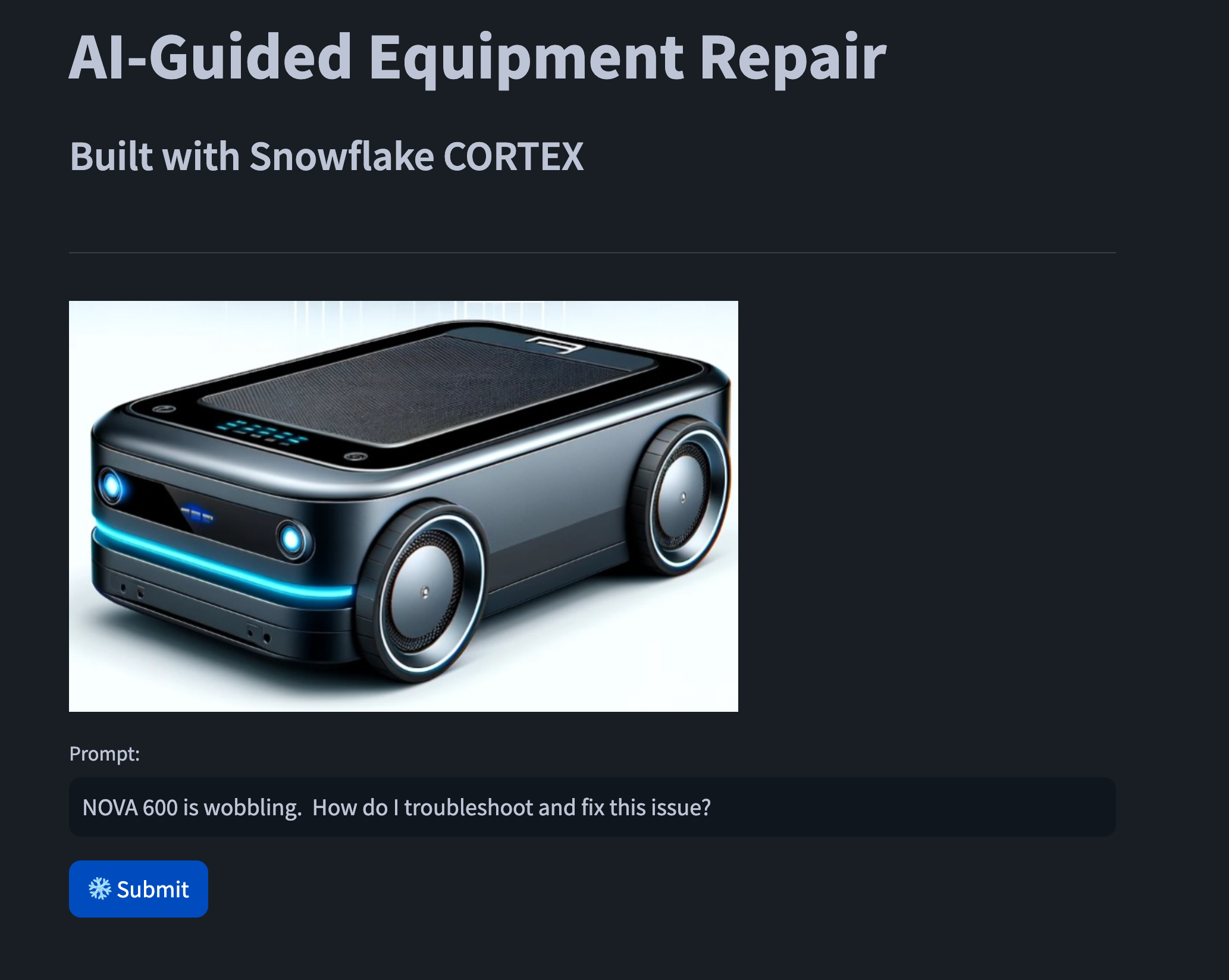
You can now ask any question you like of the LLM in regards to fixing the Otto 1500 AMR. Imagine this app running on a tablet for your maintenance crew as they go from robot to robot fixing common problems and entering repair logs. Those same repair logs are then uploaded to Snowflake and the model uses them for the next query.
To clean up and completely remove this app run the below SQL commands.
DROP DATABASE LLM;
This drops all the created database objects including the internal stage, tables, UDF's and Streamlit app.
You have built an Ai guided equipment maintenance chat bot. This chat bot base can be used for any piece of equipment. If you have the repair manuals for a Drill Press, a lithography machine, or a robotic arm. This app can be used to decrease downtime due to servicing the equipment when in a failed state. You can add your geniune repair logs to further enhance the quality of output from the LLM.
What You Learned
- How to use Snowflake CORTEX to invoke LLM's running on large GPU's with a single line of SQL.
- How to use open-source Python libraries from curated Snowflake Anaconda channel
- How to create Snowflake UDF's and UDTF's to package parts of your code for re-usability and read ability
- How to vector embed text for use in LLM's prompt engineering
- How to create Streamlit application that uses Snowflake CORTEX LLM's for inference based on user input
Related Resources
- Fork Repo on GitHub
- Snowflake Cortex
- Streamlit in Snowflake
- Snowpark for Python Developer Guide
- Download Reference Architecture
- Read the Blog
- Watch the Demo
We would love your feedback on this QuickStart Guide! Please submit your feedback using this Feedback Form.